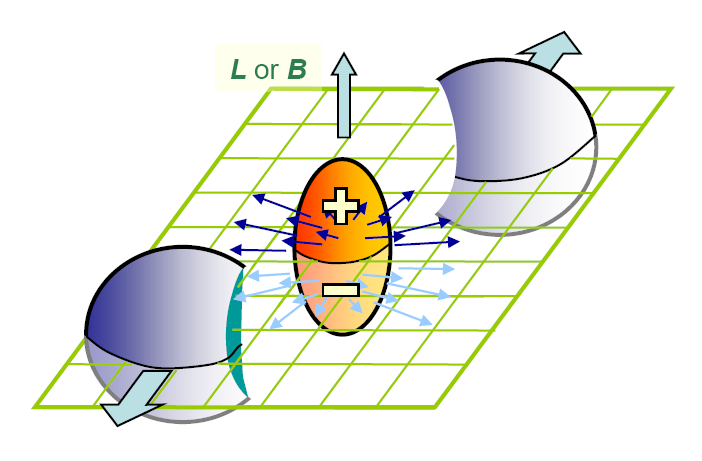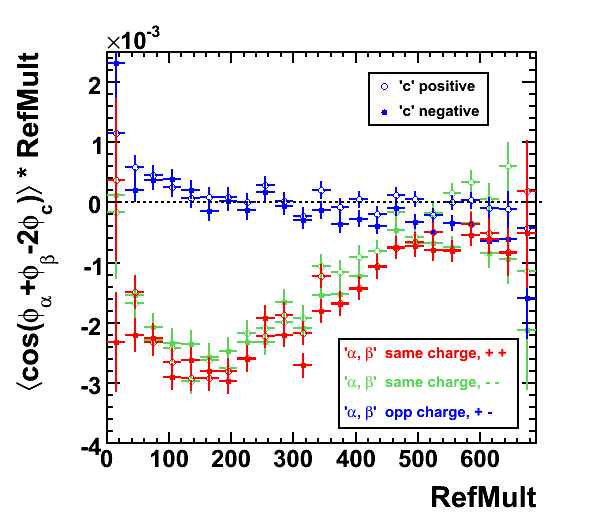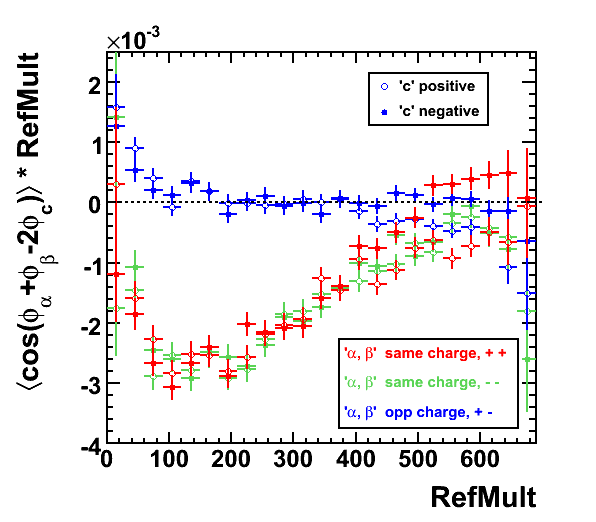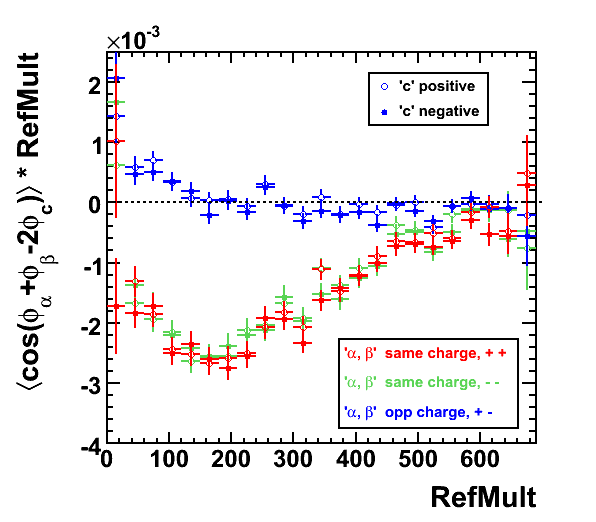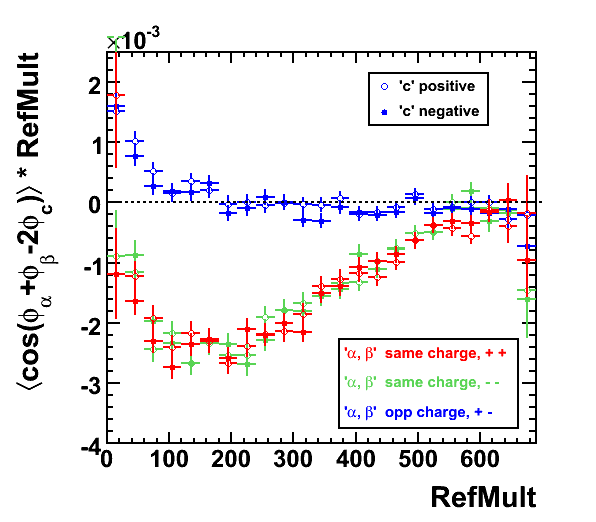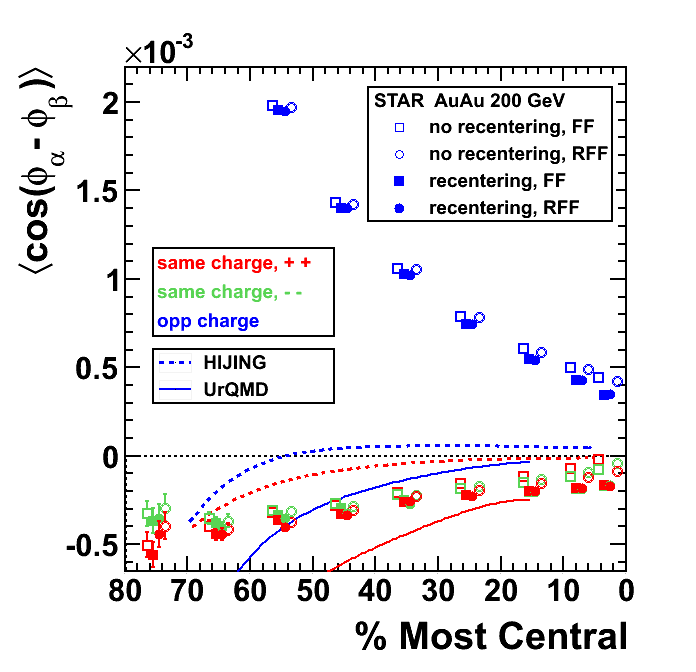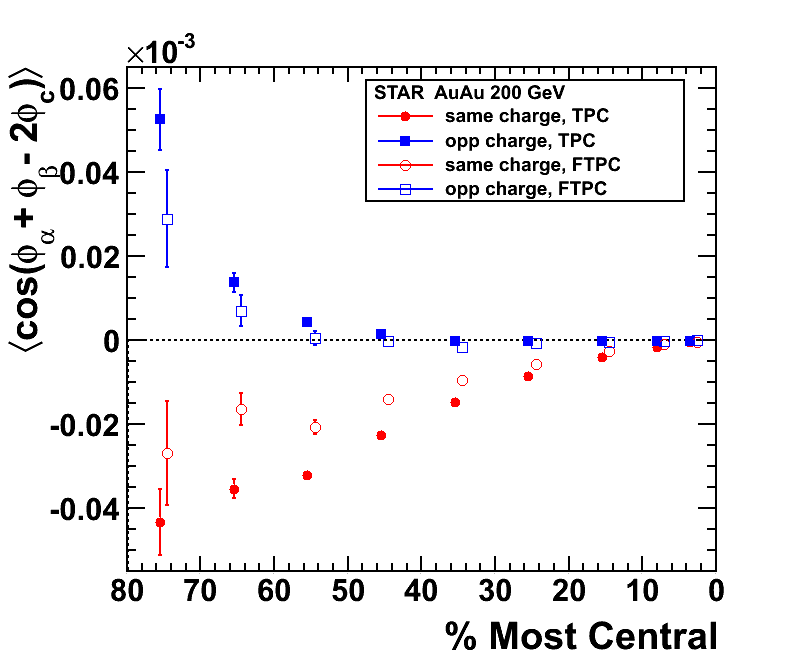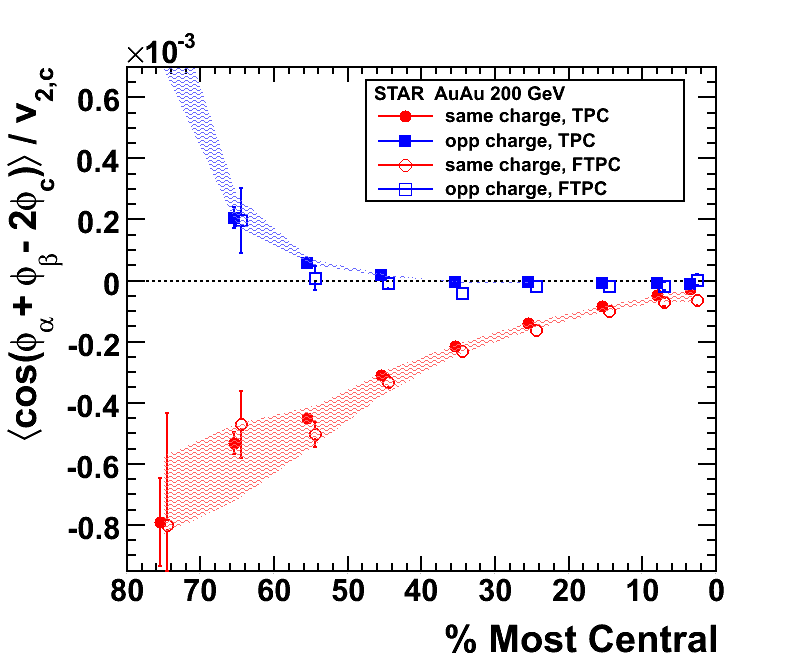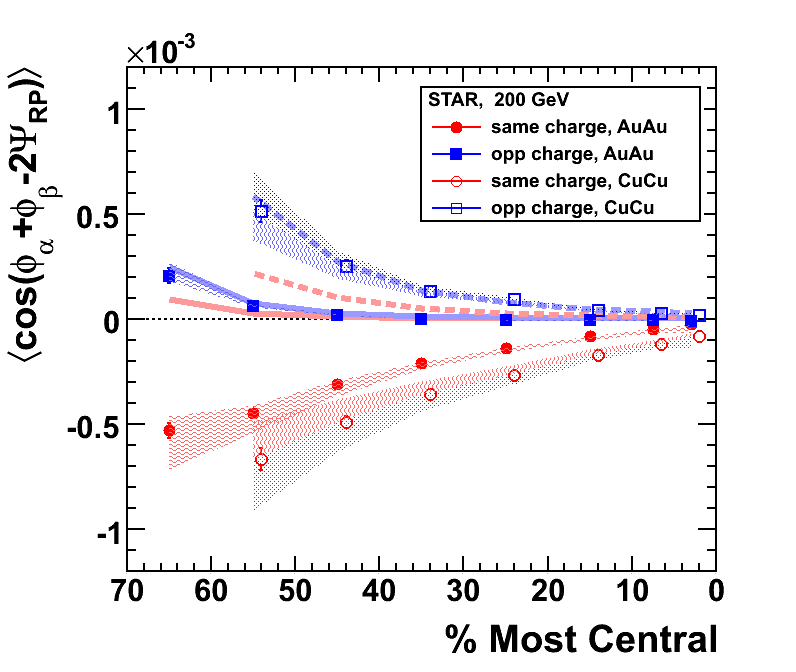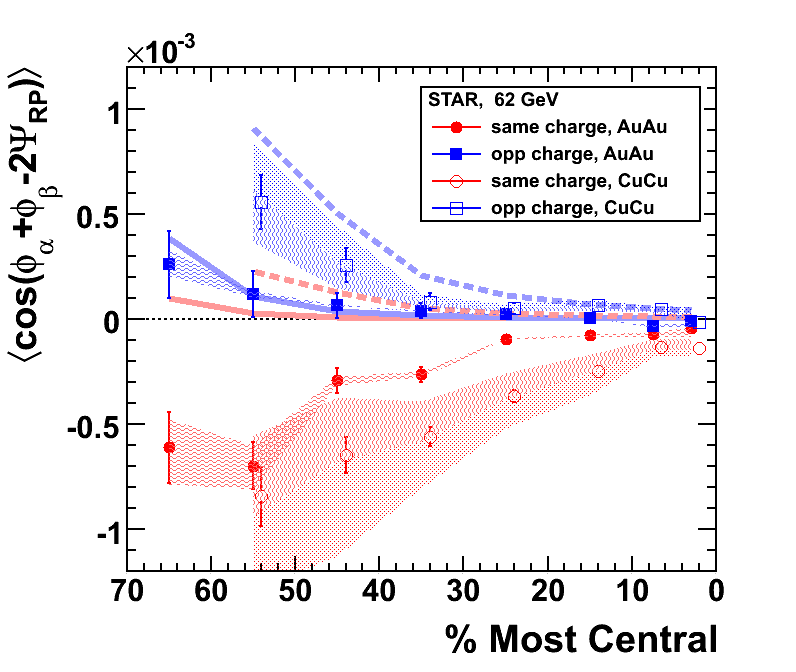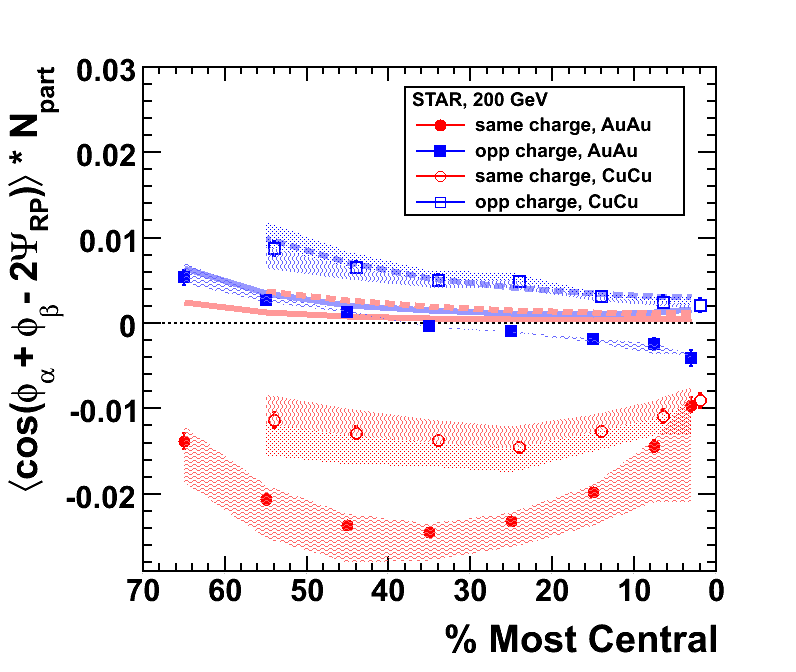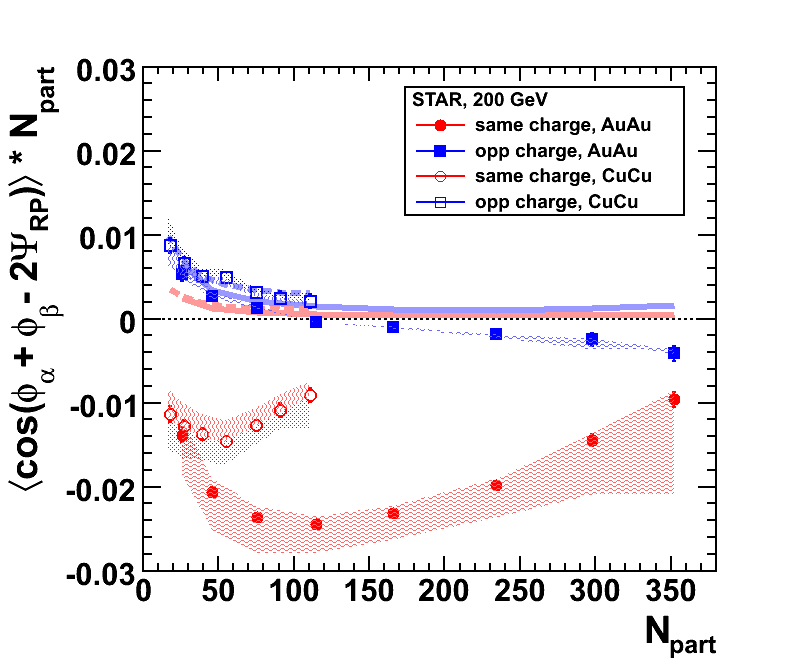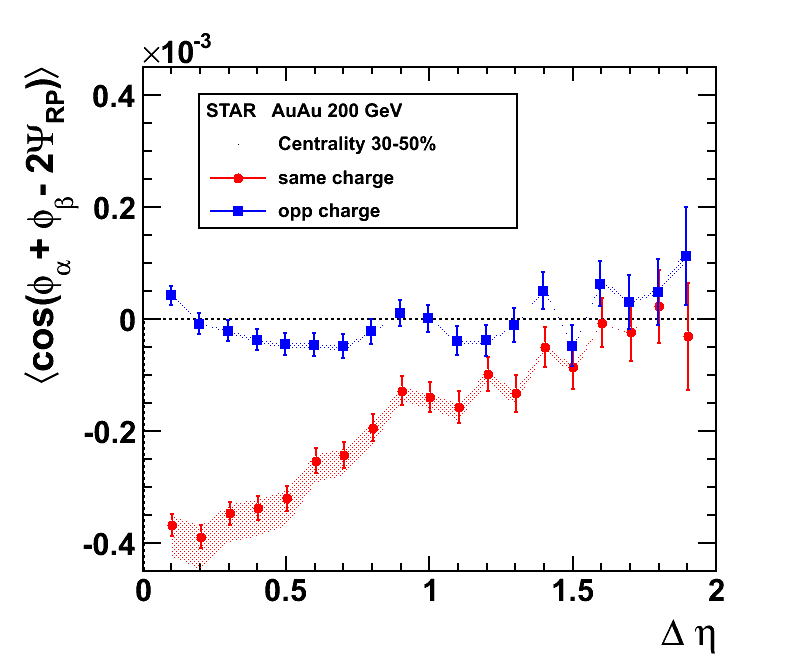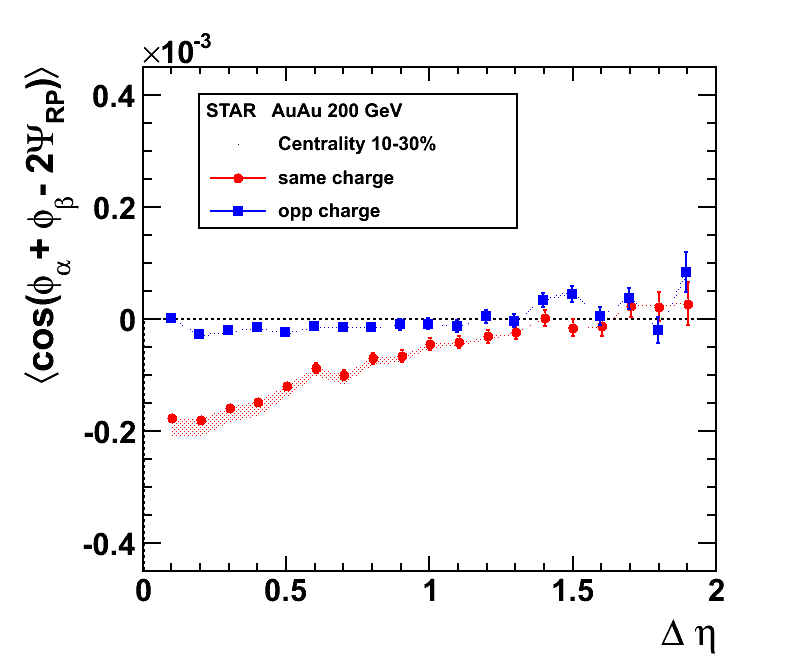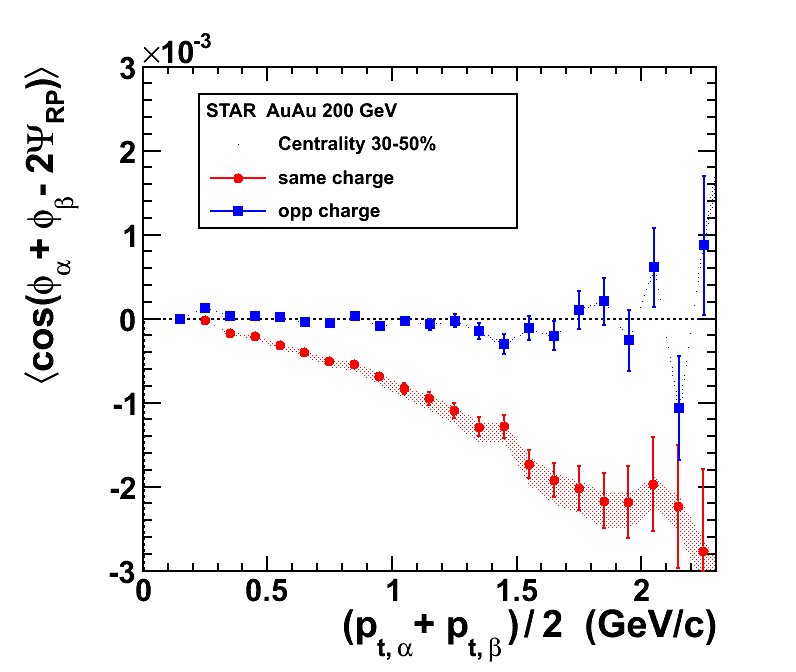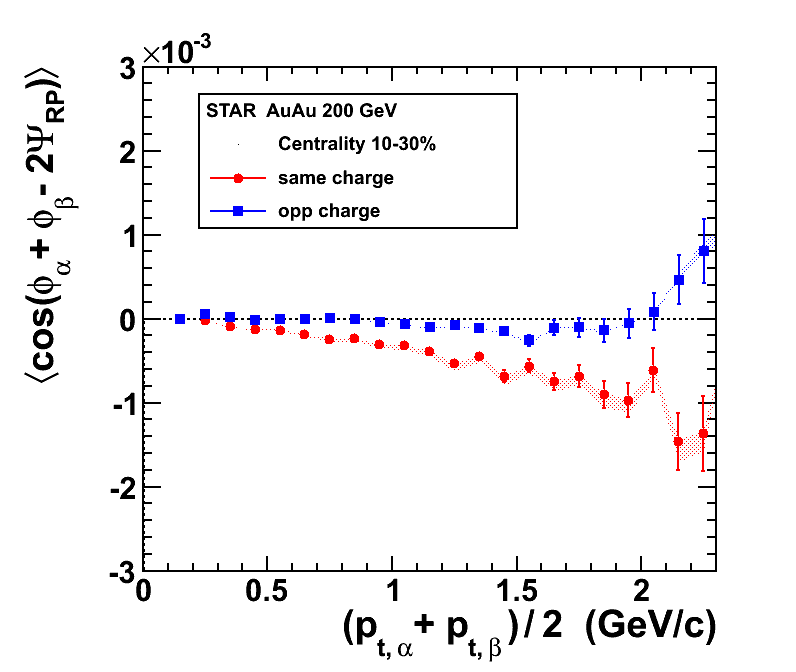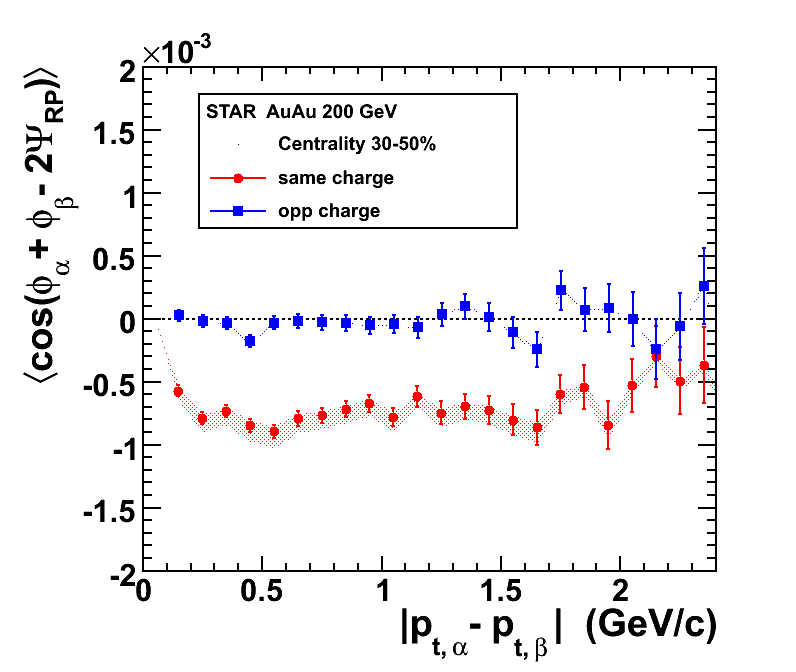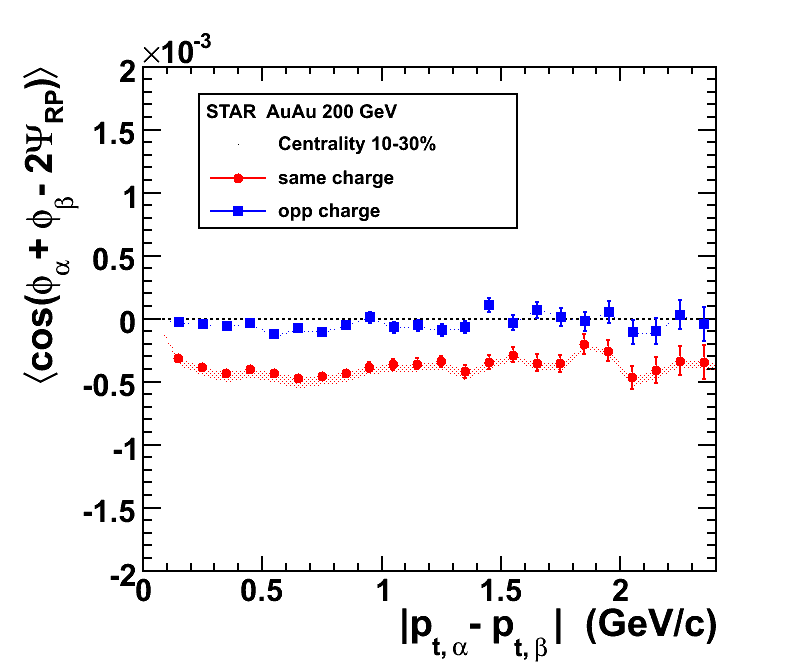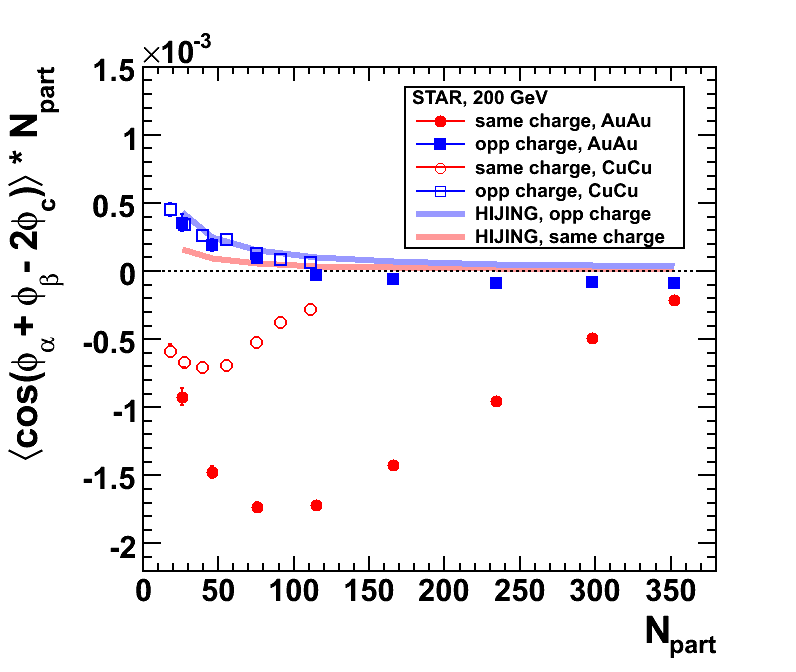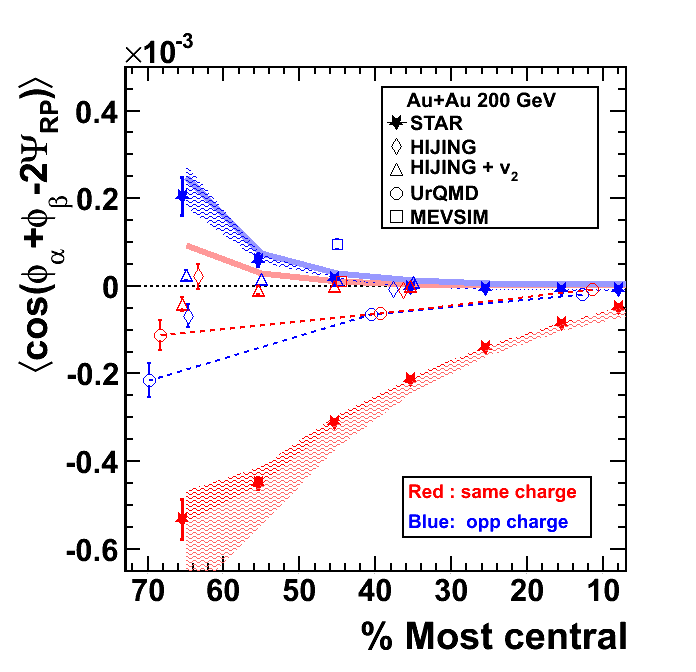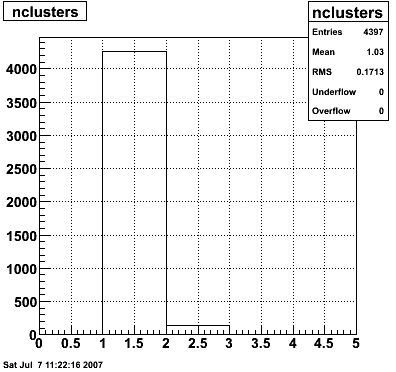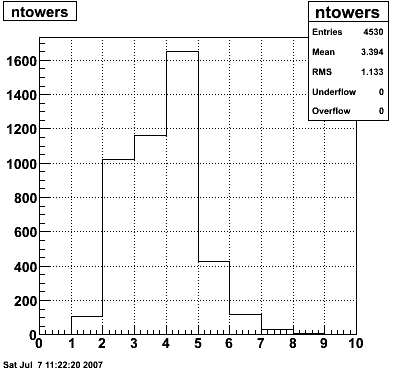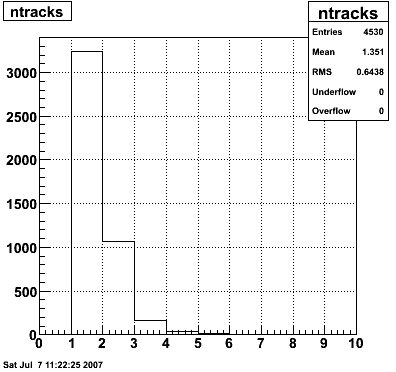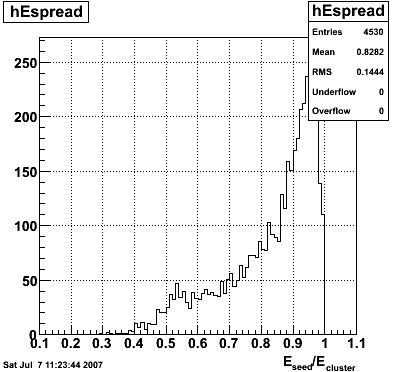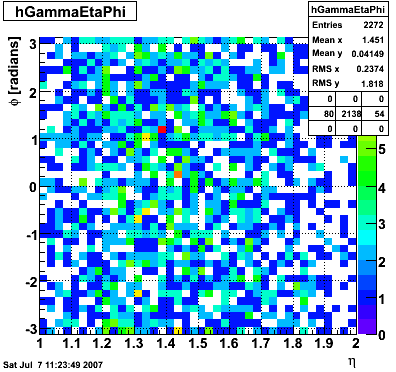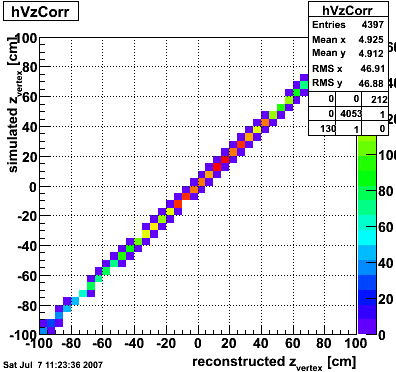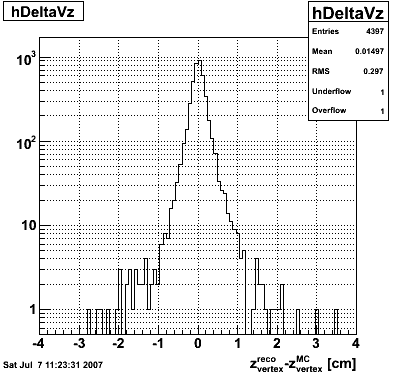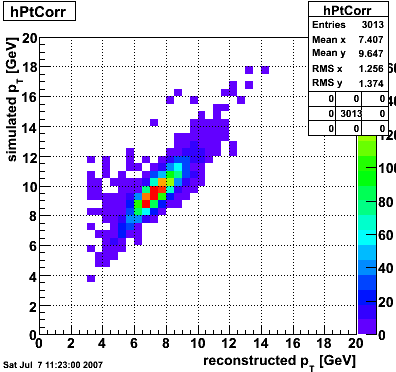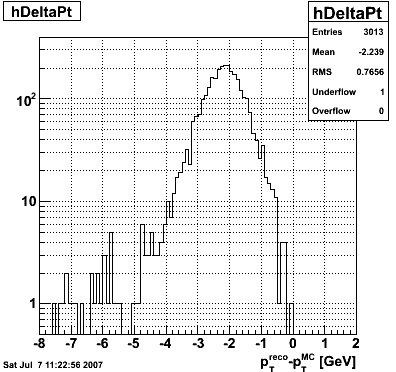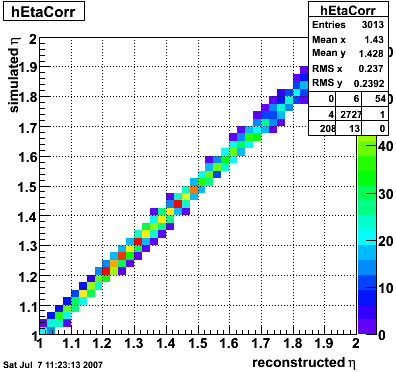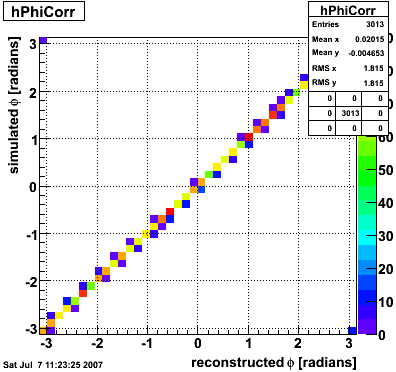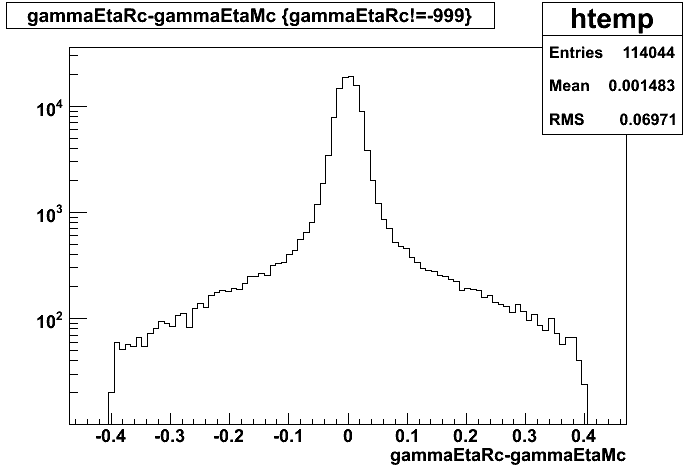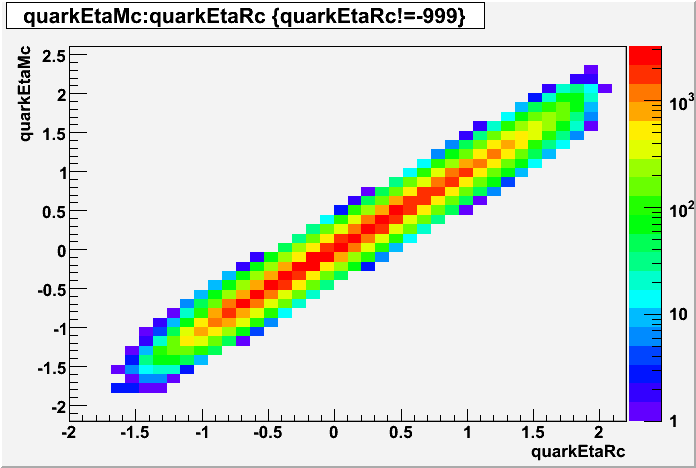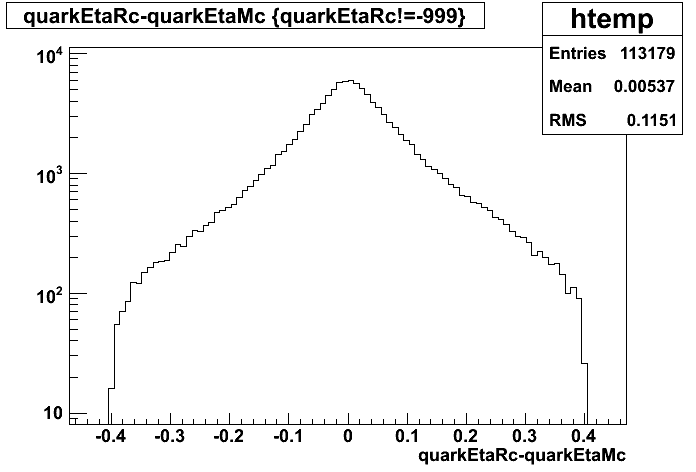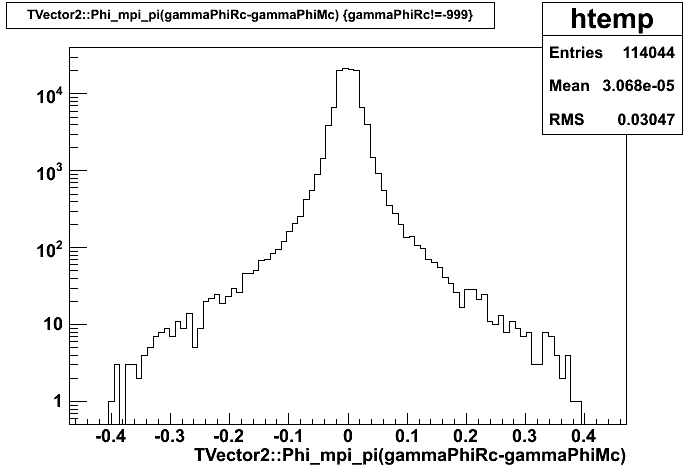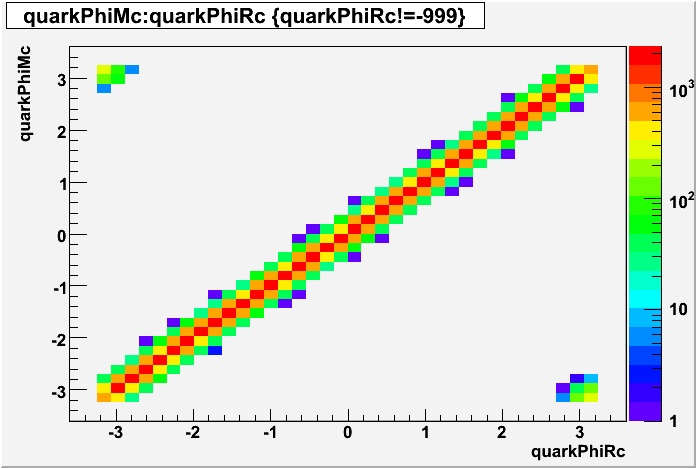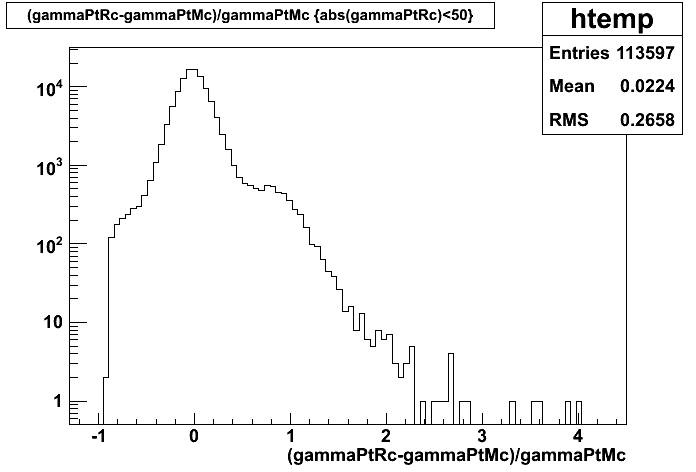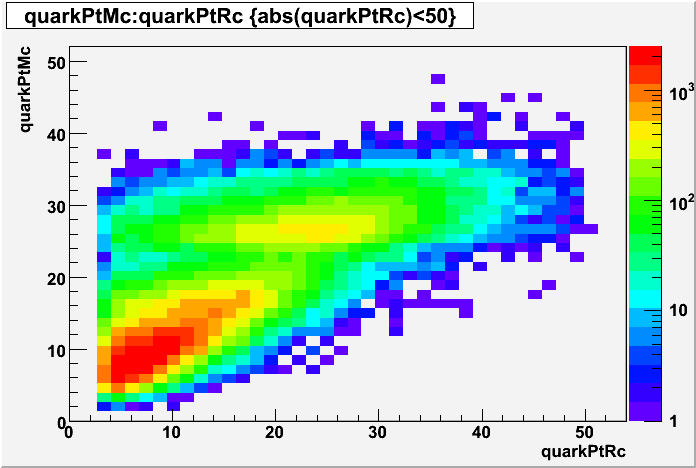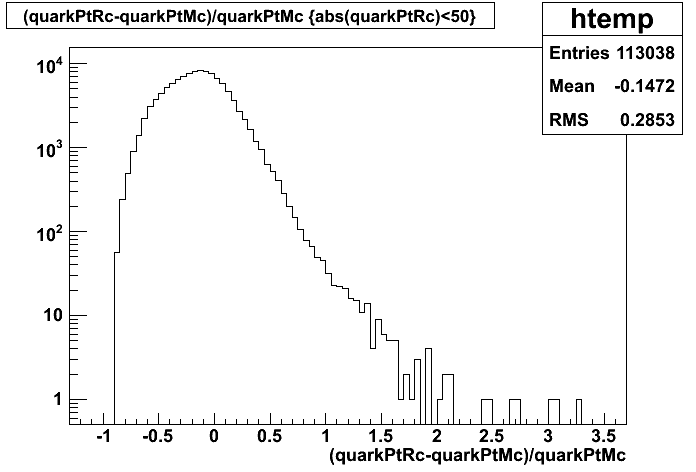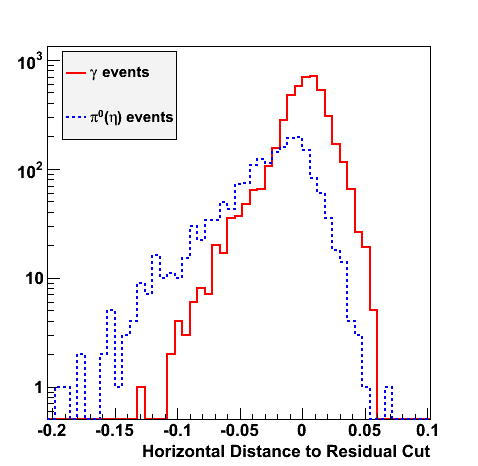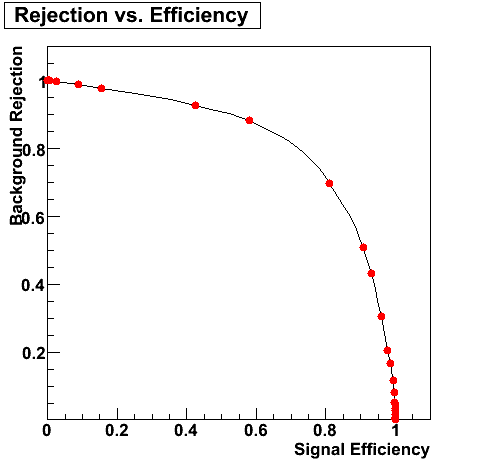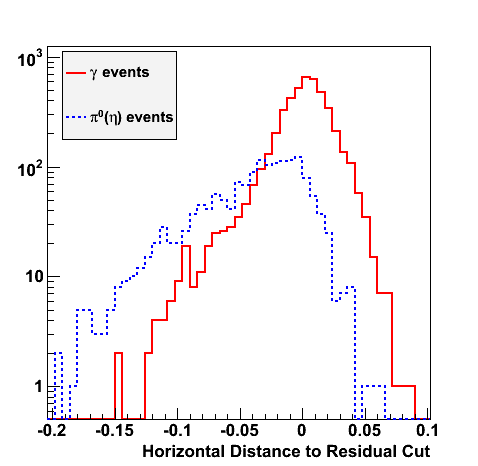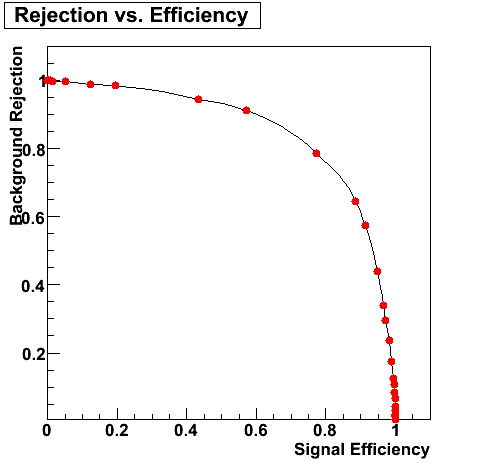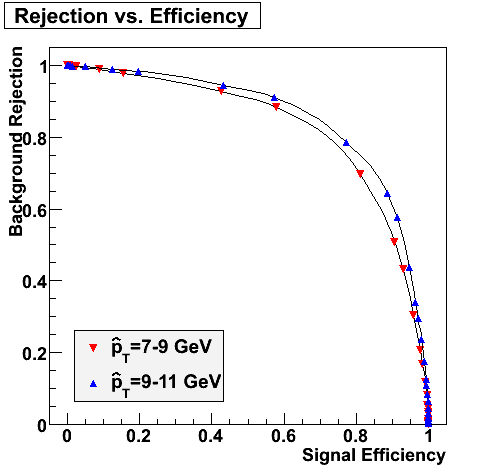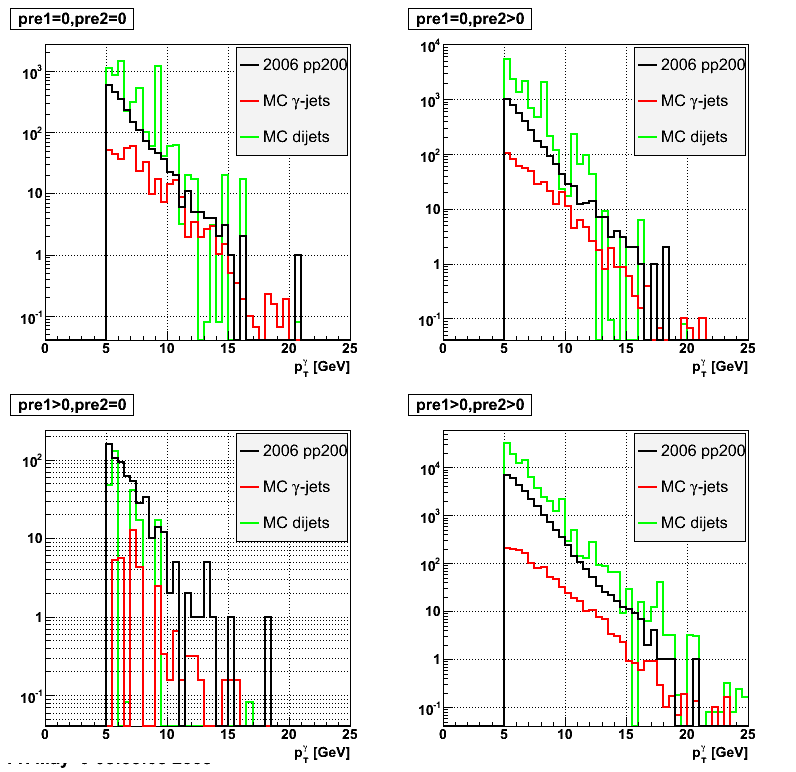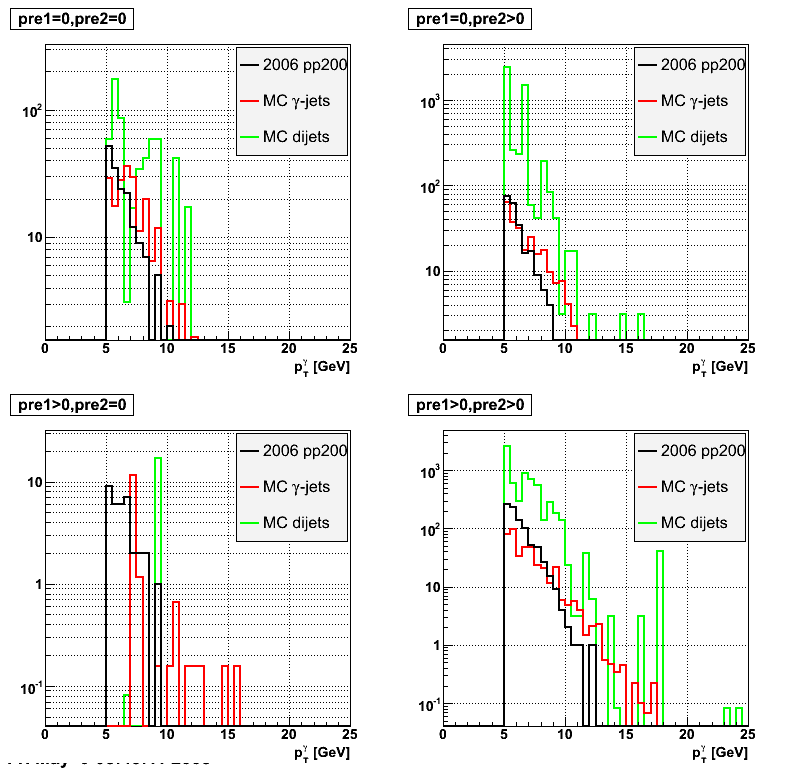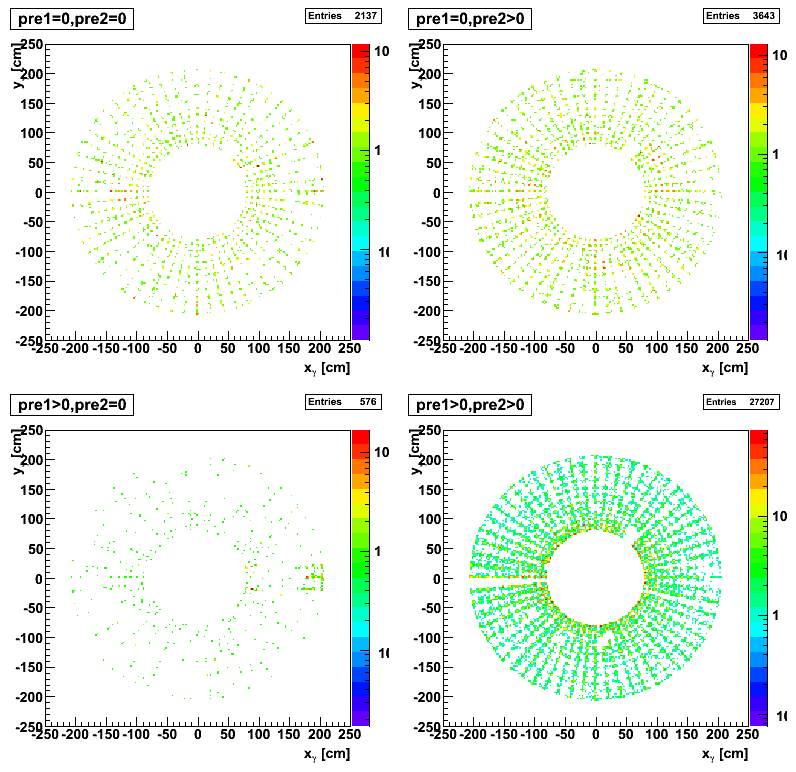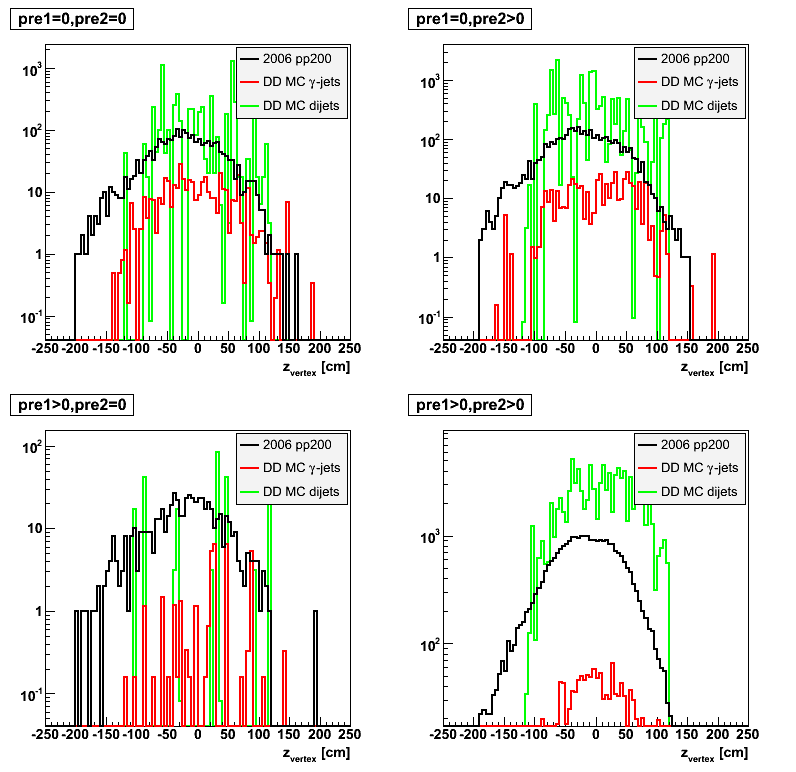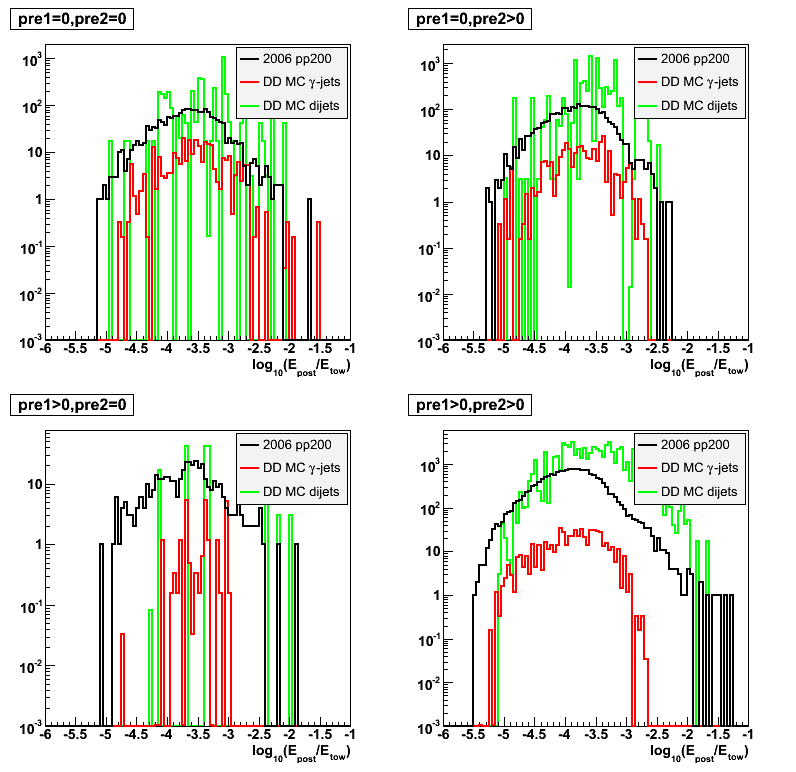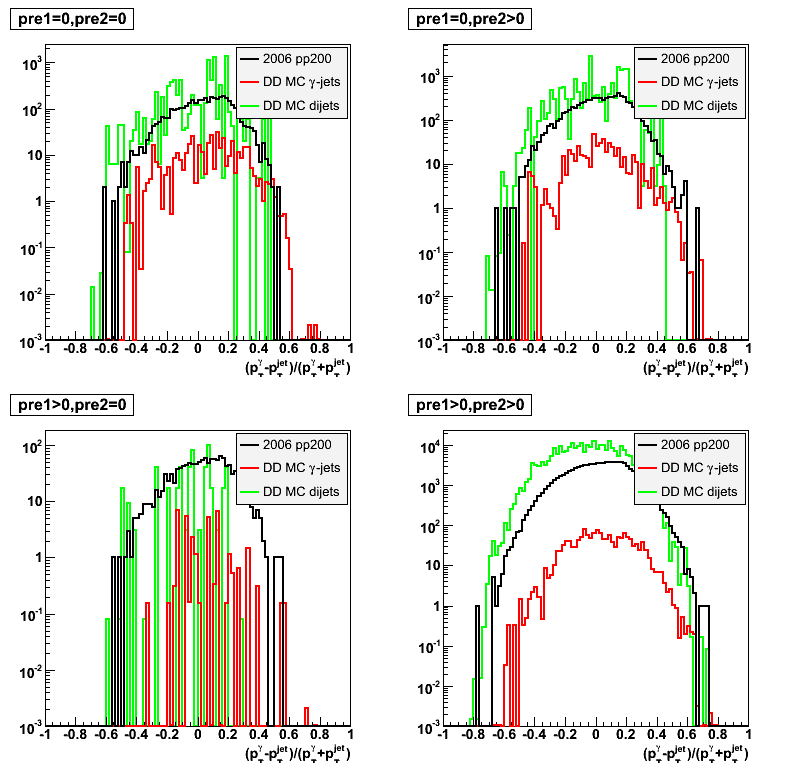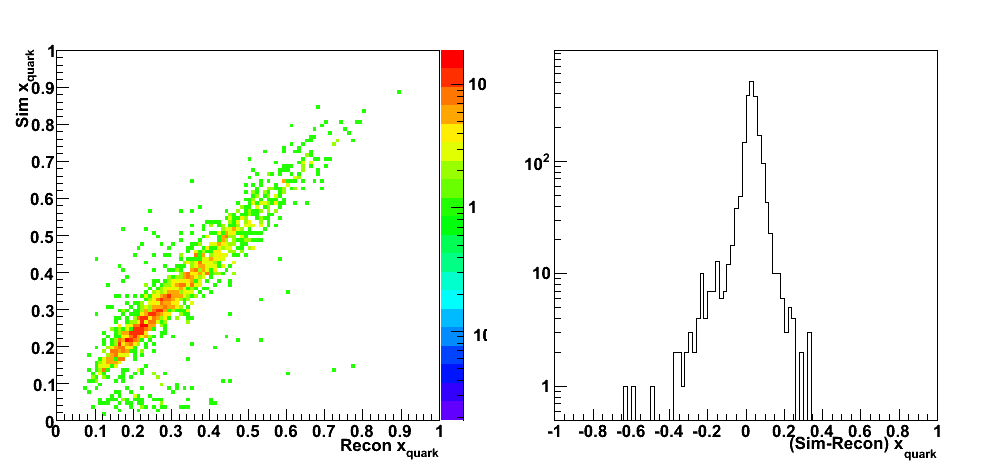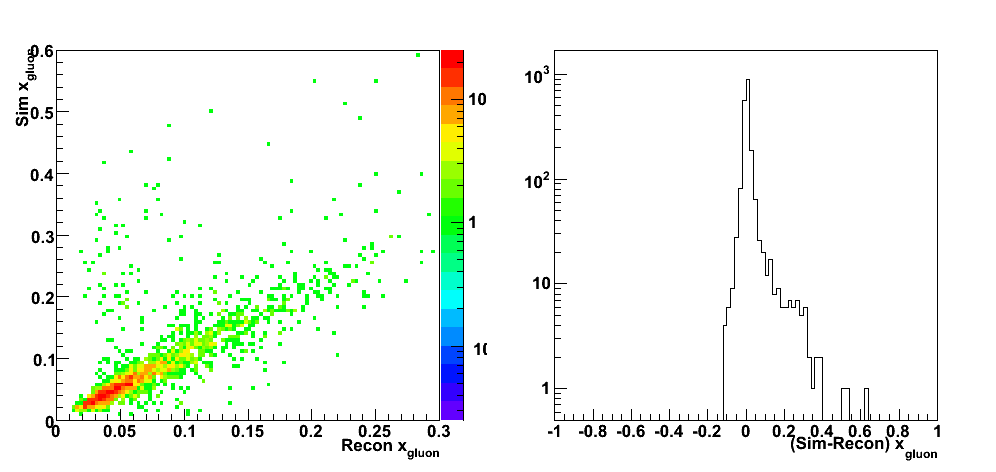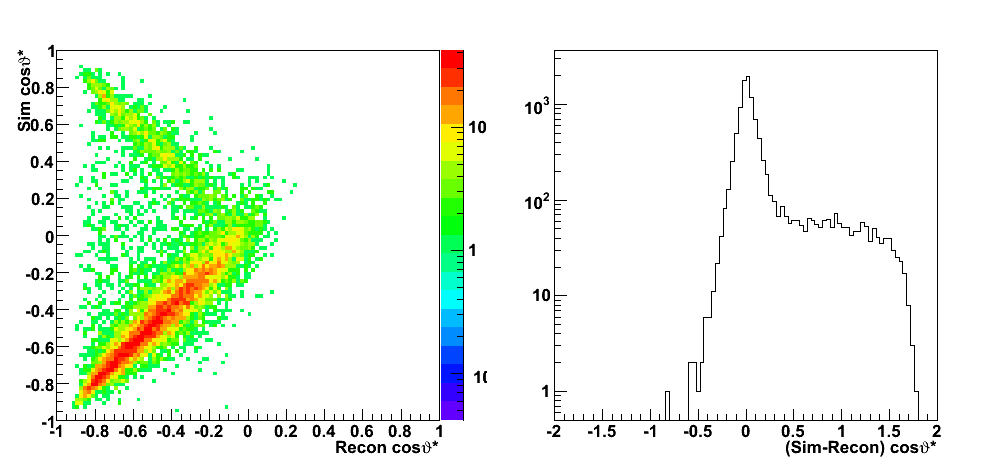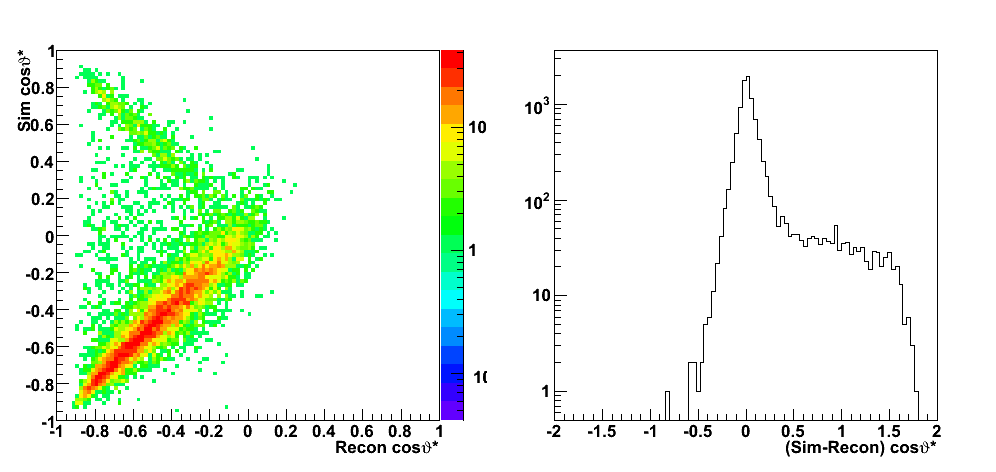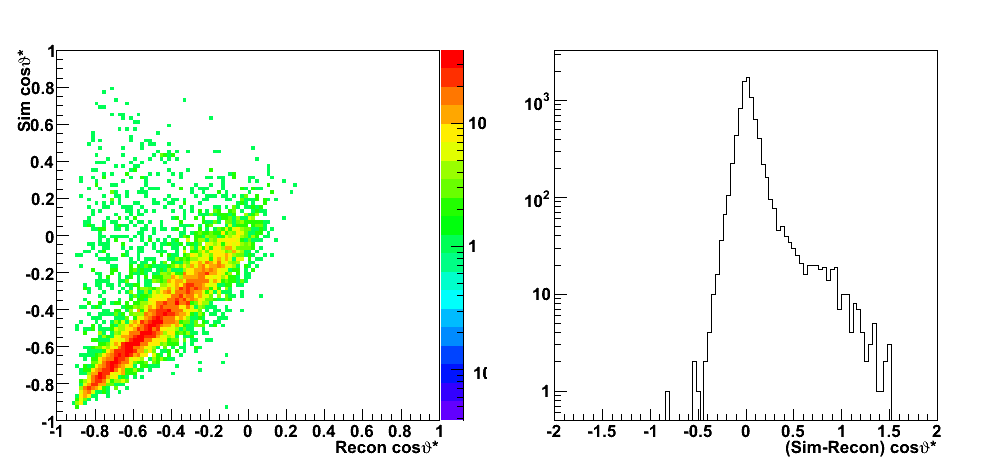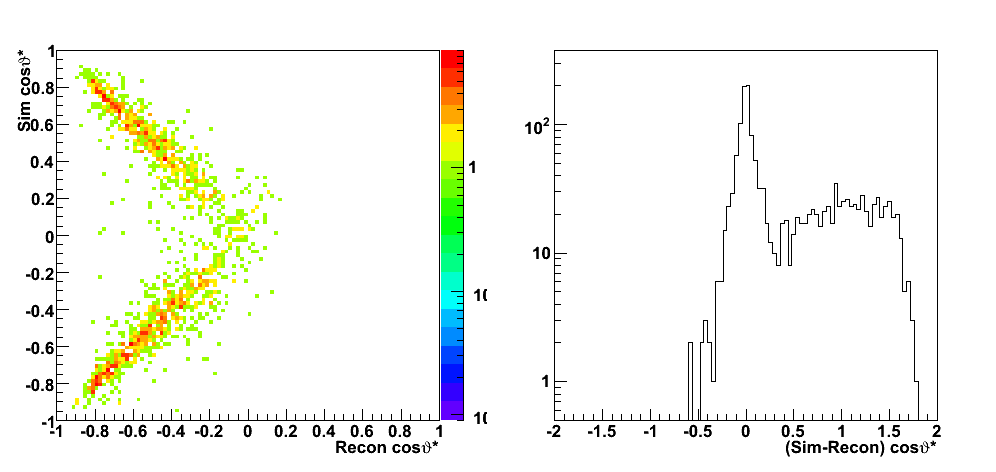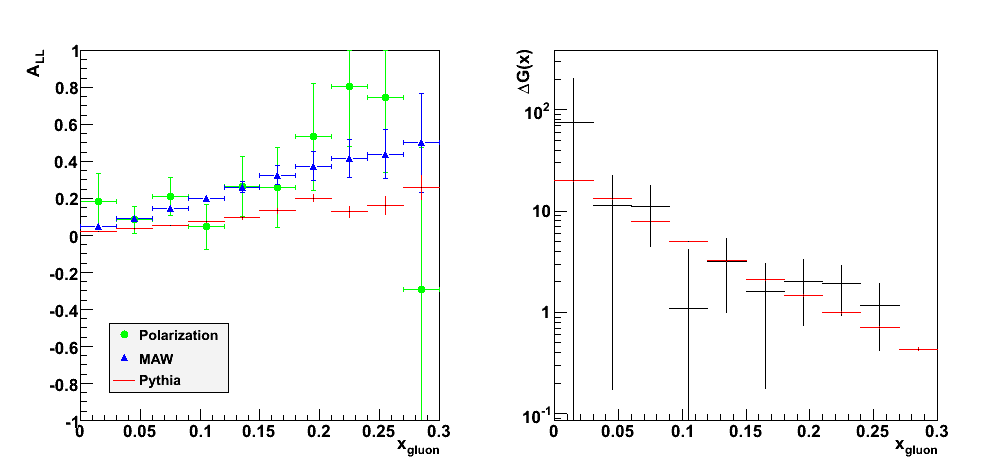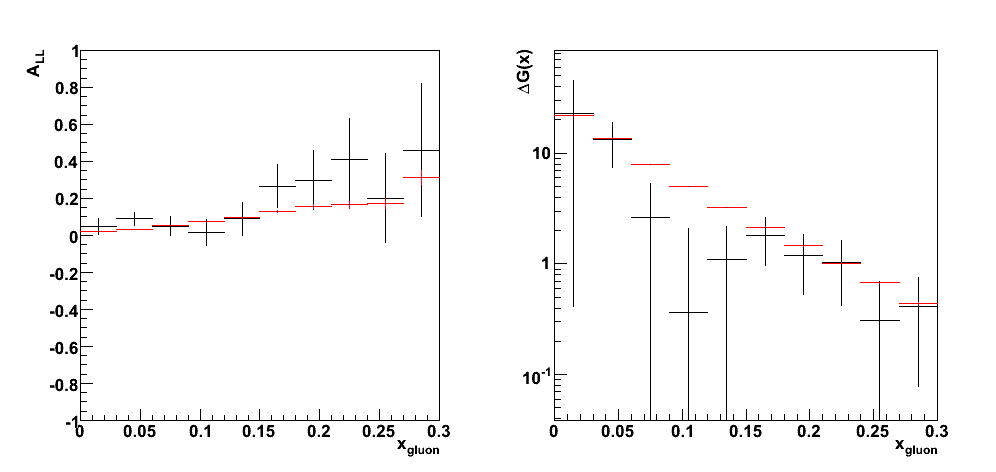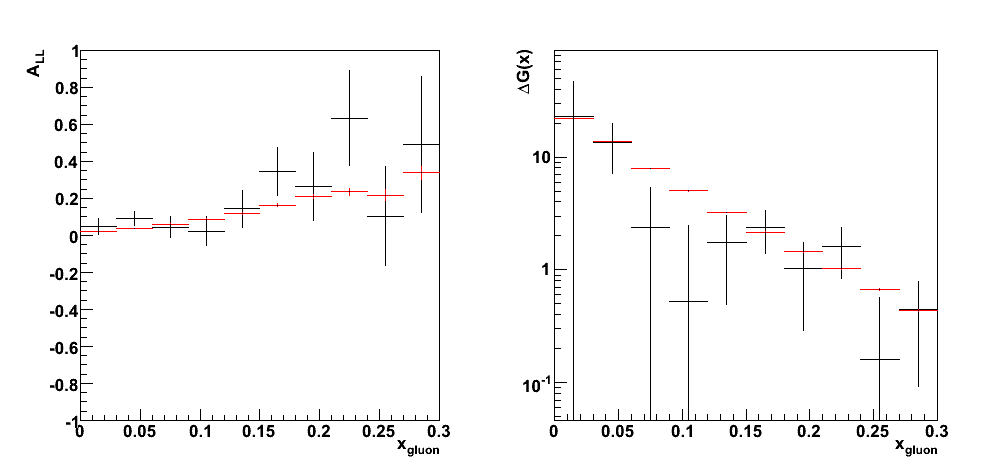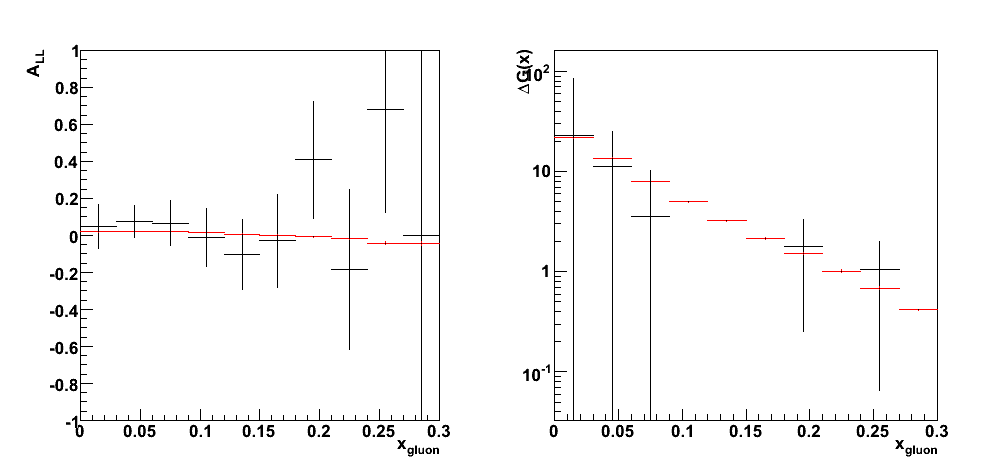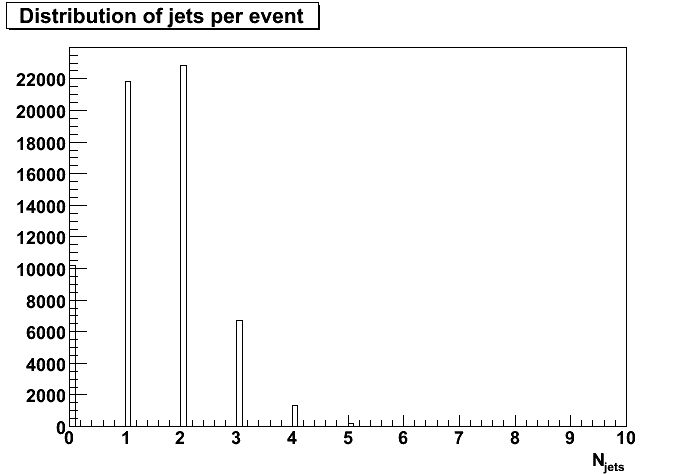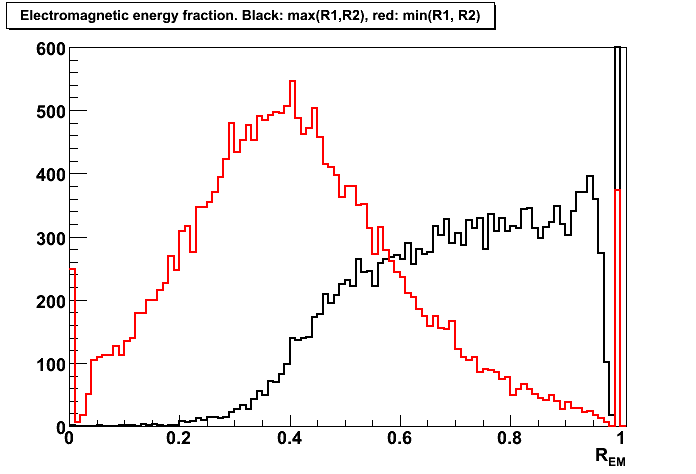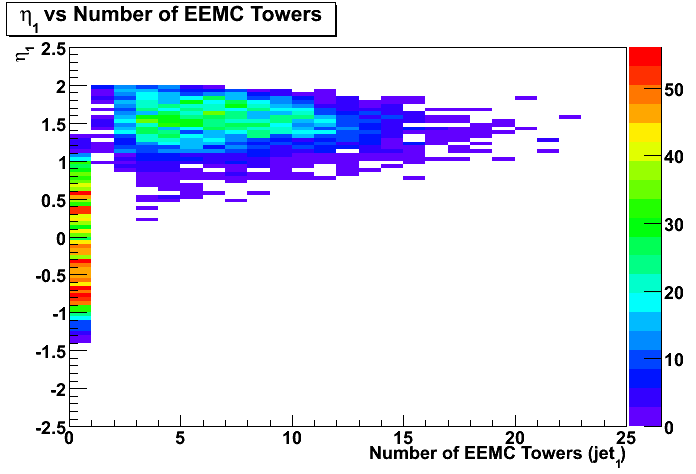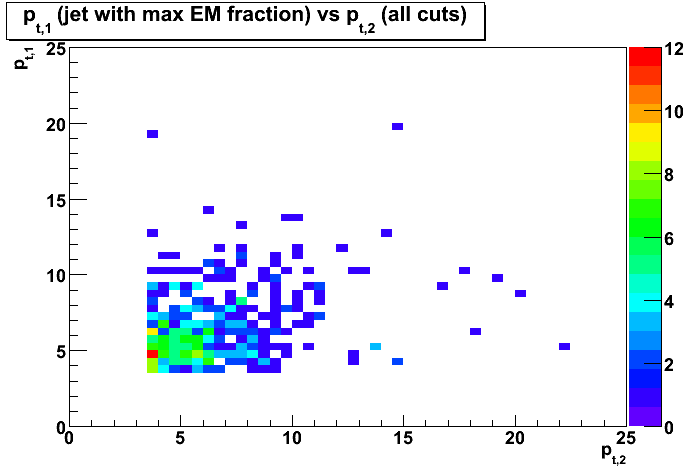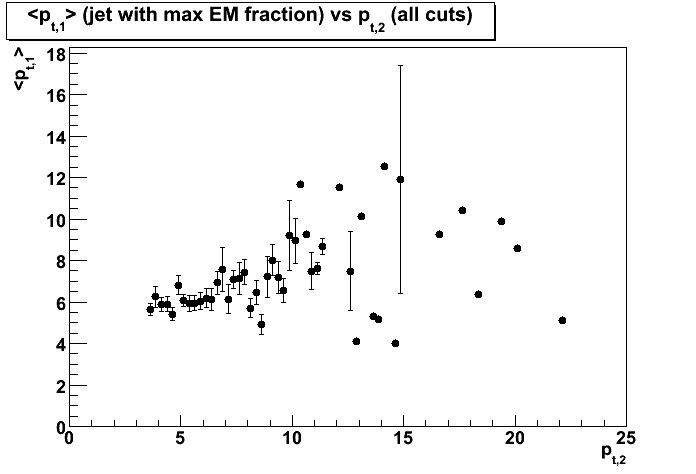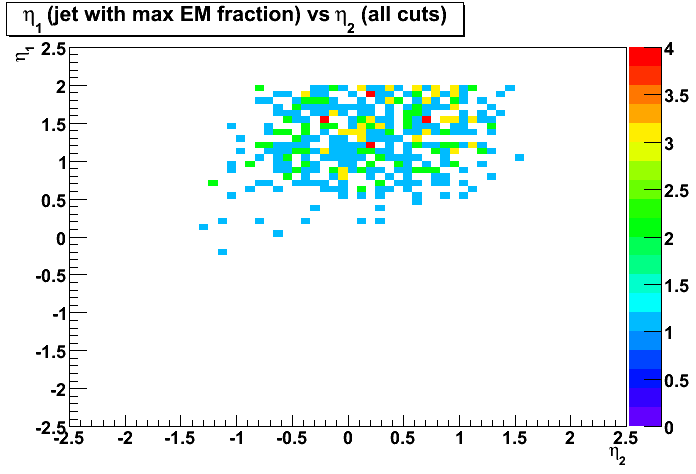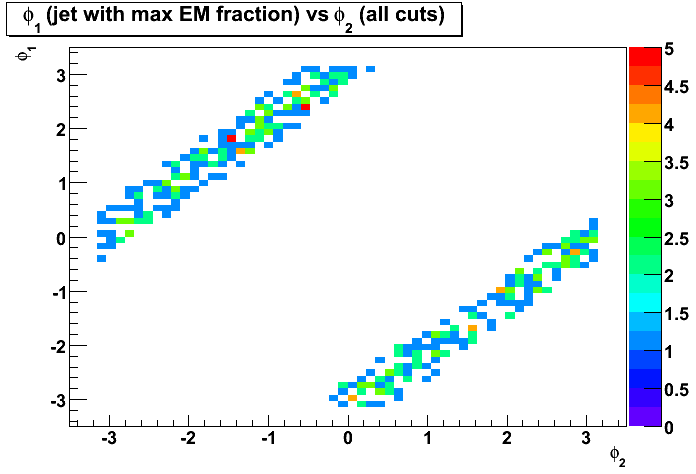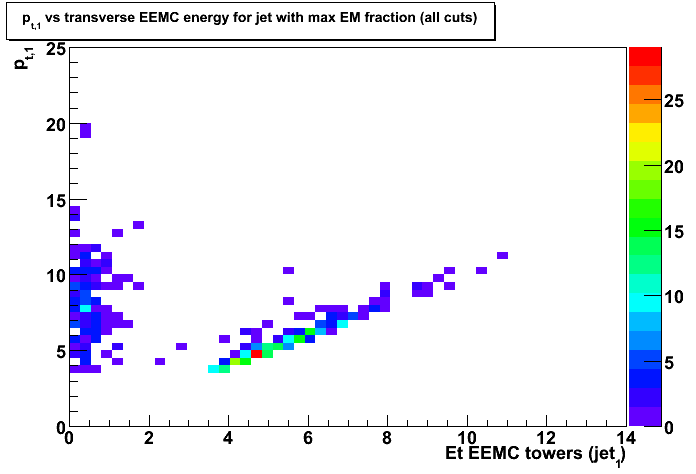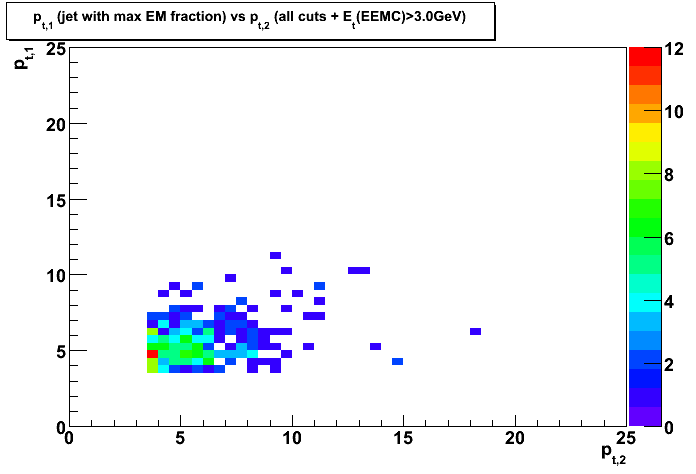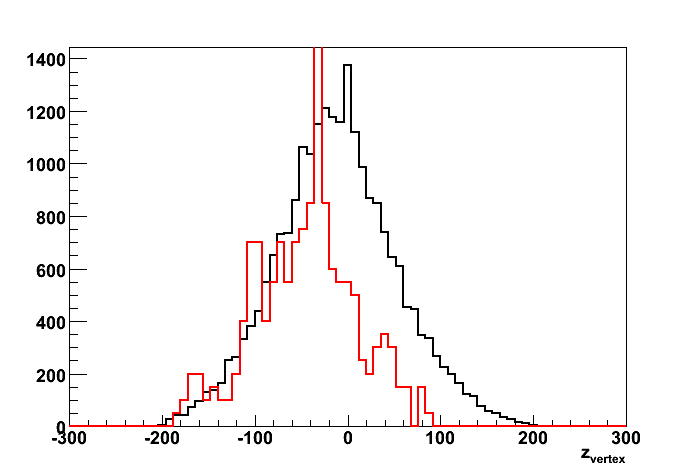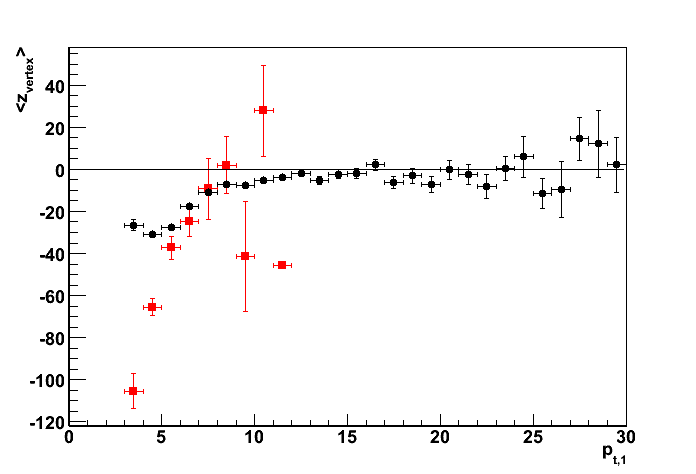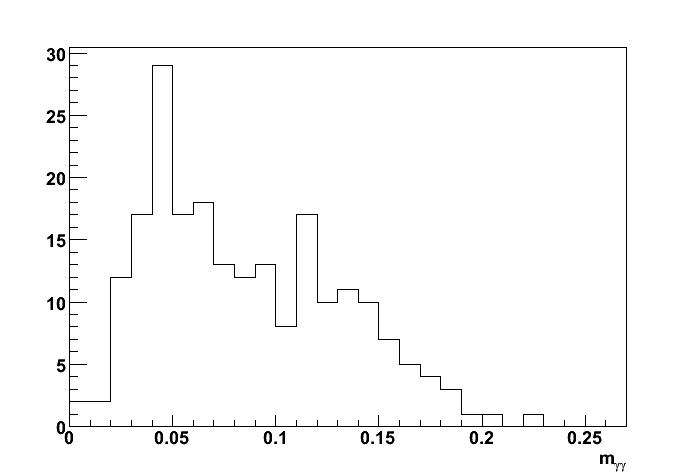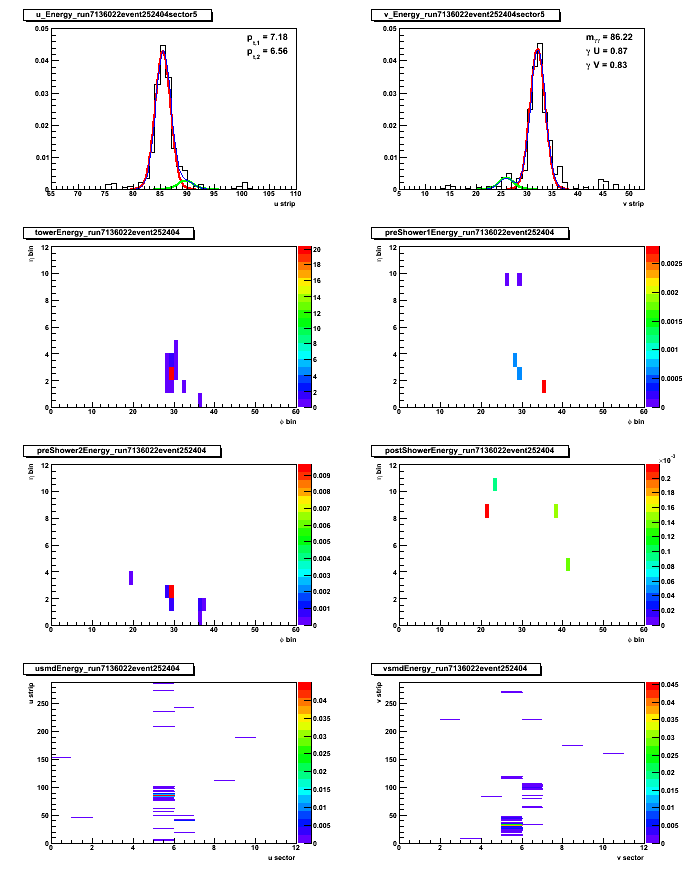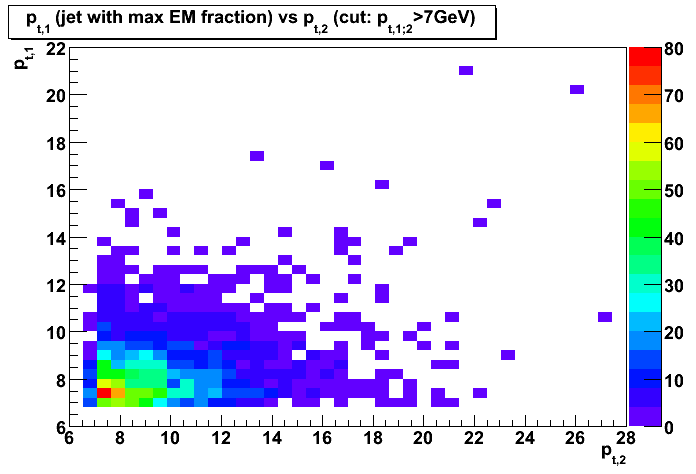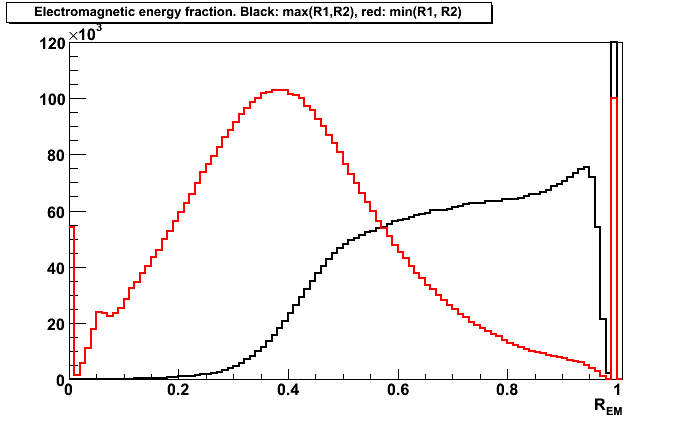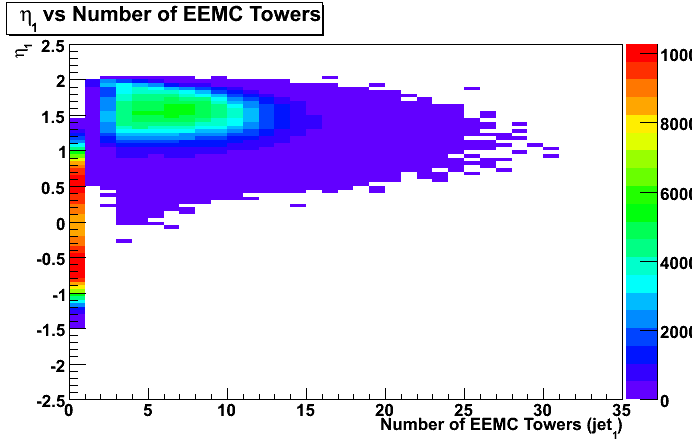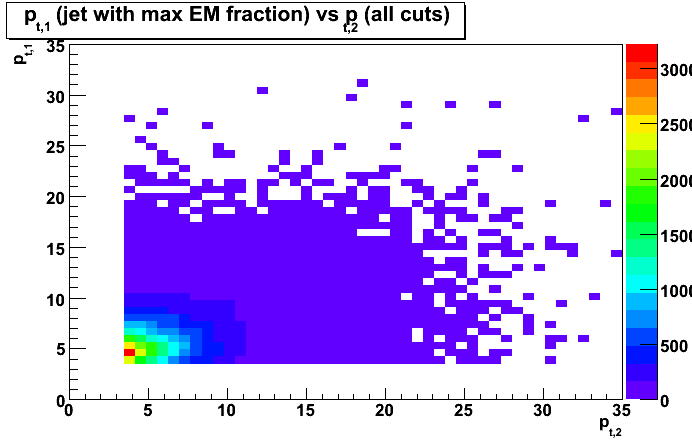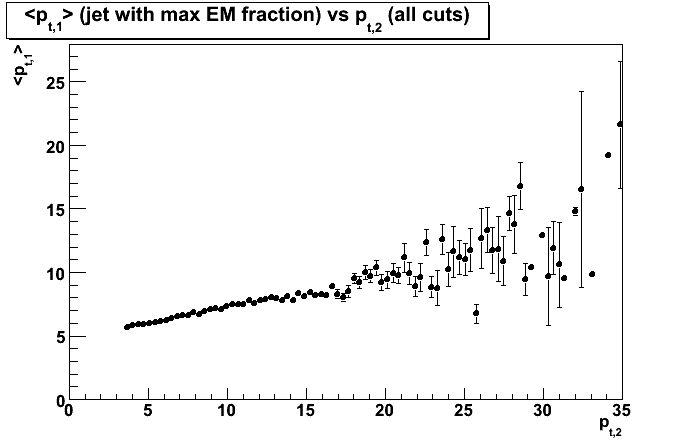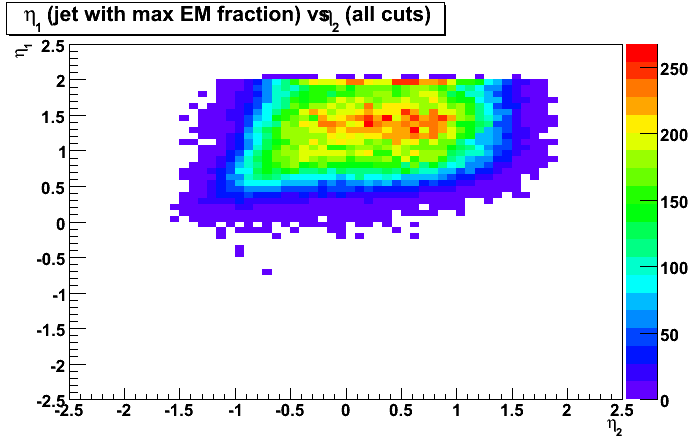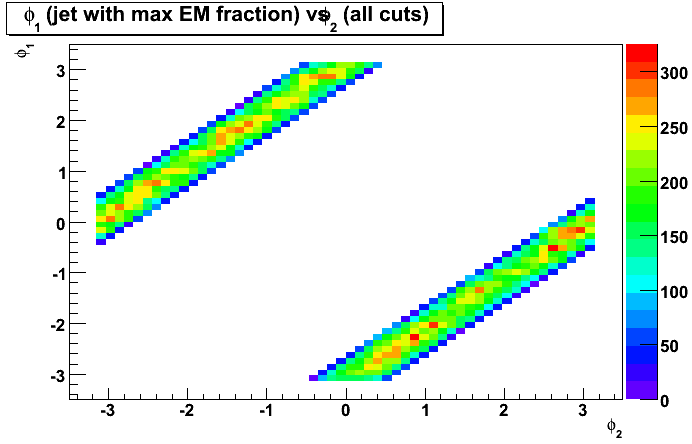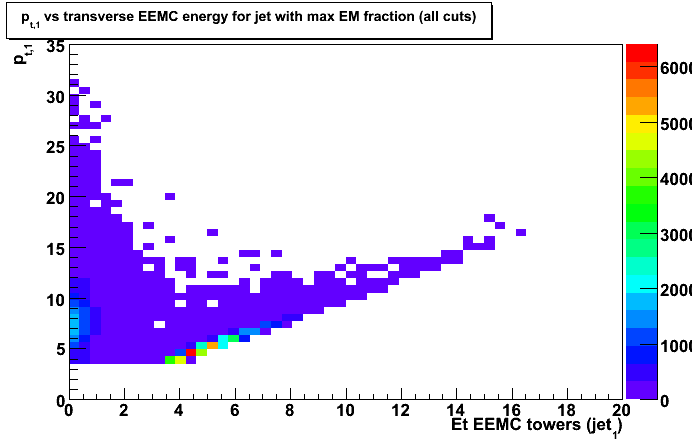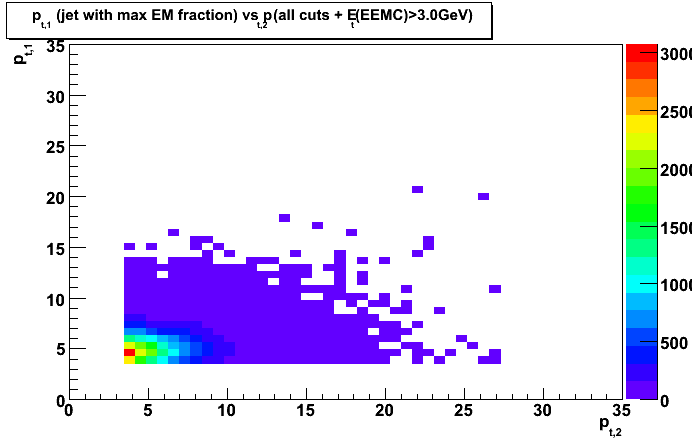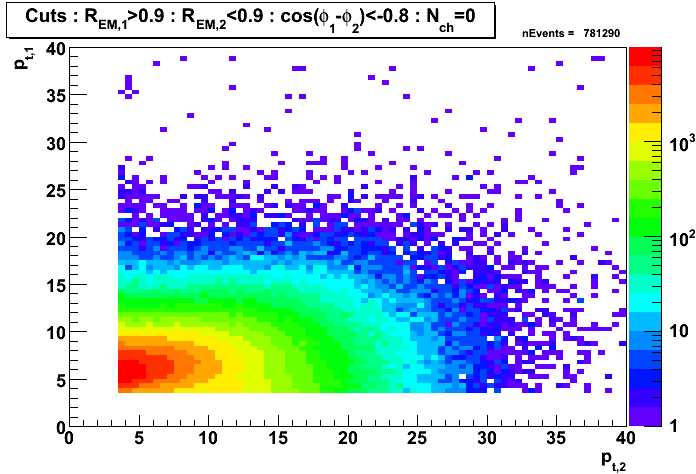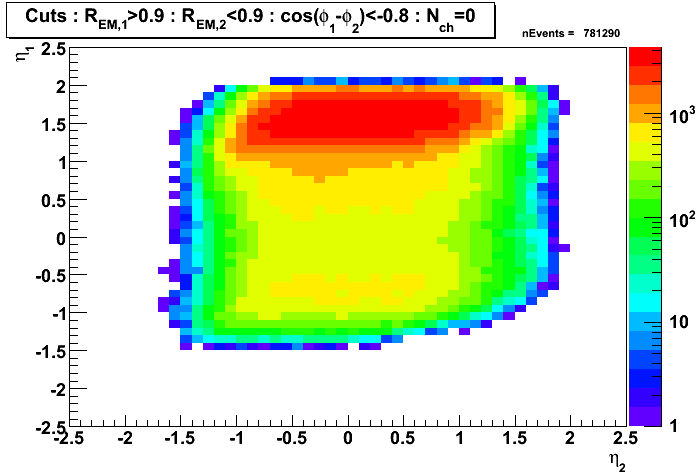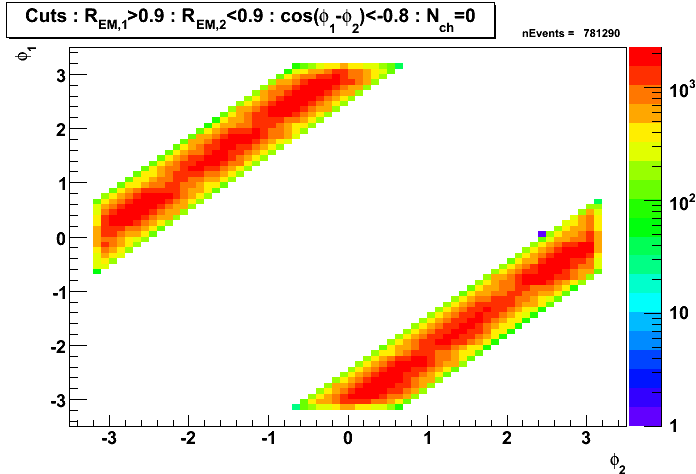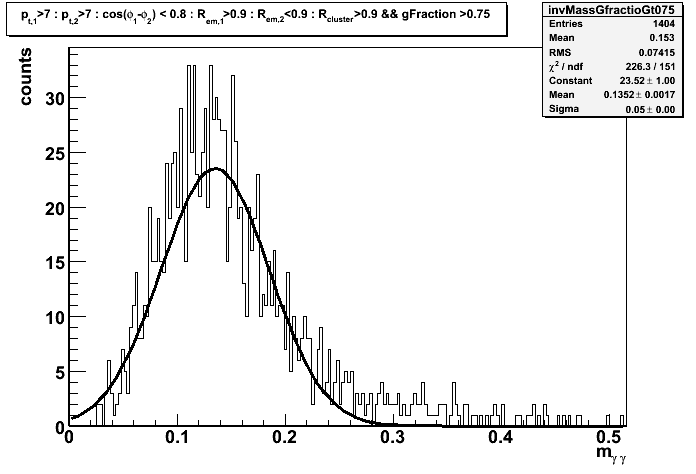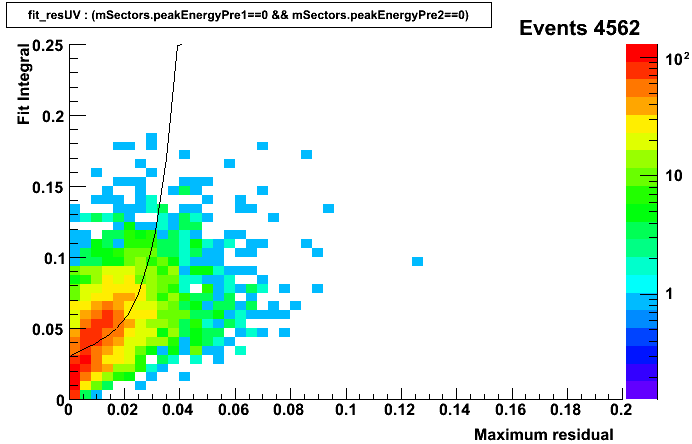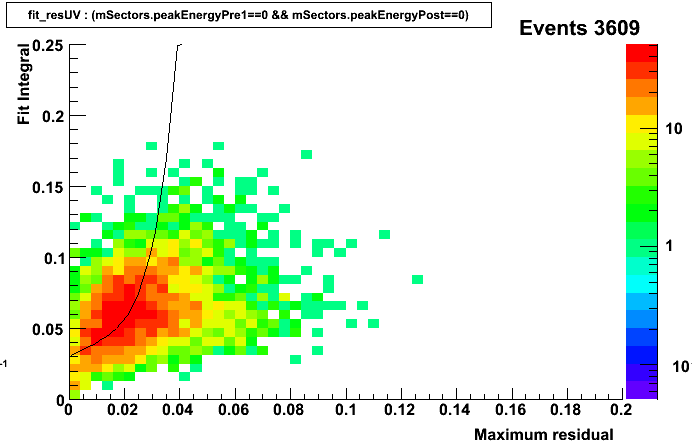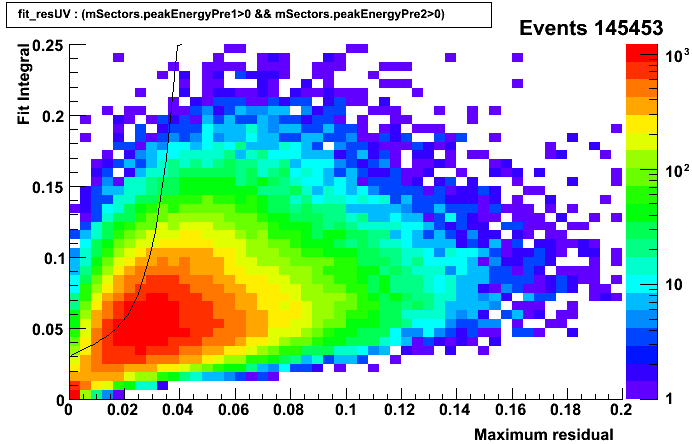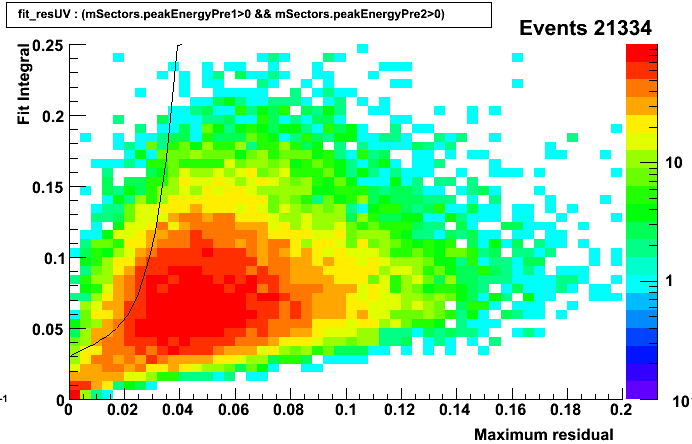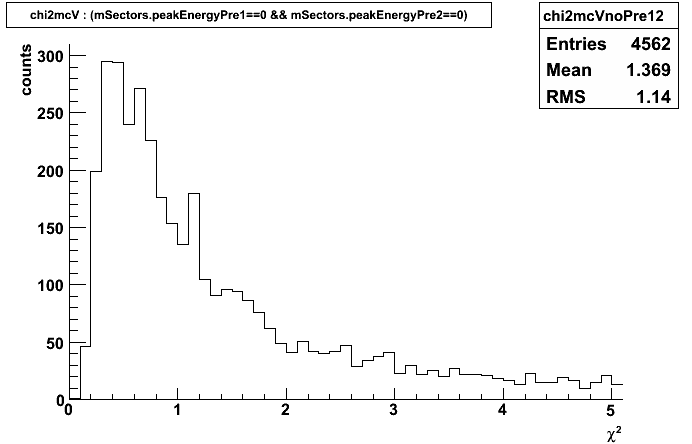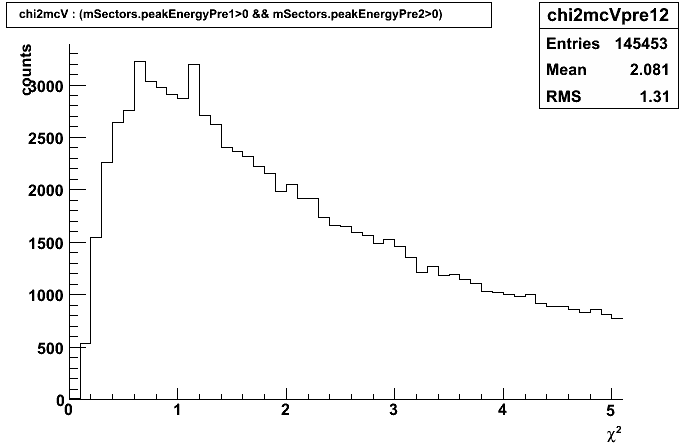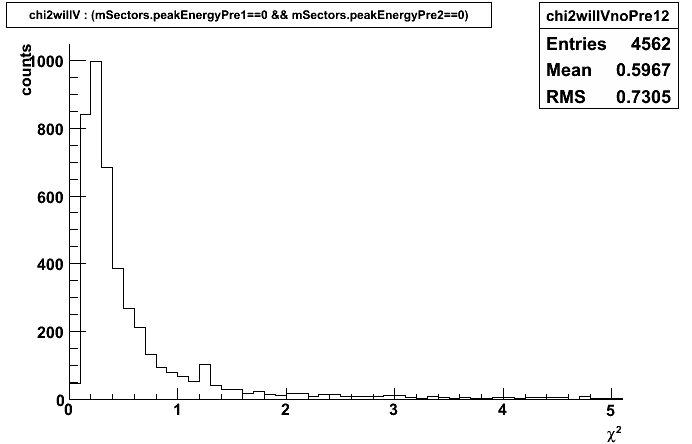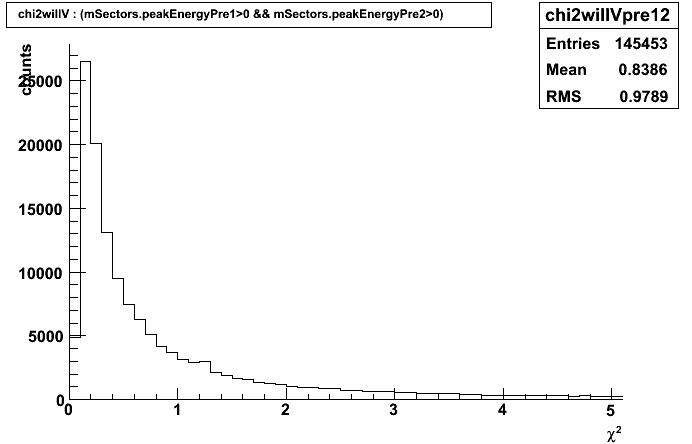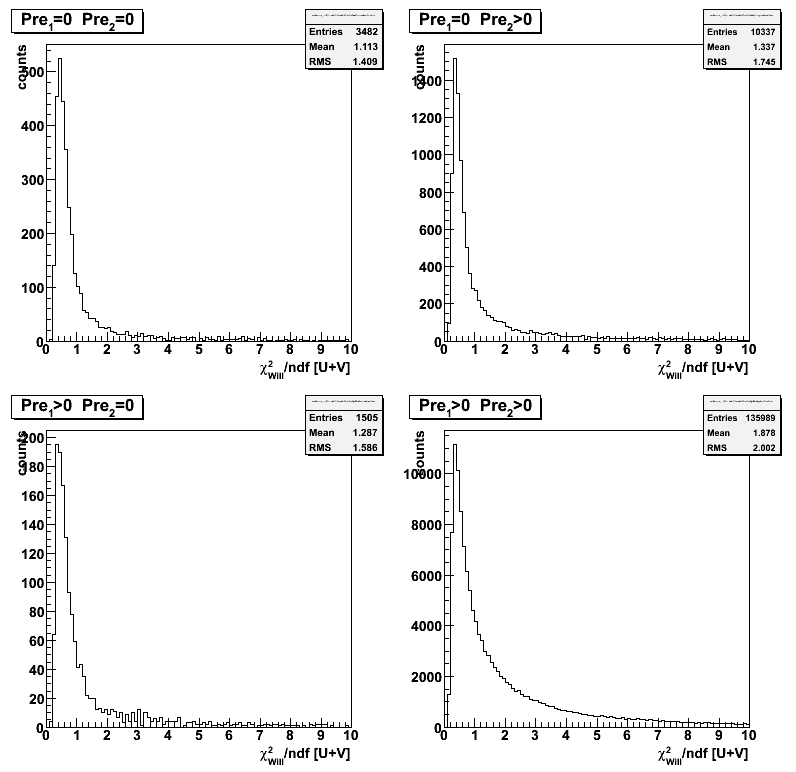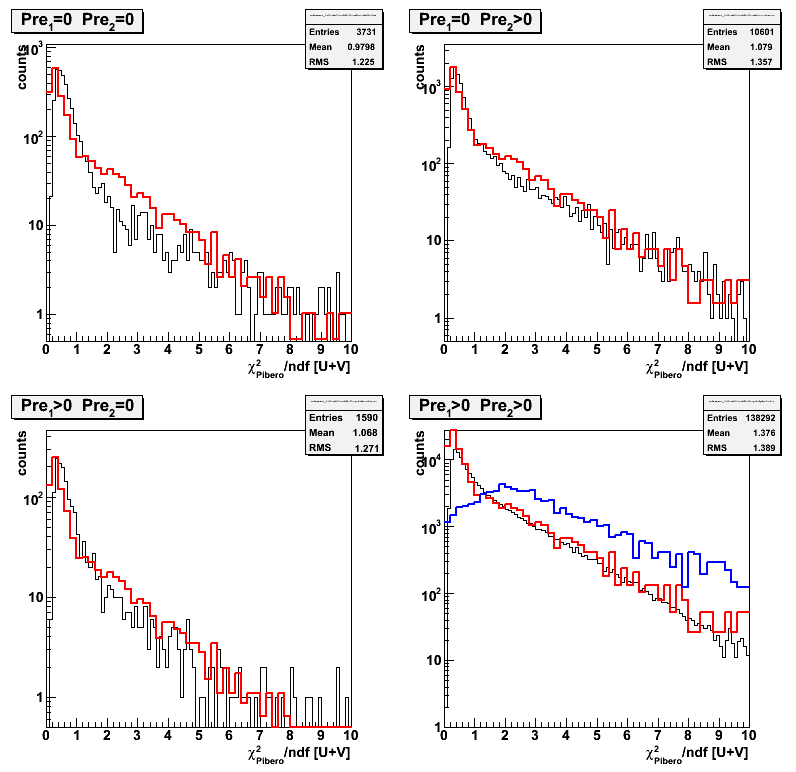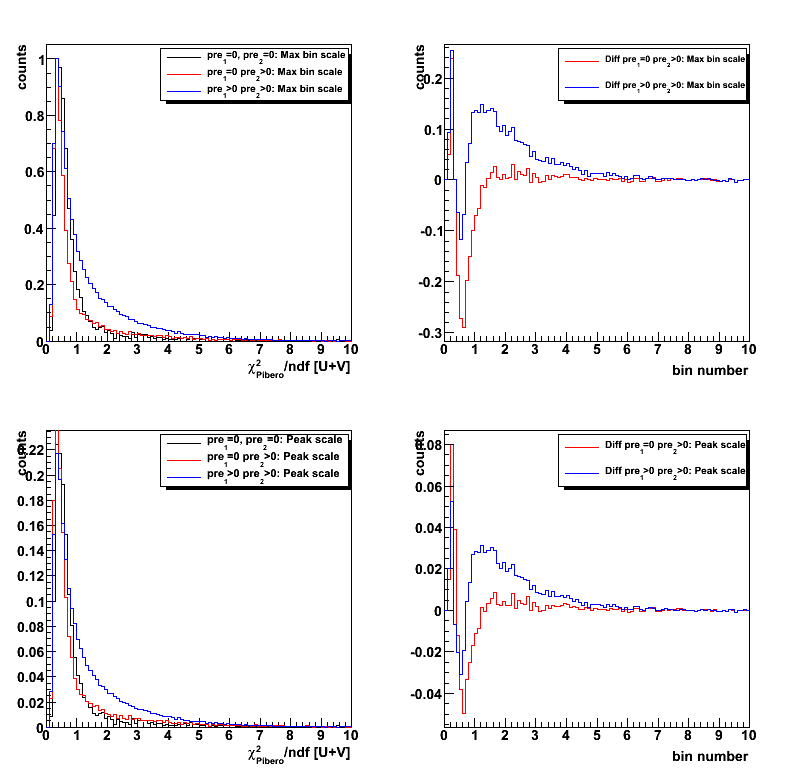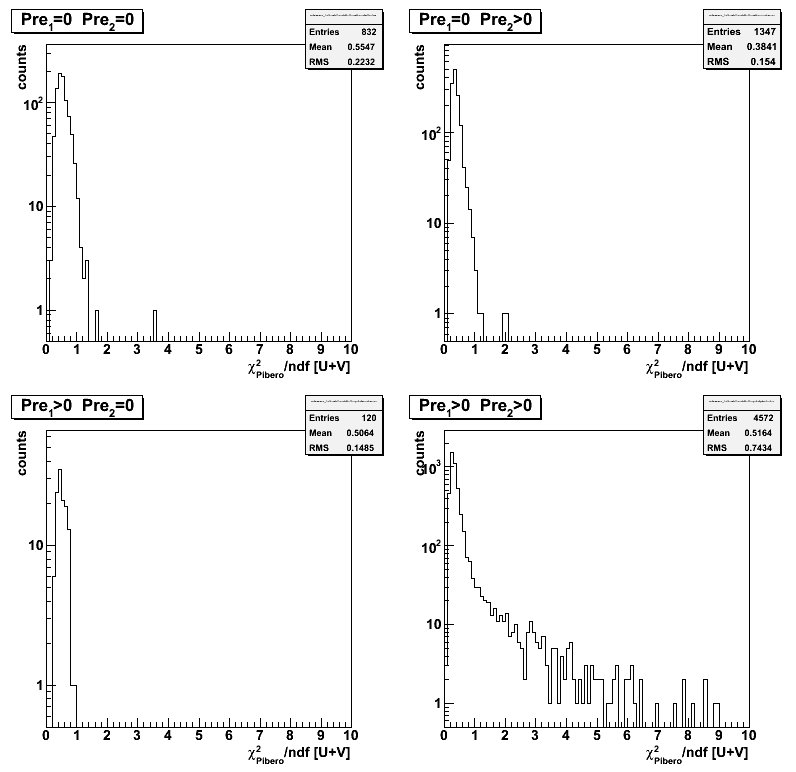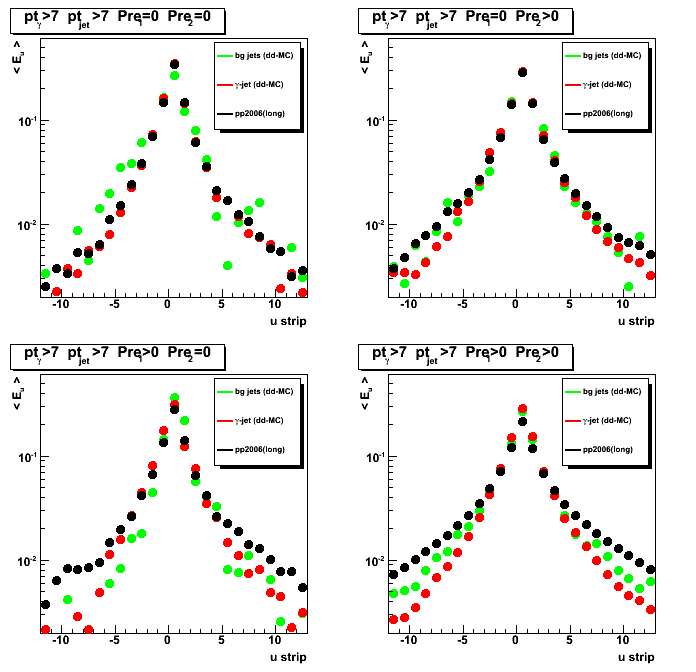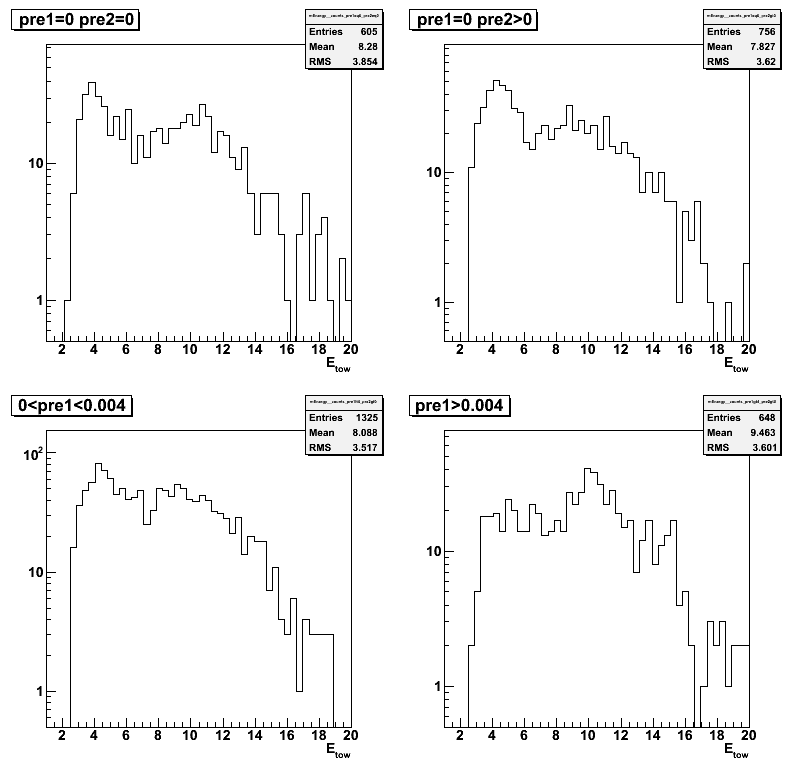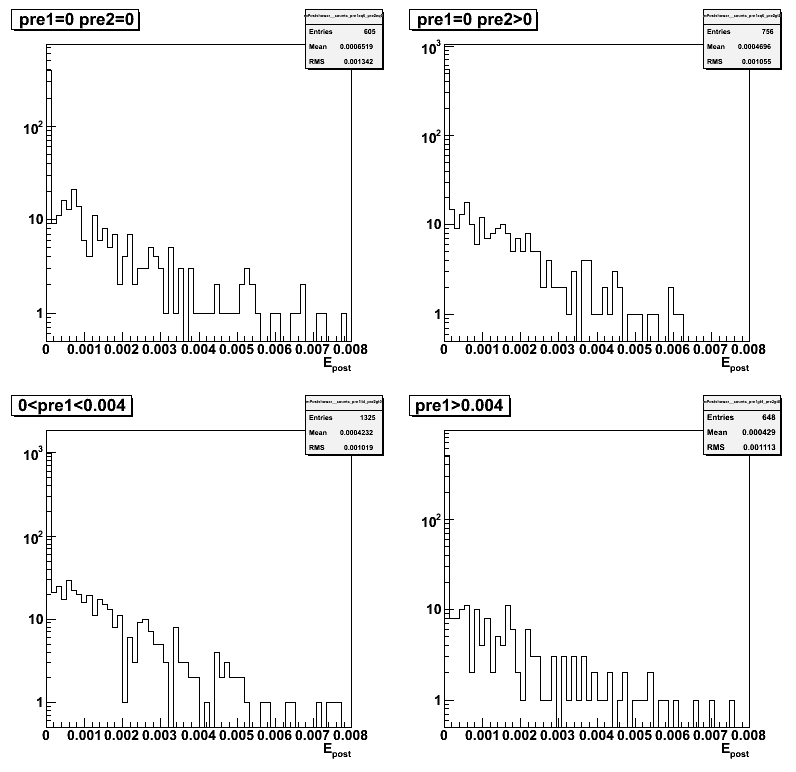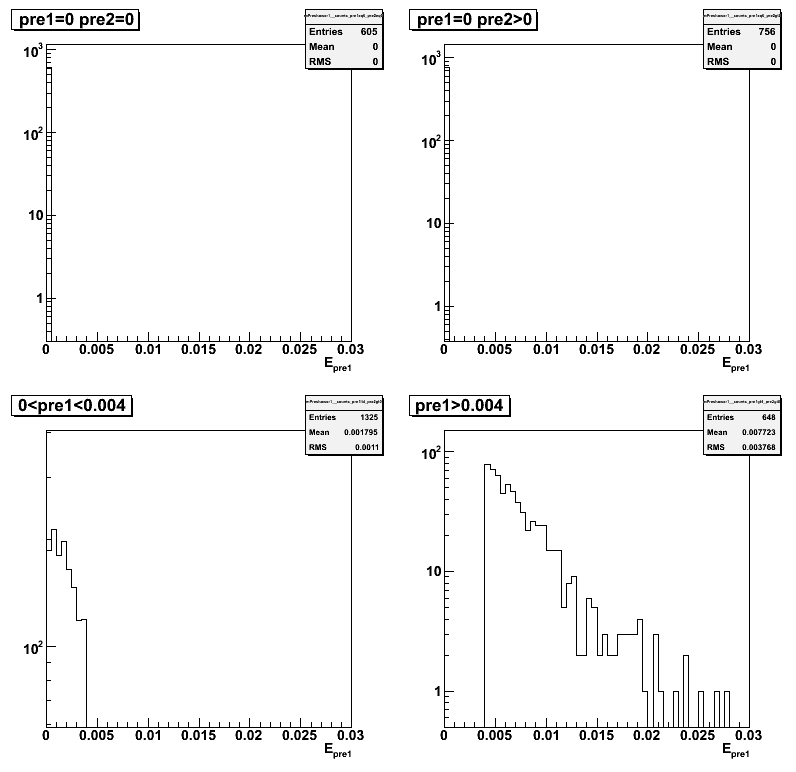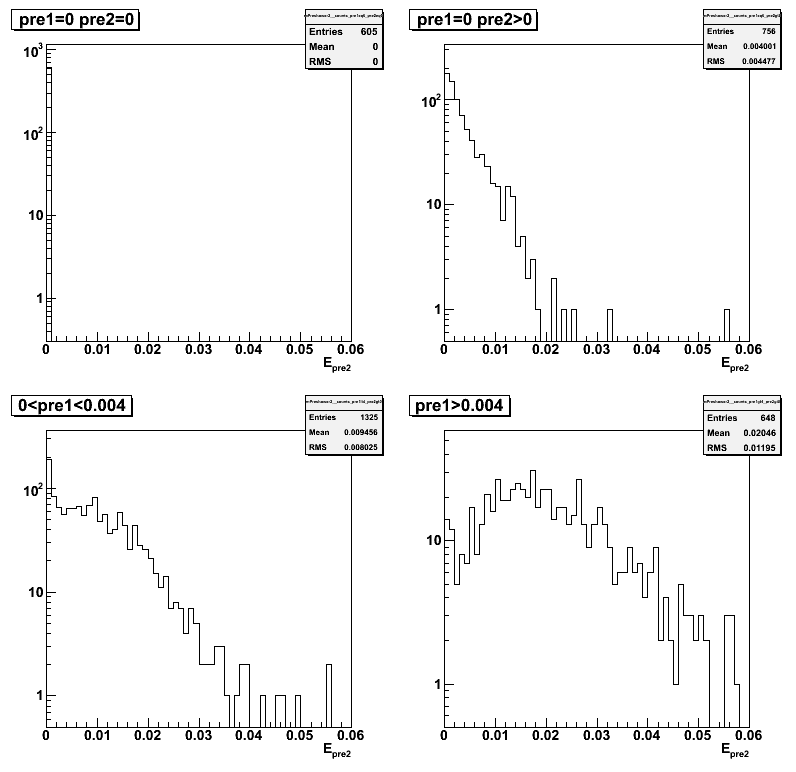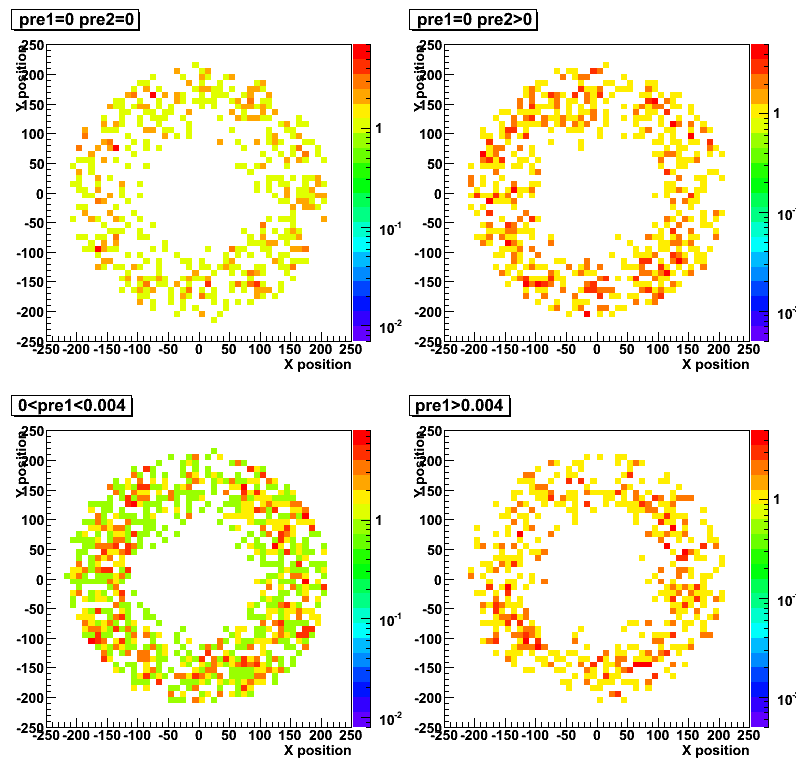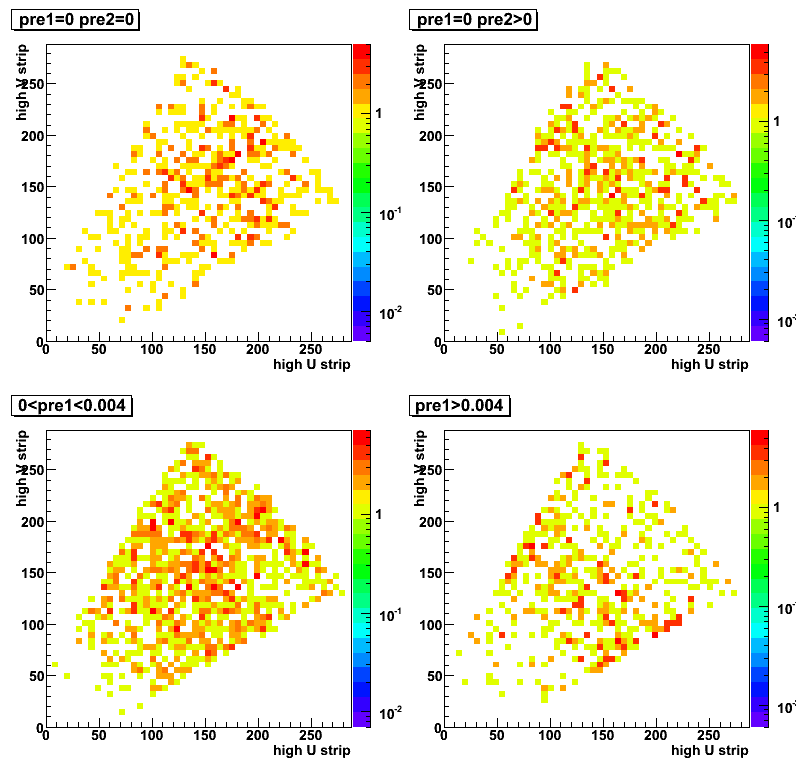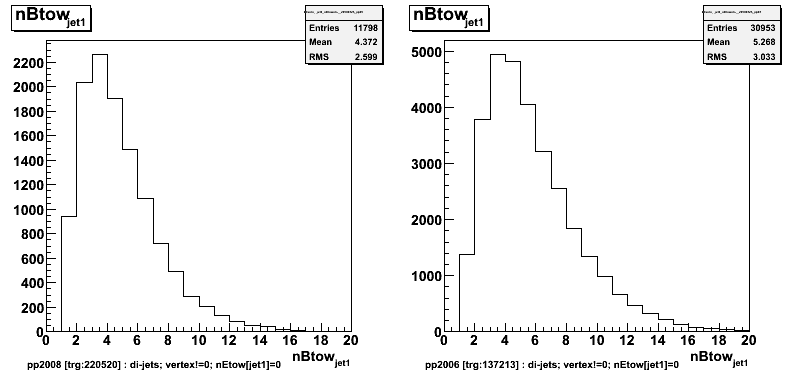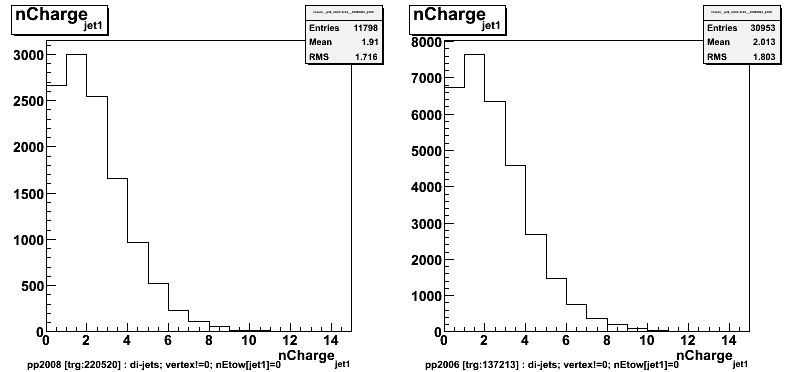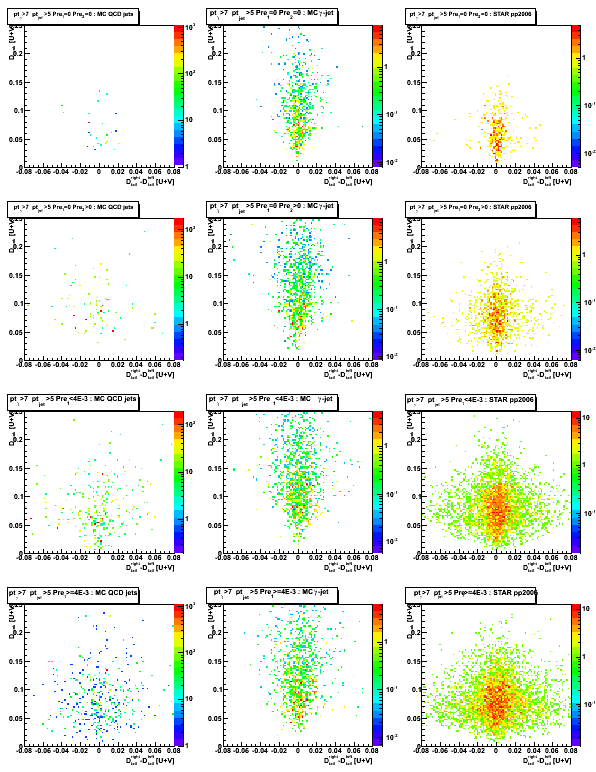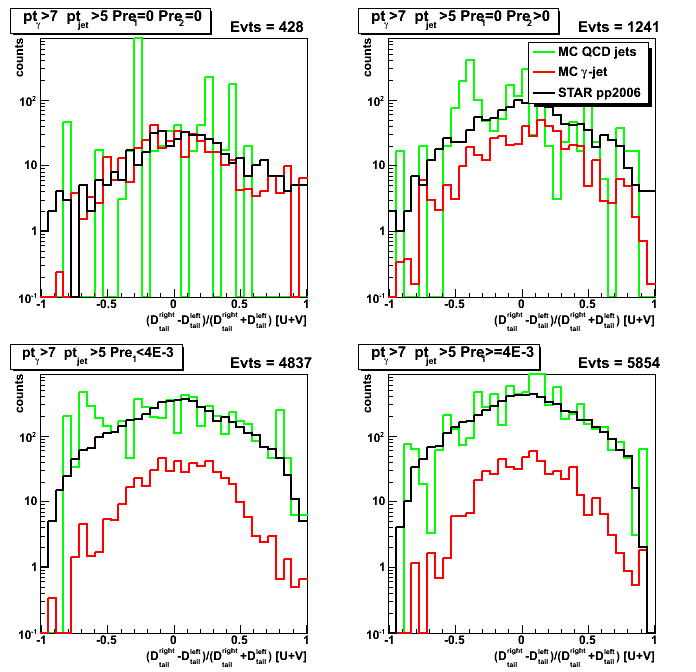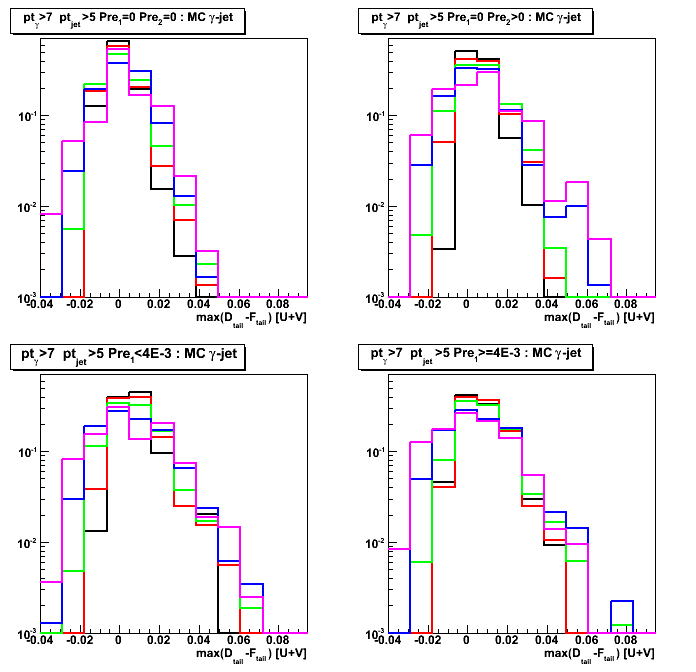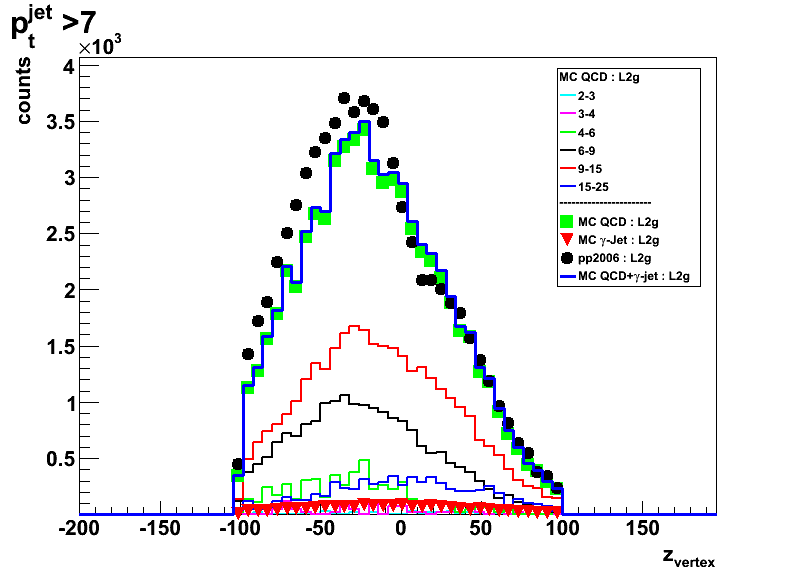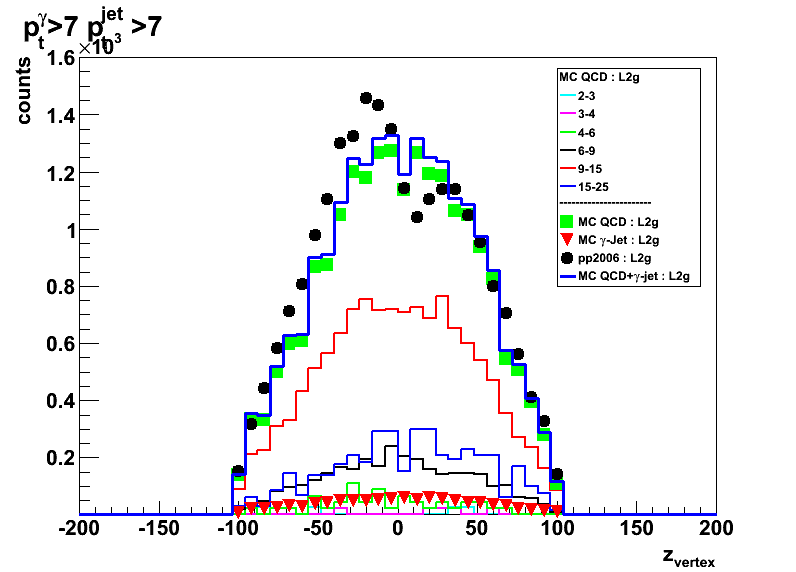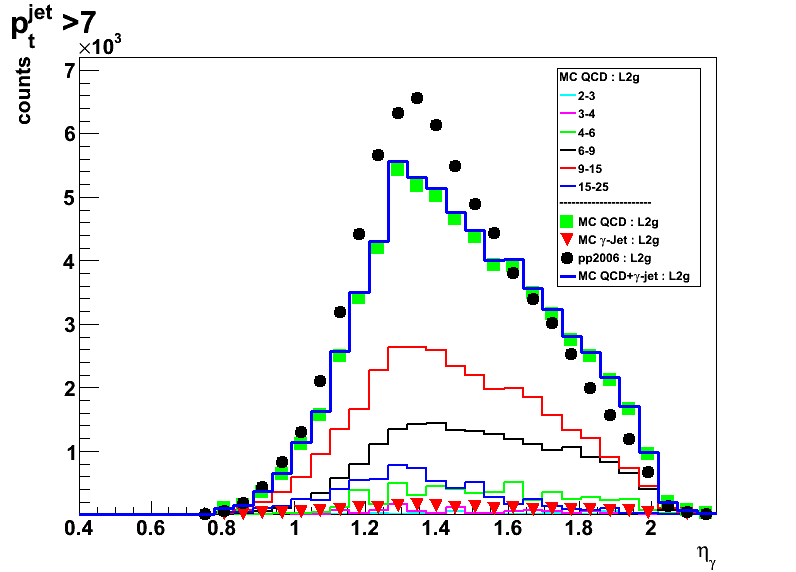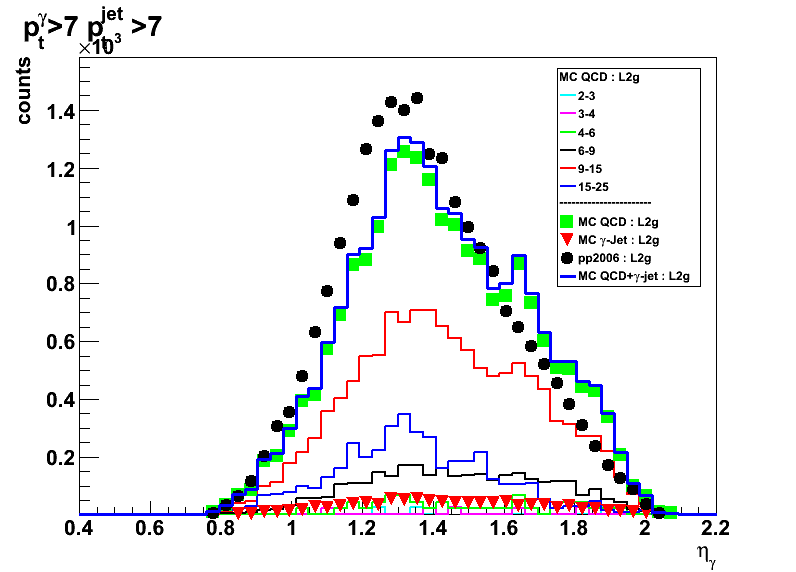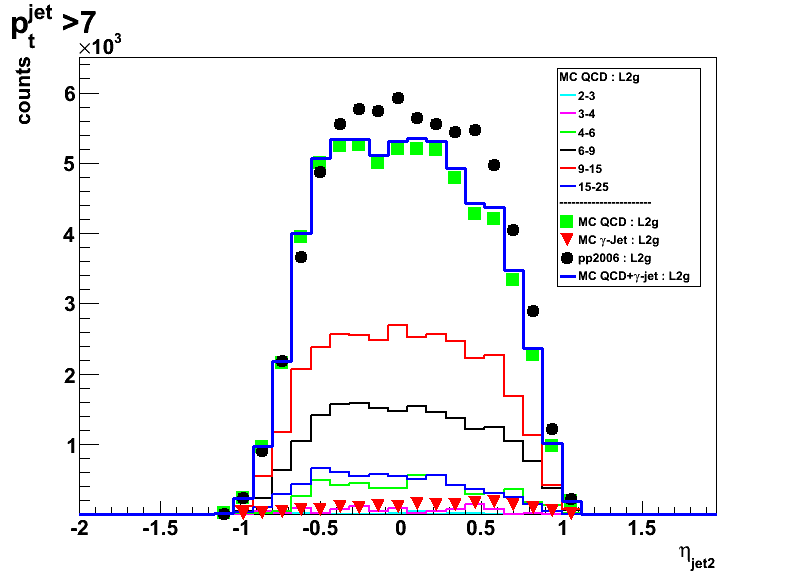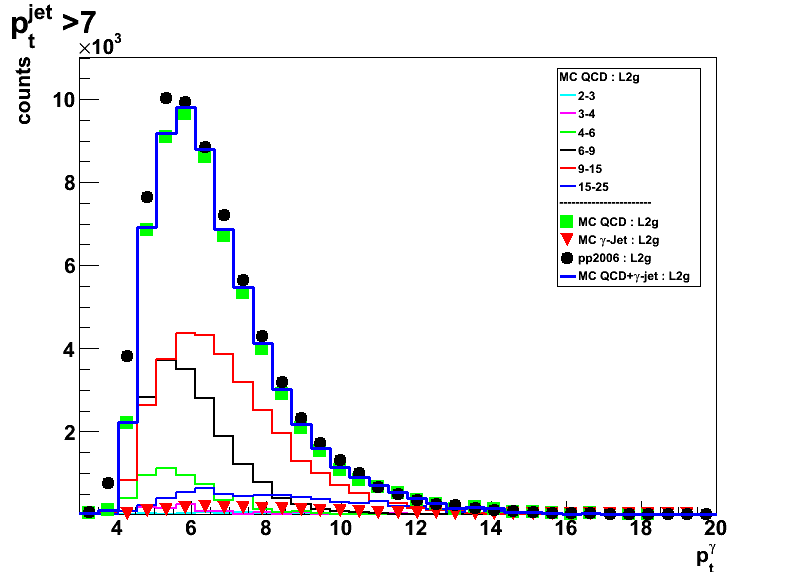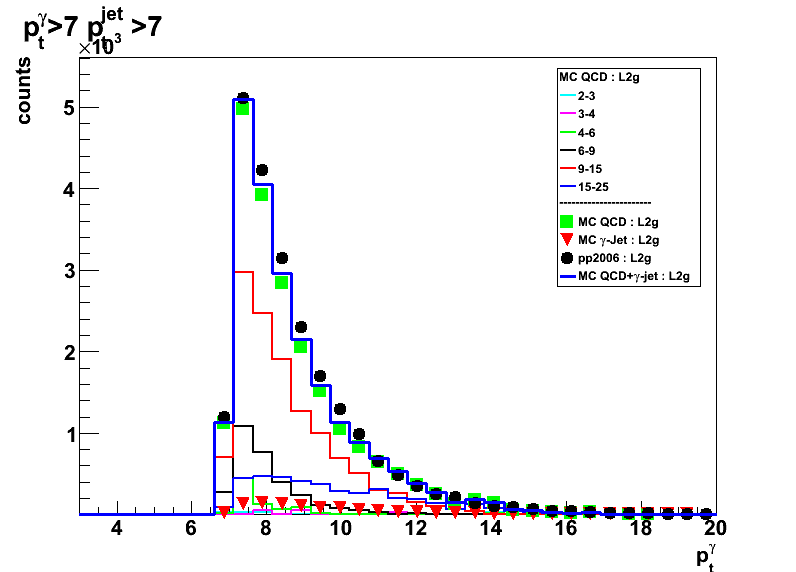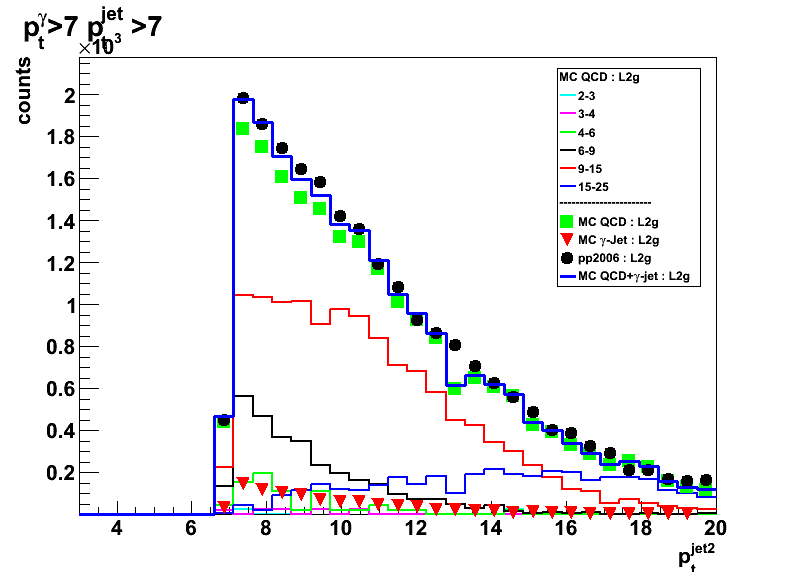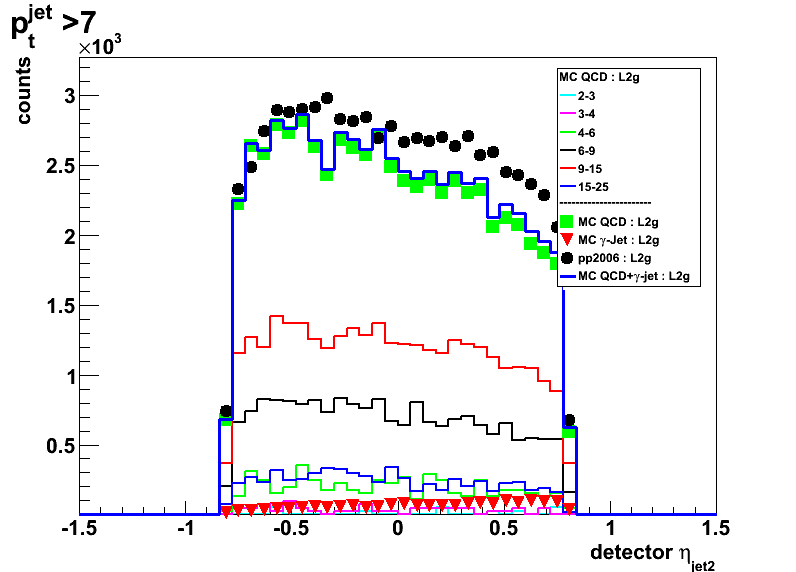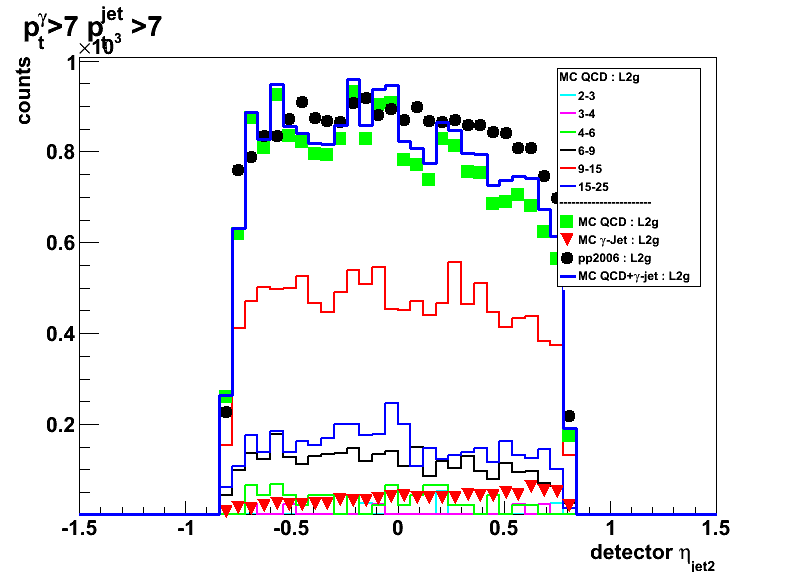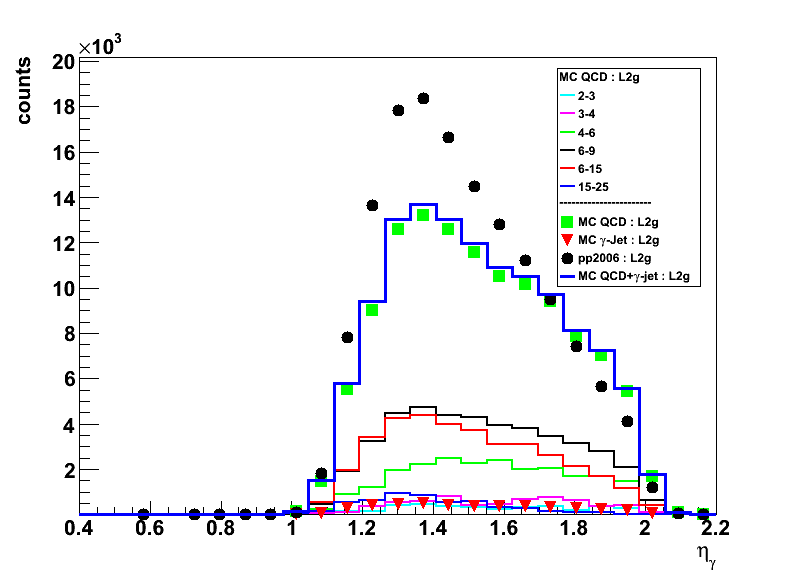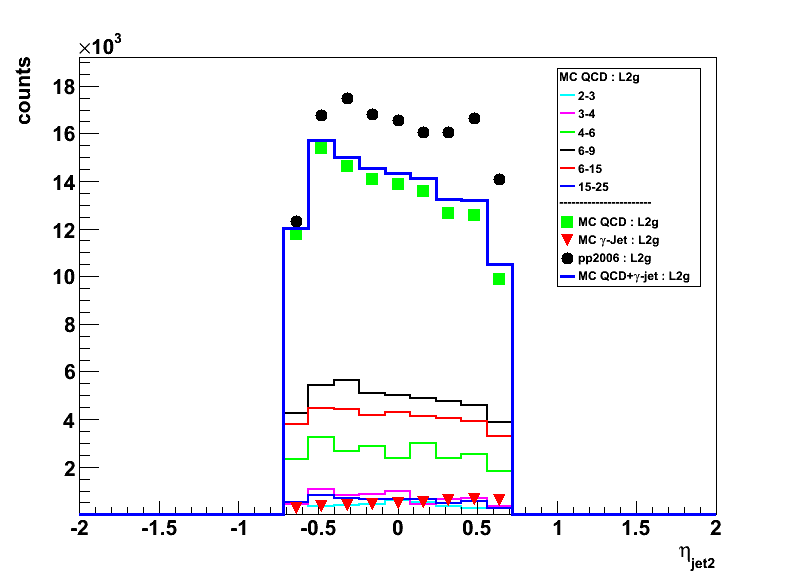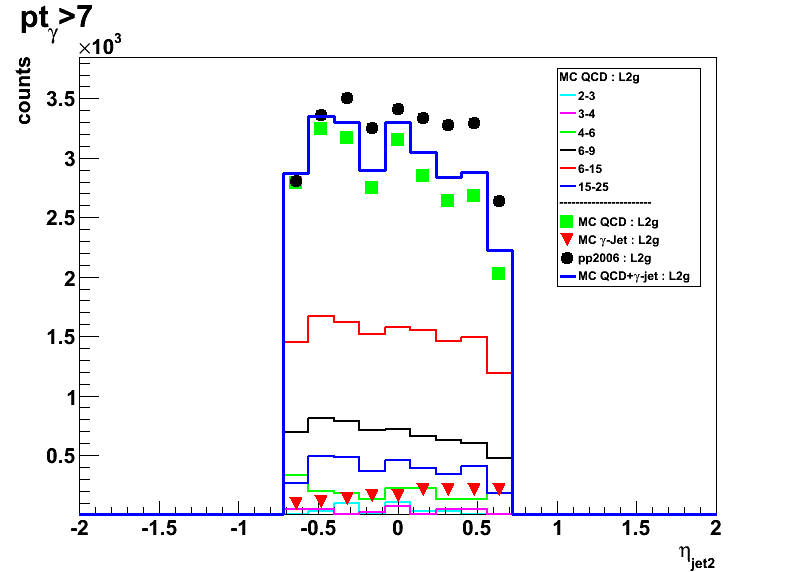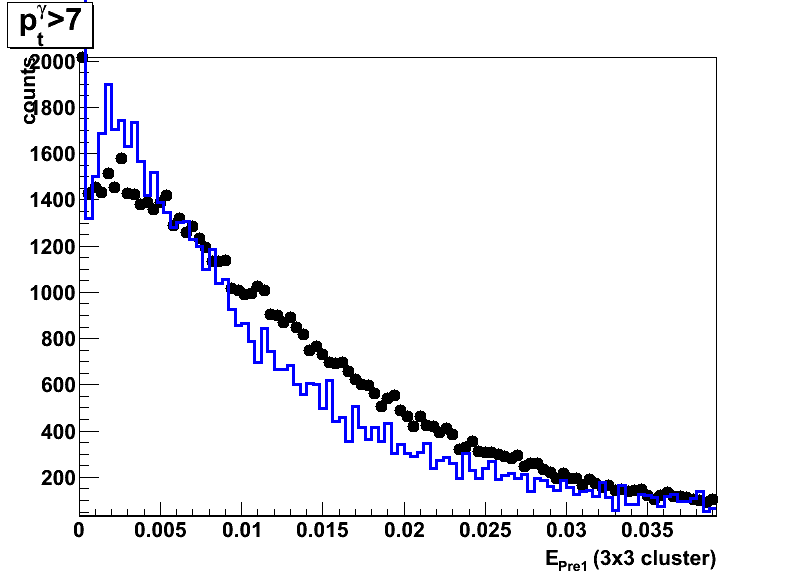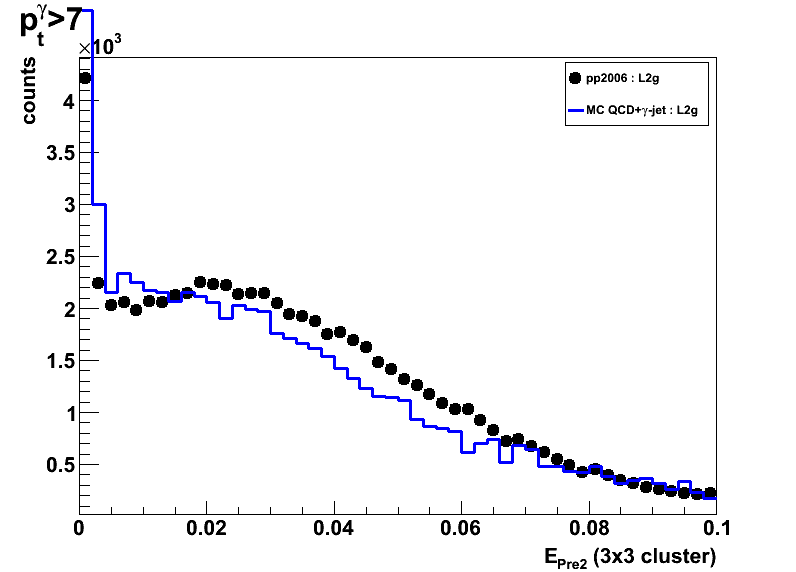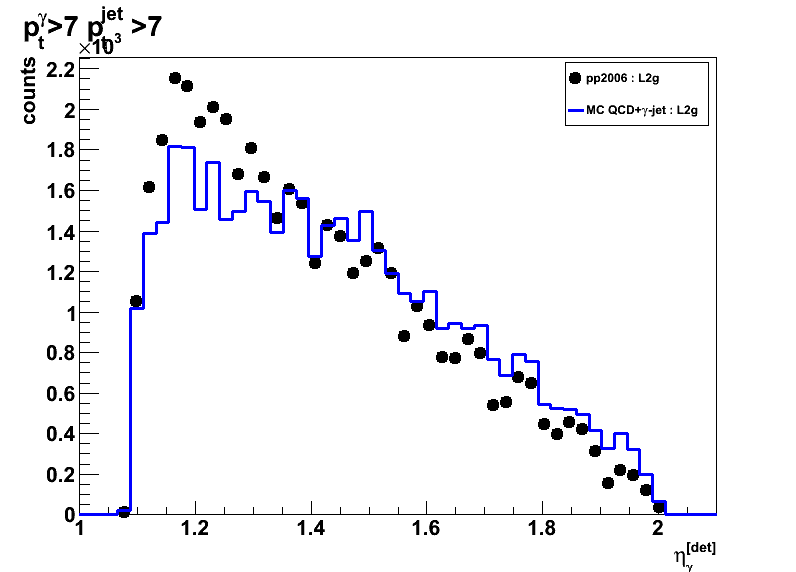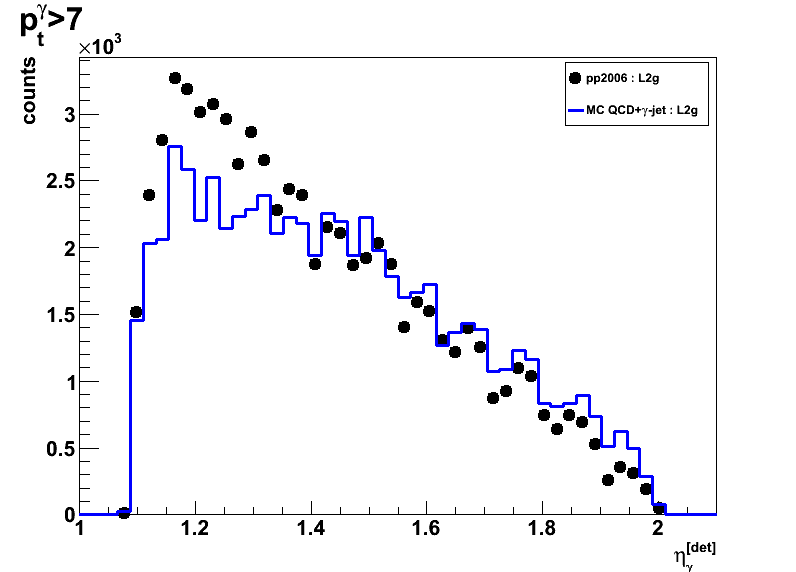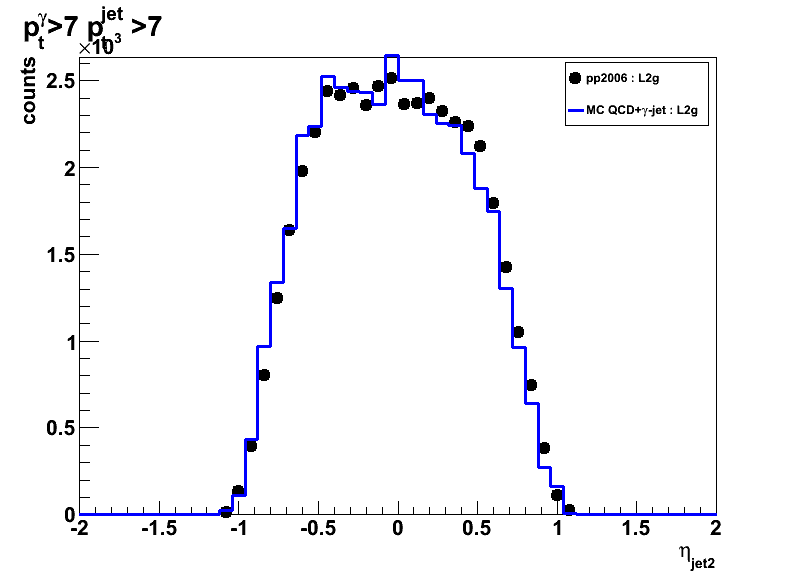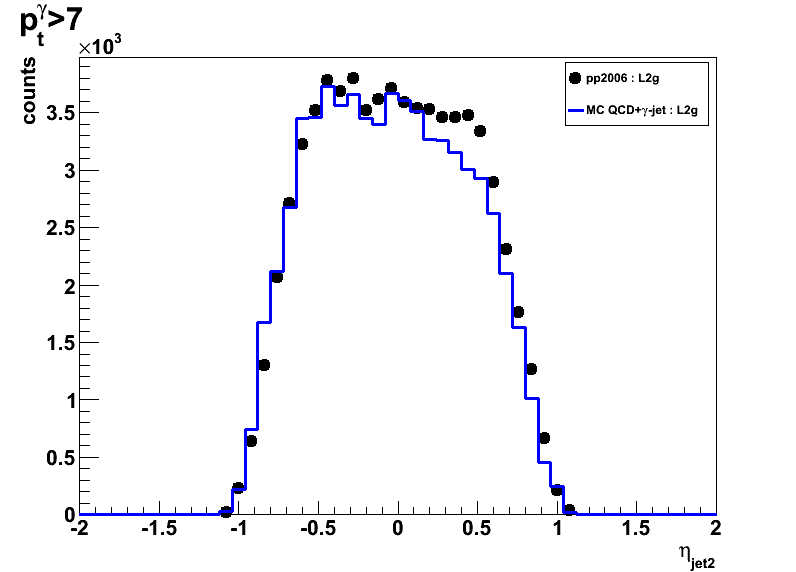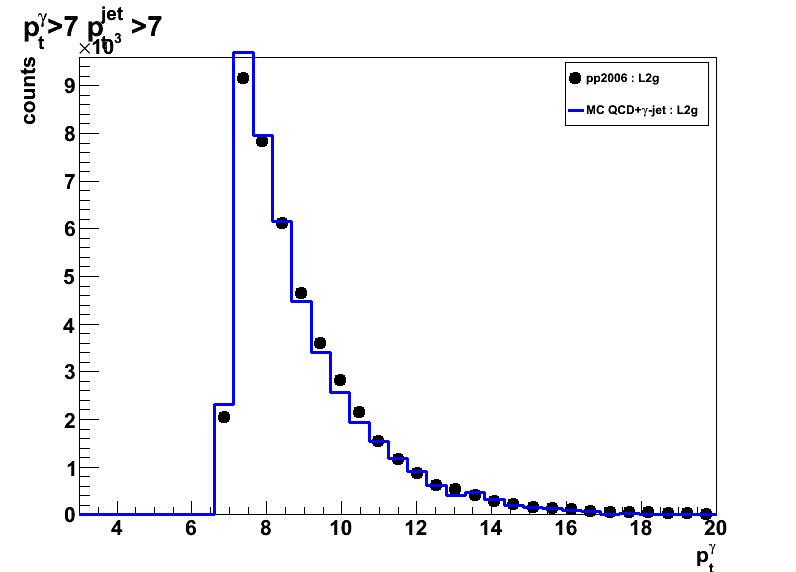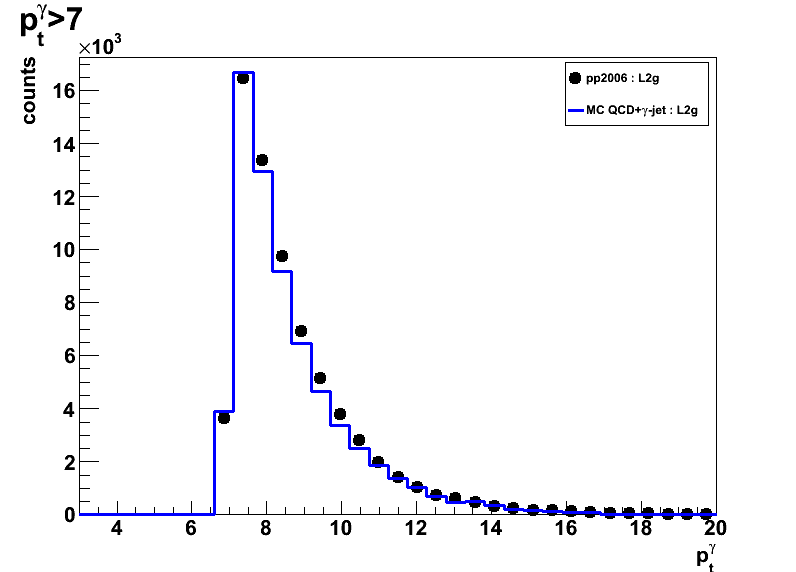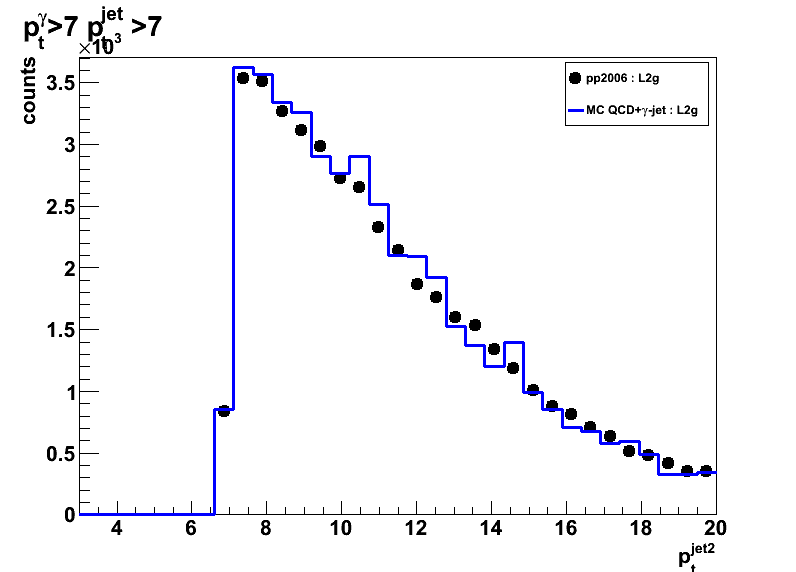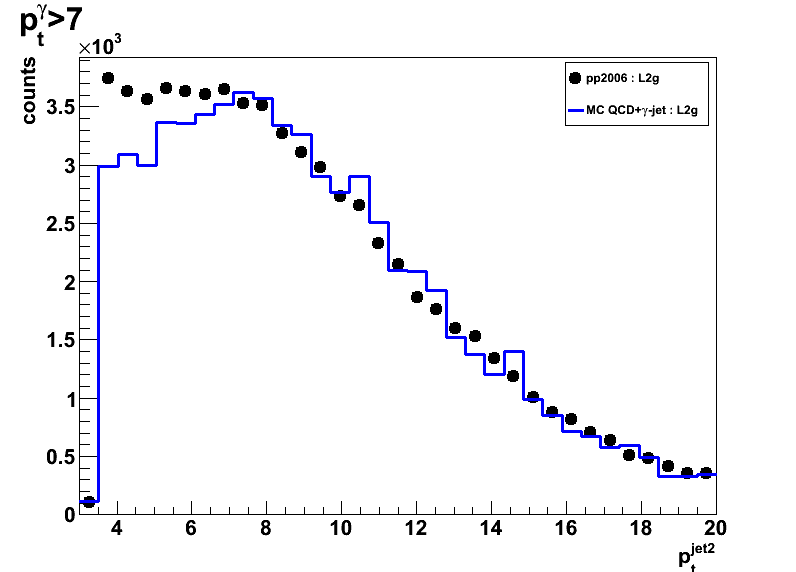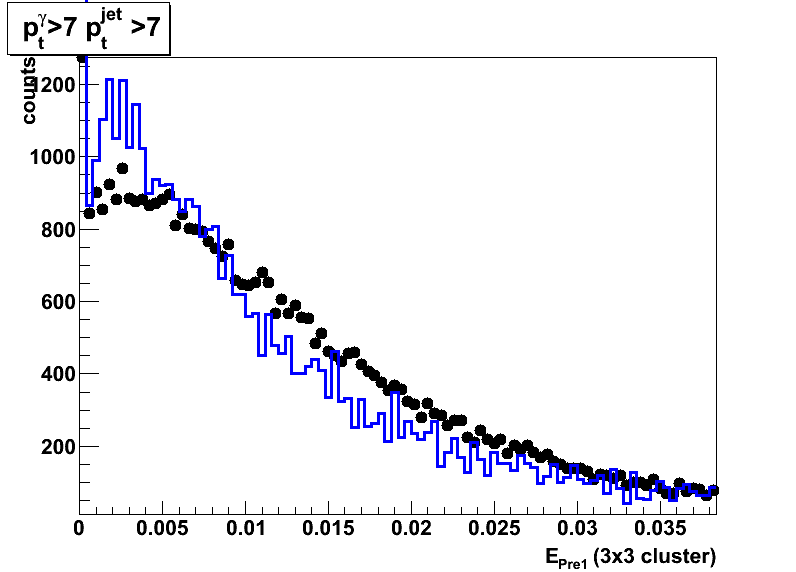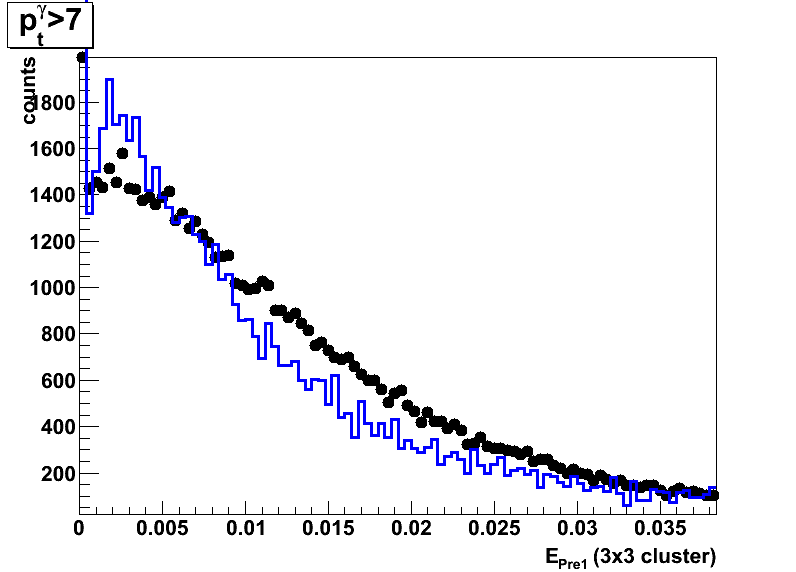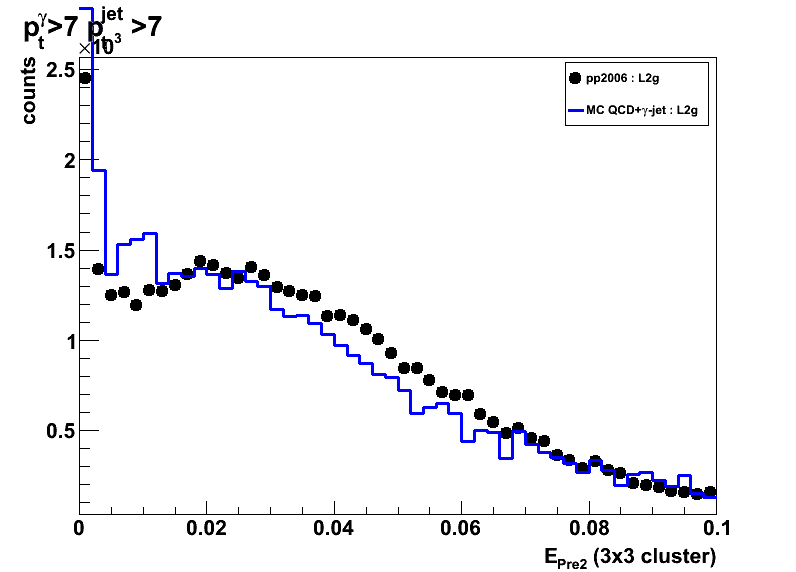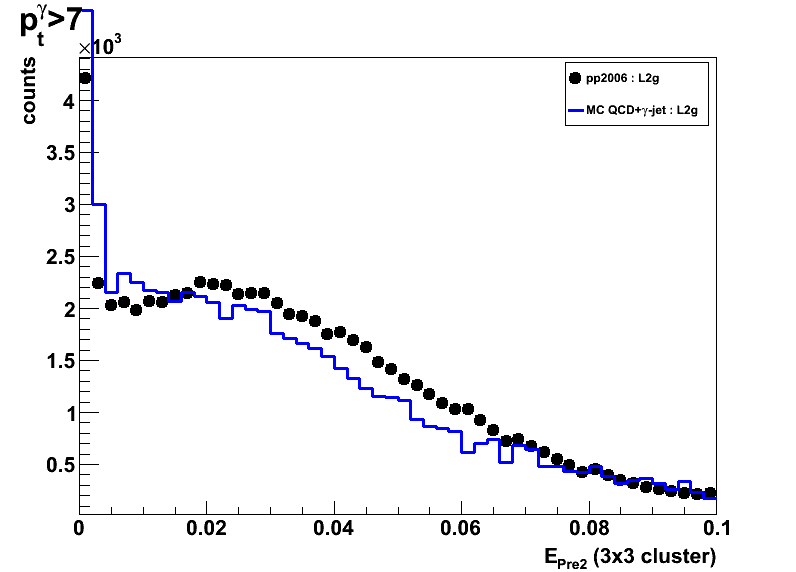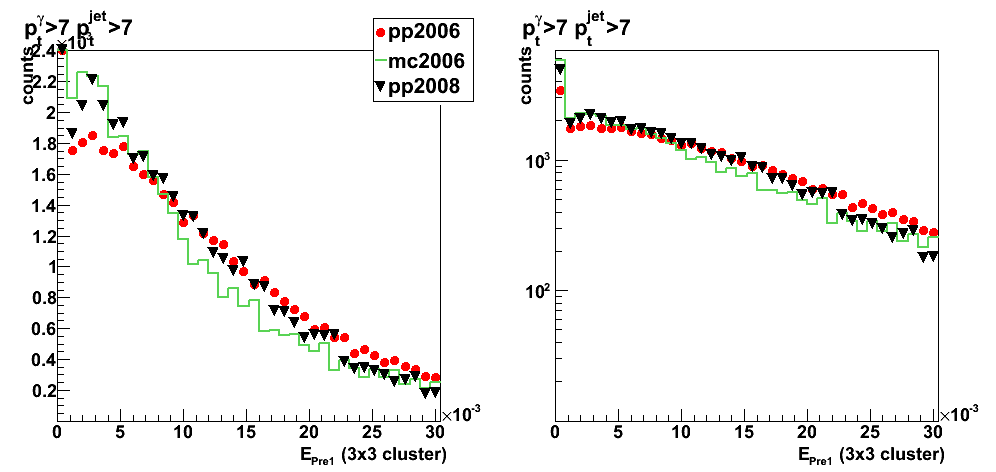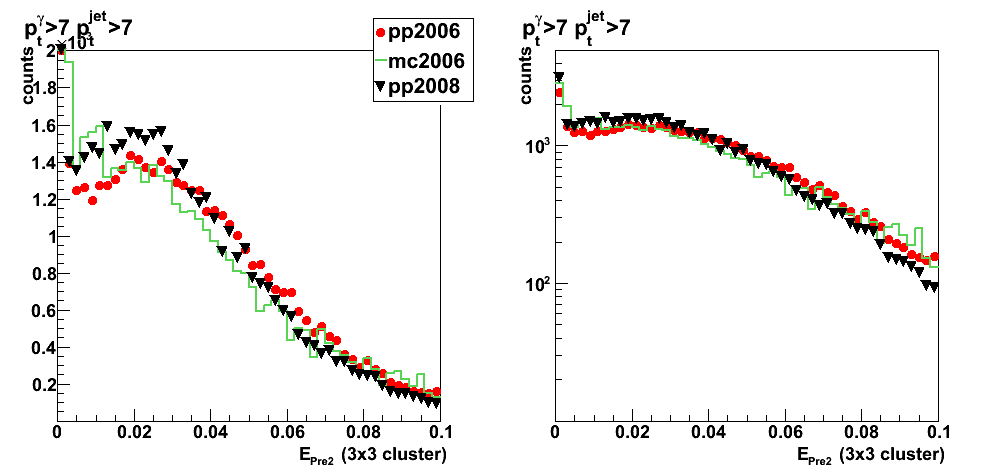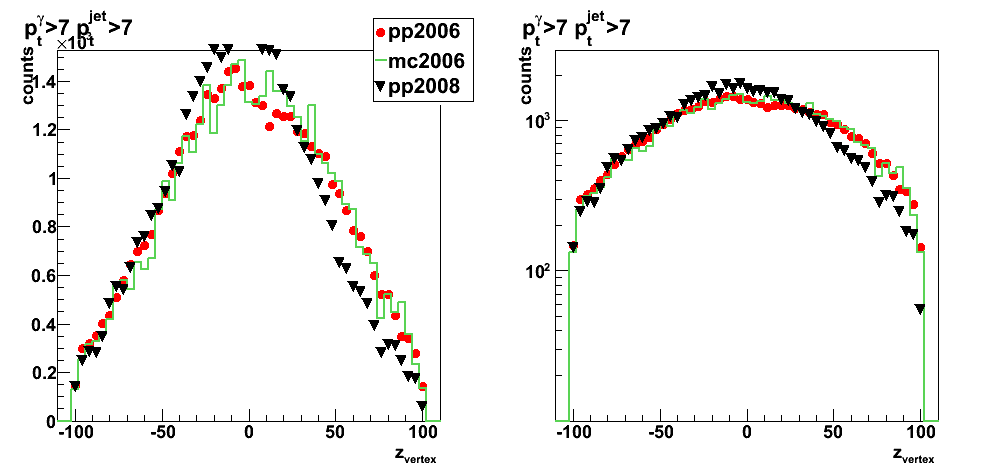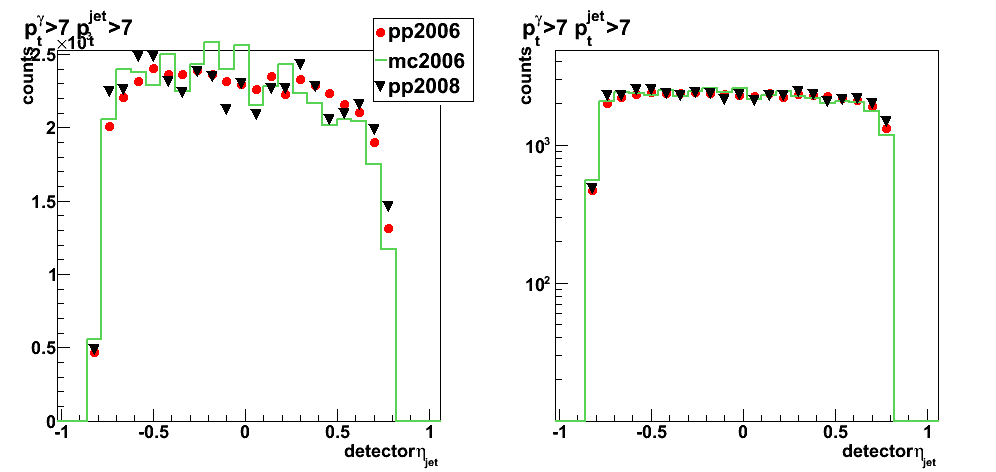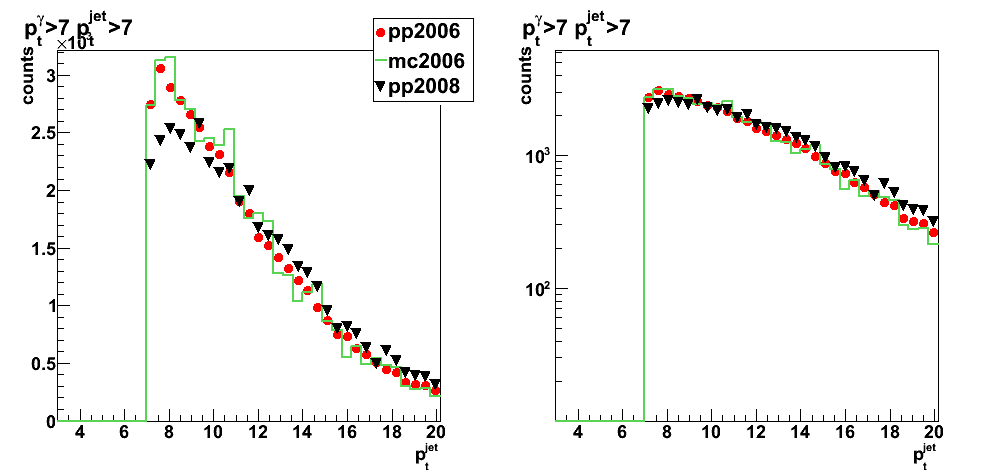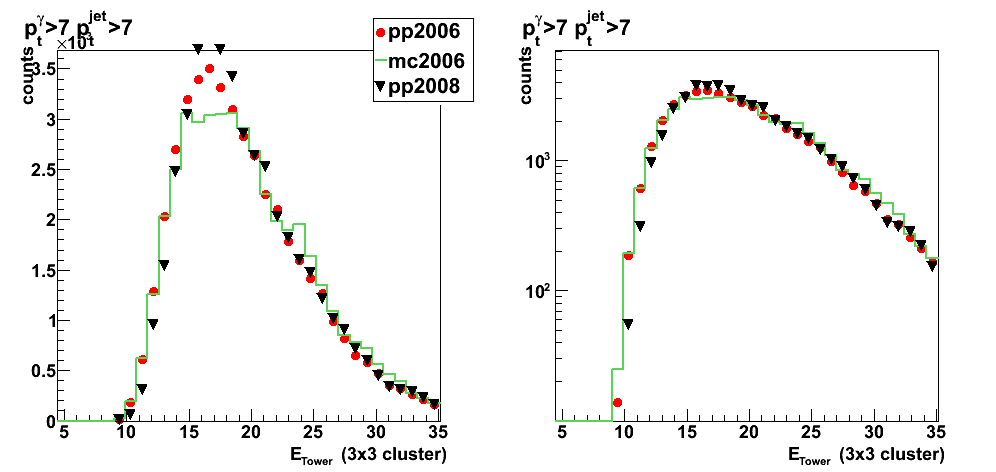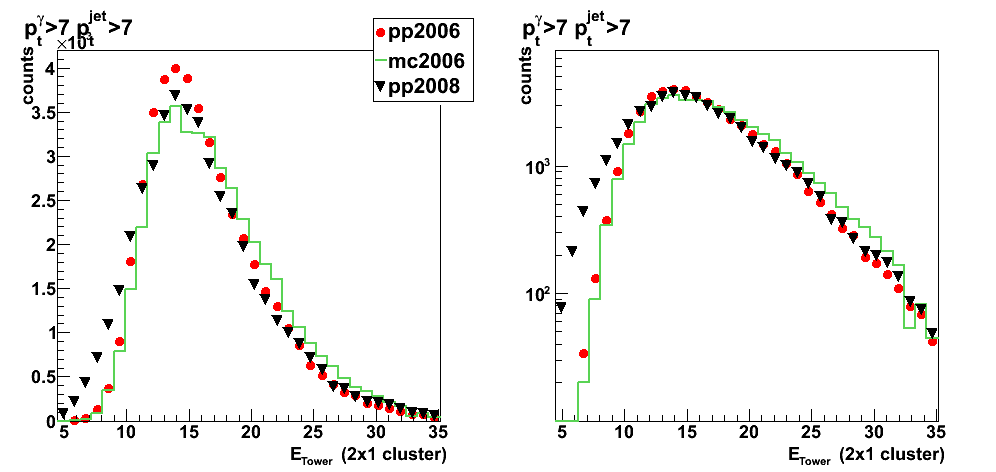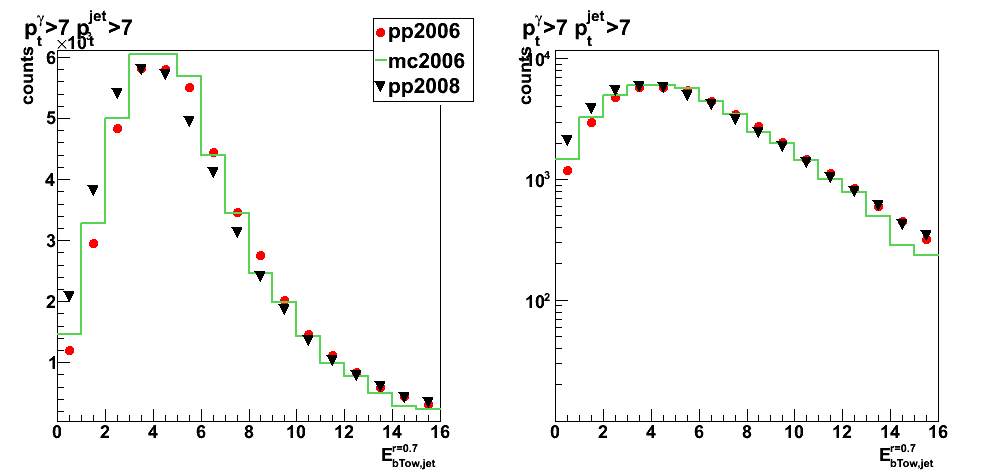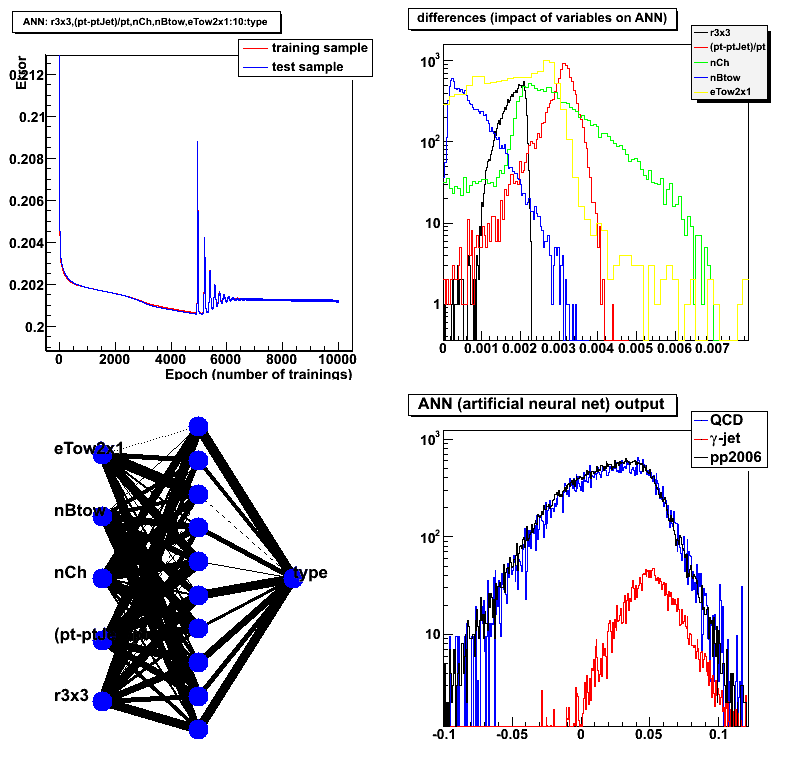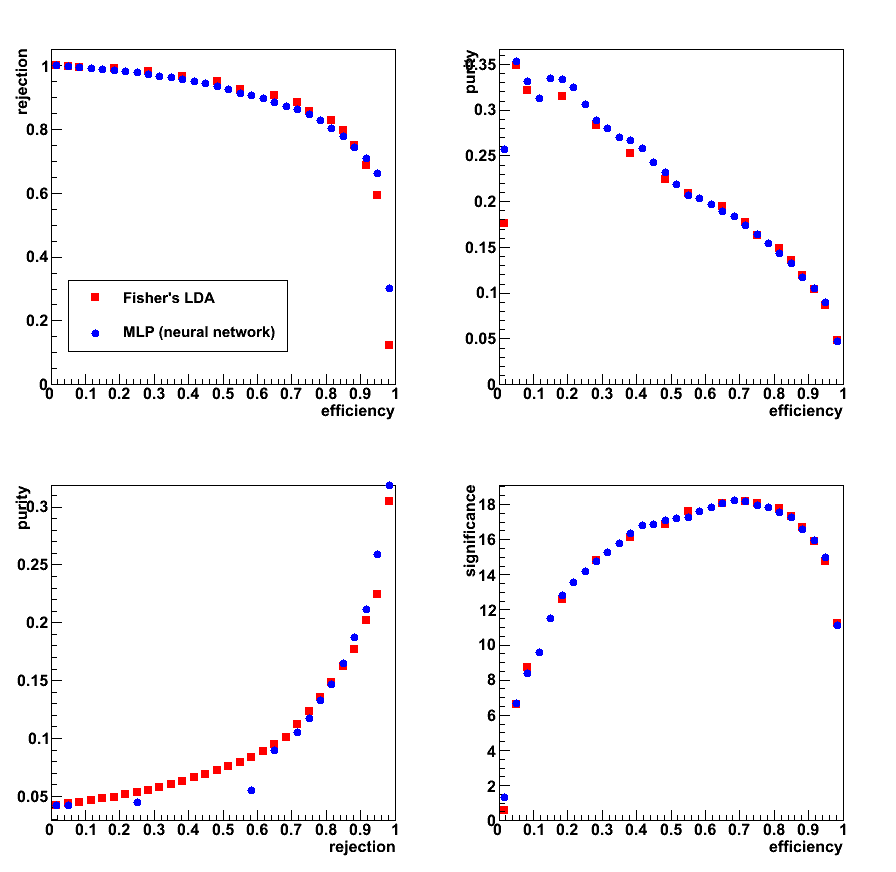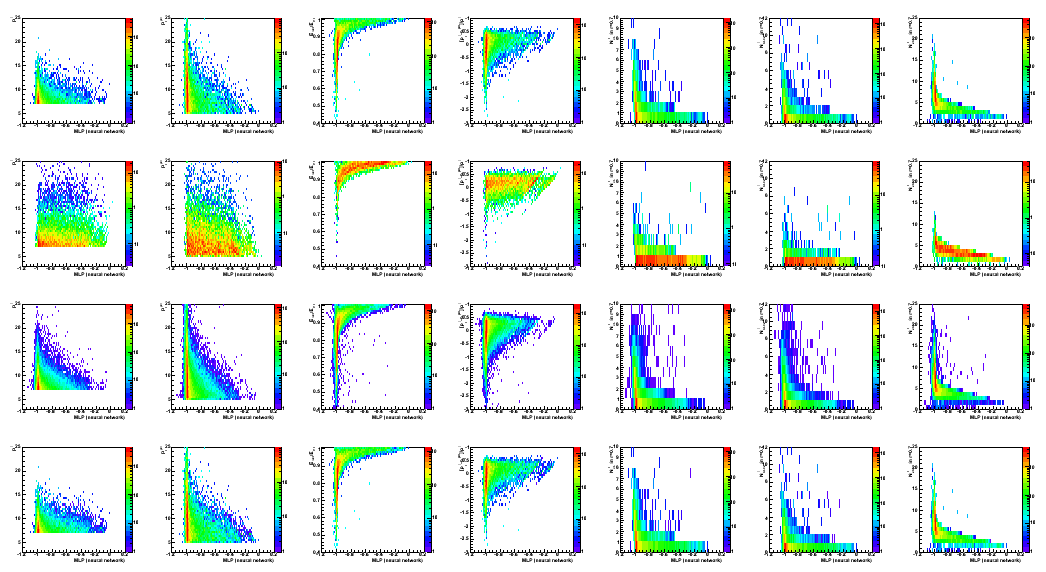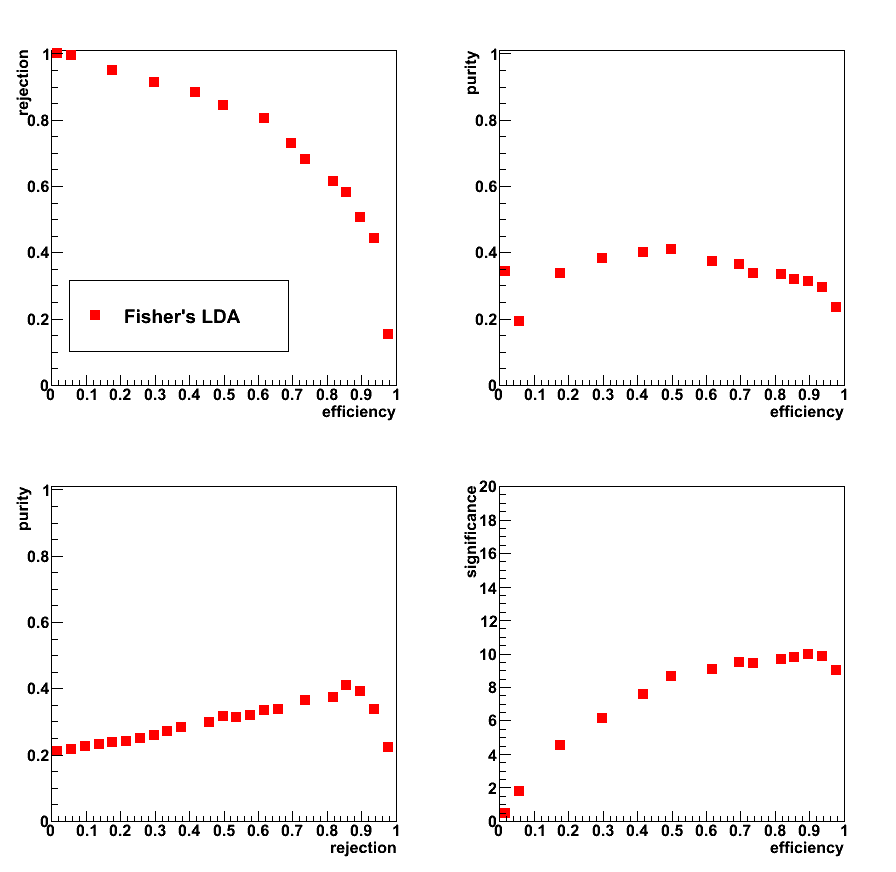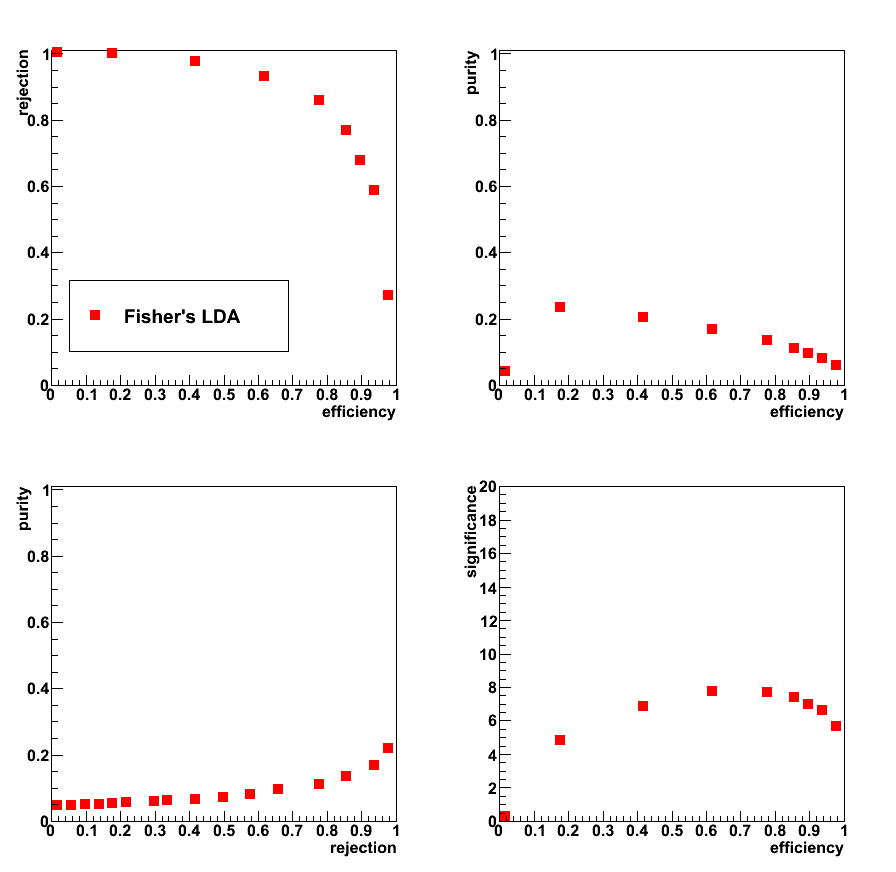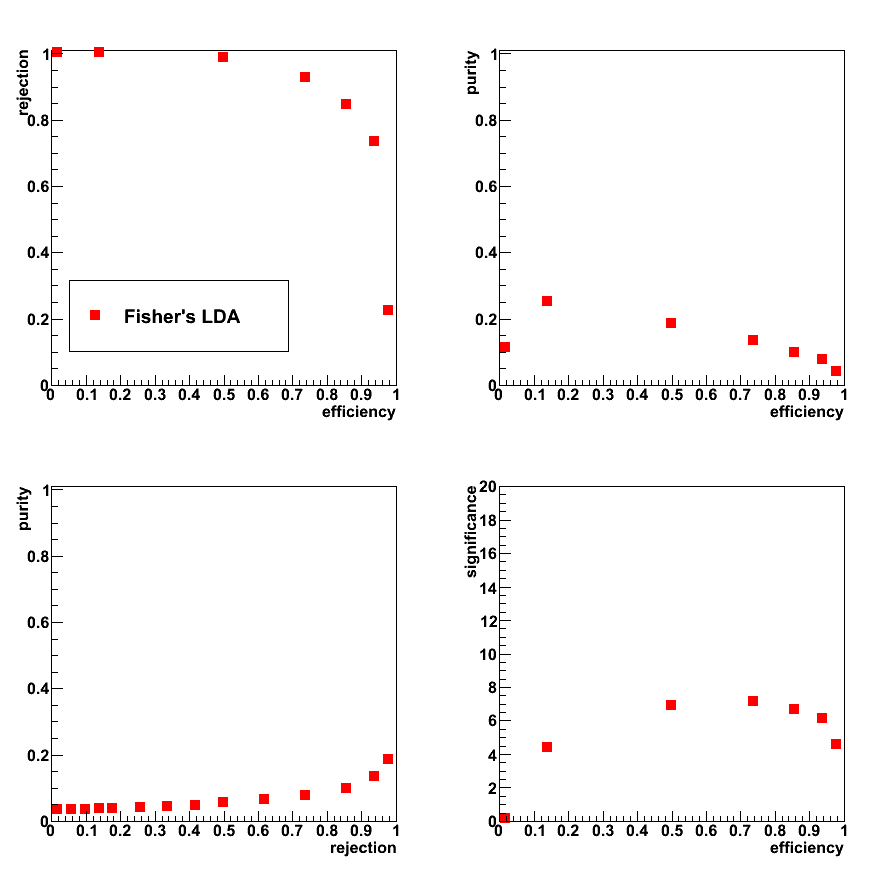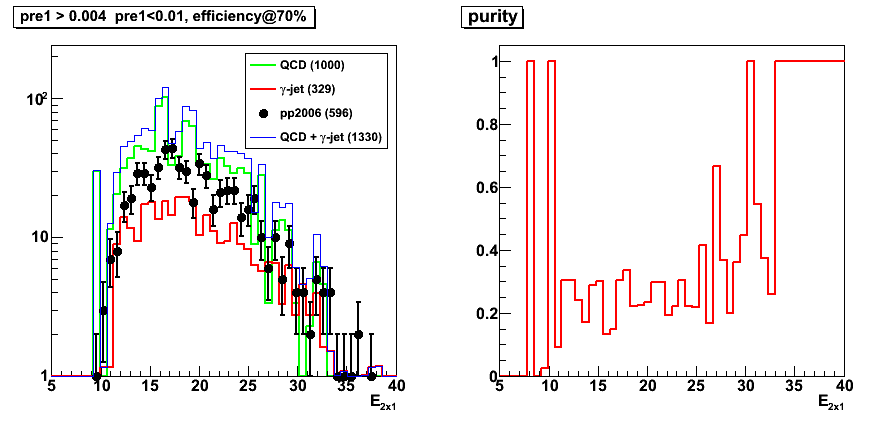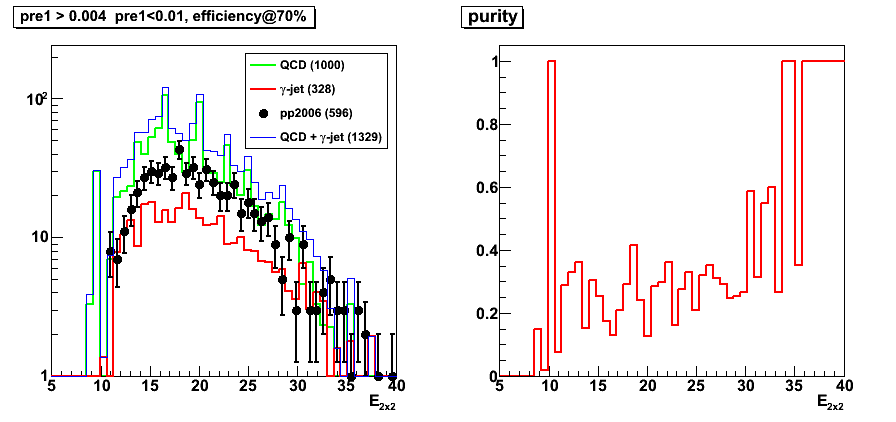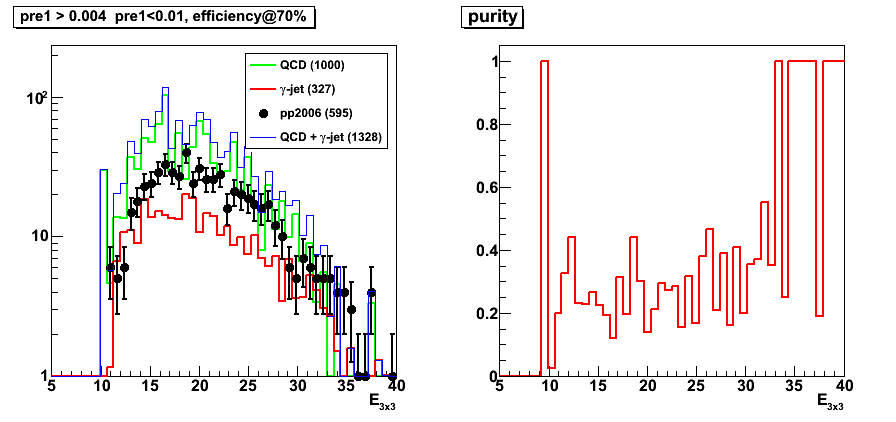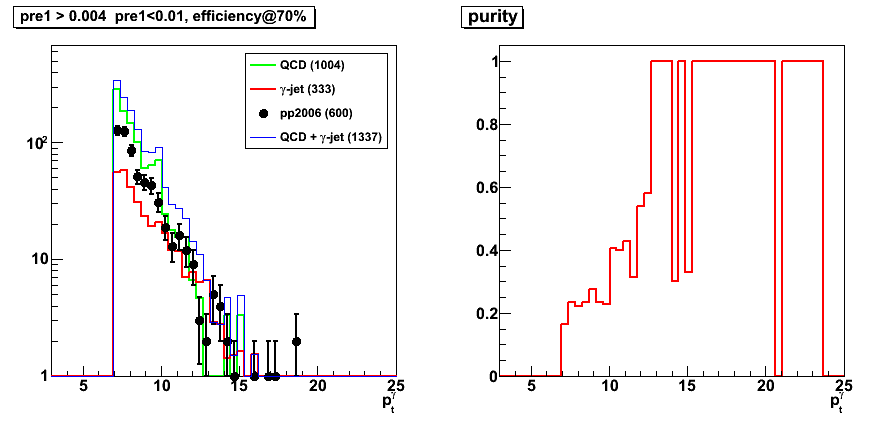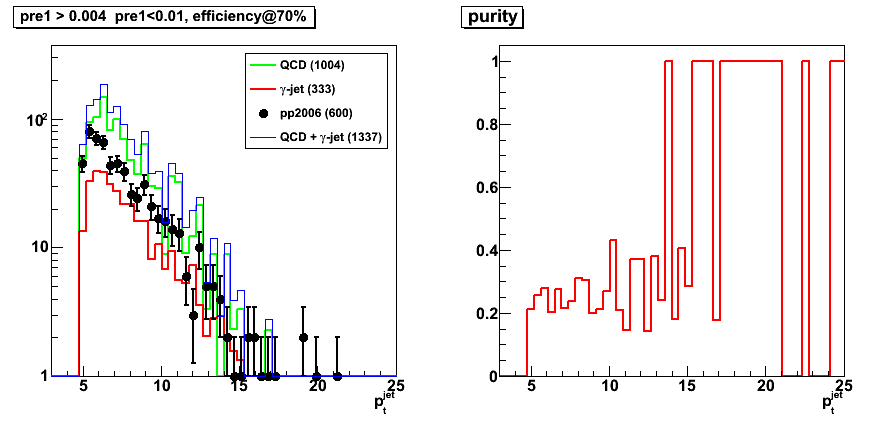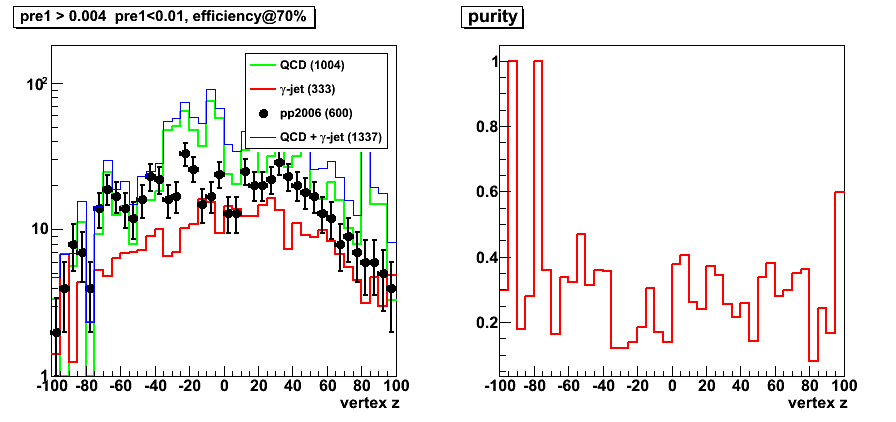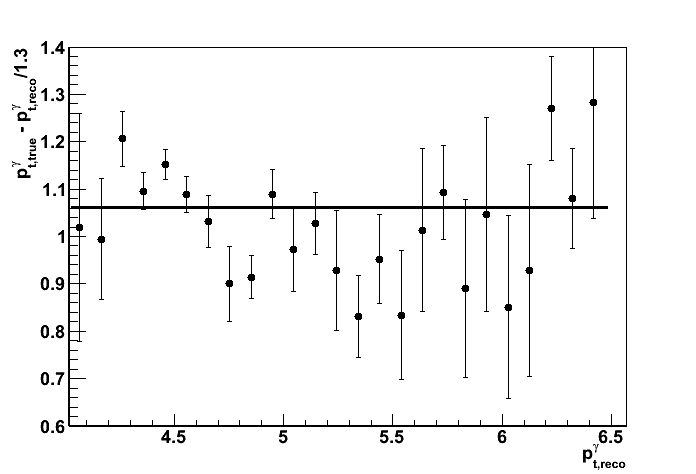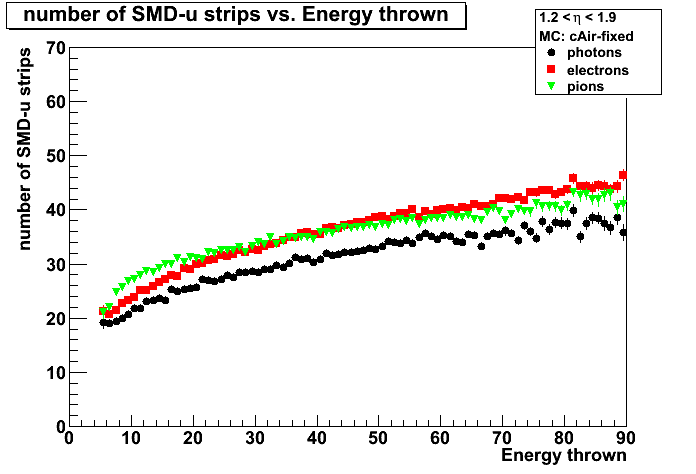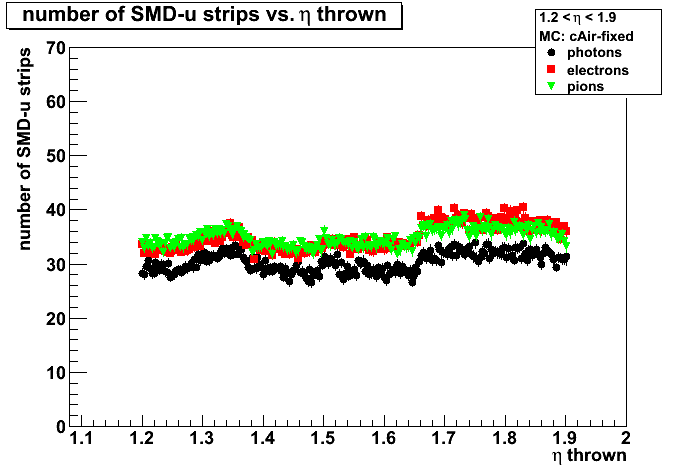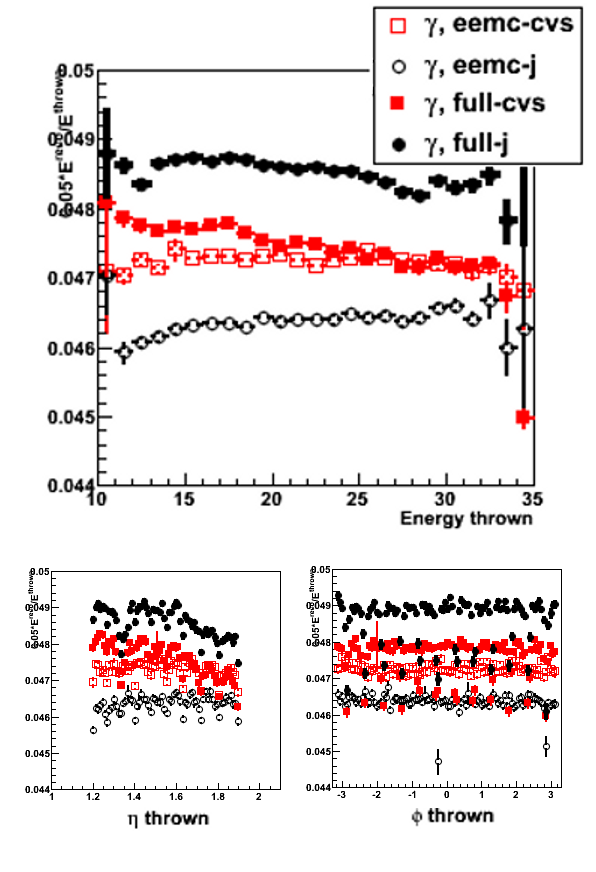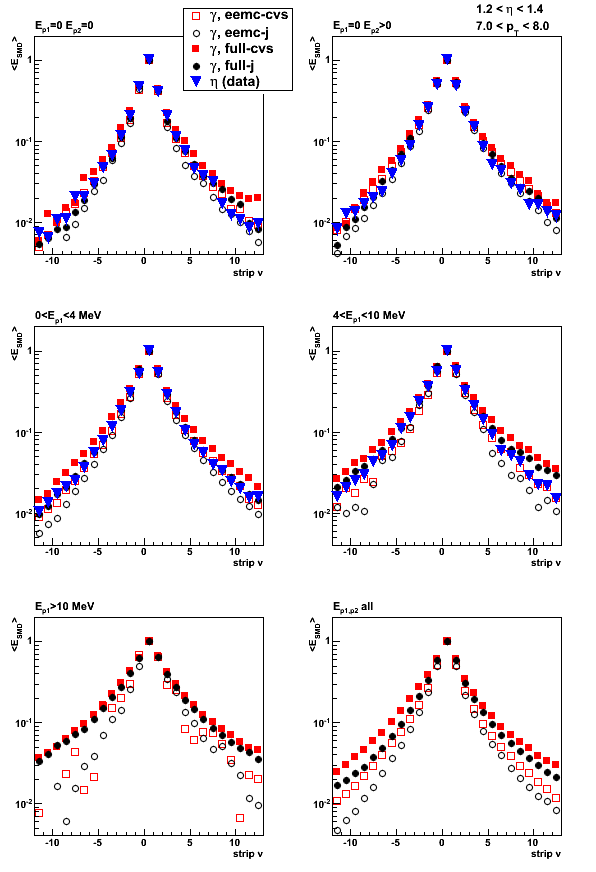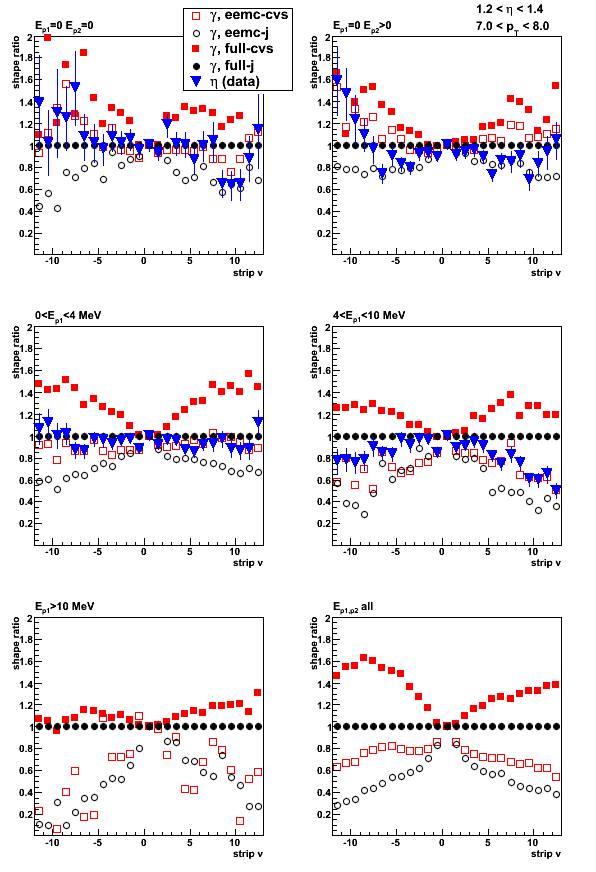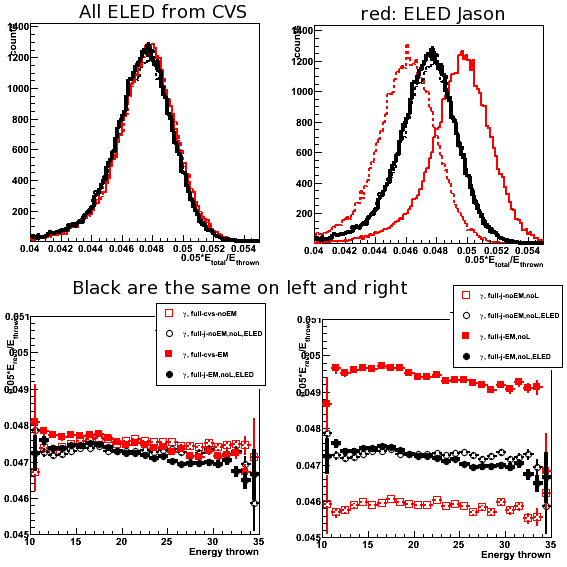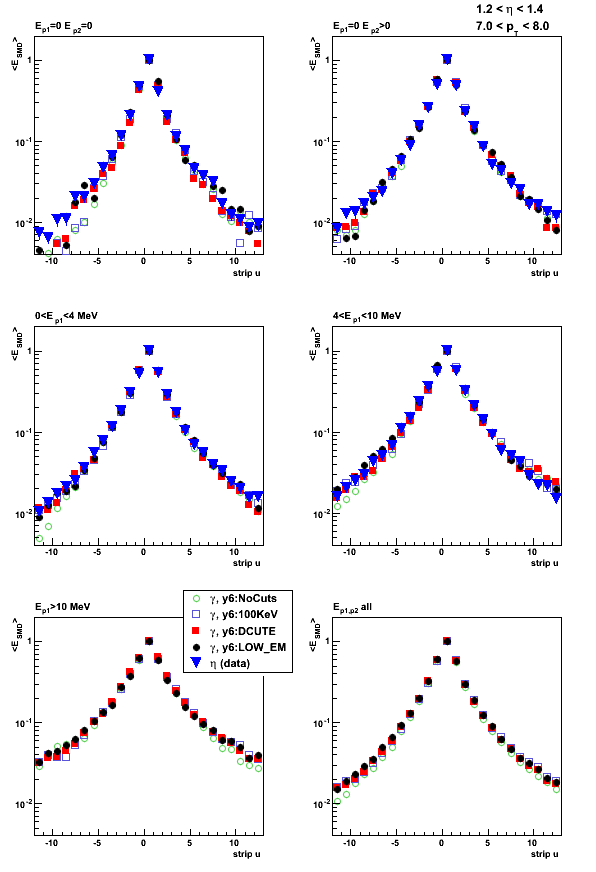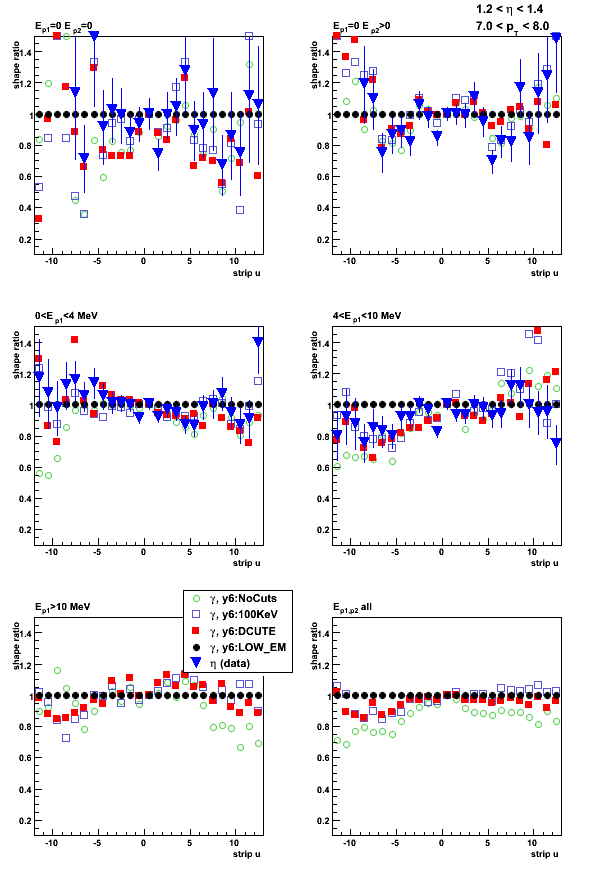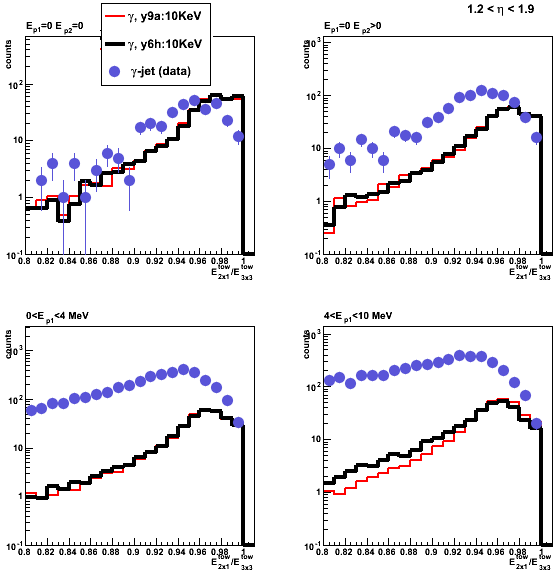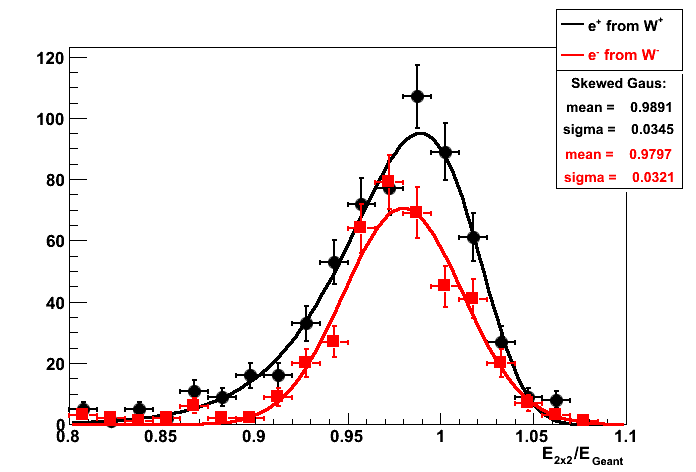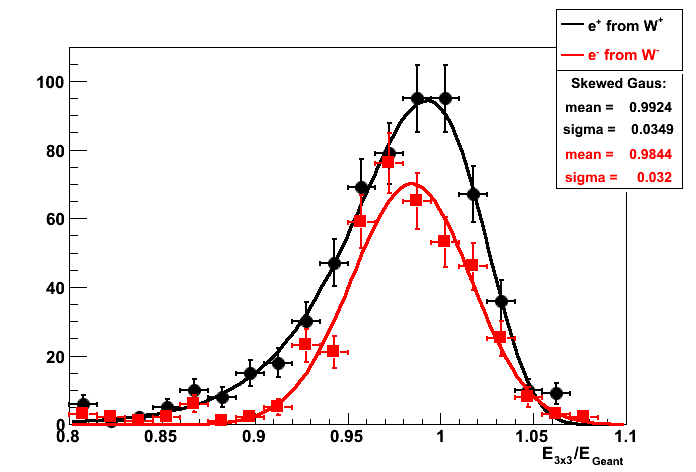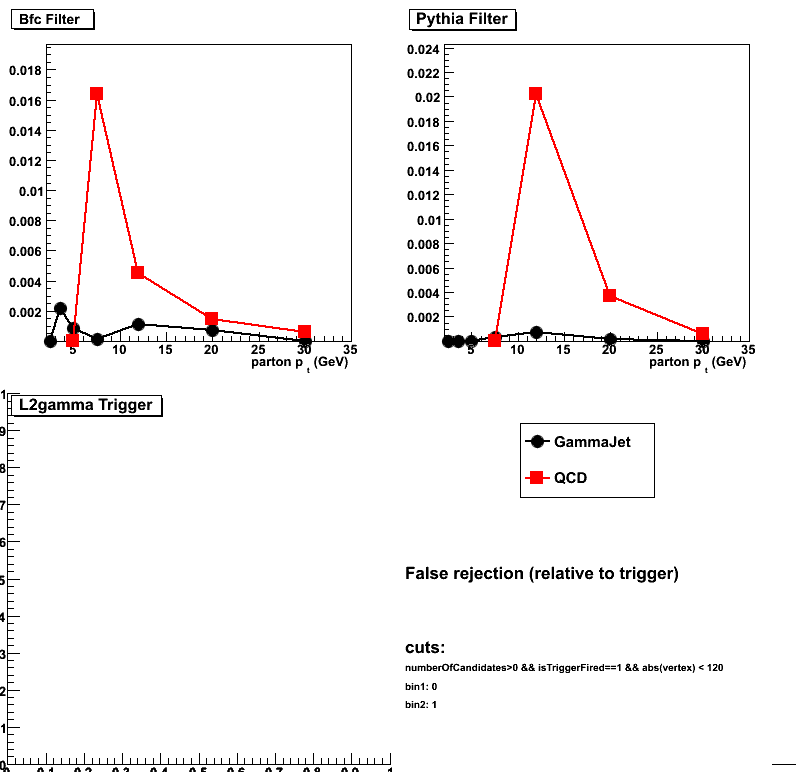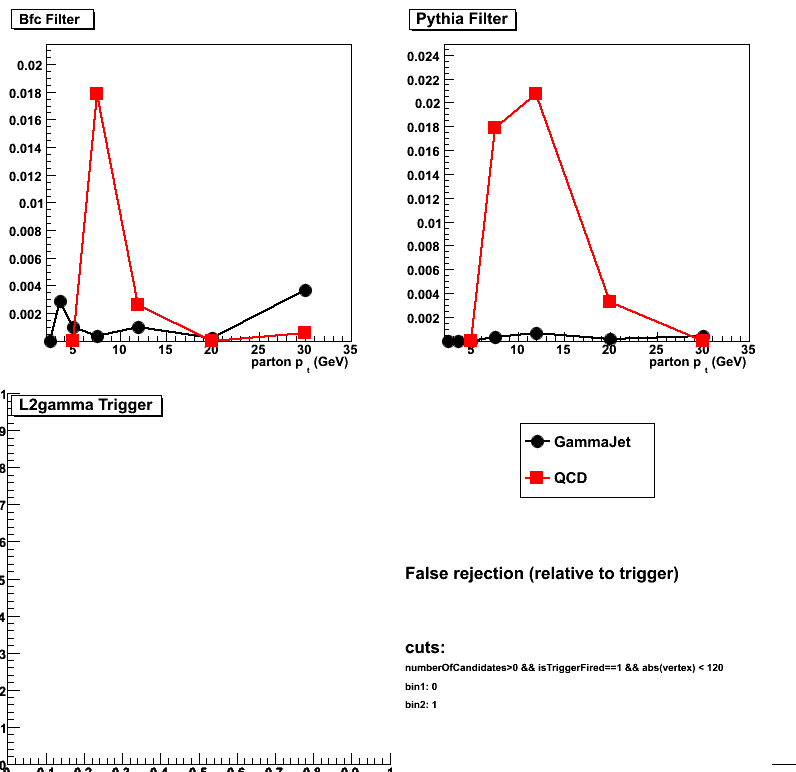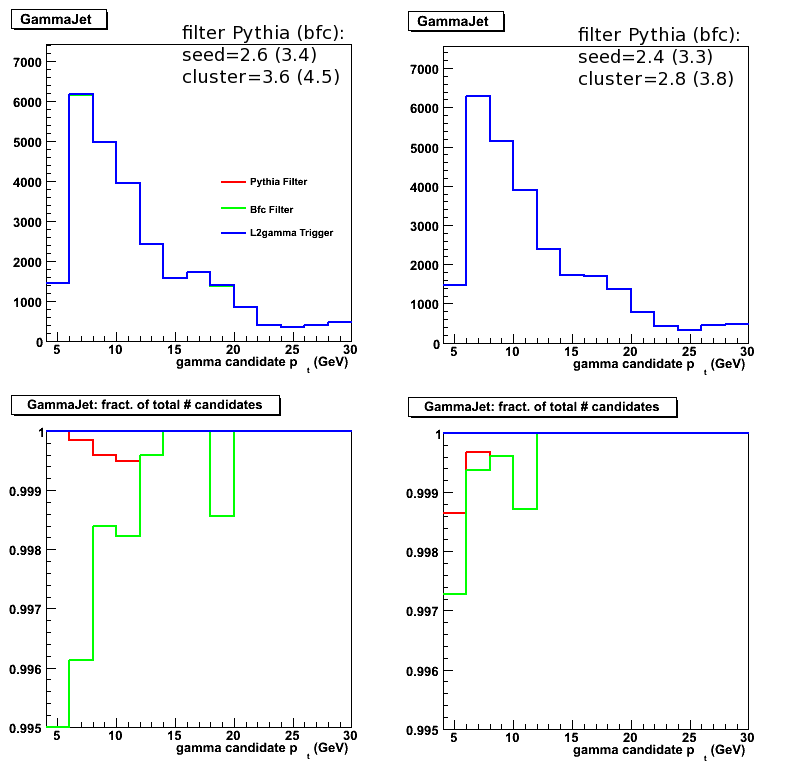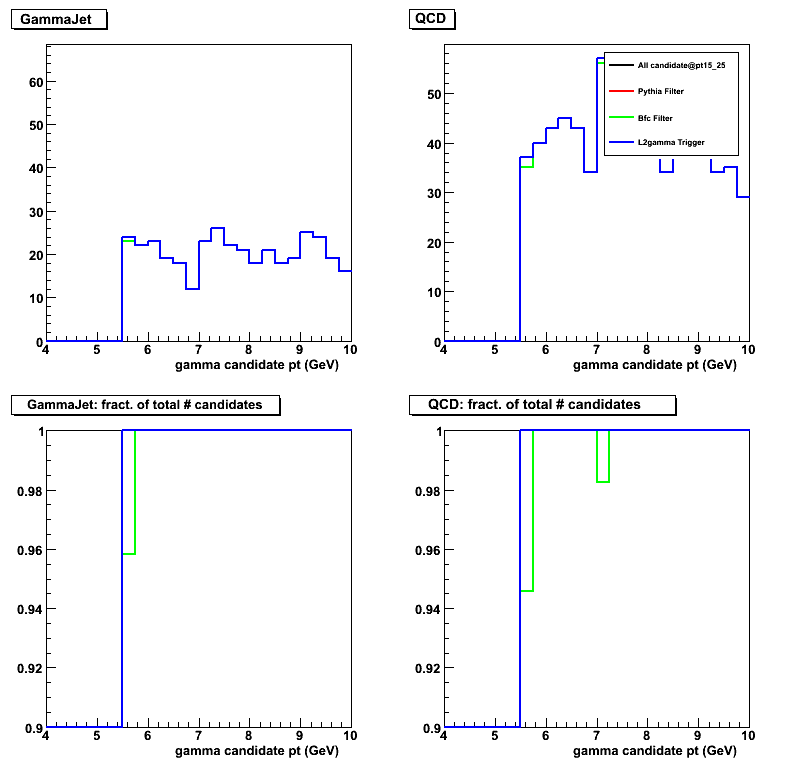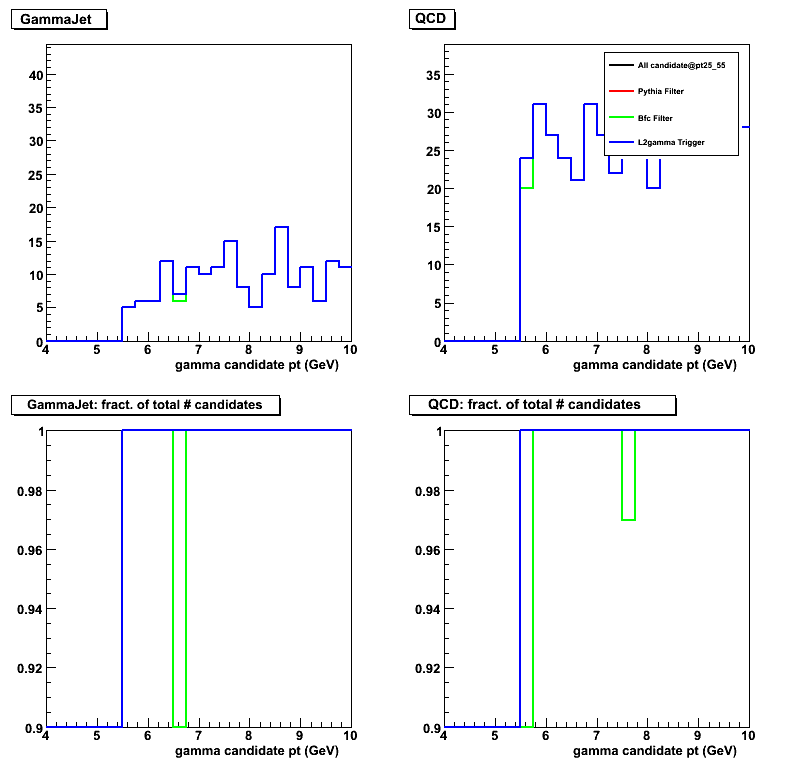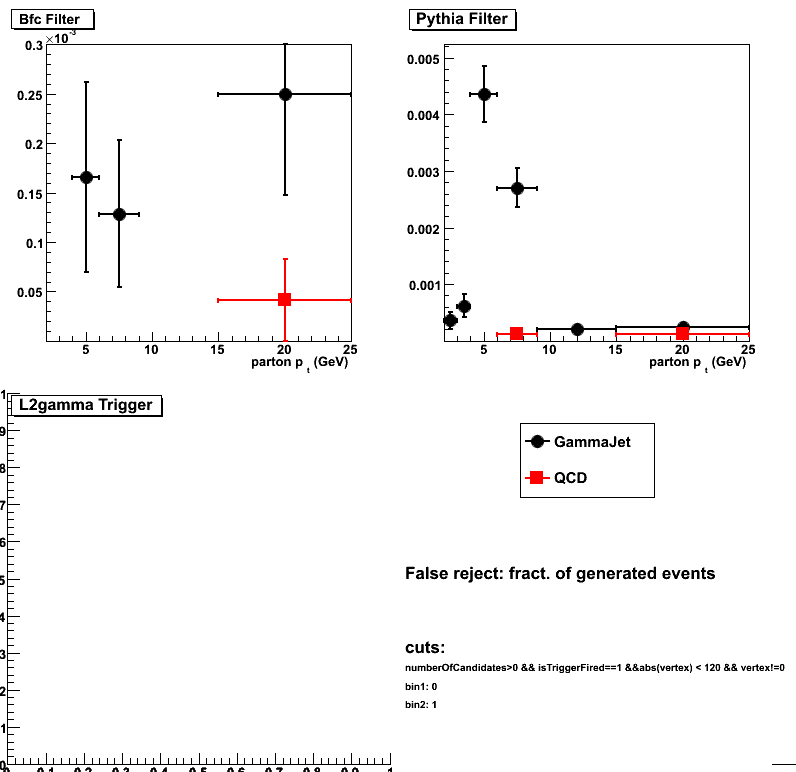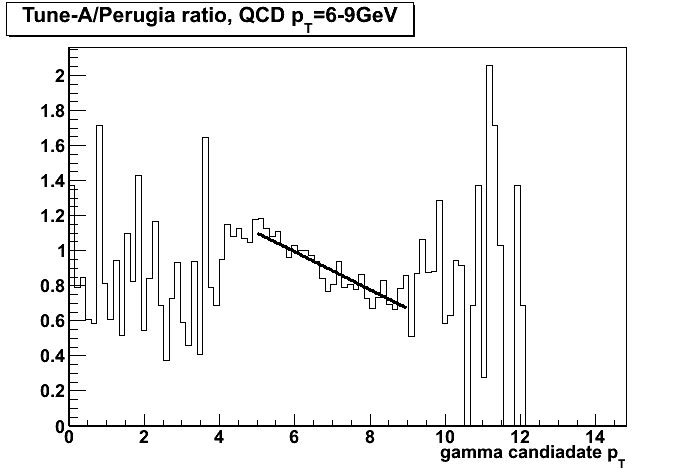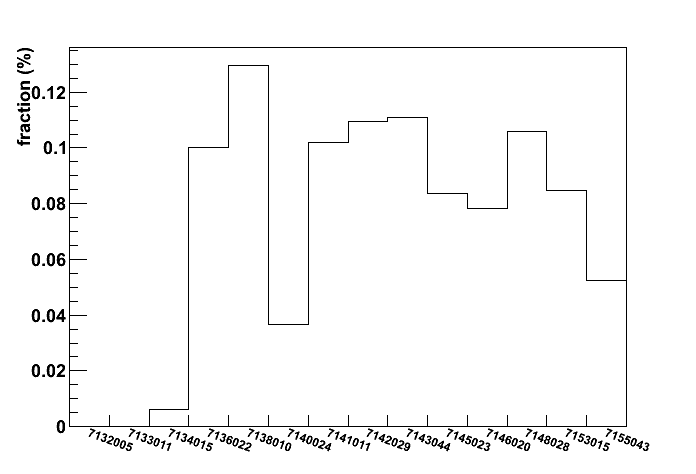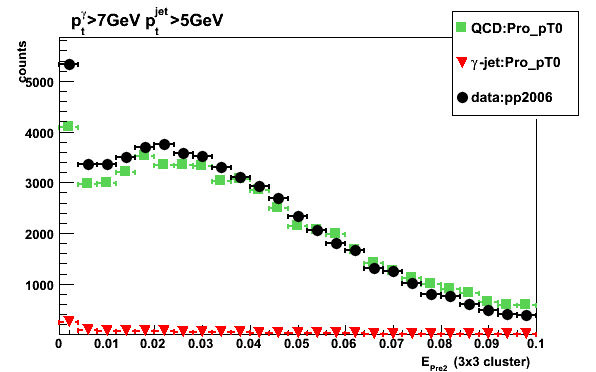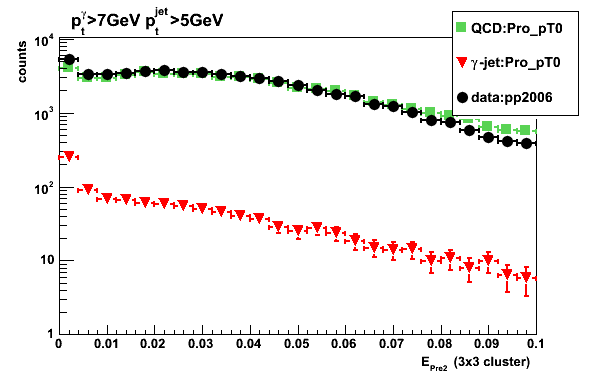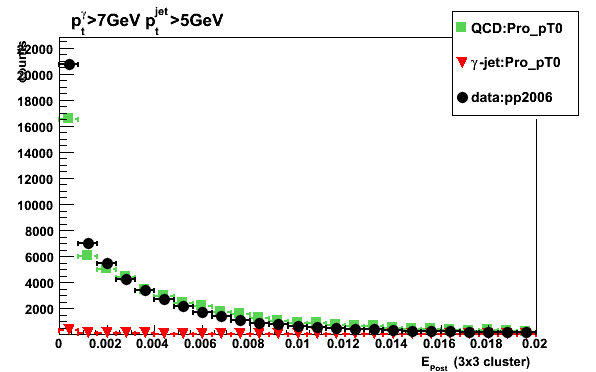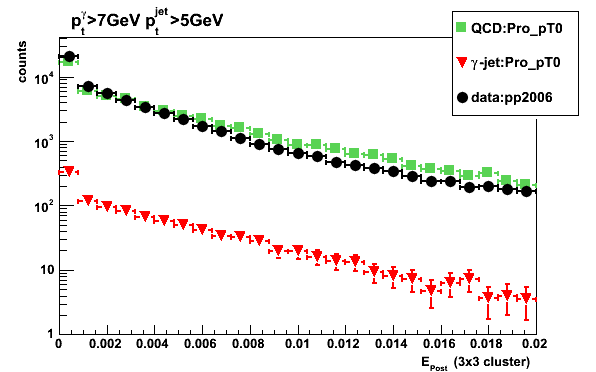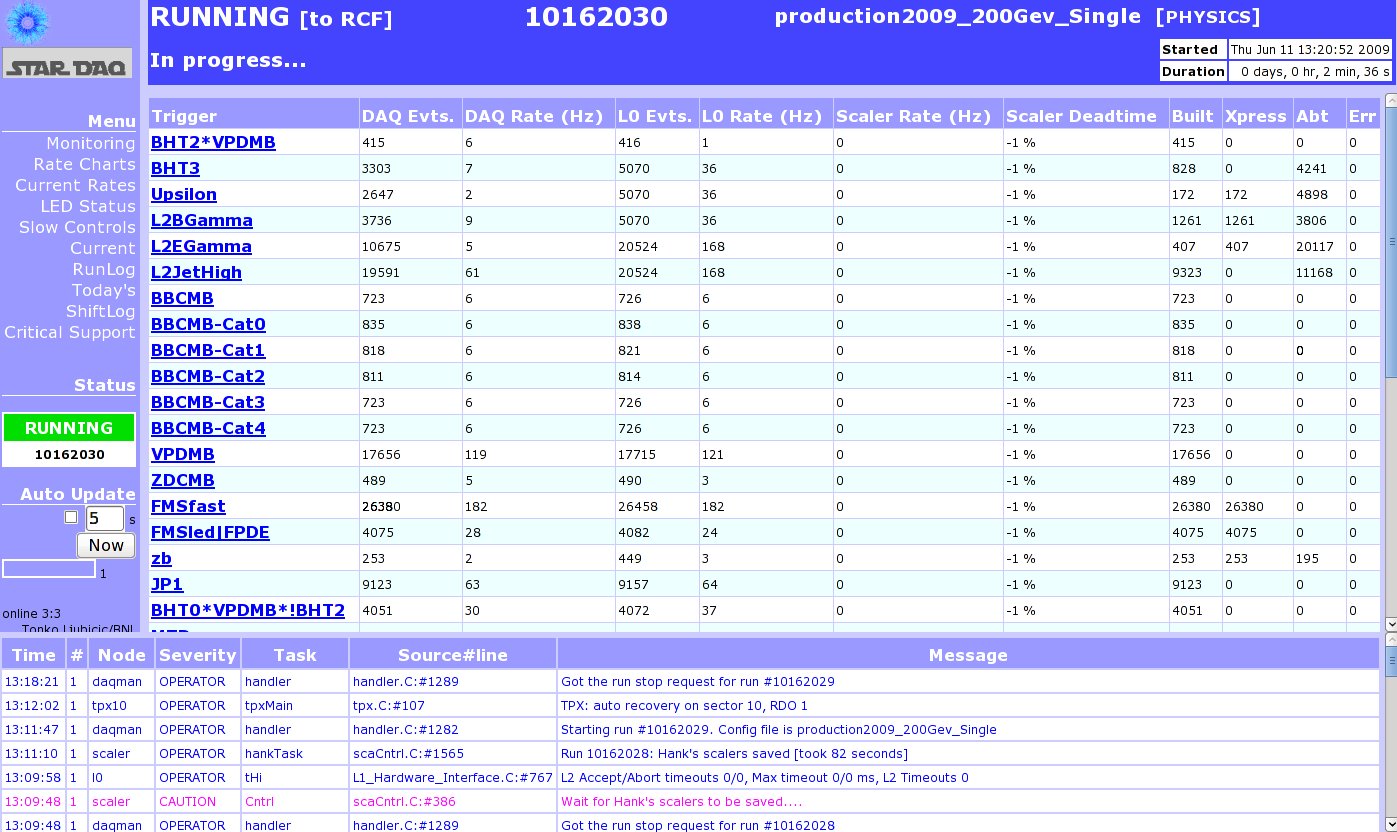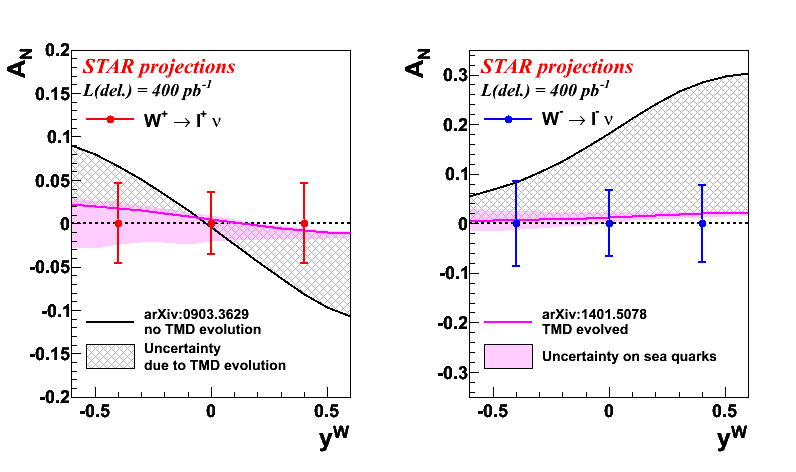Physics Working Group
The primary physics task of STAR is to study the formation and characteristics of the quark-gluon plasma (QGP), a state of matter believed to exist at sufficiently high energy densities. Detecting and understanding the QGP allows us to understand better the universe in the moments after the Big Bang, where the symmetries (and lack of symmetries) of our surroundings were put into motion.
Unlike other physics experiments where a theoretical idea can be tested directly by a single measurement, STAR must make use of a variety of simultaneous studies in order to draw strong conclusions about the QGP. This is due both to the complexity of the system formed in the high-energy nuclear collision and the unexplored landscape of the physics we study. STAR therefore consists of several types of detectors, each specializing in detecting certain types of particles or characterizing their motion. These detectors work together in an advanced data acquisition and subsequent physics analysis that allows final statements to be made about the collision.
The physics of star can be divided into several topics, with many overlaps between topics. In STAR, each of these topics is explored within a physics working group which develops the analysis techniques and software needed to focus on its interests.
Hard Probes
STAR Hard Probes PWG
It includes all the measurements relating to heavy-flavor and jets in p+p and heavy-ion collisions to study the properties of QGP and also Cold QCD matter effects in the STAR experiment.
Our regular weekly meeting information can be found at this link: Weekly-HP-PWG-meeting
All previous jetcorr analyses discussions can be found at: click here
All previous heavy-flavor analyses discussions can be found at: https://drupal.star.bnl.gov/STAR/pwg/heavy-flavor/hf-pwg-weekly-meeting
__________________________________________________________________________________________________
Previous convener:
Sooraj Radhakrishnan (Term ends on 3rd Jan 2023)
Barbara Trzeciak (Term ends on 4th May 2023)
Present conveners:
Isaac Mooney, Qian Yang, Jana Bielčíková
_________________________________
Proposed abstracts for HP2023 and DIS2023 : https://drupal.star.bnl.gov/STAR/blog/nihar/HP-pwg-abstracts-HP2023-and-DIS2023
HP PWG Preliminary plots
This page collects the preliminary plots approved by the HP PWG.
1) All the preliminary plots MUST contain a "STAR Preliminary" label
2) Please include at least pdf and png versions for the figures
3) Where to put the data points: it is recommended to put the data point at the x position whose yield is equal to the average yield of the bin
-
Rongrong presented a couple of slides at the PWGC meeting:
http://www.star.bnl.gov/protected/lfspectra/marr/Analysis/PlaceDataPoints.pdf.
- See also the classic paper by Lafferty and Wyatt, NIM A355 (1995) 541-547 or see http://inspirehep.net/record/374024.
Jets
| Year | System | Physics figures | First shown | Link to figures |
| 2024 | AuAu 200 GeV Run14 and Run16 | Jet v1 in AuAu 200 GeV | HP2024 (Sooraj Radhakrishnan) | Plots |
| 2023 | AuAu 200 GeV (2014 and 2016) | D^0-D^0 azimuthal decorrelation in AuAu 200 GeV | QM2023 (Katarzyna Gwiździel)
|
Plots |
| 2023 | Ru+Ru, Zr+Zr 200 GeV | D^0 R_AA in Isobar collisions | QM2023 (Yuan Su) |
Plots |
| 2023 | Ru+Ru, Zr+Zr 200 GeV | J/psi R_AA in isobar with BHT2 | QM2023 (Te-Chuan Huang) |
Plots |
| 2023 | Ru+Ru, Zr+Zr 200 GeV | J/psi polarization in Isobar collisions | QM2023 (Dandan Shen) |
Plots |
| 2023 | Au+Au @ 200 GeV Run14 | D^0+jet R_CP of Z_jet, Delta_R, and p_jet for D0. 1< pT < 10 GeV in Au+Au collisions at 200 GeV | QM2023 (Diptanil Roy) |
Plots |
| 2023 | p+p 200 GeV Run12 | r_c in jet observable in p+p 200 GeV | QM 2023 (Youqi Song) |
plots |
| 2023 | O+O 200 GeV Run 21 | Jet v2 in small systems | QM 2023 (Tristan Protzman) |
plots |
| 2023 | AuAu 200 GeV (2014) | Jet shape observables in AuAu (girth, pTD, LeSub) | QM 2023 (Tanmay Pani) |
plots |
| 2023 | AuAu 200 GeV (2019) | Track spectra event shape engineering | QM 2023 (Isaac Mooney) |
plots |
| 2023 | pp 200 GeV (2012) | groomed mass fraction, log(kT) vs Rg | HP2023 (Monika Robotkova) |
plots |
| 2023 | pp 200 GeV (2015), Au+Au 200 GeV (2014) | p/pi ratio in jets | HP2023 (Gabriel Dale-Gau) |
plots |
| 2023 | pp 200 GeV (2012) | Collinear drop jet mass and zg vs dM | HP2023 (Youqi Song) |
plots |
| 2023 | pp 200 GeV (2012) | Jet shape observables in pp (Girt, pTD, Lesub, Rho(r)) | HP2023 (Tanmay Pani) |
plots |
| 2023 | pp 200 GeV (2012) | Energy energy Correlator (EEC) | HP2023 (Andrew Tamis) |
plots |
| 2022 | pp 200 GeV (2012) | Jet charge in pp collisions | DNP 2022 Fall (Grant McNamara) |
plots |
| 2022 | Isobar @200 GeV (2018) | Jet v2 in Isobar collisions | HQ(2022) , HP2023 (Tristan Protzman) |
plots (updated) |
| 2022 | p+p @ 200 GeV (Run12) | Multidimensional jet substructure measurements using Omnifold (Jet M, Jet M vs Q) | HQ 2022 (Youqi Song) |
plots |
| 2022 | Ru+Ru & Zr+Zr @ 200 GeV (Run18) | Charged Hadron Spectra at high-pt in isobar collisions | QM 2022 (Tong Liu) | plots |
| 2022 | Au+Au @ 200 GeV Run14 | D0 pT Spectra and radial distributions for D0pT > 5 GeV in Au+Au collisions at 200 GeV | QM 2022 (Diptanil Roy) | plots |
| 2022 | Au+Au 200 GeV Run 14 and pp Run12 200 GeV | Formation time and opening angle for subjets | QM 2022 (Raghav) | plots |
| 2021 | pp @ 200 GeV Run12 |
Fully unfolded formation time for softdrop splits, charged particle splits, resolved SD splits | Jets and 3D Imaging (Raghav) | plots |
| 2021 | pp @ 200 GeV Run12 |
Fully unfolded zg vs Rg as a function of pT | DIS 2021 (Monika Robotkova) |
plots |
| 2021 | pp @ 200 GeV Run12 |
Fully unfolded iterative splitting measurement - 1st, 2nd and 3rd splits zg and Rg | DIS 2021 (Raghav) |
plots |
| 2021 | Isobar @ 200 GeV (blinded) Run18 |
IAA of h+jet measurement | APS April Meeting 2021 (Yang He) | plots |
| 2020 | p+Au @ 200 GeV Run15 |
p+Au EA comparison and semi-inclusive jet spectra | DNP Fall Meeting 2020 (David Stewart) IS2023 |
plots
IS2023 Aj plot |
| 2020 | Isobar @ 200 GeV (blinded) Run18 |
Rcp and pT spectra for charged particles | DNP Fall Meeting 2020 (Audrey Francisco) |
plots |
| 2020 | p+Au @ 200 GeV Run15 |
p+Au Underlying Event Observables | Hard Probes 2020 (Veronica Verkest) |
plots |
| 2020 | p+Au @ 200 GeV Run15 |
Unfolded jet mass measurement | Hard Probes 2020 (Isaac Mooney) |
plots |
| 2020 | p+Au @ 200 GeV Run15 |
Raw acoplanarity jet spectra: |phi_jet-phi_trigger| R=0.4 charged jets Trigger = E_T in BEMC |
Hard Probes 2020 (David Stewart) |
plots |
| 2020 | Au+Au @ 200 GeV Run14 |
SE and ME Rho 0-10% SE and ME Recoil jet spectra 0-10% SE and ME zg, 10-15 GeV 10-20% Comb. Sub. zg. 20-25 GeV, 0-20% |
Hard Probes 2020 (Daniel Nemes) |
plots |
| 2020 | Au+Au @ 200 GeV Run14 |
Raw full jet spectra (R=0.2, 0.4) in 0-10% and 60-80% from HT2 trigger dataset Charged rho vs N_ch |
Hard Probes 2020 (Robert Licenik) |
plots |
| 2019 | Au+Au @ 200 GeV Run14 |
full jet shape (R=0.4): raw JS 0-10%, 20-50%; background subt. JS 0-10%, 20-50%; EP dependent jet shape 20-50% 20-40 GeV; EP dependent JS stacks 10-15 GeV, 15-20 GeV, 20-40 GeV |
QM2019 (Joel Mazer) |
plots |
| 2019 | Au+Au @ 200 GeV Run14 |
Charged jet fragmentation functions 40-60% Fragmentation function ratios (40-60%)/(PYTHIA) Recoil jet spectra SE vs ME in 40-60% dN/dz correctional factors |
2019 QM (Saehanseul Oh) |
plots |
| 2019 | p+Au@200 GeV Run 15 |
charged particle, full & charged jet raw yield pi+-/K+-/p(pbar) tracking efficiency BBC_inner to refmult correlation Refmult fit w/ Glauber+NBD |
QM 2019 (Tong Liu) |
plots |
| 2019 | Au+Au 200 GeV Run 4 | Unidentified Two-Particle Correlations on Yt-Yt space | DNP 2019 (Lanny Ray) |
plots |
| 2019 | p+p 200 GeV Run 12 | Unfolded jet mass measurement with groomed mass and radial scans | DNP 2019 (Isaac Mooney) |
plots |
| 2019 | p+Au @ 200 GeV Run15 | Correlations: EA from BBC east inner+outer tiles with (a) unfolded charged tracks at |η|<1.0 and (b) raw-charged jets | 2019 Initial Stages (David Stewart) | plots |
| 2019 | Au+Au @ 200 GeV Run 14 | Differential jet shape; uncorrected, signal, event plane dependence, centrality dependent pT associated stacks | 2019 High-pT Workshop (Joel Mazer) | plots |
| 2019 | p+p 200 GeV Run 12 | Unfolded jet mass measurement | 2019 High-pT Workshop [3/20] (Raghav Kunnawalkam Elayavalli) |
plots |
| 2018 | Au+Au 200 GeV Run 11 | Event-plane dependent dihadron + Event shape engineering | QNP 2018 (Ryo Aoyama) |
plots |
| 2018 | Au+Au 200 GeV Run 11 | Event-plane dependent dihadron + Event shape engineering | 2018 Quark Matter (Ryo Aoyama) |
plots |
| 2018 | Au+Au 200 GeV Run 14 p+p 200 GeV Run 9 |
Gamma+jet and pi0+jet I_AA, intra-jet broadening acoplanarity measurements in p+p and Au+Au (QM2022) |
2018 Hard Probes (Nihar Sahoo) |
QM2019 plots
QM2025 |
| 2018 | Au+Au 200 GeV Run 7 p+p 200 GeV Run 6 |
Di-jet imbalance measurements as a function of jet definition (R, pTconst) with embedded p+p reference. |
2018 Hard Probes (Nick Elsey) |
plots |
| 2018 | Au + Au 200 GeV Run14 | D0-Hadron Correlations, Fits & Residuals Near-side widths on eta and phi NS Associated per-trigger yield |
2018 RHIC/AGS Meeting (Alex Jentsch) |
plots |
| 2018 | p+p (JP2) @ 200 GeV Run12 Au+Au (HT) @ 200 GeV Run7 (for embedding) p+p (HT) @ 200 GeV Run6 |
Fully Unfolded Measurements of Jet SubStructure (zg, Rg) p+p TwoSubJet z and Theta in Au+Au compared to p+p Embedded in Au+Au |
2018 Hard Probes (Raghav Kunnawalkam Elayavalli) |
plots |
| 2018 | Au+Au @ 200 GeV Run 14 | Jet-hadron correlations relative to event plane: raw correlations; Sig, BG, BG fit correlations; final correlations; event plane resolutions NS/AS yields, yield ratios, widths |
2018 Hot Quarks (Joel Mazer) |
plots |
| 2018 | p+Au @ 200 GeV
Run15
|
Correlations between
EA from BBC East Inner Tiles and Charged tracks at |η|<1.0 |
Hot Quarks 2018
(David Stewart)
|
plots |
Open Heavy Flavor
| Year | System | Physics figures | First shown | Link to figures |
| HT2: | 2023 QM | HT2: plots | ||
| HT2: | 2023 QM | HT2: plots | ||
| 2014+2016 | Au+Au @ 200 GeV | HFT: D+/- RAA | 2020 HP | plots |
| 2014+2016 | Au+Au @ 200 GeV | HFT: Ds+/- spectra, ratio | 2019 QM |
plots |
| 2016 | Au+Au @ 200 GeV | HFT: D+/- RAA | 2018 QM | plots |
| 2016 | d+Au @ 200 GeV | HFT: D0 | 2018 QM | plots |
| 2014 | Au+Au @ 200 GeV | HFT: D*/D0 ratio | 2018 QM | plots |
| 2014+2016 | Au+Au @ 200 GeV | HFT: D0 v1 | 2018 QM | plots |
| 2014+2016 | Au+Au @ 200 GeV | HFT: non-prompt Jpsi | 2017 QM | plots |
| 2014 | Au+Au @ 200 GeV | HFT: non-prompt D0 | 2017 QM | plots |
| 2014 | Au+Au @ 200 GeV | HFT: B/D->e | 2017 QM | plots |
| 2014 2014+2016 |
Au+Au @ 200 GeV | HFT: Lc/D0 Ds/D0 ratio HFT: Lc/D0ratio HFT: Lc/D0 Ds/D0 vs ALICE |
2017 QM 2018 QM 2019 Moriond |
plots plots plots
|
| 2014 | Au+Au @ 200 GeV | HFT: Ds RAA and v2 | 2017 CPOD | plots |
| 2014 | Au+Au @ 200 GeV | HFT: D+/- | 2017 QM | plots |
| 2014 | Au+Au @ 200 GeV | HFT: D0 v3 | 2017 QM | plots |
| 2014 | Au+Au @ 200 GeV | D0-hadron correlation | 2017 QM | plots |
| 2014 | Au+Au @ 200 GeV | HFT: D0 RAA HFT: D0 RAA HFT: D0 RAA and v2 |
2019 SQM 2018 QM 2015 QM |
|
Quarkonium
| Year | System | Physics figures | First shown | Link to figures |
| 2011 | p+p @ 500 GeV | J/psi EEC | 2025 QM | plots |
| 2018 | isobar @ 200 GeV | Psi(2S) | 2023 QM | plots |
| 2018, 2019 | AuAu @ 14.6, 19.6, 27 GeV | HT2: J/psi RAA | 2023 QM | HT2: plots |
| 2018 | isobar @ 200 GeV | HT2: Upsilon RAA | 2023 ATHIC | HT2: plots |
| 2018 | isobar @ 200 GeV | Jpsi v2 | 2022 SQM | HT: plots MB and combined: plots |
| 2018 | isobar @ 200 GeV | Minimum Bias: Jpsi RAA | 2022 QM | plots slides (USTC) slides (UIC) sildes (combined) |
| 2015 | p+p @ 200 GeV | Dimuon: Jpsi with jet activity | 2022 QM | plots slides |
| 2014 | Au+Au @ 200 GeV | Dimuon: Jpsi RAA, low pT | 2022 QM | plots slides |
| 2017 | Au+Au @ 54.4 GeV | Minimum Bias: Jpsi RAA | 2021 SQM | plots slides |
| 2011 | p+p @ 500 GeV | BEMC: Jpsi in jet | 2020 HP | plots |
| 2015 | p+Au @ 200 GeV | BEMC: Jpsi RpA | 2020 HP | plots |
| 2016 2014 2011 |
Au+Au @ 200 GeV | MTD/HT: Upsilon RAA | 2018 QM 2017 QM |
plots plots |
| 2015 | p+p, p+Au @ 200 GeV | MTD: Jpsi cross-section, RpA | 2017 QM | plots |
| 2015 | p+p @ 200 GeV | MTD: Jpsi polarization | 2017 PANIC | plots |
| 2015 | p+p, p+Au @ 200 GeV | BEMC: Upsilon RpAu | 2017 QM | plots |
| 2014 | Au+Au @ 200 GeV | MTD: Jpsi RAA, v2, Upsilon ratio | 2015 QM 2016 sQM |
plots |
| 2013 | p+p @ 500 GeV | MTD: Jpsi yield vs. event activity |
2015 HP |
plots |
| 2013 | p+p @ 500 GeV | MTD: Jpsi cross-section | 2016 sQM | plots |
| 2012 | U+U @ 193 GeV | MB: low-pT Jpsi excess | 2016 sQM | plots |
| 2012 | U+U @ 193 GeV | MB/BEMC: Jpsi v2 | 2017 QM | plots |
| 2012 | p+p @ 200 GeV | MB/BEMC: Jpsi cross-section, event activity BEMC: Jpsi polarization |
2016 QWG | plots plots |
| 2011 | Au+Au @ 200 GeV | MB/BEMC: Jpsi v2 | 2015 QM | plots |
| 2011 | Au+Au @ 200 GeV | MB: low-pT Jpsi excess | 2016 sQM | plots |
| 2011 | p+p @ 500 GeV | BEMC: Jpsi cross-section | WWND | plots |
| 2011 | p+p @ 500 GeV | HT: Upsilon cross-section HT: Upsilon event activity |
2017 QM 2018 PWRHIC |
plots |
Electrons from Heavy Flavor Decay
| Year | System | Physics figures | First shown | Link to figures |
| 2017 | Au+Au @ 27 & 54.4 GeV | NPE v2 | 2020 HP | plots |
| 2014+2016 | Au+Au @ 200 GeV | HF electron: fraction, RAA, double ratio | 2019 QM | plots |
| 2014 | Au+Au @ 200 GeV | NPE cross-section; RAA (without HFT) | 2017 QM | plots |
| 2012 | p+p @ 200 GeV | NPE-hadron correlation, b fraction | 2016 Santa Fe | plots |
| 2012 | p+p @ 200 GeV | NPE cross-section; udpated RAA | 2015 QM | plots |
STAR HP results for LRP discussion
This page gathers inputs from the Hard Probes group to the Long Range Plan.
The aim is to discuss what we have learnt from heavy flavor and jet measurements since the last LRP, and what are plans for the next decade - what we are missing in order to complete the STAR mission.
To help the discussion, we have started by selecting the key HP results since the last LRP: link to a meeting on Aug. 22nd.
Below you can list results that you think are the key ones and what message they provide.
Please also include on this page any general comments/suggestions that you may have.
If you have any specific measurement proposal, please mention the measurement and its physics below in the comment section.
The Town Hall Meeting will be held on September 23-25, 2022.
Link to the previous Long Range Plan: LRP 2015
_______________________________________________________________________________________________________________________________________________________________________________________________________
General discussion
________________________________________________________________________
Please add here key results/plots from your analysis and mention what is the key physics message from these results/plots.
_________________________________
1)
Topic Name (Jet/HF): Jet
PAs' Name: Nihar Ranjan Sahoo (SDU), Derek Anderson (TAMU), Saskia Mioduszewski (TAMU), and Peter Jacobs (LBNL)
Physics plot's link:
1) Recoil jet yield ratio between R=0.2/R=0.5; comparison between Au+Au and p+p for direct photon+jet and pi0+jet - link
2) Semi-inclusive direct photon+jet and pi0+jet acoplanarity measurement in Au+Au - link
Key Physics message:
1) Plot#1: Medium-induced jet broadening and disentangling the vacuum and in-medium gluon radiations by comparing p+p and Au+Au
2) Plot#2: First observation of medium-induced jet acoplanarity in heavy-ion collisions
Comment:
STAR plans to take high statistics data for RUn23-25 for precision measurements with extended kinematic coverage.
RUn24 pp 200 GeV: important to study the vacuum radiation effect on jet acoplanarity measurements and baseline for heavy-ion at RHIC energies both for direct photon+jet and pi0+jet
_________________________________
2)
Topic Name (Jet/HF):
PAs' Name:
Physics plot's link:
Key Physics message:
Comment:
__________________
Please add here with serial number...
Weekly HP-PWG meeting
Topic: STAR Hard Probes PWG weekly meeting
Primary Meeting day and time: Thursday 10 AM EDT (BNL time)
Reserved day and time (in case of announcement): Tuesday 10 AM EDT (BNL time)
[ Reserved for invited theory and experimental seminar, or any additional discussion relating to our hp-pwg analysis]
Previous conveners:
Sooraj Radhakrishnan (Term end on 3rd Jan 2023)
Barbara Trzeciak (Term end on 4th May 2023)
Nihar Sahoo (Term end 31st July 2025)
Current Conveners: Isaac Mooney, Qian Yang, Jana Bielcikova
_______________________________________________________________________________________________________________________________
https://drupal.star.bnl.gov/STAR/pwg/heavy-flavor/hf-pwg-weekly-meeting
Previous jetcorr weeks
https://drupal.star.bnl.gov/STAR/pwg/jet-correlations/jetcorr-weekly-meeting
It is advised to follow the guidance set by IUPAC while using symbols in scientific text:
https://iupac.org/wp-content/uploads/2016/01/ICTNS-On-the-use-of-italic-and-roman-fonts-for-symbols-in-scientific-text.pdf
Note: it should be written as $p$+$p$ and $p$+Au, etc, which is different from the guidance.
Guidance for STAR preliminary plot: https://drupal.star.bnl.gov/STAR/pwg/common/Preliminary-figures
Please make sure all your plots follow guidance 1-7
___________________________________
2022 HP-pwg meetings: link
2023 HP-pwg meetings: link
2024 HP-pwg meetings: link
//_________________ HP-pwg Meeting agenda _________
5 Aug 2025
Youqi Song - Embedding 20235003 QA updates
31 Jul 2025
Brennan Schaefer - J/psi production vs multiplicity in p+p at 510 GeV - link
24 Jul 2025: canceled
17 Jul 2025: canceled
10 Jul 2025: canceled
3 Jul 2025: canceled
26 Jun 2025
Dandan Shen - J/psi EEC. - link
Sijie Zhang- O+O jet - link
Gouranvit Srivastava - pp 200 Run24 FastOffline QA - link
19 Jun 2025: canceled
12 Jun 2025: canceled
5 Jun 2025:
Tanmay Pani - Updates on angularity measurements - link
29 May 2025: canceled
22 May 2025: canceled
15 May 2025
Aoke Zhang - Measurements of J/ψ Production in O-O Collisions at 200GeV - link
8 May 2025: canceled
1 May 2025:
Sasha Prozorov - Inclusive jets in pp 200 GeV - link
24 Apr 2025:
Andrew Tamis- EECs in isobar collisions -
Priyanka Chowdhury - Systematic studies + Barlow test for D0-hadron femtoscopy correlation analysis - link
17 Apr 2025:
Andrew Tamis- EECs in isobar collisions -
Brennan Schaefer
Youqi Song-
QM2025 - April 6-12, 2025
27 Mar 2025
Michal Svoboda: inclusive jet in Au+Au 200 GeV- link
Dhandan Shen: J/ψ energy correlator
Sijie Zhang: Jet in O+O
https://bnl.zoomgov.com/rec/share/0yzhZabfl2vMVkCwP98Z2HFBwtrqh2Q6CZAemQe0uffMSzZ_6DeKo22n1cHPfEOO.Ainr2iQR5sL4M2LB
Passcode: a$7%wkR5
25 Mar 2025 (Tuesday):
Dandan Shen: the J/ψ energy correlator.
Maowu Nie: the O+O analysis - link
Sijie Zhang: O+O jet analysis
27 Feb 2025:
Maowu Nie - O+O Rcp and RAA - link
20 Feb 2025:
Kaifeng Shen - J/psi AuAu 54.4 GeV paper update - link
13 Feb 2025:
Sijie Zhang - Jets in O+O - link
Jace Tyler - Photon-jet correlations with full jets - link
6 Feb 2025: canceled
30 Jan 2025: canceled
23 Jan 2025:
Youqi Song- Embedding and closure test - link
16 Jan 2025: canceled
9 Jan 2025:
Priyanka Roy Chowdhury - D^0 -pi Femtoscopy correlation - link
2022 HP-pwg meetings
___________________
Dec 22nd, 2022 (Last meeting of 2022)
Yang He: Icp measurement in Isobar - link
Gabe Dale-Gau: baryon-to-meson ratio in jet - link
Xinyue: Charm production cross-section at Au+Au 200 GeV - link
Brennan: J/Psi embedding request - link
Leszek: update on v2 of heavy flavor electrons - link
Yu-Tang Wang- J/psi with jet activity in pp 510 GeV - link
Recording:
Passcode: wy=4?Cs2
__________________
Dec 8th, 2022
Cancel due to no contribution
___________________
Dec 1st, 2022
Gabe Dale-Gau: baryon-to-meson ratio in AuAu and pp - link
Tanmay Pani: Jet shape observables in pp and AuAu (HP2023 abstract discussion) - link
Nihar: Direct photon+jet and pi0+jet paper drafts (GPC request) discussion - email link
Recordings:
Passcode: .Vk1?@s=
____________________
Nov 24th, 2022
No meeting due to Thanksgiving
__________________
Nov 17th, 2022
Gabe Dale-Gau - Baryon to Mesos Ratios in Jets for 200 GeV AuAu link
Andrew Tamis - Measurement of the EEC in p+p run 12 link
Brennan Schaefer - J/Psi yield vs multiplicity in p+p 510 GeV
Isaac Mooney - Event shape engineering in isobar collisions - link
Tanmay Pani - Jet shape observables in p+p 200 GeV
Tristan Protzman - Jet v2 - link
Yang He - Icp measurement in Isobar collisions - link
Priyanka Roy Chowdhury - D0-hadrons femtoscopic correlations at Au-Au 200 GeV - link
__________________
Nov 10th, 2022
Gabe Dale-Gau - Baryon to Mesos Ratios in Jets for 200 GeV AuAu - link
Tristan Protzman - Jet v2 in Isobar - link
Brennan Schaefer - J/Psi dimuon - link
Tanmay Pani - Unfolding of PtD, LeSub and Girth in pp 200 GeV- link
Wei - J/ψ Production in Au+Au Collisions At 27-11.5 GeV(BES-II) - link
Passcode: D#evf5E?
__________________
Nov 3rd, 2022
Veronika Prozorova: NPE in Au+Au 54 GeV - link
Yuan Su: D^0 production in Isobar (paper proposal) - link
Gaohan Yang: Upsilon production in Isobar - link
Recording:
https://bnl.zoomgov.com/rec/share/rMN-IH3z9h50egSPyQek3-CNxWqVf4VRLQFF5C4u6ICVJiz4-LToKU9x3UVyNnEs.pQKhycLi0atsOUEF
________________
Oct 27, 2022
No contribution, Cancelled
________________
Oct 20, 2022
No contribution, Cancelled
________________
Oct 13, 2022
No contribution, Cancelled
________________
Oct 6, 2022
Rachael Botsford: J/psi measurement using dilepton channels - link
Grant McNamara: Prelim request for jet charge - link
Tristan Protzman: Jet v2 preliminary discussion
Recording:
________________
Oct 4, 2022. (Reserved day, Tuesday)
Tristan Protzman: Jet v2 in Isobar - link
Recording:
Passcode: hQ1v!%#2
_____________________________
Sep 22, 2022
Youqi Song: multifold on pp Run12 data (aim to show at HQ2022) - link
Tong Liu: HG-PYTHIA and Isobar RAA (aim to show at HQ2022) - link
Yan Wang: shi(2S) embedding request - link
Recording link:
Passcode: !@16jd@Q
____________________________
Sep 12 - 16, 2022
Collaboration meeting - link
___________________________
Sep 8, 2022
Preliminary draft for STAR Hot QCD white paper (Jet section) - link
STAR Hot QCD white paper draft with HF and Jet highlights (Sep 12 update version) - link
___________________________
Sep 1, 2022:
Brennan Schaefer: J/psi vs multiplicity - link
Isaac Mooney: pp jet mass - link
Rachael Botsford: J/shi dimuon channel - link
______________________
Barbara, Yi, Sooraj, and Nihar: STAR LRP discussion - link (both HF and jet discussion)
Andrew Tamis: Energy-energy Correlators in pp - link
_______________________
Youqi Song: Unfolding jet sub-structure observables using Multifold - link
Tristan Protzman: Jet v2 in Isobar- link
Recording:
https://bnl.zoomgov.com/rec/share/yGzgyPI1xNkwkbTjhqY58wO3UJJqdt_XEEvJ6HGsEEwKoA8tWA5-QbtWE4X1Z5Ku.bMiFMXGIcZBzHbr2
Passcode:FV5+2%yh
_____________________________
Aug 8, 2022: Cancelled due to lack of contribution
_____________________________
Aug 4, 2022: Cancelled due to lack of contribution
_____________________________
July 28, 2022: Cancelled due to lack of contribution
______________________
July 21, 2022:
Youqi Song: multifold analysis - slides
Tristan Protzman: jet v2 - slides
Grant McNamara: Jet Charge - slides
Yuan Su: D^0 production in Isobar- Slides
Recording:
__________________________________________________________________________________________________________________________________________________________
July 14, 2022:
Yuan Su: D^0 production in Isobar- Slides
Recording:
https://bnl.zoomgov.com/rec/share/-6so-8v6m8Jq2cVywYIxOiKUkZVEcx8hzvK3RYrIVJQAr6ltZX3oSCRIck_ST78X.VAgohA3pmV4iIZJp
Passcode: sB1?N!av
___________________________________________________________________________________________________________________________________________________________
July 7, 2022:
Tanmay Pani: jet shape - Slides
Recording:
https://bnl.zoomgov.com/rec/share/VAsX4gV0_7bEPTN8qQBumwC7WAhtglI6XlSYM6A6ZQ2GbQyNDu3mgGqcl5Rw6CYj.1uGnMni_hq835SEu
Passcode: dy2#8K!h
___________________________________________________________________________________________________________________________________________________________
Jun 30, 2022:
Rachael Botsford: J/psi measurement using dilepton channels - slides
Brennan Schaefer: Run QA for di-electron J/psi analysis - slides
Nihar Sahoo: pp 200 GeV pi0+jet acoplanarity - slides
Ziyue Zhang: J/psi R_pAu - slides
Recording:
___________________________________________________________________________________________________________________________________________________________
Jun 16, 2022:
Youqi Song: multifold on pp Run12 data closure tests aimed for DNP - slides
Monika Robotková - updated plots for PWGC preview request pp Run12 multi-dimensional jet substructure with full systematics and all observables - slides
Recording:
https://bnl.zoomgov.com/rec/share/n7sdO_Tx04cDovHt4sEyGnCq3ylDTduxtQiHtLoqMR28IfO9FNjMkDoPbg5-DTsX.nsP1GinZGQyYWFp7
Passcode: ?E?2%Dn^
___________________________________________________________________________________________________________________________________________________________
1) Toward J/psi dependence on multiplicity at 500 GeV - Brennan Schaefer
Recording:
https://bnl.zoomgov.com/rec/share/YFQ2bWQbxck4m9gK4URJ9mFx8skd-CsFqXj-9m8Dj7cZrKN59Dz_xXpWA143cllA.A20uAN-vLeiw3CXu
Passcode: n$TjuD9Z
2023 HP-pwg meetings
//_________________ HP-pwg Meeting agenda _________
16th Dec. 2023:
Ziyue Zhang - J/Psi pp combining different Runs using BLUE - link
Yan Wang - Psi(2S) pp reference update - link
Recordings:
Passcode: z5DT=hx0
30th Nov. 2023:
Diptanil Roy: D^0+jet update - link
Leszek Kosarzewski: a short update on the Upsilon paper - link
Wei Zhang: raw signal extraction 17.3 and nSigma electron production - link
Sooraj : hadron and jet v1 in AuAu 200 GeV - link
Recordings:
Passcode: ?$6TrCr#
16th Nov. 2023:
Alexandr Prozorov - D0 jets unfolding in AuAu@200GeV - link
Tong Liu - pAu track TOF-matching efficiency - link
9th Nov. 2023:
Brennan Schaefer - Run17 J/psi Embedding issue - link
2nd Nov. 2023:
Andrew Tamis: EEC Measurement in pp Run 12 - link
Wei Zhang: double counting issue for J/psi RAA in 14.6 and 19.6 GeV - link
Recording: https://bnl.zoomgov.com/rec/share/ksawwbZrMQwd6_PfDO5fdNr88J4Ljbs6q-HzzK_SQuZoLByd-3SVFV5cXg9C1Bqx.JQUWZ85ynlvXELTf
31th Oct 2023:
Tanmay Pani:
Passcode: rc^JUE@1
26th Oct 2023:
Wei Zhang: double counting issue for J/psi RAA in 14.6 and 19.6 GeV - link
Priyanka Roy Chowdhury: Updates on D0-K+ correlation - link
Recording: https://bnl.zoomgov.com/rec/share/uV70gSdMO0o-nbZkkRPRWb_ZlMCKuoYeUO6kBEED_nqU-Hoy4LFDPxMwbW9MmKNG.wc6Nmtw-jgxTPdQd
STAR Collaboration meeting - Cairo, Egypt- 16th to 20th Oct, 2023
16th Oct recording: https://bnl.zoomgov.com/rec/share/HKVsLtcxtGTxG1vT4YsvCd3bX1dmr-MqSYSmkoXLHekojNr_BwbarioVxU4TlV7z.Rm2CVnu4sGaekPxb
17th Oct recording: https://bnl.zoomgov.com/rec/share/ctmz4xzyQ1cDfZuLoYanSkfVMxod9049M6YjiwX1E52fz4joZENwgWU9ZQTtbjfC.xlNYdKHd97ticJUl
Passcode: ^DDa2q&D
Link: https://drupal.star.bnl.gov/STAR/meetings/STAR-Collaboration-Meeting-Fall-2023/HP-Parallel-Session-0
Overview talk by Isaac Mooney: https://drupal.star.bnl.gov/STAR/meetings/STAR-Collaboration-Meeting-Fall-2023/Plenary-Session-IV/HP-Convenor-Report
12th Oct 2023:
Brennan Schaefer - Run17 J/psi Embedding issue -
5th Oct 2023:
Cancelled due to no contribution
28th Sep 2023:
Leszek Kosrazewski- Upsilon in pp 500 GeV, paper discussion - link
Nihar Sahoo (on behalf of conveners) - Post QM23 analyses and paper discussion - link
21th Sep 2023:
Cancelled due to no contribution
Please see the notice in email on STAR HP-pwg publication plan
14th Sep 2023:
Charles Joseph Naim - r_c studies in pp collisions (2017) - link
Maowu Nie - O+O charged hadron R_cp - link
Qian Yang - J/psi spin alignment - link
Priyanka Roy Chowdhury - D0-K+ correlation - link
___QM2023 Sep 3-9____
28th Aug, 2023: (Special Meeting)
Tanmay Pani - Link
24th Aug, 2023:
QM2023 related discussion (STAR preliminary approval)
Oral presenters:
Tanmay Pani - link
Yan Wang
Yuan Su -
Posters:
Jakub Ceska - link
Wei Zhang - link
Daniel Kikola - link
Isaac Mooney - link
Diptanil - link
Youqi - link
Te-Chuan Huang - link
Dandan -
Tristan -
Priyanka -
New analysis:
Charles Joseph Naim - r_c studies in pp collisions (2017) - link
https://bnl.zoomgov.com/rec/share/kQhvujaIkmizb0dtSgR697x2JumKlSz6k017oV3BKMcITKXQa-IDzjV5kn8VqR0M.cpIWdXmVG3Fk7rEo
Passcode: gv1H^k96
22th Aug, 2023:
17th Aug, 2023:
Tanmay Pani- Jet shape - link
Te-Chuan Huang- J/psi R_AA with BHT2 trigger in isobar collisions - link
Jakub Ceska - Upsilon analysis - link
Brennan Schaefer - J/Si analysis- link
Andrew Tamis - EEC analysis - link
Isaac Mooney - AuAu 2014 event shape engineering - link
Daniel Kikola - D-D0 azimuthal correlation in Au+Au collisions - link
Tristan Protzman - jet v2 in oxygen-oxygen collisions - link
https://bnl.zoomgov.com/rec/share/kQch3pKK8p-Si8QDMCKqJzb3VBNaOiW7O3LnOXQ_cMie63Y2TpISA5bWrXg56lqZ.QZTokfhJU9C1ejOE
Passcode: nA.uH041
_________________________
15th Aug, 2023:
Te-Chuan Huang- J/psi R_AA with BHT2 trigger in isobar collisions - link
Dandan Shen - J/ψ polarization in Isobar data - link
Diptanil Roy - D^0 analysis - link
Tanmay Pani- Jet shape - link
Follow-ups from the 10th:
Youqi Song- update on the correction procedures of rc
Daniel Kikola- D0-D0bar azimuthal correlation
Priyanka Chowdhury Roy- Femtoscopic D^0 hadron correlations
Wei Zhang - AuAu 27, 19.6, 14.6 GeV Jpsi
Yan - Isobar psi2S analysis
_________________________
10th Aug, 2023:
Veronika Prozorova - update on HFE at 54.4 GeV - link
Youqi Song- update on the correction procedures of rc - link
Daniel Kikola- D0-D0bar azimuthal correlation - link
Priyanka Chowdhury Roy- Femtoscopic D^0 hadron correlations - link
Wei Zhang - AuAu27、19.6、14.6GeV Jpsi - link
Yan - Isobar psi2S analysis - link
__________________________
3rd Aug, 2023:
Jakub Ceska- Multiplicity dependence of Upsilon meson production in p+p at 510 GeV - link
Iain Morton - Direct Photon and Neutral pion discrimination poster - link
Wei Zhang - systematic uncertainty of AuAu27GeV and AuAu19.6GeV - link
Passcode: i^Zm0ds^
_________________________
27th July, 2023:
Daniel Kikoła - D0-D0bar azimuthal correlation in Au+Au 200 GeV - link
Priyanka Chowdhury Roy- Femtoscopic D^0 hadron correlations - link
Iain Morton - Direct Photon and Neutral pion discrimination - link
https://bnl.zoomgov.com/rec/share/QJlLzjSTZfcfF01pZS9HR6DbUXwXj1mckqTfuq8rMdbiykoy3bxFsIzZSCHjBLHj.-AYStmNssR7QfJL3
Passcode: 9a!h%2@t
_________________________
20th July, 2023:
Cancelled due to no contribution
_________________________
13th July, 2023:
Nihar Sahoo - Jet acoplanarity paper proposal follow-up discussion - link
Youqi Song - Charge correlator analysis in pp - link
Ondrej Lomicky - bad tower selection for Run16 Au+Au P16ij - link
Isaac Mooney - event shape engineering analysis - link
Brennan Schaefer: Measurement of the event multiplicity dependence of J/Psi production in p+p at 510 GeV - link
_________________________
6th July, 2023:
Veronika Prozorova- HFE at 54 GeV - link
Priyanka Roy Chowdhury - kaon and pion femtoscopy in Au-Au 200 GeV - link
Daniel Kikola - D0-D0bar aziumthal correlation in AuAu 200 GeV - link
________________________
28th June, 2023:
No hp-pwg meeting this week due to ongoing mini analysis meeting
_________________________
27th June, 2023: Analysis meeting (BES-II)
* Tue 27/Jun (9:00-12:10) HP and PWG summary (link to the recording, pass: x0X3=L#g )
- 09:00 (25) hp : Te-Chuan Huang : Quarkonium from different energy and collision systems : slide link
- 09:25 (25) hp : Tanmay Pani : Measuring medium modification of jets using generalized and differential angularities : slide link
- 09:50 (15) hp : Diptanil Roy : Charm-tagged Jet Fragmentation Function and Spectra in Au+Au : slide link
- 10:05 (15) hp : Yuan Su : D0 RAA in isobar : slide link
______________________
22nd June, 2023:
BHT trigger threshold discussion for Run23
_____________
15th June, 2023:
Cancelled due to no contribution
________________________
8th June, 2023:
Trigger rate discussion - link
Nihar Sahoo - Jet Acoplanarity paper proposal - link
Gabe Dale-Gau - Baryon-to-Meson ratio in jet - link
Andrew Tamis -EEC in pp paper proposal - link
Passcode: f6gFN$E9
________________________
1st June, 2023:
Subhash - jet v1 in isobar - link
Andrew - EEC in pp 200 GeV - link
Katarzyna Gwiździel- D0-D0bar azimuthal correlations in Au+Au @ 200 GeV - link
Brennan - luminosity unfolding multiplicity correction - link
https://bnl.zoomgov.com/rec/share/ufHiqWgq2VkDBBMm1FjWNPUWSeQNGZcpbEhNF5XPS_RHGWB5CNj9mhWEGiT96Fv7.QJwyRACUaHd1ivnC
Passcode: =$n4xff^
________________________
25th May, 2023:
Rongrong Ma: HP highlights for BUR 2023- link
https://bnl.zoomgov.com/rec/share/4rOSAGFSIBBJXVflYfhEUpi-u4ZFTHdeazSG-w2-o1lhLt4M3S0Ib7dQf6uVG6uG.97liOwaU_1cg9lEK
Passcode: EK2HT#D6
________________________
18th May, 2023:
Katarzyna Gwiździel - D^0 -D^0 correlation in AuAu 200 GeV - link
Diptanil Roy - D^0 jets in Au+Au 200 GeV - link
Priyanka Chowdhury Roy- Femtoscopic D^0 hadron correlations - link
Passcode: 1KD1+dR^
________________________
11th May, 2023:
Ziyang Li: Upsilon(2S) to Upsilon(1S) ratio - link
Youqi Song: the charge correlator ratio analysis in pp - link
https://bnl.zoomgov.com/rec/share/syk7zIXw0UI5vivTr0zHcNyICNV5DpcHF_8PK3XtqmQmxLZcFWdCEEMhDTxRaYrl.nNVApC0783uSQUok
Passcode: z3L!#2&b
________________________
4th May, 2023:
Nihar Sahoo: pp and pAu 200 GeV Run12 and Run15 request - link
https://bnl.zoomgov.com/rec/share/pqEFU9eEyVbuPGBJKfGbno5dWc_VvdHdswlS0qM-csTOLJ6ETRk4zFSeVZfmL-Nh.DerDK7X7w3bVl79U
Passcode: %T^y*0+$
________________________
27th Apr, 2023:
Cancelled (no contribution)
_______________________
20th Apr, 2023:
Quark Matter 2023:
Robert Licenik: Measurement of inclusive jet production in Au+Au collisions at 200 GeV - slides
Tristan Protzman: Lambda polarization in quenched jets - slides
Wei Zhang: Energy dependence of J/psi production in Au+Au collisions at 14.6,19.6 and 27 GeV - slides
Tanmay Pani: Measuring medium modification of jets using generalized and differential angularities from Au+Au collisions at 200 GeV - slides
Isaac Mooney: Event shape engineering of charged hadron spectra in isobar collisions at 200 GeV (slides)
Subhash Singha, Nihar Sahoo: Measurement of directed flow of inclusive jets in heavy-ion collisions at RHIC (abstract, slides)
Jakub Ceska: Measurement of multiplicity dependence of Upsilon meson production in p+p at 510 GeV - slides
Brennan Schaefer: Measurement of the event multiplicity dependence of J/Psi production in p+p at 510 GeV
Yuan Su: D^0 production and R_AA in Isobar collisions (abstract)
Veronika Verkest: Final figures update for Even activity and jet measurements in p+Au - link
https://bnl.zoomgov.com/rec/share/xnqnVG51K8loX2KaBweSDySZd4ijnH2OvF5xOJv8_Trsjuw4m46-qLF13h6C2_l_.-ThHiYImDjFUmH-q
Passcode: FMj.p7+z
__________________
13th Apr, 2023:
QM2023 abstract merge plan: conveners (slides)
Jet:
Robert Licenik: Measurement of inclusive jet production in Au+Au collisions at 200 GeV
Yang He: Semi: inclusive hadron+jet measurement in Ru+Ru and Zr+Zr collisions at 200 GeV (abstract, slides)
Gabe Dale-Gau: Measurements of Baryon to Meson ratios in jets for Au+Au and p+p collisions at 200 GeV (slides)
Tristan Protzman, Rosi Reed: Lambda polarization from quenched jets (slides)
Tanmay Pani: Measuring medium modification of jets using generalized and differential angularities from Au+Au collisions at 200 GeV
Diptanil Roy: Charm-tagged Jet Fragmentation Function and Spectra in AuAu 200 GeV (slides)
Isaac Mooney: Event shape engineering of charged hadron spectra in isobar collisions at 200 GeV (slides)
Tristan Protzman, Rosi Reed: Jet v2 in medium sized systems (slides)
Subhash Singha, Nihar Sahoo: Measurement of directed flow of inclusive jets in heavy-ion collisions at RHIC (abstract, slides)
Andrew Tamis: Energy-Energy Correlator (slides)
Youqi Song: Probing soft-hard correlation and hadronization with jets at RHIC (slides)
Heavy Flavor:
Te-Chuan Huang: J/psi and Upsilon R_AA results in isobar data at 200 GeV (abstract, slides)
Yan Wang: Psi(2S) production in isobaric collisions at 200 GeV (slides)
Dandan Shen: Measurements of J/psi polarization in Ru+Ru and Zr+Zr collisions at 200 GeV (abstract, slides)
Wei Zhang: Energy dependence of J/psi production in Au+Au collisions at 14.6,19.6 and 27 GeV
Veronika Prozorova: Heavy-flavour electron measurements in Au+Au collisions at 54.4 GeV (slides)
Priyanka Roy: Measurement of femtoscopic correlation function between D0 mesons and charged hadrons in Au+Au collisions at 200 GeV (slides)
Daniel Kikola: D0-D0bar correlations in Au+Au at 200 GeV (slides)
Jakub Ceska: Measurement of multiplicity dependence of Upsilon meson production in p+p at 510 GeV
Brennan Schaefer: Measurement of the event multiplicity dependence of J/Psi production in p+p at 510 GeVYuan Su: D^0 production and R_AA in Isobar collisions (abstract)
Yuan Su: D0 production and R_AA in Isobar collisions (slides)
https://bnl.zoomgov.com/rec/share/t0lRwPUB6x06vAigyondHIIRyZfBev6BLqUAra13sN4cQVijOp8HhcQgW770JVA.aO5U1c-zddH8ztxV
Passcode: U@em7z+q
__________________
6th Apr, 2023:
Veronika Prozorova: HFE analysis at 54.4 GeV - link
Wei Zhang: pp inelastic cross section and finalized efficiency at AuAu27GeV - link
Dandan Shen: J/psi polarization in Isobar- link
Daniel Kikoła: D^0-D^0 azimuthal correlation in Au+Au - link
Subhash Singha: Inclusive jet v1 in heavy-ion collisions - link
Qian Yang: J/psi measurement in Isobar- link
Te-Chuan Hunag- J/psi and Upsilon production in Isobar - link
Priyanka Chowdhury - femtoscopic correlation between D0-hadron - link
https://bnl.zoomgov.com/rec/share/qptk2WCiD0BT9OFwVVUVUG3NdtyuiHegXV3Zp5Uf9M8Se6SrWr6xIkYlElbT47vd.iSP7WuvX9iK7OJu-
Passcode: 8WKPd=@^
__________________
30th March, 2023:
Meeting cancelled due to ongoing HP/DIS -2023
__________________
23rd March, 2023:
STAR highlights talk discussion- Nihar Sahoo/Joern Putschke - updated slide link (v2)
Tanmay Pani - Update on preliminary results for HP2023
Gabe Gau: Update on his analysis for HP2023 presentation
https://bnl.zoomgov.com/rec/share/RSaA3QBdo3u6XUcz9gOXI_9WTbxTEx8xtblPxsXF7XM56rczfMMzyI7wlaRfw3N7.mUmqtqbLU4YJPu-S
Passcode: 86W6gU$G
__________________
16th March, 2023:
HP23 Preliminaries
Gabe Gau - preliminary request - link
Yang He - update - link
Tristan Protzman - preliminary request - link
Tanmay Pani - preliminary request - link
Andrew Tamis - preliminary request - link
Youqi Song - preliminary request- link
Monika Robotková - preliminary request- link
Priyanka Chowdhury - preliminary request - link
Isaac Mooney - preliminary request - link
Brennan Scheafer - preliminary request - link
Yan Wang (Already approved STAR preliminary)
___________________
14th March, 2023:
(Tuesday discussion 9 AM BNL time)
HP23 Preliminaries
Yang He - update - link
Tristan Protzman - preliminary request - link
Tanmay Pani - preliminary request - link
Gabe Gau - preliminary request - link
Priyanka Chowdhury - preliminary request - link
Brennan Scheafer - preliminary request - link
Andrew Tamis - preliminary request - link
Isaac Mooney - preliminary request - link
Youqi Song - preliminary request- link
Monika Robotková - preliminary request- link
Yan Wang (Already approved STAR preliminary)
https://bnl.zoomgov.com/rec/share/30OxeyczBiX17l-S7vIirmkyDXiBXZ15zmLfthQVEmZdL09NpaisH8mYhgonLP6X.qNKavLTwFHxSL6To
Passcode: @qN6zzS=
___________________
9th March, 2023:
HP23 Preliminaries
Tristan Protzman - preliminary request - link
Brennan Scheafer - preliminary request - link
Youqi Song - link
Monika Robotková - preliminary request- link
Gabe Gau - preliminary request - link
Andrew Tamis - preliminary request - link
Isaac Mooney - preliminary request - link
Yang He - update - link
Tanmay Pani
Priyanka Chowdhury
Yan Wang (Already approved STAR preliminary)
____________________
Feb 27-Mar 3, 2023
Collaboration meeting, LBNL: link
Here are the links to the HP parallel session recordings:
Feb. 28:
https://bnl.zoomgov.com/rec/share/-1q6on-jOnUN6LBDnTQJv_ElhdJTmOsoWG674eIyrXwpaqvuKv13-lclwR-SsMn_.RxQPK-WPtFaYSJXD
Passcode: Gt=r6Qk&
Mar. 1:
https://bnl.zoomgov.com/rec/share/Bi4SyIpn_D0NAfFjircXc2dL6kWdcqTnqCkB8S8NsrkSxz0cC1SSY9_tpDAHUX9Y.VthMdEGlotW0pmqX
Passcode: .sy&6qT2
___________________
23rd Feb, 2023:
Gabe: Baryon and Meson Ratios in Jets from Au+Au Collisions at 200 GeV - link
Tanmay: Jet shapes analyses - link
Ziyue: BHT2 Jpsi @200GeV in pAu/pp analysis - link
___________________
16th Feb, 2023:
Gaohan Yang: Measurements of the Upsilon Production in Isobaric Collisions at 200GeV - link
Priyanka Roy Chowdhury : Femtoscopic correlations between D0-hadron for Au+Au, 200 GeV - link
Ziyue Zhang: update on BHT2 J/psi RpAu @200GeV (Run15) - link
https://bnl.zoomgov.com/rec/share/NUiLQ3nsXSXJbo96-RBfJqYcqd8KLZ_PWlMdb499Vg0R2Oy9E1smE0n199vmJTVN.wAWPoSlbToWqJFNH
Passcode: dY1rt^F5
___________________
9th Feb, 2023:
Youqi Song: Jet substructure in pp - link
Jakub Češka: Upsilon mesons in Run17 pp data - link
____________________
2nd Feb, 2023:
Priyanka Roy Chowdhury : D0-hadron femtoscopic correlation function analysis at Au+Au 200 GeV- link
bnl.zoomgov.com/rec/share/bMtGfSE_JNliEKFQ42XTFOCVtcA5uY7Th55hMD549D7-9oH5YBaLt9z8I8GFaPo.945qhDFnWyVlaIT0
Passcode: 6cr0d=p!
____________________
26th Jan, 2023:
Gabriel Dale-Gau: Baryon and Meson Ratios in Jet from Au+Au Collisions at 200GeV - link
____________________________________
19 Jan, 2023:
Veronika Prozorova: NPE analysis in Au+Au at 54.4GeV - link
David Stewart: update on the p+Au semi-inclusive jet analysis - link
Priyanka Roy Chowdhury : D0-hadron femtoscopic correlation function analysis at Au+Au 200 GeV- link
_____________________________________
12 Jan, 2023:
Wei Zhang: J/psi in Au+Au 11.5 - 27 GeV - Link
_____________________________________
5 Jan, 2023:
2023 HP-pwg meetings
//_________________ HP-pwg Meeting agenda _________
16th Dec. 2023:
Ziyue Zhang - J/Psi pp combining different Runs using BLUE - link
Yan Wang - Psi(2S) pp reference update - link
Recordings:
Passcode: z5DT=hx0
30th Nov. 2023:
Diptanil Roy: D^0+jet update - link
Leszek Kosarzewski: a short update on the Upsilon paper - link
Wei Zhang: raw signal extraction 17.3 and nSigma electron production - link
Sooraj : hadron and jet v1 in AuAu 200 GeV - link
Recordings:
Passcode: ?$6TrCr#
16th Nov. 2023:
Alexandr Prozorov - D0 jets unfolding in AuAu@200GeV - link
Tong Liu - pAu track TOF-matching efficiency - link
9th Nov. 2023:
Brennan Schaefer - Run17 J/psi Embedding issue - link
2nd Nov. 2023:
Andrew Tamis: EEC Measurement in pp Run 12 - link
Wei Zhang: double counting issue for J/psi RAA in 14.6 and 19.6 GeV - link
Recording: https://bnl.zoomgov.com/rec/share/ksawwbZrMQwd6_PfDO5fdNr88J4Ljbs6q-HzzK_SQuZoLByd-3SVFV5cXg9C1Bqx.JQUWZ85ynlvXELTf
31th Oct 2023:
Tanmay Pani:
Passcode: rc^JUE@1
26th Oct 2023:
Wei Zhang: double counting issue for J/psi RAA in 14.6 and 19.6 GeV - link
Priyanka Roy Chowdhury: Updates on D0-K+ correlation - link
Recording: https://bnl.zoomgov.com/rec/share/uV70gSdMO0o-nbZkkRPRWb_ZlMCKuoYeUO6kBEED_nqU-Hoy4LFDPxMwbW9MmKNG.wc6Nmtw-jgxTPdQd
STAR Collaboration meeting - Cairo, Egypt- 16th to 20th Oct, 2023
16th Oct recording: https://bnl.zoomgov.com/rec/share/HKVsLtcxtGTxG1vT4YsvCd3bX1dmr-MqSYSmkoXLHekojNr_BwbarioVxU4TlV7z.Rm2CVnu4sGaekPxb
17th Oct recording: https://bnl.zoomgov.com/rec/share/ctmz4xzyQ1cDfZuLoYanSkfVMxod9049M6YjiwX1E52fz4joZENwgWU9ZQTtbjfC.xlNYdKHd97ticJUl
Passcode: ^DDa2q&D
Link: https://drupal.star.bnl.gov/STAR/meetings/STAR-Collaboration-Meeting-Fall-2023/HP-Parallel-Session-0
Overview talk by Isaac Mooney: https://drupal.star.bnl.gov/STAR/meetings/STAR-Collaboration-Meeting-Fall-2023/Plenary-Session-IV/HP-Convenor-Report
12th Oct 2023:
Brennan Schaefer - Run17 J/psi Embedding issue -
5th Oct 2023:
Cancelled due to no contribution
28th Sep 2023:
Leszek Kosrazewski- Upsilon in pp 500 GeV, paper discussion - link
Nihar Sahoo (on behalf of conveners) - Post QM23 analyses and paper discussion - link
21th Sep 2023:
Cancelled due to no contribution
Please see the notice in email on STAR HP-pwg publication plan
14th Sep 2023:
Charles Joseph Naim - r_c studies in pp collisions (2017) - link
Maowu Nie - O+O charged hadron R_cp - link
Qian Yang - J/psi spin alignment - link
Priyanka Roy Chowdhury - D0-K+ correlation - link
___QM2023 Sep 3-9____
28th Aug, 2023: (Special Meeting)
Tanmay Pani - Link
24th Aug, 2023:
QM2023 related discussion (STAR preliminary approval)
Oral presenters:
Tanmay Pani - link
Yan Wang
Yuan Su -
Posters:
Jakub Ceska - link
Wei Zhang - link
Daniel Kikola - link
Isaac Mooney - link
Diptanil - link
Youqi - link
Te-Chuan Huang - link
Dandan -
Tristan -
Priyanka -
New analysis:
Charles Joseph Naim - r_c studies in pp collisions (2017) - link
https://bnl.zoomgov.com/rec/share/kQhvujaIkmizb0dtSgR697x2JumKlSz6k017oV3BKMcITKXQa-IDzjV5kn8VqR0M.cpIWdXmVG3Fk7rEo
Passcode: gv1H^k96
22th Aug, 2023:
17th Aug, 2023:
Tanmay Pani- Jet shape - link
Te-Chuan Huang- J/psi R_AA with BHT2 trigger in isobar collisions - link
Jakub Ceska - Upsilon analysis - link
Brennan Schaefer - J/Si analysis- link
Andrew Tamis - EEC analysis - link
Isaac Mooney - AuAu 2014 event shape engineering - link
Daniel Kikola - D-D0 azimuthal correlation in Au+Au collisions - link
Tristan Protzman - jet v2 in oxygen-oxygen collisions - link
https://bnl.zoomgov.com/rec/share/kQch3pKK8p-Si8QDMCKqJzb3VBNaOiW7O3LnOXQ_cMie63Y2TpISA5bWrXg56lqZ.QZTokfhJU9C1ejOE
Passcode: nA.uH041
_________________________
15th Aug, 2023:
Te-Chuan Huang- J/psi R_AA with BHT2 trigger in isobar collisions - link
Dandan Shen - J/ψ polarization in Isobar data - link
Diptanil Roy - D^0 analysis - link
Tanmay Pani- Jet shape - link
Follow-ups from the 10th:
Youqi Song- update on the correction procedures of rc
Daniel Kikola- D0-D0bar azimuthal correlation
Priyanka Chowdhury Roy- Femtoscopic D^0 hadron correlations
Wei Zhang - AuAu 27, 19.6, 14.6 GeV Jpsi
Yan - Isobar psi2S analysis
_________________________
10th Aug, 2023:
Veronika Prozorova - update on HFE at 54.4 GeV - link
Youqi Song- update on the correction procedures of rc - link
Daniel Kikola- D0-D0bar azimuthal correlation - link
Priyanka Chowdhury Roy- Femtoscopic D^0 hadron correlations - link
Wei Zhang - AuAu27、19.6、14.6GeV Jpsi - link
Yan - Isobar psi2S analysis - link
__________________________
3rd Aug, 2023:
Jakub Ceska- Multiplicity dependence of Upsilon meson production in p+p at 510 GeV - link
Iain Morton - Direct Photon and Neutral pion discrimination poster - link
Wei Zhang - systematic uncertainty of AuAu27GeV and AuAu19.6GeV - link
Passcode: i^Zm0ds^
_________________________
27th July, 2023:
Daniel Kikoła - D0-D0bar azimuthal correlation in Au+Au 200 GeV - link
Priyanka Chowdhury Roy- Femtoscopic D^0 hadron correlations - link
Iain Morton - Direct Photon and Neutral pion discrimination - link
https://bnl.zoomgov.com/rec/share/QJlLzjSTZfcfF01pZS9HR6DbUXwXj1mckqTfuq8rMdbiykoy3bxFsIzZSCHjBLHj.-AYStmNssR7QfJL3
Passcode: 9a!h%2@t
_________________________
20th July, 2023:
Cancelled due to no contribution
_________________________
13th July, 2023:
Nihar Sahoo - Jet acoplanarity paper proposal follow-up discussion - link
Youqi Song - Charge correlator analysis in pp - link
Ondrej Lomicky - bad tower selection for Run16 Au+Au P16ij - link
Isaac Mooney - event shape engineering analysis - link
Brennan Schaefer: Measurement of the event multiplicity dependence of J/Psi production in p+p at 510 GeV - link
_________________________
6th July, 2023:
Veronika Prozorova- HFE at 54 GeV - link
Priyanka Roy Chowdhury - kaon and pion femtoscopy in Au-Au 200 GeV - link
Daniel Kikola - D0-D0bar aziumthal correlation in AuAu 200 GeV - link
________________________
28th June, 2023:
No hp-pwg meeting this week due to ongoing mini analysis meeting
_________________________
27th June, 2023: Analysis meeting (BES-II)
* Tue 27/Jun (9:00-12:10) HP and PWG summary (link to the recording, pass: x0X3=L#g )
- 09:00 (25) hp : Te-Chuan Huang : Quarkonium from different energy and collision systems : slide link
- 09:25 (25) hp : Tanmay Pani : Measuring medium modification of jets using generalized and differential angularities : slide link
- 09:50 (15) hp : Diptanil Roy : Charm-tagged Jet Fragmentation Function and Spectra in Au+Au : slide link
- 10:05 (15) hp : Yuan Su : D0 RAA in isobar : slide link
______________________
22nd June, 2023:
BHT trigger threshold discussion for Run23
_____________
15th June, 2023:
Cancelled due to no contribution
________________________
8th June, 2023:
Trigger rate discussion - link
Nihar Sahoo - Jet Acoplanarity paper proposal - link
Gabe Dale-Gau - Baryon-to-Meson ratio in jet - link
Andrew Tamis -EEC in pp paper proposal - link
Passcode: f6gFN$E9
________________________
1st June, 2023:
Subhash - jet v1 in isobar - link
Andrew - EEC in pp 200 GeV - link
Katarzyna Gwiździel- D0-D0bar azimuthal correlations in Au+Au @ 200 GeV - link
Brennan - luminosity unfolding multiplicity correction - link
https://bnl.zoomgov.com/rec/share/ufHiqWgq2VkDBBMm1FjWNPUWSeQNGZcpbEhNF5XPS_RHGWB5CNj9mhWEGiT96Fv7.QJwyRACUaHd1ivnC
Passcode: =$n4xff^
________________________
25th May, 2023:
Rongrong Ma: HP highlights for BUR 2023- link
https://bnl.zoomgov.com/rec/share/4rOSAGFSIBBJXVflYfhEUpi-u4ZFTHdeazSG-w2-o1lhLt4M3S0Ib7dQf6uVG6uG.97liOwaU_1cg9lEK
Passcode: EK2HT#D6
________________________
18th May, 2023:
Katarzyna Gwiździel - D^0 -D^0 correlation in AuAu 200 GeV - link
Diptanil Roy - D^0 jets in Au+Au 200 GeV - link
Priyanka Chowdhury Roy- Femtoscopic D^0 hadron correlations - link
Passcode: 1KD1+dR^
________________________
11th May, 2023:
Ziyang Li: Upsilon(2S) to Upsilon(1S) ratio - link
Youqi Song: the charge correlator ratio analysis in pp - link
https://bnl.zoomgov.com/rec/share/syk7zIXw0UI5vivTr0zHcNyICNV5DpcHF_8PK3XtqmQmxLZcFWdCEEMhDTxRaYrl.nNVApC0783uSQUok
Passcode: z3L!#2&b
________________________
4th May, 2023:
Nihar Sahoo: pp and pAu 200 GeV Run12 and Run15 request - link
https://bnl.zoomgov.com/rec/share/pqEFU9eEyVbuPGBJKfGbno5dWc_VvdHdswlS0qM-csTOLJ6ETRk4zFSeVZfmL-Nh.DerDK7X7w3bVl79U
Passcode: %T^y*0+$
________________________
27th Apr, 2023:
Cancelled (no contribution)
_______________________
20th Apr, 2023:
Quark Matter 2023:
Robert Licenik: Measurement of inclusive jet production in Au+Au collisions at 200 GeV - slides
Tristan Protzman: Lambda polarization in quenched jets - slides
Wei Zhang: Energy dependence of J/psi production in Au+Au collisions at 14.6,19.6 and 27 GeV - slides
Tanmay Pani: Measuring medium modification of jets using generalized and differential angularities from Au+Au collisions at 200 GeV - slides
Isaac Mooney: Event shape engineering of charged hadron spectra in isobar collisions at 200 GeV (slides)
Subhash Singha, Nihar Sahoo: Measurement of directed flow of inclusive jets in heavy-ion collisions at RHIC (abstract, slides)
Jakub Ceska: Measurement of multiplicity dependence of Upsilon meson production in p+p at 510 GeV - slides
Brennan Schaefer: Measurement of the event multiplicity dependence of J/Psi production in p+p at 510 GeV
Yuan Su: D^0 production and R_AA in Isobar collisions (abstract)
Veronika Verkest: Final figures update for Even activity and jet measurements in p+Au - link
https://bnl.zoomgov.com/rec/share/xnqnVG51K8loX2KaBweSDySZd4ijnH2OvF5xOJv8_Trsjuw4m46-qLF13h6C2_l_.-ThHiYImDjFUmH-q
Passcode: FMj.p7+z
__________________
13th Apr, 2023:
QM2023 abstract merge plan: conveners (slides)
Jet:
Robert Licenik: Measurement of inclusive jet production in Au+Au collisions at 200 GeV
Yang He: Semi: inclusive hadron+jet measurement in Ru+Ru and Zr+Zr collisions at 200 GeV (abstract, slides)
Gabe Dale-Gau: Measurements of Baryon to Meson ratios in jets for Au+Au and p+p collisions at 200 GeV (slides)
Tristan Protzman, Rosi Reed: Lambda polarization from quenched jets (slides)
Tanmay Pani: Measuring medium modification of jets using generalized and differential angularities from Au+Au collisions at 200 GeV
Diptanil Roy: Charm-tagged Jet Fragmentation Function and Spectra in AuAu 200 GeV (slides)
Isaac Mooney: Event shape engineering of charged hadron spectra in isobar collisions at 200 GeV (slides)
Tristan Protzman, Rosi Reed: Jet v2 in medium sized systems (slides)
Subhash Singha, Nihar Sahoo: Measurement of directed flow of inclusive jets in heavy-ion collisions at RHIC (abstract, slides)
Andrew Tamis: Energy-Energy Correlator (slides)
Youqi Song: Probing soft-hard correlation and hadronization with jets at RHIC (slides)
Heavy Flavor:
Te-Chuan Huang: J/psi and Upsilon R_AA results in isobar data at 200 GeV (abstract, slides)
Yan Wang: Psi(2S) production in isobaric collisions at 200 GeV (slides)
Dandan Shen: Measurements of J/psi polarization in Ru+Ru and Zr+Zr collisions at 200 GeV (abstract, slides)
Wei Zhang: Energy dependence of J/psi production in Au+Au collisions at 14.6,19.6 and 27 GeV
Veronika Prozorova: Heavy-flavour electron measurements in Au+Au collisions at 54.4 GeV (slides)
Priyanka Roy: Measurement of femtoscopic correlation function between D0 mesons and charged hadrons in Au+Au collisions at 200 GeV (slides)
Daniel Kikola: D0-D0bar correlations in Au+Au at 200 GeV (slides)
Jakub Ceska: Measurement of multiplicity dependence of Upsilon meson production in p+p at 510 GeV
Brennan Schaefer: Measurement of the event multiplicity dependence of J/Psi production in p+p at 510 GeVYuan Su: D^0 production and R_AA in Isobar collisions (abstract)
Yuan Su: D0 production and R_AA in Isobar collisions (slides)
https://bnl.zoomgov.com/rec/share/t0lRwPUB6x06vAigyondHIIRyZfBev6BLqUAra13sN4cQVijOp8HhcQgW770JVA.aO5U1c-zddH8ztxV
Passcode: U@em7z+q
__________________
6th Apr, 2023:
Veronika Prozorova: HFE analysis at 54.4 GeV - link
Wei Zhang: pp inelastic cross section and finalized efficiency at AuAu27GeV - link
Dandan Shen: J/psi polarization in Isobar- link
Daniel Kikoła: D^0-D^0 azimuthal correlation in Au+Au - link
Subhash Singha: Inclusive jet v1 in heavy-ion collisions - link
Qian Yang: J/psi measurement in Isobar- link
Te-Chuan Hunag- J/psi and Upsilon production in Isobar - link
Priyanka Chowdhury - femtoscopic correlation between D0-hadron - link
https://bnl.zoomgov.com/rec/share/qptk2WCiD0BT9OFwVVUVUG3NdtyuiHegXV3Zp5Uf9M8Se6SrWr6xIkYlElbT47vd.iSP7WuvX9iK7OJu-
Passcode: 8WKPd=@^
__________________
30th March, 2023:
Meeting cancelled due to ongoing HP/DIS -2023
__________________
23rd March, 2023:
STAR highlights talk discussion- Nihar Sahoo/Joern Putschke - updated slide link (v2)
Tanmay Pani - Update on preliminary results for HP2023
Gabe Gau: Update on his analysis for HP2023 presentation
https://bnl.zoomgov.com/rec/share/RSaA3QBdo3u6XUcz9gOXI_9WTbxTEx8xtblPxsXF7XM56rczfMMzyI7wlaRfw3N7.mUmqtqbLU4YJPu-S
Passcode: 86W6gU$G
__________________
16th March, 2023:
HP23 Preliminaries
Gabe Gau - preliminary request - link
Yang He - update - link
Tristan Protzman - preliminary request - link
Tanmay Pani - preliminary request - link
Andrew Tamis - preliminary request - link
Youqi Song - preliminary request- link
Monika Robotková - preliminary request- link
Priyanka Chowdhury - preliminary request - link
Isaac Mooney - preliminary request - link
Brennan Scheafer - preliminary request - link
Yan Wang (Already approved STAR preliminary)
___________________
14th March, 2023:
(Tuesday discussion 9 AM BNL time)
HP23 Preliminaries
Yang He - update - link
Tristan Protzman - preliminary request - link
Tanmay Pani - preliminary request - link
Gabe Gau - preliminary request - link
Priyanka Chowdhury - preliminary request - link
Brennan Scheafer - preliminary request - link
Andrew Tamis - preliminary request - link
Isaac Mooney - preliminary request - link
Youqi Song - preliminary request- link
Monika Robotková - preliminary request- link
Yan Wang (Already approved STAR preliminary)
https://bnl.zoomgov.com/rec/share/30OxeyczBiX17l-S7vIirmkyDXiBXZ15zmLfthQVEmZdL09NpaisH8mYhgonLP6X.qNKavLTwFHxSL6To
Passcode: @qN6zzS=
___________________
9th March, 2023:
HP23 Preliminaries
Tristan Protzman - preliminary request - link
Brennan Scheafer - preliminary request - link
Youqi Song - link
Monika Robotková - preliminary request- link
Gabe Gau - preliminary request - link
Andrew Tamis - preliminary request - link
Isaac Mooney - preliminary request - link
Yang He - update - link
Tanmay Pani
Priyanka Chowdhury
Yan Wang (Already approved STAR preliminary)
____________________
Feb 27-Mar 3, 2023
Collaboration meeting, LBNL: link
Here are the links to the HP parallel session recordings:
Feb. 28:
https://bnl.zoomgov.com/rec/share/-1q6on-jOnUN6LBDnTQJv_ElhdJTmOsoWG674eIyrXwpaqvuKv13-lclwR-SsMn_.RxQPK-WPtFaYSJXD
Passcode: Gt=r6Qk&
Mar. 1:
https://bnl.zoomgov.com/rec/share/Bi4SyIpn_D0NAfFjircXc2dL6kWdcqTnqCkB8S8NsrkSxz0cC1SSY9_tpDAHUX9Y.VthMdEGlotW0pmqX
Passcode: .sy&6qT2
___________________
23rd Feb, 2023:
Gabe: Baryon and Meson Ratios in Jets from Au+Au Collisions at 200 GeV - link
Tanmay: Jet shapes analyses - link
Ziyue: BHT2 Jpsi @200GeV in pAu/pp analysis - link
___________________
16th Feb, 2023:
Gaohan Yang: Measurements of the Upsilon Production in Isobaric Collisions at 200GeV - link
Priyanka Roy Chowdhury : Femtoscopic correlations between D0-hadron for Au+Au, 200 GeV - link
Ziyue Zhang: update on BHT2 J/psi RpAu @200GeV (Run15) - link
https://bnl.zoomgov.com/rec/share/NUiLQ3nsXSXJbo96-RBfJqYcqd8KLZ_PWlMdb499Vg0R2Oy9E1smE0n199vmJTVN.wAWPoSlbToWqJFNH
Passcode: dY1rt^F5
___________________
9th Feb, 2023:
Youqi Song: Jet substructure in pp - link
Jakub Češka: Upsilon mesons in Run17 pp data - link
____________________
2nd Feb, 2023:
Priyanka Roy Chowdhury : D0-hadron femtoscopic correlation function analysis at Au+Au 200 GeV- link
bnl.zoomgov.com/rec/share/bMtGfSE_JNliEKFQ42XTFOCVtcA5uY7Th55hMD549D7-9oH5YBaLt9z8I8GFaPo.945qhDFnWyVlaIT0
Passcode: 6cr0d=p!
____________________
26th Jan, 2023:
Gabriel Dale-Gau: Baryon and Meson Ratios in Jet from Au+Au Collisions at 200GeV - link
____________________________________
19 Jan, 2023:
Veronika Prozorova: NPE analysis in Au+Au at 54.4GeV - link
David Stewart: update on the p+Au semi-inclusive jet analysis - link
Priyanka Roy Chowdhury : D0-hadron femtoscopic correlation function analysis at Au+Au 200 GeV- link
_____________________________________
12 Jan, 2023:
Wei Zhang: J/psi in Au+Au 11.5 - 27 GeV - Link
_____________________________________
5 Jan, 2023:
2024 HP meetings
//_________________ HP-pwg Meeting agenda _________
12 Dec 2024
Zetong Li - Upsilon in isobar - link
Aoke Zhang - J/ψ Production in O-O Collisions - link
Subhadip pal - D^{0} and D* in p+p 510 GeV collisions - link
Yutang - J/ψ with jet activity in pp collisions - link
21st Nov 2024
Charles Joseph Naim - r_c analysis and the impact of particle decay - link
Yang He - h+jet in Isobar - link
Subhadip Pal - D0 and D* analysis from the pp500 run17 data - link
14th Nov 2024
Charles-Joseph Naïm - r_c analysis and the impact of particle decay - link
Ziyue Zhang - Dielectron J/ψ RpAu paper figure plotting update - link
7th Nov 2024
Canceled
31st Oct 2024
Ziyue Zhang - GPC formation request for Dielectron J/psi RpAu analysis - link
Wei Zhang - Paper proposal for J/psi production in Au+Au collisions at 14.6, 17.3, 19.6 and 27 GeV analysis - link
Oct 22-23 STAR Collaboration HP-pwg sessions recordings
https://drupal.star.bnl.gov/STAR/meetings/STAR-Collaboration-Meeting-October-2024/Hard-Probes-PWG-Session-I
17th Oct 2024
Jace Taylor- Full jet reconstruction of gamma+jet and pi0+jet - link
10th Oct 2024
Veronika Prozorova - HFE measurement at 54 GeV - link
Michal Svoboda - inclusive full jet at 200 GeV AuAu - link
Ondřej Lomicky - D^0 jet angularity - link
Passcode: B@rjwE%9
3rd Oct 2024
Ziyue Zhang - J/psi paper proposal update - link
Sijie Zhang - O+O h+jet analysis - link
Dandan- J/Psi energy corrector in Run11 p+p collisions - link
Austin Rosypal - Event shape engineering in AuAu 200 GeV - link
26th Sep 2024
Cancel due to HP2024 conference
19th Sep 2024
HP2024 discussion on remaining issues to be discussed
Brennan Schaefer - HP2024 update on J/psi vs multiplicity analysis - link
Ziyue Zhang - J/psi paper proposal update - link
Sijie Zhang - O+O h+jet analysis - link
Dandan- J/Psi energy corrector in Run11 p+p collisions - link
Passcode: FSR1h6M^
11.30 AM, Isaac's HP2024 rehearsal - link
12th Sep 2024
Andrew Tamis - HP2024 Preliminary update on EEC - link
Sooraj Radhakrishnan - jet v1 smearing study - link
Analysis Meeting Sep 9-11, 2024 (special for HP2024 presentations) link
5th Sep 2024
Diptanil Roy - D^0+jet update in AuAu - link
Gabriel Dale-Gau - Baryon to Meson Ratios in Jets from Au+Au and p+p collisions at sqrt(sNN) = 200 GeV - link
Tanmay Pani - multifolding and angularities update - link
Brennan Schaefer - J/psi vs Multiplicity update - link
https://bnl.zoomgov.com/rec/share/EDIc8G-0eHmfpBzB1unopijHlAt_aG5BvNQTVS7tbRnmFHsrlGGWU-Zv7-3pjdrB.g6rVBSxaxRIDjiB7
Passcode: J*3QwHB+
3rd Sep 2024 (Special meeting on Tuesday)
Sooraj Radhakrishnan - jet v1 AuAu update- link
Youqi Song - rc Observable - link
https://bnl.zoomgov.com/rec/share/I74_xgUTD5UzoE3lQvuc0EGWtBVtdX0_ZxKl2i4g1tZr5WlvOXWJGNZWB-1I2_7H.4eMsZGlnBJm8mBQH
Passcode: Kk4^%bW8
29 Aug 2024
Wei Zhang- 17.3 GeV J/psi - link
Youqi Song- r_c in Isobar- link
Subhash Singha- jet v1 in Isobar - link
Andrew - three point Energy-Energy correlators - link
Sooraj Radhakrishnan - jet v1 in AuAu - link
Tanmay Pani - angularity measurements from inclusive and hard-core jets in p+p 200 GeV - link
Brennan Schaefer - J/psi with multiplicity in 2017 update - link
https://bnl.zoomgov.com/rec/share/AyLZ2Ws3V3ysdskhtrrGCoBBXpGHywEcFNSAoo--AXdJaFUQWGMqqkdGMvOvUg.5c6Qd9m5Q_F2MWFS
Passcode: 95qL=vxg
22 August 2024
Gabriel Dale-Gau - Baryon to Meson Ratios in Jets from Au+Au and p+p collisions at sqrt(sNN) = 200 GeV - link
Youqi Song - Update on charge correlator ratio in isobar studies - link
https://bnl.zoomgov.com/rec/share/AawcARY3qmbCG8wNZcctsrDCATjXvLKcGUq6wtI6hjDCCQrnv-LGG88kvbzvZ4vl.cdxfOjHHI0dm3bHw
Passcode: 1wl6jB4^
15 August 2024
Isaac - Event-shape engineering - link
https://bnl.zoomgov.com/rec/share/OIx9rem_lC9pXixsfirSlu1AWyvGbs38Ha745VTEhvBOeTdjnkQ_O3SKNqDfnhZ0.AAVzV0KqtrJv5D-z
Passcode: pJB.*?8z
08 August 2024
Wei Zhang- Measurements of charmonium production in heavy-ion collisions at STAR - link
https://bnl.zoomgov.com/rec/share/qSofRYFwGOOutD6WjfsW-qTho-yqmT8eXyQlHbRkqfK3Qcy_n0msZWGzVhJW5Nq9.kVHbK3-xlq9iWMQ8
Passcode: 676W*@=V
01 August 2024
Sooraj - jet v1 measurements - link
https://bnl.zoomgov.com/rec/share/qNBn2L9BFwjvsw1ylDcWaz2rYkrHWVMfQTm2dq0caLLUP416MP1vwpvzPvHADnRL.NwWyBdClkoBw-z9A
Passcode: *Ah$d@4%
25 July 2024
Youqi - multifold embedding discussion - link
https://bnl.zoomgov.com/rec/share/6ajgWmkUmCsvsdTg9WsUI6v53xiQdXZaYOMXbc-xuGnjO4O-l26vkdPOoR4G66l0.9E5YNDWcfy0Ifoqd
Passcode: c?ZCL0EX
18 July 2024
Trigger discussion -
Brennan - J/psi with multiplicity in 2017 - link
Dandan - J/psi polarization in isobar - link
https://bnl.zoomgov.com/rec/share/Ws9EIkmPB0g-5henEQUpMGPJryN5LbX-KuuWti6cpnBUWCfIHraIHctEXzte4Dg.ypOEgO_uOMUvP95W
Passcode: be%GR&c7
11 July 2024
Dandan Shen - J/ψ polarization in Isobar data - link(analysis update) link(paper proposal)
https://bnl.zoomgov.com/rec/share/Jm1fpBRX6wV2oylL0PFMkQEQanc3oKRjd7aLdgV-avYMb8Gfcr16UEH_CZJay-wO.BVS3pRoq_Qw-Qc0Q
Passcode: 5V&MaEim
20 Jun 2024
Andrew Tamis- EEC preliminary request - link
Passcode: xYySv9#?
6 Jun 2024
Tong Liu - RAA and RCP paper proposal - link
Brennan - - link
https://bnl.zoomgov.com/rec/share/xCY1XlERO3iirhI0bxxZin4memaRQH2xqf2OPWY4G08fylUyNPDm_DnyCRe31mkt.xqAkMZKUNCCc_0a7
Passcode: glk5iZ%7
23 May 2024
Tanmay Pani - angularities measurement - link
Ayanabha Das - pp 200 GeV Run15 QA - link
Prinyanka Roy Chowdhury - D0-femtoscopy correlation update - link
Brennan Schaefer - Multiplicity-dependent J/psi update - link
Passcode: B=2+wC1@
16 May 2024
Youqi Song- First look at charge correlator in Isobar collisions - link
Gabe Dale-Gau -combinatorial jets correction to the proton-to-pion ratio in jets - link
Charles Joseph Naim - r_c obervables - link
Priyanka Roy Chowdhury - D0-femtoscopy correlation update - link
Ondrej Lomicky - General angularity of D^0+jet - link
Andrew and Ayanabha - Run24 QA update (if any)
https://bnl.zoomgov.com/rec/share/p9aS7hLuAcwPCTbbcIB72Xej80_z04j7I4PP12rjkWJ26r_aDnUyHvPtBF6mBA7I.DrN8-4TVDDakZWuz
Passcode: ?v6Di&?Q
https://bnl.zoomgov.com/rec/share/Trymkuw3Q_B_sjSA0aAZuz8oXRDKl8JU9LWWU2qlUFw1w-WdJvrusLJiy6RUsTGh.ROj-FeHBfEzAU-8Q?startTime=1715867754000
Passcode: YFP!2.b5
9 May 2024
Andrew Tamis - EEC update - link
Priyanka Roy Chowdhury - D0-femtoscopy correlation update - link
Andrew and Ayanabha - Run24 QA update (if any)
2 May 2024
Sooraj Radhakrishnan - jet v1 AuAu 200 GeV Run14+16 - link
Ayanabha and Andrew - QA for Run24 (this week update)
https://bnl.zoomgov.com/rec/share/qYKgiufV86cOjKlk4_geH-oUn1w8Ymc80UlXg6svH-eJDBx8XNxqD5zDWmDbSRfH.nUUsz8UIlmwi2tPR
Passcode: v3Mb$&h*
25 Apr 2024
Monika Robotkova - Multi-dimensional measurement of parton shower in pp - link
Nihar Sahoo - Follow up of pp 200 GeV Run15 data QA
Diptanil Roy - proposed paper plots for the D0-Jet analysis - link and webpage
https://bnl.zoomgov.com/rec/share/gVi4ztgsdUVHdUze5PJ3Grfe5rh46NjmeX-iXCwMUx0W7R_p-_BA6NfzUvAUr38_.ZP2GVskz_IWoBUsV
Passcode: 3*@LE6y3
18 April 2024
Wei - the asymmetry of nSigmaE/Pi in AuAu at 14.6 GeV - link
Ayanabha and Andrew - QA for Run24 - link
Ayanabha - pp 200 GeV Run15 QA - link
https://bnl.zoomgov.com/rec/share/c5ouOO8LRC35pIcjDhKdimGbE2Syd3tJ53trbeKjlYxonPlJjAp-tC8_MikZfhBM.Rxd01gOBOEYekJZT
Passcode: p*UAt.m5
4 April 2024
Diptanil Roy- paper proposal update on D^0+jet - link
https://bnl.zoomgov.com/rec/share/HsRmobkHT-v0a3oGV5BhIXt5oyFb73cT0g5oeVTAkbkUjTRuZZziyxTWAdFuYEPW.GtgzvYmjF1W2QU_L
Passcode: bjx&6sc@
28 March 2024
Run 24 trigger discussion - Rongrong's slides: link. See also link and link. Also for reference, for forward triggers requested by ColdQCD: link
Ziyue Zhang - J/psi RpAu at 200 GeV - link
Isaac Mooney - pAu jet substructure paper proposal - link
Gabe Dale-Gau - baryon-meson ratios in jets paper proposal - link
https://bnl.zoomgov.com/rec/share/UF247LlEqjrHdklVy0Z6Ka6wBvrAoiPka3z63aA2pj3l0iM4htEOmd4v8jGYq1X0.PRF11Yvtw4ea4IGz
Passcode: *.t0*?tH
14 March 2024
Yan Wang - Psi(2S) in isobar - link
Ayanabha Das - offline QA plots for the run15 pp200 - link
https://bnl.zoomgov.com/rec/share/KInMnmlteJtADVH_dAjg7l0UK3ZlxHGgUsieCLoex4FMJtqNrg587SM0YAAOc7uk.o7JaNXqiwiUBvHGz
Passcode: L=#.Mn65
06 March 2024
Ziyue Zhang - J/psi RpAu at 200 GeV - link
https://bnl.zoomgov.com/rec/share/t9SiVlcOAKSjiPJvKU3hbMxZKlRLybvvOz8my2LRsDAWyREXV0KOEnkhSw2Blzrv.25zQYMGXJxV3Rb9A
Passcode: ?3NG5bb1
22 Feb 2024
Priyanka Roy Chowdhury - link
Recording: https://bnl.zoomgov.com/rec/share/C9L8eObYujbxMLu-TqlKy4o-3c8W63FViXUDIjhGYBbkOZJSLApdVASL23e0l0zK.d15590XwFYSX-1Q6
Passcode: +Zft$Rs6
25 Jan 2024
Charles-Joseph Naïm - rc 2017 - link
Gabe Dale-Gau - In-Jet Baryon-to-Meson Ratios from Au+Au and p+p collisions at 200 GeV - link
Roy Chowdhury Priyanka - D0 – hadron femtoscopic correlations in Au+Au 200 GeV - link
Ziyue Zhang - J/psi RpAu at 200 GeV- link
Recording: https://bnl.zoomgov.com/rec/share/vMC9HmOclW9p7oTeKpSrQo9deWvKQ6L8t3lC1t8aUtCKSqwvMbME6cNSZBtzaDo.fybRPSadbDlnYoMA
Passcode: #^4RoA4g
11 Jan 2024
Tong Liu - the uncertainties of the p+Au spectrum measurement - link
Brennan Schefer - update on J/psi measurement - link
Recording: https://bnl.zoomgov.com/rec/share/NVLhRsLyQehsBBfy1ivA6CXq-XkgxySLpExKD5ZfQuOXXfbseCRrw2qkhLaAZ3AS.ikI-JbbkokEvEJSW
Passcode: mlnPd6Q#
4 Jan 2024
Yan - psi(2s) in isobar 200 (Paper proposal PRL)- link
Recording: https://bnl.zoomgov.com/rec/share/5KHB1ukoUe8qOu7NhpGy4OVzR-raltcij1LG-yvF6WozPQzOiLVG93-IJKjKafov.vEBL4ru3GgAHDI0m
Passcode: 2GEDWu?E
Baryon and Meson Ratios in Jets from Au+Au Collisions at 200 GeV
An update on my analysis to be presented at the HP-pwg meeting on Nov. 17, 2022
Baryon and Meson Ratios in Jets from Au+Au Collisions at 200 GeV
An update on my analysis to be presented at the HP-pwg meeting on Nov. 17, 2022
Heavy Flavor
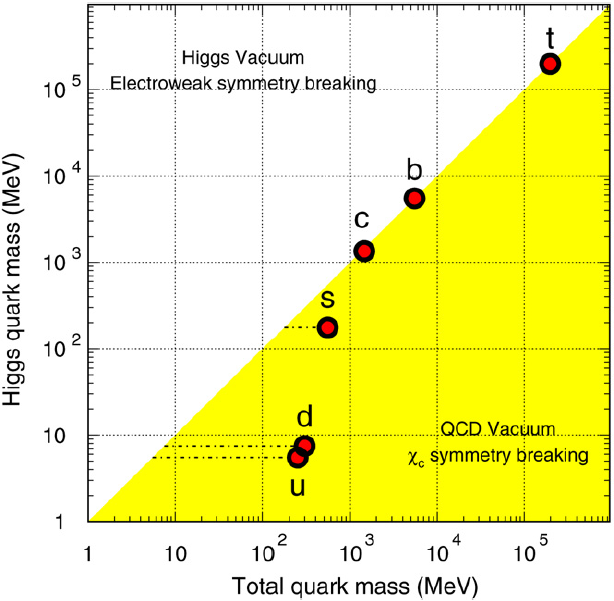 Depending on the energy scale, there are two mechanisms that generate quark masses with different degrees of importance: current quark masses are generated by the electroweak symmetry breaking mechanism (Higgs mass) and spontaneous chiral symmetry breaking leads to the constituent quark masses in QCD (QCD mass). The QCD interaction strongly affects the light quarks (u, d, s) while the heavy quark masses (c, b, t) are mainly determined by the Higgs mechanism. In high-energy nuclear collisions at RHIC, heavy quarks are produced through gluon fusion and qq¯ annihilation. Heavy quark production is also sensitive to the parton distribution function. Unlike the light quarks, heavy quark masses are not modified by the surrounding QCD medium (or the excitations of the QCD medium) and the value of their masses is much higher than the initial excitation of the system. It is these differences between light and heavy quarks in a medium that make heavy quarks an ideal probe to study the properties of the hot and dense medium created in high-energy nuclear collisions.
Depending on the energy scale, there are two mechanisms that generate quark masses with different degrees of importance: current quark masses are generated by the electroweak symmetry breaking mechanism (Higgs mass) and spontaneous chiral symmetry breaking leads to the constituent quark masses in QCD (QCD mass). The QCD interaction strongly affects the light quarks (u, d, s) while the heavy quark masses (c, b, t) are mainly determined by the Higgs mechanism. In high-energy nuclear collisions at RHIC, heavy quarks are produced through gluon fusion and qq¯ annihilation. Heavy quark production is also sensitive to the parton distribution function. Unlike the light quarks, heavy quark masses are not modified by the surrounding QCD medium (or the excitations of the QCD medium) and the value of their masses is much higher than the initial excitation of the system. It is these differences between light and heavy quarks in a medium that make heavy quarks an ideal probe to study the properties of the hot and dense medium created in high-energy nuclear collisions.
Heavy flavor analyses at STAR can be separated into quarkonia, open heavy flavor and heavy flavor leptons.
Abstracts, Presentations and Proceedings
Abstracts
This page is maintained by Gang Wang.
#9995# DNP (fall meeting) 2010
Abstracts for DNP (fall meeting) 2010 (Nov. 2-6, 2010, Santa Fe, NM)
- Wenqin Xu
Title: Extracting bottom quark production cross section from p+p collisions at RHIC
The STAR collaboration has measured the non-photonic electron (NPE) production at high transverse momentum (pT ) at middle rapidity in p + p collisions at sqrt(s) = 200 GeV at the Relativistic Heavy Ion Collider (RHIC). The relative contributions of bottom and charm hadrons to NPE have also been obtained through electron hadron azimuthal
correlation studies. Combining these two, we are able to determine the high pT mid-rapidity electron spectra
from bottom and charm decays, separately.
PYTHIA with different tunes and FONLL calculations have been compared with this measured electron spectrum
from bottom decays to extract the bb-bar differential cross section after normalization to the measured spectrum.
The extrapolation of the total bb-bar production cross section in the whole kinematic range and its dependence
on spectrum shapes from model calculations will also be discussed.
- Yifei Zhang
Title: Open charm hadron reconstruction via hadronic decays in p+p collisions at $sqrt{s}$ = 200 GeV
Heavy quarks are believed to be an ideal probe to study the properties of the QCD medium produced in the relativistic heavy ion collisions. Heavy quark production in elementary particle collisions is expected to be better calculated in the perturbative QCD. Precision understanding on both the charm production total cross section and the fragmentation in p+p collisions is a baseline to further explore the QCD medium via open charm and charmonium in heavy ion collisions.
Early RHIC measurements in p+p collisions which were carried out via semi-leptonic decay electrons provides limited knowledge on the heavy quark production due to the incomplete kinematics, the limited momentum coverage and the mixed contribution from various charm and bottom hadrons in the electron approach. In this talk, we will present
the reconstruction of open charm hadrons (D0 and D*) via the hadronic decays in p+p collisions at $sqrt{s}$ = 200 GeV in the STAR experiment. The analysis is based on the large p+p minimum bias sample collected in RHIC Run9. The Time-Of-Flight detector, which covered 72% of the whole barrel in Run9, was used to improve the decay daughter
identification. Physics implications from this analysis will be presented.
- Xin Li
Title: Non-photonic Electron Measurements in 200 GeV p+p collisions at RHIC-STAR
Compared to the light quarks, heavy quarks are produced early in the collisions and interact very differently with the strongly couple QGP(sQGP) created at RHIC. In addition, their large masses are created mostly from the spontaneous symmetry breaking. All these features make heavy quark an ideal probe to study the sQGP. One of the critical references in these studies is the heavy quark production in p+p collisions, which also provides a crucial test to the pQCD. Measuring electrons from heavy quark semi-leptonic decay (non-photonic electron) is one of the major approaches to study heavy quark production at RHIC.
We will present STAR measurements on the mid-rapidity non-photonic electron production at pT>2 GeV/c in 200 GeV p+p collisions using the datasets from the 2008 and 2005 runs, which have dramatically different photonic backgrounds. We will compare our measurements with the published results at RHIC and also report the status of the analysis at pT<2 GeV/c using the dataset from the 2009 run.
- Jonathan Bouchet
Title: Reconstruction of charmed decays using microvertexing techniques with the STAR Silicon Detectors
Due to their production at the early stages, heavy flavor particles are of interest to study the properties of the matter created in heavy ion collisions. Direct topological reconstruction of $D$ and $B$ mesons, as opposed to indirect methods using semi-leptonic decay channels [1], provides a precise measurement and thus disentangles the $b$ and $c$ quarks contributions [2].
In this talk we present a microvertexing technique used in the reconstruction of $D^{0}$ decay vertex ($D^{0} \rightarrow K^{-}\pi^{+}$) and its charge conjugate. The significant combinatorial background can be reduced by means of
secondary vertex reconstruction and other track cut variables. Results of this method using the silicon detector information of the STAR experiment at RHIC will be presented for the Au+Au system at $\sqrt{s_{NN}}$ = 200 GeV.
[1]A. Abelev et al., Phys. Rev. Lett. {\bf 98} (2007) 192301
[2]N. Armesto et al., Phys. Lett. B{\bf 637} (2006) 362-366.
#9996# Hard Probe 2010
Abstracts for 2010 Hard Probe Meeting (Oct. 10-15, 2010, Eilat, Israel)
- Wei Xie
Heavy quarks are unique probes to study the strongly coupled Quark-Gluon Plasma created at RHIC. Unlike light quarks, heavy quark masses come mostly from spontaneous symmetry breaking, which makes them ideal for studying the medium's QCD properties. Due to their large masses, they are produced early in the collisions and are expected to interact with the medium quite differently from that of light quarks. Detailed studies on the production of open heavy flavor mesons and heavy quarkonium in heavy-ion collisions and the baseline $p+p$ and $d+A$ collisions provide crucial information in understanding the medium's properties. With the large acceptance TPC, Time of Flight, EM Calorimeter and future Heavy-Flavor Tracker, STAR has the capabilities to study heavy quark production in the dense medium in all different directions. In this talk, we will review the current status as well as the future perspectives of heavy quark studies in STAR experiment.
- Zebo Tang
Title: $J/\psi$ production at high pT at STAR
The $c\bar{c}$ bound state $J/\psi$ provides a unique tool to probe the hot dense medium produced in heavy-ion collisions, but to date its production mechanism is not understood clearly neither in heavy-ion collisions nor in hadron hadron collisions. Measurement of $J/\psi$ production at high $p_T$ is particularly interesting since at high $p_T$
the various models give different predictions. More over some model calculations on $J/\psi$ production are only applicable at intermediate/high $p_T$. Besides, high $p_T$ particles are widely used to study the parton-medium interactions in heavy-ion collisions. In this talk, we will present the measurement of mid-rapidity (|y|<1) $J/\psi \rightarrow
e^+e^-$ production at high $p_T$ in p+p and Cu+Cu collisions at 200 GeV, that used a trigger on electron energy deposited in Electromagnetic Calorimeter. The $J/\psi$ $p_T$ spectra and nuclear modification factors will be compared to model calculations to understand its production mechanism and medium modifications. The $J/\psi$-hadron azimuthal angle correlation will be presented to disentangle $B$-mesons contributions to inclusive $J/\psi$. Progresses
from on-going analyses in p+p collisions at 200GeV taken in year 2009 high luminosity run will be also reported.
-
Rosi Reed
Title: $\Upsilon$ production in p+p, d+Au, Au+Au collisions at $\sqrt{{S}_{NN }} = $ 200 GeV in STAR
Quarkonia is a good probe of the dense matter produced in heavy-ion collisions at RHIC because it is produced early in the collision and the production is theorized to be suppressed due to the Debye color screening of the potential between the heavy quarks. A model dependent measurement of the temperature of the Quark Gluon Plasma (QGP) can be determined by examining the ratio of the production of various quarkonia states in heavy ion collisions versus p+p collisions because lattice calculations indicate that the quarkonia states will be sequentially suppressed. Suppression is quantified by calculating ${R}_{AA}$, which is the ratio of the production in p+p scaled by the number of binary collisions to the production in Au+Au. The $\Upsilon$ states are of particular interest because at 200 GeV the effects of feed down and co-movers are smaller than for J/$\psi$, which decreases the systematic uncertainty of the ${R}_{AA} calculation. In addition to hadronic absorption, additional cold nuclear matter effects, such as shadowing of the PDFs, can be determined from d+Au collisions. We will present our results for mid-rapidity $\Upsilon$ production in p+p, as well as our preliminary results in d+Au and Au+Au at $\sqrt{{S}_{NN }}$ = 200 GeV. These results will then be compared with theoretical QCD calculations.
-
Wei Li
Title: Non$-$Photonic Electron and Charged Hadron Azimuthal Correlation in 500 GeV p+p Collisionsions at RHIC
Due to the dead cone effect, heavy quarks were expected to lose less energy than light quarks since the current theory predicted that the dominant energy loss mechanism is gluon radiation for heavy quarks. Whereas non-photonic electron from heavy quark decays show similar suppression as light hadrons at high $p_{T}$ in central Au+Au collisions. It is important to separate the bottom contribution to non-photonic electron for the better understanding of heavy flavor
production and energy loss mechanism in ultra high energy heavy ion collisions. B decay contribution is approximately 50$\%$ at a transverse momentum of $p_{T}$$\geq$5 GeV/c in 200 GeV p+p collisions from STAR results. In this talk, we will present the azimuthal correlation analysis of non-photonic electrons with charged hadrons at $p_{T}$$\geq$6.5 GeV/c in p+p collisions at $\sqrt{s}$ = 500 GeV at RHIC. The results are compared to PYTHIA simulations to disentangle
charm and bottom contribution of semi-leptonic decays to non-photonic electrons.
-
Gang Wang
Title: B/D Contribution to Non-Photonic Electrons and Status of Non-Photonic Electron $v_2$ at RHIC
In contrast to the expectations due to the dead cone effect, non-photonic electrons from decays of heavy quark carrying hadrons show a similar suppression as light hadrons at high $p_{T}$ in central 200 GeV Au+Au collisions at RHIC. It is important to separate the charm and bottom contributions to non-photonic electrons to better understand the heavy flavor production and energy loss mechanism in high energy heavy ion collisions. Heavy quark energy loss and heavy quark evolution in the QCD medium can also lead to an elliptic flow $v_2$ of heavy quarks which can be studied through $v_2$ of non-photonic electrons.
In this talk, we present the azimuthal correlation analysis of non-photonic electrons with charged hadrons at 1.5 GeV/c < $p_{T}$ < 9.5 GeV/c in p+p collisions at $\sqrt{s}$ = 200 GeV at RHIC, with the removal of J/$\Psi$ contribution to non-photonic electrons. The results are compared with PYTHIA simulations to disentangle charm and bottom contributions of semi-leptonic decays to non-photonic electrons. B decay contribution is approximately 50$\%$ at the electron transverse momentum of $p_{T}$ > 5 GeV/c in 200 GeV p+p collisions from STAR results. Incorporating the spectra and energy loss information of non-photonic electrons, we further estimate the spectra and energy loss of the electrons from B/D decays. Status of $v_2$ measurements for non-photonic electrons will also be discussed for 200 GeV Au+Au collisions with RHIC run2007 data.
#9997# APS 2010 April Meeting
Abstracts for 2010 APS April Meeting (Feb. 13-17, 2010, Washington DC)
- Jonathan Bouchet
Title: Performance studies of the Silicon Detectors in STAR towards microvertexing of rare decays
Abstract: Heavy quarks production ($b$ and $c$) as well as their elliptic flow can be used as a probe of the thermalization of the medium created in heavy ions collisions. Direct topological reconstruction of charmed and bottom decays is then needed to obtain this precise measurement. To achieve this goal the silicon detectors of the STAR experiment are explored. These detectors, a Silicon Drift (SVT) 3-layer detector[1] and a Silicon Strip one-layer detector[2] provide tracking very near to the beam axis and allow us to search for heavy flavour with microvertexing methods. $D^{0}$ meson reconstruction including the silicon detectors in the tracking algorithm will be presented for the Au+Au collisions at $\sqrt{s_{NN}}$ = 200 GeV, and physics opportunities will be discussed.
[1]R. Bellwied et al., Nucl. Inst. Methods A499 (2003) 640.
[2]L. Arnold et al., Nucl. Inst. and Methods A499 (2003) 652.
- Matt Cervantes
Title: Upsilon + Hadron correlations at the Relativistic Heavy-Ion Collider (RHIC)
Abstract: STAR has the capability to reconstruct the heavy quarkonium states of both the J/Psi and Upsilon particles produced by the collisions at the Relativistic Heavy Ion Collider (RHIC). The systematics of prompt production of heavy quarkonium is not fully described by current models, e.g. the Color Singlet Model (CSM) and the Color Octect Model. Hadronic activity directly around the heavy quarkonium has been proposed [1] as an experimental observable to measure the radiation emitted off the coloured heavy quark pair during production. Possible insight into the prompt production mechanism of heavy quarkonium can be obtained from this measured activity. Using STAR data from dAu collisions at sqrt(s_NN)= 200 GeV, the high S/B ratio found in Upsilon reconstruction [2] can enable us to perform an analysis of Upsilon + Hadron correlations. We will present our initial investigation of such an analysis.
[1] Kraan, A. C., arXiv:0807.3123.
[2] Liu, H., STAR Collaboration, arXiv:0907.4538.
PWG convener to press the approval button
On this page, we collect the information about which PWG convener to press the final approval button for which conference.
| Conference | Convener |
| 2018 Hot Quarks | Rongrong Ma |
| 2018 Hard Probes | Petr Chaloupka |
| 2018 EJC | Petr Chaloupka |
| 2018 ATHIC | Zebo Tang |
| 2018 Zimanyi School | Petr Chaloupka |
| 2019 Bormio | Rongrong Ma |
| 2019 IIT Indore | Zebo Tang |
| 2019 QCD Moriond | Petr Chaloupka |
| 2019 APS April Meeting | Sooraj Radhakrishnan |
| 2019 QWG | Zebo Tang |
| 2019 FAIRness | Zebo Tang |
| 2019 SQM | Petr Chaloupka |
| 2019 AUM | Sooraj Radhakrishnan |
Presentations
#9997# WWND2010
Jan 2-9, 2010 Winter Workshop on Nuclear Dynamics (Ocho Rios, Jamaica)
- Manuel Calderon: Quarkonia in STAR: Results and Future Plans
- Sarah LaPointe: Heavy Flavor Measurements in STAR and Future Measurements Using the HFT
#9998# DNP/JPS 2009 meeting
Oct. 13-17, 2009 DNP/JPS 2009 meeting (Big Island, Hawaii)
- Daniel Kikola: J/psi production in Au+Au and Cu+Cu collisions at sqrt(sNN) = 200 GeV at STAR
- Chris Powell: Low pT J/psi production in d+Au collisions at sqrt(sNN) = 200 GeV in STAR
- Rosi Reed: Upsilon production in p+p, d+Au, Au+Au collisions at 200 GeV in STAR
- Barbara Trzeciak (poster): Production of high pT J/psi in p+p collisions at sqrt(s) = 200 GeV in STAR
#9999# SQM 2009 meeting
Sept. 27-Oct. 2, 2009 SQM 2009 meeting (Buzios, Brazil)
Proceedings
HF PWG QM2011 analysis topics
Random list of collected topics for HF PWG QM2011 (as 10.8.2010)
Gang Wang: NPE v2 and possible NPE-h correlation
based on 200 GeV data
Wenqin Xu: Non-photonic electron spectrum in available Run10 AuAu data, and calculate the R_AA
Rosi Reed: Upsilon RAA in the 200 GeV
Yifei,David,Xin: Charm hadron measurement via the hadronic decays in both Run9 p+p and
Run10 AuAu 200 GeV collisions
Zebo Tang: High-pT J/psi spectra and correlations in run9 p+p and its R_AA in run10 200GeV Au+Au
Xin Li/ Mustafa Mustafa: Run09 p+p and Run10 Au+Au NPE cross section.
Matt Cervantes: Upsilon+hadron correlations
Chris Powell: low pT J/Psi in run 10 200GeV Au+Au to obtain R_AA and polarization measurement
Barbara Trzeciak: J/psi polarization with large
statistic p+p sample (run 9).
HF PWG Preliminary plots
This page collects the preliminary plots approved by the HF PWG.
1) All the preliminary plots MUST contain a "STAR Preliminary" label.
2) Please include at least pdf and png versions for the figures
3) Where to put the data points: it is recommended to put the data point at the x position whose yield is equal to the averge yield of the bin.
-
Rongrong presented a couple of slides at the PWGC meeting: http://www.star.bnl.gov/protected/lfspectra/marr/Analysis/PlaceDataPoints.pdf.
- See also the classic paper by Lafferty and Wyatt, NIM A355 (1995) 541-547 or see http://inspirehep.net/record/374024.
Open Heavy Flavor
| Year | System | Physics figures | First shown | Link to figures |
| 2014+2016 | Au+Au @ 200 GeV | HFT: D+/- RAA | 2020 HP | plots |
| 2014+2016 | Au+Au @ 200 GeV | HFT: Ds+/- spectra, ratio | 2019 QM |
plots |
| 2016 | Au+Au @ 200 GeV | HFT: D+/- RAA | 2018 QM | plots |
| 2016 | d+Au @ 200 GeV | HFT: D0 | 2018 QM | plots |
| 2014 | Au+Au @ 200 GeV | HFT: D*/D0 ratio | 2018 QM | plots |
| 2014+2016 | Au+Au @ 200 GeV | HFT: D0 v1 | 2018 QM | plots |
| 2014+2016 | Au+Au @ 200 GeV | HFT: non-prompt Jpsi | 2017 QM | plots |
| 2014 | Au+Au @ 200 GeV | HFT: non-prompt D0 | 2017 QM | plots |
| 2014 | Au+Au @ 200 GeV | HFT: B/D->e | 2017 QM | plots |
| 2014 2014+2016 |
Au+Au @ 200 GeV | HFT: Lc/D0 Ds/D0 ratio HFT: Lc/D0ratio HFT: Lc/D0 Ds/D0 vs ALICE |
2017 QM 2018 QM 2019 Moriond |
plots plots plots |
| 2014 | Au+Au @ 200 GeV | HFT: Ds RAA and v2 | 2017 CPOD | plots |
| 2014 | Au+Au @ 200 GeV | HFT: D+/- | 2017 QM | plots |
| 2014 | Au+Au @ 200 GeV | HFT: D0 v3 | 2017 QM | plots |
| 2014 | Au+Au @ 200 GeV | D0-hadron correlation | 2017 QM | plots |
| 2014 | Au+Au @ 200 GeV | HFT: D0 RAA HFT: D0 RAA HFT: D0 RAA and v2 |
2019 SQM 2018 QM |
|
Quarkonium
| Year | System | Physics figures | First shown | Link to figures |
| 2018 | isobar @ 200 GeV | Minimum Bias: Jpsi RAA | 2022 QM | plots slides (USTC) slides (UIC) sildes (combined) |
| 2015 | p+p @ 200 GeV | Dimuon: Jpsi with jet activity | 2022 QM | plots slides |
| 2014 | Au+Au @ 200 GeV | Dimuon: Jpsi RAA, low pT | 2022 QM | plots slides |
| 2017 | Au+Au @ 54.4 GeV | Minimum Bias: Jpsi RAA | 2021 SQM | plots slides |
| 2011 | p+p @ 500 GeV | BEMC: Jpsi in jet | 2020 HP | plots |
| 2015 | p+Au @ 200 GeV | BEMC: Jpsi RpA | 2020 HP | plots |
| 2016 2014 2011 |
Au+Au @ 200 GeV | MTD/HT: Upsilon RAA | 2018 QM |
plots |
| 2015 | p+p, p+Au @ 200 GeV | MTD: Jpsi cross-section, RpA | 2017 QM | plots |
| 2015 | p+p @ 200 GeV | MTD: Jpsi polarization | 2017 PANIC | plots |
| 2015 | p+p, p+Au @ 200 GeV | BEMC: Upsilon RpAu | 2017 QM | plots |
| 2014 | Au+Au @ 200 GeV | MTD: Jpsi RAA, v2, Upsilon ratio | 2015 QM 2016 sQM |
plots |
| 2013 | p+p @ 500 GeV | MTD: Jpsi yield vs. event activity |
2015 HP |
plots |
| 2013 | p+p @ 500 GeV | MTD: Jpsi cross-section | 2016 sQM | plots |
| 2012 | U+U @ 193 GeV | MB: low-pT Jpsi excess | 2016 sQM | plots |
| 2012 | U+U @ 193 GeV | MB/BEMC: Jpsi v2 | 2017 QM | plots |
| 2012 | p+p @ 200 GeV | MB/BEMC: Jpsi cross-section, event activity BEMC: Jpsi polarization |
2016 QWG | plots plots |
| 2011 | Au+Au @ 200 GeV | MB/BEMC: Jpsi v2 | 2015 QM | plots |
| 2011 | Au+Au @ 200 GeV | MB: low-pT Jpsi excess | 2016 sQM | plots |
| 2011 | p+p @ 500 GeV | BEMC: Jpsi cross-section | WWND | plots |
| 2011 | p+p @ 500 GeV | HT: Upsilon cross-section HT: Upsilon event activity |
2017 QM 2018 PWRHIC |
plots |
Electrons from Heavy Flavor Decay
| Year | System | Physics figures | First shown | Link to figures |
| 2017 | Au+Au @ 27 & 54.4 GeV | NPE v2 | 2020 HP | plots |
| 2014+2016 | Au+Au @ 200 GeV | HF electron: fraction, RAA, double ratio | 2019 QM | plots |
| 2014 | Au+Au @ 200 GeV | NPE cross-section; RAA (without HFT) | 2017 QM | plots |
| 2012 | p+p @ 200 GeV | NPE-hadron correlation, b fraction | 2016 Santa Fe | plots |
| 2012 | p+p @ 200 GeV | NPE cross-section; udpated RAA | 2015 QM | plots |
Heavy Quark Physics in Nucleus-Nucleus Collisions Workshop at UCLA
We will organize a workshop on heavy quark physics in nucleus-nucleus collisions from January 22-24, 2009. The workshop will be hosted by the Department of Physics and Astronomy, University of California at Los Angeles.
NPE Analyses
PicoDst production requests
This page collects the picoDst (re)production requested made by the HF PWG| Priority | Dataset | Data stream | Special needs | Chain option | Production status | Comments |
| 0 | production_pAu200_2015 | st_physics st_ssdmb |
BEMC | PicoVtxMode:PicoVtxVpdOrDefault, TpcVpdVzDiffCut:6 | Done with SL18b | Needed for QM2018 |
| 2 | dAu200_production_2016 | st_physics | BEMC, FMS | PicoVtxMode:PicoVtxVpdOrDefault, TpcVpdVzDiffCut:6 | Benefit QM2018 analysis | |
| 3 | production_pAu200_2015 | st_mtd | BEMC | PicoVtxMode:PicoVtxVpdOrDefault, TpcVpdVzDiffCut:6 | ||
| 4 | AuAu200_production_2016 AuAu200_production2_2016 |
st_physics | BEMC, FMS | PicoVtxMode:PicoVtxVpdOrDefault, TpcVpdVzDiffCut:3 | ||
| 5 | AuAu_200_production_2014 AuAu_200_production_low_2014 AuAu_200_production_mid_2014 AuAu_200_production_high_2014 |
st_mtd |
BEMC | mtdMatch, y2014a, PicoVtxMode:PicoVtxVpdOrDefault, TpcVpdVzDiffCut:3 | ||
| 1 | AuAu_200_production_low_2014 AuAu_200_production_mid_2014 |
st_physics | BEMC | mtdMatch, y2014a, PicoVtxMode:PicoVtxVpdOrDefault, TpcVpdVzDiffCut:3 | ||
| 6 | production_pp200long_2015 production_pp200long2_2015 production_pp200long3_2015 production_pp200trans_2015 |
st_physics st_ssdmb |
BEMC | mtdMatch, y2015c,PicoVtxMode:PicoVtxVpdOrDefault, TpcVpdVzDiffCut:6 | ||
| production_pp200_2015 | st_mtd | mtdMatch, y2015c, PicoVtxMode:PicoVtxVpdOrDefault, TpcVpdVzDiffCut:6, PicoCovMtxMode:PicoCovMtxSkip |
Upsilon Analysis
Links related to Upsilon Analysis.
- Upsilon paper page from Pibero.
- Technical Note is located in Attachments to this page.
- TeX source (saved as .txt so drupal doesn't complain) for Technical Note is also in Attachments.
- Upsilon paper drafts are found below.
Combinatorial background subtraction for e+e- signals
It is common to use the formula 2*sqrt(N++ N--) to model the combinatorial background when studying e+e- signals, e.g. for J/psi and Upsilon analyses. We can obtain this formula in the following way.
Assume we have an event in which there are Nsig particles that decay into e+e- pairs. Since each decay generates one + and one - particle, the total number of unlike sign combinations we can make is N+- = Nsig2. To obtain the total number of pairs that are just random combinations, we subtract the number of pairs that came from a real decay. So we have
N+-comb=Nsig2-Nsig=Nsig(Nsig-1)
For the number of like-sign combinations, for example for the ++ combinations, there will be a total of (Nsig-1) pairs that can be made by the first positron, then (Nsig-2) that can be made by the second positron, and so on. So the total number of ++ combinations will be
N++ = (Nsig-1) + (Nsig - 2) + ... + (Nsig - (Nsig-1)) + (Nsig-Nsig)
Where there are Nsig terms. Factoring, we get:
N++ = Nsig2 - (1+2+...+Nsig) = Nsig2 - (Nsig(Nsig+1))/2 = (Nsig2 - Nsig)/2=Nsig(Nsig-1)/2
Similarly,
N-- = Nsig(Nsig-1)/2
If there are no acceptance effects, either the N++ or the N-- combinations can be used to model the combinatorial background by simply multiplying them by 2. The geometric average also works:
2*sqrt(N++ N--) = 2*Nsig(Nsig-1)/sqrt(4) = Nsig(Nsig-1) = N+-comb.
The geometric average can also work for cases where there are acceptance differences, with the addition of a multiplicative correction factor R to take the relative acceptance of ++ and -- pairs into account. So the geometric average is for the case R=1 (similar acceptance for ++ and --).
Estimating Acceptance Uncertainty due to unknown Upsilon Polarization
The acceptance of Upsilon decays depends on the polarization of the Upsilon. We do not have enough statistics to measure the polarization. It is also not clear even at higher energies if there is a definite pattern: there are discrepancies between CDF and D0 about the polarization of the 1S. The 2S and 3S show different polarizations trends than the 1S. So for the purposes of the paper, we will estimate the uncertainty due to the unknown Upsilon polarization using two extremes: fully transverse and fully longitudinal polarization. This is likely an overestimate, but the effect is not the dominant source of uncertainty, so for the paper it is good enough.
There are simulations of the expected acceptance for the unpolarized, longitudinal and transverse cases done by Thomas:
http://www.star.bnl.gov/protected/heavy/ullrich/ups-pol.pdf
Using the pT dependence of the acceptance for the three cases (see page 9 of the PDF) we must then apply it to our measured upsilons. We do this by obtaining the pT distribution of the unlike sign pairs (after subtracting the like-sign combinatorial background) in the Upsilon mass region and with |y|<0.5. This is shown below as the black data points.
.gif)
The data points are fit with a function of the form A pT2 exp(-pT/T), shown as the solid black line (fit result: A=18.0 +/- 8.3, T = 1.36 +/- 0.16 GeV/c). We then apply the correction for the three cases, shown in the histograms (with narrow line width). The black is the correction for the unpolarized case (default), the red is for the longitudinal and the blue is for the transverse case. The raw yield can be obtained by integrating the histogram or the function. These give 89.7 (histo) and 89.9 (fit), which given the size of the errors is a reasonable fit. We can obtain the acceptance corrected yield (we ignore all other corrections here) by integrating the histograms, which give:
- Unpol: 158.9 counts
- Trans: 156.4 counts
- Longi: 163.6 counts
We estimate from this that fully transverse Upsilons should have a yield lower by -1.6% and fully longitudinal Upsilons should have a higher yield by 2.9%. We use this as a systematic uncertainty in the acceptance correction.
In addition, the geometrical acceptance can vary in the real data due to masked towers which are not accounted for in the simulation. We estimate that this variation is of order 25 towers (which is used in the 2007 and 2008 runs as the number of towers allowed to be dynamically masked). This adds 25/4800 = 0.5% to the uncertainty in the geometrical acceptance.
Estimating Drell-Yan contribution from NLO calculation.
Ramona calculated the cross section for DY at NLO and sent the data points to us. These were first shown in the RHIC II Science Workshop, April 2005, in her Quarkonium talk and her Drell-Yan (and Open heavy flavor) talk.
The total cross section (integral of all mass points in the region |y|<5) is 19.6 nb (Need to check if there is an additional normalization with Ramona, but the cross section found by PHENIX using Pythia is 42 nb with 100% error bar, so a 19.6 nb cross section is certainly consistent with this). She also gave us the data in the region |y|<1, where the cross section is 5.24 nb. The cross section as a function of invariant mass in the region |y|<1 is shown below.
.gif)
The black curve includes a multiplication with an error function (as we did for the b-bbar case) and normalized such that the ratio between the blue and the black line is 8.5% at 10 GeV/c to account for the efficiency and acceptance found in embedding for the Upsilon 1s. The expected counts in the region 8-11 are 20 +/- 3, where the error is given by varying the parameters of the error function within its uncertainty. The actual uncertainty is likely bigger than this if we take into account the overall normalization uncertainty in the calculation.
I asked Ramona for the numbers in the region |y|<0.5, since that is what we use in STAR. The corresponding plot is below.
.gif)
The integral of the data points gives 2.5 nb. The integral of the data between 7.875 and 11.125 GeV/c2 is 42.30 pb. The data is parameterized by the function shown in blue. The integral of the function in the same region gives 42.25 pb, so it is quite close to the calculation. In the region 8<m<11 GeV/c2, the integral of the funciton is 38.6 pb. The expected counts with this calculation are 25 for both triggers.
Response to PRD referee comments on Upsilon Paper
First Round of Referee Responses
Click here for second round.
-------------------------------------------------------------------------
Report of Referee A:
-------------------------------------------------------------------------
This is really a well-written paper. It was a pleasure to read, and I
have only relatively minor comments.
We thank the reviewer for careful reading of our paper and for providing
useful feedback. We are pleased to know that the reviewer finds the
paper to be well written. We have incorporated all the comments into a
new version of the draft.
Page 3: Although there aren't published pp upsilon cross sections there
is a published R_AA and an ee mass spectrum shown in E. Atomssa's QM09
proceedings. This should be referenced.
We are aware of the PHENIX results from
E. Atomssa, Nucl.Phys.A830:331C-334C,2009
and three other relevant QM proceedings:
P. Djawotho, J.Phys.G34:S947-950,2007
D. Das, J.Phys.G35:104153,2008
H. Liu, Nucl.Phys.A830:235C-238C,2009
However, it is STAR's policy to not reference our own preliminary data on the manuscript we submit for publication on a given topic, and by extension not to reference other preliminary experimental data on the same topic either.
Page 4, end of section A: Quote trigger efficiency.
The end of Section A now reads:
"We find that 25% of the Upsilons produced at
midrapidity have both daughters in the BEMC acceptance and at least one
of them can fire the L0 trigger. The details of the HTTP
trigger efficiency and acceptance are discussed in Sec. IV"
Figure 1: You should either quote L0 threshold in terms of pt, or plot
vs. Et. Caption should say L0 HT Trigger II threshold.
We changed the figure to plot vs. E_T, which is the quantity that is
measured by the calorimeter. For the electrons in the analysis, the
difference between p_T and E_T is negligible, so the histograms in
Figure 1 are essentially unchanged. We changed the caption as suggested.
Figures 3-6 would benefit from inclusion of a scaled minimum bias spectrum
to demonstrate the rejection factor of the trigger.
We agree that it is useful to quote the rejection factor of the trigger.
We prefer to do so in the text. We added to the description of Figure
3 the following sentence: "The rejection factor achieved with Trigger
II, defined as the number of minimum bias events counted by the trigger scalers
divided by the number events where the upsilon trigger was issued, was
found to be 1.8 x 105."
Figure 9: There should be some explanation of the peak at E/p = 2.7
We investigated this peak, and we traced it to a double counting error.
The problem arose due to the fact that the figure was generated from
a pairwise Ntuple, i.e. one in which each row represented a pair of
electrons (both like-sign and unlike-sign pairs included), each with a
value of E and p, instead of a single electron Ntuple. We had plotted
the value of E/p for the electron candidate which matched all possible
high-towers in the event. The majority of events have only one candidate
pair, so there were relatively few cases where there was double
counting. We note that for pairwise quantities such as opening angle and
invariant mass, each entry in the Ntuple is still different. However,
the case that generated the peak at E/p = 2.7 in the figure was traced
to one event that had one candidate positron track, with its
corresponding high-tower, which was paired with several other electron
and positron candidates. Each of these entries has a different invariant
mass, but the same E/p for the first element of the pair. So its entry
in Figure 9, which happened to be at E/p=2.7, was repeated several times
in the histogram. The code to generate the data histogram in Figure 9
has now been corrected to guarantee that the E/p distribution is made
out of unique track-cluster positron candidates. The figure in the paper
has been updated. The new histogram shows about 5 counts in that
region. As a way to gauge the effect the double counting had on the
E/p=1 area of the figure, there were about 130 counts in the figure at
the E/p=1 peak position in the case with the double-counting error, and
there are about 120 counts in the peak after removing the
double-counting. The fix leads to an improved match between the data
histogram and the Monte Carlo simulations. We therefore leave the
efficiency calculation, which is based on the Monte Carlo Upsilon
events, unchanged. The pairwise invariant mass distribution from which
the main results of the paper are obtained is unaffected by this. We
thank the reviewer for calling our attention to this peak, which allowed
us to find and correct this error.
-------------------------------------------------------------------------
Report of Referee B:
-------------------------------------------------------------------------
The paper reports the first measurement of the upsilon (Y) cross-section
in pp collisions at 200 GeV. This is a key piece of information, both
in the context of the RHIC nucleus-nucleus research program and in its
own right. The paper is rather well organized, the figures are well
prepared and explained, and the introduction and conclusion are clearly
written. However, in my opinion the paper is not publishable in its
present form: some issues, which I enumerate below, should be addressed
by the authors before that.
The main problems I found with the paper have to do with the estimate
of the errors. There are two issues:
The first: the main result is obtained by integrating the counts above
the like-sign background between 8 and 11 GeV in figure 10, quoted to
give 75+-20 (bottom part of table III). This corresponds the sum Y +
continuum. Now to get the Y yield, one needs to subtract an estimated
contribution from the continuum. Independent of how this has been
estimated, the subtraction can only introduce an additional absolute
error. Starting from the systematic error on the counts above background,
the error on the estimated Y yield should therefore increase, whereas
in the table it goes down from 20 to 18.
Thanks for bringing this issue to our attention. It is true that when
subtracting two independently measured numbers, the statistical
uncertainty in the result of the subtraction can only be larger than the
absolute errors of the two numbers, i.e. if C = A - B, and error(A) and
error(B) are the corresponding errors, then the statistical error on C
would be sqrt(error(B)2+error(A)2) which would yield a larger absolute
error than either error(A) or error(B). However, the extraction of the
Upsilon yield in the analysis needs an estimate of the continuum
contribution, but the key difference is that it is not obtained by an
independent measurement. The two quantities, namely the Upsilon yield
and the continuum yield, are obtained ultimately from the same source:
the unlike sign dielectron distribution, after the subtraction of the
like-sign combinatorial background. This fact causes an
anti-correlation between the two yields, the larger the continuum yield,
the smaller the Upsilon yield. So one cannot treat the subtraction of
the continuum yield and the Upsilon yield as the case for independent
measurements. This is why in the paper we discuss that an advantage of
using the fit includes taking automatically into account the correlation
between the continuum and the Upsilon yield. So the error that is
quoted in Table III for all the "Upsilon counts", i.e. the Fitting
Results, the Bin-by-bin Counting, and the Single bin counting, is quoted
by applying the percent error on the Upsilon yield obtained from the
fitting method, which is the best way to take the anti-correlation
between the continuum yield and the Upsilon yield into account. We will
expand on this in section VI.C, to help clarify this point. We thank the referee for
alerting us.
The second issue is somewhat related: the error on the counts (18/54, or
33%) is propagated to the cross section (38/114) as statistical error,
and a systematic error obtained as quadratic sum of the systematic
uncertainties listed in Table IV is quoted separately. The uncertainty on
the subtraction of the continuum contribution (not present in Table IV),
has completely disappeared, in spite of being identified in the text as
"the major contribution to the systematic uncertainty" (page 14, 4 lines
from the bottom).
This is particularly puzzling, since the contribution of the continuum
is even evaluated in the paper itself (and with an error). This whole
part needs to be either fixed or, in case I have misunderstood what the
authors did, substantially clarified.
We agree that this can be clarified. The error on the counts (18/54, or
33%) includes two contributions:
1) The (purely statistical) error on the unlike-sign minus like sign
subtraction, which is 20/75 or 26%, as per Table III.
2) The additional error from the continuum contribution, which we
discuss in the previous comment, and is not just a statistical sum of
the 26% statistical error and the error on the continuum, rather it must
include the anti-correlation of the continuum yield and the Upsilon
yield. The fit procedure takes this into account, and we arrive at the
combined 33% error.
The question then arises how to quote the statistical and systematic
uncertainties. One difficulty we faced is that the subtraction of the
continuum contribution is not cleanly separated between statistical and
systematic uncertainties. On the one hand, the continuum yield of 22
counts can be varied within the 1-sigma contours to be as low as 14 and
as large as 60 counts (taking the range of the DY variation from Fig.
12). This uncertainty is dominated by the statistical errors of the
dielectron invariant mass distribution from Fig. 11. Therefore, the
dominant uncertainty in the continuum subtraction procedure is
statistical, not systematic. To put it another way, if we had much
larger statistics, the uncertainty in the fit would be much reduced
also. On the other hand, there is certainly a model-dependent component
in the subtraction of the continuum, which is traditionally a systematic
uncertainty. We chose to represent the combined 33% percent error as a
statistical uncertainty because a systematic variation in the results
would have if we were to choose, say, a different model for the continuum
contribution, is smaller compared to the variation allowed by the
statistical errors in the invariant mass distribution. In other words,
the reason we included the continuum subtraction uncertainty together in
the quote of the statistical error was that its size in the current
analysis ultimately comes from the statistical precision of our
invariant mass spectrum. We agree that this is not clear in the text,
given that we list this uncertainty among all the other systematic
uncertainties, and we have modified the text to clarify this. Perhaps a
more appropriate way to characterize the 33% error is that it includes
the "statistical and fitting error", to highlight the fact that in
addition to the purely statistical errors that can be calculated from
the N++, N-- and N+- counting statistics, this error includes the
continuum subtraction error, which is based on a fit that takes into
account the statistical error on the invariant mass spectrum, and the
important anti-correlation between the continuum yield and the Upsilon
yield. We have added an explanation of these items in the updated draft of
the paper, in Sec VI.C.
There are a few other issues which in my opinion should be dealt with
before the paper is fit for publication:
- in the abstract, it is stated that the Color Singlet Model (CSM)
calculations underestimate the Y cross-section. Given that the discrepancy
is only 2 sigma or so, such a statement is not warranted. "Seems to
disfavour", could perhaps be used, if the authors really insist in making
such a point (which, however, would be rather lame). The statement that
CSM calculations underestimate the cross-section is also made in the
conclusion. There, it is even commented, immediately after, that the
discrepancy is only a 2 sigma effect, resulting in two contradicting
statements back-to-back.
Our aim was mainly to be descriptive. To clarify our intent, the use of
"underestimate" is in the sense that if we move our datum point lower by the
1-sigma error of our measurement and this value is higher than the top
end of the CSM calculation. We quantify this by saying that the
size of the effect is about 2-sigma. We think that the concise statement
"understimate by 2sigma" objectively summarizes the observation, without
need to use more subjective statements, and we modified
the text in the abstract and conclusion accordingly.
- on page 6 it is stated that the Trigger II cuts were calculated offline
for Trigger I data. However, it is not clear if exactly the same trigger
condition was applied offline on the recorded values of the original
trigger input data or the selection was recalculated based on offline
information. This point should be clarified.
Agreed. We have added the sentence: "The exact same trigger condition was
applied offline on the recorded values of the original trigger input data."
- on page 7 it is said that PYTHIA + Y events were embedded in zero-bias
events with a realistic distribution of vertex position. Given that
zero-bias events are triggered on the bunch crossing, and do not
necessarily contain a collision (and even less a reconstructed vertex),
it is not clear what the authors mean.
We do not know if the statement that was unclear is how the realsitic
vertex distribution was obtained or if the issue pertained to where the analyzed collision comes from.
We will try to clarify both instances. The referee has correctly understood
that the zero-bias events do not necessarily contain a collision.
That is why the PYTHIA simulated event is needed. The zero-bias events
will contain additional effects such as out of time pile-up in the Time
Projection Chamber, etc. In other words, they will contain aspects of
the data-taking environment which are not captured by the PYTHIA events.
That is what is mentioned in the text:
"These zero-bias events do not always have a collision in the given
bunch crossing, but they include all the detec-
tor effects and pileup from out-of-time collisions. When
combined with simulated events, they provide the most
realistic environment to study the detector e±ciency and
acceptance."
The simulated events referred to in this text are the PYTHIA events, and
it is the simulated PYTHIA event, together with the Upsilon, that
provides the collision event to be studied for purposes of acceptance
and efficiency. In order to help clarify our meaning, we have also added
statements to point out that the dominant contribution to the TPC occupancy
is from out of time pileup.
Regarding the realistic distribution of vertices,
this is obtained from the upsilon triggered events (not from the zero-bias events, which
have no collision and typically do not have a found vertex, as the referee correctly
interpreted). We have added a statement to point this out and hopefully this will make
the meaning clear.
- on page 13 the authors state that they have parametrized the
contribution of the bbar contribution to the continuum based on a PYTHIA
simulation. PYTHIA performs a leading order + parton shower calculation,
while the di-electon invariant mass distribution, is sensitive to
next-to-leading order effects via the angular correlation of the the two
produced b quarks. Has the maginuted of this been evaluated by comparing
PYTHIA results with those of a NLO calculation?
We did not do so for this paper. This is one source of systematic
uncertainty in the continuum contribution, as discussed in the previous
remarks. For this paper, the statistics in the dielectron invariant
mass distribution are such that the variation in the shape of the b-bbar
continuum between LO and NLO would not contribute a significant
variation to the Upsilon yield. This can be seen in Fig. 12, where the
fit of the continuum allows for a removal of the b-bbar yield entirely,
as long as the Drell-Yan contribution is kept. We expect to make such
comparisons with the increased statistics available in the run 2009
data, and look forward to including NLO results in the next analysis.
- on page 13 the trigger response is emulated using a turn-on function
parametrised from the like-sign data. Has this been cross-checked with a
simulation? If yes, what was the result? If not, why?
We did not cross check the trigger response on the continuum with a
simulation, because a variation of the turn-on function parameters gave
a negligible variation on the extracted yields, so it was not deemed
necessary. We did use a simulation of the trigger response on simulated
Upsilons (see Fig. 6, dashed histogram).
Finally, I would like to draw the attention of the authors on a few less
important points:
- on page 6 the authors repeat twice, practically with the same words,
that the trigger rate is dominated by di-jet events with two back-to-back
pi0 (once at the top and once near the bottom of the right-side column).
We have changed the second occurrence to avoid repetitiveness.
- all the information of Table I is also contained in Table 4; why is
Table I needed?
We agree that all the information in Table I is contained in Table 4
(except for the last row, which shows the combined efficiency for the
1S+2S+3S), so it could be removed. We have included it for convenience
only: Table I helps in the discussion of the acceptance and
efficiencies, and gives the combined overall correction factors, whereas
the Table IV helps in the discussion of the systematic uncertainties of
each item.
- in table IV, the second column says "%", which is true for the
individual values of various contributions to the systematic uncertainty,
but not for the combined value at the bottom, which instead is given
in picobarn.
Agreed. We have added the pb units for the Combined error at the bottom of the
table.
- in the introduction (firts column, 6 lines from the bottom) the authors
write that the observation of suppression of Y would "strongly imply"
deconfinement. This is a funny expression: admitting that such an
observation would imply deconfinement (which some people may not be
prepared to do), what's the use of the adverb "strongly"? Something
either does or does not imply something else, without degrees.
We agree that the use of "imply" does not need degrees, and we also
agree that some people might not be prepared to admit that such an
observation would imply deconfinement. We do think that such an
observation would carry substantial weight, so we have rephrased that
part to "An observation of suppression of Upsilon
production in heavy-ions relative to p+p would be a strong argument
in support of Debye screening and therefore of
deconfinement"
We thank the referee for the care in reading the manuscript and for all
the suggestions.
Second Round of Referee Responses
> I think the paper is now much improved. However,
> there is still one point (# 2) on which I would like to hear an
> explanation from the authors before approving the paper, and a
> couple of points (# 6 and 7) that I suggest the authors should
> still address.
> Main issues:
> 1) (errors on subtraction of continuum contribution)
> I think the way this is now treated in the paper is adequate
> 2) (where did the subtraction error go?)
> I also agree that the best way to estimate the error is
> to perform the fit, as is now explicitly discussed in the paper.
> Still, I am surprised, that the additional error introduced by
> the subtraction of the continuum appears to be negligible
> (the error is still 20). In the first version of the paper there
> was a sentence – now removed – stating that the uncertainty
> on the subtraction of the continuum contribution was one
> of the main sources of systematic uncertainty!
> -> I would at least like to hear an explanation about
> what that sentence
> meant (four lines from the bottom of page 14)
Response:
Regarding the size of the error:
The referee is correct in observing that the error before
and after subtraction is 20, but it is important to note
that the percentage error is different. Using the numbers
from the single bin counting, we get
75.3 +/- 19.7 for the N+- - 2*sqrt(N++ * N--),
i.e. the like-sign subtracted unlike-sign signal. The purely
statistical uncertainty is 19.7/75.3 = 26%. When we perform
the fit, we obtain the component of this signal that is due
to Upsilons and the component that is due to the Drell-Yan and
b-bbar continuum, but as we discussed in our previous response,
the yields have an anti-correlation, and therefore there is no
reason why the error in the Upsilon yield should be larger in
magnitude than the error of the like-sign subtracted unlike-sign
signal. However, one must note that the _percent_ error does,
in fact, increase. The fit result for the upsilon yield alone
is 59.2 +\- 19.8, so the error is indeed the same as for the
like-sign subtracted unlike-sign signal, but the percent error
is now larger: 33%. In other words, the continuum subtraction
increases the percent error in the measurement, as it should.
Note that if we one had done the (incorrect) procedure of adding
errors in quadrature, using an error of 14.3 counts for the
continuum yield and an error of 19.7 counts for the
background-subtracted unlike-sign signal, the error on the
Upsilon yield would be 24 counts. This is a relative error of 40%, which
is larger than the 33% we quote. This illustrates the effect
of the anti-correlation.
Regarding the removal of the sentence about the continuum
subtraction contribution to the systematic uncertainty:
During this discussion of the continuum subtraction and
the estimation of the errors, we decided to remove the
sentence because, as we now state in the paper, the continuum
subtraction uncertainty done via the fit is currently
dominated by the statistical error bars of the data in Fig. 11,
and is therefore not a systematic uncertainty. A systematic
uncertainty in the continuum subtraction would be estimated,
for example, by studying the effect on the Upsilon yield that
a change from the Leading-Order PYTHIA b-bbar spectrum we use
to a NLO b-bbar spectrum, or to a different Drell-Yan parameterization.
As discussed in the response to point 6), a complete
removal of the b-bbar spectrum, a situation allowed by the fit provided
the Drell-Yan yield is increased, produces a negligible
change in the Upsilon yield. Hence, systematic variations
in the continuum do not currently produce observable changes
in the Upsilon yield. Varying the continuum yield
of a given model within the statistical error bars does, and
this uncertainty is therefore statisitcal. Therefore, we removed the
sentence stating that the continuum subtraction is one
of the dominant sources of systematic uncertainty because
in the reexamination of that uncertainty triggered by the
referee's comments, we concluded that it is more appropriate
to consider it as statistical, not systematic, in nature.
We have thus replaced that sentence, and in its stead
describe the uncertainty in the cross
section as "stat. + fit", to draw attention to the fact that
this uncertainty includes the continuum subtraction uncertainty
obtained from the fit to the data. The statements in the paper
in this respect read (page 14, left column):
It should be noted that
with the statistics of the present analysis, we find that the
allowed range of variation of the continuum yield in the fit is
still dominated by the statistical error bars of the invariant mass
distribution, and so the size of the 33% uncertainty is mainly
statistical in nature. However, we prefer to denote
the uncertainty as “stat. + fit” to clarify that it includes the estimate of the anticorrelation
between the Upsilon and continuum yields obtained
by the fitting method. A systematic uncertainty due to
the continuum subtraction can be estimated by varying
the model used to produce the continuum contribution
from b-¯b. These variations produce a negligible change in
the extracted yield with the current statistics.
We have added our response to point 6) (b-bbar correlation systematics)
to this part of the paper, as it pertains to this point.
> Other issues:
> 3) (two sigma effect)
> OK
> 4) (Trigger II cuts)
> OK
> 5) (embedding)
> OK
> 6) (b-bbar correlation)
> I suggest adding in the paper a comment along the lines of what
> you say in your reply
> 7) (trigger response simulation)
> I suggest saying so explicitly in the paper
Both responses have been added to the text of the paper.
See page 13, end of col. 1, (point 7) and page 14, second column (point 6).
> Less important points:
> 8) (repetition)
> OK
> 9) (Table I vs Table IV)
> OK…
> 10) (% in last line of Table IV)
> OK
> 11) (“strongly imply”)
> OK
We thank the referee for the care in reading the manuscript, and look forward to
converging on these last items.
Upsilon Analysis in d+Au 2008
Upsilon yield and nuclear modification factor in d+Au collisions at sqrt(s)=200 GeV.
PAs: Anthony Kesich, and Manuel Calderon de la Barca Sanchez.
- Dataset QA
- Trigger ID, runs
- Trigger ID = 210601
- ZDC East signal + BEMC HT at 18 (Et>4.3 GeV) + L2 Upsilon
- Total Sampled Luminosity: 32.66 nb^-1; 1.216 Mevents
- http://www.star.bnl.gov/protected/common/common2008/trigger2008/lum_pertriggerid_dau2008.txt
- Trigger ID = 210601
- Run by Run QA
- Integrated Luminosity estimate
- Systematic Uncertainty
- Trigger ID, runs
- Acceptance (Check with Kurt Hill)
- Raw pT, y distribution of Upsilon
- Accepted pT, y distribution of Upsilons
- Acceptance
- Raw pT, eta distribution of e+,e- daughters
- Accepted pT, eta distribution of e+,e- daughters
- Comparison plots between single-electron embedding, Upsilon embedding
- L0 Trigger
- DSM-ADC Distribution (data, i.e. mainly background)
- DSM-ADC Distribution (Embedding) For accepted Upsilons, before and after L0 trigger selection
- Systematic Uncertainty (Estimate of possible calibration and resolution systematic offsets).
- "highest electron/positron Et" distribution from embedding (Accepted Upsilons, before and after L0 trigger selection)
- L2 Trigger
- E1 Cluster Et distribution (data, i.e. mainly background)
- E1 Cluster Et distribution (embedding, L0 triggered, before and after all L2 trigger cuts)
- L2 pair opening angle (cos theta) data (i.e. mainly background)
- L2 pair opening angle (cos theta) embedding. Needs map of (phi,eta)_MC to (phi,eta)_L2 from single electron embedding. Then a map from r1=(phi,eta, R_emc) to r1=(x,y,z) so that one can do cos(theta^L2) = r1.dot(r2)/(r1.mag()*r2.mag()). Plot cos theta distribution for L0 triggered events, before and after all L2 trigger cuts. (Kurt)
- L2 pair invariant mass from data (i.e. mainly background)
- L2 pair invariant mass from embedding. Needs simulation as for cos(theta), so that one can do m^2 = 2 * E1 * E2 * (1 - cos(theta)) where E1 and E2 are the L2 cluster energies. Plot the invariant mass distribution fro L0 triggered events, before and after all L2 trigger cuts. (Check with Kurt)
- PID
- dE/dx
- dE/dx vs p for the Upsilon triggered data
- nsigma_dE/dx calibration of means and sigmas (done by C. Powell for his J/Psi work)
- Cut optimization (Maximization of electron effective signal)
- Final cuts for use in data analysis
- E/p
- E/p distributions for various p bins
- Study of E calibration and resolution between data and embedding (for L0 Trigger systematic uncertainty)
- Resolution and comparison with embedding (for cut efficiency estimation)
- dE/dx
- Yield extraction
- Invariant mass distributions
- Unlike-sign and Like-sign inv. mass
- Like-sign subtracted inv. mass
- Crystal-Ball shapes from embedding/simulation. Crystal-ball parameters to be used in fit
- Fit to Like-sign subtracted inv. mass, using CB, DY, b-bbar
- Contour plot (1sigma and 2sigma) of b-bbar cross section vs. DY cross section
- Upsilon yield estimation and stat. + fit error
- Invariant mass distributions
- Cross section calculation.
- Yield, dN/dy
- Integrated luminosity (for 1/N_events, where N_events were the total events sampled by the L0 trigger)
- Efficiency (Numbers for each state, and cross-section-branching-ratio-weighted average)
- Uncertainty
- pt Distribution (invariant, i.e. 1/N_event 1/2pi, 1/pt dN/dpt dy) in |y|<0.5 vs pt) This might need one to do the CB, DY, bbbar fit in pt bins.
- Nuclear Modification Factor
- Estimation of <Npart> for the dataset, and uncertainty.
- Putting it all together: dN/dy in dAu, Npart, Luminosity (N_events), divided by the pp numbers (dsigma/dy, sigma_pp)
- Plot of R_dAu vs y, comparison with theory
- Plot of R_dAu vs Npart, together with Au+Au
- Plot of R_dAu vs pt. Try to do together with Au+Au (minbias, maybe in centrality bins, but maybe not enough stats)
Upsilon Analysis in p+p 2009
Upsilon cross-section in p+p collisions at sqrt(sNN) = 200 GeV, 2009 data.
PAs: Kurt Hill, Andrew Peterson, Gregory Wimsatt, Anthony Kesich, Rosi Reed, Manuel Calderon de la Barca Sanchez.
- Dataset QA (Andrew Peterson)
- Trigger ID, runs
- Run by Run QA
- Integrated Luminosity estimate
- Systematic Uncertainty
- Acceptance (Kurt Hill)
- Raw pT, y distribution of Upsilon
- Accepted pT, y distribution of Upsilons
- Acceptance
- Raw pT, eta distribution of e+,e- daughters
- Accepted pT, eta distribution of e+,e- daughters
- Comparison plots between single-electron embedding, Upsilon embedding
- L0 Trigger
- DSM-ADC Distribution (data, i.e. mainly background) (Drew)
- DSM-ADC Distribution (Embedding) For accepted Upsilons, before and after L0 trigger selection
- Systematic Uncertainty (Estimate of possible calibration and resolution systematic offsets).
- "highest electron/positron Et" distribution from embedding (Accepted Upsilons, before and after L0 trigger selection)
- L2 Trigger
- E1 Cluster Et distribution (data, i.e. mainly background)
- E1 Cluster Et distribution (embedding, L0 triggered, before and after all L2 trigger cuts)
- L2 pair opening angle (cos theta) data (i.e. mainly background)
- L2 pair opening angle (cos theta) embedding. Needs map of (phi,eta)_MC to (phi,eta)_L2 from single electron embedding. Then a map from r1=(phi,eta, R_emc) to r1=(x,y,z) so that one can do cos(theta^L2) = r1.dot(r2)/(r1.mag()*r2.mag()). Plot cos theta distribution for L0 triggered events, before and after all L2 trigger cuts. (Kurt)
- L2 pair invariant mass from data (i.e. mainly background)
- L2 pair invariant mass from embedding. Needs simulation as for cos(theta), so that one can do m^2 = 2 * E1 * E2 * (1 - cos(theta)) where E1 and E2 are the L2 cluster energies. Plot the invariant mass distribution fro L0 triggered events, before and after all L2 trigger cuts. (Kurt)
- PID (Greg)
- dE/dx
- dE/dx vs p for the Upsilon triggered data
- nsigma_dE/dx calibration of means and sigmas
- Cut optimization (Maximization of electron effective signal)
- Final cuts for use in data analysis
- E/p
- E/p distributions for various p bins
- Study of E calibration and resolution between data and embedding (for L0 Trigger systematic uncertainty)
- Resolution and comparison with embedding (for cut efficiency estimation) (Kurt and Greg)
- dE/dx
- Yield extraction
- Invariant mass distributions
- Unlike-sign and Like-sign inv. mass (Drew)
- Like-sign subtracted inv. mass (Drew)
- Crystal-Ball shapes from embedding/simulation. (Kurt) Crystal-ball parameters to be used in fit (Drew)
- Fit to Like-sign subtracted inv. mass, using CB, DY, b-bbar.
- Contour plot (1sigma and 2sigma) of b-bbar cross section vs. DY cross section. (Drew)
- Upsilon yield estimation and stat. + fit error. (Drew)
- (2S+3S)/1S (Drew)
- Invariant mass distributions
- pT Spectra (Drew)
- Cross section calculation.
- Yield
- Integrated luminosity
- Efficiency (Numbers for each state, and cross-section-branching-ratio-weighted average)
- Uncertainty
- h+/h- Corrections
Upsilon Analysis in p+p 2009 data - Acceptance
- Acceptance (Kurt Hill) - Upsilon acceptance aproximated using a simulation that constructs Upsilons (flat in pT and y), lets them decay to e+e- pairs in the Upsilon's rest frame, and uses detector response functions generated from a single electron embedding to model detector effects. An in depth study of this method will also be included.
- Raw pT, y distribution of Upsilon
- Accepted pT, y distribution of Upsilons
- Acceptance
- Raw pT, eta distribution of e+,e- daughters
- Accepted pT, eta distribution of e+,e- daughters
- Comparison plots between single-electron embedding, Upsilon embedding
Upsilon Analysis in p+p 2009 data - Acceptance
- Acceptance (Kurt Hill)
- Raw pT, y distribution of Upsilon
- Accepted pT, y distribution of Upsilons
- Acceptance
- Raw pT, eta distribution of e+,e- daughters
- Accepted pT, eta distribution of e+,e- daughters
- Comparison plots between single-electron embedding, Upsilon embedding
Upsilon Paper: pp, d+Au, Au+Au
Page to collect the information for the Upsilon paper based on the analysis of
Anthony (4/24):
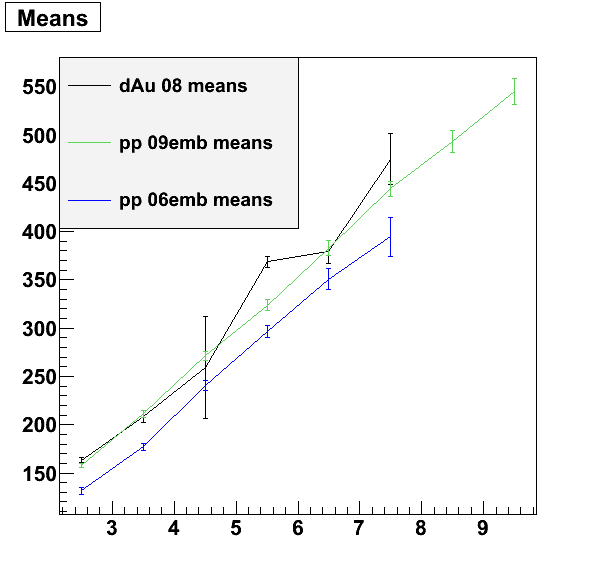
in data, the electrons were selected via 0<nSigE<3, R<0.02. For pt<5, we fit to 0<adc<303. For pt>5, 303<adc<1000.
In embedding, the only selections are the p range, R<0.02, and eleAcceptTrack. The embedding pt distro was reweighted to match the data.
Anthony (4/5): Added new Raa plot with comparison to strickland's supression models
Anthony (4/4): I attached some dAu cross section plots on this page. The eps versions are on nuclear. The cross sections are as follows:
all: 25.9±4.0 nb
0-2: 1.8±1.7 nb
2-4: 10.9±2.9 nb
4-6. 5.2±5.3 nb
6-8: 0.57±0.59 nb
I expect the cross sections to change once I get new efficiences from embedding, but not by a whole lot.
Drew (4/6): Got Kurt's new lineshapes, efficiencies, and double-ERF parameters today. Uploading the fits to them. I'm not sure I believe the fits...
Bin-by-Bin Counting Cross Section by pT (GeV/c):
|y|<1.0 all: 134.6 ± 10.6 pb
0-2: 27.6 ± 6.3 pb
2-4: 39.1 ± 5.8 pb
4-6: 19.9 ± 3.8 pb
6-8: 13.6 ± 5.1 pb
|y|<0.5 all: 119.2 ± 12.4 pb
0-2: 23.8 ± 6.8 pb
2-4: 35.9 ± 7.4 pb
4-6: 19.0 ± 4.5 pb
6-8: 14.2 ± 4.6 pb
The double ERF is a turn-off from the L2 trigger's mass cut. Kurt used the form: ( {erf*[(m-p1)/p2]+1}*{erf*[(p3-m)/p4]+1} )/2, but I used /4 in the actual fit because each ERF can be at most 2. By fits are also half a bin shifted from Tony's, we'll need to agree on it at some point. The |y|<1 are divided by 2 units in rapidity, and the |y|<0.5 by 1 unit.
Upsilon pp, dAu, AuAu Paper Documents
This page is for collecting the following documents related to the Upsilon pp (2009), dAu (2008) and AuAu (2010) paper:
- Paper Proposal (Most Recent: Version 3)
- New in v3: Now says we're going for PLB and has the E772 and MC plots included. Also has |y|<1.0 results
- Technical Note (Most Recent: Version 6)
- New in v3: AuAu consistency analysis and expanded summary table
- New in v4: Added JPsi study of linewidth and 1S numbers
- New in v6 : Final version for paper as resubmitted to PLB
- Paper Draft (Latest: Version 25)
- New in v26: Updated with changes made in PLB proof
- v25-resub: Version as re-submitted to PLB (no line numbers).
- New in v25: Updated acknowledgements.
- New in v24: Minor changes to discussion or TPC misalignment
- New in v23.1: Added systematics to Fig. 3
- New in v23: Updated with comments from Lanny and Thomas. Changes are in red.
- New in v22: Made changed based on GPC responses to our responses to the referees. Also, all Tables are now correct. Changes are in blue.
- New in v21: Changed in response to PLB referee comments. Changed results to likelihood fits. Added binding energy plot. Tabs. II and III are NOT correct.
- New in v20: ???
- New in v19: Updated with minor comments from Thomas on Nov 25.
- New in v18: Incorporated lost changes from v16. Added 3 UC Davis undergrads to the author list.
- New in v17: A few more changes from GPC comments and addition of AuAu cross sections
- New in v16: Changes from GPC comments after collaboration review
- New in v15: Collaboration review changes
- New in v14: English QA changes
- New in v13: Mostly minor edits suggested by Lanny and Thomas
- New in v12: Updated the MC section to addredd |y|<0.5. Also did some other, minor graphwork on fig 3b
- New in v11: Updated with latest comments from the GPC. Official version before the first GPC meeting
- New in v10: Updated from PWG discussion. Cleaned and enchanced plots
- New in v9: Cleaned up v8
- New in v8: Added analysis of 1S state and discussion of E772
- New in v7: Made many changes based on first round of GPC e-mails. Summaries of changes and responses can be found on the responses sub-page.
- New in v6: Cleaned up most plots. Reworded end of intro. Cleaned up triggering threshold discussion. Added labels for subfigures.
- New in v5.1: Made stylistic clarifications and fixed a few typos. Updated dAu mass spectrum legend to explain grey curve.
- New in v5: PLB formatting and some plot clean-up
- New in v4: E772 results and |y|<1.0 and |y|<0.5 both included for AuAu
Responses to Collaboration comments
- Comments from JINR
- Comments from Tsinghua
- Comments from UCLA
- Comments from Creighton
- Comments from WUT
- Comments from BNL
Thanks to all the people who submitted comments. These have helped to improve the draft. Please find the responses to the comments below.
Comments from JINR (Stanislav Vokal)
1) Page 3, line 40, „The cross section for bottomonium production is smaller than that of charmonium [8-10]...“, check it, is there any cross section for bottomonium production in these papers?
Answer: Both papers report a quarkonium result. The PHENIX papers quote a J/psi cross section of ~178 nb. Our paper from the 2006 data quotes the Upsilon cross section at 114 pb.
2) Page 3, lines 51-52, „compared to s_ccbar approx 550 - 1400 mb [13, 14]). ...“. It should be checked, in [13] s is about 0.30 mb and in [14], Tab.VII, s is about 0.551 – 0.633 mb.“.
Answer: In Ref. 13, the 0.3 mb is for dsigma/dy, not for sigma_cc. To obtain sigma_cc, one has to use a multiplicative factor of 4.7 that was obtained from simulations (Pythia), as stated in that reference. This gives a cross section of ~ 1.4 mb, which is the upper value we quote (1400 \mu b). In reference 14, in Table VIII the low value of 550 \mu b is the lower value we use in the paper. So both numbers we quote are consistent with the numbers from those two references.
3) Page 3, line 78, „...2009 (p+p)...“ and line 80 „20.0 pb-1... “, In Ref. [10] the pp data taken during 2006 were used, 7.9 pb-1, it seems that this data sample was not included in the present analysis. Am I true? If yes – please explain, why? If the data from 2006 are included in the present draft, then add such information in the text, please.
Answer: That is correct: the data from 2006 was not included in the present analysis. There were two major differences. The first difference is the amount of inner material. In 2006 (and 2007), the SVT was still in STAR. In 2008, 2009, and 2010, which are the runs we are discussing in this paper, there was no SVT. This makes the inner material different in 2006 compared to 2009, but it is kept the same in the entire paper. This is the major difference. The inner material has a huge effect on electrons because of bremsstrahlung, and this distorts the line shape of the Upsilons. The second difference is that the trigger in 2006 was different than in 2009. This difference in triggers is not insurmountable, but given the difference in the amount of inner material, it was not worth to try to join the two datasets. We have added a comment to the text about this:
4) Page 4, Fig.1, numbers on the y-axe should be checked, because in [10], Fig.10, are practically the same acounts, but the statistic is 3 times smaller;
Answer: The number that matters is the counts in the Upsilon signal. In Fig. 10 of Ref. 10, there is a lot more combinatorial background (because of the aforementioned issue with the inner material), so when looking at the total counts one sees a similar number than in the present paper. However, in the case of the 2006 data, most of the counts are from background. The actual signal counts in the highest bin of the 2006 data are ~55-30 = 25, whereas the signal counts in the present paper are ~ 50 - 5 = 45 in the highest bin. When you also notice that the 2006 plot had bins that were 0.5 GeV/c^2 wide, compared to the narrower bins of 0.2 GeV/c^2 we are using in Figure 1 (a), it should now be clear that the 2009 data has indeed more statistics.
5) Page 5, line 31, „114 ± 38+23-14 pb [10]“, value 14 should 24;
Answer: Correct. We have fixed this typo. Thank you.
6) Page 5, Fig.2, yee and yY should be identical;
Answer: We will fix the figures to use one symbol for the rapidity of the upsilons throughout the paper.
7) Page 5, Fig.2 – description, „Results obtained by PHENIX are shown as filled tri-angles.“ à diamond;
Answer: Fixed.
8) Page 6, Fig.3a, here should be hollow star for STAR 1S (dAu) as it is in Fig.3b;
Answer: Fixed.
9) Page 8, line 7, „we find RAA(1S) = 0.44 ± ...“ à should be 0.54;
Answer: Fixed.
10) Page 8, lines 9-12, „The ratio of RAA(1S) to RAA(1S+2S+3S) is consistent with an RAA(2S+3S) approximately equal to zero, as can be seen by examining the mass range 10-11 GeV/c2 in Fig. 4.“, it is not clear, check this phrase, please;
Answer: We have modified this phrase to the following: "If 2S+3S states were completely dissociated in Au+Au collisions, then R_AA(1S+2S+3S) would be approximately equal to $R_AA(1S) \times 0.69$. This is consistent with our observed R_AA values, and can also be inferred
11) Page 8, line 26, „CNM“, it means Cold Nuclear Matter suppression? – should be explained in text;
Answer: The explanation of the CNM acronym is now done in the Introduction.
12) Page 9, line 30-31, „The cross section in d+Au collisions is found to be = 22 ± 3(stat. + fit)+4- 3(syst.) nb.“, but there is no such results in the draft before;
Answer: This result is now given in the same paragraph where the corresponding pp cross section is first
stated, right after the description of Figure 1.
13) Page 9, line 34, „0.08(p+p syst.).“ à „0.07(p+p syst.).“, see p.7;
Answer: Fixed. It was 0.08
14) Page 10, Ref [22], should be added: Eur. Phys. J C73, 2427 (2013);
Answer: We added the published bibliography information to Ref [22].
15) Page 10,, Ref [33] is missing in the draft.
Answer: We have now removed it. It was left over from a previous version of the draft which included text that has since been deleted.
Comments from Tsinghua
1) Replace 'Upsilon' in the title and text with the Greek symbol.
Answer: Done.
2) use the hyphen consistently across the whole paper, for example, sometimes you use 'cold-nulcear matter', and at another place 'cold-nuclear-matter'. Another example is 'mid-rapidity', 'mid rapidity', 'midrapidity'...
Answer: On the hyphenation, if the words are used as an adjectivial phrase, then those need to be hyphenated. In the phrase "the cold-nuclear-matter effects were observed", the words "cold-nuclear-matter" are modifying
the word "effects", so they are hyphenated. However, from a previous comment we decided to use the acronym "CNM" for "cold-nuclear matter", which avoids the hyphenation. We now use "mid-rapidity" throughout the paper.
3) For all references, remove the 'arxiv' information if the paper has been published.
Answer: We saw that published papers in PLB do include the arxiv information in their list of references. For the moment, we prefer to keep it there since not all papers are freely available online, but arxiv manuscripts are. We will leave the final word to the journal, if the editors ask us to remove it, then we will do so.
4) Ref. [33] is not cited in the text. For CMS, the latest paper could be added, PRL 109, 222301 (2012).
Answer: Ref [33] was removed. Added the Ref. to the latest CMS paper on Upsilon suppression.
5) For the model comparisons, you may also compare with another QGP suppression model, Y. Liu, et al., PLB 697, 32-36 (2011)
Answer: This model is now included in the draft too, and plotted for comparison to our data in Fig. 5c.
6) page 3, line 15, you may add a reference to lattice calculations for Tc ~ 175 MeV.
Answer: Added a reference to hep-lat/0305025.
7) Fig 1a, \sqrt{s_{NN}} -> \sqrt{s}. In the caption, |y| -> |y_{ee}|
Answer: Fixed.
8) For the dAu rapidity, the directions of Au-going and p-going should be explicitly defined.
Answer: We also realized that this was important to do. This is now done by adding the sentence: "Throughout this paper, the positive rapidity region is the deuteron-going direction, and the
negative rapidity region is the Au-going direction. "
9) Fig.2a, the label of x-axis, 'y_{ee}' -> 'y_{\Upsilon}'. In the caption for Fig. 2a, Ref. [21] should be cited after 'EPS09 nPDF'.
Answer: We moved the citation to the first part of the caption.
10) page 5, around line 28-29, please mention explicitly this result is for p+p 200 GeV.
Answer: Done. The text now reads "we calculate a production cross section in p+p collisions..."
11) page 7, line 33, add space after N_{part}
Answer: Fixed.
12) page 7, line 36, Fig. 5c -> Figure 5c
Answer: Done.
13) page 7, line 46, remove 'bin from'
Answer: Done.
14) page 7, line 55, 'the latter' -> 'the former' ?
Answer: Split the sentence into two, and explicitly stated "The level of suppression we observe for
|y|<0.5 stays approximately constant from dAu up to central AuAu collisions. " to make it clear.
15) Fig. 4 a, b, and c, '30%-60%' -> 30-60%, '10%-30%' -> '10-30%', '0%-10%' -> '0-10%' In the caption, |y| -> |y_{ee}|
Answer: Fixed.
16) Fig. 5, the label of the y axis better to be the same style as Fig. 2
Answer: Fixed.
17) Page 9, line 33, line 45, when quoting the RdAu and RAA, why omit the p+p stat. errors? Also the p+p syst. err. in line 34 is not the same as that in page 7, line 41, please check.
Answer: The p+p stat. errors are combined together with the Au+Au stat. errors because it is straightforward to combine stat. errors, and we just quote the combined stat. error. Syst errors are fixed.
Comments from UCLA
1. In the legends of Fig 1 and Fig 4, the line color for the like-sign and unlike-sign should be blue and red, instead of black.
Answer: Fixed.
2. On page 5, line 29, it is not specified whether this is for p+p or dAu.
Answer: Done. The text now reads "we calculate a production cross section in p+p collisions..."
3. The directions of the d and Au beams were not defined: which goes forward and which backward in y? It will be good to specifiy the direction, and briefly discuss the different physics we expect from the forward and backward regions.
Answer: We also realized that this was important to do. This is now done by adding the sentence: "Throughout this paper, the positive rapidity region is the deuteron-going direction, and the
negative rapidity region is the Au-going direction. "
4. Page 7, line 50, "Pb+Pb" should be upright.
Answer: Done.
5. Page 7, line 55-56, "the latter" should be the model, which doesn't look constant. It seems you are talking about the measurements. Then it should be "the former".
Answer: Split the sentence into two, and explicitly stated "The level of suppression we observe for
|y|<0.5 stays approximately constant from dAu up to central AuAu collisions. " to make it clear.
6. Page 8, line 13-14, "in d+Au to be $2\sigma$ from unity and consistent with unity in peripheral" -> "to be $2\sigma$ from unity in d+Au and consistent with unity in peripheral"
Answer: Done.
7. Page 8, line 22, "modeling"
Answer: There are two aims: to incorporate... and to model ... Since we use the infinitive form in the description of the first aim ("to incorporate") we also use the infinitive form ("to model") in the second aim.
8. Page 3, line 82, "pQCD" -> "perturbative QCD (pQCD)"
9. Page 5, line 6, "perturbative QCD" -> "pQCD"
Answer: Both are now fixed.
10. Page 5, Fig 2, the caption says "Results obtained by PHENIX are shown as filled triangles", but they are "diamonds", not triangles in figure.
Answer: Fixed.
11. Pg 4 Line 1 : Barrel Electro-Magnetic Calorimeter (EMC) - Barrel Electro-Magnetic Calorimeter (BEMC) and replace EMC with BEMC throughout.
Answer: Done.
12. Pg 4 Line 65 : |y_{\upsilon}| - |y|. In the following Figure 1, its |y_{ee}| < 0.5 in figure panels and |y| < 0.5 in caption. Inconsistency, if all of them are same.
Answer: Fixed.
13. Pg 5 Line 1 : The data are fit .. - The data are fitted ..
Answer: Both forms are grammatically correct. The past participle can be either "fit" or "fitted".
http://en.wiktionary.org/wiki/fit#Verb
We kept the text as is.
14. Pg 5 Line 6 : via a perturbative (pQCD) next to leading order (NLO) - via a next to leading order (NLO) pQCD
Answer: Done.
15. Pg 5 Line 41 : ... with respect to ... - ... with respect to the ...
Answer: It is correct as written, usage: with respect to (something). One could also use "with respect to the" but then we would need to add another noun, for example as in, "with respect to the binary-collision-scaling expectation". We felt the original form was ok.
16. Pg 5 Line 46 : ... yield ... - ... yields ...
Answer: Done.
17. Pg 6 Line 25 : The present data ... - The present data in which figure ?
Answer: It is now made clear in the text that this refers to Figure 2b.
18. Pg 6 Caption for Fig. 3 : Use a) and b) instead of top and bottom
Answer: Done.
19. Pg 6 Caption for Fig. 3 : x_{F} in caption and X_{F} in figure
Answer: Fixed.
20. Pg 8 Line 26 : when CNM first appears, it needs to be spelled out.
Answer: Done, it is now given in the Introduction.
21. Pg 9 Line 28 & 31 : The term B_{ee} \times is missing in front of d\sigma/dy
Answer: Done.
Comments from Creighton
Page 3, Line 71. Why only p+p and d+Au? Why is the Au+Au cross-section not extracted?
Answer: We typically extract the yield per event in AA. This can be transformed into a cross section if we use the integrated luminosity. To get from a total number of minimum-bias events to an integrated luminosity all that is needed is the hadronic cross section for AuAu collisions, which is typically obtained using a Glauber model. We typically don't quote it mainly because what the community wants to know is R_AA itself. That is the quantity that the theorists typically calculate, and so we had received guidance to not include a cross section. (It was actually included in earlier versions of the draft.) Given this call for including it, we have now brought it back to the draft.
Figure 2. It might be more appropriate to include the description of the symbols in the figure caption rather than in the text. The legend might be reformatted so the description of symbols has the same structure for STAR, PHENIX, and Ramona Vogt. Why not use a consistent label for what we understand to be the same quantity expressed on the horizontal axis? (Figure 2a uses the rapidity for e+e- while Figure 2b uses rapidity for the upsilon.)
Answer: The caption now describes the symbols too. We left the description in the text also, to help the reader.
Page 5, Line 4. The wording in the text makes it sound like the red line in Figure 2 could refer exclusively to the upsilon production.
Answer: We have reworded this part to:
"The data are fit with a parameterization consisting of the sum of various contributions to the
Page 6, Line 18. It might be more appropriate to discuss here why the mid-rapidity point is lower than the prediction (rather than later in the text).
Answer: In a sense, the next paragraphs and figures are meant to discuss this point being low. We use R_dAu to have more discussion of the model predictions (and show their uncertainties). We next compare our result to previous measurements, which show a similar suppression. We added the sentence "To study this observation for \dAu\ further, we make a closer comparison to models and to previous measurements of \upsi\ production in p+A collisions. " to highlight this.
Page 7, Line 11/Figure 3b. It is unclear how the plot in terms of Feynman-x improves the comparison of rapidity coverage.
Answer: We added the x_F plot because the E772 data were given in x_F. We can massage our data to get x_F from rapidity making some estimates about the pT, which we can do because we have all the information on the Upsilon 4-momenta for our data, but we do not have this information for E772. So in order to compare to their result, it was best to not touch their data and massage ours, with intimate knowledge of ours, than to keep everything in y_Upsilon but having to massage their data without knowledge of their pT distribution so that we would only be guessing as to the correct y_Upsilon that would correspond to a particular x_F range.
Page 9, Line 30. This result in the conclusions does not seem to have been presented in the body of the paper.
Answer: This result is now given in the same paragraph where the corresponding pp cross section is first
stated, right after the description of Figure 1.
Comments from WUT
Reader 1:
1. legend of Fig. 1b
--------------------
I would rather put R_{dA}=1 (not R_{AA}) to be consistent with the figure caption and the main text
Answer: Fixed.
2. Fig 2a and discussion in the text
of the results for pp at positive and negative rapidities.
----------------------------------------------------------
I found it a bit awkward that we are presenting results just after folding in data at positive and negative y.
Of course the physics for pp is symmetric wrt y=0,
but it would be better to present separately results
for -1 < y < -0.5 and 0.5 < y < 1.0 to show that indeed the results are consistent.
(Also as a cross check of correctness of including all experimental corrections, and nothing to hide)
Answer: We did check that the results were consistent for pp, but we wanted to maximize the statistical power of the data, given that we are still somewhat statistics limited. Note that the acceptance and efficiency is lower for the 0.5 < |y|< 1.0 region, so that is why we wanted to add the two in pp, thanks to the symmetry, to show our best results. For the d+Au case, as we say in the paper, we did leave the analysis in distinct rapidity regions because the system is not symmetric.
3. legend of Fig. 2a
--------------------
For STAR and PHENIX points it would be more transparent,
if the legend would have similar layout as for NLO pQCD CEM.
I.e. 'STAR' in a single line followed by two lines
'pp' and 'dAu/1000' and analogously for
PHENIX/
Answer: Fixed.
4. line 2 on page 7
------------------
"their deuterium result" => "their pd result"
would be more straightward statement
(I assume E772 had a liquid deuterium target to study pd collisions)
Answer: Done. And yes, we say in the text that they had a liquid deuterium target.
5. Fig. 4
---------
The curves for combinatorial background should be made smooth
like for all other curves, not going in steps.
Answer: Fixed.
Reader 2:
page 4, line 1 and in further occurences: shouldn't it be BEMC instead of EMC ?
--------------------
Answer: Done.
page 5, line 1: shouldn't it be "The data are fitted"
---------------------------------------
Answer: Both forms are grammatically correct. The past participle can be either "fit" or "fitted".
http://en.wiktionary.org/wiki/fit#Verb
We kept the text as is.
Reader 3:
Overall it is a very well written paper and important results.
1. Acronyms in the introduction should be defined there (RHIC, LHC, pQCD or even QCD)
--------------------
Answer: Done.
p. 3, l. 60: you use "cold-nuclear-matter effects" without defining what "cold" and "hot" nuclear matter is. It would be good to introduce these terms when you talk about QGP and then other possible sources of suppression (line 52-63)
--------------------
Answer: Added short phrases to better define these terms.
p.8 l.26 - CNM should be defined
--------------------
Answer: It is now defined in the Introduction.
p.8 l.44-48 - it is not clear from the text how exactly CNM and QGP effects were combined for the scenario 4.
--------------------
Answer: We now state "For scenario 4), the expected suppression is simply taken to be the product of the suppression from scenario 2) and scenario 3)."
p.9 l.29 "with NLO" -> with "pQCD NLO"
--------------------
Answer: In the rest of the paper, we have used NLO pQCD, so at this point, it should be clear that when we are talking about
a Next-to-Leading Order calculation, we are implicitly talking about a perturbative QCD calculation (the fact that we are talking
about "orders" in a calculation implies
that we are talking about perturbation theory,
and this entire paper deals with QCD), so it should be clear from the context.
Figures: Caption of Fig 2: " from EPS09 with shadowing" - "EPS09" is nPDF which includes shadowing already, maybe write "due to shadowing using EPS09"?
--------------------
Answer: Changed the caption so it reads: "The dAu
Fig 2 and Fig 6 - the contrast of the figures could be improved - for instance lines for models in Fig. 2 are barely visible when printed in black and white
Answer: Fixed.
Reader 4: Fig. 1 and Fig 4 - The information on pT range,
in which the signal is presented, can be added.
-------------------------------------
Answer: We added a sentence at the end of the "Experimental Methods" section to state: "For all results we quote, the Upsilon data are integrated over all transverse momenta."
Comments from BNL
The new p+p result is significant, why is it not in title?
Answer: We already have one paper that is all about the pp cross section. Our result in this paper is an improvement, but the new results on suppression are the highlight of the paper, and we felt they deserved to be emphasized in the title. If we change the title to something like "Upsilon production in pp, d+Au, and Au+Au collisions at sqrt(s_NN) = 200 GeV" would include the pp result in the title, but it will not mention suppression. We prefer to emphasize the suppression, as that is the new, important result. Since we are attempting to publish in Physics Letters B, we felt it was more appropriate.
The paper is not clear in many places, and would be helped from a re-write keeping the audience in mind, i.e. not nesc. an expert in HI. It was commented that in particular the introduction on page 2 line 56 to 66 has much expert knowledge assumed, but does cover the field. Some examples are given below in the individual comments.
Answer: We tried to make the introduction section a short review of the field so that a non-expert could follow. We don't understand which expert knowledge is assumed in the introduction in lines 56-66. We certainly have strived to make the paper clear, and we will look for the specific comments and suggestions below.
The different RAA values appears multiple places in text. We think it is important to present these in tabular form, particular since so many numbers are presented RAA |y| <0.5, 1 centrality and collision system. Noted by several readers. Page 7,30-‐50 Page 8, 4-‐20
Answer: A table with all the values has now been added to the paper.
The definition of RAA seems a bit colloquial, normally this is defined vs. e.g pt, but in the case of the Upsilon it is our understanding this is an integral of the cross section over all (or some) pt-‐range divided by the pp . The paper should define this clearly.
Answer: We specifically wrote in the paper the equation used for R_AA. This is as clear a definition as we can make. We also now specify that our measurements are integrated over all pt.
The abstract should reflect the conclusion of the paper, this does not at present.
Our results are consistent with complete suppression of excited-state Υ mesons in Au+Au collisions. The additional suppression in Au+Au is consistent with the level expected in model calculations that include the presence of a hot, deconfined Quark-Gluon Plasma. However, understanding the effects seen in d+Au is still needed before fully interpreting the Au+Au results.
The most important observation, which is the unexpected observation that R_dAu is the same as R_AA for central events in the |y|<0.5 region, is the reason why we wrote the last sentence in the abstract.
Answer: We have discussed the differences in the |y|<1 and |y|<0.5 in the PWG, precisely to try to make sure that the results we are observing in |y|<1 and in |y|<0.5 are statistically consistent. One of the results is a subset of the other, so one must be careful to take into account the correlations. This study is in the technical note, in section 6A (page 33). We concluded that the results are self consistent. As to whether the result is statistical fluctuation, this is a possibility, but that is the case for any result, and the only way to remedy that situation is to run more dAu. As to whether it could be a systematic effect, we have done the analysis in |y|<0.5, in |y|<1, and in 0.5<|y|<1 where for each we use the same methods for extracting the signal, for applying efficiency and acceptance corrections, for estimating the backgrounds, etc. So if there is a systematic effect, it would affect the |y|<0.5 and the 0.5<|y|<1 region in the same way, and therefore it would not lead to differences between these two regions. We do not think that this "takes away" from the final conclusions, because it is an observation that is not expected if there should be binary scaling in dAu, and it makes the result more interesting. The reason why we included the E772 data was precisely because we observed such a striking suppression in dAu. So indeed, the fact that the data in Fig. 5b do not show a significant centrality dependence vs. Npart is one of the most important observations of the paper. And with the E772 data, we can point to a previous result that shows a similar level of suppression in pA. Therefore, this paper will serve to exhort the community to take a closer look at Upsilon suppression in pA or dA. We do not understand the comment about conclusions being "iffy". If there is a specific conclusion that does not seem to be supported by the data, then we can address that.
The last sentence in conclusion seem exaggerated, and not documented from text just remove.
Answer: One of the main points of the paper is that in Fig. 5b, as we explain in the previous answer, there is no evidence for a significant centrality dependence of Upsilon suppression in dAu. The models predict the level of suppression we see in AuAu, but one of the key results of the paper is the suppression seen in dAu. The GPC strongly advocated to include a sentence in the conclusions of the paper that cautions readers that one must understand the dAu suppression before any strong claims can be made. The last sentence was rephrased slighly to better reflect this.
In abstract suggest the remove the sentence “Our measurements p+p…” and add to the text where relevant in the introduction. Not really relevant.
Answer: Done.
Individual comments:
Page 3 line 34: it is not at all obvious how the 2 statements (deconfinement and high temperature phase of lattice QCD where color is an active degree of freedom) in this sentence are scientifically connected.
Answer: The connection is that color Debye screening, which is the original effect proposed by Matsui and Satz,
requires a quark-gluon plasma where the color charges of the high-temperature plasma screen the heavy-quark potential that binds the bottomonium (or charmonium) states. This is one of the key ideas in QGP physics.
Page 3 line 59 for a non HI guru this argumentation is basically impossible to follow. Also ccbar and bbar pairs are produced the same way through gg fusion so why should there be a difference.
Answer: It seems that the question arises because the inquirer did not follow that the arguments presented are about final state effects, since the comment about ccbar and b-bbar pairs being produced through gluon fusion is about their production in the inital state, not about the possible ways that they can be broken up in the final state. The comment about
the interaction cross section of the Upsilon with hadrons applies to the final state, once the hadrons are produced. The size of the upsilon meson is much smaller than the J/psi meson, and the corresponding cross section of an Upsilon to interact with a final state pion (and then break up into a pair of B mesons) is much smaller than the cross section for a J/psi to be broken up by a pion into a pair of D mesons. We will add a comment that the effects discussed in this section are final state effects.
Page 3 line 46. There is no reference to statistical recombination.
Answer: Added a reference to Thews et al.
Page 3 line 78 there is no issues using the 2008 dAu data even so other analysis claim they cannot publish because of the non perfect tpc alignment?
Answer: We put a lot of work to take into account the effect of the TPC misalignment. This is discussed in the Technical Note in Section V.F, page 29. In particular, the 2009 pp data was originally processed with the same misalignment that the 2008 dAu data and the 2010 AuAu data both have. The 2009 pp data was subsequently reprocessed with fixed calibrations, and we studied the effect that the distortions had on our invariant mass reconstruction on an event-by-event basis, i.e. comparing the mass obtained in the production with the misalignment and then with the misalignment fixed on the exact same event. This allowed us to characterize the effect of the misalignment and to take it into account in embedding for the line-shapes and then in the extraction of the Upsilon yield via the fits using those line-shapes. This was studied extensively in the PWG in large part because we wanted to make sure that any issues regarding the misalignment would be dealt with appropriately. We cannot comment on other analyses, but if they can also study the differences in the two pp 2009 productions, that could help them to account for the TPC misalignment in their own analyses.
Fig 1 caption – comment to fit: the chi^2 of the pp fit must be horrible, any reason why the fit does not describe the data better.
Answer: The chi^2/NDF is 1.37 in the pp fit. This is not something we would characterize as "horrible". Given the statistics, there is not a strong reason to change the fit from using components we expect to have, namely the Upsilon states, the Drell-Yan and b-bbar continuum, and the combinatorial background.
2nd question: was the setup of STAR, especially the material budget, the same? If not, which I assume, how different are they?
Answer: The material budget was the same. The TPC misalignment in dAu, and AuAu increases the width compared to pp. The higher occupancy in AuAu also contributes to a broadening compared to pp. As noted above, we now explicitly state
in the paper that the material budget in all three datasets is the same.
page 5 line 6 (fig caption) ‘band’ -> box/square
Answer: The NLO calculations are shown as a band, and that is what is mentioned in the caption.
page 6 line 48: the effect at mid rapidity taking the systematic uncertainty into account is 2 sigma max. I think this is a number which needs to be stated.
Answer: We state the value of R_dAu with statistic and systematic uncertainties. We will also provide a table with all the R_AA and R_dAu values. The sentence we use in page 6 line 48 says that the suppresion is "indicative" of effects beyond shadowing, initial-state parton energy loss, or absorption by spectator nucleons.
Using "indicative" is usually warranted for effects that are of ~2 to 3 sigma significance, we certainly not claim a "discovery" (5sigma).
Itʼs a bit hard to follow the various R_AA and R_dAu quoted in the paper. A table listing the R_{AB} for the various combinations might be more useful than scattering the values through the text.
Answer: A table is now provided.
Abstract: I realize that in the abstract you donʼt want to get too technical, but omitting the rapidity range and whether it is 1S or 1S+2S+3S makes the numbers not useful.
Answer: We added a short clarification in the abstract as to the result quoted being 1S+2S+3S, and in the rapidity range |y|<1.
p. 4: Lines 55-57: the tracking and electron identification efficiencies would be the same across the three datasets, but in the previous paragraph there was discussion about differences in efficiency. Needs to be made clearer.
Answer: The text is now clear that the main thing that was chosen to be the same was the electron identification efficiency.
Fig1 The N_{--} is unclear the – runs together with the N
Answer: Fixed
Fig. 2: Vogt band does not print well.
Answer: Increased the line weights and changed the colors to darken them so that they print better.
fig 2a needs ""Phenix"" in dAu/1000 (open diamonds)
Answer: Fixed
Fig 2: “are shown as triangles There are no triangles,
Answer: Done. It should be diamonds.
c) Fig 3a The label A^0.96 is not the actual black curve which is (A/2)^{-0.04) according" "to the text in pg 7. Maybe writting the A^{alpha} scaling of cross section in the figure may help.
Answer: Fixed
in Fig 4 where the CB in all three panels is not a smooth curve nor a histogram; it has an unusual "mexican pyramid" shape
Answer: What's wrong with Mexican pyramids? :-) The plot will now be a smooth curve.
The A to the 0.96 does not match the text in line 5 page 7
Answer: As noted above, the Figure will now display A^0.96 scaling to make clear that the line shown is not A^0.9, but
rather derived from a cross section that scales as A^0.96.
Fig. 5: Are the shaded boxes systematics in the AB system? If so, needs to be in the caption.
Answer: Fixed
Fig. 6: "Our data is shown as a red vertical line with systematics shown by the pink box. There are two systematics (pp and AB). What was done with these? The pp is common to d+Au and Au+Au, so not clear, actually, what should be done.
Answer: The two systematics were added in quadrature for Fig. 6, we now state that in the paper. (Agree that it is debatable how to best combine them, but we should state what was done.)
.p. 6, lines 43-44: Do you mean y<~-1.2, rather than 1.2? Otherwise the argument doesnʼt make sense. And, where is the 1.2 from (citation)?
Answer: Correct, it should be -1.2. We do give the reference (23) for this statement in the previous sentence.
p. 8, line 11: consistent with an RAA(2S+3S) approximately equal to zero. Would be better to quantify this as an upper limit.
Answer: This section was reworded based on suggestions from another reader. The argument now starts with the hypothesis of an approximately zero yield of the 2S+3S, states what that would imply for the R_AA(1S) and R_AA(1S+2S+3S) values, and
then notes that this is consistent with our data.
p. 9, line 1: at how many sigma was the exclusion? At 4.2 sigma, as quoted later?
Answer: The exclusion the "no-suppression" scenario had a p-value of less than 1 in 10^7 (better than 5 sigma) for all R_AA cases in AuAu. The R_dAu had a different p-value of 1.8 * 10^-5 (~4.2 sigma).
Line 18: result rather than effect reads better.
Answer: Done.
How were systematics taken into account in the quoting of “sigma”?"
Answer: The only time we quote "sigma" are for the exclusion of the "no-suppression" scenarios. For R_AA, they would still
be excluded at better than ~5 sigma even including systematics. For the dAu case, if the p-value is calculated with the systematic uncertainty shift we get 1.5 x 10^-3, which is about 3sigma.
a) The style of the paper is too colloquial for my taste, but I'm told that journals have relaxed their style requirements.
Answer: This is a style issue, we are certainly willing to discuss this with the editors of the journal if need be.
d) Reference [10] explains that the Combinatorial background is obtained by fitting the same charge sign pair distribution and that appears to be the case in this paper except in Fig 4 where the CB in all three panels is not a smooth curve nor a histogram; it has an unusual ""mexican pyramid"" shape.
Answer: The plots will all have a smooth curve.
Page 7 top (line)9 From the figs its not obvious there is 4.2 deviation, more like 3, can you cross check.
Answer: See previous comments on the deviations and statistical significance.
Clearly the difference between y 0.5 and 1.0 make the conclusion a bit waffly.
Answer: For dAu, in both scenarios we are excluding the no-suppression scenario. Both datasets are supporting this conclusion. Furthermore, the comment we make in about a 4.2sigma exclusion of the no-suppression scenario comes
from the |y|<1 measurement, which is the weaker exclusion of the two. The |y|<0.5 only serves to make this conclusion stronger.
The notation and fonts for RAA and Upsilon(1S+2S+3s) not not consistent across paper.
Answer: plots are now consistent (For Anthony).
Page 8 line 48 “ assumed a flat prior..” This reference to statistics may or may not come across well to the general reader,
Possible expand on this.
Answer: We have followed other papers in the Physics Letters B which use these same statistical techniques, and this usage was accepted.
One minor comment:" "In Fig.6, “CMN effects” should be “CNM effects”
Answer: Fixed.
Page 4 line 28&57, the three datasets” clarify to indicate “between the datasets from the three collisions systems”"
Answer: Done.
"line 57" "‘be the same” Really, should it not be “approximately the same".
Answer: Done.
Responses to GPC, April 2014
Thomas:
1. General: with the new text (in red) there's no a wild mix
of Au in roman and italic in normal text and in super/sub-scripts. Since Au is a chemical symbol I would put it all in roman
consistently.
This sentence doesn't say a lot and as I already mentioned that
I do not think the feed-down pattern is any more complex
than that in the charmomium sector. I attached a schematic
diagram. Replace Y with Psi and chi_b with chi_c and h_b with h_c
and that's it.
Why not simply saying here that the amount of feed-down into
the Y(states) is not measured at RHIC energies and then give
numbers of the next closest energy (which is Tevatron I guess).
3. Fig 1,: I already mentioned that I suggest to turn this
into a table. The plot doesn't really provide any new insight.
4. Page 9, line 13.
"*" -> "\times" or just leave it out
5. Page 11, Line 18.
I wonder if one should add one sentence mentioning the Y suppression
in high multiplicity pp events seen by CMS. Fits in the context.
6. Page 11, line 50.
Delete "However".
7. Fig. 6. The font size of the legend is a bit on the small side.
There's enough room to make it a tic bigger.
8. Table II.
Can we really say that d-Au is 0-100%? That would be zero bias.
Wasn't there a min-bias mixed with the Y trigger. To my knowledge
we never quoted anything above 80/90%. What about simply saying
min. bias instead of 0-100%.
Lanny:
P3 L30 -- remove "complex" (it is an unnecessary adjective here)
P4 (new) Fig.1 and red text lines 50-51, 65-69: The efficiencies are
about the same for the 30-60, 10-30 and 0-60 at each rapidity bin.
This information probably should be in the text since HF reco. eff.
are useful to know by others in the business. I recommend putting
this information in the text in place of the above Figure 1 and lines, e.g.
"The $\Upsilon$ acceptance $\times$ efficiency for three centrality
bins (30-60%, 10-30%, 0-60%) are XX, XX and XX for respective
rapidity bins |y|<0.5, |y|<1.0 and 0.5<|y|<1.0. For the 0-10% centrality
the corresponding total efficiencies are reduced by approximately XX%."
Please check that the various uses of "total efficiency", "reconstruction
efficiency", "acceptance times efficiency" etc are used consistently and
avoid extra such terms if possible.
P5 Fig2b -- The legend "p+p x <Ncoll>" is misleading and may be what ref.2
is asking about. The grey band in 2b is not simply the red curve in 2a
multiplied by a constant (Ncoll). There are resolution effects as discussed
on P6. The caption should say, "The grey band shows the expected yield if
RDAu = 1 including resolution effects (see text)."
P5 L8 -- Are b-bbar pair backgrounds NPE from open HF meson
decays (B-mesons)? Just curious.
P5 Tabel I -- I assume momentum resolution effects are included in
the line shape entries. Ref.1 is concerned about p-resolution and in
addition to the response, this table caption should note that p-resol.
is included in the line shape errors if that is true.
P5 L17-28 -- I did not find any discussion in the paper about the
use of max likelihood fitting. This turned out to be a big deal and
will be discussed in the response. This parag. would be the place
to say, briefly how the fits were done.
P6 L6 -- "miscalibration" sounds scary. Can this issue be explained
in the text, and more so in the responses, so that neither referee nor
the readers are put-off by the statement and dismiss the paper's results?
P6 L26 -- I recommend against arguing with the referee over simple
wording changes that have equivalent meanings. Is there a subtlety
here that I don't recognize?
P6 Fig.3a -- The referee is asking that the legend "Upsilon -> e+e-"
say explicitly "Upsilon(1S+2S+3S) -> e+e-". But also change to l+l-.
She/he wants the states listed explicitly.
P8 Fig 5c caption - same issue as above with the grey band. The
last sentence in the caption should read: "The grey band ... number
of binary collisions including resolution effects (see text)."
P9 L8 -- Referring to Fig. 6c, the 10-30% RAA is consistent with unity
also. This sentence should say, "..consistent with unity in peripheral
to more-central Au+Au collisions..." BTW, "events" is jargon which we
all use, but I think it is better to say "collisions" here and throughout
the paper unless we are specifically discussing a triggered event in
DAQ.
Also, I changed event to collision where approriate in the text. Those changes are unhighlighted.
P10 L8 -- "With two possibilities.." implies that CNM and QGP are
the only possibilities for reducing yields. There is at least the
possibility of modified fragmentation of HF quarks in a
dense system. I recommend saying "Considering two possible
sources..." which more accurately reflects what was done; we
considered these two effects and not others.
P10 L37-39 -- Isn't the "QGP only" preferred in Fig. 8b? Why
mention the other as "consistent" and not also mention the
Thorsten: - p3, l31-l32: I don't like the formulation too much, maybe "...there exists a feed-down pattern in the bottomonium sector, and thus melting of the higher states affects also the measured yield of the lower states."
- fig 1 take a lot of space for basically not much information, maybe a table would be sufficient?
- p6, l6: TPC miscalibration sounds scary, maybe non-perfect TPC calibration?
- p11, l5: I'm not too happy with the A^alpha discussion: after all it is a just a fit to the data. Have you used for this statement the alpha value from our own measurement, e.g. fig 4 bottom or the integrated one from fig 4 top? The integrated one is significantly above the midrapidity one, also for E772
Responses to PLB Referees
Responses to Reviewers' comments:
We would like to thank the referees for the insightful and constructive comments. We discuss below our detailed replies to your questions and the corresponding explanation of changes to the manuscript. But before we go into the replies to the comments, we want to make the referees aware of changes to the results that were prompted via our studies of the systematic effects on the yield extraction. Since this paper deals with cross sections and with nuclear-modification factors, both of which involve obtaining the yields of the Upsilon states, this change affects all the results in the paper. We therefore wanted to discuss this change first. Please note that the magnitude of these effects do not change the overall message of the paper.
We wanted to alert the referees up-front about this important change before we proceeded into the detailed responses. This study was indirectly prompted by one of the questions from Referee 2 regarding systematic effects from yield extraction.
In the process of investigating the systematic difference between extracting the upsilon yield through simultaneous fitting compared to background subtraction as requested by the referee, we also studied the effects of chi^2 fits (specifically of Modified Least-Squares fits) compared to maximum-likelihood fits. We used chi^2 fits in our original submission. We were aware that extracting yields using a chi^2 fit introduces a bias (e.g see Glen Cowan's "Statistical Data Analysis", Sec. 7.4). The size of the bias is proportional to the value of the chi^2 of the fit. In the case of the Modified Least-squares fit, when fitting a histogram including the total yield as a fit parameter, the yield will on average be lower than the true yield by an amount equal to chi^2. The relative bias, i.e. the size of the bias divided by the extracted yield, goes to zero in the large yield limit, which is why for cases with large statistics this effect can be negligible. We had attempted to mitigate the effects of this bias by using the integral of the data, since this removes the bias completely in the signal-only case. But a bias remains in the case where there are both signal and background present. For our case, the yield extracted from the fit for the background is also biased toward lower values, and since we used this background estimate to subtract from the integral of the data in the extraction of the Upsilon yields, these biased the Upsilon yields towards higher values. Through simulation studies, where we include signal and 3 background components as in our analysis, we were able to quantify these effects. Given that in some cases the biases could be of order 10-20%, the fits needed to be redone in order to remove the bias. The solution is straightforward since the extraction of yields using a maximum-likelihood fit is unbiased. We have studied the difference of a modified-least squares fit and a maximum-likelihood fit and confirmed that the yield extraction in the latter method is essentially unbiased. We therefore have redone all the fits to extract the Upsilon yields via maximum-likelihood fits. The revised results are now quoted in the paper. The overall message of the paper is not affected by these changes.
We proceed next to answer the specific points raised by the reviewers.
Reviewer #1: This paper reports results on Y production in pp, dAu, and AuAu
collisions at top RHIC energy. It contains original and important
results and clearly qualifies for publication in PLB. However, there
are many aspects of the paper which need attention and/or improvement
prior to publication. They are detailed below:
1. the introduction is carelessly written. For example, the value
quoted for the pseudo-critical temperature near mu = 0 of 173 MeV is
taken from an old publication in 2003. Recent lattice results from the
Wuppertal-Budapest group (PoS LATTICE2013 (2013) 155) and the Hot QCD
Collaboration (Phys.Rev. D81 (2010) 054504) imply much lower T values
near 150 MeV and are far superior in terms of lattice sizes and spacing.
the results from the Hot QCD collaboration (Phys.Rev. D81 (2010) 054504) do not imply
much lower T values. In that paper, in section IV "Deconfinement and Chiral aspects of the QCD transition", when discussing the deconfinement transition temperature range the authors write:
"...we have seen that the energy density shows a rapid rise in the temperature interval T = 170–200. MeV. This is usually interpreted to be due to deconfinement, i.e., liberation of many new degrees of freedom".
Therefore, this does not indicate T values near 150 MeV. In addition, they also mention this range when discussing their results for the renormalized Polyakov loop, which
is the parameter most closely related to the deconfiment transition, being that it is the exact order parameter in the pure
gauge case:
"The renormalized Polyakov loop rises in the temperature interval T = 170–200 MeV where we also see the rapid increase of the energy density."
Therefore, the results from the Hot QCD collaboration do not imply T values near 150 MeV.
In addition, in reference 9 of the Wuppertal-Budapest group (JHEP 1009 (2010) 073 arXv:1005.3508), which is a paper comparing the various results for Tc between the Wuppertal-Budapest and HotQCD groups, again the results for the renormalized Polyakov loop (figure 7, right) indicate a broad transition region in the region T=160-200 MeV. They do have a table discussing values of Tc of about 147 MeV, but that is for the chiral transition, which is not the most relevant one for quarkonium suppression.
When they look at the trace anomaly (e-3p)/T^4, they see 154 MeV for the Tc value. They in addtion make the point that the transition is a broad crossover, which is something we also say in our paper. The fact that the transition is a broad crossover leads to differences in the estimates of the pseudo-critical temperatures depending on which observable is used. As an example, in the caption of Table 2, where they give the values of Tc for many observables, they mention that the Bielefeld-Brookhaven-Columbia-Riken Collaboration obtained Tc=192. They also note "It is more informative to look at the complete T dependence of observables, than
just at the definition-dependent characteristic poins of them." So given the above, we will modify the paper to give a range of temperatures, 150-190, and cite the papers from the
Wuppertal-Budapest and HotQCD collaborations.
probe..' does not get to any of the real issues, such as the complex
feeding pattern in the Y sector and the crucial question of whether Y
mesons reach equilibrium in the hot fireball as required to interpret
the apparent sequential melting pattern in terms of 'break-up'
temperatures.
The reviewer also mentions that there is a crucial question as to whether the Upsilon mesons reach equilibrium with the fireball as a requirement to interpret the sequential melting pattern. We respectfully disagree with the referee in this matter. The Upsilon is by definition not in equilibrium. The only requirement of course is that the medium is deconfined. In lattice QCD studies only the medium is thermalized; the potential between the heavy quarks is screened independent of whether the Upsilon is in equilibrium or not. We discussed this issue with lattice expert Peter Petreczky who confirmed our view.
furthermore, statistical recombination is not a 'complication' but a
direct measure of deconfinement. And the smallness of off-diagonal
terms in the recombination matrix does not imply absence of
recombination as the diagonal terms can be substantial.
Also the newest results on p-Pb collisions from the LHC are entirely
ignored, see, e.g., arXiv:1308.6726.
2. section on experimental methods
no detail is given concerning the crucial momentum resolution but it
is stated at the end of this section that cuts were adjusted for
different systems such that 'tracking and electron id would be the
same across the 3 data sets'. On the other hand, already in Fig. 1 we
see a strong dependence of the mass resolution on the system even for
low multiplicities as in pp and p-Pb. The effect must be much stronger
in Pb-Pb as is indeed visible in Fig. 4. Especially in view of the
importance of resolution for the separation of excited Y states this
referee has to be convinced that the systematic errors are under
control for momentum and pid measurements as a function of
multiplicity. Also how the systematic errors for the separation of Y'
and Y'' from Y are determined as a function of multiplicity needs to
be demonstrated explicitely.
3. Fig. 2b
even at y = 0 the difference between data and models is less than 2
sigma, taking uncertainties due to the pp reference into account and I
don't believe it makes sense to argue about effects beyond shadowing
and initial state parton energy loss in these data.
4. in Fig. 3 the size of the systematic errors should be indicated.
5. in Fig. 5 it is demonstrated that the observed suppression near
midrapidity is independent of system size (N_part). This could imply
that the higher Y states are already disappeared in dAu
collisions. This is mentioned briefly in the conclusion, but could be
stressed more.
6. At LHC energy, the anisotropic model of Strickland reproduces well
the centrality dependence of R_AA but not the rapidity dependence,
see, e.g. the final session of the recent hard probes meeting in South
Africa.
7. The presentation in Fig. 6 on the quantitative evaluation of
different model assumptions compared to data depends again strongly on
the size of the systematic errors, see the comment in section 2.
----------------------------------------------------------------------------------------------------------------------------------------------------------------------
Reviewer #2: I have read the manuscript PLB-D-13-01645 submitted to me for review.
The authors present a detail analysis on the suppression of Y production in d+Au and Au+Au collisions at sqrt(s_NN)=200 GeV using the STAR detector at RHIC. The article is very well written and deserves publication. However, I would like to suggest considering the following remarks to improve the understandability of the article:
1. Page 1, column 1, paragraph 1: The now accepted value for the critical temperature (chiral transition) is Tc = 150 - 160 MeV (depending on the exact definition of the observables). Reference 3 is outdated and should be replaced by more recent publications, i.e. arXiv:1005.3508 [hep-lat]
2. Page 2, column 2, paragraph 1: Please quantify the corrections due to the trigger bias w.r.t. the event centrality. Same for the tracking efficiency as a function of N_part. How does acceptance times efficiency for detecting Y as a function of rapidity and N_part looks like?
3. Page 3, column 1, paragraph 1: statement "some information will be lost" is too general! What are the systematic uncertainties arising from the different methods (same-event like-sign CB, fit to the CB) of the combinatorial background subtraction? What is the signal significance, in particular in the d+Au measurement? How does the signal looks like after CB and physical background subtraction? Systematic errors should be clearly mentioned.
We have studied these effects through various MC simulations in order to extract the biases. The likelihood fits have negligible biases. Furthermore, and to get back to the original question posed by the referee, in these simulations we obtained the variance of our results when doing simultaneous fits when compared to background-subtracted fits. We found a reduction in the variance when using simultaneous fits which was our original impetus. We also found no systematic effect in the expectation values of the yields obtained by the two different fitting methods. However, given the reduction in the variance of the extracted yield (i.e. in their error) in the simultaneous fit, we favor this method since it introduces a smaller uncertainty. We have redone all of our fits using the likelihood method and we corrected for any extraction biases seen through simulation.
Regarding signal significance, in all cases we see significant signals in d+Au. This can be infered by examining Fig. 3a and comparing the size of the statistical+fit error bars to the measured value of the cross section. This ratio is a good indicator of the statistical significance of our signal. For example, the dAu signal at |y|<0.5 has a significance of 11.7/3.2 = 3.7 sigma.
Since the referee also asked about systematic uncertainties, we have added a full table covering all measured sources of systematic uncertainty and added additional comments about the main sources in the text.
4. Fig 1: It would be easier for reader if the range of the y axis would be the same in Fig 1a and Fig 1b. Why is the explanation of the grey curves in the figure discussed in this complicated way, to my understanding the gray band simply shows the pp yield scaled by the number of binary collisions? If so, the label could read simply pp*<N_coll>.
5. Fig 1a: From where the line shape for pp comes from? It seems NOT to fit experimental data, i.e. all data points around 9 GeV/c^2 and below. Is it then evident to take as a cross section the integral of the data points?
6. Page 3, column 2, paragraph 1: How was the measured Y(1S+2S+3S) yield transformed to cross section?
7. Page 3, column 2, paragraph 3 (wording): "Hence, averaging between forward and reverse rapidities is not warranted as it is in
p+p." --> "Hence, averaging between forward and backward rapidities is not justified as it is in p+p." sounds more understandable.
8. Page 4: Try to arrange the placement of Figs such that there will not be a single line of the text within one column.
9. Fig 2: also here Fig a and Fig b could be presented with the same range on the Y axis, e.g. from -3 to 3.
10. Fig 2a : what is shown here is Y(1S+2S+3S), moreover PHENIX results on Y -> mu+mu- are shown in the same plot, that is why the figure label should be changed, i.e. Y->e+e- should be replaced by Y(1S+2S+3S)
11. Page 4, column 2, paragraph 2: <N_coll> (not <N_bin>) is commonly used as notation for the number of binary collisions. Sigma_AA is sigma^tot_AA (same for pp). It is important to indicate in the text the values for the total inelastic cross sections in pp, dA and AA and <N_coll> used to calculate R_AA.
12. Page 4, column 2, paragraph 3: In view of the discussion would it be helpful to also show R_AuAu vs. Rapidity?
13. Page 6, column 1, paragraph 1: Which function has been used to fit the CB - exponential? Again, what are the systematic uncertainty arising from the different methods (same-event like-sign CB, fit to the CB) of the combinatorial background subtraction. See also comment 4. concerning the label.
The function used to model the CB is now discussed in the text. Systematics from the fit methods are summarized in Tab. I.
14. Page 6, column 1, paragraph 2: The statement "Similar suppression is found by CMS in PbPb collisions (37)" should be moved to the paragraph 4 where the authors discuss Y(1S) suppression. Actually, for the same value of N_part=325 R_AuAu=0.54+-0.09 as for R_PbPb=0.45
Done.
15. Page 6, column 1, paragraph 4: How did the authors derived: R_AA(1S+2S+3S) = R_AA(1S)*0.69?
We had aimed to keep the text brief, since we were mindful of the space constraints, but given this question, we have added a few more sentences and references to clarify the R_AA(1S+2S+3S)=R_AA(1S)*0.7 statement, and also reduced our significant figures, quoting only a factor of 0.7.
16. Page 6, column 2, paragraph 2: What are the uncertainties on Drell-Yan and bbbar cross sections and how does it influence the significance of the signal.
Various normalizations are used in the fit. This is accounted for in the correllation
17. http://arxiv.org/pdf/1109.3891.pdf reports on the first measurement of the Y nuclear modification factor with STAR. It is probably worth to mention this work in the ms.
18. The R_AA of J/psi (p_T > 5 GeV), Y(1S) and an upper limit on the R_AA (2S+3S) was obtained in STAR. I would like to suggest to add a plot showing R_AA as a function of binding energy as a summary figure (also as a key figure to the long discussion on the extraction of the upper limit on R_AA(2S+3S)).
In summary, this ms. contains very interesting results and I propose publication in Phys. Letter B after the authors have taken care of the remarks above.
We thank the referee for her/his comments and remarks, which have helped improve the paper. We hope that we have addressed the issues raised, and adequately answered the questions posed, and look forward to the publication of the paper.
Upsilon pp, dAu, AuAu GPC E-mail Responses
This is a page to house long e-mail responses.
Using Pythia 8 to get b-bbar -> e+e-
We used Pythia 8 to produce b-bbar events. First we used the default Pythia 8. Macro for running with default parameters is here. We then used the STAR Heavy Flavor tune v1.1 for Pythia 8. The macro for running with the STAR HF tune is here.
The cross-sections reported by Pythia (numbers after 5M events) using the default parameters:
*------- PYTHIA Event and Cross Section Statistics -------------------------------------------------------------*
| |
| Subprocess Code | Number of events | sigma +- delta |
| | Tried Selected Accepted | (estimated) (mb) |
| | | |
|-----------------------------------------------------------------------------------------------------------------|
| | | |
| g g -> b bbar 123 | 19262606 4198826 4198275 | 6.971e-04 1.854e-07 |
| q qbar -> b bbar 124 | 3126270 801174 800981 | 1.331e-04 8.216e-08 |
| | | |
| sum | 22388876 5000000 4999256 | 8.303e-04 2.028e-07 |
| |
*------- End PYTHIA Event and Cross Section Statistics ----------------------------------------------------------*
So gg initiated subprocess has a 0.697 ub cross section and the q-qbar initiated subprocess has a 0.133 ub cross section. The sum for both subprocesses pp -> b bbar is 0.830 ub.
Using the STAR HF Tune, the cross section statistics reported by Pythia change to the following:
*------- PYTHIA Event and Cross Section Statistics -------------------------------------------------------------*
| |
| Subprocess Code | Number of events | sigma +- delta |
| | Tried Selected Accepted | (estimated) (mb) |
| | | |
|-----------------------------------------------------------------------------------------------------------------|
| | | |
| g g -> b bbar 123 | 31956918 4520459 4520459 | 9.247e-04 2.542e-07 |
| q qbar -> b bbar 124 | 2259563 479541 479541 | 9.817e-05 8.544e-08 |
| | | |
| sum | 34216481 5000000 5000000 | 1.023e-03 2.682e-07 |
| |
*------- End PYTHIA Event and Cross Section Statistics ----------------------------------------------------------*
The cross section increases to 1.023 ub with the STAR HF Tune v1.1. The main changes to the default parameters are the reduction of the bottom quark mass from 4.8 (default) to 4.3 GeV/c2, the change of PDF from CTEQ5L (default) to the LHAPDF set MRSTMCal.LHgrid, and the choice of renormalization and factorization scales.
The selection of e+e- in the final state is done by following the fragmentation of the b or bbar quark into a B meson or baryon, and then looking at its decay products to find an electron or positron. The pT distribution of the genrated b quarks is shown below.
Fig. 1: Generated b quarks.
.gif)
The <pT> of the b quarks is 3.3 GeV. These then fragment into B mesons and baryons. As an example, we plot here the B0 and B0-bar pT distribution, below.
Fig. 2:Pt distribution of B0 and B0-bar mesons.
.gif)
The <pT> of the B mesons is 3.055 GeV/c, one can estimate the peak of the Z distribution (most of the momentum of the b quark is carried by the meson, so it should be close to 1) as 3.055/3.331=0.92.
After the beauty hadrons are produced, they can decay producing electrons and positrons. We search for the e+e- daughters of the beauty hadrons, their pT distribution is shown below.
Fig. 3: pT distribution of the e+ e- daughters of the b quarks.
.gif)
When an event has both an electron and positron from the b-bbar pair this can generate a trigger. However, these are generated in all of phase space, and we mainly have acceptance at mid-rapidity. The full rapidity distribution of the e+e- pairs is shown below:
Fig. 4: Rapidity distribution of the e+e- pairs from b decay.
.gif)
The distribution is well approximated by a Gaussian with mean ~ 0 and width close to 1 (off by 4.3%).
We calculate the invariant mass. This is shown below:
Fig 6. Invariant mass spectrum of e-e+ pairs originating from b-bbar pairs.
.gif)
The red histogram is for all e+e- pairs generated by Pythia. The blue histogram is for pairs with |y_pair|<0.5, which is the region of interest. The distributions are fit to a function to parameterize the shape, shown in the black lines. This is inspired by using a QCD tree-level power-law distribution multiplied with a phase-space factor in the numerator. The fit parameters for the blue line are:
- b = 1.59 +/- 0.06
- c = 27.6 +/- 5.8
- m0 = 29.7 +/- 7.8
Using the STAR HF Tune, the parameters are:
- b = 1.45 +/- 0.05
- c = 64.2 +/- 26.1
- m0 = 49.7 +/- 18.0
With the default parameters, in mass region 8 < m < 11 GeV/c2 and for |y|<0.5 the Pythia prediction is for a cross section of 29.5 pb.
With the STAR HF Tune, in the same phase space region the Pythia prediciton is for a cross section of 46.9 pb.
One can calculate from the Pythia cross section, the STAR efficiency*acceptance and the integrated luminosity the expected yield in the region 8< m < 11 GeV/c2. This gives 12 expected counts for trigger 137603, assuming the trigger doesn't affect the invariant mass shape.
However, tince the trigger has a turn-on region, we need to take this into account. The turn on can be obtained by looking at the background counts in the real data. By modeling the background with an error function of the form (erf((m-m0)/sigma)+1)/2 and multiplying by an exponential, we obtain the parameters m0=8.07 +/- 0.74 GeV/c2 and sigma = 1.75 +/- 0.45 GeV/c2. The fit to obtain the error function is shown below (it is one of the figures in the paper):
Fig. 7 Unlike-sign and like-sign invariant mass distributions from data. The like-sign is fit with and exponential multiplied by an erf.
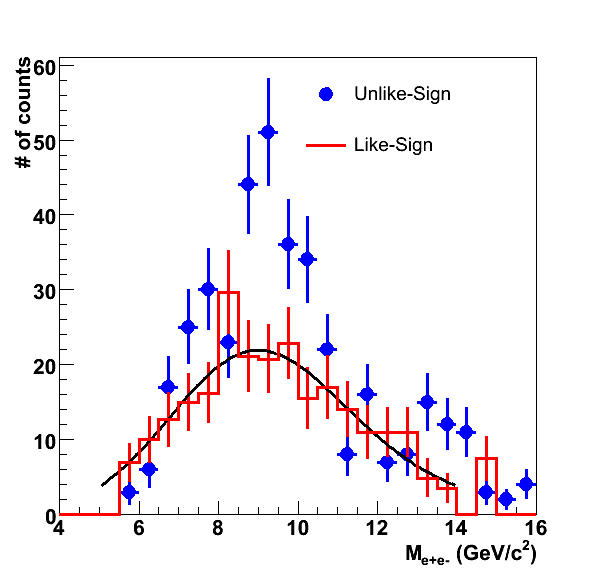
We then need to apply this function to parameterize the turn-on region of the trigger to the b-bbar e+e- invariant mass spectrum. We have one additional piece of information from the efficiency estimation: the overall acceptance * trigger efficiency * tracking efficiency and including additional PID cuts for the Upsilon(12) is 5.4%, we can use this to normalize the function after including the trigger turn-on so that at M=10 GeV/c2 it gives 5.4% of the yield before applying the trigger turn-on. This way we take care of the trigger turn-on shape and the overall normalization given by the acceptance, efficiency, etc. obtained from the upsilon embedding. This assumes that an e+e- pair with invariant mass identical to the upsilon will have identical efficiency and acceptance. Using this, we estimate the yield in the region 8<m<11 including the trigger turn-on and acceptance and efficiency to be 19 counts from b-bbar in the Upsilon mass region in the entire dataset.
For the STAR HF Tune, the cross section is larger and the expected counts are larger:
Code to run Pythia and produce b-bbar -> e+ e- events
// main00.cc
// Modified from the main01.cc
// which is a part of the PYTHIA event generator.
// Copyright (C) 2008 Torbjorn Sjostrand.
// PYTHIA is licenced under the GNU GPL version 2, see COPYING for details.
// Please respect the MCnet Guidelines, see GUIDELINES for details.
// This is a simple test program.
#include "Pythia.h"
#include "TROOT.h"
#include "TFile.h"
#include "TH1.h"
bool isBHadron(int id) {
// This snippet is meant to capture all B hadrons
// as given in the PDG.
if (id<0) id*=-1;
if (id<500) return false;
return (fmod(id/100,5.)==0.0 || id/1000==5);
}
using namespace Pythia8;
int main() {
// Initialize root
TROOT root("Manuel's ROOT Session","PYTHIA Histograms");
// Generator. Process selection. LHC initialization. Histogram.
Pythia pythia;
// Uncomment line below to turns on all HardQCD processses
// These are 111-116 and 121-124
//pythia.readString("HardQCD:all = on");
// Turn on only bbar production:
// g g -> b bbar (subprocess 123)
// q qbar -> b bbar (subprocess 124)
pythia.readString("HardQCD:gg2bbbar = on");
pythia.readString("HardQCD:qqbar2bbbar = on");
pythia.readString("PhaseSpace:pTHatMin = 20.");
// Random number Generator Should be Set Here if needed (before pythia.init())
// On seeds:
// seed = -1 : default (any number < 0 will revert to the default). seed = 19780503
// seed = 0 : calls Stdlib time(0) to provide a seed based on the unix time
// seed = 1 through 900 000 000: various numbers that can be used as seeds
//pythia.readString("Random.setSeed = on");// doesn't work needs fixing
//pythia.readString("Random.seed = 3000000");
pythia.init( 2212, 2212, 200.);
Hist mult("charged multiplicity", 100, -0.5, 799.5);
TH1D* multHist = new TH1D("multHist","Multiplicity",100,-0.5,99.5);
TH1D* bquarkPt = new TH1D("bquarkPt","bquarkPt",100,0,50);
TH1D* bbarquarkPt = new TH1D("bbarquarkPt","bbar quark Pt",100,0,50);
TH1D* B0mesonPt = new TH1D("BOmesonPt","B0mesonPt",100,0,50);
TH1D* B0barmesonPt = new TH1D("BObarmesonPt","B0bar meson Pt",100,0,50);
TH1D* electronFrombPt = new TH1D("electronFrombPt","electrons from b",100,0,30);
TH1D* positronFrombPt = new TH1D("positronFrombPt","positrons from b",100,0,30);
TH1D* epluseminusMinv = new TH1D("epluseminusMinv","e+ e- Inv. Mass",100,0,30);
// Begin event loop. Generate event. Skip if error. List first one.
for (int iEvent = 0; iEvent < 10000; ++iEvent) {
if (!pythia.next()) continue;
if (iEvent < 1) {pythia.info.list(); pythia.event.list();}
// Find number of all final charged particles and fill histogram.
// Find the b (id = 5) and bbar (id = -5), find their daughters,
// if daughters include electron (id = 11) and positron (id=-11), calculate their
// invariant mass
// Status flags:
// 21 incoming particles of hardest subprocess
// 23 outgoing particles of hardest subprocess
// 81-89 primary hadrons produced by hadronization process (B mesons, e.g.)
// 91-99 particles produced in decay process or by B-E effects (e.g. the electrons)
int nCharged = 0;
int indexBQuark(0), indexBbarQuark(0);
for (int i = 0; i < pythia.event.size(); ++i) {
if (pythia.event[i].isFinal() && pythia.event[i].isCharged()) {
++nCharged;
}
Particle& theParticle = pythia.event[i];
if (theParticle.id() == 5 ) {
indexBQuark = i;
//cout << "Mother 1, Mother 2 = " << theParticle.mother1() << ", " << theParticle.mother2() << endl;
}
if (theParticle.id() == -5) {
indexBbarQuark = i;
//cout << "Mother 1, Mother 2 = " << theParticle.mother1() << ", " << theParticle.mother2() << endl;
}
} // particle loop
cout << "Found b quark at index " << indexBQuark << endl;
cout << "Found bbar quark at index " << indexBbarQuark << endl;
bquarkPt->Fill(pythia.event[indexBQuark].pT());
bbarquarkPt->Fill(pythia.event[indexBbarQuark].pT());
mult.fill( nCharged );
multHist->Fill(nCharged);
//cout << "Event " << iEvent << ", Nch= " << nCharged << endl;
//Find hadronization products of b and bbar.
int bQuarkDaughter1 = pythia.event[indexBQuark].daughter1();
int bQuarkDaughter2 = pythia.event[indexBQuark].daughter2();
int bbarQuarkDaughter1 = pythia.event[indexBbarQuark].daughter1();
int bbarQuarkDaughter2 = pythia.event[indexBbarQuark].daughter2();
// Obtain the two hadrons from the fragmentation process
// Use the PDG id's for this. All B mesons id's are of the form xx5xx, and
// all B baryons are of the form 5xxx.
// So we obtain the id, (make it positive if needed) and then test
// to see if it is a meson with fmod(currId/100,5)==0.0
// to see if it is a baryon with currId/1000==5
int HadronFromBQuark(0), HadronFromBbarQuark(0);
if (bQuarkDaughter1<bQuarkDaughter2) {
cout << "Daughters of b Quark" << endl;
for (int j=bQuarkDaughter1; j<=bQuarkDaughter2; ++j) {
if (isBHadron(pythia.event[j].id())) {
cout << "Fragmentation: b -> " << pythia.event[j].name() << endl;
cout << " id " << pythia.event[j].id() << " at index " << j << endl;
HadronFromBQuark = j;
}
}
}
if (bbarQuarkDaughter1<bbarQuarkDaughter2) {
cout << "Daughters of bbar Quark" << endl;
for (int k=bbarQuarkDaughter1; k<=bbarQuarkDaughter2; ++k) {
if (isBHadron(pythia.event[k].id())) {
cout << "Fragmentation : bbar -> " << pythia.event[k].name() << endl;
cout << " id " << pythia.event[k].id() << " at index " << k << endl;
HadronFromBbarQuark = k;
}
}
}
// Search the daughters of the hadrons until electrons and positrons are found
// if there are any from a semileptonic decay of a beauty hadron
// Start with the b quark
int Daughter(HadronFromBQuark), electronIndex(0), positronIndex(0);
while (Daughter!=0) {
cout << "Checking " << pythia.event[Daughter].name() << " for e+/e- daughters" << endl;
if (pythia.event[Daughter].id()==-511) {
// This is a Bbar0, enter its pT
cout << "Filling Bbar0 pT" << endl;
B0barmesonPt->Fill(pythia.event[Daughter].pT());
}
if (pythia.event[Daughter].id()==511) {
// This is a B0, enter its pT
cout << "Filling Bbar0 pT" << endl;
B0mesonPt->Fill(pythia.event[Daughter].pT());
}
int nextDaughter1 = pythia.event[Daughter].daughter1();
int nextDaughter2 = pythia.event[Daughter].daughter2();
// search for electron or positron
for (int iDaughter = nextDaughter1; iDaughter<=nextDaughter2; ++iDaughter) {
if (pythia.event[iDaughter].id()==11) {
cout << "Found electron" << endl;
cout << pythia.event[iDaughter].name() << endl;
electronIndex=iDaughter;
electronFrombPt->Fill(pythia.event[electronIndex].pT());
break;
}
if (pythia.event[iDaughter].id()==-11) {
cout << "Found positron" << endl;
cout << pythia.event[iDaughter].name() << endl;
positronIndex=iDaughter;
positronFrombPt->Fill(pythia.event[positronIndex].pT());
break;
}
}// loop over daughters to check for e+e-
// If we get here, that means there were no electrons nor positrons.
// Set the Daughter index to zero now.
Daughter = 0;
// If any of the daughters is still a beauty-hadron, we can try again
// and reset the Daughter index, but only if one of the daughters contains a
// b quark.
for (int jDaughter = nextDaughter1; jDaughter<=nextDaughter2; ++jDaughter) {
if (isBHadron(pythia.event[jDaughter].id())) {
//One of the daughters is a beauty hadron.
Daughter = jDaughter;
}
}// loop over daughters to check for another b hadron
}// end of search for electrons in all the daughters of the b quark
// Now search among the daughters of the bbar quark
Daughter=HadronFromBbarQuark;
while (Daughter!=0) {
cout << "Checking " << pythia.event[Daughter].name() << " for e+/e- daughters" << endl;
if (pythia.event[Daughter].id()==-511) {
// This is a Bbar0, enter its pT
cout << "Filling Bbar0 pT" << endl;
B0barmesonPt->Fill(pythia.event[Daughter].pT());
}
if (pythia.event[Daughter].id()==511) {
// This is a B0, enter its pT
cout << "Filling B0 pT" << endl;
B0mesonPt->Fill(pythia.event[Daughter].pT());
}
int nextDaughter1 = pythia.event[Daughter].daughter1();
int nextDaughter2 = pythia.event[Daughter].daughter2();
// search for electron or positron
for (int iDaughter = nextDaughter1; iDaughter<=nextDaughter2; ++iDaughter) {
//cout << "daughter is a " << pythia.event[iDaughter].name() << endl;
if (pythia.event[iDaughter].id()==11) {
cout << "Found electron" << endl;
cout << pythia.event[iDaughter].name() << endl;
electronIndex=iDaughter;
electronFrombPt->Fill(pythia.event[electronIndex].pT());
break;
}
if (pythia.event[iDaughter].id()==-11) {
cout << "Found positron" << endl;
cout << pythia.event[iDaughter].name() << endl;
positronIndex=iDaughter;
positronFrombPt->Fill(pythia.event[positronIndex].pT());
break;
}
}// loop over daughters to check for e+e-
// If we get here, that means there were no electrons nor positrons.
// Set the Daughter index to zero now.
Daughter = 0;
// If any of the daughters is still a beauty-hadron, we can try again
// and reset the Daughter index, but only if one of the daughters contains a
// b quark.
for (int jDaughter = nextDaughter1; jDaughter<=nextDaughter2; ++jDaughter) {
if (isBHadron(pythia.event[jDaughter].id())) {
//One of the daughters is a beauty hadron.
Daughter = jDaughter;
}
}// loop over daughters to check for another b hadron
}//end of search for electron among daughters of bbar quark
if (electronIndex!=0 && positronIndex!=0) {
cout << "Found an e+e- pair from bbar" << endl;
cout << "Ele 4-mom = " << pythia.event[electronIndex].p() << endl;
cout << "Pos 4-mom = " << pythia.event[positronIndex].p() << endl;
Vec4 epluseminus(pythia.event[electronIndex].p()+pythia.event[positronIndex].p());
epluseminusMinv->Fill(epluseminus.mCalc());
}
else {
cout << "No e+e- pair in event" << endl;
}
// End of event loop. Statistics. Histogram. Done.
}// event loop
pythia.statistics();
//cout << mult << endl;
//Write Output ROOT hisotgram into ROOT file
TFile* outFile = new TFile("pythiaOutputHistos1M.root","RECREATE");
multHist->Write();
bquarkPt->Write();
bbarquarkPt->Write();
B0mesonPt->Write();
B0barmesonPt->Write();
electronFrombPt->Write();
positronFrombPt->Write();
epluseminusMinv->Write();
outFile->Close();
return 0;
}
Code to run with STAR HF Tune
// main00.cc
// Modified from the main01.cc
// which is a part of the PYTHIA event generator.
// Copyright (C) 2008 Torbjorn Sjostrand.
// PYTHIA is licenced under the GNU GPL version 2, see COPYING for details.
// Please respect the MCnet Guidelines, see GUIDELINES for details.
// This is a simple test program.
#include "Pythia.h"
#include "Basics.h"
#include "TROOT.h"
#include "TFile.h"
#include "TH1.h"
bool isBHadron(int id) {
// This snippet is meant to capture all B hadrons
// as given in the PDG.
if (id<0) id*=-1;
if (id<500) return false;
return (fmod(id/100,5.)==0.0 || id/1000==5);
}
using namespace Pythia8;
double myRapidity(Vec4& p) {
return 0.5*log(p.pPlus()/p.pMinus());
}
int main() {
// Initialize root
TROOT root("Manuel's ROOT Session","PYTHIA Histograms");
// Generator. Process selection. LHC initialization. Histogram.
Pythia pythia;
// Shorthand for some public members of pythia (also static ones).
//Event& event = pythia.event;
ParticleDataTable& pdt = pythia.particleData;
// The cmnd file below contains
// the Pythia Tune parameters
// the processes that are turned on
// and the PDFs used
// for the pythia run.
pythia.readFile("main00.cmnd");
UserHooks *oniumUserHook = new SuppressSmallPT();
pythia.setUserHooksPtr(oniumUserHook);
cout << "Mass of b quark " << ParticleDataTable::mass(5) << endl;
cout << "Mass of b bar " << ParticleDataTable::mass(-5) << endl;
// Extract settings to be used in the main program.
int nEvent = pythia.mode("Main:numberOfEvents");
int nList = pythia.mode("Main:numberToList");
int nShow = pythia.mode("Main:timesToShow");
int nAllowErr = pythia.mode("Main:timesAllowErrors");
bool showCS = pythia.flag("Main:showChangedSettings");
bool showSett = pythia.flag("Main:showAllSettings");
bool showStat = pythia.flag("Main:showAllStatistics");
bool showCPD = pythia.flag("Main:showChangedParticleData");
pythia.init();
if (showSett) pythia.settings.listAll();
if (showCS) pythia.settings.listChanged();
if (showCPD) pdt.listChanged();
Hist mult("charged multiplicity", 100, -0.5, 799.5);
TH1D* multHist = new TH1D("multHist","Multiplicity",100,-0.5,99.5);
TH1D* bquarkPt = new TH1D("bquarkPt","bquarkPt",100,0,50);
TH1D* bbarquarkPt = new TH1D("bbarquarkPt","bbar quark Pt",100,0,50);
TH1D* B0mesonPt = new TH1D("BOmesonPt","B0mesonPt",100,0,50);
TH1D* B0barmesonPt = new TH1D("BObarmesonPt","B0bar meson Pt",100,0,50);
TH1D* BplusmesonPt = new TH1D("BplusmesonPt","BplusmesonPt",100,0,50);
TH1D* BminusmesonPt = new TH1D("BminusmesonPt","Bminus meson Pt",100,0,50);
TH1D* BplusmesonPtCDFrap = new TH1D("BplusmesonPtCDFrap","BplusmesonPt |y|<1",100,0,50);
TH1D* BminusmesonPtCDFrap = new TH1D("BminusmesonPtCDFrap","Bminus meson Pt |y|<1",100,0,50);
TH1D* electronFrombPt = new TH1D("electronFrombPt","electrons from b",100,0,30);
TH1D* positronFrombPt = new TH1D("positronFrombPt","positrons from b",100,0,30);
TH1D* epluseminusMinv = new TH1D("epluseminusMinv","e+ e- Inv. Mass",300,0,30);
TH1D* epluseminusRapidity = new TH1D("epluseminusRapidity","e+ e- y",80,-4,4);
TH1D* epluseminusMinvMidRap = new TH1D("epluseminusMinvMidRap","e+ e- Inv. Mass |y|<0.5",300,0,30);
// Begin event loop. Generate event. Skip if error. List first one.
int nPace = max(1,nEvent/nShow);
int nErrors(0);
for (int iEvent = 0; iEvent < nEvent; ++iEvent) {
if (!pythia.next()) {
++nErrors;
if (nErrors>=nAllowErr) {
cout << "Reached error limit : " << nErrors << endl;
cout << "Bailing out! " << endl;
break;
}
continue;
}
if (iEvent%nPace == 0) cout << " Now begin event " << iEvent << endl;
if (iEvent < nList) {pythia.info.list(); pythia.event.list();}
// Find number of all final charged particles and fill histogram.
// Find the b (id = 5) and bbar (id = -5), find their daughters,
// if daughters include electron (id = 11) and positron (id=-11), calculate their
// invariant mass
// Status flags:
// 21 incoming particles of hardest subprocess
// 23 outgoing particles of hardest subprocess
// 81-89 primary hadrons produced by hadronization process (B mesons, e.g.)
// 91-99 particles produced in decay process or by B-E effects (e.g. the electrons)
int nCharged = 0;
int indexBQuark(0), indexBbarQuark(0);
for (int i = 0; i < pythia.event.size(); ++i) {
if (pythia.event[i].isFinal() && pythia.event[i].isCharged()) {
++nCharged;
}
Particle& theParticle = pythia.event[i];
if (theParticle.id() == 5 ) {
indexBQuark = i;
//cout << "Mother 1, Mother 2 = " << theParticle.mother1() << ", " << theParticle.mother2() << endl;
}
if (theParticle.id() == -5) {
indexBbarQuark = i;
//cout << "Mother 1, Mother 2 = " << theParticle.mother1() << ", " << theParticle.mother2() << endl;
}
} // particle loop
cout << "Found b quark at index " << indexBQuark << endl;
cout << "Found bbar quark at index " << indexBbarQuark << endl;
bquarkPt->Fill(pythia.event[indexBQuark].pT());
bbarquarkPt->Fill(pythia.event[indexBbarQuark].pT());
mult.fill( nCharged );
multHist->Fill(nCharged);
//cout << "Event " << iEvent << ", Nch= " << nCharged << endl;
//Find hadronization products of b and bbar.
int bQuarkDaughter1 = pythia.event[indexBQuark].daughter1();//first daughter index
int bQuarkDaughter2 = pythia.event[indexBQuark].daughter2();//last daughter index
int bbarQuarkDaughter1 = pythia.event[indexBbarQuark].daughter1();
int bbarQuarkDaughter2 = pythia.event[indexBbarQuark].daughter2();
// Obtain the two hadrons from the fragmentation process
// Use the PDG id's for this. All B mesons id's are of the form xx5xx, and
// all B baryons are of the form 5xxx.
// So we obtain the id, (make it positive if needed) and then test
// to see if it is a meson with fmod(currId/100,5)==0.0
// to see if it is a baryon with currId/1000==5
int HadronFromBQuark(0), HadronFromBbarQuark(0);
if (bQuarkDaughter1<bQuarkDaughter2) {
cout << "Daughters of b Quark" << endl;
for (int j=bQuarkDaughter1; j<=bQuarkDaughter2; ++j) {
if (isBHadron(pythia.event[j].id())) {
cout << "Fragmentation: b -> " << pythia.event[j].name() << endl;
cout << " id " << pythia.event[j].id() << " at index " << j << endl;
HadronFromBQuark = j;
}
}
}
if (bbarQuarkDaughter1<bbarQuarkDaughter2) {
cout << "Daughters of bbar Quark" << endl;
for (int k=bbarQuarkDaughter1; k<=bbarQuarkDaughter2; ++k) {
if (isBHadron(pythia.event[k].id())) {
cout << "Fragmentation : bbar -> " << pythia.event[k].name() << endl;
cout << " id " << pythia.event[k].id() << " at index " << k << endl;
HadronFromBbarQuark = k;
}
}
}
// Search the daughters of the hadrons until electrons and positrons are found
// if there are any from a semileptonic decay of a beauty hadron
// Start with the b quark, the b-bar quark loop comes after this
int Daughter(HadronFromBQuark), electronIndex(0), positronIndex(0);
while (Daughter!=0) {
cout << "Checking " << pythia.event[Daughter].name() << " for e+/e- daughters" << endl;
if (pythia.event[Daughter].id()==-511) {
// This is a Bbar0, enter its pT
cout << "Filling Bbar0 pT" << endl;
B0barmesonPt->Fill(pythia.event[Daughter].pT());
}
if (pythia.event[Daughter].id()==511) {
// This is a B0, enter its pT
cout << "Filling Bbar0 pT" << endl;
B0mesonPt->Fill(pythia.event[Daughter].pT());
}
Vec4 daughterVec4 = pythia.event[Daughter].p();
double daughterRap = myRapidity(daughterVec4);
if (pythia.event[Daughter].id()==-521) {
// This is a Bminus, enter its pT
cout << "Filling Bminus pT" << endl;
BminusmesonPt->Fill(pythia.event[Daughter].pT());
if (fabs(daughterRap)<1.0) {
BminusmesonPtCDFrap->Fill(pythia.event[Daughter].pT());
}
}
if (pythia.event[Daughter].id()==521) {
// This is a Bplus, enter its pT
cout << "Filling Bplus pT" << endl;
BplusmesonPt->Fill(pythia.event[Daughter].pT());
if (fabs(daughterRap)<1.0) {
BplusmesonPtCDFrap->Fill(pythia.event[Daughter].pT());
}
}
int nextDaughter1 = pythia.event[Daughter].daughter1();
int nextDaughter2 = pythia.event[Daughter].daughter2();
// search for electron or positron
for (int iDaughter = nextDaughter1; iDaughter<=nextDaughter2; ++iDaughter) {
if (pythia.event[iDaughter].id()==11) {
cout << "Found electron" << endl;
cout << pythia.event[iDaughter].name() << endl;
electronIndex=iDaughter;
electronFrombPt->Fill(pythia.event[electronIndex].pT());
break;
}
if (pythia.event[iDaughter].id()==-11) {
cout << "Found positron" << endl;
cout << pythia.event[iDaughter].name() << endl;
positronIndex=iDaughter;
positronFrombPt->Fill(pythia.event[positronIndex].pT());
break;
}
}// loop over daughters to check for e+e-
// If we get here, that means there were no electrons nor positrons.
// Set the Daughter index to zero now.
Daughter = 0;
// If any of the daughters is still a beauty-hadron, we can try again
// and reset the Daughter index, but only if one of the daughters contains a
// b quark.
for (int jDaughter = nextDaughter1; jDaughter<=nextDaughter2; ++jDaughter) {
if (isBHadron(pythia.event[jDaughter].id())) {
//One of the daughters is a beauty hadron.
Daughter = jDaughter;
}
}// loop over daughters to check for another b hadron
}// end of search for electrons in all the daughters of the b quark
// Now search among the daughters of the bbar quark
Daughter=HadronFromBbarQuark;
while (Daughter!=0) {
cout << "Checking " << pythia.event[Daughter].name() << " for e+/e- daughters" << endl;
if (pythia.event[Daughter].id()==-511) {
// This is a Bbar0, enter its pT
cout << "Filling Bbar0 pT" << endl;
B0barmesonPt->Fill(pythia.event[Daughter].pT());
}
if (pythia.event[Daughter].id()==511) {
// This is a B0, enter its pT
cout << "Filling B0 pT" << endl;
B0mesonPt->Fill(pythia.event[Daughter].pT());
}
Vec4 daughterVec4 = pythia.event[Daughter].p();
double daughterRap = myRapidity(daughterVec4);
if (pythia.event[Daughter].id()==-521) {
// This is a Bminus, enter its pT
cout << "Filling Bminus pT" << endl;
BminusmesonPt->Fill(pythia.event[Daughter].pT());
if (fabs(daughterRap)<1.0) {
BminusmesonPtCDFrap->Fill(pythia.event[Daughter].pT());
}
}
if (pythia.event[Daughter].id()==521) {
// This is a Bplus, enter its pT
cout << "Filling Bplus pT" << endl;
BplusmesonPt->Fill(pythia.event[Daughter].pT());
if (fabs(daughterRap)<1.0) {
BplusmesonPtCDFrap->Fill(pythia.event[Daughter].pT());
}
}
int nextDaughter1 = pythia.event[Daughter].daughter1();
int nextDaughter2 = pythia.event[Daughter].daughter2();
// search for electron or positron
for (int iDaughter = nextDaughter1; iDaughter<=nextDaughter2; ++iDaughter) {
//cout << "daughter is a " << pythia.event[iDaughter].name() << endl;
if (pythia.event[iDaughter].id()==11) {
cout << "Found electron" << endl;
cout << pythia.event[iDaughter].name() << endl;
electronIndex=iDaughter;
electronFrombPt->Fill(pythia.event[electronIndex].pT());
break;
}
if (pythia.event[iDaughter].id()==-11) {
cout << "Found positron" << endl;
cout << pythia.event[iDaughter].name() << endl;
positronIndex=iDaughter;
positronFrombPt->Fill(pythia.event[positronIndex].pT());
break;
}
}// loop over daughters to check for e+e-
// If we get here, that means there were no electrons nor positrons.
// Set the Daughter index to zero now.
Daughter = 0;
// If any of the daughters is still a beauty-hadron, we can try again
// and reset the Daughter index, but only if one of the daughters contains a
// b quark.
for (int jDaughter = nextDaughter1; jDaughter<=nextDaughter2; ++jDaughter) {
if (isBHadron(pythia.event[jDaughter].id())) {
//One of the daughters is a beauty hadron.
Daughter = jDaughter;
}
}// loop over daughters to check for another b hadron
}//end of search for electron among daughters of bbar quark
if (electronIndex!=0 && positronIndex!=0) {
cout << "Found an e+e- pair from bbar" << endl;
cout << "Ele 4-mom = " << pythia.event[electronIndex].p() << endl;
cout << "Pos 4-mom = " << pythia.event[positronIndex].p() << endl;
Vec4 epluseminus(pythia.event[electronIndex].p()+pythia.event[positronIndex].p());
epluseminusMinv->Fill(epluseminus.mCalc());
double epluseminusRap = 0.5*log((epluseminus.e()+epluseminus.pz())/(epluseminus.e()-epluseminus.pz()));
epluseminusRapidity->Fill(epluseminusRap);
if (fabs(epluseminusRap)<0.5) epluseminusMinvMidRap->Fill(epluseminus.mCalc());
}
else {
cout << "No e+e- pair in event" << endl;
}
// End of event loop. Statistics. Histogram. Done.
}// event loop
if (showStat) pythia.statistics();
//cout << mult << endl;
//Write Output ROOT hisotgram into ROOT file
TFile* outFile = new TFile("pythiaOutputHistosTest.root","RECREATE");
multHist->Write();
bquarkPt->Write();
bbarquarkPt->Write();
B0mesonPt->Write();
B0barmesonPt->Write();
BplusmesonPt->Write();
BminusmesonPt->Write();
BplusmesonPtCDFrap->Write();
BminusmesonPtCDFrap->Write();
electronFrombPt->Write();
positronFrombPt->Write();
epluseminusMinv->Write();
epluseminusRapidity->Write();
epluseminusMinvMidRap->Write();
outFile->Close();
return 0;
}
Varying the Continuum Contribution to the Dielectron Mass Spectrum
Initial Normalization
The normalization to the Drell-Yan and b-bbar cross sections are given by the calculation from Ramona in the Drell-Yan case and by Pythia in the b-bbar case. There is an uncertainty in the overall normalization of the contribution from these two sources to the dielectron continuum under the Upsilon peak. We can do a fit to obtain the Upsilon yield with the normalization fixed. This is shown below.
Fig. 1: Fit to the invariant mass spectrum. The data points are in blue. The Drell-Yan curve is the dot-dashed line and the b-bbar is the dashed line. The Red line is the sum of the Upsilon line shape (obtained from embedding for the 1S+2S+3S keeping their ratios according to the PDG values) plus the continuum contribution from DY+b-bbar. The red histogram is the integral of the red line, which is what is used to compare to the data in the fit (we fit using the "i" option to use the integral of the function in each bin).
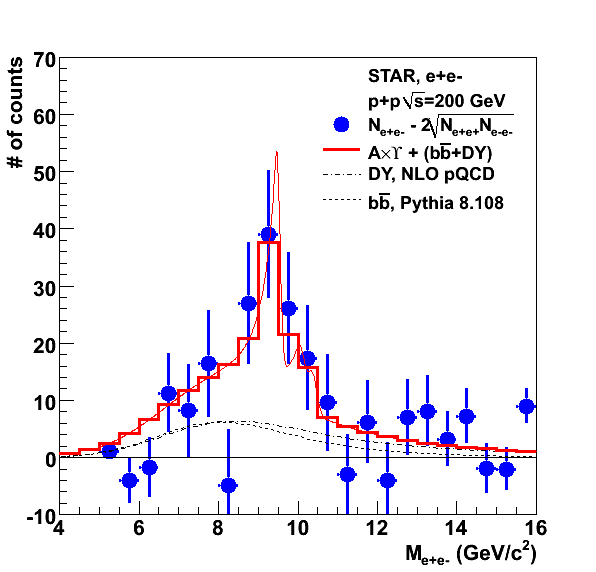
With the above fit, we obtain 64.3 counts after integrating the upsilon part (the yield of DY is 32.3 and the yield of b-bbar is 26.8, both are held fixed for the fit). This gives a cross section of 63.4/(1*0.054*9.6 pb-1) = 124 pb. The efficiency estimate of 5.4% for the overall efficiency is still being checked though, given the E/p shape not being gaussian due to the trigger bias near the L0 threshold, so this can still change.
It is also possible to let the yield of the continuum vary and study if the chisquare/dof of the fit improves. That way, we can not just assume a continuum yield, but actually measure it. Since the yields of the DY and the b-bbar are very similar and given our statistics we can't really discriminate one from the other, we are mainly sensitive to the sum. One way to study this is to keep their ratios fixed as in the plot above, but vary the overall yield of both of them This adds one extra parameter to the fit to account for the total sum of the continuum yield. We perform the fit in the region 5< m < 16 GeV/c2.
One issue is that the Crystal-Ball fit is a user defined function, and we use the integral of the function to fit, which seems to push ROOT to its limit in an interactive session with a macro interpreted on the fly. This is alleviated somewhat by cleaning up the code to do the one-parameter fit in a compiled macro. However, trying out the two-parameter fit directly seems to be too much for ROOT even in compiled mode and the code runs out of memory and seg-faults. A (rather inelegant) way around this is to scale the continuum yield by hand, compile the macro each time and do the one-parameter fit. For each of those fits, one can obtain the chisquare/deg. of freedom. This is shown in the plot below:
Fig. 2. Chisquare per degree of freedom as a function of the continuum yield (Drell-Yan + b-bbar).
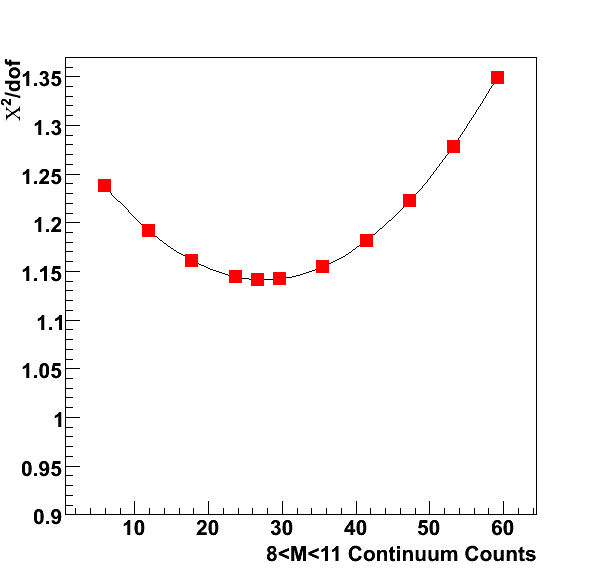
We find a clear minimum, indicating that our data do have some sensitivity to the continuum yield. The Rightmost point with 59.1 counts is the yield obtained directly from Pythia 8.108 and from Ramona's calculation. Our data indicate that the yield is likely smaller by about a factor of 2, we obtain at the minimum a yield of 26.6 counts. Since the yield of Upsilons is obtained from the same fit, our fitted Upsilon yield will increase with decreasing counts from the continuum. This is shown below.
Fig. 3: Fitted yield of Upsilons for a given continuum yield. The minimum found above is illustrated by the vertical line.
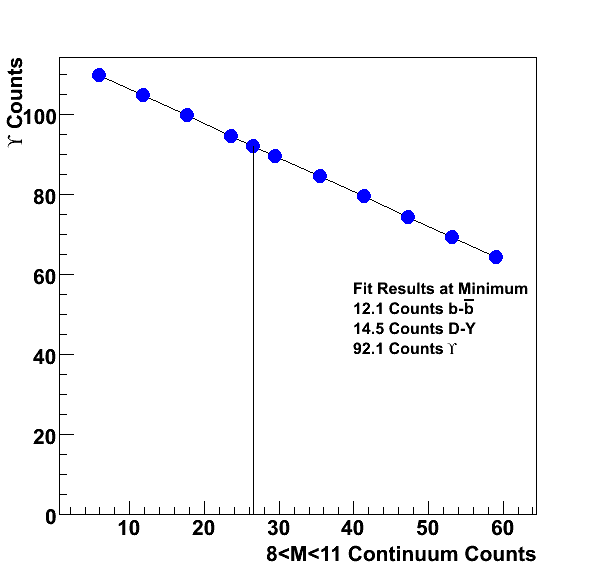
The corresponding plot with the fit at the minimum is shown below.
Fig. 4: Dielectron data with the curves for the DY and b-bbar at the yield which minimizes the chi-square. In other words, the result of a (poor man's) two-parameter fit to find both the Upsilon yield and the Continuum yield.
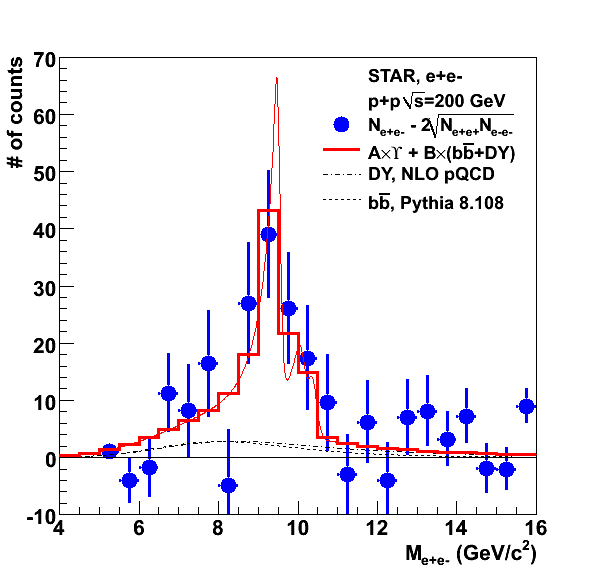
The results of this fit give 14.5 counts for DY and 12.1 counts for b-bbar, i.e a factor 0.45 lower than the 32.3 counts for DY and the 26.8 counts for b-bbar is 26.8 obtained before. Ramona's calculation for dsigma/dm |y|<1 gave 5.25 nb and the Pythia cross section b-bbar cross section times the BR into e+e- gives 6.5 nb, so our data indicate that we can decrease these by a factor 0.45 (or decrease one by essentially 100% and leave the other one unchanged). The Upsilon yield in this case increases to 92.1 counts, which gives a cross section of 92.1/(1*0.054*9.6) = 178 pb. So this has a large effect on the yield (92.1-64.338)/92.1 = 0.3, i.e. a 30% change in the yield (and hence in the cross section). Note also that 178 pb is quite larger than our first estimate for the cross section. This highlights the importance of getting the efficiency estimates right.
WWW
Heavy Flavor Lepton
Heavy flavor leptons provide an extra handle on the open heavy flavor mesons, since they come from semi-leptonic decays of D and B mesons with significant branching ratios. Once produced, leptons do not participate in the strong interaction in the later stages of the collision, and remain a clean probe into the whole evolution of the system. Apart from TPC and TOF, BEMC is used to improve electron identification, and MTD is used for muon detection.
Heavy flavor muons
Non-photonic electrons
Hidden Heavy Flavor
J/psi suppression was one of the proposed QGP signatures in the early days. Later, various cold nuclear matter effects were brought up to complicate the interpretation of J/psi measurements. Still, the study of J/psi collective motion deepens our understanding of the coalescence mechanism and the charm quark collectivity. We also reconstructed Upsilon and observed the suppression of Upsilon(1S+2S+3S).
J/psi
Upsilon
Open Heavy Flavor
More than 99% of charm quarks hadronize into open charm, D mesons. So the measurement of D mesons is a must for the determination of charm cross section. Due to the short life time, the low production rate and the high combinatorial background, the direct reconstruction of D mesons is difficult with the TPC pointing resolution. HFT will be employed to reconstruct the displaced vertex and greatly suppress the combinatorial background. This will also enable the D0 flow analysis, to ascertain the charm quark collectivity. Other open heavy flavor hadrons like Ds and Lambdac will also be studied with HFT.
D mesons
Jet-like correlations
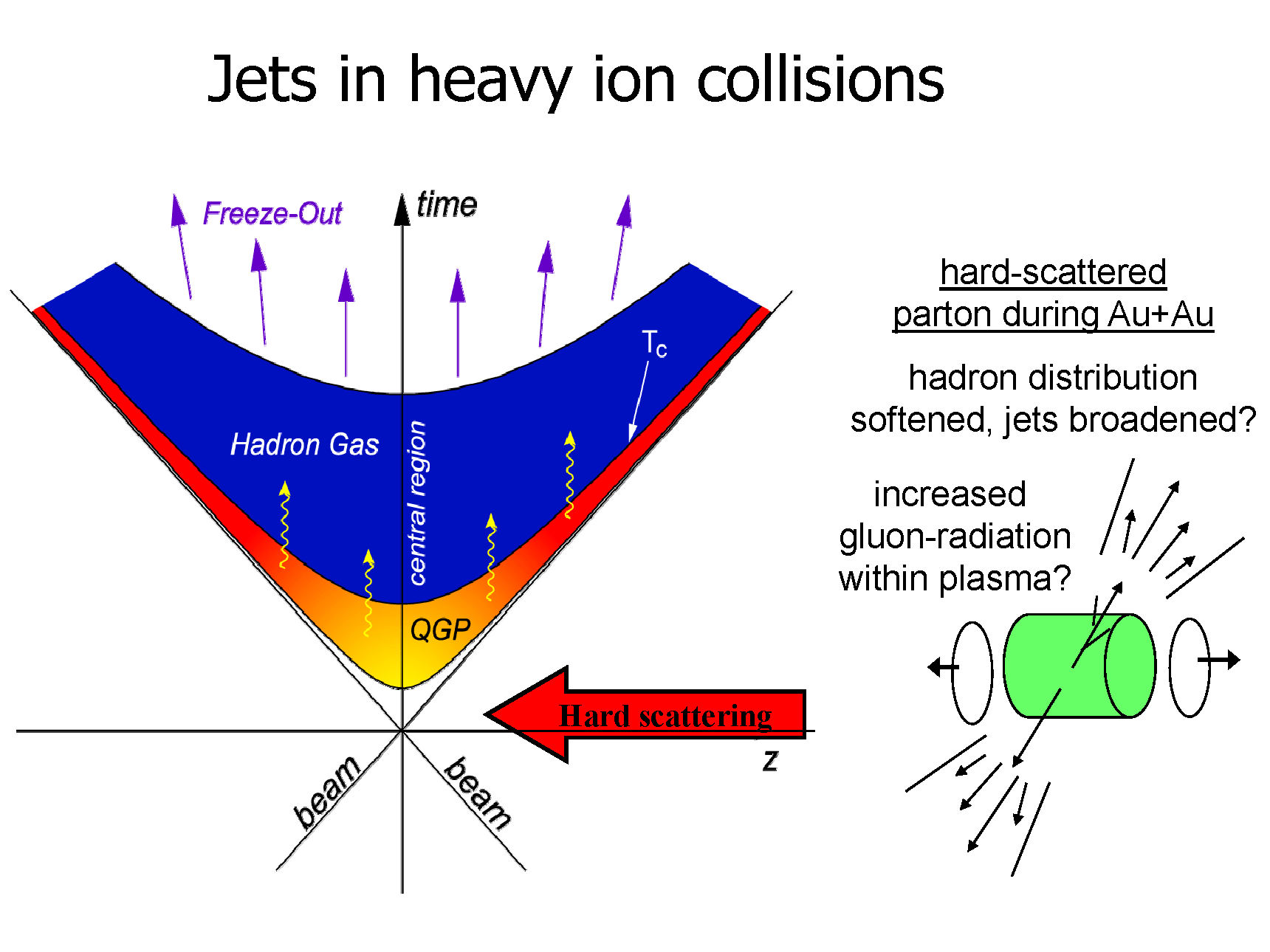
A jet is a spray of hadrons produced by the “hard” scattering of a parton (quark or gluon). A hard scattering is one in which a large amount of energy is transferred between partons.
Event Structure
EStruct Home Page
Welcome to the STAR Event Structure Home Page!
Some of the methods commonly used in EStruct are described in the Tutorials (public). Conference and seminar talks are linked from Talks (public) and publications are found Publications (public). To see our work in progress visit You do not have access to view this node (internal).
Publications
Links to the papers in public
Publications
Two-particle correlations on transverse momentum and minijet dissipation in Au-Au collisions at $\sqrt{s_{NN}} = 130$ GeV
J. Phys. G 34 (2007) 799, and nucl-ex/0408012
The energy dependence of $p_{\rm t}$ angular correlations inferred from mean-$p_{\rm t}$ fluctuation scale dependence in heavy ion collisions at the SPS and RHIC
J. Phys. G 34 (2007) 451, and nucl-ex/0605021
The multiplicity dependence of inclusive pt spectra from p-p collisions at $\sqrt{s}$ = 200 GeV
Phys. Rev. D 74, 032006 (2006), and nucl-ex/0606028
Transverse-momentum pt correlations on momentum subspace (eta,phi) from mean-pt fluct uations in Au-Au collisions at 200 GeV
J. Phys. G 32 (2006) L37, and nucl-ex/0509030
Minijet deformation and charge-independent two-particle correlations on momentum subspace $(\eta,\phi)$ in Au-Au collisions at $\sqrt{s_{NN}}$ = 130 GeV
Phys. Rev. C 73 (2006) 064907, and nucl-ex/0411003
Hadronization geometry and charge-dependent two-particle correlations on momentum subspace ($\eta,\phi$) in Au-Au collisions at $\sqrt{s_{NN}} = 130$ GeV
Phys. Let. B 634 (2006) 347, and nucl-ex/0406035
Event-wise
Phys. Rev. C 71 (2005) 064906, and nucl-ex/0308033
Transverse-momentum dependent modification of dynamic texture in central Au+Au collisions at sqrt(sNN ) = 200 GeV
Phys. Rev. C 71 (2005) 031901(R), and nucl-ex/0407001
From ES PWG Group members
Publications
Azimuth quadrupole component spectra on transverse rapidity y[sub t] for identified hadrons from Au-Au collisions at sqrt(s[sub NN]) = 200 GeV by T. A. Trainor
Phys. Rev. C 78, 064908 (2008)
Autocorrelations from fluctuation scale dependence by inversion by T. A. Trainor, R. J. Porter and D. J . Prindle
J. Phys. G 31 809-824, and hep-ph/0410182
Transverse-momentum $p_t$ correlations from mean-$p_{t}$ fluctuation scale dependence in Hijing-1.37-simulated Au-Au collisions at $\sqrt{s_{NN}} = $ 200 GeV by Qingjun Liu, Duncan J. Prindle, Thomas A. Trainor
Phys. Let. B 632 197, and hep-ph/0410180
Extrapolating parton fragmentation to low $Q^2$ in $e^+$-$e^-$ collisions by T. A. Trainor and D. Kettler
Phys. Rev. D 74, 034012 (2006), and hep-ph/0606249
Proceedings
Low-Q^2 partons in p-p and Au-Au collisions at XXXV International Symposium on Multiparticle Dynamics 2005 (ISMD2005) by T. A. Trainor
Transverse momentum correlations in relativistic nuclear collisions invited talk at Correlations and Fluctuations in Relativistic Nuclear Collisions Workshop (MIT, 2005) by T. A. Trainor
Probing the bulk medium in relativistic heavy ion collisions using two-particle correlations invited talk at Correlations and Fluctuations in Relativistic Nuclear Collisions Workshop (MIT, 2005) by R. L. Ray
The equivalence of fluctuation scale dependence and autocorrelations invited talk at Correlations and Fluctuations in Relativistic Nuclear Collisions Workshop (MIT, 2005) by D. J. Prindle and T. A. Trainor
Correlations from p-p collisions at sqrt(s) = 200 GeV invited talk at Correlations and Fluctuations in Relativistic Nuclear Collisions Workshop (MIT, 2005) by R. J. Porter and T. A. Trainor
Correlation structure of STAR events plenary talk at the International Conference on Contemporary Issues in Nuclear and Particle Physics (CINPP 2005) by Mikhail Kopytine
Correlations in STAR: interferometry and event structure plenary talk at the 5th International Conference on Physics and Astrophysics of Quark Gluon Plasma (ICPAQGP-2005) by Mikhail Kopytine
"Event Structure at RHIC from p-p to Au-Au," at the 20th Winter Workshop on Nuclear Dynamics (2004) by Tom Trainor (hep-ph/0406116)
"Soft and hard components of two-particle distributions on (yt,eta,phi) from p-p collisions at sqrt(s)=200 GeV" at QM2004 by R.J. Porter, T.A. Trainor
Long range hadron density fluctuations at soft pT in Au+Au collisions at RHIC invited talk at Xth International Wokshop on Multiparticle Production (Correlation and Flucutations in QCD) by Mikhail Kopytine
Correlations, Fluctuations, and Flow Measurements from the STAR Experiment at Quark Matter 2002 by Lanny Ray
Preprints
A power-law description of heavy-ion collision centrality by Thomas A. Trainor and Duncan J. Prindle (hep-p h/0411217)
Extrapolating parton fragmentation to low Q^2 in e+e- collisions by Thomas A. Trainor and David T. Kettler (hep-ph/0606249)
What Does the Balance Function Measure? by Thomas A. Trainor (hep-ph/0301122)
Jet quenching and event-wise mean-pt fluctuations in Au-Au collisions at sqrt-sNN = 200 GeV in Hijing-1.37 by Qingjun Liu, Thomas A. Trainor (hep-ph/0301214)
Event-by-Event Analysis and the Central Limit Theorem by T.A. Trainor (hep-ph/000114)
Pion Lattices in HI Transverse Phase Space and Sudden Traversal of the QCD Phase Boundary by T.A. Trainor (hep-ph/0005176)
Jet Correlations and Scale-Local Measures by T.A. Trainor and J.G. Reid
Probing small length scales in heavy-ion collisions with event-by-event correlation analysis by T.A. Trainor (hep-ph/0004258)
Theses
Talks
Presentations
2009
DNP: Hawaii - Lanny Ray
DPF: Detroit - Chanaka De Silva
Ultra-Relativistic Nucleus-Nucleus Collisions: Knoxville - Duncan Prindle
2008
Tamura Symposium: Austin - Lanny Ray
DNP: Oakland - Duncan Prindle
DNP: Oakland - Lanny Ray
Workshop for young scientists: Ultra-Relativistic Nucleus-nucleus collisions: Estes Park, CO - David Kettler
Users meeting: Upton, NY - Tom Trainor
Winter Workshop: South Padre, TX - Lanny Ray
QM08: Jaipur, India - Michael Daugherity
General in 2006
Spring APS Meeting - Lanny Ray (ppt)
Spring APS Meeting - Michael Daugherity (ppt)
Quark Matter 05
Bulk-medium Properties in Relativistic Nuclear Collision - Duncan Prindle
Dissipation and Fragmentation of Low-Q^2 scattered partons at RHIC - Lanny Ray (ppt)
Two-particle Correlations from p-p Collisions at 200 GeV - Tom Trainor
General in 2005
ISMD 2005 - Tom Trainor
MIT Workshop on Correlations and Fluctuations - Jeff Porter
MIT Workshop - Duncan Prindle
MIT Workshop - Lanny Ray (ppt)
MIT Workshop - Tom Trainor
RHIC-AGS User's Meeting, June 2005 - Lanny Ray
RHIC-AGS User's Meeting, June 2005 - Tom Trainor
DNP meeting 04, Chicago
General in 2004
Physics colloquium at Rice U. - Lanny Ray (Oct)
Nuclear physics seminar at BNL - Mikhail Kopytine (Sept)
ISMD 2004 - Jeff Porter
GSI Workshop, Skopelos, Greece - Tom Trainor
RHIC-AGS User's Meeting, May 2004 - Tom Trainor
20th Winter Workshop on Nuclear Dynamics, Jamaica, - Tom Trainor
DNP meeting 04, Chicago
General in 2004
Physics colloquium at Rice U. - Lanny Ray (Oct)
Nuclear physics seminar at BNL - Mikhail Kopytine (Sept)
ISMD 2004 - Jeff Porter
GSI Workshop, Skopelos, Greece - Tom Trainor
RHIC-AGS User's Meeting, May 2004 - Tom Trainor
20th Winter Workshop on Nuclear Dynamics, Jamaica, - Tom Trainor
Quark Matter 04
DNP meeting 03, Tucson
General in 03
Tutorials
Event Structure Tutorials
| Tutorial | Title | Files |
| Tutorial 1 |
Understanding charge independent correlations on eta1-eta2 versus phi1-phi2 for proton-proton di-jet events | ppt | pdf |
| Tutorial 2 |
Measuring Histograms of the Number of Pairs of Particles, Constructing Ratios of Histograms, and the relationship to Correlations – Part 1 | ppt | pdf |
| Tutorial 3 |
Measuring Histograms of the Number of Pairs of Particles, Constructing Ratios of Histograms, and the relationship to Correlations – Part 2 | ppt | pdf |
| Tutorial 4 |
Relating Fluctuations and Correlations – Part 1 | ppt | pdf |
HI jet finding
The Heavy Ion jet finding is a cross PWG discusison group and relates to the jet-like correlation PWG.
Updates can be found at the wiki-pages: http://rnc.lbl.gov/wiki/index.php/STAR_Jet_Reconstruction_in_Heavy_Ion_Collisions
This activity group is lead by Joern Putschke.
High pT
For further details see the protected area: www.star.bnl.gov/protected/jetcorr/
JetCorr Data QA
The contents of this page include dataset QA and run and tower selections and corresponding discussions shared by JetCorr PWG.
Data-
- Run6 pp
- Bad Run list
- Bad Tower list
- Run7 AuAu (dataset QA plots will be linked here in the near future)
- Bad Run list
- Bad Tower list
- Run11 AuAu (dataset QA plots will be linked here in the near future)
- Bad Run list
- Bad Tower list
- Run12 pp P12id (dataset QA plots will be linked here in the near future)
- Run14 AuAu P18ih
- Run15 pAu P16id (dataset QA link will be linked here in the near future)
- Run list (to be added)
- Tower list
Simulations and Embedding -
Tracking Efficiencies -
Run14 AuAu /star/u/elayavalli/WORK/ANALYSIS/Run14TrackingEfficiency/Run14_AuAu_200_tracking_efficiency_and_momentum_smearing_dca_3p0(1p0, 2p0)_nhit_20(15)_nhitfrac_0p52.root
The histograms you need are
hTrack_(species - pion, kaon, proton)_Efficiency_pTEta_final_centbin#_lumibin# where centbin goes from 0 - 0-5% to 15 - 75-80% and lumibin 0 - 0-10kHz and 9 - 90-100kHz - they are averaged for particle/anti-particle.
there are also track resolution histograms appropriately named for each species
the plot_eff.C macro produces these files and also draw some plots so you can also look at the naming there as well.
Run14 AuAu P18ih
- In P18ih, the tracking issues reported in previous productions (P17id, P18if) of Run14 Au+Au data are fixed. The corresponding discussions can be found in Daniel Nemes's presentation on 3 May, 2019 (link).
- Primary tracks in this production (P18ih) were reconstructed without HFT hits, while P16id production included HFT hits for the primary track reconstruction.
- Run14 AuAu P18ih run list
- Run14 AuAu P18ih tower list
Other Groups
Focus groups, special topics or activity groups are NOT Physics Working Group (PWG) and hence, do not have publications or paper authorities.
Many of those topics are however of general interrest for a few PWG. The relation between activity groups and the respective PWG will be documented here as groups are created.
- The moments & fluctuations focus group is related to the You do not have access to view this node PWG
- HI jet finding is beleived to belong to the You do not have access to view this node PWG
- You do not have access to view this node is a cross activity group between the Spin PWG and the Jet-like correlations PWG
- Event by Event was a PWG until 2008 and now a focus group part of the You do not have access to view this node PWG
- Parity violation was a branch of the Event by Event and hence belong to the You do not have access to view this node PWG
- Parity violation was a branch of the Event by Event and hence belong to the You do not have access to view this node PWG
- Event Structure was a PWG until 2008 and now a focus group part of the Jet-like correlations PWG
- High pT was a PWG until 2008 and now a focus group part of the Jet-like correlations PWG
- Spectra was a PWG until 2008 and now fully merged into the You do not have access to view this node PWG
- Strangeness was a PWG until 2008 and now an activity part of the You do not have access to view this node PWG
- You do not have access to view this node was a PWG until 2008 and now an activity part of the You do not have access to view this node PWG
Parity violation
STAR search for local strong parity violation in heavy ion collisions
Group members:
- Wayne State U.
Sergei Voloshin (bulkcorr/ebye) - Indiana U.
Ilya Selyuzhenkov (drupal) - BNL
Vasily Dzordzhadze (wasikos)
Ron Longacre
Yannis Semertzidis
Paul Sorensen - UCLA
Dhevan Gangadharan (bulkcorr)
Gang Wang (bulkcorr) - Yale U.
Jack Sandweiss
Evan Finch (bulkcorr)
Alexey Chikanian
Richard Majka - LBNL
Jim Thomas (jhthomas) - MEPhI
Vitaly Okorokov
Parity group meetings
2010 meetings
September 22, 14:00-15:30 EST: EVO meeting information
- Some New Y7 Parity Results (Dhevan Gangadharan)
- Paper draft on charge separation (Dhevan Gangadharan)
- A Simple Simulation for Local Parity Violation Study (Gang Wang)
- Parity signal from Au+Au 39 GeV collisions (Gang Wang)
- Testing chiral magnetic effect with central U+U collisions (Sergei Voloshin)
- STAR Decadal Plan document on Local Parity Violation
- AOB
2009 meetings
September 24, 14:00-15:30 EST; 510-486-7720
- PRL paper updates: PRL:v15
- Referee reports
- Response
- New Figure: All versions (latest Jim's and Ilya's).
- ZDC-SMD vs. TPC comparison (Gang Wang)
- DPF 2009 proceedings (Ilya Selyuzhenkov)
- AOB?
September 10, 14:00-15:30 EST; 510-486-7720
- Update on ZDC-SMD study (Gang Wang)
- FYI: Submitted parity papers
- AOB?
September 03, 14:00-15:30 EST; 510-486-7720
- Paper drafts: PRL:v12, PRC:v30
Collaboration comments: - FYI: Paper proposal on Excess charge correlations ... (Quan Wang, Fuqiang Wang)
- AOB?
August 13, 14:00-15:30 EST; 510-486-7720
- Paper drafts: PRL:v10, PRC:v28
- Analysis updates:
- Parity violation with ZDC-SMDs (Gang Wang)
(previous post: Jul-30-2009) - Magnetic Field effect on events in HI collisions (Alexei Chikanian)
(previous link: 2009_07_30.ppt)
- Parity violation with ZDC-SMDs (Gang Wang)
- FYI: CPOD proceedings (Evan Finch)
- AOB?
July 23, 14:00-15:30 EST; 631-344-2261
- PRL paper draft Version 10 (updated)
Reply to the Institution comments - Thoughts on future... (Jack Sandweiss, All)
- FYI: updated DPF2009 presentation (Ilya Selyuzhenkov)
- AOB?
July 16, 14:00-15:30 EST; 631-344-2261
- PRL paper draft Version 10
Reply to the Institution comments - PRC paper draft:
Comments by Fuqiang Wang
Jack's e-mail - Azimuthal correlations as a probe for local P-violation in HIC (Ilya Selyuzhenkov)
- Analysis updates:
- Study of a neutralization method (Ron Longacre)
- Feedback from the STAR analysis meeting at MIT:
list of parity talks - AOB?
June 18, 14:00-15:30 EST; 631-344-2261
- PRC paper draft Version 27
Reply to the Collaboration comments - PRL paper draft Version 8
- Analysis updates:
- HIJING in larger acceptance range, parityv-220 (Evan Finch/Alexei Chikanian)
- Results from Au+Au at 200 GeV: 2007 vs 2004 data (Alexei Chikanian)
- Feedback from CPOD workshop:
- STAR Results on Local Strong P/CP violation at RHIC (Evan Finch)
- AOB?
June 04, 14:00-15:30 EST; 631-344-2261
- PRC paper draft Version 27
- PRL paper draft Version 7
Updated Figure 3: <cos(a-b)> correlations - Analysis updates:
- Delta Q projections (Dhevan Gangadharan)
- CPOD workshop:
- STAR Results on Local Strong P/CP violation at RHIC (Evan Finch)
Comments bulkcorr-332 (by Peter Filip)
Question on Quark mass dependence (by Ahmed Hamed)
- STAR Results on Local Strong P/CP violation at RHIC (Evan Finch)
- (FYI) Talks given at RHIC & AGS user meeting:
- STAR Results on Charge Separation Measurements (Jim Thomas)
- Monte-Carlo Studies Related to Charge Separation Measurements (Evan Finch)
- AOB?
May 28, 14:00-15:30 EST; 631-344-2261
- PRC paper draft Version 26
Updates/Collaboration comments:
- PRL (short) paper draft Version 5
- Analysis updates:
- Connection between 3-particle correlator and DeltaQ widths (Dhevan Gangadharan)
- Increasing acceptance for HIJING (Alexei Chikanian)
- Upcoming talks at RHIC&AGS user meeting and CPOD workshop:
- CPOD talk (Evan Finch)
- AGS talk (Jim Thomas)
- AOB?
May 21, 14:00-15:30 EST; 631-344-2261
- PRC paper draft Version 26
Collaboration comments:
- Lanny Ray (reply by Evan Finch)
- Fuqiang Wang (reply by Ilya Selyuzhenkov)
- PRL (short) paper draft Version 3
- Analysis updates:
- Comparison of < cos(phi_a-phi_b) > with simulated results (Sergei Voloshin)
- Regions of Strongest Charge Separation (Dhevan Gangadharan)
- Parity violation in HIC: correlators at 62.4 and 200 GeV (Vitaly Okorokov)
- (FYI) Updates for paper proposal on
Excess correlation of charge asymmetry (Fuqiang Wang, Quan Wang)- Presentation at Conveners meeting
- Paper proposal discussions: jetcorr and bulkcorr lists
- Relating Fuqiang to Sergei’s observable (Paul Sorensen)
discussions at bulkcorr-315 and bulkcorr-317 list
- AOB?
May 14, 14:00-15:30 EST; 631-344-8261
- PRC paper draft Version 26
Released for the Collaboration review.
Five STAR institutes assigned to read the manuscript:- BNL (Jerome Lauret)
- Panjab University (Madan Aggarwal)
- Dubna (Richard Lednicky)
- Argonne (Hal Spinka)
- UIC (Russell Betts)
- PRL (short) paper draft Version 2
- Support document Version 19
- Analysis updates:
- 45 degree axis neutralization (Dhevan Gangadharan)
- Addition to the 2004 Au+Au & 2005 Cu+Cu analysis (Alexei Chikanian)
- Correlators: experiment vs theory (Vitaly Okorokov)
Presentations: 05.08.2009, 03.20.2009, and 02.20.2009
- FYI (has been already presented for jetcorr/bulkcorr PWG):
- Paper proposal on
Excess correlation of charge asymmetry (Fuqiang Wang, Quan Wang)
Discussions: jetcorr and bulkcorr - Clusters and up-down/left-right pv-asymmetry (Fuqiang Wang, Quan Wang)
- Paper proposal on
- AOB?
April 30, 14:00-15:30 EST; 631-344-2261
- PRC paper draft Version 25
Comments: - Analysis updates:
- Event mixing and Neutralization concerns (Dhevan Gangadharan)
- FYI:
- Simulation status update at bulkcorr PWG on April 29 (Evan Finch)
- Needed STAR speaker to report on P-violation results at Critical Point workshop
- AOB?
April 23, 14:00-15:30 EST; 631-344-2261
- PRC paper draft Version 24
Comments: - WWND2009 proceedings (Dhevan Gangadharan)
- Analysis updates:
- MC forced parity-odd signal and then Neutralized (Dhevan Gangadharan)
- HIJING with different input v2 (Alexei Chikanian)
- In/out-of-plane jets in HIJING (Ron Longacre)
- UrQMD 3-particle results (Evan Finch)
- HIJING, UrQMD results for Au+Au at 200 and 62GeV vs. Nch (Sergei Voloshin)
- Discussions:
- AOB?
April 16, 14:00-15:30 EST; 631-344-2261
- PRC paper draft Version 23 (no update yet)
- New paper figure: signal vs. delta pt
- Naming convention: Spontaneous vs. local
- Order for the section on systematics study (Vitaly Okorokov)
- Analysis updates:
- HIJING 1/N_ch^2 scaling: Au+Au and Cu+Cu results (Evan/Sergei/Alexei)
- MC forced parity-odd signal and then Neutralized (Dhevan Gangadharan)
- HIJING with different input v2 (Alexei Chikanian)
- In/out-of-plane jets in HIJING (Ron Longacre)
- AOB?
April 9, 14:00-15:30 EST; 631-344-2261
- PRC paper draft Version 23
- Reorganizing the paper flow to fit with new systematic uncertainties (Sergei Voloshin)
- Support document Version 18
- Todo: include plots for the signal vs. pt_a-pt_b, eta_a+eta_b
- Analysis updates:
- Neutralization procedure (Dhevan Gangadharan)
- 3-particle correlations from HIJING: Au+Au and Cu+Cu results (Evan Finch)
- Parity like signal in HIJING, see also hyper-news post 181-1 (Alexei Chikanian)
- Speaker candidate for RHIC/AGS Workshop on "Parity Violation in QGP" (June 1st).
- Paper status and Critical Point and Onset of Deconfinement (CPOD) workshop (Paul Sorensen)
- FYI: QM2009 talks and posters (final versions):
- Plenary talk (Sergei Voloshin)
- Poster 1 (Evan Finch)
- Poster 2 (Ilya Selyuzhenkov)
- AOB?
March 19, 14:00-15:30 EST; 631-344-8261
- PRC paper draft Version 23
Comments: - Support document Version 17
Comments by Evan Finch - QM2009 talks and posters:
- Plenary talk (abstract, Sergei Voloshin)
- Poster 1 (abstract, Evan Finch)
- Poster 2 (abstract, Ilya Selyuzhenkov)
- Parity highlight slides (Gang Wang)
Comments by Ilya Selyuzhenkov
- The STAR Collaboration Meeting:
Parity presentations at bulkcorr parallel session (Wednesday, 25 March 2009; 09:00 - 12:30) - Analysis updates:
- A Study of Conical Regions, and Update on Multiplicity Fluctuations (Dhevan Gangadharan)
- The 3-particle correlator for HIJING (Evan Finch)
- v2 parent vs daughter (Alexei Chikanian)
- Improved results and writeup on cluster model, discussion at parity-hn:169 (Fuqiang Wang)
- AOB?
March 12, 14:00-15:30 EST; 631-344-2261
- PRC paper draft Version 22
Comments: - PRL paper draft Version 1
Comments from Lanny Ray - Support document: Any updates need to be done? (latest Version 15)
- QM2009 talk and posters:
Plenary talk (Sergei Voloshin)
Poster 1 [in preparation], Abstract 1 (Evan Finch)
Poster 2, Abstract 2 (Ilya Selyuzhenkov) - Analysis updates:
- Multiplicity Fluctuations (Dhevan Gangadharan)
- Pi/K decay losses in TPC (Vasily Dzordzhadze)
- Analytical estimates of PV-signal from cluster model, discussion at parity-hn:147 (Fuqiang Wang)
- v2 at the minijet level in HIJING (Evan Finch / Alexei Chikanian)
- AOB?
March 5, 14:00-15:30 EST; 631-344-2261
- PRC paper draft Version 20 (21tmp)
Comments: Note: PRC/PRL links has been added to paper proposal page at drupal - PRL paper draft Version 1
- Feedback from the GPC meeting on February 26, 2009
- Analysis updates:
- uRQMD for Cu+Cu 200GeV (Evan Finch)
- Cluster model study: ppt or pdf (Fuqiang Wang)
- MEVSIM simulations vs. Au+Au 200GeVd data: eta and phi distributions (Vasily Dzordzhadze)
- Other issues:
- Any updates need to be done for support document?
- FYI: Sergei will be giving a seminar at BNL on parity violation (March 26, 2009)
Change dates for Sergei's QM2009-practice talks at the Collaboration meeting? - QM talk and posters
February 26, 14:00-15:30 EST; 631-344-2261
- Paper draft Version 18
- New introduction and v16 [Yale edits] (Jack Sandweiss/Evan Finch)
- Comments on the paper draft:
parity-hn posts 137 and 136 (Ilya Selyuzhenkov)
Summary statement (Evan Finch)
Editorial pass (Jim Thomas) - Plotting results vs. "decreasing" centrality (Sergei Voloshin)
- PRL draft (initial version), and PRL thoughts (Evan Finch)
- Feedback from the GPC meeting on February 19, 2009
- Analysis updates:
- 1/N centrality dependence: data vs. simulations (Alexei Chikanian)
- Simulating parity violating effects in a cluster model (Fuqiang Wang/Quan Wang)
"Per event" summary table
parityv-hn discussion: 181 - Magnetic field increase at small energies (Vitaly Okorokov)
parityv-hn discussion: 130
Alexei's sensitivity plot - Event plane recentering (Vasily Dzordzhadze)
X vs. Y plots, X-Y mean values, EP angle plots
- Other issues:
- Any updates needs to be done for support document?
- FYI: Sergei will be giving a seminar at BNL on parity violation (March 26, 2009)
Change dates for Sergei's QM2009-practice talks at the Collaboration meeting?
February 19, 14:00-15:30 EST; 631-344-2261
- Paper draft Version 16
Note: paper proposal page at drupal has been updated - Support document Version 15
- Feedback from GPC meeting (February 12, 2009):
GPC comments (summarized by Jack Sandweiss and Sergei Voloshin) - Status of the PRL (short) paper draft?
- Analysis updates:
- more MEVSIm: Results 2, Results 3, parityv-hn posts: 129, 127 (Evan Finch)
- cos(phi1-phi2) comparison (Sergei Voloshin/Alexei Chikanian)
- Sensitivity for Au+Au (Alexei Chikanian)
- FTPC vs TPC results (Sergei Voloshin)
- HIJING in 60-70% bin (b=12.3fm) (Evan Finch)
- Event plane distribution for different centrality bins (Vasily Dzordzhadze)
- Other items:
February 12, 14:00-15:30 EST; 631-344-2261
- QM2009 posters on parity violation (Evan Finch/Ilya Selyuzhenkov)
Poster 1 & Poster 2 - Support document Version 14
- GPC status?
- True vs. reconstructed reaction plane in simulation? (Sergei/Ilya/Evan)
- Analysis updates:
- Systematic uncertainties from v2{2}, v2{FTPC}, and v2{4} (Sergei Voloshin)
- Identified charge pion results (Dhevan Gangadharan/Jim Thomas)
- Varying input for MEVSIM simulations (Evan Finch)
- Dhevan's vs. Sergei's comparison for "raw" 3-particle correlations (Dhevan Gangadharan)
- dAu correlations: redone with explicit 3-particle loop (Dhevan Gangadharan)
- Vasily's presentations from two weeks before:
CP 012909, pt efficiency, pt study (Vasily Dzordzhadze)
- Other issues:
- Please, copy your code into $CVSROOT/offline/paper/psn0475/ directory
(so far have codes from Sergei, Ilya, Evan, Alexei, and Dhevan)
- Please, copy your code into $CVSROOT/offline/paper/psn0475/ directory
February 05, 14:00-15:30 EST; 631-344-2261
- Paper draft Version 15n:
- Parity-hn post 107 (Sergei Voloshin)
- Fig. 10 update: UrQMD points replace PbPb with AuAu (Evan Finch)
- Paper proposal page has been updated
- Support document Version 13tmp
- Simulations and jet contributions, parity-hn post 104 (Evan Finch)
- Sergei vs. Dhevan comparison plots
- GPC status?
- QM2009 poster on parity violation
- Analysis updates:
- More centrality bins and pt dependence from uRQMD? (Evan/Ilya/Sergei)
- Results for AuAu@200, CuCu@200, and AuAu@20GeV (Alexei Chikanian)
- MEVSIM results (Evan Finch)
- dAu correlations: redone with explicit 3-particle loop (Dhevan Gangadharan)
- Other issues:
- Resonance enhancement in MEVSIM
- Please, copy your code into $CVSROOT/offline/paper/psn0475/ directory
(so far have codes from Sergei, Ilya, Evan and Alexei)
January 29, 14:00-15:30 EST; 631-344-2261
- Paper draft Version 15:
- Update Figs. 4-8, 10: parity-hn posts 97, 100
- Paper proposal page has been updated
- Support document:
- Support note with new figures (Sergei Voloshin)
- AuAu event generator results (Evan Finch)
- Charge conservation in AMPT:
- Net charge from URQMD and AMPT (Evan Finch)
- C.M. Ko and Z. Lin comments: see Page 9 of support note
- Analysis updates:
- dAu correlations: redone with explicit 3-particle loop (Dhevan Gangadharan)
- Presentations: CP 012909, pt efficiency, pt study (Vasily Dzordzhadze)
- pt spectra from MEVSIM vs. data (Vasily Dzordzhadze)
- WWND talk (Dhevan Gangadharan)
Comments: - Other issues:
January 22, 14:00-15:30 EST; 631-344-2261
- Paper draft Version 14:
- Draft has been sent for GPC review
- Updated Fig. 10 (AMPT results from Ilya and Evan has been combined)
- Comments from bulccorr group (included in Version 14):
- Paper proposal page has been updated
- Supporting documents page at drupal has been created. Please comment
- Analysis updates:
- dAu correlations: redone with explicit 3-particle loop (Dhevan Gangadharan)
- pt cut study for Au+Au 200 GeV data (Alexei Chikanian)
- WWND talk (Dhevan Gangadharan)
- Comments from Evan Finch
- More UrQMD events at b=0, 2, 4, 6, 8, and 10 (Paul Sorensen)
January 15, 14:00-15:30 EST; 631-344-2261
- Paper draft Version 12
Expanded summary section (Sergei Voloshin)
Updated paper proposal web page at drupal - GPC request:
- bulccorr-hn thread
- Sergei's note
- Paper's title - "Probe vs. Evidence":
- Paper comments:
- Dhevan Gangadharan (theoretical question : correlator vs. sum_pt)
- Richard Majka (comments for v09)
- Vasily Dzordzhadze (comments for v10)
- Jim Thomas (comments for v10)
- Paper figure updates and figure style:
- Figure 4 (Ilya Selyuzhenkov)
- Figure 10: AMPT results (Evan/Ilya)
January 08, 14:00-15:30 EST; 631-344-6363
- Paper draft Version 8 and Version 9 (original Sergei's post to parity-hn)
Comments:- Bedanga Mohanty
- Dhevan Gangadharan
- Jack Sandweiss
- Alexei Chikanian
- Vasily Dzordzhadze: 1st and 2nd set of comments
- Evan Finch
- Average AMPT correlations vs. Au+Au@200GeV data comparison (Ilya Selyuzhenkov)
- Updated "simulation" figure (Ilya Selyuzhenkov/Sergei Voloshin/Evan Finch):
Needs to combine Evan/Ilya's AMPT results - AMPT K0short results (Evan Finch)
2008 meetings
December 22, 15:00pm; EVO STAR/parity room
- Feedback from BNL meeting with Steve Vigdor:
Sergei's slides
slides from Jack/Evan?
Followup: Asymmetry directly proportional to magnetic field? - paper draft update:
version 07 (Sergei Voloshin)
parity-hn discussion - Paper proposal web page:
Parity paper proposal at drupal
PA's list: is it complete? - Correlator in dAu collisions: ppt, gif and parity-hn (Dhevan Gangadharan)
- AMPT results: Centrality dependence (Ilya Selyuzhenkov)
December 15, 15:30pm EVO STAR/parity room
- Slides for Wendsday meeting with Steve Vigdor
- Status of the paper draft (Sergei Voloshin)
- Correlator in different eta ranges: ppt and parity-hn thread (Dhevan Gangadharan)
- Reconstructed particle correlations (Dhevan Gangadharan)
- AMPT results (Evan Finch):
parity-hn, and v2 with/without quenching
Au+Au simulations paper plot - Mevsim simulations with enhanced and standard resonances (Vasily Dzordzhadze)
- AMPT results: correlations vs. eta and pt (Ilya Selyuzhenkov)
- cos(phi1-phi2) vs. pt sum from AuAu200 data (Sergei Voloshin)
December 08, 11:00am EVO STAR/parity room
- Feedback from bulkcorr PWG phone meeting (Sergei Voloshin)
- updated QM2009 abstract: pdf and bulcorr-hn thread (Sergei Voloshin)
December 01, 11:00am phone 631-344-2261
- Submission of two papers: PRL and PRC (Bedanga Mohanty)
- Quark Matter 2009 (Sergei Voloshin):
Abstract on "Probe for the spontaneous strong parity violation in HIC at RHIC"
Discussion at bulkcorr PWG list - Speaker at WWND (All)
- First results from the jet studies: ppt and hyper-news post (Evan Finch)
- More realistic simulations (Alexei Chikanian)
- Pythia studies (Sergei Voloshin)
November 21, 12:00pm phone 631-344-8261
- Paper outline update (Jack Sandweiss)
- Paper draft:
version 03 and version 02 (Sergei Voloshin)
Draft of the section on "Simulation results" (Evan Finch) - PYTHIA at higher pT (Evan Finch)
- Effect of recentering (Sergei Voloshin)
- Systematic checks with ZDC-SMD (Gang Wang)
- Cumulant correction and other matters (Jim Thomas)
[includes: run sequence corrections; Ron's counting technique] - WWND talk candidates (All)
November 05, 1:30pm phone 631-344-2261
- list of plots and questions for the paper (Jack Sandweiss)
- Parity_smop.eps and Parity_ppnn.eps (Gang Wang)
- pt dependent recentering (Sergei Voloshin)
- Parity presentation at bulkcorr phone meeting (Sergei Voloshin)
- Outline Of Parity Paper (Jack Sandweiss)
October 20, 3:30pm phone 631 344 2261
- 3:30 Update from Dima
- 3:50 A Recap of Recent Work with Cumulants and PID (Jim Thomas)
- 4:10 Reconstructed particle correlations (Dhevan Gangadharan)
- 4:30 Three particle correlation analysis(take 3) (Alexei Chikanian)
- 4:50 Sergei (did not specify but most likely has some valuable comments)
- 5:10 Some Mevsim Simulation Results (Vasily Dzordzhadze)
- 5:30 Discussion on paper, etc.
September 24, 4:00pm phone 631 344 6261
- Three particle correlation analysis (take 2) (Alexei Chikanian)
- An Independent Look at Parity Violation in the Strong Interaction via v12 * v2 (Jim Thomas)
- P-violation Observable in Mixed Events & Identified Particles (Dhevan Gangadharan)
September 16, 10:00am phone 631 344 2261
- Pythia/Hijing correlation studies (Evan Finch)
- Three particle correlation analysis (take 1) (Alexei Chikanian)
- Supprting document v.09 (Sergei Voloshin)
- Three Particle Correlation Study using Run 4 data (AuAu 200 GeV) (Vasily Dzordzhadze, Jim Thomas)
July 1, 10:30AM phone 877 322 9648, the participant code is 298859.
May 30, 1:30-3:00pm phone 631 344 6261
- Three Parity Bubble Models (Ron Longacre)
- Deltas and rhos, Lambda-lambdabar pairs (Evan Finch)
- MEVSIM Simulation of Three Particle Correlations (Vasily Dzordzhadze)
March 29, 11:00AM-5:00pm phone 631 344 6261 BNL meeting, Room 1-188
- 11:00 Jack Sandweiss
- 12:00 Lunch
- 1:00 Sergei Voloshin
- 2:00 aa and radial flow + charge conservation (Paul Sorensen)
- 2:00 Vasily Dzhordzhadze
- 3:00 discussion
January 17, 4:00pm phone 631 344 6363
2007 meetings (list incomplete)
December 25, 2:00pm phone 631 344 8383
Parity paper proposal
Azimuthal Charged-Particle Correlations
and Possible Local Strong Parity Violation
Published in Phys. Rev. Lett. 103, 251601 (2009)
Abstract
Parity-odd domains, corresponding to nontrivial topological solutions of the QCD vacuum,
might be created during relativistic heavy-ion collisions.
These domains are predicted to lead to charge separation of quarks along the system’s orbital momentum axis.
We investigate a three-particle azimuthal correlator which is a P even observable,
but directly sensitive to the charge separation effect.
We report measurements of charged hadrons near center-of-mass rapidity
with this observable in Au+Au and Cu+Cu collisions at √sNN=200 GeV using the STAR detector.
A signal consistent with several expectations from the theory is detected.
We discuss possible contributions from other effects that are not related to parity violation.
Observation of charge-dependent azimuthal correlations
and possible local strong parity violation in heavy-ion collision
Published in Phys. Rev. C 81, 054908 (2010)
Abstract
Parity (P)-odd domains, corresponding to nontrivial topological solutions of the QCD vacuum,
might be created during relativistic heavy-ion collisions.
These domains are predicted to lead to charge separation of quarks
along the orbital momentum of the system created in noncentral collisions.
To study this effect, we investigate a three-particle mixed-harmonics azimuthal correlator
which is a P-even observable, but directly sensitive to the charge-separation effect.
We report measurements of this observable using the STAR detector in Au+Au and Cu+Cu collisions at √sNN=200 and 62 GeV.
The results are presented as a function of collision centrality,
particle separation in rapidity, and particle transverse momentum.
A signal consistent with several of the theoretical expectations is detected in all four data sets.
We compare our results to the predictions of existing event generators and
discuss in detail possible contributions from other effects that are not related to P violation.
Data & figures
Principal authors
- Wayne State: Sergei Voloshin
- Indiana: Ilya Selyuzhenkov
- BNL: Vasily Dzordzhadze, Ron Longacre, Yannis Semertzidis, Paul Sorensen
- UCLA: Gang Wang, Dhevan Gangadharan
- Yale: Jack Sandweiss, Evan Finch, Alexey Chikanian, Richard Majka
- LBNL: Jim Thomas
- MEPhI: Vitaly Okorokov
GPC members
- Carl Gagliardi, Chair
- Ernst Sichtermann, Member
- Peter Seyboth, Member
- Mike Lisa, PWG representative
- Spencer Klein, English/Grammar QA
- Jin-Hui Chen, Analysis Code QA
- Sergei Voloshin, PA Representative
- Jack Sandweiss, PA Representative
Collaboration Comments
GPC Comments
Support document
- STAR note PSN0475
- More support documents
- Software repository
- Parity group meetings
PRC paper draft version history
Source files: LaTeX and macros
Previous versions:
01 02 03 04 05 06 07 08 09 10
11 12 13 14 15 16 17 18 19 20
21 22 23 24 25 26 27 28 29 30
31 32 prc2
PRL paper draft version history
Source files: LaTeX and macros
Previous versions:
01 02 03 04 05 06 07 08 09 10
11 12 13 14 15 16 17 18toPRL
PRC data
Data points and figures for the paper titled:
"Observation of charge-dependent azimuthal correlations and
possible local strong parity violation in heavy ion collisions"
Figure 1: png, eps
Figure 2a: macro, png, eps
| cos(a+b-2c)*RefMult (Au+Au@200GeV, RFF) | ||||||||||||
|---|---|---|---|---|---|---|---|---|---|---|---|---|
| RefMult | a+,b+,c- | stat err | a-,b-,c- | stat err | a-,b-,c+ | stat err | a+,b+,c+ | stat err | a+,b-,c- | stat err | a+,b-,c+ | stat err |
| 15 | -0.00232407 | 0.000829793 | 0.000119327 | 0.00138676 | -0.000155248 | 0.000836209 | 0.000377743 | 0.00134908 | 0.00231604 | 0.000591495 | 0.00114578 | 0.000585172 |
| 45 | -0.00220487 | 0.000277435 | -0.00154608 | 0.000300603 | -0.00166599 | 0.000281433 | -0.0014893 | 0.000290075 | 0.00020804 | 0.000198749 | 0.000580582 | 0.000196687 |
| 75 | -0.00224734 | 0.000235853 | -0.00207896 | 0.000248034 | -0.00228668 | 0.000241471 | -0.00231991 | 0.000239425 | 0.00036892 | 0.000170228 | 0.000448703 | 0.000168455 |
| 105 | -0.00289638 | 0.000226039 | -0.00233147 | 0.000236072 | -0.00241574 | 0.000230331 | -0.0026543 | 0.000227916 | 0.000387332 | 0.000163583 | 0.000249001 | 0.000161912 |
| 135 | -0.00262571 | 0.000222697 | -0.00235069 | 0.000230554 | -0.00296293 | 0.000226604 | -0.00291115 | 0.000223666 | 0.000210685 | 0.000160256 | 6.98659e-05 | 0.00015921 |
| 165 | -0.00279487 | 0.000218518 | -0.00256624 | 0.000226913 | -0.00262333 | 0.000224352 | -0.00291613 | 0.000220794 | -0.000146566 | 0.000159207 | 9.08978e-05 | 0.000158999 |
| 195 | -0.00295961 | 0.000219526 | -0.00246627 | 0.000226296 | -0.00275933 | 0.000224655 | -0.0028007 | 0.000219746 | 1.59922e-05 | 0.000158547 | 8.94614e-05 | 0.000159038 |
| 225 | -0.00260667 | 0.000214571 | -0.00231615 | 0.000223414 | -0.00217615 | 0.000219907 | -0.00258728 | 0.000215569 | -0.000133701 | 0.000157142 | -3.46813e-06 | 0.000156503 |
| 255 | -0.00192389 | 0.000215148 | -0.00231561 | 0.000219962 | -0.00208204 | 0.000219112 | -0.00221258 | 0.000212905 | 0.000163299 | 0.000154749 | 0.000284978 | 0.000154216 |
| 285 | -0.00219529 | 0.000208311 | -0.00166138 | 0.000216016 | -0.00199152 | 0.000213699 | -0.00186841 | 0.000207701 | -6.27691e-05 | 0.000152382 | 1.29396e-05 | 0.000150959 |
| 315 | -0.00270664 | 0.000205232 | -0.00209181 | 0.000212923 | -0.00192307 | 0.000210769 | -0.0021717 | 0.000204519 | -0.000295788 | 0.000149399 | -0.000228133 | 0.000148715 |
| 345 | -0.00180793 | 0.000199707 | -0.0015465 | 0.000206451 | -0.00106008 | 0.000205592 | -0.00122987 | 0.00019939 | -0.000131745 | 0.000145381 | 0.000203784 | 0.000146057 |
| 375 | -0.00168947 | 0.000198789 | -0.00153055 | 0.000205673 | -0.0011612 | 0.000202903 | -0.00167602 | 0.000197431 | -0.000356638 | 0.000146453 | -7.43794e-05 | 0.000144508 |
| 405 | -0.00143713 | 0.000191464 | -0.00121617 | 0.000197463 | -0.000904646 | 0.000195544 | -0.00141614 | 0.000190911 | -0.000269779 | 0.000140161 | 4.65348e-05 | 0.00013893 |
| 435 | -0.00108155 | 0.000188747 | -0.00106764 | 0.000195579 | -0.000813369 | 0.000192186 | -0.0010527 | 0.000186647 | -0.000391462 | 0.00013766 | -0.000194741 | 0.00013675 |
| 465 | -0.000745431 | 0.000182591 | -0.000465976 | 0.000190779 | -0.000162135 | 0.000189958 | -0.000753386 | 0.000182575 | -8.77953e-05 | 0.000134289 | 0.000120421 | 0.00013325 |
| 495 | -0.000725871 | 0.000179685 | -0.000680639 | 0.000186129 | -0.000581522 | 0.000182518 | -0.000663292 | 0.000176886 | -0.000319672 | 0.000130575 | 5.32e-05 | 0.000128714 |
| 525 | -0.000798782 | 0.000177661 | -0.000672209 | 0.00018295 | -0.000177874 | 0.000182432 | -0.000499309 | 0.000175048 | -0.000486717 | 0.00012978 | -0.00021756 | 0.000129396 |
| 555 | -0.000812354 | 0.000178516 | -0.000743912 | 0.000185105 | 0.000146604 | 0.000181387 | -0.000798392 | 0.000177413 | -0.000344484 | 0.000130837 | -5.04185e-07 | 0.000128817 |
| 585 | -0.000538112 | 0.000193801 | -0.00034451 | 0.000201309 | 0.000328942 | 0.000199141 | -0.000354971 | 0.000191926 | -0.000362969 | 0.000142144 | 3.15027e-05 | 0.000140287 |
| 615 | -0.000615069 | 0.000246748 | -0.000835844 | 0.000255874 | 6.13817e-05 | 0.000256199 | -0.000508298 | 0.000245614 | -0.00064337 | 0.00018173 | -9.52957e-05 | 0.000180022 |
| 645 | -0.000836006 | 0.000395658 | -0.000938061 | 0.000412778 | 0.000594157 | 0.000405245 | -0.000828964 | 0.000395171 | -0.00061075 | 0.000295881 | -0.000105171 | 0.000289835 |
| 675 | -0.000507544 | 0.000915657 | -0.00212875 | 0.000995109 | -0.00113305 | 0.000952714 | 0.000193596 | 0.000840556 | -0.0015933 | 0.000670818 | -0.000423606 | 0.000637297 |
Figure 2b: macro, png, eps
| cos(a+b-2c)*RefMult (Au+Au@200GeV, RFF) | ||||||||||||
|---|---|---|---|---|---|---|---|---|---|---|---|---|
| RefMult | a+,b+,c- | stat err | a-,b-,c- | stat err | a-,b-,c+ | stat err | a+,b+,c+ | stat err | a+,b-,c- | stat err | a+,b-,c+ | stat err |
| 15 | -0.00119735 | 0.000782732 | 0.00141434 | 0.00130906 | -0.00176007 | 0.000790662 | 0.000310067 | 0.00127807 | 0.00126299 | 0.000557027 | 0.0015828 | 0.00055348 |
| 45 | -0.0018582 | 0.000261521 | -0.00107675 | 0.000283461 | -0.00145127 | 0.000265101 | -0.00158609 | 0.000273429 | 0.000530898 | 0.000187481 | 0.000905114 | 0.000185466 |
| 75 | -0.00266332 | 0.00022381 | -0.00245264 | 0.000234264 | -0.00288736 | 0.000226644 | -0.00226594 | 0.000226426 | 0.000207821 | 0.000160527 | 0.000401931 | 0.000159358 |
| 105 | -0.00307452 | 0.000214363 | -0.00259794 | 0.000221475 | -0.00254143 | 0.000216506 | -0.00284109 | 0.000214977 | 0.000120955 | 0.000153917 | -7.68965e-05 | 0.000152917 |
| 135 | -0.00266785 | 0.000209746 | -0.0029161 | 0.00021775 | -0.00278005 | 0.000213925 | -0.00251862 | 0.000209804 | 0.000311951 | 0.000151608 | 0.000345262 | 0.000149951 |
| 165 | -0.00240619 | 0.000208276 | -0.00248683 | 0.00021448 | -0.00253635 | 0.000212185 | -0.00253094 | 0.000208382 | 0.000179285 | 0.00015089 | 0.000178993 | 0.000149726 |
| 195 | -0.00288223 | 0.000206074 | -0.00257086 | 0.000211281 | -0.00291019 | 0.000209375 | -0.00280884 | 0.000205487 | -0.000196658 | 0.000148795 | -9.38108e-06 | 0.00014791 |
| 225 | -0.00202028 | 0.000202762 | -0.00272478 | 0.000209651 | -0.0027715 | 0.000207847 | -0.00257345 | 0.000202847 | 3.09283e-05 | 0.00014773 | -5.2055e-06 | 0.000146131 |
| 255 | -0.0021495 | 0.000201407 | -0.00237099 | 0.000205874 | -0.0022738 | 0.000205139 | -0.00218616 | 0.000200559 | 0.000110512 | 0.000145917 | -4.72896e-05 | 0.000145991 |
| 285 | -0.00209165 | 0.000196196 | -0.00190663 | 0.000202658 | -0.00185677 | 0.000200848 | -0.00203046 | 0.000196446 | -6.56069e-05 | 0.000142769 | -3.25727e-05 | 0.00014249 |
| 315 | -0.00205665 | 0.000194764 | -0.00196416 | 0.000199537 | -0.00180705 | 0.000198055 | -0.00193224 | 0.000196714 | -1.34144e-05 | 0.000141358 | 5.5005e-05 | 0.000141089 |
| 345 | -0.00158329 | 0.000190464 | -0.00173496 | 0.000194188 | -0.00152631 | 0.000192842 | -0.00125894 | 0.00019119 | -0.000199262 | 0.000137769 | -2.91883e-06 | 0.000137282 |
| 375 | -0.00138797 | 0.000186862 | -0.00142499 | 0.000190709 | -0.00145592 | 0.000191195 | -0.001454 | 0.00018594 | 6.99359e-05 | 0.000135781 | 4.68298e-05 | 0.000135455 |
| 405 | -0.000723951 | 0.000181713 | -0.00100372 | 0.000185086 | -0.00131307 | 0.000183369 | -0.000940146 | 0.000180194 | -7.51175e-06 | 0.000131871 | -0.000139492 | 0.000131496 |
| 435 | -0.000766659 | 0.000178159 | -0.00105217 | 0.000180895 | -0.00113949 | 0.000178557 | -0.00136478 | 0.000176904 | -6.56264e-05 | 0.000129327 | -0.000363394 | 0.000127815 |
| 465 | -0.000500216 | 0.000174094 | -0.000538272 | 0.000177052 | -0.00103208 | 0.000175118 | -0.00112507 | 0.000173217 | 0.000155409 | 0.000127064 | -0.000304409 | 0.000125367 |
| 495 | -0.000257138 | 0.000173719 | -0.000884924 | 0.000173404 | -0.000674623 | 0.000172236 | -0.00075774 | 0.000173421 | 0.000115562 | 0.000125306 | -0.000285744 | 0.000124288 |
| 525 | 0.000282244 | 0.000170412 | -0.000657846 | 0.000170241 | -0.000822593 | 0.000168472 | -0.0006236 | 0.000169028 | -3.3225e-05 | 0.000122343 | -0.000391094 | 0.000121394 |
| 555 | 0.000304678 | 0.00017222 | -0.000187598 | 0.000172656 | -0.000344014 | 0.000171608 | -0.000933102 | 0.000172892 | 6.51062e-05 | 0.000124103 | -0.000474486 | 0.000124162 |
| 585 | 0.000391631 | 0.00018731 | -6.40869e-05 | 0.000187354 | -0.000245166 | 0.000184335 | -0.000729846 | 0.000186198 | 5.64022e-05 | 0.000134461 | -0.000417892 | 0.000134246 |
| 615 | 0.000453731 | 0.000237114 | -0.000511197 | 0.000236937 | -0.000434279 | 0.00023581 | -0.000488006 | 0.000239164 | -0.000138194 | 0.000172102 | -0.000487355 | 0.000170899 |
| 645 | 0.00048092 | 0.000389158 | -0.000781413 | 0.000386339 | -0.000576723 | 0.000384747 | -0.000666297 | 0.000382087 | -0.000148727 | 0.000279319 | -0.00107329 | 0.000278086 |
| 675 | 7.2823e-05 | 0.000827774 | -0.00260246 | 0.00087763 | -0.00179739 | 0.000899376 | -6.50901e-05 | 0.00086316 | -0.000651071 | 0.000623772 | -0.00149888 | 0.000614766 |
Figure 3a: macro, png, eps
| cos(a+b-2c)*RefMult (Au+Au@200GeV, RFF) | ||||||||||||
|---|---|---|---|---|---|---|---|---|---|---|---|---|
| RefMult | a+,b+,c- | stat err | a-,b-,c- | stat err | a-,b-,c+ | stat err | a+,b+,c+ | stat err | a+,b-,c- | stat err | a+,b-,c+ | stat err |
| 15 | -0.00172275 | 0.00080013 | 0.00165907 | 0.00131368 | 0.000623248 | 0.000805069 | 0.00101825 | 0.00128021 | 0.0020568 | 0.000572078 | 0.00143423 | 0.000565018 |
| 45 | -0.00184205 | 0.000253366 | -0.00137248 | 0.000271211 | -0.00167964 | 0.000255719 | -0.00131341 | 0.000262315 | 0.00047535 | 0.000181264 | 0.000593759 | 0.000179433 |
| 75 | -0.0017237 | 0.000214724 | -0.00172083 | 0.00022594 | -0.00193095 | 0.000220501 | -0.00184999 | 0.000217018 | 0.000503599 | 0.00015536 | 0.000695341 | 0.000153855 |
| 105 | -0.00249692 | 0.000205677 | -0.002206 | 0.000214344 | -0.00215758 | 0.000209913 | -0.00243708 | 0.000207611 | 0.000348464 | 0.000149361 | 0.000342232 | 0.000147678 |
| 135 | -0.00234744 | 0.000202329 | -0.00242401 | 0.000208794 | -0.00263676 | 0.000205644 | -0.00251081 | 0.000202884 | 0.000184445 | 0.000146182 | 6.77287e-05 | 0.000144767 |
| 165 | -0.00259411 | 0.000198651 | -0.00256004 | 0.000204897 | -0.00258988 | 0.000203046 | -0.00267324 | 0.000199282 | -0.000216846 | 0.000144054 | 3.1985e-05 | 0.000143738 |
| 195 | -0.00275157 | 0.000197799 | -0.00238245 | 0.000203841 | -0.00255781 | 0.000202404 | -0.00257858 | 0.00019854 | 1.98542e-05 | 0.000143713 | 5.57649e-05 | 0.000143816 |
| 225 | -0.00255286 | 0.000193256 | -0.00219806 | 0.000200109 | -0.00212405 | 0.000197985 | -0.0025023 | 0.000193377 | -0.000153767 | 0.000141089 | -6.39296e-05 | 0.000140523 |
| 255 | -0.00191495 | 0.000192857 | -0.00211454 | 0.00019637 | -0.00203684 | 0.000194866 | -0.00207722 | 0.00018994 | 0.000260384 | 0.000138183 | 0.00031108 | 0.000137686 |
| 285 | -0.0019354 | 0.000184943 | -0.00156566 | 0.000193205 | -0.00168024 | 0.000190711 | -0.00181743 | 0.000184572 | -4.06885e-05 | 0.000135843 | -6.29732e-05 | 0.000134728 |
| 315 | -0.00232949 | 0.000181081 | -0.00197387 | 0.000186944 | -0.00192706 | 0.000184839 | -0.0020693 | 0.000179979 | -0.000316019 | 0.000132067 | -0.000196438 | 0.000130973 |
| 345 | -0.00162844 | 0.000174959 | -0.00151572 | 0.000180517 | -0.00109926 | 0.000179934 | -0.00111012 | 0.000175306 | -0.000137866 | 0.000128057 | 9.17983e-05 | 0.000127926 |
| 375 | -0.00142334 | 0.000172901 | -0.00160589 | 0.000177349 | -0.00137596 | 0.000174989 | -0.00147865 | 0.000171104 | -0.000217888 | 0.00012668 | -0.000194052 | 0.000125739 |
| 405 | -0.00122003 | 0.000164159 | -0.00125859 | 0.000168965 | -0.00108917 | 0.000166651 | -0.00120248 | 0.000163803 | -0.000165251 | 0.000119772 | -3.53924e-05 | 0.000118757 |
| 435 | -0.000999969 | 0.000160169 | -0.00105981 | 0.000165419 | -0.00100698 | 0.000163364 | -0.00088948 | 0.000157516 | -0.000369654 | 0.000116865 | -0.000169475 | 0.000115996 |
| 465 | -0.000731868 | 0.000152685 | -0.000522984 | 0.000159238 | -0.000384282 | 0.000158023 | -0.000650514 | 0.000152166 | -1.79267e-05 | 0.000112672 | -3.74745e-05 | 0.000111044 |
| 495 | -0.000692461 | 0.000147495 | -0.000498443 | 0.000152654 | -0.00046779 | 0.000148815 | -0.000659678 | 0.000146515 | -0.000138287 | 0.000107551 | 8.08487e-06 | 0.000105915 |
| 525 | -0.000739136 | 0.000142542 | -0.00082652 | 0.000149037 | -0.000758062 | 0.000147502 | -0.000509381 | 0.000142102 | -0.000316743 | 0.000105259 | -0.000413837 | 0.000104866 |
| 555 | -0.000636739 | 0.000141059 | -0.00049867 | 0.000146224 | -0.000193691 | 0.000143602 | -0.000599764 | 0.000139508 | -6.71995e-05 | 0.000103376 | -5.38327e-05 | 0.000101604 |
| 585 | -0.000293866 | 0.000152146 | -0.000116871 | 0.000155705 | -0.000125367 | 0.000153155 | -0.000158577 | 0.000149401 | 7.30972e-05 | 0.000111202 | -3.06928e-05 | 0.000109161 |
| 615 | -0.000531198 | 0.000190419 | -0.000132553 | 0.000195378 | -9.22203e-05 | 0.00019175 | -8.14068e-05 | 0.000187112 | -0.000117715 | 0.000138276 | -2.34579e-05 | 0.000137477 |
| 645 | -0.000562601 | 0.000304131 | -0.000603966 | 0.000311056 | -0.000124474 | 0.000307131 | -0.000472886 | 0.000295348 | -8.88681e-05 | 0.000222064 | -8.7338e-05 | 0.000219847 |
| 675 | 0.000284921 | 0.000671082 | -0.00048365 | 0.000740911 | -0.000763021 | 0.000695172 | 0.000479815 | 0.000637069 | -0.000553213 | 0.000498871 | -0.000215109 | 0.000465702 |
Figure 3b: macro, png, eps
| cos(a+b-2c)*RefMult (Au+Au@200GeV, RFF) | ||||||||||||
|---|---|---|---|---|---|---|---|---|---|---|---|---|
| RefMult | a+,b+,c- | stat err | a-,b-,c- | stat err | a-,b-,c+ | stat err | a+,b+,c+ | stat err | a+,b-,c- | stat err | a+,b-,c+ | stat err |
| 15 | -0.00118288 | 0.000755492 | 0.00274672 | 0.00124016 | -0.000884598 | 0.000764089 | 0.00178695 | 0.00121319 | 0.00160047 | 0.000540179 | 0.00152158 | 0.000537114 |
| 45 | -0.00163536 | 0.000238416 | -0.000880577 | 0.000256172 | -0.00116532 | 0.000241473 | -0.00123104 | 0.000247839 | 0.000771328 | 0.00017099 | 0.00101416 | 0.000169477 |
| 75 | -0.00230374 | 0.000203753 | -0.00197382 | 0.000213289 | -0.00244431 | 0.000206742 | -0.0019197 | 0.000205936 | 0.000274842 | 0.000146817 | 0.000526298 | 0.000145411 |
| 105 | -0.00274132 | 0.000195059 | -0.00233448 | 0.000201449 | -0.00217374 | 0.000197538 | -0.00240529 | 0.000195354 | 0.00018413 | 0.000140308 | 0.000149645 | 0.000139566 |
| 135 | -0.00235453 | 0.000190212 | -0.00266574 | 0.000197239 | -0.00266811 | 0.000194276 | -0.00216806 | 0.000190129 | 0.000163381 | 0.000137552 | 0.000352872 | 0.000136433 |
| 165 | -0.0022777 | 0.000188946 | -0.00230513 | 0.0001945 | -0.00233791 | 0.000192771 | -0.00230662 | 0.000188625 | 0.00031497 | 0.0001368 | 0.000200835 | 0.000136325 |
| 195 | -0.00258776 | 0.000185729 | -0.00235919 | 0.000190521 | -0.00253062 | 0.000189622 | -0.00266492 | 0.000185225 | -0.000175253 | 0.000134631 | -2.07776e-05 | 0.000134228 |
| 225 | -0.00210831 | 0.000182691 | -0.00269069 | 0.000188609 | -0.00253593 | 0.000186594 | -0.00239405 | 0.000182461 | -9.23975e-05 | 0.000133059 | 5.45061e-06 | 0.000131511 |
| 255 | -0.00220433 | 0.000179216 | -0.00229314 | 0.000183813 | -0.00189769 | 0.000182315 | -0.0021816 | 0.000178635 | 8.62471e-05 | 0.000131135 | -3.98901e-05 | 0.00013006 |
| 285 | -0.00200888 | 0.000173383 | -0.00178068 | 0.000180191 | -0.00178207 | 0.00017847 | -0.0021439 | 0.000173574 | 8.59283e-06 | 0.000126951 | -6.65482e-06 | 0.000126458 |
| 315 | -0.00214803 | 0.000171576 | -0.00180103 | 0.000175843 | -0.0016704 | 0.00017495 | -0.00184886 | 0.000171578 | -0.000293117 | 0.000124775 | -3.07117e-05 | 0.000124491 |
| 345 | -0.00150578 | 0.00016581 | -0.00155606 | 0.000169969 | -0.00149854 | 0.000168561 | -0.00138956 | 0.000166453 | -0.000305176 | 0.00012111 | -3.74732e-05 | 0.000120748 |
| 375 | -0.00138984 | 0.000160639 | -0.00144675 | 0.000165994 | -0.00134193 | 0.000165593 | -0.00127677 | 0.000160941 | -8.14137e-05 | 0.000117861 | 7.185e-05 | 0.000117081 |
| 405 | -0.00106732 | 0.000155193 | -0.000853155 | 0.000160479 | -0.00132125 | 0.00015863 | -0.00117253 | 0.000154124 | -0.000169148 | 0.00011341 | -0.000198113 | 0.000113296 |
| 435 | -0.00096973 | 0.00015061 | -0.00110841 | 0.00015356 | -0.000978545 | 0.000152016 | -0.00124619 | 0.00014854 | -0.000205668 | 0.00010943 | -0.000169186 | 0.000108129 |
| 465 | -0.000865632 | 0.000144477 | -0.000773993 | 0.000147544 | -0.00075589 | 0.00014658 | -0.000988087 | 0.000144413 | -0.000156505 | 0.000105476 | -8.25905e-05 | 0.000105574 |
| 495 | -0.000629378 | 0.000141127 | -0.000623762 | 0.000143276 | -0.000515873 | 0.000141474 | -0.000632128 | 0.000139918 | 6.58854e-05 | 0.000102925 | 0.000142795 | 0.000101104 |
| 525 | -0.000381192 | 0.000137028 | -0.000485868 | 0.000138853 | -0.000488811 | 0.000137325 | -0.000378744 | 0.000136093 | -0.000178399 | 9.94419e-05 | -0.000108842 | 9.83105e-05 |
| 555 | -0.000316557 | 0.000134775 | -0.000111786 | 0.000137465 | 7.7615e-07 | 0.000136395 | -0.000426477 | 0.000136284 | -9.9829e-05 | 9.84663e-05 | -8.30525e-05 | 9.82943e-05 |
| 585 | -0.000350289 | 0.000143513 | 0.000182359 | 0.000146112 | -9.86412e-05 | 0.000144097 | -0.000557966 | 0.000142452 | -0.00011028 | 0.000104773 | 5.28255e-06 | 0.00010358 |
| 615 | -0.000153503 | 0.000178495 | -0.000316752 | 0.000182944 | -8.82474e-05 | 0.000180418 | -0.000122322 | 0.000179179 | -0.000180061 | 0.000131985 | -3.1576e-06 | 0.000131158 |
| 645 | 3.13415e-05 | 0.000289844 | -0.000175759 | 0.00029405 | -0.000132801 | 0.000293864 | -0.000385774 | 0.000285481 | -0.000105264 | 0.000210399 | -0.000282981 | 0.0002095 |
| 675 | -0.000961933 | 0.00061171 | -0.00160522 | 0.000654816 | -0.0014611 | 0.000676154 | -0.000172568 | 0.000632494 | -0.000732413 | 0.000461202 | -0.000217323 | 0.000455566 |
Figure 4: macro, png, eps
| cos(a-b) (Au+Au@200GeV) | ||||||||
|---|---|---|---|---|---|---|---|---|
| centrality | a+,b+,RFF | stat err | a+,b+,FF | stat err | a+,b+,RFF,rec | stat err | a+,b+,FF,rec | stat err |
| 0-5% | -8.86702e-05 | 3.1494e-06 | -2.05859e-05 | 3.04804e-06 | -0.000168495 | 3.03309e-06 | -0.000162705 | 2.85059e-06 |
| 5-10% | -0.000119788 | 3.81749e-06 | -7.18677e-05 | 3.66278e-06 | -0.000181148 | 3.72233e-06 | -0.000184491 | 3.50367e-06 |
| 10-20% | -0.000155573 | 3.63068e-06 | -0.000113014 | 3.45109e-06 | -0.000201882 | 3.57819e-06 | -0.000201566 | 3.35781e-06 |
| 20-30% | -0.000194188 | 4.78392e-06 | -0.000156577 | 4.53122e-06 | -0.00022986 | 4.74422e-06 | -0.00022444 | 4.46332e-06 |
| 30-40% | -0.000225746 | 7.13899e-06 | -0.000205466 | 6.73095e-06 | -0.000256026 | 7.10758e-06 | -0.000262823 | 6.67312e-06 |
| 40-50% | -0.000307407 | 1.10278e-05 | -0.000280297 | 1.03934e-05 | -0.000335015 | 1.1001e-05 | -0.000328381 | 1.03454e-05 |
| 50-60% | -0.00037732 | 1.8344e-05 | -0.000316498 | 1.73495e-05 | -0.000403243 | 1.83161e-05 | -0.000364104 | 1.72965e-05 |
| 60-70% | -0.000412856 | 3.4088e-05 | -0.000395875 | 3.21498e-05 | -0.000444464 | 3.4053e-05 | -0.000444511 | 3.21068e-05 |
| 70-80% | -0.000395405 | 7.49043e-05 | -0.000502187 | 7.06954e-05 | -0.000443282 | 7.48502e-05 | -0.000558773 | 7.06495e-05 |
| centrality | a-,b-,RFF | stat err | a-,b-,FF | stat err | a-,b-,RFF,rec | stat err | a-,b-,FF,rec | stat err |
| 0-5% | -4.23982e-05 | 3.27251e-06 | -7.23853e-05 | 3.04403e-06 | -0.000164846 | 3.09367e-06 | -0.000172573 | 2.90564e-06 |
| 5-10% | -9.02915e-05 | 3.95928e-06 | -0.000113398 | 3.69743e-06 | -0.000186024 | 3.81234e-06 | -0.00018816 | 3.58831e-06 |
| 10-20% | -0.00013322 | 3.73725e-06 | -0.000150212 | 3.50427e-06 | -0.000207119 | 3.6521e-06 | -0.00020764 | 3.44415e-06 |
| 20-30% | -0.000169834 | 4.94047e-06 | -0.000183032 | 4.6365e-06 | -0.000226467 | 4.88231e-06 | -0.000224549 | 4.59557e-06 |
| 30-40% | -0.000223553 | 7.33453e-06 | -0.000218098 | 6.90505e-06 | -0.000270787 | 7.28437e-06 | -0.000250925 | 6.87058e-06 |
| 40-50% | -0.000281438 | 1.1311e-05 | -0.00026869 | 1.06921e-05 | -0.00032191 | 1.1268e-05 | -0.000296577 | 1.06634e-05 |
| 50-60% | -0.00031226 | 1.88279e-05 | -0.000306347 | 1.77804e-05 | -0.000350455 | 1.87885e-05 | -0.000332508 | 1.77539e-05 |
| 60-70% | -0.000367064 | 3.50004e-05 | -0.00035379 | 3.30926e-05 | -0.000410268 | 3.49581e-05 | -0.000381376 | 3.3064e-05 |
| 70-80% | -0.000293759 | 7.70607e-05 | -0.000326476 | 7.28294e-05 | -0.000352523 | 7.69997e-05 | -0.000366779 | 7.27886e-05 |
| centrality | a+,b-,RFF | stat err | a+,b-,FF | stat err | a+,b-,RFF,rec | stat err | a+,b-,FF,rec | stat err |
| 0-5% | 0.000424939 | 2.31175e-06 | 0.000443238 | 2.19887e-06 | 0.000346869 | 2.19632e-06 | 0.000345933 | 2.06688e-06 |
| 5-10% | 0.000489124 | 2.7938e-06 | 0.000502678 | 2.65378e-06 | 0.000427985 | 2.69959e-06 | 0.000426757 | 2.5451e-06 |
| 10-20% | 0.000589106 | 2.64708e-06 | 0.000606978 | 2.49965e-06 | 0.000540889 | 2.59415e-06 | 0.000546398 | 2.43789e-06 |
| 20-30% | 0.000783002 | 3.48093e-06 | 0.000790412 | 3.28528e-06 | 0.000745594 | 3.44144e-06 | 0.000743832 | 3.24192e-06 |
| 30-40% | 0.00105431 | 5.16729e-06 | 0.00106415 | 4.86426e-06 | 0.00102257 | 5.13271e-06 | 0.00102597 | 4.82798e-06 |
| 40-50% | 0.0014258 | 7.90983e-06 | 0.00143299 | 7.47055e-06 | 0.00139831 | 7.88178e-06 | 0.00140117 | 7.43894e-06 |
| 50-60% | 0.0019712 | 1.30566e-05 | 0.00198369 | 1.22975e-05 | 0.00194755 | 1.30298e-05 | 0.00195394 | 1.22702e-05 |
| 60-70% | 0.0027773 | 2.39013e-05 | 0.00276417 | 2.25773e-05 | 0.00275386 | 2.387e-05 | 0.0027375 | 2.25468e-05 |
| 70-80% | 0.00367447 | 5.03999e-05 | 0.0036616 | 4.75247e-05 | 0.00365069 | 5.03587e-05 | 0.00363606 | 4.74887e-05 |
Figure 5a: macro, png, eps
| cos(a+b-2c), Au+Au@200GeV | ||||||||
|---|---|---|---|---|---|---|---|---|
| centrality | a+,b+,c:TPC | stat err | a+,b-,c:TPC | stat err | a+,b+,c:FTPC | stat err | a+,b-,c:FTPC | stat err |
| 0-5% | -5.96721e-07 | 5.5117e-08 | -2.55699e-07 | 5.5855e-08 | -6.41226e-07 | 1.81669e-07 | 2.5831e-08 | 1.84138e-07 |
| 5-10% | -1.64821e-06 | 8.10821e-08 | -2.81993e-07 | 8.21354e-08 | -1.13344e-06 | 2.21699e-07 | -2.86037e-07 | 2.25777e-07 |
| 10-20% | -4.09157e-06 | 9.52417e-08 | -3.84498e-07 | 9.65213e-08 | -2.60373e-06 | 2.18703e-07 | -4.76965e-07 | 2.22735e-07 |
| 20-30% | -8.60045e-06 | 1.54341e-07 | -3.58936e-07 | 1.56032e-07 | -5.79343e-06 | 3.10131e-07 | -6.92628e-07 | 3.15673e-07 |
| 30-40% | -1.49098e-05 | 2.71298e-07 | -2.32776e-07 | 2.7367e-07 | -9.55976e-06 | 4.98736e-07 | -1.70223e-06 | 5.03745e-07 |
| 40-50% | -2.27881e-05 | 4.88193e-07 | 1.25892e-06 | 4.88311e-07 | -1.41551e-05 | 8.54669e-07 | -3.76008e-07 | 8.54506e-07 |
| 50-60% | -3.21049e-05 | 9.74197e-07 | 4.20594e-06 | 9.66534e-07 | -2.08122e-05 | 1.65346e-06 | 3.58043e-07 | 1.64207e-06 |
| 60-70% | -3.54594e-05 | 2.33159e-06 | 1.36972e-05 | 2.26937e-06 | -1.64447e-05 | 3.84159e-06 | 6.90105e-06 | 3.75026e-06 |
| 70-80% | -4.33681e-05 | 7.88093e-06 | 5.24459e-05 | 7.18626e-06 | -2.70608e-05 | 1.23561e-05 | 2.88167e-05 | 1.15359e-05 |
Figure 5b: macro, png, eps
| cos(a+b-2c)/v2c, Au+Au@200GeV | ||||||||
|---|---|---|---|---|---|---|---|---|
| centrality | a+,b+,c:TPC | stat err | a+,b-,c:TPC | stat err | a+,b+,c:FTPC | stat err | a+,b-,c:FTPC | stat err |
| 0-5% | -2.72475e-05 | 2.51676e-06 | -1.16758e-05 | 2.55046e-06 | -6.41226e-05 | 1.81669e-05 | 2.5831e-06 | 1.84138e-05 |
| 5-10% | -4.84767e-05 | 2.38477e-06 | -8.2939e-06 | 2.41575e-06 | -6.99655e-05 | 1.36851e-05 | -1.76566e-05 | 1.39369e-05 |
| 10-20% | -8.43622e-05 | 1.96375e-06 | -7.9278e-06 | 1.99013e-06 | -9.97598e-05 | 8.37942e-06 | -1.82745e-05 | 8.53391e-06 |
| 20-30% | -0.000139391 | 2.50148e-06 | -5.81744e-06 | 2.52889e-06 | -0.000163195 | 8.73608e-06 | -1.95107e-05 | 8.89221e-06 |
| 30-40% | -0.000212998 | 3.87569e-06 | -3.32537e-06 | 3.90957e-06 | -0.000232033 | 1.21052e-05 | -4.13161e-05 | 1.22268e-05 |
| 40-50% | -0.000310464 | 6.65112e-06 | 1.71515e-05 | 6.65273e-06 | -0.000330728 | 1.99689e-05 | -8.78524e-06 | 1.99651e-05 |
| 50-60% | -0.000449019 | 1.36251e-05 | 5.88244e-05 | 1.3518e-05 | -0.000503926 | 4.00354e-05 | 8.66932e-06 | 3.97595e-05 |
| 60-70% | -0.000531625 | 3.49563e-05 | 0.000205355 | 3.40235e-05 | -0.00046985 | 0.00010976 | 0.000197173 | 0.00010715 |
| 70-80% | -0.000791388 | 0.000143813 | 0.000957043 | 0.000131136 | -0.000800617 | 0.000365565 | 0.000852566 | 0.0003413 |
Figure 6: macro, png, eps
| cos(a+b-2*psi_RP), @200GeV | ||||||||
|---|---|---|---|---|---|---|---|---|
| centrality | a+,b+,Au+Au | stat err | a+,b-,Au+Au | stat err | a+,b+,Cu+Cu | stat err | a+,b-,Cu+Cu | stat err |
| 0-5% | -2.72475e-05 | 2.51676e-06 | -1.16758e-05 | 2.55046e-06 | -8.23628e-05 | 7.62553e-06 | 1.92707e-05 | 7.68691e-06 |
| 5-10% | -4.84767e-05 | 2.38477e-06 | -8.2939e-06 | 2.41575e-06 | -0.000120783 | 8.77766e-06 | 2.76513e-05 | 8.82822e-06 |
| 10-20% | -8.43622e-05 | 1.96375e-06 | -7.9278e-06 | 1.99013e-06 | -0.000170984 | 7.82902e-06 | 4.28017e-05 | 7.84248e-06 |
| 20-30% | -0.000139391 | 2.50148e-06 | -5.81744e-06 | 2.52889e-06 | -0.000268721 | 1.08416e-05 | 9.16021e-05 | 1.08158e-05 |
| 30-40% | -0.000212998 | 3.87569e-06 | -3.32537e-06 | 3.90957e-06 | -0.000360827 | 1.69498e-05 | 0.000133615 | 1.676e-05 |
| 40-50% | -0.000310464 | 6.65112e-06 | 1.71515e-05 | 6.65273e-06 | -0.000493512 | 2.87805e-05 | 0.00025283 | 2.82131e-05 |
| 50-60% | -0.000449019 | 1.36251e-05 | 5.88244e-05 | 1.3518e-05 | -0.000666972 | 5.33616e-05 | 0.000513905 | 5.13577e-05 |
| 60-70% | -0.000531625 | 3.49563e-05 | 0.000205355 | 3.40235e-05 | ||||
Figure 7: macro, png, eps
| cos(a+b-2*psi_RP), @62GeV | ||||||||
|---|---|---|---|---|---|---|---|---|
| centrality | a+,b+,Au+Au | stat err | a+,b-,Au+Au | stat err | a+,b+,Cu+Cu | stat err | a+,b-,Cu+Cu | stat err |
| 0-5% | -4.23757e-05 | 9.80556e-06 | -9.85927e-06 | 9.8707e-06 | -0.000137923 | 1.99364e-05 | -1.35041e-05 | 1.9788e-05 |
| 5-10% | -7.40968e-05 | 1.3952e-05 | -3.4003e-05 | 1.39647e-05 | -0.000133313 | 2.11755e-05 | 4.62115e-05 | 2.09978e-05 |
| 10-20% | -7.77459e-05 | 1.37515e-05 | 1.07891e-06 | 1.38198e-05 | -0.000247374 | 2.00311e-05 | 6.3563e-05 | 1.97561e-05 |
| 20-30% | -9.68171e-05 | 2.2324e-05 | 2.01104e-05 | 2.23629e-05 | -0.000369201 | 2.80701e-05 | 4.95976e-05 | 2.75378e-05 |
| 30-40% | -0.000265189 | 3.48369e-05 | 3.79756e-05 | 3.4502e-05 | -0.000561217 | 4.33221e-05 | 8.12112e-05 | 4.2098e-05 |
| 40-50% | -0.000293362 | 5.90266e-05 | 6.35767e-05 | 5.87266e-05 | -0.000648074 | 8.48062e-05 | 0.000255673 | 8.08942e-05 |
| 50-60% | -0.000699764 | 0.000112699 | 0.000119304 | 0.000109258 | -0.000846257 | 0.000139251 | 0.000556567 | 0.000128056 |
| 60-70% | -0.000612442 | 0.000169688 | 0.000259486 | 0.00015952 | ||||
Figure 8a: macro, png, eps
| cos(a+b-2*psi_RP)*Npart @200GeV | ||||||||
|---|---|---|---|---|---|---|---|---|
| centrality | a+,b+,Au+Au | stat err | a+,b-,Au+Au | stat err | a+,b+,Cu+Cu | stat err | a+,b-,Cu+Cu | stat err |
| 0-5% | -0.00959114 | 0.0008859 | -0.00410986 | 0.000897761 | -0.00905991 | 0.000838808 | 0.00211978 | 0.000845561 |
| 5-10% | -0.0144461 | 0.000710661 | -0.00247158 | 0.000719892 | -0.0108705 | 0.000789989 | 0.00248861 | 0.00079454 |
| 10-20% | -0.0197408 | 0.000459516 | -0.00185511 | 0.00046569 | -0.0126528 | 0.000579348 | 0.00316732 | 0.000580344 |
| 20-30% | -0.023139 | 0.000415246 | -0.000965695 | 0.000419796 | -0.0145109 | 0.000585448 | 0.00494651 | 0.000584054 |
| 30-40% | -0.0244947 | 0.000445705 | -0.000382417 | 0.000449601 | -0.0137114 | 0.000644092 | 0.00507738 | 0.00063688 |
| 40-50% | -0.0235953 | 0.000505486 | 0.00130351 | 0.000505608 | -0.0128313 | 0.000748294 | 0.00657358 | 0.000733541 |
| 50-60% | -0.0206549 | 0.000626756 | 0.00270592 | 0.000621826 | -0.0113385 | 0.000907147 | 0.00873639 | 0.000873081 |
| 60-70% | -0.0138223 | 0.000908865 | 0.00533923 | 0.000884612 | ||||
Figure 8b: macro, png, eps
| cos(a+b-2*psi_RP)*Npart @200GeV | ||||
|---|---|---|---|---|
| Npart | a+,b+,Au+Au | stat err | a+,b-,Au+Au | stat err |
| 352 | -0.00959114 | 0.0008859 | -0.00410986 | 0.000897761 |
| 298 | -0.0144461 | 0.000710661 | -0.00247158 | 0.000719892 |
| 234 | -0.0197408 | 0.000459516 | -0.00185511 | 0.00046569 |
| 166 | -0.023139 | 0.000415246 | -0.000965695 | 0.000419796 |
| 115 | -0.0244947 | 0.000445705 | -0.000382417 | 0.000449601 |
| 76 | -0.0235953 | 0.000505486 | 0.00130351 | 0.000505608 |
| 46 | -0.0206549 | 0.000626756 | 0.00270592 | 0.000621826 |
| 26 | -0.0138223 | 0.000908865 | 0.00533923 | 0.000884612 |
| Npart | a+,b+,Cu+Cu | stat err | a+,b-,Cu+Cu | stat err |
| 111 | -0.00905991 | 0.000838808 | 0.00211978 | 0.000845561 |
| 91 | -0.0108705 | 0.000789989 | 0.00248861 | 0.00079454 |
| 75 | -0.0126528 | 0.000579348 | 0.00316732 | 0.000580344 |
| 55 | -0.0145109 | 0.000585448 | 0.00494651 | 0.000584054 |
| 39 | -0.0137114 | 0.000644092 | 0.00507738 | 0.00063688 |
| 27 | -0.0128313 | 0.000748294 | 0.00657358 | 0.000733541 |
| 18 | -0.0113385 | 0.000907147 | 0.00873639 | 0.000873081 |
Figure 9a: macro, png, eps
| cos(a+b-2*psi_RP) Au+Au@200GeV, centrality 30-50% | ||||
|---|---|---|---|---|
| dEta | a+,b+ | stat err | a+,b- | stat err |
| 0.1 | -0.000368532 | 1.93889e-05 | 4.14406e-05 | 1.78412e-05 |
| 0.2 | -0.000389154 | 1.98726e-05 | -8.5758e-06 | 1.82828e-05 |
| 0.3 | -0.000347259 | 2.04233e-05 | -2.17184e-05 | 1.87871e-05 |
| 0.4 | -0.000337929 | 2.10514e-05 | -3.7387e-05 | 1.93519e-05 |
| 0.5 | -0.000320795 | 2.17202e-05 | -4.56147e-05 | 1.99689e-05 |
| 0.6 | -0.000253858 | 2.25244e-05 | -4.63337e-05 | 2.0705e-05 |
| 0.7 | -0.000243289 | 2.34104e-05 | -4.90444e-05 | 2.15174e-05 |
| 0.8 | -0.000194821 | 2.44235e-05 | -2.26662e-05 | 2.24388e-05 |
| 0.9 | -0.000128307 | 2.55614e-05 | 9.82823e-06 | 2.34838e-05 |
| 1 | -0.000139665 | 2.68826e-05 | 3.76055e-07 | 2.46838e-05 |
| 1.1 | -0.000157202 | 2.84018e-05 | -3.94043e-05 | 2.60877e-05 |
| 1.2 | -9.82126e-05 | 3.02467e-05 | -3.87571e-05 | 2.7755e-05 |
| 1.3 | -0.00013351 | 3.24966e-05 | -1.094e-05 | 2.98324e-05 |
| 1.4 | -5.1006e-05 | 3.53599e-05 | 5.02523e-05 | 3.24443e-05 |
| 1.5 | -8.56355e-05 | 3.91444e-05 | -4.80189e-05 | 3.5939e-05 |
| 1.6 | -7.14253e-06 | 4.41665e-05 | 6.23234e-05 | 4.05038e-05 |
| 1.7 | -2.42515e-05 | 5.16733e-05 | 2.97413e-05 | 4.74294e-05 |
| 1.8 | 2.20165e-05 | 6.47772e-05 | 4.78176e-05 | 5.94367e-05 |
| 1.9 | -3.14312e-05 | 9.57274e-05 | 0.000111678 | 8.77715e-05 |
Figure 9b: macro, png, eps
| cos(a+b-2*psi_RP) Au+Au@200GeV, centrality 10-30% | ||||
|---|---|---|---|---|
| dEta | a+,b+ | stat err | a+,b- | stat err |
| 0.1 | -0.000178186 | 7.71192e-06 | 9.75064e-07 | 7.05102e-06 |
| 0.2 | -0.000181655 | 7.90414e-06 | -2.75075e-05 | 7.22116e-06 |
| 0.3 | -0.000158958 | 8.13093e-06 | -2.05733e-05 | 7.43131e-06 |
| 0.4 | -0.000149535 | 8.38016e-06 | -1.5047e-05 | 7.65864e-06 |
| 0.5 | -0.000120495 | 8.65929e-06 | -2.38375e-05 | 7.91356e-06 |
| 0.6 | -8.84987e-05 | 8.97813e-06 | -1.28945e-05 | 8.2034e-06 |
| 0.7 | -0.000100496 | 9.33385e-06 | -1.49752e-05 | 8.52651e-06 |
| 0.8 | -7.0445e-05 | 9.73617e-06 | -1.47741e-05 | 8.89398e-06 |
| 0.9 | -6.66536e-05 | 1.01883e-05 | -1.02612e-05 | 9.30513e-06 |
| 1 | -4.44654e-05 | 1.07066e-05 | -8.59089e-06 | 9.7772e-06 |
| 1.1 | -4.15335e-05 | 1.13052e-05 | -1.29453e-05 | 1.03253e-05 |
| 1.2 | -3.13472e-05 | 1.20279e-05 | 4.08344e-06 | 1.09822e-05 |
| 1.3 | -2.383e-05 | 1.29182e-05 | -3.67355e-06 | 1.1798e-05 |
| 1.4 | 7.14438e-07 | 1.40503e-05 | 3.31434e-05 | 1.28203e-05 |
| 1.5 | -1.60998e-05 | 1.55438e-05 | 4.39071e-05 | 1.41923e-05 |
| 1.6 | -1.30926e-05 | 1.75606e-05 | 4.84666e-06 | 1.60348e-05 |
| 1.7 | 2.35002e-05 | 2.06112e-05 | 3.67761e-05 | 1.88143e-05 |
| 1.8 | 2.13627e-05 | 2.59566e-05 | -1.99469e-05 | 2.36932e-05 |
| 1.9 | 2.70098e-05 | 3.88126e-05 | 8.37627e-05 | 3.54448e-05 |
Figure 10a: macro, png, eps
| cos(a+b-2*psi_RP) Au+Au@200GeV, centrality 30-50% | ||||
|---|---|---|---|---|
| pt sum | a+,b+ | stat err | a+,b- | stat err |
| 0.25 | -1.86597e-05 | 4.82506e-05 | 0.000131891 | 4.19935e-05 |
| 0.35 | -0.000168404 | 3.47549e-05 | 3.46201e-05 | 3.01673e-05 |
| 0.45 | -0.000207891 | 3.34171e-05 | 2.86431e-05 | 2.89725e-05 |
| 0.55 | -0.000310941 | 3.43469e-05 | 2.34082e-05 | 2.97232e-05 |
| 0.65 | -0.000391535 | 3.63154e-05 | -4.26482e-05 | 3.13792e-05 |
| 0.75 | -0.000502117 | 3.98101e-05 | -4.886e-05 | 3.43433e-05 |
| 0.85 | -0.000540426 | 4.54117e-05 | 3.5897e-05 | 3.90816e-05 |
| 0.95 | -0.000683329 | 5.34133e-05 | -9.06207e-05 | 4.58721e-05 |
| 1.05 | -0.000827452 | 6.39604e-05 | -2.7063e-05 | 5.48576e-05 |
| 1.15 | -0.000948429 | 7.73027e-05 | -6.53509e-05 | 6.61969e-05 |
| 1.25 | -0.00109269 | 9.37443e-05 | -2.2286e-05 | 8.02133e-05 |
| 1.35 | -0.00128669 | 0.000113811 | -0.000143735 | 9.72948e-05 |
| 1.45 | -0.00128052 | 0.000138324 | -0.00029832 | 0.000118159 |
| 1.55 | -0.00173005 | 0.00016816 | -0.000110469 | 0.00014353 |
| 1.65 | -0.00192021 | 0.000207982 | -0.000200126 | 0.000177373 |
| 1.75 | -0.00201955 | 0.000261336 | 0.000103889 | 0.000222654 |
| 1.85 | -0.00216591 | 0.000331633 | 0.000207484 | 0.000282337 |
| 1.95 | -0.00218459 | 0.000426053 | -0.000256544 | 0.000362181 |
| 2.05 | -0.00196731 | 0.000554984 | 0.000610387 | 0.00047096 |
| 2.15 | -0.00223326 | 0.00073107 | -0.0010659 | 0.000620133 |
| 2.25 | -0.00276544 | 0.000976834 | 0.000875386 | 0.000827678 |
Figure 10b: macro, png, eps
| cos(a+b-2*psi_RP) Au+Au@200GeV, centrality 10-30% | ||||
|---|---|---|---|---|
| pt sum | a+,b+ | stat err | a+,b- | stat err |
| 0.25 | -2.06612e-05 | 2.0454e-05 | 5.156e-05 | 1.78039e-05 |
| 0.35 | -8.44719e-05 | 1.42973e-05 | 1.92302e-05 | 1.24121e-05 |
| 0.45 | -0.000122139 | 1.36589e-05 | -1.68469e-05 | 1.18385e-05 |
| 0.55 | -0.000129366 | 1.46395e-05 | -5.0957e-06 | 1.26673e-05 |
| 0.65 | -0.000179707 | 1.61996e-05 | -8.05348e-06 | 1.40001e-05 |
| 0.75 | -0.000238254 | 1.7952e-05 | 7.53611e-06 | 1.54954e-05 |
| 0.85 | -0.000231923 | 2.0153e-05 | -7.95715e-06 | 1.73638e-05 |
| 0.95 | -0.000303857 | 2.33131e-05 | -4.30243e-05 | 2.00503e-05 |
| 1.05 | -0.00031866 | 2.79466e-05 | -6.67366e-05 | 2.39755e-05 |
| 1.15 | -0.00038018 | 3.43602e-05 | -0.000100704 | 2.94024e-05 |
| 1.25 | -0.000533262 | 4.27401e-05 | -7.56699e-05 | 3.65306e-05 |
| 1.35 | -0.000441765 | 5.32342e-05 | -0.000109938 | 4.54565e-05 |
| 1.45 | -0.000682588 | 6.60442e-05 | -0.000144124 | 5.6375e-05 |
| 1.55 | -0.000557763 | 8.14805e-05 | -0.000259064 | 6.95221e-05 |
| 1.65 | -0.000742154 | 0.000101524 | -0.00010575 | 8.65791e-05 |
| 1.75 | -0.000681588 | 0.000127306 | -0.000104356 | 0.000108487 |
| 1.85 | -0.000897995 | 0.000160127 | -0.000137981 | 0.000136411 |
| 1.95 | -0.00096773 | 0.000203044 | -5.55571e-05 | 0.000172819 |
| 2.05 | -0.000611806 | 0.000260404 | 8.24887e-05 | 0.000221367 |
| 2.15 | -0.00145831 | 0.00033865 | 0.000465847 | 0.000287613 |
| 2.25 | -0.00136431 | 0.000447146 | 0.000802626 | 0.000379469 |
Figure 11a: macro, png, eps
| cos(a+b-2*psi_RP) Au+Au@200GeV, centrality 30-50% | ||||
|---|---|---|---|---|
| delta pt | a+,b+ | stat err | a+,b- | stat err |
| 0.15 | -0.000570132 | 4.44496e-05 | 2.74526e-05 | 4.44756e-05 |
| 0.25 | -0.000790017 | 4.6295e-05 | -1.86276e-05 | 4.63183e-05 |
| 0.35 | -0.000733443 | 4.8252e-05 | -3.69426e-05 | 4.82585e-05 |
| 0.45 | -0.000845225 | 5.03933e-05 | -0.000176756 | 5.04128e-05 |
| 0.55 | -0.000892947 | 5.28601e-05 | -3.01604e-05 | 5.28608e-05 |
| 0.65 | -0.000791999 | 5.57771e-05 | -1.85454e-05 | 5.57635e-05 |
| 0.75 | -0.000765128 | 5.92857e-05 | -2.98023e-05 | 5.92656e-05 |
| 0.85 | -0.000718002 | 6.34974e-05 | -3.03018e-05 | 6.34702e-05 |
| 0.95 | -0.000670958 | 6.85775e-05 | -5.28269e-05 | 6.85097e-05 |
| 1.05 | -0.000780415 | 7.46191e-05 | -4.23097e-05 | 7.45444e-05 |
| 1.15 | -0.000616988 | 8.17619e-05 | -6.84859e-05 | 8.16977e-05 |
| 1.25 | -0.000745754 | 9.01446e-05 | 3.4332e-05 | 9.00258e-05 |
| 1.35 | -0.000695117 | 9.98154e-05 | 9.91924e-05 | 9.97415e-05 |
| 1.45 | -0.000725004 | 0.000111012 | 1.29946e-05 | 0.000110838 |
| 1.55 | -0.000800796 | 0.000123795 | -0.000108198 | 0.000123587 |
| 1.65 | -0.000862672 | 0.000138104 | -0.000243131 | 0.00013794 |
| 1.75 | -0.000597527 | 0.000154241 | 0.000225452 | 0.000154038 |
| 1.85 | -0.000542748 | 0.000172125 | 7.15818e-05 | 0.000171969 |
| 1.95 | -0.000841824 | 0.000192031 | 8.24761e-05 | 0.000191584 |
| 2.05 | -0.000529912 | 0.000213962 | -5.01992e-06 | 0.000213762 |
| 2.15 | -0.00029975 | 0.000238872 | -0.000244324 | 0.000238142 |
| 2.25 | -0.000492216 | 0.000266899 | -6.1186e-05 | 0.000266489 |
| 2.35 | -0.00036984 | 0.000301408 | 0.000259713 | 0.000301192 |
Figure 11b: macro, png, eps
| cos(a+b-2*psi_RP) Au+Au@200GeV, centrality 10-30% | ||||
|---|---|---|---|---|
| delta pt | a+,b+ | stat err | a+,b- | stat err |
| 0.25 | -0.000381126 | 3.33924e-05 | -4.03236e-05 | 3.3405e-05 |
| 0.35 | -0.000432386 | 3.42273e-05 | -5.67811e-05 | 3.42288e-05 |
| 0.45 | -0.000400064 | 3.50049e-05 | -3.30032e-05 | 3.50135e-05 |
| 0.55 | -0.000432995 | 3.57841e-05 | -0.000124951 | 3.57925e-05 |
| 0.65 | -0.000469921 | 3.66111e-05 | -7.5456e-05 | 3.66201e-05 |
| 0.75 | -0.00045287 | 3.75741e-05 | -0.000102602 | 3.7578e-05 |
| 0.85 | -0.000428907 | 3.87401e-05 | -5.18942e-05 | 3.8747e-05 |
| 0.95 | -0.00037996 | 4.02101e-05 | 9.77211e-06 | 4.02184e-05 |
| 1.05 | -0.000363232 | 4.2082e-05 | -6.96972e-05 | 4.20963e-05 |
| 1.15 | -0.000357043 | 4.44158e-05 | -5.124e-05 | 4.44274e-05 |
| 1.25 | -0.000339598 | 4.73103e-05 | -8.84847e-05 | 4.73008e-05 |
| 1.35 | -0.000416408 | 5.07762e-05 | -6.66695e-05 | 5.07721e-05 |
| 1.45 | -0.000341867 | 5.48549e-05 | 0.000109747 | 5.48451e-05 |
| 1.55 | -0.000284264 | 5.95697e-05 | -3.10067e-05 | 5.95747e-05 |
| 1.65 | -0.000348883 | 6.48938e-05 | 7.08809e-05 | 6.49218e-05 |
| 1.75 | -0.000355468 | 7.09345e-05 | 1.4693e-05 | 7.08864e-05 |
| 1.85 | -0.00020167 | 7.75942e-05 | -2.13547e-05 | 7.7614e-05 |
| 1.95 | -0.000253686 | 8.50803e-05 | 5.45537e-05 | 8.50582e-05 |
| 2.05 | -0.000465969 | 9.35876e-05 | -0.000104112 | 9.35282e-05 |
| 2.15 | -0.000405194 | 0.000103704 | -9.74389e-05 | 0.000103674 |
| 2.25 | -0.000332261 | 0.000116086 | 3.03482e-05 | 0.000115966 |
| 2.35 | -0.000343455 | 0.000131657 | -4.17877e-05 | 0.000131409 |
Figure 12: macro, png, eps
| cos(a+b-2c)*Npart @200GeV | ||||
|---|---|---|---|---|
| Npart | a+,b+,Au+Au | stat err | a+,b-,Au+Au | stat err |
| 352 | -0.000210046 | 1.94012e-05 | -9.0006e-05 | 1.9661e-05 |
| 298 | -0.000491166 | 2.41625e-05 | -8.40338e-05 | 2.44763e-05 |
| 234 | -0.000957427 | 2.22866e-05 | -8.99726e-05 | 2.2586e-05 |
| 166 | -0.00142767 | 2.56207e-05 | -5.95834e-05 | 2.59014e-05 |
| 115 | -0.00171463 | 3.11993e-05 | -2.67692e-05 | 3.14721e-05 |
| 76 | -0.00173189 | 3.71026e-05 | 9.56778e-05 | 3.71116e-05 |
| 46 | -0.00147682 | 4.48131e-05 | 0.000193474 | 4.44606e-05 |
| 26 | -0.000921945 | 6.06213e-05 | 0.000356127 | 5.90036e-05 |
| Npart | a+,b+,Cu+Cu | stat err | a+,b-,Cu+Cu | stat err |
| 111 | -0.000279951 | 2.59192e-05 | 6.55011e-05 | 2.61278e-05 |
| 91 | -0.000377206 | 2.74126e-05 | 8.63549e-05 | 2.75705e-05 |
| 75 | -0.00052256 | 2.39271e-05 | 0.000130811 | 2.39682e-05 |
| 55 | -0.000689268 | 2.78088e-05 | 0.000234959 | 2.77426e-05 |
| 39 | -0.000706138 | 3.31708e-05 | 0.000261485 | 3.27993e-05 |
| 27 | -0.000667229 | 3.89113e-05 | 0.000341826 | 3.81441e-05 |
| 18 | -0.000586202 | 4.68995e-05 | 0.000451671 | 4.51383e-05 |
Figure 13: macro, png, eps
| cos(a+b-2*psi_RP) Au+Au@200GeV | ||||
|---|---|---|---|---|
| centrality | a+,b+ | stat err | a+,b- | stat err |
| 5-10% | -4.84767e-05 | 2.38477e-06 | -8.2939e-06 | 2.41575e-06 |
| 10-20% | -8.43622e-05 | 1.96375e-06 | -7.9278e-06 | 1.99013e-06 |
| 20-30% | -0.000139391 | 2.50148e-06 | -5.81744e-06 | 2.52889e-06 |
| 30-40% | -0.000212998 | 3.87569e-06 | -3.32537e-06 | 3.90957e-06 |
| 40-50% | -0.000310464 | 6.65112e-06 | 1.71515e-05 | 6.65273e-06 |
| 50-60% | -0.000449019 | 1.36251e-05 | 5.88244e-05 | 1.3518e-05 |
| 60-70% | -0.000531625 | 4.49563e-05 | 0.000205355 | 4.40235e-05 |
Monte-Carlo number for Fig. 13
| HIJING | ||||
|---|---|---|---|---|
| centrality | a+,b+ | stat err | a+,b- | stat err |
| 30-40% | -9.93524e-06 | 4.2788e-06 | -6.64e-06 | 4.74e-06 |
| 60-70% | 2.135e-05 | 2.89914e-05 | -6.8e-05 | 2.6e-05 |
| HIJING+v2 | ||||
|---|---|---|---|---|
| centrality | a+,b+ | stat err | a+,b- | stat err |
| 30-40% | -7.10673e-07 | 3.92277e-06 | 7.76878e-06 | 2.75007e-06 |
| 40-50% | -1.39227e-06 | 5.87389e-06 | 1.30744e-05 | 4.1165e-06 |
| 50-60% | -9.2582e-06 | 9.33568e-06 | 1.47317e-05 | 6.51374e-06 |
| 60-70% | -4.21107e-05 | 1.64567e-05 | 2.50399e-05 | 1.13663e-05 |
| UrQMD | ||||
|---|---|---|---|---|
| centrality | a+,b+ | stat err | a+,b- | stat err |
| 12% | -6.33629e-06 | 6.85204e-06 | -1.849e-05 | 7.41e-06 |
| 40% | -6.25453e-05 | 9.0154e-06 | -6.4e-05 | 9e-06 |
| 69% | -0.000113128 | 3.42632e-05 | -0.000215 | 3.79e-05 |
| MEVSIM | ||||
|---|---|---|---|---|
| centrality | a+,b+ | stat err | a+,b- | stat err |
| 40-50% | 1.17707e-05 | 1.05347e-05 | 9.5e-05 | 1.2e-05 |
| HIJING 3-particle background: cos(a+b-2c)/v2[data] | ||||
|---|---|---|---|---|
| centrality | a+,b+ | a+,b- | ||
| 5-10% | 1.59273e-06 | 4.24727e-06 | ||
| 10-20% | 1.74886e-06 | 4.66362e-06 | ||
| 20-30% | 2.61747e-06 | 6.97991e-06 | ||
| 30-40% | 4.84958e-06 | 1.29322e-05 | ||
| 40-50% | 1.05797e-05 | 2.82126e-05 | ||
| 50-60% | 2.82856e-05 | 7.54282e-05 | ||
| 60-70% | 9.30982e-05 | 0.000248262 | ||
W 2009 analysis
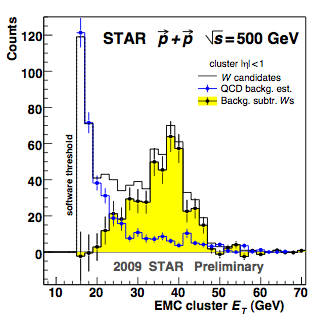
Plot from DNP2009 presentation
STAR W 2009 analysis
Paper proposals
-
W+/W- longitudinal single-spin asymmetry
Title: Measurement of the parity-violating longitudinal single-spin asymmetry
for W+/W- boson production in polarized p+p collisions at √s=500GeVJournal: Physical Review Letters
-
W-/W+ boson production cross sections
Title: Measurement of the W-/W+ boson production cross sections
at mid-rapidity in p+p collisions at √s=500GeV at RHICJournal: Physical Review D
Principal authors
- MIT
Jan Balewski (drupal, protected)
Ross Corliss (drupal, protected)
William Leight (drupal, protected)
Joseph Seele (drupal)
Bernd Surrow (drupal, protected)
Matthew Walker (drupal, MIT) - Indiana U.
Justin Stevens (drupal, protected)
Scott Wissink (drupal, protected)
Ilya Selyuzhenkov (drupal) - BNL
Gene Van Buren (drupal) - ANL
Hal Spinka (drupal, protected) - UC-Davis
Rosi Reed (drupal) - LBNL
Oleksandr Grebenyuk (drupal)
Peripheral Collisions
Fast moving highly-charged ions carry strong electromagnetic fields that act as a beam of photons. In collisions at large impact parameters (b>R1+R2), hadronic interactions are not possible, and the ions interact through photon-ion and photon-photon collisions known as ultra-peripheral collisions (UPCs). Ultra-peripheral hadron-hadron collisions will provide unique opportunities for studying electromagnetic processes. Ultra-relativistic heavy-ion interactions have been used to study nuclear photo excitation (e.g., to a Giant Dipole Resonance) and photoproduction of hadrons.
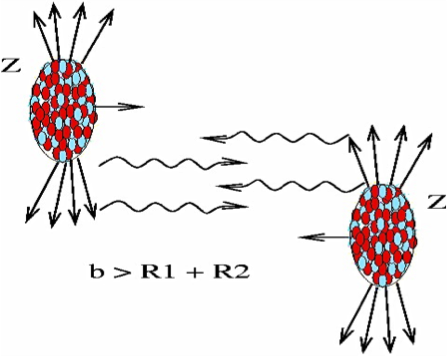
Hadron colliders like the Relativistic Heavy Ion Collider (RHIC), the Tevatron, and the Large Hadron Collider (LHC) produce photonuclear and two-photon interactions at luminosities and energies beyond that accessible elsewhere.
Introduction
Fast moving highly-charged ions carry strong electromagnetic fields that act as a beam of photons. In collisions at large impact parameters, hadronic interactions are not possible, and the ions interact through photon-ion and photon-photon collisions known as ultra-peripheral collisions (UPCs). Ultra-peripheral hadron-hadron collisions will provide unique opportunities for studying electromagnetic processes. Ultra-relativistic heavy-ion interactions have been used to study nuclear photo excitation (e.g., to a Giant Dipole Resonance) and photoproduction of hadrons.
Hadron colliders like the Relativistic Heavy Ion Collider (RHIC), the Tevatron, and the Large Hadron Collider (LHC) produce photonuclear and two-photon interactions at luminosities and energies beyond that accessible elsewhere.
Physics Analysis 2016
Coherent diffractive photoproduction of rho mesons on gold nuclei at RHIC
Target Journal: Physics Letters B
PAs: Ramiro Debbe, Spencer Klein
PWG presentation: STAR/system/files/userfiles/2729/file/RhoCoherentDiffractionV6.pdf
Abstract:
The STAR Collaboration reports on the photoproduction of π+π− pairs in gold-gold collisions at a center of mass energy of 200 GeV/nucleon. These pairs are produced when a nearly-real photon emitted by one ion scatters from the other ion. We fit the π+π− mass spectrum to a combination of ρ0 and ω resonances and a direct π+π− continuum; the ratio of ρ0 to direct π+π− is consistent with previous measurements. The ω cross-section is comparable with that expected from the measured γp → ωp cross section, a classical Glauber calculation and the ω → π+π− branching ratio.
The ρ0 differential cross section dσ/dt clearly exhibits a diffraction pattern, compatible with scattering from a gold nucleus, with 2 minima visible.
Figures:

Figure 1: The black histogram shows the pion pair transverse momentum. The peak below 100 MeV/c is from the decay of coherently produced π+π− pairs. The red histogram shows the pair momentum for same-sign pion pairs. Both histograms show pairs that come from vertices with only two tracks.
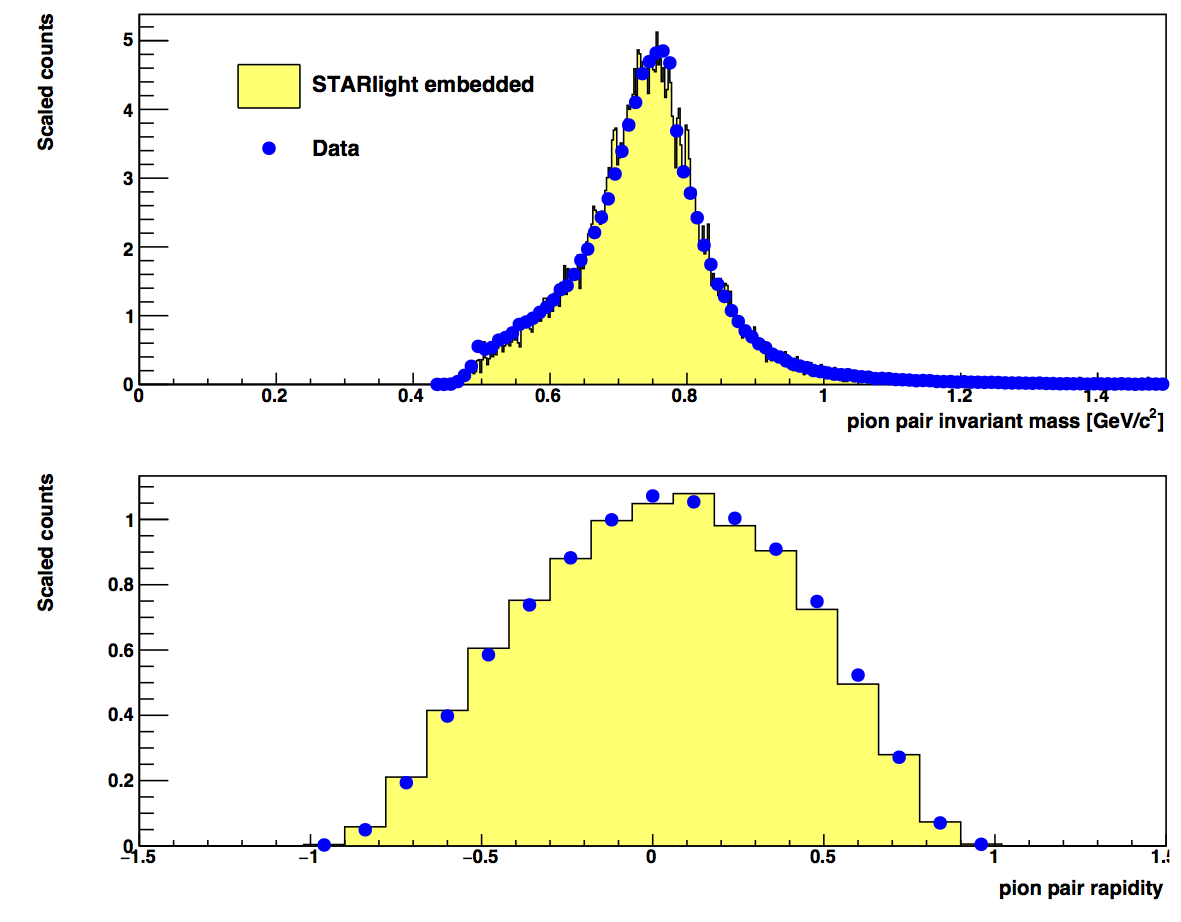
Figure 2: Comparison of uncorrected data (blue points) with embedded simulated ρ0 and direct ππ events (yellow histogram). The simulated UPCs were run through a GEANT sim- ulation of the detector, embedded in zero-bias background events, and subject to the same reconstruction programs as the data.
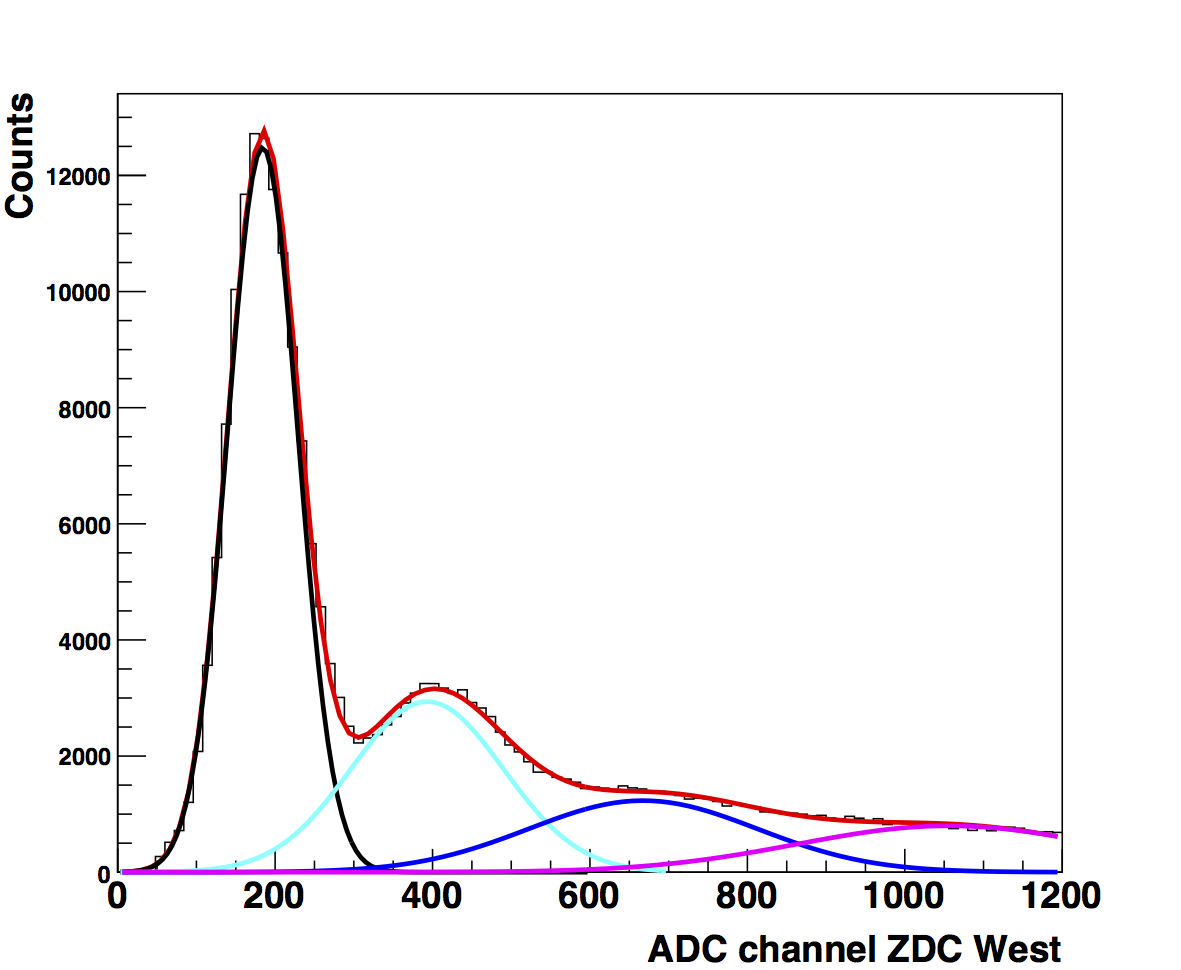
Figure 3: The shower energy in the West ZDC by neutron produced by mutual dissociation is shown as a distribution of ADC channels. These events had a single neutron detected on the East ZDC. The peaks corresponding to 1 to 4 neutrons are fitted with Gaussian distributions with standard deviations that grow as nσ with n the number of neutrons and σ the standard deviation of the one neutron Gaussian. The red curve is the sum of all Gaussians which are also displayed individually. The quality of fit is χ2/NDF = 498/88. The large χ2/NDF is due to the very small statistical errors and the imperfect descriptions of the neutron peaks. It does not introduce significant errors on the number of neutrons in each peak.
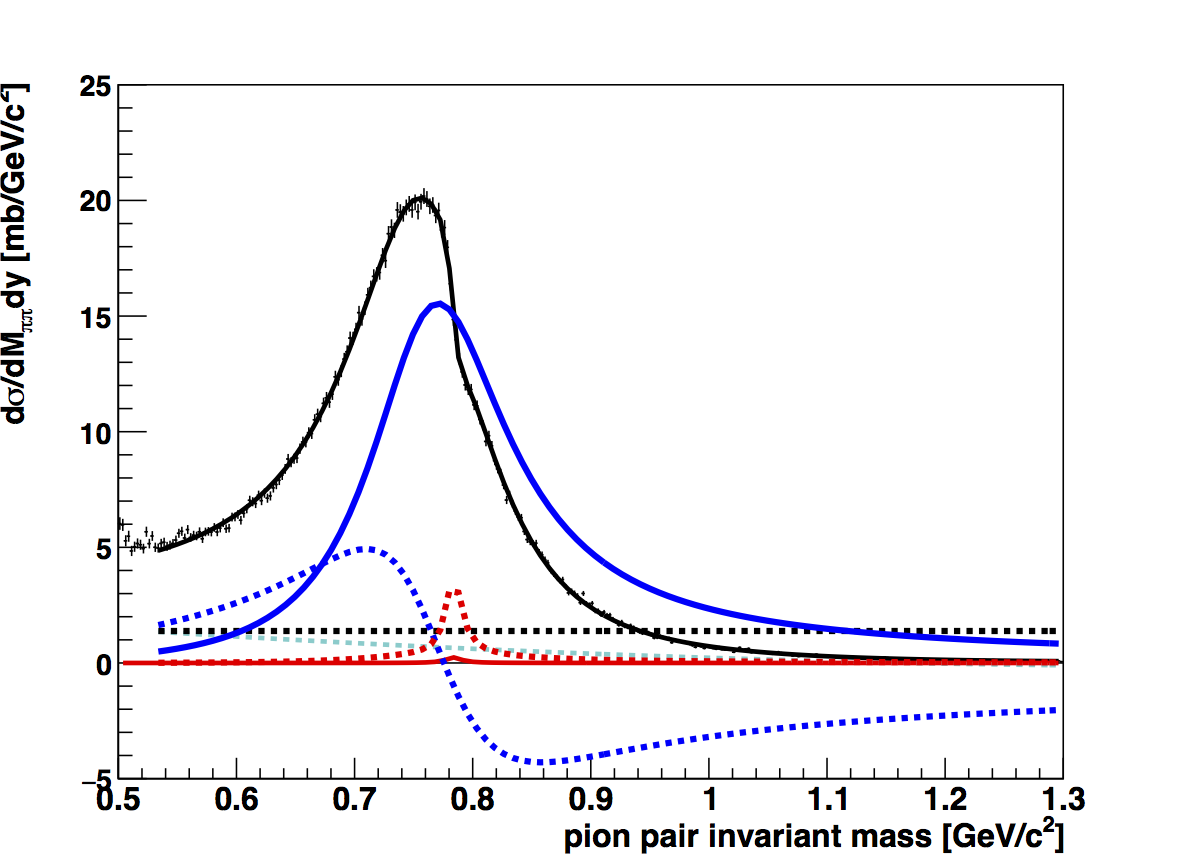
Figure 4: The π+π− invariant-mass distribution for all selected ππ candidates with pT < 100 MeV/c. The black markers show the data (in 2.5 MeV/c2 bins). The black curve is the modified S ̈oding fit to the data in the range 0.53 < Mππ < 1.3 GeV. The ρ0 Breit-Wigner component of the fitted function is shown with a blue curve and the constant non-resonant pion pair component is displayed with a black-dashed one. The interference between non- resonant pion pairs and the ρ0 meson is shown with a blue-dashed curve. The Breit-Wigner distribution for the ω mesons is shown with a red curve and the interference between ρ0 and ω is shown with a red-dashed curve. A small second order polynomial shown with a cyan-dashed curve accounts for the remnant background.
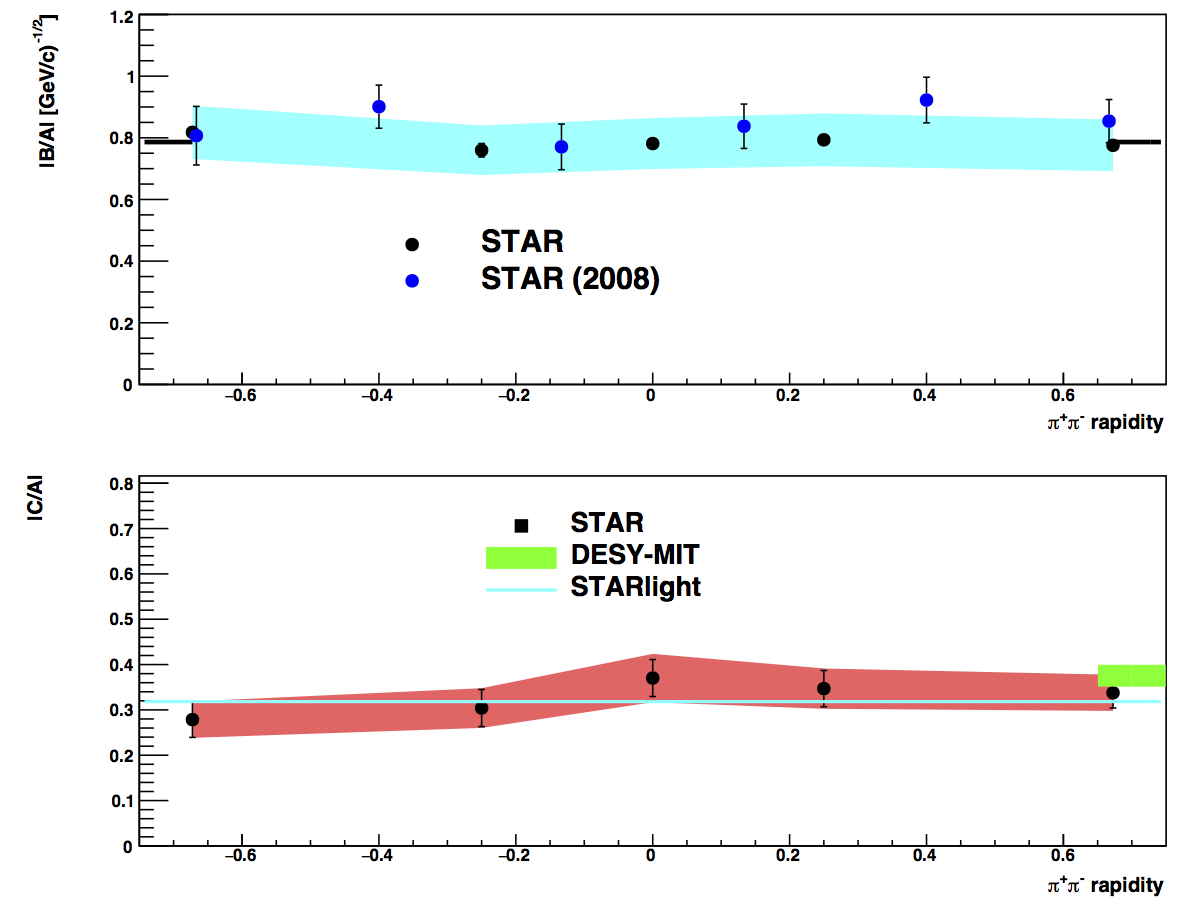
Figure 5: (Top) The ratio |B/A| of amplitudes of non-resonant π+π−and ρ0 mesons. The black points (with shaded blue systematic error band) are from the current analysis, while the previous STAR results are shown with blue-filled circles. The thick black line shows the rapidity-averaged result. In the bottom panel, the black points show the ratio |C/A| of the ω to ρ0 amplitude. The red band shows the systematic errors, while the horizontal blue line shows the STARlight prediction and the most recent branching ratio for ω → π+π− decay [26]. The green band shows the DESY-MIT result for |C/A| [27]. This result was at much lower photon energies leads to a large effective rapidity. For the lower energy photon solution of the two-fold ambiguity, the effective rapidity would be about 2.5.
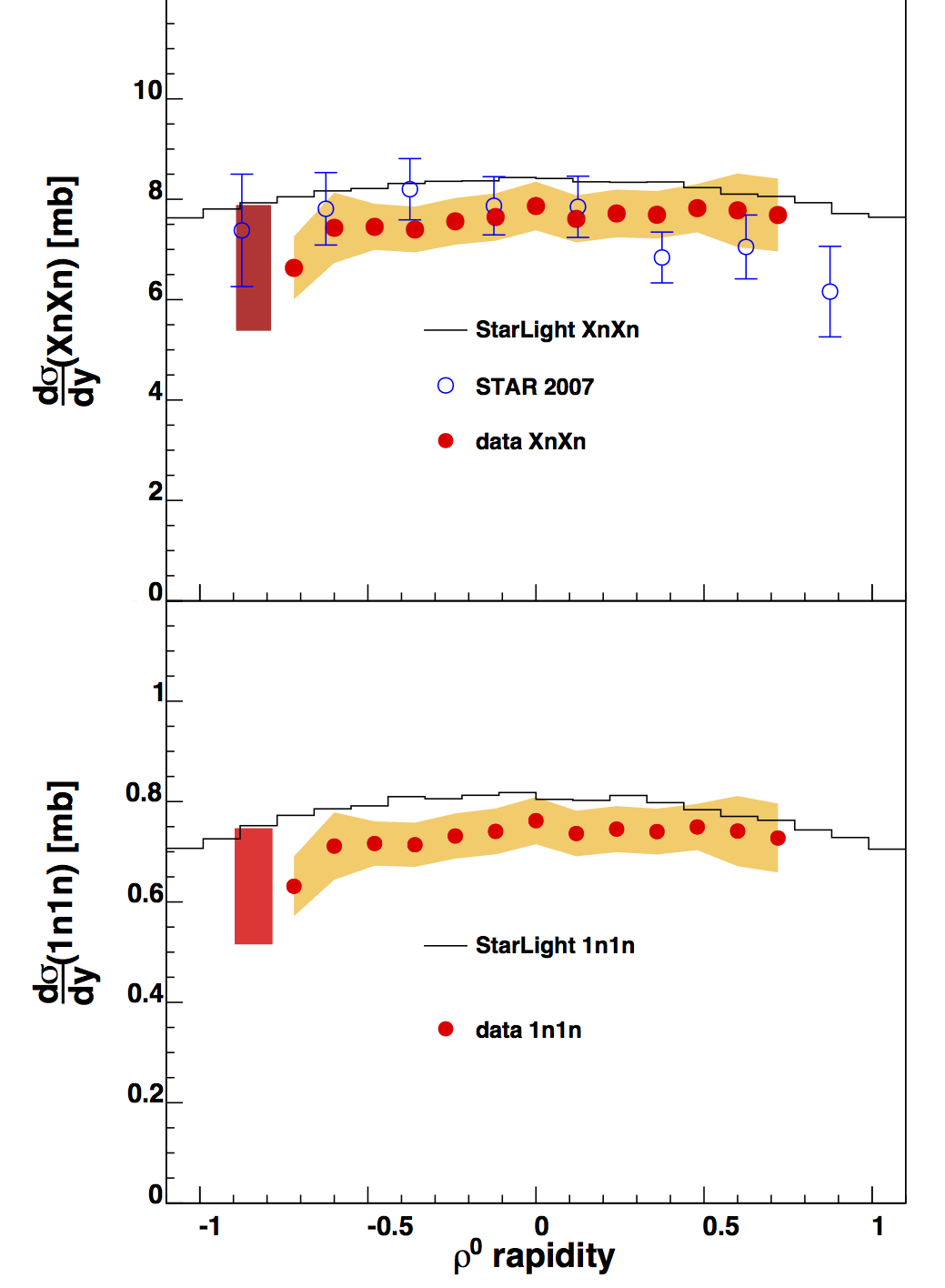
Figure 6: dσ/dy for exclusively photoproduced ρ0 mesons in (top) XnXn events and (bottom) 1n1n events. The data are shown with red markers. The statistical errors are smaller than the symbols, the orange band shows the quadrature sum of the point-to-point systematic uncertainties. The red box at y ∼ −0.9 shows the quadrature sum of the common systematic uncertainties. The black histograms are the STARlight calculation for ρ0 mesons with mutual dissociation. The blue markers in the top panel show the previous STAR measurement [10].
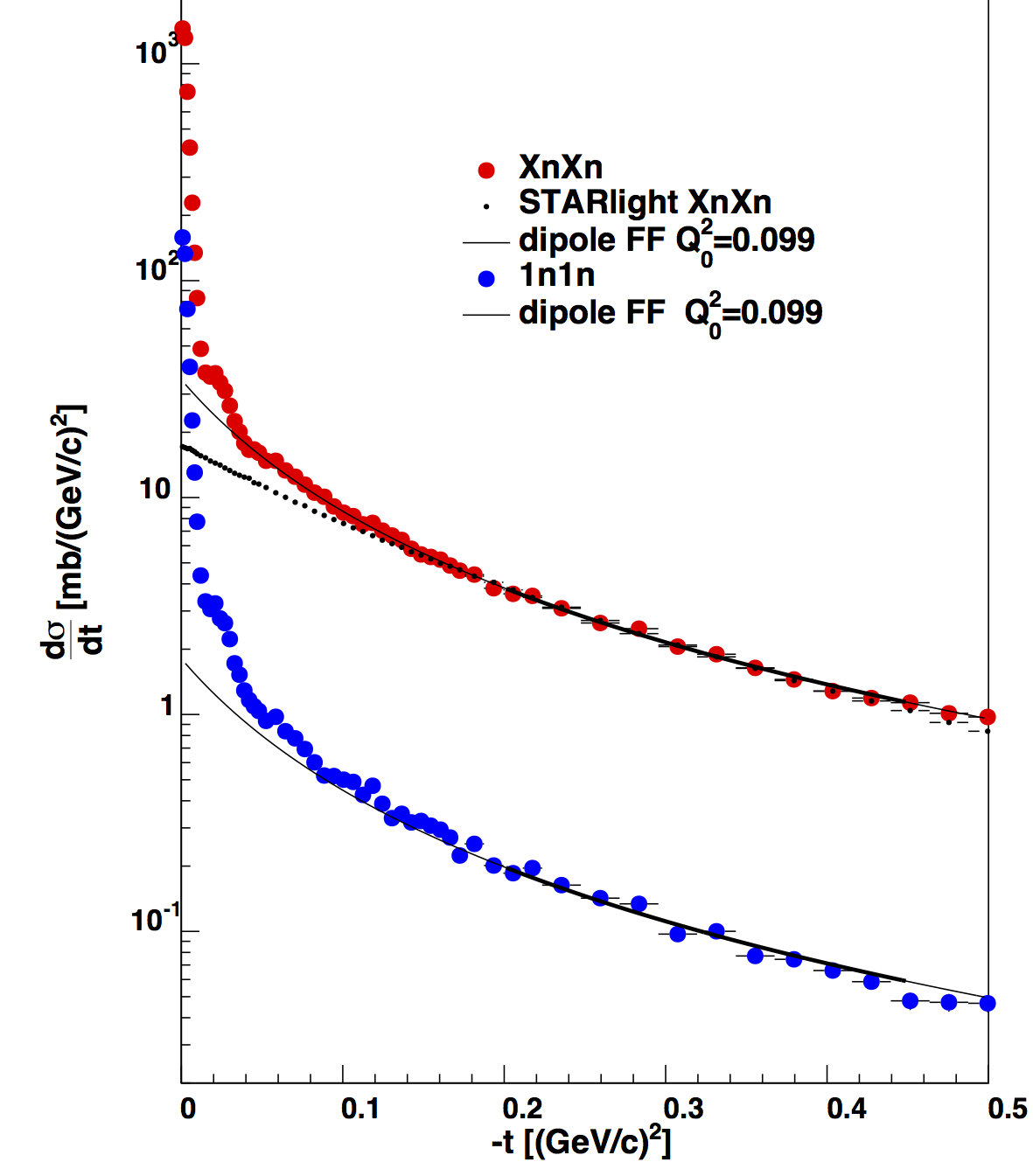
Figure 7: The −t distribution for exclusive ρ0 mesons in events with 1n,1n mutual dissociation (blue markers) or XnXn (red markers). The high t part of those distributions, which is dominated by the contribution from incoherent interactions is fit to a dipole form factor, shown with a thin line. The STARlight prediction for the incoherent contribution is shown by the histogram with small black markers.
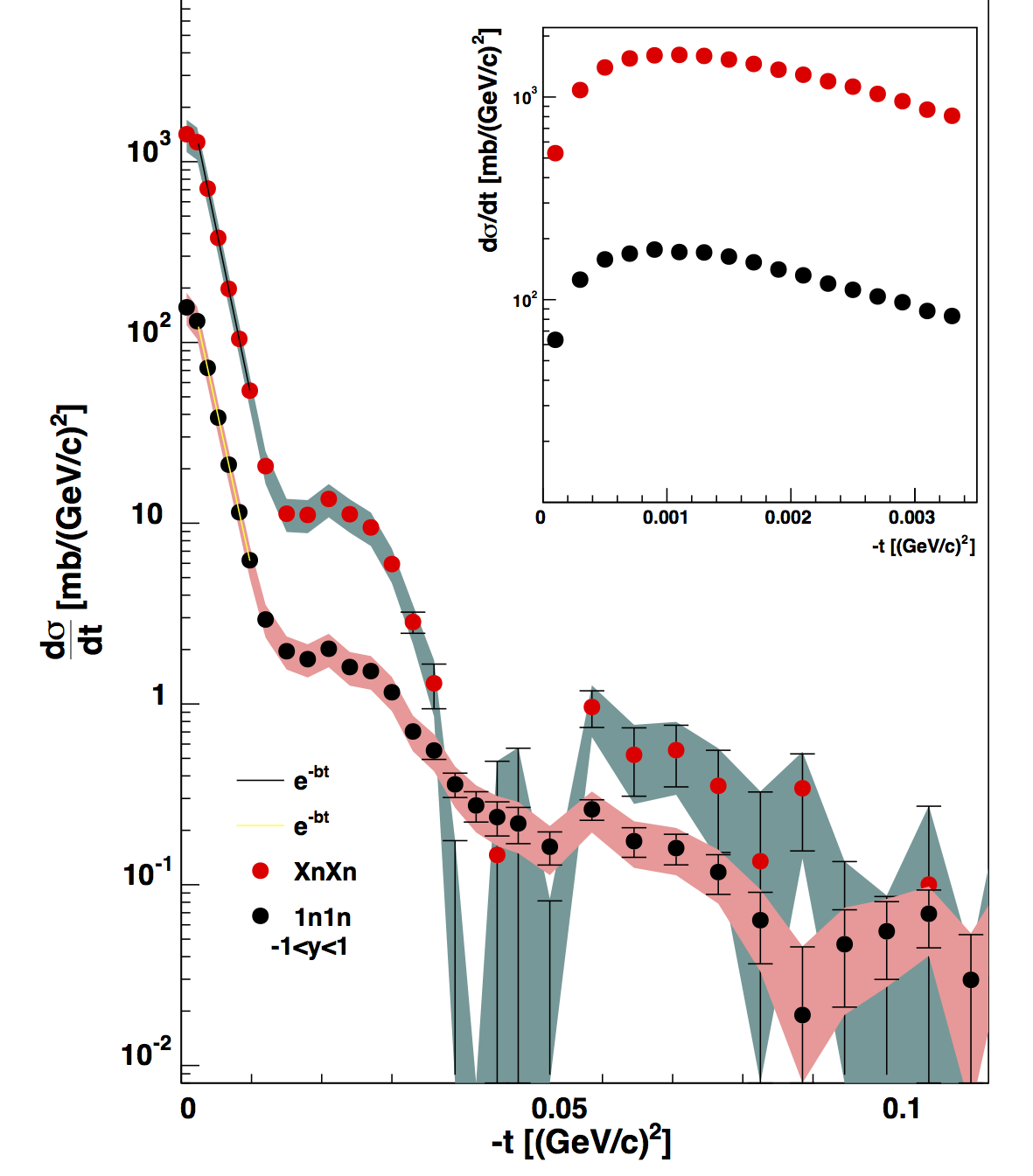
Figure 8: Fully normalized coherent diffraction patterns for ρ0 mesons detected in exclusive XnXn events is shown with red markers. The same distribution but extracted from 1n1n events is shown with black markers. The filled bands shows the sum in quadrature of all systematic uncertainties listed in table 4 and the statistical errors, which are shown as vertical lines.The insert shows, with finer binning at low pT , the effects of the destructive interference between photoproduction with the photon emitted by any of the two ions.
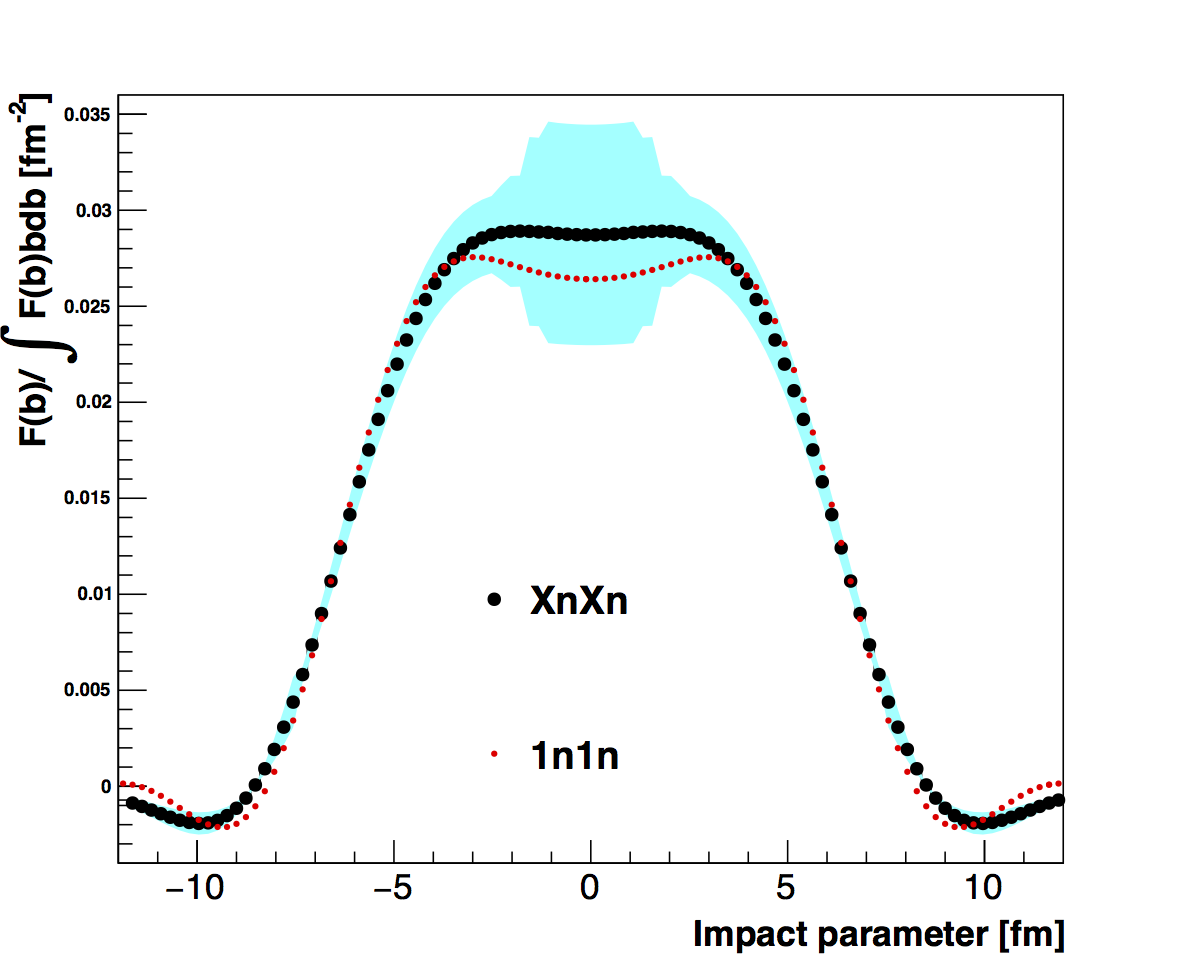
Figure 9: The normalized nucleon distribution in the transverse plane, the result of a two- dimensional Fourier transform (Hankel transform) of the XnXn and 1n1n diffraction patterns shown in Fig. 8. The integration is limited to a region where data is available; in the range 0 < |t| < 0.06 GeV2. The cyan error band shows the effect of changing the maximum t to 0.05, 0.07 and 0.09 GeV2. In order to highlight the similarity of both results at their falling edges, the resulting histograms are scaled by their integrals from -12 to 12 fm. The FWHM of both transforms is 2 × (6.17 ± 0.12) fm consistent with the coherent diffraction of ρ0 mesons off an object as big as the Au nuclei.
Paper conclusions:
In conclusion, STAR has made a precision study of ρ, ω and direct π+π− photoproduction in 200 GeV/nucleon gold-on-gold ultra-peripheral collisions, using 394,000 π+π− pairs.
We fit the invariant mass spectrum to a mixture of ρ, ω and direct π+π− (including interference terms). The ratio of ρ to direct ππ is similar to that in previous measurements, while the newly measured ω contribution is comparable with predictions based on on the previously measured γp → ωp cross section and the ω → π+π− branching ratio. The relative fractions of ρ, ω and direct π+π− do not vary significantly with rapidity, indicating that they all have a similar dependence on photon energy.
We also measure the cross section dσ/dt over a wide range, and separate out coherent and incoherent components. The coherent contribution exhibits
Analysis note (STAR Note psn0650)
The current version of the note can be found at: STAR/system/files/userfiles/2729/file/Main_analysisNote_RhoDiffraction.pdf
Section 9.7 has detailed instructions on how to reproduce the UPC pico-dst used in this analysis and the macros used to generate the figures of the paper.
The code for this analysis is stored in STAR CVS, to retrieve it do:
cvs co offline/paper/psn0650
Paper drafts:
First_draft - First circulation to UPC PWG
Second_draft - request for a GPC
Third_draft - first GPC revision
Fourth_draft - Oct. 24, 2016 - version for collaboration review
Final Draft - Feb 7, 2017. This is the final version, after collaboration review and GPC approval. It includes the current author list and acknowledgements, as of Feb. 7th. Also attached are detailed responses to the collaboration comments, in a single document.
Final, Final draft., Feb. 20th, 2017. This is the version after including comments from Norbert Schmitz. The response to Norbert is here.
May 10, 2017. The Physics Letters B Referee Report is here.
May 10, 2017. After discussion with the GPC, we decided to sent it to Physical Review C., with a very few changes in response to the PLB referee reports. The Physical Review C version is here.
September 26, 2017. After four months, PRC sent us a positive referee report, which is attached here. Our proposed response is attached here, and the revised manuscript is attached here.
UPC Publications and Analysis notes
UPC Publications
UPC Publication list
1.0 Ultra-Peripheral Collisions with STAR at RHIC
2.0 Exclusive vector meson production in relativistic heavy ion collisions
3.0 Interference in Exclusive Vector Meson Production in Heavy-Ion Collisions
4.0 ρ0 photoproduction in ultraperipheral relativistic heavy ion collisions at √sNN=200 GeV
5.0 ρ0 Photoproduction in AuAu Collisions at √sNN =62.4 GeV with STAR
6.0 Coherent ρ0 Production in Ultraperipheral Heavy-Ion Collisions
8.0 Observation of Two-Source Interference in the Photoproduction Reaction AuAu→AuAuρ0
9.0 Production of e+e− pairs accompanied by nuclear dissociation in ultraperipheral heavy-ion collisions
UPC Talks
Dilan's Talks
STARlight
STARlight is a Monte Carlo that simulates two-photon and photon-Pomeron interactions between relativistic nuclei and protons. More information can be found here.
Spin
STAR Spin Working Group
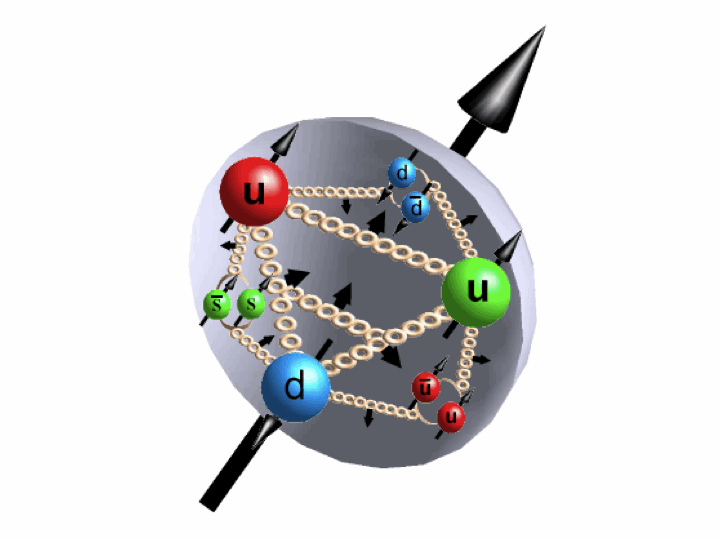
Unraveling the quark and gluon substructure of nucleons and nuclei is one of the major goals in nuclear physics today. A great deal has been learned about the partonic structure of the nucleon at leading twist and with collinear factorization, but much is still unknown. Furthermore, new avenues have been opened during the past decade to explore the nucleon structure beyond leading twist and collinear factorization. The ability to collide polarized beams at RHIC provides unique information regarding these issues.
- STAR Decadal Plan (2010)
Spin PWG
This is a feed of Drupal items targeting the "Spin" Audience.
Spin/Cold-QCD Older Physics Analysis
Detailed information about physics analyses in the spin pwg
Link to STAR spin task force (2008)
(page started in March of 2008)
2006 EEMC Neutral Pion Cross Section and A_LL
The 2006 EEMC cross section, ALL, and AN were published in Physical Review D 89, 012001 (2014). Please, see the paper home page for links to detailed information.
Relevant Links
2006 Gamma + Jet
Relevant Links
Intent to Publish 2006 Gamma + Jet Cross Section
Title
Gamma-jet cross sections for forward gammas in proton-proton collisions at root(s) = 200 GeV/c
Principal Authors (alphabetical order)
Keith Krueger (ANL), Hal Spinka (ANL), Dave Underwood (ANL)
Intended Journal
Physical Review D
Abstract
A measurement is presented of the cross section vs. transverse momentum (pT) for gamma + jet production in proton-proton collisions. The data were measured in the STAR detector at RHIC at √s = 200 GeV/c. The jet was detected at central pseudorapidity (|η| < 0.8) and the γ at intermediate pseudorapidity (1.2 < η < 2.0). These regions were chosen to access lower x of the gluon relative to a central-pseudorapidity-only measurement, and also because a large partonic spin asymmetry, All, in the parton cm is selected. The technique of finding single γ’s in the background of photons from π0 decay is based on a standard chi-squared method for the shower shape in the shower maximum detector of an electromagnetic calorimeter.
Outline
- Introduction
- Refs. to earlier measurements and theory predictions
- Connection to gluon distribution
- Hardware
- RHIC general (Refs.)
- STAR general (Refs.)
- TPC and BEMC for jets (Refs.)
- EEMC and ESMD for gamma
- trigger
- luminosity
- Analysis
- Jets (Refs.)
- Gammas with chi-squared (Ref.)
- Efficiency / RooUnfold
- Other Corrections?
- Systematics
- Table of results with errors
- Results
- Comparison to JETPHOX (Refs.)
- Comparison to pi0’s?
- Summary / Conclusions
Presentations to the Spin PWG (April 23)
2009 Lambda D_LL @ 200 GeV
.png)
Presentations:
Run QA by Qinghua Xu (SDU)
- JP1 link (769 runs) luminosity (LT = 17.6 pb-1)
- L2JetHigh link (819 runs) luminosity (LT = 19.0 pb-1)
1) Preliminary results
Preliminary released on SPIN 2012 and DNP 2012.
Presentation @ SPIN 2012 by Jian Deng (SDU)
Presentation @ DNP 2012 by Ramon Cendejas (UCLA)
2) Lambda reconstruction
1. Cuts setup:
| lam_pt | dac2 | dcaV0 | dca_p | dca_pi | nsigma | dlength | cosrp | jet_det_eta | jet_Rt | jet_dr |
| 2,3 | <0.7 | <1.2 | >0.2 | (0.4,30) | <3 | (3,130) | >0.98 | (-0.7,0.7) | (0.01,0.94) | <0.7 |
| 3,4 | <0.5 | <1.2 | 0 | (0.4,30) | <3 | (3.5,130) | >0.98 | (-0.7,0.7) | (0.01,0.94) | <0.7 |
| 4,5 | <0.5 | <1.2 | 0 | (0.4,30) | <3 | (4,130) | >0.98 | (-0.7,0.7) | (0.01,0.94) | <0.7 |
| 5,8 | <0.5 | <1.2 | 0 | (0.4,30) | <3 | (4.5,130) | >0.98 | (-0.7,0.7) | (0.01,0.94) | <0.7 |
2. Analysis plots:
cos\theta^* vs mass by pT .pdf
slope band from K0-short: .pdf
3. Invariant Mass distribution and background estimation, side band vs. fitting
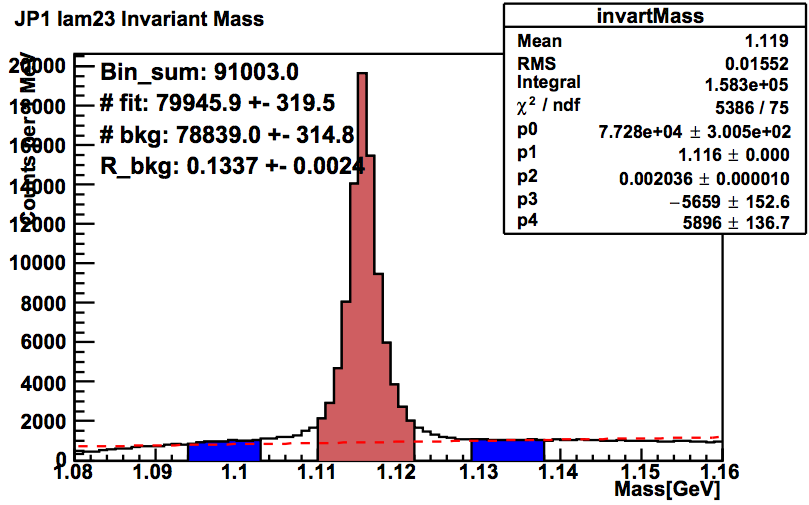
All 4 lambda pT bins, fired jet only .pdf .txt no fired jet required .pdf .txt
4. Extract Lambda and Anti-Lambda yields for 20 cos \theta^* , for 4 spin status, for JP1 and L2JetHigh triggers.
| Lambda pT | Lambda JP1 | AntiLambda JP1 | Lambda L2JetHigh | AntiLambda L2JetHigh |
| 2, 3 | FiredJet.pdf .txt .html noFire .pdf .txt .html | FiredJet.pdf .txt .html noFire .pdf .txt .html | FiredJet.pdf .txt .html noFire .pdf .txt .html | FiredJet.pdf .txt .html noFire .pdf .txt .html |
| 3, 4 | FiredJet.pdf .txt .html noFire .pdf .txt .html | FiredJet.pdf .txt .html noFire .pdf .txt .html | FiredJet.pdf .txt .html noFire .pdf .txt .html | FiredJet.pdf .txt .html noFire .pdf .txt .html |
| 4, 5 | FiredJet.pdf .txt .html noFire .pdf .txt .html | FiredJet.pdf .txt .html noFire .pdf .txt .html | FiredJet.pdf .txt .html noFire .pdf .txt .html | FiredJet.pdf .txt .html noFire .pdf .txt .html |
| 5, 8 | FiredJet.pdf .txt .html noFire .pdf .txt .html | FiredJet.pdf .txt .html noFire .pdf .txt .html | FiredJet.pdf .txt .html noFire .pdf .txt .html | FiredJet.pdf .txt .html noFire .pdf .txt .html |
5. Extract DLL from the spin sorted Lambda/AntiLambda yeilds in each cos \theta^* bin, for each trigger
| Lambda pT | Lambda JP1 | AntiLambda JP1 | Lambda L2JetHigh | AntiLambda L2JetHigh |
| 2, 3 | FiredJet .html noFire .html | FiredJet .html noFire .html | FiredJet .html noFire .html | FiredJet .html noFire .html |
| 3, 4 | FiredJet .html noFire .html | FiredJet .html noFire .html | FiredJet .html noFire .html | FiredJet .html noFire .html |
| 4, 5 | FiredJet .html noFire .html | FiredJet .html noFire .html | FiredJet .html noFire .html | FiredJet .html noFire .html |
| 5, 8 | FiredJet .html noFire .html | FiredJet .html noFire .html | FiredJet .html noFire .html | FiredJet .html noFire .html |
6. Fit DLL vs. cos \theta^* to extract the "DLL"
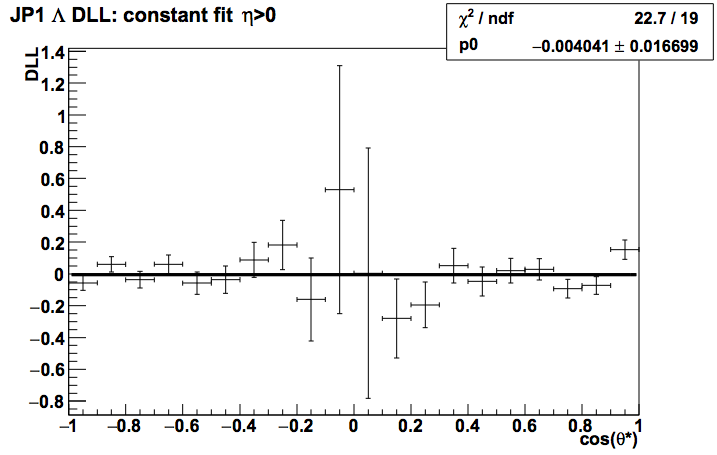
| Lambda pT | Lambda JP1 | AntiLambda JP1 | Lambda L2JetHigh | AntiLambda L2JetHigh |
| 2, 3 | FiredJet.pdf .txt .html noFire .pdf .txt .html | FiredJet.pdf .txt .html noFire .pdf .txt .html | FiredJet.pdf .txt .html noFire .pdf .txt .html | FiredJet.pdf .txt .html noFire .pdf .txt .html |
| 3, 4 | FiredJet.pdf .txt .html noFire .pdf .txt .html | FiredJet.pdf .txt .html noFire .pdf .txt .html | FiredJet.pdf .txt .html noFire .pdf .txt .html | FiredJet.pdf .txt .html noFire .pdf .txt .html |
| 4, 5 | FiredJet.pdf .txt .html noFire .pdf .txt .html | FiredJet.pdf .txt .html noFire .pdf .txt .html | FiredJet.pdf .txt .html noFire .pdf .txt .html | FiredJet.pdf .txt .html noFire .pdf .txt .html |
| 5, 8 | FiredJet.pdf .txt .html noFire .pdf .txt .html | FiredJet.pdf .txt .html noFire .pdf .txt .html | FiredJet.pdf .txt .html noFire .pdf .txt .html | FiredJet.pdf .txt .html noFire .pdf .txt .html |
7. DLL correction
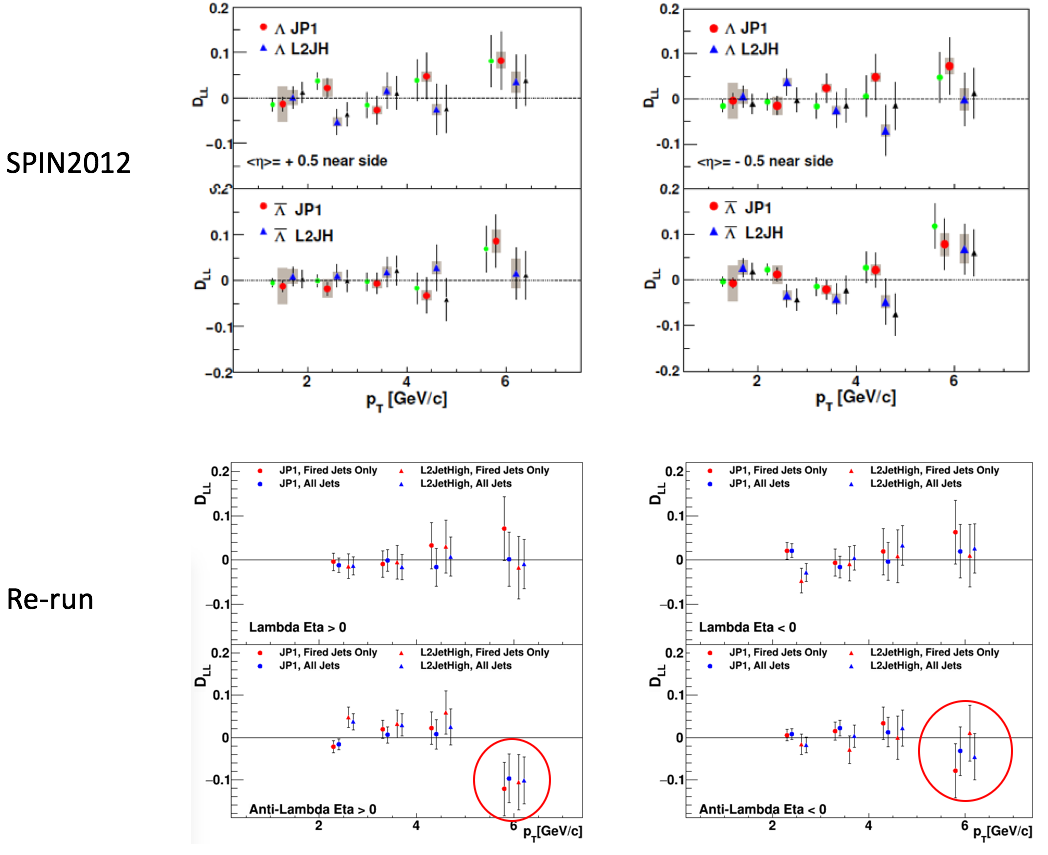
Appendix, Anti-Lambda/Lambda ratio:
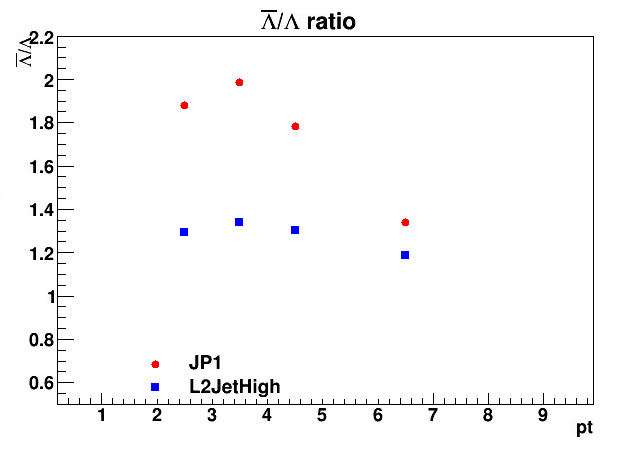
3) New simulation production
Simulations performed by Ramon Cendejas. Unfortunately, an error was found in the (subdominant) process contributions when Ramon needed to move on. This and other factors held up progress since.
Introduction
- Pure MC simulation under STAR geometry.
- Generate pp events using Pythia 6.4.28 (Tune 320) with Lambda filter, in different partonic pT intervals and weighted by integral luminosities
- Reconstruct Lambda based on track association
- Jet reconstruction used CDF cone algorithm with R = 0.7
Statistics of simulation sample
It totally took about 4.5 CPU years.
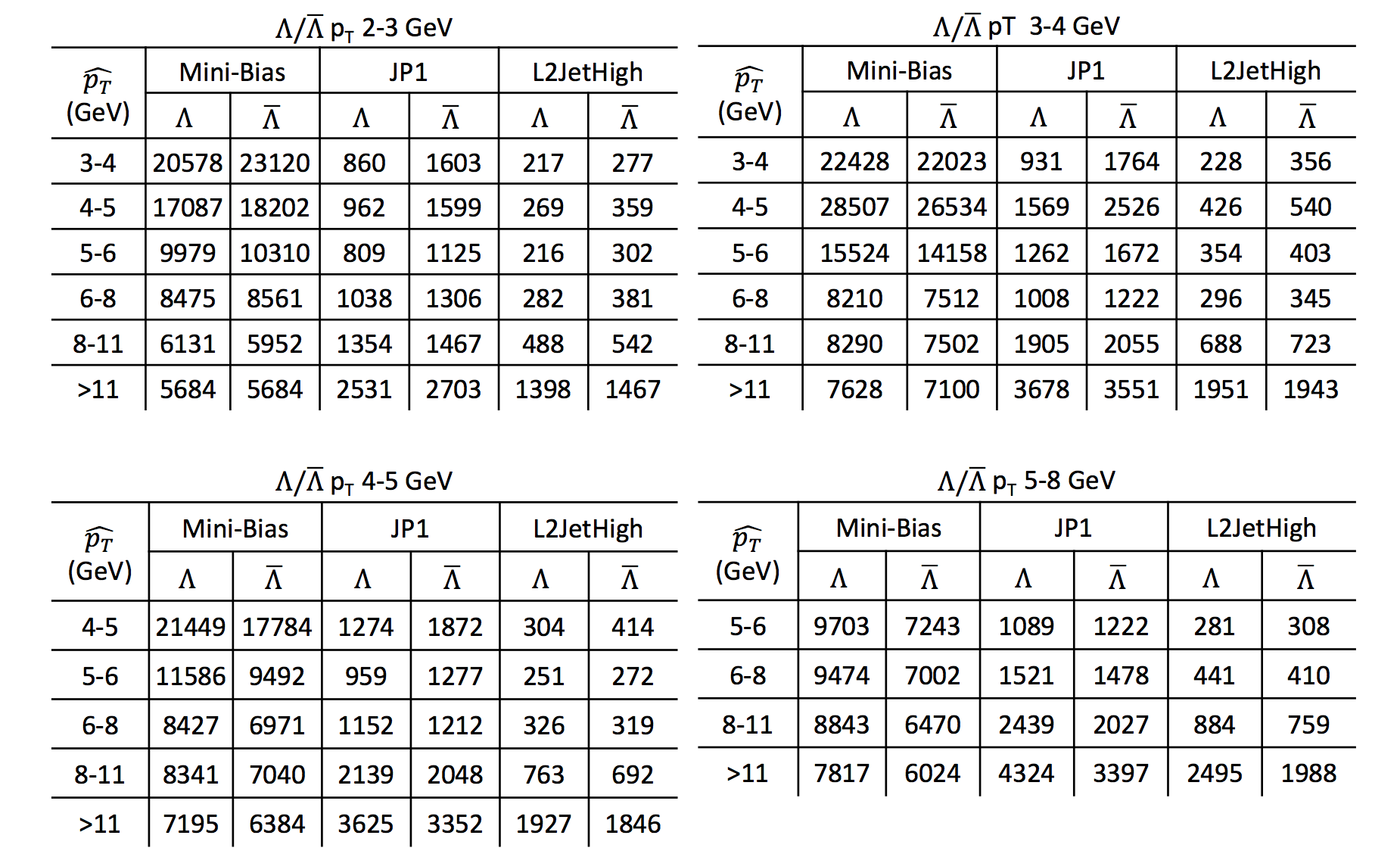
Slides20170110
Jet Cone Study
1. slides (JP1 lambda pt2-3 for example)
2. All comparison plots for different lambda pt bin and different Triggers
Trigger Bias Plot
1. updated version for cdf cone algorigthm
Data/MC comparison for
Lambda:
| lamdba pt | JP1 | L2JetHigh |
| 2_3 | file | file |
| 3_4 | file | file |
| 4_5 | file | file |
| 5_8 | file | file |
| A-lamdba pt | JP1 | L2JetHigh |
| 2_3 | file | file |
| 3_4 | file | file |
| 4_5 | file | file |
| 5_8 | file | file |
QA:
| lamdba pt | MB | JP1 | L2JetHigh |
| 2_3 | file | file | file |
| 3_4 | file | file | file |
| 4_5 | file | file | file |
| 5_8 | file | file | file |
Trigger effect: (old, anti-kt R06 )
| f_z | feed down | parton | subprocess | |
| Lambda | file1 file2 | file | file | file |
| A-lambda | file1 file2 | file | file | file |
4) Systematic uncertainties
Systematic uncertainties summary
- decay, fz, and f_parton from simulation
- pile-up and residual background are from preliminary version
| η > 0 | η < 0 | |||||||||
| Lambda | Anti-lambda | Lambda | Anti-lambda | |||||||
| pt | JP1 | L2J | JP1 | L2J | JP1 | L2J | JP1 | L2J | ||
| decay | 2.4 | 0.0009 | 0.0018 | 0.0001 | 0.0003 | 0.0001 | 0 | 0.0001 | 0.0001 | |
| 3.4 | 0.0008 | 0.0011 | 0.0004 | 0.0003 | 0 | 0.0001 | 0 | 0 | ||
| 4.4 | 0.002 | 0.0027 | 0.0008 | 0.0008 | 0.0003 | 0.0004 | 0.0001 | 0.0002 | ||
| 5.9 | 0.0017 | 0.0024 | 0.0013 | 0.0022 | 0.0005 | 0.0009 | 0.0003 | 0.0007 | ||
| fz | 2.4 | 0.0011 | 0.0028 | 0.0003 | 0.0015 | 0.0002 | 0.0001 | 0.0001 | 0.0001 | |
| 3.4 | 0.001 | 0.0034 | 0.0006 | 0.0024 | 0.0003 | 0.0005 | 0.0003 | 0 | ||
| 4.4 | 0.0056 | 0.008 | 0.0053 | 0.0079 | 0.0005 | 0.0007 | 0.0009 | 0.0013 | ||
| 5.9 | 0.009 | 0.0121 | 0.0154 | 0.0191 | 0.0021 | 0.0028 | 0.0037 | 0.0046 | ||
| fparton | 2.4 | 0.0005 | 0.0008 | 0.0004 | 0.0012 | 0.0001 | 0.0001 | 0.0001 | 0.0002 | |
| 3.4 | 0.0011 | 0.0021 | 0.0002 | 0.0013 | 0.0003 | 0.0005 | 0 | 0.0003 | ||
| 4.4 | 0.0019 | 0.0038 | 0.0003 | 0.0011 | 0.0005 | 0.0009 | 0.0001 | 0.0003 | ||
| 5.9 | 0.0034 | 0.0062 | 0.0016 | 0.0027 | 0.0011 | 0.002 | 0.0005 | 0.0009 | ||
| pile-up | 2.4 | 0.0182 | 0.0057 | 0.0184 | 0.0063 | 0.0182 | 0.0057 | 0.0184 | 0.0063 | |
| 3.4 | 0.0023 | 0.0007 | 0.0022 | 0.001 | 0.0023 | 0.0007 | 0.0022 | 0.001 | ||
| 4.4 | 0.0023 | 0.0007 | 0.0022 | 0.001 | 0.0023 | 0.0007 | 0.0022 | 0.001 | ||
| 5.9 | 0.0068 | 0.0023 | 0.0064 | 0.0023 | 0.0068 | 0.0023 | 0.0064 | 0.0023 | ||
| bkgd | 2.4 | 0.005 | 0.001 | 0.0001 | 0.0002 | 0.005 | 0.001 | 0.0001 | 0.0002 | |
| 3.4 | 1.00E-06 | 0.0001 | 0.0001 | 0.0006 | 1.00E-06 | 0.0001 | 0.0001 | 0.0006 | ||
| 4.4 | 0.0007 | 4.00E-05 | 0.0004 | 0.0002 | 0.0007 | 4.00E-05 | 0.0004 | 0.0002 | ||
| 5.9 | 0.0002 | 0.0002 | 0.001 | 0.0001 | 0.0002 | 0.0002 | 0.001 | 0.0001 | ||
| all | 2.4 | 0.0189 | 0.0067 | 0.0184 | 0.0066 | 0.0189 | 0.0058 | 0.0184 | 0.0063 | |
| 3.4 | 0.0029 | 0.0042 | 0.0023 | 0.0030 | 0.0023 | 0.0010 | 0.0022 | 0.0012 | ||
| 4.4 | 0.0067 | 0.0093 | 0.0058 | 0.0081 | 0.0025 | 0.0014 | 0.0024 | 0.0017 | ||
| 5.9 | 0.0119 | 0.0140 | 0.0168 | 0.0196 | 0.0072 | 0.0042 | 0.0075 | 0.0053 | ||
2009 dijet x-sect/A_LL @ 200 GeV
2011 FMS Jet-like correlations @ 500 GeV
2011 FMS inclusive pions @ 500 GeV
2012 EEMC Neutral Pion A_LL
Relevant Links
2012 Jet A_LL @ 500 GeV
2012 Lambda D_TT @200GeV
Web links:
- Lambda reconstruction status
2, Statistics of Lambda and anti-Lambda Reconstruction, Jet near-side
- MC production and data comparison
2, MC and data comparison for inclusive hyperons
3, MC and data comparison for jet near-side hyperons
- Trigger Bias
1, Trigger bias parameters (fz_shift, feed-down fraction, fragmenting parton flavor fraction, subprocess fraction) plots
2, Uncertainty to D_TT from trigger bias
Presentations:
- DIS17
- SPIN2016
- May 16, 2017 Collaboration Meeting, Update of the systematic uncertainty
- Sep. 19, 2016 spinpwg meeting, Preliminary result request
1) Dataset and RunQA
Dataset for pp200trans_2012 D_TT analysis
Statistics Summary
Dataset: pp200trans_2012
Integrated Luminosity: 18.4 pb^-1
Selected Triggers: JP0, JP1, JP2, AJP
Event Statistics For Each Trigger:
| Trigger | JP0 | JP1 | JP2 | AJP | Combined |
|---|---|---|---|---|---|
| HardXSoft | 2.461964e+07 | 8.525444e+07 | 1.797188e+07 | 1.391969e+07 | 1.417656e+08 |
Data QA
2) Lambda Reconstruction
The reconstruction of Lambda and anti-Lambda hyperons.
Identification cut on track’s dE/dx measured in TPC is used to find pion and (anti-)proton.
Sketch for Topological Cuts
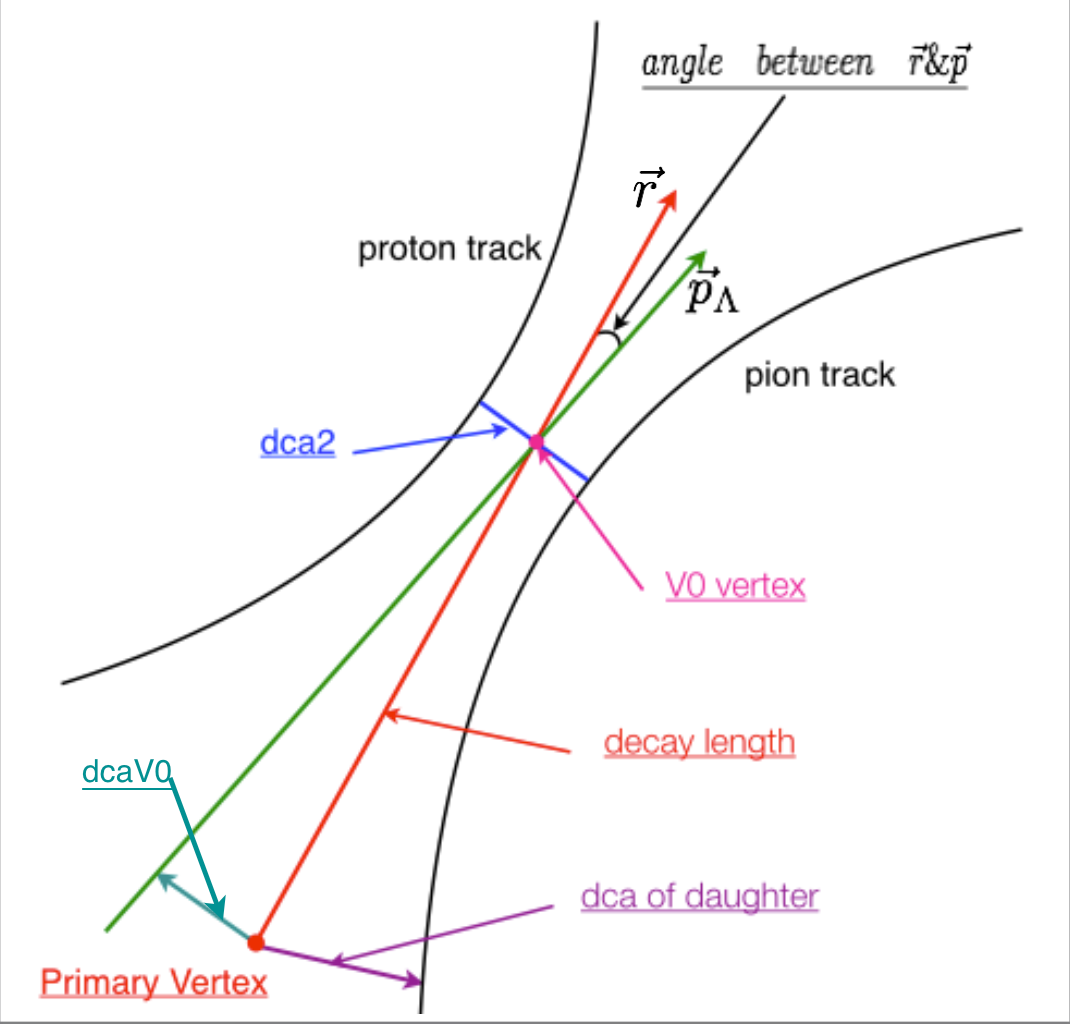
Values:
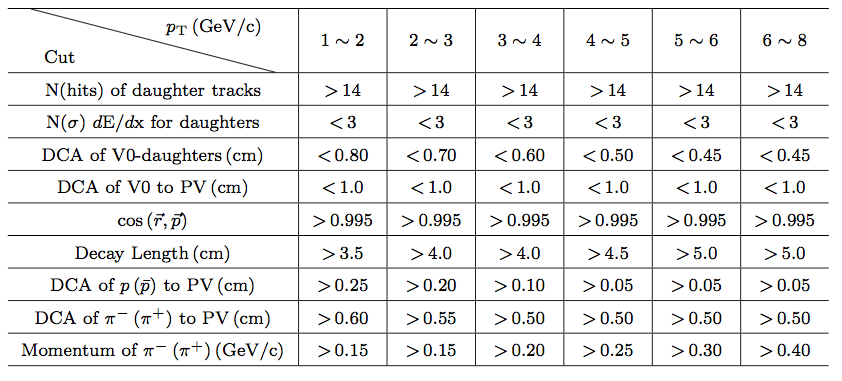
a) Statistics of Lambda and anti-Lambda Reconstruction, Inclusive
b) Statistics of Lambda and anti-Lambda Reconstruction, Jet near-side
Only the jet near-side Lambda used to extract D_TT.
The comparison about the reconstruction status with two sets of cut are shown here.
The loose one is the cut set used in run09 D_LL analysis and the tight one.
a) Statistics of Lambda and anti-Lambda Reconstruction, Inclusive
D_TT analysis Record, Rec_Step: all_cut_crp0995
Invariant Mass
Statistics Summary
====> Lambda
| 1~2 | 1.1154 | 0.0016 | 364262 | 0.0536 | 1.1155 | 0.0016 | 1394859 | 0.0570 | 1.1155 | 0.0016 | 280707 | 0.0666 | 1.1155 | 0.0016 | 338322 | 0.0546 | 1.1155 | 0.0016 | 2378150 | 0.0572 |
| 2~3 | 1.1157 | 0.0021 | 96583 | 0.0609 | 1.1157 | 0.0021 | 496180 | 0.0654 | 1.1157 | 0.0022 | 122363 | 0.0758 | 1.1157 | 0.0021 | 118569 | 0.0631 | 1.1157 | 0.0021 | 833695 | 0.0660 |
| 3~4 | 1.1158 | 0.0027 | 25879 | 0.0612 | 1.1158 | 0.0028 | 186321 | 0.0649 | 1.1158 | 0.0028 | 57674 | 0.0748 | 1.1158 | 0.0027 | 38191 | 0.0609 | 1.1158 | 0.0028 | 308065 | 0.0659 |
| 4~5 | 1.1161 | 0.0035 | 6360 | 0.0616 | 1.1160 | 0.0034 | 65638 | 0.0644 | 1.1159 | 0.0034 | 25367 | 0.0703 | 1.1160 | 0.0035 | 11204 | 0.0565 | 1.1160 | 0.0034 | 108569 | 0.0648 |
| 5~6 | 1.1162 | 0.0041 | 1782 | 0.0791 | 1.1162 | 0.0042 | 25415 | 0.0720 | 1.1162 | 0.0042 | 11736 | 0.0745 | 1.1163 | 0.0042 | 3484 | 0.0669 | 1.1162 | 0.0042 | 42417 | 0.0726 |
| 6~8 | 1.1168 | 0.0051 | 729 | 0.0938 | 1.1166 | 0.0051 | 14932 | 0.0884 | 1.1166 | 0.0052 | 8622 | 0.0912 | 1.1169 | 0.0051 | 1853 | 0.0835 | 1.1166 | 0.0051 | 26136 | 0.0891 |
====> anti-Lambda
| 1~2 | 1.1155 | 0.0015 | 299136 | 0.0755 | 1.1155 | 0.0016 | 1048977 | 0.0834 | 1.1155 | 0.0015 | 195241 | 0.0999 | 1.1155 | 0.0015 | 284645 | 0.0735 | 1.1155 | 0.0017 | 1827999 | 0.0823 |
| 2~3 | 1.1157 | 0.0020 | 102267 | 0.0676 | 1.1157 | 0.0020 | 468030 | 0.0743 | 1.1157 | 0.0021 | 97877 | 0.0931 | 1.1157 | 0.0020 | 114900 | 0.0702 | 1.1157 | 0.0020 | 783074 | 0.0751 |
| 3~4 | 1.1159 | 0.0026 | 26961 | 0.0663 | 1.1159 | 0.0026 | 183094 | 0.0680 | 1.1158 | 0.0027 | 46292 | 0.0860 | 1.1159 | 0.0027 | 34646 | 0.0694 | 1.1159 | 0.0027 | 290993 | 0.0709 |
| 4~5 | 1.1162 | 0.0033 | 5659 | 0.0660 | 1.1161 | 0.0034 | 61114 | 0.0635 | 1.1160 | 0.0034 | 19641 | 0.0741 | 1.1161 | 0.0035 | 8582 | 0.0678 | 1.1161 | 0.0034 | 94996 | 0.0662 |
| 5~6 | 1.1166 | 0.0043 | 1301 | 0.0707 | 1.1163 | 0.0041 | 20461 | 0.0756 | 1.1162 | 0.0041 | 8679 | 0.0798 | 1.1164 | 0.0041 | 2292 | 0.0794 | 1.1163 | 0.0041 | 32733 | 0.0768 |
| 6~8 | 1.1168 | 0.0057 | 459 | 0.1046 | 1.1168 | 0.0053 | 10175 | 0.1061 | 1.1166 | 0.0051 | 5581 | 0.1092 | 1.1172 | 0.0053 | 972 | 0.1086 | 1.1168 | 0.0052 | 17187 | 0.1072 |
Lambda candidates invariant mass distributions for each p_T range
Trigger: JP0 Distribution Statistics
Trigger: JP1 Distribution Statistics
Trigger: JP2 Distribution Statistics
Trigger: AJP Distribution Statistics
Trigger: Combined Distribution Statistics
ant-Lambda candidates invariant mass distributions for each p_T range
Trigger: JP0 Distribution Statistics
Trigger: JP1 Distribution Statistics
Trigger: JP2 Distribution Statistics
Trigger: AJP Distribution Statistics
Trigger: Combined Distribution Statistics
Distributions for p_T, eta, phi
Lambda candidates p_T, eta, phi distributions for each p_T range
anti-Lambda candidates p_T, eta, phi distributions for each p_T range
Distributions of variables used as topolagical cuts
Lambda candidates decay length, dca2, dcaV0 and cosrp distributions for each p_T range
Trigger: JP0 decay length dca2 dcaV0 cosrp
Trigger: JP1 decay length dca2 dcaV0 cosrp
Trigger: JP2 decay length dca2 dcaV0 cosrp
Trigger: AJP decay length dca2 dcaV0 cosrp
Trigger: Combined decay length dca2 dcaV0 cosrp
anti-Lambda candidates decay length, dca2, dcaV0 and cosrp distributions for each p_T range
Trigger: JP0 decay length dca2 dcaV0 cosrp
Trigger: JP1 decay length dca2 dcaV0 cosrp
Trigger: JP2 decay length dca2 dcaV0 cosrp
Trigger: AJP decay length dca2 dcaV0 cosrp
Trigger: Combined decay length dca2 dcaV0 cosrp
Distributions of variables of daughter particles
dca of daughters is also used as cut
Proton from Lambda candidates: p_T, eta, phi and dca distributions for each p_T range
Trigger: Combined p_T eta phi dca
Pion from Lambda candidates: p_T, eta, phi and dca distributions for each p_T range
Trigger: Combined p_T eta phi dca
Proton from anti-Lambda candidates: p_T, eta, phi and dca distributions for each p_T range
Trigger: Combined p_T eta phi dca
Pion from anti-Lambda candidates: p_T, eta, phi and dca distributions for each p_T range
4) MC production and Data MC comparison
1, MC production summary: hard_pT weight
2, MC and data comparison for inclusive hyperons
3, MC and data comparison for jet near-side hyperons
5) Trigger Bias Study
MC samples before and after trigger conditions applying are used for trigger bias study.
• changes in the fractional momentum z of the produced Lambda and anti-Lambda within the associated jet,
• changes in the relative contributions from different hard sub-processes and fragmenting partons with different flavors in the production.
• possible differences in the fraction of feed-down contributions.
Please maximize your web browser before open the following links or some plots may not show up.
1, Trigger bias parameters plots
6) Paper proposal
Title:Transverse spin transfer of Lambda and Anti-Lambda Hyperons in Polarized proton-proton collisonns at \sqrt{s}=200 GeV at RHIC
PAs: Jincheng Mei,Qinghua Xu
Proposed Target Journal: Phys. Rev. D
Abstract:
FIG. 1: The invariant mass distribution for Lambda (open circles) and anti-Lambda (filled circles) candidates for trigger combined sample after selections with 1 <$p_{\mathrm{T}}$ < 8 GeV/c in this analysis.
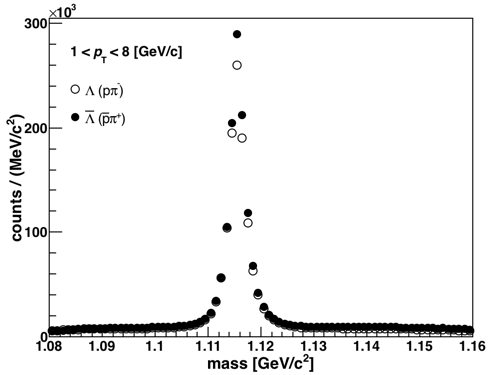
FIG. 2: The invariant mass distribution versus cos\theta^{*} for Lambda candidates in the jet near-side with 1< p_T < 8 GeV/c in this analysis as an example.
.png)
FIG. 3: The spin transfer $D _{TT}$ versus cos for a) $\Lambda$ and b) $\bar{\Lambda}$ hyperons, and c) the spin asymmetry $\delta_{TT}$ for the control sample of $K_S^0$ mesons versus cos/theta in the $p_T$ bin of (2,3) GeV/c for triggered combined sample. The red circles show the results for positive pseudo-rapidity $\eta$ with respect to the polarized beam and the blue squares show the results for negative $\eta$. Only statistical uncertainties are shown.
.png)
FIG. 4: The spin transfer $D_\mathrm{TT}$ for $\Lambda$ and $\bar{\Lambda}$ versus $p_\mathrm{T}$ in polarized proton-proton collisions at $\sqrt{s}=200\,\mathrm{GeV}$ at STAR, in comparison with model predictions for (a) positive $\eta$ and (b) negative $\eta$. The vertical bars and bands indicate the sizes of the statistical and systematic uncertainties, respectively. The $\bar{\Lambda}$ results have been offset to slightly larger $p_T$ values for clarity.
.png)
Tables:
TABLE I: Summary of selection cuts and the Λ and Λ̄ candidate counts and the residual background fractions in each pTbin. Here “DCA” denotes distance of closest approach, and N(σ) quantitatively measures the distance of a particle track to a certain particle band in dE/dx vs. rigidity space[28]. \ver{l} is representative of the vector from PV to Λ decay point and p⃗ is the reconstructed momentum of Λ.
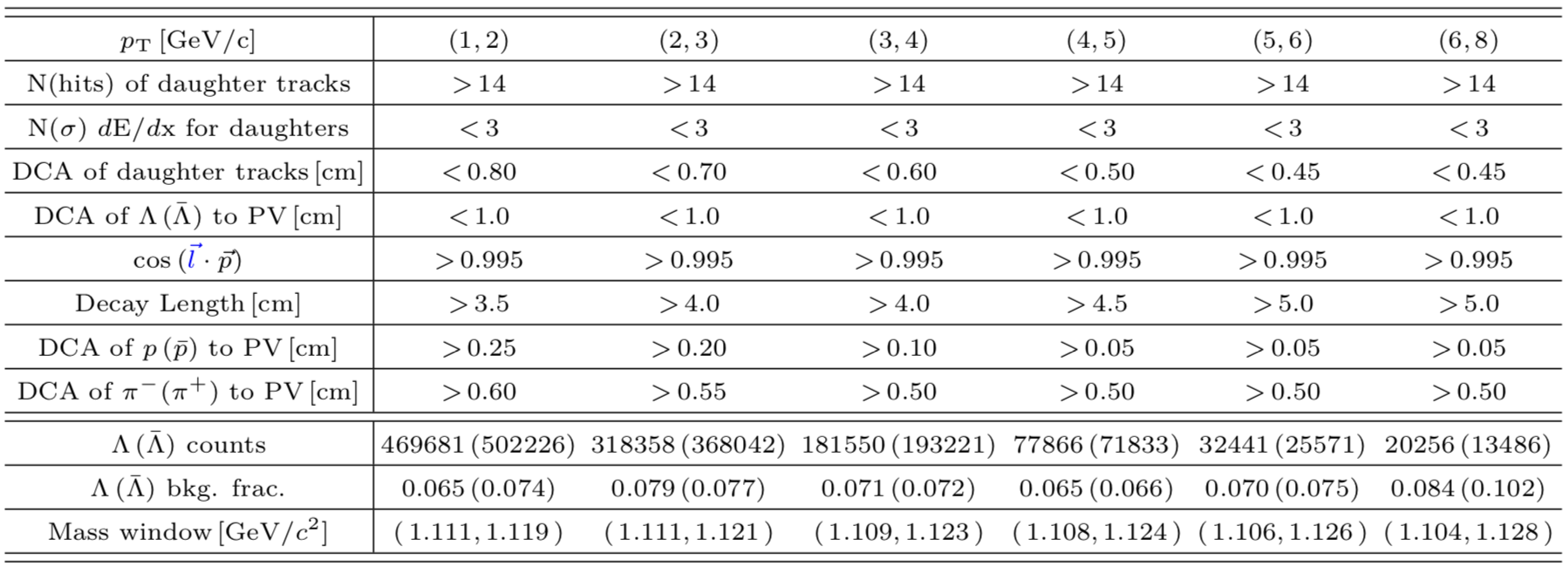
In summary, we report the first measurement on the transverse spin transfer, DTT, to Λ and Λ ̄ in transversely polarized proton-proton collisions at \sqrt{s} = 200 GeV at RHIC. The data correspond to an integrated luminosity of 18 pb−1 taken at STAR experiment in the year of 2012, which cover mid-rapidity, |η| < 1.2 and pT up to 8GeV/c. The DTT value and precision at the highest pT bin, where the effects are expected to be largest, are found to be DTT = 0.031 ± 0.033(stat.) ± 0.008(sys.) for Λ and DTT = −0.034 ± 0.040(stat.) ± 0.009(sys.) for Λ ̄ at ⟨η⟩ = 0.5 and ⟨pT⟩ = 6.7 GeV/c. The results for DTTare found to be consistent with zero for Λ and Λ̄ within uncertainties, and are also consistent with model predictions.
Paper draft history
Latest paper draft version: paperDraft modified with PRD referee
PWGC review
Collaboration review
Analysis Note:
Analysis Note Draft
Web links:
- Lambda reconstruction status
2, Statistics of Lambda and anti-Lambda Reconstruction, Jet near-side
- MC production and data comparison
2, MC and data comparison for inclusive hyperons
3, MC and data comparison for jet near-side hyperons
- Trigger Bias
1, Trigger bias parameters (fz_shift, feed-down fraction, fragmenting parton flavor fraction, subprocess fraction) plots
2, Uncertainty to D_TT from trigger bias
Presentations:
- DIS17
- SPIN2016
- May 16, 2017 Collaboration Meeting, Update of the systematic uncertainty
- Sep. 19, 2016 spinpwg meeting, Preliminary result request
- Nov. 10, 2017 PWGC Meeting
Main Analysis Code:
2012 Pi0 - Jet A_LL @ 500
2012 Pions in Jets A_UT @ 200 GeV
2012 dijet A_LL @ 500
2012/13 FMS A_LL @ 500 GeV
2013 Di-jet A_LL @ 500 GeV
A New Users Guide to PDSF Success
Credit goes to Kevin Adkins for the User's guide below:
With the current state of storage on RCF, several users are becoming regular users of PDSF. Anselm and others have requested that I write a short introduction to PDSF. So this blog will hold the keys for successful operation on PDSF. It will expand as issues are broght forth and addressed.
Getting started at PDSF:
1. Get your username at this website: https://nim.nersc.gov/nersc_account_request.php
Once you submit this form you will receive an email that includes a link. This link will only be valid for 72 hours, and will point you to a location where you can set your password. So don't postpone! If you have trouble the email will include a phone number to call, the staff is very helpful so don't hesitate to contact them.
2. Get logged in using the same terminal command as RCF:
ssh -Y username@pdsf.nersc.gov : where username, of course, will be your username.
3. When entering your password, you only have three chances. After your third chance you'll be "locked out" and you must call to have your password reset. To avoid the hassle, make your password something you can remember!
Storage disks at PDSF:
There are two disks that STAR-spin has access to on PDSF:
/eliza14/star/pwg/starspin/
/eliza17/star/pwg/starspin/
You must email Jeff Porter ( rjporter@bnl.gov ) with your username once you can log in. He will give you access to write on these disks. Once you have the access you can create yourself a folder to write your data to on one or both of the above disks.
Transferring data to PDSF:
PDSF has two Data Transfer Nodes (DTN) that are dedicated to the transfer of data at a high rate. These are
pdsfdtn1.nersc.gov
pdsfdtn2.nersc.gov
Transferring data is best with the rsync command. As an example, assume we have several subdirectories of jets stored in /star/data05/scratch/jkadkins/run12_Jets/ on RCF. To transfer this directory as is to the directory /eliza17/star/pwg/starspin/jkadkins/ on PDSF we would use:
rsync -r -v /star/data05/scratch/jkadkins/run12_Jets jkadkins@pdsfdtn1.nersc.gov:/eliza17/star/pwg/starspin/jkadkins/
Note that I left off the "/" at the end of the run12_Jets directory above. This means that we will copy all subdirectories to PDSF in the same structure. If the directory at PDSF doesn't exist, it will be created. If there is data already in a directory of the same name on PDSF then the new data will simply be added. If we had left "/" on the end of run12_Jets then we would have copied all files and subdirectories to /eliza17/star/pwg/starspin/jkadkins and not group it into a directory named run12_Jets on PDSF. Give it a test with a few files in a directory to see exactly how this works.
Note: Transferring large volumes of data takes time. To transfer ~90 gigs of data it will take ~60 minutes. So transferring large jet trees or something similar can take a really long time. It may be best to break it up into smaller segments that are more time manageable.
Running code on PDSF:
Code runs EXACTLY the same on PDSF as it does on RCF. PDSF has the same CVS code up to date as on RCF (I'm not sure how often it's updated, but it's all there). So if you use code in CVS on RCF, then you can also use it on PDSF. The only thing that changes is that PDSF doesn't support is the STAR development library. So when running you'll need to use "starpro" or another library.
Submitting jobs is also EXACTLY the same. You'll need an XML (if it works on RCF, it'll work on PDSF without changes) and you'll use the same star-submit command that you use on RCF. The changes come when you want to check the status of your jobs. The two most common commands to manage jobs are:
qstat -u username : Check the status of all jobs you have submitted
qdel -u username : Remove all jobs you currently have submitted
A full list of queue commands can be found here: http://www.nersc.gov/users/computational-systems/pdsf/using-the-sge-batch-system/monitoring-and-managing-jobs/
Finally, problems should be reported to the PDSF hypernews ( pdsf-hn@sun.star.bnl.gov ).
Analyses from the early years
(A) List of Physics Analysis Projects (obsolete)
| Who | Institution | Data | Topic |
|---|---|---|---|
| Jan Balewski | MIT | 2009 | W production |
| Michael Betancourt | MIT | 2009/6 | prompt gamma mid-rap A_LL/cross sec. |
| Alice Bridgeman | ANL | 2009 | EEMC gammas |
| Thomas Burton | Birmingham | 2006 | Lambda trans. pol. |
| Ramon Cendejas | UCLA/LBL | 2008 | di-jet cross section |
| Ross Corliss | MIT | 2006/9 | photons 1 |
| Pibero Djawotho | TAMU | 2009 | inclusive and di-jet |
| Xin Dong | LBL | ||
| Jim Drachenberg | TAMU | 2008 | FMS+FTPC jets Sivers/Collins |
| Len Eun | PSU | 2006/8 | eta SSA |
| Robert Fersch | Kentucky | 2009/6 | tbd /mid-rapidity jet Collins |
| Oleksandr Grebenyuk | LBL | 2009/6 | TBD/pi0 |
| Weihong He | IUCF | 2006 | EEMC pi0 |
| Alan Hoffman | MIT | 2005/6 | neutral pions A_LL |
| Liaoyuan Huo | TAMU | 2009 | inclusive and di-jet |
| Christopher Jones | MIT | 2009/6 | inclusive jets A_LL/cross section |
| Adam Kocoloski | MIT | 2005/6 | charged pions A_LL |
| Priscilla Kurnadi | UCLA | 2006 | non photonic electron A_LL |
| William Leight | MIT | 2009 | Mid-rapidity hadron production |
| Xuan Li | Shandong U | hyperons | |
| Brian Page | IUCF | 2009 | dijets |
| Donika Plyku | ODU | 2009 | Spin dep. in pp elastic scattering from pp2pp |
| Nikola Poljak | Zagreb | 2006/8 | Collins Sivers separation forward SSA |
| Tai Sakuma | MIT | 2005/6 | dijets cross section/A_LL |
| Joe Seele | MIT | 2009 | Ws and dijet cross section |
| Ilya Selyuzhenkov | IUCF | 2006-9 | Forward gamma-jet |
| David Staszak | UCLA | 2006 | Inclusive Jet A_LL |
| Justin Stevens | IUCF | 2010 | TBD |
| Naresh Subba | KSU | 2006 | Non-Photonic Elect. 1>eta>1.5 xsec |
| Matthew Walker | MIT | 2006/9 | dijets cross section/A_LL |
| Grant Webb | Kentucky | 2009/6 | mid-rap gamma or di-jet/ UEvent |
| Wei Zhou | Shandong U | hyperons | |
| Wei-Ming Zhang | KSU | 2008 | non-photonic electrons EEMC A_LL |
Common Analysis Trees
The Spin PWG maintains a set of trees connecting datasets from the various inclusive measurements in a way that allows for easy particle correlation studies. This page describes how to access the data in those trees.Location
RCF: /star/institutions/mit/common/run6/spinTree/PDSF: /auto/pdsfdv34/starspin/common/run6/spinTree/
Anywhere: root://deltag5.lns.mit.edu//Volumes/scratch/common/run6/spinTree/spinAnalyses_runnumber.tree.root
The last option uses xrootd to access read-only files stored on an MIT server from any computer with ROOT installed. If you have an Intel Mac note that ROOT versions 5.13.06 - 5.14.00 have a bug (patched in 5.14.00/b) that prevents you from opening xrootd files.
Interactive Mode
The basic trees are readable in a simple interactive ROOT session. Each particle type is stored in a separate tree, so you need to use TTree::AddFriend to connect things together before you draw. For example: root [1] TFile::Open("root://deltag5.lns.mit.edu//Volumes/scratch/common/run6/spinTree/spinAnalyses_7156028.tree.root"); root [2] .ls TXNetFile** root://deltag5.lns.mit.edu//Volumes/scratch/common/run6/spinTree/spinAnalyses_7156028.tree.root TXNetFile* root://deltag5.lns.mit.edu//Volumes/scratch/common/run6/spinTree/spinAnalyses_7156028.tree.root KEY: TProcessID ProcessID0;1 00013b6e-72c3-1640-a0e8-e5243780beef KEY: TTree spinTree;1 Spin PWG common analysis tree KEY: TTree ConeJets;1 this can be a friend KEY: TTree ConeJetsEMC;1 this can be a friend KEY: TTree chargedPions;1 this can be a friend KEY: TTree bemcPions;1 this can be a friend root [3] spinTree->AddFriend("ConeJets"); root [4] spinTree->AddFriend("chargedPions"); root [5] spinTree->Draw("chargedPions.fE / ConeJets.fE","chargedPions.fE>0") If you have the class definitions loaded you can also access member functions directly in the interpreter: root [6] spinTree->Draw("chargedPions.Pt() / ConeJets.Pt()","chargedPions.Pt()>0") Batch Mode
The StSpinTreeReader class takes care of all the details of setting branch addresses for the various particles behind the scenes. It also allows you to supply a runlist and a set of triggers you're interested in, and it will only read in the events that you care about. The code lives inStRoot/StSpinPool/StSpinTree
and in the macros directory is an example showing how to configure it. Let's look at the macro step-by-step:
//create a new reader StSpinTreeReader *reader = new StSpinTreeReader(); //add some files to analyze, one at a time or in a text file reader->selectDataset("$STAR/StRoot/StSpinPool/StSpinTree/datasets/run6_rcf.dataset"); //reader->selectFile("./spinAnalyses_6119039.tree.root"); Ok, so we created a new reader and told it we'd be using the files from Run 6 stored on RCF. You can also give it specfic filenames if you'd prefer, but there's really no reason to do so. //configure the branches you're interested in (default = true) reader->connectJets = true; reader->connectNeutralJets = false; reader->connectChargedPions = true; reader->connectBemcPions = true; reader->connectEemcPions = false; reader->connectBemcElectrons = false; //optionally filter events by run and trigger //reader->selectRunList("$STAR/StRoot/StSpinPool/StSpinTree/filters/run6_jets.runlist"); reader->selectRun(7143025); //select events that passed hardware OR software trigger for any trigger in list reader->selectTrigger(137221); reader->selectTrigger(137222); reader->selectTrigger(137611); reader->selectTrigger(137622); reader->selectTrigger(5); //we can change the OR to AND by doing reader->requireDidFire = true; reader->requireShouldFire = true; In this block we configured the reader to pick up the jets, chargedPions and BEMC pi0s from the files. We also told it that we only wanted to analyze run 7132001, and that we only cared about events triggered by BJP1, L2jet, or L2gamma in the second longitudinal running period. Finally, we required that one of those trigIds passed both the hardware and the software triggers.After that, the reader behaves pretty much like a regular TChain. The first time you call GetEntries() will be very slow (few minutes for the full dataset) as that's when the reader chains together the files and applies the TEventList with your trigger selection. Each of the particles is stored in a TClonesArray, and the StJetSkimEvent is accessible via reader->event().
StJetSkimEvent *ev = reader->event(); TClonesArray *jets = reader->jets(); TClonesArray *chargedPions = reader->chargedPions(); TClonesArray *bemcPions = reader->bemcPions(); long entries = reader->GetEntries(); for(int i=0; i What's Included?
Common trees are produced for both Run 5 and the 2nd longitudinal period of Run 6. Here's what available:Run 5
- skimEvent
- ConeJets
- chargedPions
- bemcPions
- skimEvent
- ConeJets12
- ConeJetsEMC
- chargedPions -- see (Data Collection)
- bemcPions
- bemcElectrons
Known Issues
The first time you read a charged pion (batch or interactive) you may see some messages like Error in <tclass::new>: cannot create object of class StHelix</tclass::new> These are harmless (somehow related to custom Streamers in the StarClassLibrary) but I haven't yet figured out how to shut them up.
42 runs need to be reprocessed for chargedPions in Run 5. Will do once Andrew gives the OK at PDSF.
40 runs need to be reprocessed for Run 6 because of MuDst problems. Murad has also mentioned some problems with missing statistics in the skimEvents and jet trees that we'll revisit at a later date.
Future Plans
Including EEMC pi0s and StGammaCandidates remains on my TO-DO list. I've also added into StJet a vector of trigger IDs fired by that jet. Of course we also need to get L2 trigger emulation into the skimEvent. As always, if you have questions or problems please feel free to contact me.Cuts Summary
Here's a list of the cuts applied to the data in the common spin trees.Run 5
Event- standard spinDB requirements
- production triggers only
- 0.2 < detEta < 0.8
- 0.1 < E_neu / E_tot < 0.9
- pt > 2
- -1 < eta < 1
- nFitPoints > 25
- |DCA_global| < 1
- -1 < nSigmaPion < 2
- pt > 3.0
- photon energies > 0.1
- asymmetry < 0.8
- 0.08 < mass < 0.25
- charged track veto
- BBC timebin in {7,8,9}
Run 6
Event- standard spinDB requirements
- production triggers + trigId 5 (L2gamma early runs)
chargedPions
- pt > 2
- -1 < eta < 1
- nFitPoints > 25
- |DCA_global| < 1
- -1 < nSigmaPion < 2
- pt > 5.2
- photon energies > 0.1
- asymmetry < 0.8
- 0.08 < mass < 0.25
- charged track veto
- BBC timebin in {7,8,9} update: timebin 6 added in 2007-07-18 production
- both SMD planes good
- hardware or software trigger in (117001, 137213, 137221, 5, 137222, 137585, 137611, 137622)
- Global dE/dx cut changing with momentum
- nFitPoints >= 15
- nDedxPoints >= 10
- nHits / nPoss >= 0.52
- track Chi2 < 4
- DCAGlobal < 2
- NEtaStrips > 1 && NPhiStrips > 1
- Primary dE/dx cut changing with momentum
- 0.3 < P/E < 1.5
- -0.01287 < PhiDist < 0.01345
- ZDist in [-5.47,1.796] (West) or [-2.706,5.322] (East)
Introduction at Spin PWG meeting - 5/10/07
I've been working on a project to make the datasets from the various longitudinal spin analyses underway at STAR available in a common set of trees. These trees would improve our ability to do the kind of correlation studies that are becoming increasingly important as we move beyond inclusive analyses in the coming years.In our current workflow, each identified particle analysis has one or more experts responsible for deciding just which reconstruction parameters and cuts are used to determine a good final dataset. I don't envision changing that. Rather, I am taking the trees produced by those analyzers as inputs, picking off the essential information, and feeding it into a single common tree for each run. I am also providing a reader class in StSpinPool that takes care of connecting the various branches and does event selection given a run list and/or trigger list.
Features
- Readable without the STAR framework
- Condenses data from several analyses down to the most essential ~10 GB (Run 6)
- Takes advantage of new capabilities in ROOT allowing fast fill/run/trigger selection
Included Analyses
- Event information using StJetSkimEvent
- ConeJets12 jets (StJet only)
- ConeJetsEMC jets (StJet only)
- charged pions (StChargedPionTrack)
- BEMC neutral pions (TPi0Candidate)
- EEMC neutral pions (StEEmcPair?) -- TODO
- electrons * -- TODO
- ...
Current Status
I'm waiting on the skimEvent reproduction to finish before releasing. I've got the codes to combine jets, charged pions, and BEMC pions, and I'm working with Jason and Priscilla on EEMC pions and BEMC electrons.EEMC Direct Photon Studies (Pibero Djawotho, 2006-2008)
Everything as a single pdf file (341 pages, 8.2Mb)
2006.07.31 First Look at SMD gamma/pi0 Discrimination
Pibero Djawotho
Indiana University
July 31, 2006
Simulation
Simulation were done by Jason for the SVT review.
Maximal side residual
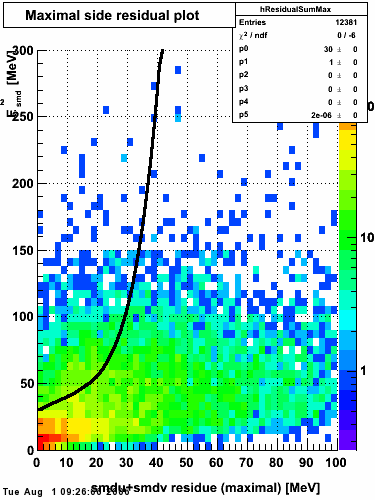 |
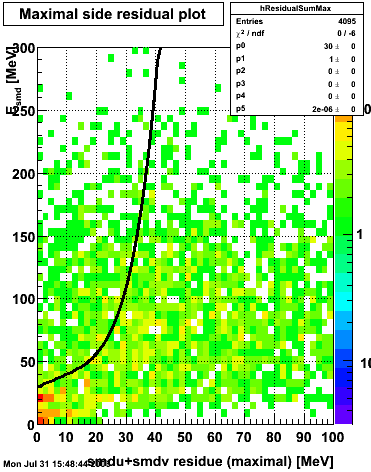 |
| Figure 1: Fitted peak integral vs. fit residual sum (U+V) from st_jpsi input stream (J/psi trigger only). | Figure 2: Fitted peak integral vs. fit residual sum (U+V) from st_physics input stream (all triggers except express stream triggers). |
xy distribution of SMD hits
The separation between photons and pions was achieved by using Les cut in the above figures where photons reside above the curve and pions below. The data set used is the st_jpsi express stream.
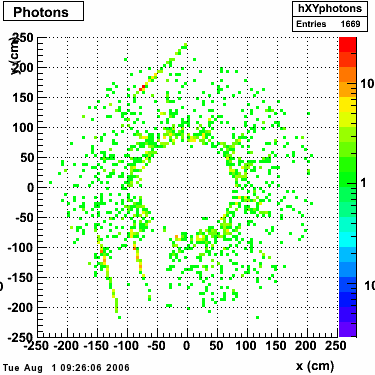 |
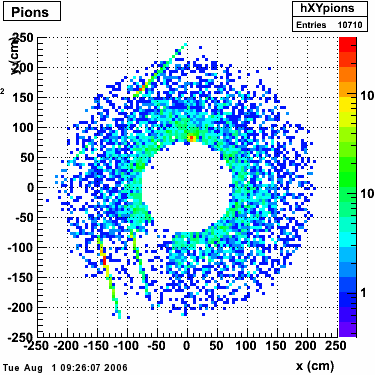 |
Single peak characteristics
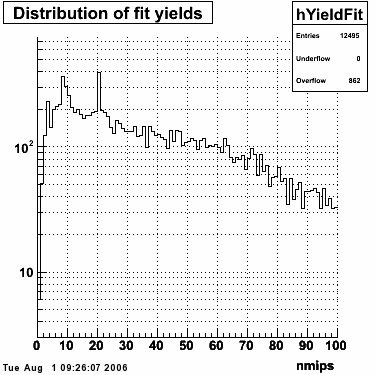 |
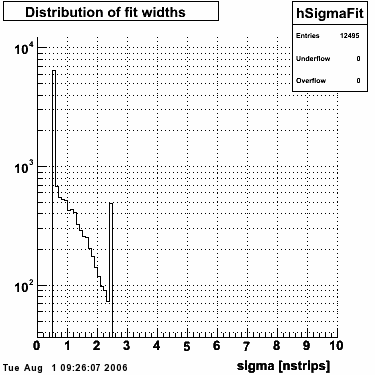 |
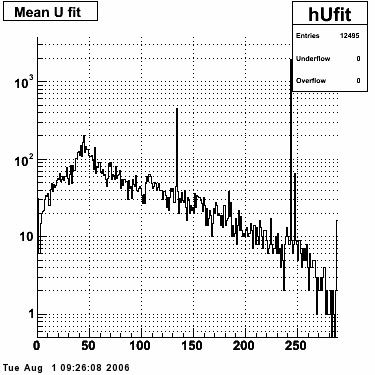 |
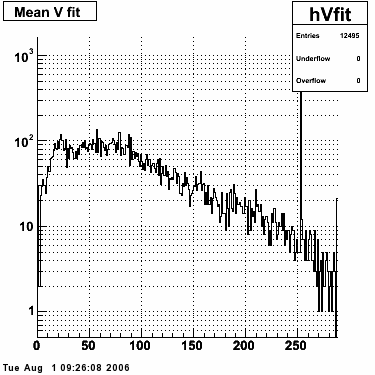 |
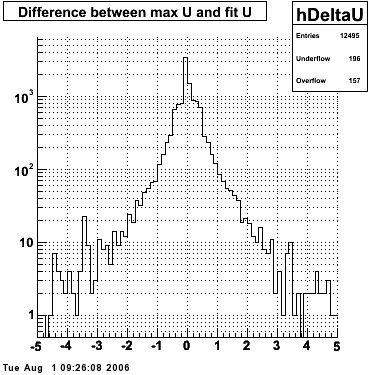 |
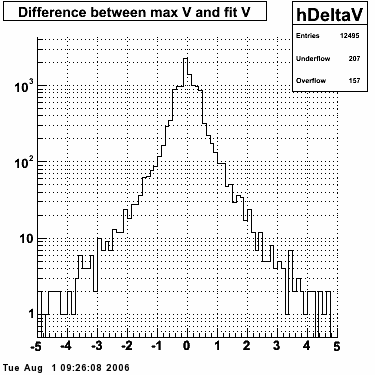 |
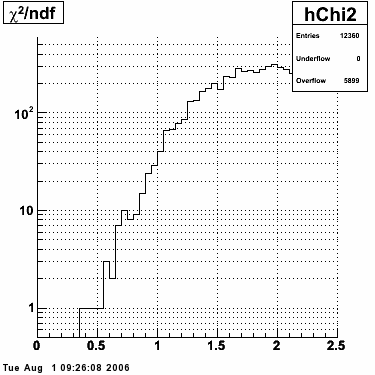 |
Fit function
The transverse profile of an electromagnetic shower in the SMD can be parametrized by the equation below in each SMD plane:

f(x) is the energy in MeV as a function of SMD strip x. The algorithm performs a simultaneous fit in both the U and V plane. The maximal residual (data - fit) is then calculated. A single photon in the SMD should be well descibed by the equation above and therefore will have a smaller maximal residual. A neutral pion, which decays into two photons, should exhibit a larger maximal residual. Typically, the response would be a double peak, possibly a larger peak and a smaller peak corresponding to a softer photon.
Single event SMD response
This directory contains images of single event SMD responses in both U and V plane. The file name convention is SMD_RUN_EVENT.png. The fit function for a single peak is the one described in the section above with 5 parameters:
- p0 = yield (P0), area under the peak in MeV
- p1 = mean (μ), center of peak in strips
- p2 = sigma of the first Gaussian (w1)
- p3 = fraction of the amplitude of the second Gaussian with respect to the first one (B), fixed to 0.2
- p4 = ratio of the width of the second Gaussian to the width of the first one (w2/w1), fixed to 3.5
Code
Documents
- Proposal to Contstruct an Endcap Calorimeter for Spin Physics at STAR
- Appendix Simulation Studies of Direct Photon Production at STAR
- An Endcap Calorimeter for STAR Conceptual Design Report
- The STAR Endcap Electromagnetic Calorimeter (EEMC NIM)
- An Endcap Calorimeter for STAR Technical Design Update #1
- Jan's gamma/pi0 algorithm
- Endcap Calorimeter Proposal (HTML @ IUCF)
- STAR Note 401: An Endcap Electromagnetic Calorimeter for STAR--Conceptual Design Report
- Spin Effects at Suppercollider Energies
2006.08.04 Second Look at SMD gamma/pi0 Discrimination
Second Look at SMD gamma/pi0 Discrimination
Pibero Djawotho
Indiana University
August 4, 2006
Dataset
The dataset used in this analysis is the 2005 p+p collision at √s=200 GeV with the endcap calorimeter high-tower-1 (eemc-ht1-mb = 96251) and high-tower-2 (eemc-ht2-mb = 96261) triggers.
The file catalog query used to locate the relevant files is:
get_file_list.pl -keys 'path,filename' -delim / -cond 'production=P05if, trgsetupname=ppProduction,filetype=daq_reco_MuDst,filename~st_physics, tpc=1,eemc=1,sanity=1' -delim 0
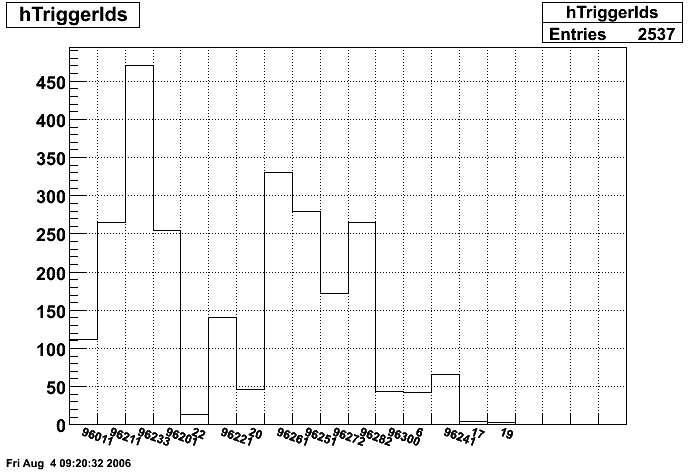
Results










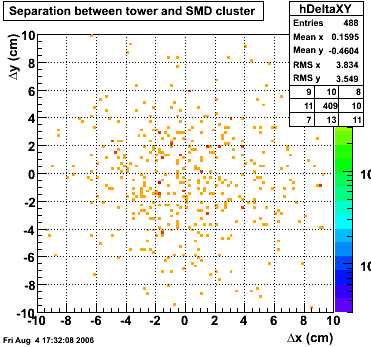
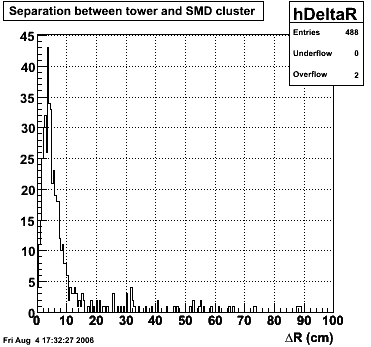
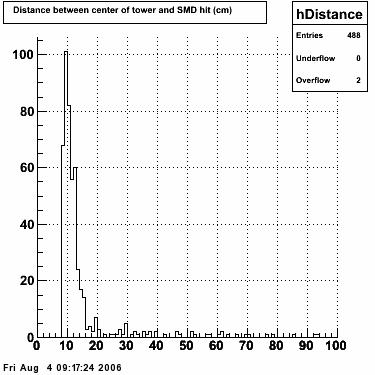
SMD U and V Fits
Code
2006.08.06 Comparison between EEMC fast and slow simulator
Comparison between EEMC fast and slow simulator
Pibero Djawotho
Indiana University
August 6, 2006
A detailed description of the EEMC slow simulator is presented at the STAR EEMC Web site.
The following settings were used in running the slow simulator:
//--
//-- Initialize slow simulator
//--
StEEmcSlowMaker *slowSim = new StEEmcSlowMaker("slowSim");
slowSim->setDropBad(1); // 0=no action, 1=drop chn marked bad in db
slowSim->setAddPed(1); // 0=no action, 1=ped offset from db
slowSim->setSmearPed(1); // 0=no action, 1=gaussian ped, width from db
slowSim->setOverwrite(1); // 0=no action, 1=overwrite muDst values
slowSim->setSource("StEvent");
slowSim->setSinglePeResolution(0.1);
slowSim->setNpePerMipSmd(2.0);
slowSim->setNpePerMipPre(3.9);
slowSim->setMipElossSmd(1.00/1000);
slowSim->setMipElossPre(1.33/1000);
EEMC Fast Simulator |
EEMC Slow Simulator |
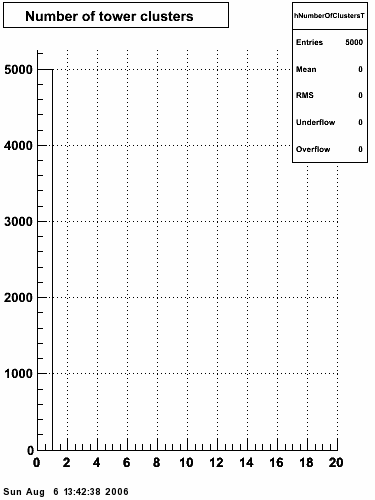 |
 |
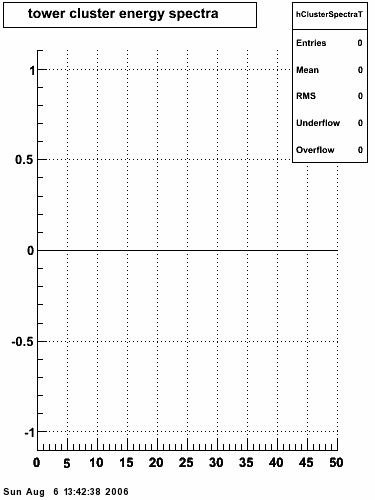 |
 |
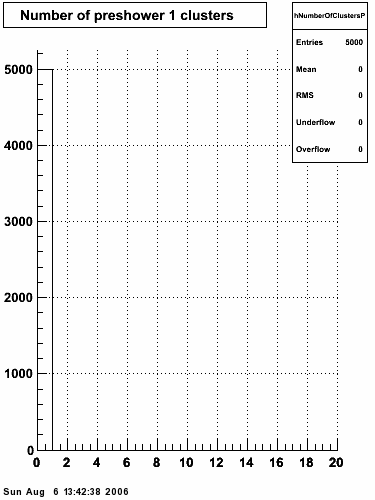 |
 |
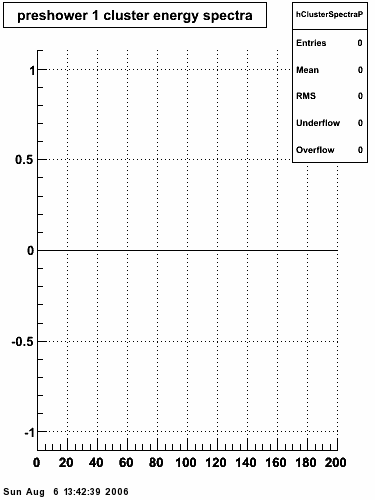 |
 |
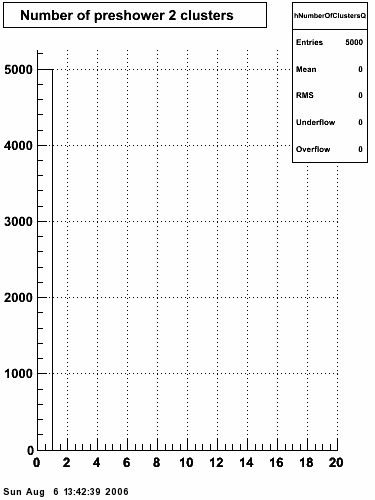 |
 |
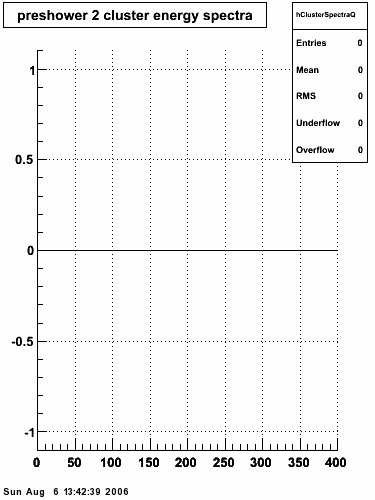 |
 |
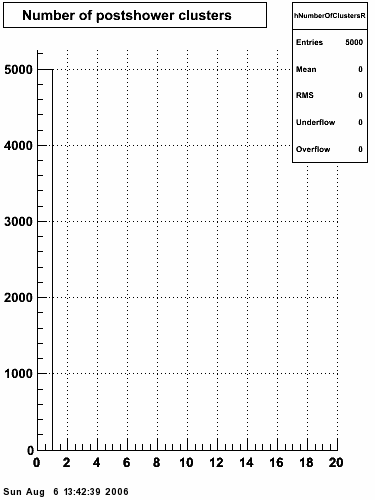 |
 |
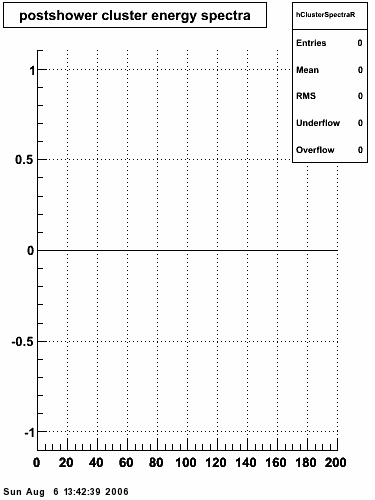 |
 |
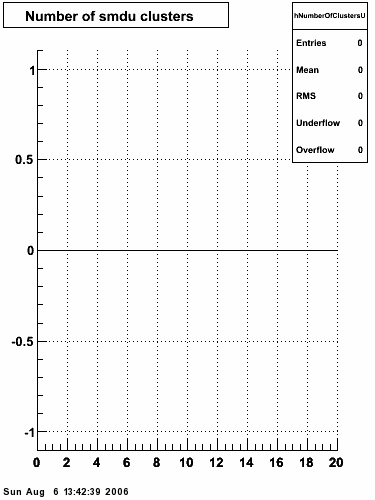 |
 |
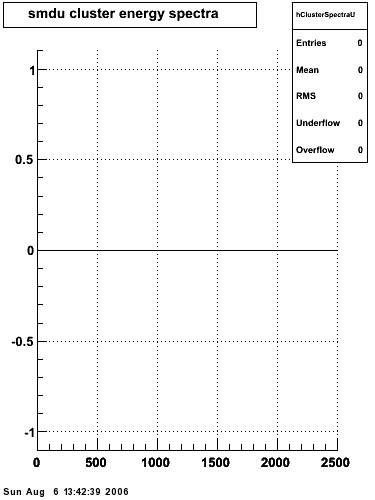 |
 |
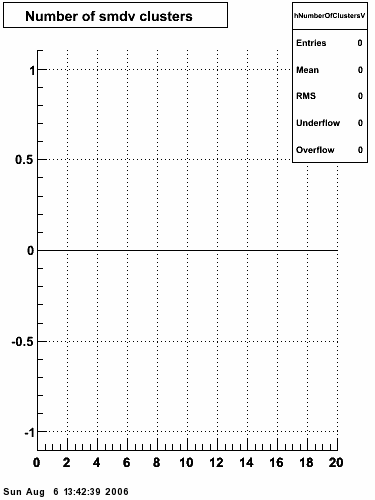 |
 |
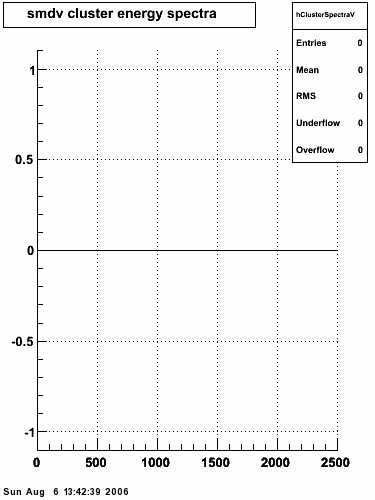 |
 |
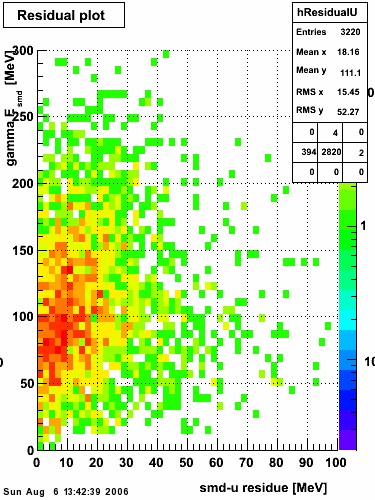 |
 |
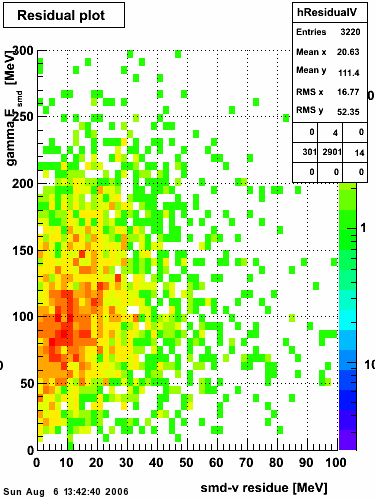 |
 |
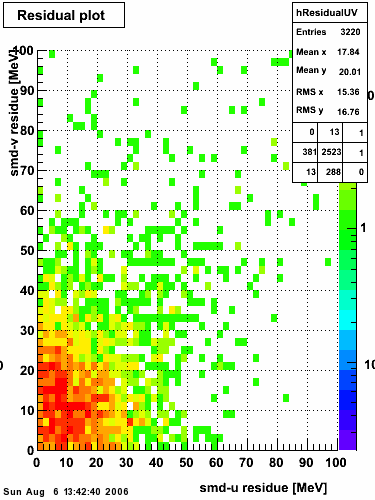 |
 |
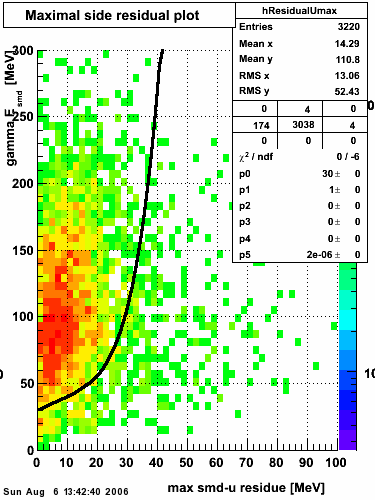 |
 |
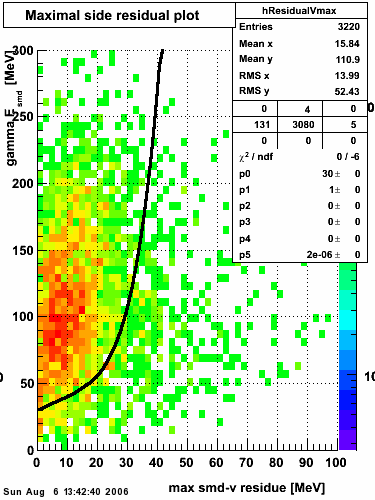 |
 |
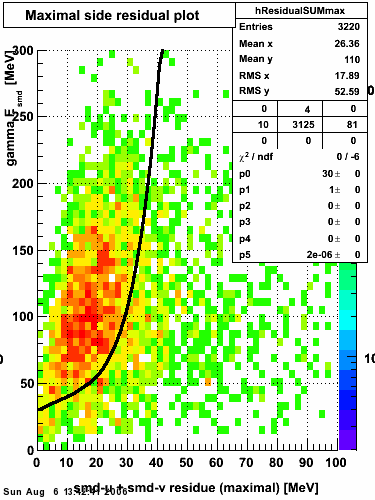 |
 |
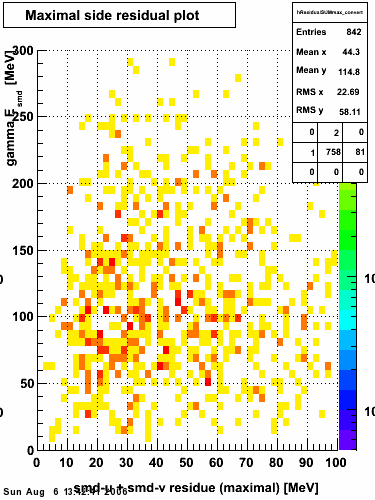 |
 |
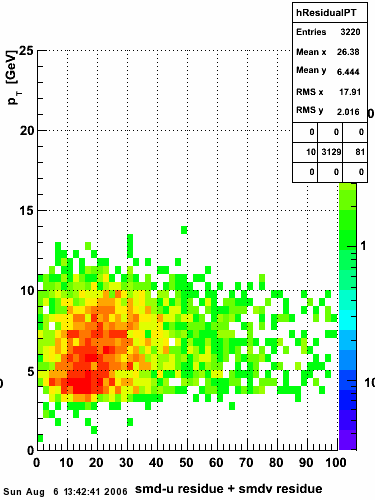 |
 |
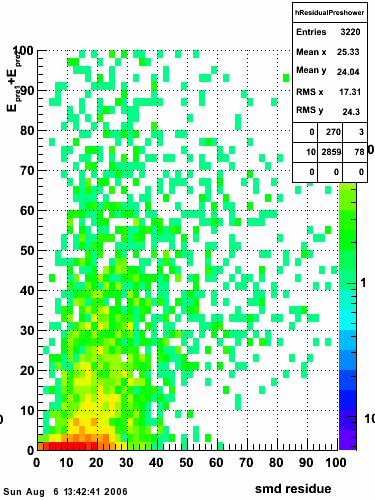 |
 |
 |
 |
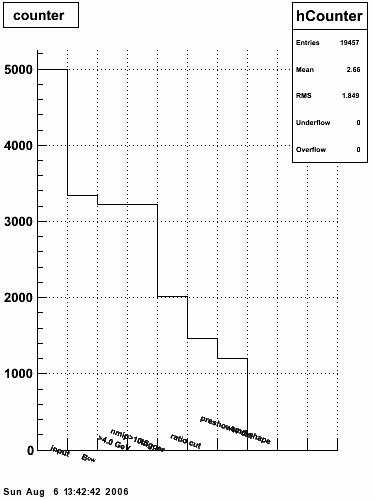 |
 |
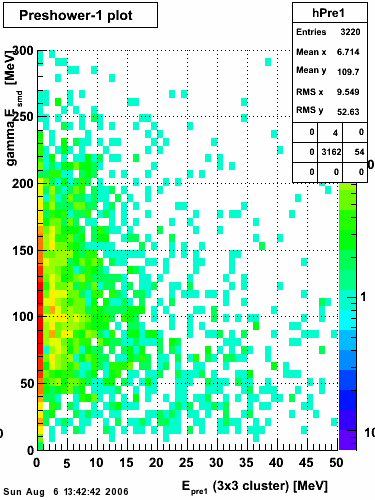 |
 |
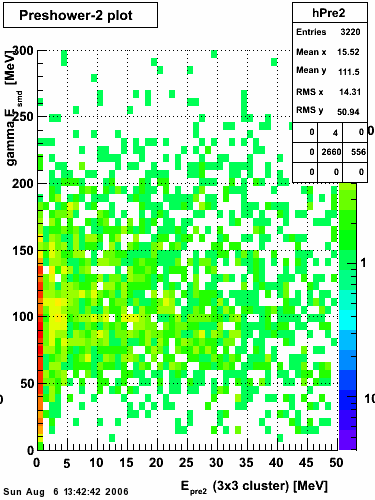 |
 |
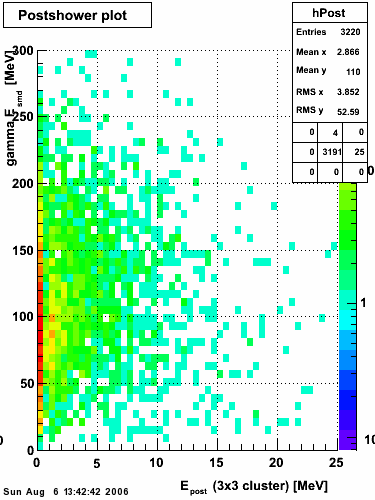 |
 |
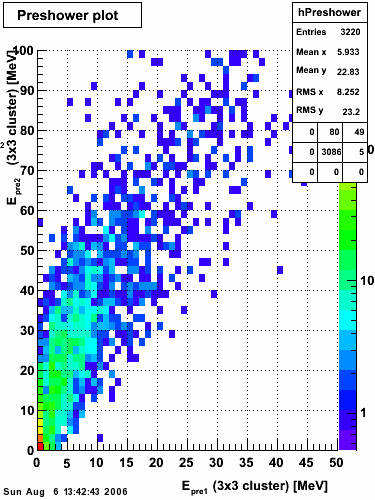 |
 |
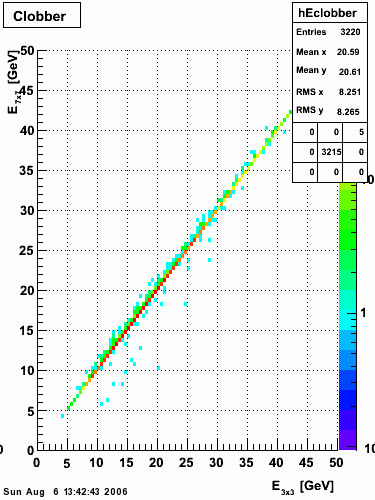 |
 |
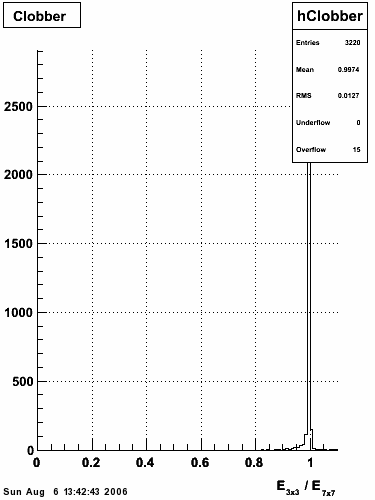 |
 |
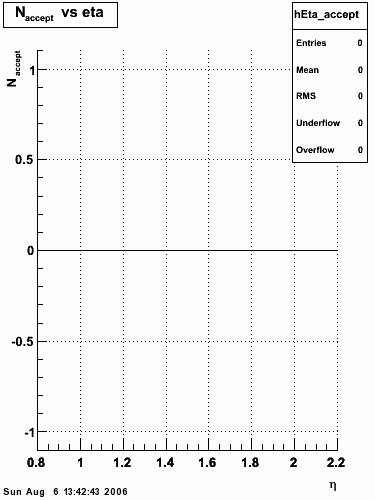 |
 |
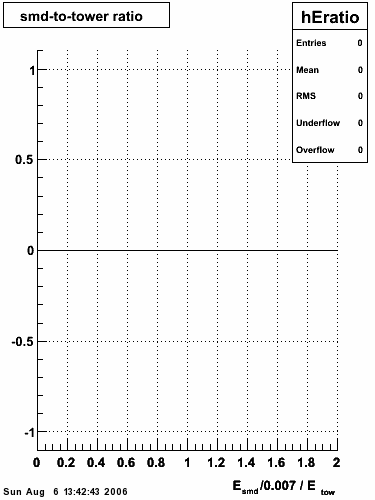 |
 |
 |
 |
 |
 |
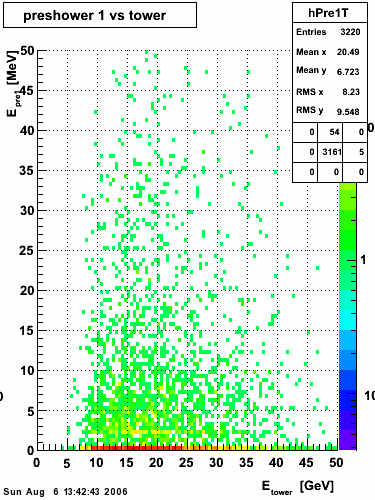 |
 |
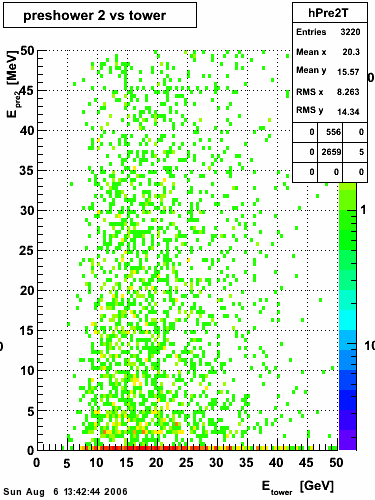 |
 |
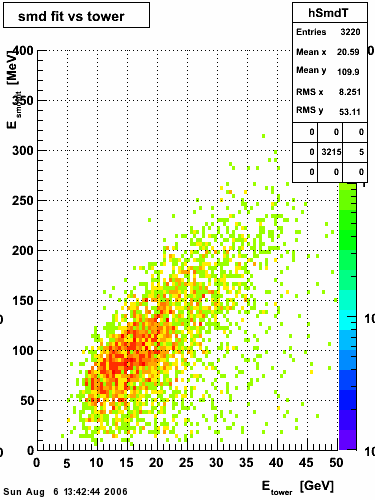 |
 |
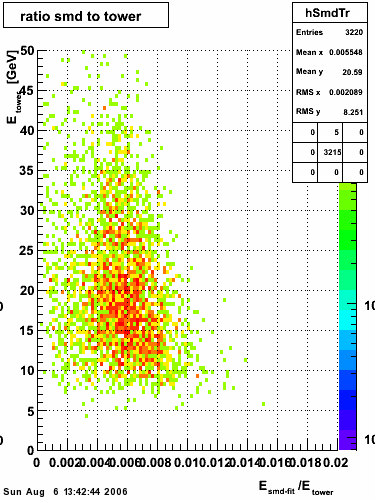 |
 |
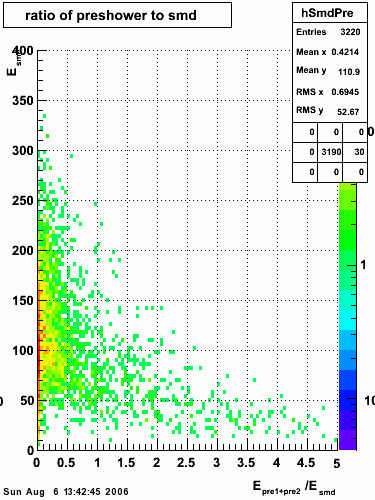 |
 |
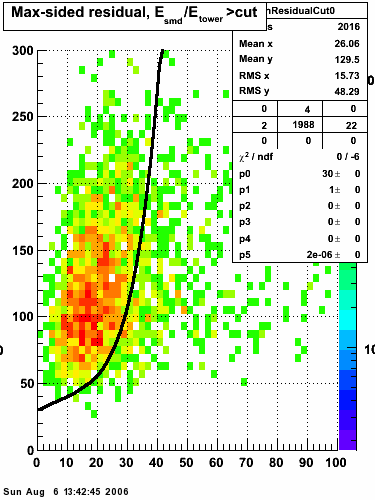 |
 |
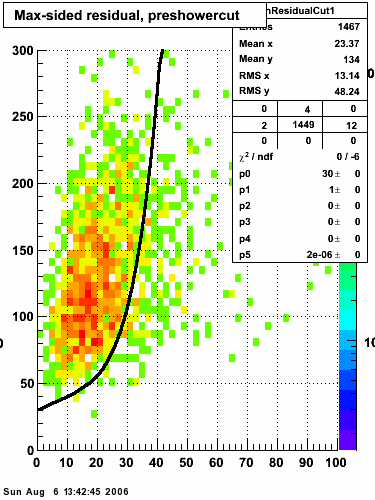 |
 |
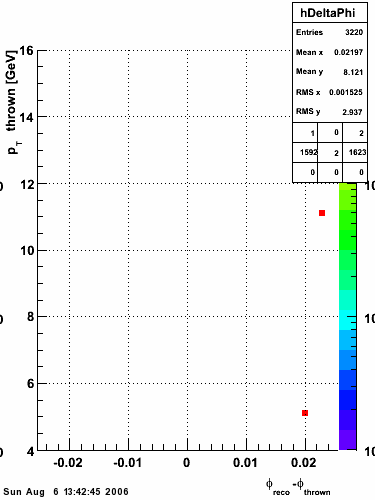 |
 |
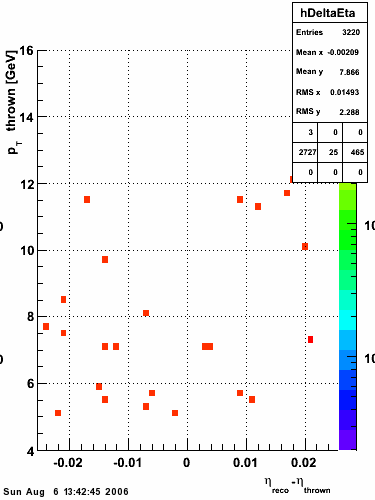 |
 |
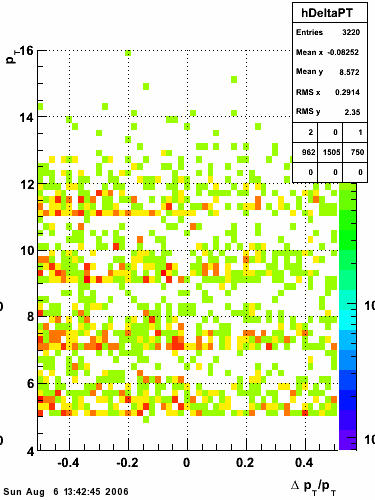 |
 |
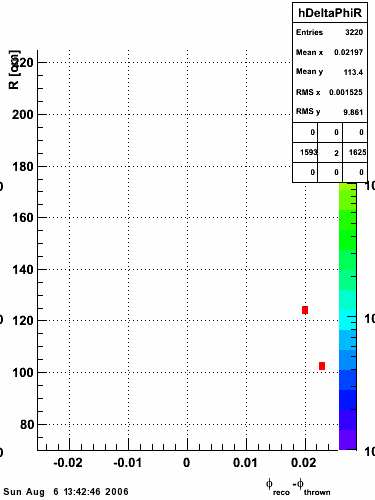 |
 |
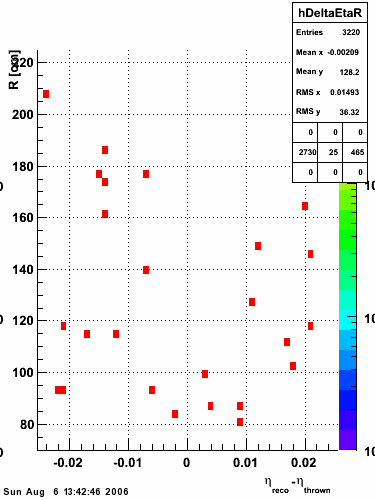 |
 |
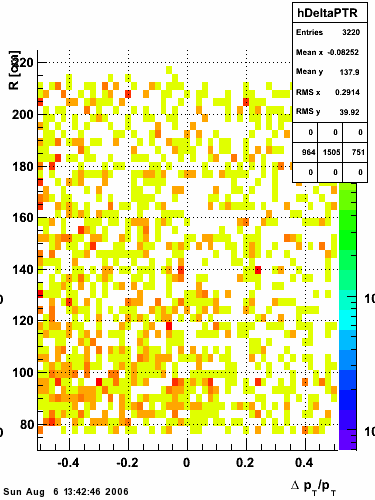 |
 |
 |
 |
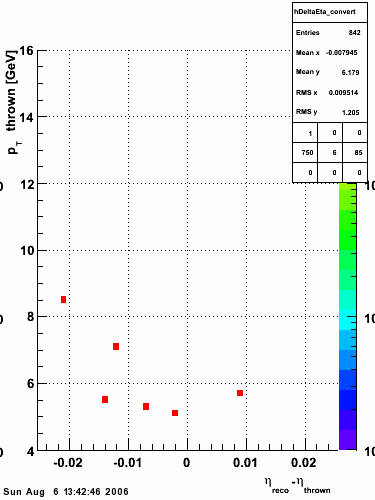 |
 |
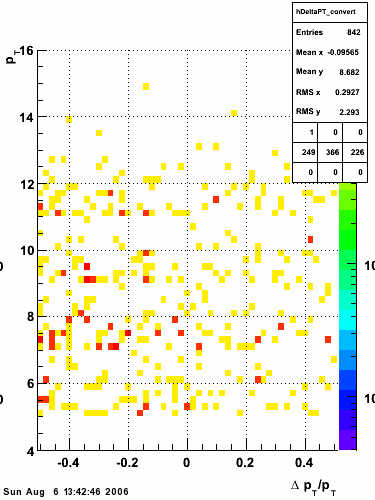 |
 |
 |
 |
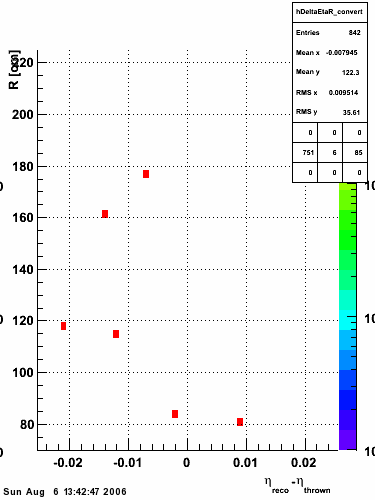 |
 |
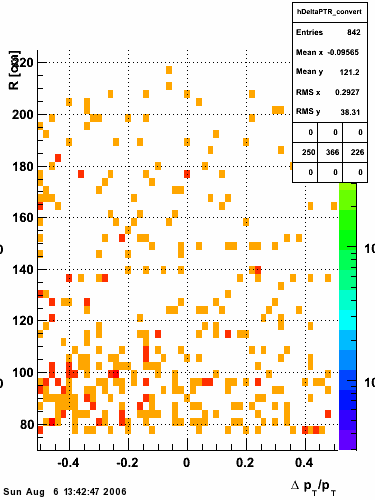 |
 |
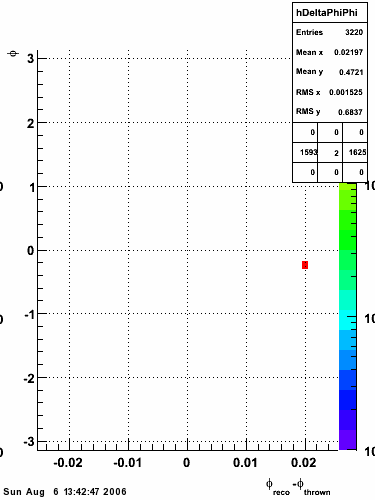 |
 |
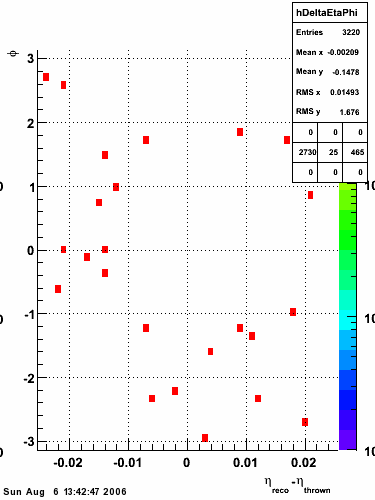 |
 |
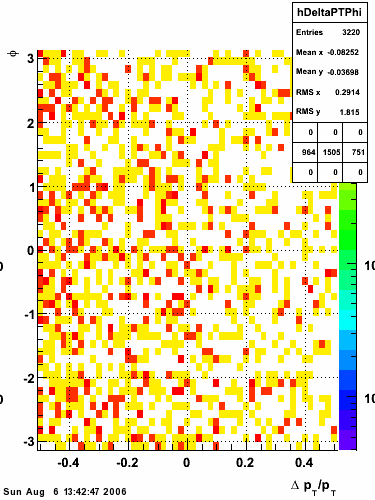 |
 |
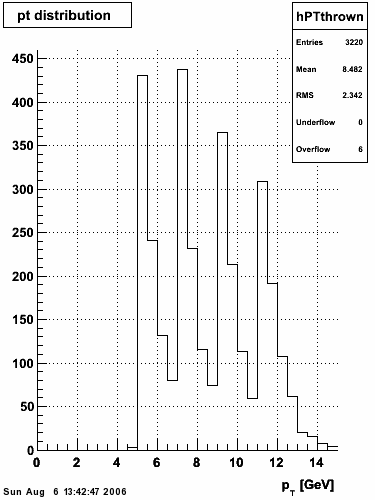 |
 |
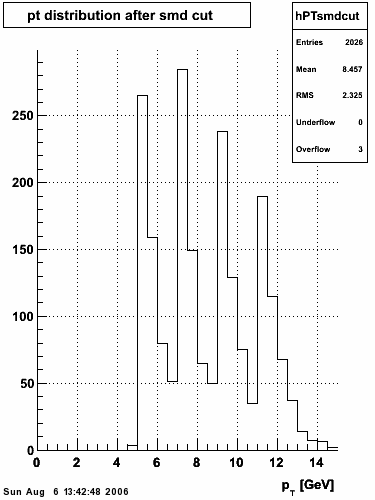 |
 |
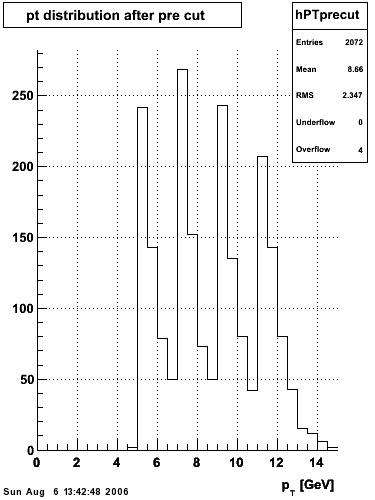 |
 |
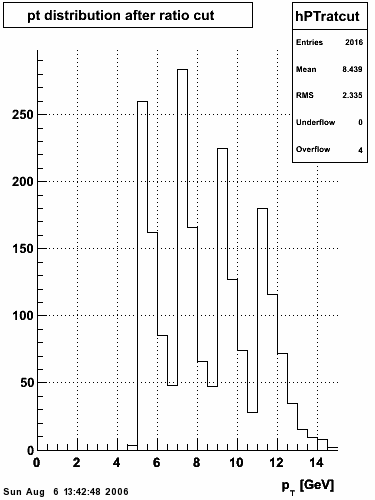 |
 |
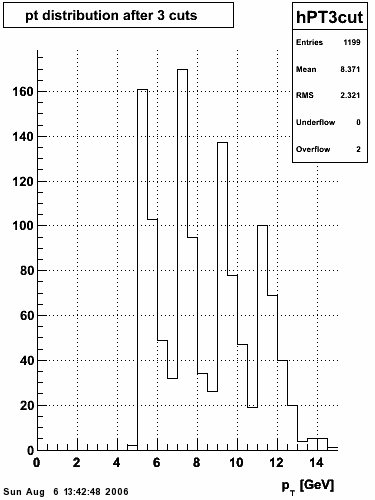 |
 |
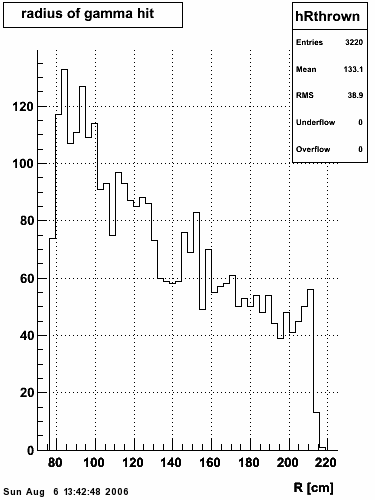 |
 |
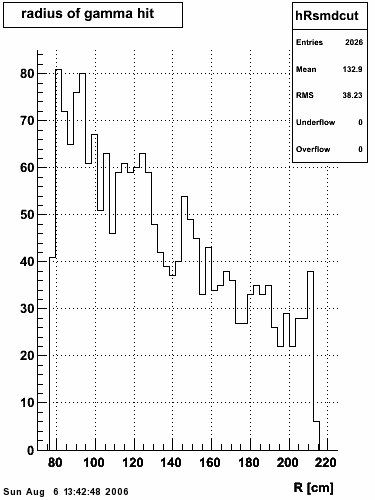 |
 |
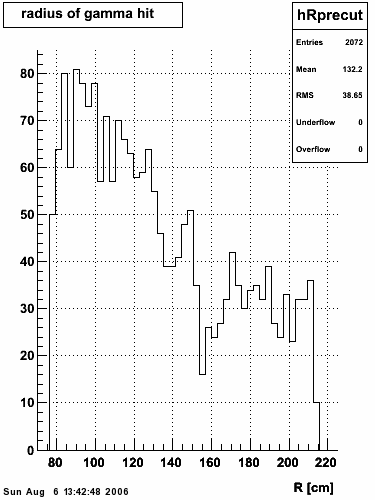 |
 |
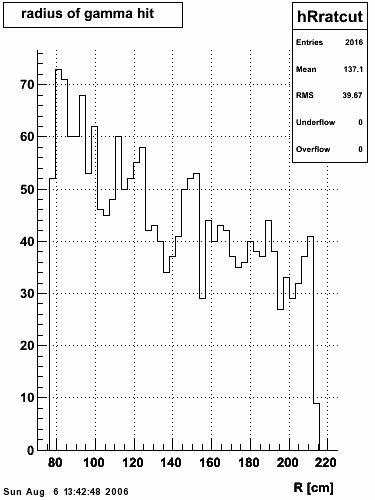 |
 |
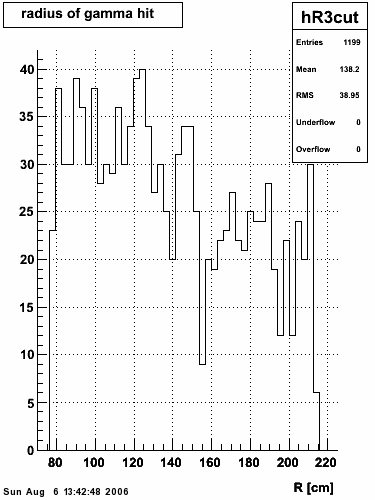 |
 |
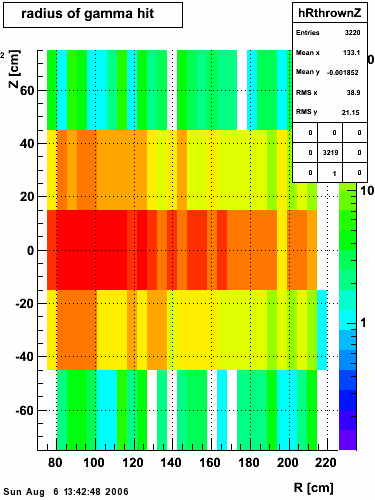 |
 |
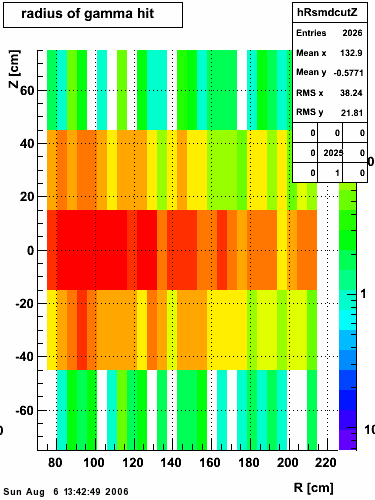 |
 |
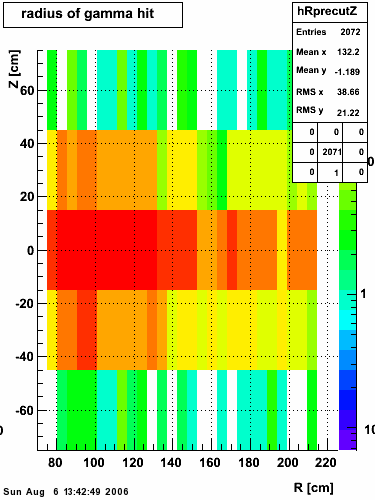 |
 |
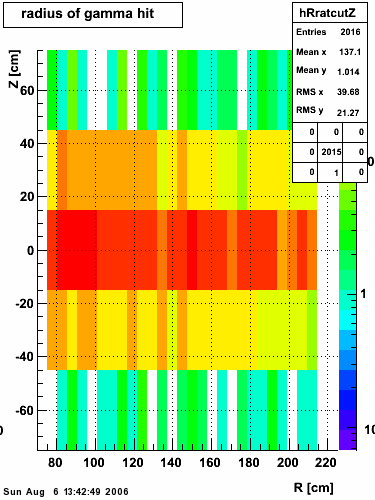 |
 |
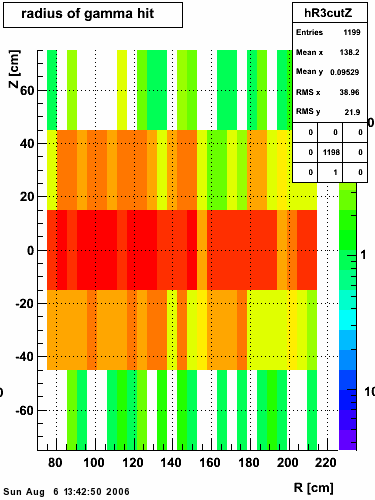 |
 |
 |
 |
 |
 |
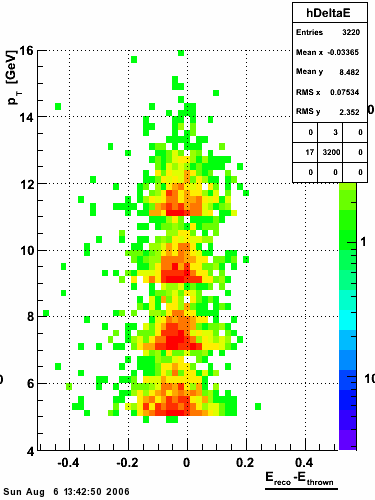 |
 |
 |
 |
 |
 |
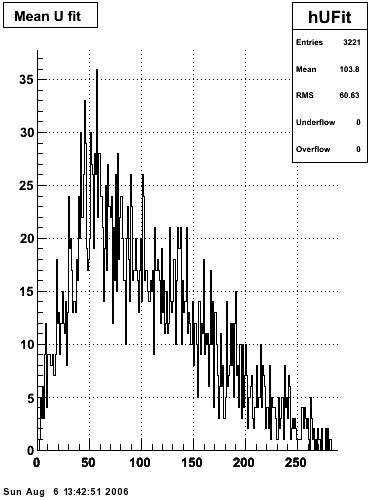 |
 |
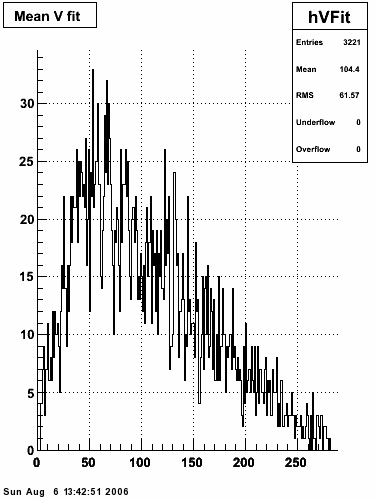 |
 |
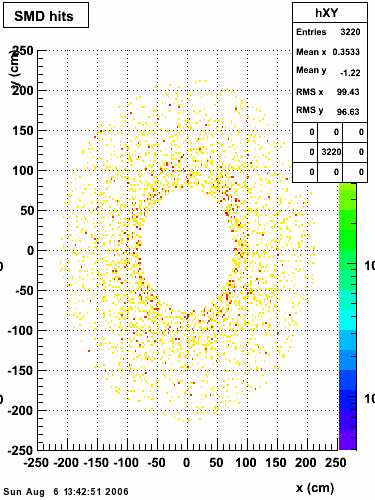 |
 |
 |
 |
2006.09.15 Fit Parameters
Fit Parameters
Fit Function

The plots that follow are sums of individual SMD responses in each plane centered around a common mean (here 0), over a +/-40 strips range. The convention for the parameters in the fits below is:
- p0=E -- area under the curve which represents energy in MeV
- p1=μ -- mean
- p2=σcore -- width of the narrow Gaussian
- p3=γ -- relative contribution of the wide Gaussian to the area/height
- p4=σtail -- width of the wide Gaussian
Simulation
The simulation is from single photons thrown at the EEMC with the following pT distribution:

The highest tower above 4 GeV in total energy is selected and the corresponding SMD sector fitted for peaks in both planes, where the area of the peaks in the U plane is constrained to be identical to that of the peak in the V plane. The peak is shifted to be centered at 0 where peaks from other events are then summed. The summed SMD response in each plane is displayed below:
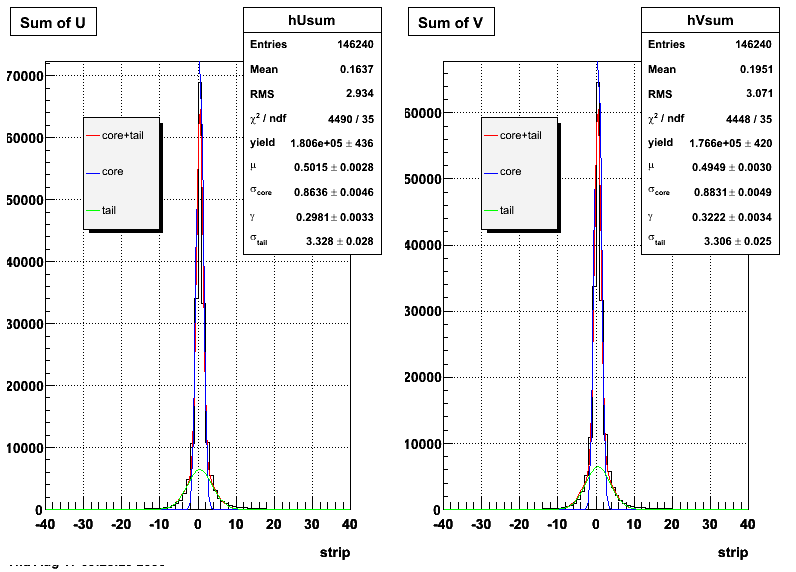
Ditto in log scale.
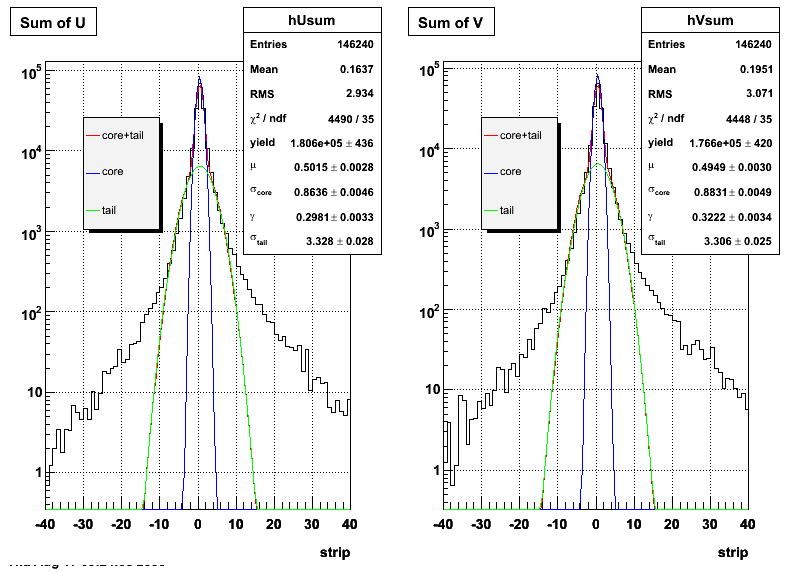
Ditto by sector.
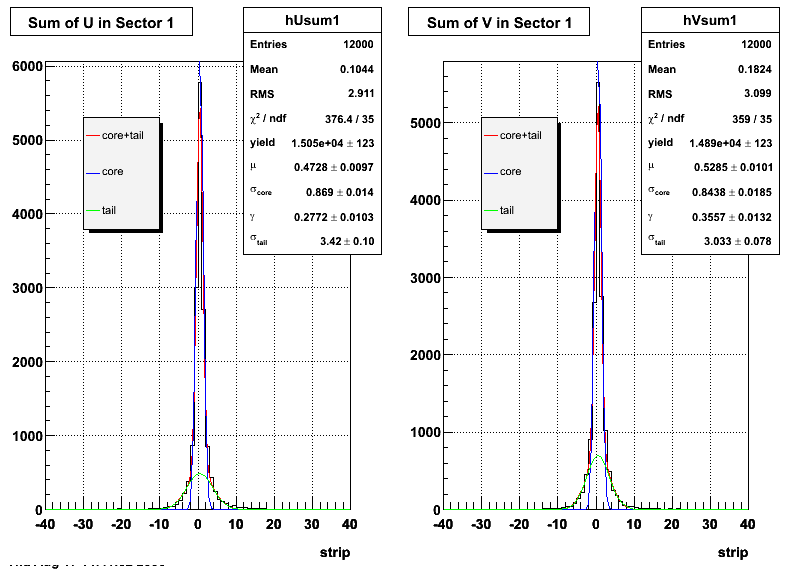 |
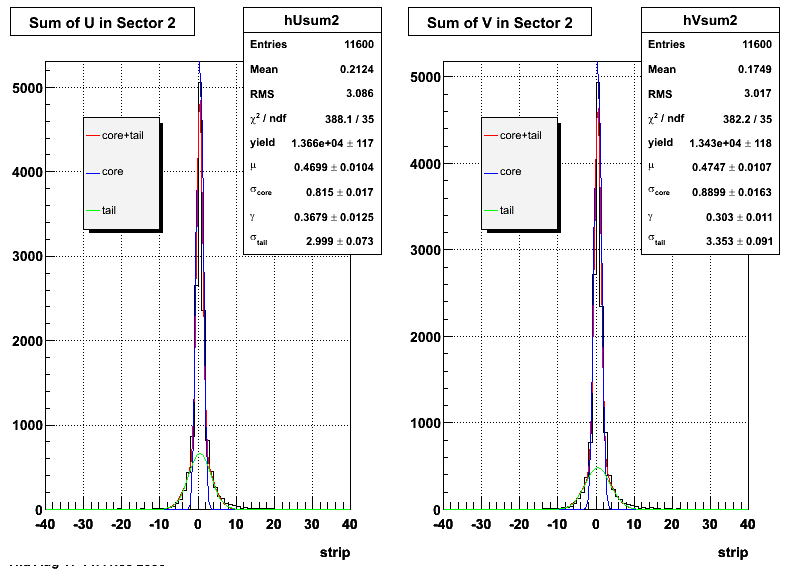 |
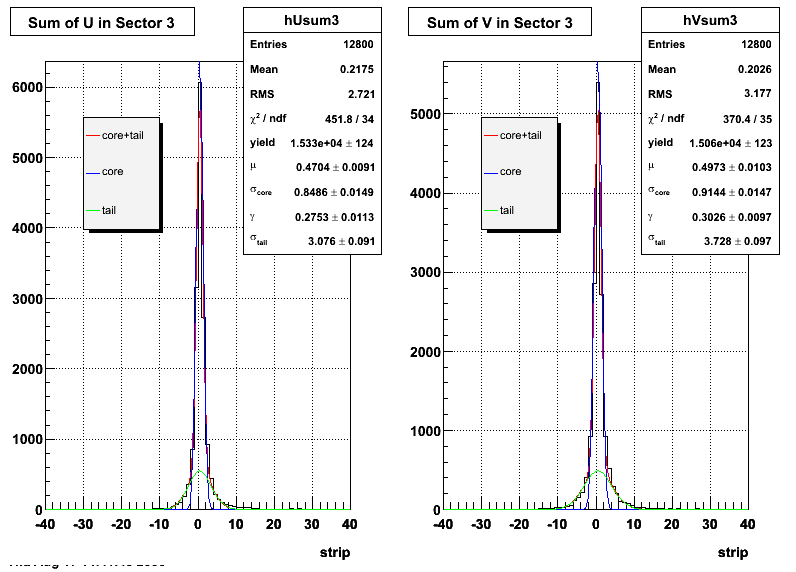 |
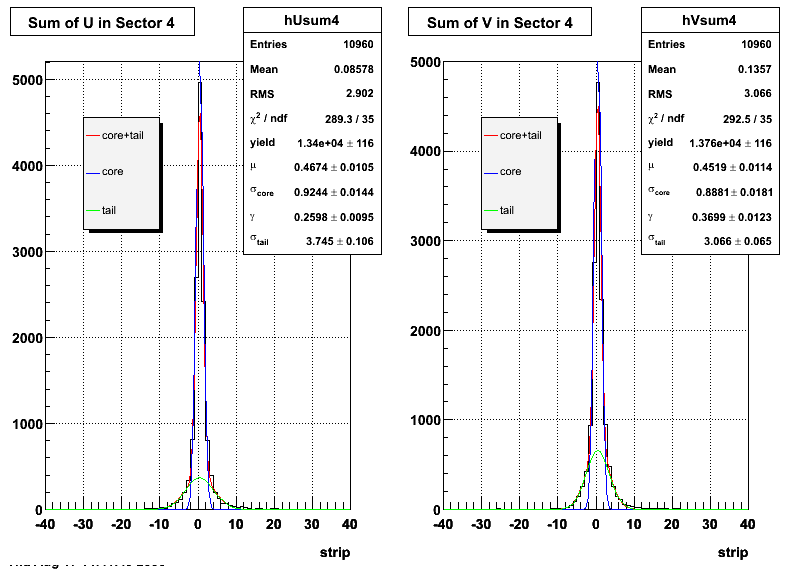 |
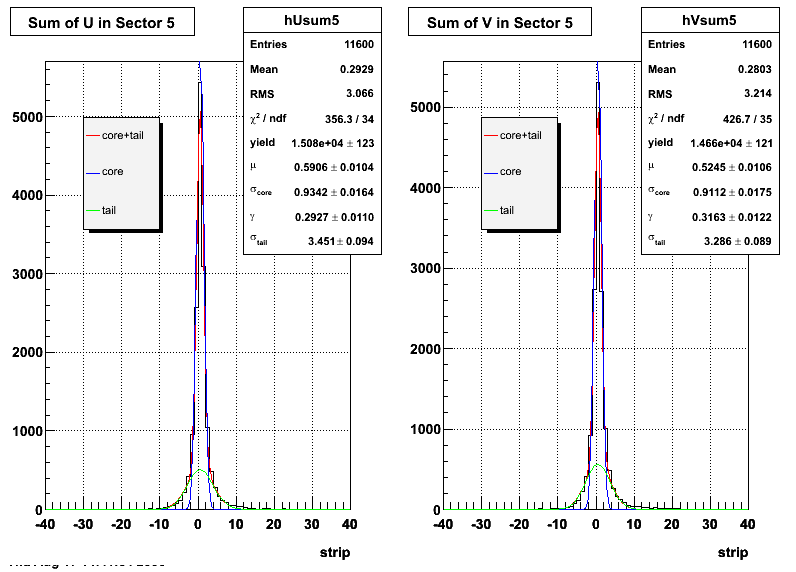 |
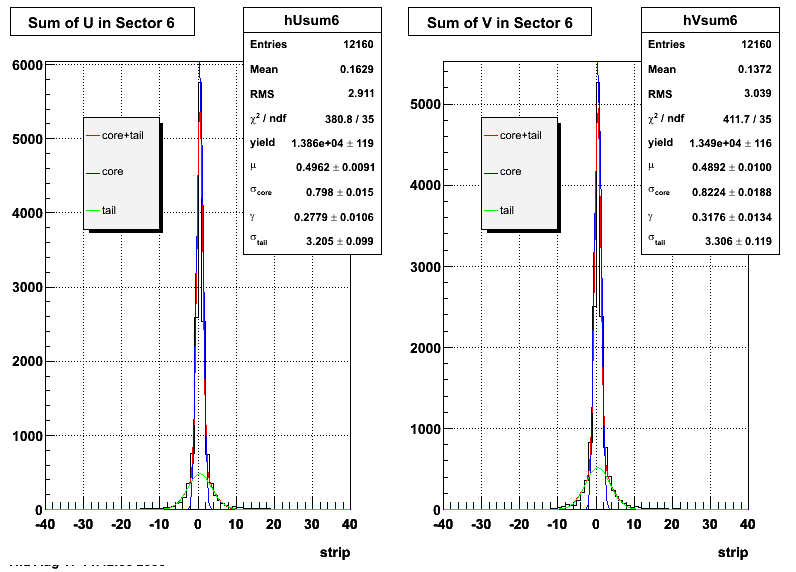 |
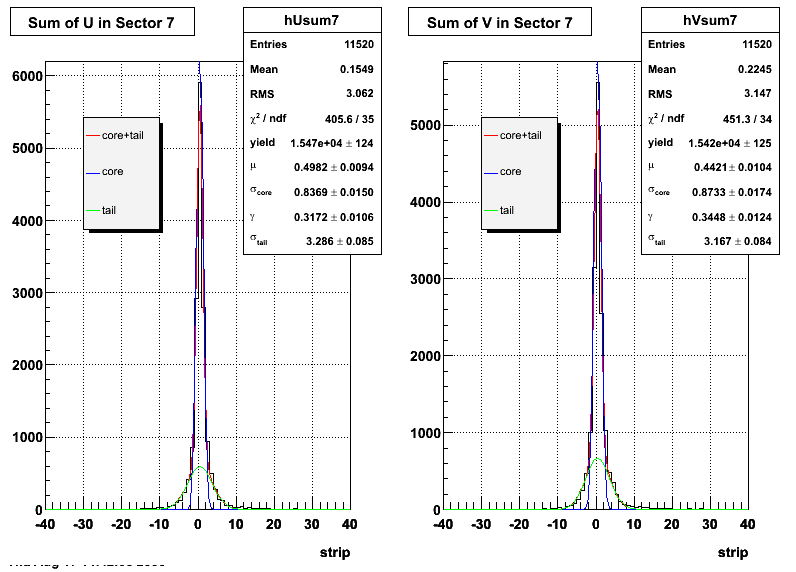 |
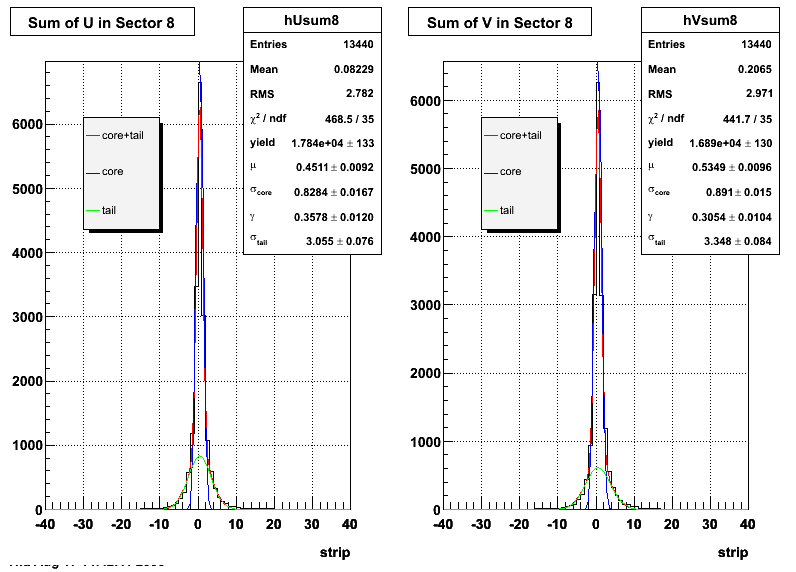 |
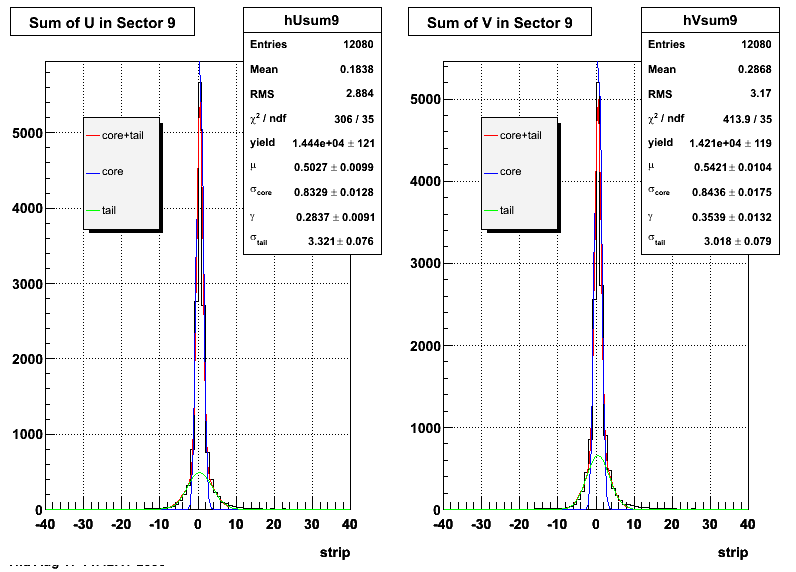 |
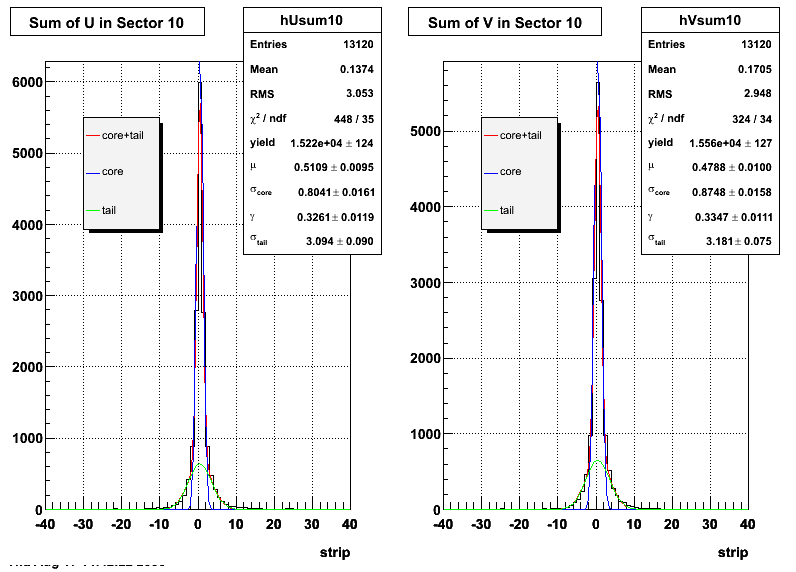 |
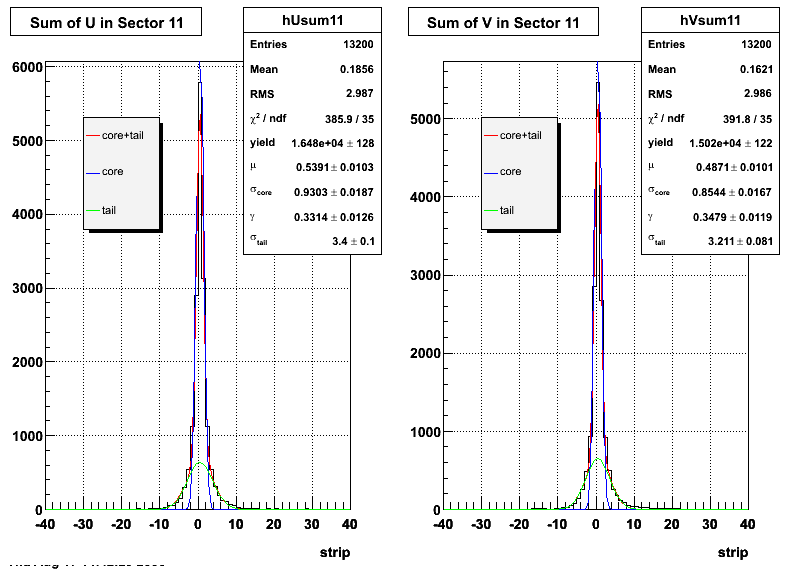 |
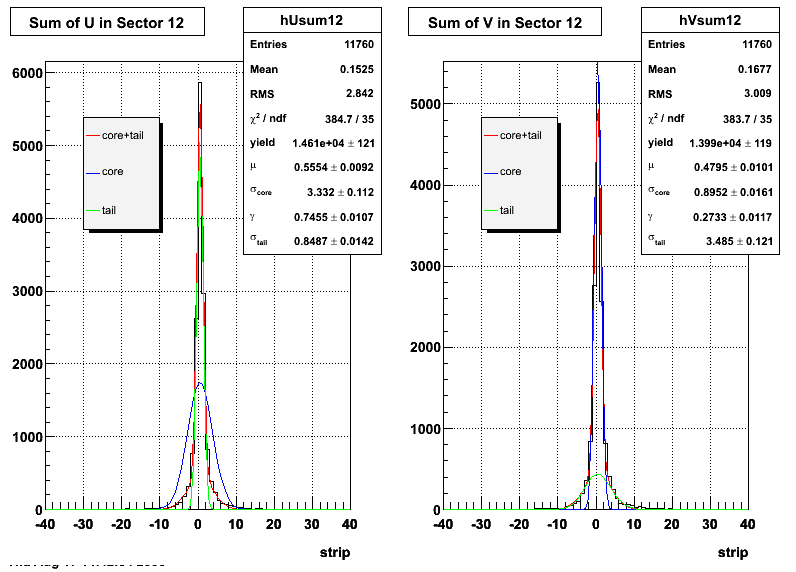 |
Fit Widths
| Sector # | SMD-u σcore | SMD-u σtail | SMD-v σcore | SMD-v σtail |
| Sector 1 | 0.869033 ± 0.0142868 | 3.42031 ± 0.10226 | 0.84379 ± 0.0185107 | 3.03287 ± 0.0775009 |
| Sector 2 | 0.814959 ± 0.0169271 | 2.99941 ± 0.0730426 | 0.889892 ± 0.0163065 | 3.35288 ± 0.0911979 |
| Sector 3 | 0.84862 ± 0.0148706 | 3.07648 ± 0.0909689 | 0.914377 ± 0.014706 | 3.72821 ± 0.0966915 |
| Sector 4 | 0.924398 ± 0.0144207 | 3.74458 ± 0.10611 | 0.888146 ± 0.0180771 | 3.06618 ± 0.0647075 |
| Sector 5 | 0.934218 ± 0.0163887 | 3.45149 ± 0.0944309 | 0.911209 ± 0.0175273 | 3.28633 ± 0.0890581 |
| Sector 6 | 0.797976 ± 0.0148133 | 3.20464 ± 0.0986085 | 0.822437 ± 0.018835 | 3.30595 ± 0.118813 |
| Sector 7 | 0.836936 ± 0.0150085 | 3.28589 ± 0.0853598 | 0.873338 ± 0.0173883 | 3.16654 ± 0.0838938 |
| Sector 8 | 0.828403 ± 0.0167005 | 3.05517 ± 0.075584 | 0.891045 ± 0.0152102 | 3.34806 ± 0.0836394 |
| Sector 9 | 0.832881 ± 0.0127855 | 3.3214 ± 0.0762928 | 0.8436 ± 0.0175466 | 3.0183 ± 0.079444 |
| Sector 10 | 0.804059 ± 0.0160906 | 3.0943 ± 0.0897946 | 0.874845 ± 0.015788 | 3.18113 ± 0.0748357 |
| Sector 11 | 0.930286 ± 0.0187086 | 3.40024 ± 0.0951671 | 0.854395 ± 0.0167265 | 3.21076 ± 0.0812402 |
| Sector 12 | 3.33227 ± 0.111911 | 0.848668 ± 0.0142344 | 0.895174 ± 0.0160939 | 3.48527 ± 0.12061 |
Data from 2005 pp200 EEMC HT 1 and 2 triggers
In this sample, high tower triggers, eemc-ht1-mb (96251) and eemc-ht2-mb (96261), from the 2005 p+p at √s=200 GeV ppProduction are selected. The highest tower above 4 GeV is chosen and the corresponding SMD sector is searched for peaks in both planes. Peaks from several events are summed together taking care of shifting them around to have a common mean.
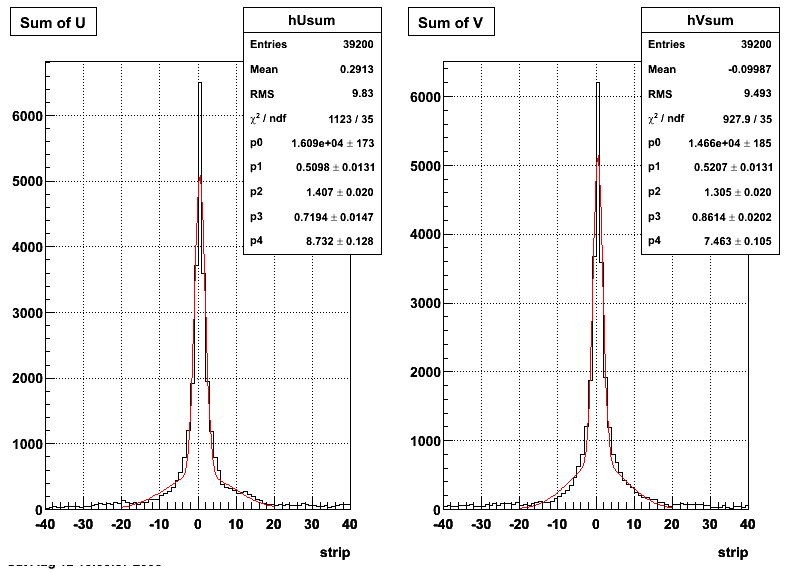
Ditto in log scale.
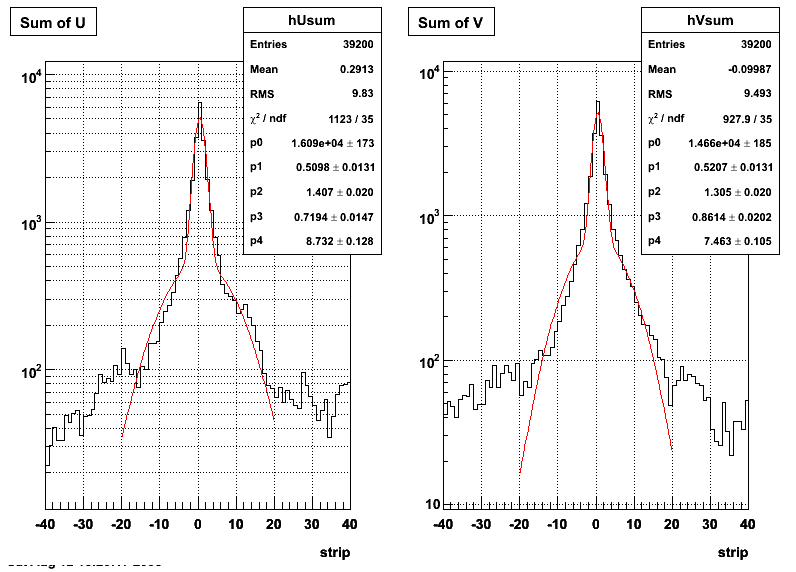
Data from 2005 pp200 electrons
Here, I try to pick a representative sample of electrons from the 2005 pp200 dataset. The cuts used to pick out electrons are:
- Epreshower1 > 5 MeV
- Epreshower2 > 5 MeV
- 0.75 < p/Etower < 1.25
- 3 < dE/dx < 4 keV/cm
The selection for electrons is illustrated in the dE/dx plot below, where the pions should be on the left and the electrons on the right.
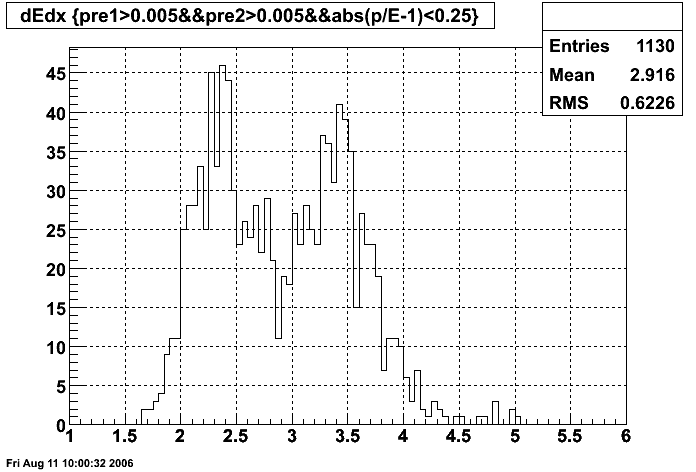
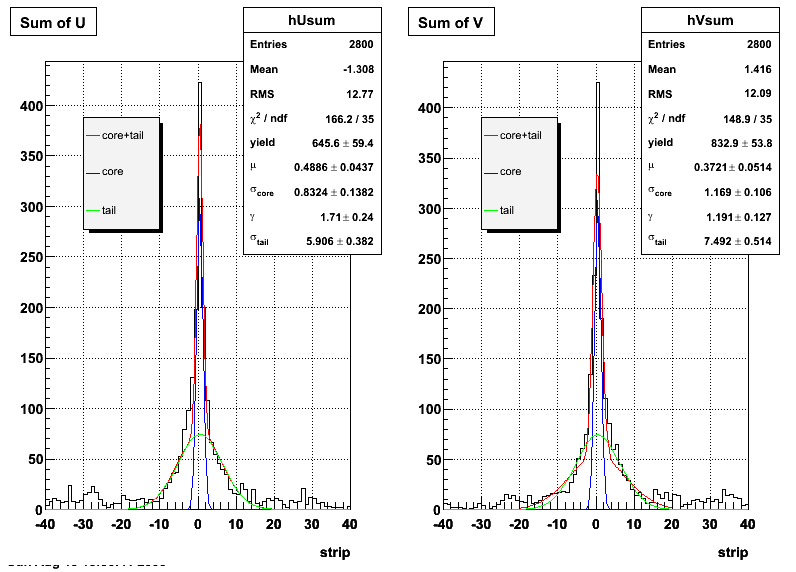
Pibero Djawotho Last modified Tue Aug 15 10:41:19 EDT 2006
2007.02.05 Reconstructed/Monte Carlo Photon Energy
Reconstructed/Monte Carlo Photon Energy
This study is motivated by Weihong's photon energy loss study where an eta-dependence of reconstructed photon energy to generated photon energy in EEMC simulation was observed.
In this study, the eta-dependence is investigated by running the EEMC slow simulator with the new readjusted weights for the preshower and postshower layers of the EEMC. Details on this are here.
- Fit to a constant
- Fit to a line
- Fit to a quadratic
- Comparison between Weihong's and Pibero's results
- Constant
- Linear
- Quadratic
- Conclusion
- References
- M. Albrow et al., NIM A 480 (2002) 524-546.
- R. Blair et al. (CDF Collaboration), CDF II Technical Design Report, FERMILAB-PUB-96-390-E, 1996.



The parameters from the fits are used to plot the fit functions for comparison between Weihong's and Pibero's results.


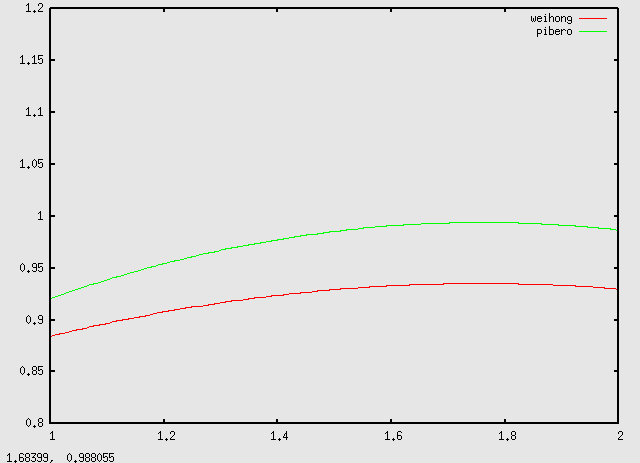
While the adjusted weights for the different EEMC layers contribute to bringing the ratio of reconstructed energy to generated energy closer to unity, they do not remove the eta-dependence.
Pibero Djawotho Last updated Mon Feb 5 10:10:42 EST 2007
2007.02.08 E_reco / E_mc vs. eta
E_reco / E_mc vs. eta
Legend
- black curve: before EEMC slow simulator
- red curve: after EEMC slow simulator
Jason's Monte Carlo
- 4.4k single gamma's
- No SVT
- Nominal vertex
- Flat in pt 4-12 GeV
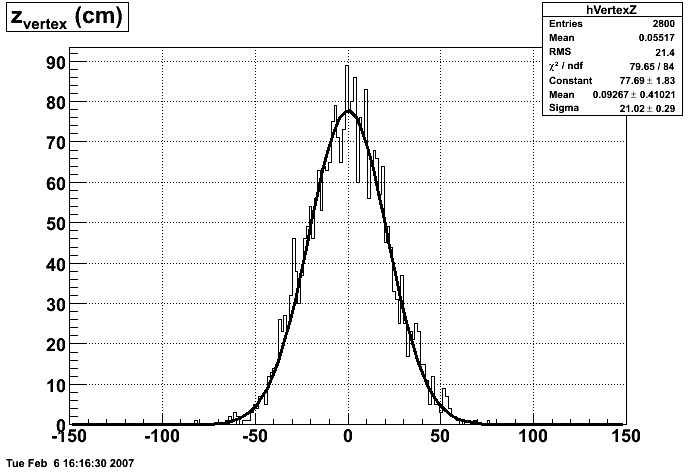
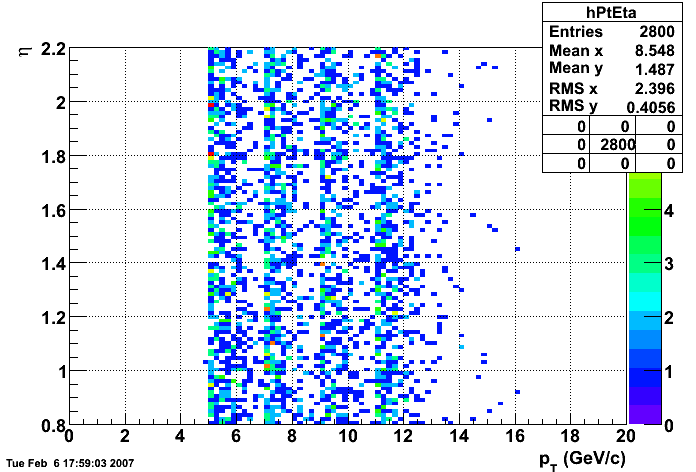
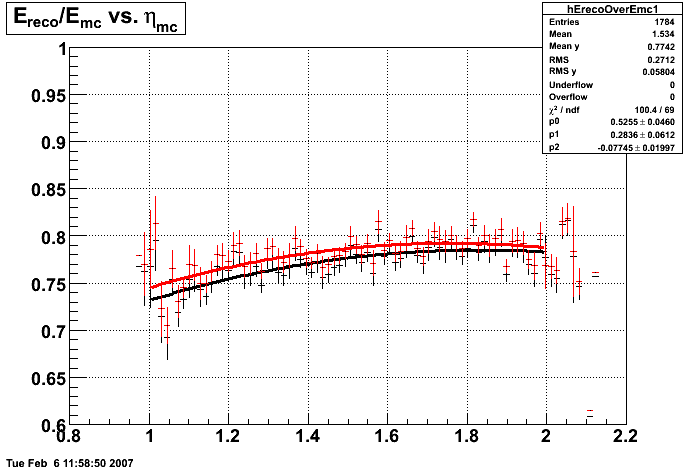
Will's Monte Carlo
- 10k single gamma's
- SVT/SSD out
- Vertex at 0
- Flat in pt 5-60 GeV
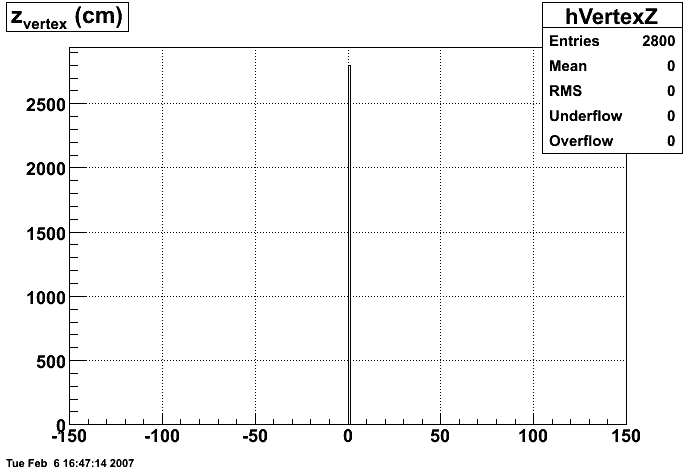
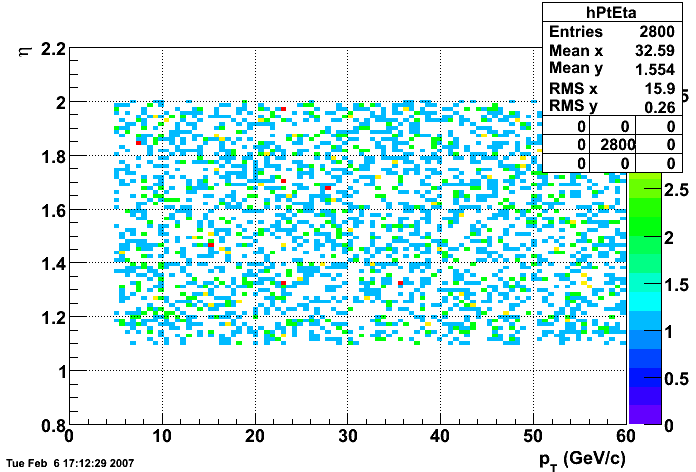
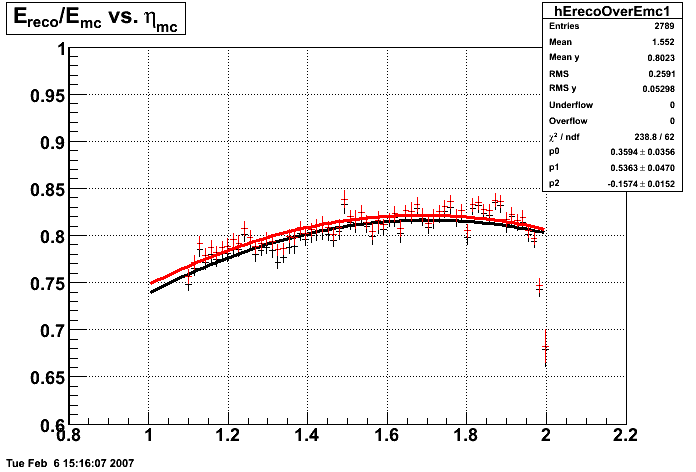
In the plot below, I use the energy of the single tower (tower with max energy) presumably the tower the photon hit. The nonlinearity seems to disappear.
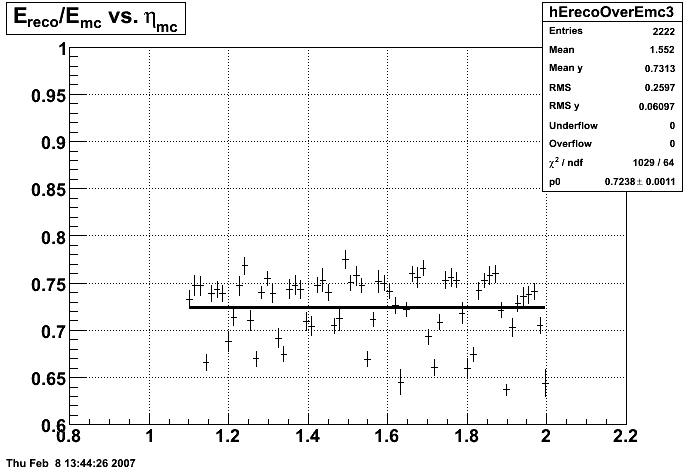
In the plot below, I use the energy of the 3x3 cluster of tower centered around the tower with the max energy. The nonlinearity is restored.
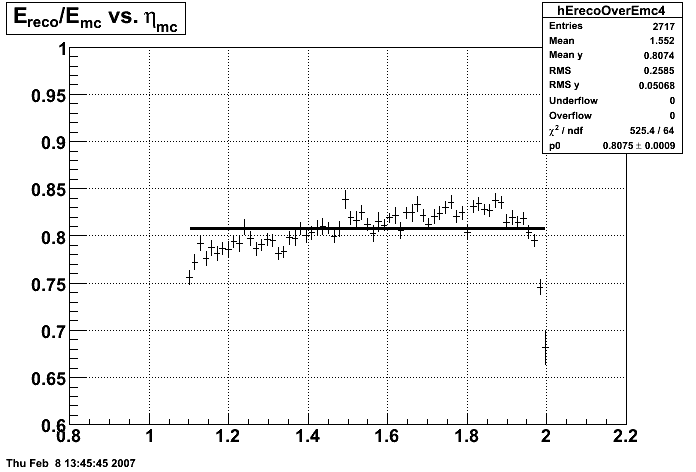
The plot below shows Etower/Ecluster vs. eta where the cluster consists of 3x3 towers centered around the max energy tower.
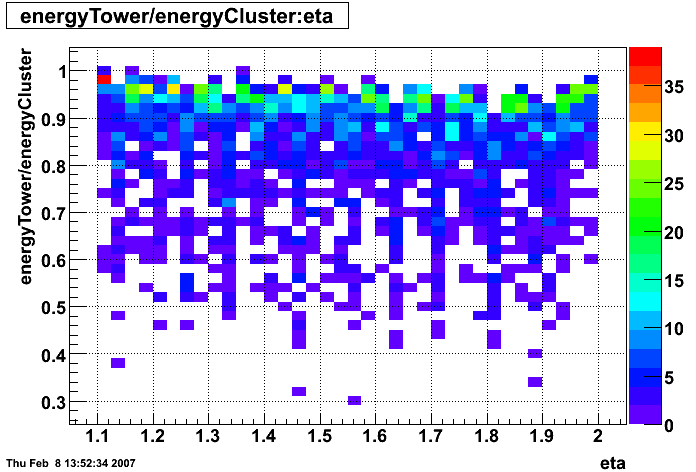
Below is the profile of E_tower/E_cluster vs. eta.
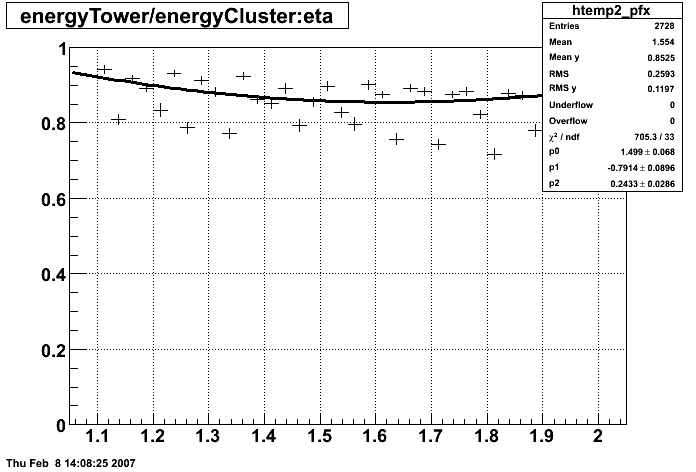
The plot below shows the energy sampled by the entire calorimeter as a function of eta, i.e. sampling fraction as a function of eta.
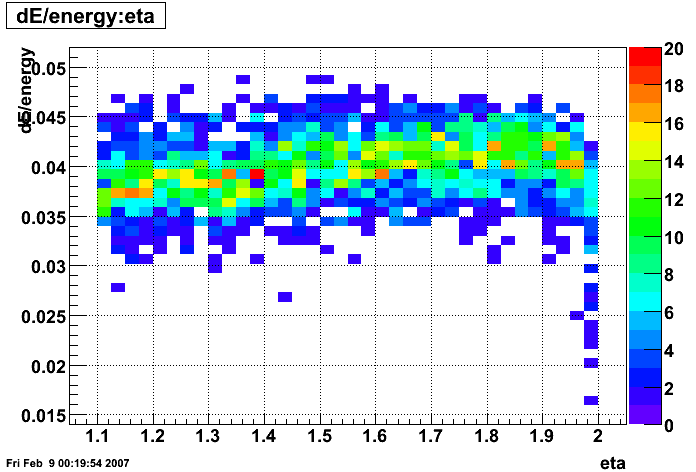
Sampling fraction integrated over all eta's.
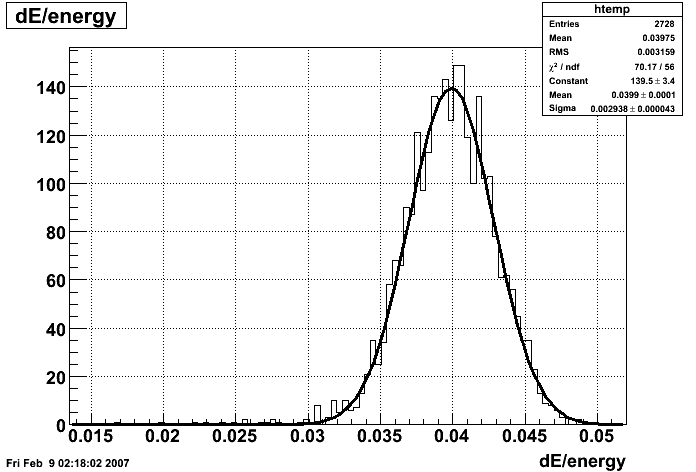
Pibero Djawotho Last updated Thu Feb 8 13:59:29 EST 2007
2007.02.11 Reconstructed/Monte Carlo Muon Energy
Reconstructed/Monte Carlo Muon Energy
10k muons thrown by Will with:
- zvertex=0
- Flat in pT 5-60 GeV/c
- Flat in η 1.1-2
zvertex
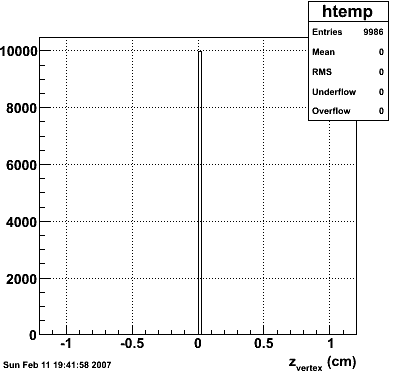
pT vs. η
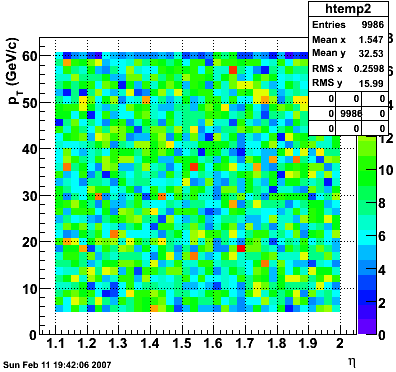
EMC
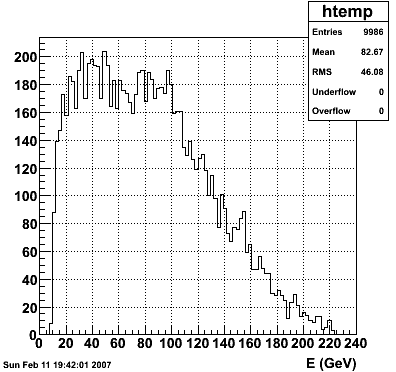
Etower/EMC vs. η
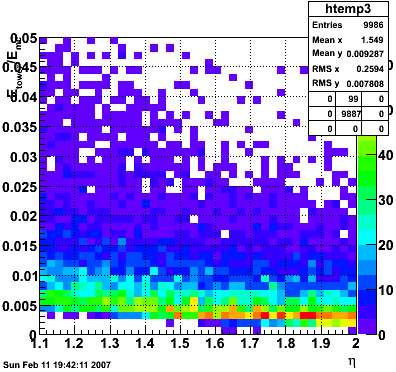
Ecluster/EMC vs. η
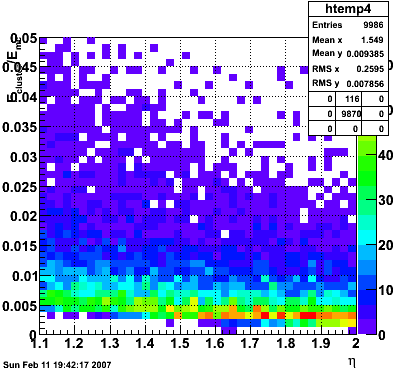
Etowertanh(eta) vs. eta
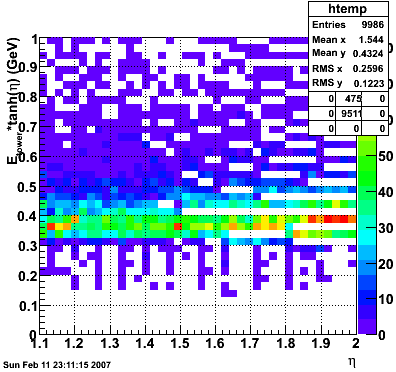
Pibero Djawotho Last modified Sun Feb 11 19:51:55 EST 2007
2007.02.15 160 GeV photons
160 GeV photons
- 10k 160 GeV photons
- zvertex=0
- η range 0.8-2.2
- SVT/SSD out
 |
 |
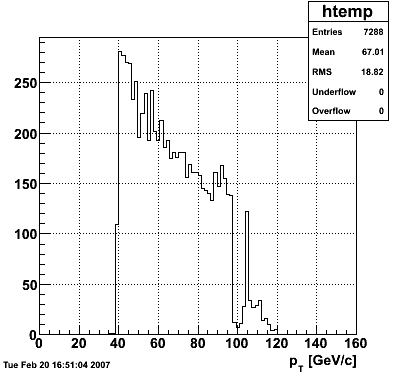 |
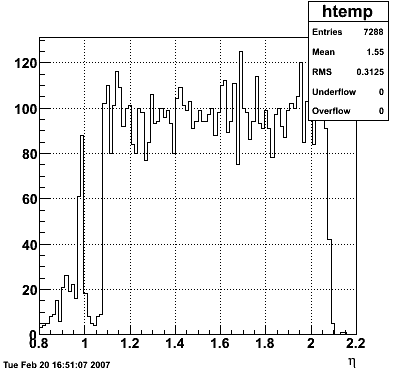 |
 |
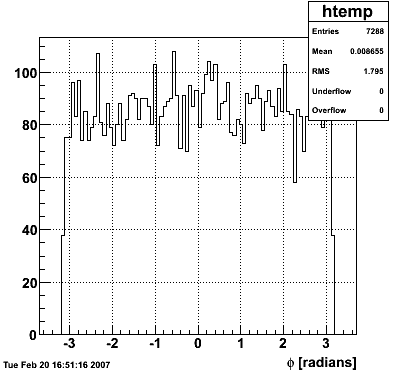 |
 |
 |
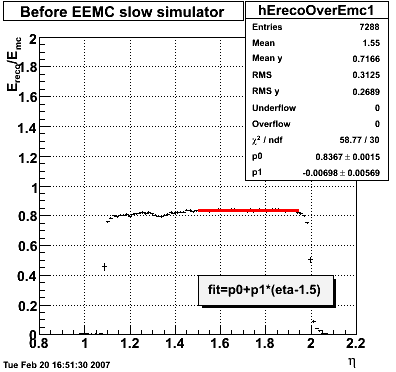 |
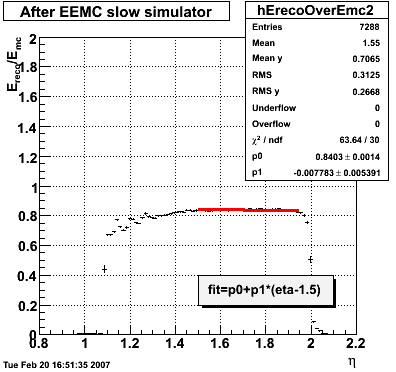 |
Pibero Djawotho Last updated Thu Feb 15 04:33:09 EST 2007
2007.02.15 20 GeV photons
20 GeV photons
- 10k 20 GeV photons
- zvertex=0
- η range 0.8-2.2
- SVT/SSD out
 |
 |
 |
 |
 |
 |
 |
 |
 |
 |
Pibero Djawotho Last updated Thu Feb 15 04:32:25 EST 2007
2007.02.15 80 GeV photons
80 GeV photons
- 10k 80 GeV photons
- zvertex=0
- η range 0.8-2.2
- SVT/SSD out
 |
 |
 |
 |
 |
 |
 |
 |
 |
 |
Pibero Djawotho Last updated Thu Feb 15 03:16:54 EST 2007
2007.02.15 Reconstructed/Monte Carlo Electron Energy
Reconstructed/Monte Carlo Electron Energy
E=1 GeV |
E=2 GeV |
 |
 |
 |
 |
 |
 |
 |
 |
 |
 |
 |
 |
 |
 |
 |
 |
 |
 |
Pibero Djawotho Last modified Thu Feb 15 00:42:30 EST 2007
2007.02.19 10 GeV photons
10 GeV photons
- 10k 10 GeV photons
- zvertex=0
- η range 0.8-2.2
- SVT/SSD out
 |
 |
 |
 |
 |
 |
 |
 |
 |
 |
Pibero Djawotho Last updated Mon Feb 19 20:35:13 EST 2007
2007.02.19 40 GeV photons
40 GeV photons
- 10k 40 GeV photons
- zvertex=0
- η range 0.8-2.2
- SVT/SSD out
 |
 |
 |
 |
 |
 |
 |
 |
 |
 |
Pibero Djawotho Last updated Mon Feb 19 20:37:37 EST 2007
2007.02.19 5 GeV photons
5 GeV photons
- 10k 5 GeV photons
- zvertex=0
- η range 0.8-2.2
- SVT/SSD out
 |
 |
 |
 |
 |
 |
 |
 |
 |
 |
Pibero Djawotho Last updated Mon Feb 19 20:13:39 EST 2007
2007.02.19 Summary of Reconstructed/Monte Carlo Photon Energy
Summary of Reconstructed/Monte Carlo Photon Energy |
Description |
The study presented here uses Monte Carlo data sets generated by Will Jacobs at different photon energies (5, 10, 20, 40, 80, 160 GeV):
- 10k photons
- vertex at 0
- eta 0.8-2.2
- SVT/SSD out
For each photon energy, the ratio E_reco/E_MC vs. eta was plotted and fitted to the function p0+p1*(1-eta), where E_reco is the reconstructed photon energy integrated over the
entire
EEMC. The range of the fit was fixed from 1.15 to 1.95 to avoid EEMC edge effects. The advantage of parametrizing the eta-dependence of the ratio in this way is that p0 is immediately interpretable as the ratio in the middle of the EEMC. The parameters p0 and p1 vs. photon energy were subsequently plotted for the EEMC fast and slow simulator.
EEMC Fast/Slow Simulator Results |
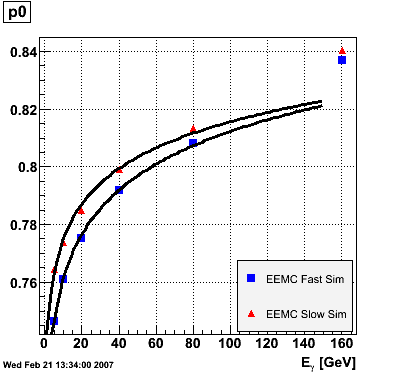 |
 |
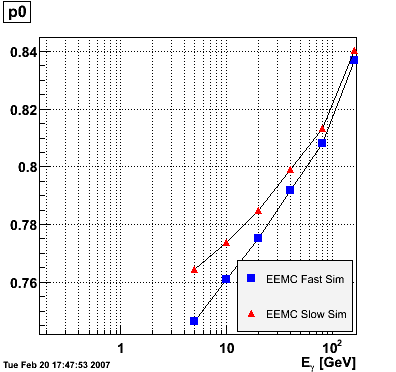 |
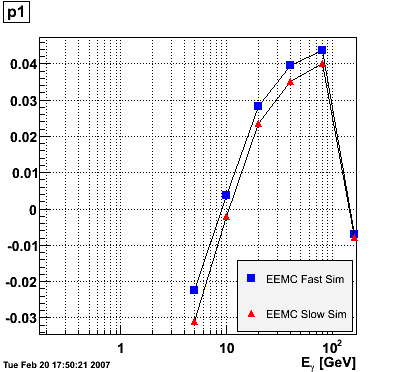 |
Conclusions |
The parameter p0, i.e. the ratio E_reco/E_MC in the mid-region of the EEMC, increases monotonically from 0.74 at 5 GeV to 0.82 at 160 GeV, and the parameter p1, i.e. the slope of the eta-dependence, also increases monotonically from -0.035 at 5 GeV to 0.038 at 160 GeV. There appears to be a magic energy around 10 GeV where the response of the EEMC is nearly flat across its entire pseudorapidity range. The anomalous slope p1 at 160 GeV for the EEMC slow simulator is an EEMC hardware saturation effect. The EEMC uses 12-bit ADC's for reading out tower transverse energies and is set for a 60 GeV range. Any particle which deposits more than 60 GeV in E_T will be registered as depositing only 60 GeV as the ADC will return the maximum value of 4095. This translates into a limit on the eta range of the EEMC for a particular energy. Let's say that energy is 160 GeV and the EEMC tops at 60 GeV in E_T, then the minimum eta is acosh(160/60)=1.6. This limitation is noticeable in a plot of E_reco/E_MC vs. eta. This anomaly is not observed in the result of the EEMC fast simulator because the saturation behavior was not implemented at the time of the simulation (it has since been corrected). The energy-dependence of the parameter p0 is fitted to p0(E)=a+b*log(E) and the parameter p1 to p1(E)=a+b/log(E). The results are summarized below:
EEMC fast simulator fit p0(E)=a+b*log(E) a = 0.709946 +/- 0.00157992 b = 0.022222 +/- 0.000501239 EEMC slow simulator fit p0(E)=a+b*log(E) a = 0.733895 +/- 0.00359237 b = 0.0177537 +/- 0.0011397 EEMC fast simulator fit p1(E)=a+b/log(E) a = 0.0849103 +/- 0.00556979 b = -0.175776 +/- 0.0138241 EEMC slow simulator fit p1(E)=a+b/log(E) a = 0.0841488 +/- 0.0052557 b = -0.187769 +/- 0.0130445
Pibero Djawotho Last updated Mon Feb 19 23:18:44 EST 2007
2007.05.24 gamma/pi0 separation in EEMC using linear cut
gamma/pi0 separation in EEMC using linear cut
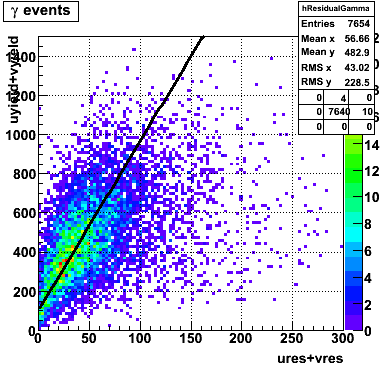 |
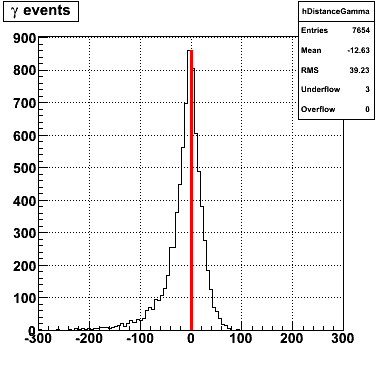 |
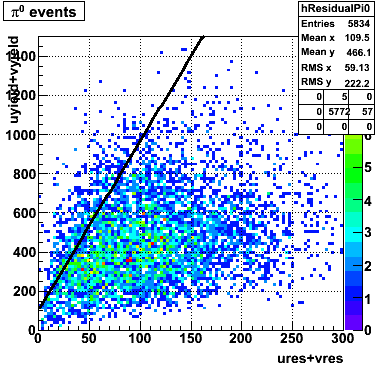 |
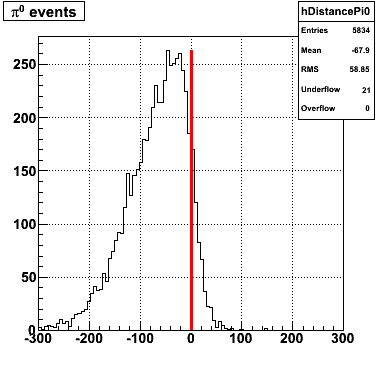 |
 |
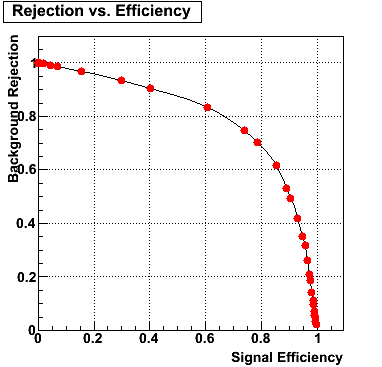 |
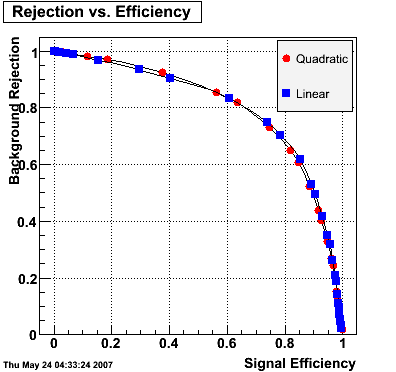 |
Pibero Djawotho Last updated Thu May 24 04:41:13 EDT 2007
2007.05.24 gamma/pi0 separation in EEMC using quadratic cut
gamma/pi0 separation in EEMC using quadratic cut
 |
 |
 |
 |
 |
 |
 |
Pibero Djawotho Last updated Thu May 24 04:41:13 EDT 2007
2007.05.24 gamma/pi0 separation in EEMC using quadratic cut
gamma/pi0 separation in EEMC using quadratic cut
 |
 |
 |
 |
 |
 |
 |
Pibero Djawotho Last updated Thu May 24 04:41:13 EDT 2007
2007.05.30 Efficiency of reconstructing photons in EEMC
Efficiency of reconstructing photons in EEMC
Monte Carlo sample
- 10k photons
- STAR y2006 geometry
- z-vertex=0
- Flat in pt 10-30 GeV
- Flat in eta 1.0-2.1
SMD gamma/pi0 discrimination algorithm
The following
from the IUCF STAR Web site gives a brief overview of the SMD gamma/pi0 discrimination algorithm using the method of maximal sided fit residual (data - fit). This technique comes to STAR EEMC from the Tevatron via Les Bland via Jason Webb. The specific fit function used in this analysis is:
f(x)=[0]*(0.69*exp(-0.5*((x-[1])/0.87)**2)/(sqrt(2*pi)*0.87)+0.31*exp(-0.5*((x-[1])/3.3)**2)/(sqrt(2*pi)*3.3))
x is the strip id in the SMD-u or SMD-v plane. The widths of the narrow and wide Gaussians are determined from empirical fits of shower shape response in the EEMC from simulation.
Optimizing cuts for gamma/pi0 separation
In the rest of this analysis, only those photons which have reconstructed pt > 5 GeV are kept. There is no requirement that the photon doesn't convert. The dividing curve between photons and pions is:
f(x)=4*x+1e-7*x**5
The y-axis is integrated yield over the SMD-u and SMD-v plane, and the x-axis is the sum of the maximal sided residual of the SMD-u and SMD-v plane.
 |
 |
Following exchanges with Scott Wissink, the idea is to move from a quintic to a quadratic to reduce the number of parameters. In addition, the perpendicular distance between the curve and a point in the plane is used to estimate the likelihood of a particle being a photon or pion. Distances above the curve are positive and those below are negative. The more positive the distance, the more likely the particle is a photon. The more negative the distance, the more likely the particle is a pion.
Hi Pibero, With your new "linear plus quintic" curve (!) ... how did you choose the coefficients for each term? Or even the form of the curve? I'm not being picky, but how to optimize such curves will be an important issue as we (hopefully soon) move on to quantitative comparisons of efficiency vs purity. As a teaser, please see attached - small loss of efficiency, larger gain in purity. Scott
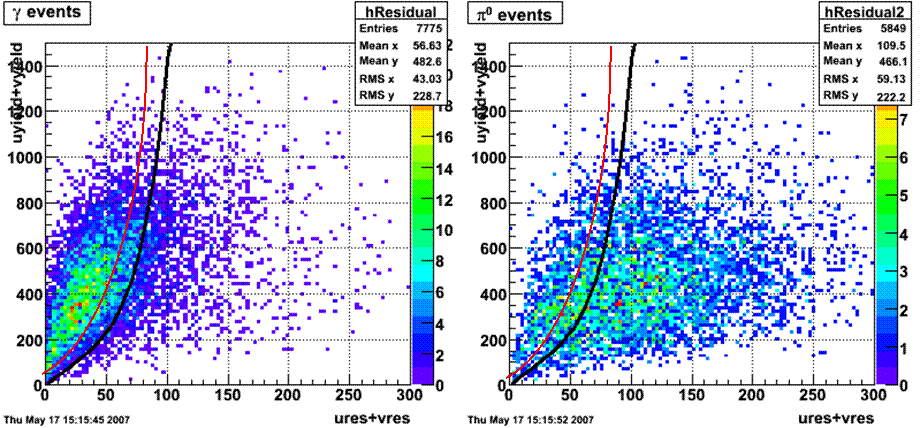
Hi Pibero,
I just worked out the distance of closest approach to a curve of the form
y(x) = a + bx^2
and it involves solving a cubic equation - so maybe not so trivial after
all. But if you want to pursue this (not sure it is your highest
priority right now!), the cubic could be solved numerically and "alpha"
could be easily calculated.
More fun and games.
Scott
 |
 |
 |
 |
 |
 |
Hi Pibero,
I played around with the equations a bit more, and I worked out an
analytic solution. But a numerical solution may still be better, since
it allows more flexibility in the algebraic form of the 'boundary' line
between photons and pions.
Here's the basic idea: suppose the curved line that cuts between
photons and pions can be expressed as y = f(x). If we are now given a
point (x0,y0) in the plane, our goal is to find the shortest distance to
this line. We can call this distance d (I think on your blackboard we
called it alpha).
To find the shortest distance, we need a straight line that passes
through (x0,y0) and is also perpendicular to the curve f(x). Let's
define the point where this straight line intersects the curve as
(x1,y1). This means (comparing slopes)
(y1 - y0) / (x1 - x0) = -1 / f'(x1)
where f'(x1) is the derivative of f(x) evaluated at the point (x1,y1).
Rearranging this, and using y1 = f(x1), yields the general result
f(x1) f'(x1) - y0 f'(x1) + x1 - x0 = 0
So, given f(x) and the point (x0,y0), the above is an equation in only
x1. Solve for x1, use y1 = f(x1), and then the distance d of interest
is given by
d = sqrt[ (x1 - x0)^2 + (y1 - y0)^2 ]
Example: suppose we got a reasonable separation of photons and pions
using a curve of the form
y = f(x) = a + bx^2
Using this in the above general equation yields the cubic equation
(2b^2) x1^3 + (2ab + 1 - 2by0) x1 - x0 = 0
Dividing through by 2b^2, we have an equation of the form
x^3 + px + q = 0
This can actually be solved analytically - but as I mentioned, a
numerical approach gives us more flexibility to try other forms for the
curve, so this may be the way to go. I think (haven't proved
rigorously) that for positive values of the constants a, b, x0, and y0,
the cubic will yield three real solutions for x1, but only one will have
x1 > 0, which is the solution of interest.
Anyway, it has been an interesting intellectual exercise!
Scott
I made use of the ROOT function TMath::RootsCubic to solve the cubic equation numerically for computing distances of each point to the curve. With the new quadratic curve f(x)=100+0.1*x^2 the efficiency is 63% and the rejection is 82%.
Efficiency and Rejection
The plot on the left below shows the efficiency of identifying photons over the pt range of 10-30 GeV and the one on the right shows the rejection rate of single neutral pions. Both average about 75% over the pt range of interest.
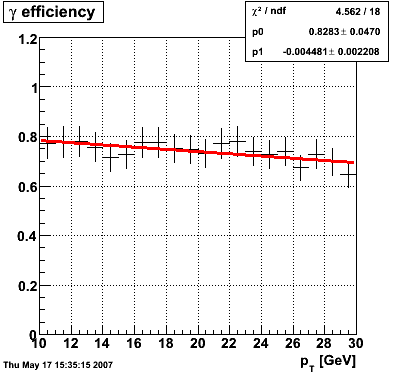 |
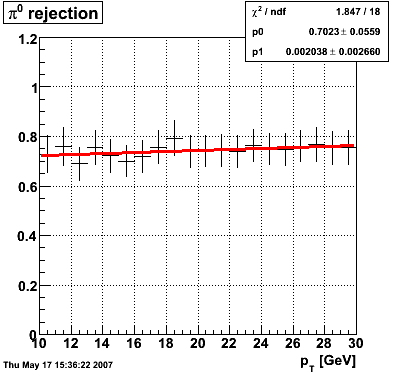 |
Rejection vs. efficiency at different energies
The plot below shows background rejection vs. signal efficiency for different energy ranges of the thrown gamma/pi0.

Rejection vs. efficiency with preshower cut
Below on the left is a plot of the ratio of the sum of preshower 1 and 2 to tower energy for both photons (red) and pions (blue). On the right is the rejection of pions vs. efficiency of photons as I cut on the ratio of preshower to tower. It is clear from these plots that the preshower layer is not a good gamma/pi0 discriminator, although can be used to add marginal improvement to the separation preovided by the shower max.
ALL ENERGIES |
|
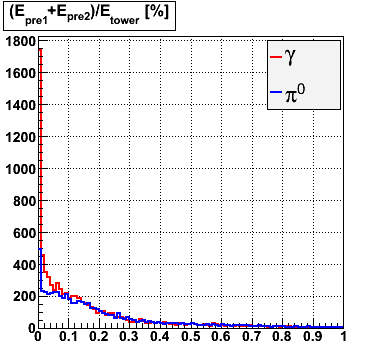 |
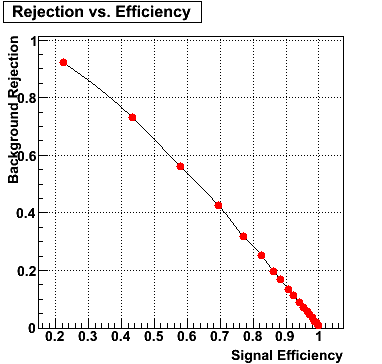 |
E=20-40 GeV |
|
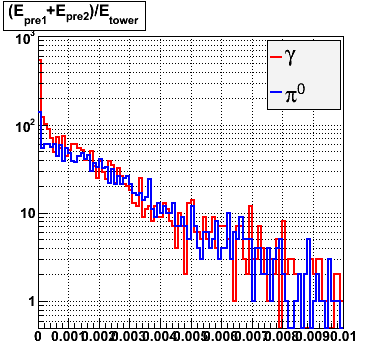 |
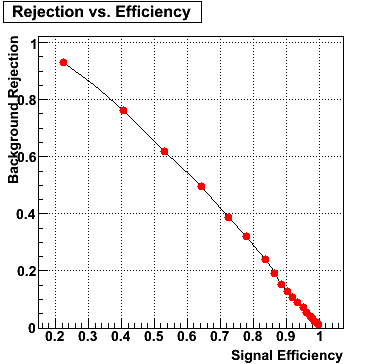 |
E=40-60 GeV |
|
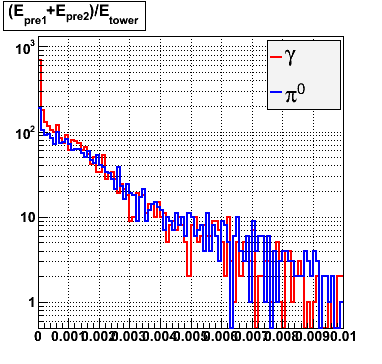 |
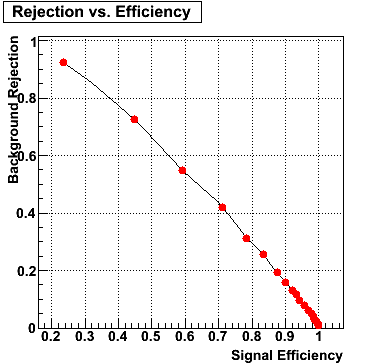 |
E=60-80 GeV |
|
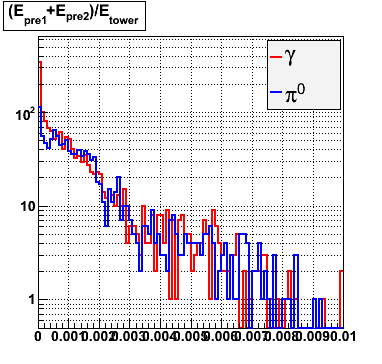 |
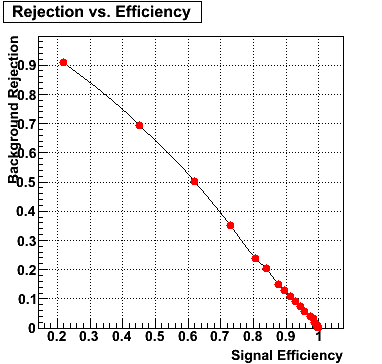 |
E=80-90 GeV |
|
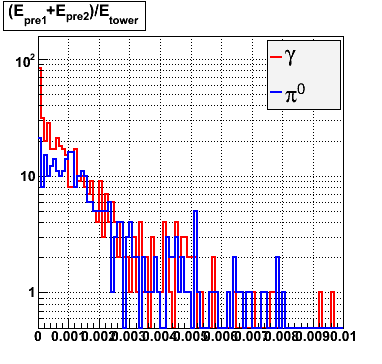 |
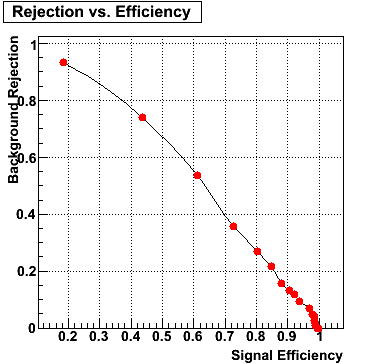 |
Pibero Djawotho Last updated Wed May 30 00:32:16 EDT 2007
2007.06.12 gamma/pi0 separation in EEMC at pT 5-10 GeV
gamma/pi0 separation in EEMC at pT 5-10 GeV
 |
 |
 |
 |
 |
 |
 |
Pibero Djawotho Last updated Tue Jun 12 11:59:42 EDT 2007
2007.06.28 Photons in Pythia
Pythia Simulations
Pythia Simulations
All partonic pT
The plots below show the distribution of clusters in the endcap calorimeter for different partonic pT ranges. 2000 events were generated for each pT range. A cluster is made up of a central high tower above 3 GeV in pT and its surounding 8 neighbors. The total cluster pT must exceed 4.5 GeV.
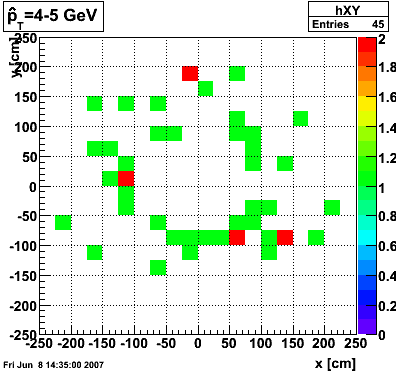 |
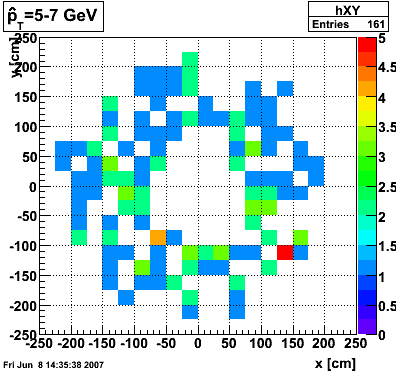 |
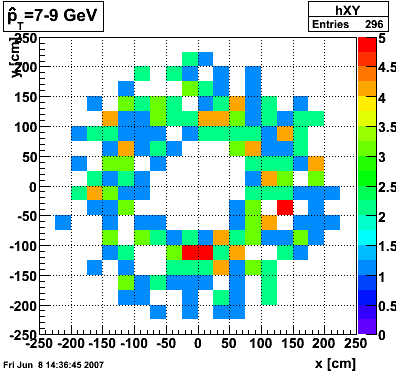 |
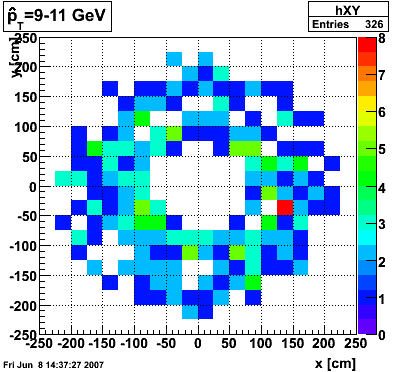 |
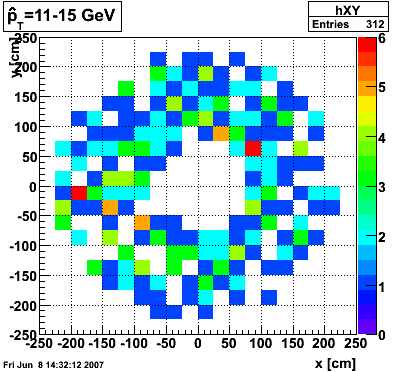 |
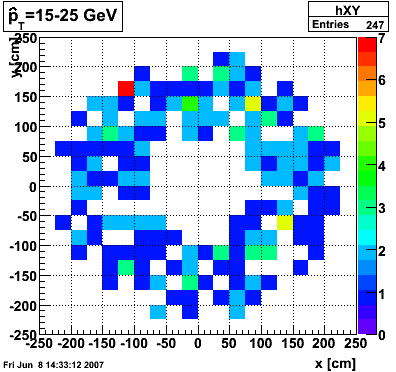 |
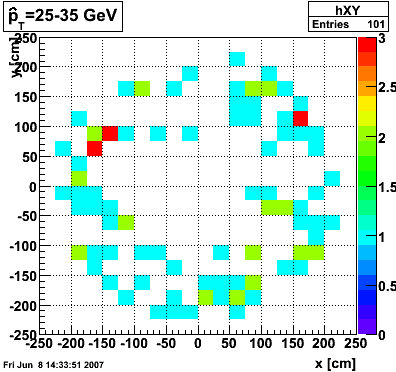 |
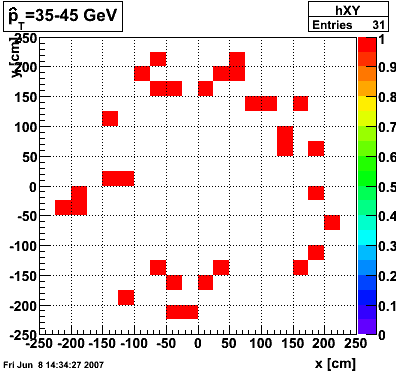 |
pT=9-11 GeV
Below is the pT of direct and decay photons from the Pythia record. Note how the two subsets are well separated at a given partonic pT. Any contamination to the direct photon signal would have to come from higher partonic pT.
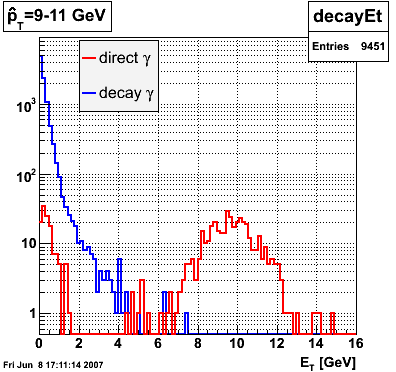 |
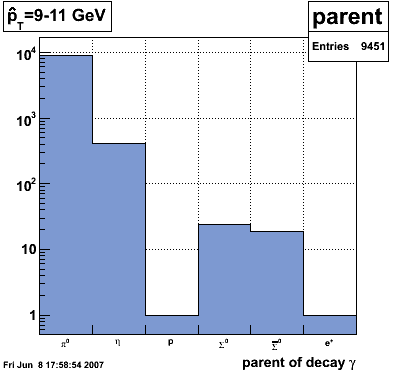 |
Differences between Renee's and Manuel's Pythia records?
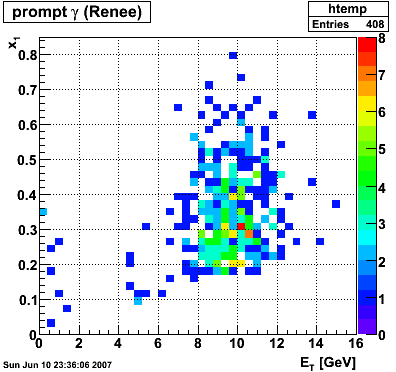 |
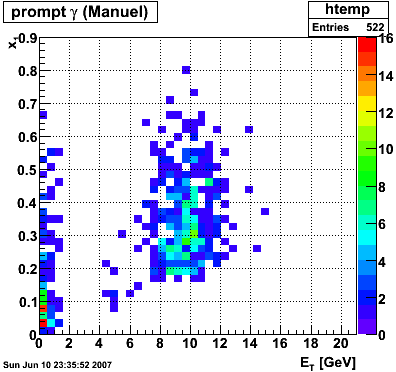 |
Number of prompt photons per event from GEANT record
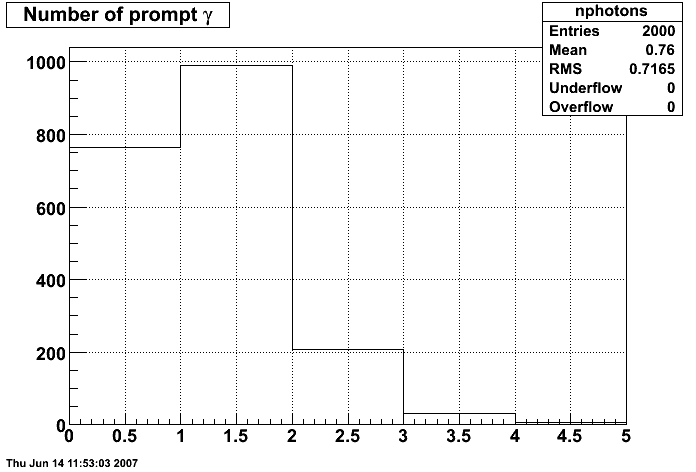
Pibero Djawotho Last updated Fri Jun 8 16:08:27 EDT 2007
a_LL
Partonic aLL
Jet |
Gamma |
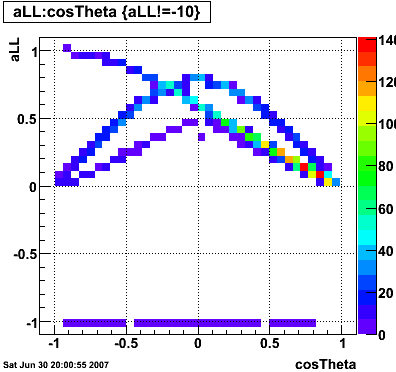 |
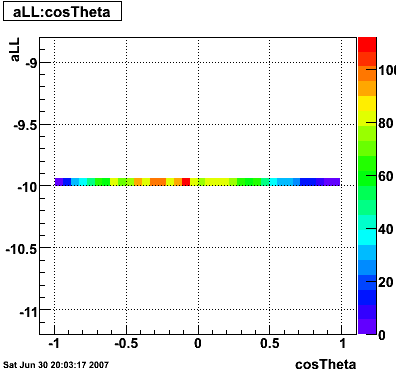 |
Pibero Djawotho Last updated Sat Jun 30 20:14:21 EDT 2007
gamma-jet kinematics
gamma-jet kinematics
Clusters without parent track
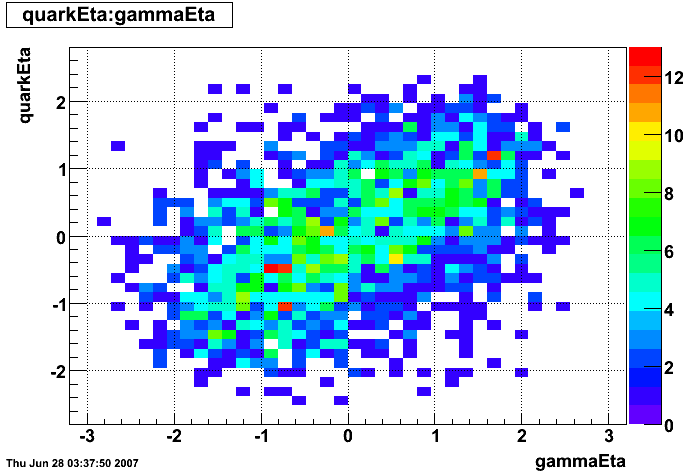 |
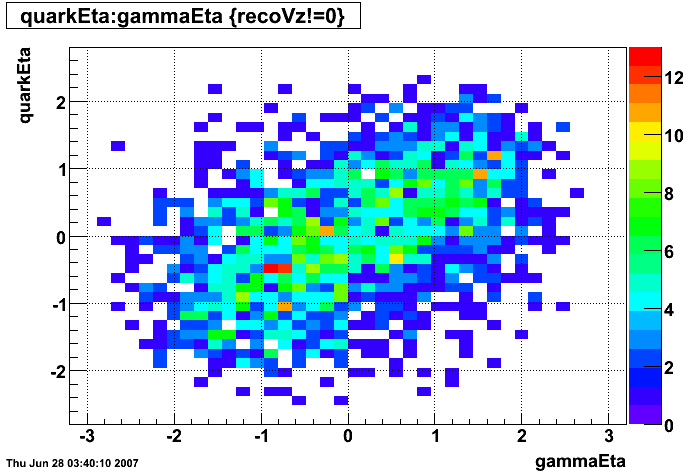 |
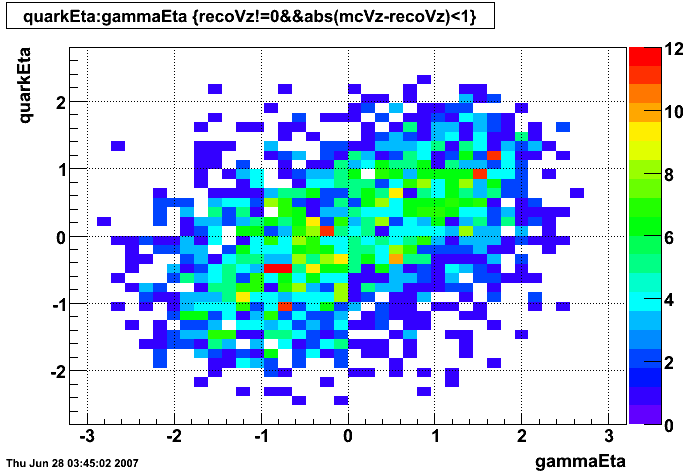 |
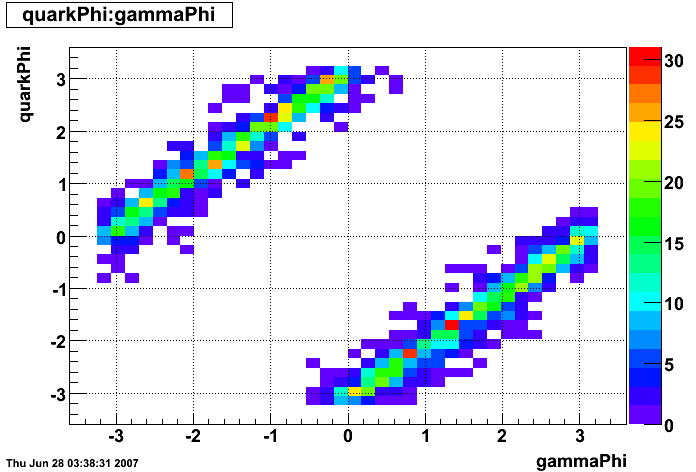 |
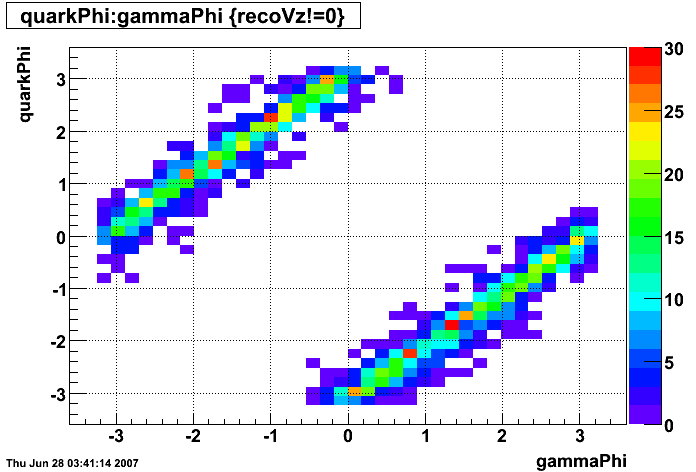 |
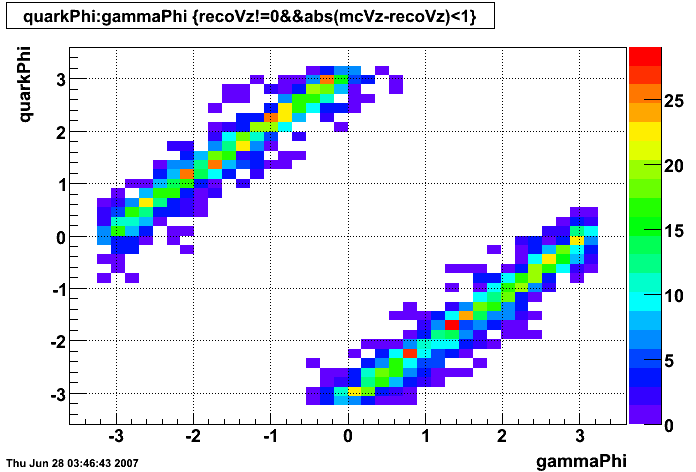 |
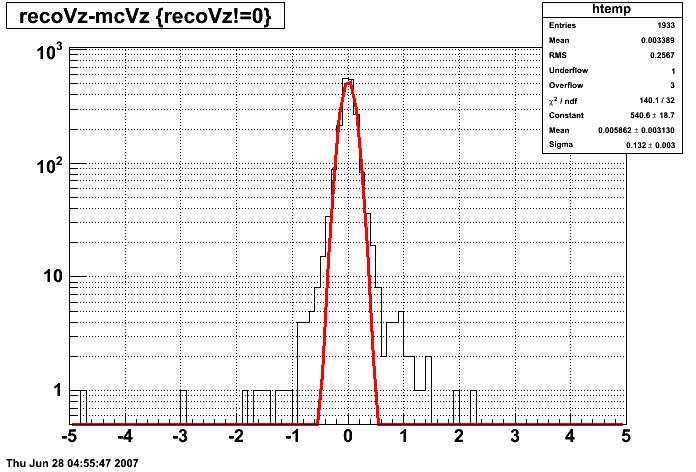 |
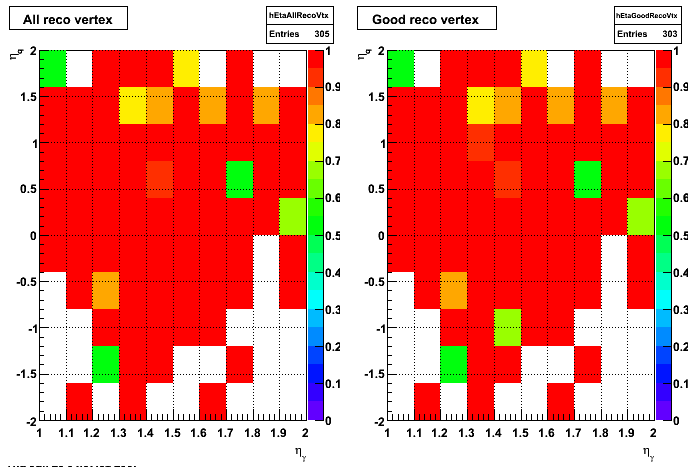 |
Pibero Djawotho Last updated Thu Jun 28 04:43:57 EDT 2007
gamma/X separation by energy
gamma/X separation by energy
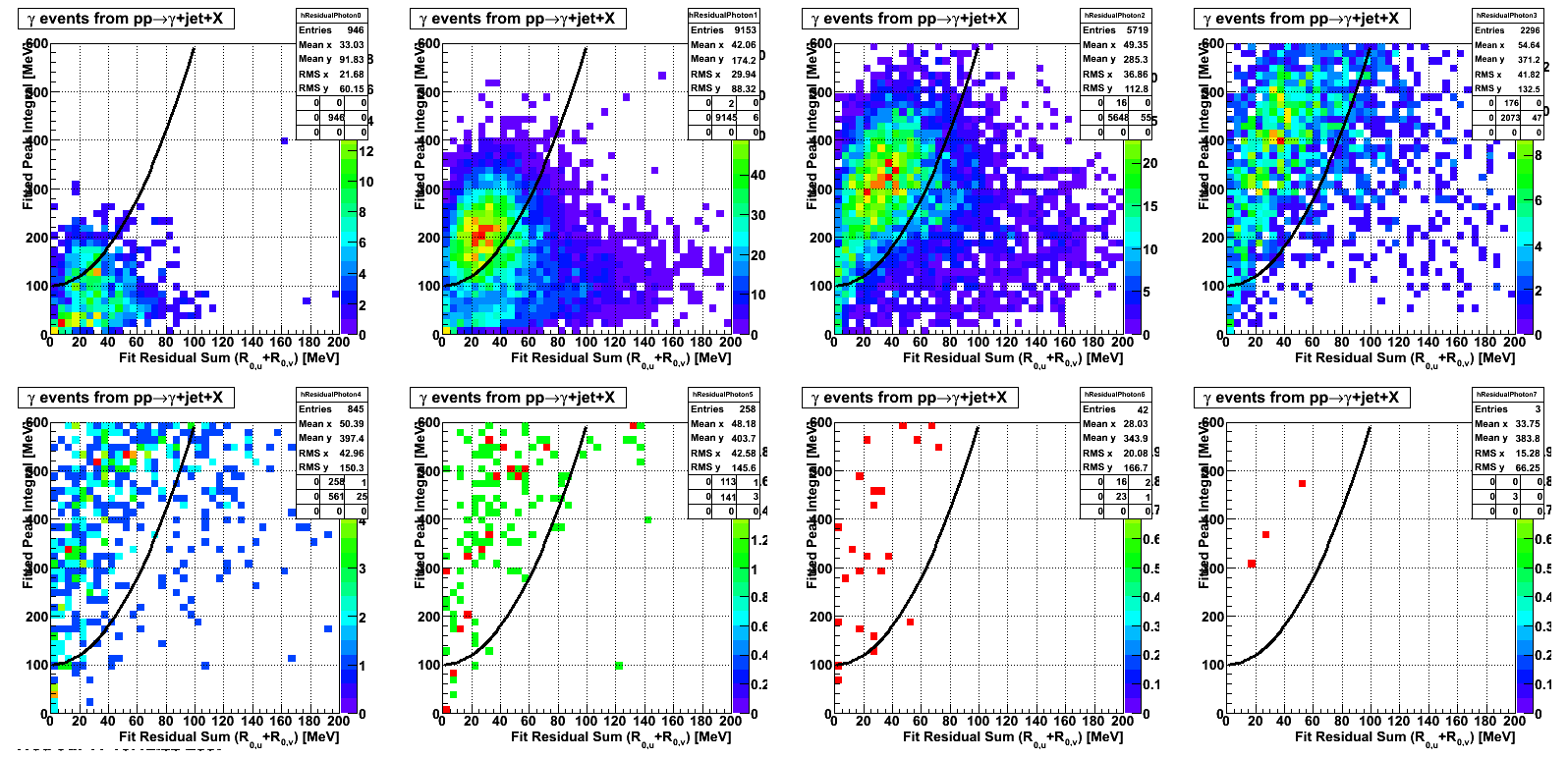 |
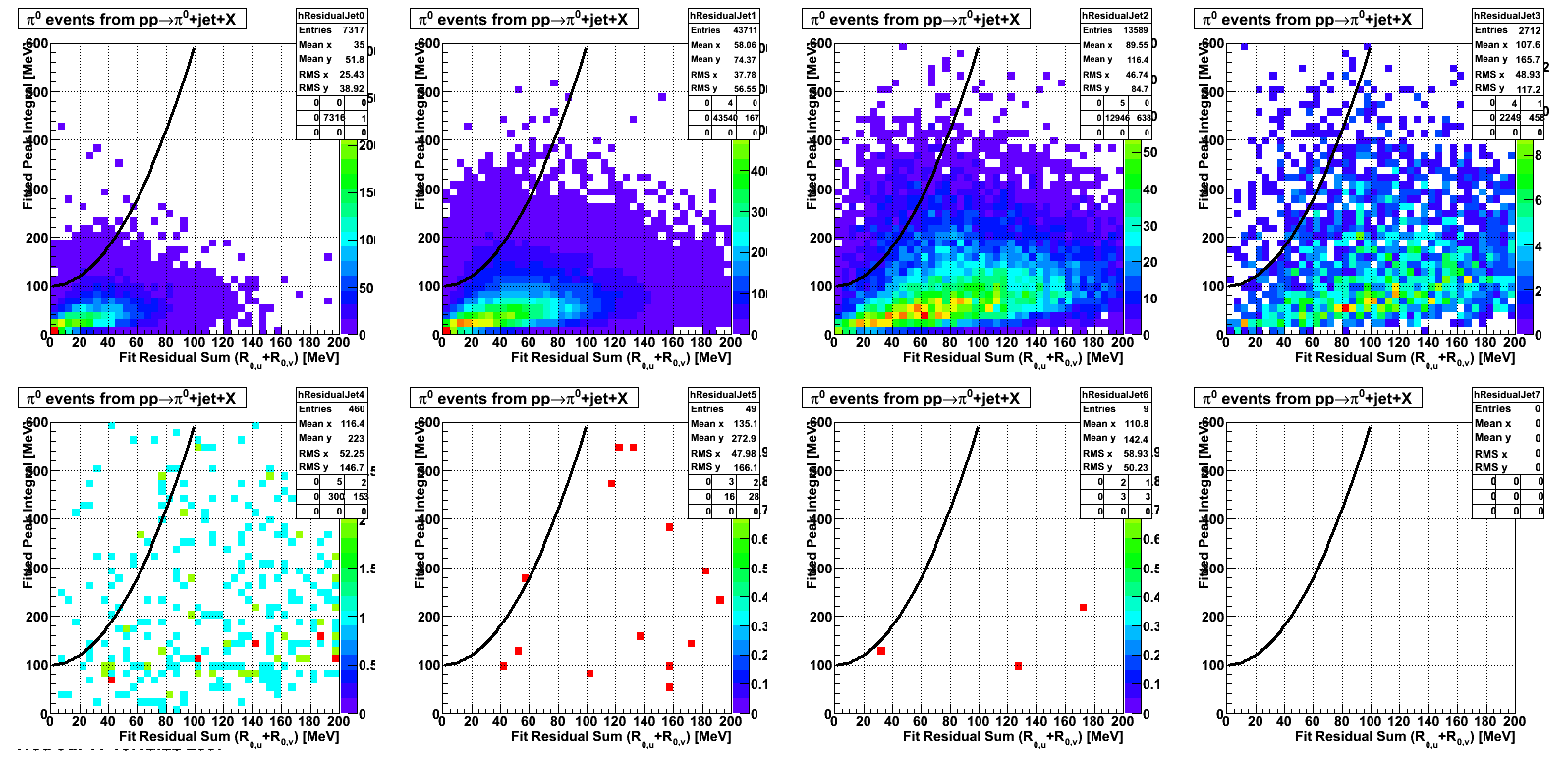 |
Pibero Djawotho Last updated Wed Jul 11 11:10:26 EDT 2007
gamma/X separation by energy with pT weights
gamma/X separation by energy with pT weights
 |
 |
Pibero Djawotho Last updated Thu Jul 12 00:28:35 EDT 2007
gamma/X separation by energy with pT weights and normalized by number of events
gamma/X separation by energy with pT weights and normalized by number of events
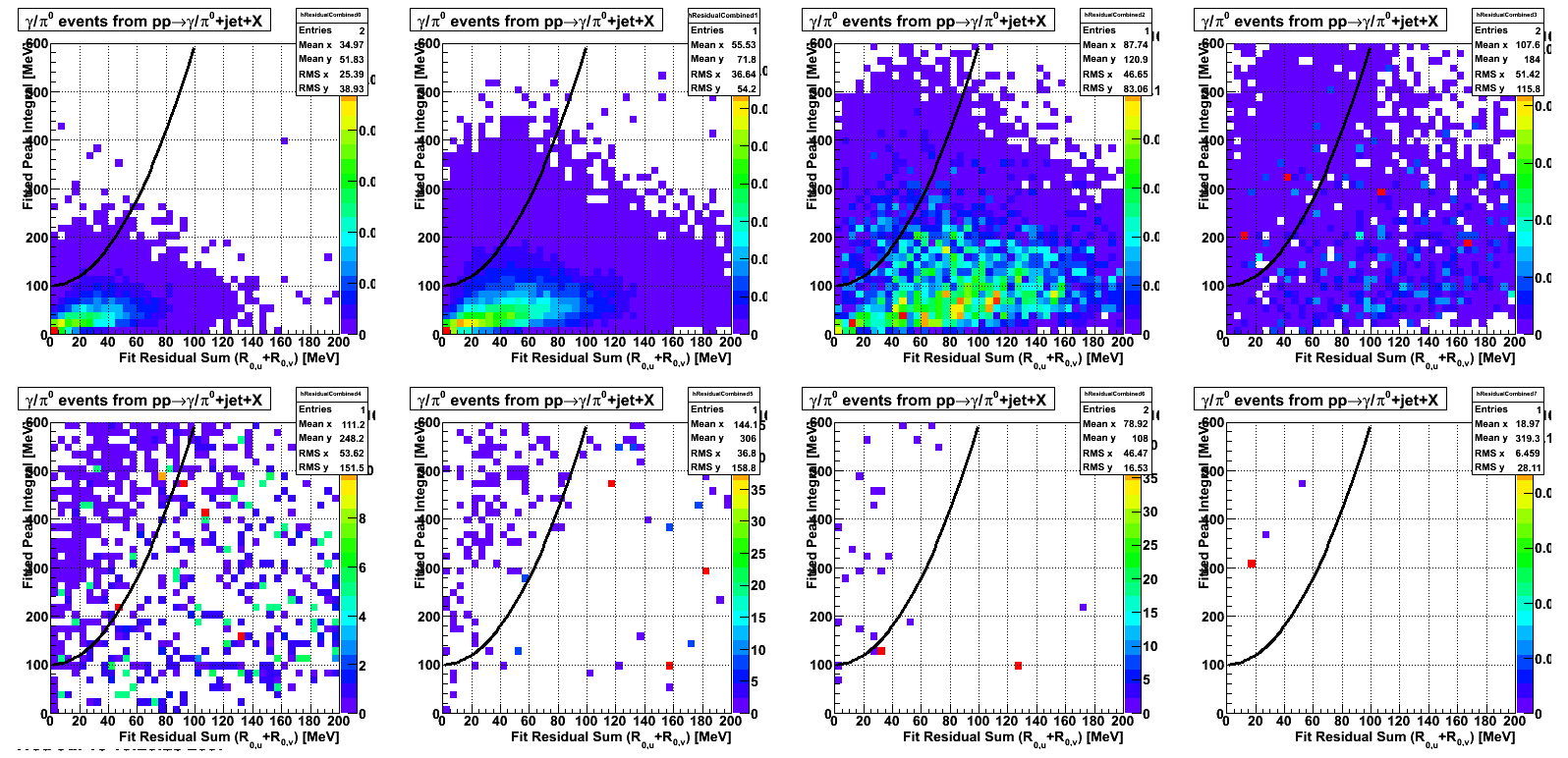 |
Pibero Djawotho Last updated Wed Jul 18 14:55:08 EDT 2007
gamma/pi0 separation efficiency and rejection at pT=5-7 GeV
gamma/pi0 separation efficiency and rejection at pT=5-7 GeV
 |
 |
 |
 |
 |
 |
Pibero Djawotho Last updated Wed Jul 4 17:45:26 EDT 2007
gamma/pi0 separation efficiency and rejection at pT=9-11 GeV
gamma/pi0 separation efficiency and rejection at pT=9-11 GeV
 |
 |
 |
 |
 |
 |
Pibero Djawotho Last updated Wed Jul 4 13:23:41 EDT 2007
gamma/pi0 separation efficiency and rejection at pT=9-11 GeV
gamma/pi0 separation efficiency and rejection at pT=9-11 GeV
 |
 |
 |
 |
 |
 |
Pibero Djawotho Last updated Wed Jul 4 13:23:41 EDT 2007
2007.07.09 How to run the gamma fitter
How to run the gamma fitter
The gamma fitter runs out of the box. The code consists of the classes StGammaFitter and StGammaFitterResult in CVS. After checking out a copy of offline/StGammaMaker, cd into the offline directory and run:
root4star StRoot/StGammaMaker/macros/RunGammaFitterDemo.C
The following plots will be generated on the ROOT canvas and dumped into PNG files.
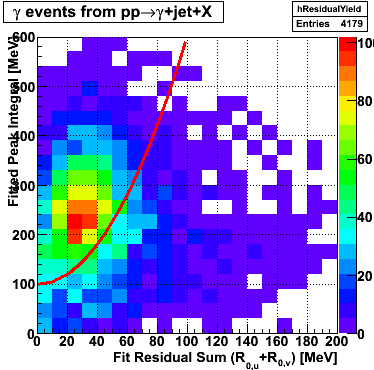 |
 |
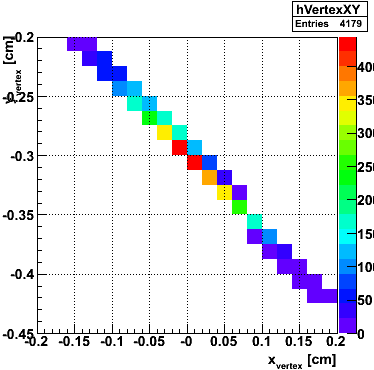 |
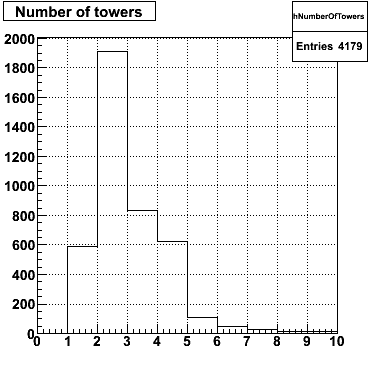 |
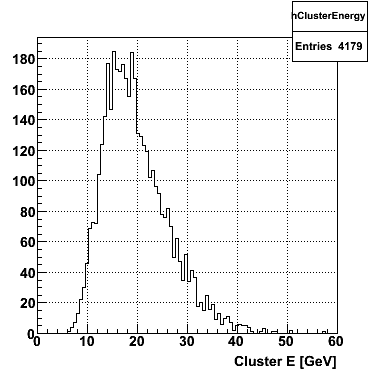 |
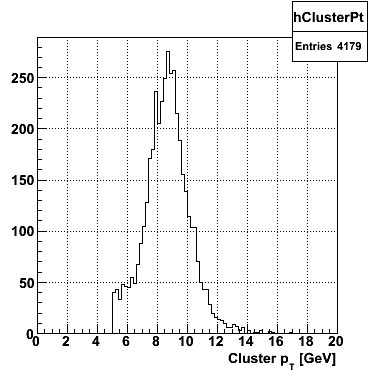 |
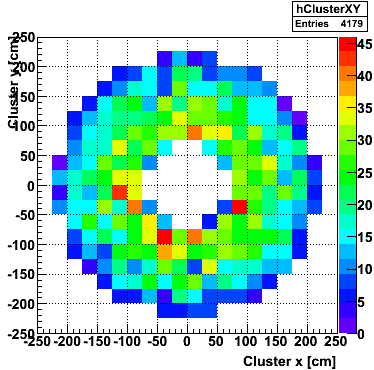 |
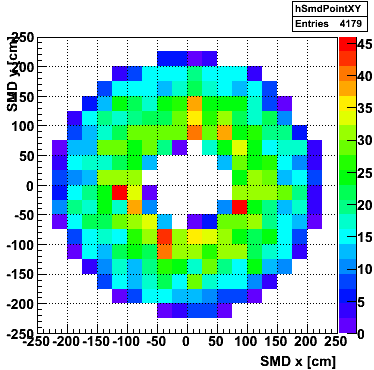 |
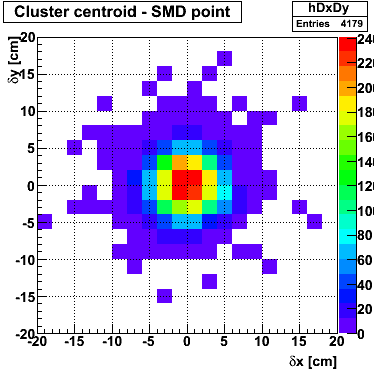 |
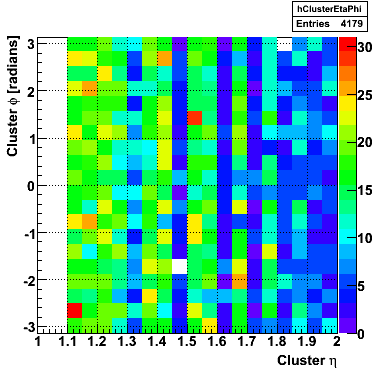 |
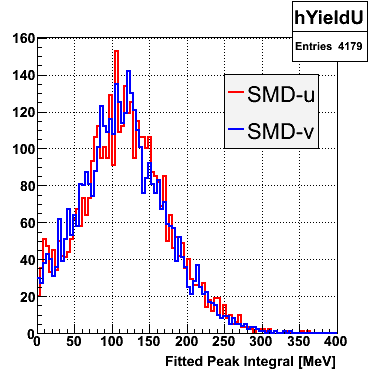 |
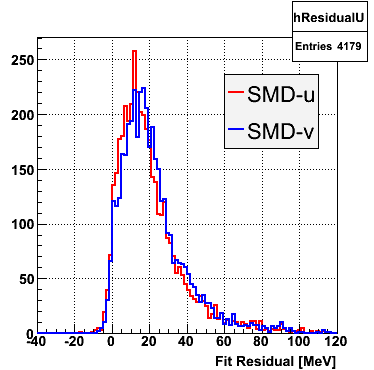 |
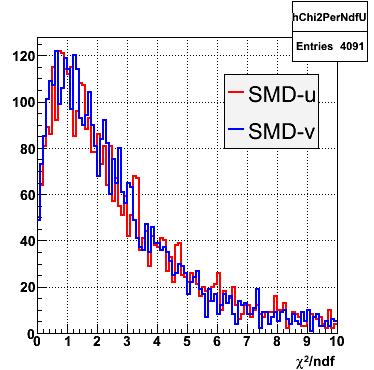 |
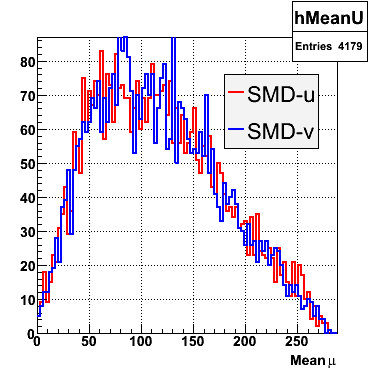 |
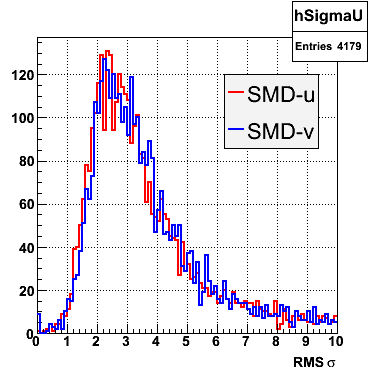 |
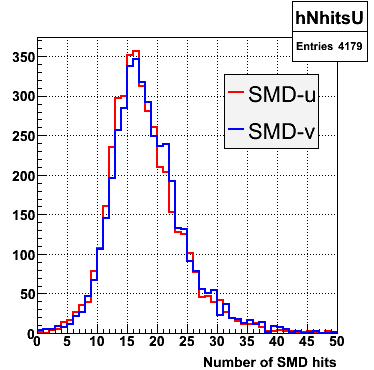 |
Pibero Djawotho Last modified Mon Jul 9 18:40:07 EDT 2007
2007.07.25 Revised gamma/pi0 algorithm in 2006 p+p collisions at sqrt(s)=200 GeV
Revised gamma/pi0 algorithm in 2006 p+p collisions at sqrt(s)=200 GeV
Description
The class
computes the maximal sided residual of the SMD response in the u- and v-plane for gamma candidates. It is based on C++ code developed by Jason Webb from the original code by Les Bland who got the idea from CDF (?) The algorithm follows the steps below:
- The SMD response, which is SMD strips with hits in MeV, in each plane (U and V) is stored in histogram hU and hV.
- Fit functions fU and fV are created. The functional form of the SMD peak is a double-Gaussian with common mean and fixed widths. The widths were obtained by the SMD response of single photons from the EEMC slow simulator. As such, the only free parameters are the common mean and the total yield. The actual formula used is:
[0]*(0.69*exp(-0.5*((x-[1])/0.87)**2)/(sqrt(2*pi)*0.87)+0.31*exp(-0.5*((x-[1])/3.3)**2)/(sqrt(2*pi)*3.3))- [0] = yield
- [1] = mean
- The mean is fixed to the strip with maximum energy and the yield is adjusted so the height of the fit matches that of the mean.
- The residual for each side of the peak is calculated by subtracting the fit from the data (residual = data - fit) from 2 strips beyond the mean out to 40 strips.
- The maximal sided residual is the greater residual of each side.
Code
Candidates selection
- 2006 p+p at 200 GeV dataset from Sivers analysis (from Jan Balewski)
/star/institutions/iucf/balewski/prodOfficial06_muDst/ - Gamma candidate from gamma maker: 3x3 clusters with pt > 5 GeV
- No track pointing to cluster
- Minimum of 3 SMD hits in each plane
- Cuts from Jan & Naresh electron analysis:
- Preshower 1 energy > 0.5 MeV
- Preshower 2 energy > 2.0 MeV
- Postshower energy < 0.5 MeV
- The triggers caption in the PDF files shows the trigger id's satisfied by the event. A red trigger id is a L2-gamma trigger. I observe that generally the L2-gamma triggered event are a bit cleaner. Also shown is the pt and energy of the cluster.
Raw SMD response
- No additional cuts
- Pick only L2-gamma triggers
- Pick only L2-gamma triggers but no jet patch trigger
- Make isolation cut (see below)
The parameters of the isolation cut were suggested by Steve Vigor:
Hi Pibero,
In general, I believe people have used smaller cone radii for isolation
cuts than for jet reconstruction (where the emphasis is on trying to
recover full jet energy). So you might try something like requiring
that no more than 10 or 20% of the candidate cluster E_T appears
in scalar sum p_T for tracks and towers within a cone radius of
0.3 surrounding the gamma candidate centroid, excluding the
considered cluster energy. The cluster may already contain energy
from other jet fragments, but that should be within the purview of
the gamma/pi0 discrimination algo to sort out. For comparison, Les
used a cone radius of 0.26 for isolation cuts in his original simulations
of gamma/pi0 discrimination with the endcap. Using much larger
cone radii may lead to accidental removal of too many valid gammas.
Steve
Pibero Djawotho Last updated Wed Jul 25 10:07:07 EDT 2007
2007.09.12 Endcap Electrons
Endcap Electrons
This analysis is based on the work of Jan and Justin on SMD Profile Analysis for different TPC momenta. See here for a list of cuts. The original code used by Jan and Justin is here.
- Transverse running
- Analysis uses 64 out of 300 runs from 2006 pp transverse run
- MuDst are located at:
/star/institutions/iucf/balewski/prodOfficial06_muDst/
- No trigger selection
- Click here for SMD profiles of transverse electron candidates.
- Click here for ROOT file with transverse electrons ntuple.
- Longitudinal running
- MuDst are located at:
/star/institutions/iucf/hew/2006ppLongRuns/
- Click here for SMD profiles of longitudinal electron candidates.
- Click here for ROOT file with longitudinal electrons ntuple.
- Code
-
f(x)=p0*(0.69*exp(-0.5*((x-p1)/0.87)**2)/(sqrt(2*pi)*0.87)+0.31*exp(-0.5*((x-p1)/3.3)**2)/(sqrt(2*pi)*3.3))
-
p0 = yield
-
p1 = centroid
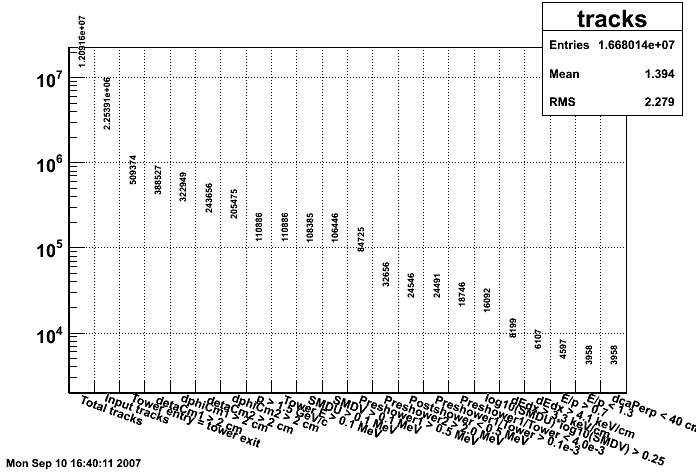
Figure 1: Number of tracks surviving each successive cut
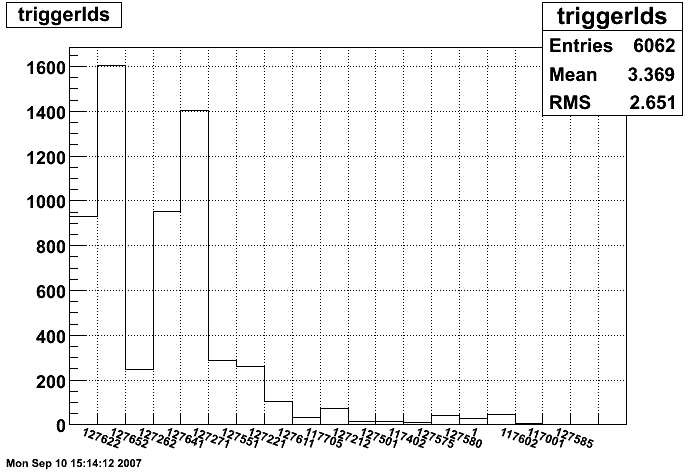
Figure 2a: Number of tracks per trigger id for all electron candidates. Most common trigger ids are:
127652
eemc-jp0-etot-mb-L2jet
EEMC JP > th0 (32, 4 GeV) and ETOT > TH (109, 14 GeV), minbias condition, L2 Jet algorithm, reading out slow detectors, transverse running
127271
eemc-jp1-mb
EEMC JP > th1 (49, 8 GeV) && mb, reading out slow detectors, transverse running
127641
eemc-http-mb-l2gamma
EEMC HT > th1 (12, 2.6 GeV, run < 7100052;13, 2.8 GeV, run >=7100052) and TP > TH1 (17, 3.8 GeV, run < 710052; 21, 4.7 GeV, run>=7100052 ), minbias condition, L2 Gamma algorithm, reading out slow detectors, L2 thresholds at 3.4, 5.4, transverse running
127622
bemc-jp0-etot-mb-L2jet
BEMC JP > th0 (42, 4 GeV) and ETOT > TH (109, 14 GeV), minbias condition, L2 Jet algorithm, reading out slow detectors, transverse running; L2jet thresholds at 8.0,3.6,3.3
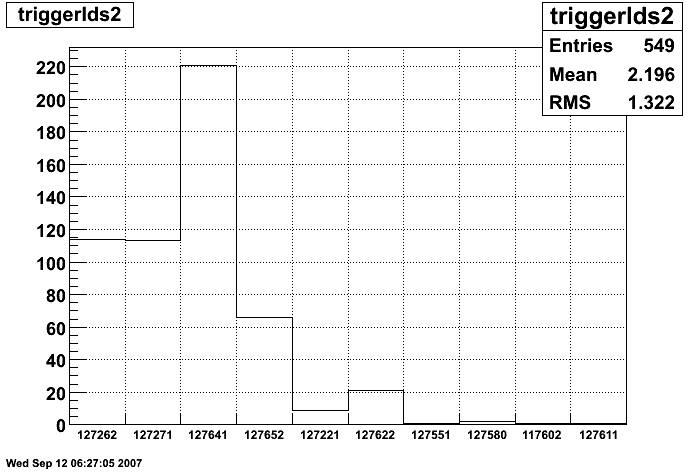
Figure 2b: Number of tracks per trigger id for all electron candidates for pT > 4 GeV. The dominant trigger ids become:
| 127641 | eemc-http-mb-l2gamma | EEMC HT > th1 (12, 2.6 GeV, run < 7100052;13, 2.8 GeV, run >=7100052) and TP > TH1 (17, 3.8 GeV, run < 710052; 21, 4.7 GeV, run>=7100052 ), minbias condition, L2 Gamma algorithm, reading out slow detectors, L2 thresholds at 3.4, 5.4, transverse running |
| 127262 | eemc-ht2-mb-emul | EEMC HT > th2 (22, 5.0 GeV) && mb, reading out slow detectors, emulated in L2, transverse running, different threshold from 117262 |
| 127271 | eemc-jp1-mb | EEMC JP > th1 (49, 8 GeV) && mb, reading out slow detectors, transverse running |
| 127652 | eemc-jp0-etot-mb-L2jet | EEMC JP > th0 (32, 4 GeV) and ETOT > TH (109, 14 GeV), minbias condition, L2 Jet algorithm, reading out slow detectors, transverse running |

Figure 3: pT distribution of tracks before E/p, dE/dx and pT cut
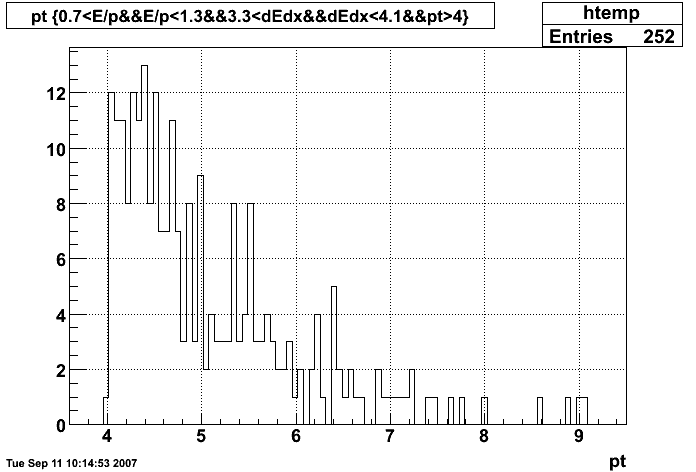
Figure 4: pT distribution of electron candidates with pT > 4 GeV
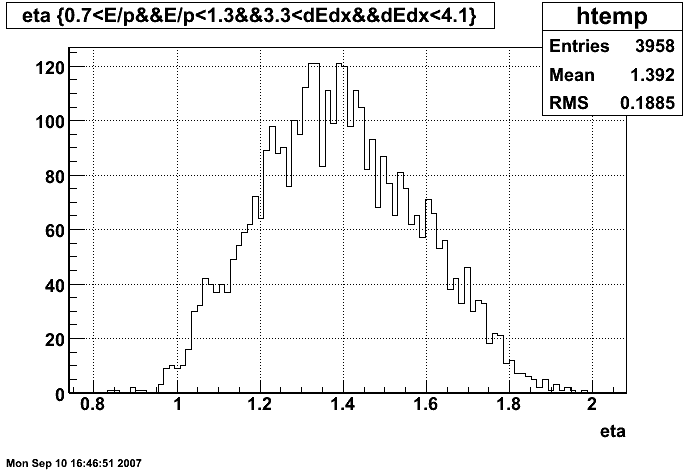
Figure 5: η distribution of electron candidates (all pT)
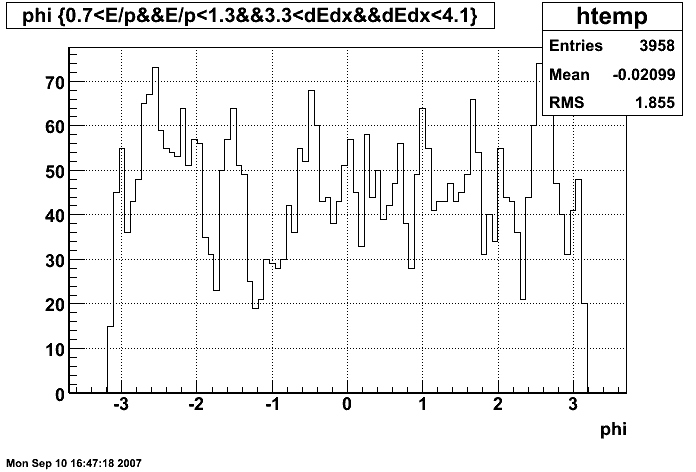
Figure 6: φ distribution of electron candidates (all pT)
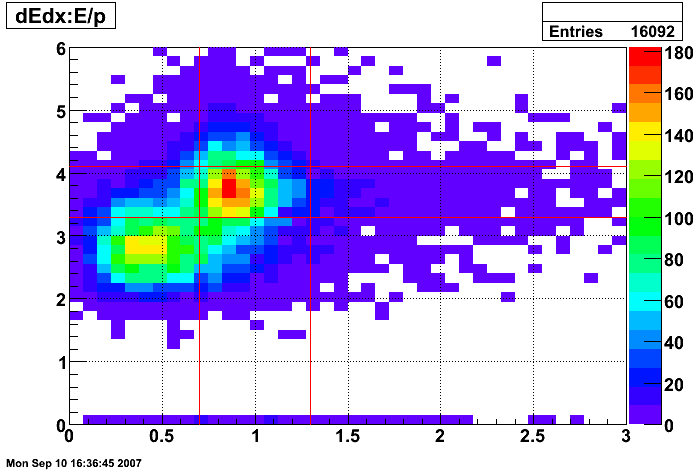
Figure 7: dE/dx of tracks before E/p and dE/dx cuts (all pT)
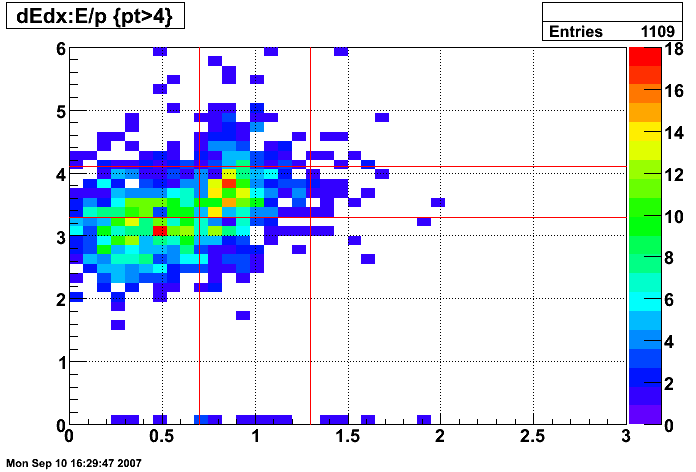
Figure 8: dE/dx of tracks before E/p and dE/dx cuts (pT > 4 GeV)
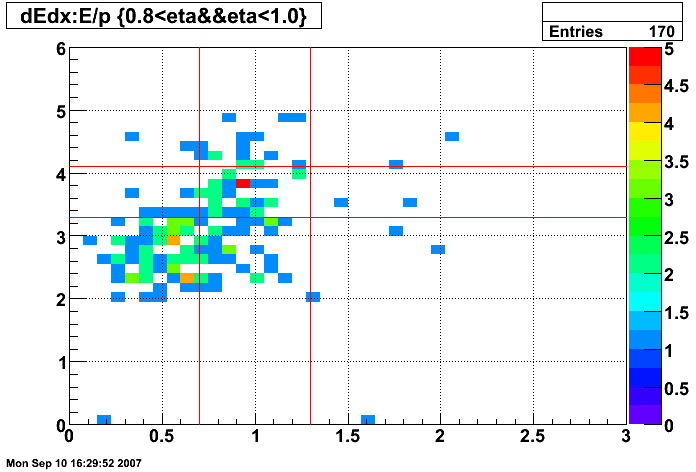
Figure 9: dE/dx of tracks before E/p and dE/dx cuts (all pT and 0.8 < η < 1.0)
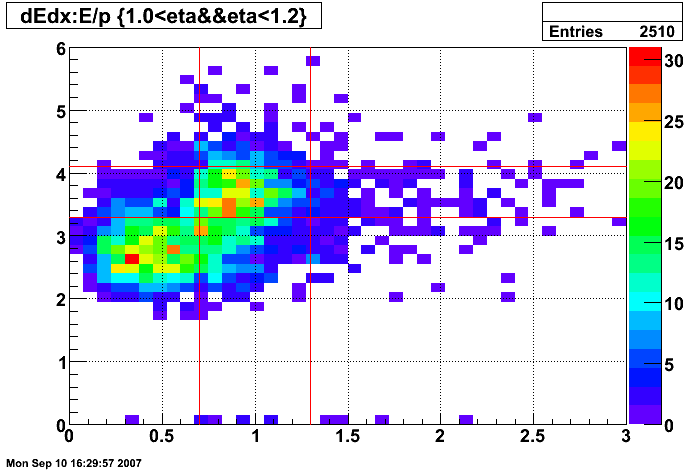
Figure 10: dE/dx of tracks before E/p and dE/dx cuts (all pT and 1.0 < η < 1.2)
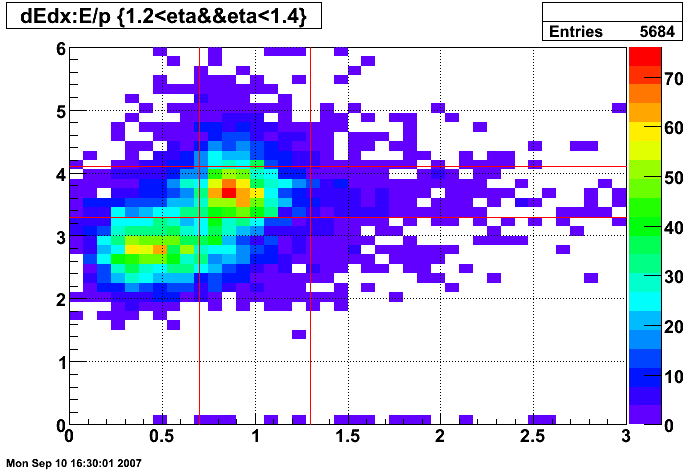
Figure 11: dE/dx of tracks before E/p and dE/dx cuts (all pT and 1.2 < η < 1.4)
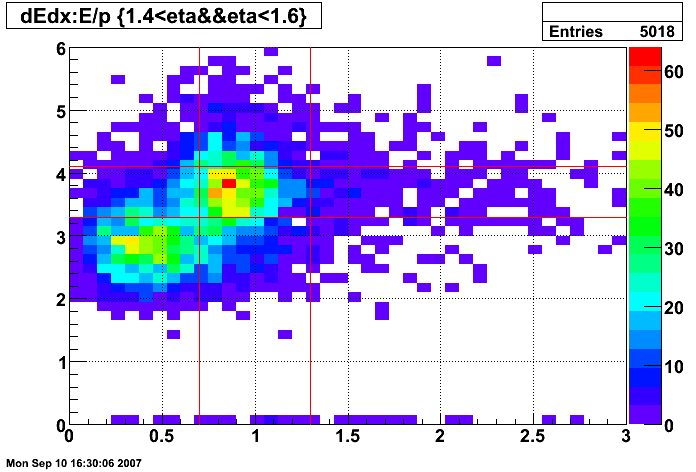
Figure 12: dE/dx of tracks before E/p and dE/dx cuts (all pT and 1.4 < η < 1.6)
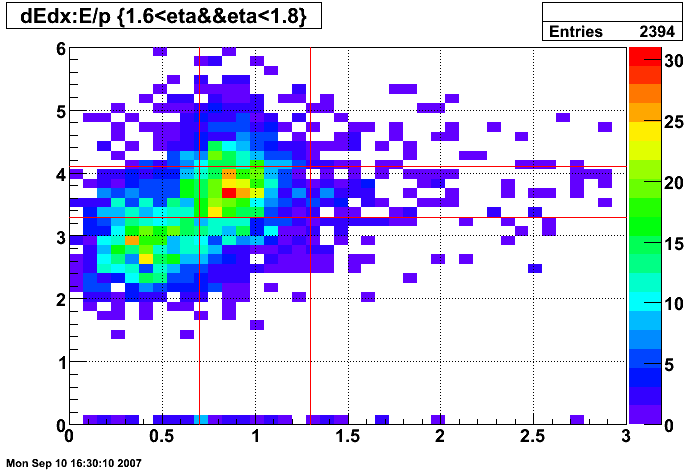
Figure 13: dE/dx of tracks before E/p and dE/dx cuts (all pT and 1.6 < η < 1.8)
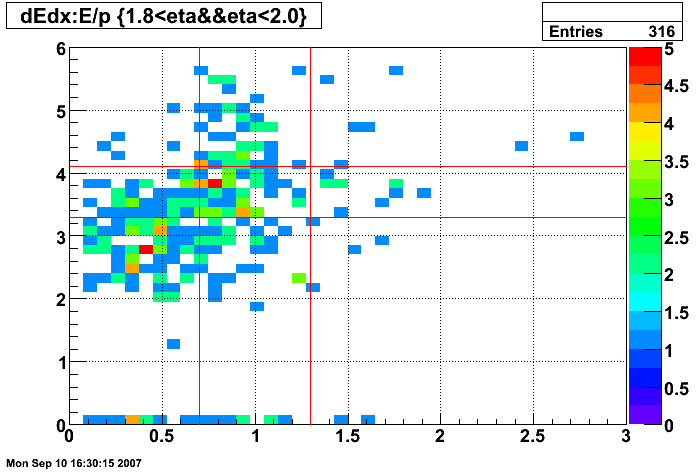
Figure 14: dE/dx of tracks before E/p and dE/dx cuts (all pT and 1.8 < η < 2.0)
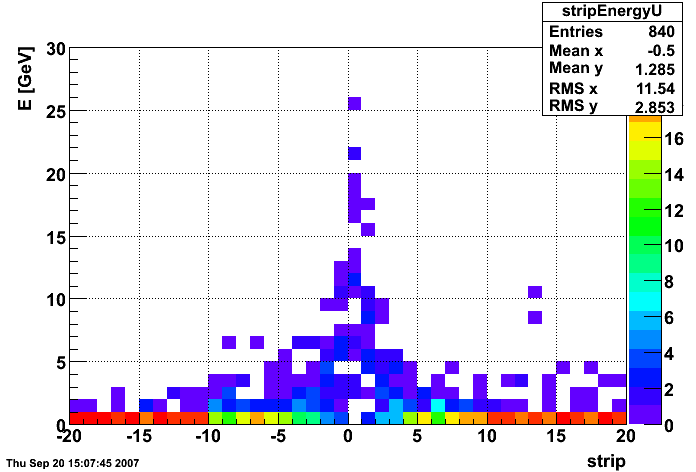
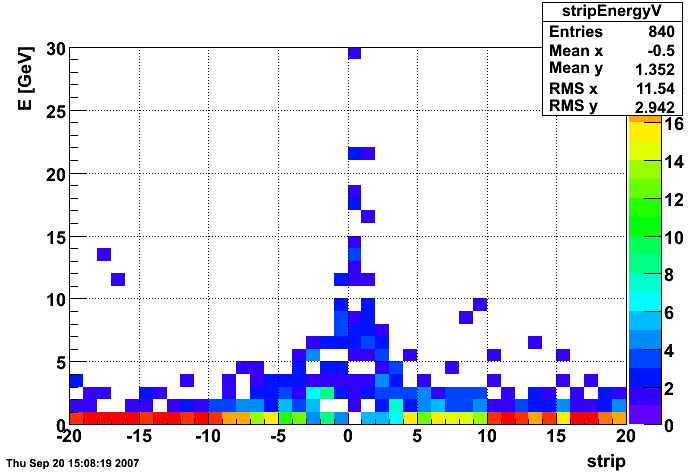
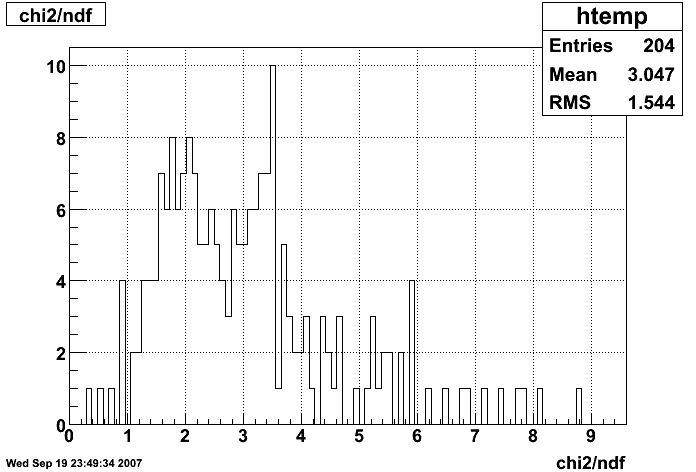

Figure 2.1

Figure 2.2: The dominant trigger ids are:
| 137273 | eemc-jp1-mb | EEMC JP > th1 (52, 8.7 GeV) && mb, reading out slow detectors, longitudinal running 2 |
| 137641 | eemc-http-mb-l2gamma | EEMC HT > th1 (16, 3.5 GeV) and TP > th1 (20, 4.5 GeV), minbias condition, L2 Gamma algorithm, reading out slow detectors, L2 thresholds at 3.7, 5.2, longitudinal running 2 |
| 137262 | eemc-ht2-mb-emul | EEMC HT > th2 (22, 5.0 GeV) && mb, reading out slow detectors, emulated in L2, longitudinal running 2 |
| 137222 | bemc-jp1-mb | BEMC JP > th1 (60, 8.3 GeV) && mb, reading out slow detectors, longitudinal running 2 |

Figure 2.3a

Figure 2.3

Figure 2.4

Figure 2.5

Figure 2.6

Figure 2.7

Figure 2.8

Figure 2.9

Figure 2.10
Click here for a tarball of the code used in this analysis.
SMD response function
Transverse
21 electrons
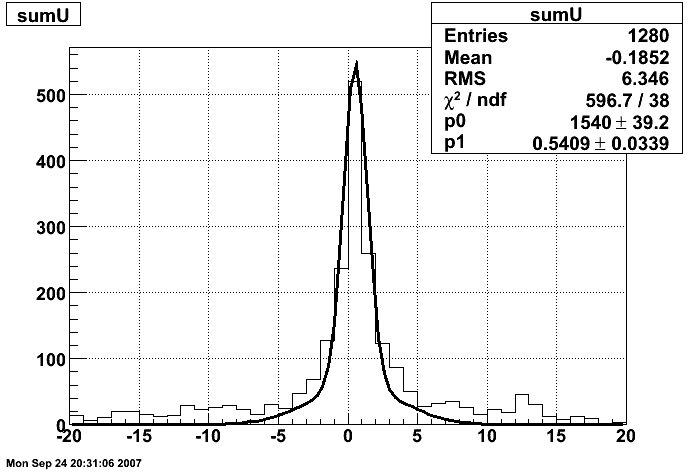
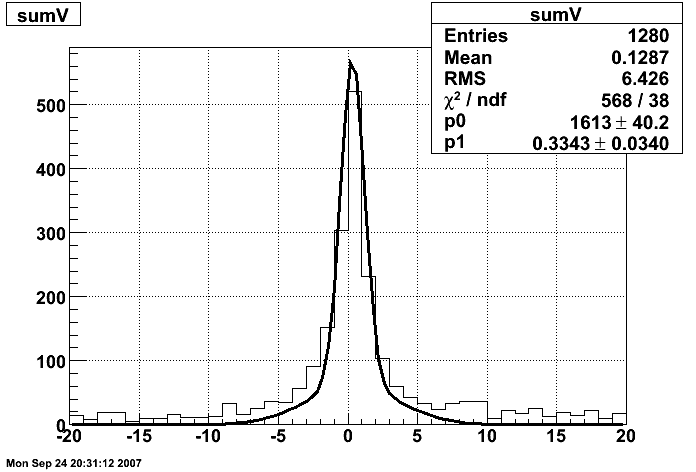
Longitudinal
99 electrons


Pibero Djawotho Last updated Wed Sep 12 08:29:53 EDT 2007
2008.01.23 Endcap etas
Endcap etas
Endcap etas
This analysis to look for etas at higher energy is in part motivated by this study. The interest in etas, of course, is that their decay photons are well separated at moderate energies (certainly more separated than the photons from pi0 decay). I ran Weihong's pi0 finder with tower seed threshold of 0.8 GeV and SMD seed threshold of 5 MeV (I believe his default SMD seed setting is 2 MeV). I then look in the 2-photon invariant mass region between 0.45 and 0.65 GeV (the PDG nominal mass for the eta is 0.54745 +/- 0.00019 GeV). I observe what looks like a faint eta peak. The dataset processed is the longitudinal 2 run of 2006 from the 20 runs sitting on the IUCF disk in Weihong's directory (/star/institutions/iucf/hew/2006ppLongRuns/).
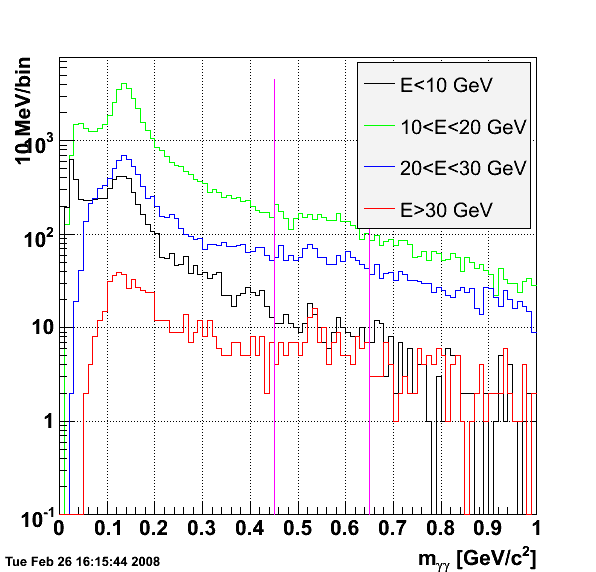
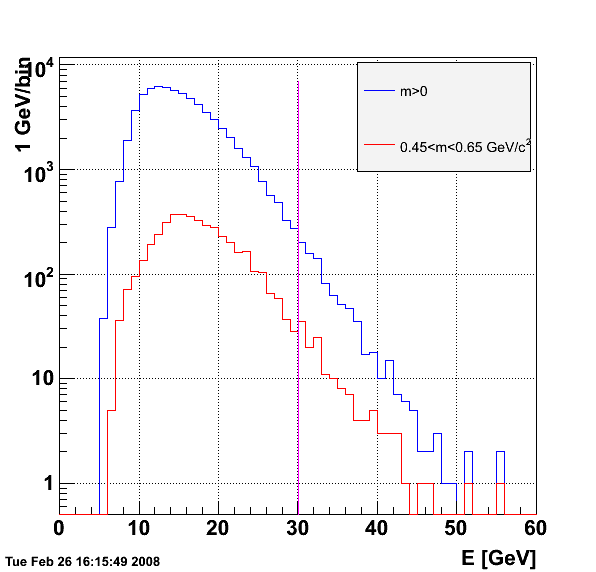
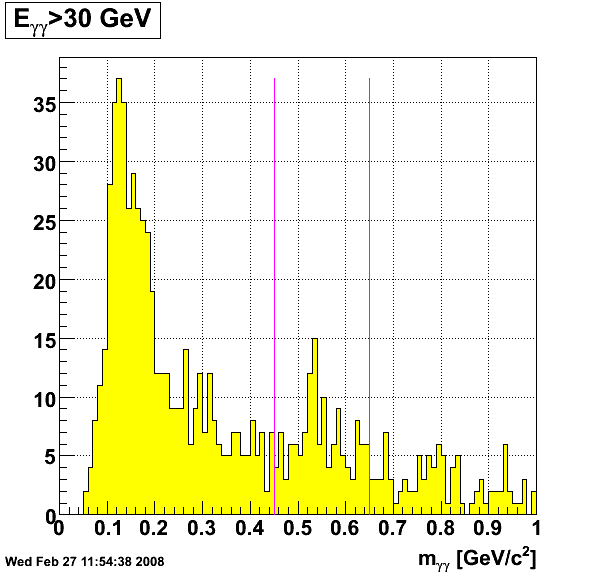
Within the reconstructed mass window 0.45 to 0.65 GeV, I take a look at the decay photon shower profiles in the SMD. The samples are saved in the file etas.pdf. For the most part, these shower shapes are cleaner than the original sample. Although the statistics are not great.
Additional Material
- List of etas from Weihong (text file)
- List of etas from Weihong (pdf file)
- List of etas from Weihong using gammma maker
- List of etas from Weihong (all 12 sectors)
- Hal's eta spreadsheet
- Hal's revised eta spreadsheet
Documents
- Direct photon center-of-mass angular distributions in proton-antiproton collisions at sqrt(s)=1.8 TeV (Leslie Nakae Thesis)
- Measurement of the cross section for production of two isolated prompt photons in 1.8-TeV proton-antiproton collisions (Mikio Takano Thesis)
- Measurement of sqrt(s) dependence of isolated direct photon production in proton-antiproton collisions (Dana Partos)
- Prompt photon cross section measurement in pbar-p collisions at sqrt(s)=1.8 TeV (PRD 48 2998, 1993)
- A prompt photon cross section measurement in pbar-p collisions at sqrt(s)=1.8 TeV (FERMILAB-Pub-92/001-E)
Pibero Djawotho Last updated Wed Jan 23 12:35:43 EST 2008
2008.02.27 ESMD shape library
ESMD shape library
Shower Widths for Monte Carlo and Data
Description
Hal did a comparison of the widths of the shower shapes between Monte Carlo and data. Below is a description of what was done.
I took the nominal central value, either from the maxHit or the
nominal central value, and added the energy in the +/- 12 strips. Then I
computed the mean strip (which may have been different from the nominal
central value!!). I normalized the shape to give unit area for each smd
cluster, and added to the histograms separately for U and V and for MC and
data (= Will's events). I did NOT handle Will's events correctly, just
using whatever event was chosen randomly, rather than going through his
list sequentially. Note I ran 1000 events, and got 94 events in my shower
shape histos.
So, there are several minor problems. 1) I didn't go through Will's
events sequentially. 2) I normalized, but perhaps not to the correct 25
strips, because the mean strip and the nominal strip may have differed.
3) there may have been a cutoff on some events due to being close to one
end of the smd plane (near strip 0 or 287). My sense from looking at the
plots is that these don't matter much.
The conclusion is that the MC shape is significantly narrower than
the shape from Will's events, which is obviously narrower than the random
clusters we were using at first with no selection for the etas. Hence, we
are not wasting our time with this project.
- Monte Carlo U shower shape
- Monte Carlo V shower shape
- SMDU shower shape (Will's selection)
- SMDV shower shape (Will's selection)
- Energy Asymmetry
- Index of Library Entry
Decsription of Pythia Sample
A few histograms were added to the code:
- MC is Pythia gamma-jet at partonic pT 9-11 GeV with gamma in the Endcap
- Data is from Will Jacobs golden events from Weihong sample
- Require no conversion
- Require all hits from direct photon in same sector
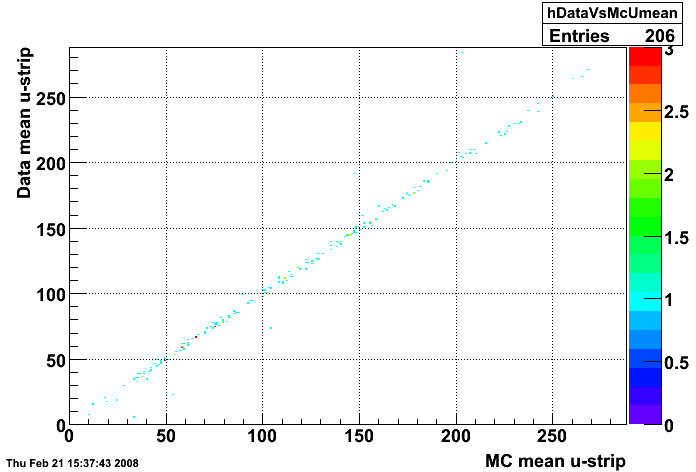
Figure 1:
Data vs. MC mean u-strip
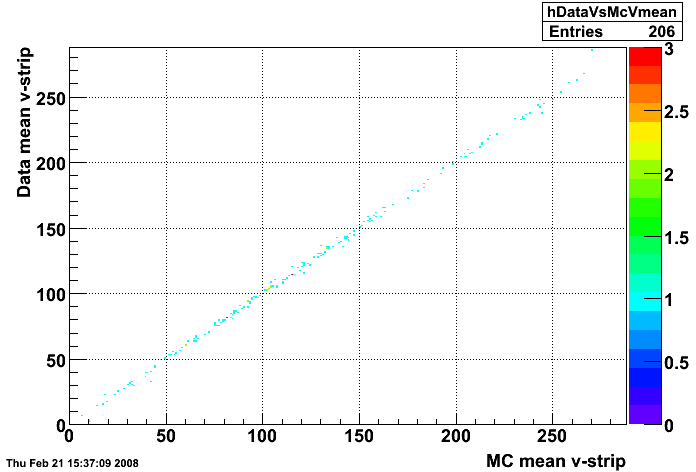
Figure 2:
Data vs. MC mean v-strip
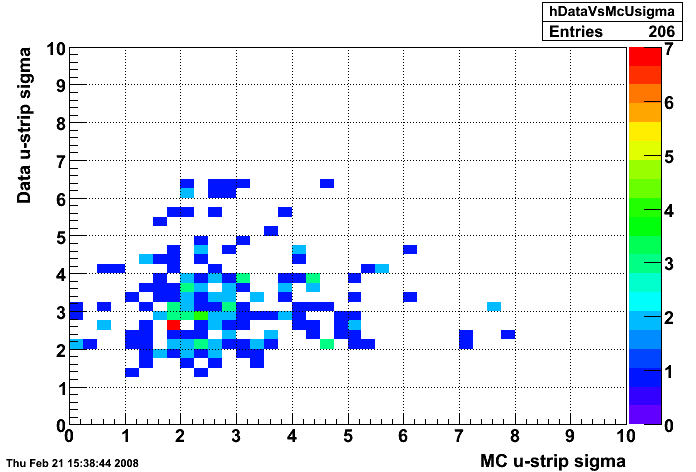
Figure 3:
Data vs. MC u-strip sigma
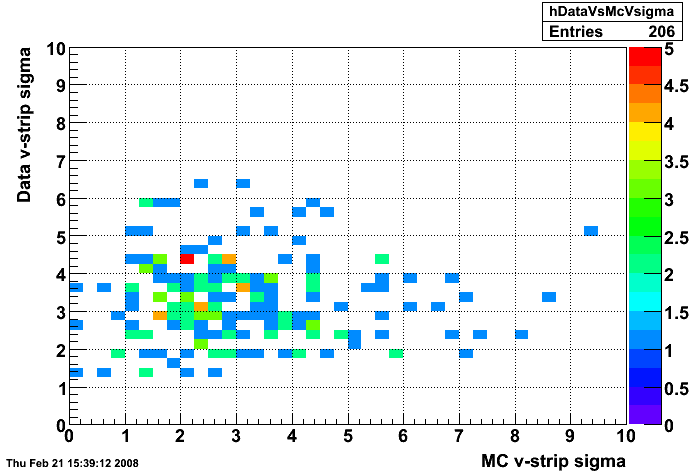
Figure 4:
Data vs. MC v-strip sigma
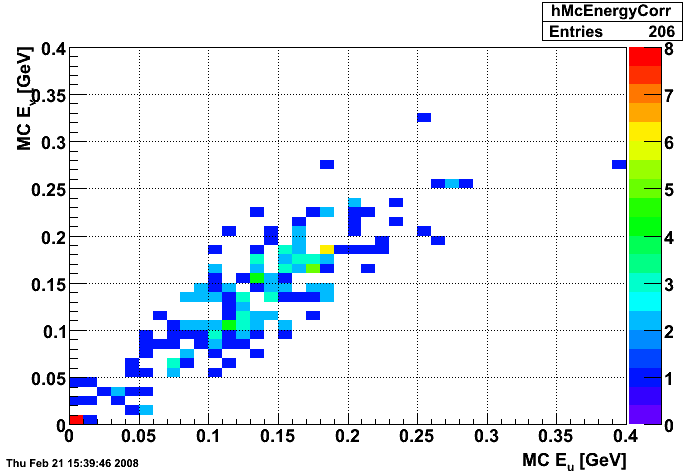
Figure 5:
MC E
v
vs. E
u
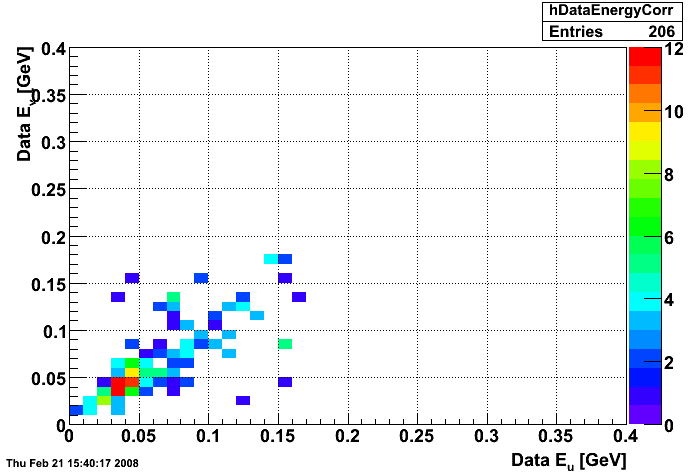
Figure 6:
Data E
v
vs. E
u
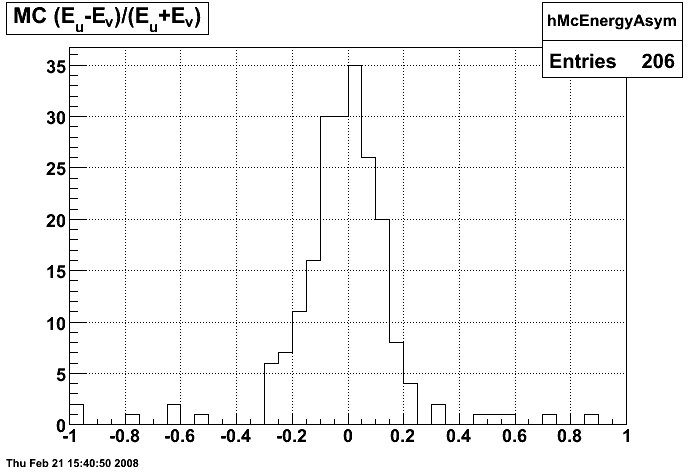
Figure 7:
MC energy asymmetry in SMD planes
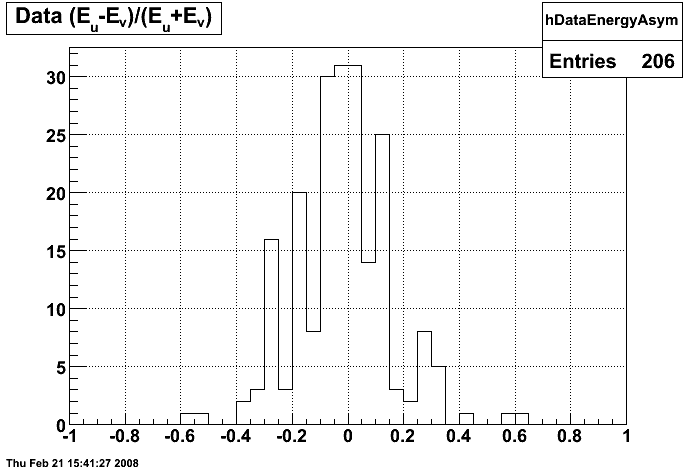
Figure 8:
Data energy asymmetry in SMD planes
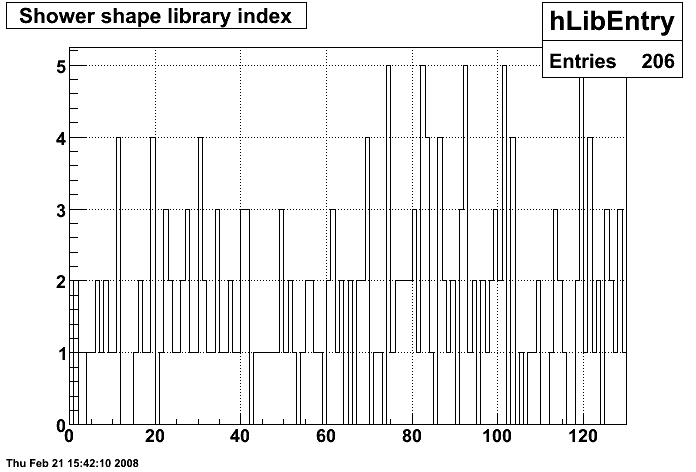
Figure 9:
Shower shape library index used (picked at random)
Single events shower shapes are displayed in
or
.
- green = projected position of direct photon in the Endcap
- blue = Monte Carlo SMD response
- red = Data SMD response
Hal Spinka Pibero Djawotho Last modified Wed Feb 27 09:51:27 EST 2008
2008.02.28 ESMD QA for run 7136033
ESMD QA for run 7136033
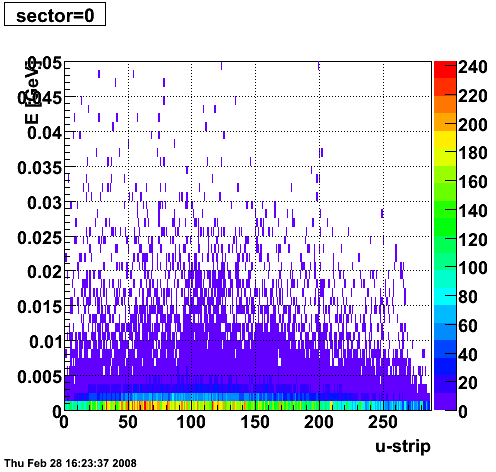 |
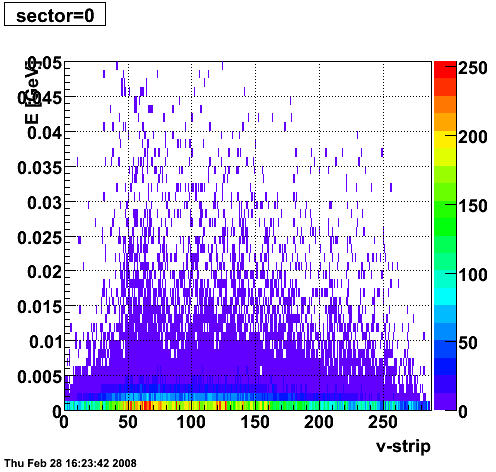 |
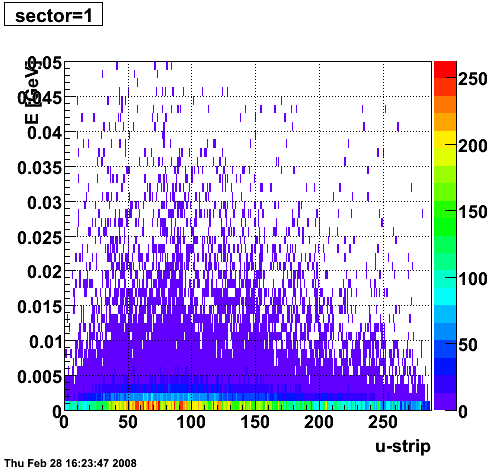 |
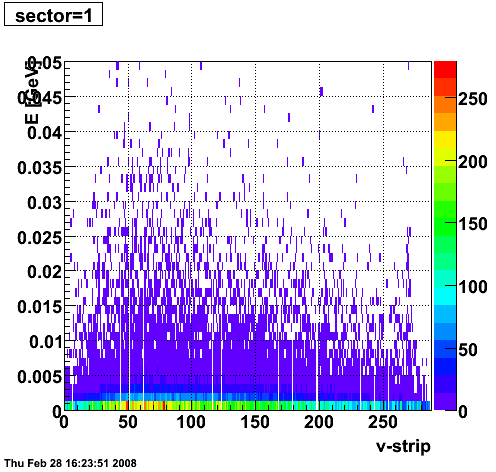 |
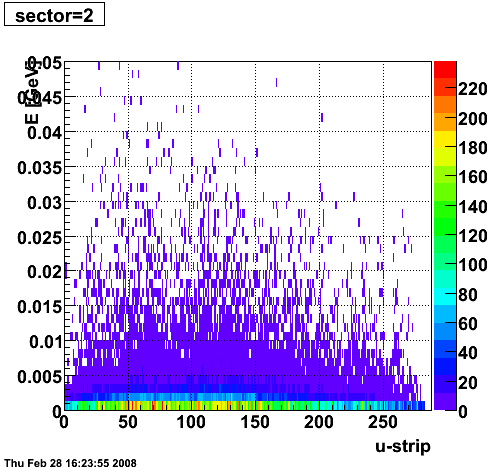 |
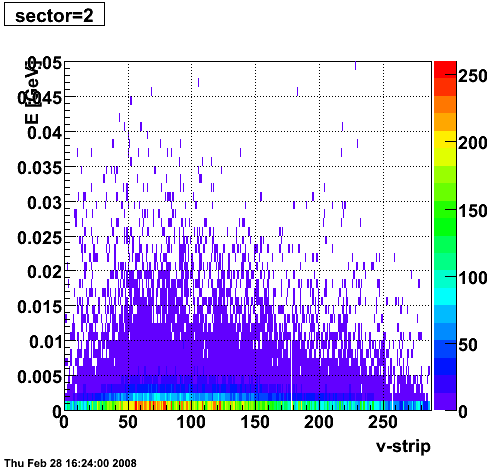 |
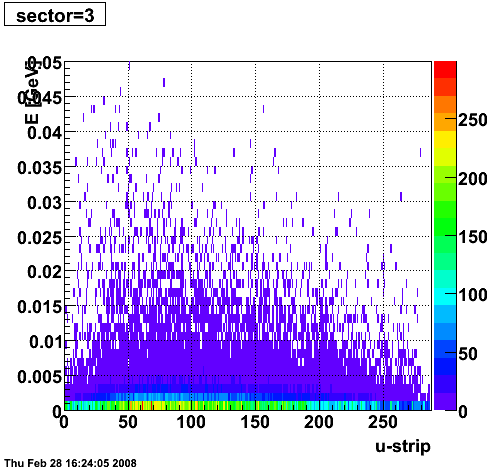 |
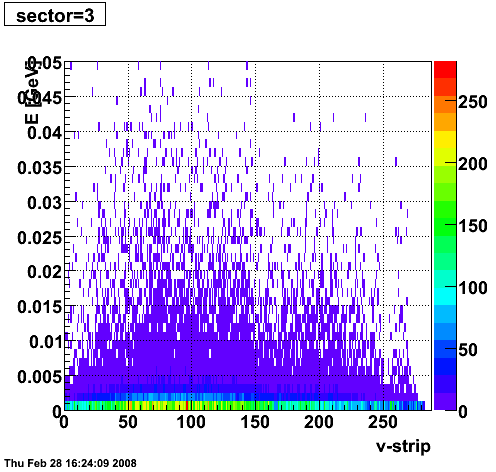 |
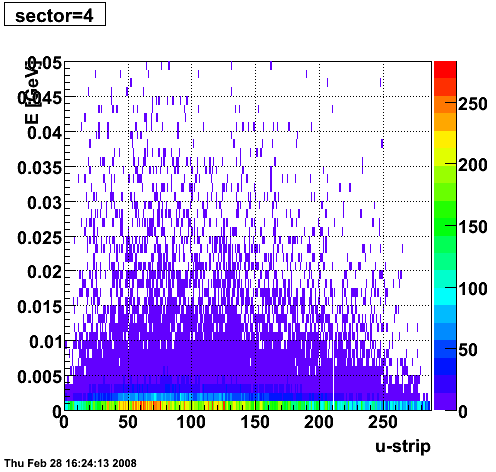 |
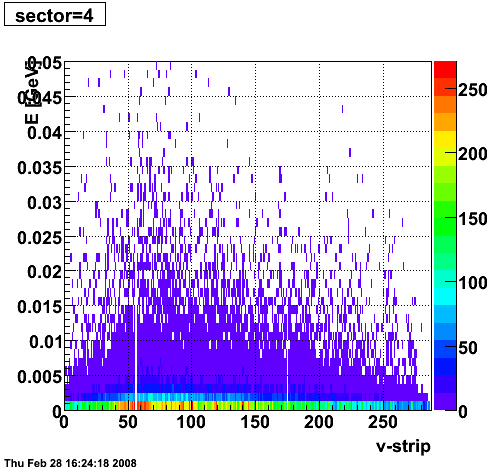 |
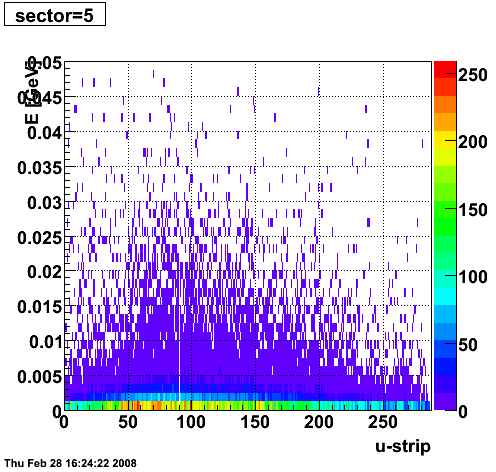 |
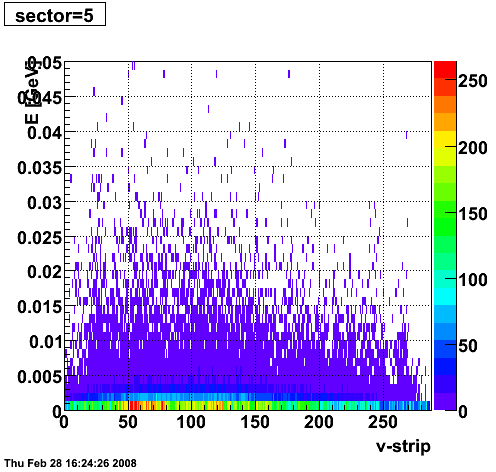 |
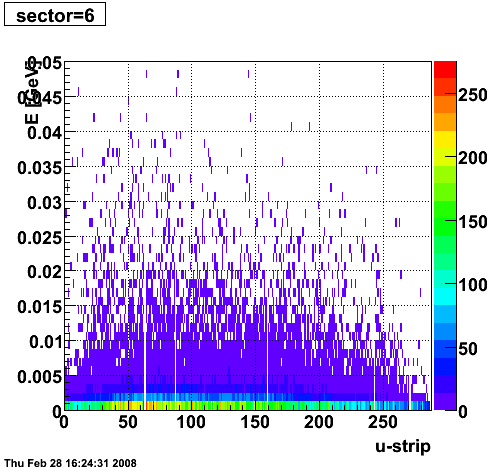 |
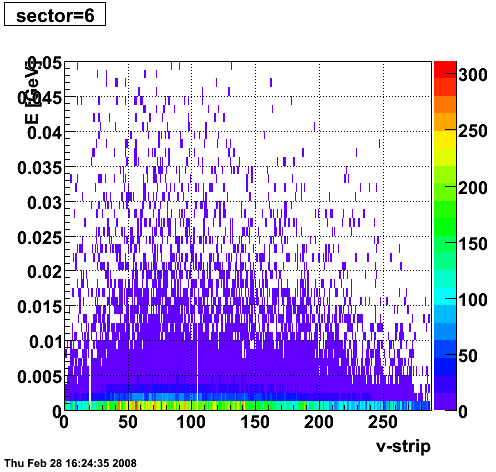 |
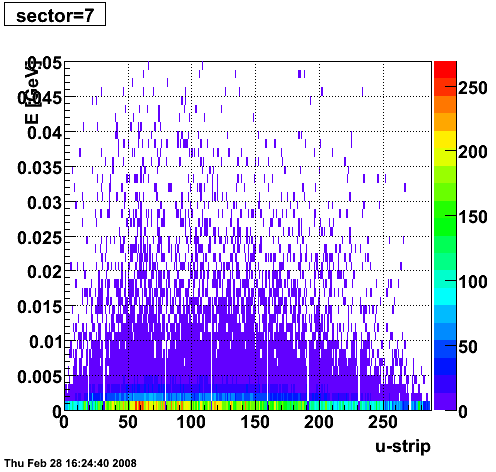 |
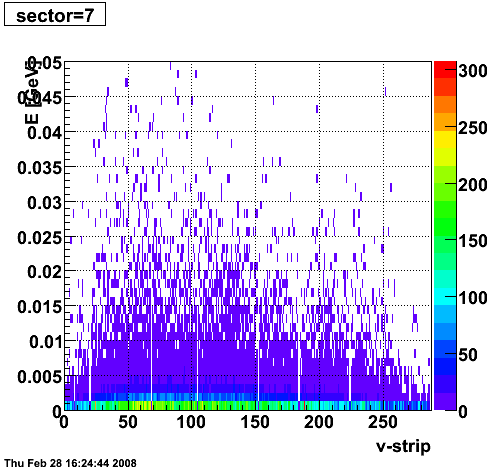 |
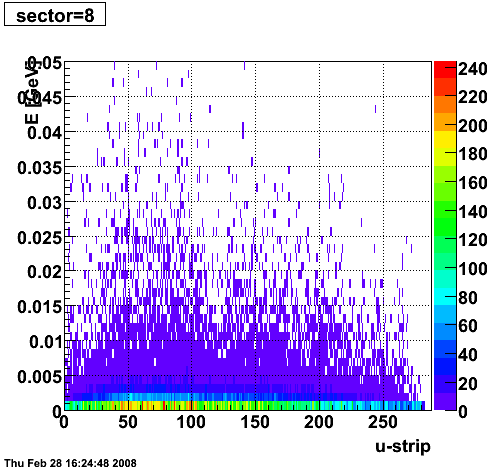 |
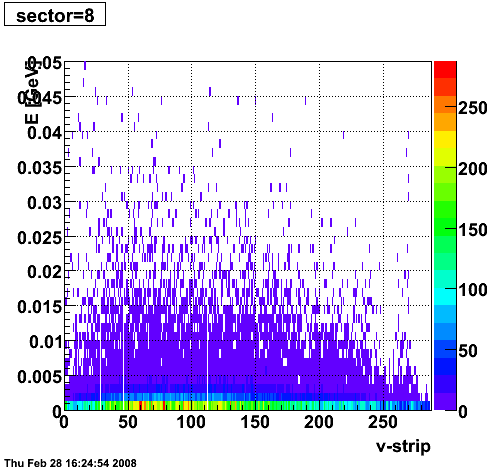 |
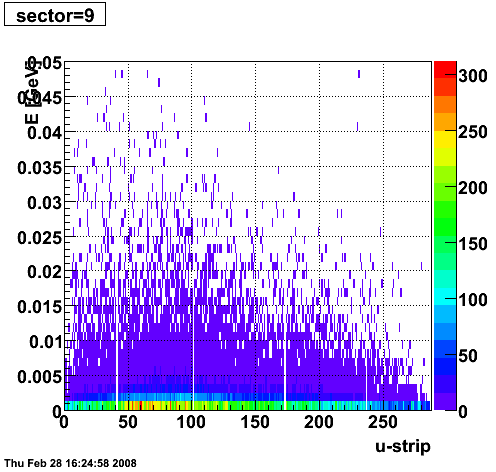 |
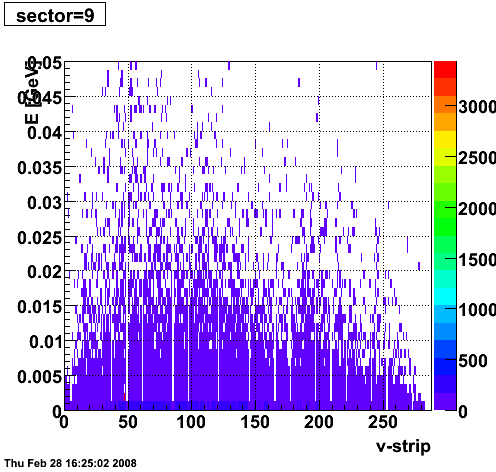 |
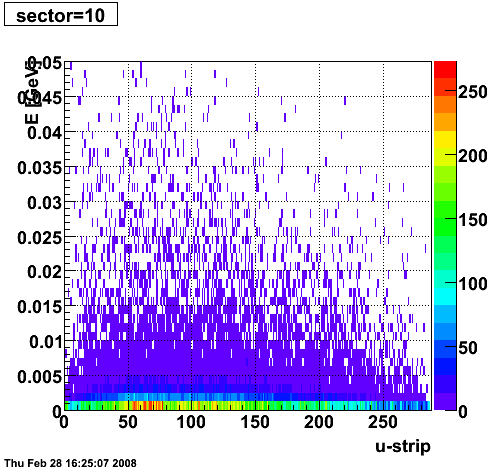 |
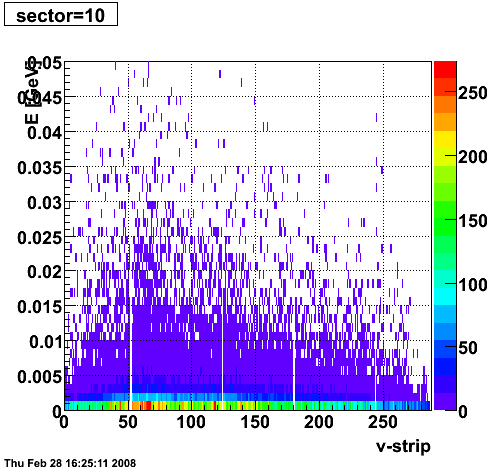 |
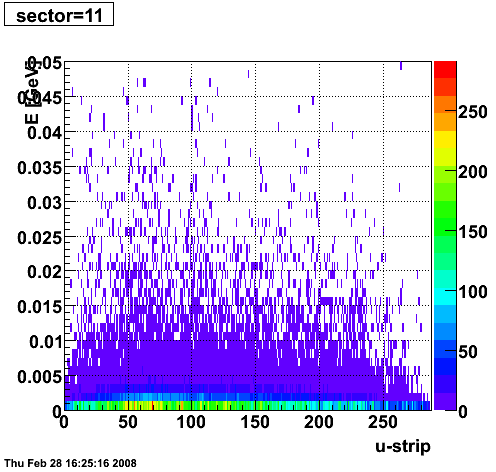 |
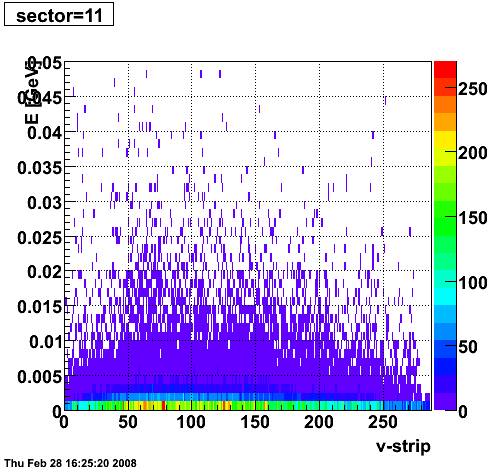 |
Pibero Djawotho Last updated Thu Feb 28 16:17:55 EST 2008
2008.03.04 A second look at eta mesons in the STAR Endcap Calorimeter
A second look at eta mesons in the STAR Endcap Calorimeter
Introduction
In case you missed it, the first look is
. I processed
from the 2006 pp longitudinal 2 runs and picked events tagged with the L2gamma trigger id (137641). I ran the StGammaMaker on the MuDst files from these runs and produced gamma trees. These gamma trees are available at
/star/institutions/iucf/pibero/2007/etaLong/
. Within the StGammaMaker framework, I developed code to seek candidate etas with emphasis on high purity. The macros and source files are:
Note, the workhorse function is
StEtaFinder::findTowerPoints()
.
Algorithm
- Find seed tower with pT > 0.8 GeV
- Require no TPC track into the seed tower
- Get the ranges of SMD U & V strips that span the volume of the seed tower
- Find the strips with maximum energy within these ranges
- Require that the maximum strips have more than 2 MeV in each SMD plane
- Get the intersection of the maximum strips and ensures that it lies within 70% of the fiducial volume of the seed tower
- Make sure the photon candidate responsible for the SMD clusters above enters and exits the same seed tower
- Form a 11-strip cluster in each plane with +/-5 strips around the max strip and require that it contains 70% of the energy in a range +/-20 strips around the max strip
- Require that the energy asymmetry between the 11-strip clusters in the U and V planes be less than 20%
- Create a point using the energy of the seed tower and the position of the intersection of the max strips in the SMD U and V planes
- Repeat until seed towers in the event are exhausted
- Combine different points in the event to calculate the invariant mass
- Diphoton pairs with invariant mass between 0.4 and 0.6 GeV are saved to a PDF file
Invariant mass
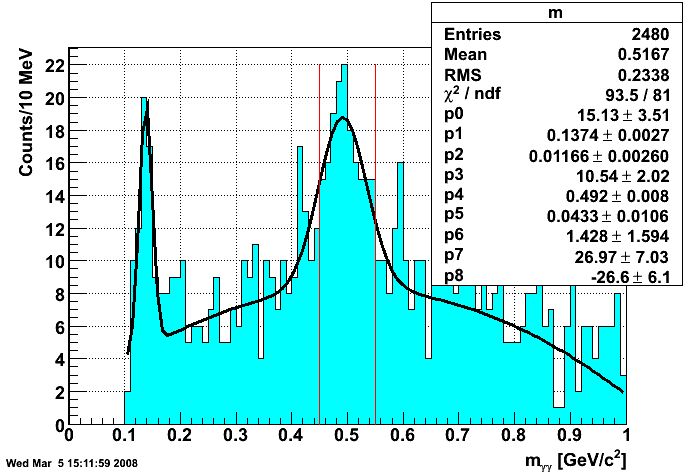
I fit the diphoton invariant mass with two Gaussians, one for the pi0 peak (p0-p2) and another one for the eta peak (p3-p5) plus a quadratic for the background (p6-p8). The Gaussian is of the form p0*exp(0.5*((x-p1)/p2)**2) and the quadratic is of the form p6*+p7*x+p8*x**2. A slightly better chi2/ndf in the fit is achieved by using Breit-Wigner functions instead of Gaussians for the signal here. I calculate the raw yield of etas from the fit as p3*sqrt(2*pi)*p5/bin_width = 85 where each bin is 0.010 GeV wide. I select candidate etas in the mass range 0.45 to 0.55 GeV and plot their photon response in the shower maximum detector here. Since we are interested in collecting photons of pT > 7 GeV, only those candidate photons with pT > 5 GeV will be used in the shower shape library. I also calculate the background under the signal region by integrating the background fit from 0.45 to 0.55 GeV and get 82 counts.
- S = 85
- B = 82
- S:B = 1.03:1
- S/√S+B = 6.6
Additional plots
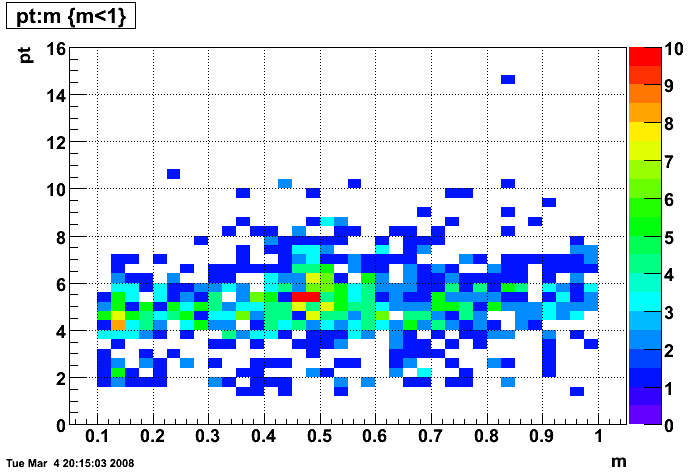
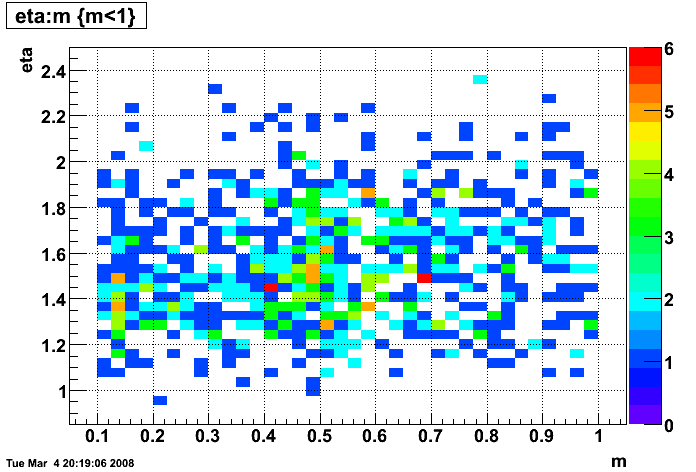
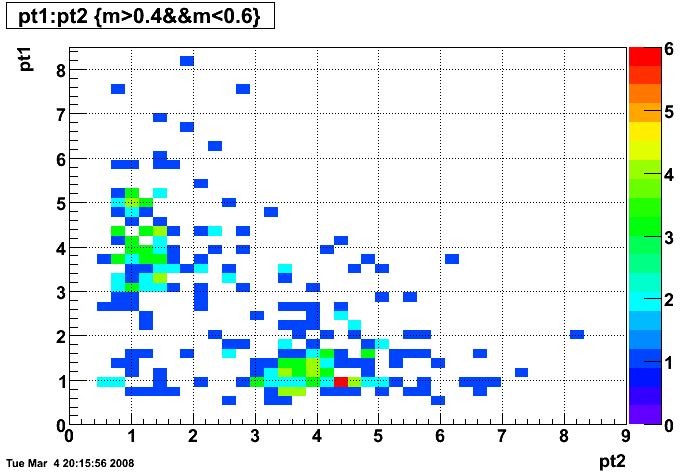
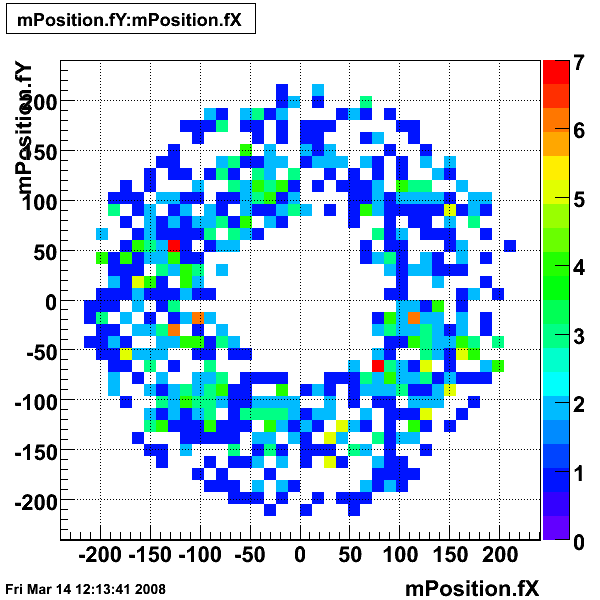
Pibero Djawotho Last updated at Tue Mar 4 16:21:13 EST 2008
2008.03.08 Adding the SMD energy to E_reco/E_MC for Photons
Adding the SMD energy to E_reco/E_MC for Photons
The following is a revisited study of E_reco/E_MC for photons with the addition of the SMD energy to E_reco.
QA plots for each energy
E_SMD/E_reco vs. eta
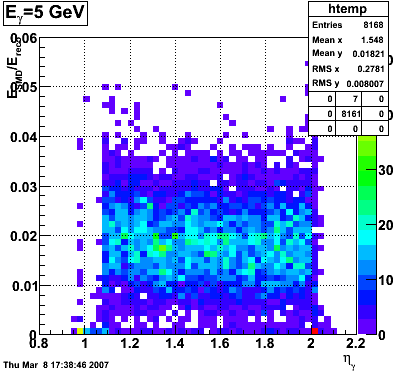 |
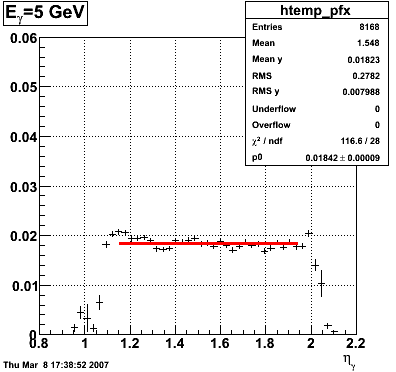 |
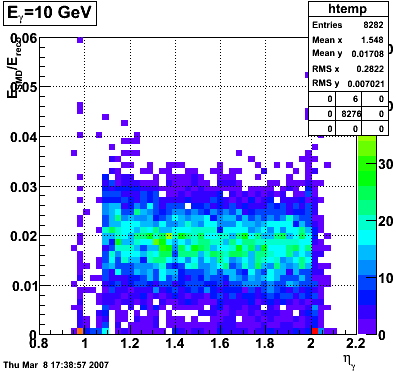 |
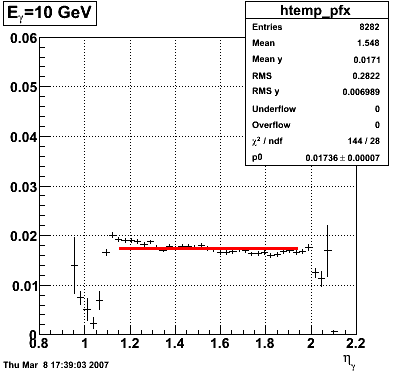 |
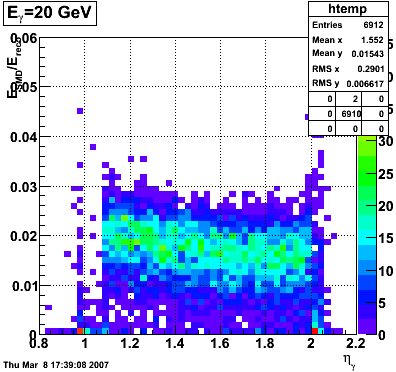 |
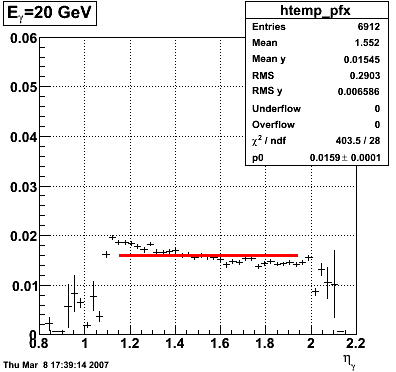 |
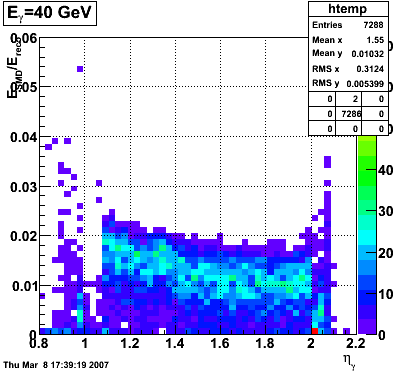 |
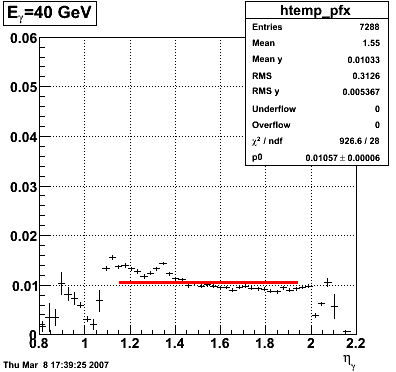 |
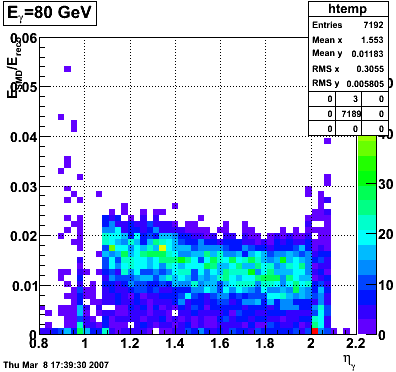 |
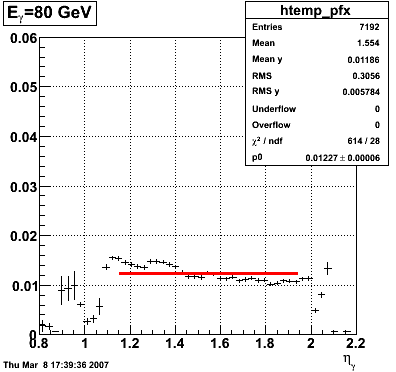 |
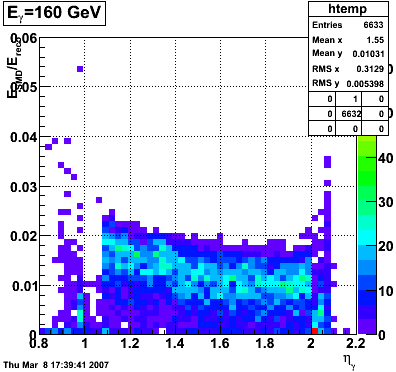 |
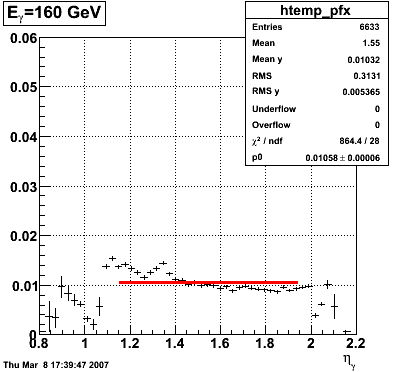 |
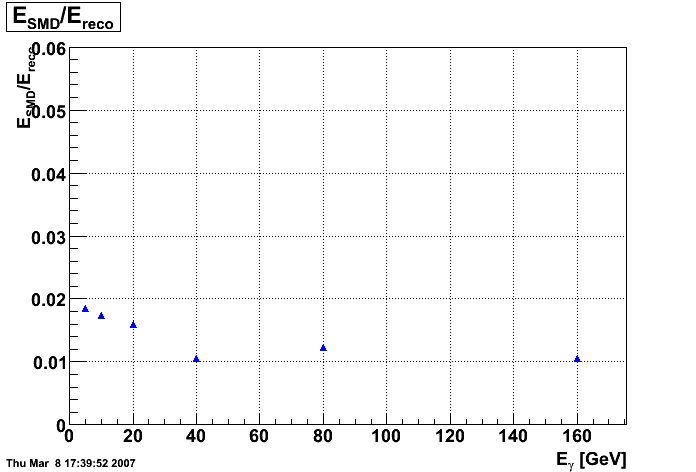
Pibero Djawotho Last updated Thu Mar 8 04:27:28 EST 2007
2008.03.21 Chi square method
SectorVsRunNumber.png 10-Feb-2010 12:22 14K
ShowerShapes.png 10-Feb-2010 12:22 17K
chiSquareMC.png 10-Feb-2010 12:22 13K
chiSquarePibero.png 10-Feb-2010 12:22 16K
chiSquareWill.png 10-Feb-2010 12:22 16K
chiSquareWillAndMC.png 10-Feb-2010 12:22 17K
2008.04.08 Data-Driven Shower Shapes
Data-Driven Shower Shapes
Gamma Conversion before the Endcap
The plots below show the conversion process before the Endcap. I look at prompt photons heading towards the Endcap from a MC gamma-jet sample with a partonic pT of 9-11 GeV. I identify those photons that convert using the GEANT record. The top left plot shows the total number of direct photons and those that convert. I register a 16% conversion rate. This is consistent with Jason's 2006 SVT review. The top right plot shows the source of conversion, where most of the conversions emanate from the SVT support cone, also consistent with Jason's study. The bottom left plot shows the separation in the SMD between the projected location of the photon and the location of the electron/positron from conversion.
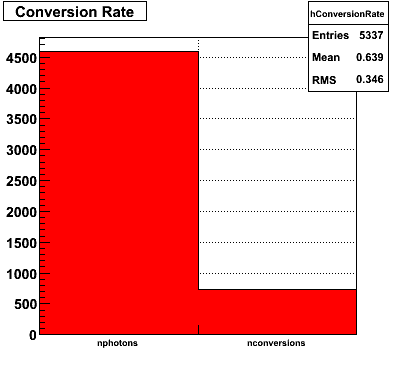 |
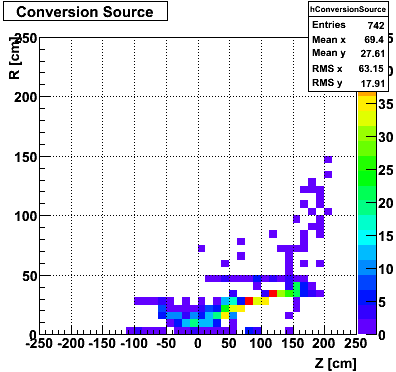 |
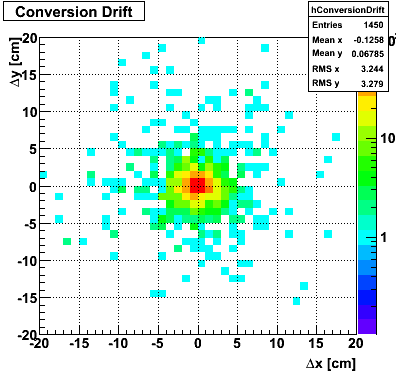 |
Shower shapes comparison
This
file shows several shower shapes in a single plot for comparison:
- MC - Monte Carlo shower shape from the 9-11 GeV pT gamma-jet Pythia sample
- DD - Data-driven Monte Carlo shower shape (Each final state photon shower shape is replaced with a corresponding shower shape from data in the same sector configuration, energy, preshower, and U/V-plane bin).
- Standard MC - Monte Carlo shower shape parametrized by Hal (also from the 9-11 GeV pT gamma-jet Pythia sample)
- Will - Data shower shape derived from photons from eta decays by Will using a modified version of Weihong/Jason meson pi0 finder
- Pibero - Data shower shape derived from photons from eta decays by Pibero using a crude eta finder
Shower Shapes Sorted by SMD Plane, Sector Configuration, Energy and Preshower
These Shower Shapes are binned by:
- SMD plane (U and V)
- Sector configuration with the formula sector%3 where sector=1..12, so 3 different bins. More details can be found at the EEMC Web site under the Geometry link.
- Energy of the photon (E < 8 GeV and E > 8 GeV)
- Preshower energy
(pre1==0&&pre2==0)and(pre1>0||pre2>0)
They are then fitted with a triple-Gaussian of the form:
[0]*([2]*exp(-0.5*((x-[1])/[3])**2)/(sqrt(2*pi)*[3])+[4]*exp(-0.5*((x-[1])/[5])**2)/(sqrt(2*pi)*[5])+(1-[2]-[4])*exp(-0.5*((x-[1])/[6])**2)/(sqrt(2*pi)*[6]))
Comparison of Sided Residuals for Monte Carlo (MC) and Data-Driven (DD) Shower Shapes
All fits to MC are with reference to the old Monte carlo fit function:
[0]*(0.69*exp(-0.5*((x-[1])/0.87)**2)/(sqrt(2*pi)*0.87)+0.31*exp(-0.5*((x-[1])/3.3)**2)/(sqrt(2*pi)*3.3))
All fits to the data are with reference to a single
. The fit function is:
[0]*([2]*exp(-0.5*((x-[1])/[3])**2)/(sqrt(2*pi)*[3])+[4]*exp(-0.5*((x-[1])/[5])**2)/(sqrt(2*pi)*[5])+(1-[2]-[4])*exp(-0.5*((x-[1])/[6])**2)/(sqrt(2*pi)*[6]))
- All Shower Shapes
- No Conversion
- Conversion
- No Preshower
- Preshower
- No Conversion and Preshower
- Sector Configuration 0
- Sector Configuration 1
- Sector Configuration 2
Comparison of Sided Raw Tails for Monte Carlo (MC) and Data-Driven (DD) Shower Shapes
- All Shower Shapes
- No Conversion
- Conversion
- No Preshower
- Preshower
- No Conversion and Preshower
- Sector Configuration 0
- Sector Configuration 1
- Sector Configuration 2
Pibero Djawotho Last updated Tue Apr 8 17:29:40 EDT 2008
2008.04.12 Data-Driven Residuals
Data-Driven Residuals
Gammas
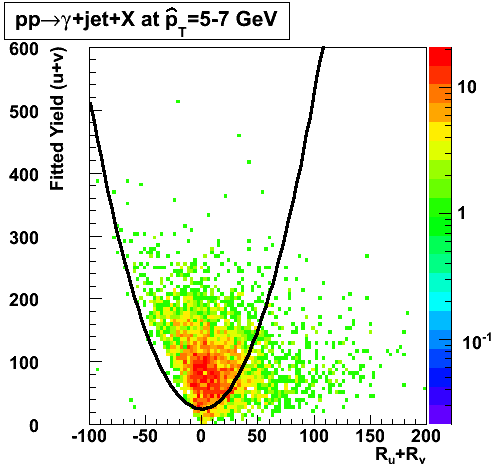 |
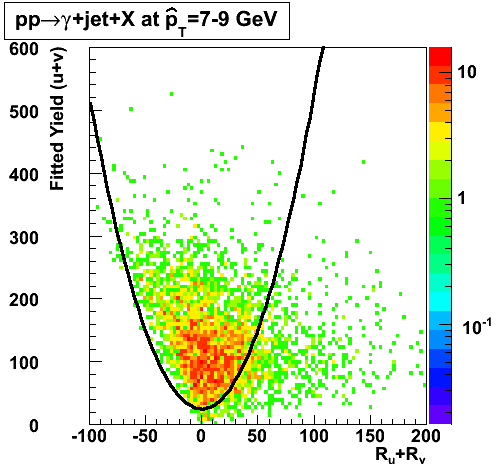 |
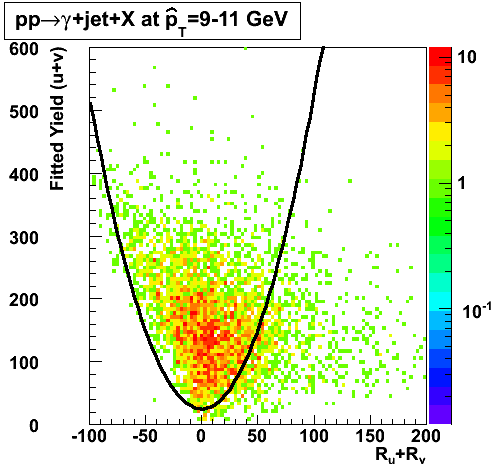 |
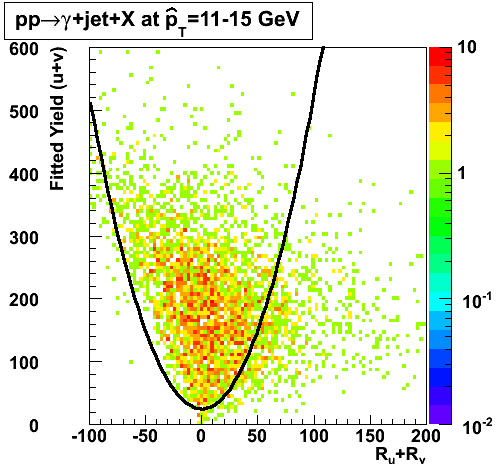 |
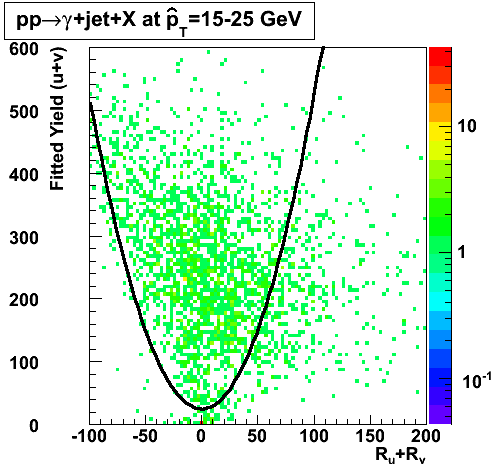 |
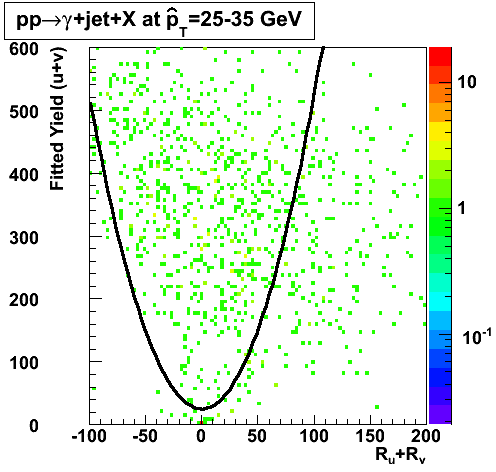 |
Jets
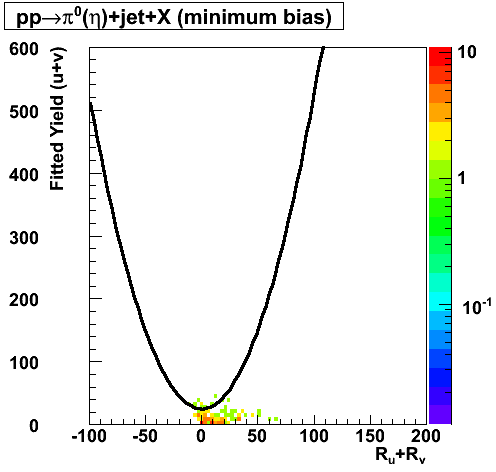 |
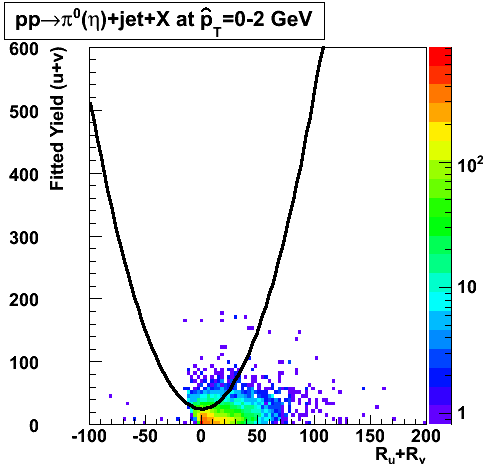 |
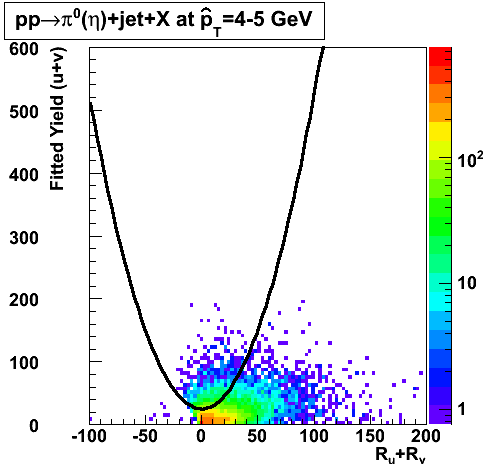 |
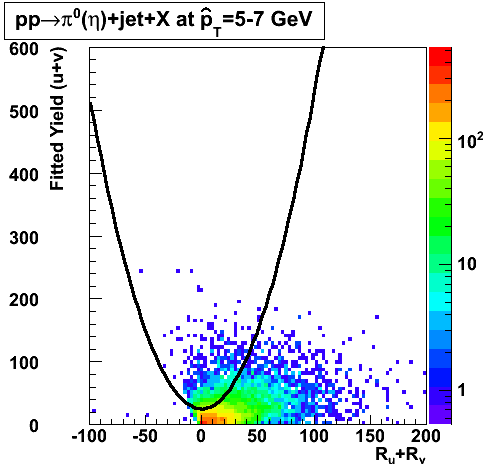 |
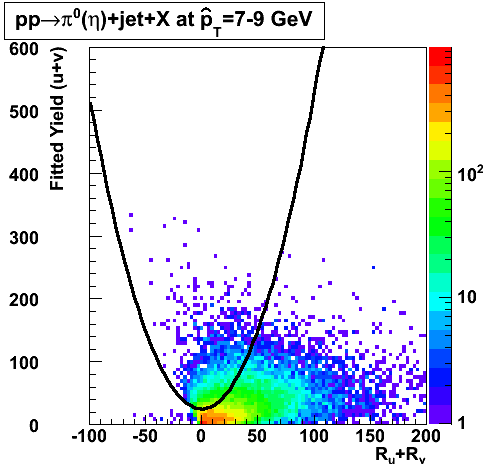 |
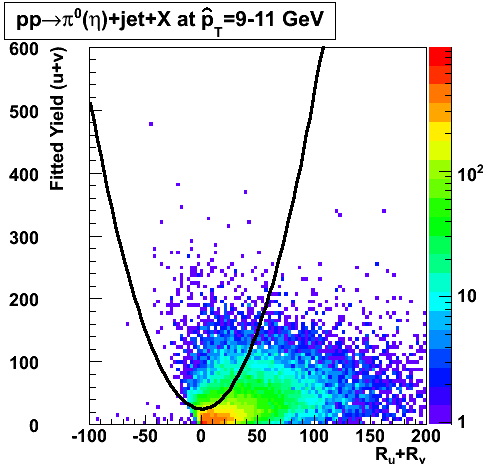 |
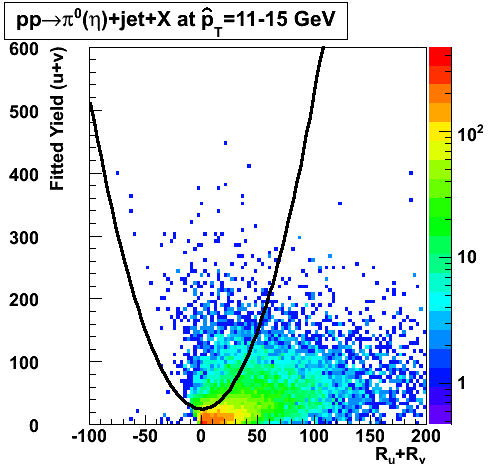 |
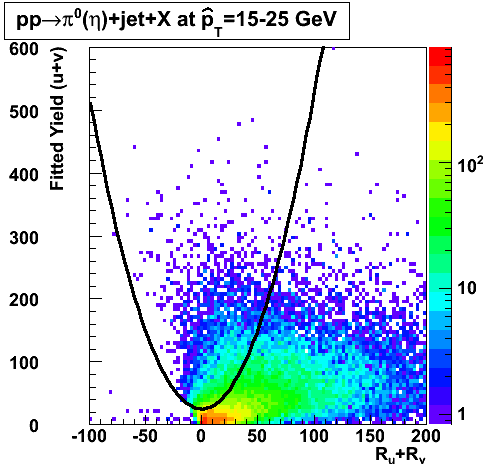 |
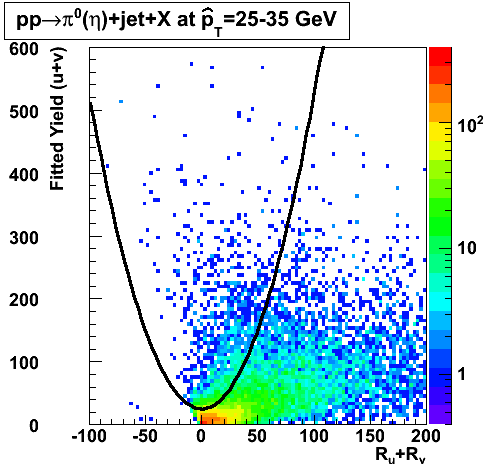 |
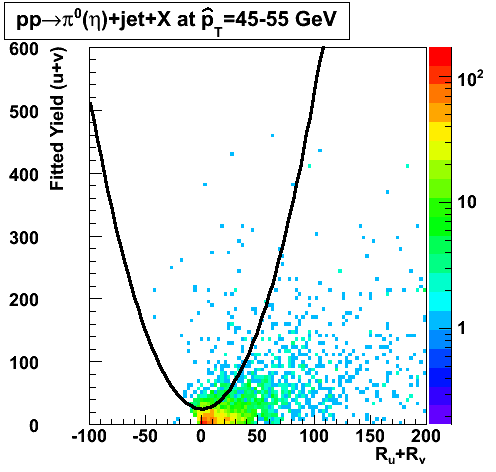 |
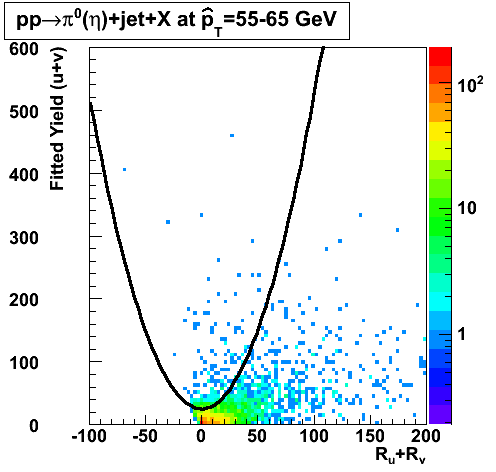 |
Background Rejection vs. Signal Efficiency
| Partonic pT=9-11 GeV | Partonic pT=9-11 GeV |
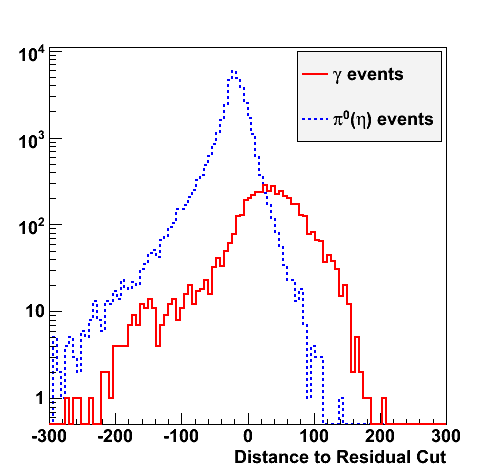 |
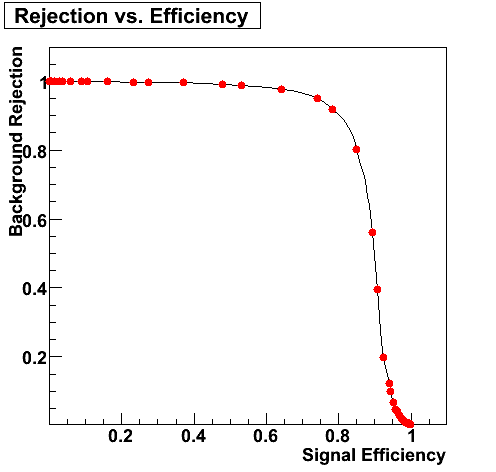 |
Background Rejection vs. Signal Efficiency (Neutral Meson pT > 8 GeV)
 |
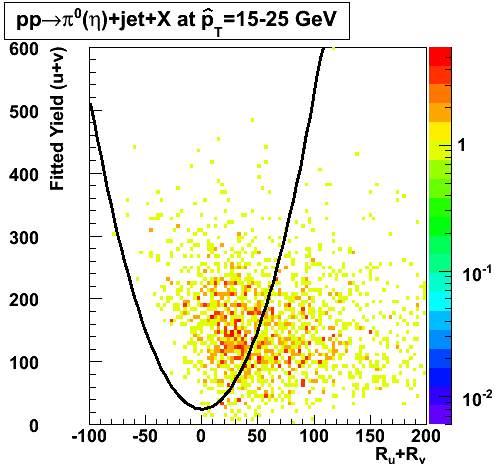 |
 |
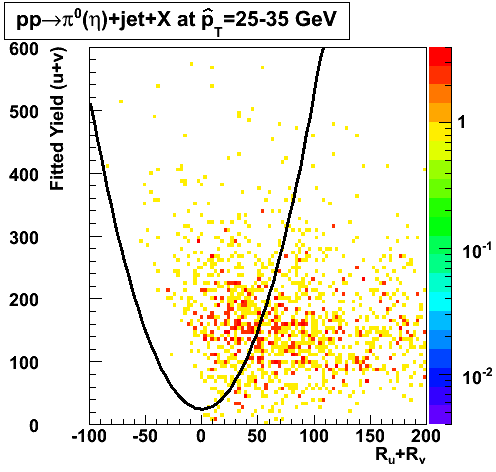 |
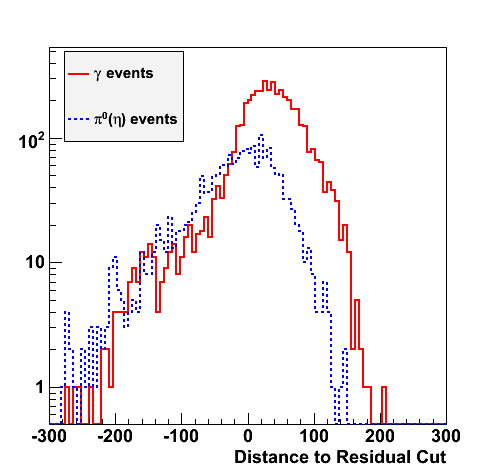 |
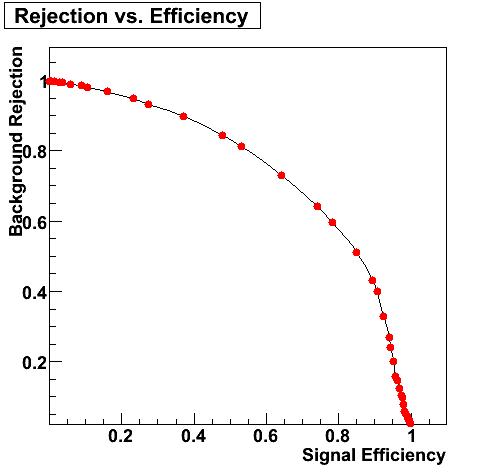 |
Pibero Djawotho Last updated Sat Apr 12 13:27:50 EDT 2008
2008.04.12 Pythia Gamma-Jets
Pythia Gamma-Jets
Gamma-Jet Yields
During Run 6, the L2-gamma trigger (trigger id 137641) sampled 4717.10 nb-1 of integrated luminosity. By restricting the jet to the Barrel, |ηjet|<1, and the gamma to the Endcap, 1<ηgamma<2, the yield of gamma-jets is estimated as the product of the luminosity, the cross section, and the fraction of events in the phasespace above. The total cross section reported by Pythia for gamma-jet processes at different partonic pT thresholds is listed in the table below. No efficiencies are included.
| pT threshold [GeV] | Total cross section [mb] | Fraction | Ngamma-jets |
| 5 | 6.551E-05 | 0.0992 | 30654 |
| 6 | 3.075E-05 | 0.1161 | 16840 |
| 7 | 1.567E-05 | 0.1150 | 8500 |
| 8 | 8.654E-06 | 0.1131 | 4617 |
| 9 | 4.971E-06 | 0.1223 | 2868 |
| 10 | 2.953E-06 | 0.1151 | 1603 |
Gamma-Jets pT slope
The pT slope is exp(-0.69*pT)=2^(-pT), so the statistics are halved with each 1 GeV increase in pT.
References
- Yield estimates based on single-particle MC sample, and comparison w/ pythia (Jason Webb)
- Pythia estimates of gamma-jet yields (Jim Sowinski)
Pibero Djawotho Last updated Sat Apr 12 15:15:56 EDT 2008
2008.04.22 Run 6 Photon Yield Per Trigger
Run 6 Photon Yield Per Trigger
Introduction
The purpose of this study is to estimate the photon yield per trigger in the Endcap Electromagnetic Calorimeter during Run 6. The trigger of interest is the L2-gamma trigger. Details of the STAR triggers during Run 6 were compiled in the 2006 p+p run (run 6) Trigger FAQ by Jamie Dunlop. The triggers relevant to this study are reproduced in the table below for convenience.
| Trigger id | Trigger name | Description |
| 117641 | eemc-http-mb-l2gamma | EEMC HT > th1 (12, 2.6 GeV) and TP > TH1 (17, 3.8 GeV), minbias condition, L2 Gamma algorithm, reading out slow detectors, L2 thresholds at 2.9, 4.5 |
| 127641 | eemc-http-mb-l2gamma | EEMC HT > th1 (12, 2.6 GeV, run < 7100052;13, 2.8 GeV, run >=7100052) and TP > TH1 (17, 3.8 GeV, run < 710052; 21, 4.7 GeV, run>=7100052 ), minbias condition, L2 Gamma algorithm, reading out slow detectors, L2 thresholds at 3.4, 5.4, transverse running |
| 137641 | eemc-http-mb-l2gamma | EEMC HT > th1 (16, 3.5 GeV) and TP > th1 (20, 4.5 GeV), minbias condition, L2 Gamma algorithm, reading out slow detectors, L2 thresholds at 3.7, 5.2, longitudinal running 2 |
The luminosity sampled by each trigger was also caclulated here by Jamie Dunlop. The luminosity for the relevant triggers is reproduced in the table below for convenience. The figure-of-merit (FOM) is calculated as FOM=Luminosity*PB*PY for transverse runs and FOM=Luminosity*PB2*PY2 for longitudinal runs where PB is the polarization of the blue beam and PY is the polarization of the yellow beam. Naturally, in spin physics, the FOM is the better indicator of statistical precisison.
| Trigger | First run | Last run | Luminosity [nb-1] | Figure-of-merit [nb-1] |
| 117641 | 7093102 | 7096017 | 118.88 | 11.89 |
| 127641 | 7097009 | 7129065 | 3219.04 | 1099.43 |
| 137641 | 7135050 | 7156028 | 4717.10 | 687.65 |
Event selection
Trigger selection
For this study, only the trigger of longitudinal running 2 (137641) is used. As mentioned above, at level-0, an EEMC high tower above 3.5 GeV and its associated trigger patch above 4.5 GeV in transverse energy coupled with a minimum bias condition, which is simply a BBC coincidence to ensure a valid collision, is required for the trigger to fire. The EEMC has trigger patches of variable sizes depending on their location in pseudorapidity. (The BEMC has trigger patches of fixed sizes, 4x4 towers.) At level-2, a high tower above 3.7 GeV and a 3x3 patch above 5.2 GeV in transverse energy is required to accept the event.
Gamma candidates
In addition to selecting events that were tagged online by the L2-gamma trigger, the offline
looks for tower clusters with minimum transverse energy of 5 GeV. These clusters along with their associated TPC tracks, preshower and postshower tiles, and SMD strips form gamma candidates. Gamma trees for the 2006 trigger ID 137641 with primary vertex are located at
/star/institutions/iucf/pibero/2006/gammaTrees/
.
Track isolation
The gamma candidate is required to have no track pointing to any of its towers.
EMC isolation
The gamma candidate is required to have 85% of the total transverse energy in a cone of radius 0.3 in eta-phi space around the position of the gamma candidate. That is E
Tgamma
/E
Tcone
> 0.85 and R=√Δη
2
+Δφ
2
=0.3 is the cone radius.
Jet Reconstruction
The gamma candidate is matched to the best away-side jet with neutral fraction < 0.9 and cos(φ
gamma
-φ
jet
) < -0.8. The 2006 jet trees are produced by Murad Sarsour at PDSF in
/eliza13/starprod/jetTrees/2006/trees/
. A local mirror exists at RCF under the directory
/star/institutions/iucf/pibero/2006/jetTrees/
.
Spin Information
Jan Balewski has an excellent write-up, Offline spin DB at STAR, on how to get spin states. I obtain the spin states from the skim trees in the jet trees directory. In brief, the useful spin states are:
| Blue Beam Polarization | Yellow Beam Polarization | Spin4 |
| P | P | 5 |
| P | N | 6 |
| N | P | 9 |
| N | N | 10 |
Event Summary
| L2-gamma triggers | 730128 |
| Endcap gamma candidates | 723848 |
| Track isolation | 246670 |
| EMC isolation | 225400 |
| Away-side jet | 99652 |
| SMD max sided residual | 19281 |
| Barrel-only jet | 15638 |
Note the number of L2-gamma triggers include only those events with a primary vertex and at least one gamma candidate (BEMC or EEMC).
Gamma-Jet Plots
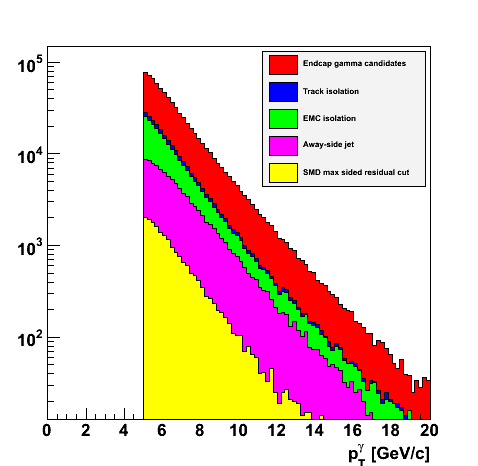 |
 |
|
 |
 |
Comparison of pT Slope with Pythia
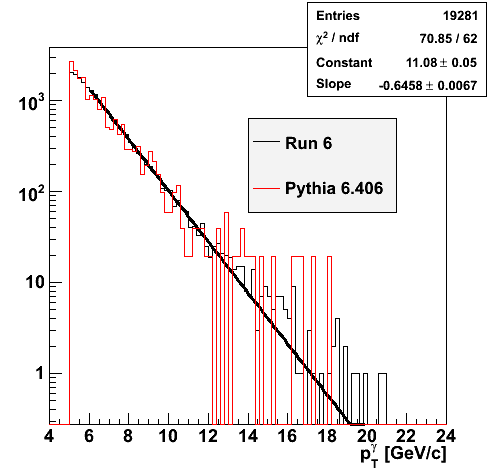 |
 |
Partonic Kinematics Reconstruction

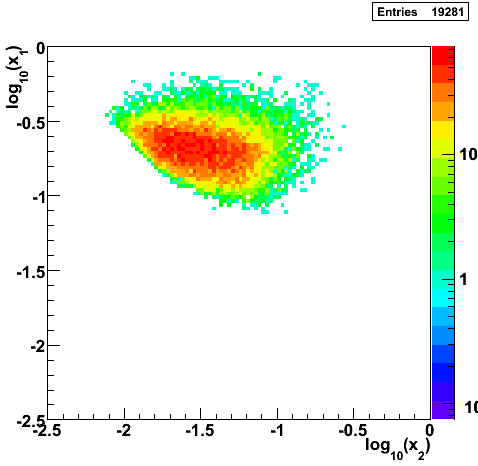 |
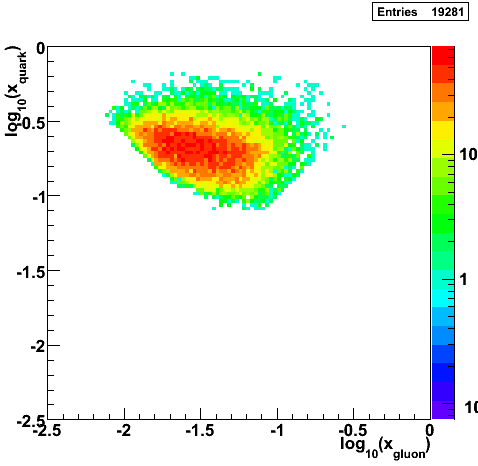 |
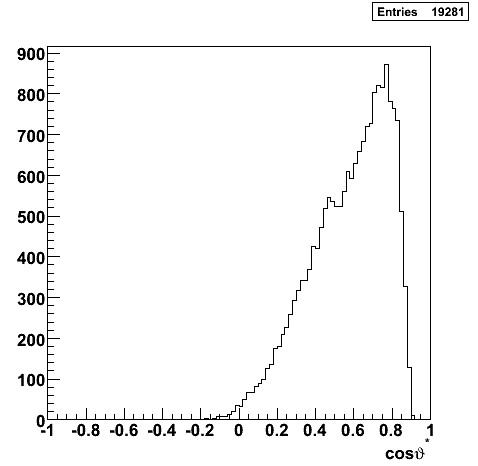 |
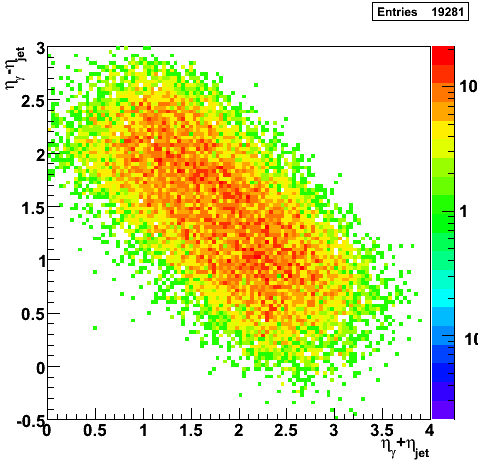 |
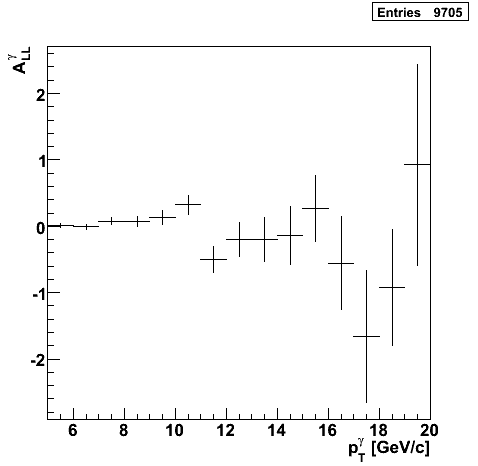 |
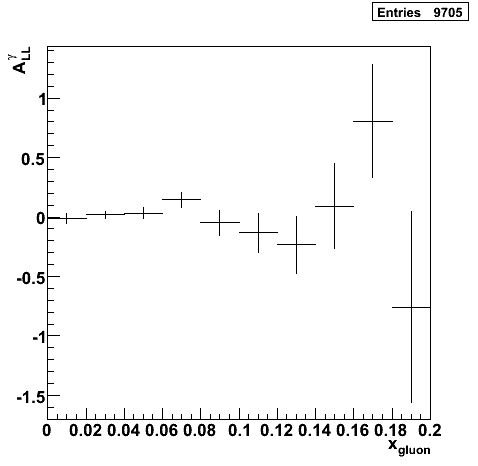 |
Open Questions
- I count ~2.4M events with trigger id 137641 using the Run 6 Browser, however my analysis only registers about ~0.78M.
Pibero Djawotho Last updated Tue Apr 22 11:40:18 EDT 2008
2008.05.07 Number of Jets
Number of Jets
After selecting Endcap gamma candidates out of L2-gamma triggers, applying track and EMC isolation cuts, and matching the Endcap gamma candidate to an away-side jet, I record the number of jets below per event. Surprisingly, 8% of the events only have 1 jet. Those are events where the Endcap gamma candidate was not reconstructed as a neutral jet by the jet finder. The question is why.
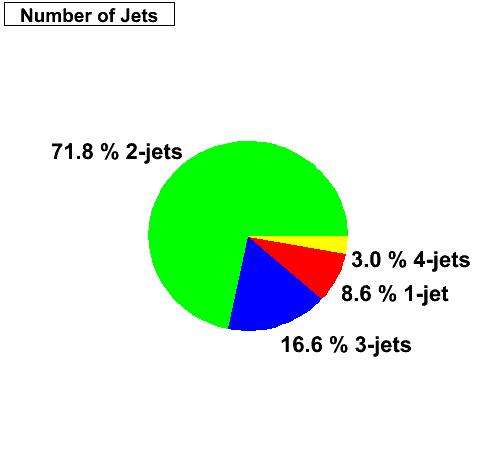 |
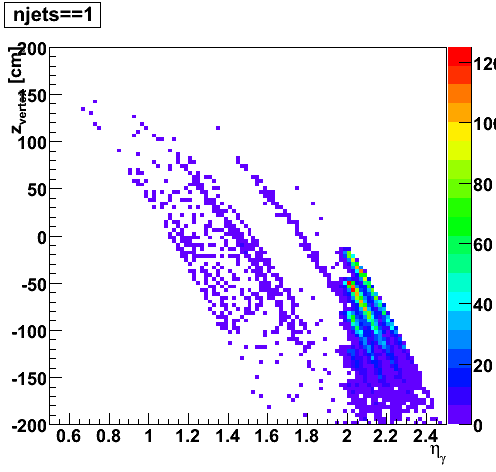 |
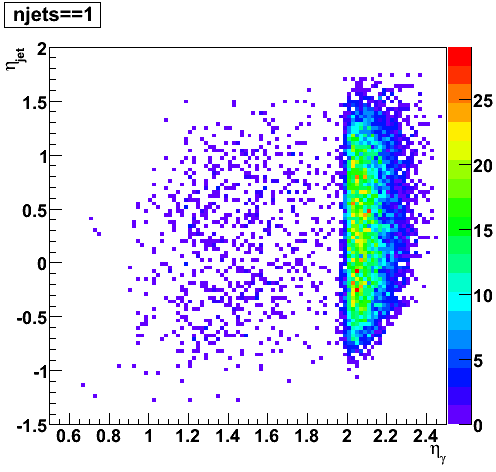 |
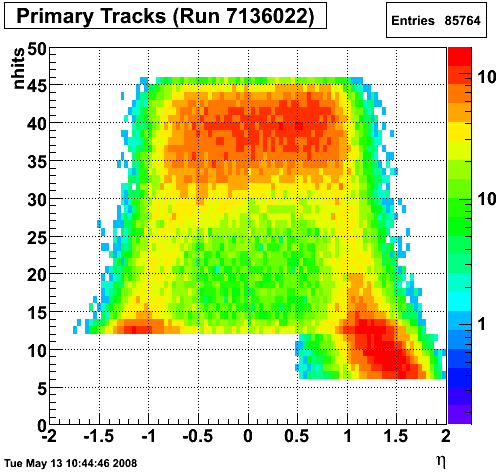 |
I display both Barrel and Endcap calorimeter towers (the z-axis represents tower energy) and draw a circle of radius 0.3 around the gamma candidate and a circle of radius 0.7 around the away-side jet for 2006 pp200 run 7136022. Even though many of the gamma candidates not reconstructed by the jet finder are at the forward edge of the Endcap, it is not at all clear why those that are well within the detector are not being reconstructed.
Pibero Djawotho Last updated Wed May 7 09:54:32 EDT 2008
2008.05.09 Gamma-jets pT distributions
Gamma-jets pT distributions
Note:
No cuts on residuals applied.
Not cut on number of towers in gamma cluster
Number of towers in gamma cluster <= 9
Number of towers in gamma cluster <= 4
Number of towers per cluster distributions
Gamma candidates xy-distribution
z-vertex distribution
Eta distribution
Phi distribution
log10(E_post/E_tow) distribution
pT asymmetry
References
Pibero Djawotho Last updated Fri May 9 08:19:00 EDT 2008
2008.05.19 Binning the shower shape library
Binning the shower shape library
Distributions
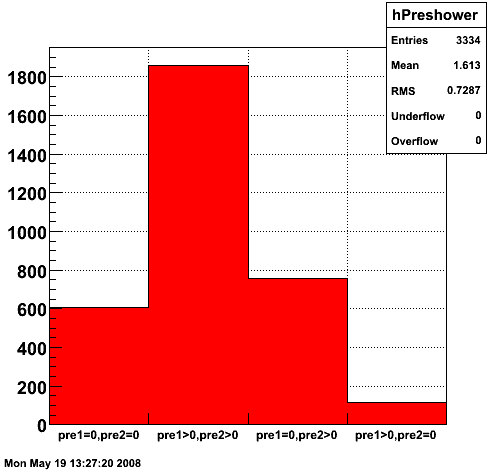 |
 |
 |
Shower Shapes
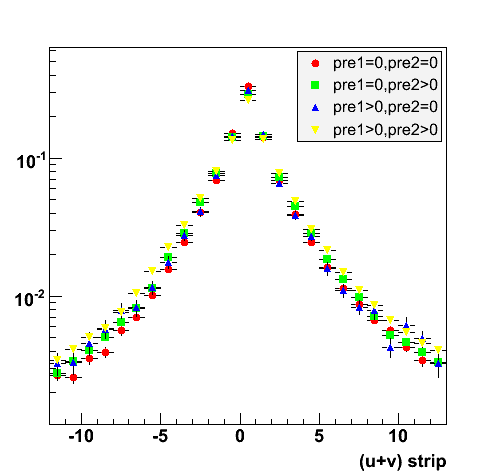 |
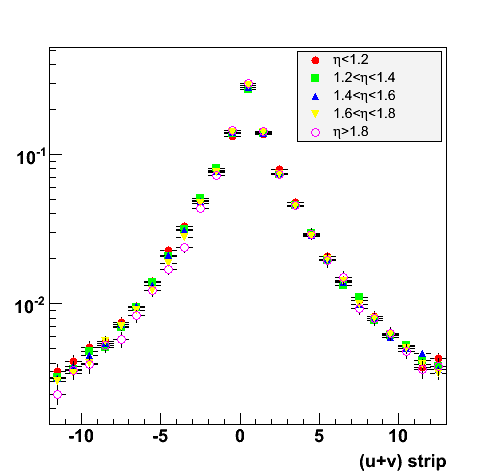 |
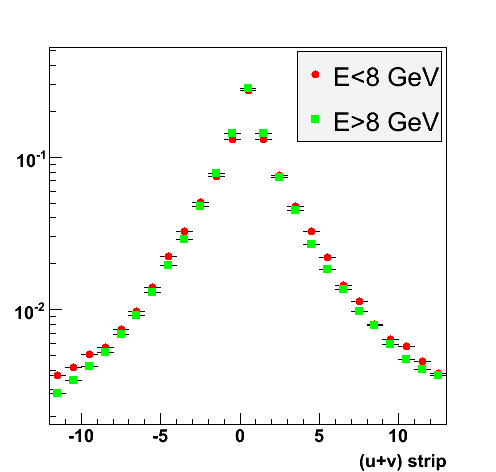 |
Pibero Djawotho Last updated Mon May 19 12:09:48 EDT 2008
2008.06.03 Jet A_LL Systematics
Jet A_LL Systematics
Hypernews discussion
jet A_LL systematic possibility
References
Pibero Djawotho Last updated Tue Jun 3 15:35:24 EDT 2008
2008.06.18 Photon-jet reconstruction with the EEMC - Part 2 (STAR Collaboration Meeting - UC Davis)
2008.07.16 Extracting A_LL and DeltaG
Extracting A_LL and DeltaG
Determining state of beam polarization for Monte Carlo events
While Pythia does a pretty good job of simulating prompt photon production in p+p collisions, it does not include polarization for the colliding protons nor partons. A statistical method for assigning polarization states for each event based on ALL [1] is demonstrated in this section. For an average number of interactions for each unpolarized bunch crossing, Neff, the occurence of an event with a particular polarization state obeys a Poisson distribution with average yield of events per bunch crossing:

For simplicity, the polarizations of the blue and yellow beams are assumed to be P
B
=P
Y
=0.7 and N
eff
=0.01. The "+" spin state defines the case where both beams have the same helicities and the "-" spin state for the case of opposite helicities. The asymmetry A
LL
is calculated from the initial states polarized and unpolarized parton distribution functions and parton-level asymmetry:

The algorithm then consists in alternatively drawing a random value N
int
from the Poisson distributions with mean μ
+
and μ
-
until N
int
>0 at which point an interaction has occured and the event is assigned the current spin state. The functioning of the algorithm is illustrated in Figure 1a where an input A
LL
=0.2 was fixed and N
trials
=500 different asymmetries were calculated. Each trial integrated N
total
=300 events. It is then expected that the mean A
LL
~0.2 and the statistical precision~0.1:

Indeed, both the A
LL
and its error are reproduced. In addition, variations on the number of events per trial were investigated (N
total
) in Figure 1b. The extracted width of the Gaussian distribution for A
LL
is consistent with the prediction for the error (red curve).
| Figure 1a | Figure 1b |
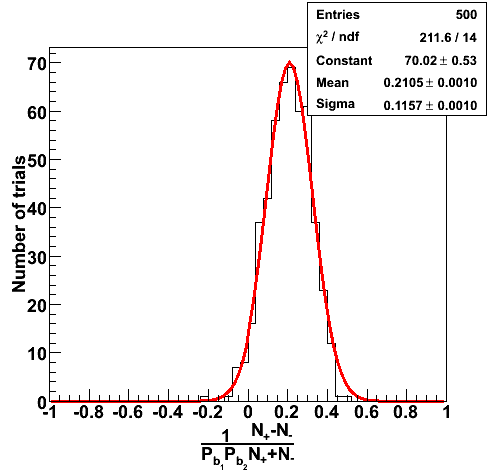 |
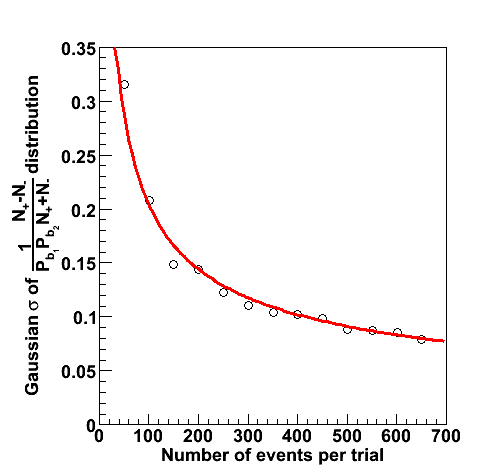 |
Event reconstruction
For this study, the gamma-jets Monte Carlo sample for all partonic pT were used. As an example, the prompt photon processes for the partonic pT bin 9-11 GeV and their total cross sections are listed in the table below. Each partonic pT bin was divided into 15 files each of 2000 events.
============================================================================== I I I I I Subprocess I Number of points I Sigma I I I I I I----------------------------------I----------------------------I (mb) I I I I I I N:o Type I Generated Tried I I I I I I ============================================================================== I I I I I 0 All included subprocesses I 2000 9365 I 3.074E-06 I I 14 f + fbar -> g + gamma I 331 1337 I 4.930E-07 I I 18 f + fbar -> gamma + gamma I 2 8 I 1.941E-09 I I 29 f + g -> f + gamma I 1667 8019 I 2.579E-06 I I 114 g + g -> gamma + gamma I 0 1 I 1.191E-10 I I 115 g + g -> g + gamma I 0 0 I 0.000E+00 I I I I I ==============================================================================
The cross sections for the different partonic pT bins has been tabulated by Michael Betancourt and is reproduced here for convenience.
| Partonic pT [GeV] | Cross Section [mb] |
| 3-4 | 0.0002962 |
| 4-5 | 0.0000891 |
| 5-7 | 0.0000494 |
| 7-9 | 0.0000110 |
| 9-11 | 0.00000314 |
| 11-15 | 0.00000149 |
| 15-25 | 0.000000317 |
| 25-35 | 0.00000000990 |
| 35-45 | 0.000000000449 |
These events were processed through the 2006 pp200 analysis chain, albeit without any cuts on the SMD. The simulated quantities were taken from the Pythia record and the reconstructed ones from the analysis.
| Figure 2 |
 |
| Figure 3 |
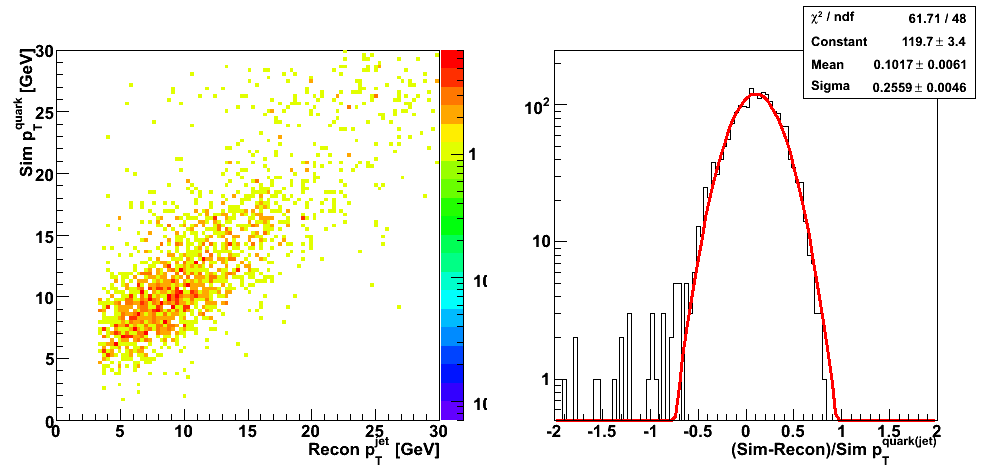 |
| Figure 4 |
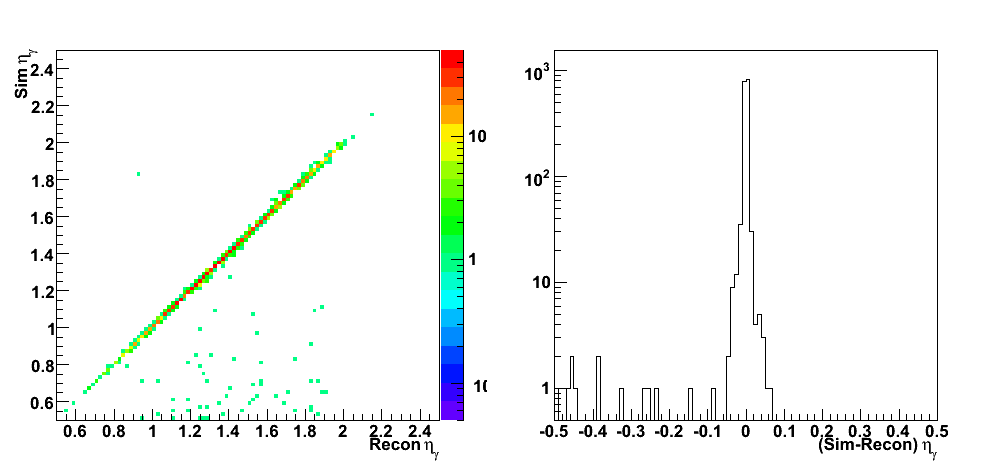 |
| Figure 5 |
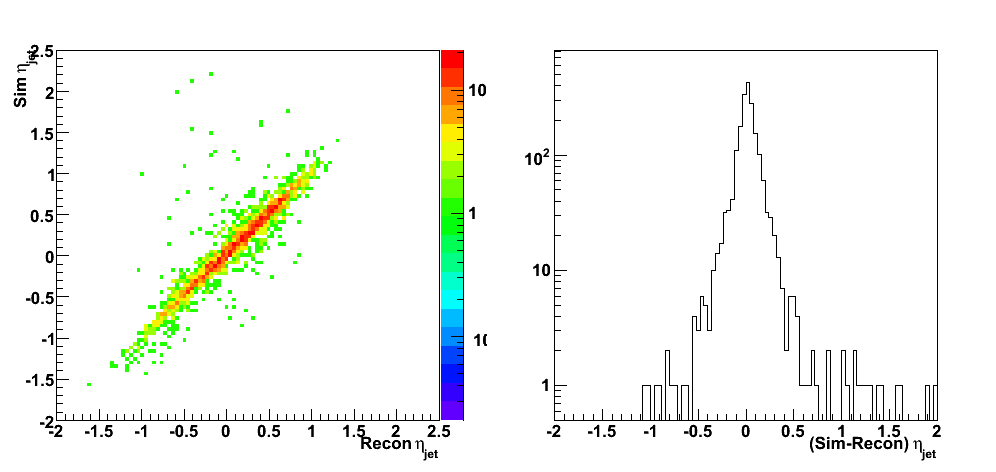 |
| Figure 6 |
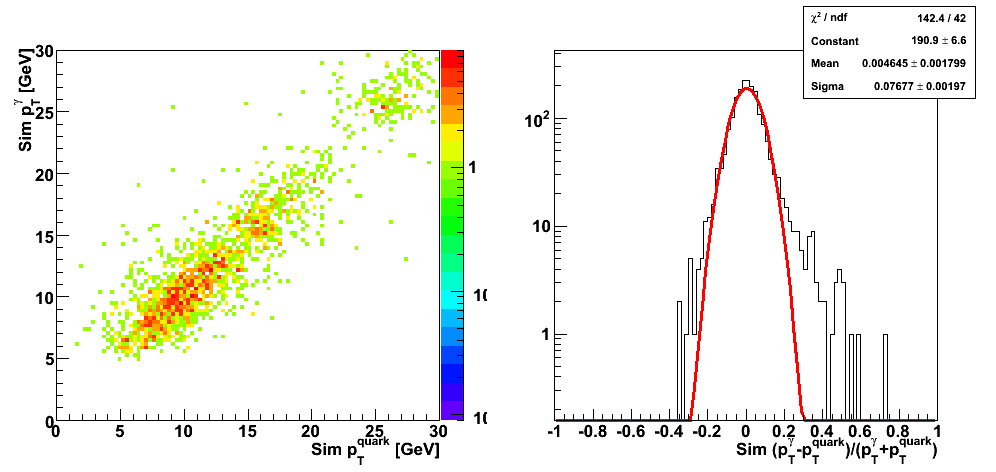 |
| Figure 7 |
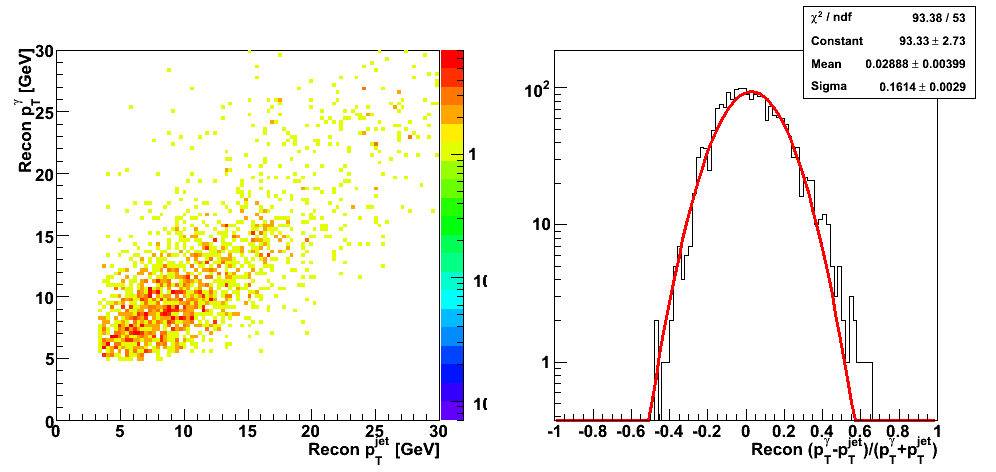 |
| Figure 8 |
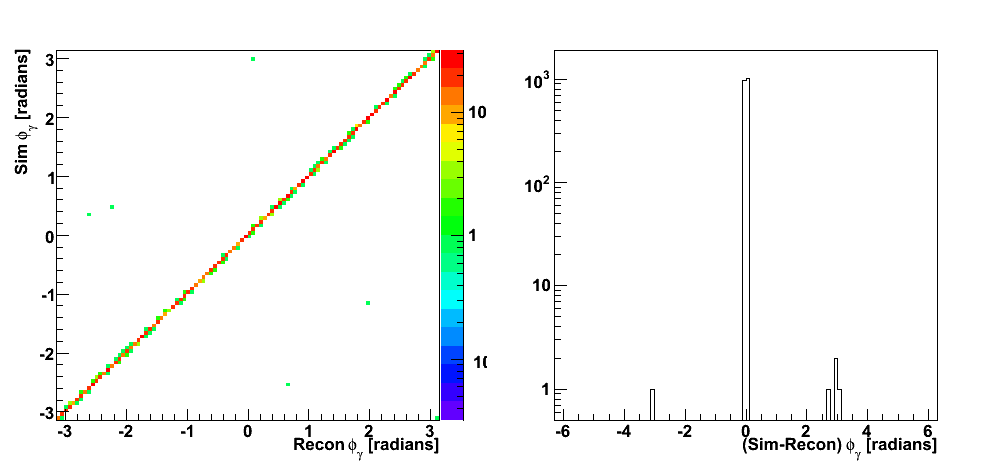 |
| Figure 9 |
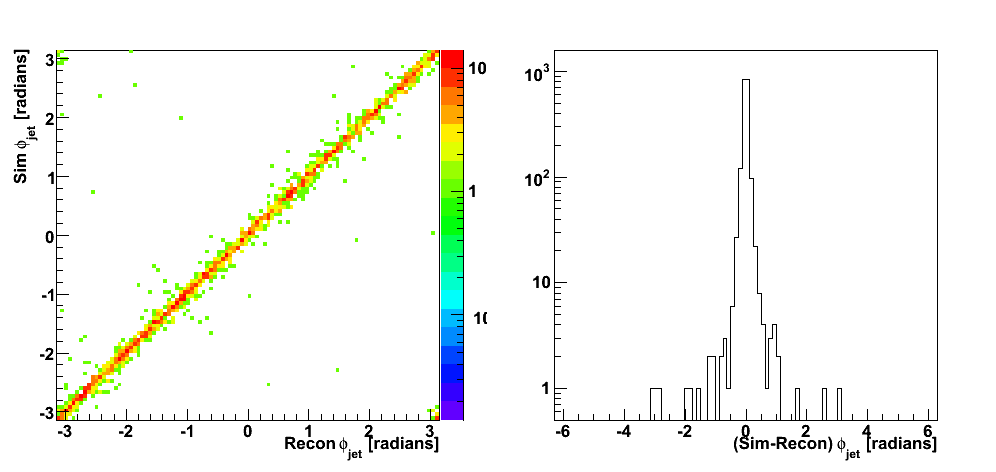 |
Partonic kinematics reconstruction
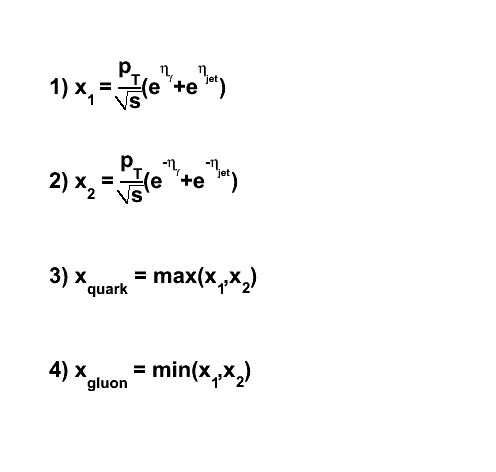 |
| PartonicKinematics.C |
Predictions for A_LL and direct determination of DeltaG(x)
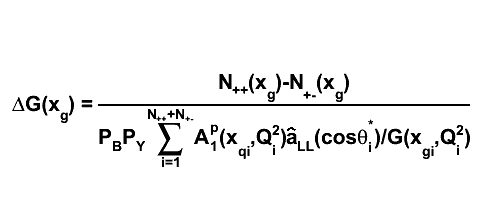 |
| DeltaG.C |
References
- Appendix Simulation Studies of Direct Photon Production at STAR
- DeltaG(x,mu^2) from jet and prompt photon production at RHIC arXiv:hep-ph/0005320
Pibero Djawotho Last updated Wed Jul 16 10:29:22 EDT 2008
2008.07.20 How to install Pythia 6 and 8 on your laptop?
How to install Pythia 6 and 8 on your laptop?
- Install Pythia 6 and build the interface to ROOT
- Install Pythia 8
- Install ROOT from source
Download the file pythia6.tar.gz from the ROOT site ftp://root.cern.ch/root/pythia6.tar.gz and unpack.
tar zxvf pythia6.tar.gzA directory
pythia6/ will be created and some files unpacked into it. Cd into it and compile the Pythia 6 interface to ROOT.
cd pythia6/ ./makePythia6.linuxFor more information, consult Installing ROOT from Source and skip to the section Pythia Event Generators.
Download the latest version of Pythia from http://home.thep.lu.se/~torbjorn/Pythia.html and unpack.
tar zxvf pythia8108.tgzA directory
pythia8108/ will be created. Cd into it and follow the instructions in the README file to build Pythia 8. Set the environment variables PYTHIA8 and PYTHIA8DATA (preferably in /etc/profile.d/pythia8.sh):
export PYTHIA8=$HOME/pythia8108 export PYTHIA8DATA=$PYTHIA8/xmldocRun configure with the option for shared-library creation turned on.
./configure --enable-shared make
Download the source code for ROOT from http://root.cern.ch/ and compile.
tar zxvf root_v5.20.00.source.tar.gz cd root/ ./configure linux --with-pythia6-libdir=$HOME/pythia6 \ --enable-pythia8 \ --with-pythia8-incdir=$PYTHIA8/include \ --with-pythia8-libdir=$PYTHIA8/lib make make installSet the following environment variables (preferably in
/etc/profile.d/root.sh):
export ROOTSYS=/usr/local/root export PATH=$PATH:$ROOTSYS/bin export LD_LIBRARY_PATH=$LD_LIBRARY_PATH:$ROOTSYS/lib:/usr/local/pythia6 export MANPATH=$MANPATH:$ROOTSYS/manYou should be good to go. Try running the following Pythia 6 and 8 sample macros:
root $ROOTSYS/tutorial/pythia/pythiaExample.C root $ROOTSYS/tutorial/pythia/pythia8.C
Pibero Djawotho Last updated on Sun Jul 20 23:35:39 EDT 2008
2008.07.23 Hot Strips Identified by Hal Spinka
Hot Strips Identified by Hal Spinka
- Run 7136034 Sector 8
- Run 7137036 Sector 9
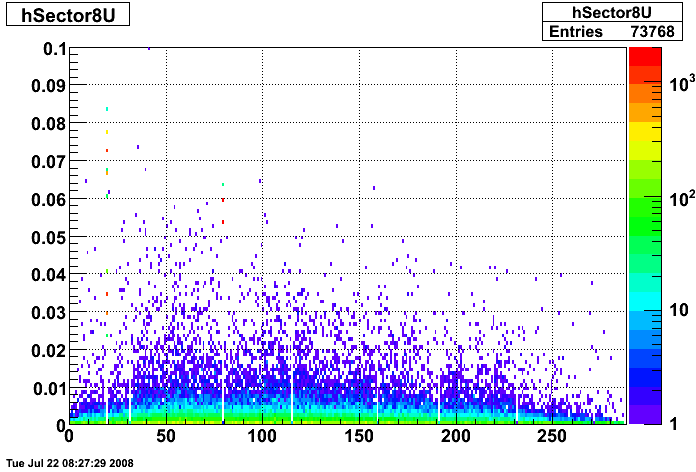
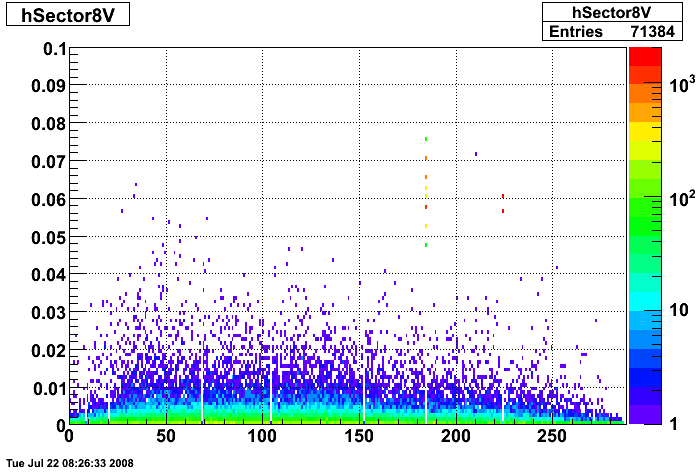
Strips 08U020, 08U080, 08V185 and 08V225
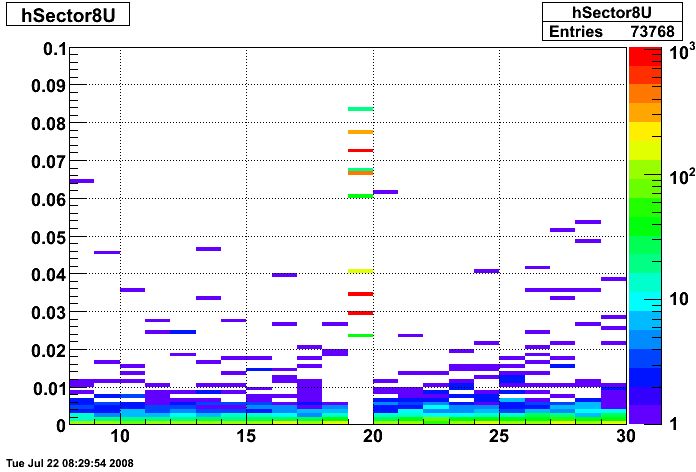
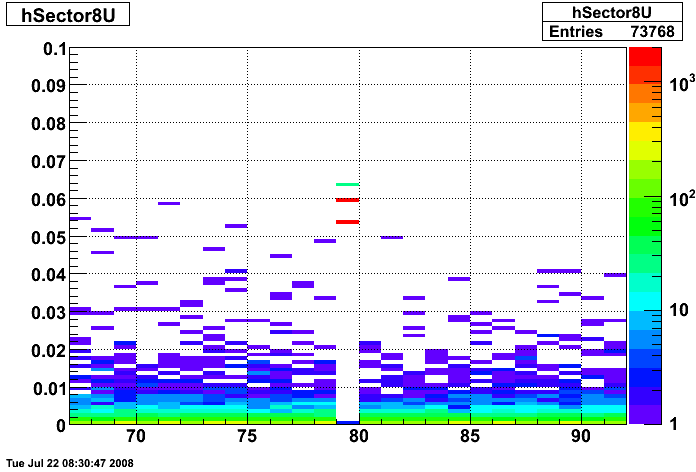
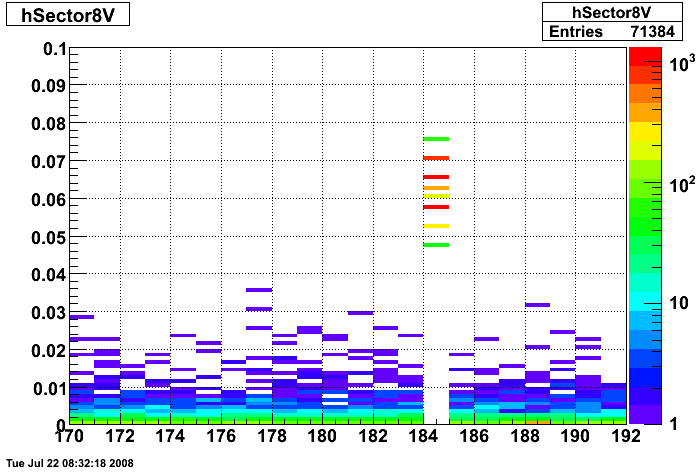
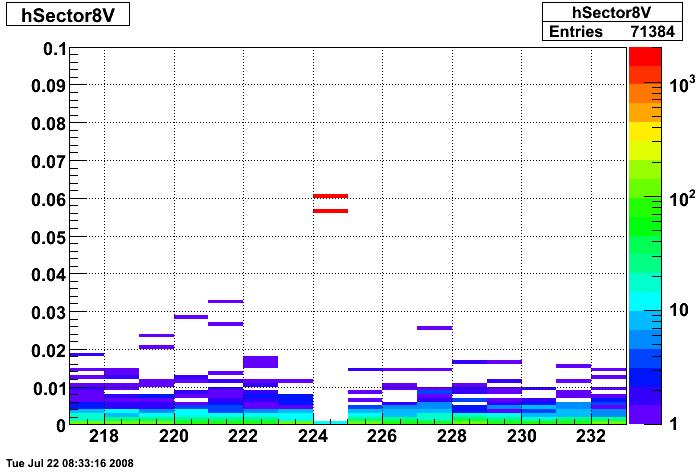
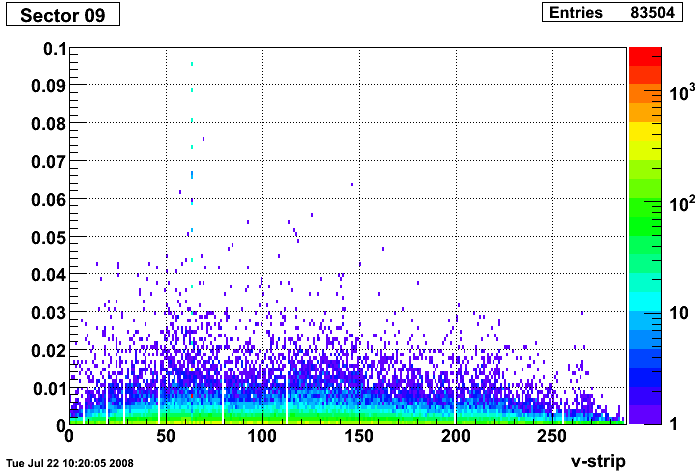
Strips 09V064
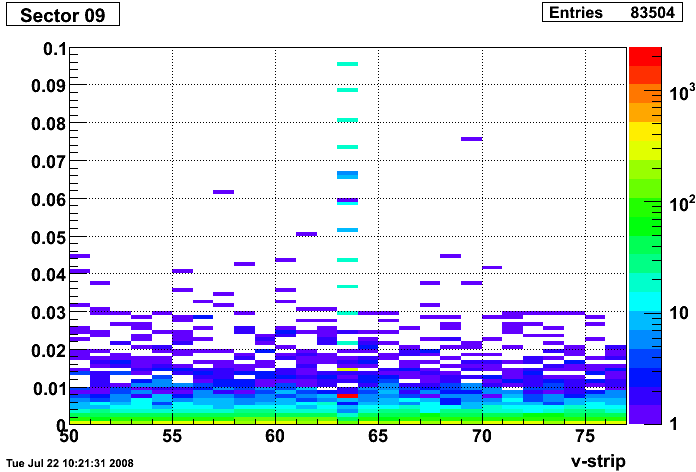
Pibero Djawotho Last updated Wed Jul 23 03:40:54 EDT 2008
2008.07.24 Strips from Weihong's 2006 ppLong 20 runs
Strips from Weihong's 2006 ppLong 20 runs
Energy [GeV] vs. strip id
Raw ADC vs. strip id
7136022.pdf 7136033.pdf 7136034.pdf 7137036.pdf 7138001.pdf 7138010.pdf 7138032.pdf 7140046.pdf 7143012.pdf 7144014.pdf 7145018.pdf 7145024.pdf 7146020.pdf 7146077.pdf 7147052.pdf 7148027.pdf 7149005.pdf 7152062.pdf 7153008.pdf 7155052.pdf
Pibero Djawotho Last updated Thu Jul 24 10:35:50 EDT 2008
G/h Discrimination Algorithm (Willie)
My blog pages, from first to last:
01/25: http://drupal.star.bnl.gov/STAR/blog-entry/wleight/2008/jan/25/photon-analysis-progress-week-1-21-08-1-25-08. This post discusses the problem with the spike in secondary tracks at eta=1 in our single-particle simulations.
01/28: http://drupal.star.bnl.gov/STAR/blog-entry/wleight/2008/jan/28/further-qa-plots. This post has QA plots for every particle sample Ross generated, both in the barrel and in the endcap.
02/01: http://drupal.star.bnl.gov/STAR/blog-entry/wleight/2008/feb/01/more-qa-plots-time-efficiencies. This post has QA plots for gamma and piminus (barrel and endcap) as well as reconstruction efficiencies.
02/04: http://drupal.star.bnl.gov/STAR/blog-entry/wleight/2008/feb/04/photon-qa-efficiency-plots-error-bars. This post adds error bars to the reconstruction efficiencies for the photon barrel sample.
02/05: http://drupal.star.bnl.gov/STAR/blog-entry/wleight/2008/feb/05/first-clustering-plots. This post has the first clustering plots, for muons and gammas (barrel only), showing cluster energy, energy-weighted cluster eta and phi, and the number of seeds and clusters passing the thresholds for each event.
02/12: http://drupal.star.bnl.gov/STAR/blog-entry/wleight/2008/feb/12/preshower-plots. This post has preshower plots from the gamma barrel sample, but the plots are of all preshowers in the event and use the preshower information generated by the BEMC simulator and so are not useful.
02/13: http://drupal.star.bnl.gov/STAR/blog-entry/wleight/2008/feb/13/more-clustering-plots. This post has geant QA plots combined with the clustering plots from 02/05 above, but for the gamma and piminus barrel samples.
02/19: http://drupal.star.bnl.gov/STAR/blog-entry/wleight/2008/feb/19/cluster-track-matching-plots. This post investigates the cluster-to-track matching for the gamma barrel sample, using a simple distance variable d=sqrt((delta eta)^2+(delta phi)^2)) to match clusters to tracks and plotting the resulting energy distributions, the energy ratio, etc.
02/21: http://drupal.star.bnl.gov/STAR/blog-entry/wleight/2008/feb/21/more-preshower-plots. This post plots preshower distributions but uses the preshower information from the BEMC simulator and so is not useful.
02/28: http://drupal.star.bnl.gov/STAR/blog-entry/wleight/2008/feb/28/further-preshower-plots-not-completed-yet. Figures 1, 3, and 5 in this post plot the geant preshower energy deposition for gammas, piminuses, and muons (Figs 2, 4, and 6 plot reconstructed preshower information again and so are not useful).
03/04: http://drupal.star.bnl.gov/STAR/blog-entry/wleight/2008/mar/04/muon-preshower-plots. This post expands on the post of 02/28, with additional plots using the geant preshower information, including preshower cluster energy vs. tower cluster energy.
03/06: http://drupal.star.bnl.gov/STAR/blog-entry/wleight/2008/mar/06/first-physics-cuts. This post basically recaps the previous post and adds a cut: unfortunately the cut is based partly on the thrown particle energy and so is not useful.
03/18: http://drupal.star.bnl.gov/STAR/blog-entry/wleight/2008/mar/18/smd-qa-plots. This post plots energy-weighted SMD phi and eta distributions, as well as the total energy deposited in the BSMDE and BSMDP strips located behind a cluster.
03/28: http://drupal.star.bnl.gov/STAR/blog-entry/wleight/2008/mar/28/smd-clustering-plots. This post contains SMD clustering plots for barrel gamma and piminus samples.
Neutral Pions 2005: Frank Simon
Information about the 2005 Spin analysis (focused on A_LL and <z>, some QA plots for cross section comparisons) will be archived here. The goal is obviously the 2005 Pi0 spin paper.
Invariant Mass and Width: Data-MC
Here I show the invariant masses and corresponding widths I obtain using my cross section binning. These are compared to MC values.
The Method:
- Invariant mass Data histograms (low mass background and combinatoric background subtracted) are fitted with a gaussian in the range 0.1 - 0.18 GeV/c^2. This gives the mass (gaussian mean) and width (gaussian sigma)
- MC invariant mass histograms are obtained from correctly associated MC Pi0s after reconstruction. No weighting of the different partonic pt samples is performed. This can (and will) introduce a bias
- Then the same fitting procedure as for data is applied
The results are shown in the two figures below.
Mass:

Width:

Neutral Pion Paper: 2005 ALL & <z>
Neutral Pion Paper for 2005 data: Final Results.
There are two spin plots planned for the paper, one with the 2005 A_LL and one with the <z>. In addition to this the cross section will be included (analysis by Oleksandr used for publication).


Final result for A_LL:

Figure 1: Double longitudinal spin asymmetry for inclusive Pi0 production. The curves show predictions from NLO pQCD calculations based on the gluon distributions from the GRSV, GS-C and DSSV global analyses. The systematic error shown by the gray band does not include a 9.4% normalization uncertainty due to the polarization measurement.
The chi2/ndf for the different model curves are:
GRSV Std: 0.740636
GRSV Max: 3.49163
GRSV Min: 0.94873
GRSV Zero: 0.546512
GSC: 0.513751
DSSV: 0.543775
Final Result for <z>:

Figure 2: Mean momentum fraction of Pi0s in their associated jet as a function of p_T for electromagnetically triggered events. The data points are plotted at the bin center in pion p_T and are not corrected for acceptance or trigger effects. Systematic errors, estimated from a variation of the cuts, are shown by the grey band underneath the data points. The lines are results from simulations with the PYTHIA event generator. The solid line includes detector effects simulated by GEANT, while the dotted line uses jet finding on the PYTHIA particle level. The inset shows the distribution of pT, π / pT, Jet for one of the bins, together with a comparison to PYTHIA with a full detector response simulation.
Below are links to details about the two results.
<z> Details
<z> Details
The goal of this analysis is to relate the neutral pions to the jets they are embedded in. The analysis is done using the common spin analysis trees, which provide the necessary tools to combine the jet and neutral pion analysis.
A neutral pion is associated to a parent jet if it is within the jet cone of 0.4 in eta and phi. To avoid edge effects in the detector, only neutral pions with 0.3 < eta < 0.7 are accepted.
Cut details:
E_neutral / E_total < 0.95
higher energy photon of Pi0 > 2.8 GeV (HT1 trigger); > 3.6 GeV (HT2 trigger)
combination HT1/HT2: below 5.7 GeV only HT1 is used, above that both HT1 and HT2 are accepted
The final result uses both HT1 and HT2 triggers, but a trigger separated study has also been done, as shown below. There, HT2 includes only those HT2 triggers that do not satisfy HT1 (because of prescale).

Figure 1: <z> for Pi0 in jets as a function of p_T for HT1 and HT2 triggers. Also shown is the mean jet p_T as a function of pion p_T.
Bin-by-Bin momentum ratio

Figure 2: Bin-by-bin ratio of pion to jet p_T. The <z> is taken from the mean of these distributions, the error is the error on the mean. A small fraction of all entries have higher Pi0 p_T than jet p_T. Similar behavior is also observed for Pythia MC with GEANT jets. This obviously increases the <z>. An alternative would be to reject those events. The agreement with MC becomes worse if this is done.
Here is the data - MC comparison for 3 of the above bins. For the simulation, the reconstruction of the Pi0 is not required to keep statistics reasonable, so the true Pi0 pt is used. However, the MC jet finding uses all momenta after Geant, this is why the edges are "smoother" in the MC plot than in the data plots. Since <z> is an average value, this is not expected to be affected by this, since on average the Pi0 pt is reconstructed right.

Figure 3: Data / MC for Bin 5: 6.7 to 8 GeV

Figure 4: Data / MC for Bin 6: 8 to 10 GeV

Figure 5: Data / MC for Bin 7: 10 to 12 GeV
A_LL Details
Details on the A_LL result and the systematic studies:
The result in numbers:
| Bin | <p_T> [GeV] in bin | A_LL | stat. error | syst. error |
| 1 | 4.17 | 0.01829 | 0.03358 | 0.01603 |
| 2 | 5.41 | -0.01913 | 0.02310 | 0.01114 |
| 3 | 7.06 | 0.00915 | 0.03436 | 0.01343 |
| 4 | 9.22 | -0.06381 | 0.06366 | 0.01862 |
A_LL as separated by trigger:

Figure 1: A_LL as a function of p_T for HT1 (black) and HT2 (red) triggers separately. HT1 here is taken as all triggers that satisfy the HT1 requirement, but not HT2. Since the HT2 prescale is one, there are very little statistics for HT1 at the highest p_T. The highest p_T point for HT1 is outside the range of the plot, and has a large error bar. The high p_T HT1 data is used in the combined result.
Systematics: Summary
| Bin 1 | Bin 2 | Bin 3 | Bin4 | |
| relative luminosity | 0.0009 | 0.0009 | 0.0009 | 0.0009 |
| non-longitudinal pol. | 0.0003 | 0.0003 | 0.0003 | 0.0003 |
| beam background | 0.0012 | 0.0084 | 0.0040 | 0.0093 |
| yield extraction | 0.0144 | 0.0044 | 0.0102 | 0.0116 |
| invariant mass background | 0.0077 | 0.0061 | 0.0080 | 0.0108 |
| total | 0.01603 | 0.01114 | 0.01343 | 0.01862 |
The first two systematics are common to all spin analyses. The numbers here are taken from the jet analysis. No Pi0 non-longitudinal analysis has been performed due to lacking statistics. These systematics are irrelevant compared to the others.
The analysis specific systematics are determined from the data, and as such are limited by statistics. The real systematic limit of a Pi0 analysis with a very large data sit will be much lower.
For the yield extraction systematic the invariant mass cuts for the pion yield extraction are varied. The systematic is derived from the maximum change in asymmetry with changing cuts.
For the beam background, the systematic is derived by studying how much A_LL changes when the beam background is removed. This is a conservative estimate that covers the scenario that only half of the background is actually removed. The asymmetry of the background events is consistent with zero.
For the invariant mass background systematic, A_LL is extracted in three invariant mass bins outside the signal region. The amount of background under the invariant mass peak (includes combinatorics, low mass and others) is estimated from the invariant mass distribution as shown below. For all three bins, the background A_LL is consistent with zero, a "worst case" of value + 1 sigma is assumed as deviation from the signal A_LL.
Invariant mass distribution:

Figure 2: Invariant mass distribution for HT1 events, second p_T bin. The red lines are the MC expectations for Pi0 and Eta, the green line is low mass background, the magenta line is combinatoric background, the thick blue line is a pol2 expectation for the other background, the blue thinner line is the total enveloppe of all contributions, compared to the data. At low mass, the background is overestimated.
Other systematic studies: False Asymmetries
False asymmetries (parity-violating single spin asymmetries) were studied to exclude systematic problems with spin asignments and the like. Of course the absence of problems in the jet analysis with the same data set makes any issues very unlikely, since jet statistics allow much better verifications than Pi0s. Still, single spin asymmetries were studied, and no significant asymmetries were observed. For both triggers, both asymmetries (yellow and blue) and for all p_T bins the asymmetries are consistent with zero, in most cases within one sigma of zero. So there are no indications for systematic effects. The single spin asymmetries are shown below:

Figure 3: Single spin asymmetry epsilon_L for the blue beam.

Figure 4: Single spin asymmetry epsilon_L for the yellow beam.
Neutral strange particle transverse asymmetries (tpb)
Neutral strange particle transverse asymmetry analysis
Here is information regarding my analysis of transverse asymmetries in neutral strange particles using 2006 p + p TPC data. This follows-on from and expands upon the earlier analysis I did, which can still be found at star.bnl.gov/protected/strange/tpb/analysis/. Comments, questions, things-you'd-like-to-see-done and so forth are welcomed. I'll catalogue updates in my blog as I make them.
The links listed below are in 'analysis-order'; best to use these for navigation rather than the alphabetically listed links Drupal links below/in the sidebar.
- Data used
- V0 decays
- Energy loss particle identification
- Geometrical cuts
- Single spin asymmetry with cross formula
- SSA using relative luminosity
- Double spin asymmetry
e-mail me at tpb@np.ph.bham.ac.uk
Data used
Data used in analysis
Data used for this analysis is 2006 p+p 200 GeV data taken with transverse polarisation, trigger setup "ppProductionTrans". This spanned days 97 (7th April) to 129 (9th May) inclusive. Trigger bemc-jp0-etot-mb-l2jet (ID 127622) is used. A file catalogue query with the following conditions gives a list of runs for which data is available:
trgsetupname=ppProductionTrans,tpc=1,year=2006,sanity=1,collision=pp200,
magscale=FullField,filename~physics,library=SL06e,production=P06ieThis generates a list of 549 runs. These runs are then compared against the spin PWG run QC (see http://www.star.bnl.gov/protected/spin/sowinski/runQC_2006) and are rejected if any of the following conditions are true:
- The run is marked as unusable
- The run has a jet patch trigger problem
- The run has a spin bits problem
- The run is unchecked
This excludes 172 runs, leaving 377 runs to be analysed.
I use a Maker class to create TTrees of event objects with V0 and spin information for these runs. Code for the Maker and Event classes can be found at /star/u/tpb/StRoot/StTSAEventMaker/ and /star/u/tpb/StRoot/StV0NanoDst/ respectively. Events are accepted only if they fulfill the following criteria:
- Event contains specified trigger ID
- StSpinDbMaker::isMaskedUsingBx48() returns false
- StSpinDbMaker::offsetBX48minusBX7() returns zero
TTrees are produced for 358 runs (19 produce no/empty output), yielding 2,743,396 events.
The vertex distribution of events from each run are then checked by spin bits. A Kolmogorov test (using ROOT TH1::KolmogorovTest) is used to compare the vertex distributions for (4-bit) spin bits values 5, 6, 9 and 10. If any of the distributions are inconsistent, the run is rejected. Each run's mean event vertex z position is then plotted. Figure 1 shows the distribution, fitted with a Gaussian. A 3σ cut is applied and outlier runs rejected. 38 runs are rejected by these further cuts. The remaining 320 runs, spanning 33 RHIC fills and comprising 2,500,421 events, are used in the analysis.
 |
| Figure 1: Mean event vertex z for each run. The red lines indicate the 3σ cut. |
Double spin asymmetry
Double spin asymmetry
I measure a double spin asymmetry defined as follows
![Double spin asymmetry definition A_TT=[N(parallel)-N(antiparallel)]/[N(parallel)+N(antiparallel)]](http://drupal.star.bnl.gov/STAR/system/files/attSimpleEqn.png) |
| Equation 1 |
where N-(anti)parallel indicates yields measured in one half of the detector when the beam polarisations are aligned (opposite) and P1 and P2 are the polarisations of the beams. Accounting for the relative luminosity, these yields are given by
 |
| Equation 2 |
 |
| Equation 2 |
where the arrows again indicate beam polarisations. Figures one and two show the fill-by-fill measurement of ATT, corrected by the beam polarisation, summed over all pT.
 |
| Figure 1: K0S ATT fill-by-fill |
 |
| Figure 2: Λ ATT fill-by-fill |
Energy loss identification
Energy loss particle identification
The Bethe-Bloch equation can be used to predict charged particle energy loss. Hans Bichsel's model adds to this and the Bichsel function predictions for particle energy loss are compared with measured values. Tracks with dE/dx sufficiently far from the predicted value are rejected. e.g. when selecting for Λ hyperons, the positive track is required to have dE/dx consistent with that of a proton, and the negative track consistent with that of a π-minus.
The quantity σ = sqrt(N) x log( measured dE/dx - model dE/dx ) / R is used to quantify the deviation of the measured dE/dx from the model value. N is the number of track hits used in dE/dx determination and R is a resolution factor. A cut of |σ| < 3 applied to both V0 daughter tracks was found to significantly reduce the background with no loss of signal. Figures one to three below show the invariant mass distriubtions of the V0 candidates accepted and rejected and table one summarises the results of the cut. Background rejection is more successful for (anti-)Λ than for K0S because most background tracks are pions; the selection of an (anti-)proton daughter rejects the majority of the background tracks.
 |
| Figure 1a: Invariant mass spectrum of V0 candidates under K0s hypothesis passing dE/dx cut |
 |
| Figure 1b: Invariant mass spectrum of V0 candidates under K0s hypothesis failing dE/dx cut |
 |
| Figure 2a: Invariant mass spectrum of V0 candidates under Λ hypothesis passing dE/dx cut |
 |
| Figure 2b: Invariant mass spectrum of V0 candidates under Λ hypothesis failing dE/dx cut |
 |
| Figure 3a: Invariant mass spectrum of V0 candidates under anti-Λ hypothesis passing dE/dx cut |
 |
| Figure 3b: Invariant mass spectrum of V0 candidates under anti-Λ hypothesis failing dE/dx cut |
| Species | Pass (millions) | Fail (millions) | % pass |
|---|---|---|---|
| K0S | 95.5 | 48.9 | 66.2 % |
| Λ | 32.5 | 111.9 | 22.5 % |
| anti-Λ | 11.8 | 132.5 | 8.2 % |
Table 1
Geometrical cuts
Geometrical cuts
Energy loss cuts are successful in eliminating a significant portion of the background, but further reduction is required to give a clear signal. In addition final yields are calculated by a bin counting method, which requires that the background around the signal peak has a straight line shape. Therefore additional cuts are placed on the V0 candidates based on the geometrical properties of the decay. There are five quantities on which I chose to cut:
- Distance of closest approach (DCA) of the V0 candidate to the primary vertex: if the V0 candidate is a genuine particle, its momentum vector should track back to the interaction point. Spurious candidates will not necessarily do so, therefore an upper limit is placed on the approach distance of the V0 to the interaction point.
- DCA between the daughter tracks: due to detector resolution the daughter tracks never precisely meet, but placing an upper limit of the minimum distance of approach reduces background from spurious track crossings.
- DCAs of the positive and negative daughter tracks to the primary vertex: the daughter tracks are curved due to the magnetic field and a neutral strange particle will decay some distance from the interaction point. Therefore the daughter tracks should not extrapolate back to the primary vertex, but to some distance away from it. Placing a lower limit on this distance can reduce background from tracks originating from the interaction point.
- V0 decay distance: neutral strange particles decay weakly, with cτ ~ cm, so the decay vertex should typically be displaced from the interaction point. A lower limit placed on the decay distance of the V0 helps eliminate backgrounds from particles originating at the interaction point.
I wrote a class to help perform tuning of these geometrical cut quantities (see /star/u/tpb/StRoot/StV0CutTuning/) by a "brute force" approach; different permutations of the above quantities were attempted, and the resulting mass spectra analysed to see which permutations gave the best balance of background reduction and signal retention. In addition, the consistency of the background to a straight-line shape was required. Due to the limits on statistics, signal retention was considered a greater priority than background reduction. The cut values I decided upon are summarised in table one. Figures one to three show the resulting mass spectra (data are from all runs). Yields are calculated from the integral of bins in the signal (red) region minus the integrals of bins in the background (green) regions. Poisson (√N) errors are used. The background regions are fitted with a straight line, skipping the intervening bins. The signal to background quoted is the ratio of the maximum bin content to the value of the background fit evaluated at that mass. Note that the spectra have the the dE/dx cut included in addition to the geometrical cuts.
| Species | Max DCA V0 to PV* | Max DCA between daughters | Min DCA + daughter to PV | Min DCA − daughter to PV | Min V0 decay distance |
|---|---|---|---|---|---|
| K0S | 1.0 | 1.2** | 0.5 | 0.0** | 2.0** |
| Λ | 1.5 | 1.0 | 0.0** | 0.0** | 3.0 |
| anti-Λ | 2.0** | 1.0 | 0.0** | 0.0** | 3.0 |
Table 1: Summary of geometical cuts. All cut values are in centimetres.
* primary vertex
** default cut present in micro-DST
 |
| Figure 1: Final K0S mass spectrum with all cuts applied. |
 |
| Figure 2: Final Λ mass spectrum with all cuts applied. |
 |
| Figure 3: Final anti-Λ mass spectrum with all cuts applied. |
Single spin asymmetry using cross formula
Single Spin asymmetry using cross formula
Equation one shows the cross-formula used to calculate the single spin asymmetry.
![Cross asymmetry formula AP=[sqrt(N(L,up)N(R,down))-sqrt(N(L,down)N(R,up))]/[sqrt(N(L,up)N(R,down))+sqrt(N(L,down)N(R,up))]](http://drupal.star.bnl.gov/STAR/system/files/crossAsymBeam.png) |
| Equation 1 |
where N is a particle yield, L(eft) and R(ight) indicate the side of the polarised beam to which the particle is produced and arrows indicate the polarisation direction of the beam. Equation one cancels acceptance and beam luminosity and allows simply the raw yields to be used for the calculation. The asymmetry can be calculated twice; once for each beam, summing over the polarisation states of the other beam to leave it "unpolarised". I previously used only particles produced at forward η when calculating the blue beam asymmetry, and backward η for yellow, but I now sum over the full η range for each. Equations two and three give the numbers for up/down polarisation for blue (westward at STAR) and yellow (eastward) beams respectively in terms of the contributions from the four different beam polarisation permutations, and these permutations are related to spin bits numbers in table one.
 |
| Equation 2 |
 |
| Equation 3 |
(in e.g. N(upUp), The first arrow refers to yellow beam polarisation, the second to blue beam.)
| Beam polarisation | 4-bit spin bits | |
|---|---|---|
| Yellow | Blue | |
| Up | Up | 5 |
| Down | Up | 6 |
| Up | Down | 9 |
| Down | Down | 10 |
| Table 1 | ||
The raw asymmetry is calculated for each RHIC fill, then divided by the polarisation for that fill to give the physics asymmetry. Final polarisation numbers (released December 2007) are used. The error on the raw asymmetry is calculated by propagation of the √(N) errors calculated for each particle yield. The final asymmetry error incorporates the polarisation error (statistical and systematic errors summed in quadrature). The fill-by-fill asymmetries for each K0S and Λ for each beam are shown in figures one and two. Anti-Λ results shall be forthcoming. An average asymmetry is calculated by performing a straight line χ2 fit through the fill-by-fill values with ROOT. Table one summarises the asymmetry results. The asymmetry error is the error from the ROOT fit and is statistical only. All fits give a good χ2 per degree of freedom and are consistent with zero within errors.
 |
| Figure 1a: K0S blue beam asymmetry |
 |
| Figure 1b: K0S yellow beam asymmetry |
 |
| Figure 2a: Λ blue beam asymmetry |
 |
| Figure 2b: Λ yellow beam asymmetry |
The above are summed over the entire pT range available. I also divide the data into different transverse momentum bins and calculate the asymmetry as a function of pT. Figures three and four show the pT-dependent asymmetries. No pT dependence is discernible.
 |
| Figure 3a: K0S pT-dependent blue beam AN |
 |
| Figure 3b: K0S pT-dependent yellow beam AN |
 |
| Figure 4a: Λ pT-dependent blue beam AN |
 |
| Figure 4b: Λ pT-dependent yellow beam AN |
Single spin asymmetry utilising relative luminosity
Single spin asymmetry making use of relative luminosity
I also calculate the asymmetry via an alternative method, making use of Tai Sakuma's relative luminosity work. The left-right asymmetry is defined as
 |
| Equation 1 |
where NL is the particle yield to the left of the polarised beam. The decomposition of the up/down yields into contributions from the four different beam polarisation permutations is the same as given in the cross-asymmetry section (equations 2 and 3). Here, the yields must be scaled by the appropriate relative luminosity, giving the following relations:
 |
| Equation 2 |
 |
| Equation 3 |
The relative luminosities R4, R5 and R6 are the ratios of luminosity for, respectively, up-up, up-down and down-up bunches to that for down-down bunches. I record the particle yields for each polarisation permutation (i.e. spin bits) on a run-by-run basis, scale each by the appropriate relative luminosity for that run, then combine yields from all the runs in a given fill to give fill-by-fill yields. These are then used to calculate a fill-by-fill raw asymmetry, which is scaled by the beam polarisation. The figures below show the resultant fill-by-fill asymmetry for each beam and particle species, summed over all pT. The fits are again satisfactory, and give asymmetries consistent with zero within errors, as expected.
 |
| Figure 1a: Blue beam asymmetry for K0S |
 |
| Figure 1b: Yellow beam asymmetry for K0S |
 |
| Figure 2a: Blue beam asymmetry for Λ |
 |
| Figure 2b: Yellow beam asymmetry for Λ |
V0 decays
V0 decays
The appearance of the decay of an unobserved neutral strange particle into two observed charged daughter particles gives rise to the terminology 'V0' to describe the decay topology. The following neutral strange species have been analysed:
| Species | Decay channel | Branching ratio | K0S | π+ + π- | 0.692 |
|---|---|---|
| Λ | p + π- | 0.639 |
| anti-Λ | anti-p + π+ | 0.639 |
Candidate V0s are formed by combining together all possible pairs of opposite charge-sign tracks in an event. The invariant mass of the V0 candidate under different decay hypotheses can then be determined from the track momenta and the daughter masses (e.g. for Λ the positive daughter is assumed to be a proton, the negative daughter a π-minus). Raw invariant mass spectra are shown below. The spectra contain three contributions: real particles of the species of interest; neutral strange particles of a different species; combinatorial background from chance positive/negative track crossings.

|
| Figure 1: Invariant mass spectrum under K0s hypothesis |

|
| Figure 2: Invariant mass spectrum under Λ hypothesis |

|
| Figure 3: Invariant mass spectrum under anti-Λ hypothesis |
Selection cuts are applied to the candidates to suppress the background whilst maintaining as much signal as possible. There are two methods for reducing background; energy-loss particle identification and geometrical cuts on the V0 candidates.
Photon-jet with the Endcap (Ilya Selyuzhenkov)
Gamma-jets
W-analysis
2008
Year 2008 posts
01 Jan
January 2008 posts
2008.01.30 Selecting gamma-jet candidates out of the jet trees
Ilya Selyuzhenkov January 30, 2008
Data set
jet trees by Murad Sarsour for pp2006 run, runId=7136022 (~60K events, no triggerId cuts yet)
Jets gross features
- Figure 1: Distribution of number of jets per event. Same data on a log scale is here.
- Figure 2: Distribution of electromagnetic energy (EM) fraction, R_EM, for di-jet events (number of jets/event = 2).
R_EM = [E_t(endcap)+E_t(barrel)]/E_t(total).
Black histogram is for R_EM1 = max(Ra, Rb), red is for R_EM2 = min(Ra, Rb).
Ra and Rb are EM fraction for jets in the di-jet event.
Same data on a log scale is here.
Gamma-jet isolation cuts list:
- selecting di-jet events with one of the jet dominated by EM energy,
and another one with more hadronic energy:R_EM1 >0.9 and R_EM2 < 0.9
- selecting di-jet events with jets pointing opposite in azimuth:
cos(phi1 - phi2) < -0.9
- requiring the number of associated charged tracks with a first jet (with maximum EM fraction) to be less than 2:
nChargeTracks1 < 2
- requiring the number of fired EEMC towers associated with a first jet (with maximum EM fraction) to be 1 or 2:
0 < nEEMCtowers1 < 3
Applying gamma-jet isolation cuts
- Figure 3: Distribution of eta vs number of EEMC towers for the first jet (with maximum EM fraction).
Cuts:1-3 applied (no 0 < nEEMCtowers1 < 3 cut). - Figure 4: Distribution of transverse momentum, pt1, of the first jet (with maximum EM fraction)
vs transverse momentum, pt2, of the second jet.
Cuts:1-4 applied - Figure 5: Distribution of mean transverse momentum, < pt1 >, of the first jet (with maximum EM fraction)
vs transverse momentum, pt2, of the second jet.
Cuts:1-4 applied - Figure 6: Distribution of pseudorapidity, eta1, of the first jet (with maximum EM fraction)
vs pseudorapidity, eta2, of the second jet.
Cuts:1-4 applied - Figure 7: Distribution of azimuthal angle, phi1, of the first jet (with maximum EM fraction)
vs azimuthal angle, phi2, of the second jet.
Cuts:1-4 applied - Figure 8: Distribution of transverse momentum, pt1, of the first jet (with maximum EM fraction)
vs transverse energy sum for the EEMC towers associated with this jet.
Cuts:1-4 applied - Figure 9: Distribution of transverse momentum, pt1, of the first jet (with maximum EM fraction)
vs transverse momentum, pt2, of the second jet.
Cuts:1-4 + Et(EEMC) > 3.0 GeV
02 Feb
February 2008 posts
2008.02.13 Gamma-jet candidates: EEMC response
Ilya Selyuzhenkov February 13, 2008
Data sample
Gamma-jet selection cuts are discussed here. There are 278 candidates found for runId=7136022.
Transverse momentum distribution for the gamma-jet candidates can be found here.
Vertex z distribution for di-jet and gamma-jet events
-
Figure 1: Vertex z distribution.
Red line presents gamma-jet candidates (scaled by x50). Black is for all di-jet events.
Same data on a log scale is here. - Figure 2: Average vertex z as a function of transverse momentum of the fist jet (with a largest EM energy fraction).
Red is for gamma-jet candidates. Black is for all di-jet events.
Strong deviation from zero for gamma-jet candidates at pt < 5GeV?
EEMC response for the gamma-jet candidate
EEMC response event by event for all 278 gamma-jet candidate can be found in this pdf file.
Each page shows SMD/Tower energy distribution for a given event:
-
First row on each page shows SMD response
for the sector which has a maximum energy deposited in the EEMC Tower
(u-plane is on the left, v-plane is on the right). -
In the left plot (u-plane energy distribution) numerical values for
pt of the first jet (with maximum EM fraction) and the second jet are given. -
In addition, fit results assuming gamma (single Gaussian, red line) or
neutral pion (double Gaussian, blue line ~ red+green) hypotheses are given. - m_{gamma gamma} value (it is shown in the right plot for v-plane).
If m_{gamma gamma} value is negative, then the reconstruction procedure has failed
(for example, no uv-strips intersection found, or tower energy and uv-strips intersection point mismatch, etc).
EEMC response for these "bad" events can be found in this pdf file.If reconstruction procedure succeded, then
m_{gamma gamma} gives reconstructed invariant mass assuming that two gammas hit the calorimeter.Figure 3: invariant mass distribution (assuming pi0 hypothesis).
Note, that I'm still working on my fitting algorithm (which is not explained here),
and fit results and the invariant mass distribution will be updated. -
It is also shown the ratio for each u/v plane
of the integrated single Gaussian fit (red line) to the total energy in the plane
(look for "gamma U/V " values on the right v-plane plot). -
Second and third rows on each page show the energy deposition in the
tower, pre-shower1, pre-shower2, and post-shower as a function of eta:phi (etaBin:phiBin). - Last row shows the hit distribution in the SMD for all sectors
(u-plane on the left, v-plane of the right).
Playing with a different cuts
Trying to isolate the real gammas which hits the calorimeter,
I have sorted events into different subsets based on the following set of cuts:
- EEMC gamma-jet cuts (energetic photon hits EEMC with pt similar or greater to that of the opposite jet)
if (invMass < 0) reject
if (jet2_pt > jet1_pt) reject
if (jet1_pt < 7) reject
if (minFraction < 0.75) reject
(minFraction = gamma U/V - is a fraction of the integrated single Gaussian peak to the total energy in the uv-plane)Figure 4: Sample gamma-jet candidate EEMC response
(all gamma-jet candidates selected according to these conditions can be found in this pdf file): - EEMC pi0 cuts:
if (invMass < 0) reject
if (jet2_pt < jet1_pt) reject
if (jet2_pt < 7) reject
if (minFraction < 0.75) rejectEvent by event EEMC response for pi0 (di-jet) candidates
selected according to these conditions can be found in this pdf file.
2008.02.20 Gamma-jet candidates: more statistics from jet-trees
Ilya Selyuzhenkov February 20, 2008
Short summary
After processing all available jet-trees for pp2006 (ppProductionLong),
and applying all "gamma-jet" cuts (which are described below):
-
there are 47K di-jet events selected
-
for pt1>7GeV there are 5,4K gamma-jet candidates (3,7K with an additional cut of pt1>pt2)
-
Figure 1: 2,4K events with both pt1, pt2 > 7GeV
-
721 candidates within a range of pt1>pt2 and both pt1, pt2 > 7 GeV
Data set
jet trees by Murad Sarsour for pp2006 run, number of runs processed: 323
4.7M di-jet events found (no triggerId cuts yet)
Di-jets gross features
- Figure 2: Distribution of electromagnetic energy (EM) fraction, R_EM, for di-jet events (number of jets/event = 2).
R_EM = [E_t(endcap)+E_t(barrel)]/E_t(total).
Black histogram is for R_EM1 = max(Ra, Rb), red is for R_EM2 = min(Ra, Rb).
Ra and Rb are EM fraction for jets in the di-jet event.
Same data on a log scale is here.
Gamma-jet isolation cuts:
- selecting di-jet events with one of the jet dominated by EM energy,
and another one with more hadronic energy:R_EM1 >0.9 and R_EM2 < 0.9
- selecting di-jet events with jets pointing opposite in azimuth:
cos(phi1 - phi2) < -0.9
- requiring the number of associated charged tracks with a first jet (with maximum EM fraction) to be less than 2:
nChargeTracks1 < 2
- requiring the number of fired EEMC towers associated with a first jet (with maximum EM fraction) to be 1 or 2:
0 < nEEMCtowers1 < 3
Applying gamma-jet isolation cuts
- Figure 3: Distribution of eta vs number of EEMC towers for the first jet (with maximum EM fraction).
Cuts:1-3 applied (no 0 < nEEMCtowers1 < 3 cut). - Figure 4: Distribution of transverse momentum, pt1, of the first jet (with maximum EM fraction)
vs transverse momentum, pt2, of the second jet.
Cuts:1-4 applied - Figure 5: Distribution of mean transverse momentum, < pt1 >, of the first jet (with maximum EM fraction)
vs transverse momentum, pt2, of the second jet.
Cuts:1-4 applied - Figure 6: Distribution of pseudorapidity, eta1, of the first jet (with maximum EM fraction)
vs pseudorapidity, eta2, of the second jet.
Cuts:1-4 applied - Figure 7: Distribution of azimuthal angle, phi1, of the first jet (with maximum EM fraction)
vs azimuthal angle, phi2, of the second jet.
Cuts:1-4 applied - Figure 8: Distribution of transverse momentum, pt1, of the first jet (with maximum EM fraction)
vs transverse energy sum for the EEMC towers associated with this jet.
Cuts:1-4 applied - Figure 9: Distribution of transverse momentum, pt1, of the first jet (with maximum EM fraction)
vs transverse momentum, pt2, of the second jet.
Cuts:1-4 + Et(EEMC) > 3.0 GeV
2008.02.27 Tower based clustering algorithm, and EEMC/BEMC candidates
Ilya Selyuzhenkov February 27, 2008
Gamma-jet candidates before applying clustering algorithm
Gamma-jet isolation cuts:
- selecting di-jet events with the first jet dominated by EM energy,
and the second one with a large fraction of hadronic energy:R_EM1 >0.9 and R_EM2 < 0.9
- selecting di-jet events with jets pointing opposite in azimuth:
cos(phi1 - phi2) < -0.8
- requiring no charge tracks associated with a first jet (jet with a maximum EM fraction):
nCharge1 = 0
Tower based clustering algorithm
-
for each gamma-jet candidate finding a tower with a maximum energy
associated with a jet1 (jet with a maximum EM fraction). -
Calculating energy of the cluster by finding all adjacent towers and adding their energy together.
- Implementing a cut based on cluster energy fraction, R_cluster, where
R_cluster is defined as a ratio of the cluster energy
to the total energy in the calorimeter associated with a jet1.
Note, that with a cut Ncharge1 =0, energy in the calorimeter is equal to the jet energy.
Distribution of cluster energy vs number of towers fired in EEMC/BEMC
Figure 4: R_cluster vs number of towers fired in EEMC (left) and BEMC (right). No pt cuts.
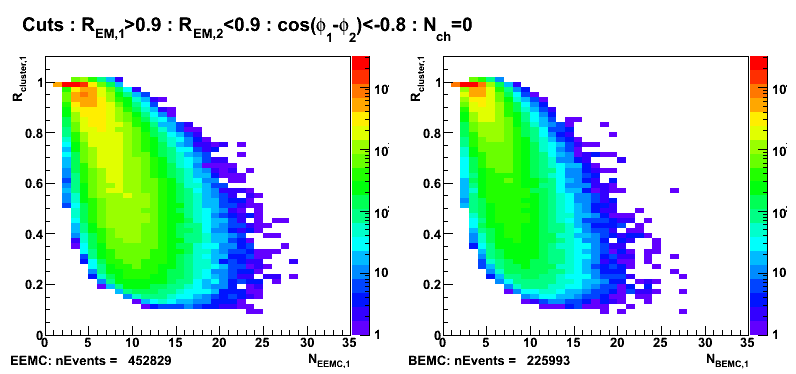
Figure 5: R_cluster vs number of towers fired in EEMC (left) and BEMC (right). Additional cut: pt1>7GeV
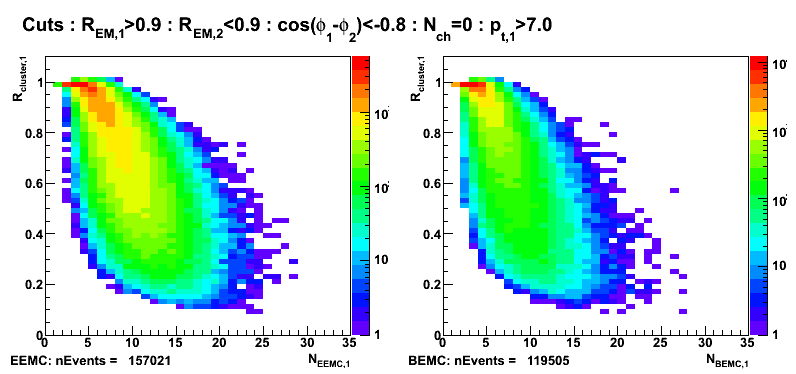
Figure 6: jet1 pseudorapidity vs number of towers fired in EEMC (left) and BEMC (right).
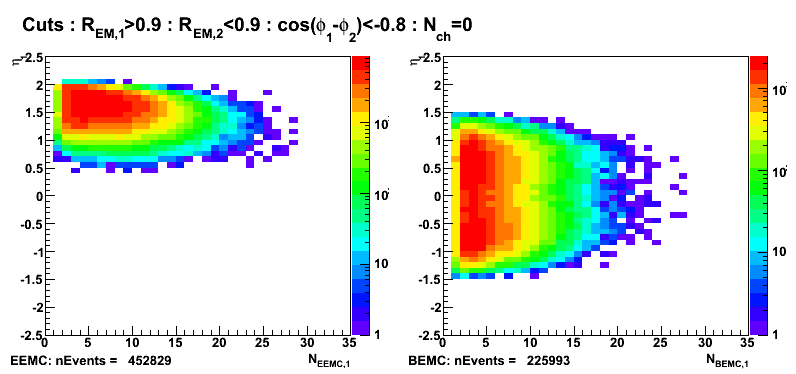
R_cluster>0.9 cut: EEMC vs BEMC gamma-jet candidates
EEMC candidates: nTowerFiredBEMC=0
BEMC candidates: nTowerFiredEEMC=0
Figure 7: Pseudorapidity (left EEMC, right BEMC candidates)
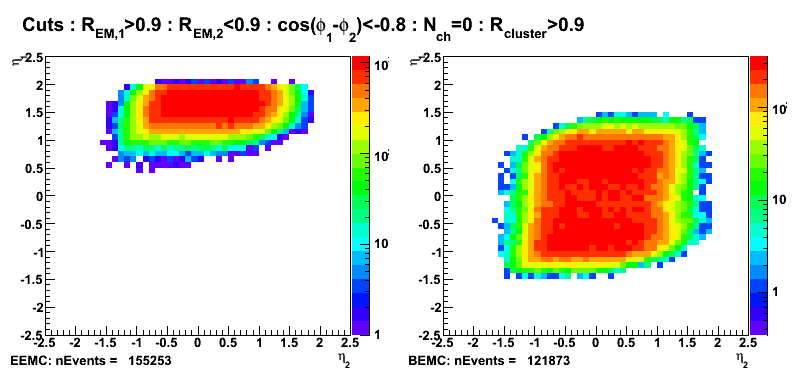
Figure 8: Azimuthal angle (left EEMC, right BEMC candidates)
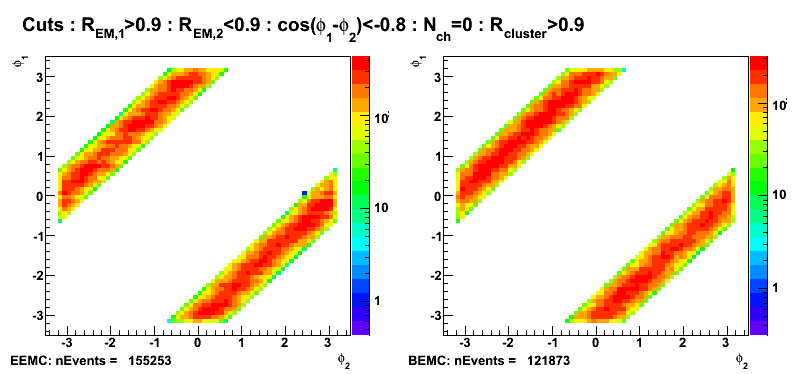
Figure 9: Transverse momentum (left EEMC, right BEMC candidates)
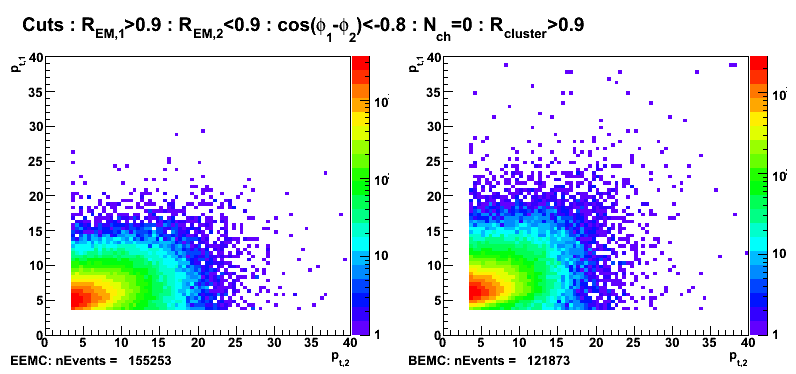
Number of gamma-jet candidates with an addition pt cuts
Figure 10: Transverse momentum (left EEMC, right BEMC candidates): pt1>7GeV
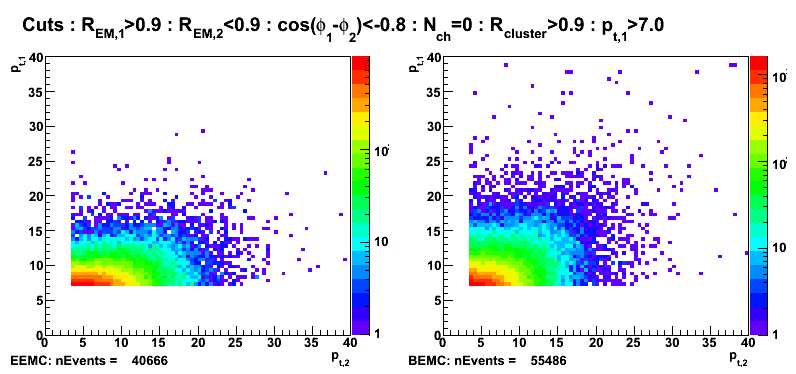
Figure 11: Transverse momentum (left EEMC, right BEMC candidates): pt1>7 and pt2>7
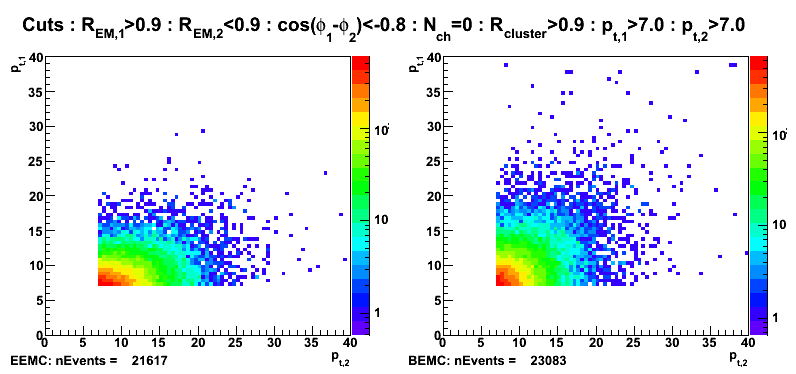
03 Mar
March 2008 posts
2008.03.03 EEMC SMD: u/v-strip energy distribution
Ilya Selyuzhenkov March 03, 2008
Data set: ppLongitudinal, runId = 7136033.
Some observations/questions:
-
In general distributions look clean and good
-
Sectors 7 and 9 for v-plane and sector 7 for u-plane are noise.
-
Sector 9 has a hot strip (id ~ 120)
-
In sector 3, strips id=0-5 in v-plane are hot (see figure 2 right, bottom)
-
Sectors 2 and 8 in u-plane and sectors 3 and 9 in v-plane have missing strips id=283-288?
-
Strips 288 are always empty?
Figure 1:Average energy E in the strip vs sector and strip number (max < E > = 0.0027)
same figure on a log scale
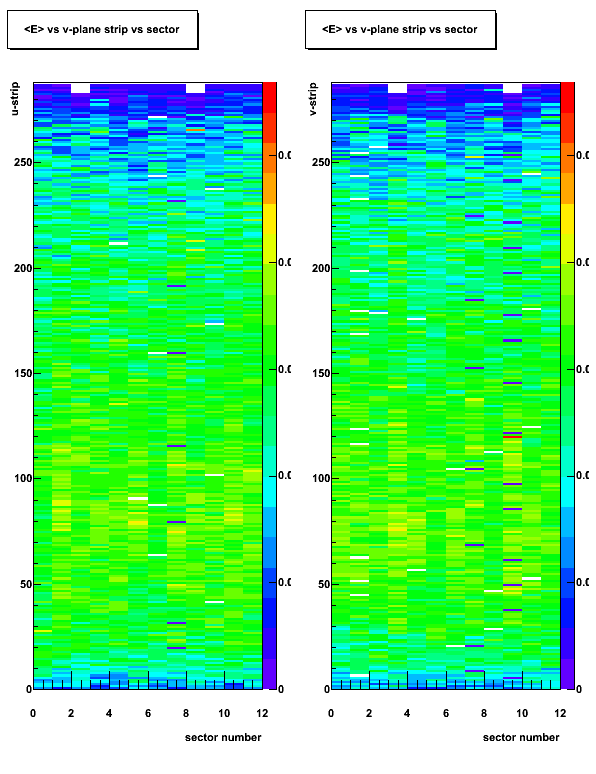
Figure 2: Average energy E for E>0.02 (max < E > = 0.0682)
Same figure on a log scale
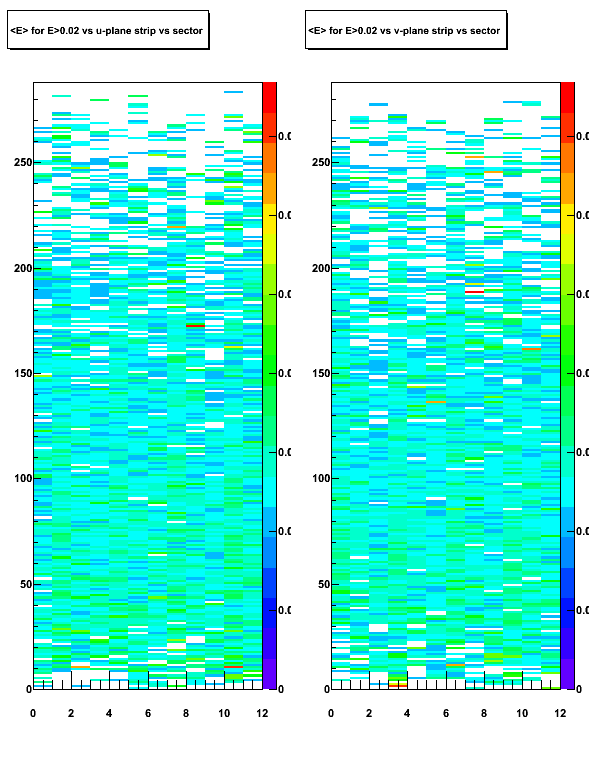
2008.03.12 Gamma-jet candidates: 2-gammas invariant mass and Eemc response
Ilya Selyuzhenkov March 12, 2008
Gamma-jet candidates: 2-gammas invariant
Note: Di-jet transverse momentum distribution for these candidates can be found on figure 11 at this page
Figure 1:Invariant mass distribution for gamma-jet candidates assuming pi0 (2-gammas) hypothesys
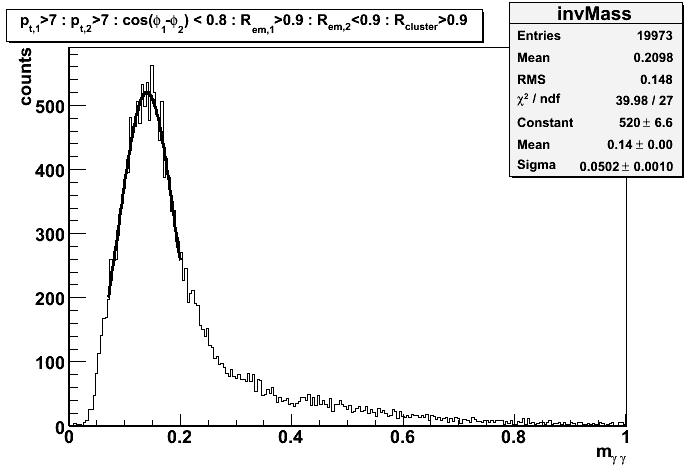
Figure 2:Invariant mass distribution for gamma-jet candidates assuming pi0 (2-gammas) hypothesys
with an additional SMD isolation cut: gammaFraction >0.75
GammaFraction is defined as ratio of the integral
other SMD strips for the first peak to the total energy in the sector
EEMC response for the gamma-jet candidates (gammaFraction >0.75)
-
pdf file (first 100 events) with event by event EEMC response for the candidates reconstructed into pion mass (gammaFraction >0.75)
-
pdf file with event by event EEMC response for the candidates not reconstructed into pion mass
(second peak not found), but has a first peak with gammaFraction >0.75.
2008.03.20 Sided residual and chi2 distribution for gamma-jet candidates
Ilya Selyuzhenkov March 20, 2008
Side residual (no pt cut on gamma jet-candidates)
The procedure to discriminate gamma candidate from pions (and other background)
based on the SMD response is described at Pibero's web page.
Figure 1: Fit integral vs maximum residual for gamma-jet candidates requesting
no energy deposited in the EEMC pre-shower 1 and 2
(within a 3x3 clusters around tower with a maximum energy).
Black line is defined from MC simulations (see Jason's simulation web page, or Pibero's page above).
Figure 2: Fit integral vs maximum residual for gamma-jet candidates requesting requesting
no energy deposited in pre-shower 1 cluster and
no energy deposited in post-shower cluster (this cut is not really essential in demonstrating the main idea)
Figure 3: Fit integral vs maximum residual for gamma-jet candidates requesting requesting
non-zero energy deposited in both clusters of pre-shower 1 and 2
Side residual: first and second jet pt are greater than 7GeV
Event by event EEMC response for gamma-jet candidates for the case of
no energy deposited in the EEMC pre-shower 1 and 2 can be found in this pdf file
Figure 4: Fit integral vs maximum residual for gamma-jet candidates requesting
no energy deposited in the EEMC pre-shower 1 and 2
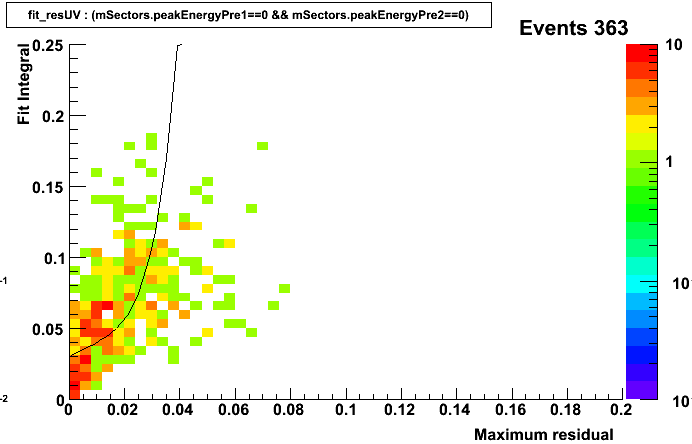
Figure 5: Fit integral vs maximum residual for gamma-jet candidates requesting requesting
no energy deposited in pre-shower 1 cluster and
no energy deposited in post-shower cluster
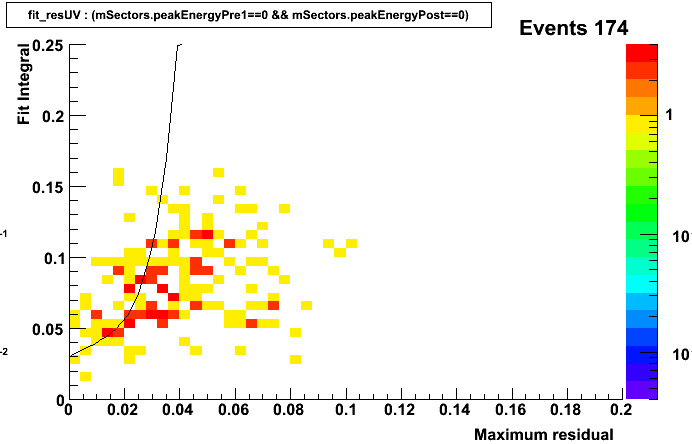
Figure 6: Fit integral vs maximum residual for gamma-jet candidates requesting requesting
non-zero energy deposited in both clusters of pre-shower 1 and 2
Chi2 distribution for gamma-jet candidates
Monte Carlo shape
Event Monte Carlo shape allows to distinguish gammas from background by cutting at chi2/ndf < 0.5
(although the distribution looks wider than for the case of Will's shape).
Figure 7: Chi2/ndf for gamma-jet candidates using Monte Carlo shape requesting
no energy deposited in both clusters of pre-shower 1 and 2
Figure 8: Chi2/ndf for gamma-jet candidates using Monte Carlo shape requesting
non-zero energy deposited in both clusters of pre-shower 1 and 2
Will''s shape
Less clear where to cut on chi2?
Figure 9: Chi2/ndf for gamma-jet candidates using Monte Carlo shape requesting
no energy deposited in both clusters of pre-shower 1 and 2
Figure 10: Chi2/ndf for gamma-jet candidates using Monte Carlo shape requesting
non-zero energy deposited in both clusters of pre-shower 1 and 2
2008.03.26 Sided residual and chi2 distribution for gamma-jet candidates (pre1,2 sorted)
Ilya Selyuzhenkov March 26, 2008
gamma-jet candidates (no pt cut)
Definitions:
- F_peak - integral for a fit within [-2,2] strips around SMD u/v peak
- D_peak - integral over the data within [-2,2] strips around SMD u/v peak
- D_tail^max (D_tail^min) - maximum (minimum) integral over the data tail within +-[3,30] strips from a SMD u/v peak
- F_tail is the integral over the fit tail within [3,30] strips from a SMD u/v peak.
- Maximum residual = D_tail^max - F_tail
All results are for combined distributions from u and v planes: ([u]+[v])/2
Gamma-jet isolation cuts described here
Additional quality cuts:
- Matching between 3x3 tower cluster and u-v high strip intersection
- At least 4 strips fired within [-2,2] strips from a peak
Figure 1: F_peak vs maximum residual
for various cuts on energy deposited in the EEMC pre-shower 1 and 2
(within a 3x3 clusters around tower with a maximum energy).
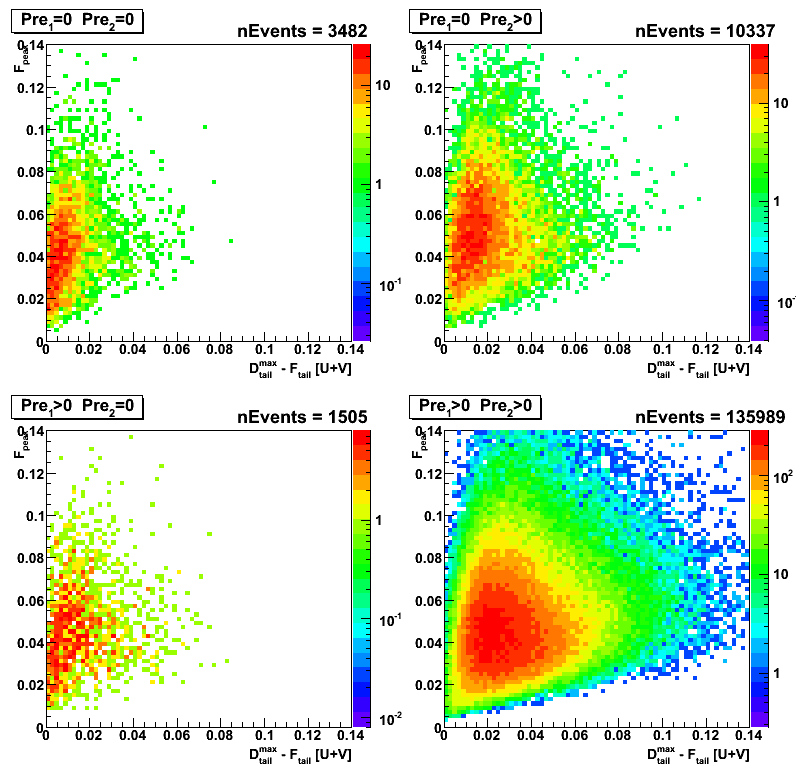
Figure 2: F_data vs D_tail^max
Note:This plot is fit independend (only the peak position is defined based on the fit)
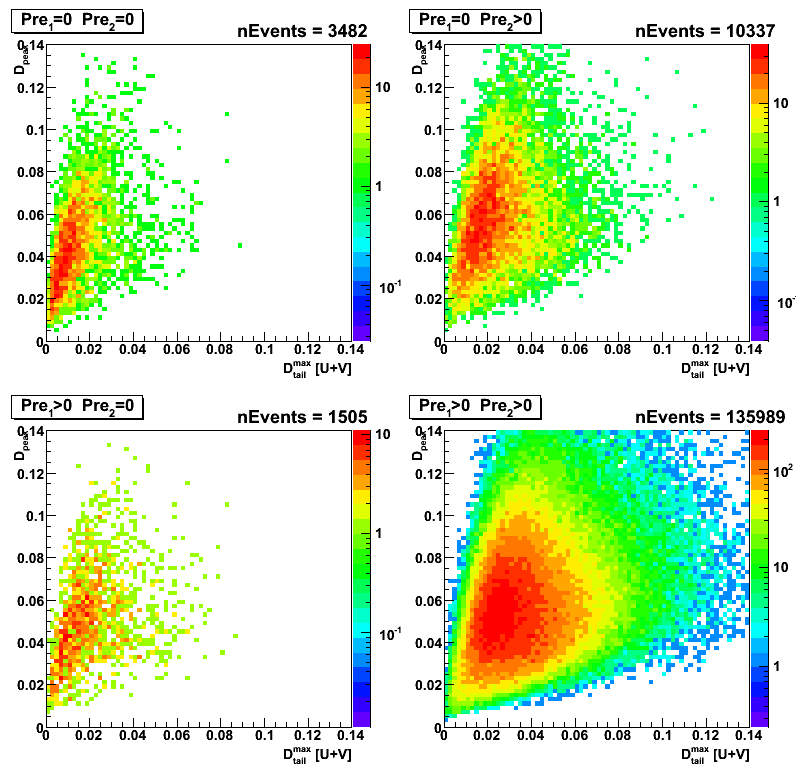
Figure 3: F_data vs D_tail^max-D_tail^max
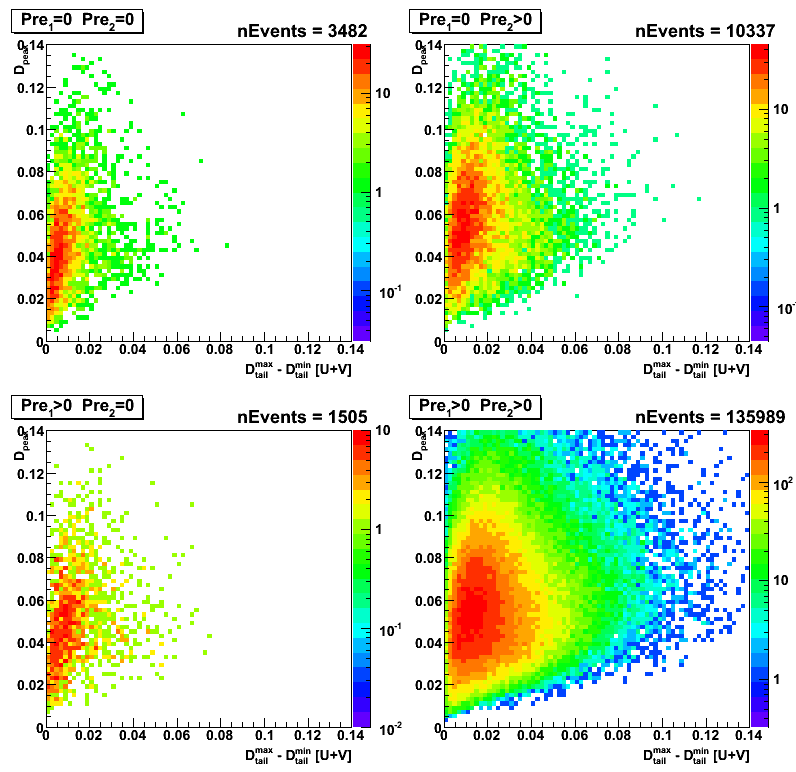
Figure 4: Gamma transverse momentum vs jet transverse momentum
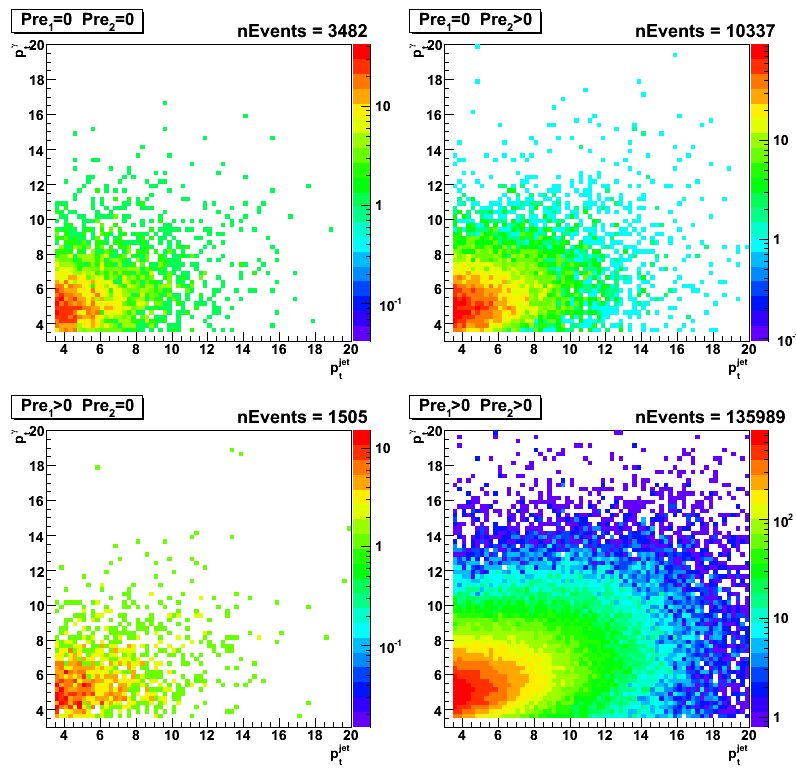
gamma-jet candidates: pt > 7GeV
Figure 5: F_peak vs maximum residual
for various cuts on energy deposited in the EEMC pre-shower 1 and 2
(within a 3x3 clusters around tower with a maximum energy).

Figure 6: F_data vs D_tail^max
Note:This plot is fit independend (only the peak position is defined based on the fit)

Figure 7: F_data vs D_tail^max-D_tail^max
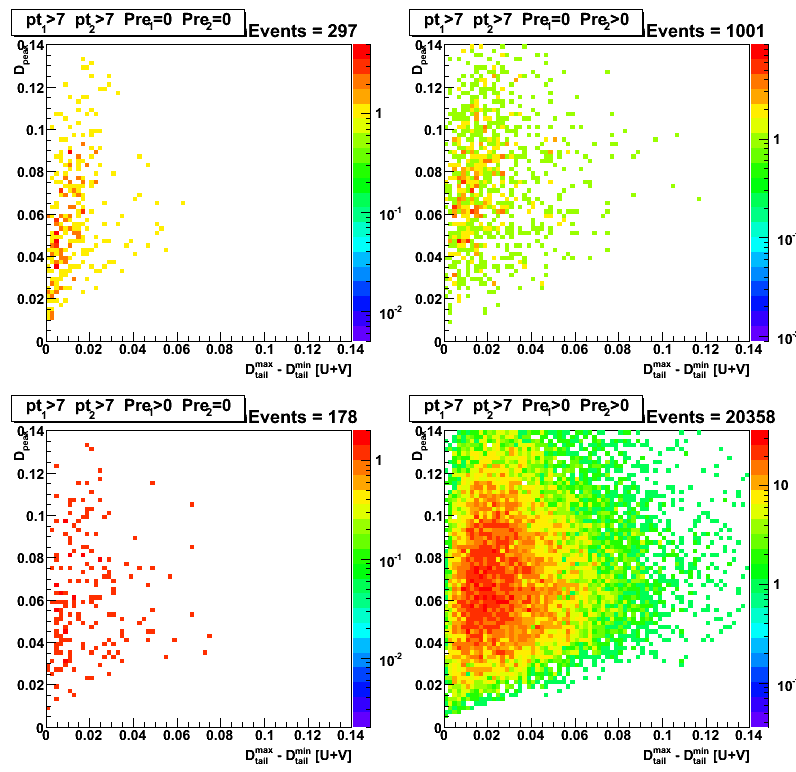
Figure 8: Gamma transverse momentum vs jet transverse momentum
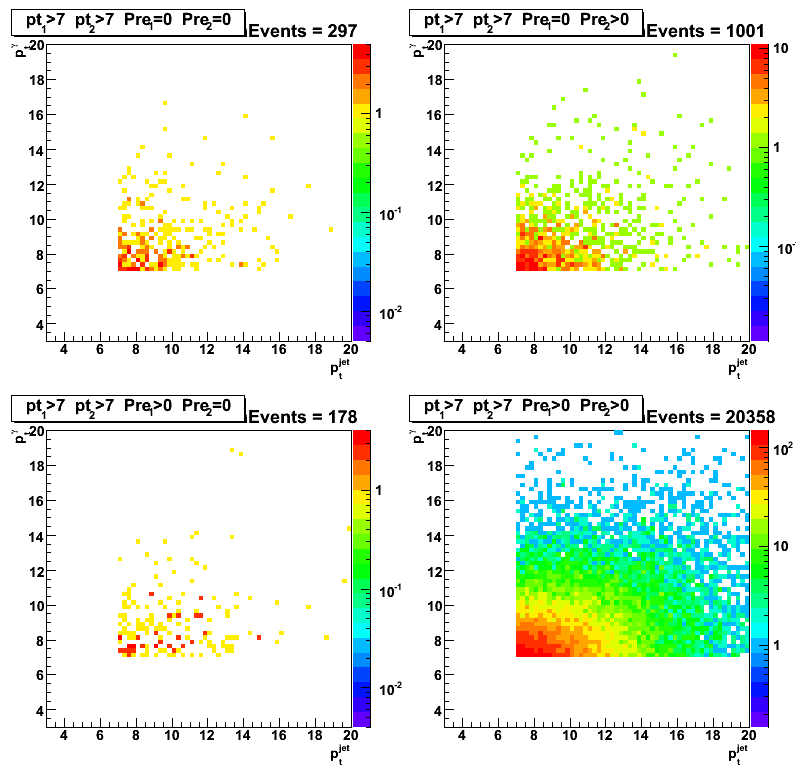
gamma-jet candidates: eta, phi, and max[u,v] strip distributions (no pt cuts)
Figure 9: Gamma pseudorapidity vs jet pseudorapidity
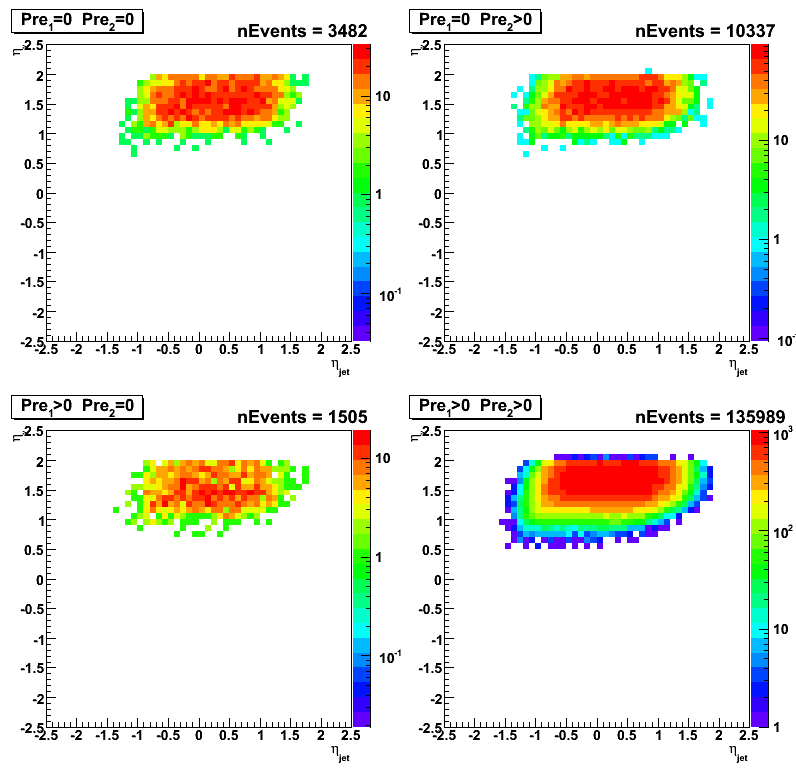
Figure 10: Gamma azimuthal angle vs jet azimuthal angle
Note: for the case of Pre1>1 && Pre2==0 there is an enhancement around phi_gamma = 0?
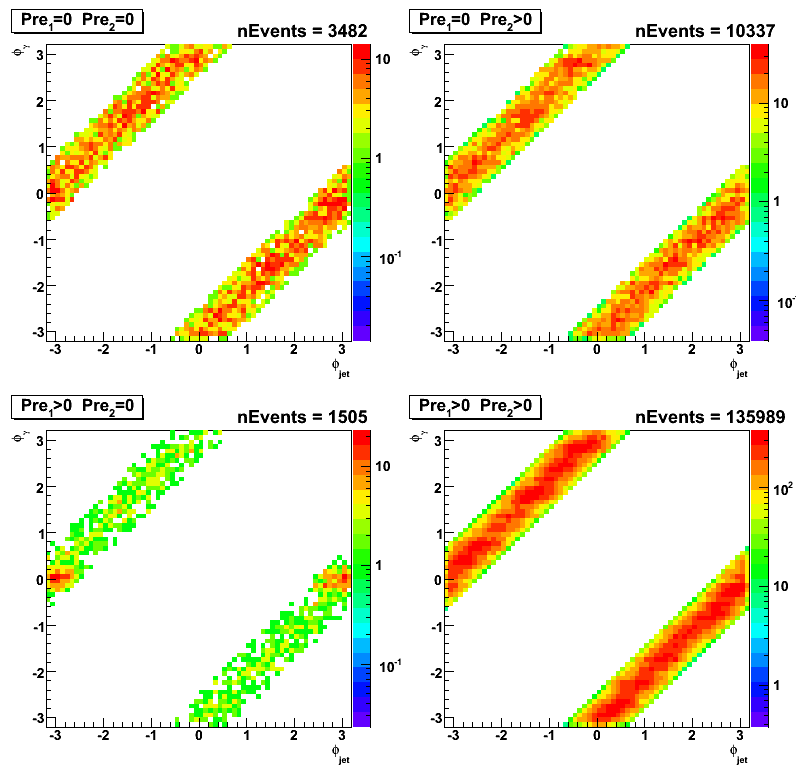
Figure 11: maximum strip in v-plane vs maximum strip in u-plane
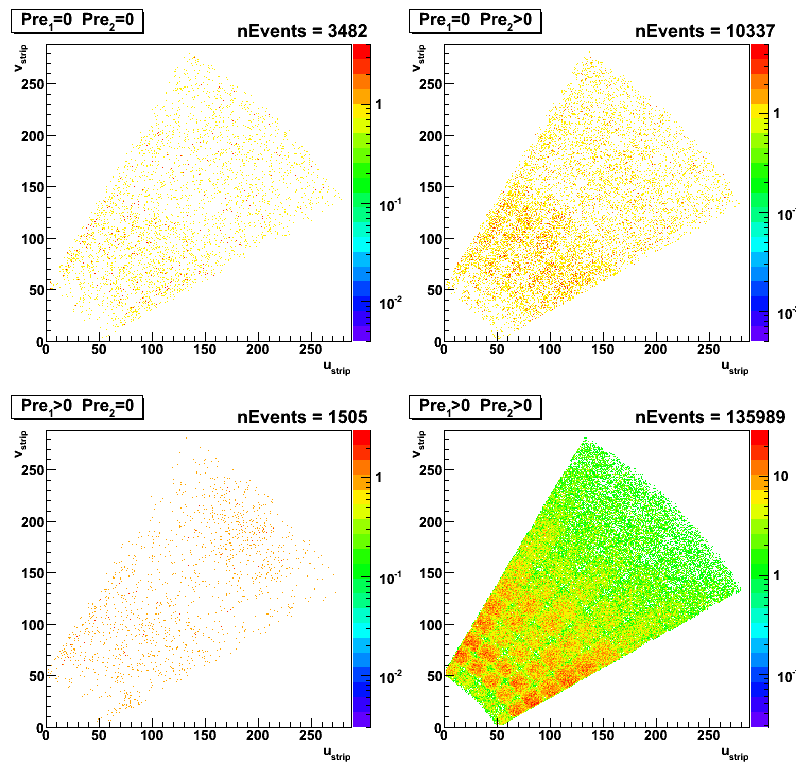
Chi2 distribution for gamma-jet candidates (no pt cuts)
Figure 12:Chi2/ndf for gamma-jet candidates using Monte Carlo shape (combined for [u+v]/2 plane )
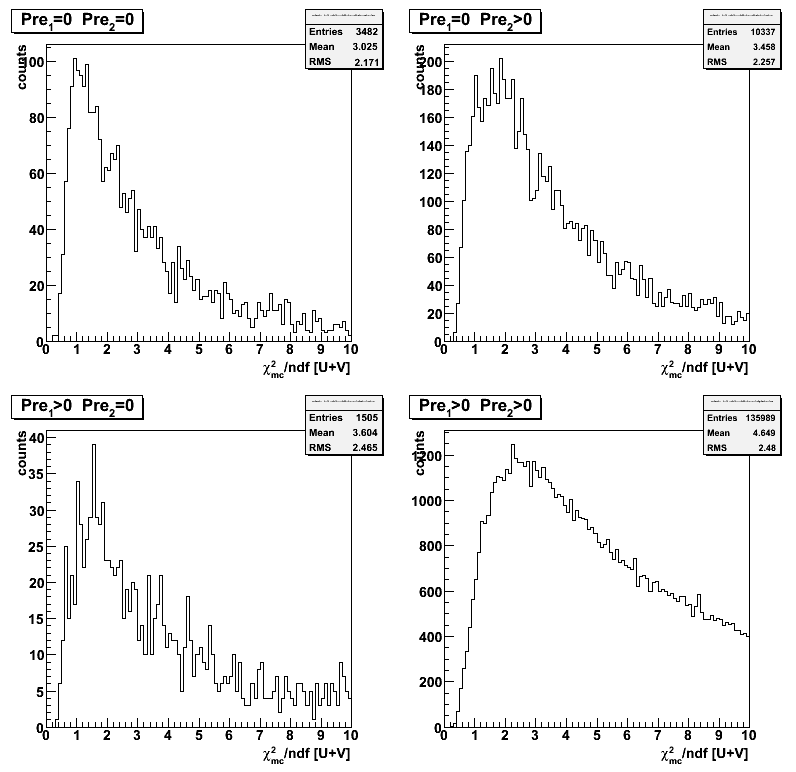
Figure 13:Chi2/ndf for gamma-jet candidates (combined for [u+v]/2 plane ) using Will's shape
2008.03.28 EEMC SMD shapes: gamma's from gamma-jets (data), MC, and eta-meson analysis
Ilya Selyuzhenkov March 28, 2008
Some observations:
- SMD data-driven shapes from different analysis are in a good agreement (Figure 1, upper left plot)
- Overall MC shape is too narrow compared to the data shapes (Figure 1, upper left plot)
- Shapes are similar with or without gamma-jet 7GeV pt cut (compare Figures 1 and 2),
what may indicate that shape is independent on energy (at least within our kinematic limits). - Data-driven and MC shapes are getting close to each other (Figure 4, upper left plot)
when requiring no energy above threshold in both preshower layers and
with suppressed contribution from pi0 background.
The latter is achieved by using the information on
reconstructed invariant mass of 2gamma candidates (compare Figure 3 and 4).One interpretation of this can be that in Monte Carlo simulations
the contribution from the material in front of the detector is underestimated - Energy distribution for each strip in the SMD peak does not looks like a Gaussian (Figure 5),
what makes very difficult to interpret results obtained from chi2 analysis (Figure 6-8). -
Triple Gaussian fit gives a better description of the data shapes,
compared to the double Gaussian function (compare red and black lines on Figure 1-4)
Figure 1: EEMC SMD shape comparison for various preshower cuts
(black points shows u-plane shape only, v-plane results can be found here)
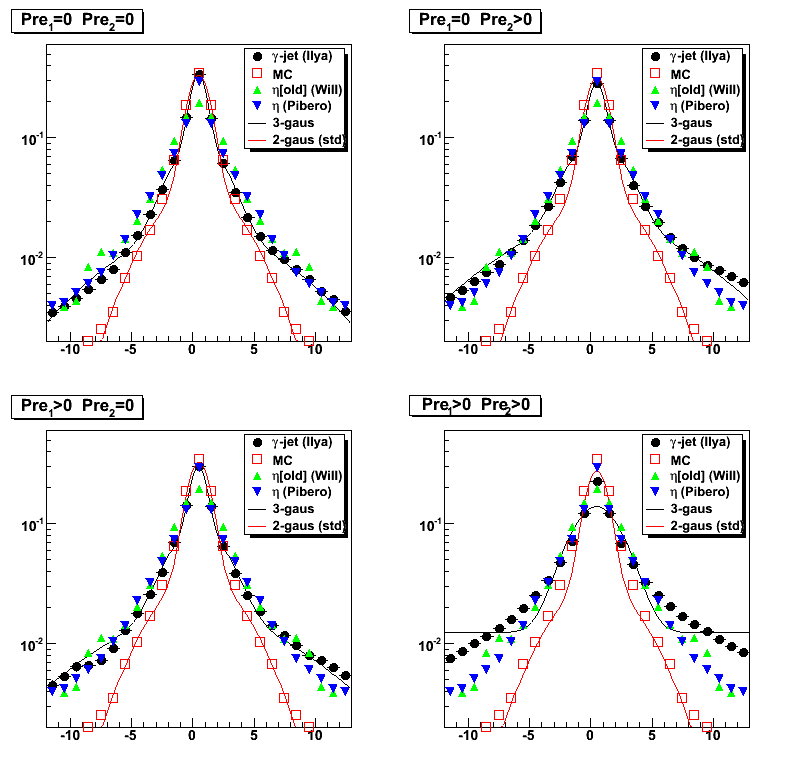
Figure 2: EEMC SMD shape comparison for various preshower cuts with gamma-jet pt cut of 7GeV
(black points shows u-plane shape only, v-plane results can be found here)
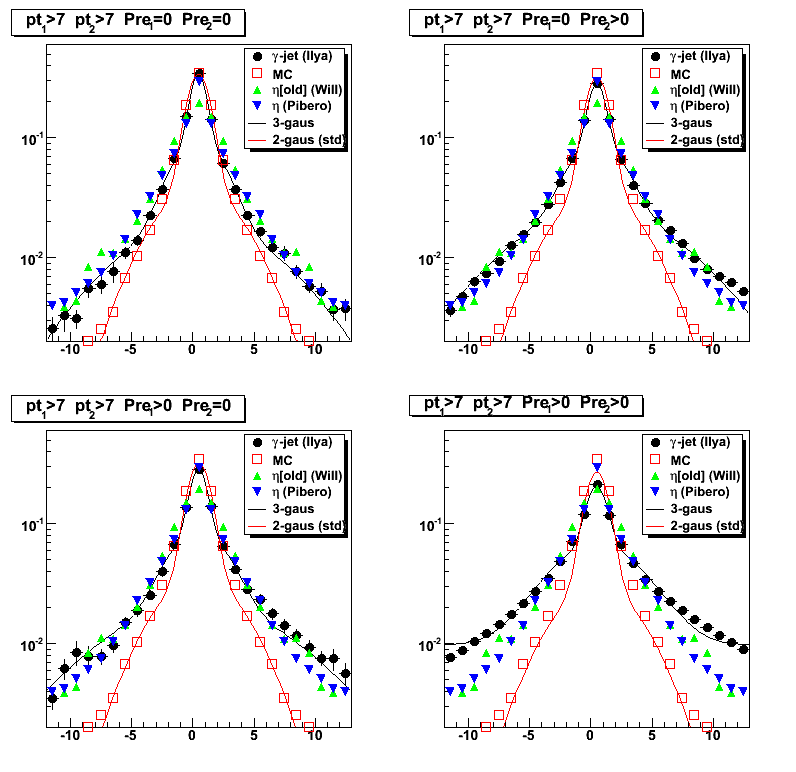
Figure 3: Shapes with an additional cut on 2-gamma candidates within pi0 invariant mass range.
Sample invariant mass distribution using "simple" pi0 finder can be found here
(black points shows u-plane shape only, v-plane results can be found here)
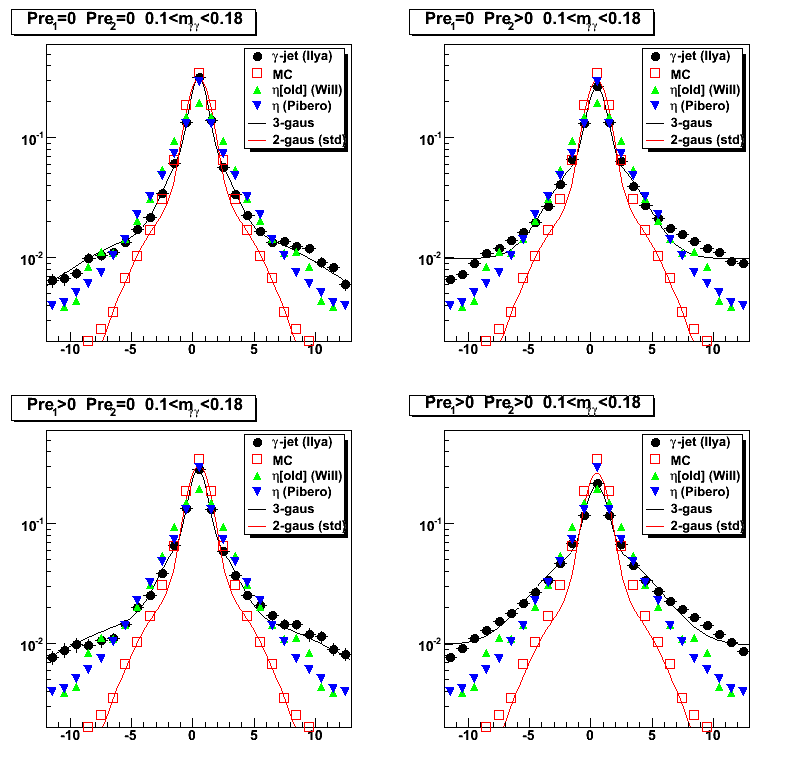
Figure 4: Shapes for the candidates when "simple" pi0 finder failed to find a second peak
(black points shows u-plane shape only, v-plane results can be found here)
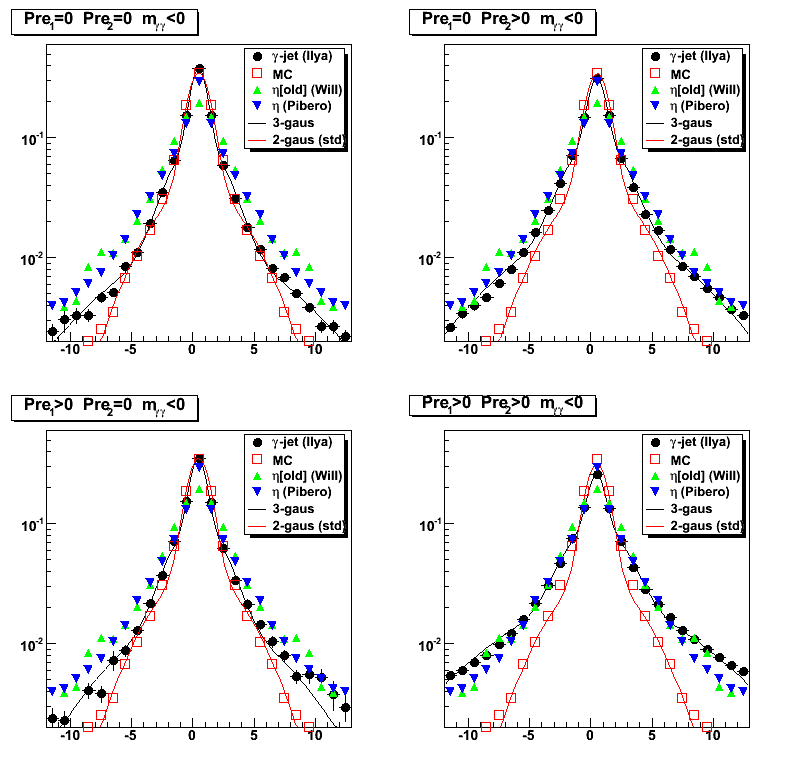
Figure 5: Strip by strip SMD energy distribution.
Only 12 strips from the right side of the maximum are shown.
Zero strip (first upper left plot) corresponds to the high strip in the shape
Note, that already at the 3rd strip from a peak,
RMS values are comparable to those for a mean, and for a higher strips numbers RMS starts to be bigger that mean.
(results for u-plane only, v-plane results can be found here)
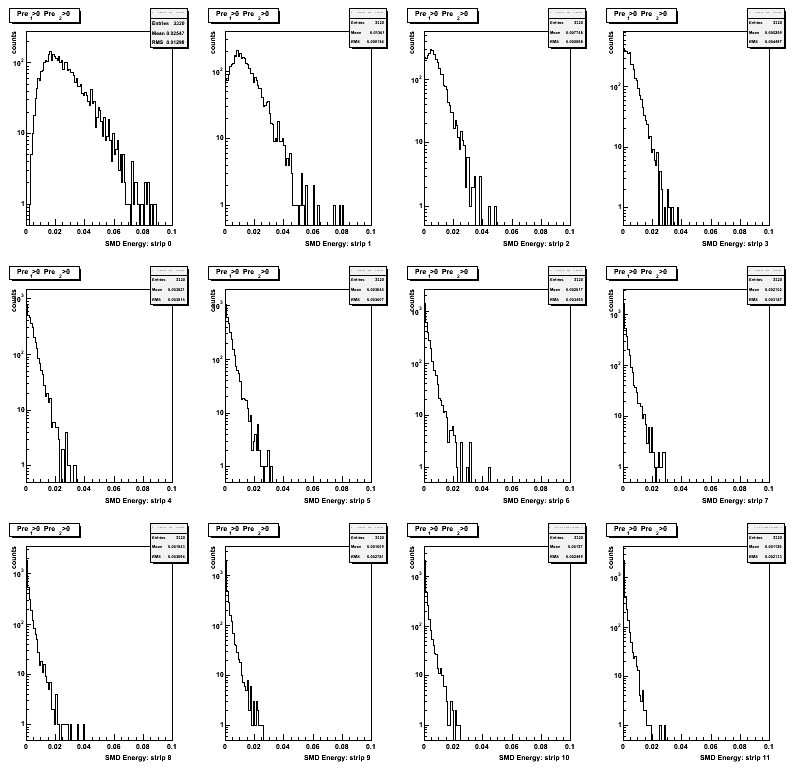
Comparing chi2 distributions for gamma-jet candidates using MC, Will, and Pibero's shapes
Results for side residual (together with pt, eta, phi distributions) for gamma-jet candidates can be found at this web page
Red histograms on Figures 6-8 shows chi2 distribution from MC-photons (normalized at chi2=1.4)
Blue histograms on Figures 6-8 shows chi2 distribution from MC-pions (normalized at chi2=1.4)
Figure 6: Chi2/ndf for gamma-jet candidates using Monte Carlo shape
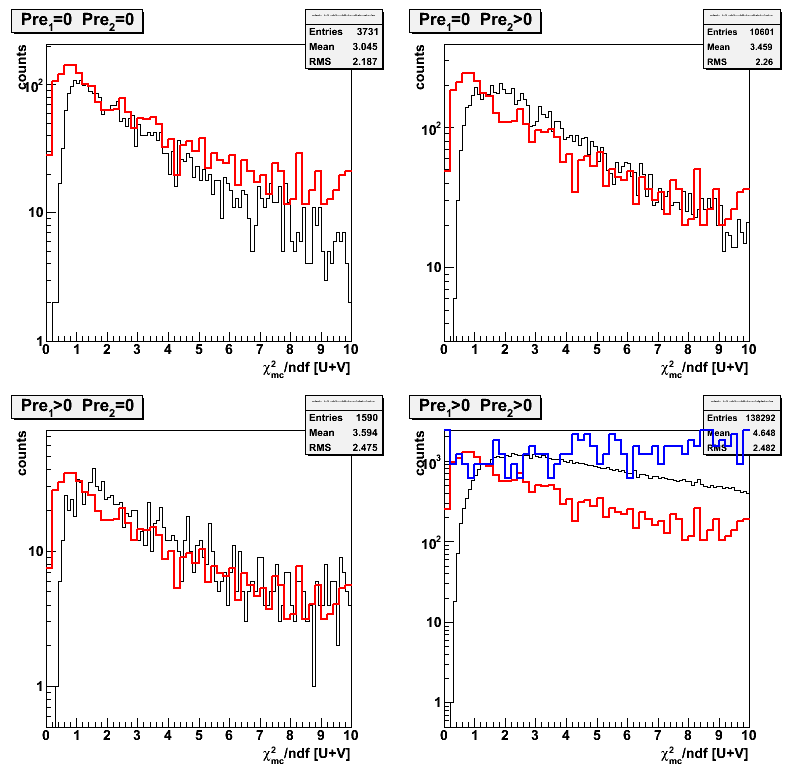
Figure 7: Chi2/ndf for gamma-jet candidates using Will's shape (derived from eta candidates based on Weihong's pi0-finder)
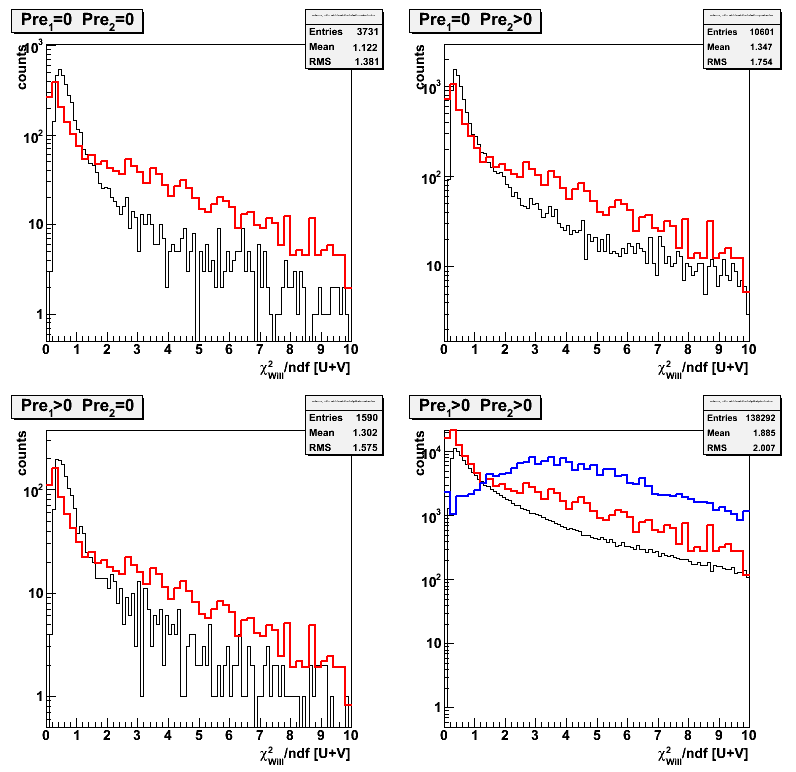
Figure 8: Chi2/ndf for gamma-jet candidates using Pibero's shape (derived from eta candidates)
04 Apr
April 2008 posts
2008.04.02 EEMC SMD shapes: data-driven (eta, gamma-jet) vs Monte Carlo (single gamma, gamma-jet)
Ilya Selyuzhenkov April 02, 2008
Some observations:
- SMD data-driven shapes from eta-meson and gamma-jet studies
are in a good agreement for different preshower conditions
(compage Fig.1 green circles/triangles in upper-left/bottom-right plots) - single gamma MC shapes show preshower dependance,
but they are still narrower compared to the data shapes
(compare Fig.1 green circles vs blue open squares) - MC shapes for gamma-jet and single gamma are consistent (Fig.1, bottom right plot)
Figure 1: EEMC SMD shape comparison for various preshower cuts
Note:Only MC gamma-jet shape (open red squares) is the same on all plots
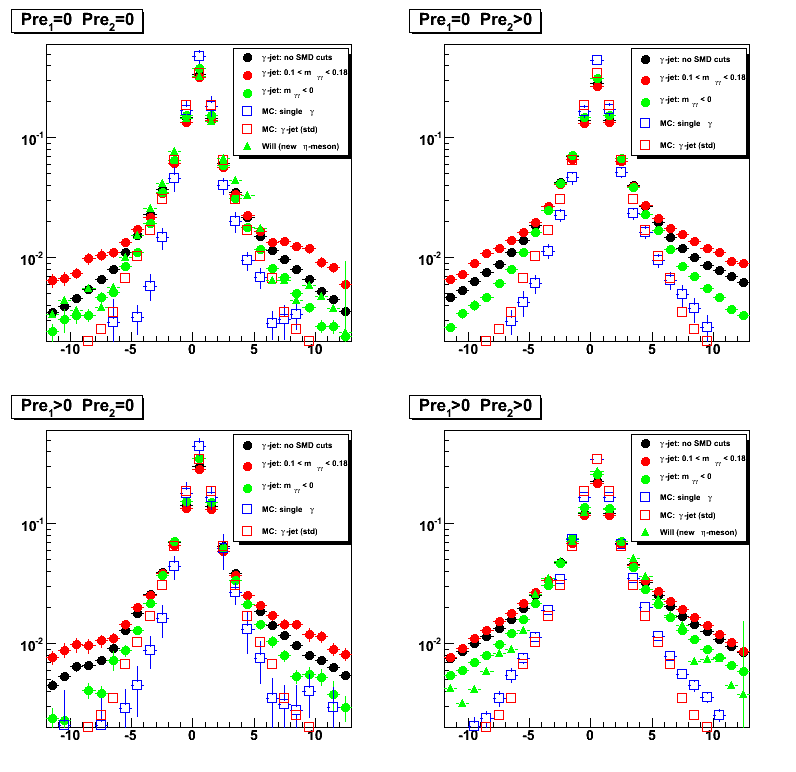
2008.04.02 Sided residual: Using data driven gamma-jet shape (3 gaussian fit)
Ilya Selyuzhenkov April 02, 2008
Figure 1: Side residual for various cuts on energy deposited in the EEMC pre-shower 1 and 2
No EEMC SMD based cuts
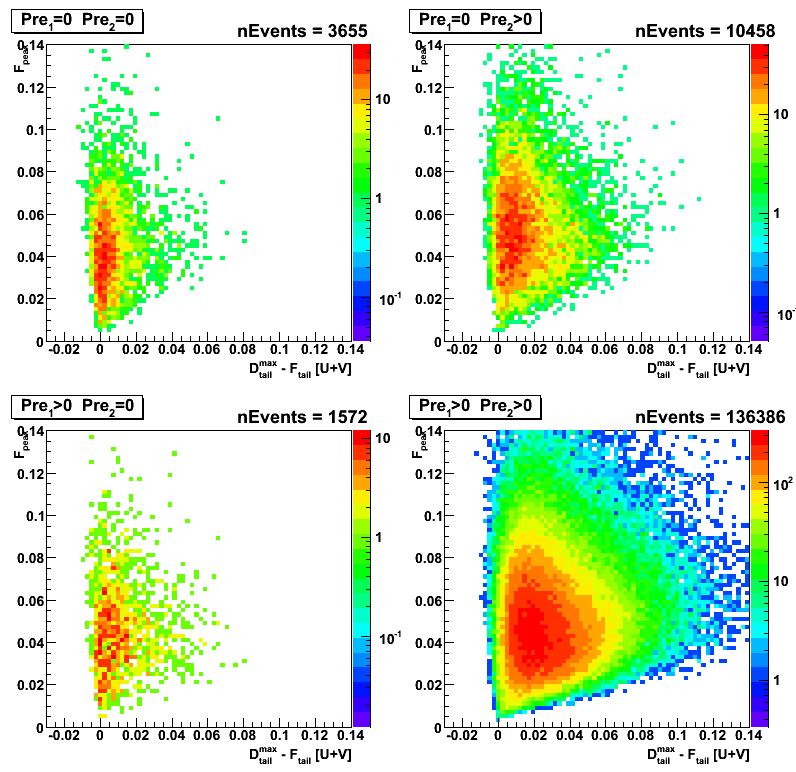
Figure 2: Side residual for various cuts on energy deposited in the EEMC pre-shower 1 and 2
"Simple" pi0 finder can not find a second peak
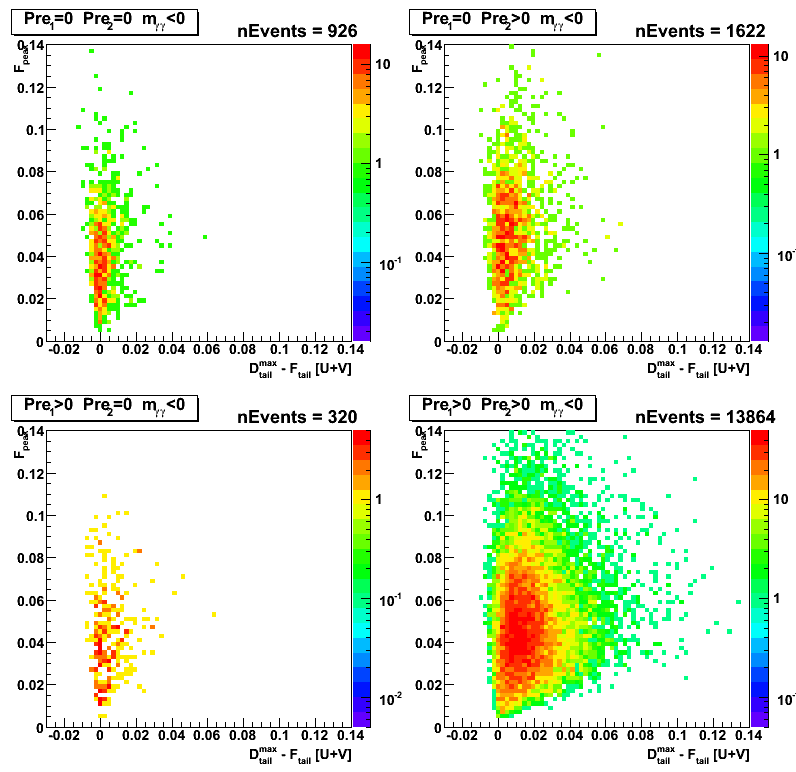
Figure 3: Side residual for various cuts on energy deposited in the EEMC pre-shower 1 and 2
"Simple" pi0 finder reconstruct the invarian mass within [0.1,0.18] range
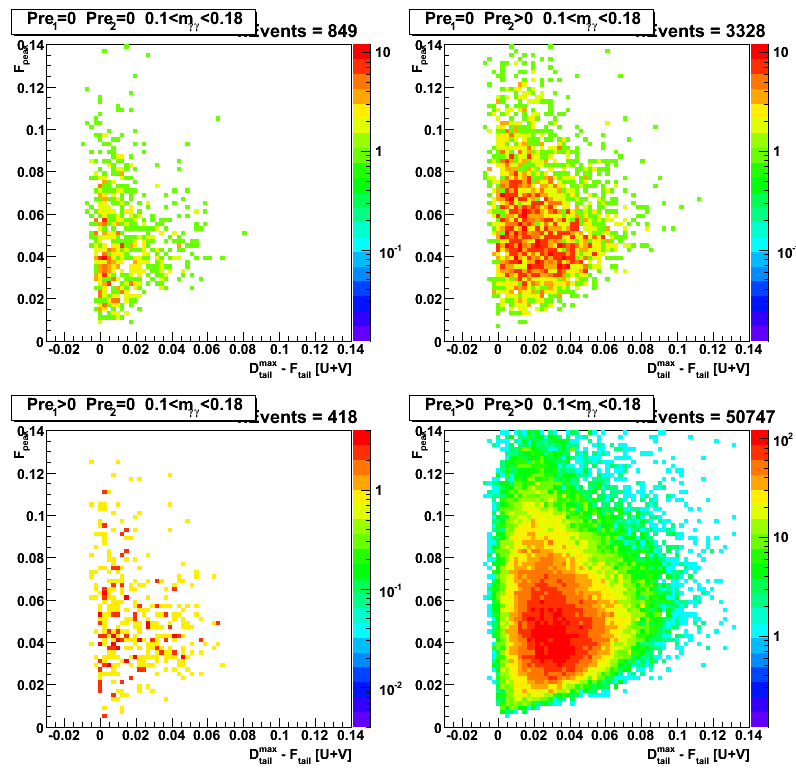
Figure 4: Side residual distribution (Projection for side residual in Figs.1-3 on vertical axis)
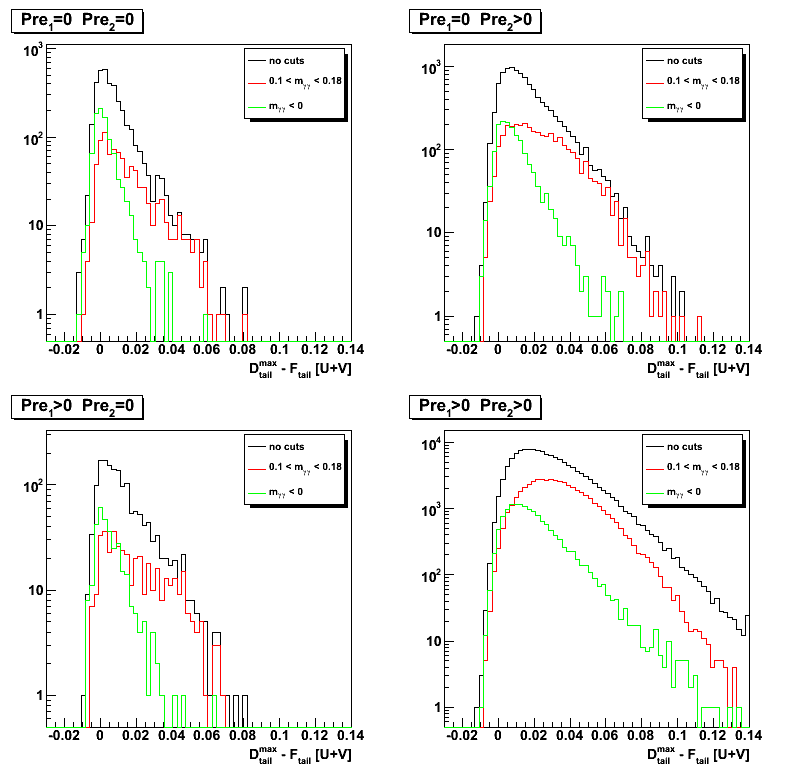
Figure 5: Signal (green: m < 0) vs background (black, red) separation
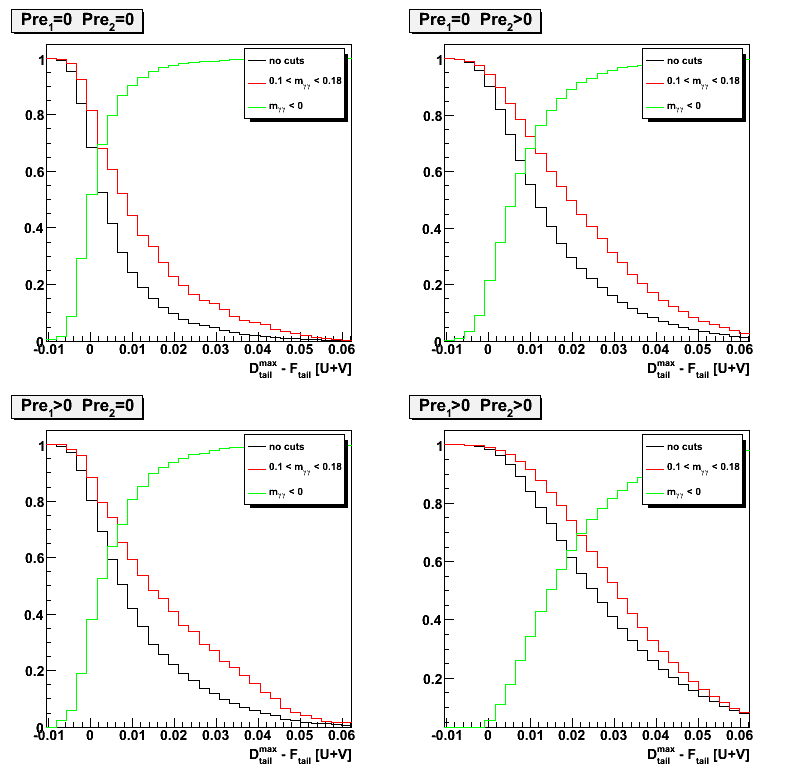
2008.04.02 Sided residual: single gamma Monte-Carlo simulations
Ilya Selyuzhenkov April 02, 2008
Side residual: single gamma Monte-Carlo simulations
Figure 1: Side residual for various cuts on energy deposited in the EEMC pre-shower 1 and 2
No EEMC SMD based cuts
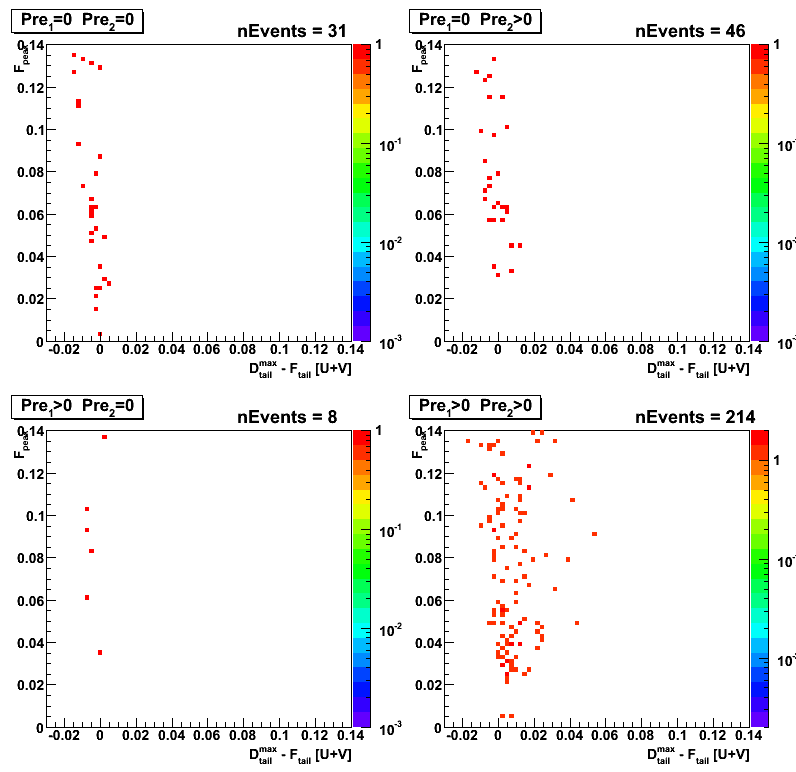
2008.04.03 chi2-shape subtraction for different Preshower conditions
Ilya Selyuzhenkov April 03, 2008
Request from Hal Spinka:
Hi Ilya,
I think you gave up on the chi-squared method too quickly, and am sorry I missed the phone meeting last week. So, I would like to make a request that will hopefully take a minimal amount of your time to show that all is okay. Then, if there is a delay in getting the sided residual information out and into the beam use request, you can still fall back on the chi-squared method.
In your March 28 posting, Figure 8 at the bottom, I would like to get numerical values for the events per bin for the black curves. I won't use the preshower1>0 and preshower2=0 data, so those you don't need to send. Also, I won't use the red or blue curve information.
I think your problem has been that you normalized your curves at chi-squared/ndf = 1.4 instead of the peak. What I plan to do is to normalize the (pre1=0, pre2=0) to the (pre1=0, pre2>0) data in the peak and subtract. The (pre1=0, pre2=0) set should have some single photons, but also some multiple photons. The (pre1=0, pre2>0) should also have single photons, and more multiple photons, since the chance that one of them will convert is larger. The difference should look roughly like your blue curve, though perhaps not exactly if Pibero's mean shower shape is not perfect (which it isn't). I will do the same thing with taking the difference between (pre1>0, pre2>0) and (pre1=0, pre2=0), and again the difference should look roughly like your blue curve. The (pre1>0, pre2>0) data should have even larger fraction of multiple photons than either of the other two data sets. I would expect the two difference curves to look approximately the same.
Hope this is possible for you to do. Since our reduced chi-squared curve looks so much like the one from CDF, I am pretty confident that we are okay, but this should be checked to convince people that we are not doing anything terribly wrong.
Reply by Ilya:
Dear Hal,
I have tried to implement your idea and produce a figure attached.
There are 4 plots in it:
1. Upper left plot shows normalized to unity (at maximum) chi2 distribution (obtained with Pibero shape for gamma-jet candidates) for a different pre1, pre2 conditions
2. Upper right plot shows bin-by-bin difference: a) between normalized chi2 for pre1=0, pre2>0 and pre1=0, pre2=0 (red) and b) between normalized chi2 for pre1>0, pre2>0 and pre1=0, pre2=0 (blue)
3. Bottom left Same as upper right, but normalization were done based on the integral within [-4,4] bins around maximum.
4. Bottom right Same as for upper right, but with a different normalization ([-4,4] bins around maximum)
I have also tried to normalized by the total integral, but the results looks similar.
Figure 1: See description above
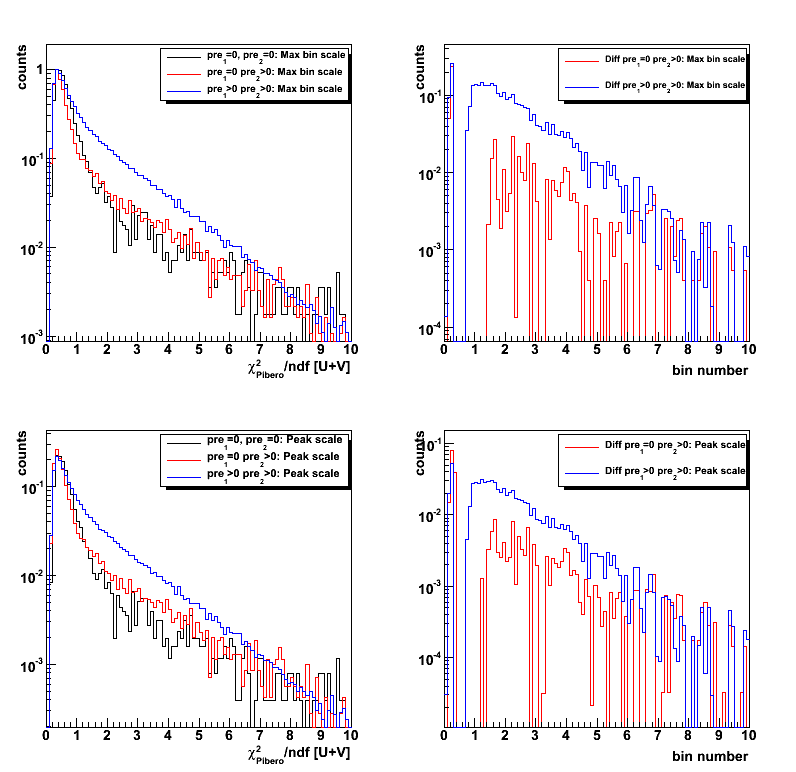
2008.04.09 Applying gamma-jet reconstruction algorithm for gamma-jet simulated events
Ilya Selyuzhenkov April 09, 2008
Data sample:
Monte-Carlo gamma-jet sample for partonic pt range of 5-7, 7-9, 9-11,11-15, 15-25, 25-35 GeV.
Analysis: Simulated MuDst files were first processed through jet finder algorithm (thanks to Renee Fatemi),
and later analyzed by applying gamma-jet isolation cuts (see this link for details) and studying EEMC SMD response (see below).
To test the algorithm, Geant records were not used in this analysis.
Further studies based on Geant records (yield estimates, etc) are ongoing.
EESMD shapes comparison
Figure 1:Comparison between shower shape profile for data and MC.
Black circles shows results for MC gamma-jet sample (all partonic pt).
For v-plane results see this figure
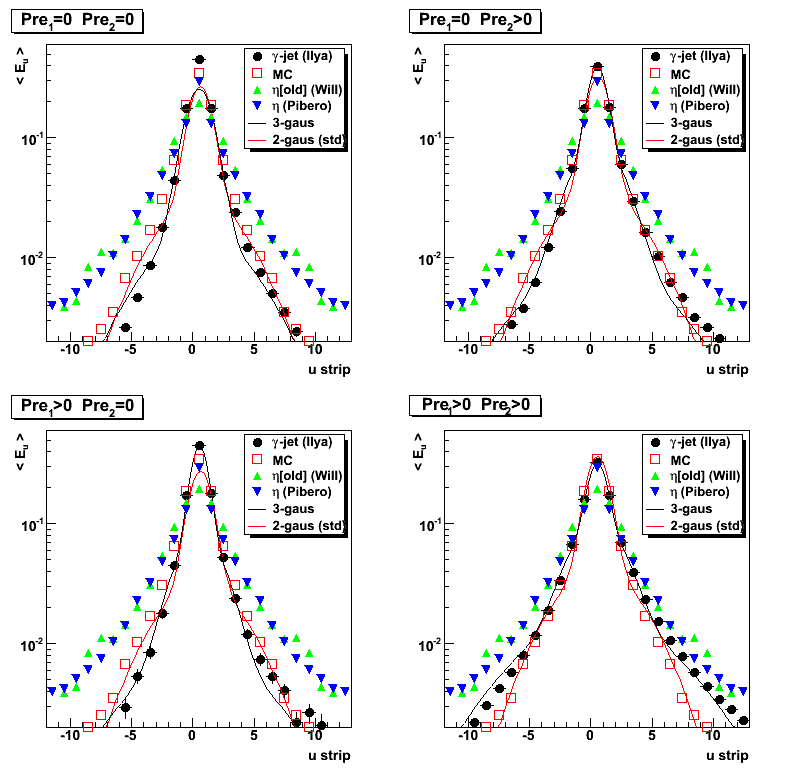
Correlation between gamma and jet pt, eta, phi
Figure 2:Gamma vs jet transverse momentum.
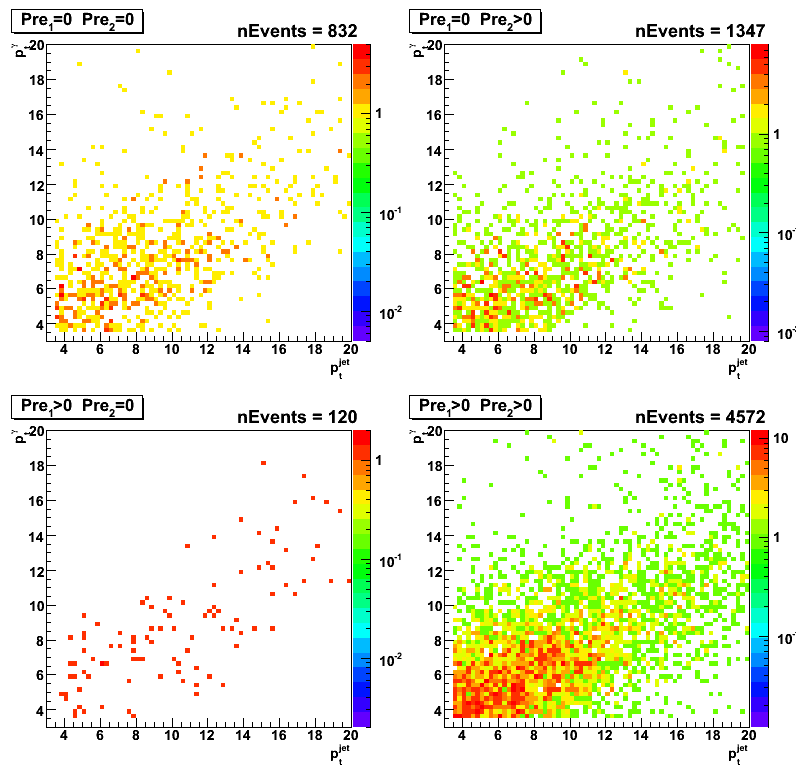
Figure 3:Gamma vs jet azimuthal angle.
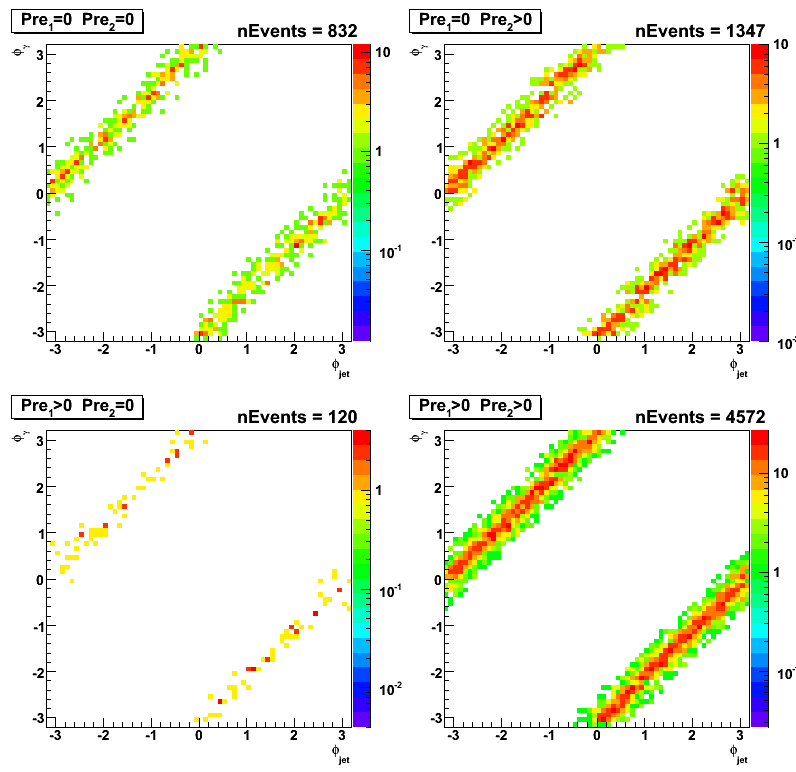
Figure 4:Gamma vs jet pseudo-rapidity.
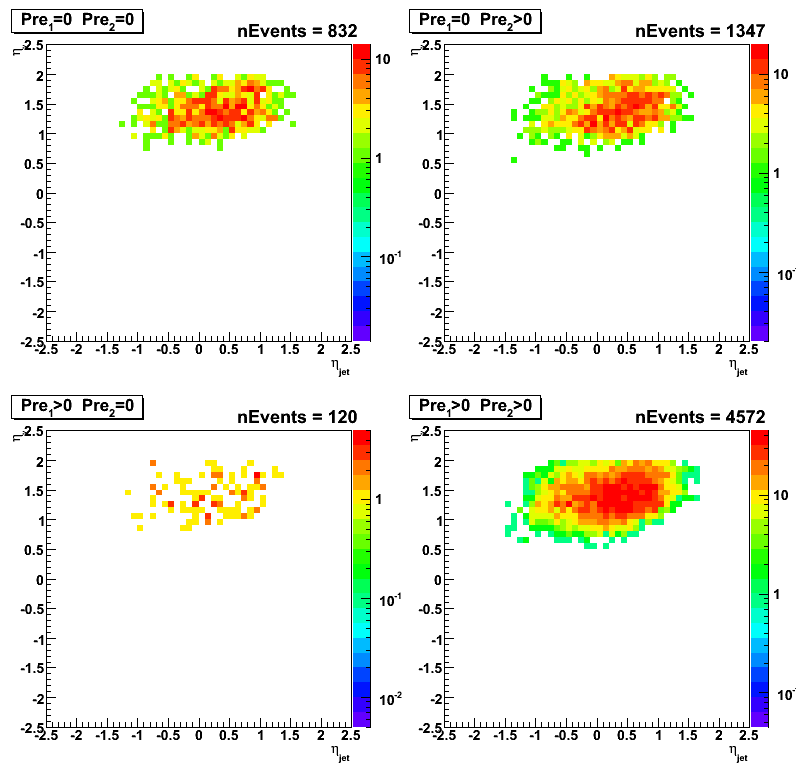
Results from maximum sided residua study
Definitions for F_peak, D_peak, D_tail^max (D_tail^min) can be found here
Figure 5:F_peak vs maximum residual
for various cuts on energy deposited in the EEMC pre-shower 1 and 2
(within a 3x3 clusters around tower with a maximum energy).
Shower shape used to fit data is fixed to the shape from the previous gamma-jet study of real events
(see black point on Fig.1 [upper left plot] at this page)
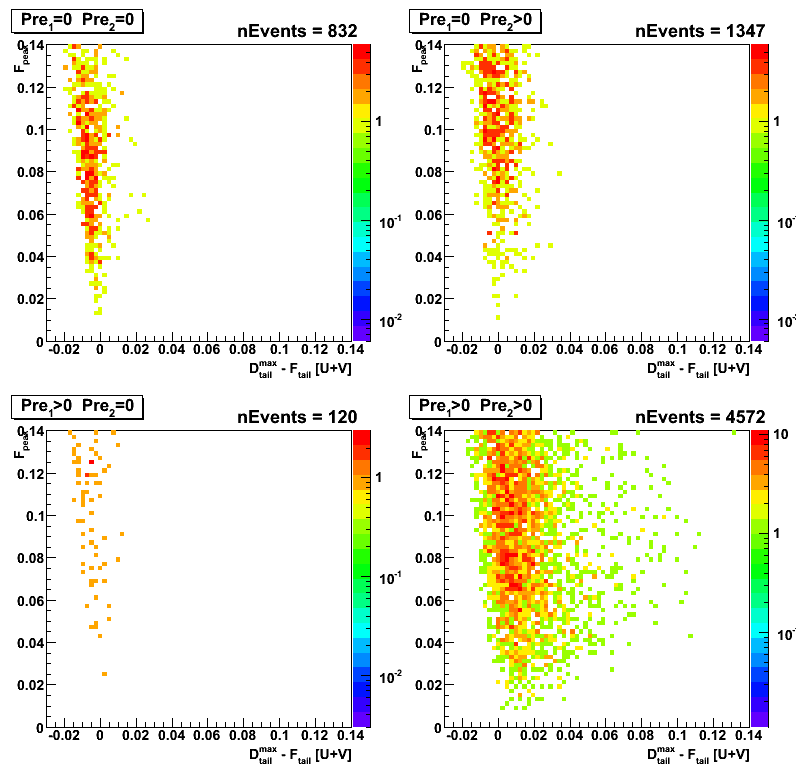
Figure 6: F_peak vs D_tail^max: click here
Figure 7: F_peak vs D_tail^max-D_tail^min: click here
Postshower to SMD[uv] energy ratio
Figure 8:Logarithmic fraction of energy in post shower (3x3 cluster) to the total energy in SMD u- and v-planes
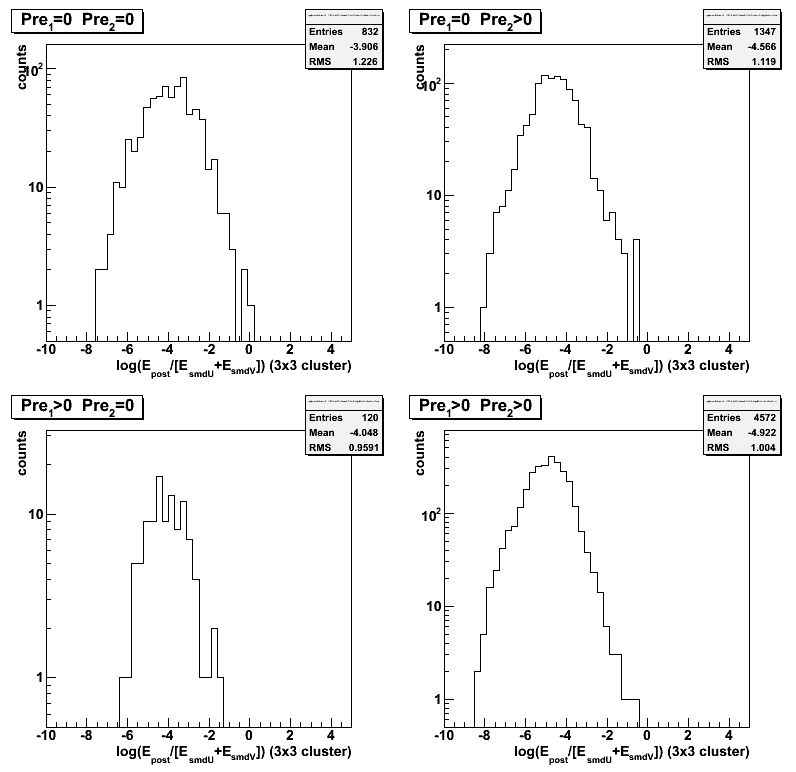
Figure 8a:
Same as figure 8, but for gamma-jet candidates from the real data (no pt cuts).
Logarithmic fraction of energy in post shower (3x3 cluster) to the total energy in SMD u- and v-planes
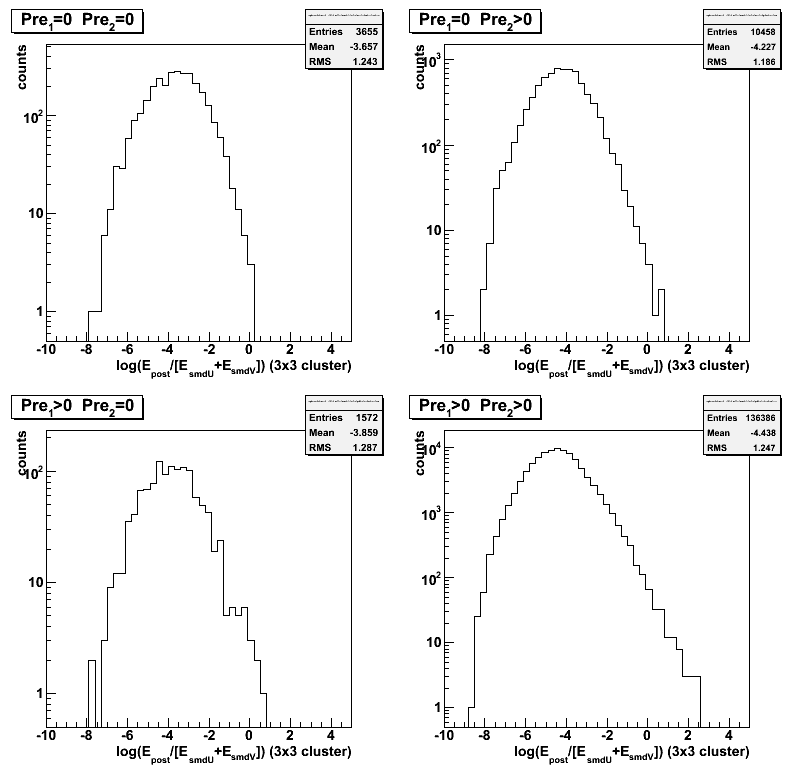
Figure 8b:
Comparison between gamma-jet candidates from data with different preshower conditions.
Points are normalized in peak to the case of pre1 > 0, pre2 > 0
Logarithmic fraction of energy in post shower (3x3 cluster) to the total energy in SMD u- and v-planes
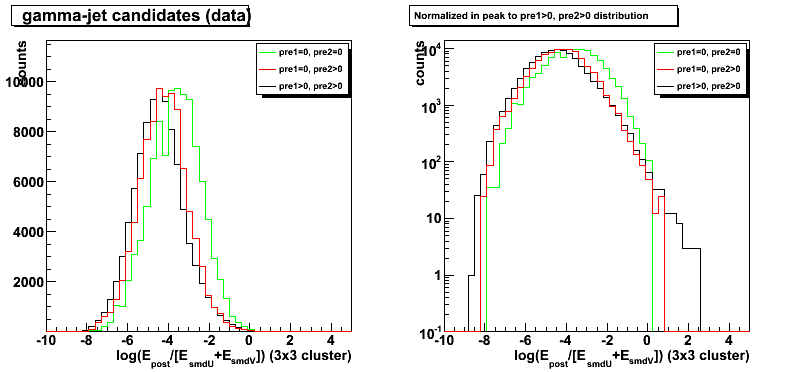
Figure 8c:
Comparison between gamma-jet candidates from Monte-Carlo simulations with different preshower conditions.
Points are normalized in peak to the case of pre1 > 0, pre2 > 0
Logarithmic fraction of energy in post shower (3x3 cluster) to the total energy in SMD u- and v-planes
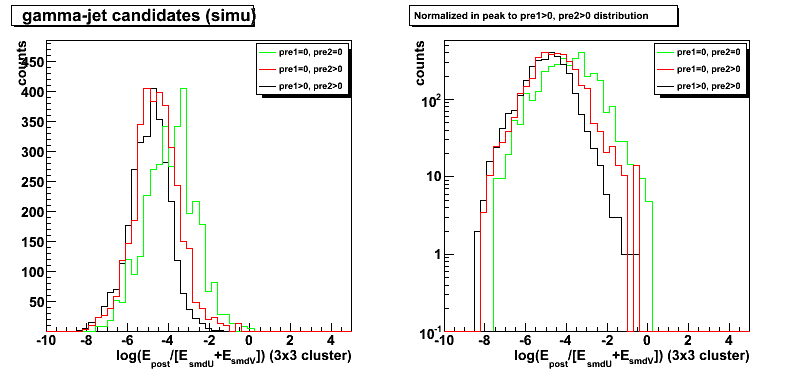
Additional QA plots
Figure 9: Jet neutral energy fraction
Figure 10: High v-strip vs u-strip
Figure 11: energy post shower (3x3 cluster)
Figure 12: Peak energy SMD-u
Figure 13: Peak energy SMD-v
Figure 14: Gamma phi
Figure 15: Gamma pt
Figure 16: Gamma eta
Figure 17: Delta gamma-jet pt
Figure 18: Delta gamma-jet eta
Figure 19: Delta gamma-jet phi
chi2 distributions
Figure 20:chi2 distribution using "standard" MC shape
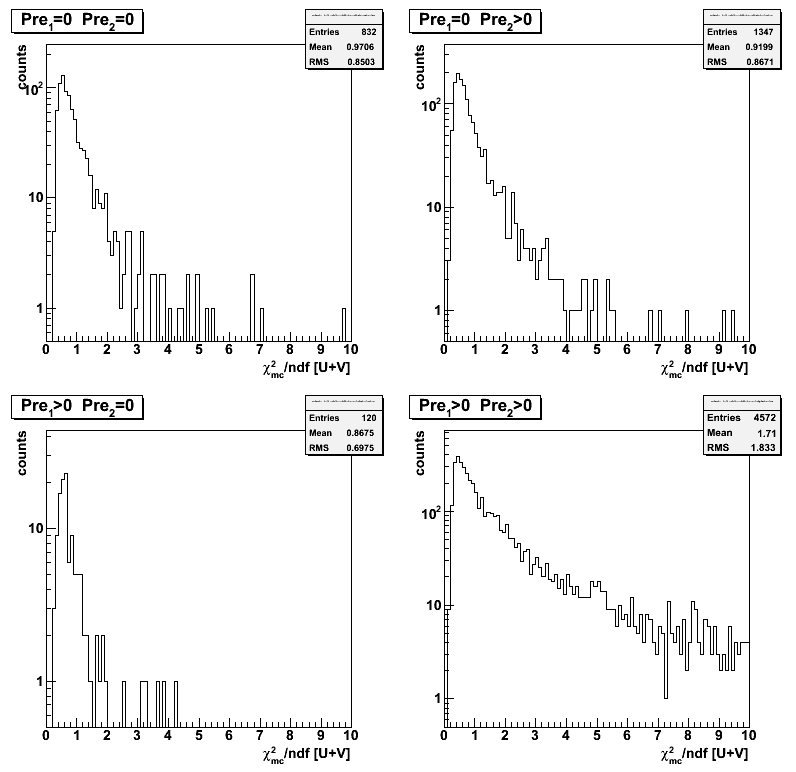
2008.04.16 Sided residual: Data Driven MC vs raw MC vs 2006 data
Ilya Selyuzhenkov April 16, 2008
Figure 1: Sided residual for raw MC (partonic pt 9-11)
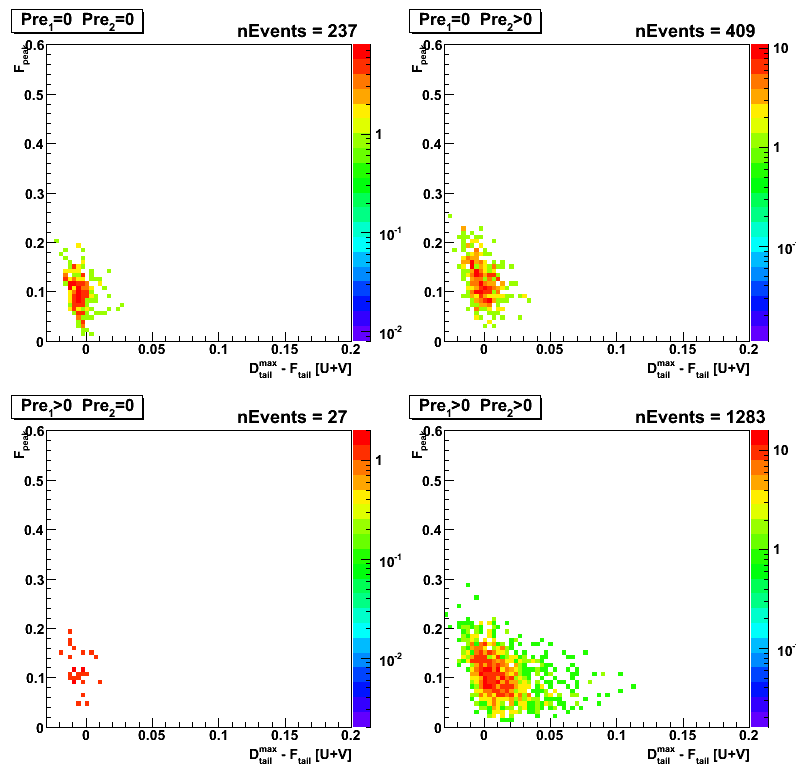
Figure 2: Sided residual for data-driven MC (partonic pt 9-11)
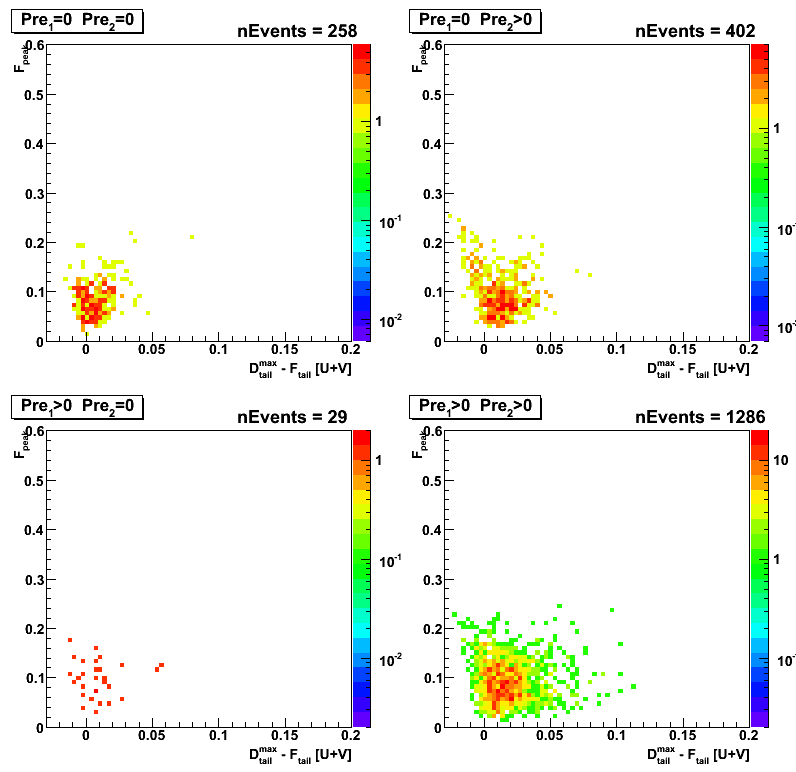
Figure 3: Sided residual for data (pp Longitudinal 2006)
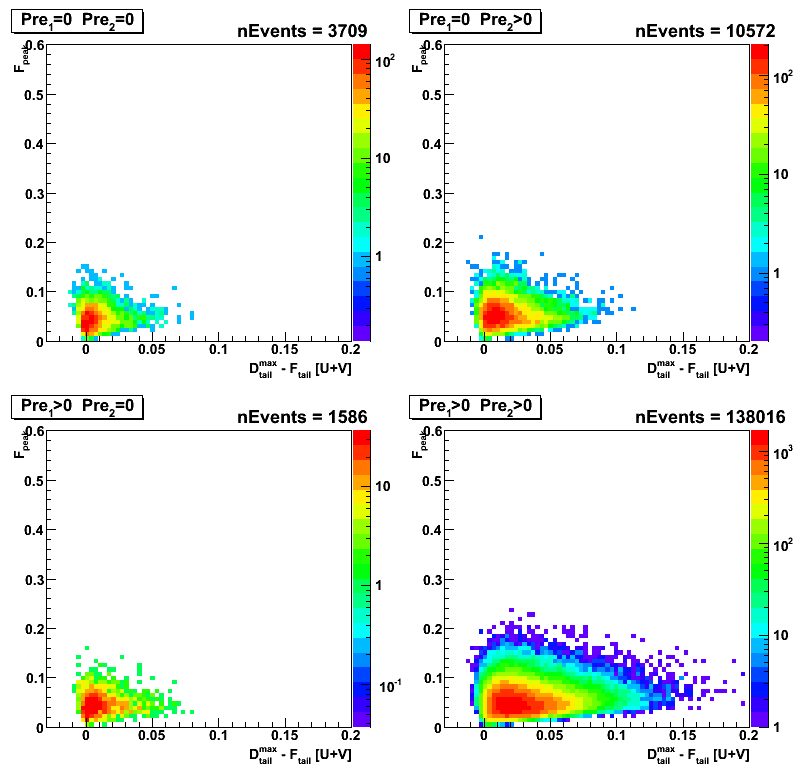
Different analysis cuts vs number of events which passed the cut
- N_events : total number of di-jet events found by the jet-finder for gamma in eta region [1,2]
(Geant record is used to get this number) - cos(phi_gamma - phi_jet) < -0.8 : gamma-jet opposite in phi
- R_{3x3cluster} > 0.9 : Energy in 3x3 cluster of EEMC tower to the total jet energy.
- R_EM^jet < 0.9 : neutral energy fraction cut for on away side jet
- N_ch=0 : no charge tracks associated with a gamma candidate
- N_bTow = 0 : no barrel towers associated with a gamma candidate (gamma in the endcap)
- N_(5-strip clusler)^u > 3 : minimum number of strips in EEMC SMD u-plane cluster around peak
- N_(5-strip cluster)^v > 3 : minimum number of strips in EEMC SMD v-plane cluster around peak
- gamma-algo fail : my algorithm failed to match tower with SMD uv-intersection, etc...
- Tow:SMD match : SMD uv-intersection has a tower which is not in a 3x3 cluser
Figure 4: Number of events which passed various cuts (MC data, partonic pt 9-11)
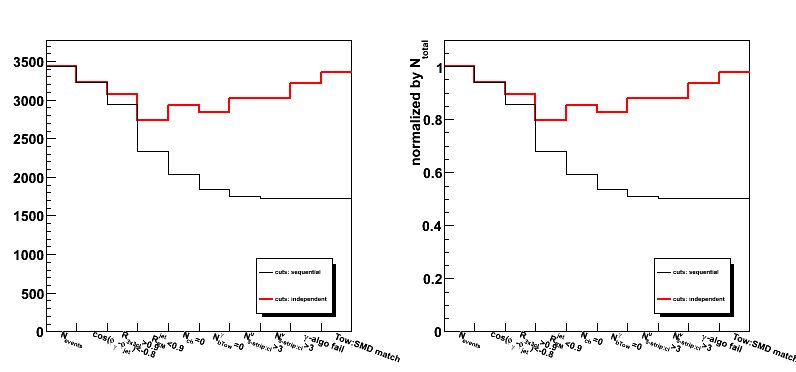
2008.04.17 Sided residual: Data Driven MC vs raw MC (partonic pt=5-35) vs 2006 data
Ilya Selyuzhenkov April 17, 2008
MC data for different pt weigted according to Michael Betancourt web page:
weight = xSection[ptBin] / xSection[max] / nFiles
Figure 1: Sided residual for raw MC (partonic pt 5-35)
(same plot for partonic pt 9-11)
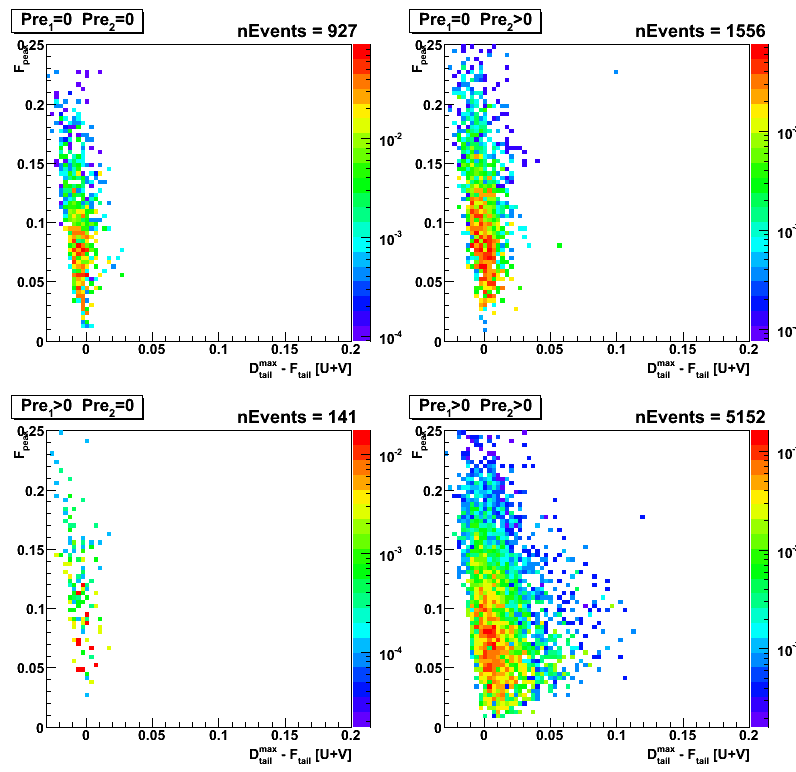
Figure 2: Sided residual for data-driven MC (partonic pt 5-35)
(same plot for partonic pt 9-11)
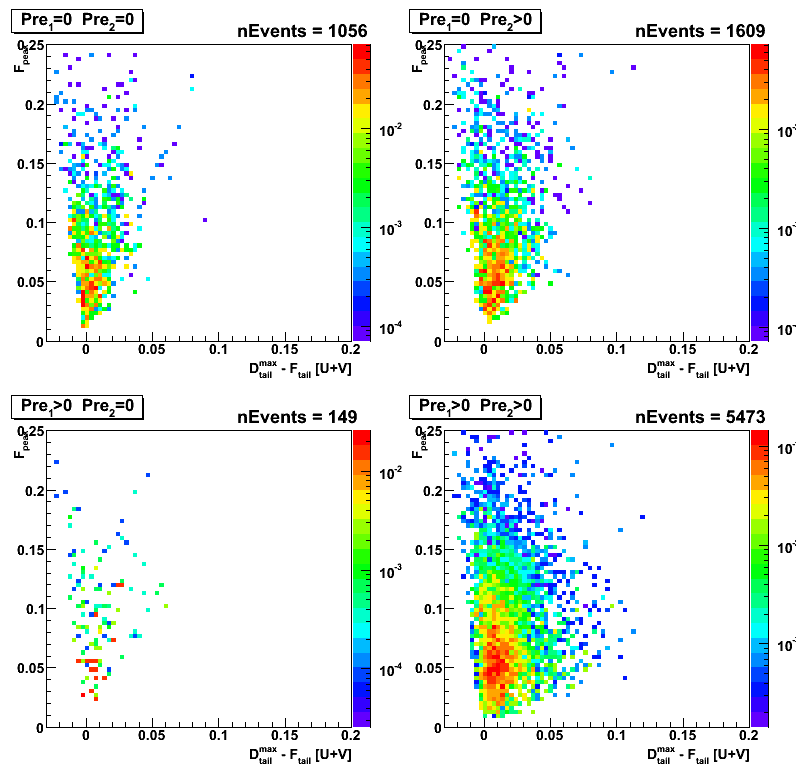
Figure 3: Sided residual for data (pp Longitudinal 2006)

Figure 4: Sided residual for data (pp Longitudinal 2006)
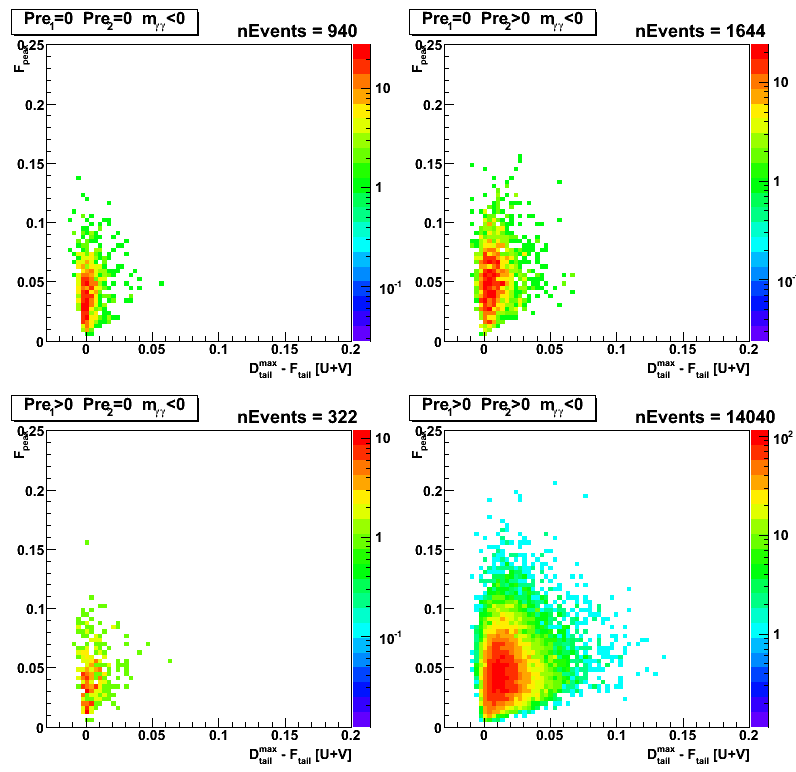
Figure 5: Sided residual for data (pp Longitudinal 2006)
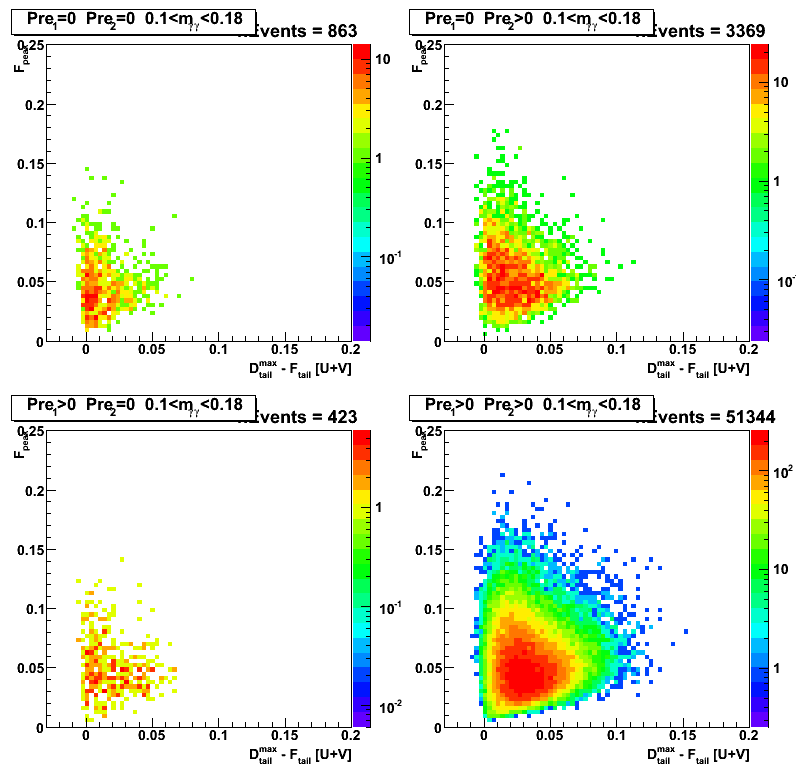
Figure 6: pt(gamma) from geant record vs
pt(gamma) from energy in 3x3 tower cluster and position for uv-intersection wrt vertex
(same on a linear scale)
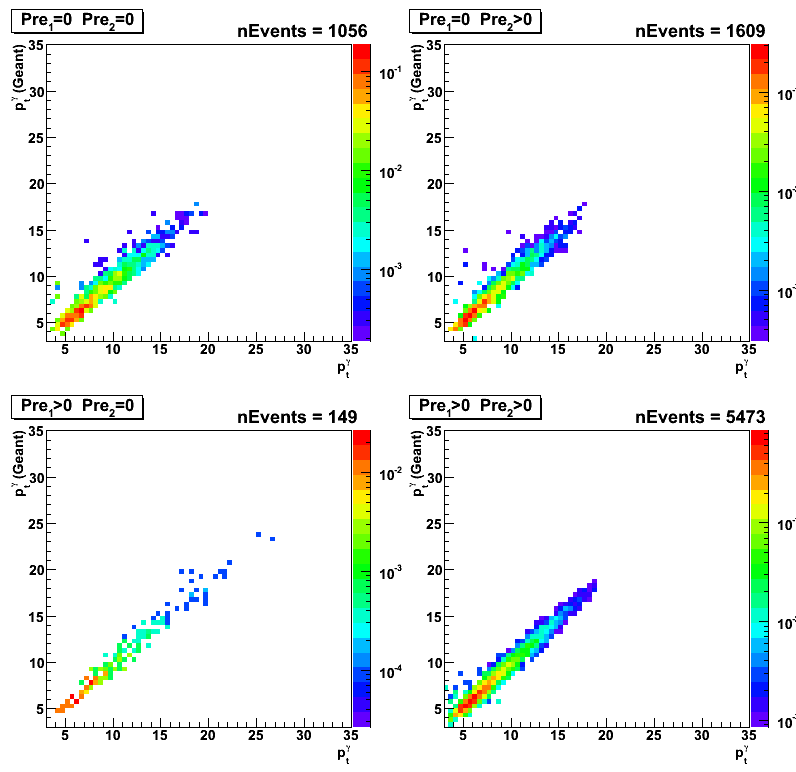
Figure 7: pt(gamma) from geant record vs
pt(jet) as found by the jet-finder
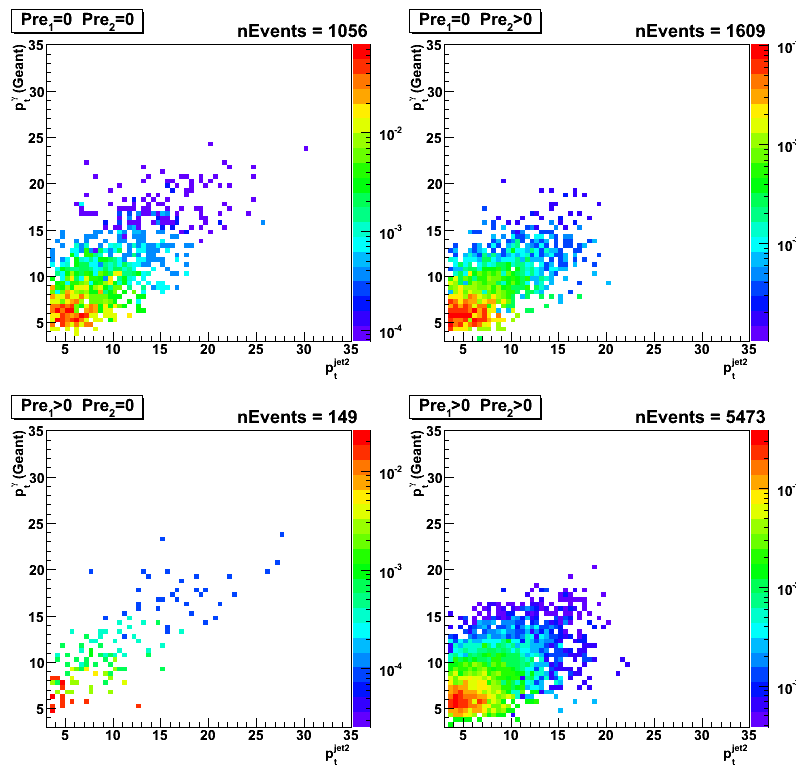
Figure 8: gamma pt distribution:
data-driven MC (red) vs gamma-jet candidates from pp2006 longitudinal run (black).
MC distribution normalized to data at maximum for each preshower condition
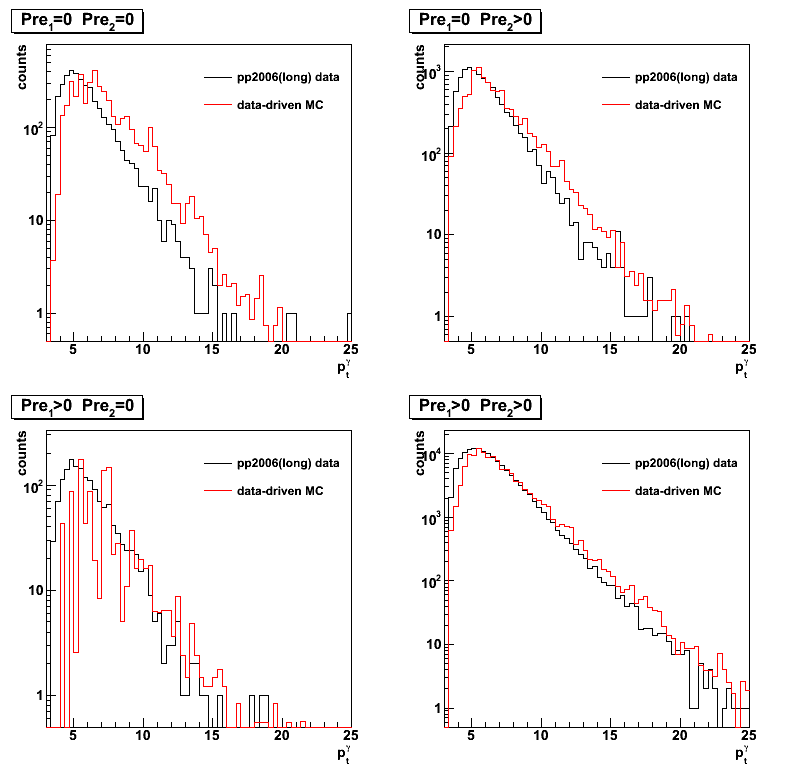
Different analysis cuts vs number of events which passed the cut
- N_events : total number of di-jet events found by the jet-finder for gamma in eta region [1,2]
(Geant record is used to get this number) - cos(phi_gamma - phi_jet) < -0.8 : gamma-jet opposite in phi
- R_{3x3cluster} > 0.9 : Energy in 3x3 cluster of EEMC tower to the total jet energy.
- R_EM^jet < 0.9 : neutral energy fraction cut for on away side jet
- N_ch=0 : no charge tracks associated with a gamma candidate
- N_bTow = 0 : no barrel towers associated with a gamma candidate (gamma in the endcap)
- N_(5-strip clusler)^u > 3 : minimum number of strips in EEMC SMD u-plane cluster around peak
- N_(5-strip cluster)^v > 3 : minimum number of strips in EEMC SMD v-plane cluster around peak
- gamma-algo fail : my algorithm failed to match tower with SMD uv-intersection, etc...
- Tow:SMD match : SMD uv-intersection has a tower which is not in a 3x3 cluser
Figure 9: Number of events which passed various cuts (MC data, partonic pt 5-35)
Red: cuts applied independent
Black: cuts applied sequential from left to right

2008.04.23 Gamma-jet candidates: pp2006 data vs data-driven MC (gamma-jet and bg:jet-jet)
Ilya Selyuzhenkov April 23, 2008
Sided residual: pp2006 data vs data-driven MC (gamma-jet and bg:jet-jet)
MC data for different partonic pt are weigted according to Michael Betancourt web page:
weight = xSection[ptBin] / xSection[max] / nFiles
Figure 1:Sided residual for data-driven gamma-jet MC events (partonic pt 5-35)
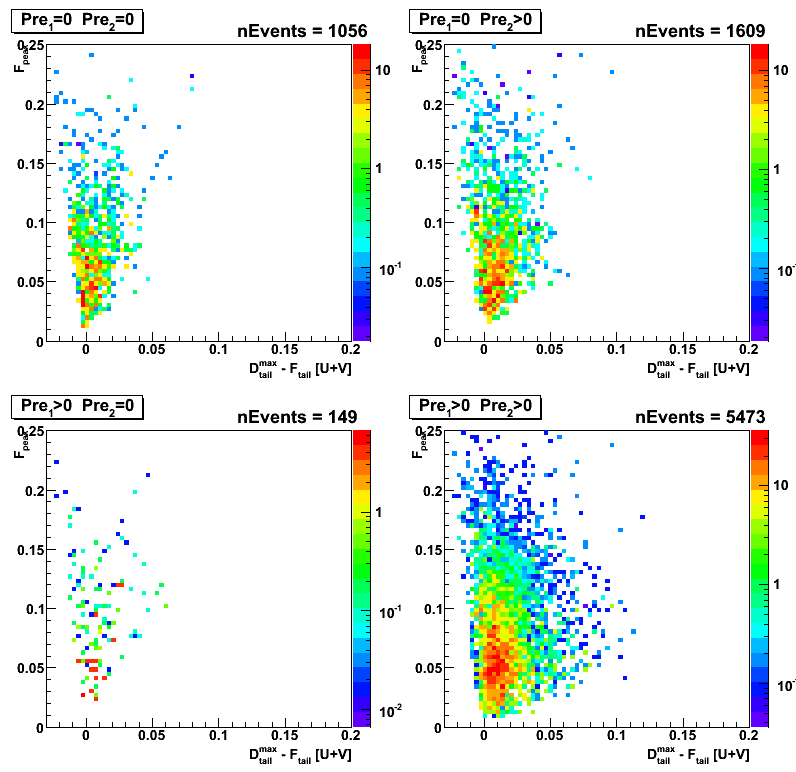
Figure 2:Sided residual for data-driven jet-jet MC events (partonic pt 3-55)
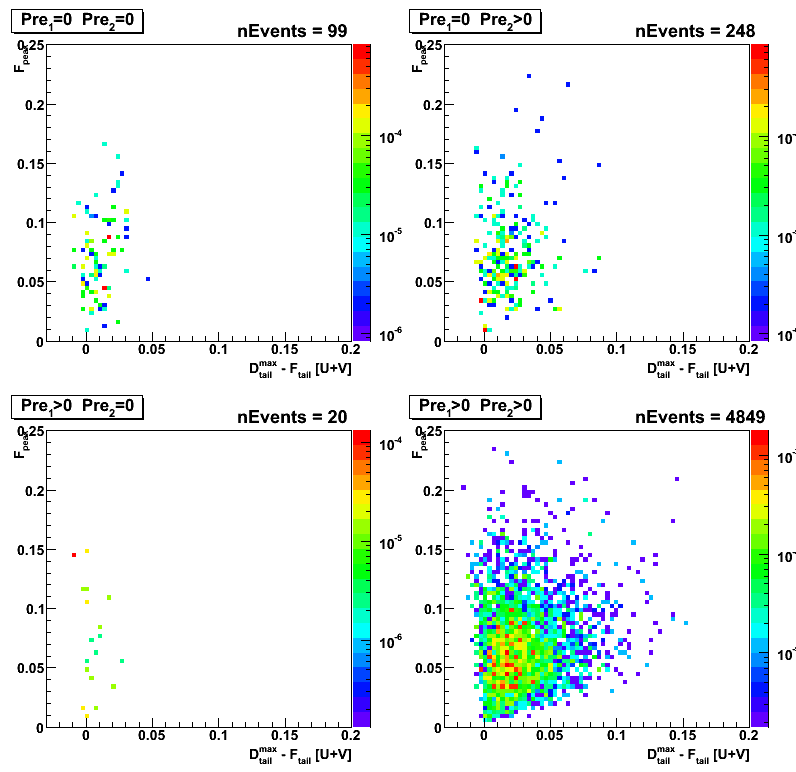
Figure 3:Sided residual for data (pp Longitudinal 2006)
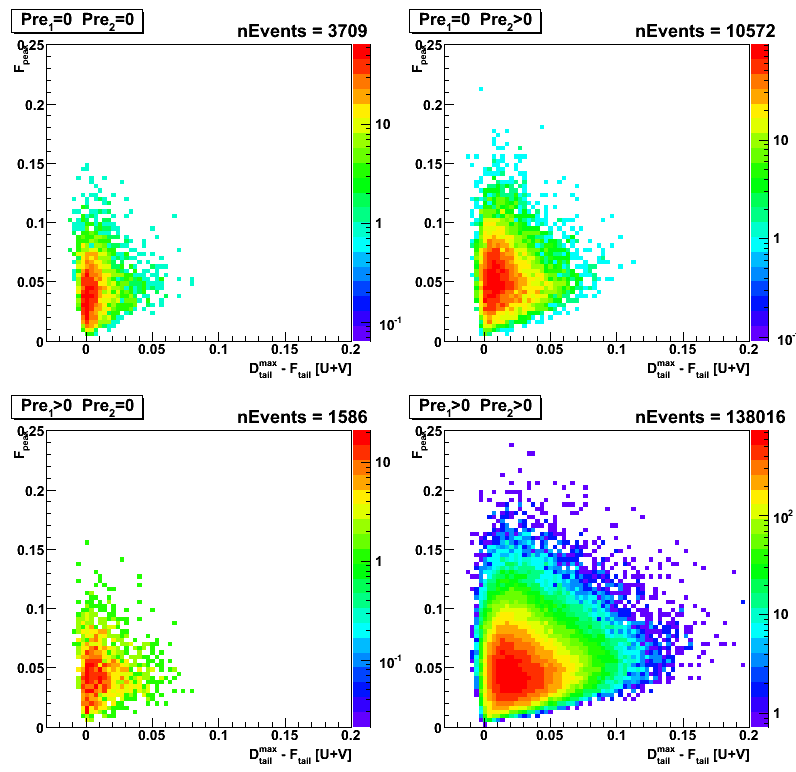
Figure 4:pt(gamma) vs pt(jet) for data-driven gamma-jet MC events (partonic pt 5-35)
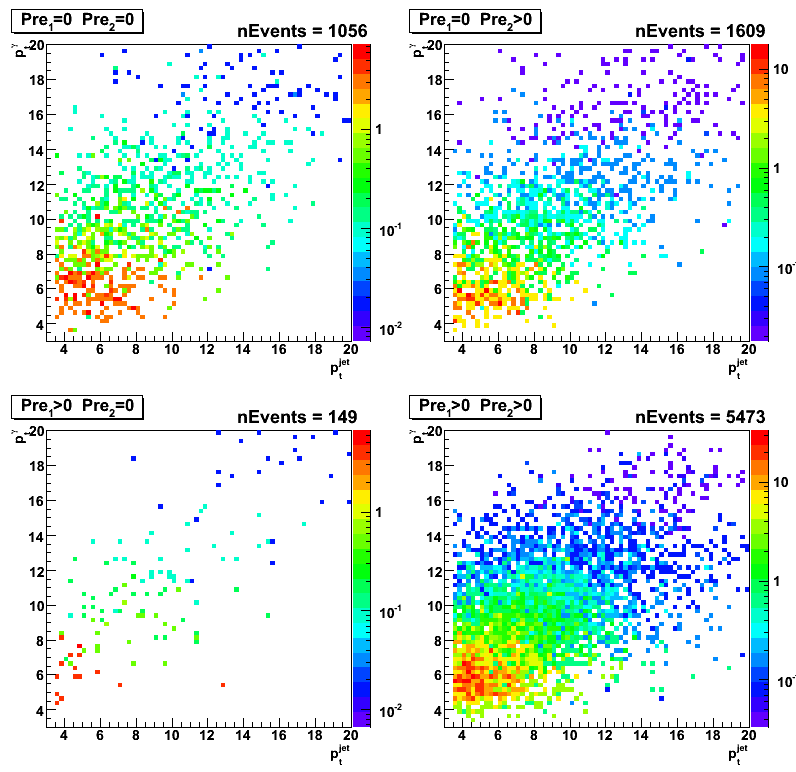
Figure 5:pt(gamma) vs pt(jet) for data-driven jet-jet MC events (partonic pt 3-55)
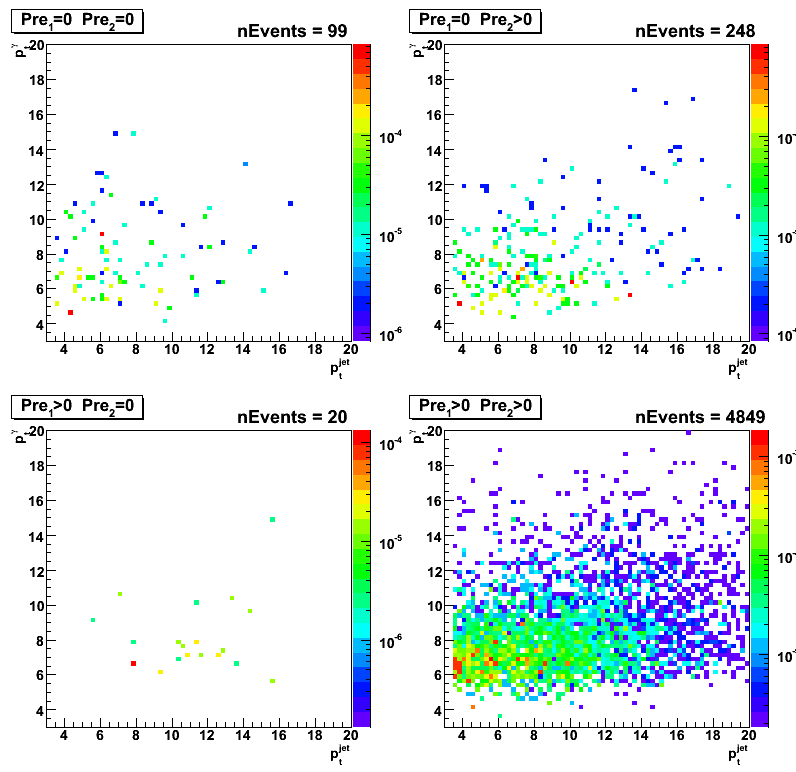
Figure 6:pt(gamma) vs pt(jet) for data (pp Longitudinal 2006)
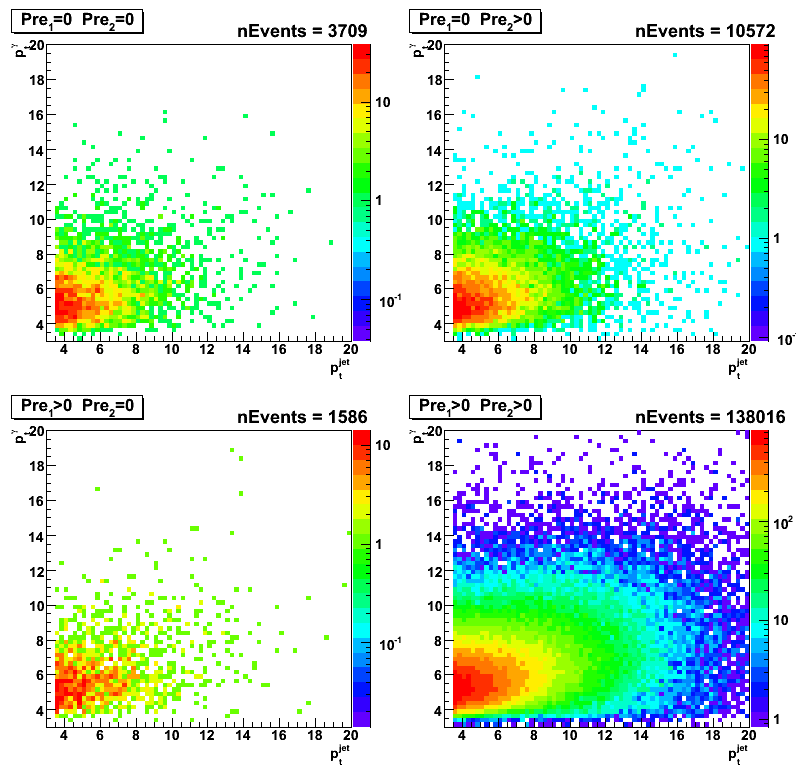
05 May
May 2008 posts
2008.05.05 pt-distributions, sided residual (data vs dd-MC g-jet and bg di-jet)
Ilya Selyuzhenkov May 05, 2008
Data samples:
- pp2006(long) - 2006 pp production longitudinal data after applying gamma-jet aisolation cuts
(jet-tree sample: 4.114pb^-1 from Jamie script, 3.164 pb^1 analyses). - gamma-jet - Pythia gamma-jet sample (~170K events). Partonic pt range 5-35 GeV
- bg jets - Pythia di-jet sample (~4M events). Partonic pt range 3-65 GeV
Figure 1:pt distribution. MC data are scaled to the same luminosity as data
(Normalization factor: Luminosity * sigma / N_events).
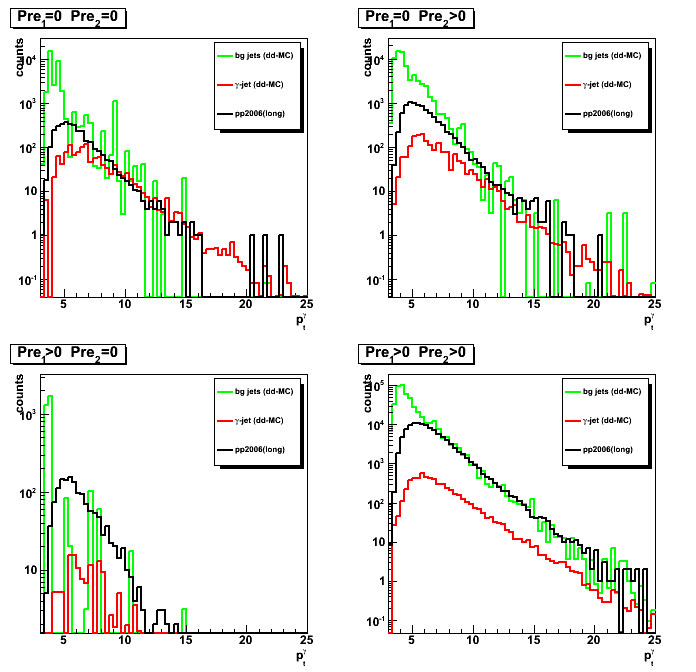
Figure 2:Integrated gamma yield vs pt.
For each pt bin yield is defined as the integral from this pt up to the maximum available pt.
MC data are scaled to the same luminosity as data.
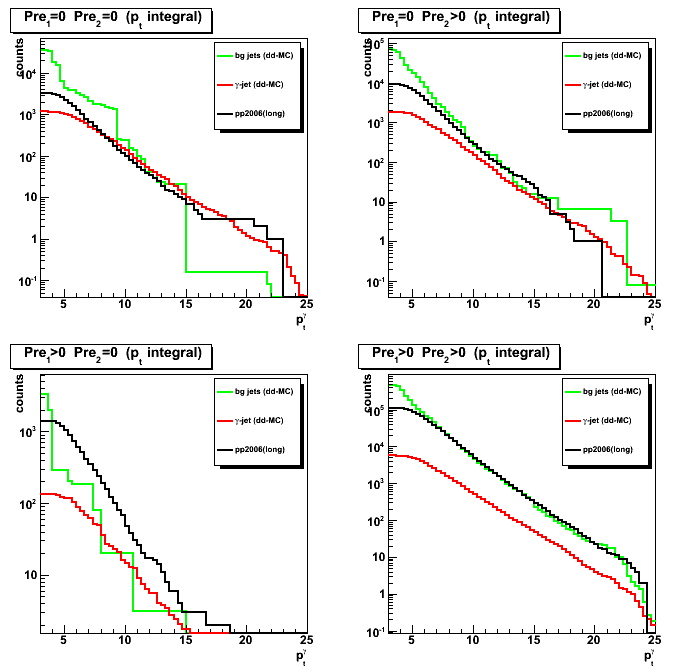
Figure 3:Signal to background ratio (all results divided by the data)
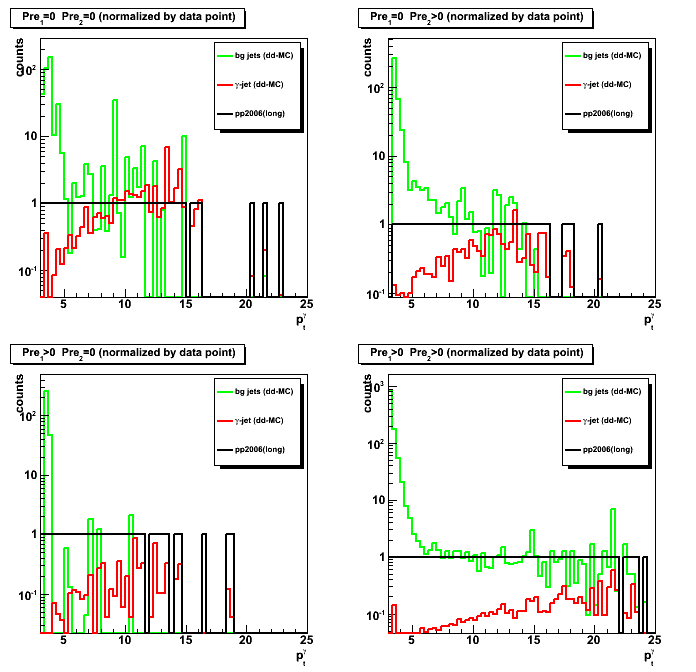
Sided residual: pp2006 data vs data-driven MC (gamma-jet and bg:jet-jet)
You can find sided residual 2-D plots here
Figure 4:Maximum sided residual for pt_gamma>7GeV; pt_jet>7GeV
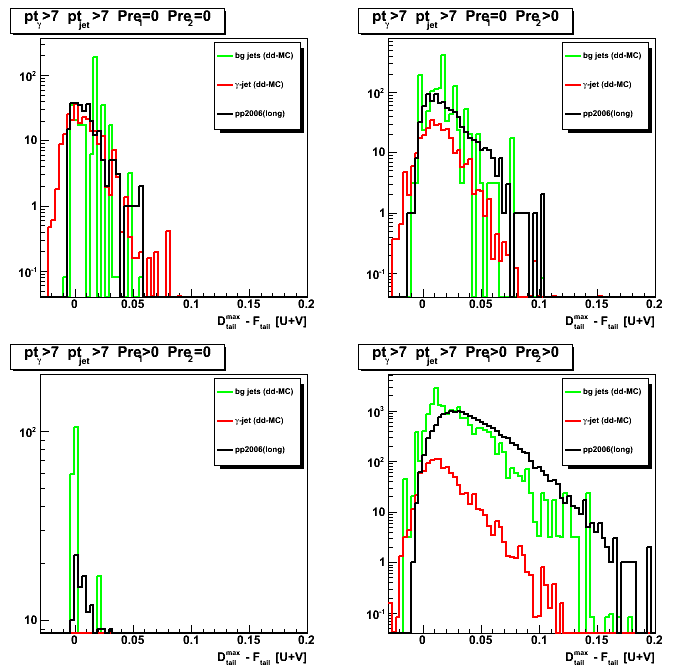
Figure 5:Fitted peak for pt_gamma>7GeV; pt_jet>7GeV

Figure 6:Max data tail for pt_gamma>7GeV; pt_jet>7GeV
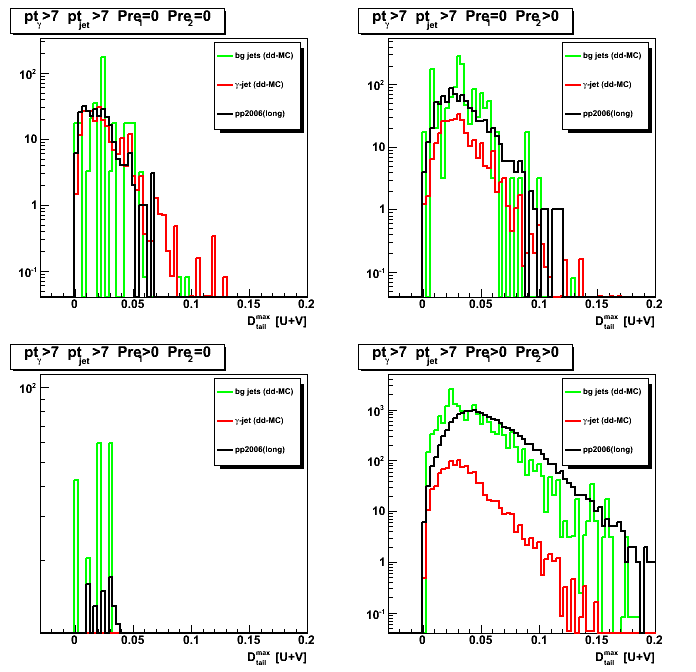
Figure 7:Max minus min data tails for pt_gamma>7GeV; pt_jet>7GeV
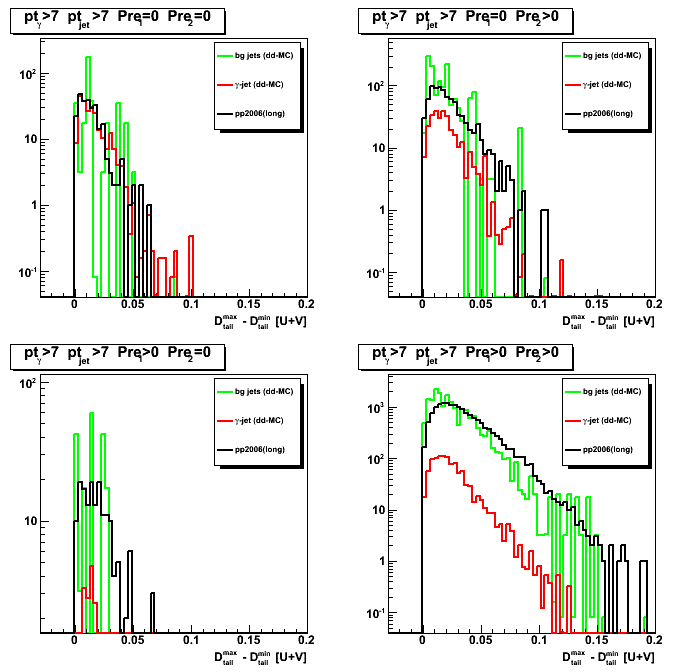
2008.05.08 y:x EEMC position for gamma-jet candidates
Ilya Selyuzhenkov May 08, 2008
y:x EEMC position for gamma-jet candidates
Figure 1:y:x EEMC position for gamma-jet candidates:
Pythia gamma-jet sample (~170K events). Partonic pt range 5-35 GeV.
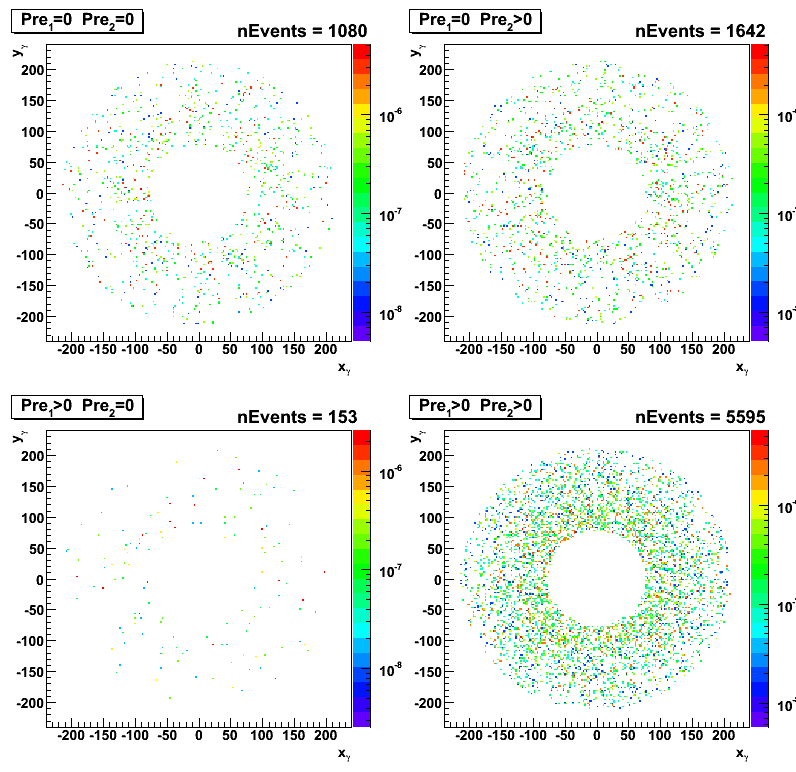
Figure 2:y:x EEMC position for gamma-jet candidates:
Pythia QCD bg sample (~4M events). Partonic pt range 3-65 GeV.
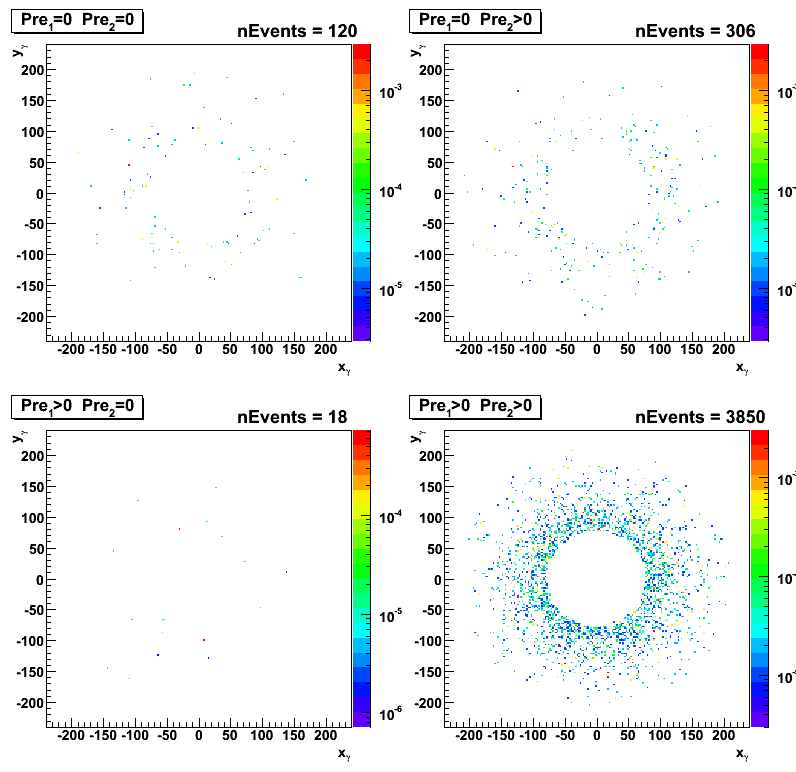
Figure 3:y:x EEMC position for gamma-jet candidates:
pp2006 (long) data [eemc-http-mb-l2gamma:137641 trigger]
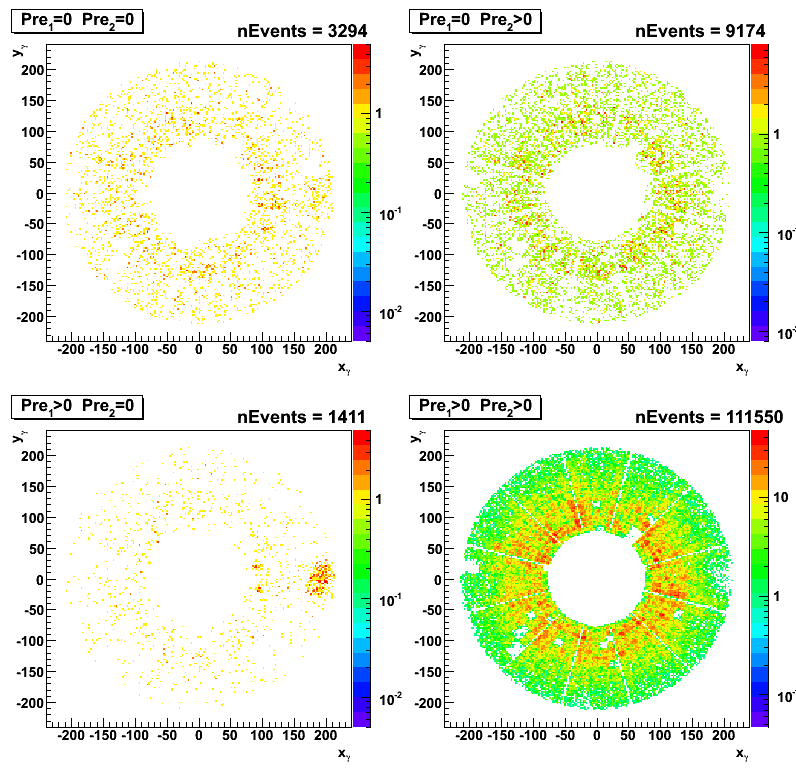
Figure 3b:y:x EEMC position for gamma-jet candidates:
pp2006 (long) data [eemc-http-mb-l2gamma:137641 trigger]
pt cut of 7 GeV for gamma and 5GeV for the away side jet has been applied.
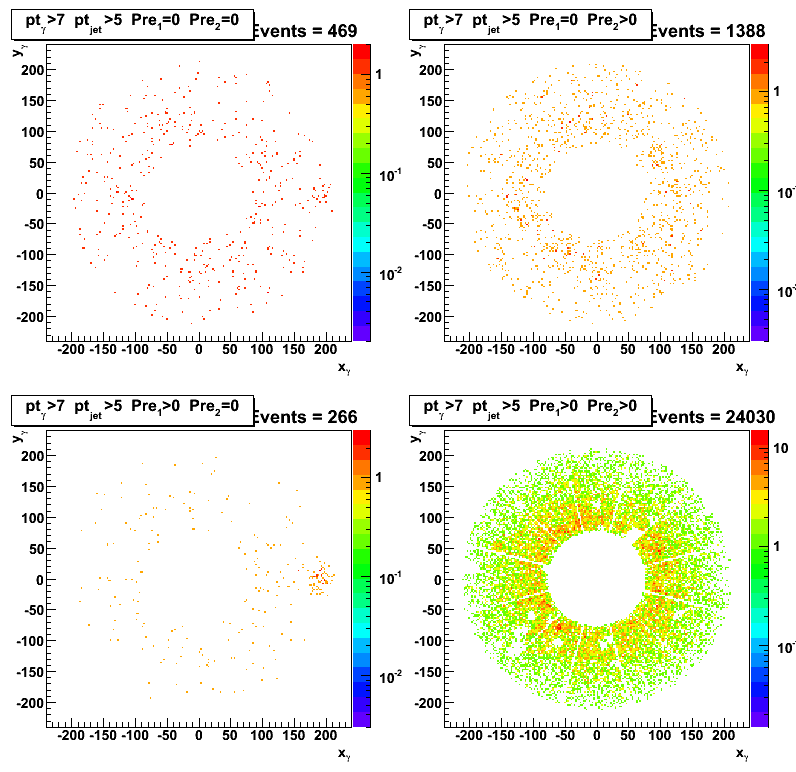
high u vs. v strip for gamma-jet candidates
Figure 4:High v-strip vs high u-strip.
Pythia gamma-jet sample (~170K events). Partonic pt range 5-35 GeV.
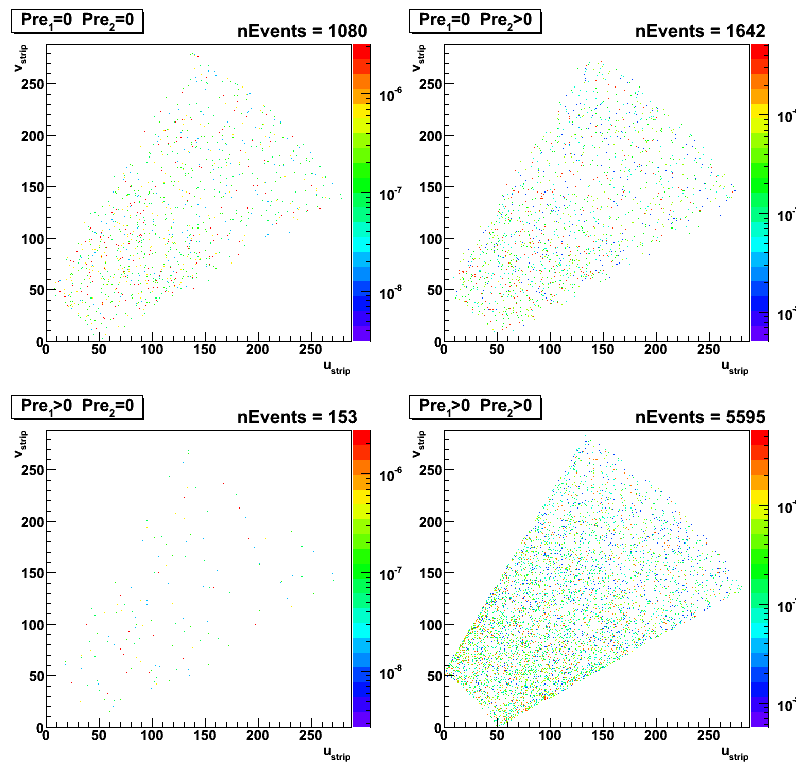
Figure 5:High v-strip vs high u-strip:
Pythia QCD bg sample (~4M events). Partonic pt range 3-65 GeV.
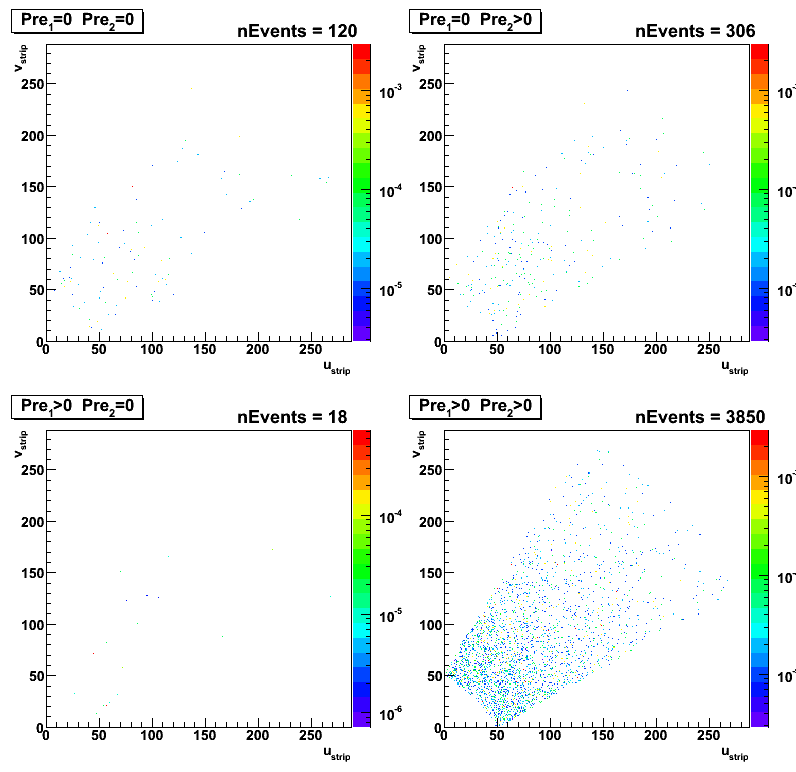
Figure 6:High v-strip vs high u-strip:
pp2006 (long) data [eemc-http-mb-l2gamma:137641 trigger]
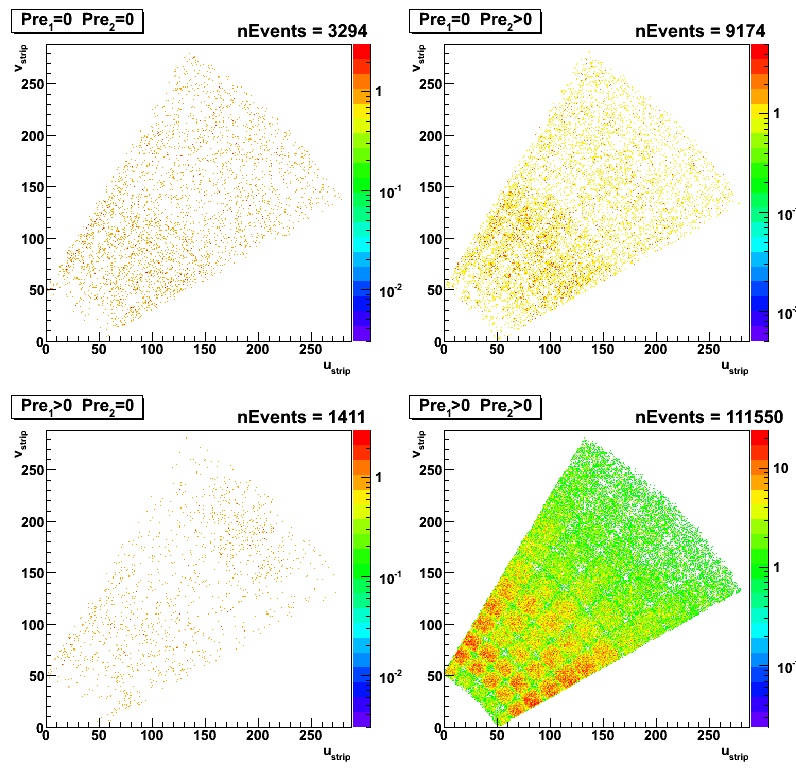
Figure 6b:High v-strip vs high u-strip:
pp2006 (long) data [eemc-http-mb-l2gamma:137641 trigger]
pt cut of 7 GeV for gamma and 5GeV for the away side jet has been applied.
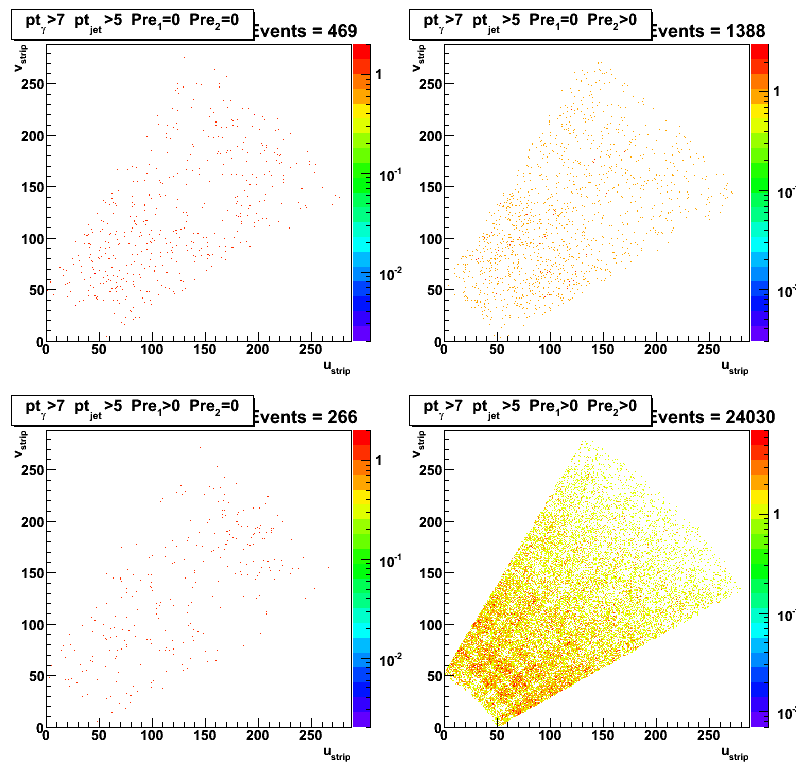
2008.05.09 Gamma-jet candidates pt-distributions and TPC tracking
Ilya Selyuzhenkov May 09, 2008
Detector eta cut study (1< eta < 1.4):
-
For a three data samples (pp2006 [long], MC gamma-jet, and MC QCD background events)
the EEMC detector eta cut of 1< eta < 1.4 has been applied. -
Although a poor statistics available for MC background QCD sample,
the signal to background ratio (red to green line ratio)
getting closer to 1:3 (expected signal to background ratio from Les study).
Figure 1:Gamma pt distribution. MC data are scaled to the same luminosity as data
(Normalization factor: Luminosity * sigma / N_events).
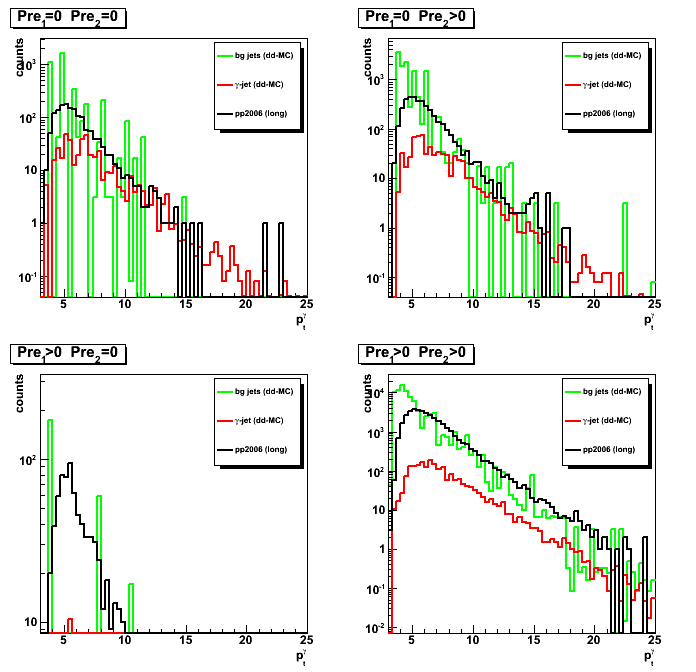
Figure 2:Gamma yield vs pt. MC data are scaled to the same luminosity as data.
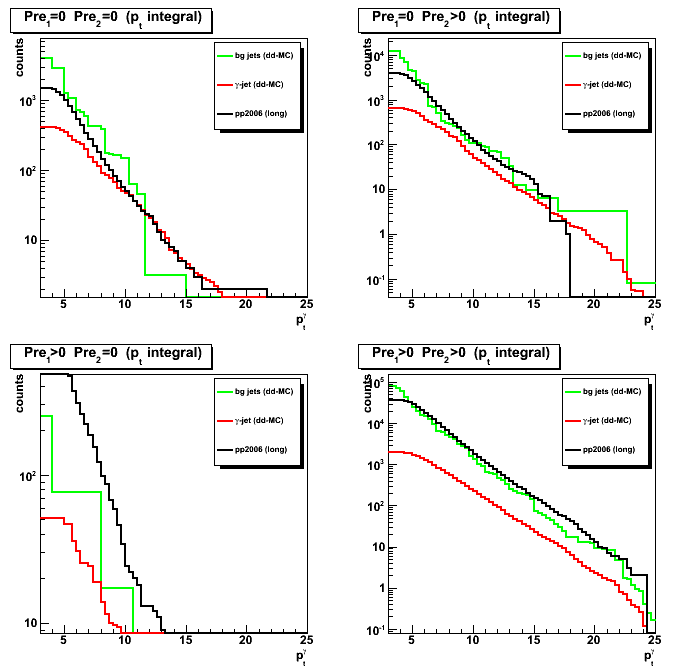
Figure 3:Signal to background ratio (MC results are normalized to the data)
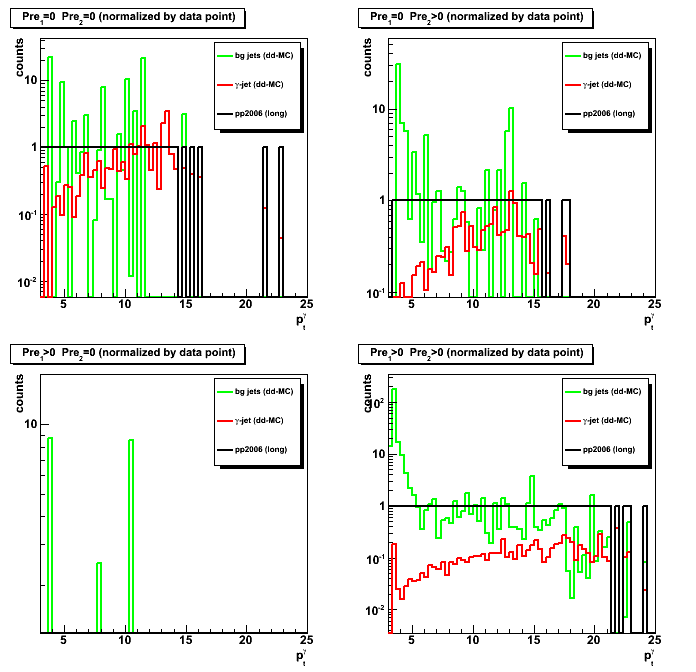
2008.05.14 Gamma-cluster to jet energy ratio and away side jet pt matching
Ilya Selyuzhenkov May 14, 2008
Gamma-cluster to jet1 energy ratio
-
Correlation between gamma-candidate 3x3 cluster energy ratio (R_cluster) and
number of EEMC towers in a jet1 can be found here (Fig. 4). -
Gamma pt distribution, yield and signal to background ratio plots
for a cut of R_cluster >0.9 can be found here (Figs. 1-3). -
Gamma pt distribution, yield and signal to background ratio plots
for a cut of R_cluster >0.99 are shown below in Figs. 1-3.
One can see that by going from R_cluster>0.9 to R_cluster>0.99
improves signal to background ratio from ~ 1:10 to ~ 1:5 for gamma pt>10 GeV
Figure 1:Gamma pt distribution for R_cluster >0.99.
MC results scaled to the same luminosity as data
(Normalization factor: Luminosity * sigma / N_events).
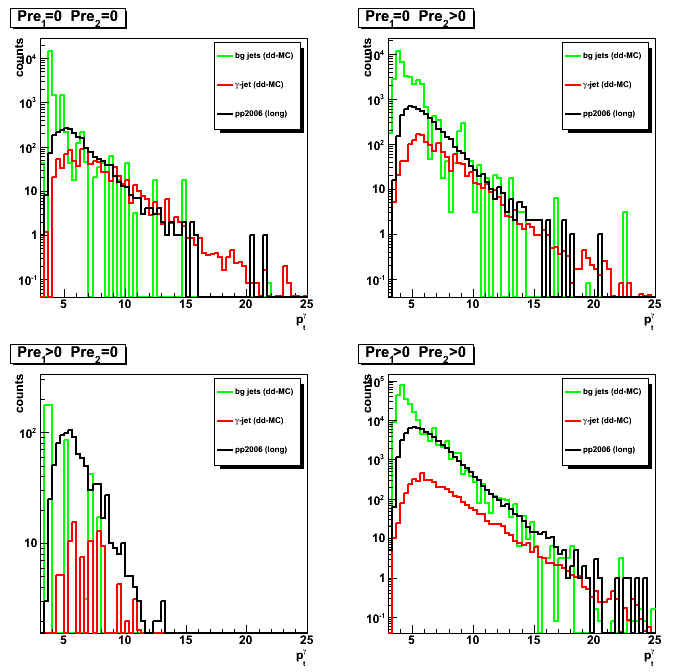
Figure 2:Integrated gamma yield vs pt for R_cluster >0.99
For each pt bin yield is defined as the integral from this pt up to the maximum available pt.
MC results scaled to the same luminosity as data.
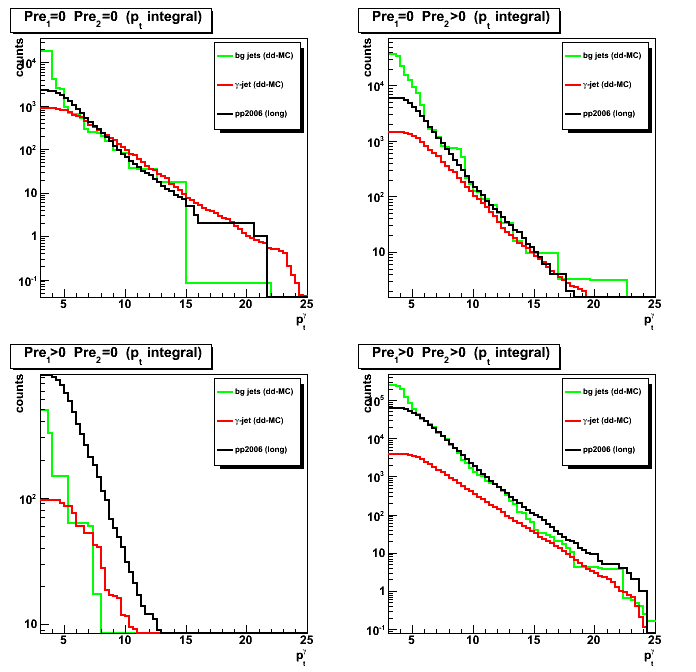
Figure 3:Signal to background ratio for R_cluster >0.99 (all results divided by the data)
Compare this figure with that for R_cluster>0.9 (Fig. 3 at this link)
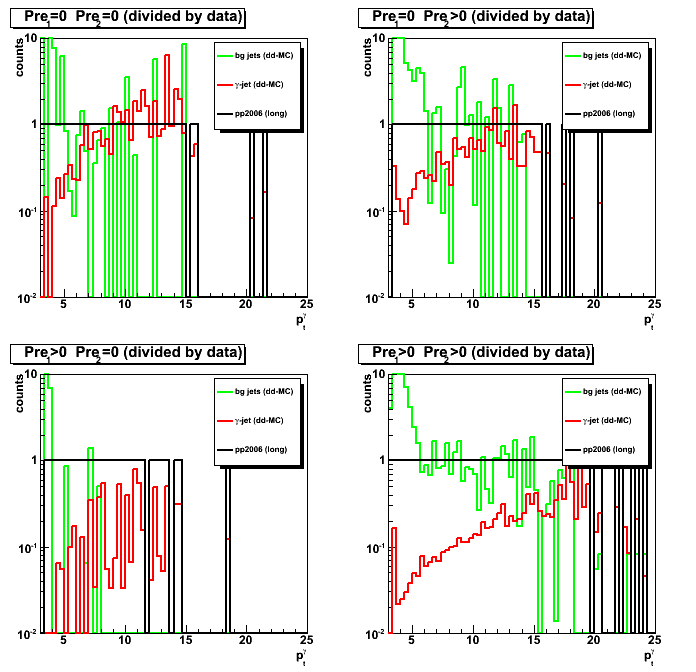
Gamma and the away side jet pt matching
Figure 4: pt asymmetry between gamma and the away side jet (R_cluster >0.9)
for a three data samples (pp2006[long] data, gamma-jet MC, QCD jets background).
pt cut of 7 GeV for both gamma and jet has been applied.
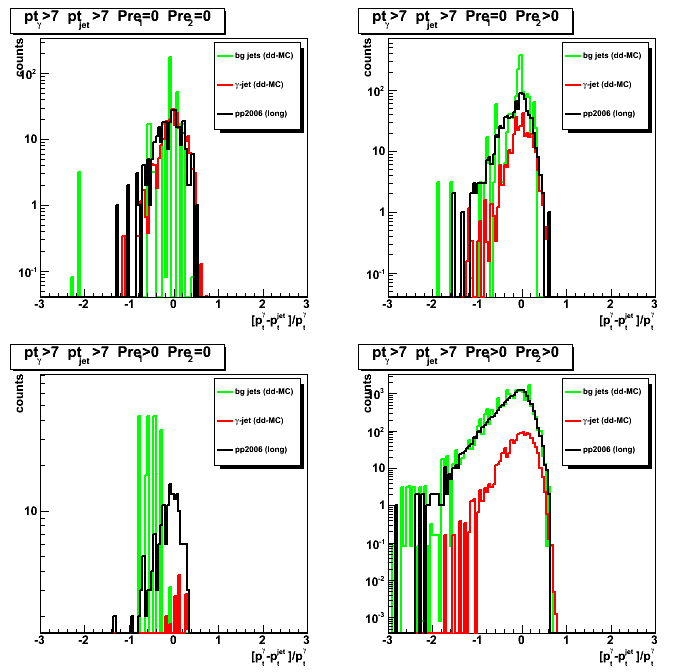
Figure 5: signal to background ratio (R_cluster >0.9)
as a function of pt asymmetry between gamma and the away side jet
pt cut of 7 GeV for both gamma and jet has been applied.
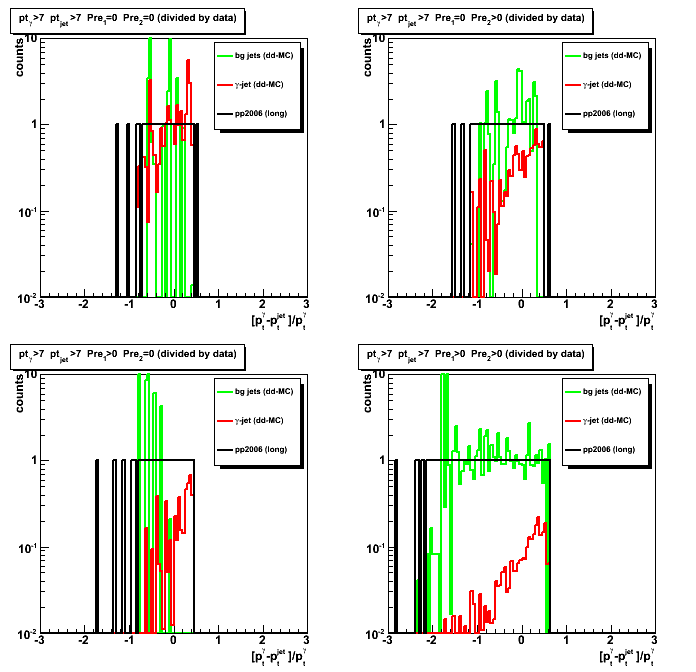
Figure 6: pt asymmetry between gamma and the away side jet (R_cluster >0.99)
for a three data samples (pp2006[long] data, gamma-jet MC, QCD jets background).
pt cut of 7 GeV for both gamma and jet has been applied.
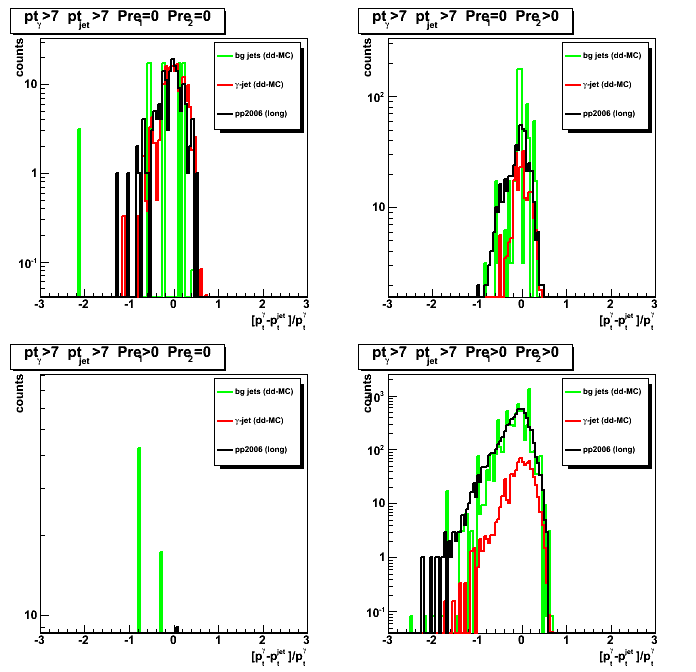
Figure 7: signal to background ratio
as a functio of pt asymmetry between gamma and the away side jet (R_cluster >0.99)
pt cut of 7 GeV for both gamma and jet has been applied.
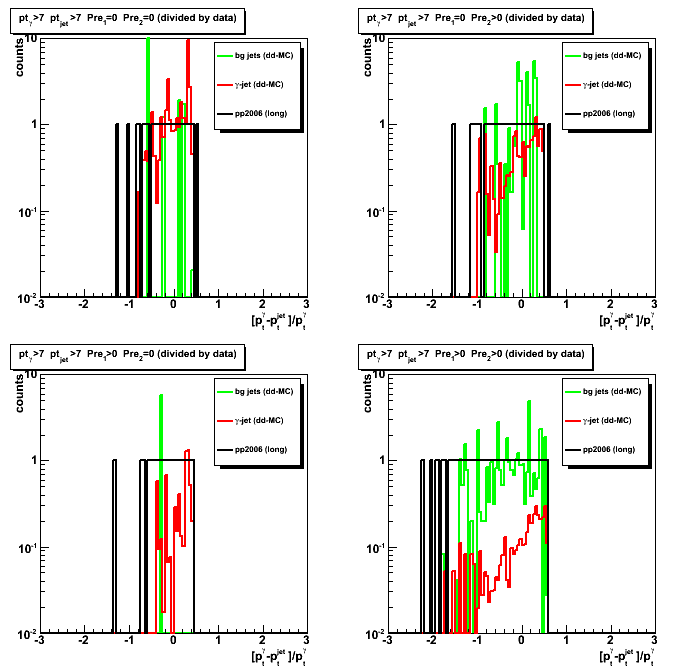
Figure 8: pt asymmetry between gamma and the away side jet (R_cluster >0.99)
for a three data samples (pp2006[long] data, gamma-jet MC, QCD jets background).
pt cut of 7 GeV for gamma and 5GeV for the away side jet has been applied.
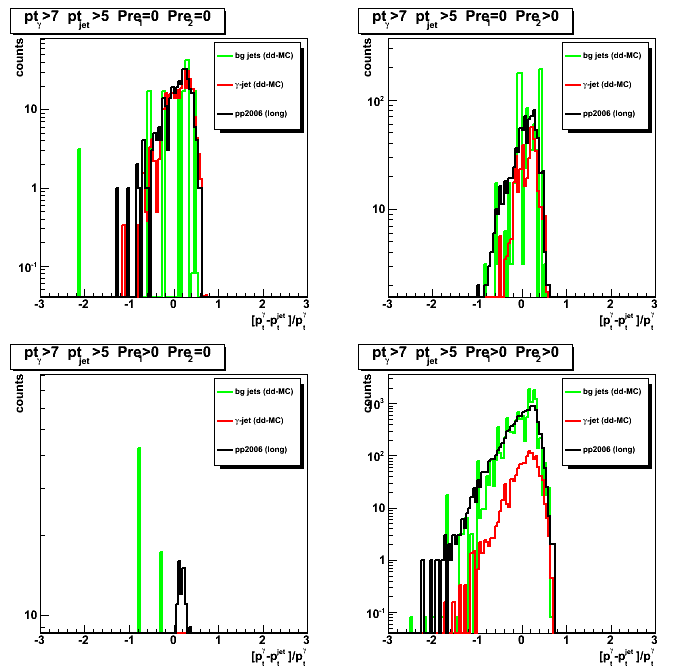
Figure 9: signal to background ratio
as a function of pt asymmetry between gamma and the away side jet (R_cluster >0.99)
pt cut of 7 GeV for gamma and 5GeV for the away side jet has been applied.
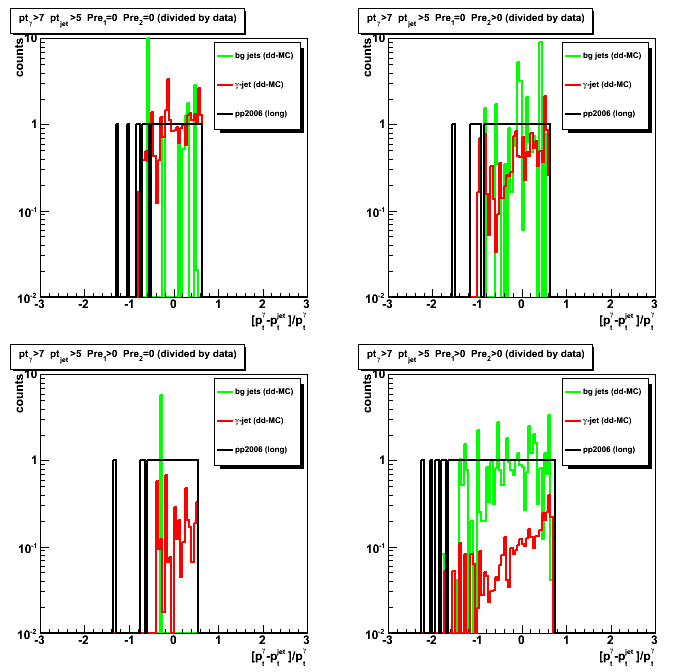
2008.05.15 Vertex z distribution for pp2006 data, MC gamma-jet and QCD jets events
Ilya Selyuzhenkov May 15, 2008
Figure 1:Vertex z distribution for pp2006 (long) data [eemc-http-mb-l2gamma:137641 trigger]
Note: In the upper right plot (pre1=0, pre2>0) one can see
a hole in the acceptance in the range bweeeen z_vertex -10 to 30 cm (probably due to SVT construction)
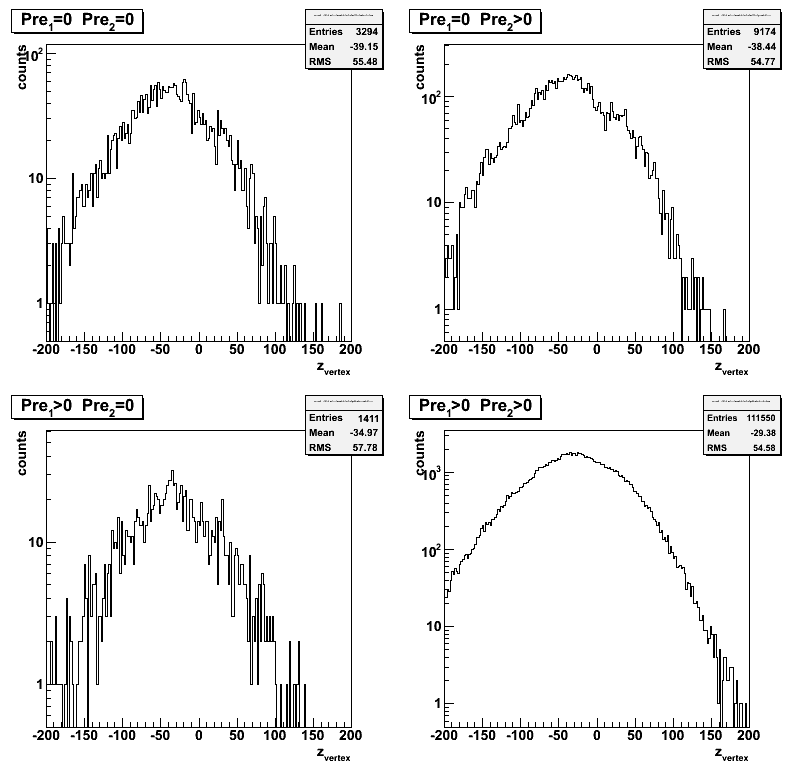
Figure 1b:Vertex z distribution for pp2006 (same as Fig. 1, but on a linear scale)
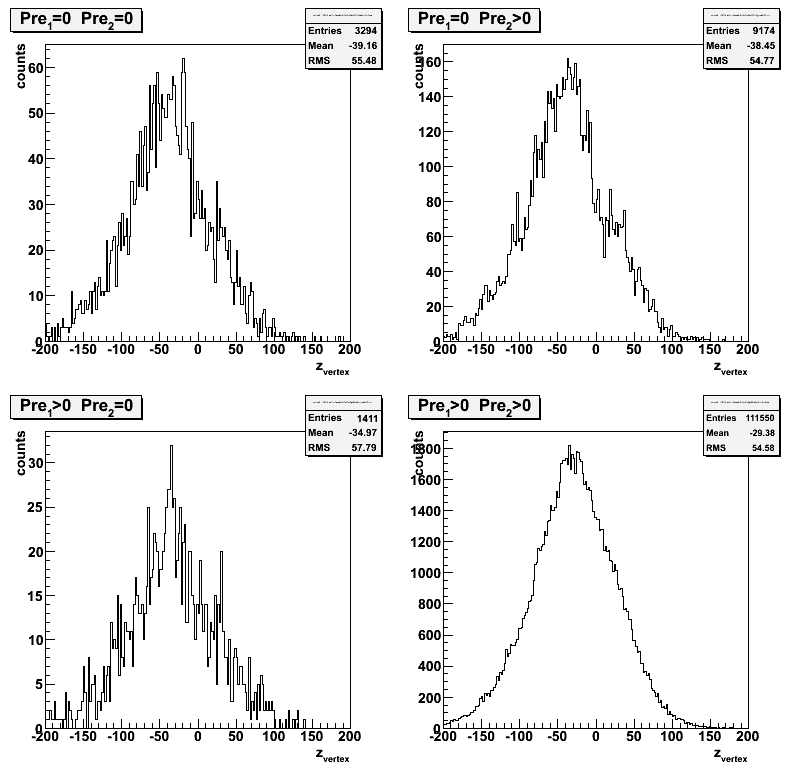
Figure 2:Vertex z distribution for three different data samples
MC results scaled to the same luminosity as data
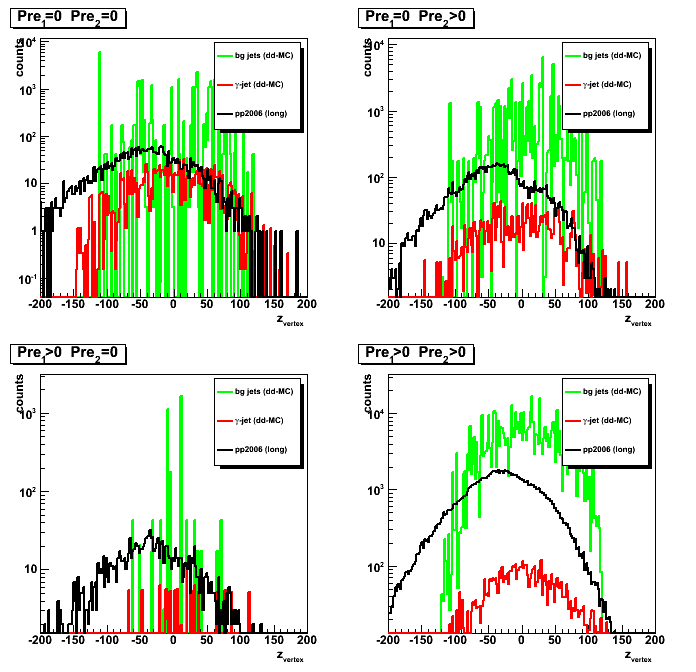
Figure 3:Vertex z distribution for three different data samples
pt cut of 7 GeV for gamma and 5GeV for the away side jet has been applied.

2008.05.20 Shower shapes sorted by pre-shower, z-vertex and gamma's eta, phi, pt
Ilya Selyuzhenkov May 20, 2008
Gamma-jet algorithm and isolation cuts:
-
Selecting only di-jet events identified by the STAR jet finder algorithm,
with jets pointing opposite in azimuth:
cos(phi_jet1 - phi_jet2) < -0.8 - Select jet1 with a maximum neutral energy fraction (R_EM1).
This is our gamma candidate, for which we further require:- No charge tracks associated with jet1 (default jet radius is 0.7):
nChargeTracks_jet1 = 0
Note, that this charge track veto only works
in the EEMC region where we do have TPC tracking - No barrel towers associated with jet1 (pure EEMC jet):
nBarrelTowers_jet1 = 0 - Ratio of the energy in the 3x3 EEMC high tower cluster
to the total jet energy to be:
R_cluster>0.99 (previous, softer, cut was 0.9)
- No charge tracks associated with jet1 (default jet radius is 0.7):
- For the second jet2 (away side jet) we require:
- That jet2 has at least ~10% of hadronic energy:
R_EM2<0.9
- That jet2 has at least ~10% of hadronic energy:
- Additional gamma candidate QA requirements:
- Matching between EEMC SMD uv-strip cluster with a 3x3 cluster of EEMC towers.
(in addition reject events for which we can not idetify uv-strip intersection) - Minimum number of strips in 5-strip EEMC SMD uv-plane clusters to be greater that 3.
- Matching between EEMC SMD uv-strip cluster with a 3x3 cluster of EEMC towers.
Data sample:
- pp2006(long) - 2006 pp production longitudinal data after applying gamma-jet isolation cuts
(note the new R_cluster>0.99 cut)
Shower shapes sorted by pre-shower, z-vertex and gamma's eta, phi, pt
Note, that all shapes are normalized at peak to unity
Figure 1:Shower shapes for different detector eta bins

Figure 2:Shower shapes for different detector phi bins
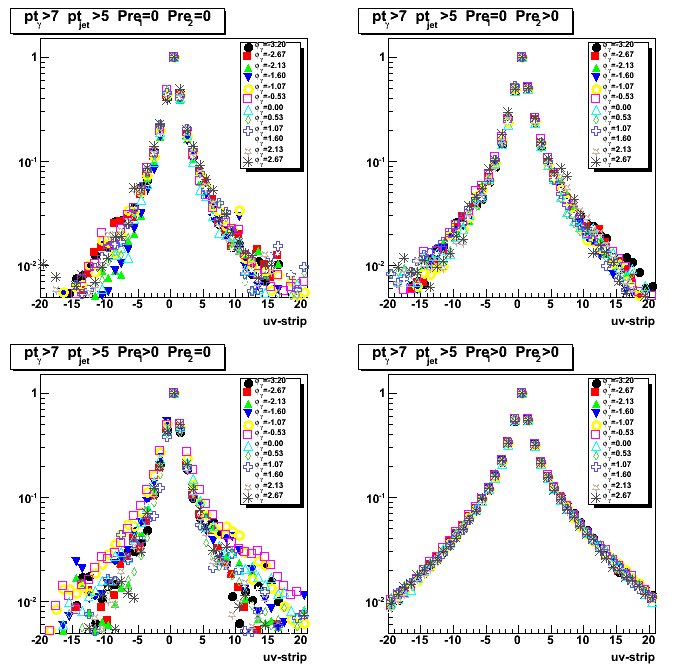
Figure 3:Shower shapes for different gamma pt bins
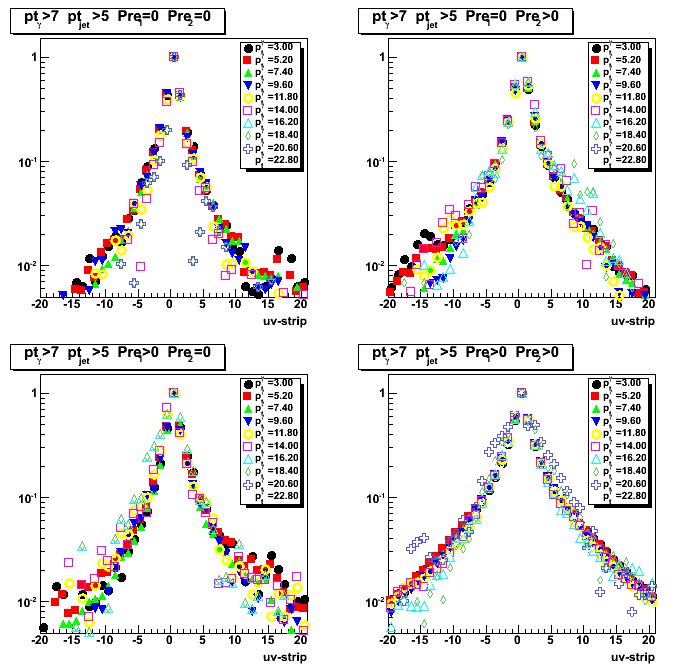
Figure 4:Shower shapes for different z-vertex bins
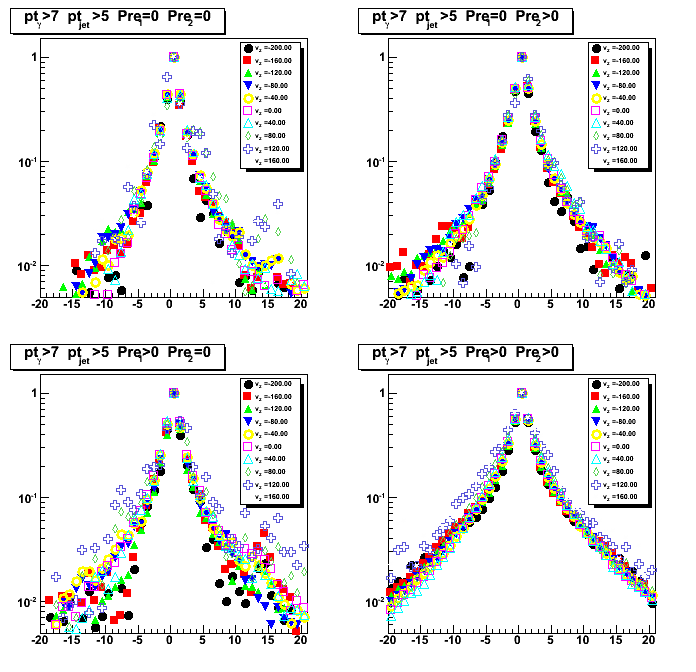
2008.05.21 EEMC SMD data-driven library: some eta-meson QA plots
Ilya Selyuzhenkov May 21, 2008
EEMC SMD data-driven library: some eta-meson QA plots
Data sample:
-
Subset of 441 eta-meson candidates from Will's analysis.
-
additional QA info (detector eta, pre1, pre2, etc)
has been added to pi0-tree reader script:
/star/institutions/iucf/wwjacobs/newEtas_fromPi0finder/ReadEtaTree.C -
pi0 trees from this RCF directory has been used to regenerate etas NTuple:
/star/institutions/iucf/wwjacobs/newEtas_fromPi0finder/out_23/
Some observations:
-
eta-meson purity within the invariant mass region [0.5, 0.65] is about 72%
-
Most of the eta-candidates has detector pseudorapidity less or about 1.4,
what may limits applicability of data-driven shower shapes
derived from these candidates for higher pseudo-rapidity region,
where we have most of the background for the gamma-jet
analysis due to lack of TPC tracking -
z-vertex distribution is very asymmetric, and peaked around -50cm.
Only a few candidates has a positive z-vertex values.
Figure 1: Eta-meson invariant mass with signal and background fits and ratio (upper left).
Pseudorapidity [detector and wrt vertex] distributions (right top and bottom plots),
vertex z distributions (bottom left)
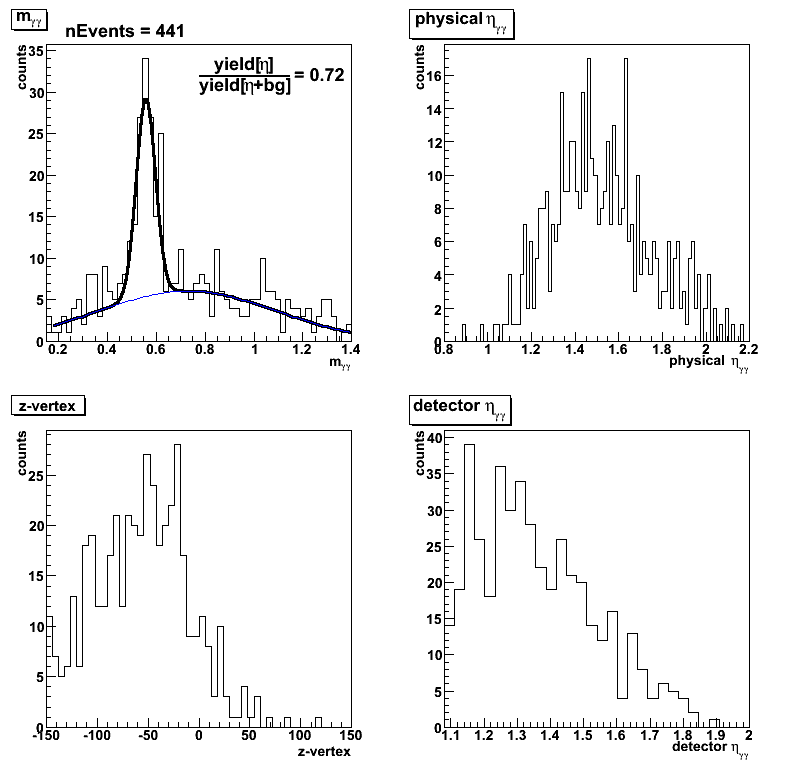
Figure 2:2D plots for the eta-meson invariant mass vs
azimuthal angle (upper left), pseudorapidity (upper right),
z-vertex (bottom right), and detector pseudorapidity (bottom right)
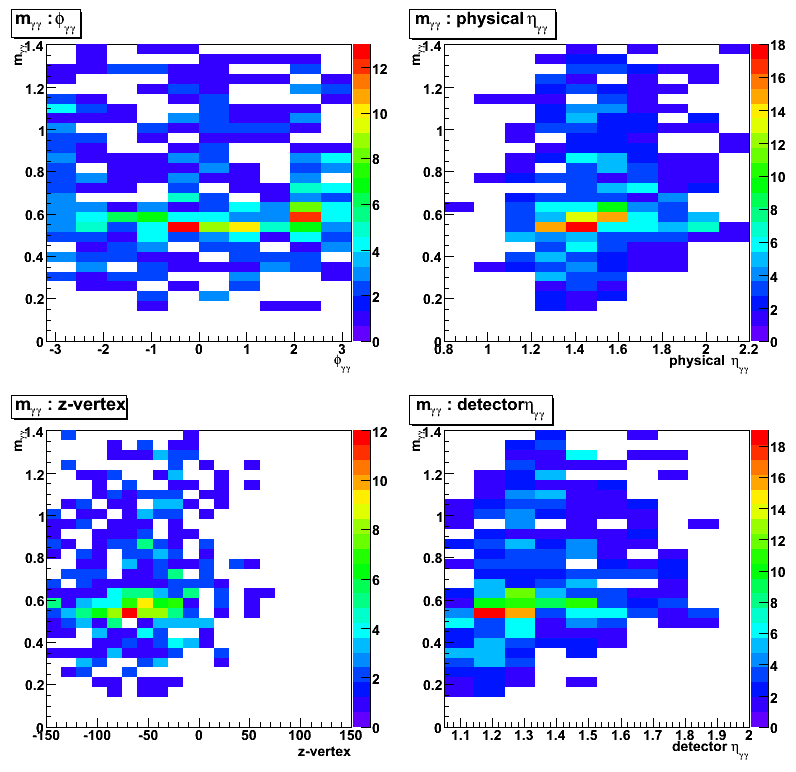
2008.05.27 Shower shapes: pp2006 data, MC gamma-jet and QCD jets, gammas from eta
Ilya Selyuzhenkov May 27, 2008
Shower shapes and triple Gaussian fits for gammas from eta-meson
Figure 1: Shower shapes and triple Gaussian fits for photons from eta-meson
sorted by different conditions of EEMC 1st and 2nd pre-shower layers.
Note: All shapes have been normalized at peak to unity
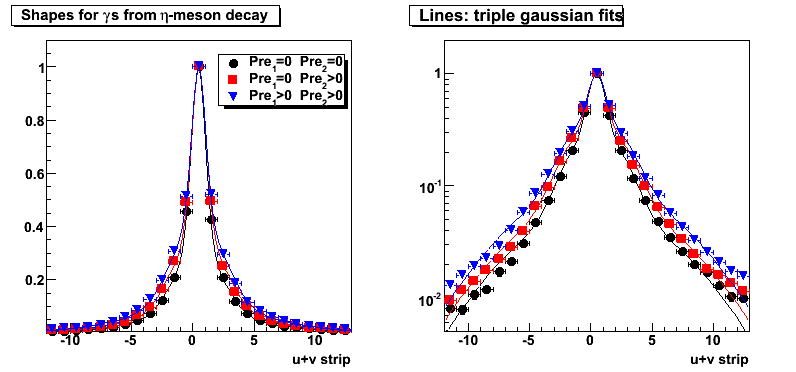
Triple Gaussian fit parameters:
Pre1=0 Pre2=0
0.669864*exp(-0.5*sq((x-0.46016)/0.574864))+0.272997*exp(-0.5*sq((x-0.46016)/-1.84608))+0.0585682*exp(-0.5*sq((x-0.46016)/5.49802))
Pre1=0 Pre2>0
0.0694729*exp(-0.5*sq((x-0.493468)/5.65413))+0.615724*exp(-0.5*sq((x-0.493468)/0.590723))+0.314777*exp(-0.5*sq((x-0.493468)/2.00192))
Pre1>0 Pre2>0
0.0955638*exp(-0.5*sq((x-0.481197)/5.59675))+0.558661*exp(-0.5*sq((x-0.481197)/0.567596))+0.345896*exp(-0.5*sq((x-0.481197)/1.9914))
Shower shapes: pp2006, MC gamma-jet and QCD jets, gammas from eta
Shower shapes comparison between different data sets:
- gammas from eta-meson decay. Obtained from Will's eta-meson analysis
- pp2006 - STAR 2006 pp longitudinal data (~ 3.164 pb^1) after applying gamma-jet isolation cuts.
- gamma-jet - data-driven Pythia gamma-jet sample (~170K events). Partonic pt range 5-35 GeV.
- QCD jets - data-driven Pythia QCD jets sample (~4M events). Partonic pt range 3-65 GeV.
Some observations:
-
Shapes for gammas from eta-meson decay
are in a good agreement with those from MC gamma-jet sample
(compare red squares with blue triangle in Fig. 2 and 3).MC gamma-jet shapes obtained by running a full gamma-jet reconstruction algorithm,
and this agreement indicates that we are able to reconstruct gamma shapes
which we put in with data-driven shower shape library. -
MC gamma-jet shapes match pp2006 data shapes
for pre1=0 condition, where we expect to be very efficient in background rejection
(compare red squares with black circles in upper plots of Fig. 2 and 3).This indicates that we are able to reproduce EEMC SMD of direct photons with data-driven Monte-Carlo.
-
There is no match between Monte-Carlo QCD background jets and pp2006 data
for the case when both pre-shower layer fired (pre1>0 and pre2>0).
(compare green triangles with black circes in bottom right plots of Fig.2 and 3).
This is the region where we know background dominates our gamma-jet candidates.This shows that we still do not reproduce SMD response for our background events
in our data-driven Monte-Carlo simulations
(note, that in Monte-Carlo we replace SMD response with real shapes for all background photons
the same way we do it for direct gammas).
Figure 2: Shower shapes comparison between different data sets.
Shapes for gamma-jet candidates obtained with the same gamma-jet reconstruction algorithm
for three different data samples (pp2006, gamma-jet and QCD jets MC).
pt cuts of 7GeV for the gamma and of 5 GeV for the away side jet have been applied.
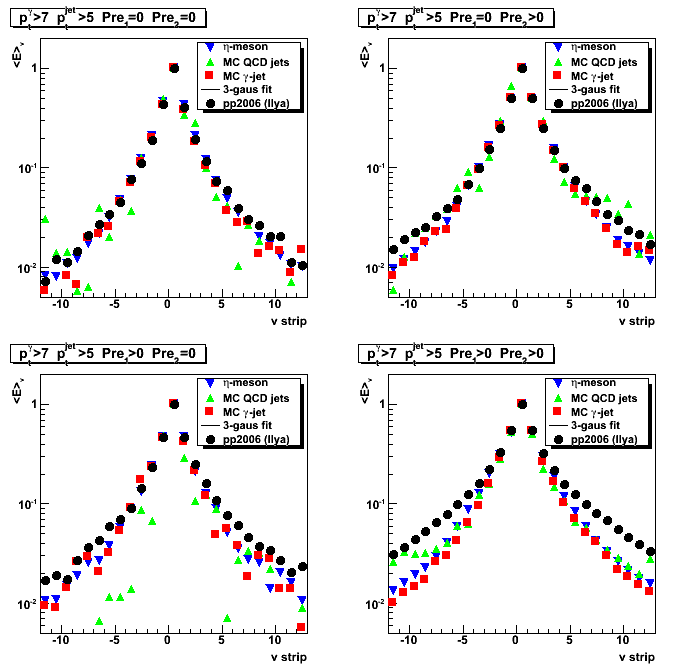
Figure 3:Same as Fig. 2, but with no cuts on gamma and jet pt.
All shapes are similar to those in Fig. 2 with an additional pt cuts.
Note, that blue triangles are the same as in Fig. 2.

2008.05.30 Eta, phi, and pt distributions for gamma and jet from MC and pp2006 data
Ilya Selyuzhenkov May 30, 2008
Three data sets:
- pp2006 - STAR 2006 pp longitudinal data (~ 3.164 pb^1) after applying gamma-jet isolation cuts.
- gamma-jet - data-driven Pythia gamma-jet sample (~170K events). Partonic pt range 5-35 GeV.
- QCD jets - data-driven Pythia QCD jets sample (~4M events). Partonic pt range 3-65 GeV.
Figure 1: Gamma eta distribution.
pt cuts of 7GeV for the gamma and of 5 GeV for the away side jet have been applied.
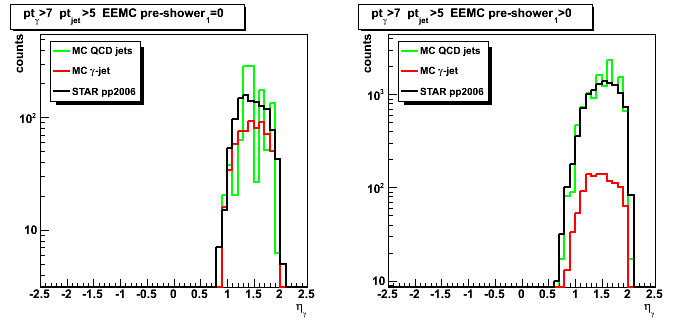
Figure 2: Gamma pt distribution.
pt cuts of 7GeV for the gamma and of 5 GeV for the away side jet have been applied.
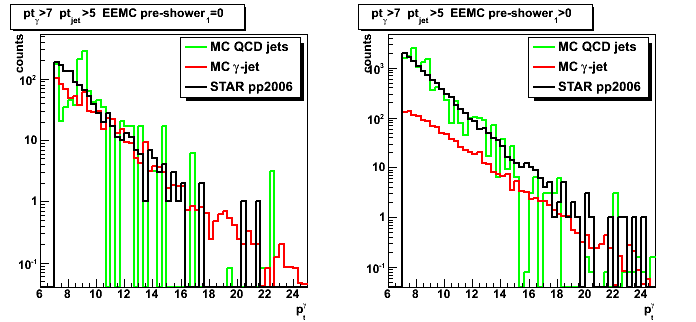
Figure 3: Gamma phi distribution.
pt cuts of 7GeV for the gamma and of 5 GeV for the away side jet have been applied.
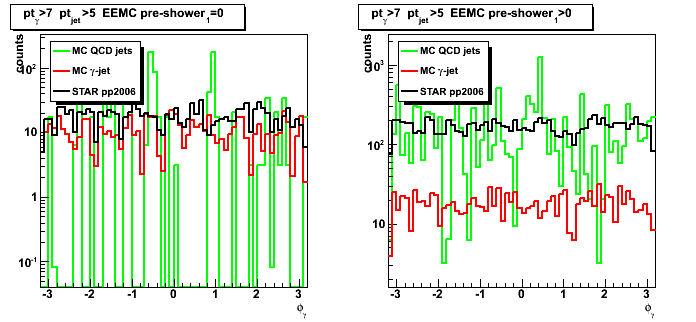
Figure 4: Away side jet eta distribution.
pt cuts of 7GeV for the gamma and of 5 GeV for the away side jet have been applied.
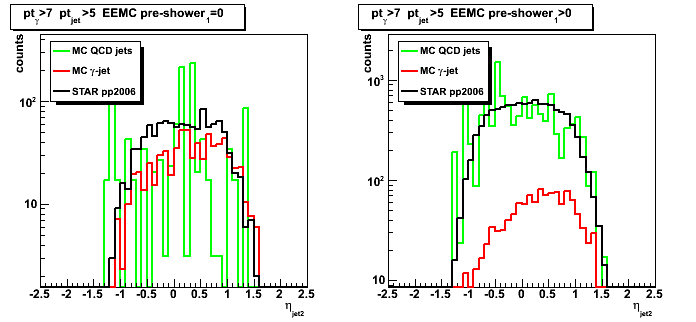
Figure 5: Away side jet pt distribution.
pt cuts of 7GeV for the gamma and of 5 GeV for the away side jet have been applied.
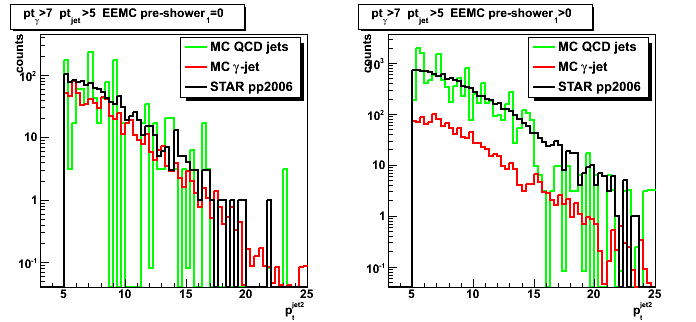
Figure 6: Gamma-jet delta pt distribution.
pt cuts of 7GeV for the gamma and of 5 GeV for the away side jet have been applied.
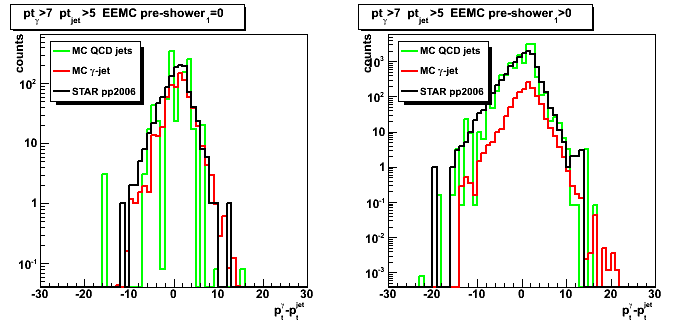
Figure 7: Gamma-jet delta eta distribution.
pt cuts of 7GeV for the gamma and of 5 GeV for the away side jet have been applied.
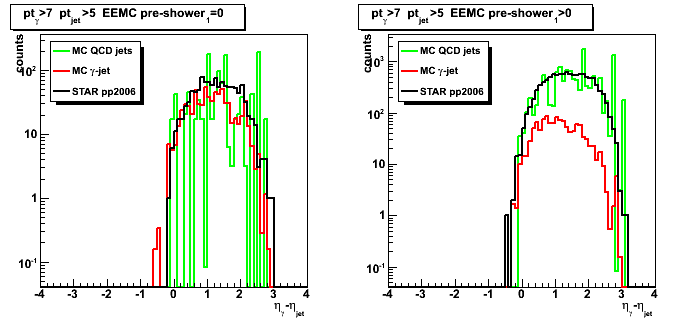
Figure 8: Gamma-jet delta phi distribution.
pt cuts of 7GeV for the gamma and of 5 GeV for the away side jet have been applied.

06 Jun
June 2008 posts
2008.06.04 Gamma cluster energy in various EEMC layers: data vs MC
Ilya Selyuzhenkov June 04, 2008
Gamma cluster energy in various EEMC layers: data vs MC
Three data sets:
- pp2006 - STAR 2006 pp longitudinal data (~ 3.164 pb^1) after applying gamma-jet isolation cuts.
- gamma-jet - data-driven Pythia gamma-jet sample (~170K events). Partonic pt range 5-35 GeV.
- QCD jets - data-driven Pythia QCD jets sample (~4M events). Partonic pt range 3-65 GeV.
Figure 1: Gamma candidate EEMC pre-shower 1 energy (3x3 cluster).
pt cuts of 7GeV for the gamma and of 5 GeV for the away side jet have been applied.
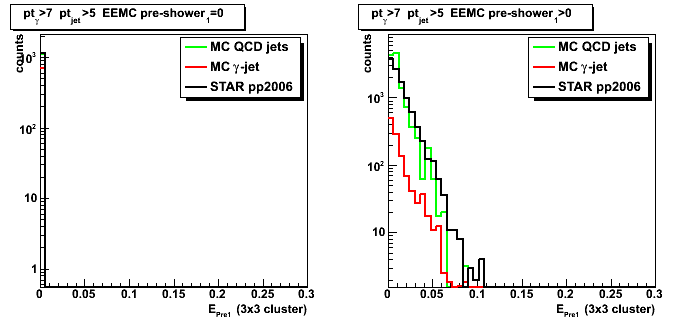
Figure 2: Gamma candidate EEMC pre-shower 2 energy (3x3 cluster).
pt cuts of 7GeV for the gamma and of 5 GeV for the away side jet have been applied.
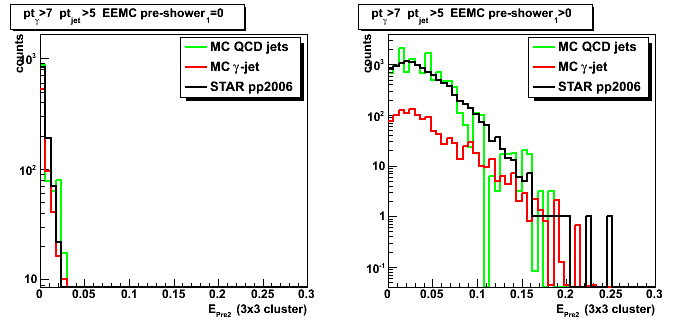
Figure 3: Gamma candidate EEMC tower energy (3x3 cluster).
pt cuts of 7GeV for the gamma and of 5 GeV for the away side jet have been applied.
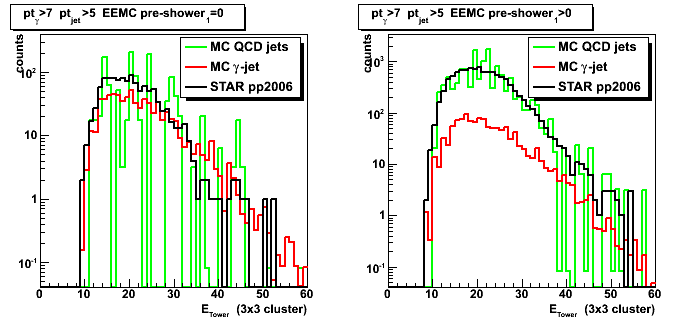
Figure 4: Gamma candidate EEMC post-shower energy (3x3 cluster).
pt cuts of 7GeV for the gamma and of 5 GeV for the away side jet have been applied.
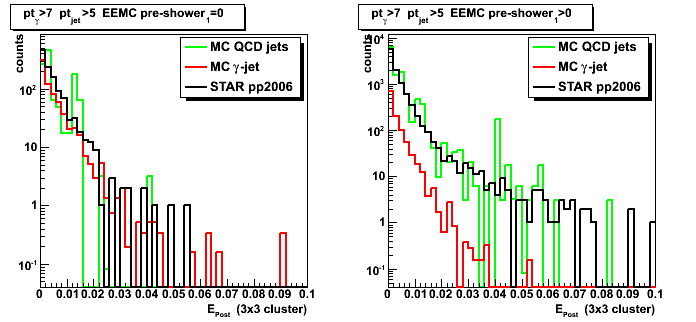
Figure 5: Gamma candidate EEMC SMD u-plane energy [5-strip cluster] (Figure for v-plane)
pt cuts of 7GeV for the gamma and of 5 GeV for the away side jet have been applied.
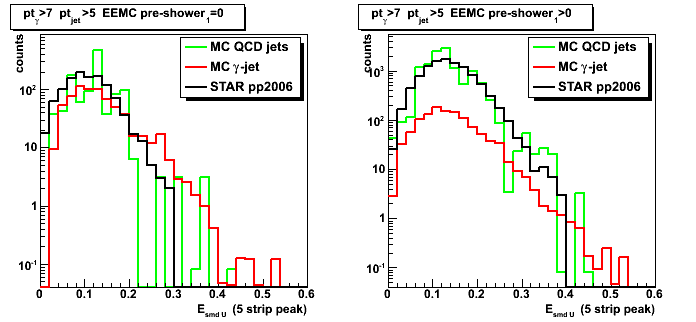
Difference between total and gamma candidate cluster energy for various EEMC layers
Figure 6: Total minus gamma candidate (3x3 cluster) energy in EEMC pre-shower 1 layer
pt cuts of 7GeV for the gamma and of 5 GeV for the away side jet have been applied.
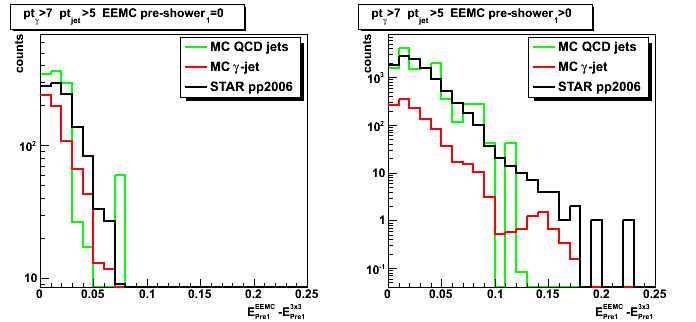
Figure 7: Total minus gamma candidate (3x3 cluster) energy in EEMC pre-shower 2 layer
pt cuts of 7GeV for the gamma and of 5 GeV for the away side jet have been applied.
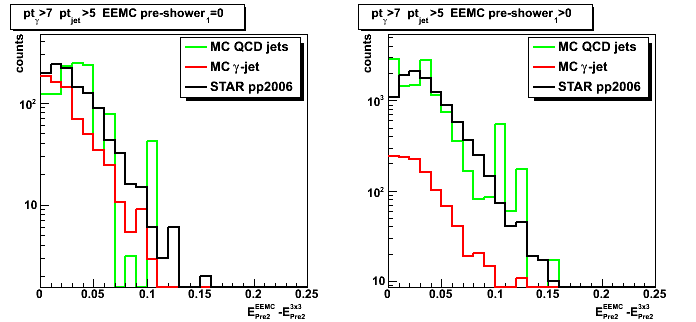
Figure 8: Total minus gamma candidate (3x3 cluster) energy in EEMC tower
pt cuts of 7GeV for the gamma and of 5 GeV for the away side jet have been applied.
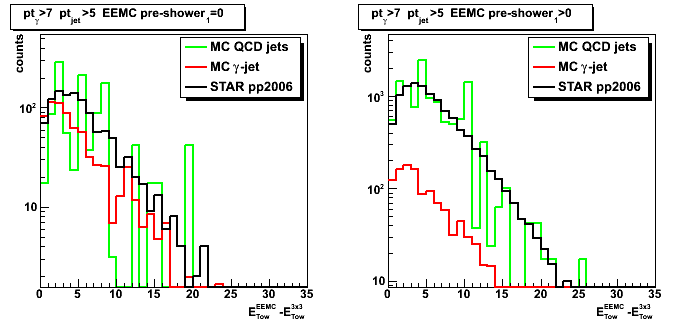
Figure 9: Total minus gamma candidate (3x3 cluster) energy in EEMC post-shower layer
pt cuts of 7GeV for the gamma and of 5 GeV for the away side jet have been applied.
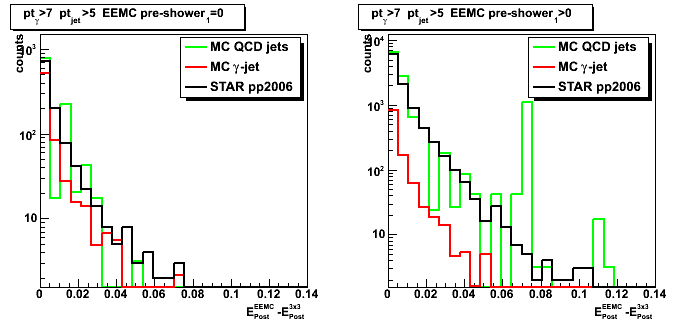
Figure 10: Total (sector) energy minus gamma candidate (5-strip cluster) energy in EEMC SMD[u-v] layer
pt cuts of 7GeV for the gamma and of 5 GeV for the away side jet have been applied.
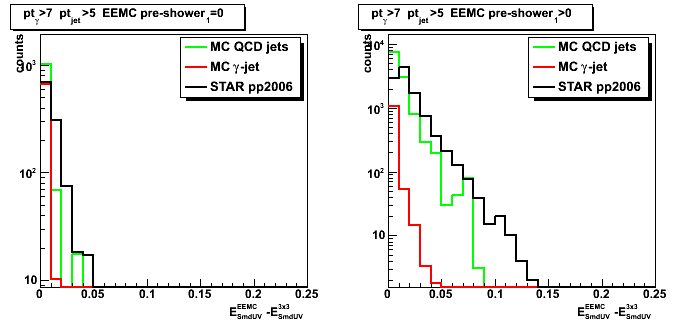
2008.06.09 STAR White paper plots (pt distribution: R_cluster 0.99 and 0.9 cuts)
Ilya Selyuzhenkov June 09, 2008
Gamma pt distribution: data vs MC (R_cluster 0.99 and 0.9 cuts)
Three data sets:
- pp2006 - STAR 2006 pp longitudinal data (~ 3.164 pb^1) after applying gamma-jet isolation cuts.
- gamma-jet - data-driven Pythia gamma-jet sample (~170K events). Partonic pt range 5-35 GeV.
- QCD jets - data-driven Pythia QCD jets sample (~4M events). Partonic pt range 3-65 GeV.
Numerical values for different pt-bins from Fig. 1-2
Figure 1: Gamma pt distribution for R_cluster >0.9.
No energy in both pre-shower layer (left plot), and
No energy in pre-shower1 and non-zero energy in pre-shower2 (right plot)
Same figure for R_cluster>0.99 can be found here
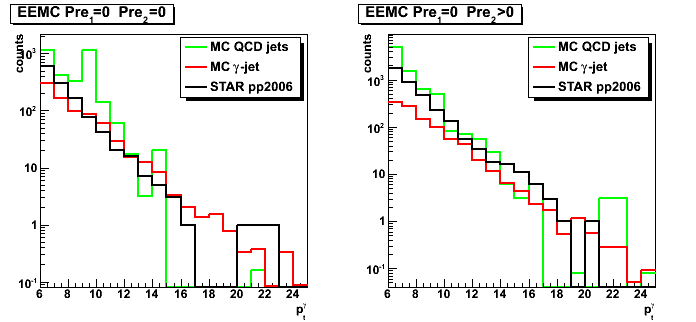
Figure 2: Gamma pt distribution for R_cluster >0.9.
No energy in first EEMC pre-shower1 layer (left plot), and
non-zero energy in pre-shower1 (right plot)
For more details (yield, ratios, all pre12 four conditions, etc) see figures 1-3 here.
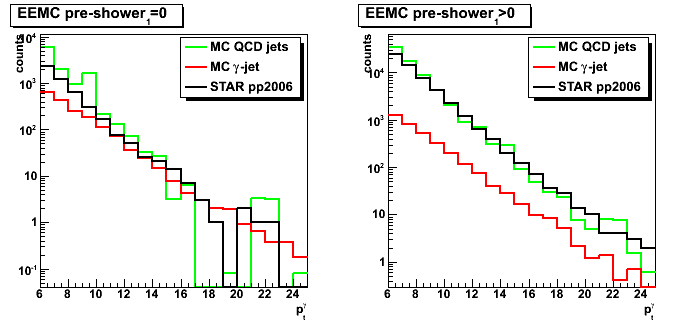
Figure 3: Gamma pt distribution for R_cluster >0.99.
For more details (yield, ratios, all pre12 four conditions, etc) see figures 1-3 here.
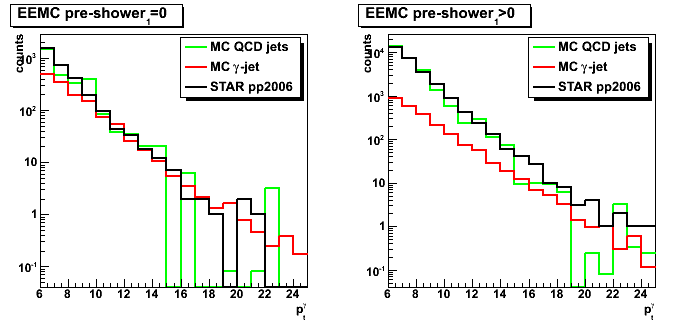
2008.06.10 Gamma-jet candidate longitudinal double spin asymmetry
Ilya Selyuzhenkov June 10, 2008
Note: No background subtraction has been done yet
The case of pre-shower1=0 (left plots) roughly has 1:1 signal to background ratio,
while pre-shower1>0 (right plots) have 1:10 ratio (See MC to data comparison for details).
Data sets:
- pp2006 - STAR 2006 pp longitudinal data (~ 3.164 pb^1) after applying gamma-jet isolation cuts,
plus two additional vertex QA cuts:
a) |z_vertex| < 100 and
b) 180 < bbcTimeBin < 300 - Polarization fill by fill: blue and yellow
- Relative luminosity by polarization fills and runs: relLumi06_070614.txt.gz
- Equations used to calculate A_LL from the data: pdf file
Figure 1: Gamma-jet candidate A_LL vs gamma pt.
Figures for related epsilon_LL and 1/Lum scaled by a factor 10^7
(see pdf/html links above for epsilon_LL and 1/Lum definitions)
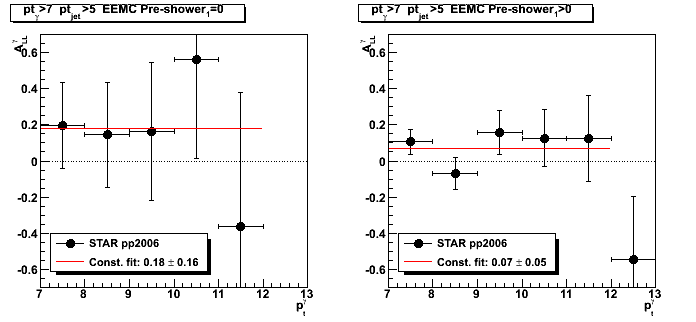
Figure 2: Gamma-jet candidate A_LL vs x_gluon.
Figures for related epsilon_LL and 1/Lum scaled by a factor 10^7
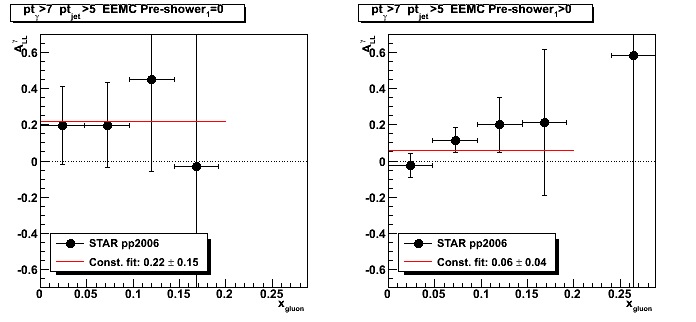
Figure 3: Gamma-jet candidate A_LL vs x_quark.
Figures for related epsilon_LL and 1/Lum scaled by a factor 10^7
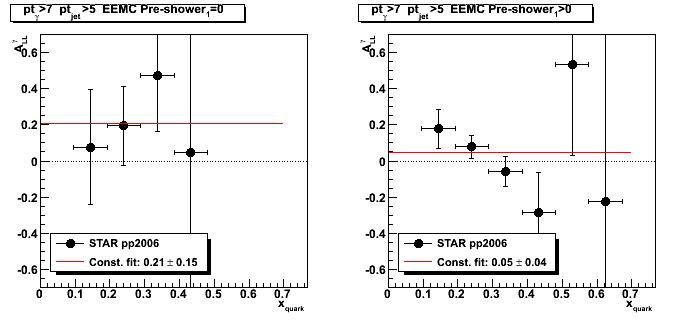
Figure 4: Gamma-jet candidate A_LL vs away side jet pt.
Figures for related epsilon_LL and 1/Lum scaled by a factor 10^7
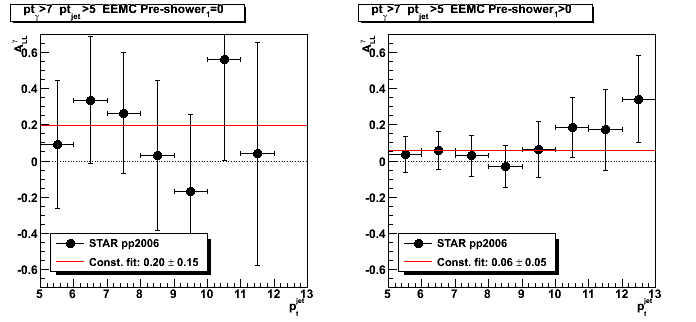
2008.06.18 Photon-jet reconstruction with the EEMC detector (talk at the STAR Collaboration meeting)
Ilya Selyuzhenkov June 18, 2008
Slides
Photon-jet reconstruction with the EEMC detector - Part 1: pdf or odp
Talk outline (preliminary)
- Introduction and motivation
-
Data samples (pp2006, MC gJet, MC QCD bg)
and gamma-jet reconstruction algorithm: -
Comparing pp2006 with Monte-Carlo simulations scaled to the same luminosity
(EEMC pre-shower sorting): -
EEMC SMD shower shapes from different data samples
(pp2006 and data-driven Monte-Carlo): -
Sided residual plots: pp2006 vs data-driven Monte-Carlo
(gammas from eta meson: 3 gaussian fits) -
Various cuts study:
- R_cluster cut of 0.99 and 0.9 comparison
(Cluster energy distribution vs number of EEMC towers fired: Fig.4) - Charge particle veto and TPC tracking
- Away side jet pt matching
- R_cluster cut of 0.99 and 0.9 comparison
-
Some QA plots:
-
A_LL reconstruction technique:
-
Work in progress... To do list:
- Understading MC background and pp2006 data shower shapes discrepancy
- Implementing sided residual technique with shapes sorted by pre1&2 (eta, sector, etc?)
- Tuning analysis cuts
- Quantifying signal to background ratio
- Background subtraction for A_LL, ...
- What else?
- Talk summary
07 Jul
July 2008 posts
2008.07.07 Pre-shower1 < 5MeV cut study
Ilya Selyuzhenkov July 07, 2008
Data sets:
- pp2006 - STAR 2006 pp longitudinal data (~ 3.164 pb^1) after applying gamma-jet isolation cuts.
- gamma-jet - data-driven Pythia gamma-jet sample (~170K events). Partonic pt range 5-35 GeV.
- QCD jets - data-driven Pythia QCD jets sample (~4M events). Partonic pt range 3-65 GeV.
Figure 1: Correlation between 3x3 cluster energy in pre-shower2 vs. pre-shower1 layers
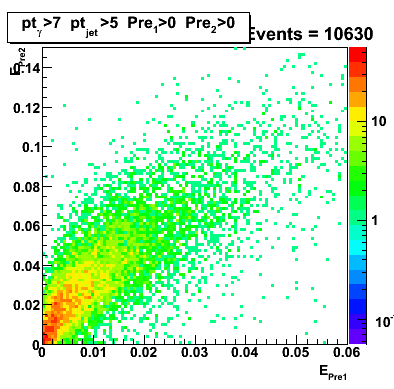
Figure 1a: Distribution of the 3x3 cluster energy in pre-shower1 layer (zoom in for Epre1<0.03 region)
(pp2006 data vs. MC gamma-jet and QCD events)
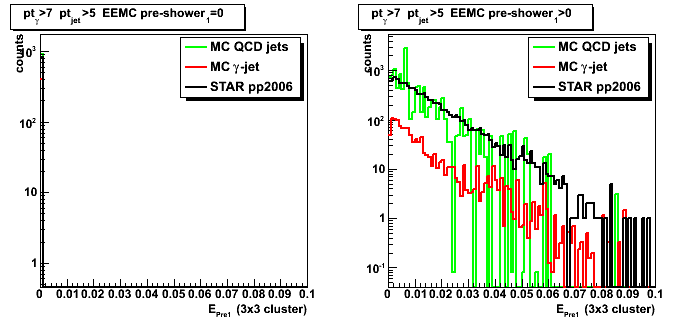
Figure 2: Shower shapes after pre-shower1 < 5MeV cut.
Shapes are narrower than those without pre1 cut (see Fig. 2)
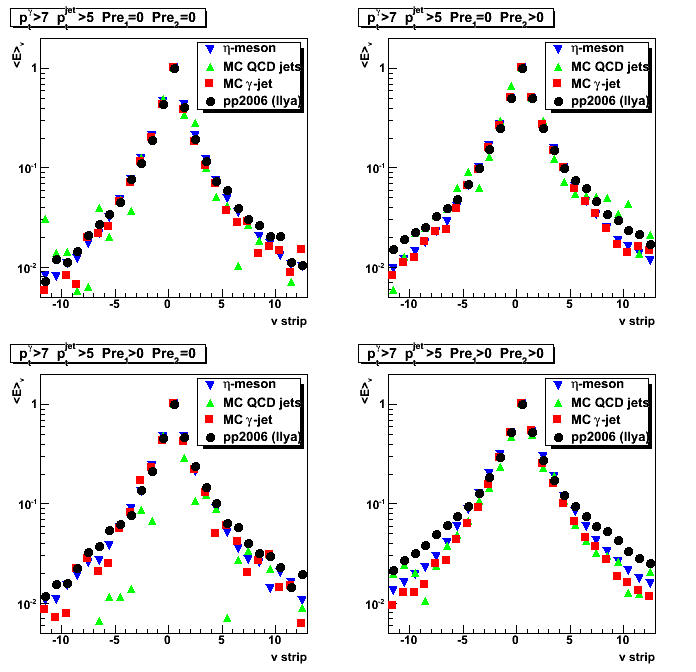
Figure 3: Gamma pt distribution with pre-shower1 < 5MeV cut.
Compare with distribution withoud pre-shower1 (Fig. 3)
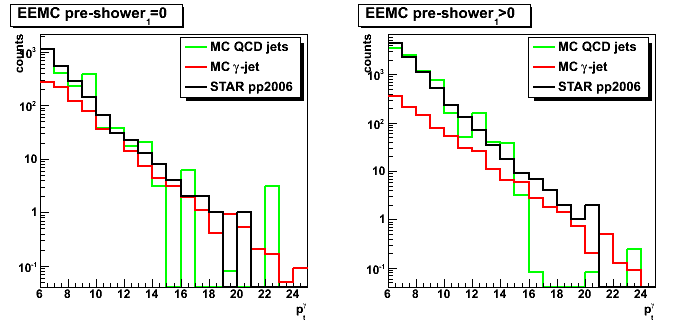
Sided residual (before and after pre-shower1 < 5MeV cut)
Figure 4: Fitted peak vs. maximum sided residual (no pre-shower1 cuts)
Only points for pp2006 data are shown.
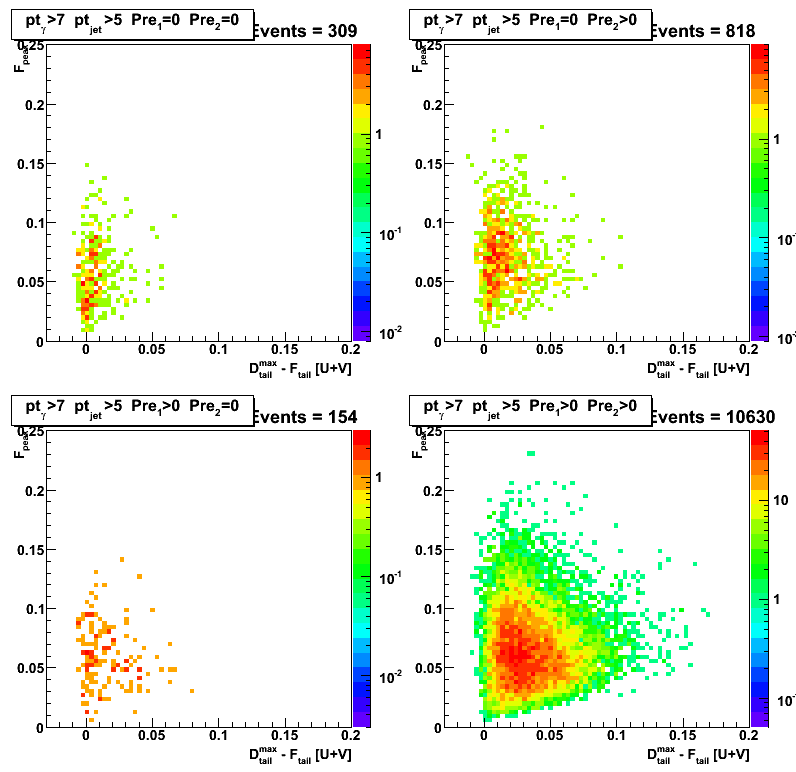
Figure 5: Fitted peak vs. maximum sided residual (after pre-shower1 < 5MeV cut).
Only points for pp2006 data are shown.
Note that distribution for pre1>0,pre2>0 case are narrower
compared to that in Fig.4 (without pre-shower1 cuts).
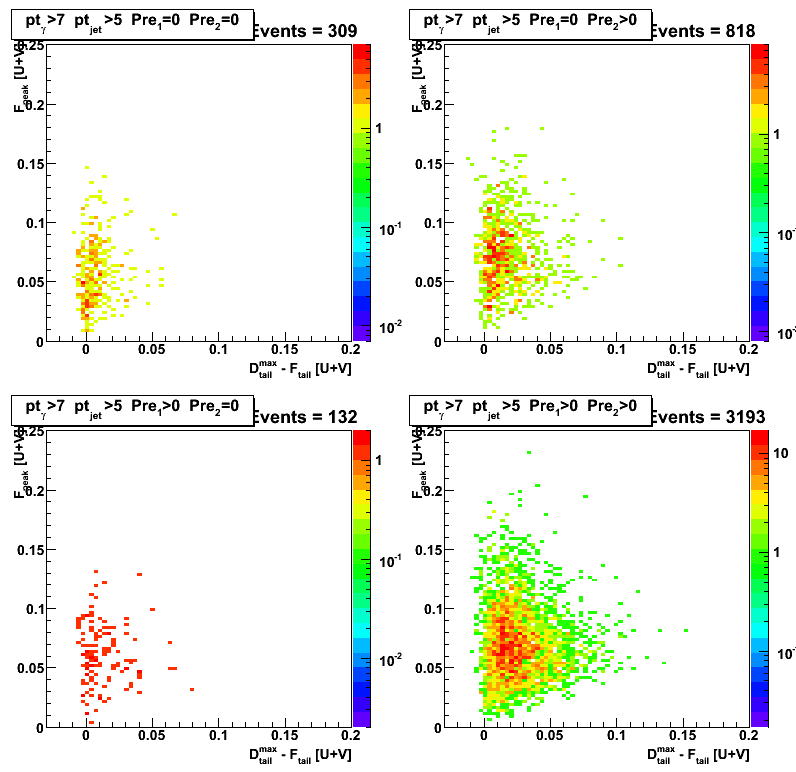
Figure 6: Distribution of maximum sided residual with pre-shower1 < 5MeV cut.
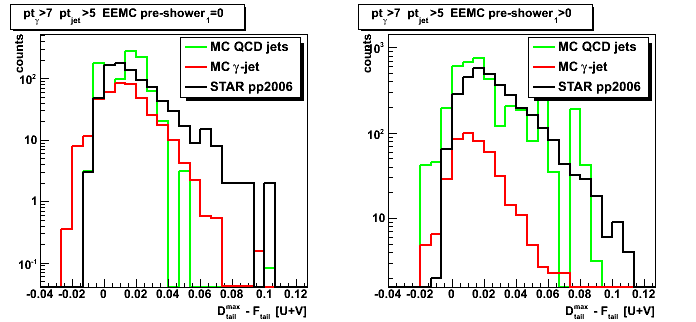
2008.07.16 Gamma-gamma invariant mass cut study
Ilya Selyuzhenkov July 16, 2008
Three data sets:
- pp2006 - STAR 2006 pp longitudinal data (~ 3.164 pb^1) after applying gamma-jet isolation cuts.
- gamma-jet - data-driven Pythia gamma-jet sample (~170K events). Partonic pt range 5-35 GeV.
- QCD jets - data-driven Pythia QCD jets sample (~4M events). Partonic pt range 3-65 GeV.
My simple gamma-gamma finder is trying to
find a second peaks (clusters) in each SMD u and v planes,
match u and v plane high strip intersections,
and calculate the invaraint mass from associated tower energies (3x3 cluster)
according to the energy sharing between SMD clusters.
Figure 1: Gamma-gamma invariant mass plot.
Only pp2006 data are shown: black: no pt cuts, red: gamma pt>7GeV and jet pt>5 GeV.
Clear pi0 peak in the [0.1,0.2] invariant mass region.
Same data on the log scale
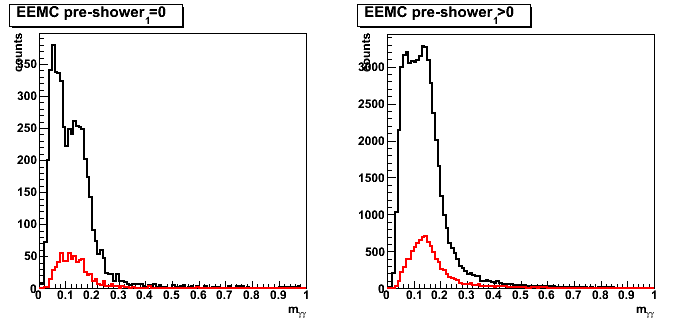
Gamma pt distributions
Figure 2: Gamma pt distribution (no inv mass cuts).
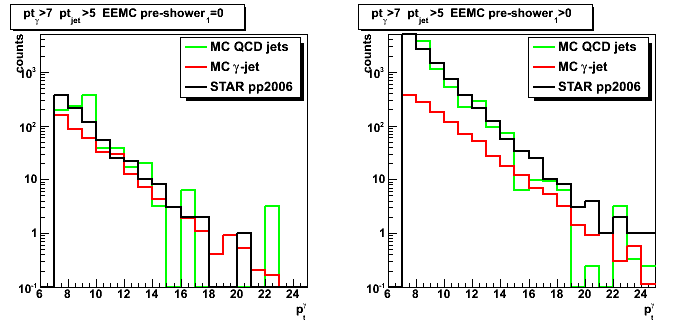
Figure 3: Gamma pt distribution (m_invMass<0.11 or no second peak found).
This cut improves signal to background ratio.
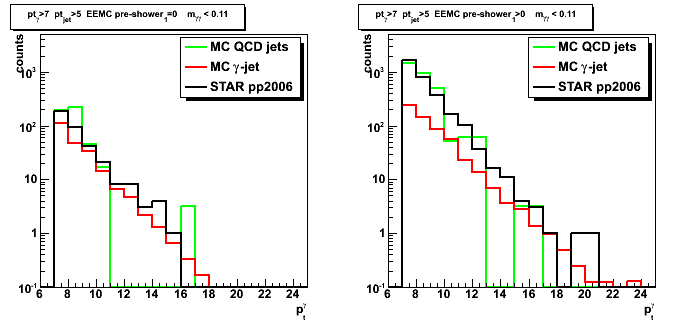
Figure 4: Gamma pt distribution (m_invMass>0.11).
Mostly background events.
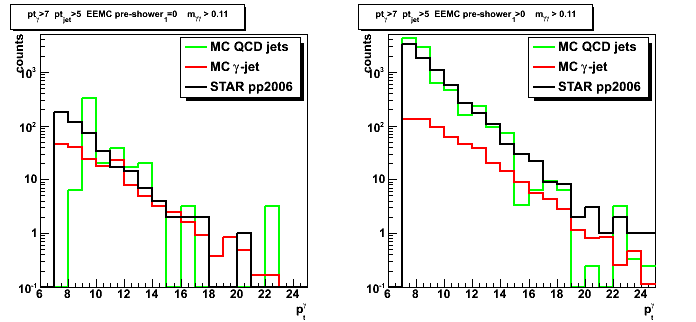
Shower shapes
Figure 5: Shower shapes (no pre1 and no invMass cuts).
Good match between shapes in case of no energy in pre-shower1 layer (pre1=0 case).
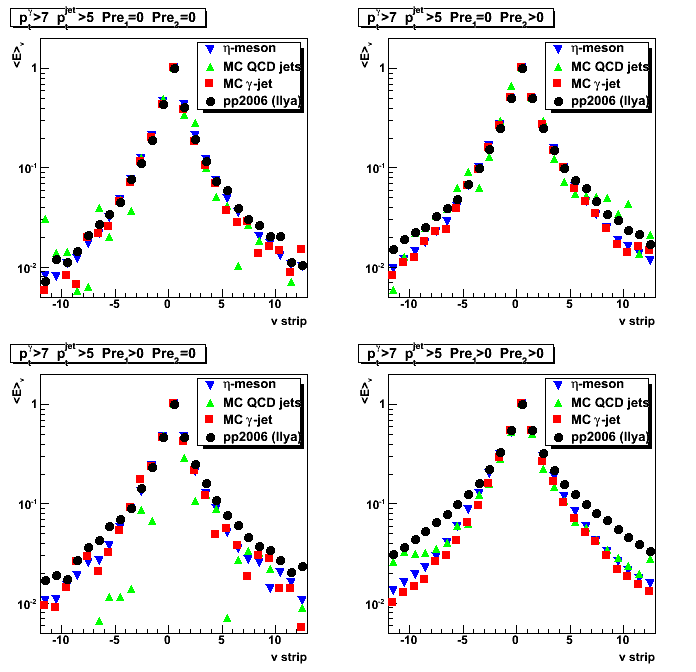
Figure 6: Shower shapes (pre1<5MeV, no invMass cuts).
For pre1&2>0 case shapes getting closer to ech other, but still do not match.
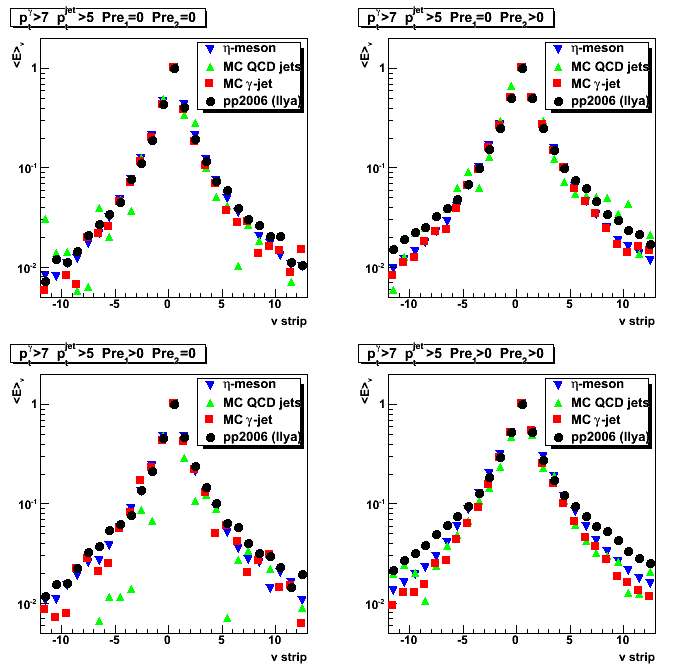
Figure 7: Shower shapes (cuts: pre1<5MeV, invMass<0.11 or no second peak found).
Note, the surprising agreement between eta-meson shapes (blue) and data (black).
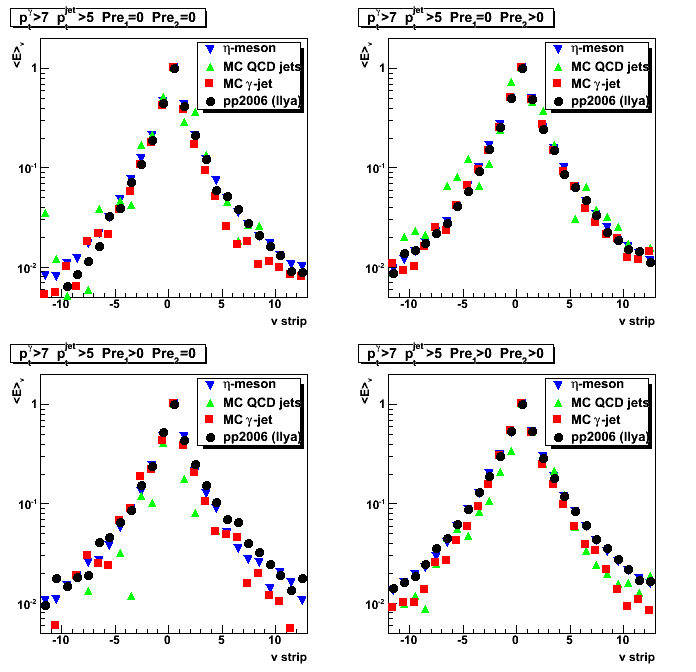
Gamma-gamma invariant mass plots
Figure 8: Invariant mass distribution (MC vs. pp2006 data): no pre1 cut
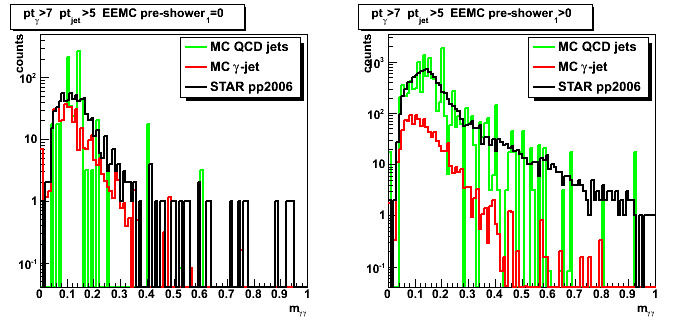
Figure 9: Invariant mass distribution (MC vs. pp2006 data): pre1<5MeV
Left side is the same as in Figure 8
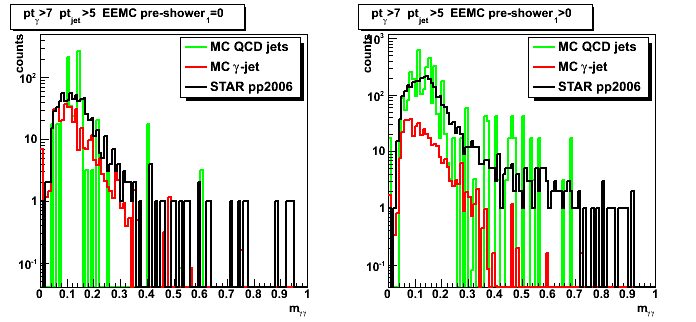
Figure 10: Invariant mass distribution (MC vs. pp2006 data): pre1>5MeV
Left side plot is empty, since there is no events with [pre1=0 and pre1>5MeV]
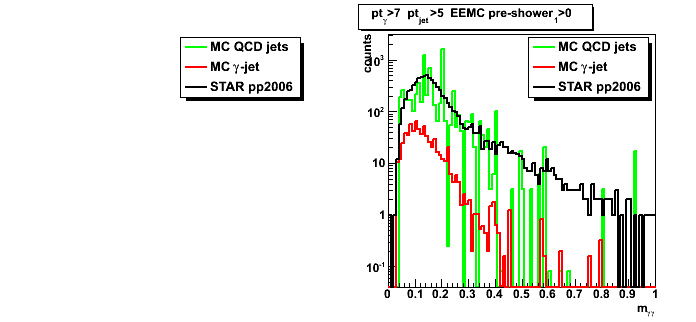
2008.07.22 Photons from eta-meson: library QA
Ilya Selyuzhenkov July 22, 2008
Shower shapes
Figure 1: Shower shapes: no energy cuts, only 12 strips from peak (left u-plane, right v-plane).
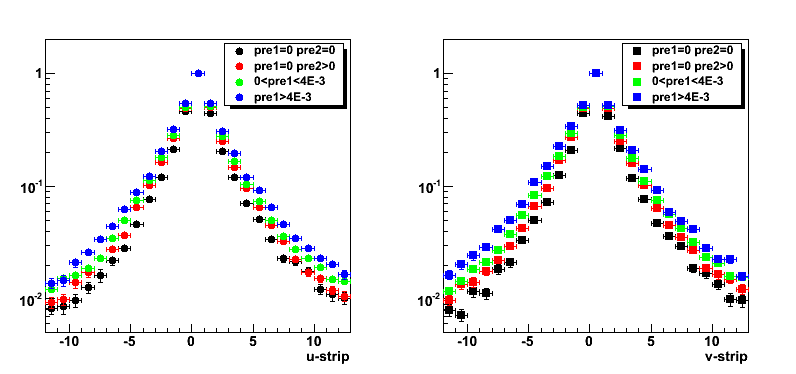
Figure 1a: Shower shapes: no energy cuts, 150 strips from peak (left u-plane, right v-plane).
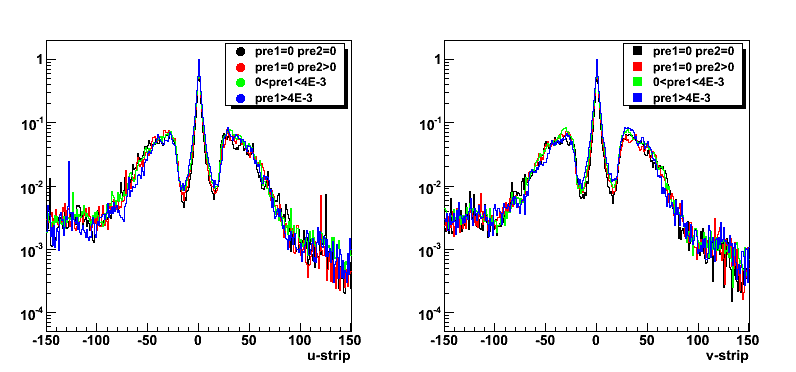
Figure 2: Shower shapes Energy>8GeV (left u-plane, right v-plane).
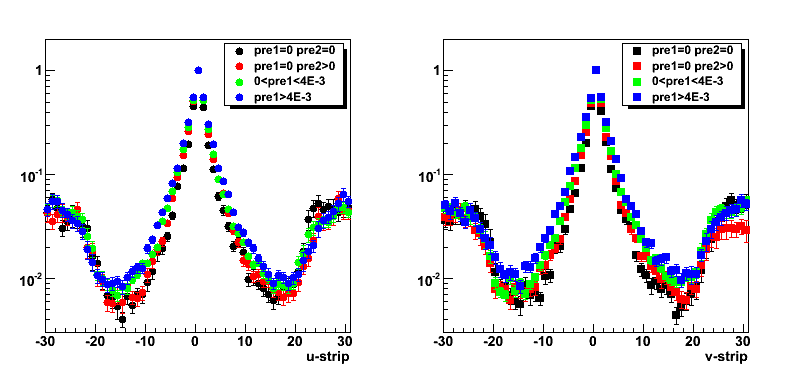
Figure 3: Shower shapes Energy<=8GeV (left u-plane, right v-plane).
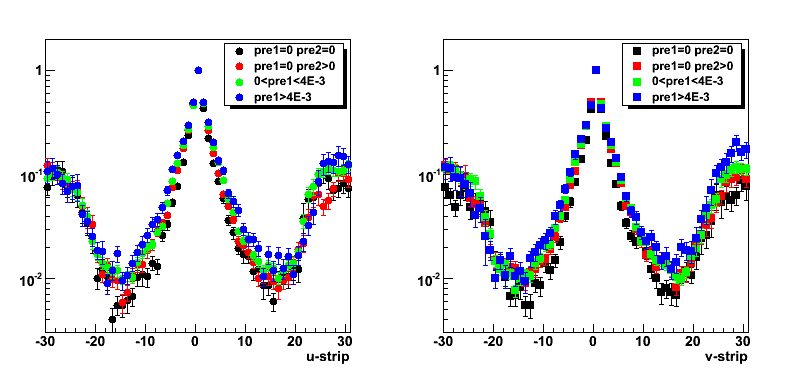
One dimensional distributions
Figure 8: Number of library candidates per sector.
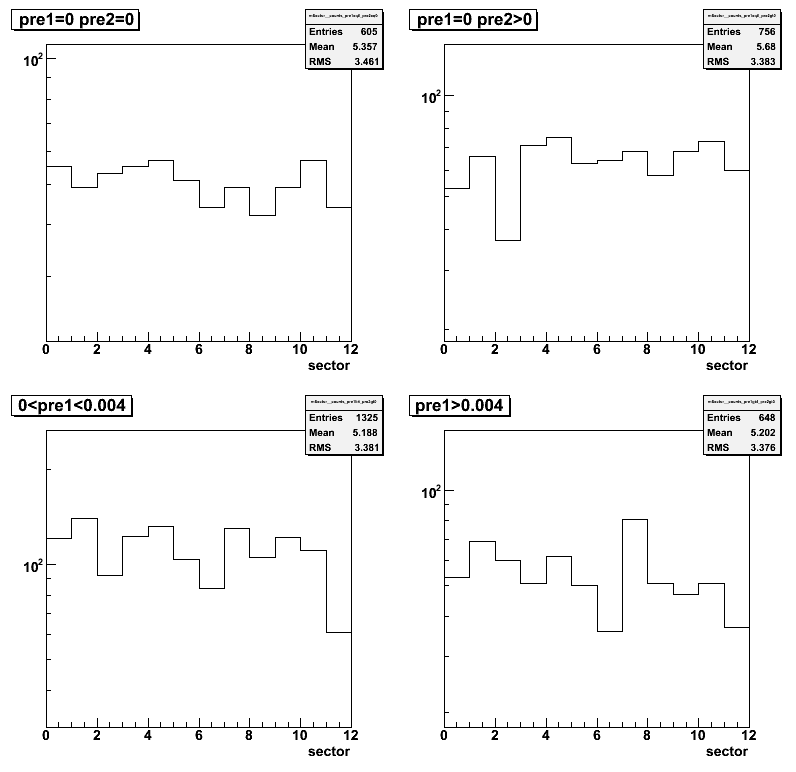
Correlation plots
Figure 9: Transverse momentum vs. energy.
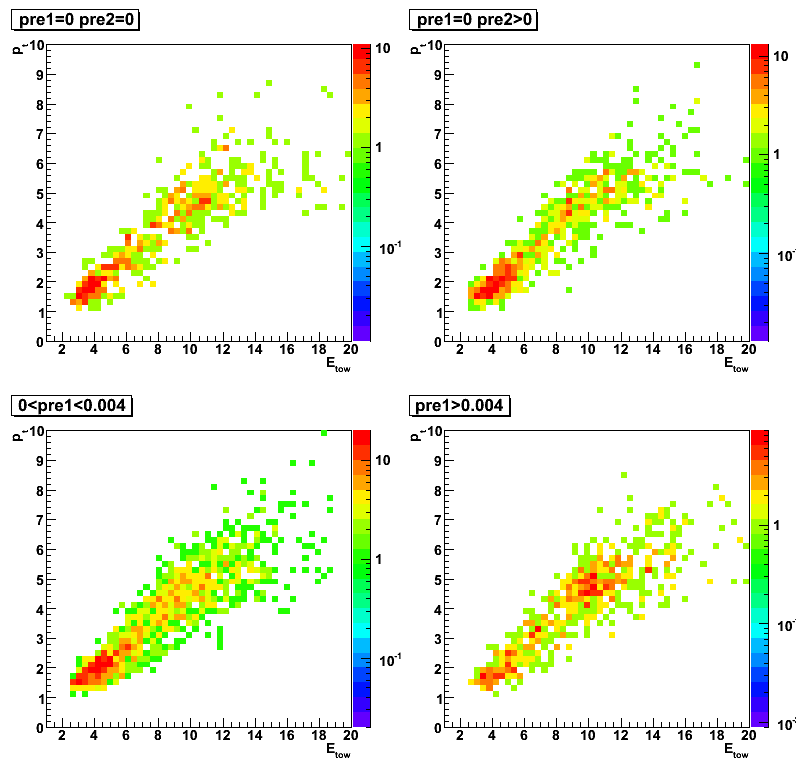
Figure 10: Distance from center of the detector vs. energy.
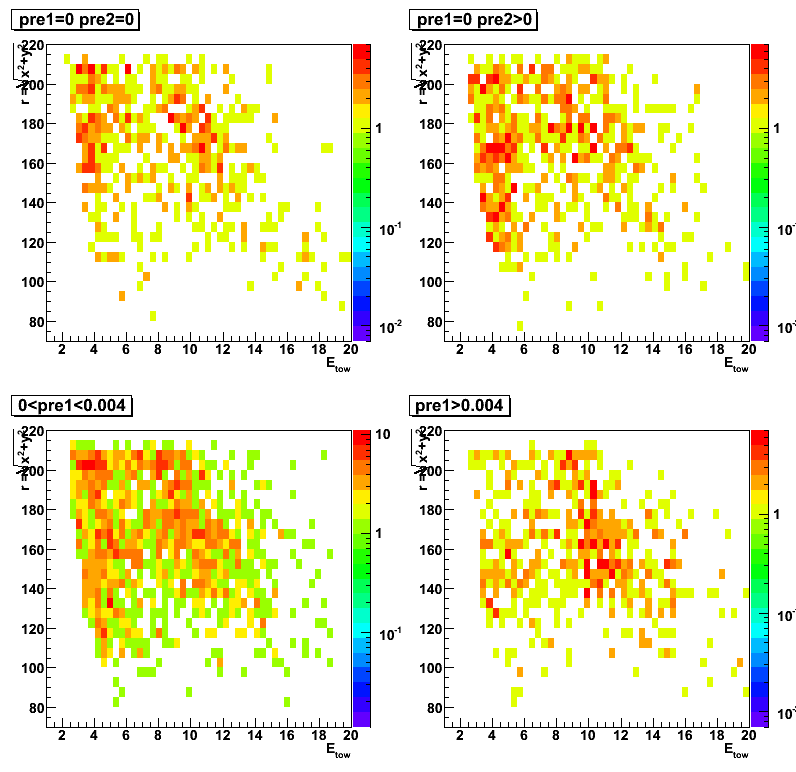
2008.07.29 Shower shape comparison with new dd-library bins
Ilya Selyuzhenkov July 29, 2008
Data sets:
- pp2006 - STAR 2006 pp longitudinal data (~ 3.164 pb^1) after applying gamma-jet isolation cuts.
- gamma-jet - data-driven Pythia gamma-jet sample (~170K events). Partonic pt range 5-35 GeV.
- QCD jets - data-driven Pythia QCD jets sample (~4M events). Partonic pt range 3-65 GeV.
Latest data-driven shower shape replacement library:
- Four pre-shower bins: pre1,2=0, pre1=0,pre2>0 pre1<4MeV, pre1>=4MeV
- plus two energy bins (E<8GeV, E>=8GeV)
Figure 1: Shower shapes for u-plane [12 strips]
Shower shapes for the library are for the E>8GeV bin.
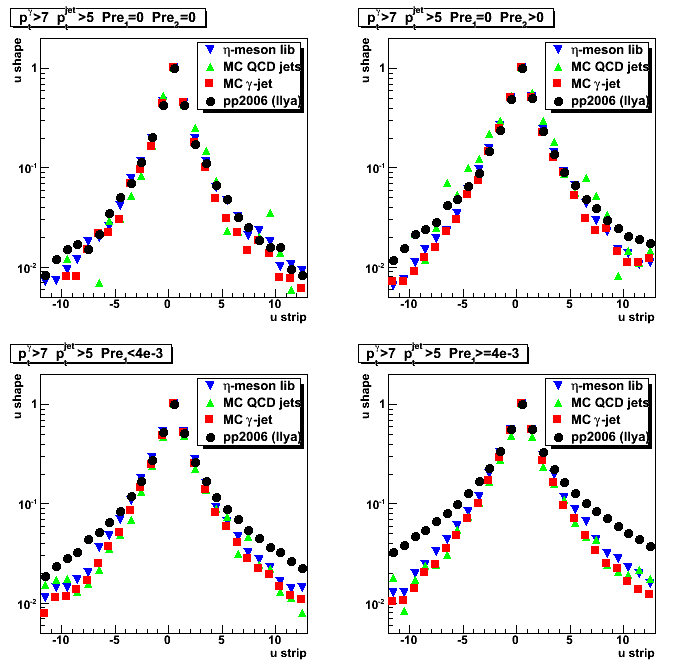
Figure 2: Shower shapes for v-plane [12 strips]
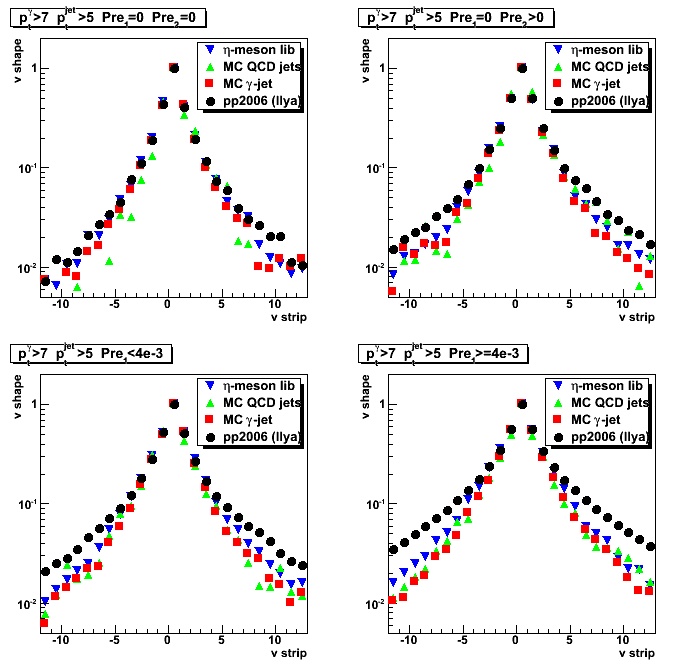
Figure 3: Shower shapes for u-plane [expanded to 40 strips]
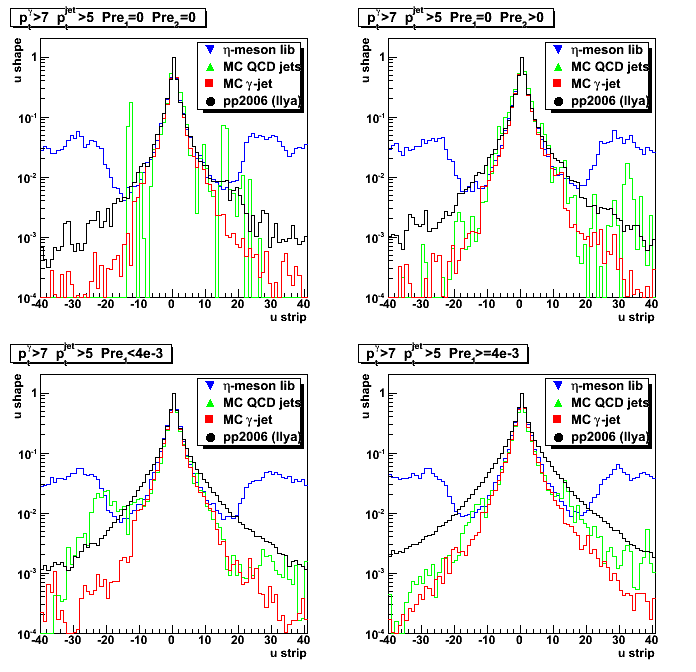
Figure 4: Shower shapes for v-plane [expanded to 40 strips]
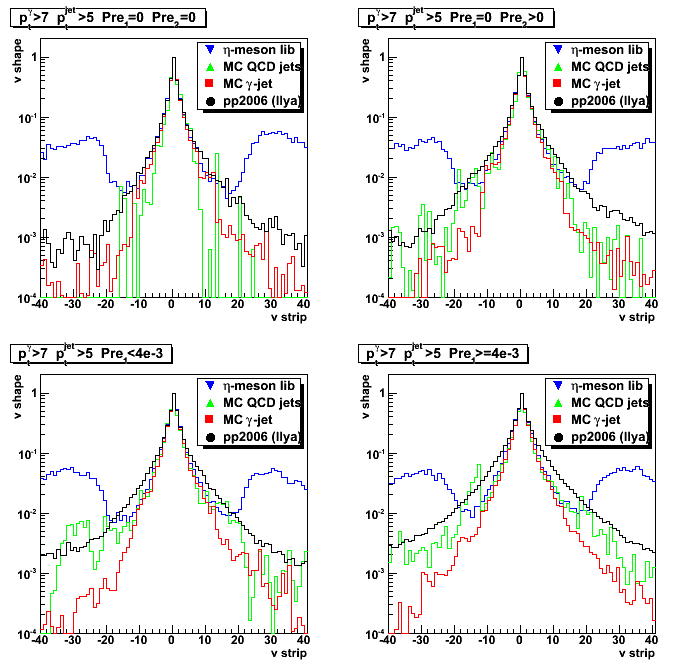
08 Aug
August 2008 posts
2008.08.14 Shower shape with bug fixed dd-library
Ilya Selyuzhenkov August 14, 2008
Data sets:
- pp2006 - STAR 2006 pp longitudinal data (~ 3.164 pb^1) after applying gamma-jet isolation cuts.
- gamma-jet - data-driven Pythia gamma-jet sample (~170K events). Partonic pt range 5-35 GeV.
- QCD jets - data-driven Pythia QCD jets sample (~4M events). Partonic pt range 3-65 GeV.
Data-driven maker with bug fixed multi-shape replacement:
- Four pre-shower bins: pre1,2=0, pre1=0,pre2>0 pre1<4MeV, pre1>=4MeV
- plus two energy bins (E<8GeV, E>=8GeV)
Figure 1: Shower shapes for u-plane [12 strips]
Shower shapes for the library are for the E>8GeV bin.
Open squares and triangles represents raw [without dd-maker]
MC gamma-jet and QCD background shower shapes respectively
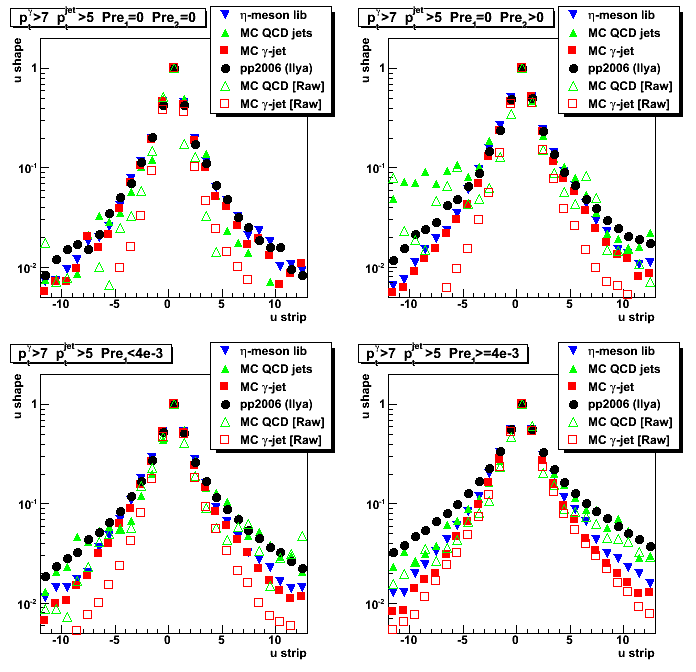
Figure 2: Shower shapes for v-plane [12 strips]
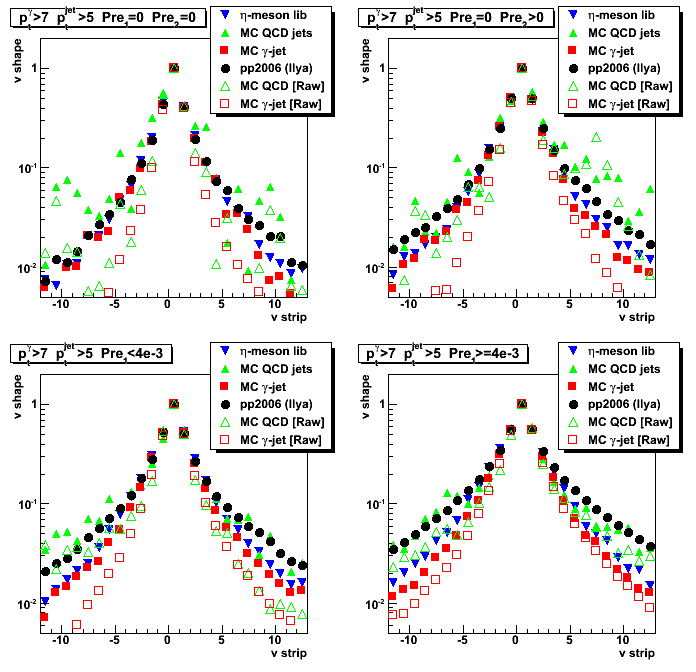
Figure 3: Shower shapes for u-plane [expanded to 40 strips]
Dashed red and green lines represents raw [without dd-maker]
MC gamma-jet and QCD background shower shapes respectively
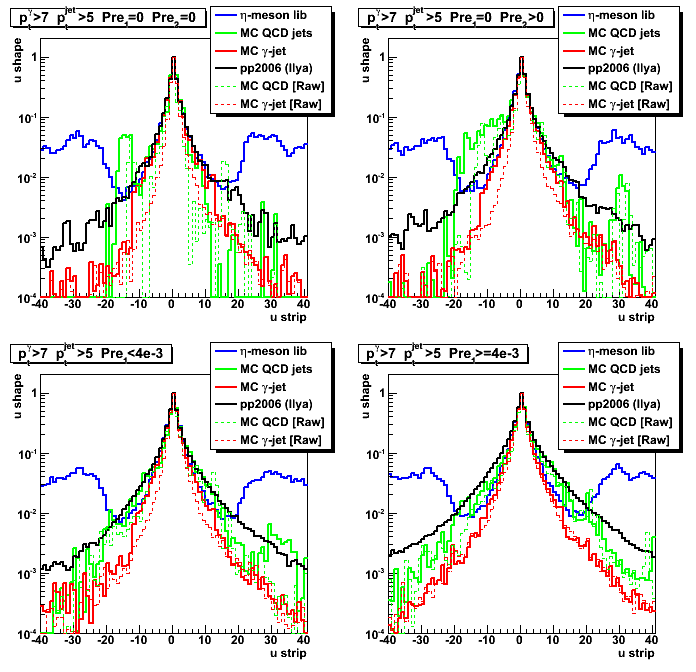
Figure 4: Shower shapes for v-plane [expanded to 40 strips]
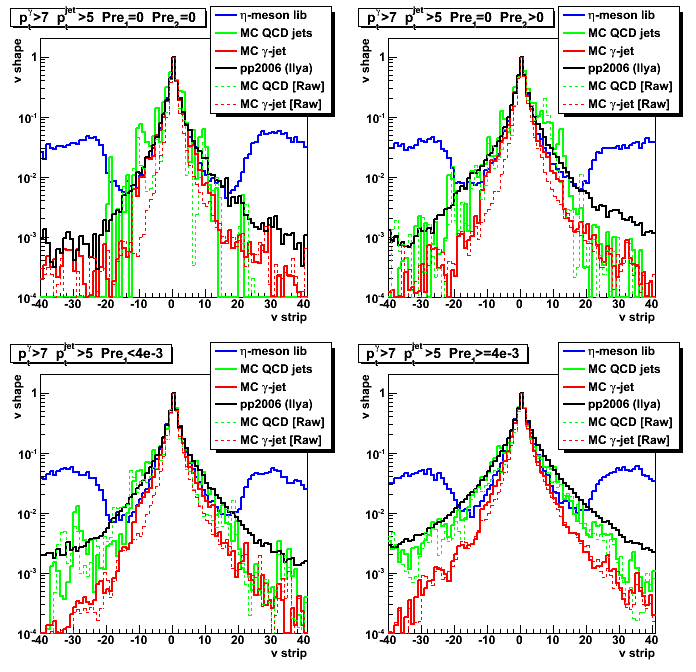
2008.08.19 Shower shape from pp2008 vs pp2006 data
Ilya Selyuzhenkov August 19, 2008
Data sets:
- pp2006 - STAR 2006 ppProductionLong data (~ 3.164 pb^1)
"eemc-http-mb-l2gamma" trigger after applying gamma-jet isolation cuts. - pp2008 - STAR ppProduction2008 (~ 5.9M events)
"fmsslow" trigger after applying gamma-jet isolation cuts.
[Only ~13 candidates has been selected before pt-cuts] - gamma-jet - data-driven Pythia gamma-jet sample (~170K events). Partonic pt range 5-35 GeV.
- QCD jets - data-driven Pythia QCD jets sample (~4M events). Partonic pt range 3-65 GeV.
Note: Due to lack of statistics for 2008 data, no pt cuts applied on gamma-jet candidates for both 2006 and 2008 date.
Figure 1: Shower shapes for u-plane [pp2006 data: eemc-http-mb-l2gamma trigger]
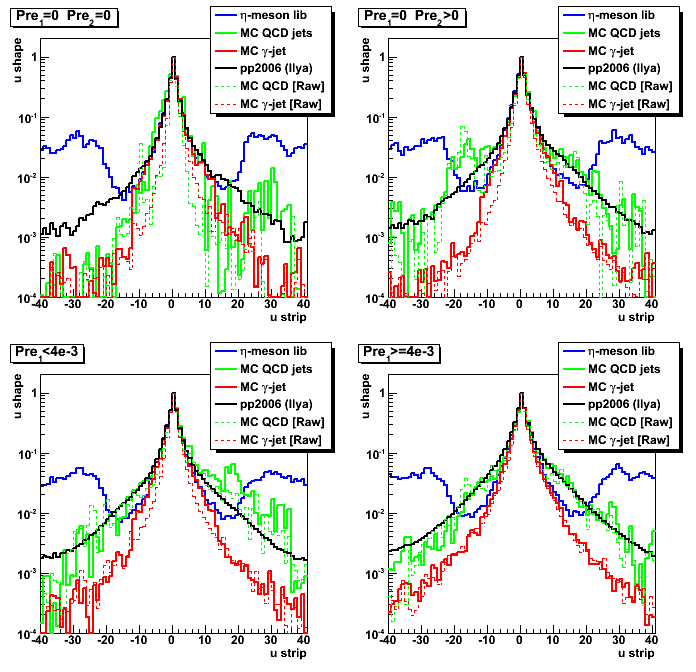
Figure 2: Shower shapes for v-plane [pp2006 data: eemc-http-mb-l2gamma trigger]
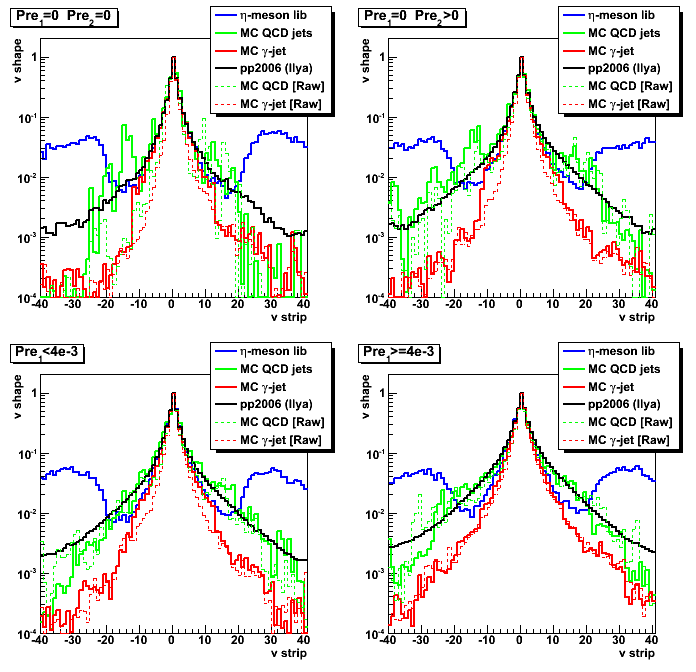
Figure 3: Shower shapes for u-plane [pp2008 data: fmsslow trigger]
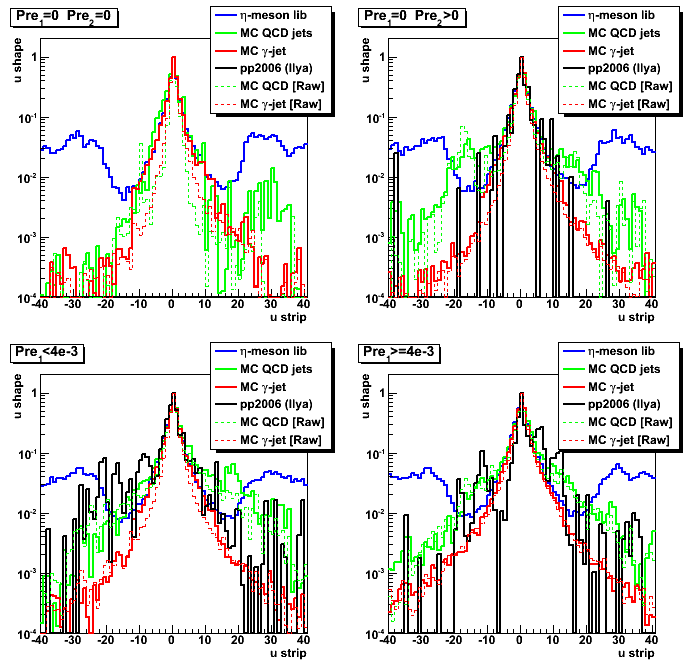
Figure 4: Shower shapes for v-plane [pp2008 data: fmsslow trigger]
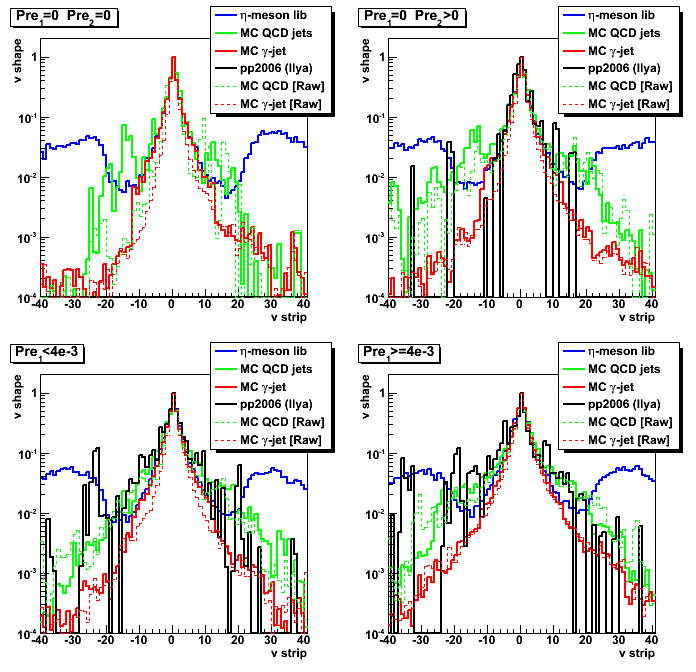
2008.08.25 di-jets from pp2008 vs pp2006 data
Ilya Selyuzhenkov August 25, 2008
Data sets:
- pp2006 - ppProductionLong [triggerId:137213] (day 136 only)
- pp2008 - ppProduction2008 [triggerId:220520] (Jan's set of MuDst from day 047)
Event selection:
- Run jet finder and select only di-jet events [adopt jet-finder script from Murad's analysis]
- Define jet1 as the jet with largest neutral energy fraction (NEF), and jet2 - the jet with a smaller NEF
- Require no EEMC towers associated with jet1
- Select trigger (see above) and require vertex to be found
Figure 1: Vertex z distribution (left: pp2008; right: 2006 data)
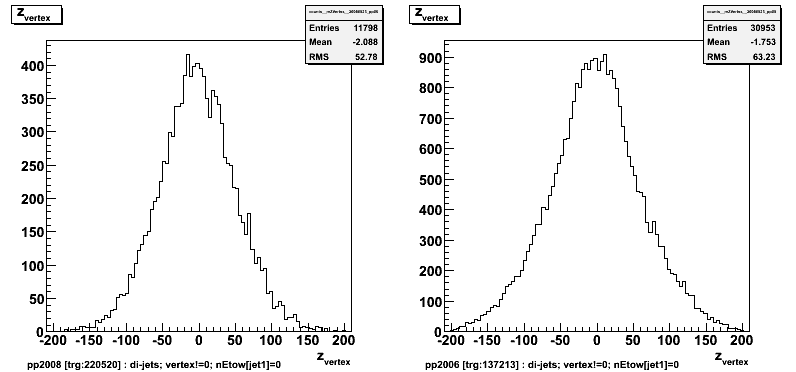
Figure 2: eta vs. phi distribution for the jet1 (jet with largest NEF) .
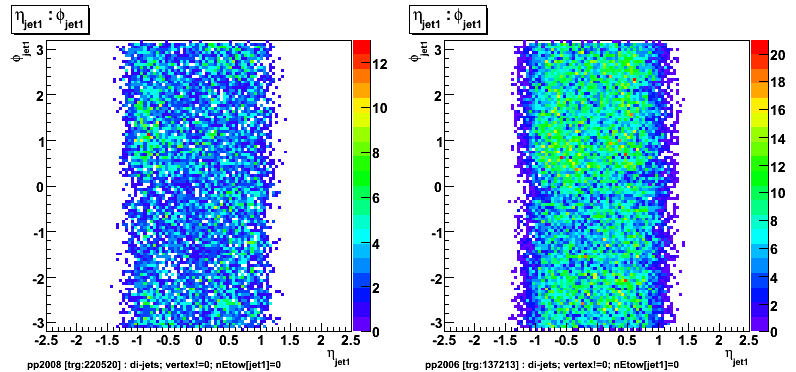
Figure 3: eta vs. z-vertex distribution for the jet1 (jet with largest NEF) .
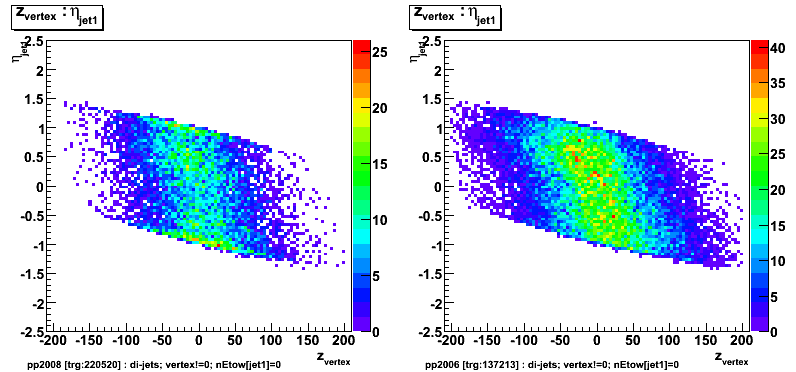
Figure 4: eta vs. z-vertex distribution for the second jet.
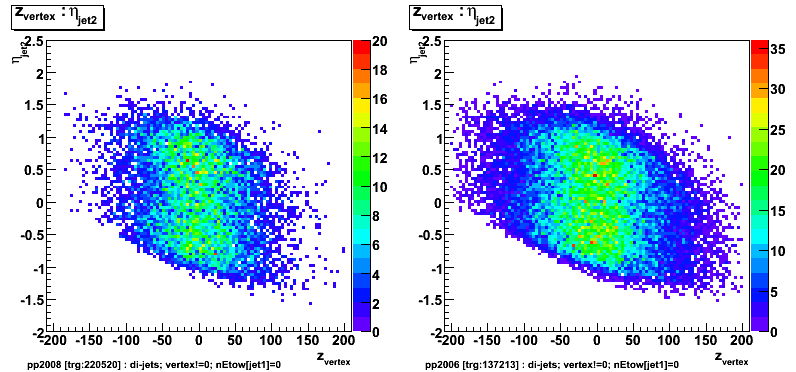
Figure 5: Transverse momentum distribution for jet1.
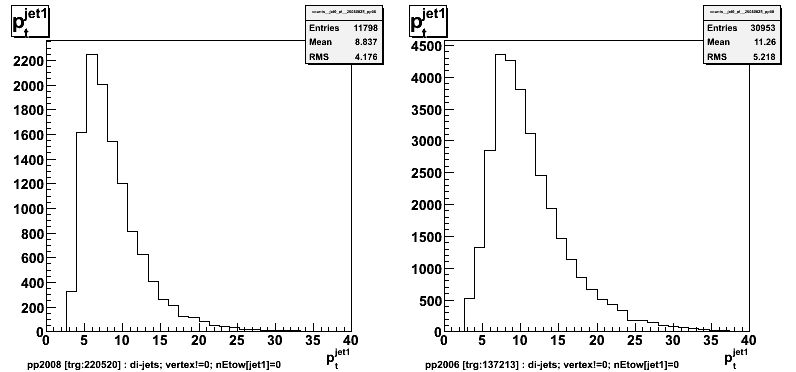
2008.08.26 Shower shape: more constrains for pre1>4E-3 bin
Ilya Selyuzhenkov August 26, 2008
Data sets:
- pp2006 - STAR 2006 pp longitudinal data (~ 3.164 pb^1) after applying gamma-jet isolation cuts.
- gamma-jet - data-driven Pythia gamma-jet sample (~170K events). Partonic pt range 5-35 GeV.
- QCD jets - data-driven Pythia QCD jets sample (~4M events). Partonic pt range 3-65 GeV.
Data-driven library:
- Four pre-shower bins: pre1,2=0, pre1=0,pre2>0 pre1<4MeV, pre1>=4MeV
- plus two energy bins (E<8GeV, E>=8GeV)
Figure 1: Pre-shower1 energy distribution for Pre1>4 MeV:
Eta meson library for E>8GeV bin [left] and data vs. MC results [right].
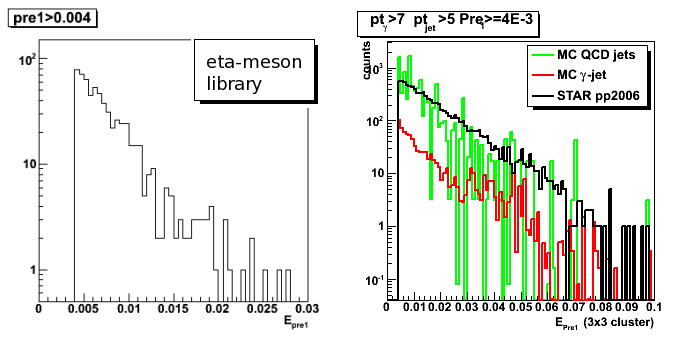
Figure 2: Shower shapes for v-plane [Pre1<10MeV cut]
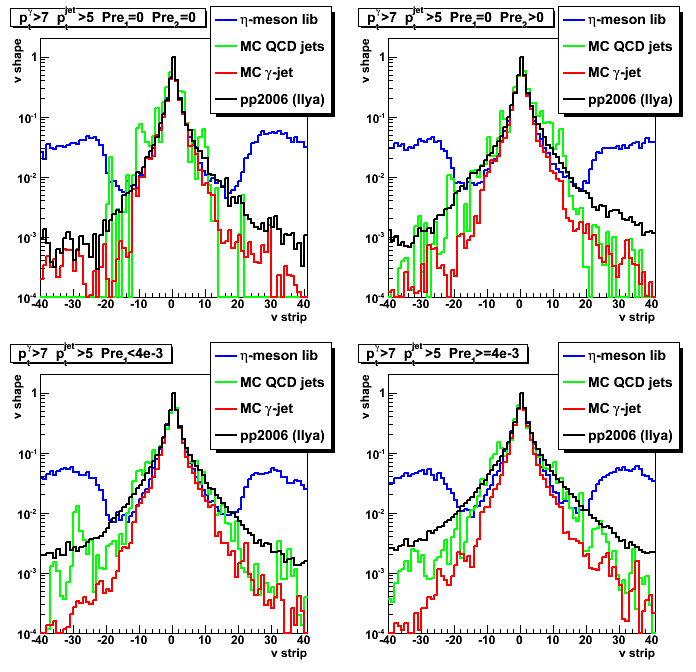
Figure 3: Shower shapes for u-plane [Pre1<10MeV cut]
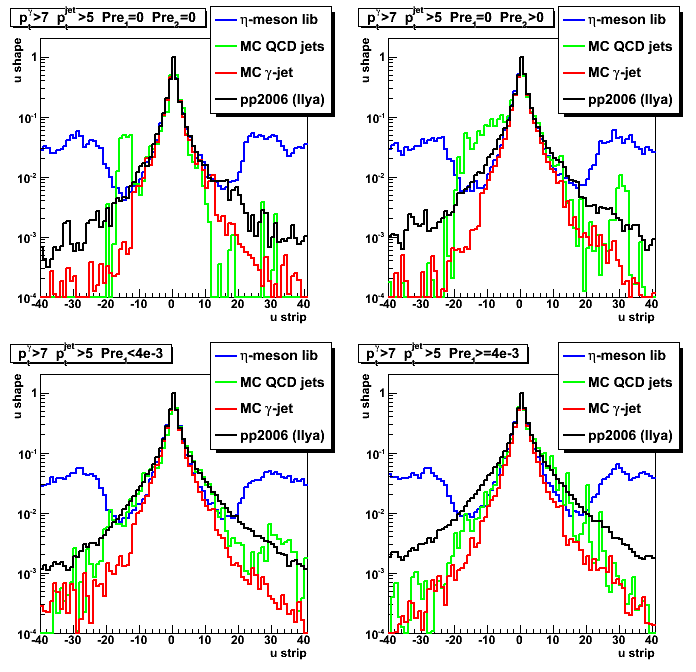
Maximum side residual plots
Definitions for side residual plot (F_peak, F_tal, D_tail) can be found here
For a moment same 3-gaussian shape is used to fit SMD response for all pre-shower bins.
Algo needs to be updated with a new shapes sorted by pre-shower bins.
Figure 4: Sided residual plot for pp2006 data only [Pre1<10MeV cut]
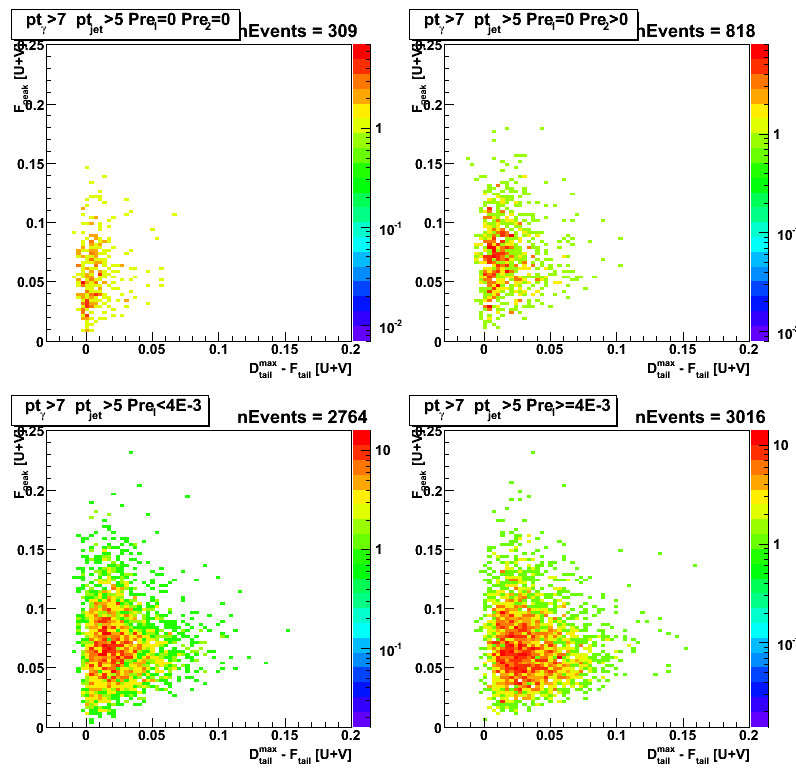
Figure 5: Sided residual projection on "Fitted Peak" axis [Pre1<10MeV cut]
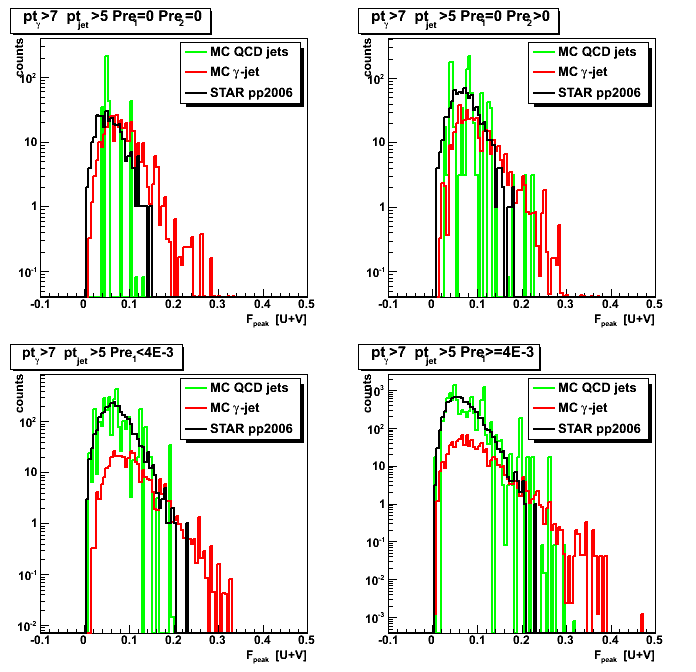
Figure 6: Sided residual projection on "tail difference" axis [Pre1<10MeV cut]
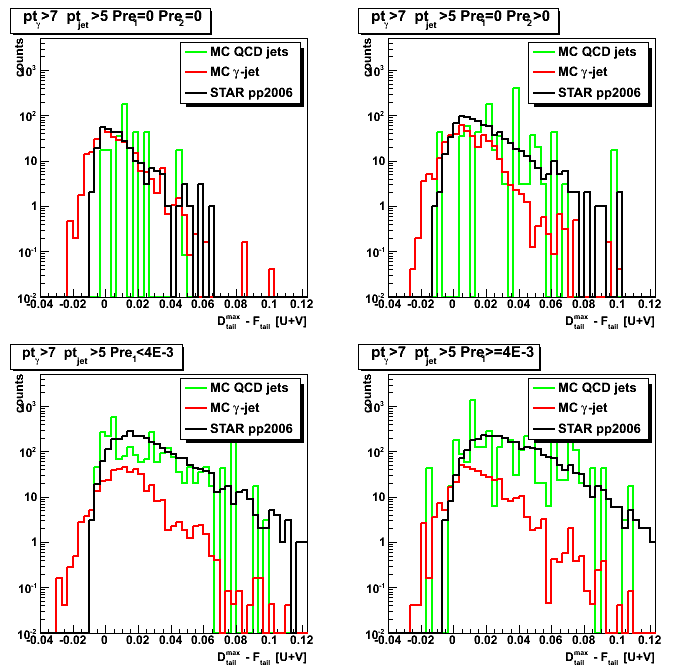
2008.08.27 Gamma-jet candidates detector position for different pre-shower conditions
Ilya Selyuzhenkov August 27, 2008
Data sets:
- pp2006 - STAR 2006 pp longitudinal data (~ 3.164 pb^1) after applying gamma-jet isolation cuts.
- gamma-jet - data-driven Pythia gamma-jet sample (~170K events). Partonic pt range 5-35 GeV.
- QCD jets - data-driven Pythia QCD jets sample (~4M events). Partonic pt range 3-65 GeV.
Figure 1: High u vs. v strip id distribution for different pre-shower conditions.
Left column: QCD jets, middle column: gamma-jet, right columnt: pp2006 data
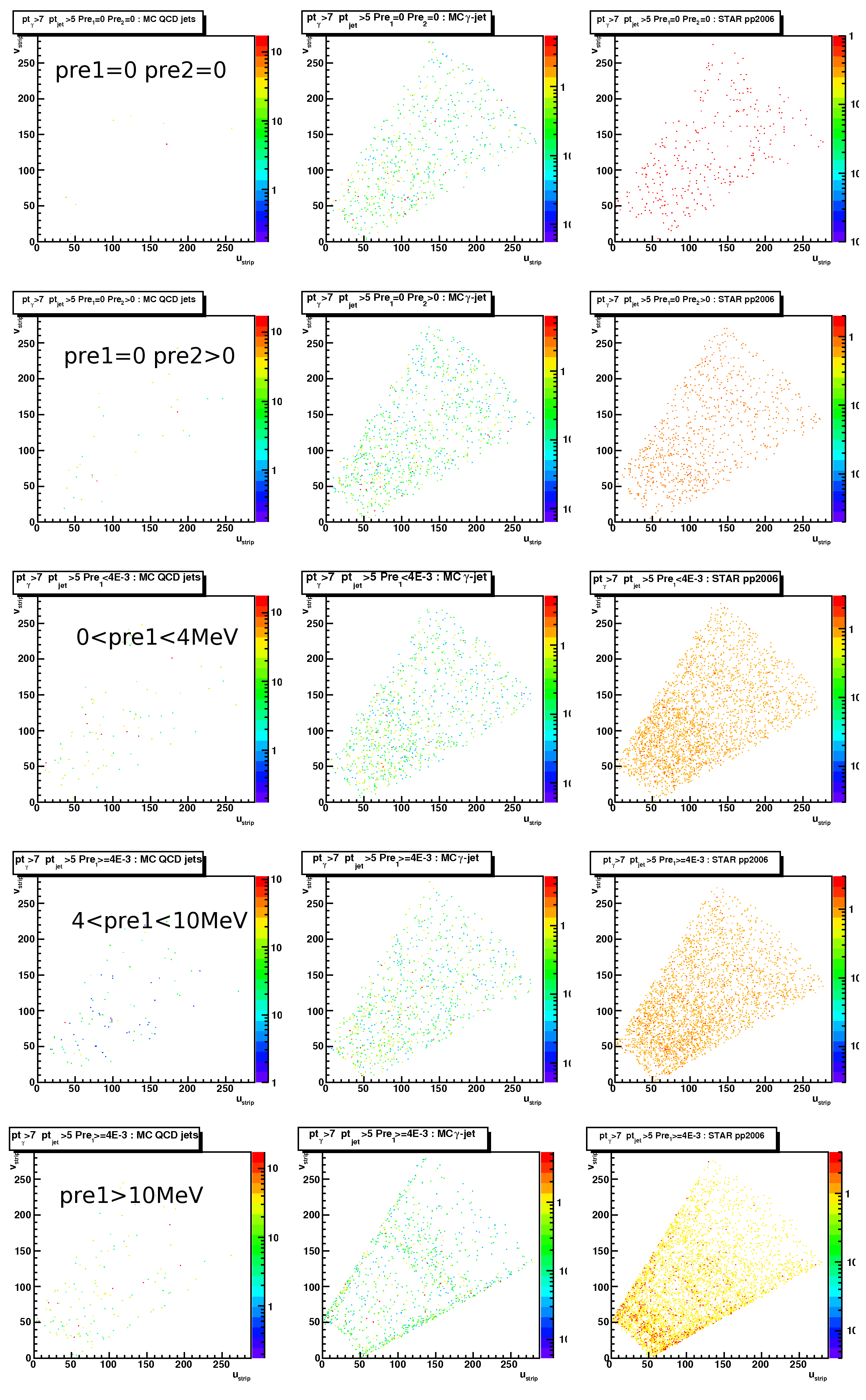
Figure 2: x vs. y position of the gamma-candidate within EEMC detector
for different pre-shower conditions.
Left column: QCD jets, middle column: gamma-jet, right columnt: pp2006 data
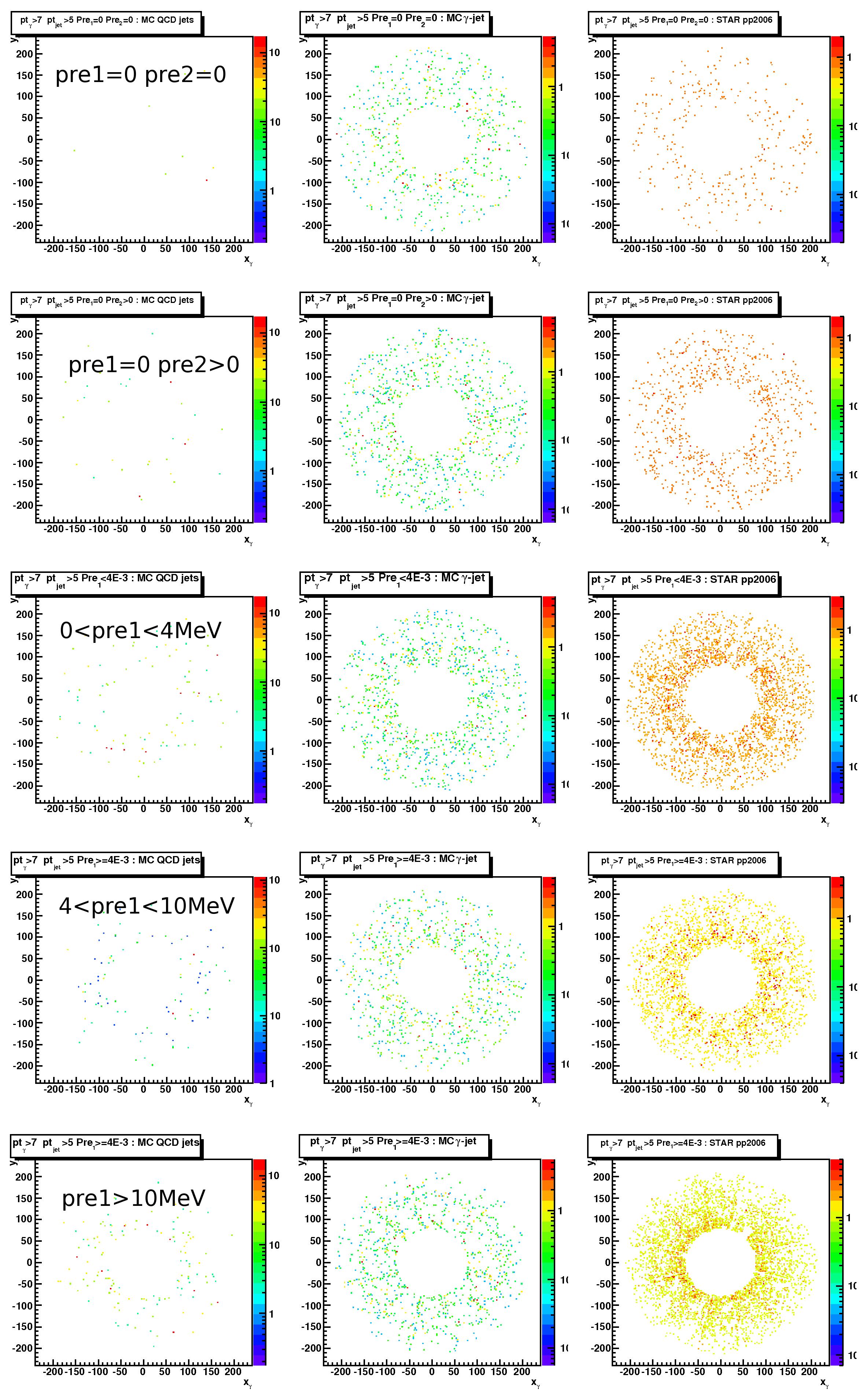
Figure 3:Reconstructed vs. generated (from geant record) gamma pt for the MC gamma-jet sample.
Pre-shower1<10MeV cut applied.
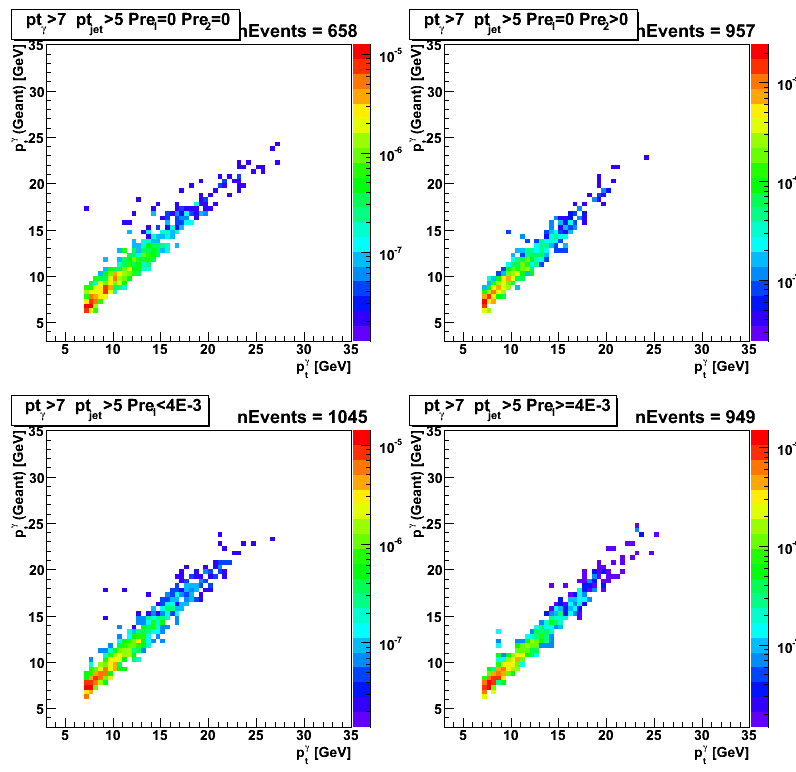
Figure 4:Reconstructed vs. generated (from geant record) gamma eta for the MC gamma-jet sample.
Pre-shower1<10MeV cut applied.
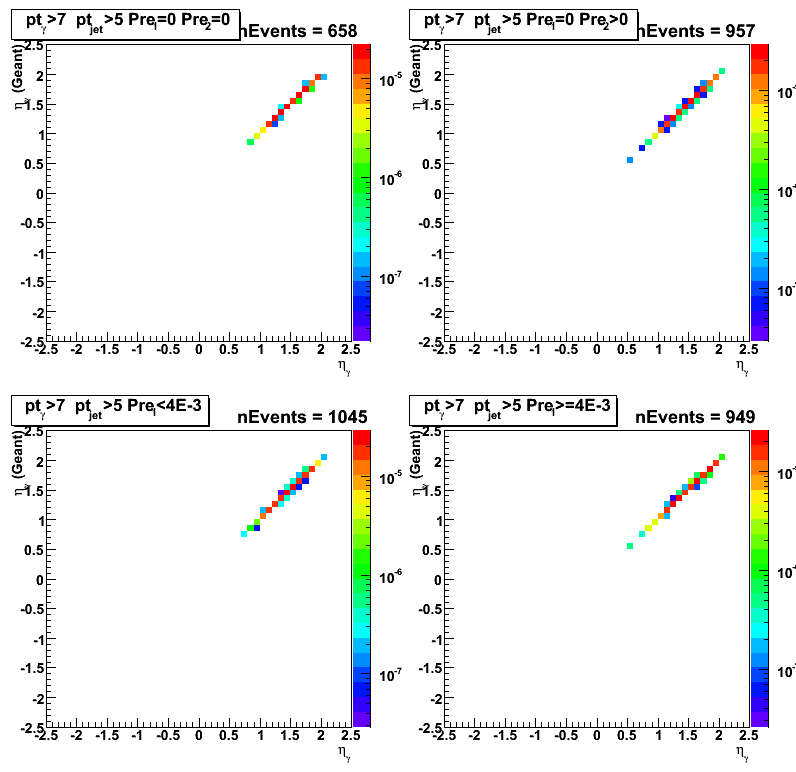
Figure 5:Reconstructed vs. generated (from geant record) gamma phi for the MC gamma-jet sample.
Pre-shower1<10MeV cut applied.
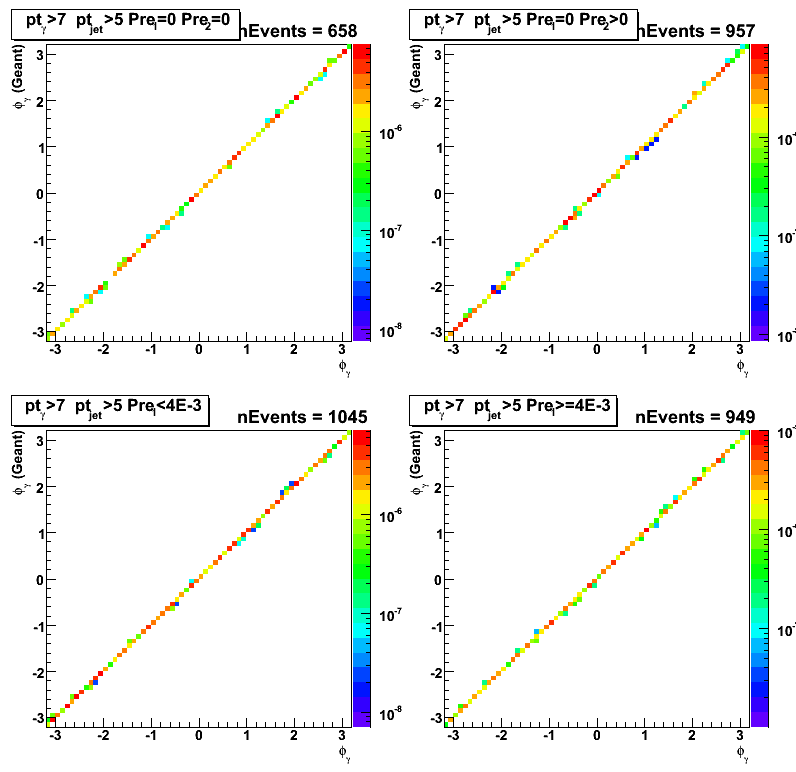
09 Sep
September 2008 posts
2008.09.02 Shower shape fits
Ilya Selyuzhenkov September 02, 2008
Data sets:
- pp2006 - STAR 2006 pp longitudinal data (~ 3.164 pb^1) after applying gamma-jet isolation cuts.
- gamma-jet - data-driven Pythia gamma-jet sample (~170K events). Partonic pt range 5-35 GeV.
- QCD jets - data-driven Pythia QCD jets sample (~4M events). Partonic pt range 3-65 GeV.
Shower shape fitting procedure:
- Fit with single Gaussian shape using 3 highest strips
- Fit with double Gaussian using 5 strips from each side of the peak [11 strips total]
First Gaussian parameters are fixed from the step above - Re-fit with double Gaussian with initial parameters from step 2 above
- Fit with triple Gaussian [fit range varies from 9 to 15 strips, default is 12 strips, see below]
Initial parameters for the first two Gaussian are fixed from step 3 above - Fit with triple Gaussian with initial parameters from step 4 above
(releasing all parameters except mean values)
Fitting function "[0]*(exp ( -0.5*((x-[1])/[2])**2 )+[3]*exp ( -0.5*((x-[4])/[5])**2 )+[6]*exp ( -0.5*((x-[7])/[8])**2 ))"
Fit results for MC gamma-jet data sample
Figure 1: MC gamma-jet shower shapes and fits for u-plane
Results from single, double and triple Gaussian fits (using from 9 to 15 strips) are shown.
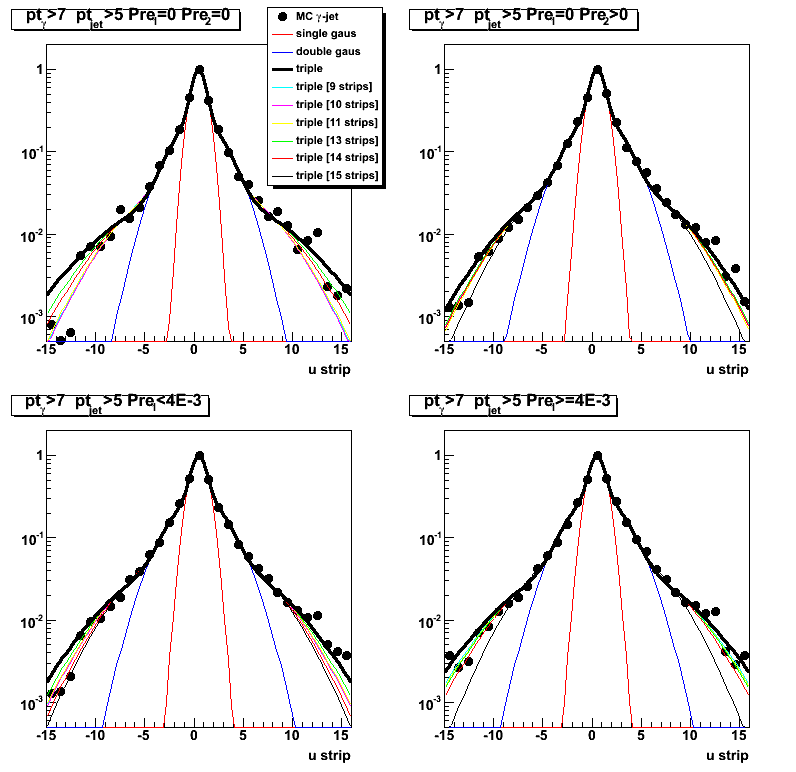
Figure 2: Same as figure 1. but from v-plane
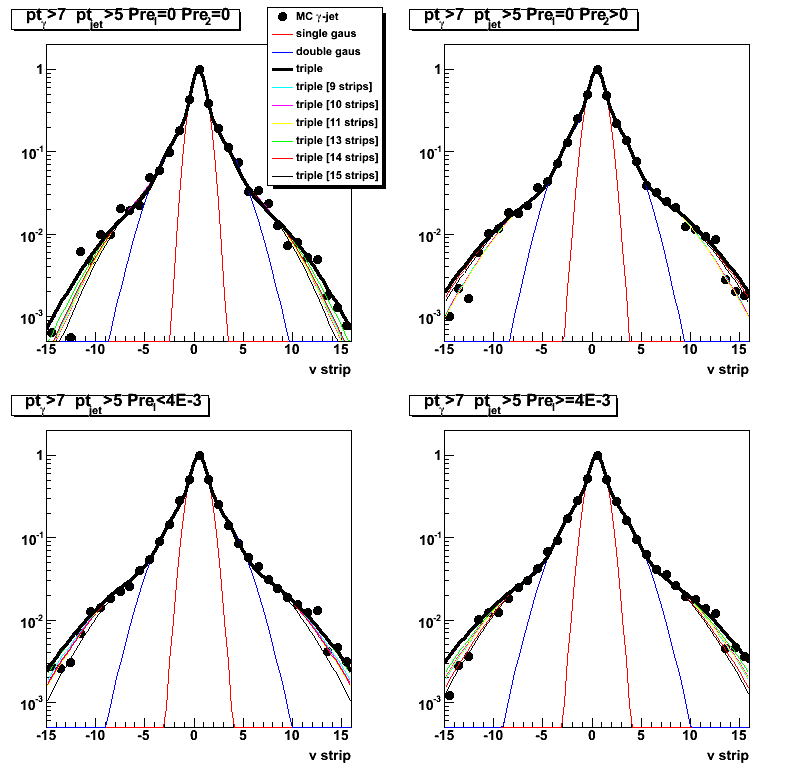
Figure 3: MC gamma-jet results using triple Gaussian fits within 12 strips from a peak.
Left: u-plane. Right: v-plane
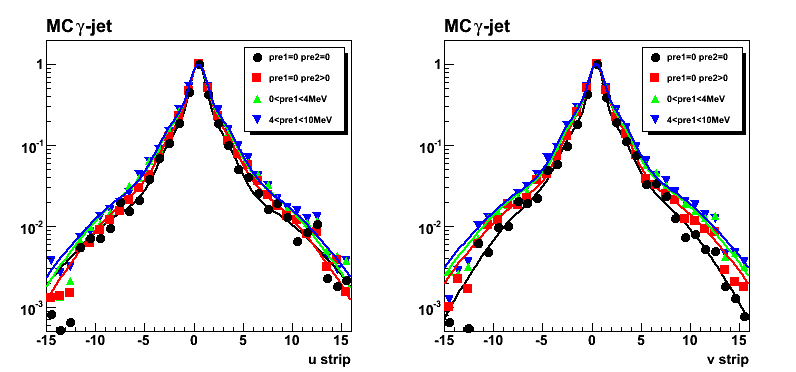
Figure 4: Combined fit results from MC gamma-jet sample
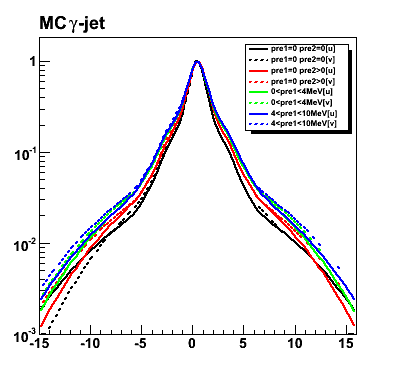
Figure 5: Fitting parameters [see equation for the fit function above].
Note, that parameters 1, 4, and 7 (peak position) has the same value.
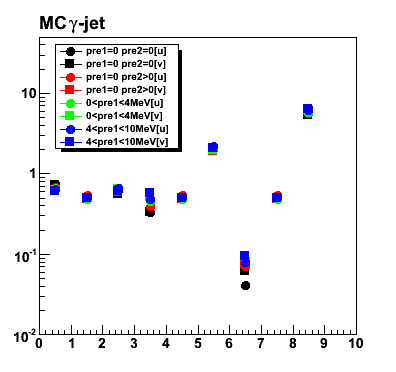
Numerical fit results:
- pre1=0 pre2=0 [u]: 0.602039*((exp(-0.5*sq((x-0.491324)/0.605927))+(0.578161*exp(-0.5*sq((x-0.491324)/2.05454))))+(0.0937517*exp(-0.5*sq((x-0.491324)/6.37656))))
- pre1=0 pre2=0 [v]: 0.729744*((exp(-0.5*sq((x-0.480945)/0.621631))+(0.327792*exp(-0.5*sq((x-0.480945)/2.01717))))+(0.0410935*exp(-0.5*sq((x-0.480945)/6.49599))))
- pre1=0 pre2>0 [u]: 0.725212*((exp(-0.5*sq((x-0.474451)/0.560416))+(0.3332*exp(-0.5*sq((x-0.474451)/1.91957))))+(0.0611053*exp(-0.5*sq((x-0.474451)/5.34357))))
- pre1=0 pre2>0 [v]: 0.686446*((exp(-0.5*sq((x-0.536662)/0.650485))+(0.388429*exp(-0.5*sq((x-0.536662)/1.99118))))+(0.0712328*exp(-0.5*sq((x-0.536662)/5.64637))))
- 0 <4MeV [u]: 0.612486*((exp(-0.5*sq((x-0.485717)/0.592415))+(0.55846*exp(-0.5*sq((x-0.485717)/1.87214))))+(0.0749598*exp(-0.5*sq((x-0.485717)/6.12462))))
- 0 <4MeV [v]: 0.651584*((exp(-0.5*sq((x-0.486876)/0.652023))+(0.450767*exp(-0.5*sq((x-0.486876)/2.07667))))+(0.0864232*exp(-0.5*sq((x-0.486876)/5.84357))))
- 4 <10MeV [u]: 0.621905*((exp(-0.5*sq((x-0.496841)/0.632917))+(0.512575*exp(-0.5*sq((x-0.496841)/1.97482))))+(0.0927374*exp(-0.5*sq((x-0.496841)/6.10844))))
- 4 <10MeV [v]: 0.634943*((exp(-0.5*sq((x-0.505378)/0.660763))+(0.480929*exp(-0.5*sq((x-0.505378)/2.17312))))+(0.0788037*exp(-0.5*sq((x-0.505378)/6.21667))))
Fit results for pp2006 gamma-jet candidates
Figure 6: Same as Fig. 3, but for gamma-jet candidates from pp2006 data
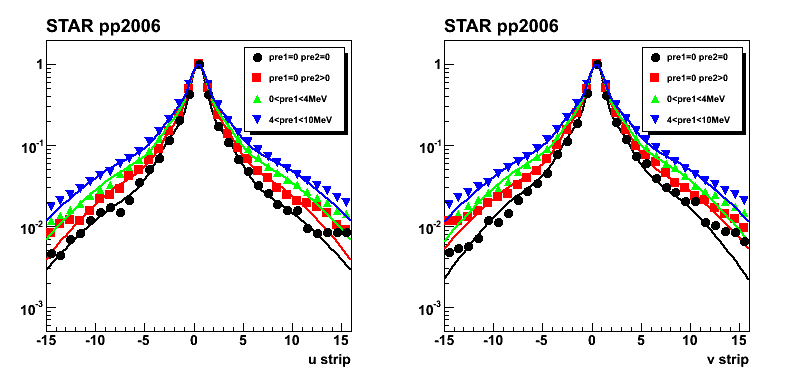
Figure 7: Same as Fig. 5, but for gamma-jet candidates from pp2006 data
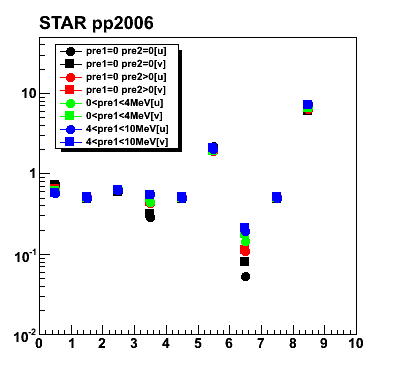
2008.09.09 Maximum sided residual with shower shapes sorted by uv- and pre-shower bins
Ilya Selyuzhenkov September 09, 2008
Data sets:
- pp2006 - STAR 2006 pp longitudinal data (~ 3.164 pb^1) after applying gamma-jet isolation cuts.
- gamma-jet - data-driven Pythia gamma-jet sample (~170K events). Partonic pt range 5-35 GeV.
- QCD jets - data-driven Pythia QCD jets sample (~4M events). Partonic pt range 3-65 GeV.
Procedure to calculate maximum sided residual:
-
For each event fit SMD u and v energy distributions with
triple Gaussian functions from shower shapes analysis:[0]*(exp(-0.5*((x-[1])/[2])**2)+[3]*exp(-0.5*((x-[1])/[4])**2)+[6]*exp(-0.5*((x-[1])/[5])**2))
Fit parameters sorted by various pre-shower conditions and u and v-planes can be found here
There are only two free parameters in a final fit: overall amplitude [0] and mean value [1]
Fit range is +-2 strips from the high strip (5 strips total). -
Integrate energy from a fit within +-2 strips from high strip.
This is our peak energy from fit, F_peak. -
Calculate tail energies on left and right sides from the peak for both data, D_tail, and fit, F_tail.
Tails are integrated up to 30 strips excluding 5 highest strips.
Determine maximum difference between D_tail and F_tail:
max(D_tail-F_tail). This is our maximum sided residual. -
Plot F_peak vs. max(D_tail-F_tail). This is sided residual plot.
-
(implementation for this item is in progress)
Based on MC gamma-jet sided residual plot find a line (some polynomial function)
which will serve as a cut to separate signal and background.
Use that cut line to calculate signal to background ratio
and apply it for the real data analysis.
Figure 1: Maximum sided residual plots for different data sets and various pre-shower condition.
Columns [data sets]: 1. MC QCD background; 2. gamma-jet; 3. pp2006 data
Rows [pre-shower bins]: 1. pre1=0 pre2=0; 2. pre1=0, pre2>0; 3. 0<pre1<4MeV; 4. 4<pre1<10MeV
Results from u and v plane are combined as [U+V]/2
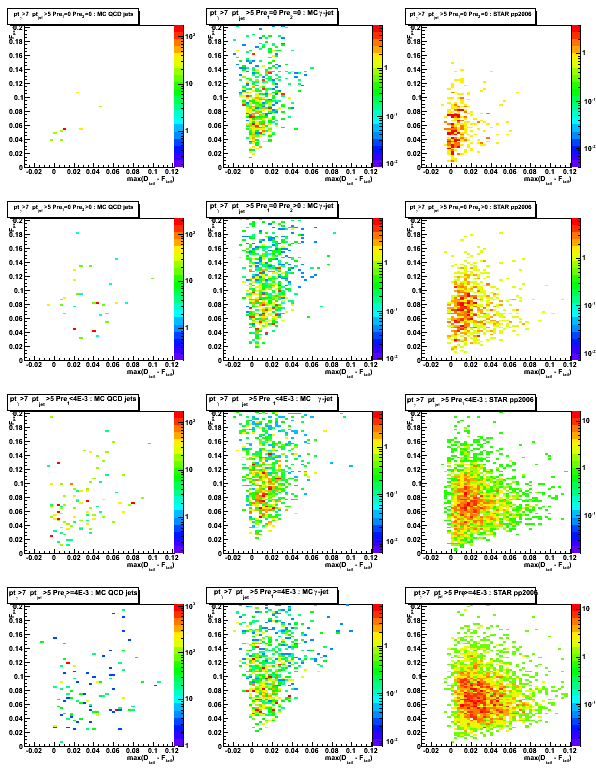
Figure 2: max(D_tail-F_tail) distribution (projection on horizontal axis from Fig.1)
Some observations:
Results for pp2006 and MC gamma-jet are consistent for pre1=0 pre2=0 case (upper left plot)
Results for pp2006 and MC QCD background jets are also in agrees for pre1>0 case (lower left and right plots)
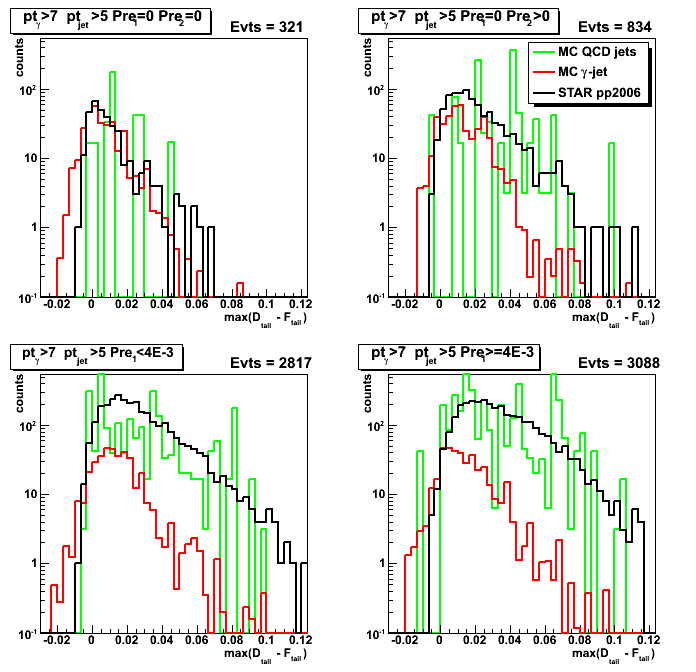
Figure 3: F_peak distribution (projection on vertical axis from Fig.1)
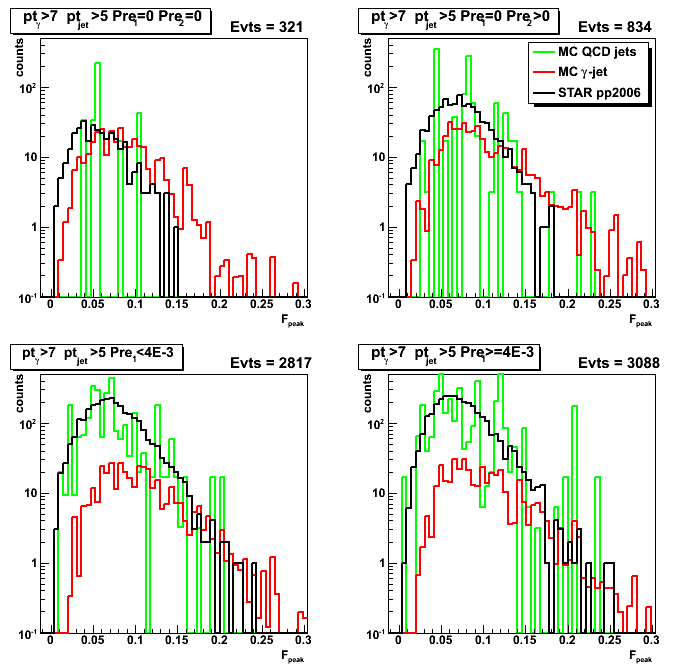
2008.09.16 QA plots for maximum sided residual (obsolete)
Ilya Selyuzhenkov September 16, 2008
These results are obsolete.
Please use this link instead
Data sets:
- pp2006 - STAR 2006 pp longitudinal data (~ 3.164 pb^1) after applying gamma-jet isolation cuts.
- gamma-jet - data-driven Pythia gamma-jet sample (~170K events). Partonic pt range 5-35 GeV.
- QCD jets - data-driven Pythia QCD jets sample (~4M events). Partonic pt range 3-65 GeV.
Notations used in the plots:
- Fit peak energy:
F_peak - integral within +-2 strips from maximum strip
Maximum strip determined by fitting procedure.
Float value converted ("cutted") to integer value. - Data peak energy:
D_peak - energy sum within +-2 strips from maximum strip (the same strip Id as for F_peak). - Data tails:
D_tail^left and D_tail^right.
Energy sum from 3rd strip up to 30 strips on the
left and right sides from maximum strip (excludes strips which contributes to D_peak) - Fit tails:
F_tail^left and F_tail^right.
Same definition as for D_tail, but integrals are calculated from a fit function. - Maximum sided residual:
max(D_tail-F_tail)
Maximum of the data minus fit energy on the left and right sides from the peak.
Figure 1: D_peak from [U+V]/2.

Figure 2: U/V asymmetry for D_peak: [U-V]/[U+V]

Figure 3: F_peak from [U+V]/2.

Figure 4: U/V asymmetry for F_peak: [U-V]/[U+V]

Figure 5: (D_peak - F_peak)/D_peak asymmetry

2008.09.23 QA plots for maximum sided residual (bug fixed update)
Ilya Selyuzhenkov September 23, 2008
Data sets:
- pp2006 - STAR 2006 pp longitudinal data (~ 3.164 pb^1)
after applying gamma-jet isolation cuts (note: R_cluster > 0.9 is used below). - gamma-jet - data-driven Pythia gamma-jet sample (~170K events). Partonic pt range 5-35 GeV.
- QCD jets - data-driven Pythia QCD jets sample (~4M events). Partonic pt range 3-65 GeV.
Notations used in the plots:
- Fit peak energy:
F_peak - integral within +-2 strips from maximum strip
Maximum strip determined by fitting procedure.
Float value converted ("cutted") to integer value. - Data peak energy:
D_peak - energy sum within +-2 strips from maximum strip (the same strip Id as for F_peak). - Data tails:
D_tail^left and D_tail^right.
Energy sum from 3rd strip up to 30 strips on the
left and right sides from maximum strip (excludes strips which contributes to D_peak) - Fit tails:
F_tail^left and F_tail^right.
Same definition as for D_tail, but integrals are calculated from a fit function. - Maximum sided residual:
max(D_tail-F_tail)
Maximum of the data minus fit energy on the left and right sides from the peak.
Figure 1: D_peak from [U+V]/2.

Figure 2: (D_peak - F_peak)/D_peak asymmetry

2008.09.23 Right-left SMD tail asymmetries
Ilya Selyuzhenkov September 23, 2008
Figure 1: D_peak vs. [right-left] D_tail
2008.09.23 Sided residual plot projection: toward s/b efficency/rejection plot
Ilya Selyuzhenkov September 23, 2008
Data sets:
- pp2006 - STAR 2006 pp longitudinal data (~ 3.164 pb^1)
after applying gamma-jet isolation cuts (note: R_cluster > 0.9 is used below). - gamma-jet - data-driven Pythia gamma-jet sample (~170K events). Partonic pt range 5-35 GeV.
- QCD jets - data-driven Pythia QCD jets sample (~4M events). Partonic pt range 3-65 GeV.
Notations used in the plots:
- Fit peak energy:
F_peak - integral within +-2 strips from maximum strip
Maximum strip determined by fitting procedure.
Float value converted ("cutted") to integer value. - Data peak energy:
D_peak - energy sum within +-2 strips from maximum strip (the same strip Id as for F_peak). - Data tails:
D_tail^left and D_tail^right.
Energy sum from 3rd strip up to 30 strips on the
left and right sides from maximum strip (excludes strips which contributes to D_peak) - Fit tails:
F_tail^left and F_tail^right.
Same definition as for D_tail, but integrals are calculated from a fit function. - Maximum sided residual:
max(D_tail-F_tail)
Maximum of the data minus fit energy on the left and right sides from the peak.
Maximum sided residual: MC vs. data comparison
Figure 1: Maximum sided residual plot
Top get more statistics for MC QCD sample plot is redone with a softer R_cluster > 0.9 cut
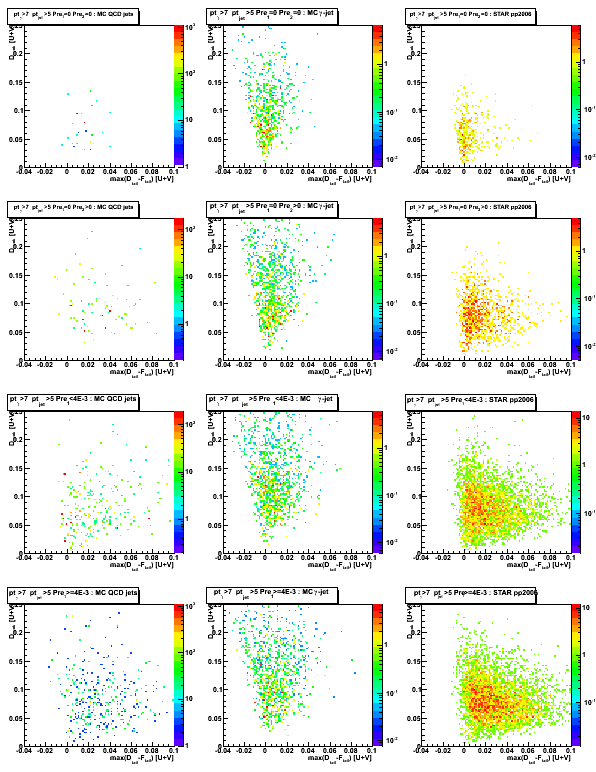
Figure 2: D_peak (projection on vertical axis for Fig. 1)
Upper left plot (no pre-shower fired case) reveals some difference
between MC gamma-jet and pp2006 data at lower D_peak values.
This difference could be due to background contribution at low energies.
Still needs more statistics for MC QCD jet sample to confirm that statement.

Figure 3: max(D_tail-F_tail) (projection on horisontal axis for Fig. 1)
One can get an idea of signal/background separation (red vs. black) depending on pre-shower condition.
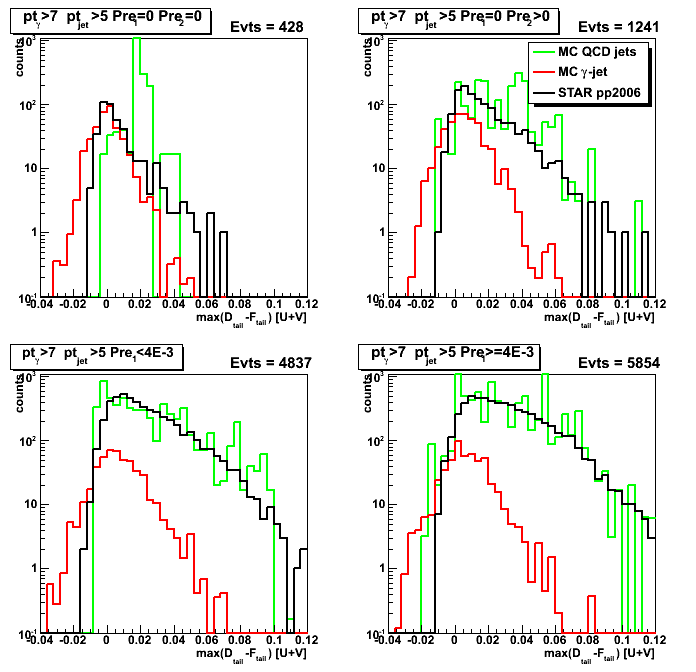
Figure 4: Mean < max(D_tail-F_tail) > vs. D_peak (profile on vertical axis from Fig. 1)
For gamma-jet sample average sided residual is independent on D_peak energy
and has a slight positive shift for all pre-shower>0 conditions.
For large D_peak values (D_peak>0.16) MC gamma-jet and pp2006 data results are getting close to each other.
This corresponds to higher energy gammas, where we have a better signal/background ratio,
and thus more real gammas among gamma-jet candidates from pp2006 data.
(Note: legend's color coding is wrong, colors scheme is the same as in Fig. 3)
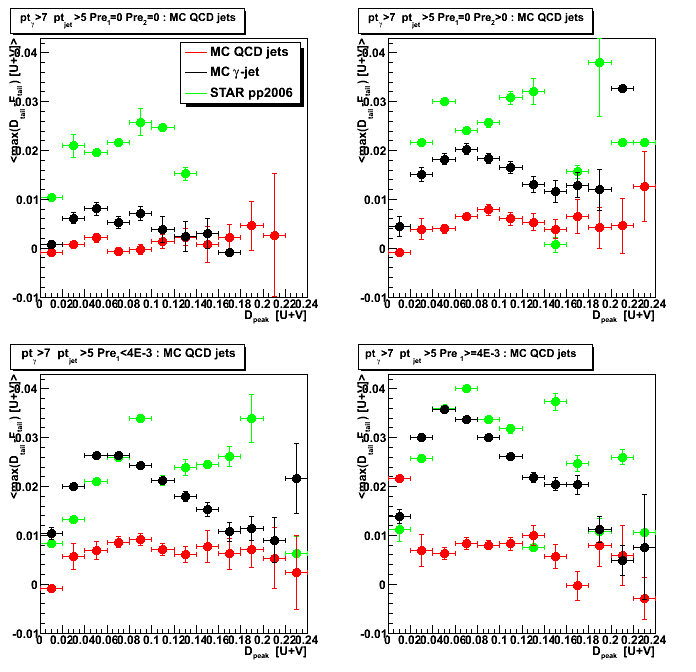
Figure 5: Mean < D_peak > vs. max(D_tail-F_tail) (profile on horisontal axis from Fig. 1)
For "no-preshower fired" case MC gamma-jet sample has a large average values than that from pp2006 data.
This reflects the same difference between pp2006 and MC gamma-jet sample at small D_peak values (see Fig. 2, upper left plot).
(Note: legend's color coding is wrong, colors scheme is the same as in Fig. 3)
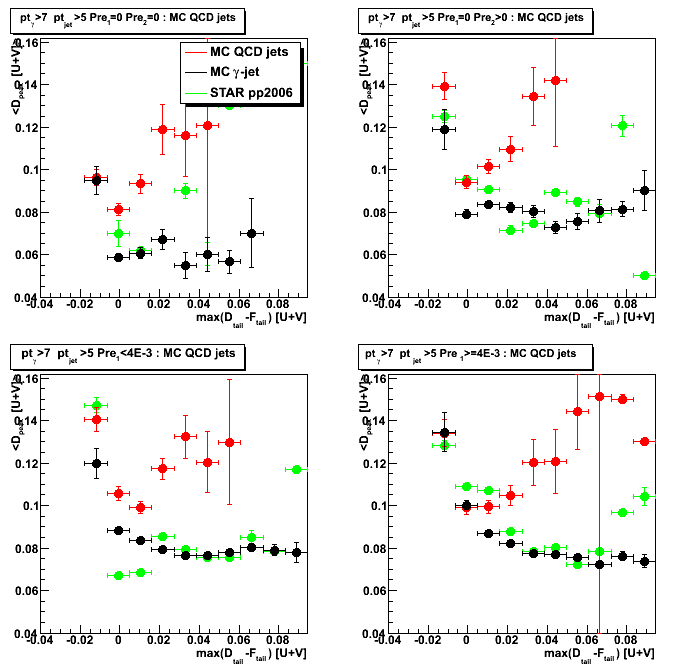
Figure 7: D_peak vs. gamma 3x3 tower cluster energy
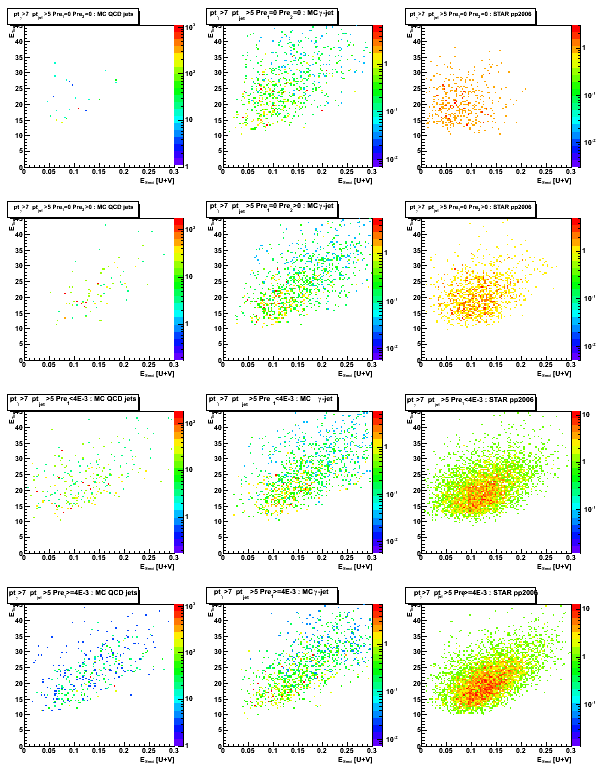
Figure 8: 3x3 cluster tower energy distribution
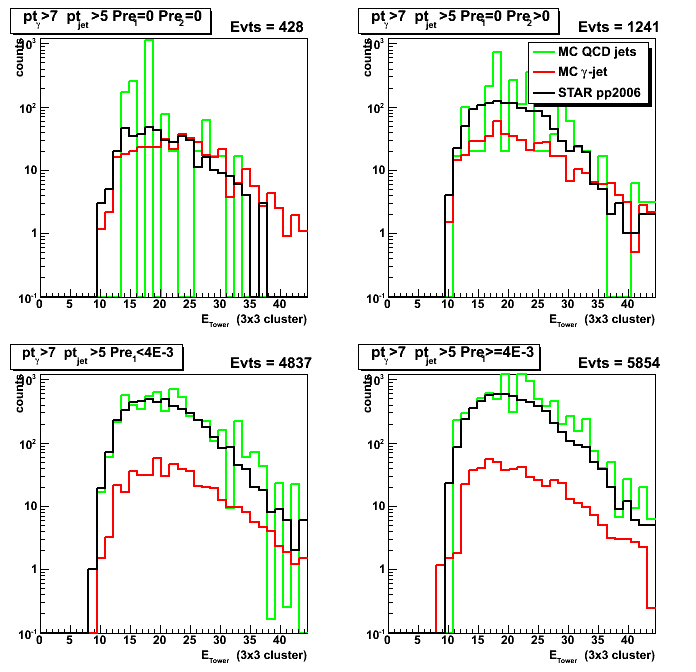
Figure 9: Gamma pt distribution
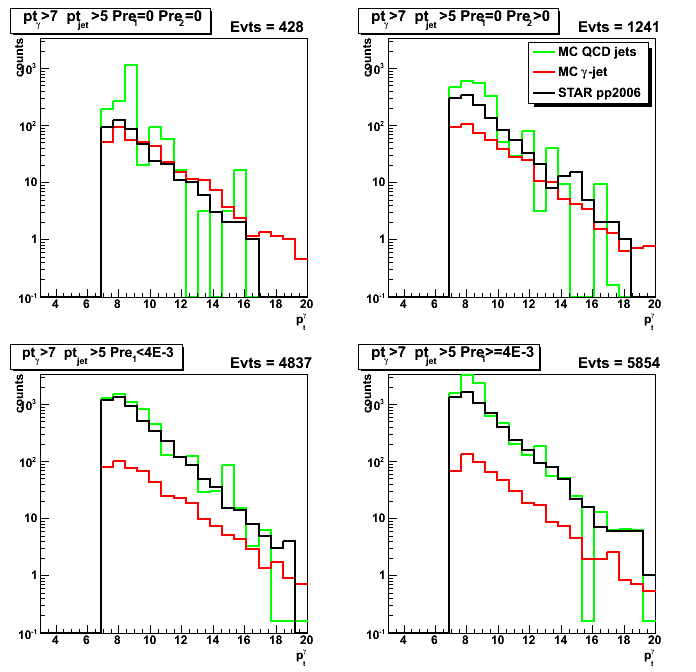
Signal/background separation
The simplest way to get signal/background separation is to draw a straight line
on sided residual plot (Fig. 1) in such a way that
it will contains most of the counts (signal) on the left side,
and use a distance to that line for both MC and pp2006 data samples
as a discriminant for signal/background separation.
To get the distance to the straight line one can rotate sided residual plot
by the angle which corresponds to the slope of this line,
and then project it on "rotated" max(D_tail-F_tail) axis.
Figure 10: Shows "rotated" sided residual plot by "5/6*(pi/2)" angle (this angle has been picked by eye).
One can see that now most of the counts for gamma-jet sample (middle column)
are on the left side from vertical axis.
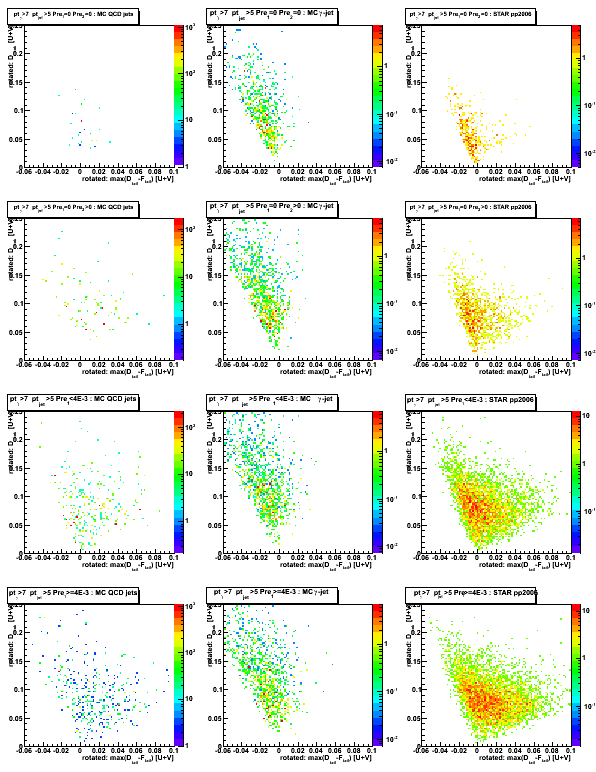
Figure 11: "Rotated" max(D_tail-F_tail) [projection on horizontal axis for Fig. 10]
Cut on "Rotated" max(D_tail-F_tail) can be used for signal/background separation.
From figure below one can see much better signal/background separation than in Fig. 3
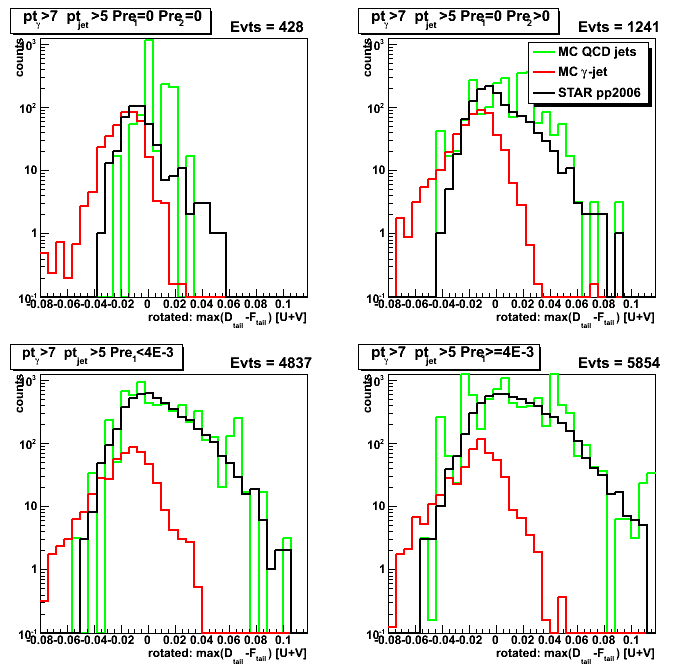
Figure 12: "Rotated" D_peak [projection on vertical axis for Fig. 10]
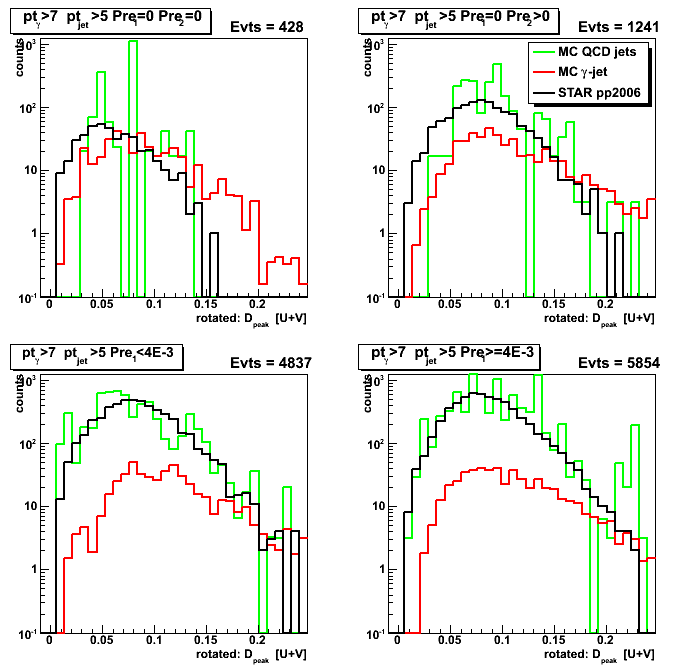
Optimizing the shape of s/bg separation line
Ideally, instead of straight line one needs to use
an actual shape of side residual distribution for MC gamma-jet sample.
This shape can be extracted and parametrized by the following procedure:
- Get slices from sided residual plot for different D_peak values
- From each slice get max(D_tail-F_tail) value
for which most of the counts appears on its left side (for example 80%), - Fit these set of points {D_peak slice, max(D_tail-F_tail)} with a polynomial function
The distance to that polynomial function can be used to determine our signal/background rejection efficiency.
This work is in progress...
Just last one figure showing shapes for 6 slices from sided plot.
Figure 13: max(D_tail-F_tail) for different slices in D_peak (scaled by the integral for each slice)
2008.09.30 Sided residual: purity, efficiency, and background rejection
Ilya Selyuzhenkov September 30, 2008
Data sets:
- pp2006 - STAR 2006 pp longitudinal data (~ 3.164 pb^1)
after applying gamma-jet isolation cuts (note: R_cluster > 0.9 is used below). - gamma-jet - data-driven Pythia gamma-jet sample (~170K events). Partonic pt range 5-35 GeV.
- QCD jets - data-driven Pythia QCD jets sample (~4M events). Partonic pt range 3-65 GeV.
Notations used in the plots:
- Fit peak energy:
F_peak - integral within +-2 strips from maximum strip
Maximum strip determined by fitting procedure.
Float value converted ("cutted") to integer value. - Data peak energy:
D_peak - energy sum within +-2 strips from maximum strip (the same strip Id as for F_peak). - Data tails:
D_tail^left and D_tail^right.
Energy sum from 3rd strip up to 30 strips on the
left and right sides from maximum strip (excludes strips which contributes to D_peak) - Fit tails:
F_tail^left and F_tail^right.
Same definition as for D_tail, but integrals are calculated from a fit function. - Maximum sided residual:
max(D_tail-F_tail)
Maximum of the data minus fit energy on the left and right sides from the peak.
Determining cut line based on sided residual plot
Figure 1: Sided residual plot: D_peak vs. max(D_tail-F_tail)
Red lines show 4th order polynomial functions, a*x^4,
which have 80% of MC gamma-jet counts on the left side.
These lines are obtained independently for each of pre-shower condition
based on fit procedure shown in Fig. 3 below.
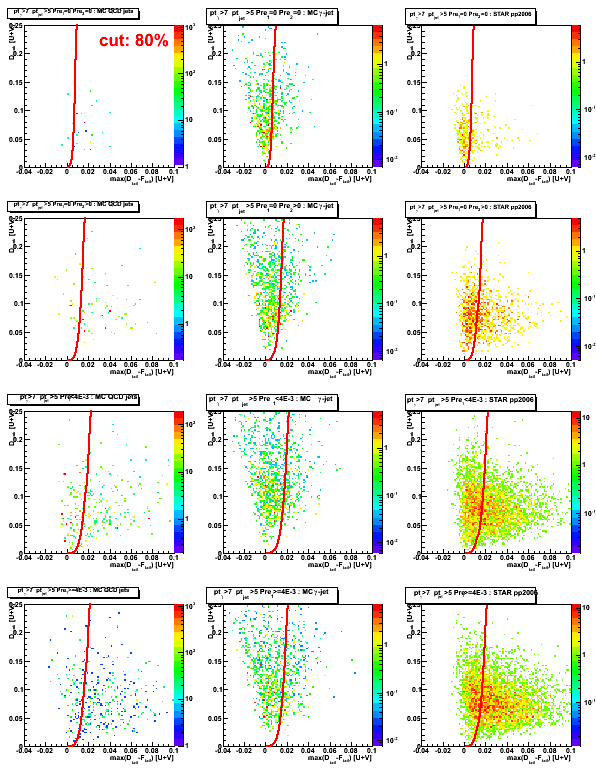
Figure 2: max(D_tail-F_tail) distribution
(projection on horizontal axis from sided residual plot, see Fig. 1 above)
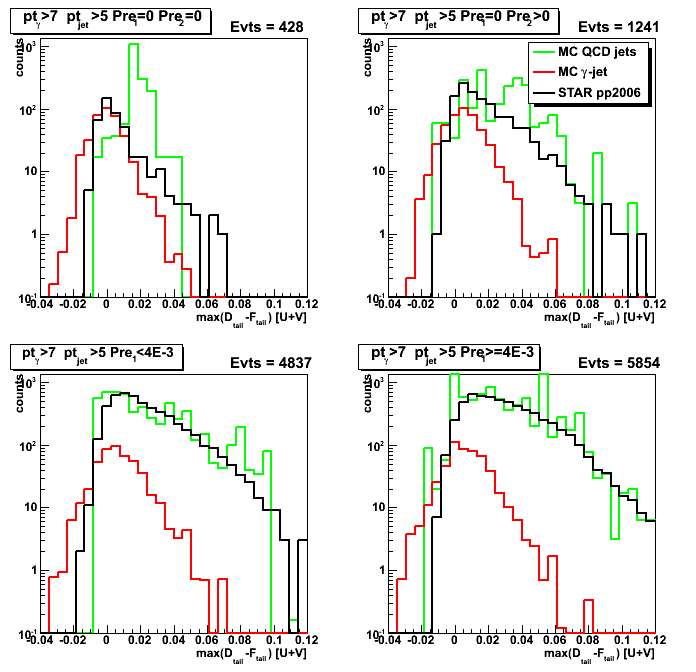
Figure 3: max(D_tail-F_tail) [at 80%] vs. D_peak.
For each slice (bin) in D_peak variable, the max(D_tail-F_tail) value
which has 80% of gamma-jet candidates on the left side are plotted.
Lines represent fits to MC gamma-jet points (shown in red) using different fit functions
(linear, 2nd, 4th order polynomials: see legend for color coding).
Note, that in this plot D_peak values are shown on horizontal axis.
Consequently, to get 2nd order polynomial fit on sided residual plot (Fig. 1),
one needs to use sqrt(D_peak) function.
The same apply to 4th order polynomial function.
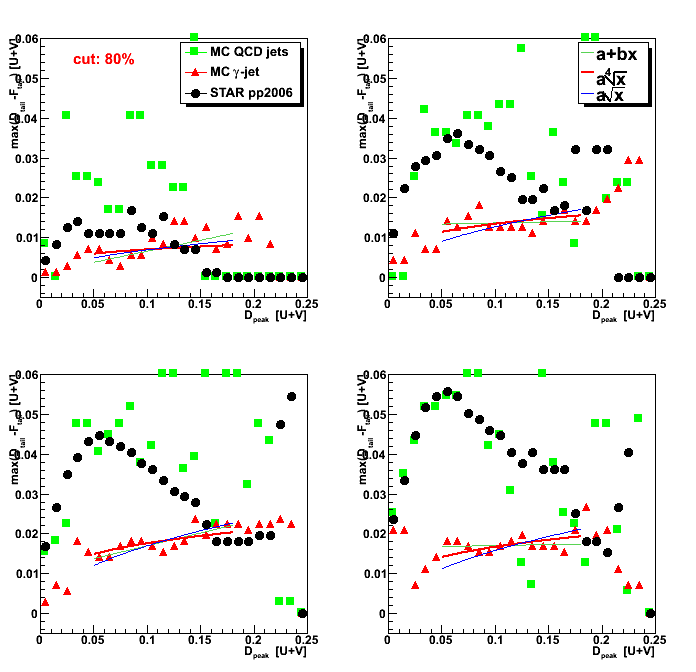
Figure 4: D_peak vs. horisontal distance from 4th order polinomial function to max(D_tail-F_tail) values.
(compare with Fig. 1: Now 80% of MC gamma-jet counts are on the left side from vertical axis)
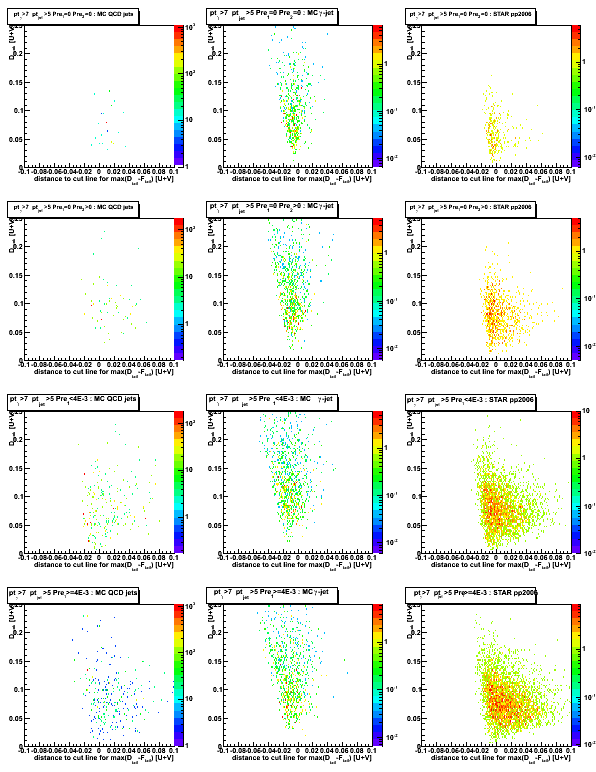
Figure 5: Horizontal distance from 4th order polynomial function to max(D_tail-F_tail)
[Projection on horizontal axis from Fig. 4]
Based on this plot one can obtain purity, efficiency, and rejection plots (see Fig. 6 below)
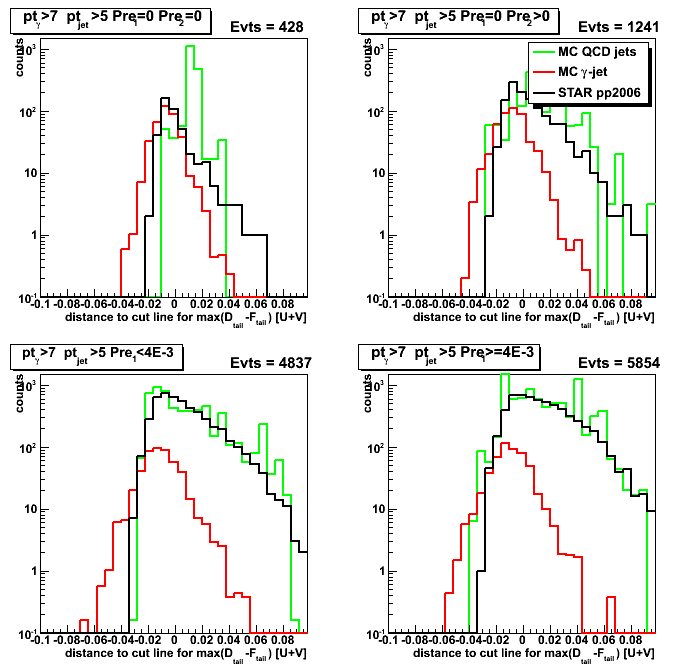
Gamma-jet purity, efficiency, and QCD background rejection
Horizontal distance plotted in Fig. 5 can be used as a cut
separating gamma-jet signal and QCD-jets background,
and for each value of this distance one can define
gamma-jet purity, efficiency, and QCD-background rejection:
-
gamma-jet purity is defined as the ratio of
the integral on the left for MC gamma-jet data sample, N[g-jet]_left,
to the sum of the integrals on the left for MC gamma-jet and QCD jets, N[QCD]_left, data samples:
Purity[gamma-jet] = N[g-jet]_left/(N[g-jet]_left+N[QCD]_left) -
gamma-jet efficiency is defined as the ratio of
the integral on the left side for MC gamma-jet data sample, N[g-jet]_left,
to the total integral for MC gamma-jet data sample, N[g-jet]:
Efficiency[gamma-jet] = N[g-jet]_left/N[g-jet] -
QCD background rejection is defined as the ratio of
the integral on the right side for MC QCD jets data sample, N[QCD]_right,
to the total integral for MC QCD jets data sample, N[QCD]:
Rejection[QCD] = N[QCD]_right/N[QCD]
Figure 6: Shows:
purity[g-jet] vs. efficiency[g-jet] (upper left);
rejection[QCD] vs. efficiency[g-jet] (upper right);
purity[g-jet] vs. rejection[QCD] (lower left);
pp2006 to MC ratio, N[pp2006]/(N[g-jet]+N[QCD]), vs. horizontal distance from Fig. 5 (lower right)

10 Oct
October 2008 posts
2008.10.13 Jet trees for Michael's gamma filtered events
Ilya Selyuzhenkov October 13, 2008
I have finished production of jet trees for Michael's gamma filtered events
You can find jet and skim file lists in my directory at IUCF disk (RCF):
- Jet trees: /star/institutions/iucf/IlyaSelyuzhenkov/simu/JetTrees/JetTrees.list
- Skim trees: /star/institutions/iucf/IlyaSelyuzhenkov/simu/JetTrees/SkimTrees.list
- Log files: /star/institutions/iucf/IlyaSelyuzhenkov/simu/JetTrees/LogFiles.list
Number of jet events is 1284581 (1020 files).
Production size, including archived log files, is 4.0G.
The script to run jet finder:
/star/institutions/iucf/IlyaSelyuzhenkov/simu/JetTrees/20081008_gJet/StRoot/macros/RunJetSimuSkimFinder.C
JetFinder and JetMaker code:
/star/institutions/iucf/IlyaSelyuzhenkov/simu/JetTrees/20081008_gJet/StRoot/StJetFinder
/star/institutions/iucf/IlyaSelyuzhenkov/simu/JetTrees/20081008_gJet/StRoot/StJetMaker
For more details see these threads of discussions:
- jetfinding list: thread 814
- photon reconstruction list: thread 271 and thread 256
2008.10.14 Purity, efficiency, and background rejection: R_cluster > 0.98
Ilya Selyuzhenkov October 14, 2008
Data sets:
- pp2006 - STAR 2006 pp longitudinal data (~ 3.164 pb^1)
after applying gamma-jet isolation cuts (note: R_cluster > 0.98 is used below). - gamma-jet - data-driven Pythia gamma-jet sample (~170K events). Partonic pt range 5-35 GeV.
- QCD jets - data-driven Pythia QCD jets sample (~4M events). Partonic pt range 3-65 GeV.
Figure 1: Horizontal distance from 4th order polynomial function to max(D_tail-F_tail)
See this page for definition and more details
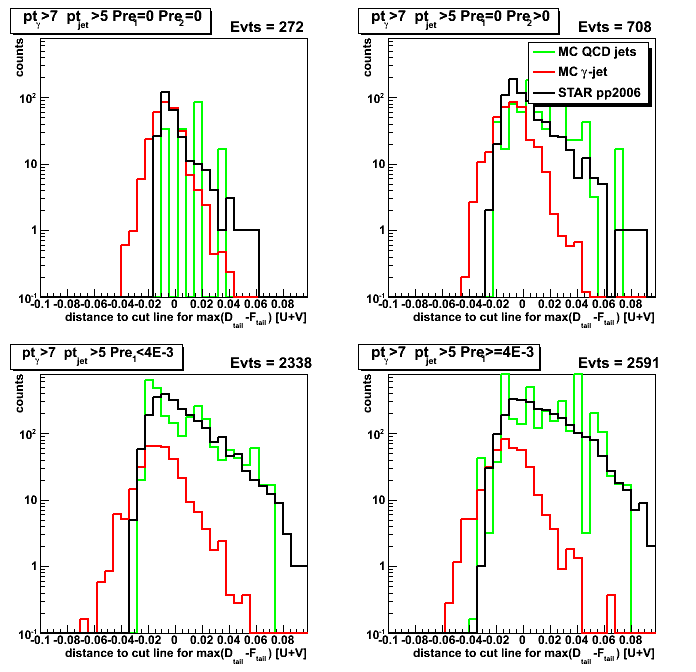
Figure 2:
purity[g-jet] vs. efficiency[g-jet] (upper left);
rejection[QCD] vs. efficiency[g-jet] (upper right);
purity[g-jet] vs. rejection[QCD] (lower left);
pp2006 to MC ratio, N[pp2006]/(N[g-jet]+N[QCD]), vs. horizontal distance (lower right)

2008.10.15 Comparison of gamma-jets from Michael's filtered events vs. old MC samples
Ilya Selyuzhenkov October 15, 2008
Data sets:
- pp2006 - STAR 2006 pp longitudinal data (~ 3.164 pb^1)
after applying gamma-jet isolation cuts (note: R_cluster > 0.9 is used below). - gamma-jet[gamma-filtered] - data-driven Prompt Photon [p6410EemcGammaFilter] events.
Partonic pt range 2-25 GeV. - QCD jets[gamma-filtered] - data-driven QCD [p6410EemcGammaFilter] events.
Partonic pt range 2-25 GeV. - gamma-jet [old] - data-driven Pythia gamma-jet sample (~170K events).
Partonic pt range 5-35 GeV.
Details on jet trees production for Michael's gamma filtered events can be found here. - QCD jets [old] - data-driven Pythia QCD jets sample (~4M events).
Partonic pt range 3-65 GeV.
Some observations:
- Both Fig. 1a vs. Fig. 1b shows good statistics for old and new (gamma-filtered) MC gamma-jet samples
- Fig. 1c shows poor statistics for QCD background sample
within partonic pt range 5-10GeV (only 3 counts for "pre1=0 & pre2=0" condition).
Fig. 1d (new QCD sample) has much more counts in the same region,
but it is still only 20-25 entries for the case when
none of EEMC pre-shower layers fired (upper left corner - our purest gamma-jet sample).
This may be still insufficient for a various cuts systematic study. - Fig. 2 and Fig. 3 shows nice agreement between data and MC
for both old and new (gamma-filtered) MC samples.
For pre-shower1>0 case this agreement persists across full range of gamma's pt (7GeV and above).
Upper plots in Fig. 3 shows some difference between data and Monte-Carlo,
what could be effect from l2gamma trigger,
which has not been yet applied for MC events.
Figure 1a: partonic pt for gamma-jet [old] events
after analysis cuts and partonic pt bin weighting
(Note:Arbitrary absolute scale)
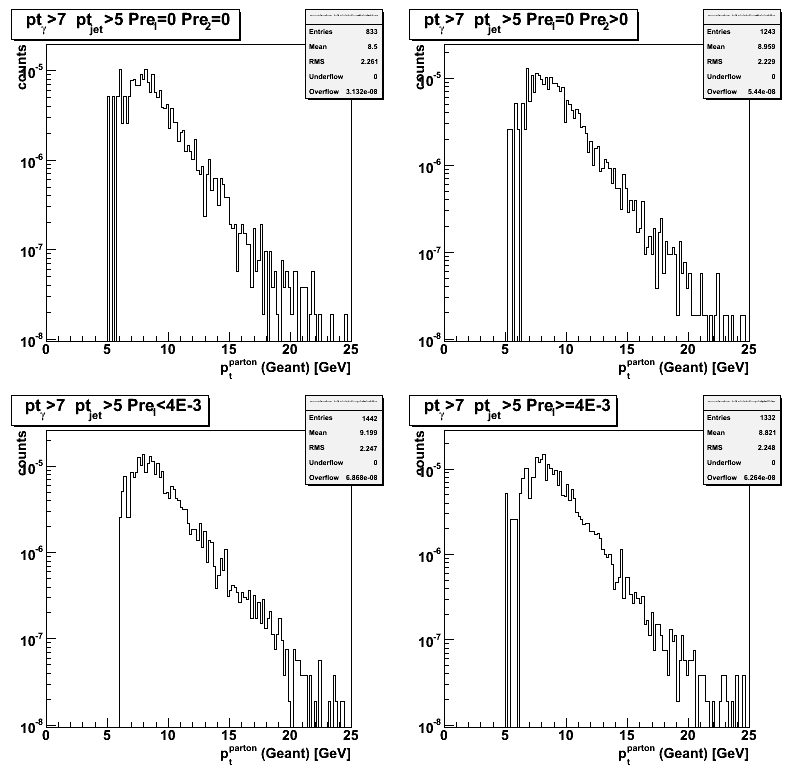
Figure 1b: partonic pt for gamma-jet [gamma-filtered] events after analysis cuts.
Michael's StBetaWeightCalculator has been used to caclulate partonic pt weights
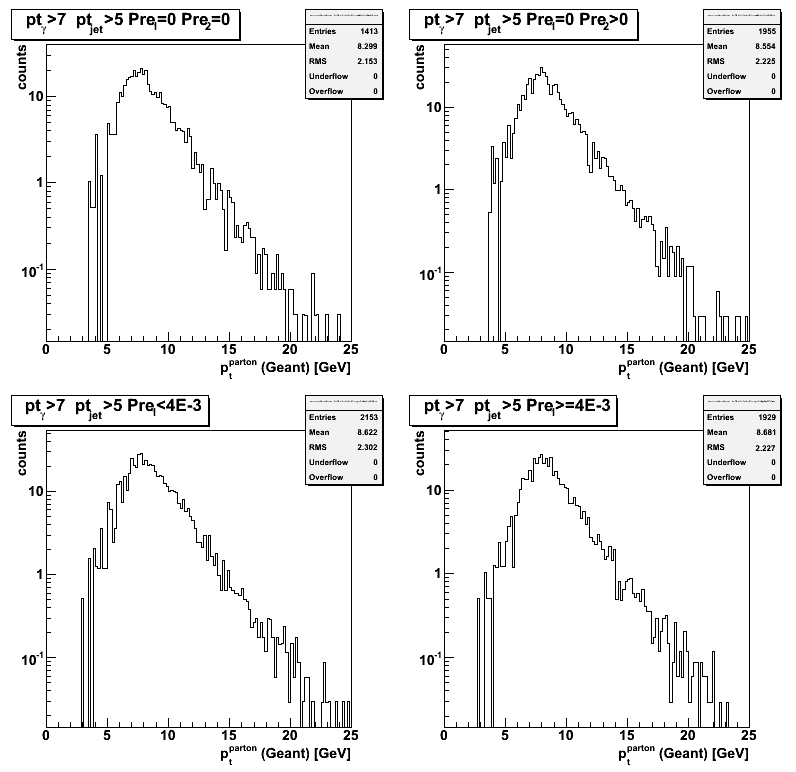
Figure 1c: partonic pt for QCD jets [old] events
after analysis cuts and partonic pt bin weighting
(Note:Arbitrary absolute scale)
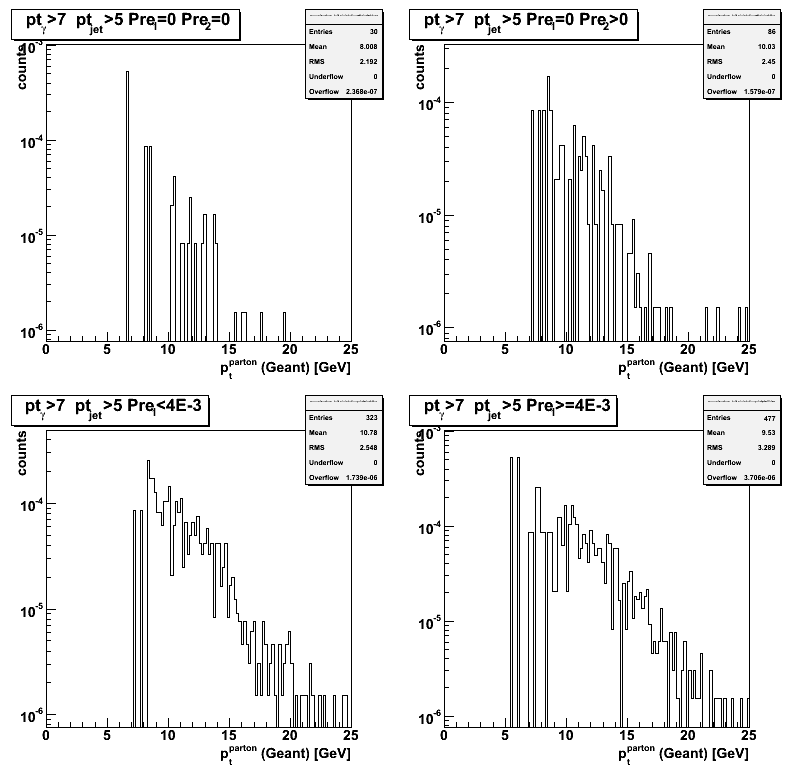
Figure 1d: partonic pt for QCD jets [gamma-filtered] events after analysis cuts.
Michael's StBetaWeightCalculator has been used to caclulate partonic pt weights
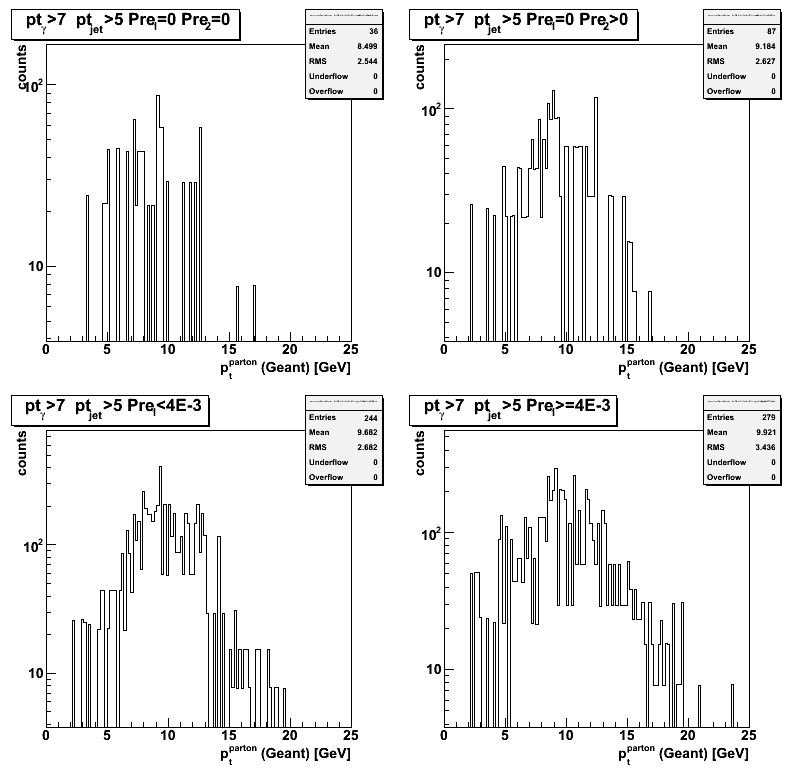
Figure 2: reconstructed gamma pt: old MC vs. pp2006 data (scaled to the same luminosity)

Figure 3: reconstructed gamma pt: gamma-filtered MC vs. pp2006 data (scaled to the same luminosity)

2008.10.15 Purity vs. efficiency from gamma-filtered events: R_cluster > 0.9 vs. R_cluster > 0.98
Ilya Selyuzhenkov October 15, 2008
Data sets:
- pp2006 - STAR 2006 pp longitudinal data (~ 3.164 pb^1)
after applying gamma-jet isolation cuts (note: R_cluster > 0.9 or > 0.98 is used below). - gamma-jet[gamma-filtered] - data-driven Prompt Photon [p6410EemcGammaFilter] events.
Partonic pt range 2-25 GeV. - QCD jets[gamma-filtered] - data-driven QCD [p6410EemcGammaFilter] events.
Partonic pt range 2-25 GeV.
Gamma-jet candidates from MC gamma filtered events: R_cluster > 0.9
Figure 1: Horizontal distance from sided residual plot: R_cluster > 0.9
(see Figs. 1-5 from this post for horizontal distance definition)
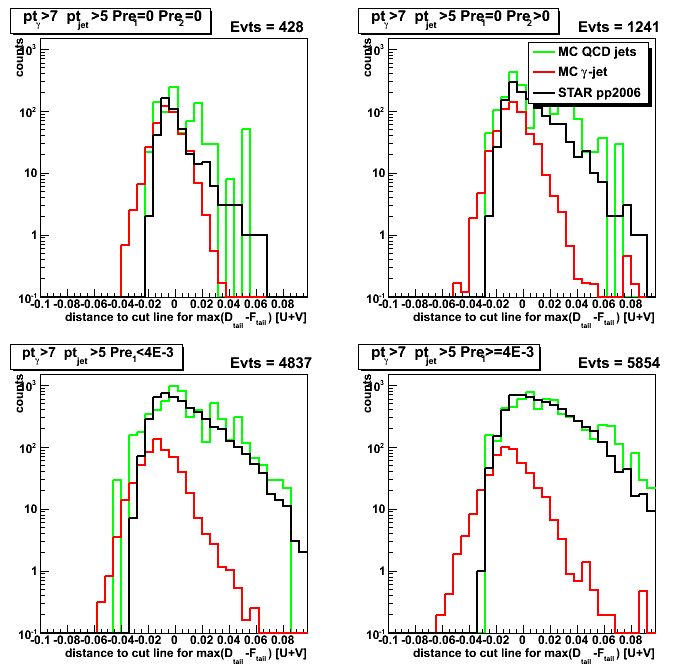
Figure 2: Purity/efficiency/rejection, and data to MC[gamma-jet+QCD] ratio plots: R_cluster > 0.9
(see text above Fig. 6 from this post for purity, efficiency, and background rejection definition)
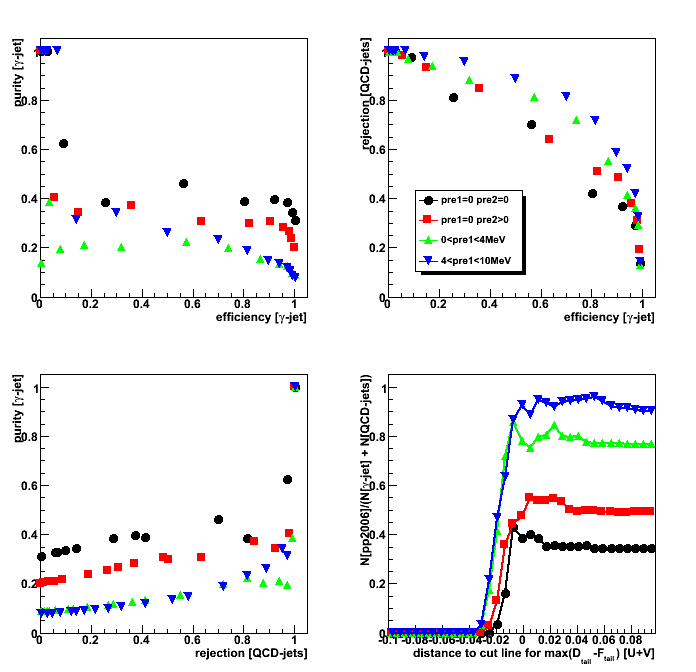
Gamma-jet candidates from MC gamma filtered events: R_cluster > 0.98
Figure 3: Reconstructed gamma pt: R_cluster > 0.98
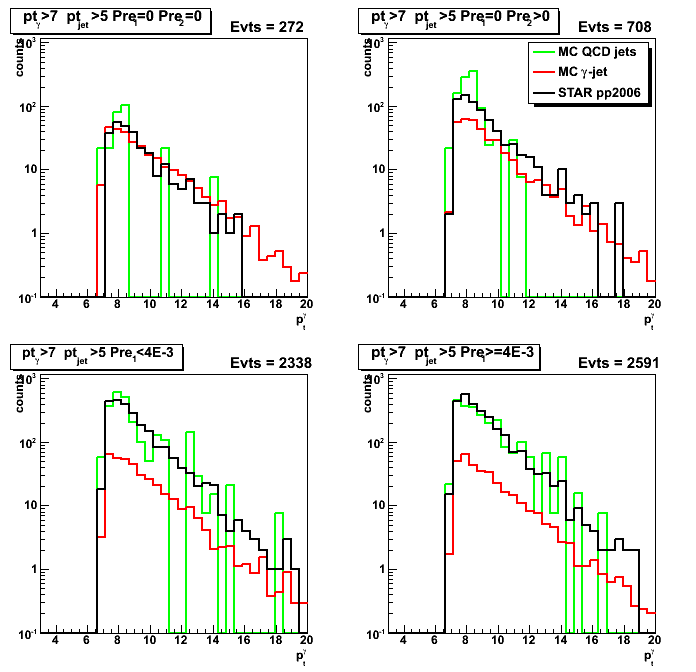
Figure 4: Horizontal distance from sided residual plot: R_cluster > 0.98
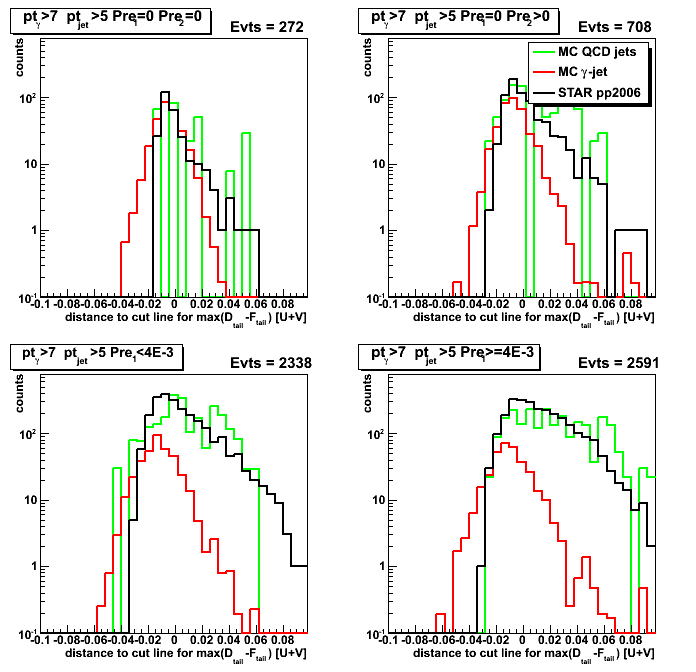
Figure 5: Purity/efficiency/rejection, and data to MC[gamma-jet+QCD] ratio plots: R_cluster > 0.98
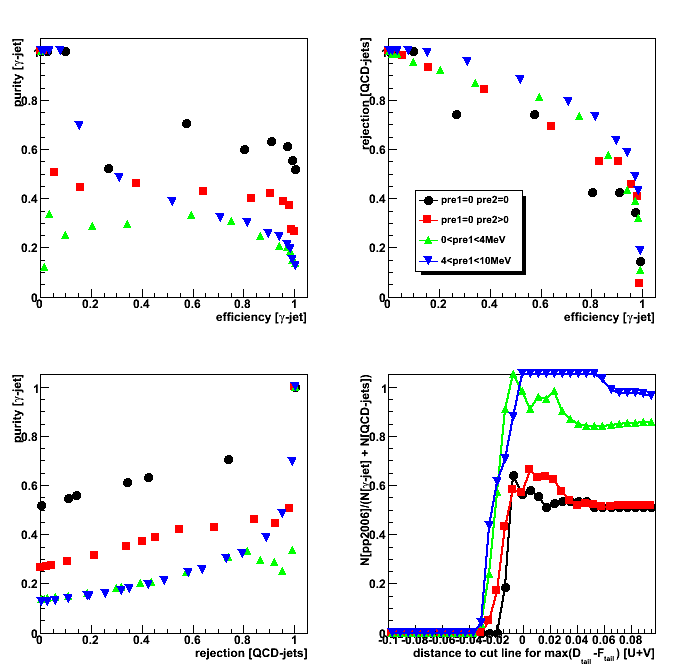
2008.10.21 Shower shapes, 5/25 strips cluster energy, raw vs. data-driven MC
Ilya Selyuzhenkov October 21, 2008
Data sets:
- pp2006 - STAR 2006 pp longitudinal data (~ 3.164 pb^1)
after applying gamma-jet isolation cuts (R_cluster > 0.9 is used below). - gamma-jet[gamma-filtered] - data-driven Prompt Photon [p6410EemcGammaFilter] events.
Partonic pt range 2-25 GeV. - QCD jets[gamma-filtered] - data-driven QCD [p6410EemcGammaFilter] events.
Partonic pt range 2-25 GeV.
Some comments:
- Overall comment: effect of data-driven shower shape replacement procedure
on QCD background events is small, except probably pre1=0 pre2=0 case. -
Fig. 1-3, upper left plots (pre1=0 pre2=0) show that
average energy per strip in data-driven gamma-jet MC (i.e. solid red square in Fig. 3)
is systematically higher than that for pp2006 data (black circles in Fig. 3).Note, that there is an agreement between SMD shower shapes
for pp2006 data and data-driven gamma-jet simulations
if one scales them to the same peak value
(Compare red vs. black in upper left plot from Fig. 1 at this link) -
Fig. 4, upper left plot (pre1=0 pre2=0):
Integrated SMD energy from 25 strips
in raw gamma-jet simulations (red line) match pp2006 data (black line)
in the region where signal to background ratio is high, E_smd(25-strips)>0.1GeV.
This indicates that raw MC does a good job in
reproducing total energy deposited by direct photon. -
Fig. 5, upper left plot (pre1=0 pre2=0):
There is mismatch between distributions of energy in 25 strips cluster
from data-driven gamma-jet simulations and pp2006 data.
This probably reflects the way we scale our library shower shapes
in data-driven shower shape replacement procedure.
Currently, the scaling factor for the library shape is calculated based on the ratio
of direct photon energy from Geant record to the energy of the library photon.
Our library is build out of photons from eta-meson decay,
which has been reconstructed by running pi0 finder.
The purity of the library is about 70% (see Fig. 1 at this post for more details).The improvement of scaling procedure could be to
preserve total SMD energy deposited within 25 strips from raw MC,
and use that energy to scale shower shapes from the library. -
Fig. 6, upper left plot (pre1=0 pre2=0):
Mismatch between integrated 5-strip energy for raw MC and pp2006 in Fig. 6
corresponds to "known" difference in shower shapes from raw Monte-Carlo and real data.
Figure 1: SMD shower shapes: data, raw, and data-driven MC (40 strips).
Vertical axis shows average energy per strip (no overall shower shapes scaling)
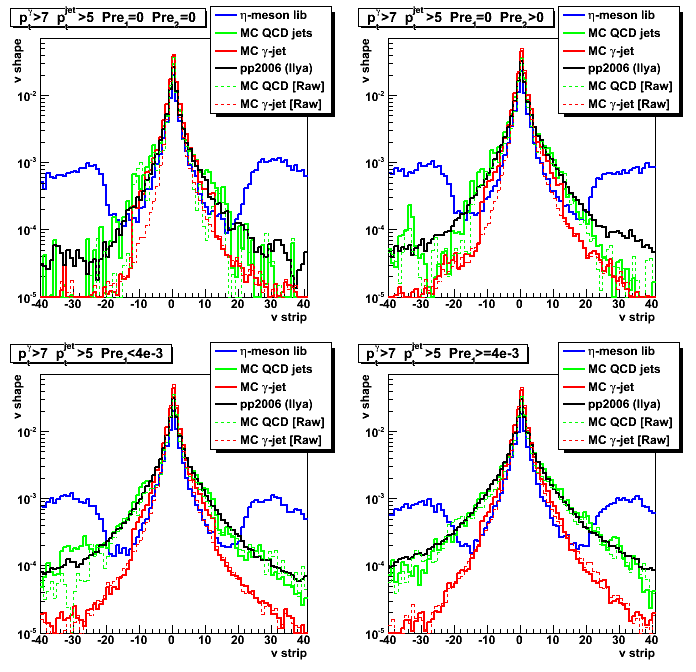
Figure 2: Shower shapes: data, raw, and data-driven MC (12 strips)
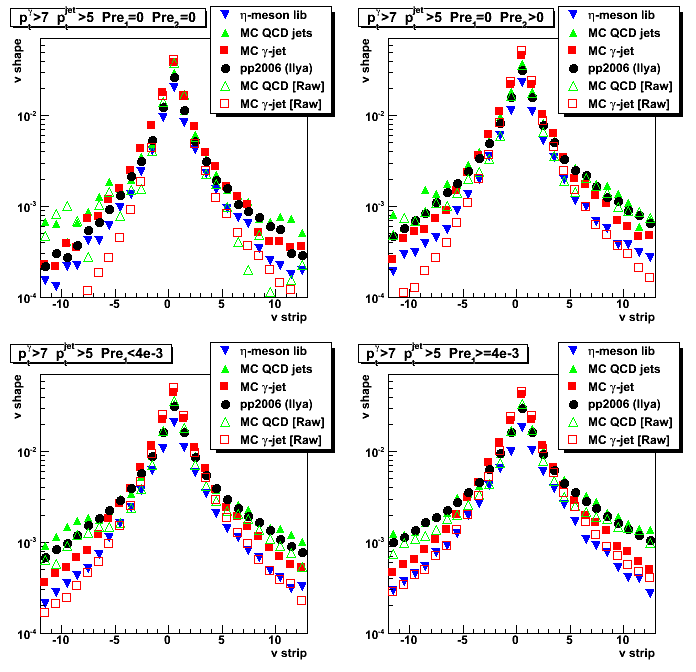
Figure 3: Shower shapes: data, raw, and data-driven MC (5 strips)
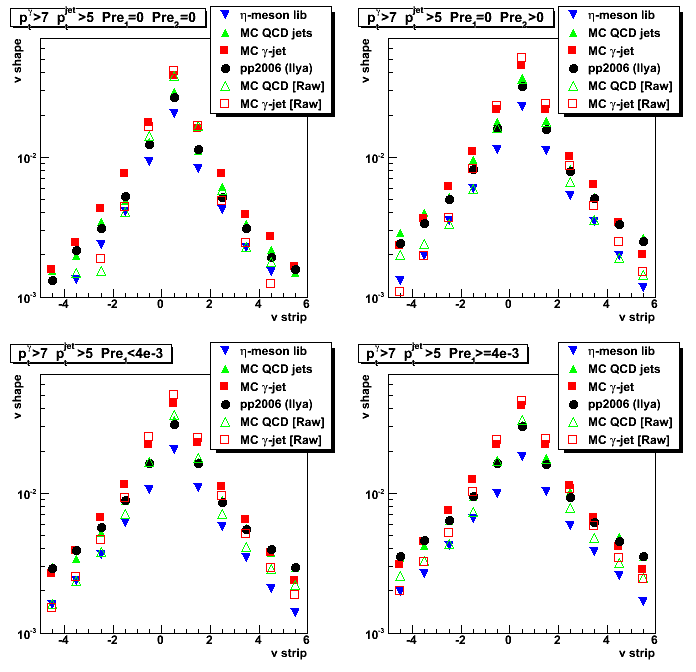
Figure 4: 25 strips SMD cluster energy for raw Monte-Carlo
(Note: type in x-axis lables, should be "25 strip peak" instead of 5)
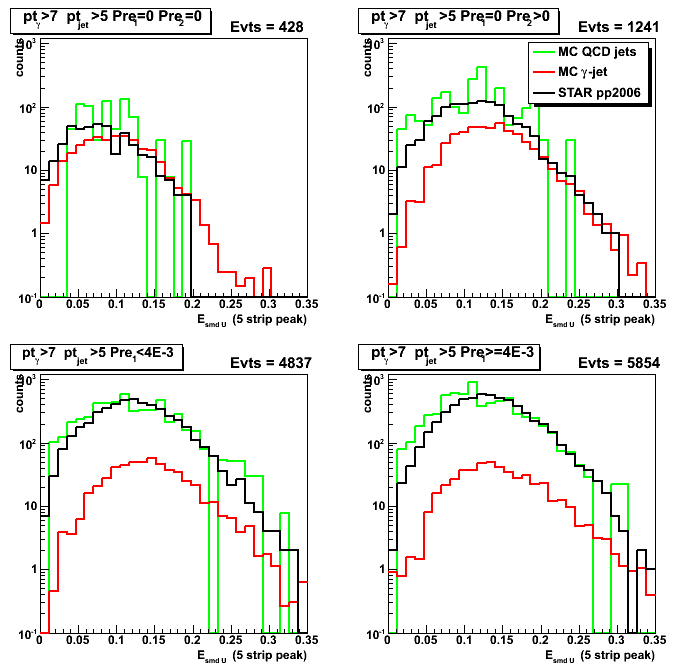
Figure 5: 25 strips SMD cluster energy for data-driven Monte-Carlo
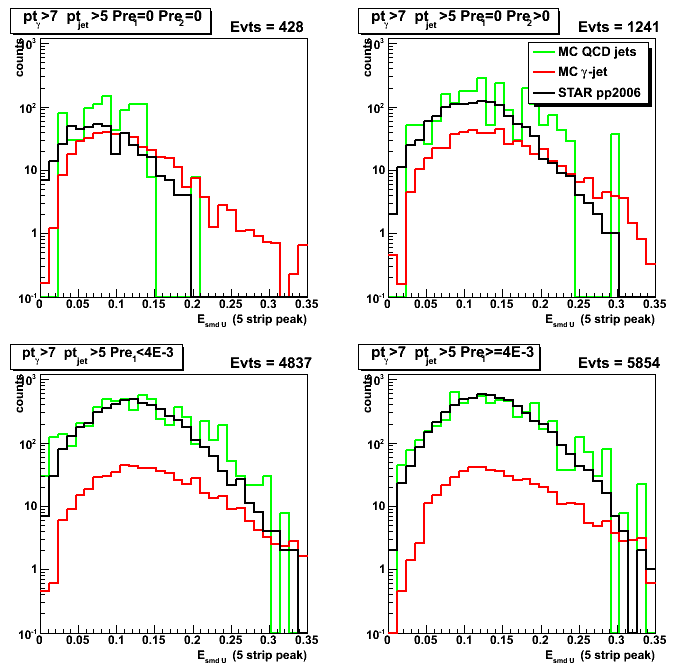
Figure 6: 5 strips SMD peak energy for raw Monte-Carlo
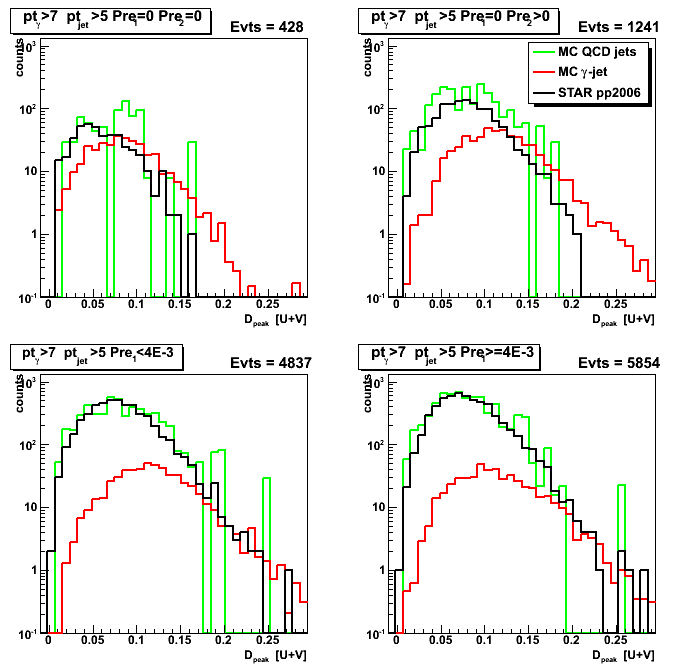
Figure 7: 5 strips SMD peak energy for data-driven Monte-Carlo
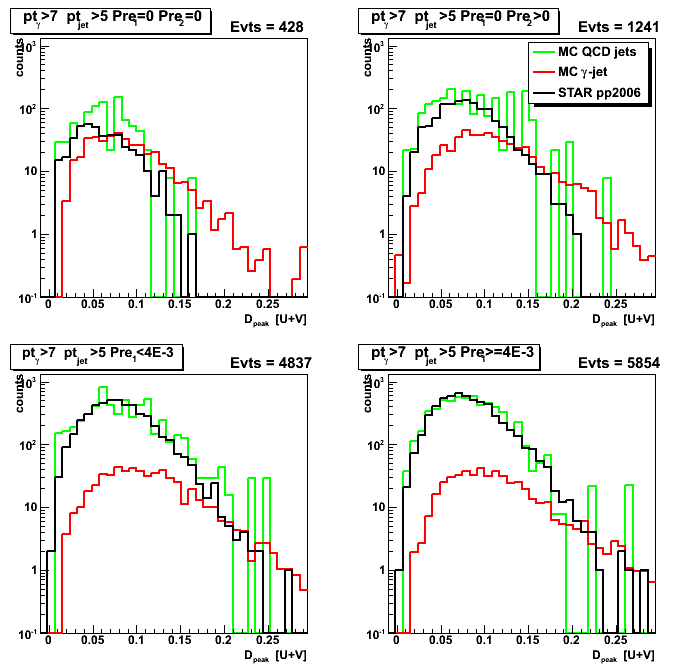
Figure 8:Energy from the right tail (up to 30 strips) for raw Monte-Carlo
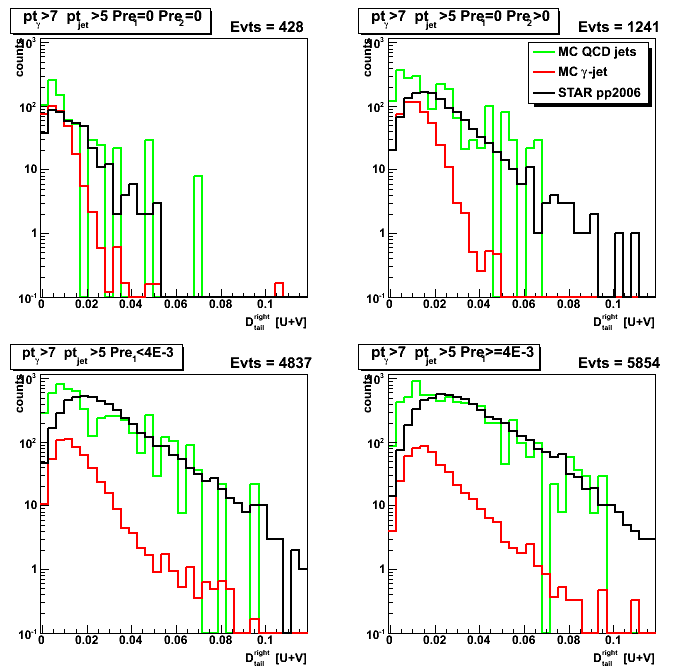
Figure 9:Energy from the right tail (up to 30 strips) for data-driven Monte-Carlo
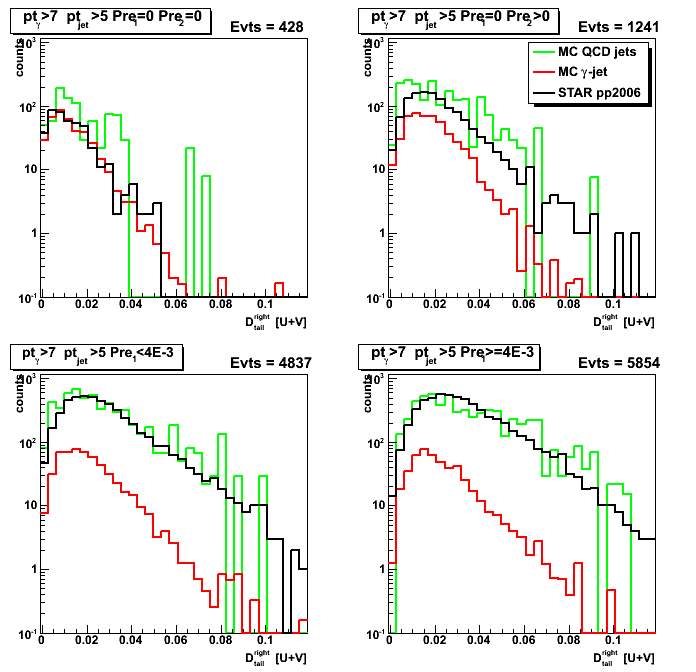
2008.10.27 SMD-based shower shape scaling: 25 strips cluster energy, raw vs. data-driven MC
Ilya Selyuzhenkov October 27, 2008
Data sets:
- pp2006 - STAR 2006 pp longitudinal data (~ 3.164 pb^1)
after applying gamma-jet isolation cuts (R_cluster > 0.9 is used below). - gamma-jet[gamma-filtered] - data-driven Prompt Photon [p6410EemcGammaFilter] events.
Partonic pt range 2-25 GeV. - QCD jets[gamma-filtered] - data-driven QCD [p6410EemcGammaFilter] events.
Partonic pt range 2-25 GeV.
Shower shapes scaling options in data-driven maker:
- scale = E_smd^geant / E_smd^library (default)
E_smd^geant is SMD energy associated with given photon
integrated over +/- 12 strips from raw Monte-Carlo,
and E_smd^library is SMD energy from +/- 12 strips for the library photon. - scale = E_Geant / E_library (used before in all posts)
E_Geant is thrown photon energy from Geant record,
and E_library is stand for energy of the library photon.
In all figures below (exept for pp2006 data and raw Monte-Carlo)
the SMD based shower shape scaling has been used.
Figure 1: SMD shower shapes: data, raw, and data-driven MC (40 strips).
Vertical axis shows average energy per strip (no overall shower shapes scaling)
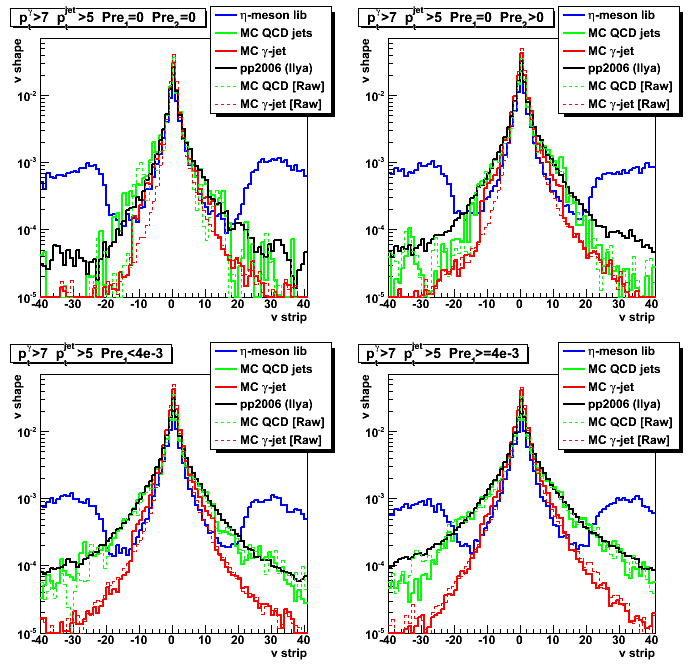
Figure 2: Shower shapes: data, raw, and data-driven MC (12 strips)
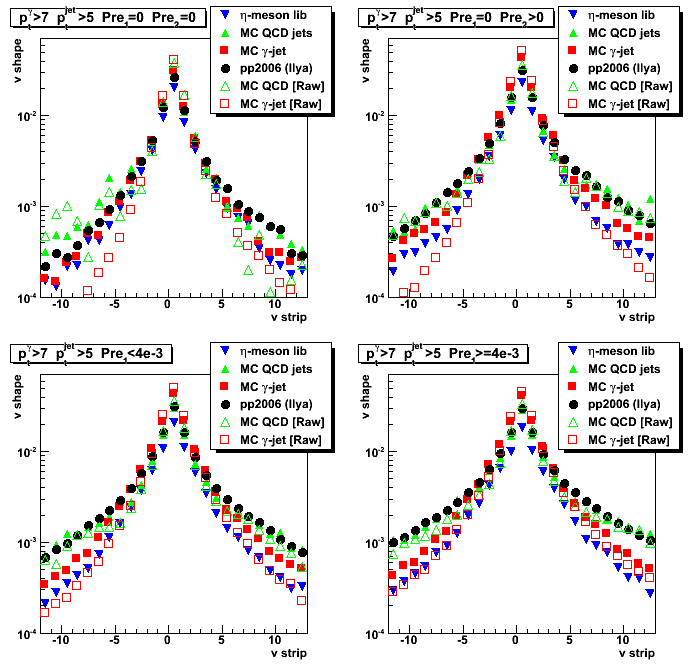
Figure 3: Shower shapes: data, raw, and data-driven MC (5 strips)

Figure 4: 25 strips SMD cluster energy for data-driven Monte-Carlo
(SMD based shower shape scaling)
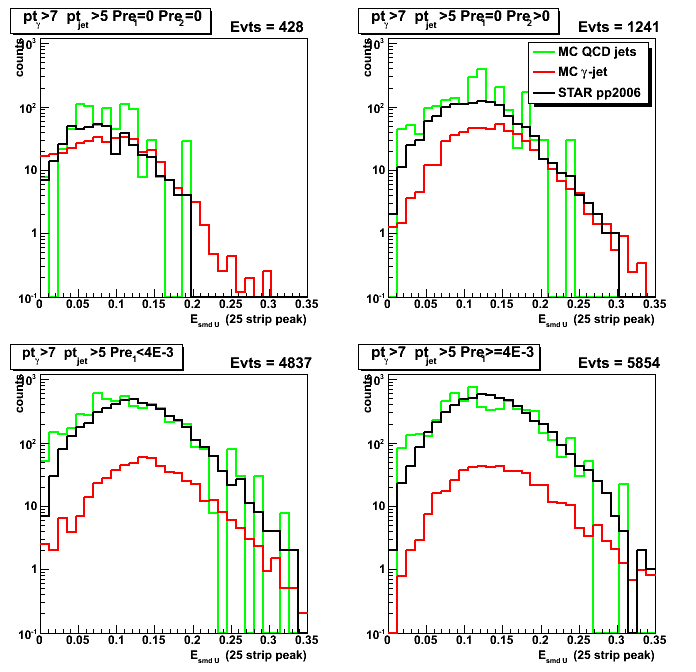
Figure 5: 25 strips SMD cluster energy for raw Monte-Carlo
Note, the difference between results in Fig. 4 and 5. for MC gamma-jets (shown in red)
at low energy (Esmd < 0.04) for pre1=0 pre2=0 case.
This effect is due to the "Number of strips fired in 5-strips cluster > 3" cut.
In data-driven Monte-Carlo we may have shower shapes
with small number of strips fired (rejected in raw Monte-Carlo)
to be replaced by library shape with different (bigger) number of strips fired.
This mostly affects photons which starts to shower
later in the detector and only fires few strips (pre1=0 pre2=0 case)
2008.10.30 Various cuts study (pt, Esmd, 8 strips replaced)
Ilya Selyuzhenkov October 30, 2008
Below are links to drupal pages
with various SMD energy distributions and shower shapes
for the following set of cuts/conditions:
- Case A: pt > 7 GeV, +/- 12 strips replaced
- Case B: pt > 7 GeV, +/- 8 strips replaced
- Case C: pt > 7 GeV, +/- 12 strips replaced, E_smd(25strips) > 0.1
- Case D: pt > 8.5 GeV, +/- 12 strips replaced
2008.10.30 Distance to cut line from sided residual
Figure 1: Case A
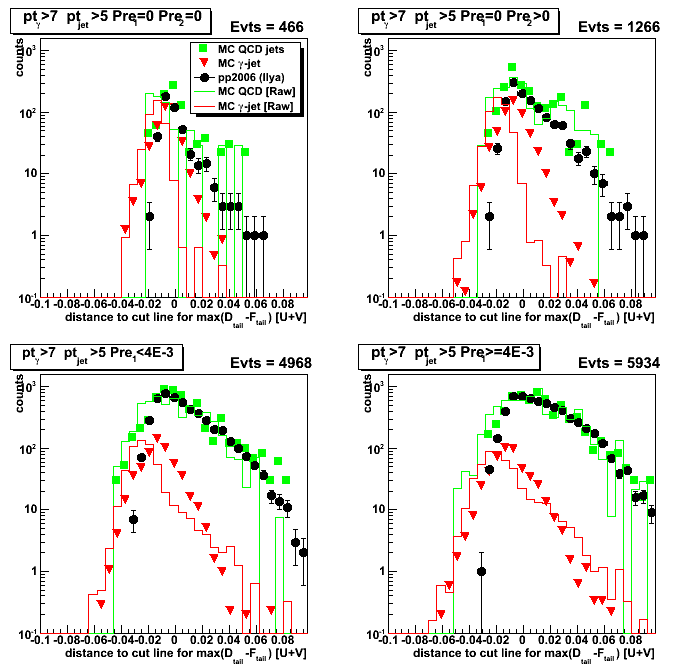
Figure 2:Case B
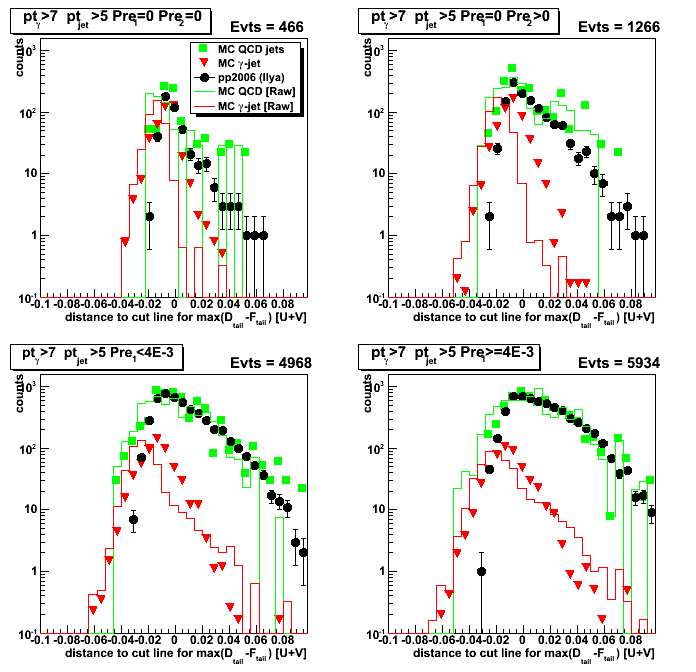
Figure 3:Case C
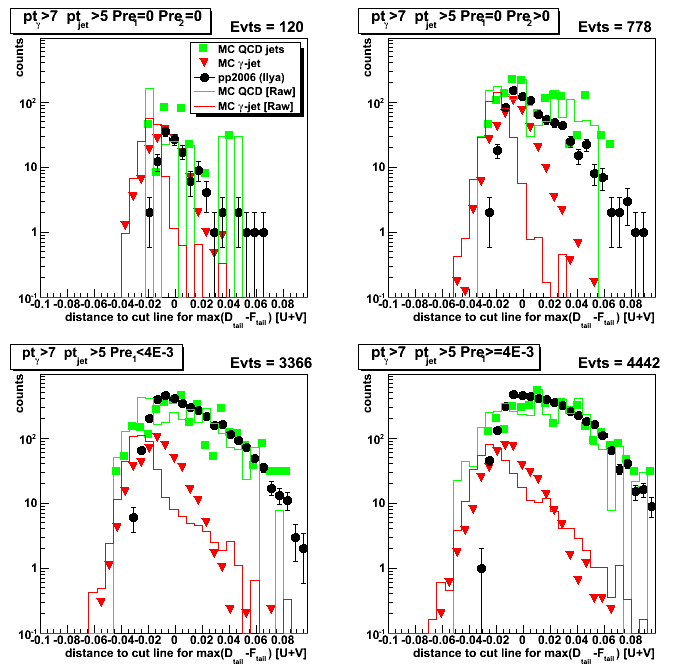
Figure 4:Case D
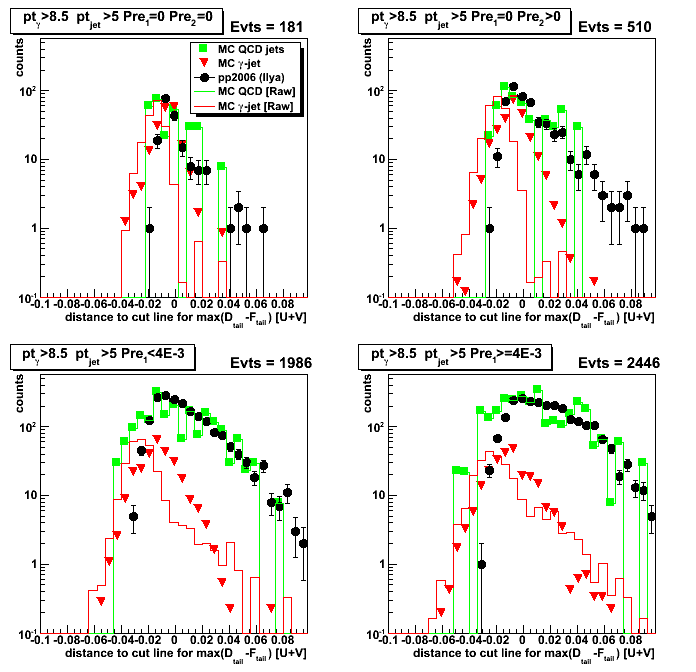
2008.10.30 SMD shower shapes: data, raw, and data-driven MC (12 strips)
Figure 1: Case A
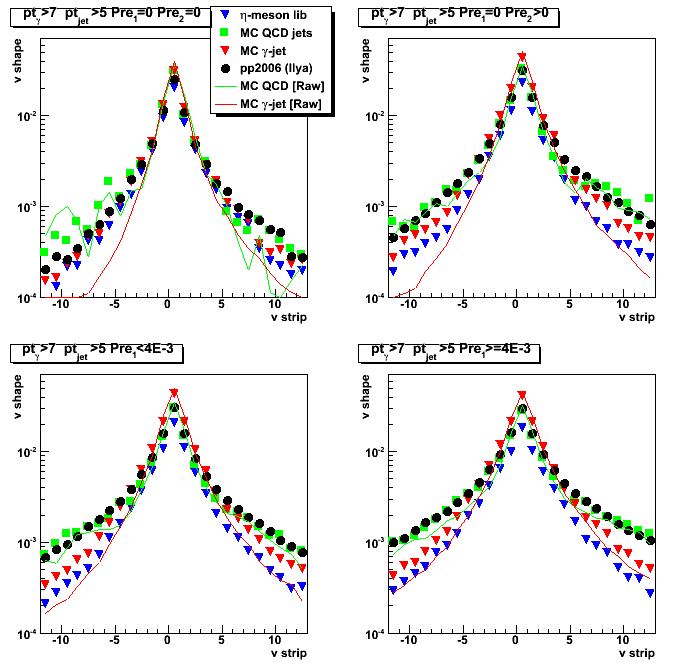
Figure 2:Case B
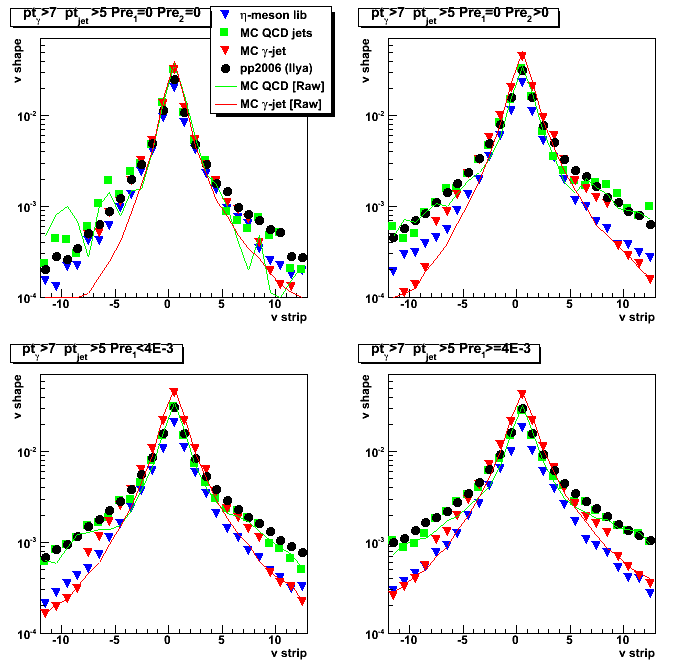
Figure 3:Case C
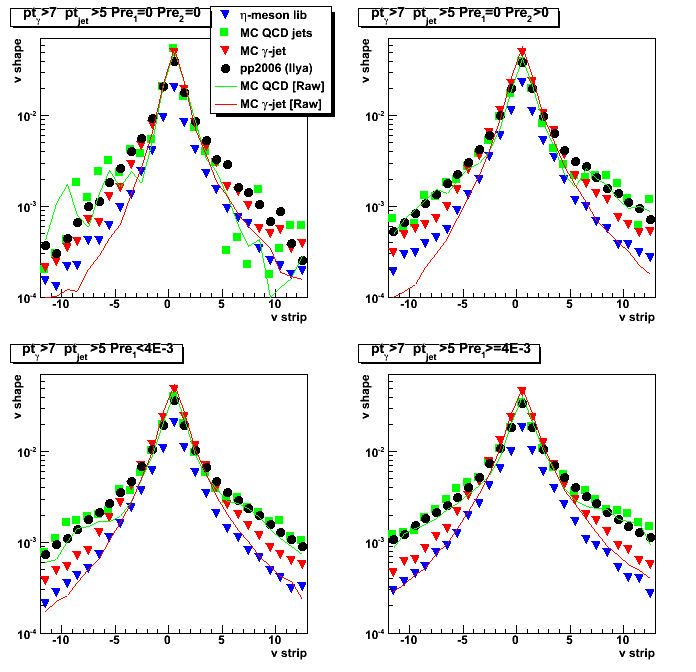
Figure 4:Case D
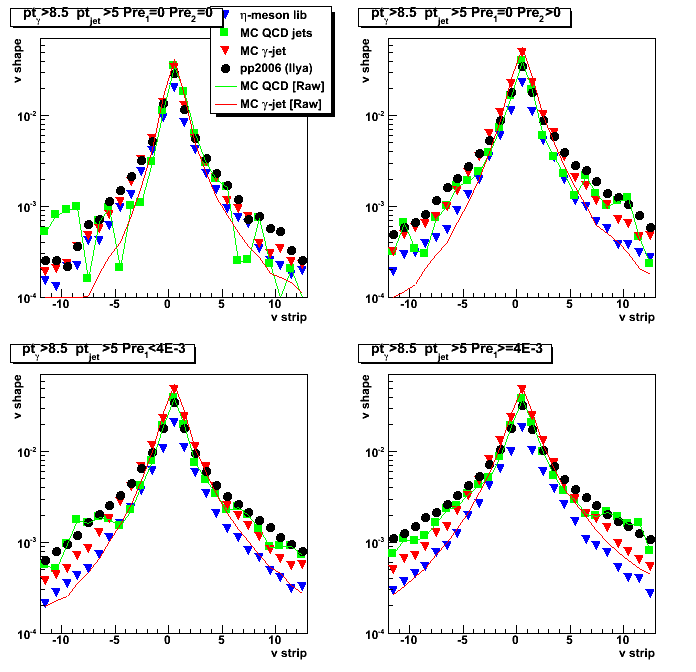
2008.10.30 SMD shower shapes: data, raw, and data-driven MC (30 strips)
Figure 1: Case A
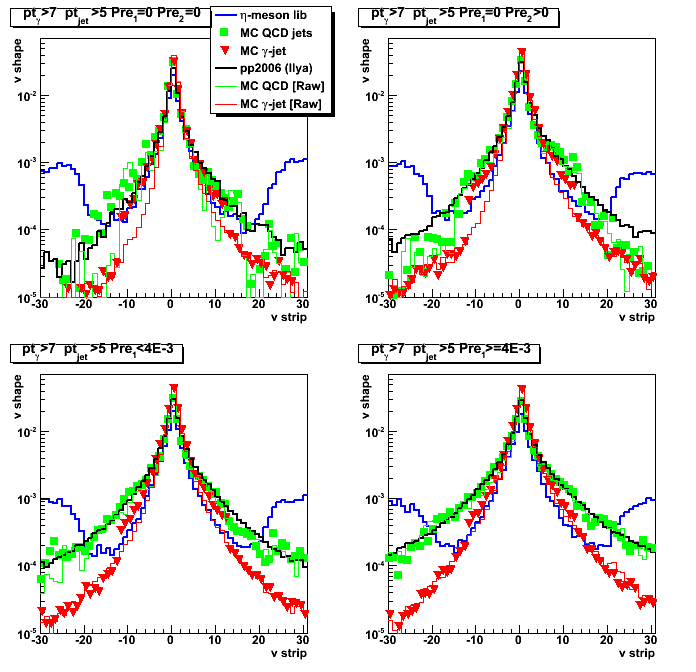
Figure 2: Case B
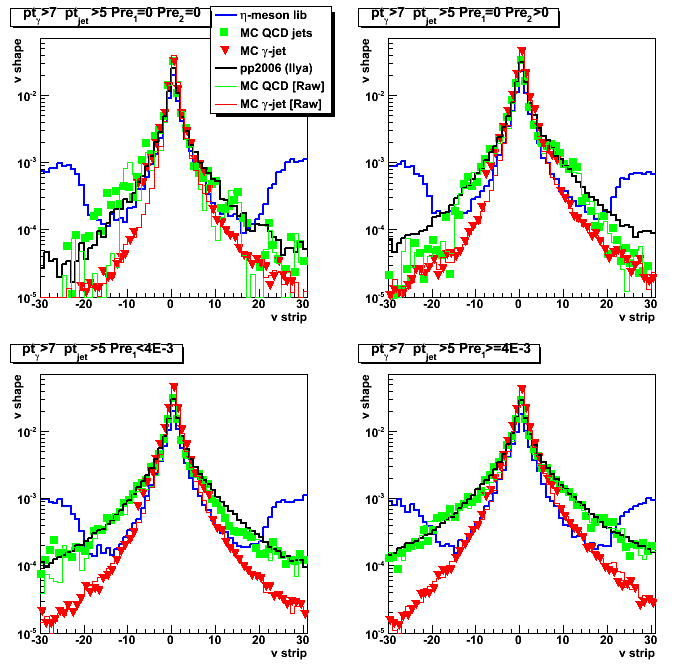
Figure 3: Case C
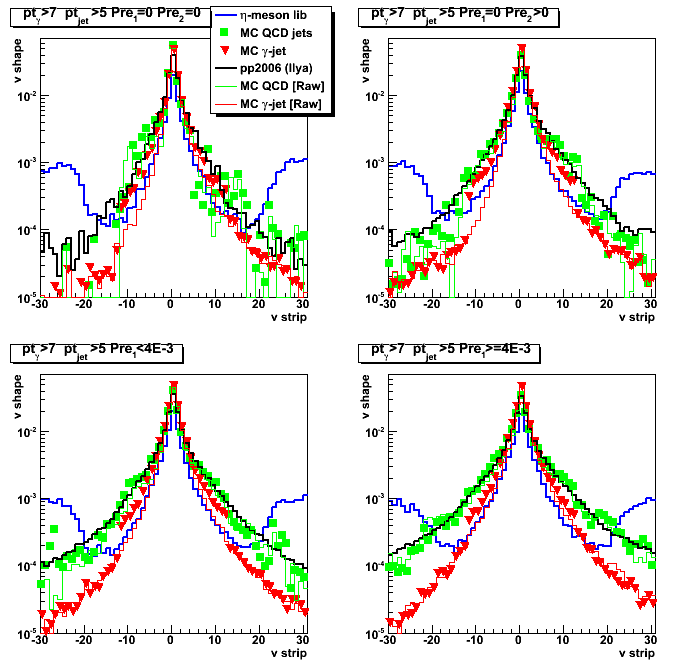
Figure 4: Case D

2008.10.30 Sided residual
Figure 1: Case A
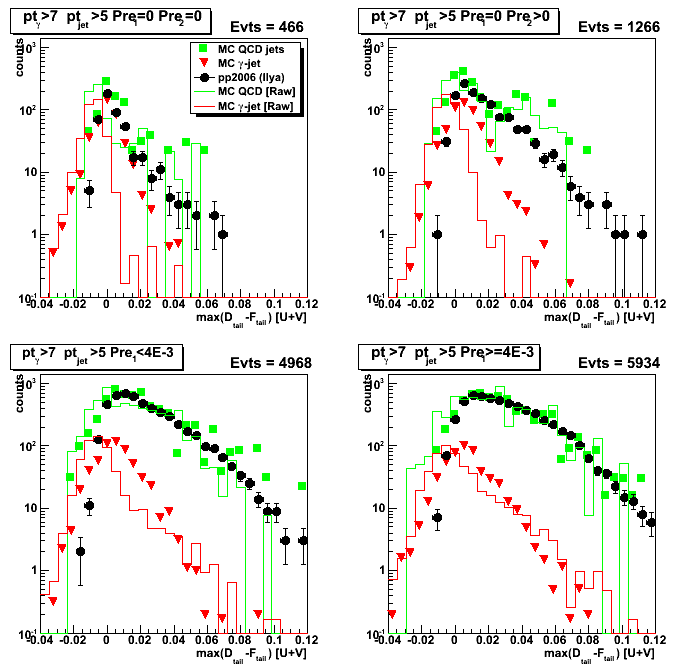
Figure 2:Case B
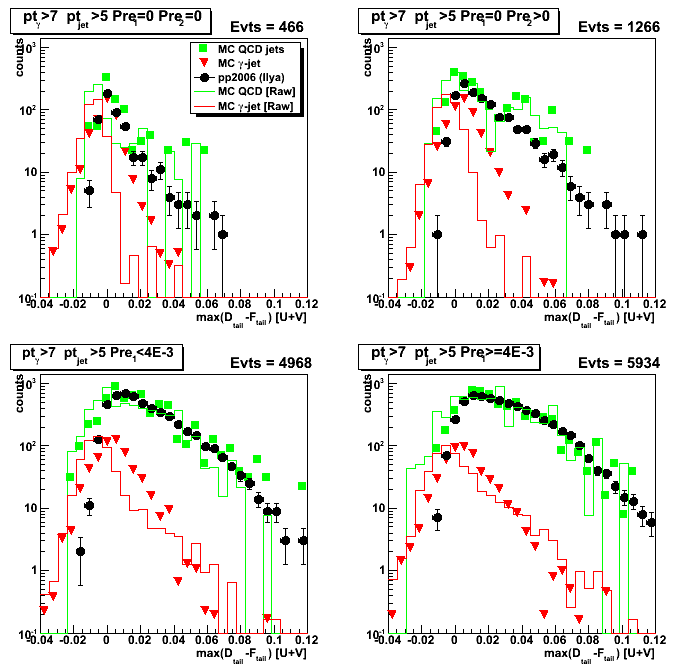
Figure 3:Case C

Figure 4:Case D
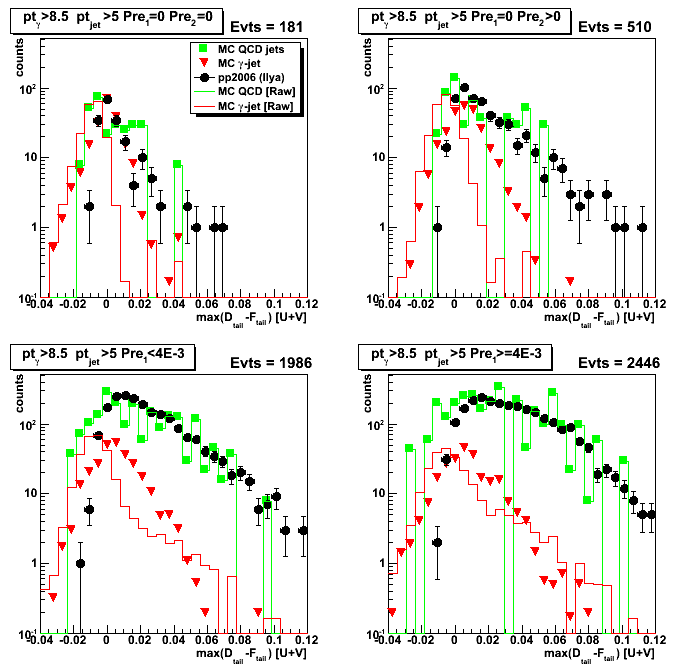
2008.10.30 Smd emergy for left tail (-3 to -30 strips)
Figure 1: Case A
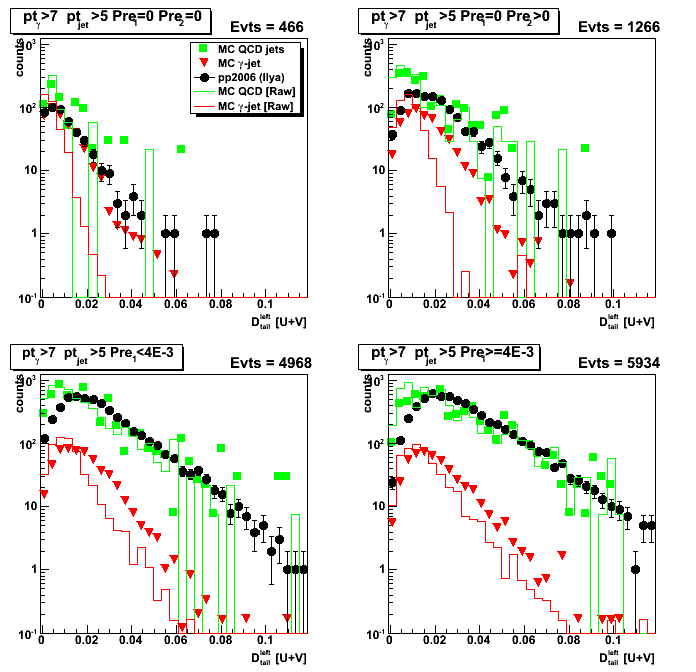
Figure 2:Case B
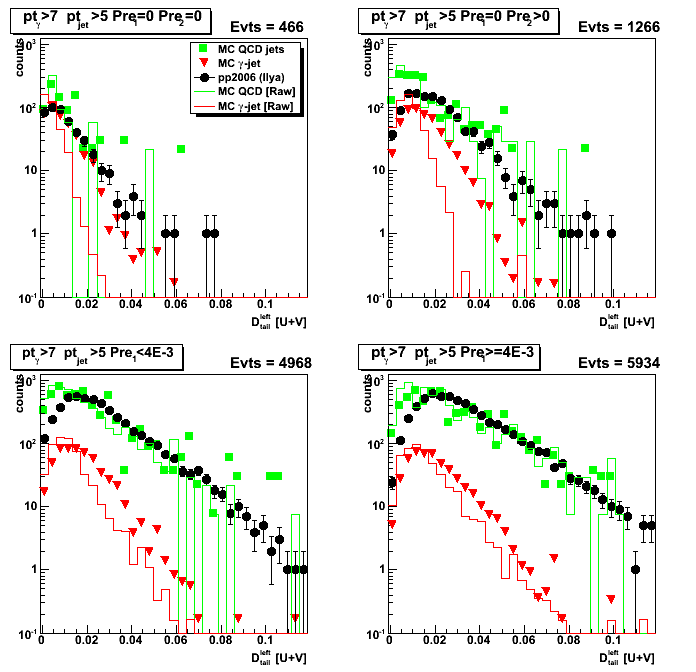
Figure 3:Case C
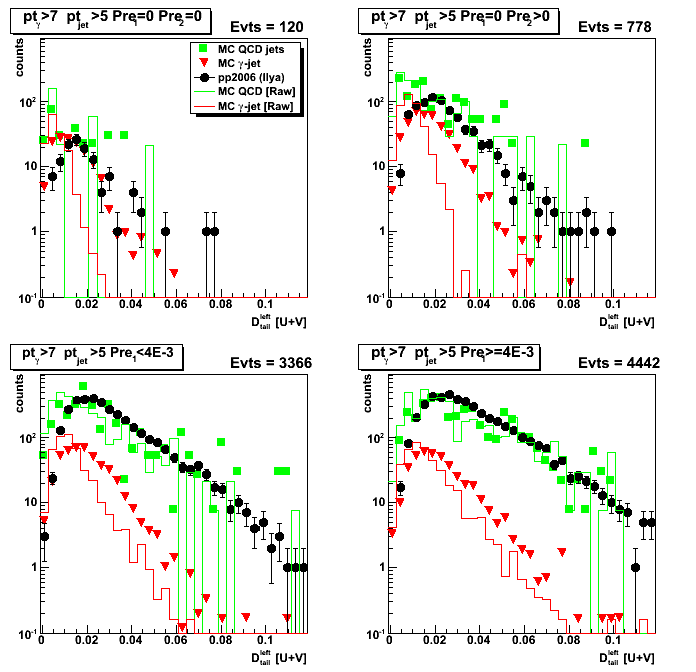
Figure 4:Case D
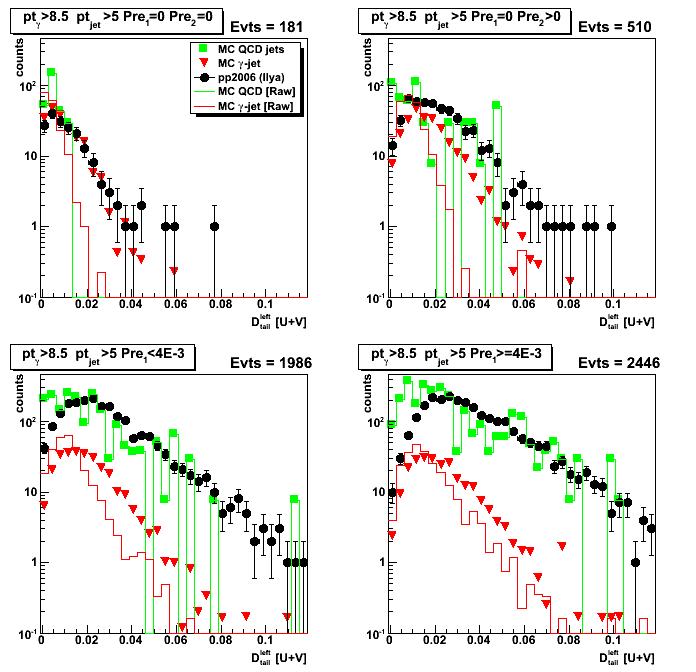
2008.10.30 Smd emergy for right tail (3 to 30 strips)
Figure 1: Case A
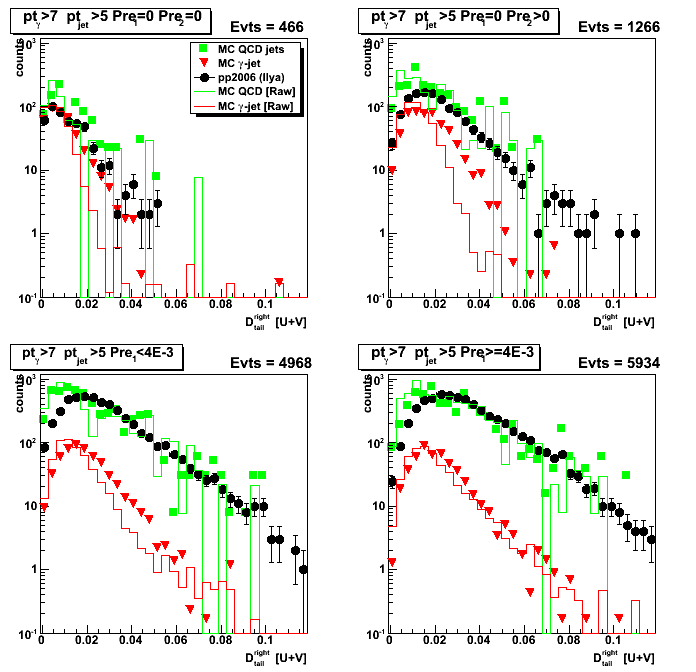
Figure 2:Case B
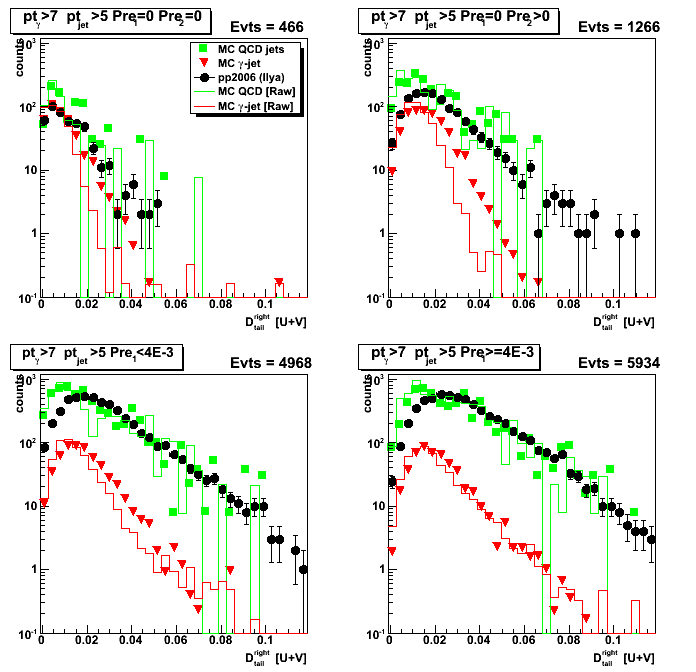
Figure 3:Case C
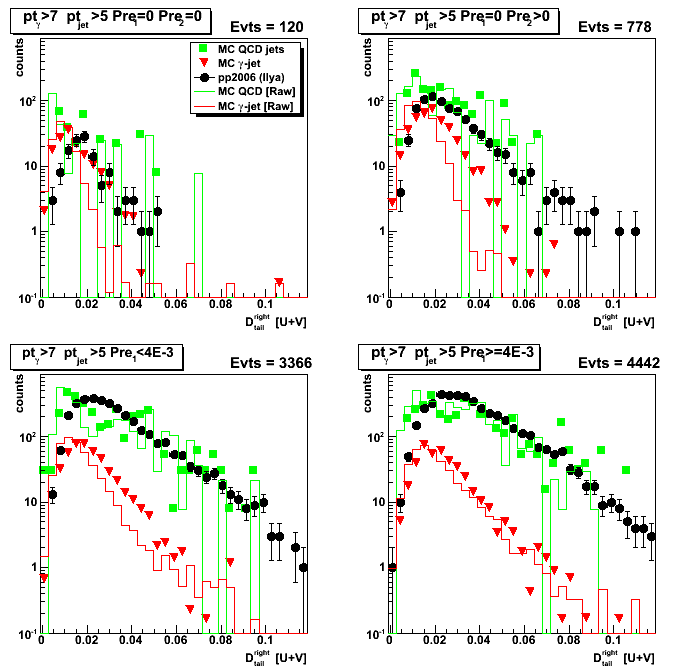
Figure 4:Case D
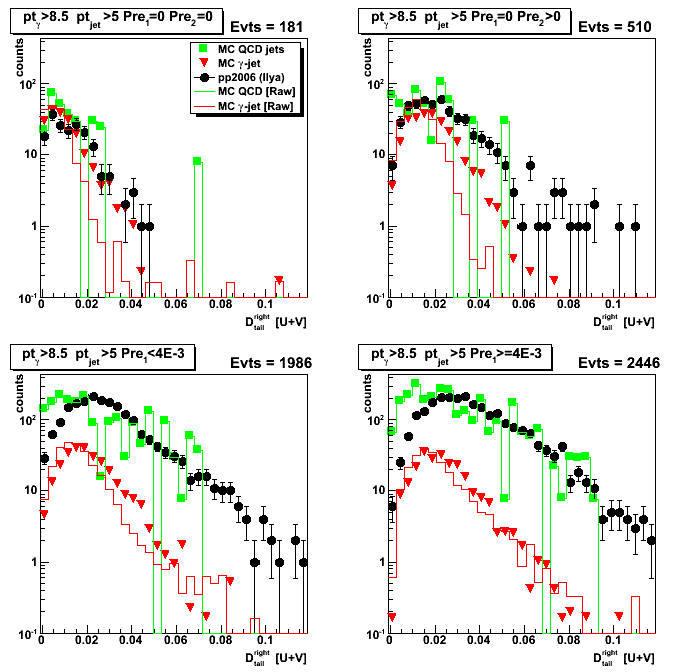
2008.10.30 Smd energy for 25 central strips
Figure 1: Case A
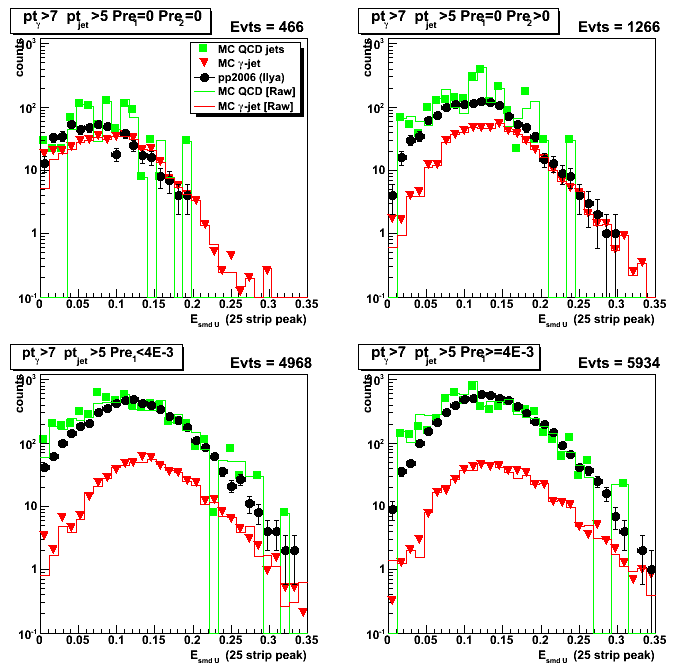
Figure 2:Case B
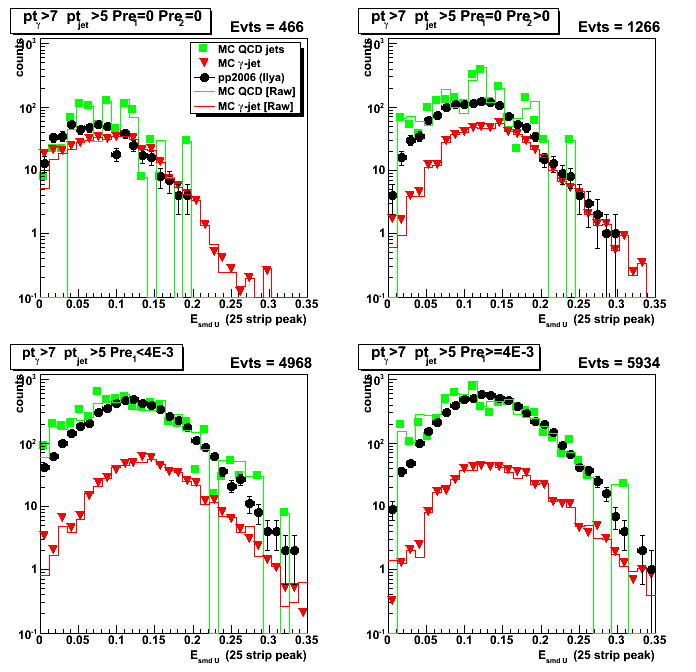
Figure 3:Case C
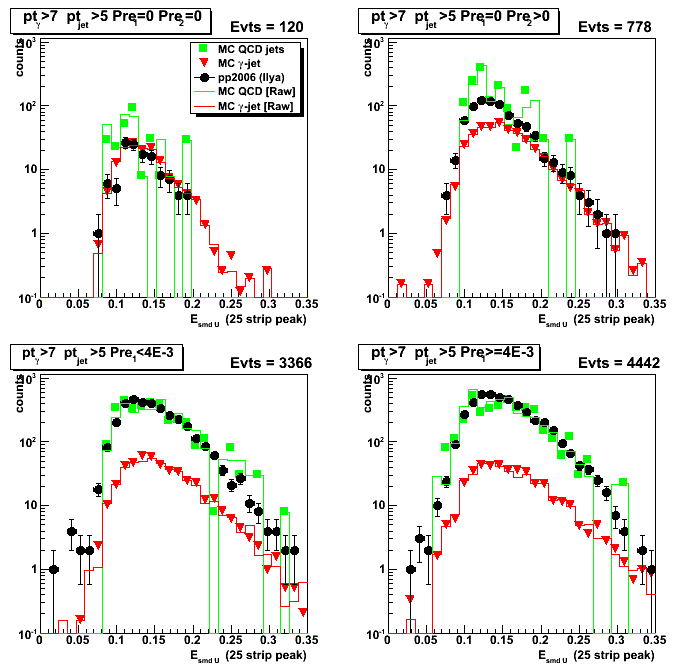
Figure 4:Case D
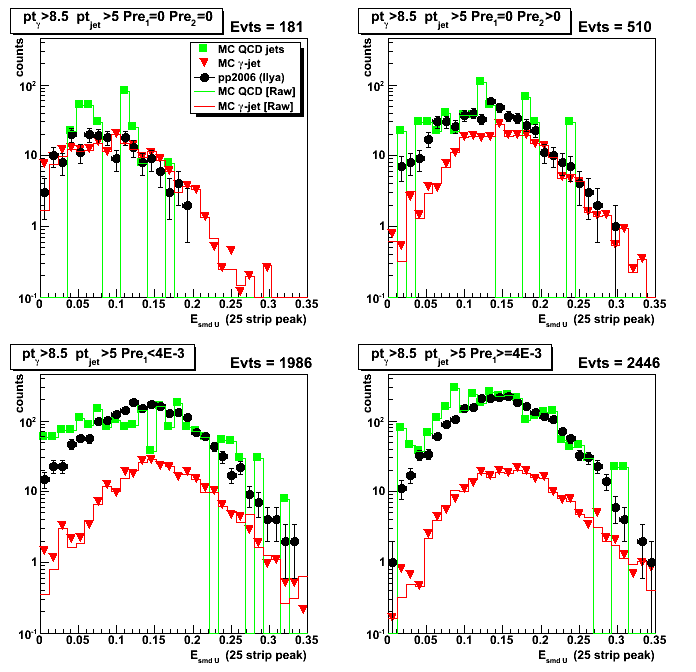
2008.10.30 Smd energy for 5 central strips
Figure 1: Case A
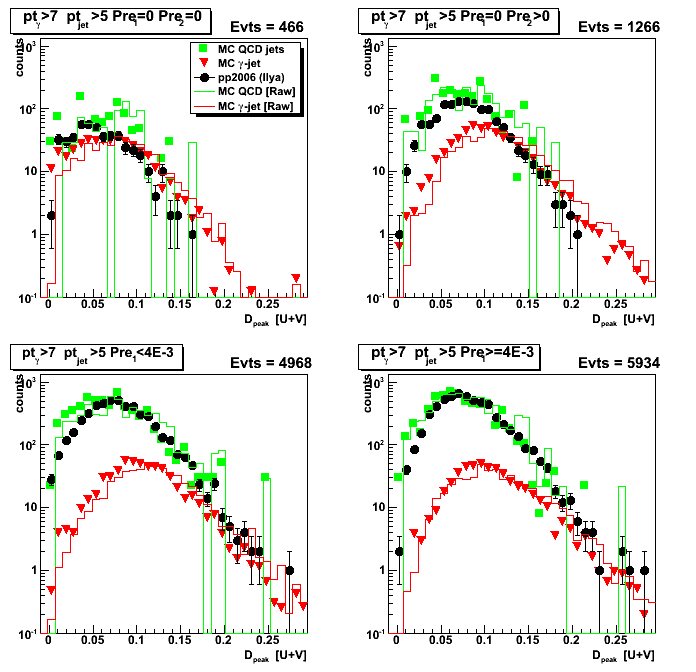
Figure 2:Case B
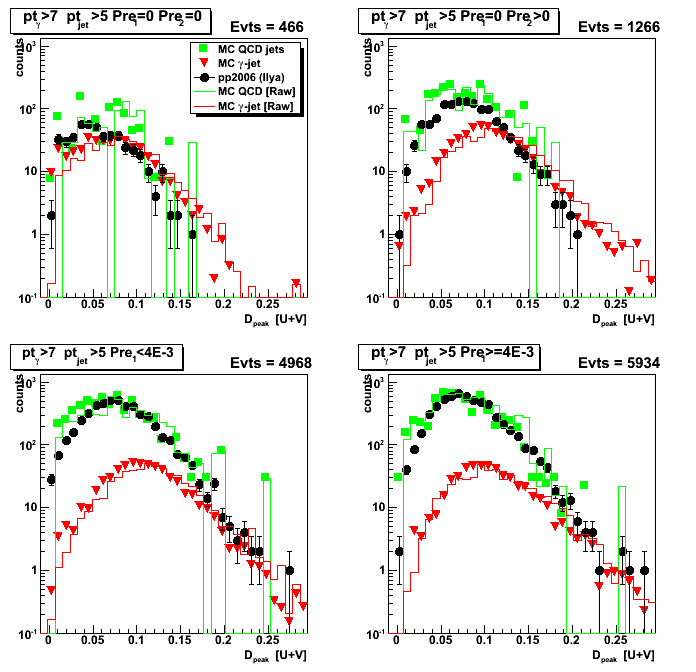
Figure 3:Case C
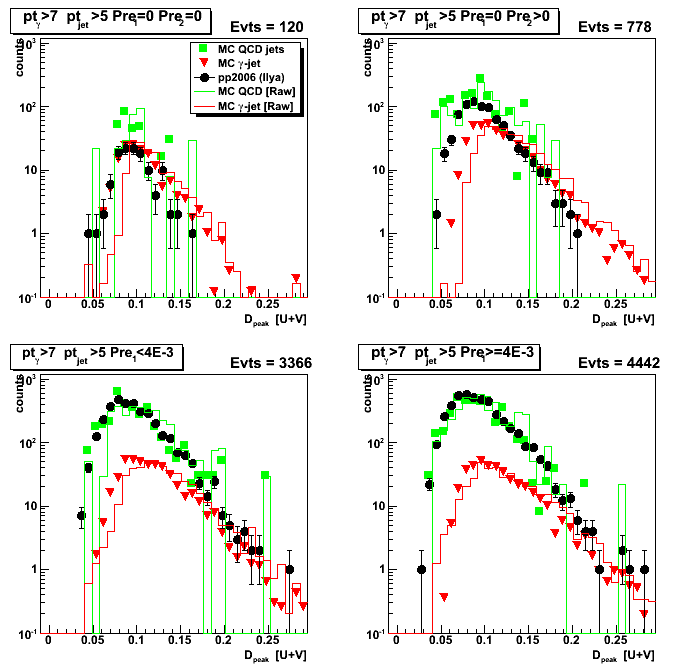
Figure 4:Case D
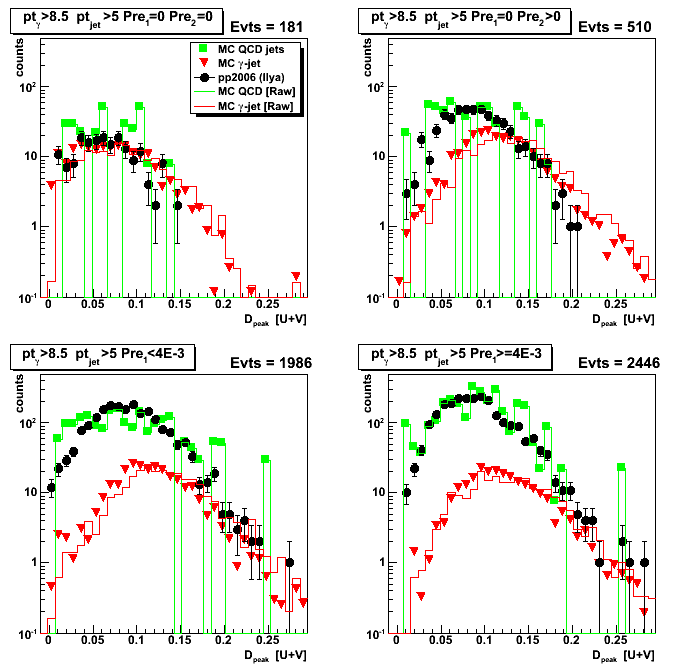
11 Nov
November 2008 posts
2008.11.06 Gamma-jet reconstruction with the Endcap EMC (Analysis status update)
Ilya Selyuzhenkov November 06, 2008
Gamma-jet reconstruction with the Endcap EMC (Analysis status update for Spin PWG)
- latest version (pdf)
- Version 3: pdf or odp (for spin PWG)
- Version 2: pdf or odp (after phana comments)
- Version 1: pdf or odp (draft for phana meeting)
2008.11.11 Yields vs. analysis cuts
Ilya Selyuzhenkov November 11, 2008
Data sets:
- pp2006 - STAR 2006 pp longitudinal data (~ 3.164 pb^1)
after applying gamma-jet isolation cuts (R_cluster > 0.9 is used below). - gamma-jet[gamma-filtered] - data-driven Prompt Photon [p6410EemcGammaFilter] events.
Partonic pt range 2-25 GeV. - QCD jets[gamma-filtered] - data-driven QCD [p6410EemcGammaFilter] events.
Partonic pt range 2-25 GeV.
Figure 1: Reconstructed gamma pt for di-jet events and
Geant cuts: pt_gamma[Geant] > 7GeV and 1.05 < eta_gamma[Geant] < 2.0
Total integral for the histogram is: N_total = 5284
(after weighting different partonic pt bins and scaled to 3.164pb^-1).
Compare with number from Jim Sowinski study for
Endcap East+West gamma-jet and pt>7 GeV: N_Jim = 5472
( Jim's numbers are scaled to 3.164pb^-1 : [2539+5936]*3.164/4.9) 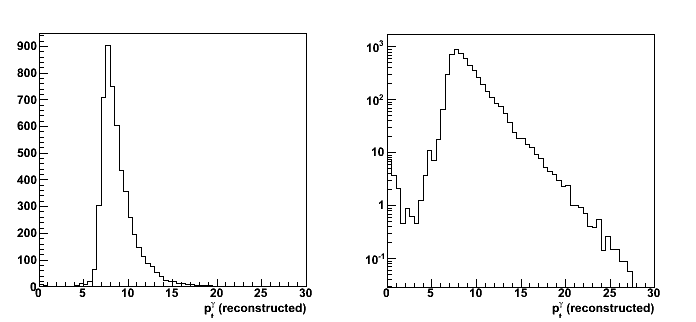
Figure 2: Reconstructed jet pt for di-jet events and the same cuts as in Fig. 1

Yield vs. various analysis cuts
List of cuts (sorted by bin number in Figs. 2 and 3):
- N_events : total number of di-jet events found by the jet-finder
- cos(phi_gamma - phi_jet) < -0.8 : gamma-jet opposite in phi
- R_{3x3cluster} > 0.9 : Energy in 3x3 cluster of EEMC tower to the total jet energy
- R_EM^jet < 0.9 : neutral energy fraction cut for on away side jet
- N_ch=0 : no charge tracks associated with a gamma candidate
- N_bTow = 0 : no barrel towers associated with a gamma candidate (gamma in the endcap)
- N_(5-strip cluster)^u > 2 : minimum number of strips in EEMC SMD u-plane cluster around peak
- N_(5-strip cluster)^v > 2 : minimum number of strips in EEMC SMD v-plane cluster around peak
- gamma-algo fail : my algorithm failed to match tower with SMD uv-intersection, etc...
- Tow:SMD match : SMD uv-intersection has a tower which is not in a 3x3 cluster
Figure 3: Number of accepted events vs. various analysis cuts
The starting number of events (shown in first bin of the plots) is
the number of di-jets with reconstructed gamma_pt>7 GeV and jet_pt>5 GeV
upper left: cuts applied independently
upper right: cuts applied sequentially
lower left: ratio of pp2006 data vs. MC sum of gamma-jet and QCD-jets events (cuts applied independently)
lower right:ratio of pp2006 data vs. MC sum of gamma-jet and QCD jets events (cuts applied sequentially)
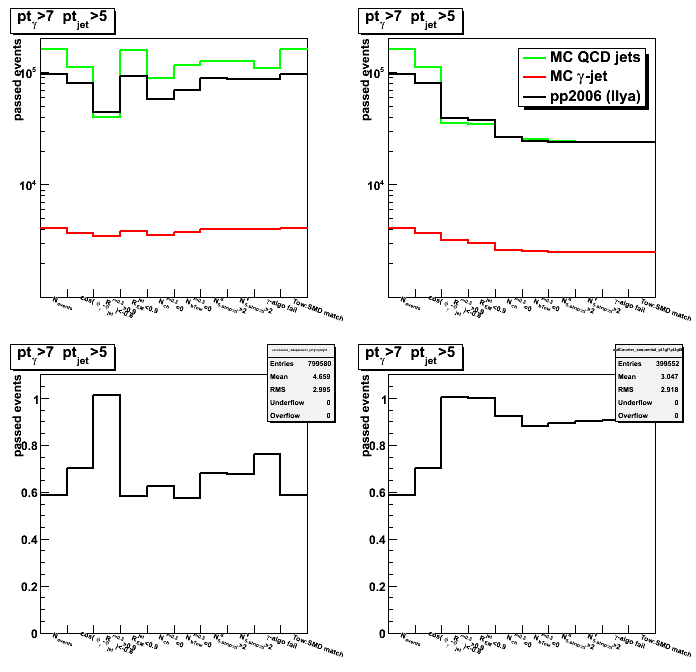
Figure 4: Number of accepted events vs. various analysis cuts
Data from Fig. 3 (upper plots) scaled to the initial number of events from first bin:
left: cuts applied independently
right: cuts applied sequentially
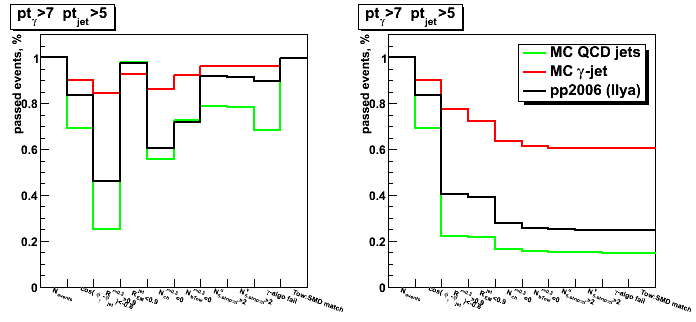
2008.11.18 Cluster isolation cuts: 2x1 vs. 2x2 vs. 3x3
Ilya Selyuzhenkov November 18, 2008
Data sets:
- pp2006 - STAR 2006 pp longitudinal data (~ 3.164 pb^1)
after applying gamma-jet isolation cuts (no R_cluster cut applied for this study). - gamma-jet[gamma-filtered] - data-driven Prompt Photon [p6410EemcGammaFilter] events.
Partonic pt range 2-25 GeV. - QCD jets[gamma-filtered] - data-driven QCD [p6410EemcGammaFilter] events.
Partonic pt range 2-25 GeV.
2x1, 2x2, and 3x3 clusters definition:
- 3x3 cluster: tower energy sum for 3x3 patch around highest tower
- 2x2 cluster: tower energy sum for 2x2 patch
which are closest to 3x3 tower patch centroid.
3x3 tower patch centroid is defined based
on tower energies weighted wrt tower centers:
centroid = sum{E_tow * r_tow} / sum{E_tow}.
Here r_tow=(x_tow, y_tow) denotes tower center. - 2x1 cluster: tower energy sum for high tower plus second highest tower in 3x3 patch
- r=0.7 energy is calculated based on towers
within a radius of 0.7 (in delta phi and eta) from high tower
Cuts applied
all gamma-jet candidate selection cuts except 3x3/r=0.7 energy isolation cut
Results for 2x1, 2x2, and 3x3 clusters
- Energy fraction in NxN cluster in r=0.7 radius
2x1, 2x2, 3x3 patch to jet radius of 0.7 energy ratios - Yield vs. NxN cluster energy fraction in r=0.7
For a given cluster energy fraction yield is defined as an integral on the right - Efficiency vs. NxN cluster energy fraction in r=0.7
For a given cluster energy fraction
efficiency is defined as the yield (on the right)
normalized by the total integral (total yield)
Efficiency vs. NxN cluster energy fraction in r=0.7
Efficiency vs. NxN cluster energy fraction in r=0.7
Figure 4b: 3x3/0.7 ratio but only using towers which passed jet finder threshold

2008.11.21 Energy fraction from 2x1 vs. 2x2 vs. 3x3 or 0.7 radius: rapidity dependence
Ilya Selyuzhenkov November 21, 2008
Data sets:
- pp2006 - STAR 2006 pp longitudinal data (~ 3.164 pb^1)
after applying gamma-jet isolation cuts (no R_cluster cut applied for this study). - gamma-jet[gamma-filtered] - data-driven Prompt Photon [p6410EemcGammaFilter] events.
Partonic pt range 2-25 GeV. - QCD jets[gamma-filtered] - data-driven QCD [p6410EemcGammaFilter] events.
Partonic pt range 2-25 GeV.
2x1, 2x2, and 3x3 clusters definition:
- 3x3 cluster: tower energy sum for 3x3 patch around highest tower
- 2x2 cluster: tower energy sum for 2x2 patch
which are closest to 3x3 tower patch centroid.
3x3 tower patch centroid is defined based
on tower energies weighted wrt tower centers:
centroid = sum{E_tow * r_tow} / sum{E_tow}.
Here r_tow=(x_tow, y_tow) denotes tower center. - 2x1 cluster: tower energy sum for high tower plus second highest tower in 3x3 patch
- r=0.7 energy is calculated based on towers
within a radius of 0.7 (in delta phi and eta) from high tower
Cuts applied
all gamma-jet candidate selection cuts except 3x3/r=0.7 energy isolation cut
Results
There are two sets of figures in links below:
- Number of counts for a given energy fraction
- Yield above given energy fraction
[figures with right integral in the caption]
Yield is defined as the integral above given energy fraction
up to the maximum value of 1
Gamma candidate detector eta < 1.5
(eta region where we do have most of the TPC tracking):
Gamma candidate detector eta > 1.5:
(smaller tower size)
Some observation
- For pre1>0 condition (contains most of events)
yield in Monte-Carlo for eta > 1.5 case
is about factor of two different than that from pp2006 data,
while for eta < 1.5 Monte-Carlo yield agrees with data within 10-15%.
This could be due to trigger effect? - For pre1=0 case yiled for both eta > 1.5 and eta < 1.5 are different in data and MC
This could be due to migration of counts from pre1=0 to pre1>0
in pp2006 data due to more material budget than it is Monte-Carlo - For pre1=0 condition pp2006 data shapes are not reproduced by gamma-jet Monte-Carlo.
With a larger cluster size (2x1 -> 3x3) the pp2006 and MC gamma-jet shapes
are getting closer to each other. - For pre1>0 condition (with statistics available),
pp2006 data shapes are consistent with QCD Monte-Carlo.
Cluster energy fraction in 3x3 patch: detector eta > 1.5
Energy fraction from NxN cluster in 3x3 patch: detector eta > 1.5
Figure 1a: 2x1/3x3 energy fraction [number of counts per given fraction]

Figure 2a: 2x2/3x3 energy fraction [number of counts per given fraction]

Yield vs. NxN cluster energy fraction in 3x3 patch: detector eta > 1.5
2008.11.25 Yiled vs. analysis cuts: eta dependence
Ilya Selyuzhenkov November 25, 2008
Data sets:
- pp2006 - STAR 2006 pp longitudinal data (~ 3.164 pb^1)
- gamma-jet[gamma-filtered] - data-driven Prompt Photon [p6410EemcGammaFilter] events.
Partonic pt range 2-25 GeV. - QCD jets[gamma-filtered] - data-driven QCD [p6410EemcGammaFilter] events.
Partonic pt range 2-25 GeV.
Some observation
- Fig. 1 [upper&lower left, 3rd bin] indicates that
cluster energy isolation is the most important cut
for signal/background separation - Fig.1 [lower right, 3rd bin] shows that
R_cluster cut is independent from (or orthogonal to) other cuts - Fig.1 [upper&lower left 4th bin] shows that
cut on neutral energy fraction for the away side jet
rejects more signal that background events
We probably need to reconsider that cut - Fig.2 [lower left, 5th bin] shows that
charge particle veto significantly improves
signal to background ratio - Fig.3 [lower left, 5th bin] shows that
in the region were we do not have TPC tracking (photon eta > 1.5)
charge particle veto is not efficient,
although there is still some improvement from this cut.
This probably due to tracks with eta <1.5
which fall into large isolation radius r=0.7.
Fig.2 [lower right, 5th bin] shows that
charge particle veto also independent from other cuts
Yield vs. various analysis cuts
List of cuts (sorted according to bin number in Figs. 1-3. [No SMD sided residual cuts]):
- N_events : total number of di-jet events found by the jet-finder
- cos(phi_gamma - phi_jet) < -0.8 : gamma-jet opposite in phi
- R_{3x3cluster}: Energy in 3x3 cluster of EEMC tower to the total jet energy
R_{3x3cluster}>0.9 for Fig. 1, and it is disabled in Fig. 2 and 3 - R_EM^jet < 0.9 : neutral energy fraction cut for on away side jet
- N_ch=0 : no charge tracks associated with a gamma candidate
- N_bTow = 0 : no barrel towers associated with a gamma candidate (gamma in the endcap)
- N_(5-strip cluster)^u > 2 : minimum number of strips in EEMC SMD u-plane cluster around peak
- N_(5-strip cluster)^v > 2 : minimum number of strips in EEMC SMD v-plane cluster around peak
- gamma-algo fail : my algorithm failed to match tower with SMD uv-intersection, etc...
- Tow:SMD match : SMD uv-intersection has a tower which is not in a 3x3 cluster
Figure 1: Number of accepted events vs. various analysis cuts
The starting number of events (shown in first bin of the plots) is
the number of di-jets with reconstructed gamma_pt>7 GeV and jet_pt>5 GeV
upper left: cuts applied independently
upper right: expept this cut fired
(event passed all other cuts and being rejected by this cut)
lower left: "cuts applied independently" normalized by the total number of events
lower right: "expept this cut fired" normalized by the total number of events
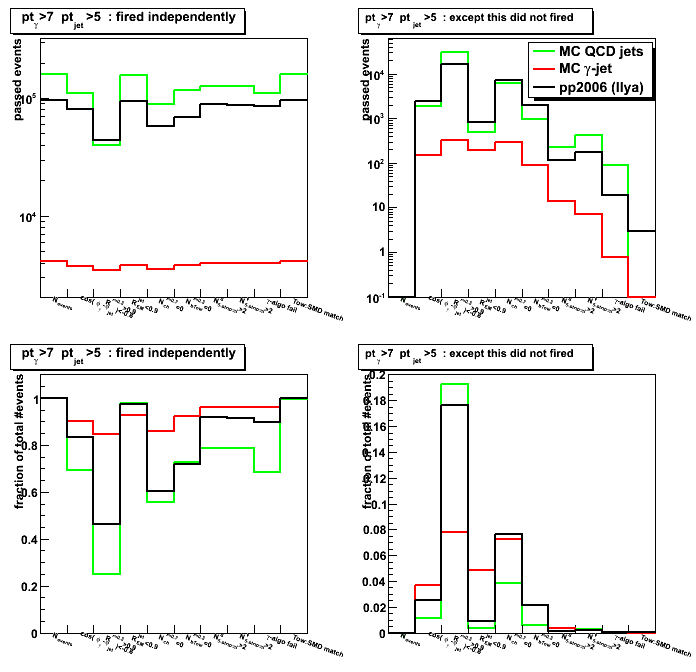
Figure 2: Same as Fig.1 except: no R_cluster cut and photon detector eta < 1.5
(eta region where we do have most of the TPC tracking)
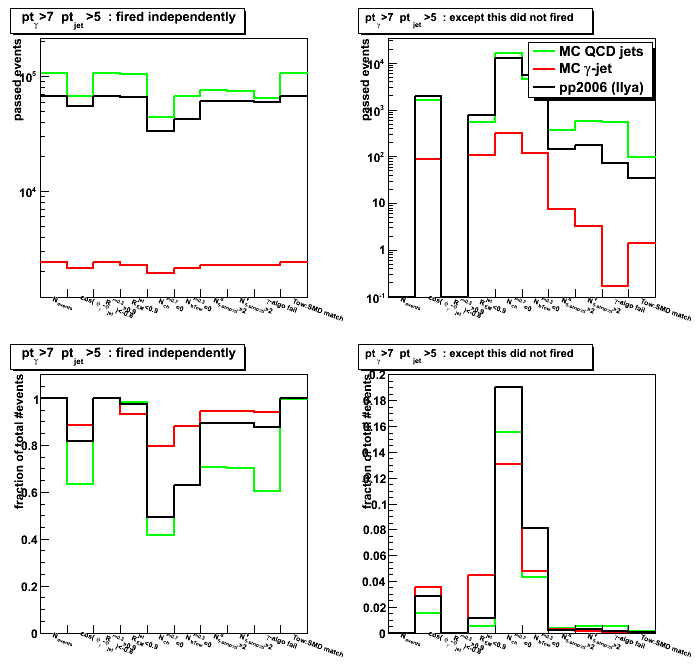
Figure 3: Same as Fig.1 except: no R_cluster cut and photon detector eta > 1.5

12 Dec
December 2008 posts
2008.12.08 Run 8 EEMC QA
Ilya Selyuzhenkov December 08, 2008
Data sets:
- pp2006 - STAR 2006 pp longitudinal data (~ 3.164 pb^1)
Trigger: eemc-http-mb-L2gamma [id:137641] - pp2008 - STAR 2008 pp data
Trigger: etot-mb-l2 [id:7]
Days: 53-70; ~0.5M triggered events (1/3 of available statistics)
Detector subsystems involved in analysis:
- TPC (vertex, jets, charge particle veto)
- Endcap EMC (triggering, photon candidate reconstruction)
- Barrel EMC (away side jet reconstruction)
Gamma-jet analysis cuts:
- Select only di-jet events
- cos(phi_gamma - phi_jet) < -0.8 : gamma-jet opposite in phi
- R_EM^jet < 0.9 : neutral energy fraction cut for the away side jet
- N_ch=0 : no charge tracks associated with a gamma candidate
- N_bTow = 0 : no barrel towers associated with a gamma candidate (gamma in the endcap)
- N_(5-strip cluster)^u > 2 : minimum number of strips in EEMC SMD u-plane cluster around peak
- N_(5-strip cluster)^v > 2 : minimum number of strips in EEMC SMD v-plane cluster around peak
- gamma-algo fail : my algorithm failed to match tower with SMD uv-intersection, etc...
- Tow:SMD match : SMD uv-intersection has a tower which is not in a 3x3 cluster
- R_{3x3cluster}: Energy in 3x3 cluster of EEMC tower to the total jet energy (not applied here)
Figure 1: EEMC x vs. y position of photon candidate for 2008 data sample
Problem with pre-shower layer in Sector 10 can been seen in the upper left corner
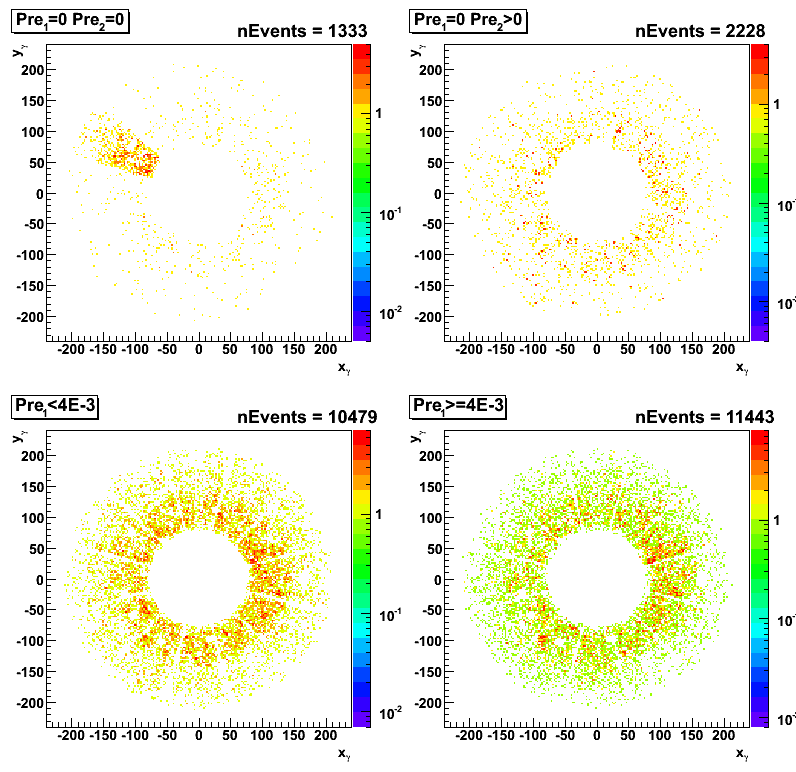
Figure 2: EEMC x vs. y position of photon candidate for 2006 data sample
Figure 3: Average < E_pre1 * E_pre2 > for 3x3 cluster around high tower
vs run number for sectors 9, 10 and 11
Note, zero pre-shower energy for sector 10 (black points) for days 61, 62, 64, and 67.
All di-jet events for pp2008 data are shown (no gamma-jet cuts)
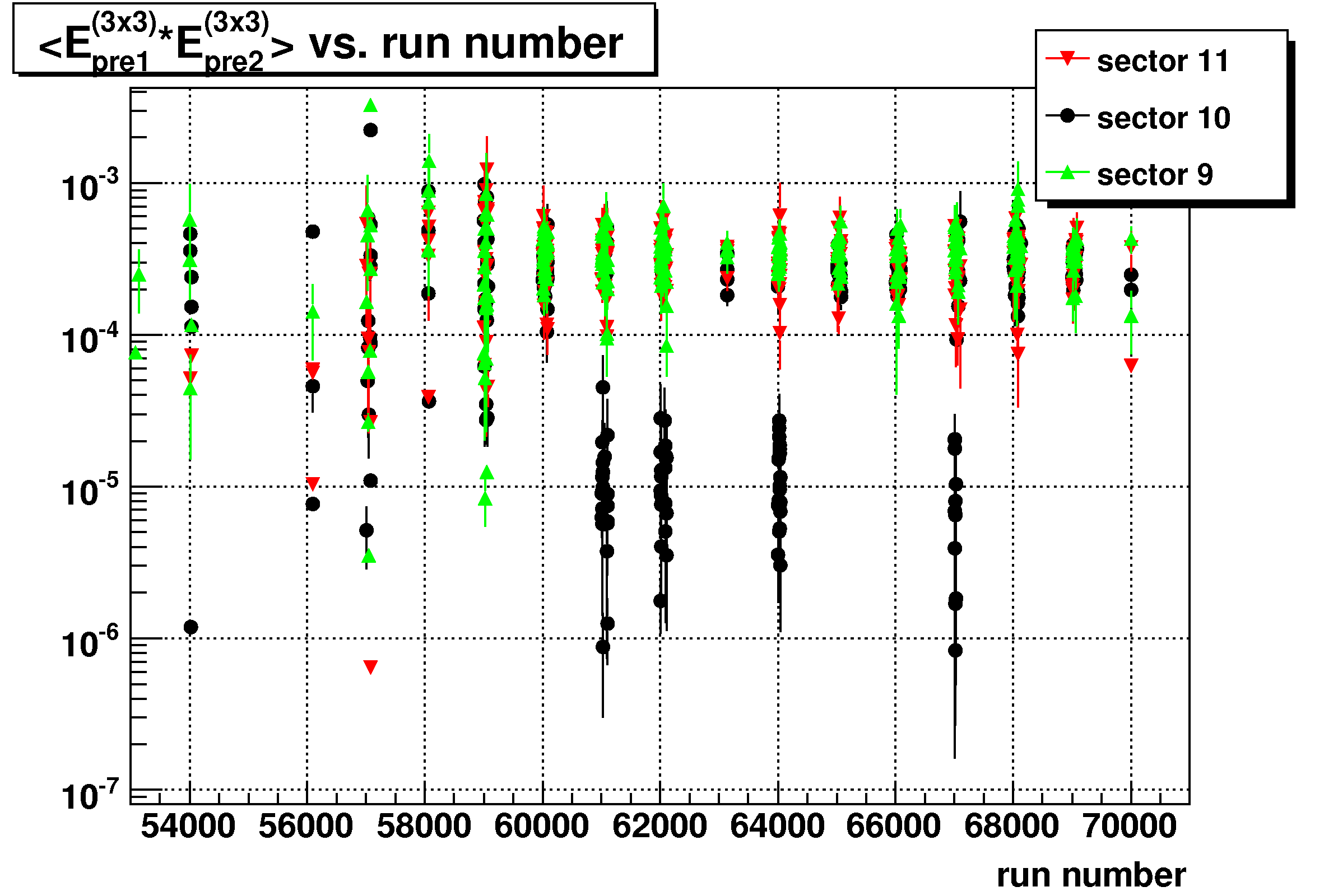
Figure 3a: Same as Fig.3, zoom into day 61
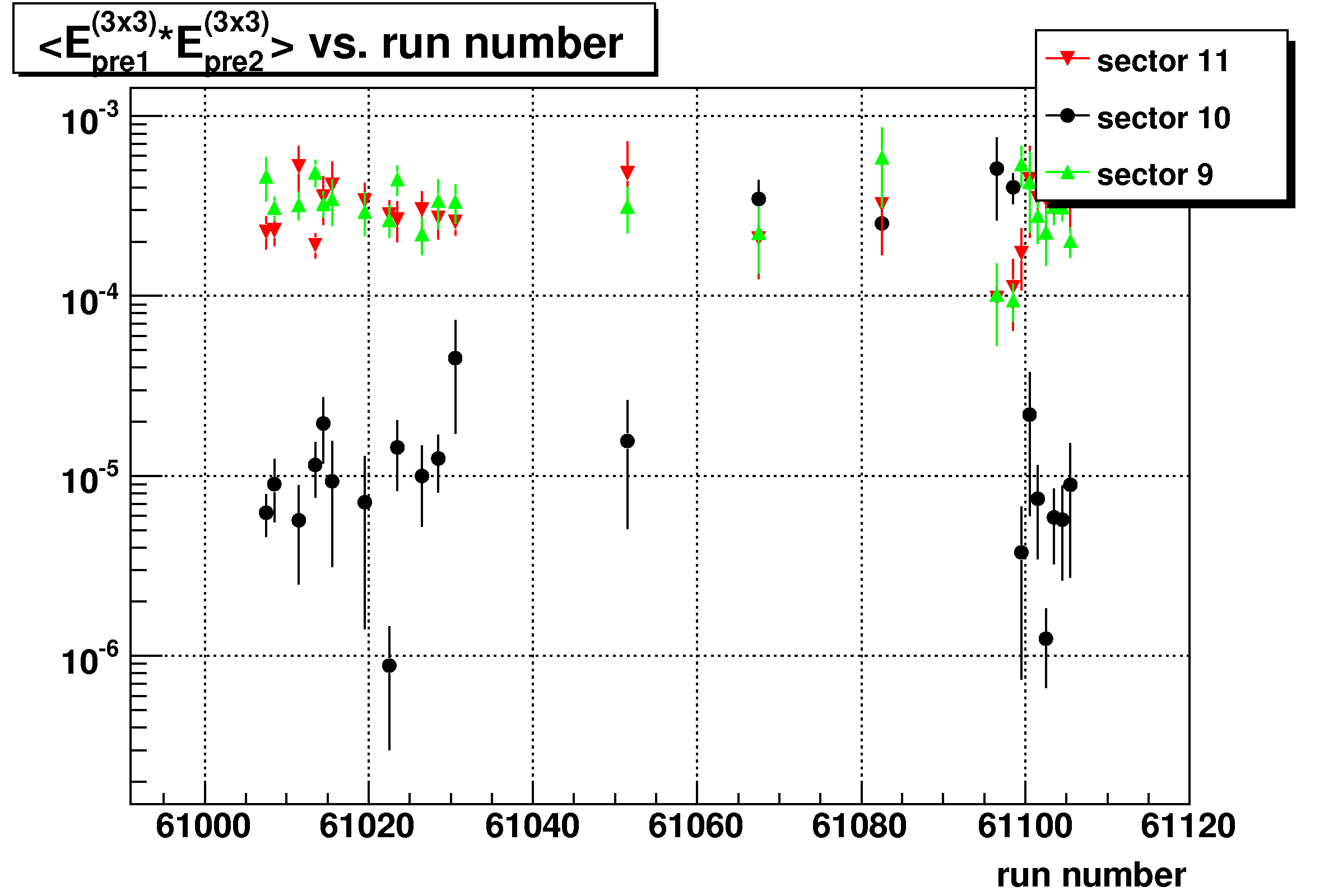
Figure 3b: Same as Fig.3, zoom into day 62
Figure 3c: Same as Fig.3, zoom into day 64
Figure 3d: Same as Fig.3, zoom into day 67
Figure 4: EEMC x vs. y position of photon candidate for 2008 data sample
Same as Fig. 1, but excluding days: 61, 62, 64, and 67
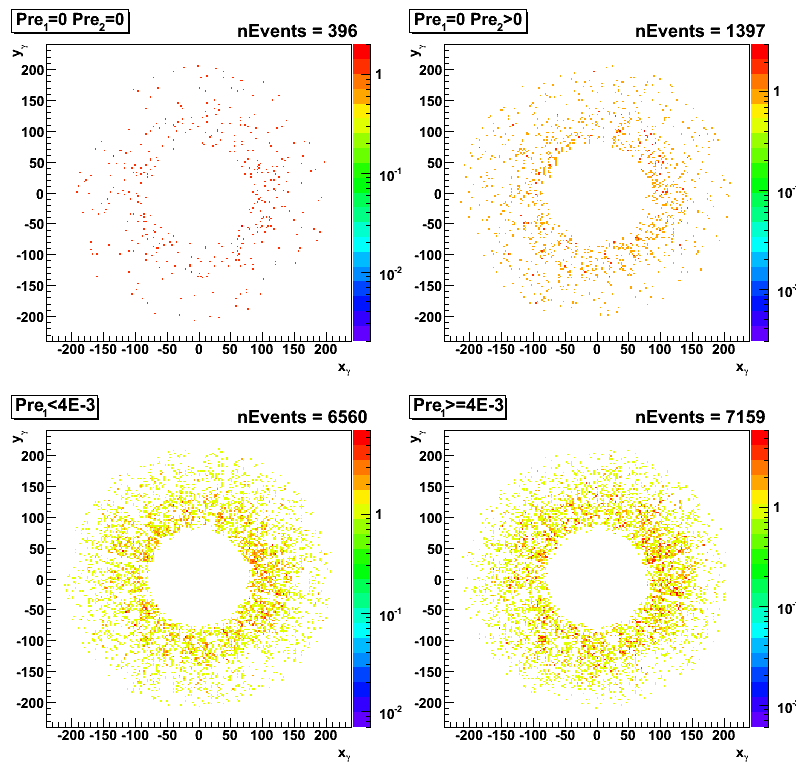
Conclusion on QA:
No problem with pp2008 data have been found,
except that for some runs (mostly on days 61, 62, 64, and 67)
EEMC pre-shower layer for sector 10 was off.
Comparison between 2006 and 2008 data
Figure 5: Vertex z distribution:
All gamma-jet cuts applied, plus pt_gamma>7 and pt_jet > 5 GeV (exlcuding days 61, 62, 64, and 67)
Results are shown for pp2008 data sample (black), vs. pp2006 data (red).
pp2008 data scaled to the same total number of candidates as in pp2006 data.

Figure 6: Shower shapes within +/- 30 strips from high strip (same cuts as in Fig. 5):

Figure 7: Shower shapes within +/- 5 strips from high strip
(same cuts as in Fig. 5, no scaling):

2008.12.09 pp Run 8 vs. Run 6 SMD shower shapes
Ilya Selyuzhenkov December 09, 2008
Data sets:
- pp2006 - STAR 2006 pp longitudinal data (~ 3.164 pb^1)
Trigger: eemc-http-mb-L2gamma [id:137641] - pp2008 - STAR 2008 pp data
Trigger: etot-mb-l2 [id:7]
Days: 53-70; ~0.5M triggered events (1/3 of available statistics)
2008.12.09 pp Run 8 vs. Run 6 SMD shower shapes
Ilya Selyuzhenkov December 09, 2008
Data sets:
- pp2006 - STAR 2006 pp longitudinal data (~ 3.164 pb^1)
Trigger: eemc-http-mb-L2gamma [id:137641] - pp2008 - STAR 2008 pp data
Trigger: etot-mb-l2 [id:7]
Days: 53-70; ~0.5M triggered events (1/3 of available statistics)
Gamma-jet analysis cuts:
- Select only di-jet events
- cos(phi_gamma - phi_jet) < -0.8 : gamma-jet opposite in phi
- R_EM^jet < 0.9 : neutral energy fraction cut for the away side jet
- N_ch=0 : no charge tracks associated with a gamma candidate
- N_bTow = 0 : no barrel towers associated with a gamma candidate (gamma in the endcap)
- N_(5-strip cluster)^u > 2 : minimum number of strips in EEMC SMD u-plane cluster around peak
- N_(5-strip cluster)^v > 2 : minimum number of strips in EEMC SMD v-plane cluster around peak
- gamma-algo fail : my algorithm failed to match tower with SMD uv-intersection, etc...
- Tow:SMD match : SMD uv-intersection has a tower which is not in a 3x3 cluster
- R_{3x3cluster}: Energy in 3x3 cluster of EEMC tower to the total jet energy (not applied here)
Comparison between 2006 and 2008 data
Figure 1: Vertex z distribution:
All gamma-jet cuts applied, plus pt_gamma>7 and pt_jet > 5 GeV (exlcuding days 61, 62, 64, and 67)
Results are shown for pp2008 data sample (black), vs. pp2006 data (red).
pp2008 data scaled to the same total number of candidates as in pp2006 data.

Figure 2: Shower shapes within +/- 30 strips from high strip (same cuts as in Fig. 1):

Figure 3: Shower shapes within +/- 5 strips from high strip
(same cuts as in Fig. 1, no scaling):

2008.12.09 pp Run 8 vs. Run 6 SMD shower shapes
Ilya Selyuzhenkov December 09, 2008
Data sets:
- pp2006 - STAR 2006 pp longitudinal data (~ 3.164 pb^1)
Trigger: eemc-http-mb-L2gamma [id:137641] - pp2008 - STAR 2008 pp data
Trigger: etot-mb-l2 [id:7]
Days: 53-70; ~0.5M triggered events (1/3 of available statistics)
Gamma-jet analysis cuts:
- Select only di-jet events
- cos(phi_gamma - phi_jet) < -0.8 : gamma-jet opposite in phi
- R_EM^jet < 0.9 : neutral energy fraction cut for the away side jet
- N_ch=0 : no charge tracks associated with a gamma candidate
- N_bTow = 0 : no barrel towers associated with a gamma candidate (gamma in the endcap)
- N_(5-strip cluster)^u > 2 : minimum number of strips in EEMC SMD u-plane cluster around peak
- N_(5-strip cluster)^v > 2 : minimum number of strips in EEMC SMD v-plane cluster around peak
- gamma-algo fail : my algorithm failed to match tower with SMD uv-intersection, etc...
- Tow:SMD match : SMD uv-intersection has a tower which is not in a 3x3 cluster
- R_{3x3cluster}: Energy in 3x3 cluster of EEMC tower to the total jet energy (not applied here)
Comparison between 2006 and 2008 data
Figure 1: Vertex z distribution:
All gamma-jet cuts applied, plus pt_gamma>7 and pt_jet > 5 GeV (exlcuding days 61, 62, 64, and 67)
Results are shown for pp2008 data sample (black), vs. pp2006 data (red).
pp2008 data scaled to the same total number of candidates as in pp2006 data.

Figure 2: Shower shapes within +/- 30 strips from high strip (same cuts as in Fig. 1):

Figure 3: Shower shapes within +/- 5 strips from high strip
(same cuts as in Fig. 1, no scaling):

2008.12.09 pp Run 8 vs. Run 6 SMD shower shapes
Ilya Selyuzhenkov December 09, 2008
Data sets:
- pp2006 - STAR 2006 pp longitudinal data (~ 3.164 pb^1)
Trigger: eemc-http-mb-L2gamma [id:137641] - pp2008 - STAR 2008 pp data
Trigger: etot-mb-l2 [id:7]
Days: 53-70; ~0.5M triggered events (1/3 of available statistics)
Gamma-jet analysis cuts:
- Select only di-jet events
- cos(phi_gamma - phi_jet) < -0.8 : gamma-jet opposite in phi
- R_EM^jet < 0.9 : neutral energy fraction cut for the away side jet
- N_ch=0 : no charge tracks associated with a gamma candidate
- N_bTow = 0 : no barrel towers associated with a gamma candidate (gamma in the endcap)
- N_(5-strip cluster)^u > 2 : minimum number of strips in EEMC SMD u-plane cluster around peak
- N_(5-strip cluster)^v > 2 : minimum number of strips in EEMC SMD v-plane cluster around peak
- gamma-algo fail : my algorithm failed to match tower with SMD uv-intersection, etc...
- Tow:SMD match : SMD uv-intersection has a tower which is not in a 3x3 cluster
- R_{3x3cluster}: Energy in 3x3 cluster of EEMC tower to the total jet energy (not applied here)
Comparison between 2006 and 2008 data
Figure 1: Vertex z distribution:
All gamma-jet cuts applied, plus pt_gamma>7 and pt_jet > 5 GeV (exlcuding days 61, 62, 64, and 67)
Results are shown for pp2008 data sample (black), vs. pp2006 data (red).
pp2008 data scaled to the same total number of candidates as in pp2006 data.

Figure 2: Shower shapes within +/- 30 strips from high strip (same cuts as in Fig. 1):

Figure 3: Shower shapes within +/- 5 strips from high strip
(same cuts as in Fig. 1, no scaling):

2008.12.09 pp Run 8 vs. Run 6 SMD shower shapes
Ilya Selyuzhenkov December 09, 2008
Data sets:
- pp2006 - STAR 2006 pp longitudinal data (~ 3.164 pb^1)
Trigger: eemc-http-mb-L2gamma [id:137641] - pp2008 - STAR 2008 pp data
Trigger: etot-mb-l2 [id:7]
Days: 53-70; ~0.5M triggered events (1/3 of available statistics)
Gamma-jet analysis cuts:
- Select only di-jet events
- cos(phi_gamma - phi_jet) < -0.8 : gamma-jet opposite in phi
- R_EM^jet < 0.9 : neutral energy fraction cut for the away side jet
- N_ch=0 : no charge tracks associated with a gamma candidate
- N_bTow = 0 : no barrel towers associated with a gamma candidate (gamma in the endcap)
- N_(5-strip cluster)^u > 2 : minimum number of strips in EEMC SMD u-plane cluster around peak
- N_(5-strip cluster)^v > 2 : minimum number of strips in EEMC SMD v-plane cluster around peak
- gamma-algo fail : my algorithm failed to match tower with SMD uv-intersection, etc...
- Tow:SMD match : SMD uv-intersection has a tower which is not in a 3x3 cluster
- R_{3x3cluster}: Energy in 3x3 cluster of EEMC tower to the total jet energy (not applied here)
Comparison between 2006 and 2008 data
Figure 1: Vertex z distribution:
All gamma-jet cuts applied, plus pt_gamma>7 and pt_jet > 5 GeV (exlcuding days 61, 62, 64, and 67)
Results are shown for pp2008 data sample (black), vs. pp2006 data (red).
pp2008 data scaled to the same total number of candidates as in pp2006 data.

Figure 2: Shower shapes within +/- 30 strips from high strip (same cuts as in Fig. 1):

Figure 3: Shower shapes within +/- 5 strips from high strip
(same cuts as in Fig. 1, no scaling):

Conclusion:
2008.12.09 pp Run 8 vs. Run 6 shower shapes
Ilya Selyuzhenkov December 09, 2008
Data sets:
- pp2006 - STAR 2006 pp longitudinal data (~ 3.164 pb^1)
Trigger: eemc-http-mb-L2gamma [id:137641] - pp2008 - STAR 2008 pp data
Trigger: etot-mb-l2 [id:7]
Days: 53-70; ~0.5M triggered events (1/3 of available statistics)
Gamma-jet analysis cuts:
- Select only di-jet events
- cos(phi_gamma - phi_jet) < -0.8 : gamma-jet opposite in phi
- R_EM^jet < 0.9 : neutral energy fraction cut for the away side jet
- N_ch=0 : no charge tracks associated with a gamma candidate
- N_bTow = 0 : no barrel towers associated with a gamma candidate (gamma in the endcap)
- N_(5-strip cluster)^u > 2 : minimum number of strips in EEMC SMD u-plane cluster around peak
- N_(5-strip cluster)^v > 2 : minimum number of strips in EEMC SMD v-plane cluster around peak
- gamma-algo fail : my algorithm failed to match tower with SMD uv-intersection, etc...
- Tow:SMD match : SMD uv-intersection has a tower which is not in a 3x3 cluster
- R_{3x3cluster}: Energy in 3x3 cluster of EEMC tower to the total jet energy (not applied here)
Comparison between 2006 and 2008 data
Figure 1: Vertex z distribution:
All gamma-jet cuts applied, plus pt_gamma>7 and pt_jet > 5 GeV (exlcuding days 61, 62, 64, and 67)
Results are shown for pp2008 data sample (black), vs. pp2006 data (red).
pp2008 data scaled to the same total number of candidates as in pp2006 data.

Figure 2: Shower shapes within +/- 30 strips from high strip (same cuts as in Fig. 1):

Figure 3: Shower shapes within +/- 5 strips from high strip
(same cuts as in Fig. 1, no scaling):

2008.12.11 Run 8 EEMC QA (presentation for Spin PWG)
Ilya Selyuzhenkov December 11, 2008
Run 8 QA with EEMC gamma-jet candidates
Presentation in pdf or open office file format
2008.12.16 Effect of L2gamma trigger in simulations
Ilya Selyuzhenkov December 16, 2008
Data sets
- pp2006 - STAR 2006 pp longitudinal data (~ 3.164 pb^1)
Trigger: eemc-http-mb-L2gamma [id:137641] - gamma-jet[gamma-filtered] - data-driven Prompt Photon [p6410EemcGammaFilter] events.
Partonic pt range 2-25 GeV. - QCD jets[gamma-filtered] - data-driven QCD [p6410EemcGammaFilter] events.
Partonic pt range 2-25 GeV.
Cuts applied
Gamma-jet isolation cuts except 3x3/r=0.7 energy isolation cut
Data driven shower shape replacement maker fix
Figure 1: (reproducing old results with dd-maker fix)
transverse momentum and vertex z distributions
before (with ideal gains/pedestals) and
after (with realistic gains/pedestal tables) dd-maker fix are in a good agreement.
For details on "dd-maker problem", read these hyper news threads:
emc2:2905, emc2:2900, and phana:294
Now we can run L2gamma trigger emulation and Eemc SMD ddMaker
in the same analysis chain.
l2-gamma trigger effect in simulation
Figure 2: Vertex z distribution with and without trigger condition in simulations
(emulated trigger: eemc-http-mb-L2gamma [id:137641]).
Solid red/green symbols show results with l2gamma condition applied,
while red/green lines show results for the same analysis cuts but without trigger condition.
Note, good agreement between MC QCD jets with trigger condition on (green solid squared)
and pp2006 data (black solid circles) for pre-shower1>0 case.

Figure 3: pt distribution with/without trigger condition in simulations.
Same color coding as in Fig. 2

Figure 4: Same as Fig. 3 just on a log scale
One can clearly see large trigger effect when applied for QCD jet events,
and a little effect for direct gammas.

Figure 5: gamma candidate pt QCD (right) and prompt photon (left) Monte-Carlo:
no (upper) with (lower) L2e-gamma trigger condition
No photon pt and no jet pt cuts

Figure 6: gamma candidate pt for QCD Monte-Carlo: no L2e-gamma trigger condition
No photon pt and no jet pt cuts
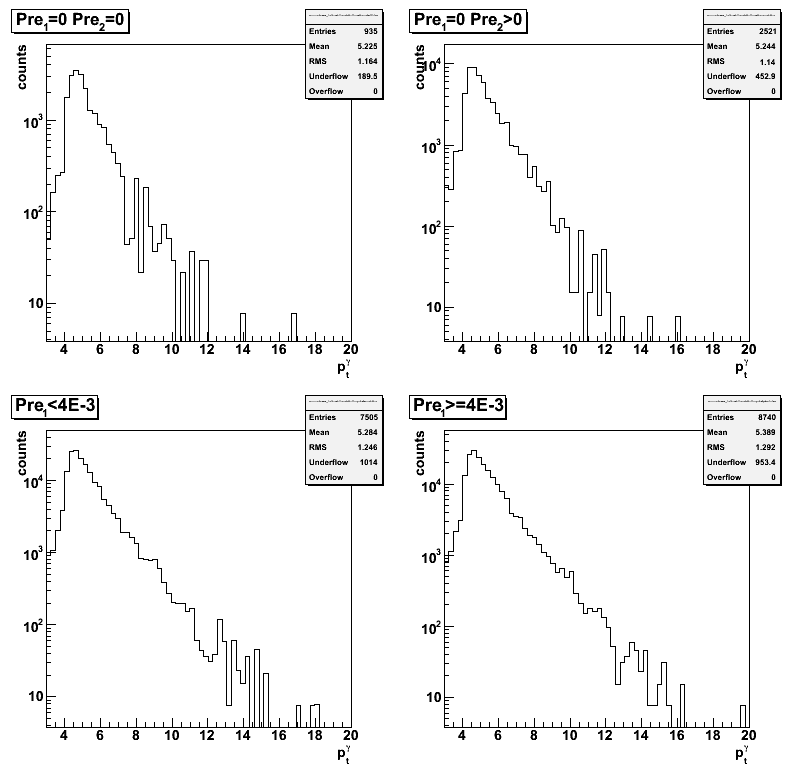
Figure 7: gamma candidate pt for QCD Monte-Carlo: L2e-gamma trigger condition applied (id:137641)
No photon pt and no jet pt cuts
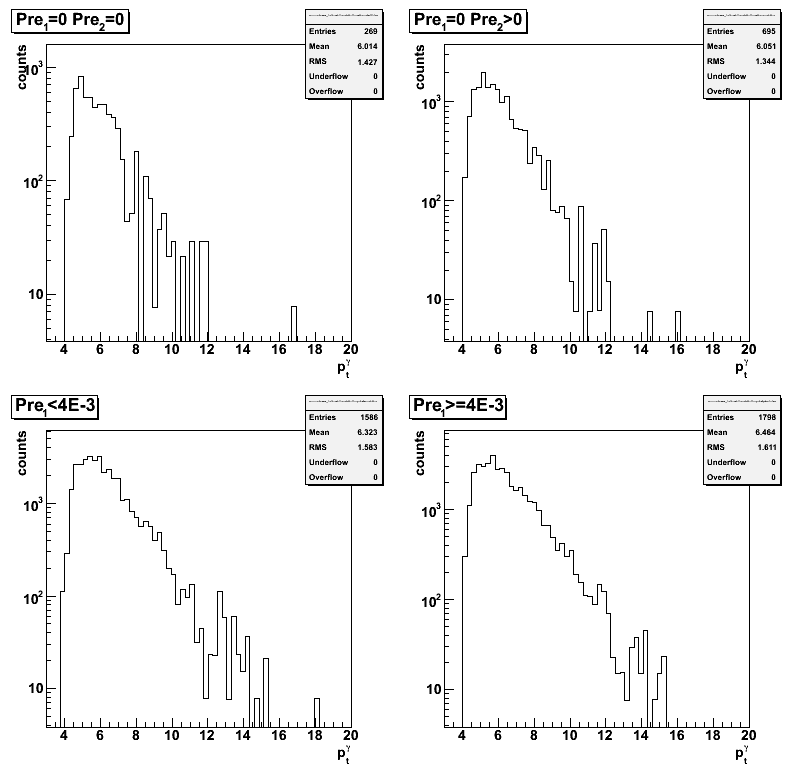
2008.12.19 Parton pt distribution for Pythia QCD and gamma-jet events
Ilya Selyuzhenkov December 19, 2008
Data sets
- gamma-jet[gamma-filtered] - data-driven Prompt Photon [p6410EemcGammaFilter] events.
Partonic pt range 2-25 GeV. - QCD jets[gamma-filtered] - data-driven QCD [p6410EemcGammaFilter] events.
Partonic pt range 2-25 GeV.
Cuts applied
Gamma-jet isolation cuts except 3x3/r=0.7 energy isolation cut
Figure 1: Parton pt distibution for gamma-jet candidates from Pythia QCD sample
with various pt and l2gamma trigger conditions
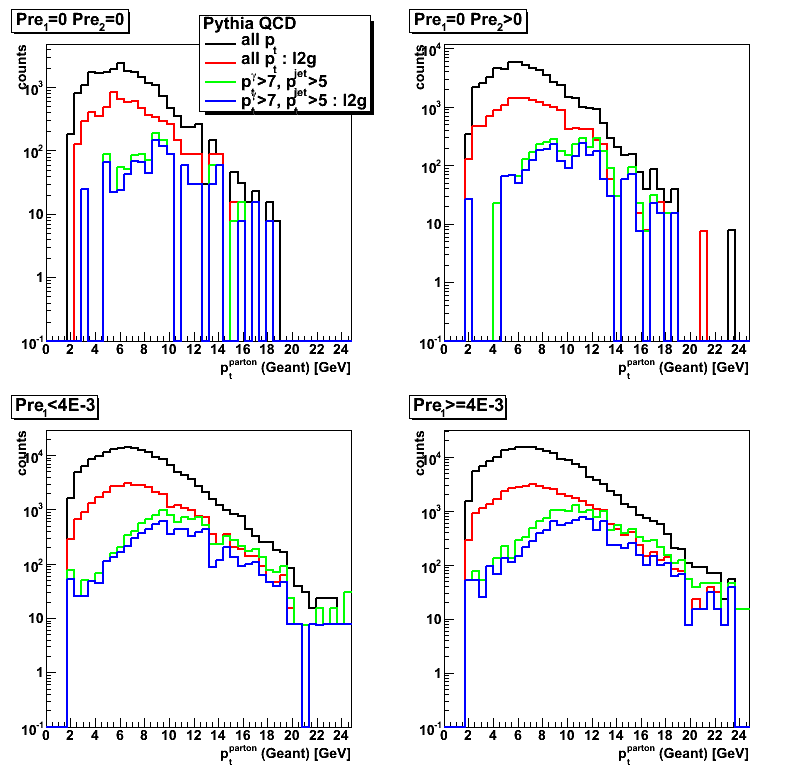
Figure 2: Parton pt distibution for gamma-jet candidates from Pythia prompt photon sample
with various pt and l2gamma trigger conditions
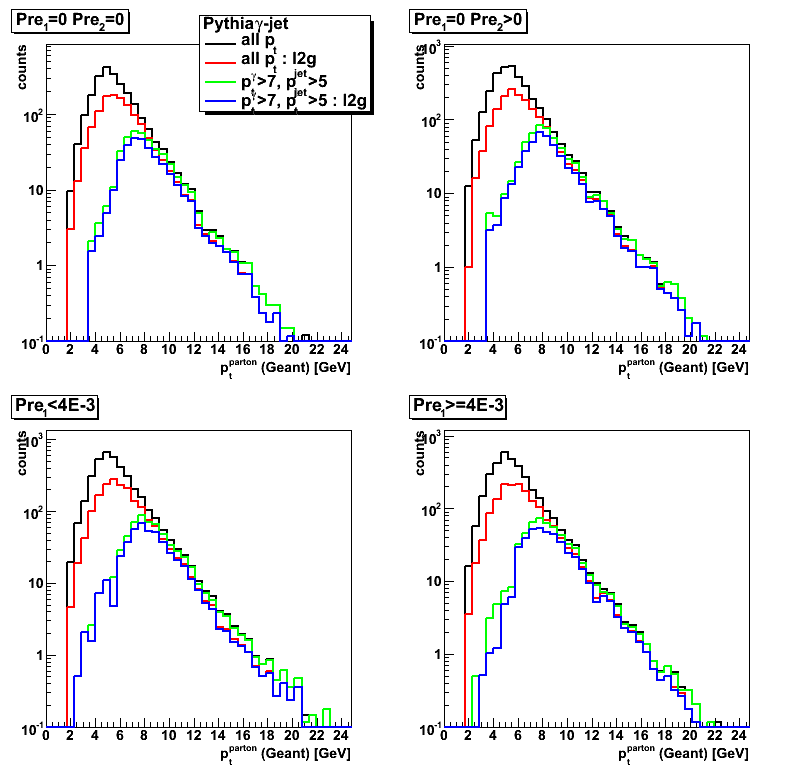
2009
Year 2009 posts
01 Jan
January 2009 posts
2009.01.08 Away side jet pt vs. photon pt
Ilya Selyuzhenkov January 08, 2009
Data sets
- pp2006 - STAR 2006 pp longitudinal data (~ 3.164 pb^1)
Trigger: eemc-http-mb-L2gamma [id:137641] - gamma-jet[gamma-filtered] - data-driven Prompt Photon [p6410EemcGammaFilter] events.
Partonic pt range 2-25 GeV. - QCD jets[gamma-filtered] - data-driven QCD [p6410EemcGammaFilter] events.
Partonic pt range 2-25 GeV.
Cuts applied
- Di-jet events
- Require to reconstruct photon momentum (no gamma-jet isolation cuts)
- Gamma pt > 7GeV
- L2gamma emulation in Monte-Carlo
- L2gamma triggered pp2006 events
Comments
(concentrated on pre-shower1>0 case
which has better statistics for QCD Monte-Carlo):
- Fig.1, lower plots
Vertex z distributions from QCD MC and pp2006 data are different in the negative region - Fig.2, lower plots
For the away side jet pt < 8GeV region
QCD Monte-Carlo underestimates the data. - Fig.4, lower plots
gamma-jet pt asymmetry plot shows
that in QCD MC photon and jet pt's are better correlated than in the data - Fig.5, lower plots
Most of the differences between QCD MC and pp2006 data for pre-shower1>0 case
are probably from the lower gamma and jet pt region
Figures
Figure 1: Vertex z distribution

Figure 4: gamma-jet pt asymmetry: (pt_gamma - pt_jet)/pt_gamma

Figure 5: gamma pt vs. away side jet pt
1st column: triggered pp2006 data
2nd column: gamma-jet MC (l2gamma trigger on)
3rd column: QCD background MC (l2gamma trigger on)

2009.01.20 Away side jet pt vs. photon pt: more stats for QCD pt_parton 9-15GeV
Ilya Selyuzhenkov January 20, 2009
Note:
this is an update with 10x more statitstics for QCD 9-15GeV parton pt bin.
See this post for old results.
Data sets
- pp2006 - STAR 2006 pp longitudinal data (~ 3.164 pb^1)
Trigger: eemc-http-mb-L2gamma [id:137641] - gamma-jet[gamma-filtered] - data-driven Prompt Photon [p6410EemcGammaFilter] events.
Partonic pt range 2-25 GeV. - QCD jets[gamma-filtered] - data-driven QCD [p6410EemcGammaFilter] events.
Partonic pt range 2-25 GeV.
Cuts applied
- Di-jet events
- Require to reconstruct photon momentum (no gamma-jet isolation cuts)
- Gamma pt > 7GeV
- L2gamma emulation in Monte-Carlo
- L2gamma triggered pp2006 events
Comments
- Vertex z distributions from QCD MC and pp2006 data
are different in the negative region (see Fig.1) - pp2006 data to Monte-Carlo ratio
does not depends on reconstructed photon pt,
but it has some vertex z dependence
(see data to MC ratio in Fig.6 for pre-shower1 > 4MeV case)
Figures
Figure 1: Vertex z distribution

Figure 4: gamma-jet pt asymmetry: (pt_gamma - pt_jet)/pt_gamma

Figure 5: gamma pt vs. away side jet pt
1st column: triggered pp2006 data
2nd column: gamma-jet MC (l2gamma trigger on)
3rd column: QCD background MC (l2gamma trigger on)

Data to Monte_Carlo normalization
Figure 6: pp2006 data to Monte -Carlo sum [QCD + gamma-jet] ratio
for pre-shower1>4MeV (most of statistics)
Left: data to MC ratio vs. reconstructed gamma pt.
Solid line shows constant line fit (p0 ~ 1.3)
Right: data to MC ratio vs. reconstructed vertex position

2009.01.27 gamma and jet pt plots with detector |eta|_jet < 0.8, pt_jet > 7
Ilya Selyuzhenkov January 27, 2009
Data sets
- pp2006 - STAR 2006 pp longitudinal data (~ 3.164 pb^1)
Trigger: eemc-http-mb-L2gamma [id:137641] - gamma-jet[gamma-filtered] - data-driven Prompt Photon [p6410EemcGammaFilter] events.
Partonic pt range 2-25 GeV. - QCD jets[gamma-filtered] - data-driven QCD [p6410EemcGammaFilter] events.
Partonic pt range 2-25 GeV.
Cuts applied
- Di-jet events
- Require to reconstruct photon momentum (no gamma-jet isolation cuts)
- jet pt > 7GeV
- Gamma pt > 7GeV or no pt cuts
- L2gamma emulation in Monte-Carlo
- L2gamma triggered pp2006 events
- cos (phi_jet - phi_gamma) < -0.8
- detector |eta_jet|< 0.8
- |v_z| < 100
Figures
All figures:
- All pre-shower conditions combined, pre1<10MeV
- Left plots: no gamma pt cut
Right plots: pt_gamma >7GeV - Thick blue line shows MC sum: QCD + gamma-jet
- Thin solid color lines shows distributions from various partonic pt bins for QCD MC
See figures legend for color coding
2009.01.27 gamma and jet pt plots with |eta|_jet < 0.7
Ilya Selyuzhenkov January 27, 2009
Data sets
- pp2006 - STAR 2006 pp longitudinal data (~ 3.164 pb^1)
Trigger: eemc-http-mb-L2gamma [id:137641] - gamma-jet[gamma-filtered] - data-driven Prompt Photon [p6410EemcGammaFilter] events.
Partonic pt range 2-25 GeV. - QCD jets[gamma-filtered] - data-driven QCD [p6410EemcGammaFilter] events.
Partonic pt range 2-25 GeV.
Cuts applied
- Di-jet events
- Require to reconstruct photon momentum (no gamma-jet isolation cuts)
- Gamma pt > 7GeV or no pt cuts
- L2gamma emulation in Monte-Carlo
- L2gamma triggered pp2006 events
- cos (phi_jet - phi_gamma) < -0.8
- |eta_jet|< 0.7
- |v_z| < 100
Figures
All figures:
- All pre-shower conditions combined, pre1<10MeV
- Left plots: no gamma pt cut
Right plots: pt_gamma >7GeV - Thick blue line shows MC sum: QCD + gamma-jet
- Thin solid color lines shows distributions from various partonic pt bins for QCD MC
See figures legend for color coding
Figure 1: Vertex z distribution
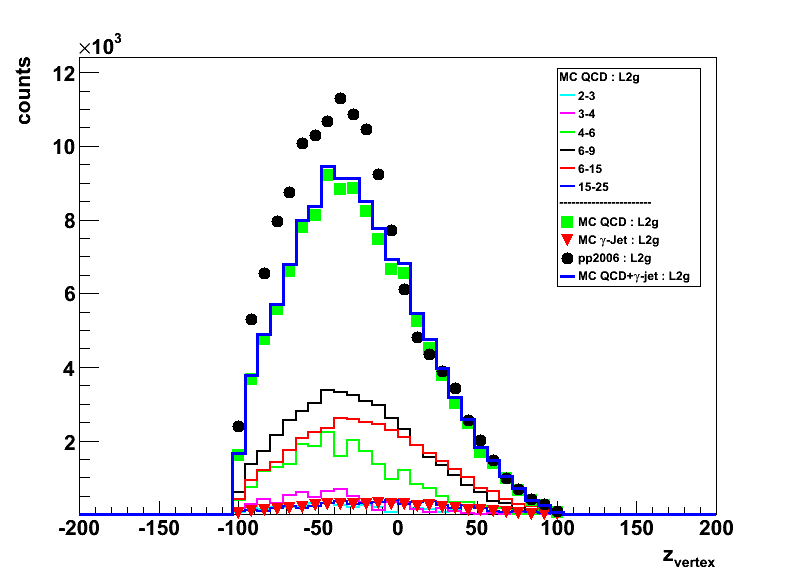
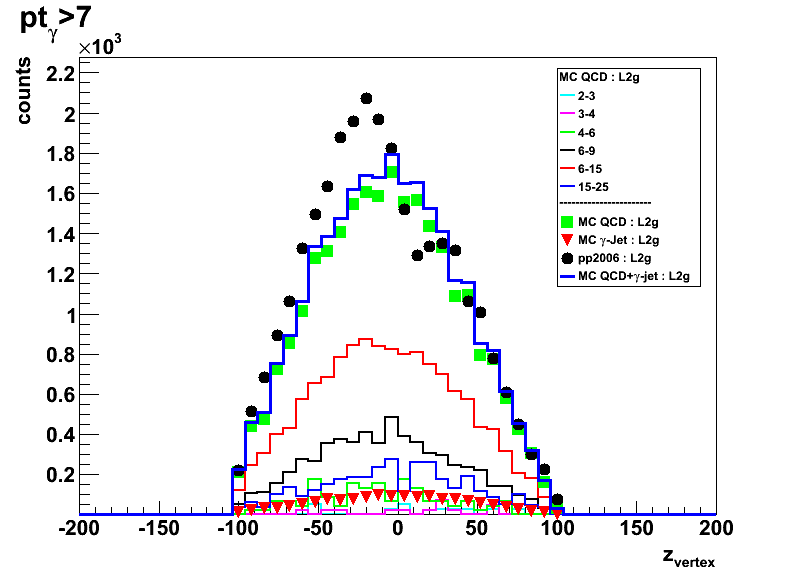
Figure 4:Photon pt

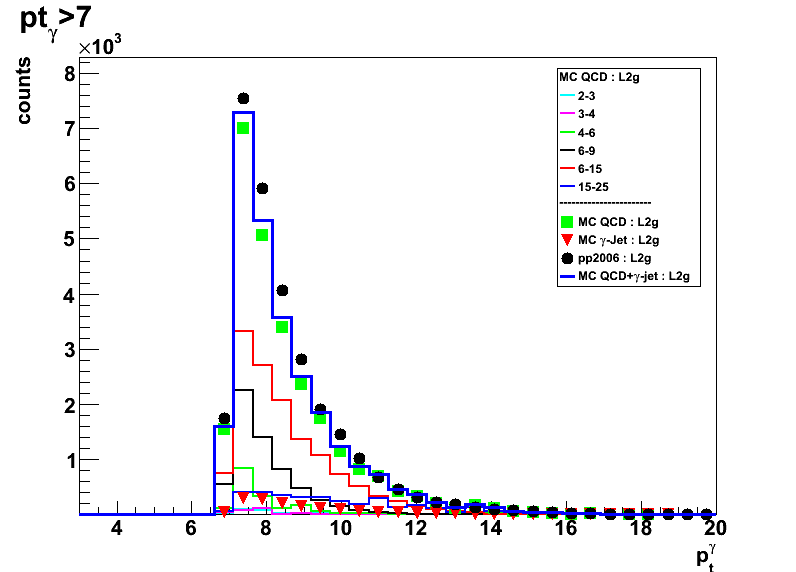
Same as in Fig.4 on a log scale: no gamma pt cut and pt>7GeV
Figure 5: Away side jet pt
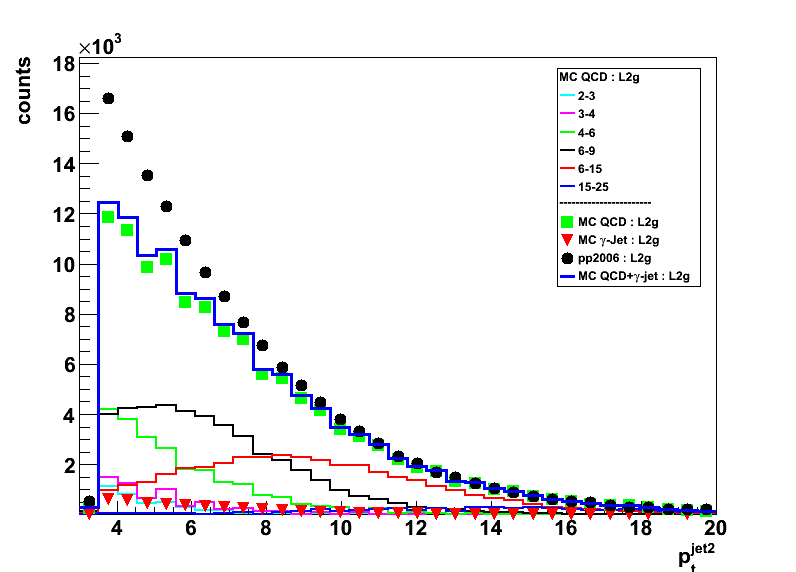
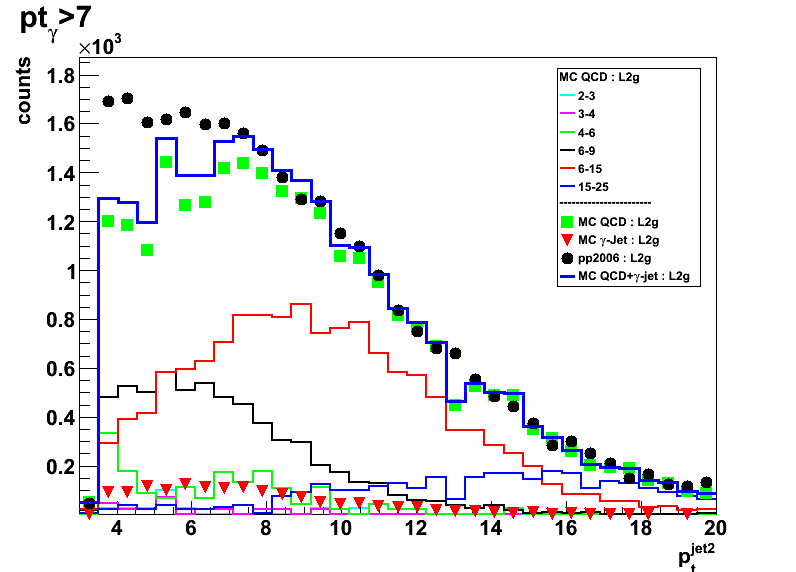
Same as in Fig.5 on a log scale: no gamma pt cut and pt>7GeV
02 Feb
February 2009 posts
2009.02.02 No pre-shower cuts, Normalization fudge factor 1.24
Ilya Selyuzhenkov February 02, 2009
Data sets
- pp2006 - STAR 2006 pp longitudinal data (~ 3.164 pb^1)
Trigger: eemc-http-mb-L2gamma [id:137641] - gamma-jet[gamma-filtered] - data-driven Prompt Photon [p6410EemcGammaFilter] events.
Partonic pt range 2-25 GeV. - QCD jets[gamma-filtered] - data-driven QCD [p6410EemcGammaFilter] events.
Partonic pt range 2-25 GeV.
Cuts applied
- Di-jet events
- Require to reconstruct photon momentum (no gamma-jet isolation cuts)
- Gamma pt > 7GeV
- L2gamma emulation in Monte-Carlo
- L2gamma triggered pp2006 events
- cos (phi_jet - phi_gamma) < -0.8
- detector |eta_jet|< 0.8
- |v_z| < 100
Figures
All figures:
- All pre-shower conditions combined, No pre-shower cuts
- Thick blue line shows MC sum: QCD + gamma-jet
- Black solid circles: pp2006 data
- Monte-Carlo results first scaled to 3.164 pb^-1 according to Pythia luminosity
and then an additional fudge factor of 1.24 has been applied.
Fudge factor is defined as the yields ratio from data to scaled with Pythia luminosity Monte-Carlo
for pt_jet>7GeV and pt_gamma>7 candidates
Figure 1: Vertex z distribution with pt_jet>7 cut (left) and without pt_jet cut (rigth)
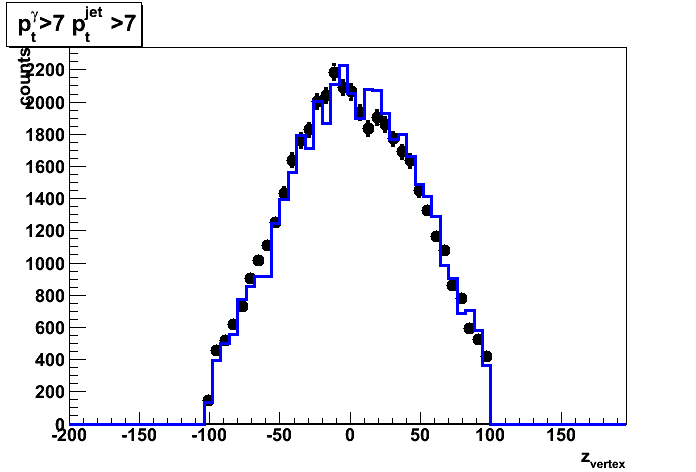
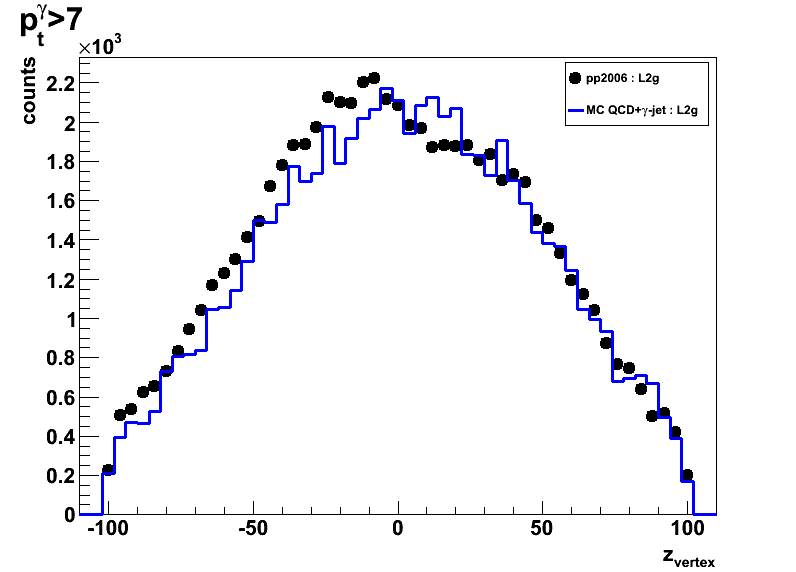
Figure 2: Photon (left) and away side jet (right) pt
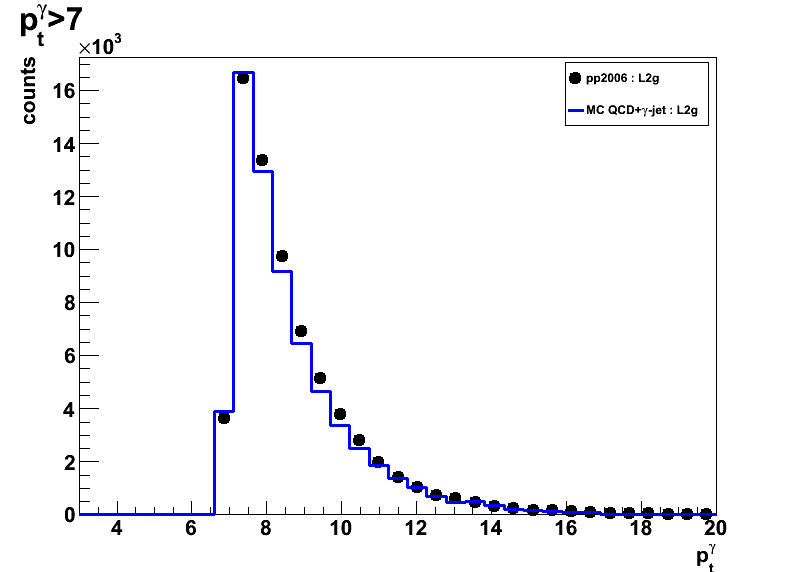
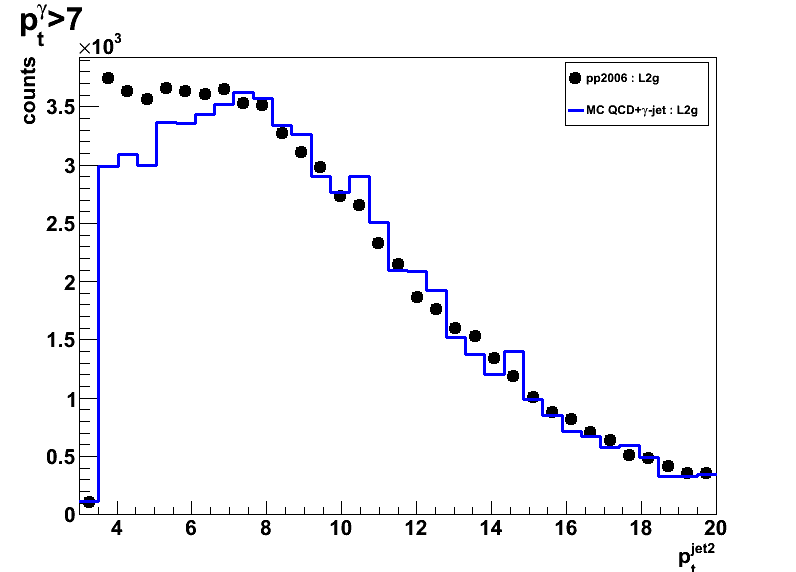
Figure 3: Photon detector eta (left) and corrected for vertex eta (right)
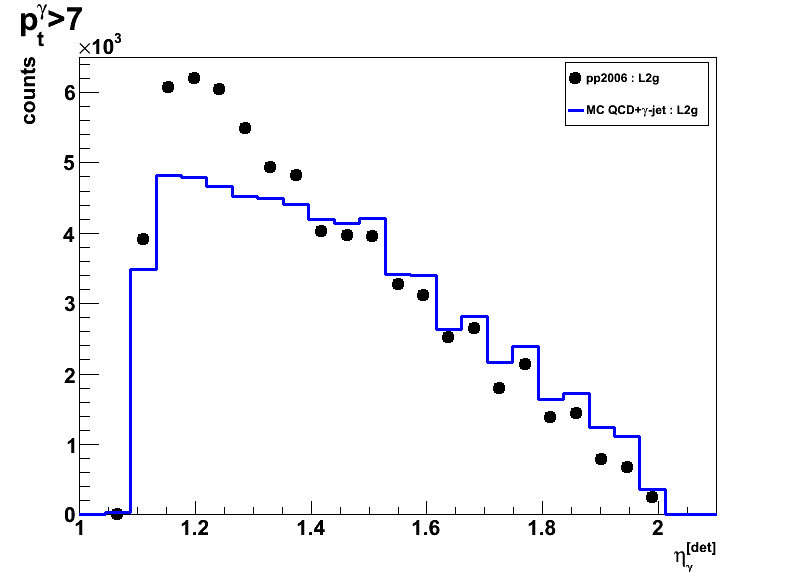

Figure 4: Away side jet detector eta (left) and corrected for vertex eta (right)
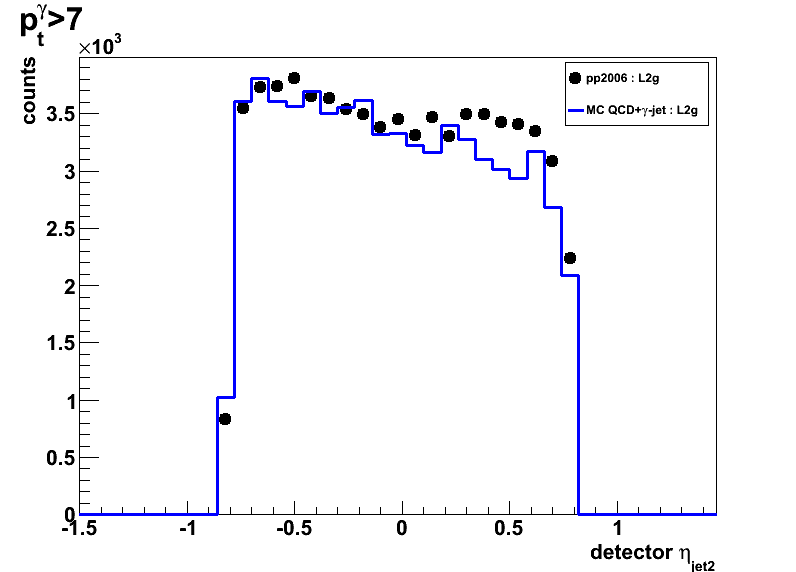
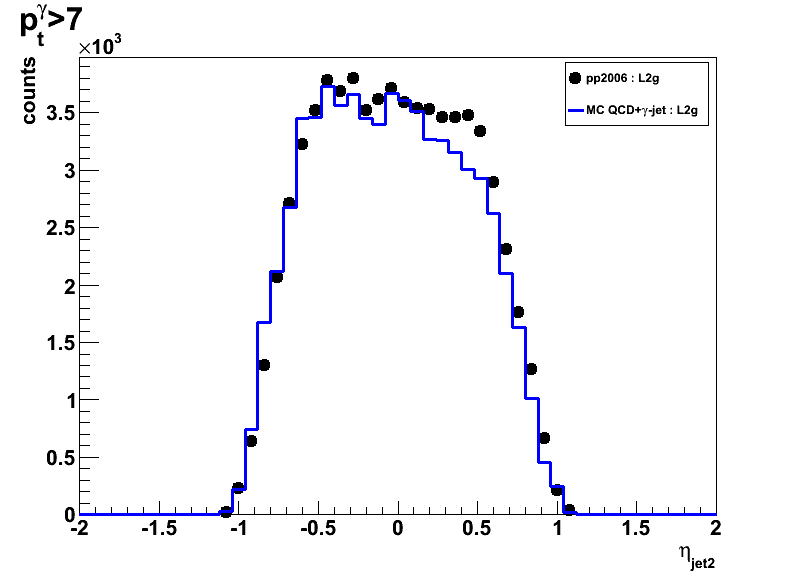
2009.02.03 No pre-shower cuts, pt_jet >7 vs. No pt_jet cuts
Ilya Selyuzhenkov February 03, 2009
Data sets
- pp2006 - STAR 2006 pp longitudinal data (~ 3.164 pb^1)
Trigger: eemc-http-mb-L2gamma [id:137641] - gamma-jet[gamma-filtered] - data-driven Prompt Photon [p6410EemcGammaFilter] events.
Partonic pt range 2-25 GeV. - QCD jets[gamma-filtered] - data-driven QCD [p6410EemcGammaFilter] events.
Partonic pt range 2-25 GeV.
Cuts applied
- Di-jet events
- Require to reconstruct photon momentum (no gamma-jet isolation cuts)
- Gamma pt > 7GeV
- L2gamma emulation in Monte-Carlo
- L2gamma triggered pp2006 events
- cos (phi_jet - phi_gamma) < -0.8
- detector |eta_jet|< 0.8
- |v_z| < 100
Figures
Each figure has:
- All pre-shower conditions combined, No pre-shower cuts
- Thick blue line shows MC sum: QCD + gamma-jet
- Black solid circles shows pp2006 data
- Left plots: pt_jet>7GeV
Right plots: no cuts on pt_jet - Monte-Carlo results for QCD and gamma-jet samples are first
scaled to 3.164 pb^-1 according to Pythia luminosity,
added together, and then an additional fudge factor of 1.24 applied.
Fudge factor is defined as pp2006 to Monte-Carlo sum ratio
for pt_jet>7GeV and pt_gamma>7 candidates
Figure 1: Vertex z distribution
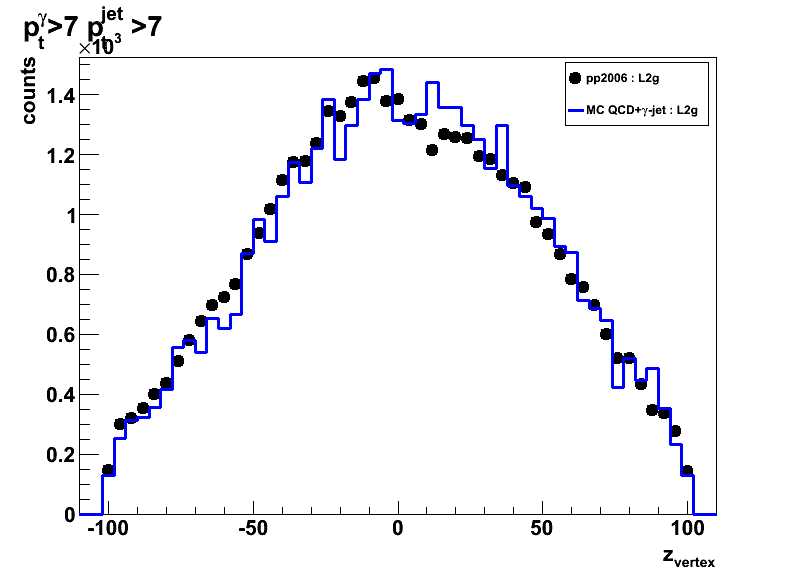
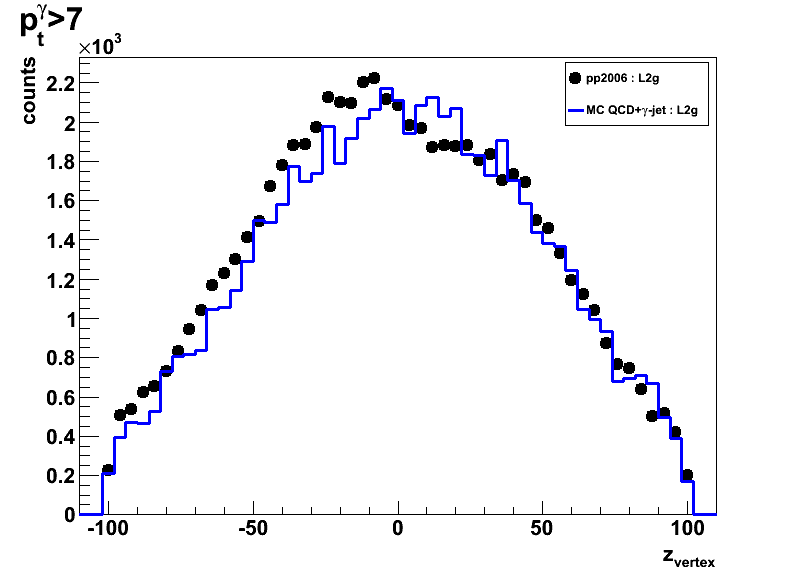
Figure 3: Corrected for vetrex photon eta
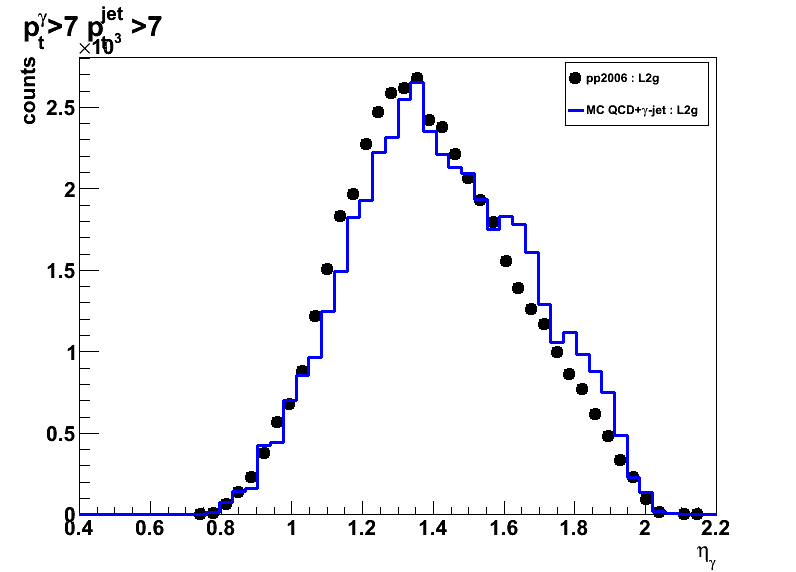
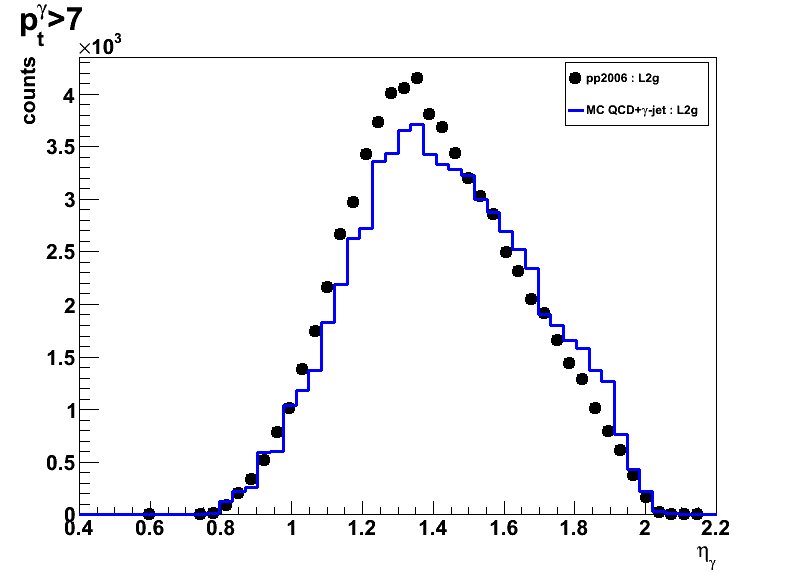
Figure 4: Away side jet detector eta
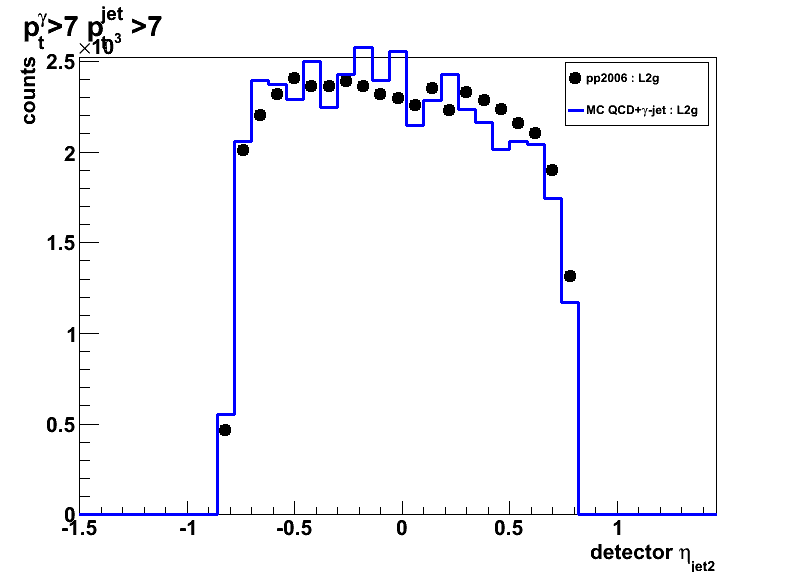
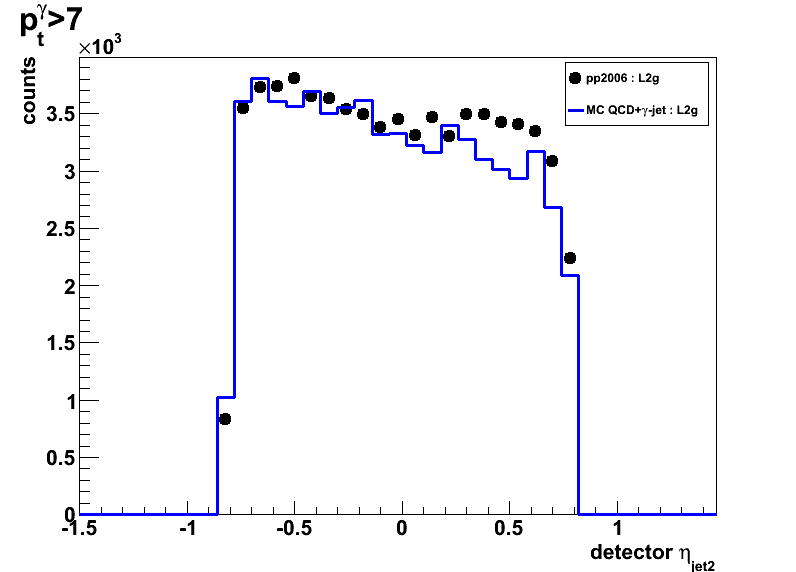
2009.02.06 Pre-shower energy distribution Run6 vs. Run8 geometry
Ilya Selyuzhenkov February 06, 2009
Data sets
- pp2006 - STAR 2006 pp longitudinal data (~ 3.164 pb^1)
Trigger: eemc-http-mb-L2gamma [id:137641] - mc2006: gamma-jet+QCD jets [p6410EemcGammaFilter] events.
- pp2008 - STAR 2008 pp data
Trigger: etot-mb-l2 [id:7]
Partonic pt range 2-25 GeV.
Cuts applied
- Di-jet events
- Require to reconstruct photon momentum (no gamma-jet isolation cuts)
- Gamma pt > 7GeV, jet pt > 7GeV
- L2gamma emulation in Monte-Carlo
- L2gamma triggered for pp2006 and pp2008 events
- cos (phi_jet - phi_gamma) < -0.8
- detector |eta_jet|< 0.8
- |v_z| < 100
Figures
Each figure has:
- All pre-shower conditions combined, No pre-shower cuts
- Red circles show pp2006 data
- Black triangles show pp2008 data
Data scaled to match the integraled yield from pp2006 data - Green line shows MC sum: QCD + gamma-jet
Monte-Carlo results for QCD and gamma-jet samples are first
scaled to 3.164 pb^-1 according to Pythia luminosity,
added together, and then an additional fudge factor of 1.24 applied.
Fudge factor is defined as pp2006 to Monte-Carlo sum ratio
for pt_jet>7GeV and pt_gamma>7 candidates
Observations
- Pre-shower energy distributions from pp2008 data set
are narrower than that for pp2006 data.
This corresponds to smaller amount of material budget in y2008 STAR geometry. - Pre-shower energy distribution from Monte-Carlo with y2006 geometry
closer follows the distribution from pp2008 data set, rather than that from pp2006 data.
This indicates the lack of material budget in y2006 Monte-Carlo.
Note: There is a "pre-shower sector 10 problem" for pp2008 data,
which results in migration of small fraction of events with pre-shower>0 into
pre-shower=0 bin (first zero bins in Fig.1 and 2. below).
For pre-shower>0 case this only affects overall normalization of pp2008 data,
but not the shape of pre-shower energy distributions.
I'm running jet-finder+my software to get more statistics from pp2008 data set,
and after more QA will produce list of runs with "pre-shower sector 10 problem",
so to exclude them in the next iteration of my plots.
2009.02.09 pp2006, pp2008, amd mc2006 comparison
Ilya Selyuzhenkov February 06, 2009
Data sets
- pp2006 - STAR 2006 pp longitudinal data (~ 3.164 pb^1)
Trigger: eemc-http-mb-L2gamma [id:137641] - mc2006: gamma-jet+QCD jets [p6410EemcGammaFilter] events.
- pp2008 - STAR 2008 pp data
Trigger: etot-mb-l2 [id:7]
Partonic pt range 2-25 GeV.
Cuts applied
- Di-jet events
- Require to reconstruct photon momentum (no gamma-jet isolation cuts)
- Gamma pt > 7GeV, jet pt > 7GeV
- L2gamma emulation in Monte-Carlo
- L2gamma triggered for pp2006 and pp2008 events
- cos (phi_jet - phi_gamma) < -0.8
- detector |eta_jet|< 0.8
- |v_z| < 100
Figures
Each figure has:
- All pre-shower conditions combined, No pre-shower cuts
- Red circles show pp2006 data
- Black triangles show pp2008 data
Data scaled to match the integraled yield from pp2006 data - Green line shows MC sum: QCD + gamma-jet
Monte-Carlo results for QCD and gamma-jet samples are first
scaled to 3.164 pb^-1 according to Pythia luminosity,
added together, and then an additional fudge factor of 1.24 applied.
Fudge factor is defined as pp2006 to Monte-Carlo sum ratio
for pt_jet>7GeV and pt_gamma>7 candidates
Kinematics
Figure 6: gamma-jet pt balance

Figure 7: Photon neutral energy fraction
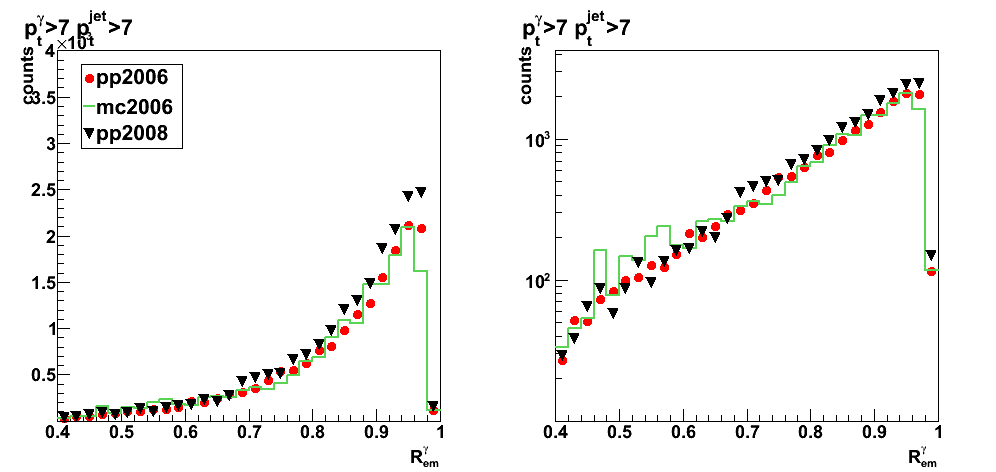
Figure 8: Jet neutral energy fraction
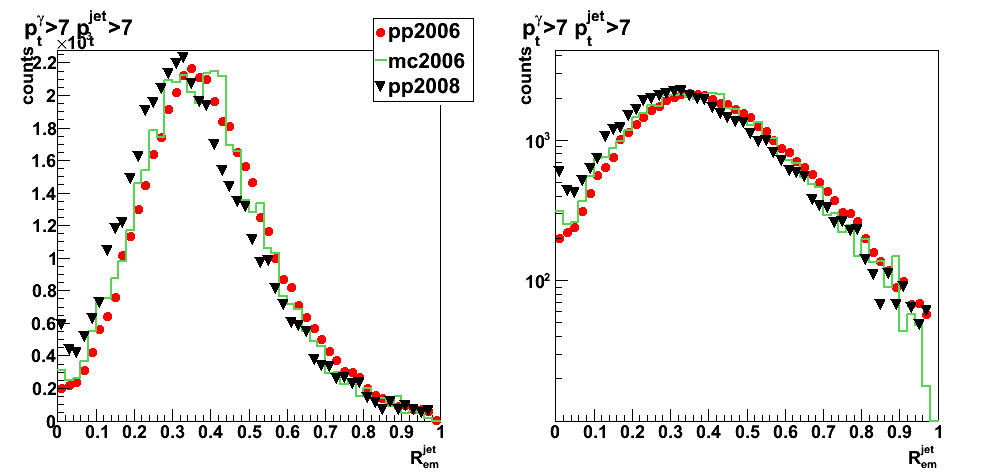
Figure 9: cos(phi_gamma-phi_jet)
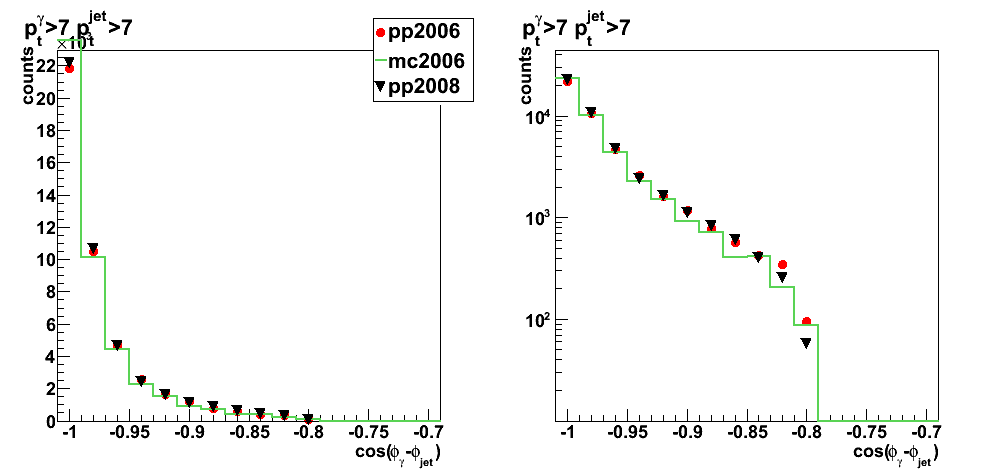
Photon candidate's 2x1, 2x2, and 3x3 tower cluser energy
Number of charge tracks, Barrel and Endcap towers within r=0.7 for photon and gamma
Figure 13: Number of charged track associated with photon candidate
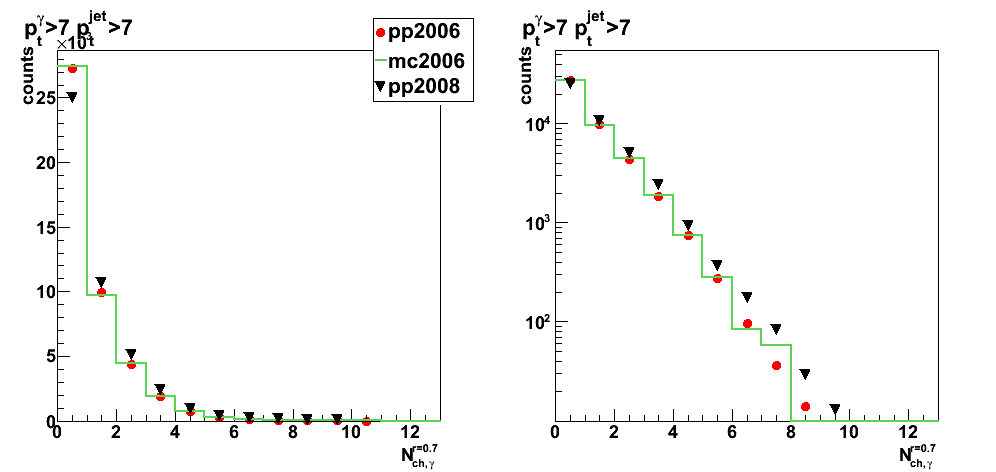
Figure 14: Number of Barrel towers associated with photon candidate
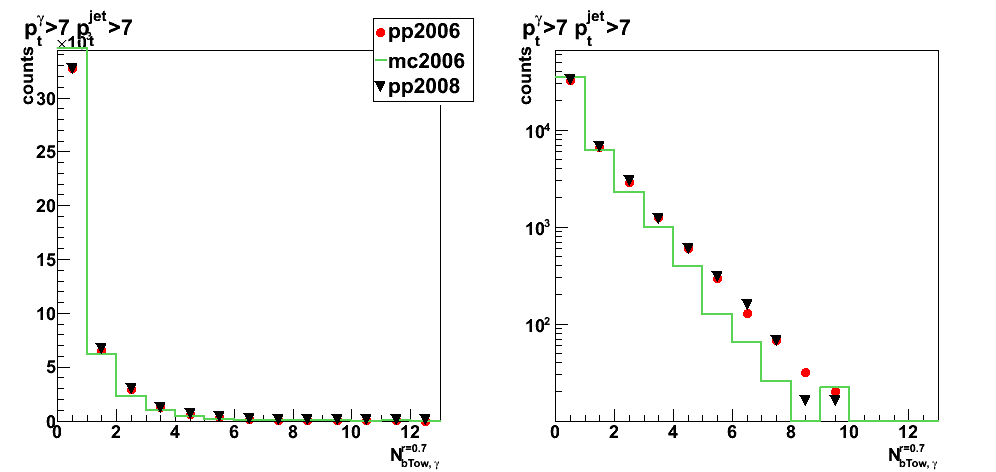
Figure 15: Number of Endcap towers associated with photon candidate
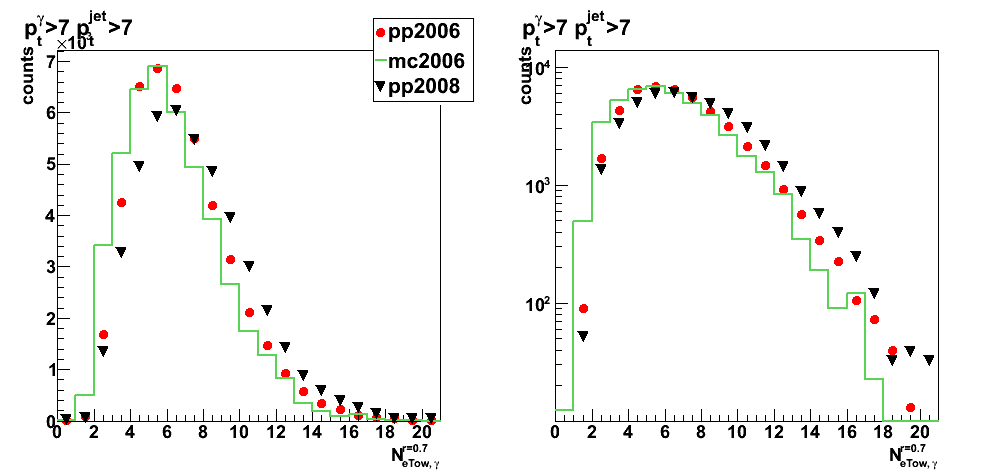
Jet energy composition
2009.02.16 pt_jet>5GeV: pre-shower sorting with new normalization
Ilya Selyuzhenkov February 16, 2009
Data sets
- pp2006 - STAR 2006 pp longitudinal data (~ 3.164 pb^1)
Trigger: eemc-http-mb-L2gamma [id:137641] - mc2006: gamma-jet+QCD jets [p6410EemcGammaFilter] events.
- pp2008 - STAR 2008 pp data
Trigger: etot-mb-l2 [id:7]
Partonic pt range 2-25 GeV.
Cuts applied
- Di-jet events
- Require to reconstruct photon momentum (no gamma-jet isolation cuts)
- Gamma pt > 7GeV, jet pt > 7GeV
- L2gamma emulation in Monte-Carlo
- L2gamma triggered for pp2006 and pp2008 events
- cos (phi_jet - phi_gamma) < -0.8
- detector |eta_jet|< 0.8
- |v_z| < 100
Figures
Each figure has:
- pp2008 data scaled to match the integraled yield from pp2006 data
- mc2006 stand for MC sum: QCD + gamma-jet
Monte-Carlo results for QCD and gamma-jet samples are first
scaled to 3.164 pb^-1 according to Pythia luminosity,
added together, and then an additional fudge factor of 1.24 applied.
Fudge factor is defined as pp2006 to Monte-Carlo sum ratio
for pt_jet>7GeV and pt_gamma>7 candidates
plots for pt_gamma>7GeV, pt_jet > 5GeV
- All pre-shower combined: 1D distributions
- All pre-shower combined: 2D correlations
- Pre-shower sorting 1D distributions
2009.02.19 Photon-jet analysis status update for Spin PWG
Photon-jet analysis status update for Spin PWG (February 19, 2009)
Slides: download pdf
Link for CIPANP abstract
CIPANP 2009 abstract on photon-jet measurement
CIPANP 2009 abstract on photon-jet study
Title:
"Photon-jet coincidence measurements
in polarized pp collisions at sqrt{s}=200GeV
with the STAR Endcap Calorimeter"
Abstract: download pdf
Previous versions: v1, v2, v3, v4
Conference link: CIPANP 2009
03 Mar
March 2009 posts
2009.03.02 Application of the neural network for the cut optimization (zero try)
Multilayer perceptron (feedforward neural networks)
Multilayer perceptron (MLP) is feedforward neural networks
trained with the standard backpropagation algorithm.
They are supervised networks so they require a desired response to be trained.
They learn how to transform input data into a desired response,
so they are widely used for pattern classification.
With one or two hidden layers, they can approximate virtually any input-output map.
They have been shown to approximate the performance of optimal statistical classifiers in difficult problems.
ROOT implementation for Multilayer perceptron
TMultiLayerPerceptron class in ROOT
mlpHiggs.C example
Application for cuts optimization in the gamma-jet analysis
Netwrok structure:
r3x3, (pt_gamma-pt_jet)/pt_gamma, nCharge, bBtow, eTow2x1: 10 hidden layers: one output later
Figure 1:
- Upper left: Learning curve (error vs. number of training)
Learing method is: Steepest descent with fixed step size (batch learning) - Upper right: Differences (how important are initial variableles for signal/background separation)
- Lower left: Network structure (ling thinkness corresponds to relative weight value)
- Lower right: Network output. Red - MC gamma-jets, blue QCD background, black pp2006 data
Figure 2: Input parameters vs. network output
Row: 1: MC QCD, 2: gamma-jet, 3 pp2006 data
Vertical axis: r3x3, (pt_gamma-pt_jet)/pt_gamma, nCharge, bBtow, eTow2x1
Horisontal axis: network output
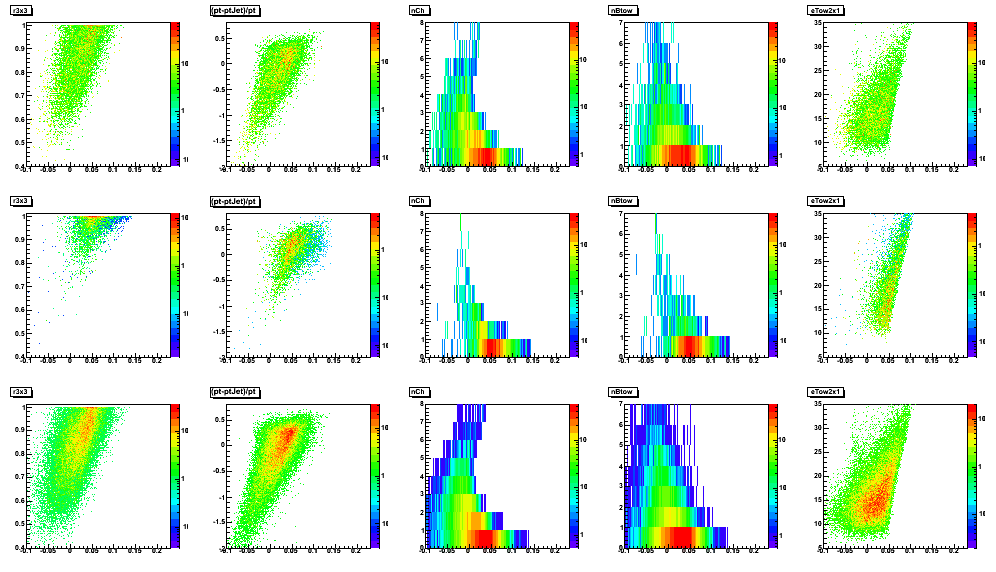
2009.03.09 Application of the LDA and MLP classifiers for the cut optimization
Cut optimization with Fisher's LDA and MLP (neural network) classifiers
ROOT implementation for LDA and MLP:
- Fisher's Linear Discriminant Analysis (LDA)
- Multi-Layer Perceptron (MLP) [feed-forward neural network]
Application for cuts optimization in the gamma-jet analysis
LDA configuration: default
MLP configuration:
- 2 hidden layers [N+1:N neural network configuration, N is number of input parameters]
- Learning method: stochastic minimization (1000 learning cycles)
Input parameters (same for both LDA and MLP):
- Energy fraction in 3x3 cluster within a r=0.7 radius: r3x3
- Photon-jet pt balance: [pt_gamma-pt_jet]/pt_gamma
- Number of charge tracks within r=0.7 around gamma candidate
- Number of Endcap towers fired within r=0.7 around gamma candidate
- Number of Barrel towers fired within r=0.7 around gamma candidate
Figure 1: Signal efficiency and purity, background rejection (left),
and significance: Sig/sqrt[Sig+Bg] (right) vs. LDA (upper plots) and MLP (lower plots) classifier discriminants

Figure 2:
- Upper left: Rejection vs. efficiency
- Upper right: Purity vs. efficiency
- Lower left: Purity vs. Rejection
- Lower right: Significance vs. efficiency
Figure 3: Data to Monte-Carlo comparison for LDA (upper plots) and MLP (lower plots)
Good (within ~ 10%) match between data nad Monte-Carlo
a) up to 0.8 for LDA discriminant, and b) up to -0.7 for MLP.
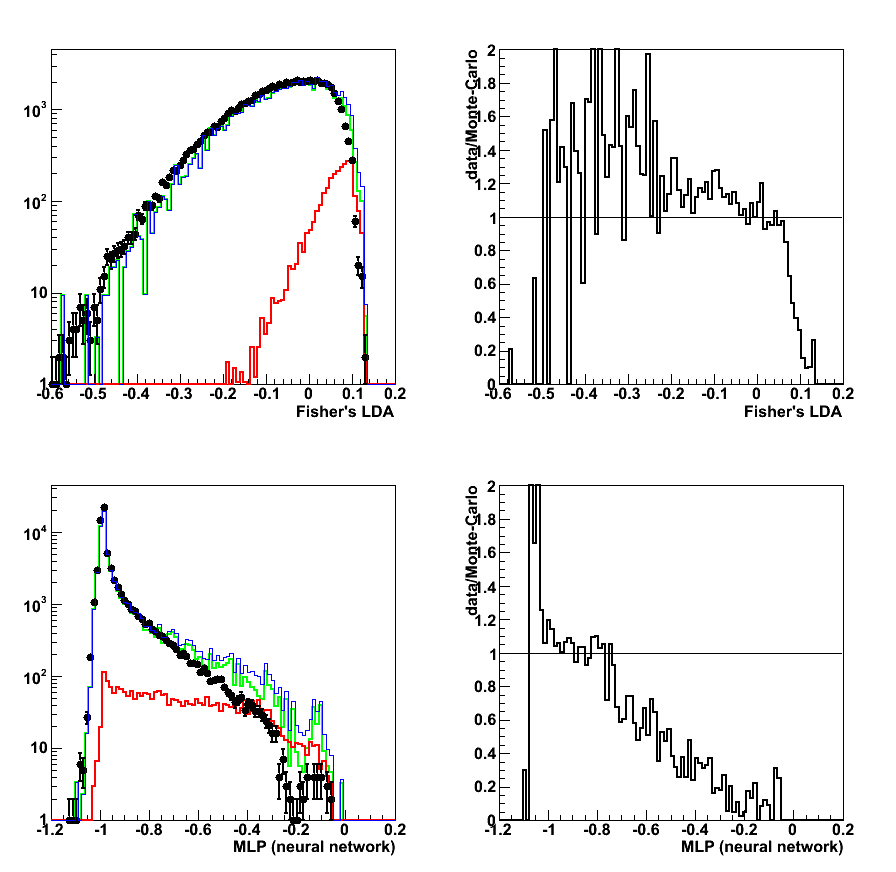
Figure 4: Data to Monte-Carlo comparison for input parameters
from left to right
1) pt_gamma 2) pt_jet 3) r3x3 4) gamma-jet pt balance 5) N_ch[gamma] 6) N_eTow[gamma] 7) N_bTow[gamma]
Colour coding: black pp2006 data, red gamma-jet MC, green QCD MC, blue gamma-jet+QCD

Figure 5: Data to Monte-Carlo comparison:
correlations between input variables (in the same order as in Fig. 4)
and LDA classifier discriminant (horizontal axis).
1st raw: QCD MC; 2nd: gamma-jet MC; 3rd: pp2006 data; 4th: QCD+gamma-jet MC
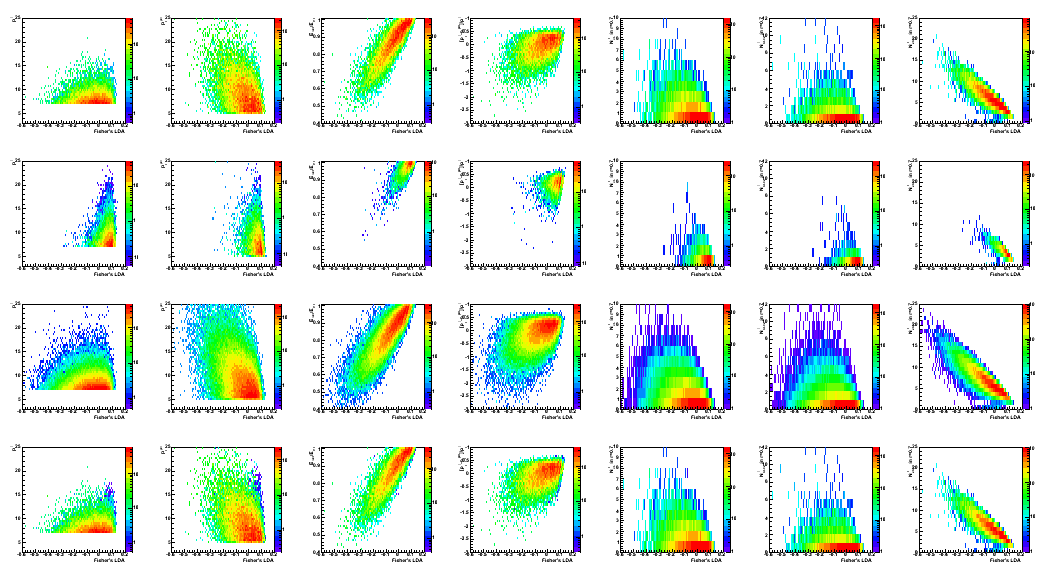
2009.03.26 Endcap photon-jet update at the STAR Collaboration meeting
Endcap photon-jet update at the STAR Collaboration meeting
04 Apr
April 2009 posts
2009.04.17 WSU nuclear seminar
The STAR spin program with longitudinally polarized proton beams
2009.04.21 Adding SMD info to the LDA
Cut optimization with Fisher's LDA classifier
ROOT implementation for LDA:
Application for cuts optimization in the gamma-jet analysis
LDA configuration: default
LDA input parameters:
- Energy fraction in 3x3 cluster within a r=0.7 radius: r3x3
- Photon-jet pt balance: [pt_gamma-pt_jet]/pt_gamma
- Number of charge tracks within r=0.7 around gamma candidate
- Number of Endcap towers fired within r=0.7 around gamma candidate
- Number of Barrel towers fired within r=0.7 around gamma candidate
Figure 1: LDA discriminant (no SMD involved in training)
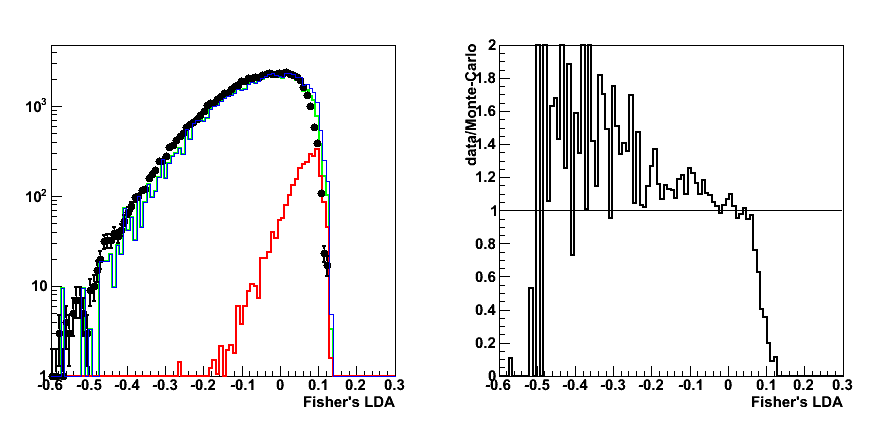
Figure 2: LDA (no SMD): Efficiency, rejection, purity vs. discriminant
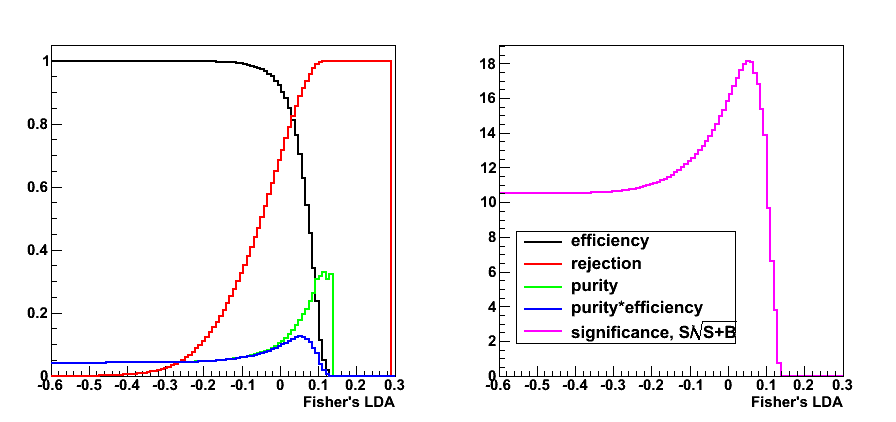
Figure 3: SMD energy in 25 central strips (LDA-dsicriminant>0, no pre-shower1 cut)
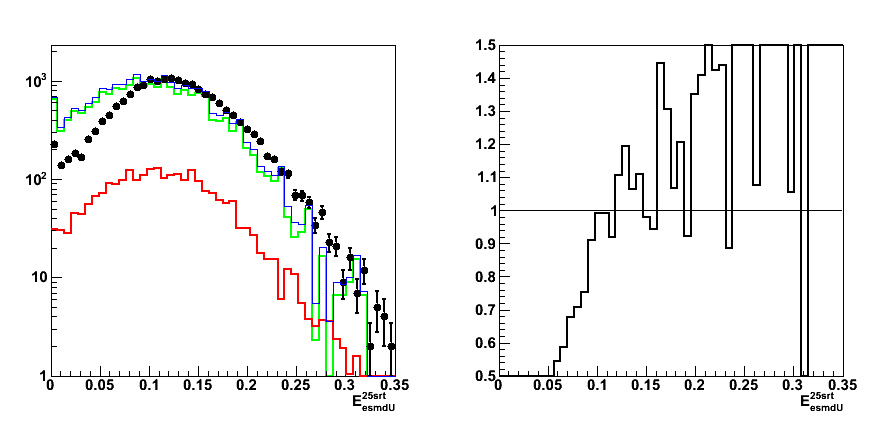
Figure 4: SMD energy in 25 central strips (LDA-dsicriminant>0, pre-shower1 < 10MeV)
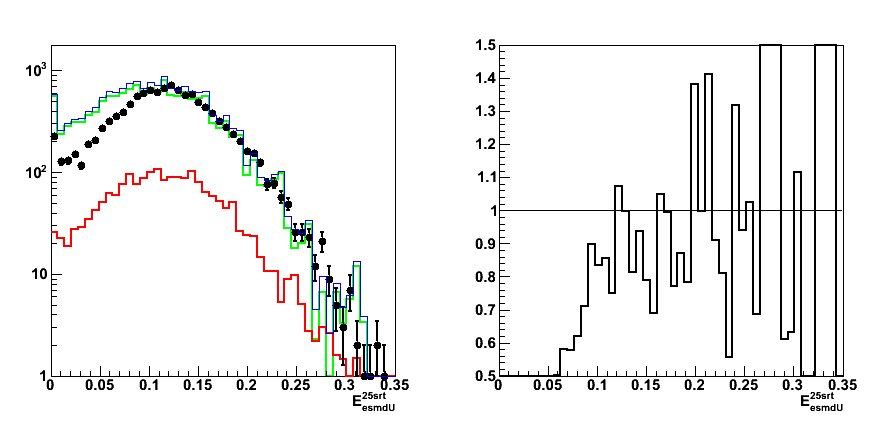
Figure 5: Maximum residual (LDA-dsicriminant>0, no pre-shower1 cut)
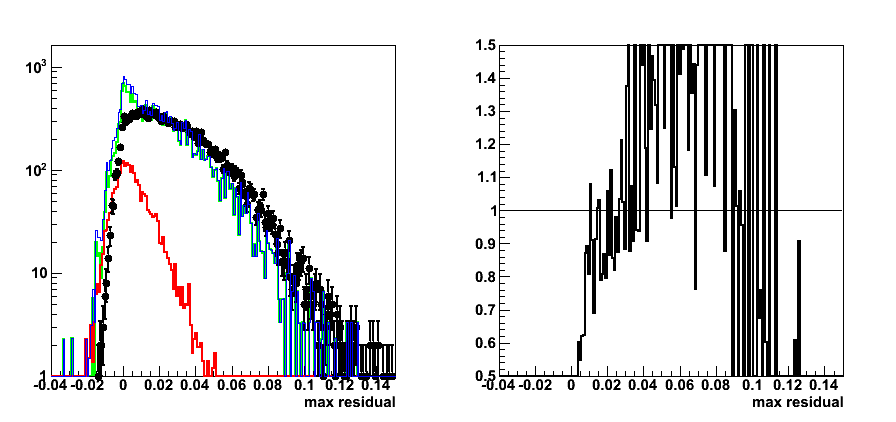
Figure 6: Maximum residual (LDA-dsicriminant>0, pre-shower1 < 10MeV)
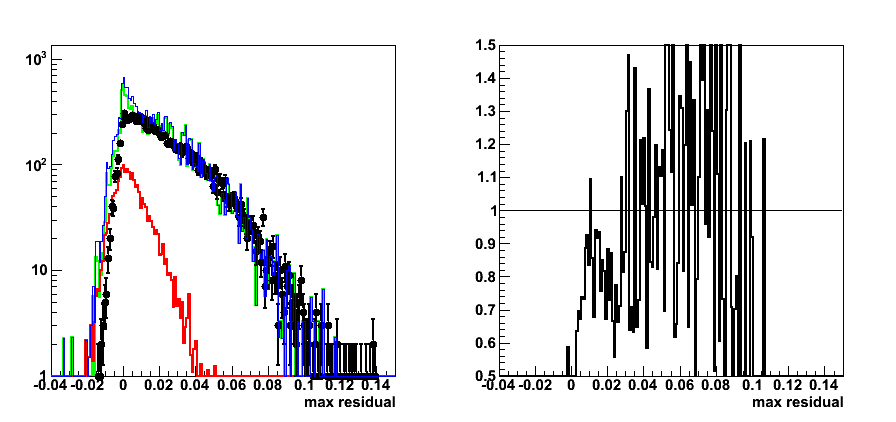
LDA+ SMD analysis
SMD info added:
a) energy in 5 central srtips
b) maximum sided residual
Figure 7:LDA with SMD: Efficiency, rejection, purity vs. LDA discriminant
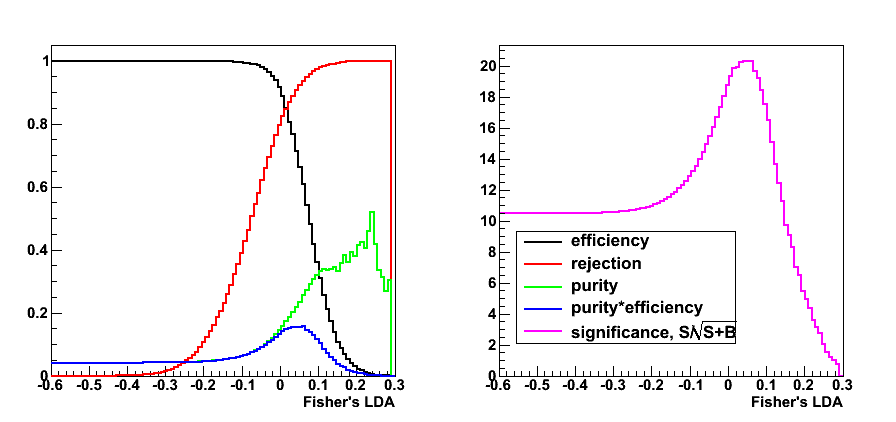
Figure 8: LDA discriminant with SMD
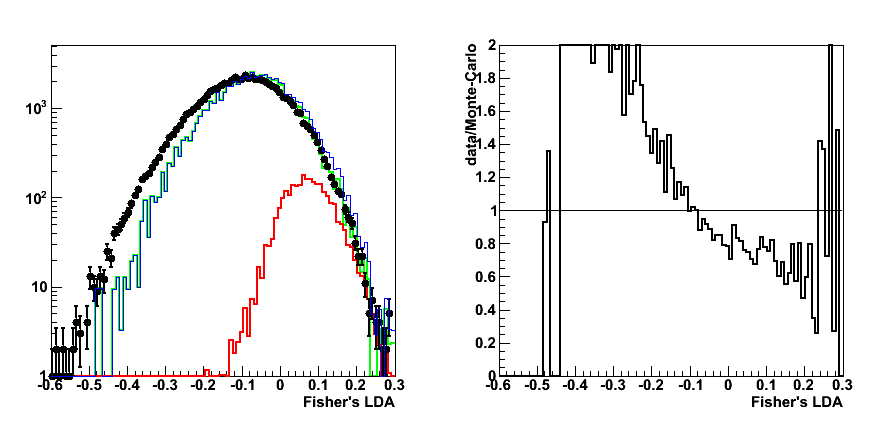
Figure 9: Maximum residual (SMD LDA-dsicriminant>0, pre-shower1 < 10MeV)
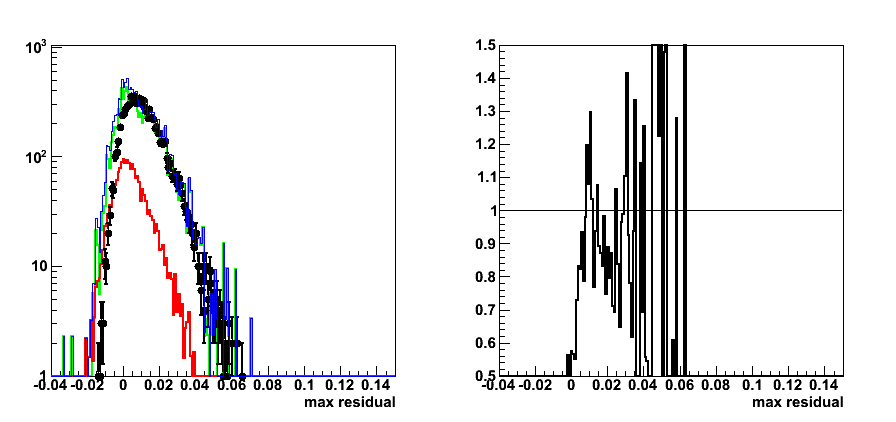
LDA with and without SMD comparison
Figure 10:LDA (no SMD): Efficiency, rejection, purity plots

Figure 11: LDA with SMD: Efficiency, rejection, purity plots
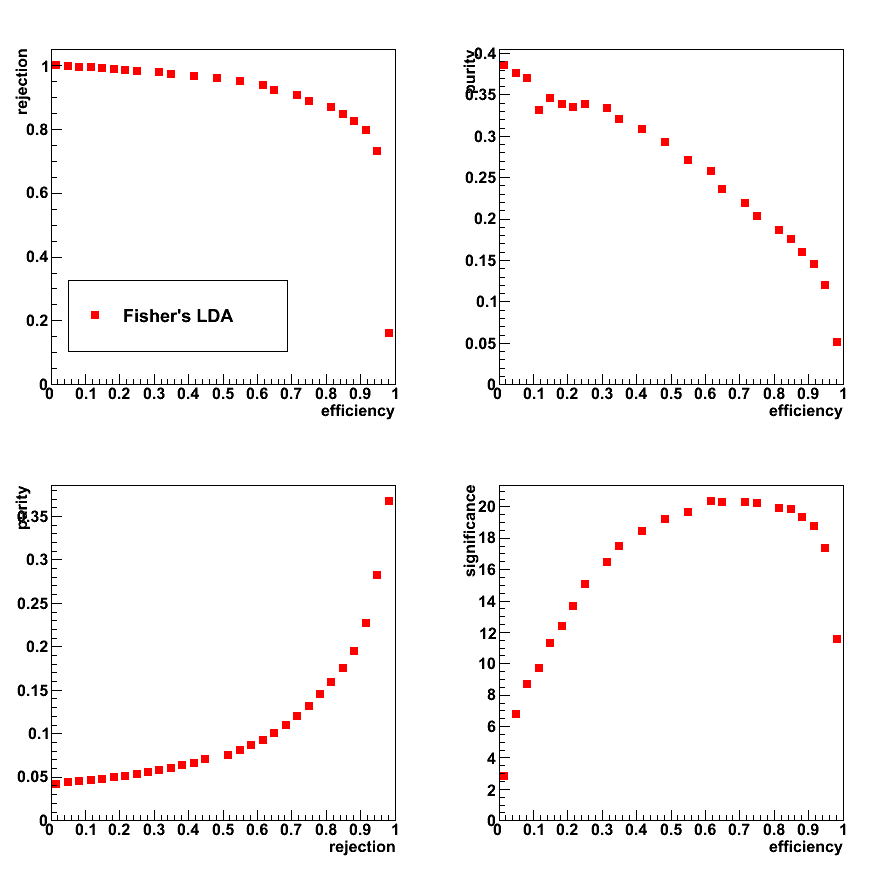
2009.04.28 LDA plus SMD analysis with pre-shower sorting
Cut optimization with Fisher's LDA classifier
ROOT implementation for LDA:
Application for cuts optimization in the gamma-jet analysis
LDA configuration: default
LDA input parameters (includes SMD inromation of the distance from max sided residual plot):
- Energy fraction in 3x3 cluster within a r=0.7 radius: r3x3
- Photon-jet pt balance: [pt_gamma-pt_jet]/pt_gamma
- Number of charge tracks within r=0.7 around gamma candidate
- Number of Endcap towers fired within r=0.7 around gamma candidate
- Number of Barrel towers fired within r=0.7 around gamma candidate
- Distance to 80% cut line (see this link for more details)
The number of strips in SMD u or v planes is required to be greater than 3
Figure 1: SMD energy in 25 central strips sorted by pre-shower energy
- Upper left: pre1=0, pre2=0
- Upper right: pre1=0, pre2>0
- Lower left: 0<4MeV
- Lower right: 4<10MeV
Right plot for each pre-shower condition shows the ratio of pp2006 data to sum of the Monte-Carlo samples
Colour coding:
black pp2006 data, red gamma-jet MC, green QCD MC, blue gamma-jet+QCD
(combined plot for all pre-shoer bins can be found here)
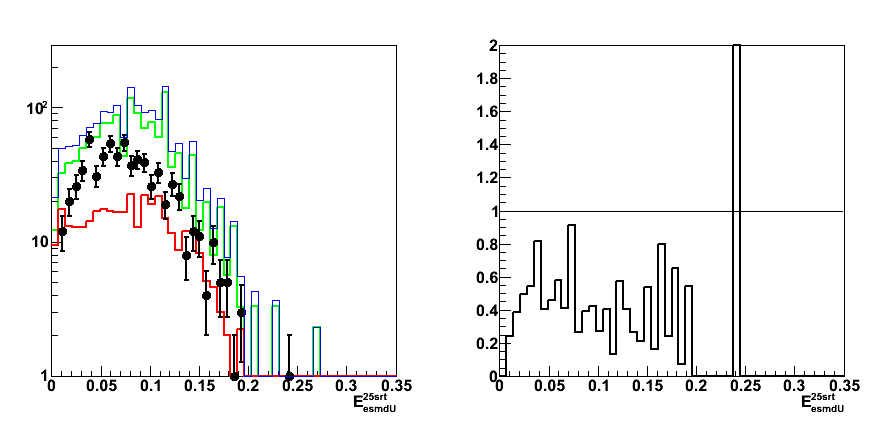
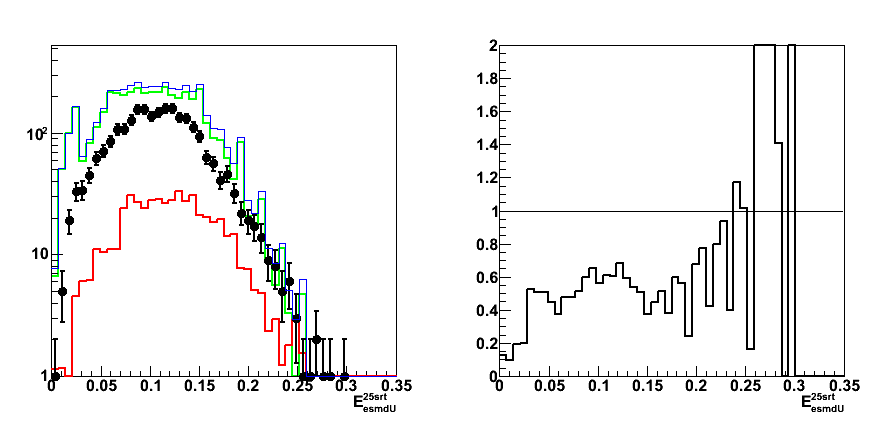
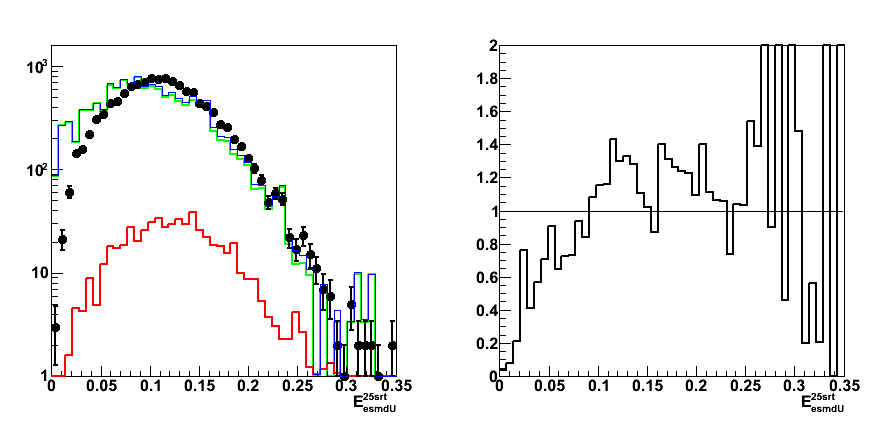
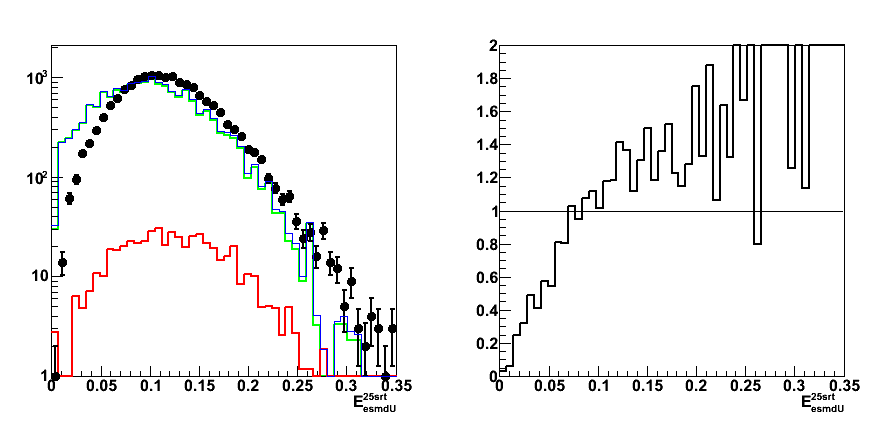
Figure 2: SMD energy in 5 central strips sorted by pre-shower energy
(combined plot can be found here)
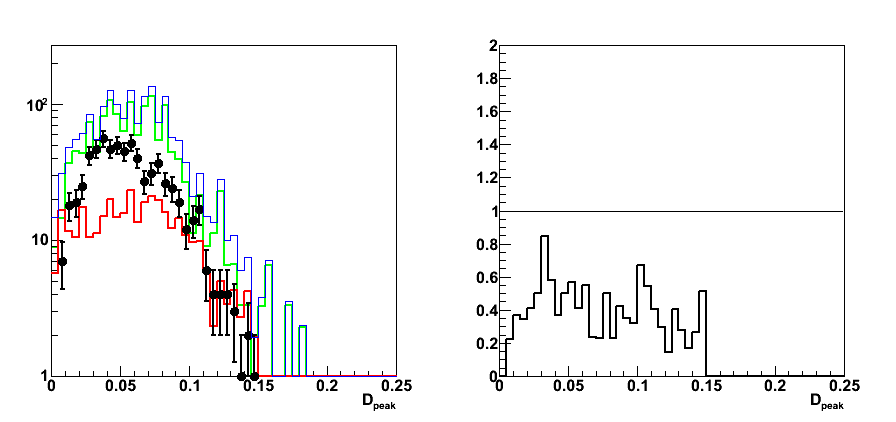
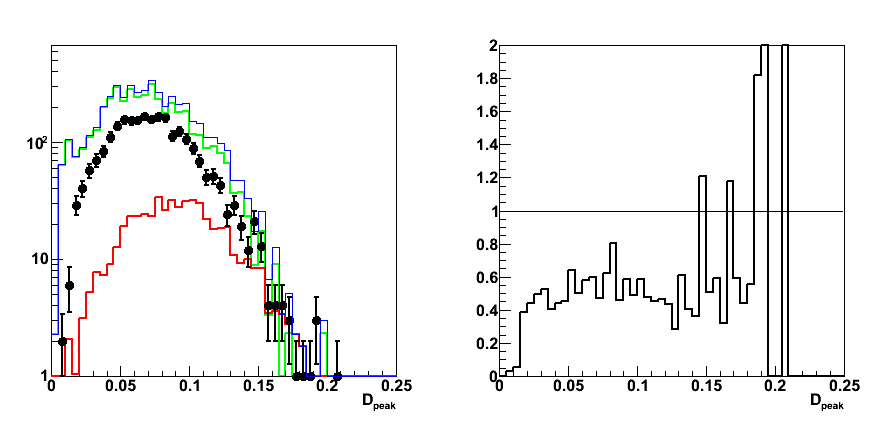
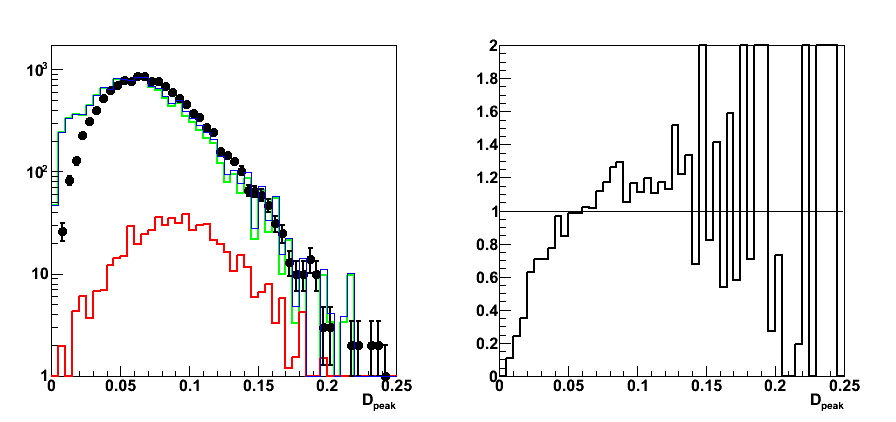

Figure 3: Maximum residual sorted by pre-shower energy
(combined plot can be found here)
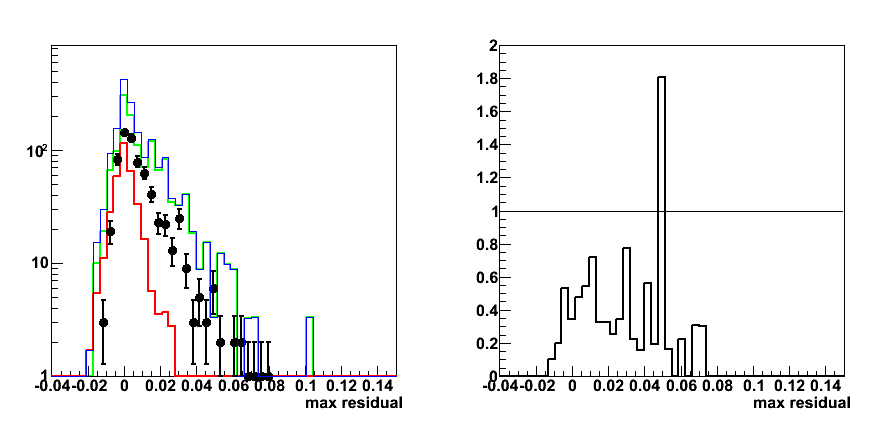
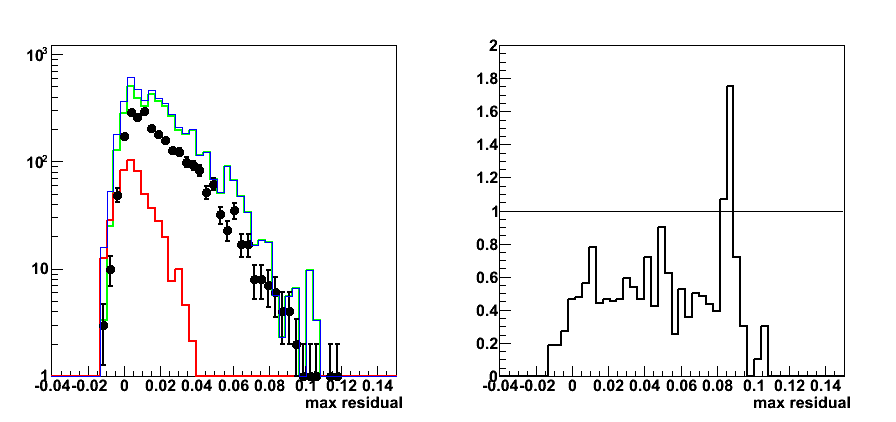
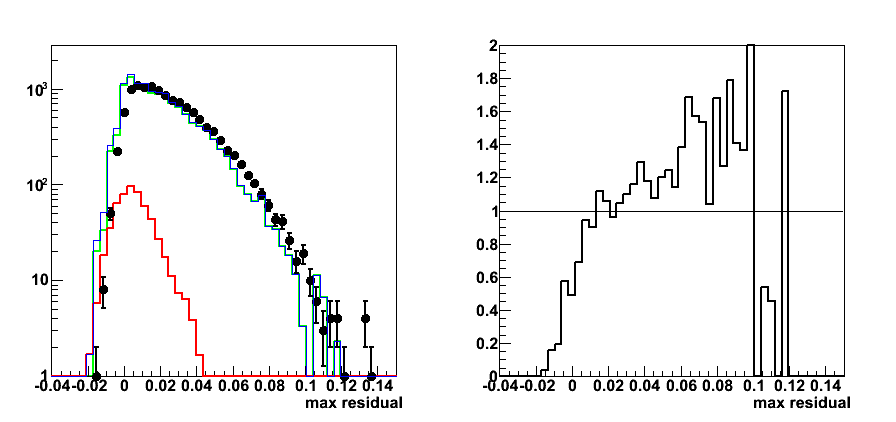
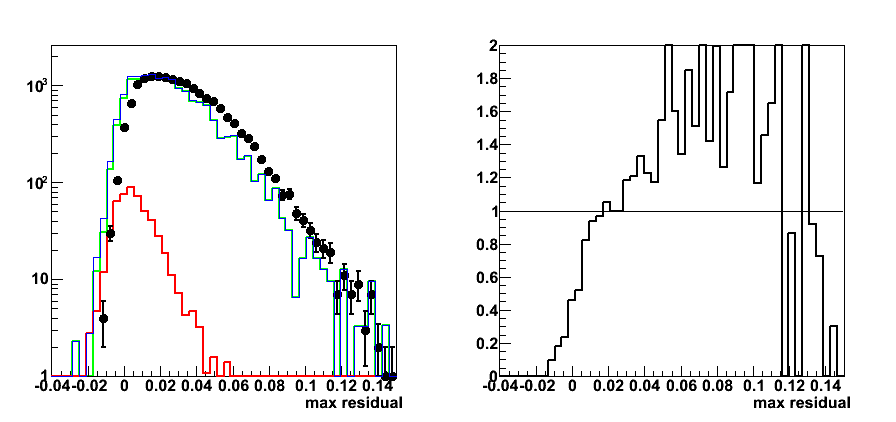
Figure 4: LDA discriminant. Note: LDA algo trained for each pre-shower condition independently
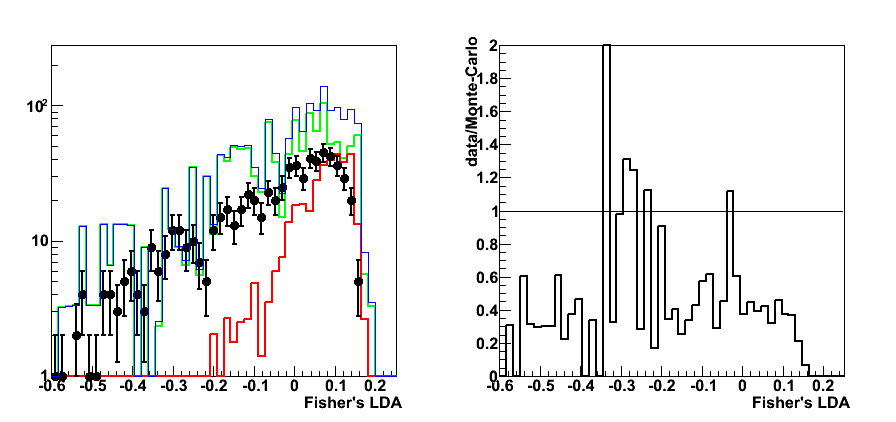
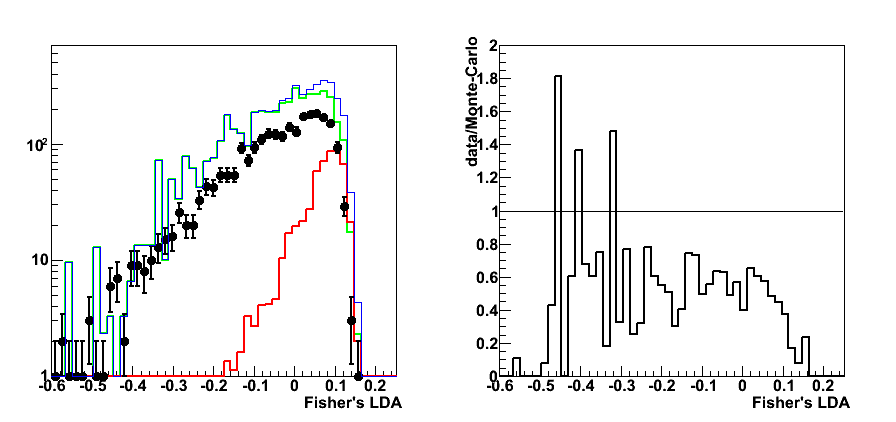
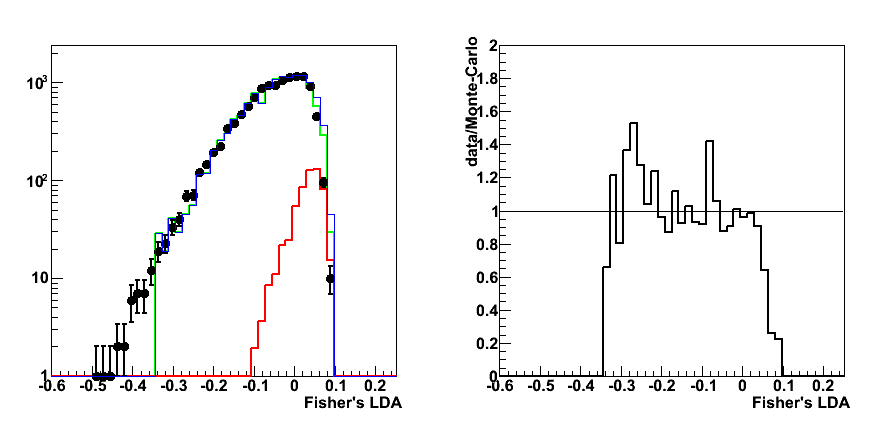
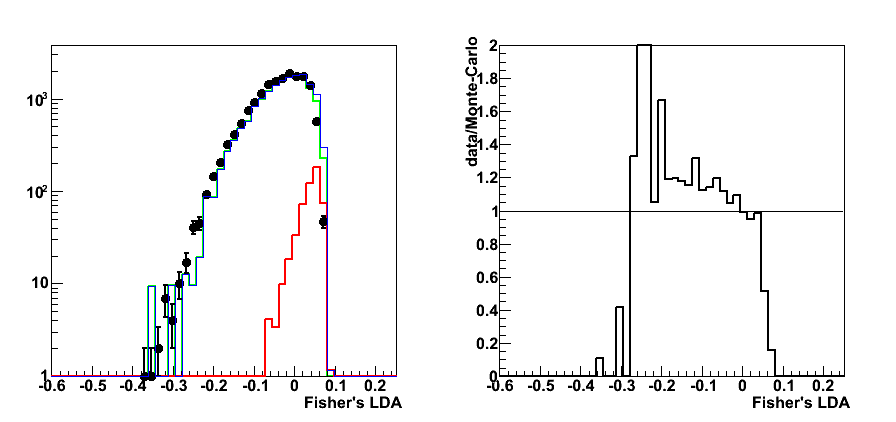
Figure 5: LDA: Efficiency, rejection, purity vs. discriminant, sorted by pre-shower energy
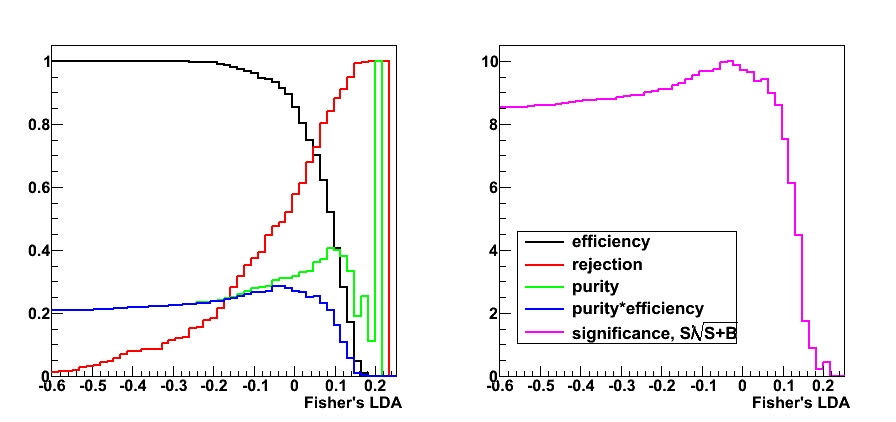
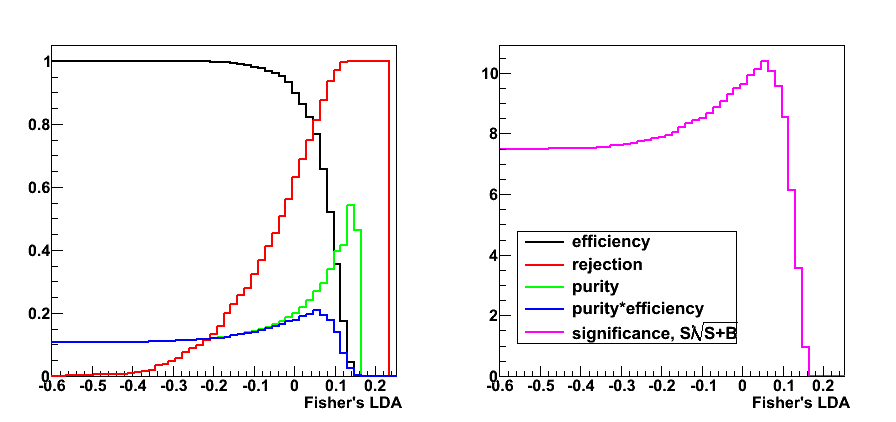
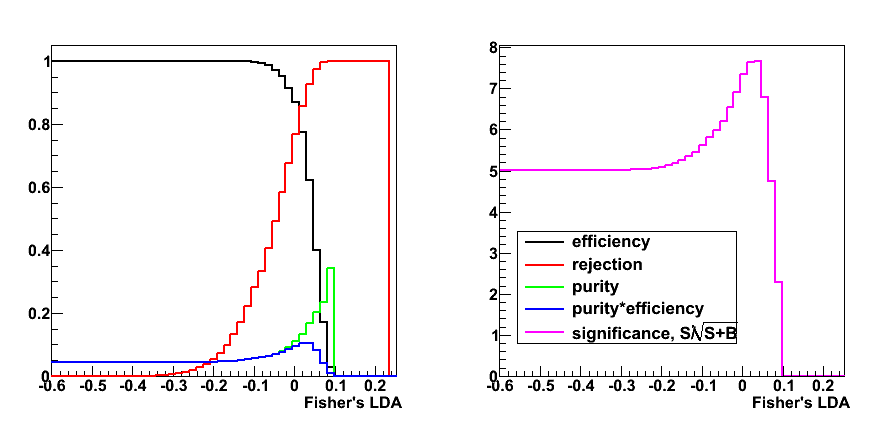
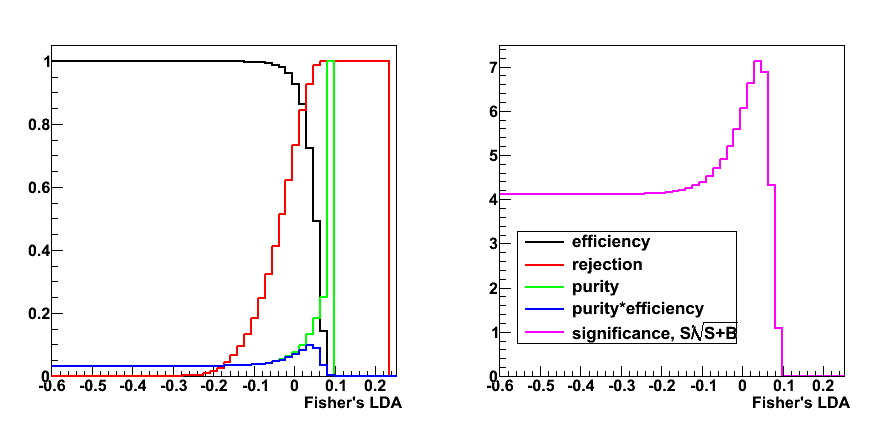
Figure 6: LDA: Efficiency, rejection, purity plots sorted by pre-shower energy
For each pre-shower condition each plot has 4 figures:
- u-left: rejection vs. efficiency
- u-right: purity vs. efficiency
- l-left: purity vs. rejection
- l-right: significance (signal/sqrt{signal+background}) vs. efficiency
05 May
May 2009 posts
2009.05.03 LDA: varying pt and eta cut
Cut optimization with Fisher's LDA classifier
ROOT implementation for LDA:
Application for cuts optimization in the gamma-jet analysis
LDA configuration: default
LDA input parameters Set0:
- Set0:
- Energy fraction in 3x3 cluster within a r=0.7 radius:
E_3x3/E_0.7 - Photon-jet pt balance:
[pt_gamma-pt_jet]/pt_gamma - Number of charge tracks within r=0.7 around gamma candidate:
Ncharge - Number of Endcap towersL fired within r=0.7 around gamma candidate:
NtowBarrel - Number of Barrel towers fired within r=0.7 around gamma candidate
NtowEndcap
- Energy fraction in 3x3 cluster within a r=0.7 radius:
- Set1:
- All from Set0
- Shower shape analysis: distance to 80% cut line:
distance to cut line
- Set2:
- All from Set1
- Energy fraction in E_2x1 and E_2x2 witin E_3x3:
E_2x1/E_2x2 and E_2x2/E_3x3
- Set3:
- All from Set2
- Energy in post-shower layer under 3x3 tower patch:
E_post^3x3
The number of strips in SMD u or v planes is required to be greater than 3
Pre-shower sorting (energy in tiles under 3x3 tower patch):
- pre1=0, pre2=0
- pre1=0, pre2>0
- 0 < pre1 < 0.004
- 0.004 < pre1 < 0.01
- pre1 < 0.01
- pre1 >= 0.01
Photon pt and rapidity cuts:
- pt>7GeV
- pt>8GeV
- pt>9GeV
- pt>10GeV
- detector eta <1.4 (pt>7GeV)
- detector eta > 1.4 (pt>7GeV)
Figure 0: photon pt distribution for pre-shower1<0.01
Colour coding:
black pp2006 data, red gamma-jet MC, green QCD MC, blue gamma-jet+QCD
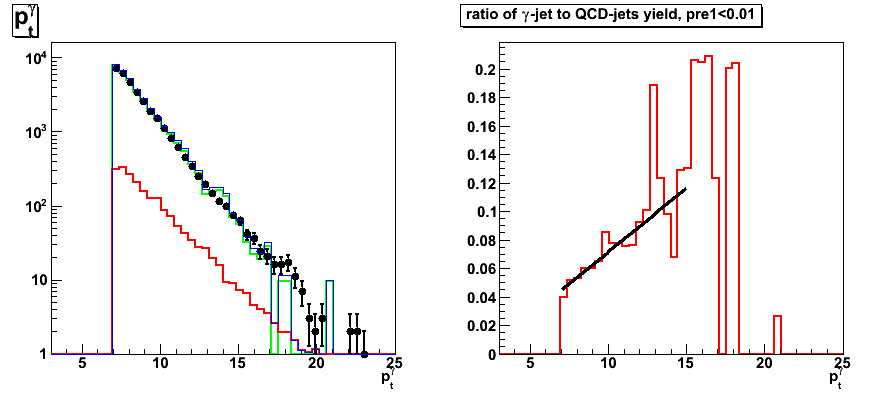
LDA Set0
Figure 1: LDA discriminant with Set0: Data to Monte-Carlo comparison (pt>7GeV cut)
Right plot for each pre-shower condition shows the ratio of pp2006 data to sum of the Monte-Carlo samples
Colour coding:
black pp2006 data, red gamma-jet MC, green QCD MC, blue gamma-jet+QCD
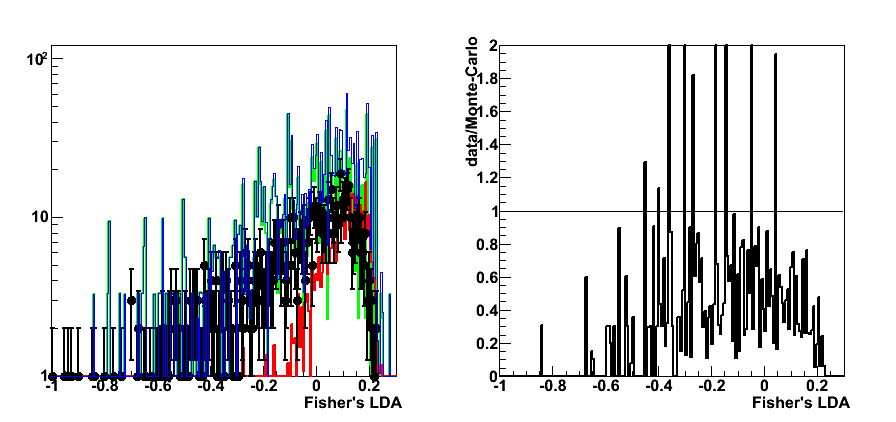
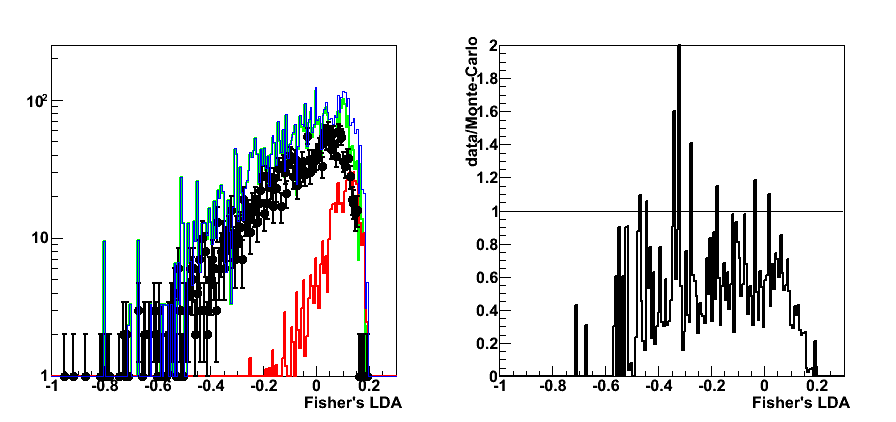
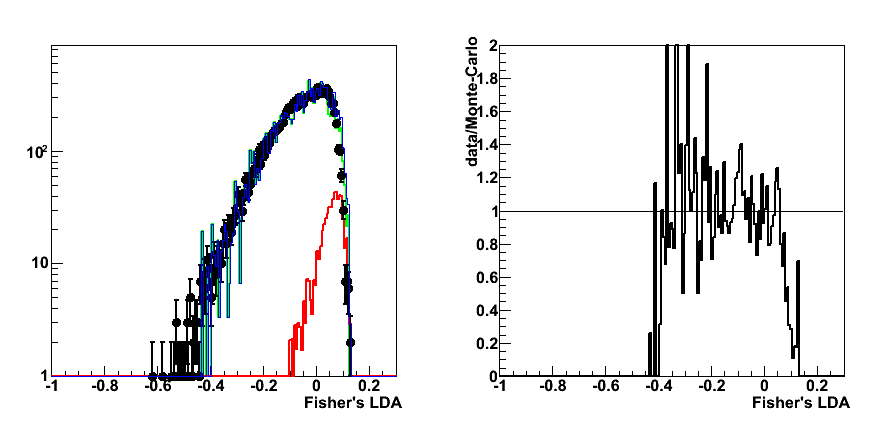
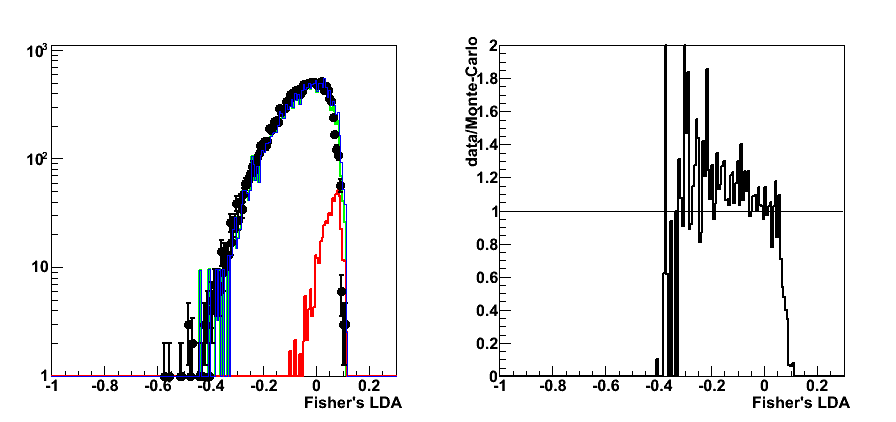
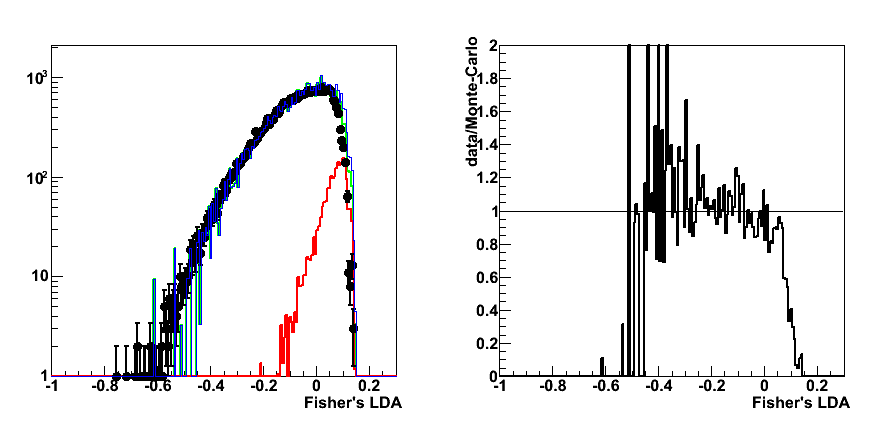
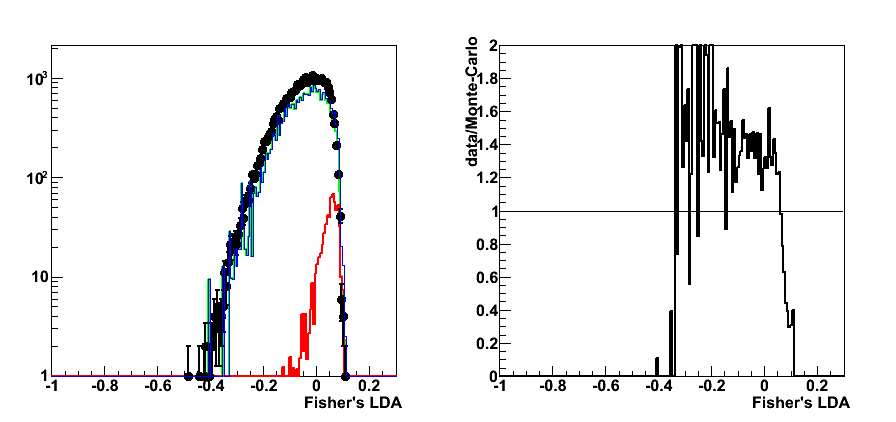
Figure 2: efficiency, purity, rejection vs. LDA discriminant (pt>7GeV cut)
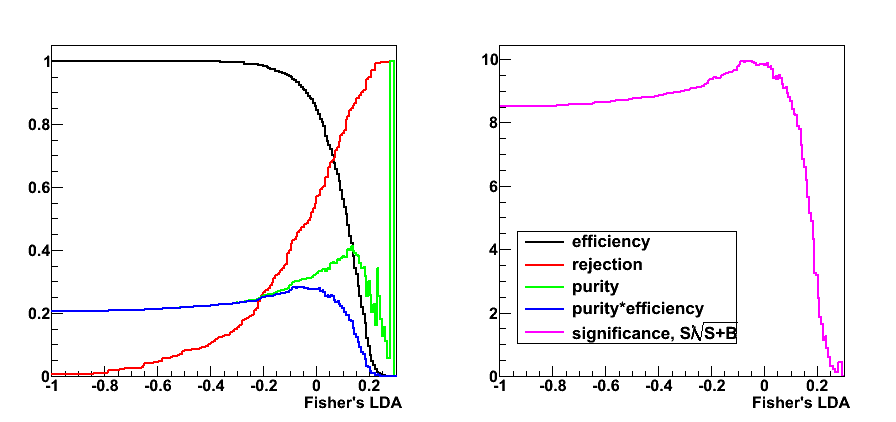
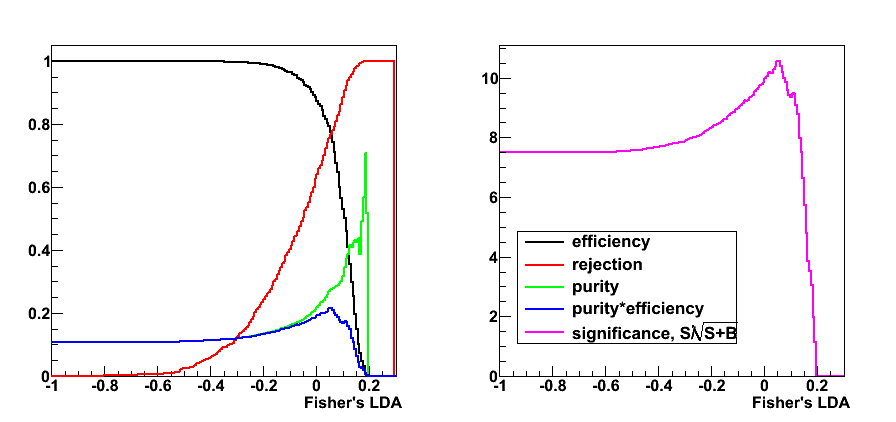
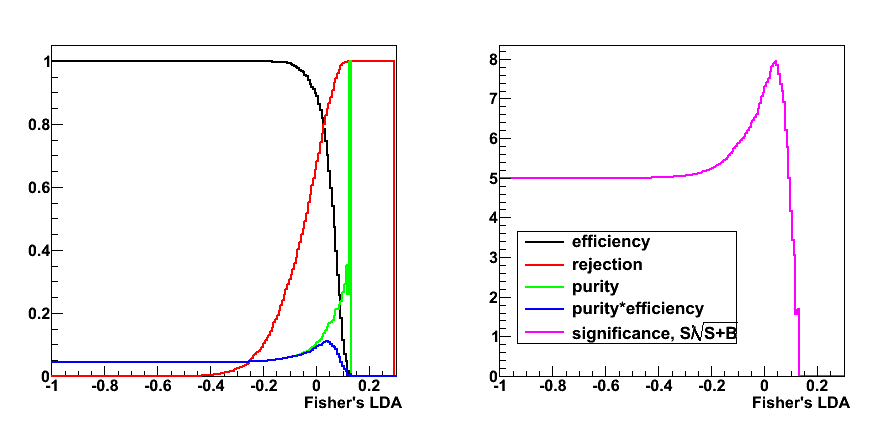
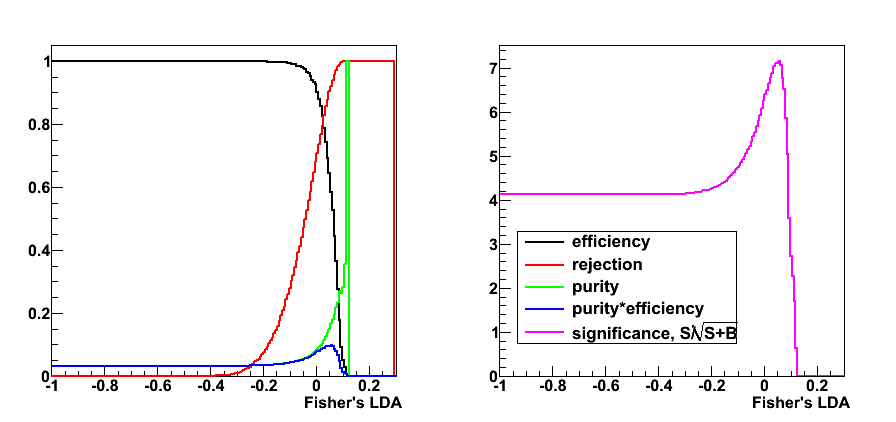
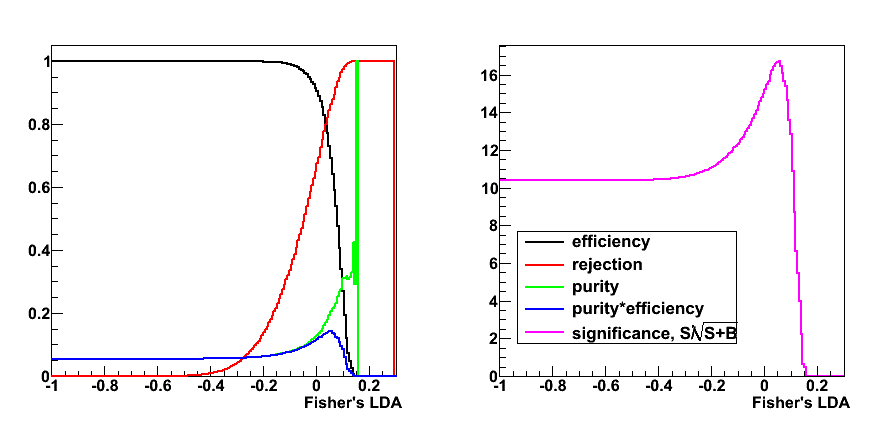
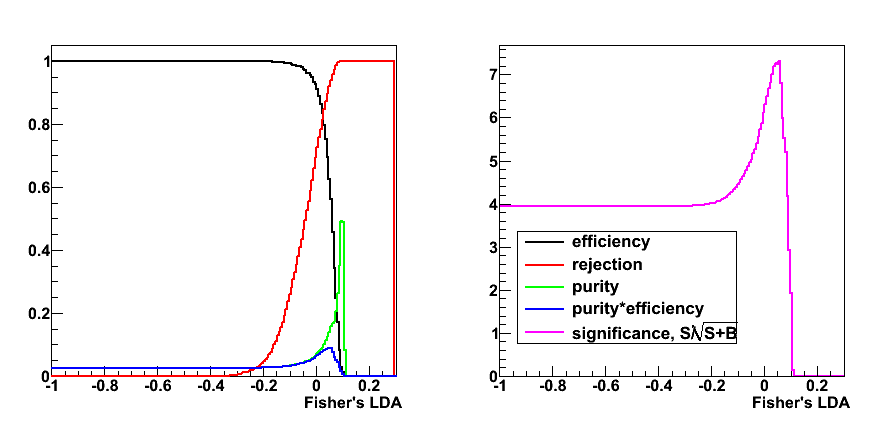
Figure 3: rejection vs. efficiency
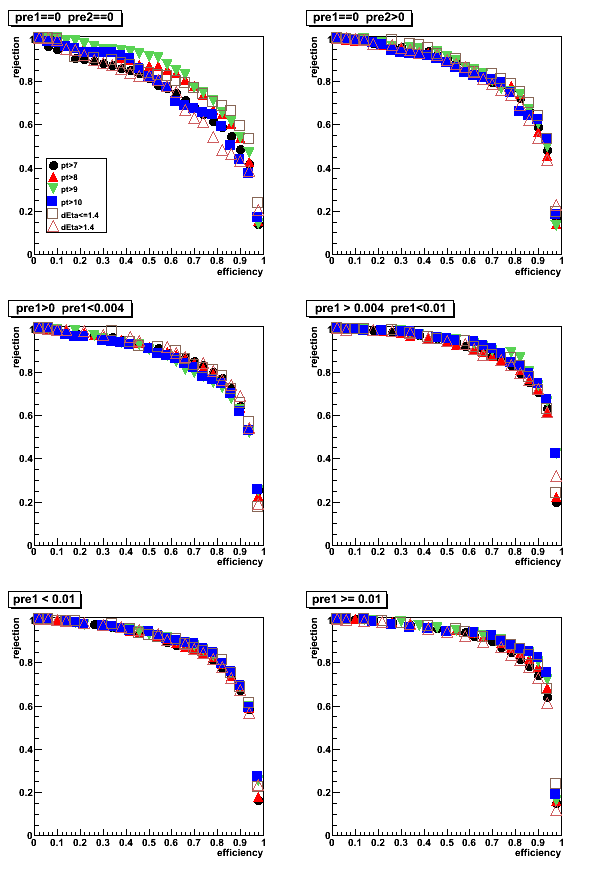
Figure 4: purity vs. efficiency
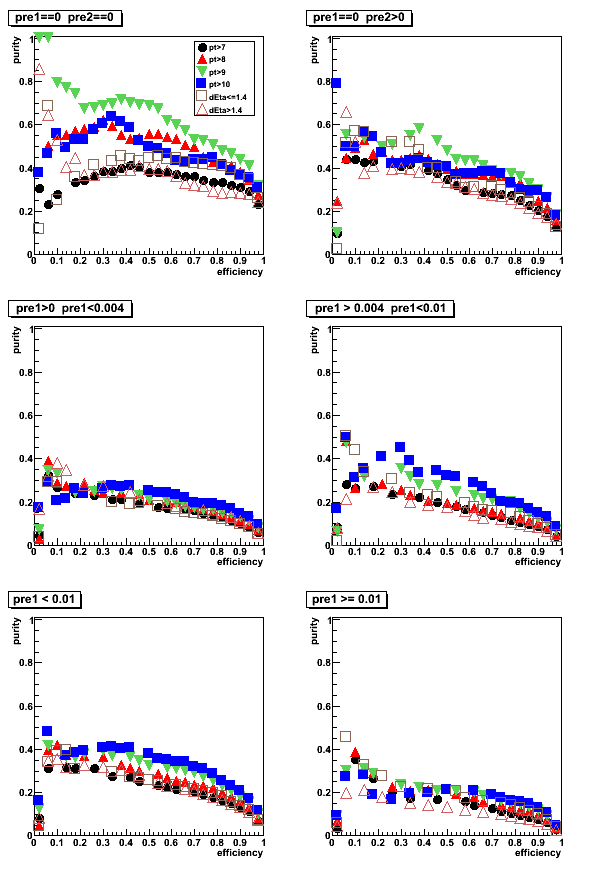
Figure 5: purity vs. rejection
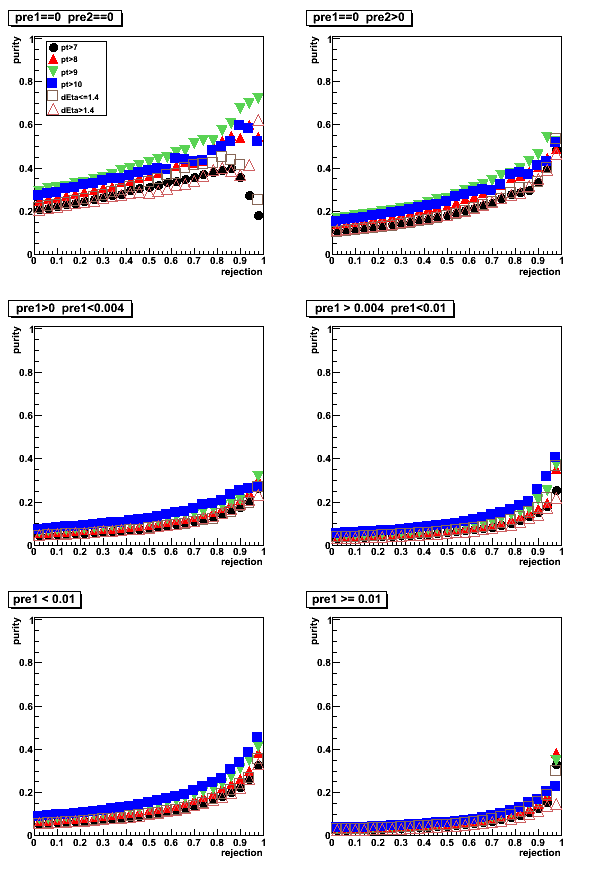
LDA Set1
Figure 6: LDA discriminant with Set1: Data to Monte-Carlo comparison
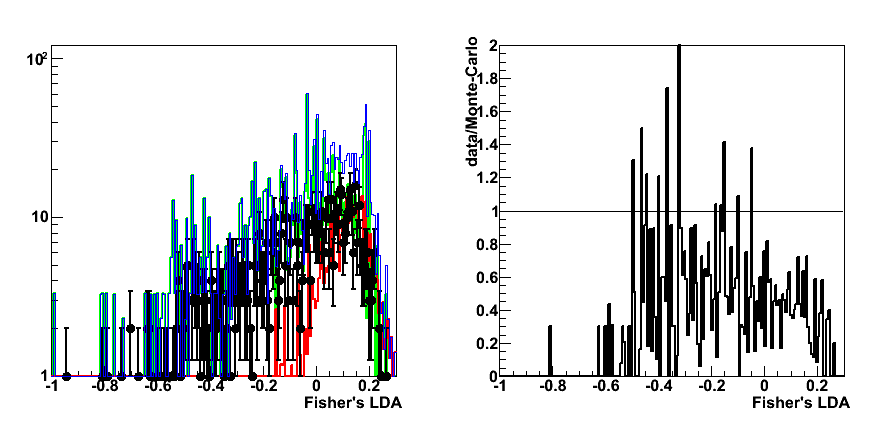
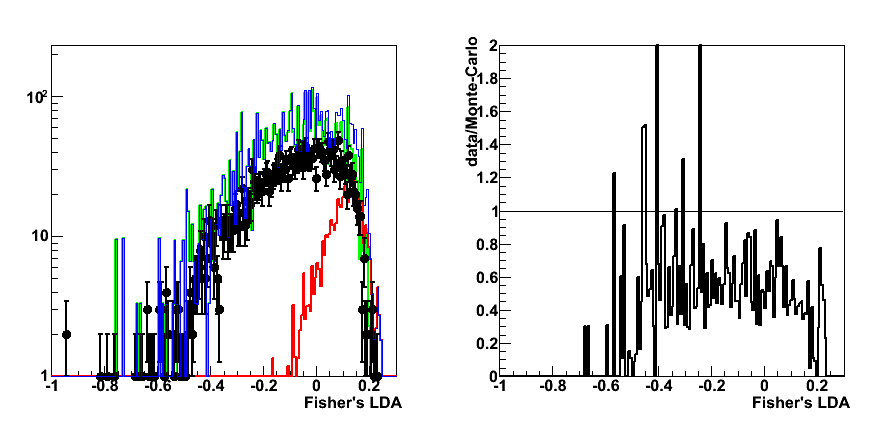
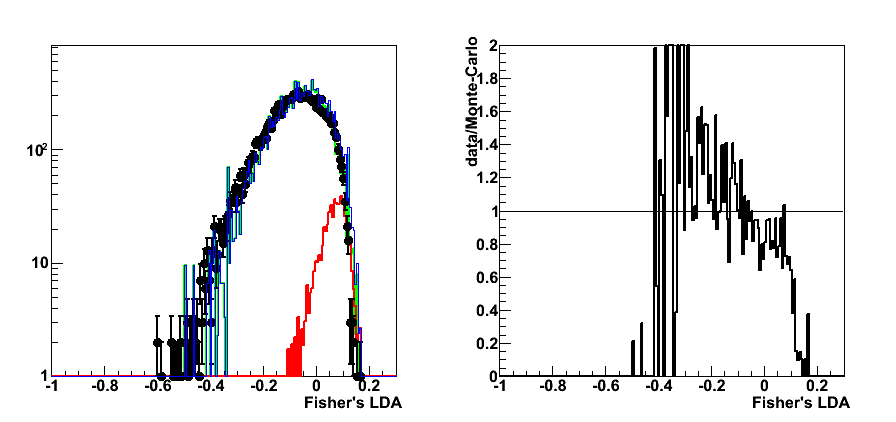
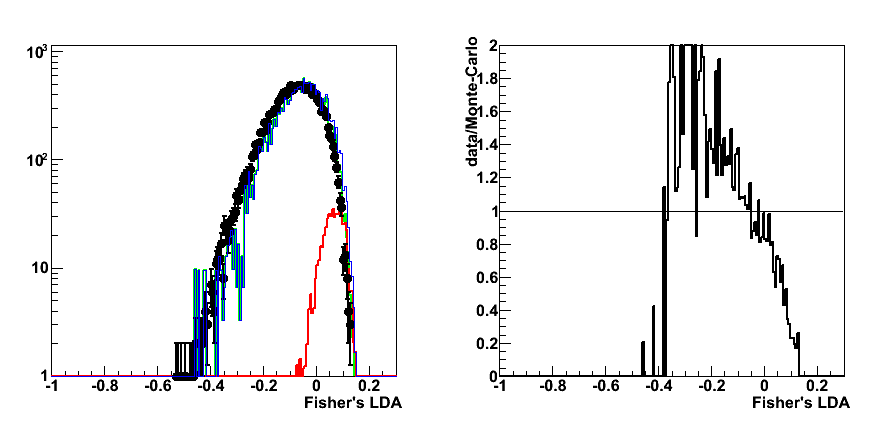
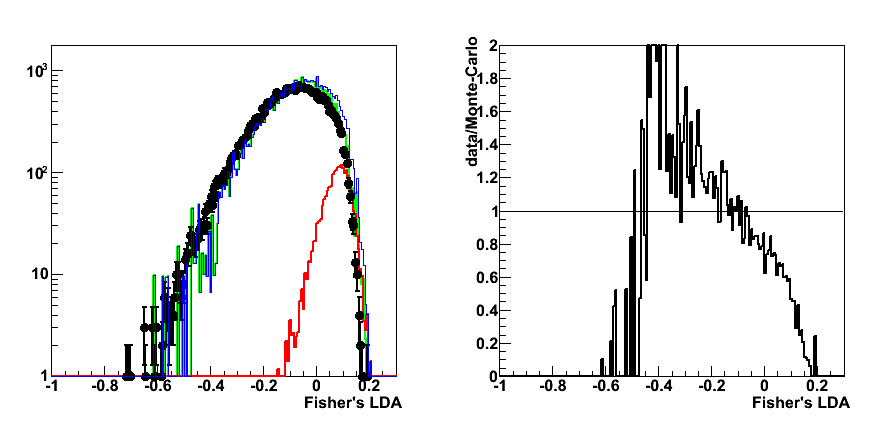
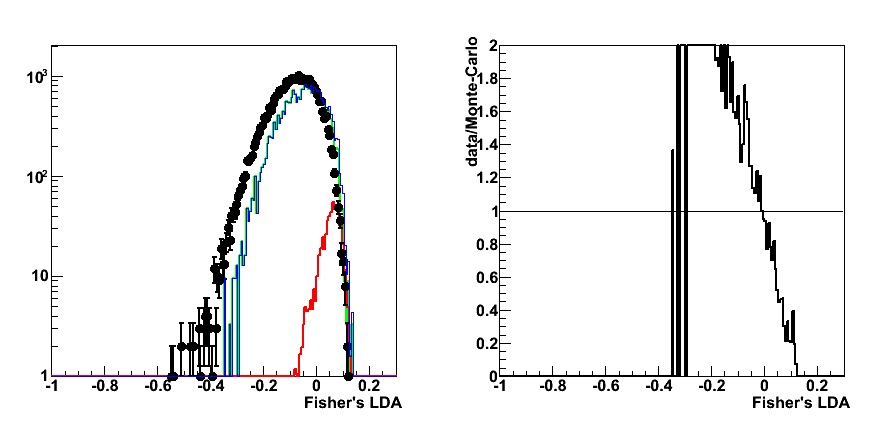
Figure 7: rejection vs. efficiency
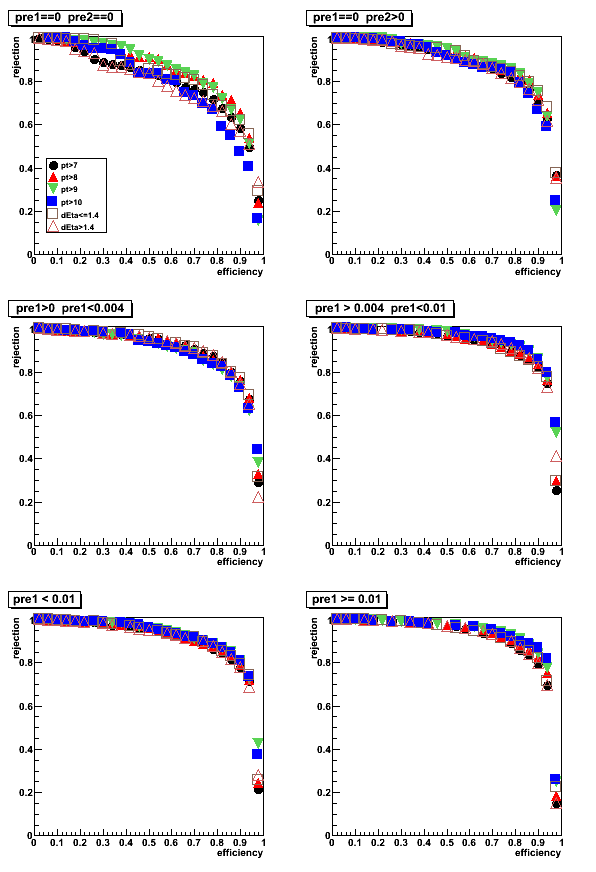
Figure 8: purity vs. efficiency
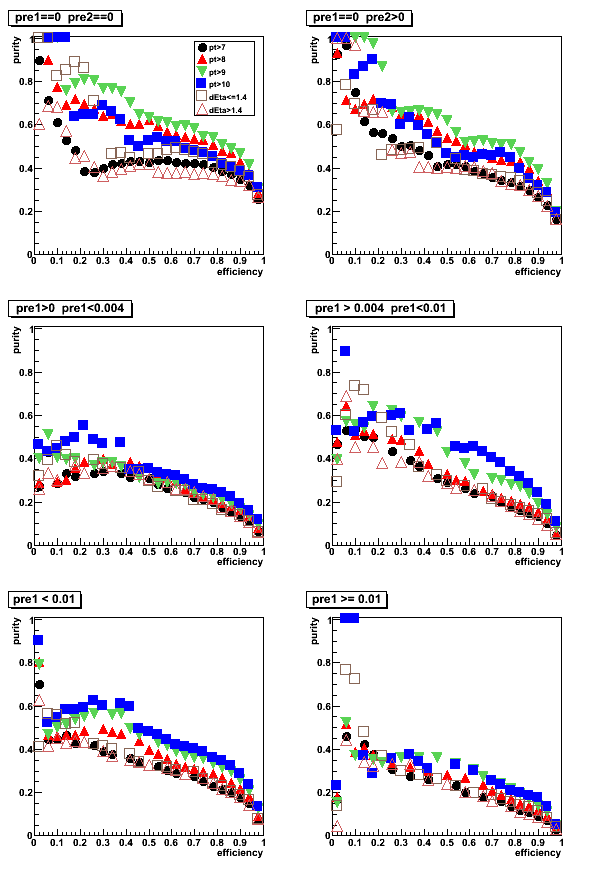
Figure 9: purity vs. rejection (click link to see the figure)
LDA Set2
Figure 10: rejection vs. efficiency (click link to see the figure)
Figure 11: purity vs. efficiency
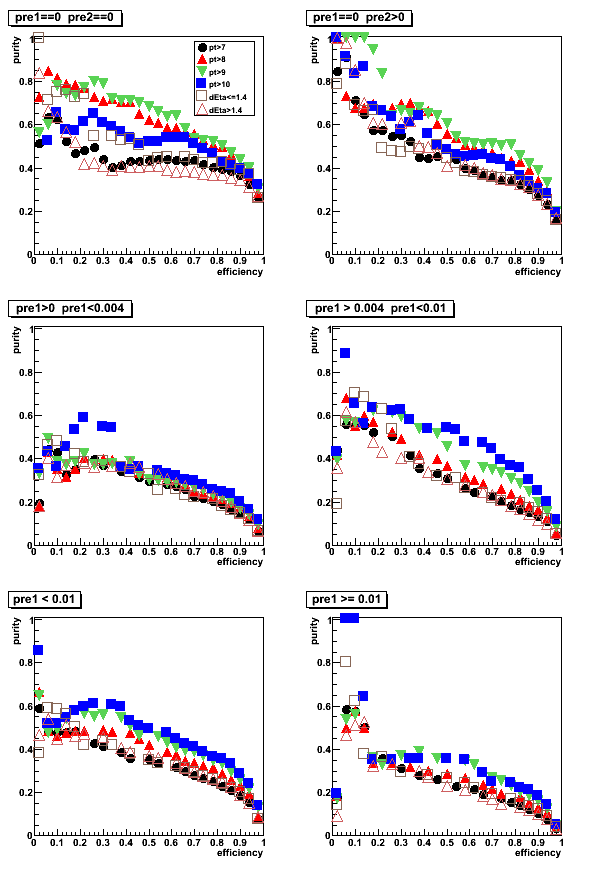
Figure 12: purity vs. rejection (click link to see the figure)
LDA Set3
Figure 13: rejection vs. efficiency (click link to see the figure)
Figure 14: purity vs. efficiency
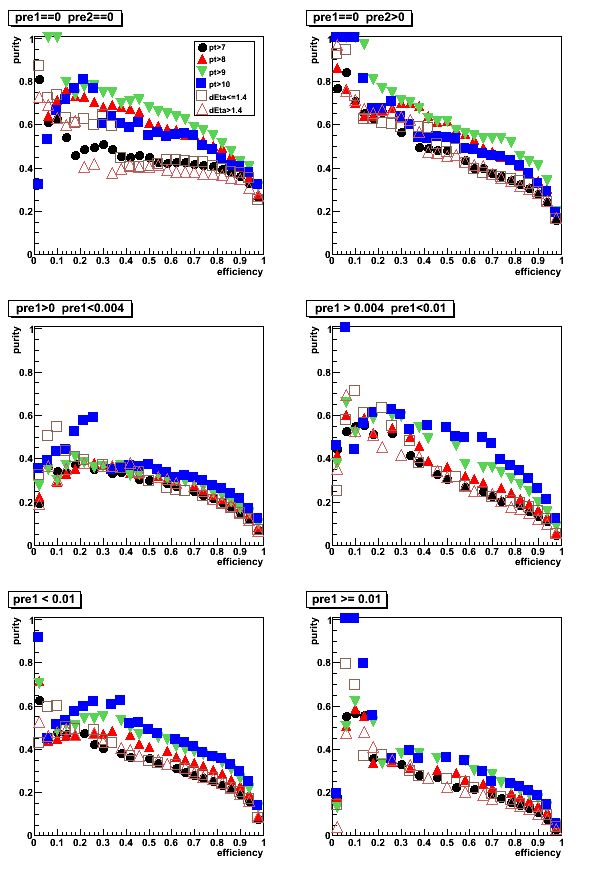
Figure 15: purity vs. rejection (click link to see the figure)
2009.05.04 LDA: More SMD info, 3x3 tower energy, correlation matrix
Cut optimization with Fisher's LDA classifier
ROOT implementation for LDA:
Application for cuts optimization in the gamma-jet analysis
LDA configuration: default
LDA input parameters Set0:
- Set4 (link for results with LDA Set0-Set3):
- Energy fraction in 3x3 cluster within a r=0.7 radius:
E_3x3/E_0.7 - Photon-jet pt balance:
[pt_gamma-pt_jet]/pt_gamma - Number of charge tracks within r=0.7 around gamma candidate:
Ncharge - Number of Endcap towersL fired within r=0.7 around gamma candidate:
NtowBarrel - Number of Barrel towers fired within r=0.7 around gamma candidate
NtowEndcap - Shower shape analysis: distance to 80% cut line:
distance to cut line - Energy fraction in E_2x1 and E_2x2 witin E_3x3:
E_2x1/E_2x2 and E_2x2/E_3x3 - Energy in post-shower layer under 3x3 tower patch:
E_post^3x3 - Tower energy in 3x3 patch:
E_tow^3x3 - SMD-u energy in 25 central strips:
E_smd-u^25 - SMD-v energy in 25 central strips:
E_smd-v^25 - SMD-v peak energy (in 5 central strips):
E_peak
- Energy fraction in 3x3 cluster within a r=0.7 radius:
The number of strips in SMD u or v planes is required to be greater than 3
Pre-shower sorting (energy in tiles under 3x3 tower patch):
- pre1=0, pre2=0
- pre1=0, pre2>0
- 0 < pre1 < 0.004
- 0.004 < pre1 < 0.01
- pre1 < 0.01
- pre1 >= 0.01
Integrated yields per pre-shower bin:
| sample | total integral | pre1=0,pre2=0 | pre1=0, pre2>0 | 0 < pre1 < 0.004 | 0.004 < pre1 < 0.01 | pre1 < 0.01 | pre1 >= 0.01 |
| photon-jet | 2.5640e+03 | 3.5034e+02 | 5.2041e+02 | 5.6741e+02 | 5.2619e+02 | 1.9644e+03 | 5.9994e+02 |
| QCD | 5.6345e+04 | 1.3515e+03 | 4.3010e+03 | 1.2289e+04 | 1.5759e+04 | 3.3701e+04 | 2.2644e+04 |
| pp2006 | 6.2811e+04 | 6.8000e+02 | 2.4310e+03 | 1.2195e+04 | 1.6766e+04 | 3.2072e+04 | 3.0739e+04 |
Photon pt and rapidity cuts:
- pt>7GeV
- pt>8GeV
- pt>9GeV
- pt>10GeV
- detector eta <1.4 (pt>7GeV)
- detector eta > 1.4 (pt>7GeV)
LDA Set4
Figure 1: LDA discriminant with Set0: Data to Monte-Carlo comparison (pt>7GeV cut)
Right plot for each pre-shower condition shows the ratio of pp2006 data to sum of the Monte-Carlo samples
Colour coding:
black pp2006 data, red gamma-jet MC, green QCD MC, blue gamma-jet+QCD
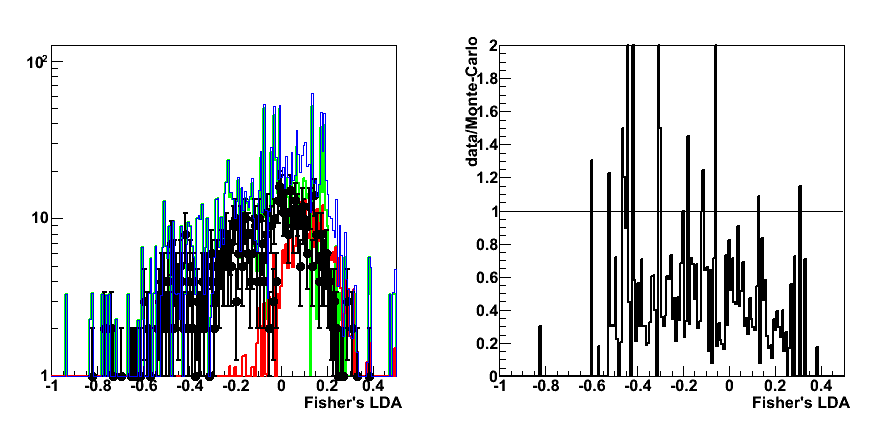
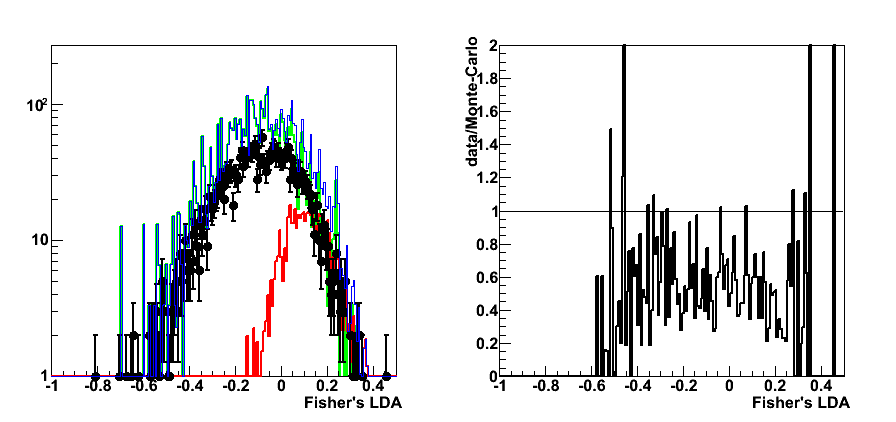
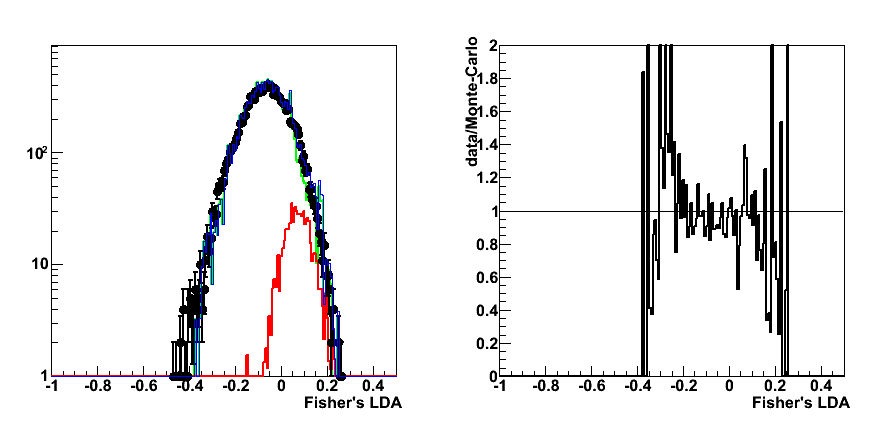
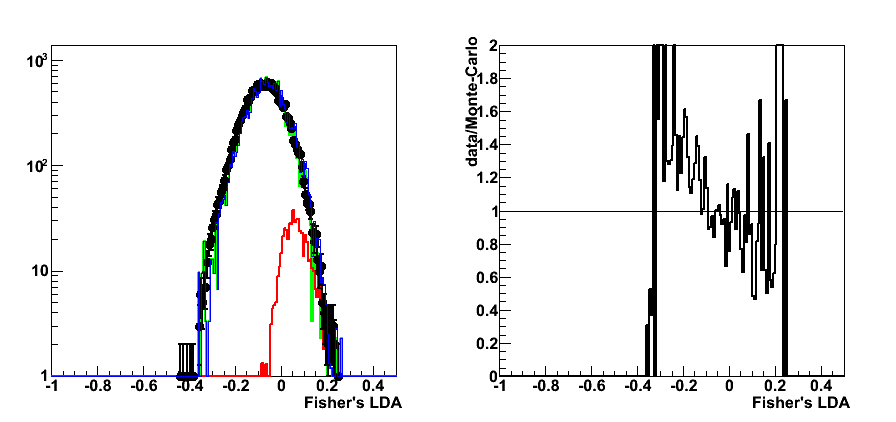
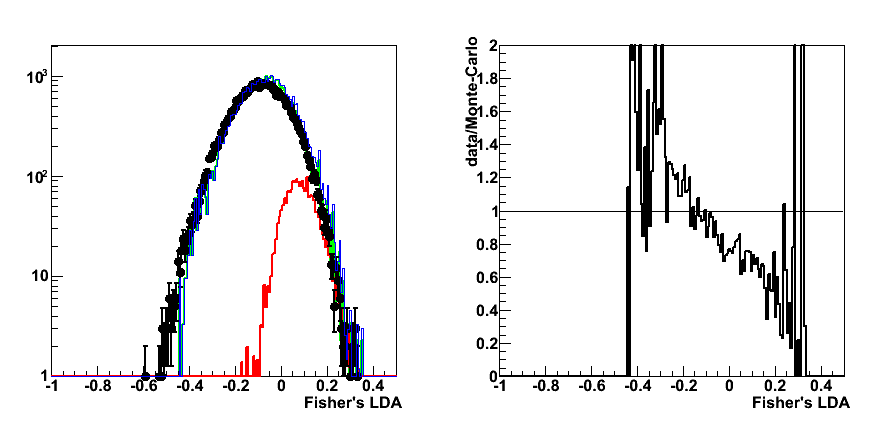
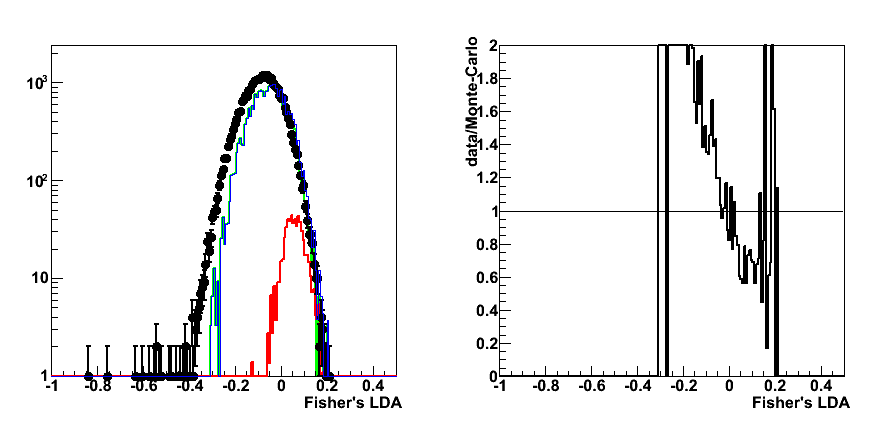
Figure 2: rejection vs. efficiency
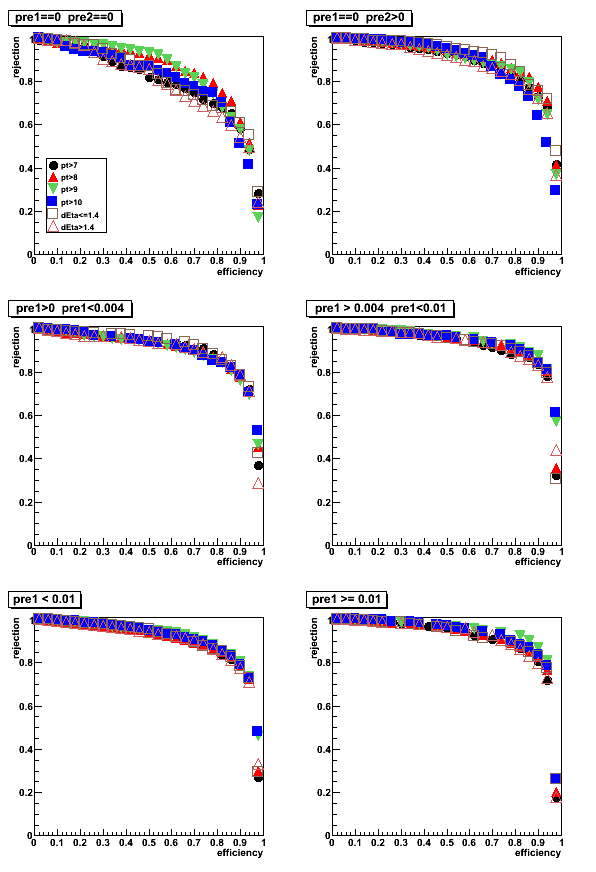
Figure 3: purity vs. efficiency
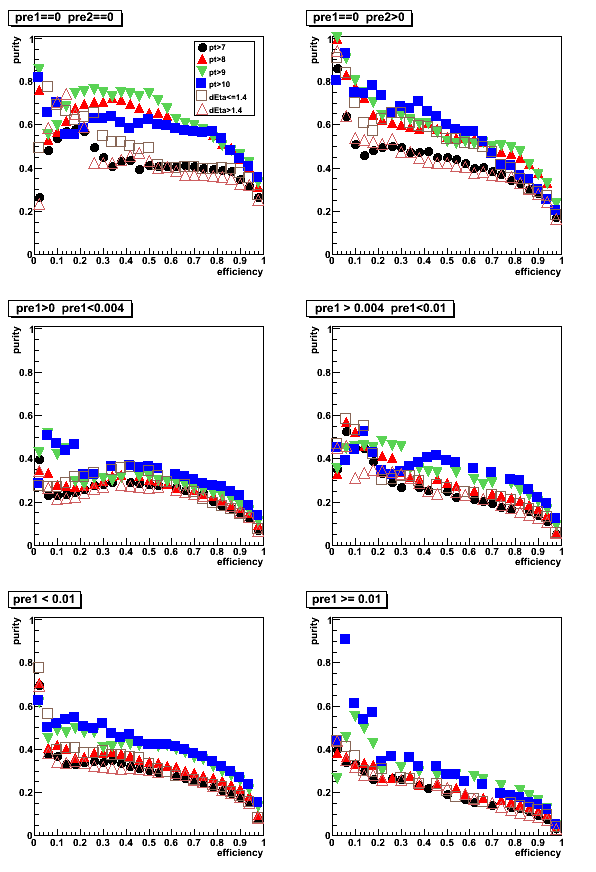
Figure 4: purity vs. rejection

Figure 5: Correlation matrix (pt>7GeV cut)
pre1=0, pre2=0
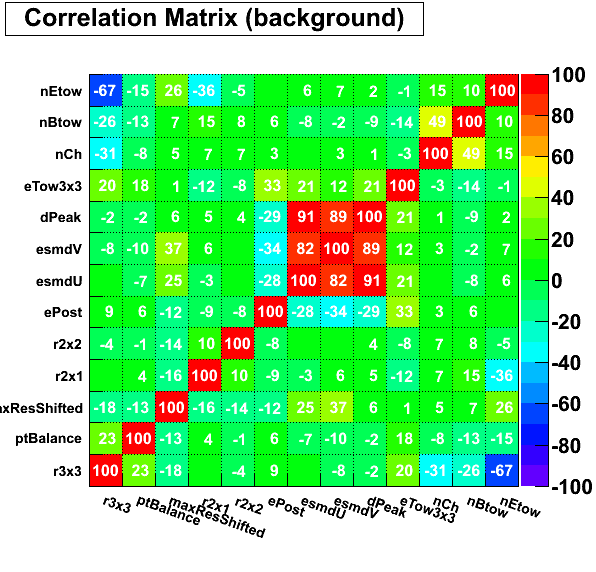
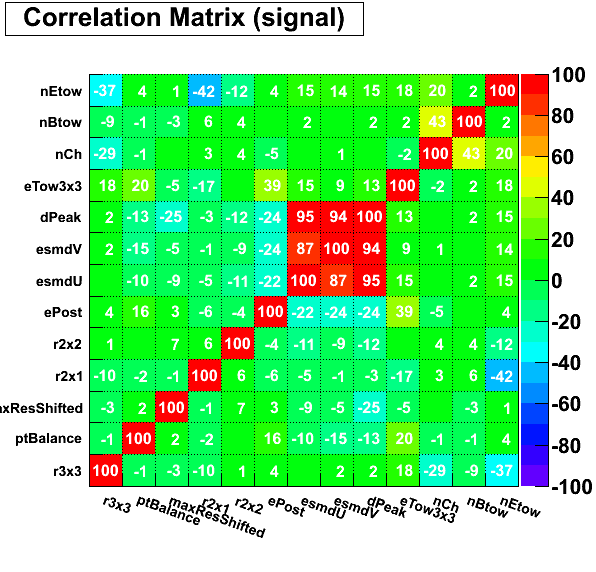
pre1=0, pre2>0
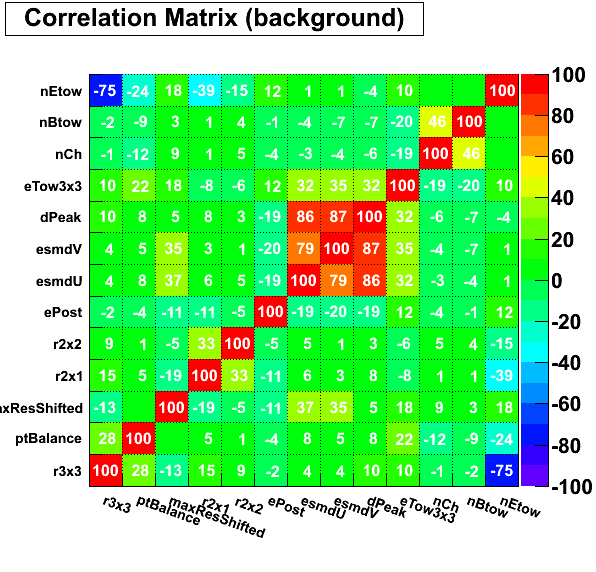
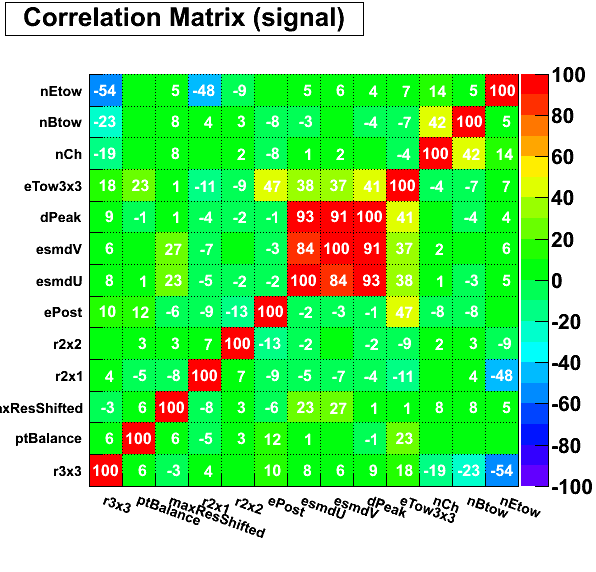
0 < pre1 < 0.004
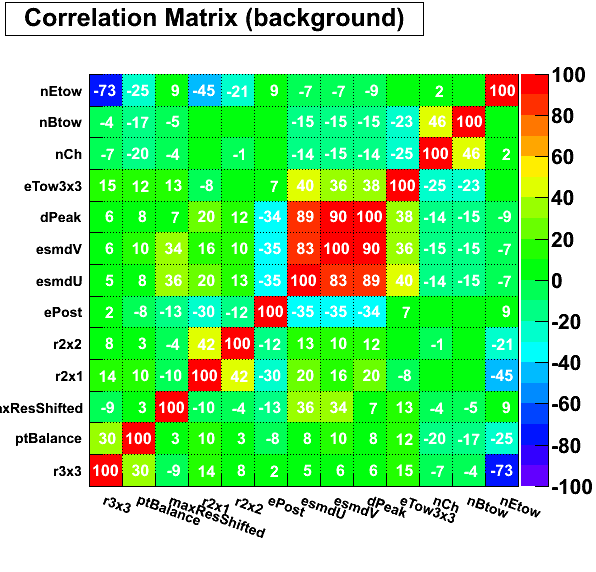
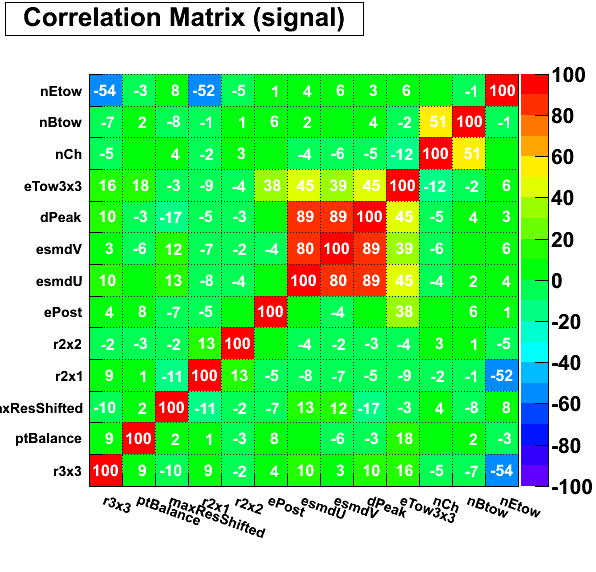
0.004 < pre1 < 0.01
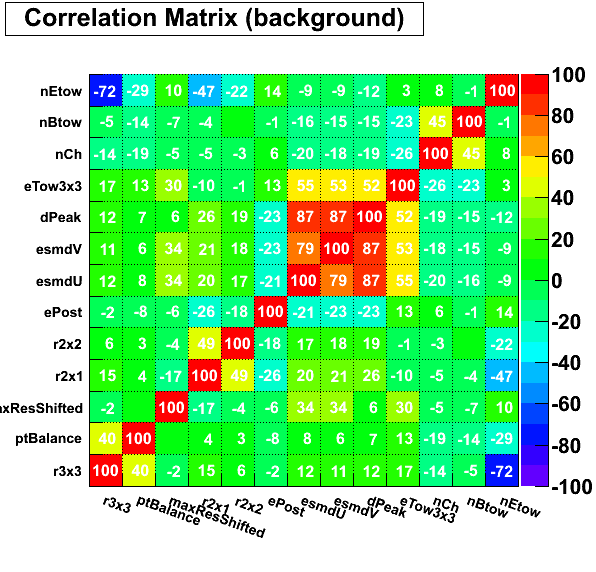
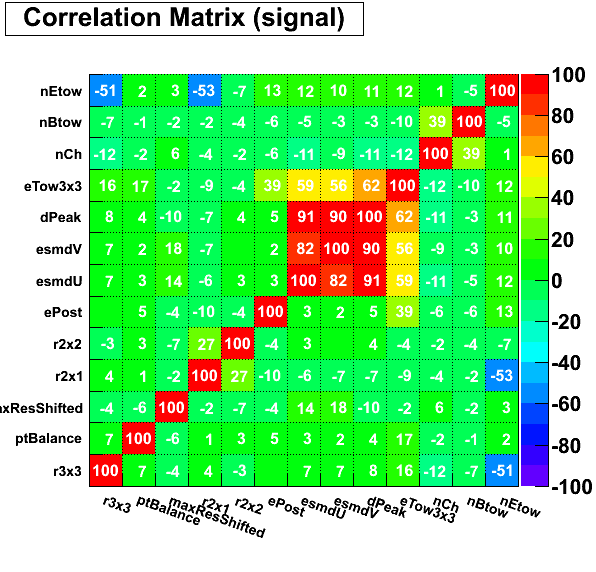
pre1 < 0.01
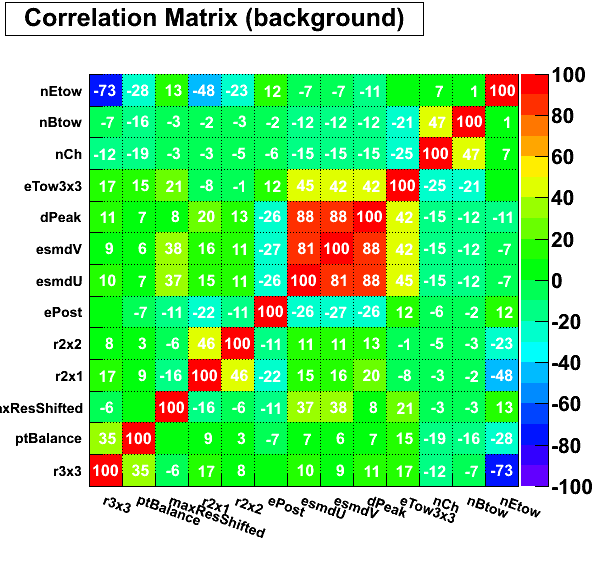
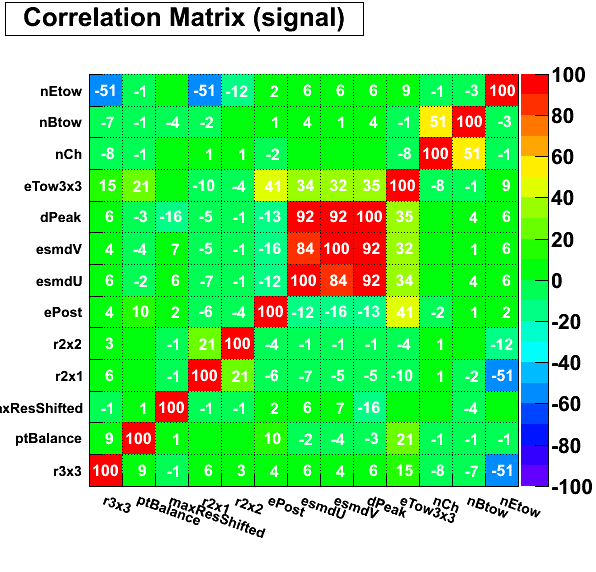
pre1 >= 0.01
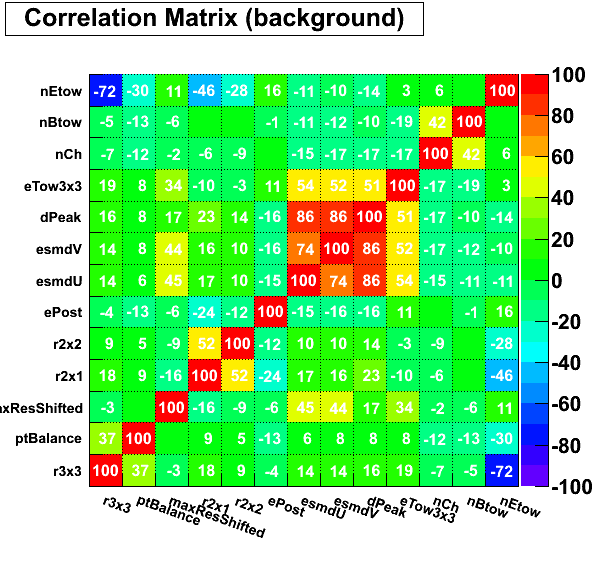
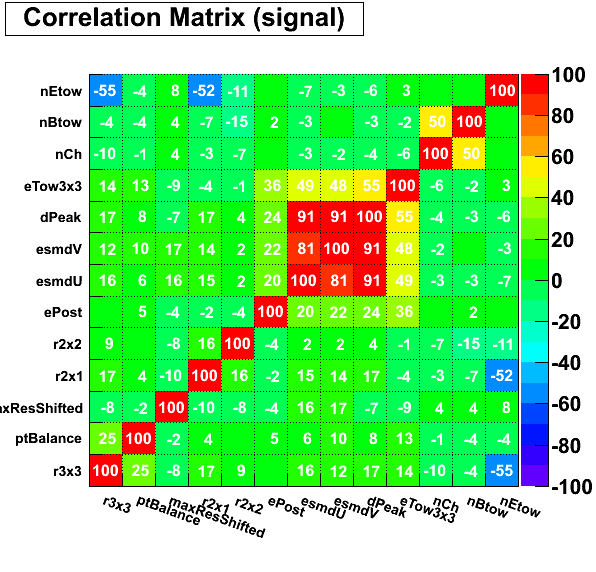
2009.05.06 Applying cuts on LDA: request minimum purity or efficiency
Cut optimization with Fisher's LDA classifier
For this post LDA input parameters Set4 has been used
LDA for various pre-shower bins is trained independetly,
and later results with pre-shower1<0.01 are combined.
There are a set of plots for various photon pt cuts (pt> 7, 8, 9 10 GeV)
and with different selection of cutoff for LDA
(either based on purity or efficiency).
Number in brackets shows the total yield for the sample.
Link to all plots (16 total) as a single pdf file
pt > 7GeV
Figure 1: pt > 7GeV, efficiency@70
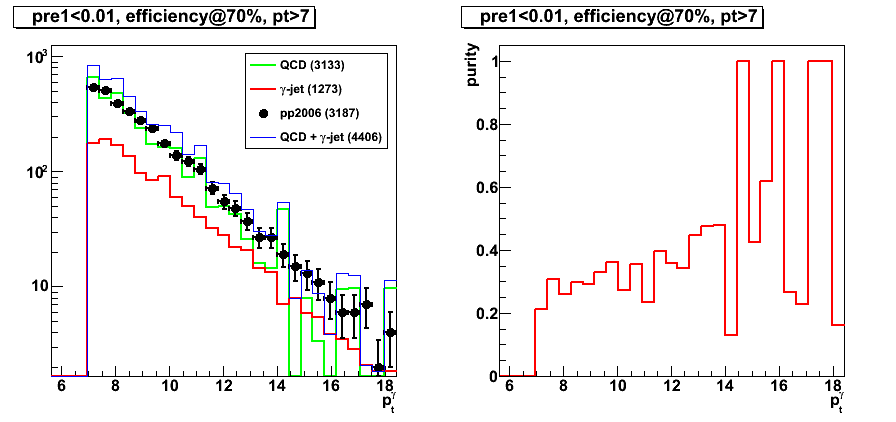
Figure 2: pt > 7GeV, purity@35
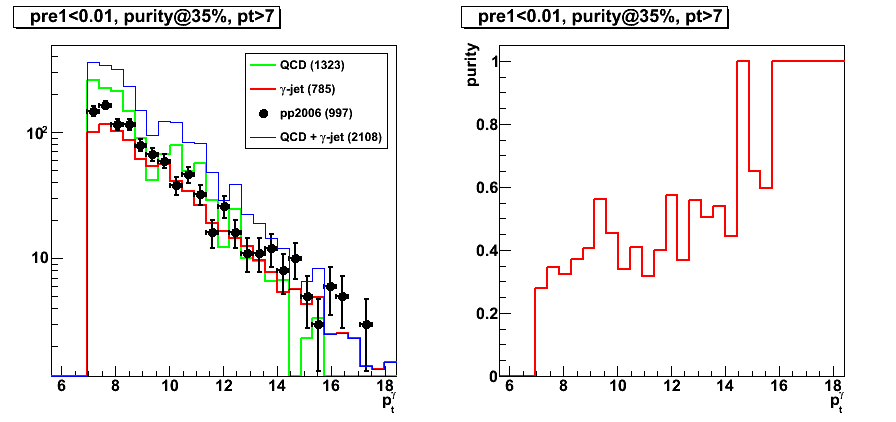
Figure 3: pt > 7GeV, purity@40
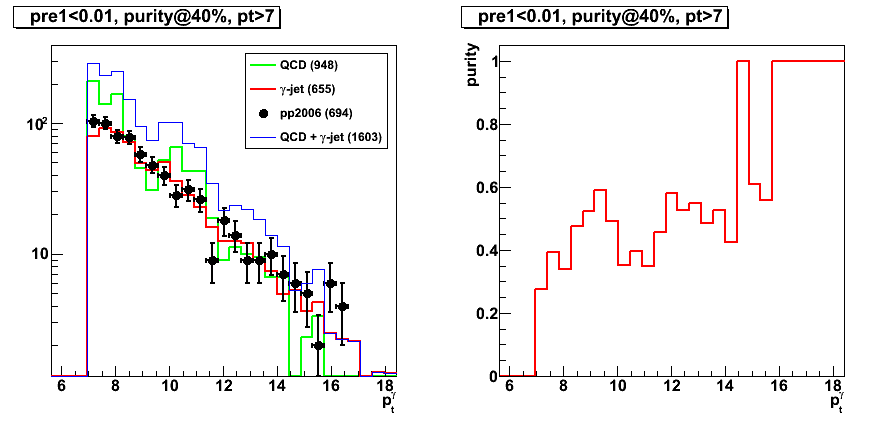
Figure 4: pt > 7GeV, purity@25 (Note: very similar to results with efficiency@70)
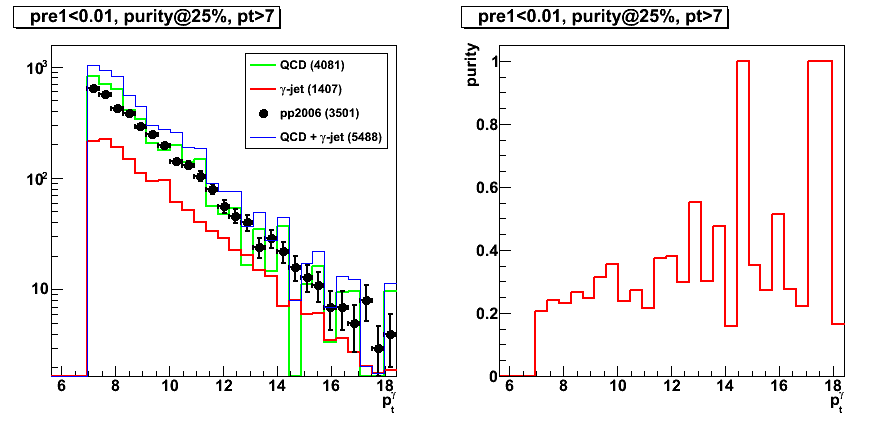
pt > 9GeV
Figure 5: pt > 9GeV, efficiency@70
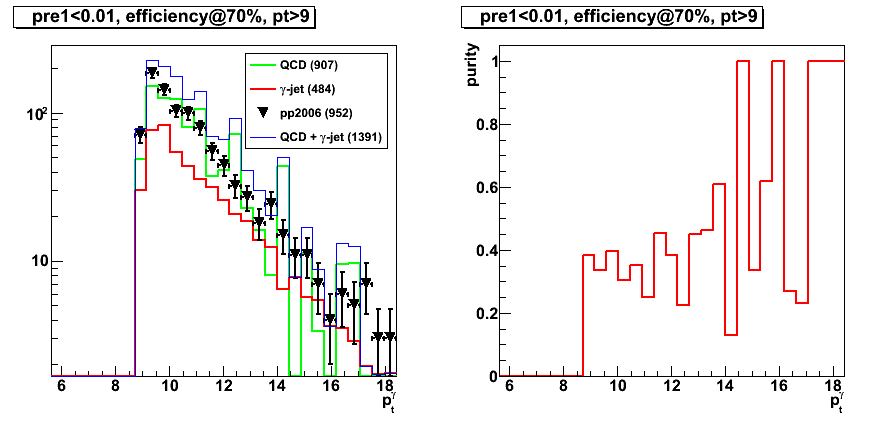
Figure 6: pt > 9GeV, purity@35
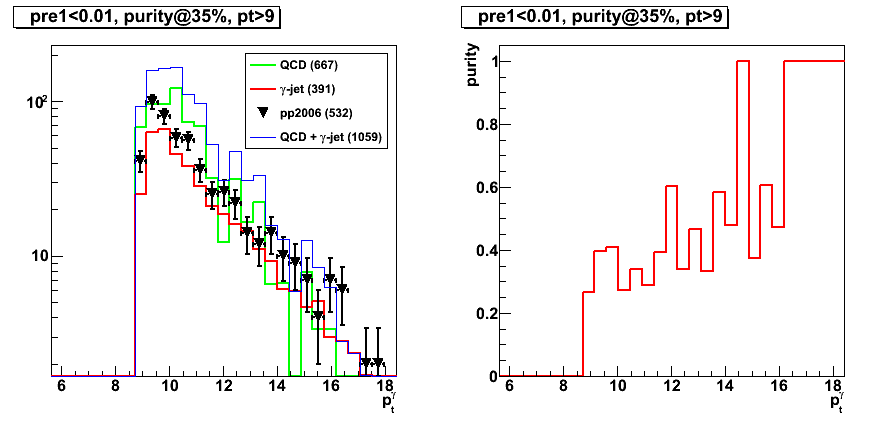
pt > 10GeV
Figure 7: pt > 10GeV, efficiency@70
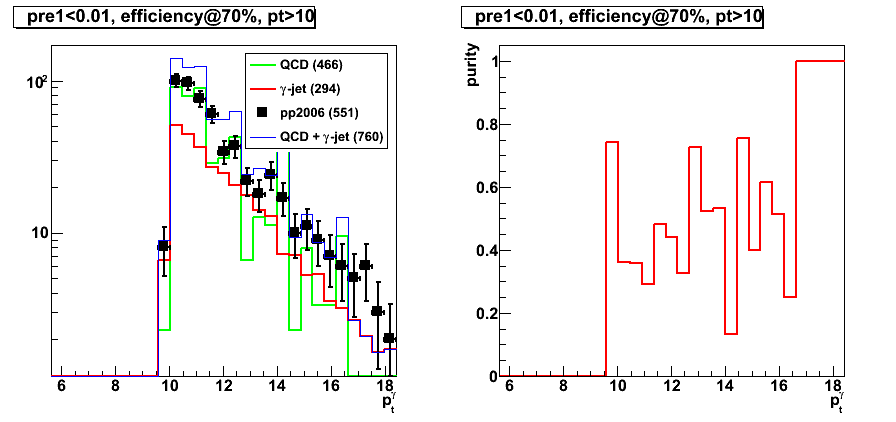
Figure 8: pt > 10GeV, purity@40
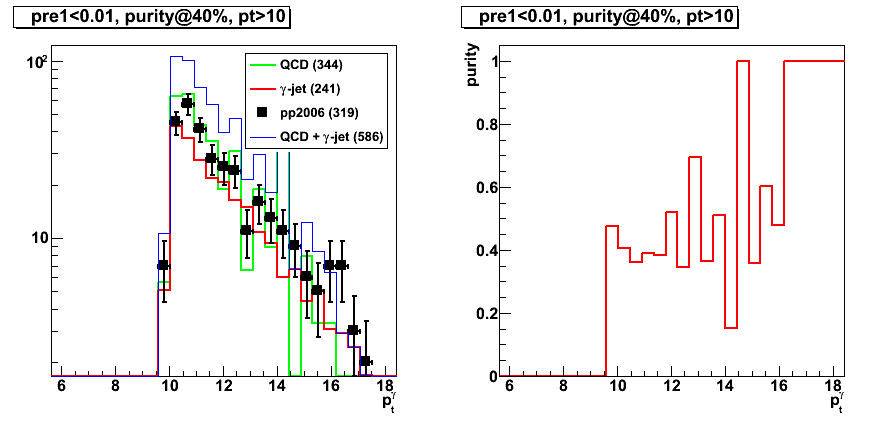
2009.05.07 Photon-jets analysis with the Endcap Calorimeter
Photon-jets with the Endcap Calorimeter
(analysis status update for Spin PWG)
Slides in pdf format:
2009.05.12 Variable distributions after LDA at 70% efficiency
Cut optimization with Fisher's LDA classifier
For this post LDA results with Set1 and Set2 has been used
Note, that LDA for various pre-shower bins is trained independetly
pdf-links with results for pre1=0 and pre2=0 (pre-shower bin 1):
- before LDA cut (figures are not sorted)
- after LDA cut @70% efficiency for Set 2 (figures are not sorted)
Figures below are for 0.004<pre-shower1<0.01 (pre-shower bin 4).
Photon pt cut: pt> 7, pre-shower bin: 0.004 < pre1 < 0.01
LDA cut with efficiency @ 70%
Set1 vs. Set2
What is added in Set2 compared to Set1:
smaller cluster size information (r2x1, r2x2), post-shower energy
Figure 1: r2x1
before LDA cut
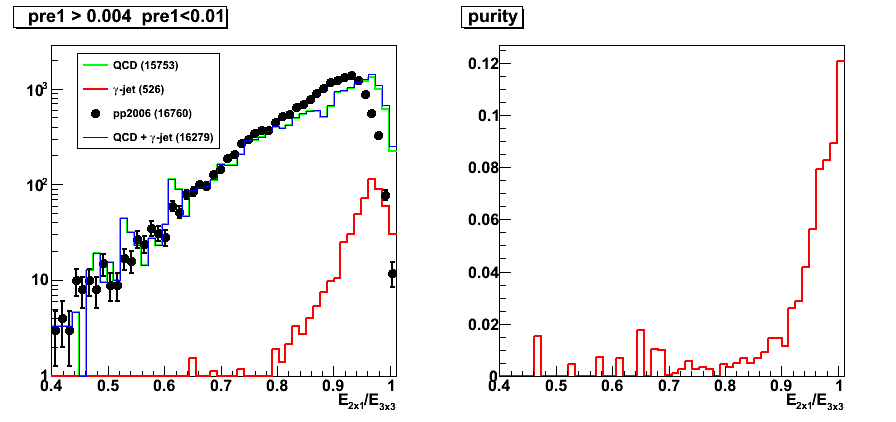
LDA cut for Set1
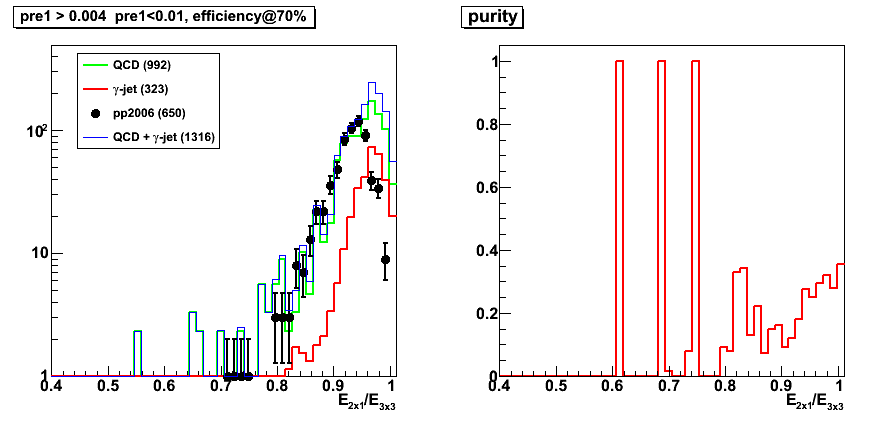
LDA cut for Set2
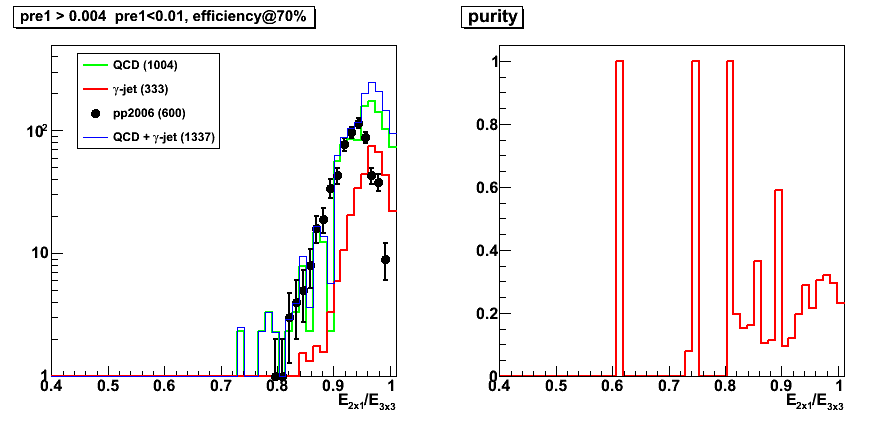
Figure 2: r2x2
before LDA cut
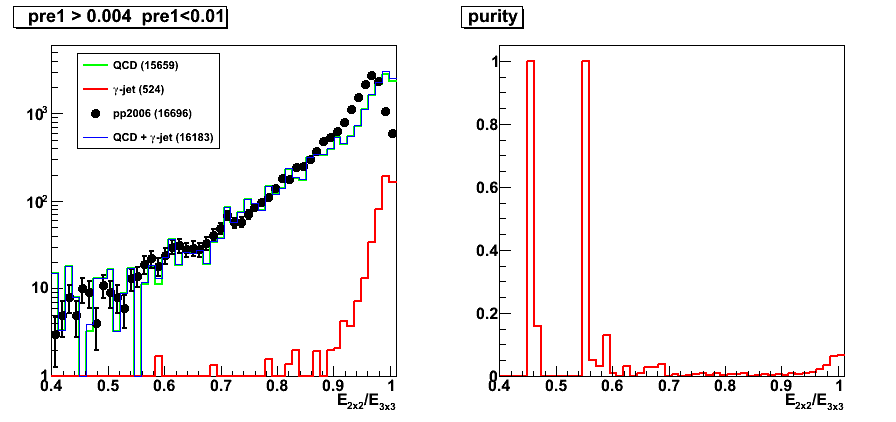
LDA cut for Set1
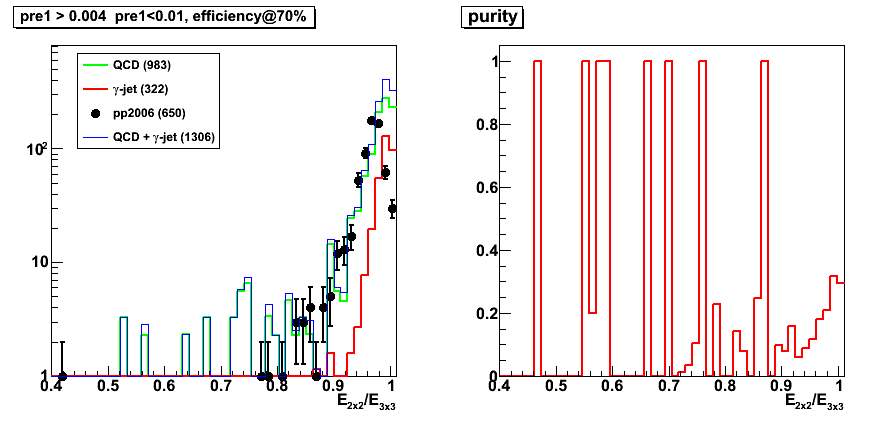
LDA cut for Set2
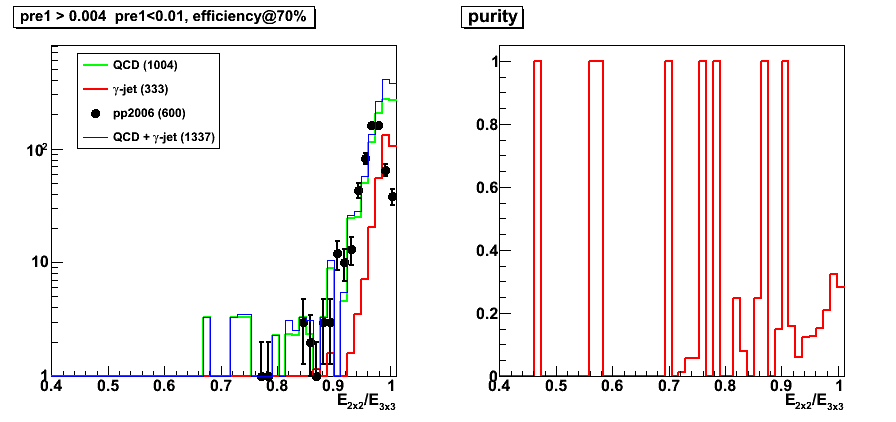
Figure 3: r3x3
before LDA cut
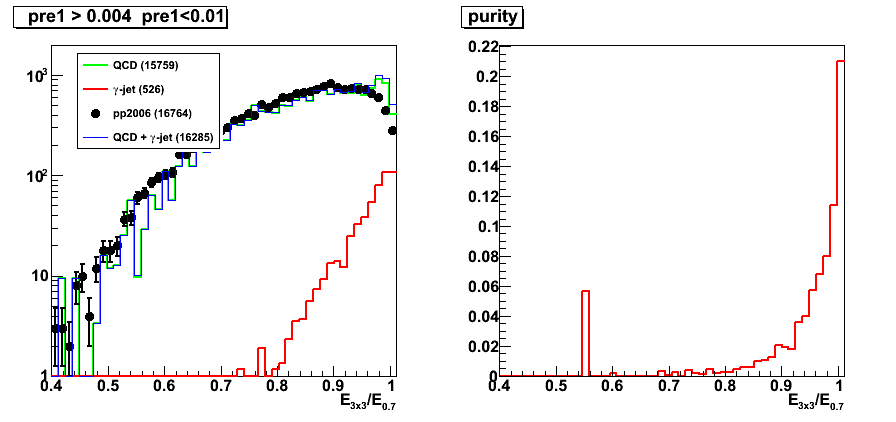
LDA cut for Set1
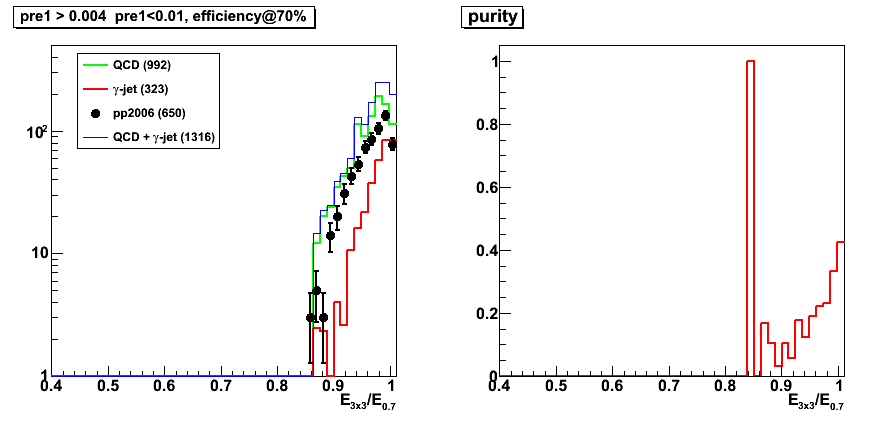
LDA cut for Set2
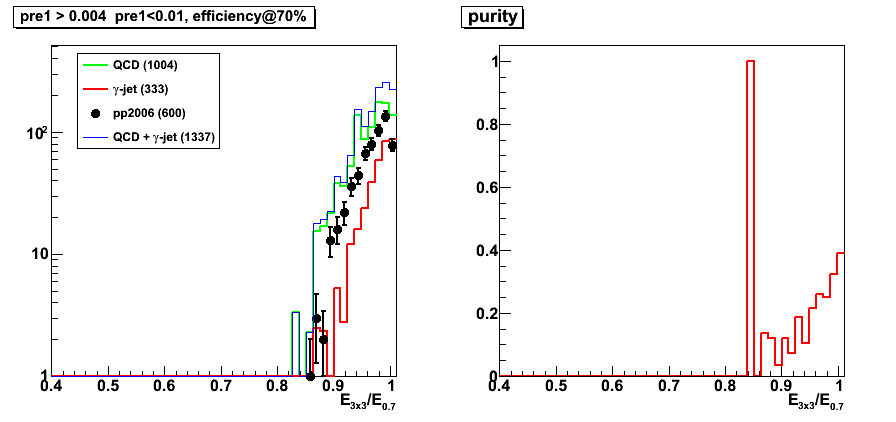
Figure 4: Residual distance
before LDA cut
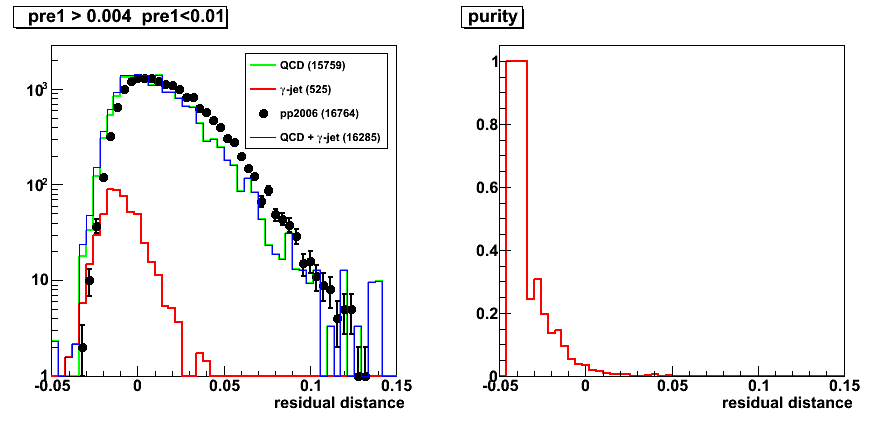
LDA cut for Set1
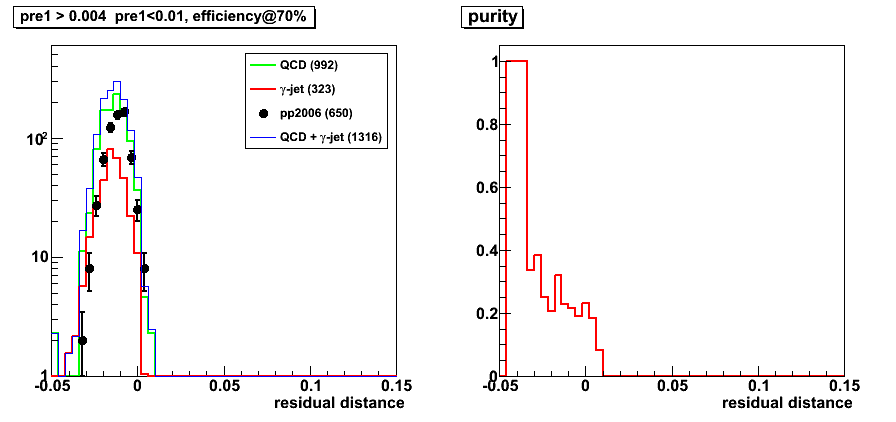
LDA cut for Set2
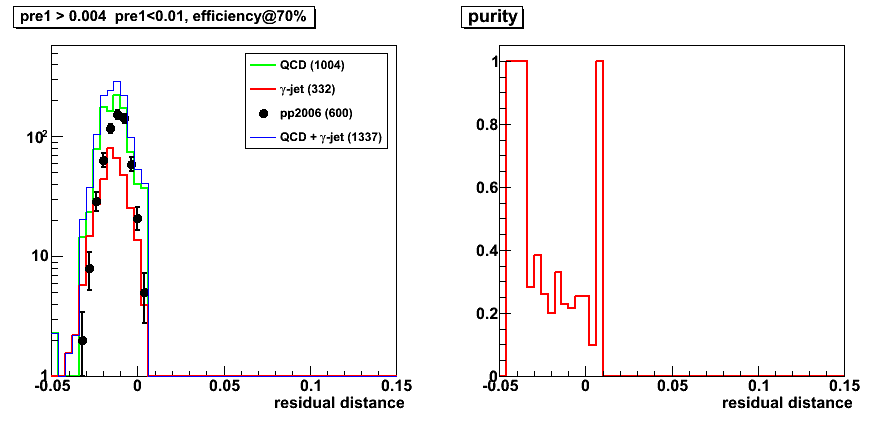
Other variables with LDA Set2 cut
Note: Only plos for LDA cut @70 efficiency for Set2 are shown
Figure : number of charge particles around photon
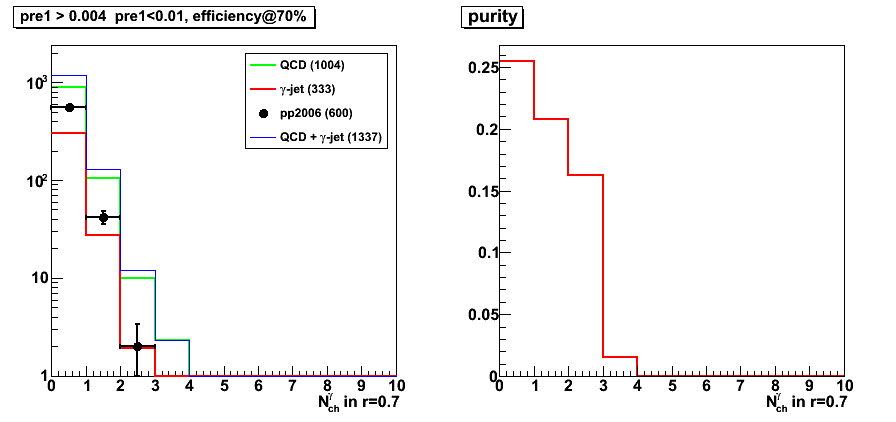
Figure 5: number of EEMC tower around photon
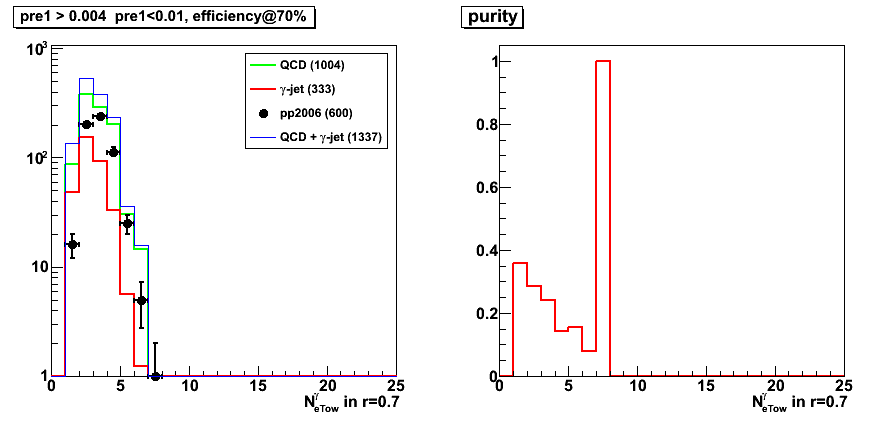
Figure 6: number of BEMC tower around photon
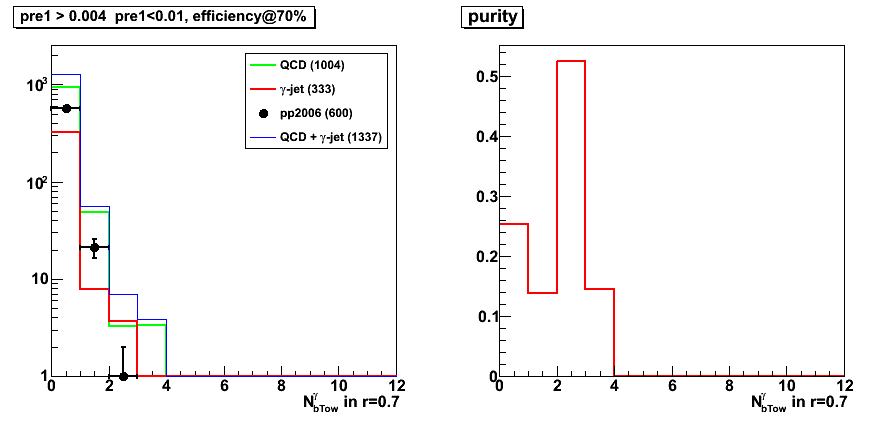
Figure 7: photon-jet pt balance
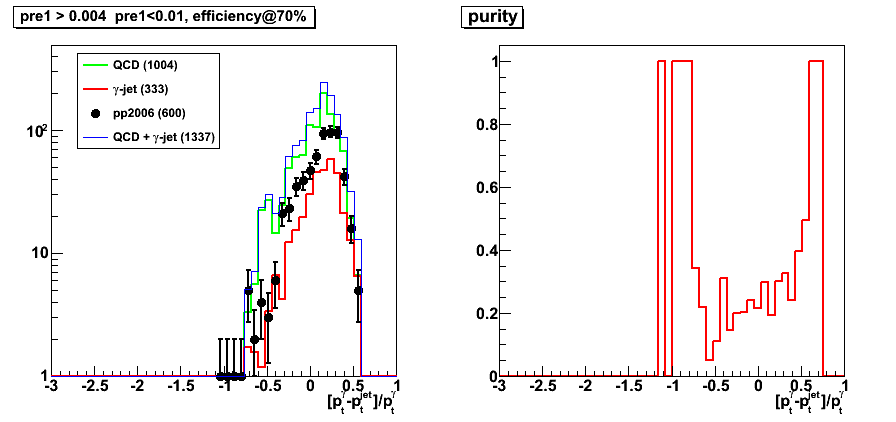
Figure 8: SMD energy in 5 centrapl strips
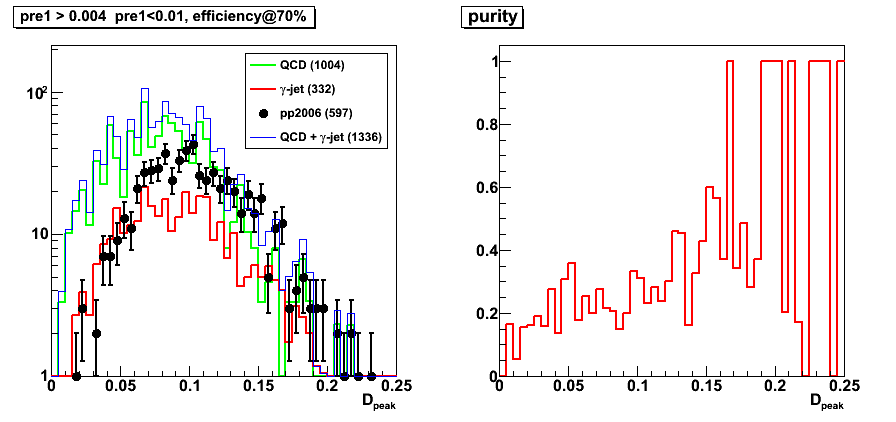
Figure 9: SMD energy in 25 central strips: u and v plane separately (plot for V plane)
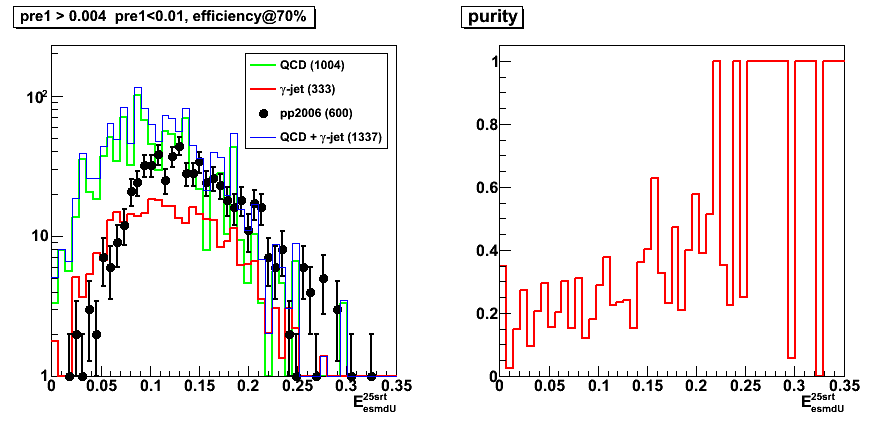
Figure 13: tower energy in r=0.7 radius
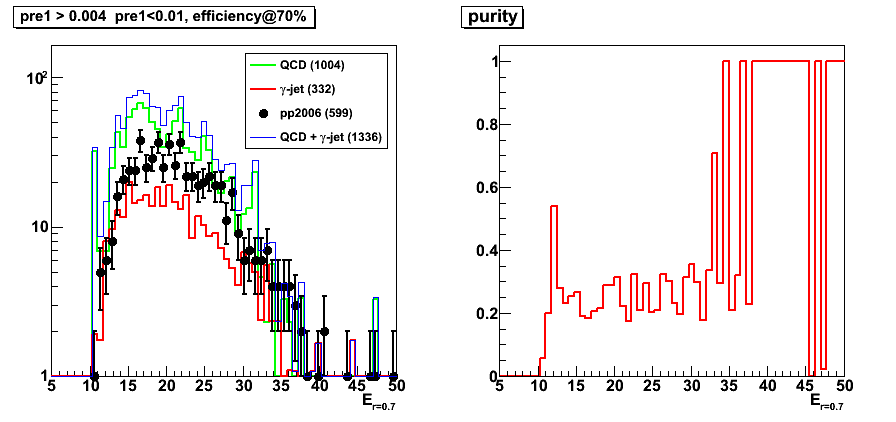
Figure 14: 3x3 pre-shower1 energy
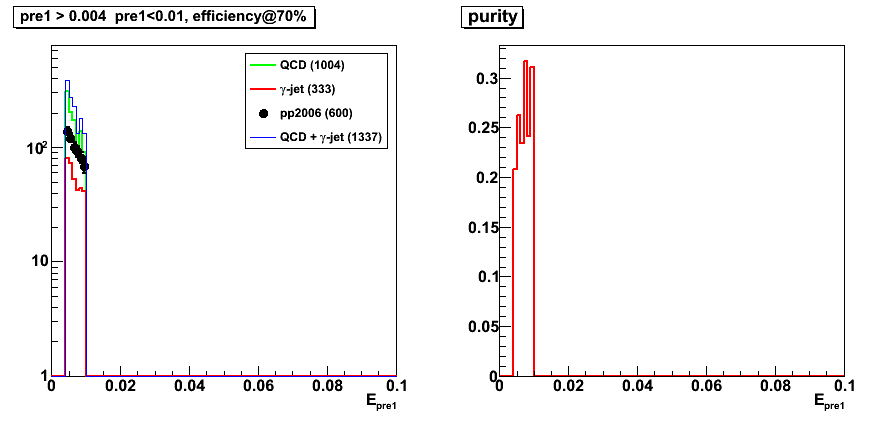
Figure 15: 3x3 pre-shower2 energy
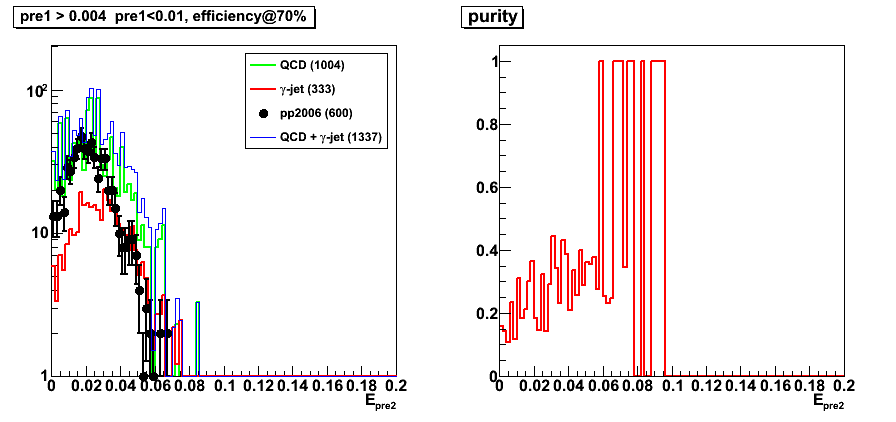
Figure 16: 3x3 post-shower energy
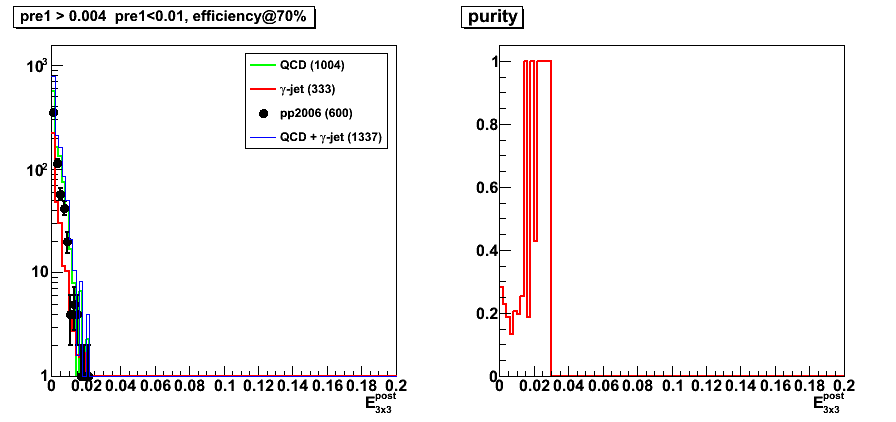
2009.05.31 CIPANP 2009 photon-jet presentation
CIPANP 2009 presentation on photon-jet study
Title:
"Photon-jet coincidence measurements
in polarized pp collisions at sqrt{s}=200GeV
with the STAR Endcap Calorimeter"
- Presentation in pdf format
- Older versions: 0, 1, 2 3, 4, 5, open office file: odp
- Submitted abstract
- Conference link: CIPANP 2009
06 Jun
June 2009 posts
2009.06.22 CIPANP 2009 photon-jet proceedings
CIPANP 2009 proceedings on photon-jet study
Title:
"Photon-jet coincidence measurements
in polarized pp collisions at sqrt{s}=200 GeV
with the STAR Endcap Calorimeter"
- Proceedings: latest version
Older versions: 01 02 03 04 05 - Presentation
- Submitted abstract
- Conference link: CIPANP 2009
07 Jul
July 2009 posts
2009.07.21 EEMC tower response in Monte-Carlo
Data set and cuts:
- gamma-jet filtered Monte-Carlo
- Di-jet events from the jet finder (jets threshold: 3.5 GeV)
- parton pt bin 3-4 GeV (see pt_gamma distributions for various parton pt bins)
- Thrown photon pseudo-rapidity: eta in [1-2] range
- Requires to reconstruct photon candidate in the EEMC
Figure 1: Average ratio: pt_true / (pt_reco/1.3) vs. pt_reco (GeV/c)
- Introduce 1.3 factor here to remove the effect of the fudge factor in slow simulator
- Since a limited partonic pt range (3-4 GeV) is used for this study,
there is an "artificial" increase of the plotted ratio in pt_gamma > 6 GeV range - Fig. 1 reflects similar features (over a limited pt range) as those found by Hal
in his single photon study (see slide 6 of SimulationStudies.ppt presentation)
Figure 2:
Average momentum difference: pt_true - (pt_reco/1.3) vs. pt_reco (GeV/c)
- Fig. 2 shows that on average in GEANT Monte-Carlo we miss ~1GeV independent on the photon pt.
EEMC detector response can be still linear even if the ratio in Fig. 1 is not flat. - Usage of fixed 1.3 (or others, like 1.25) fudge factors are not justified.
- It seems that using pt-dependent fudge factor (like it is done in this Jason's study)
is also unjustified, since the same effects (flat ratio of pt_reco/pt_true ~ 1)
can be reached by subtracting 1 GeV from the cluster energy (See Fig. 3).
Figure 3: Average ratio: (pt_true -1.06) (pt_reco/1.3) vs. pt_reco (GeV/c)
Similar to Fig. 1, but with the true photon pt reduced by 1.06 GeV
Resulting true/reco pt ratio is flat in 4-6 GeV range.

Before further pursuing our efforts in tuning the tower energy response in the Monte-Carlo,
needs to address the observed energy loss difference in the fisrt layer of the BEMC/EEMC detector.
See Jason's blog post from 2009.07.16 for more details:
Comparison muon energy deposit in the 1st BEMC/EEMC layers
08 Aug
August 2009 posts
2009.08.24 Test of corrected EEMC geometry
Test of corrected EEMC geometry (bug 1618)
Monte-Carlo setup:
- One particle per event (photons, electrons, and pions)
- Full STAR 2006 geometry.
In Kumac file: detp geom y2006g; gexec $STAR_LIB/geometry.so - Flat in eta (1.08-2.0), phi (0,2pi), and pt (3-30 GeV)
- Using A2Emaker to get reconstructed Tower/SMD energy (no EEMC SlowSimulator in chain)
what assumes fixed sampling fraction of 0.05 (5%)
Some definitions:
- Et correction factor : average p_T^thrown / E_T^{reco}.
E_T^{reco} is the total energy in the Endcap Calorimeter (from A2Emaker) - Sampling fraction: average 0.05 * Energy^{reco} / Energy^thrown.
- SMD energy: average energy in all strips fired (u-plane used for this post)
- Number of SMD strips fired: average total number of strips fired (u-plane used for this post)
Notations used in the plots:
- Left plots: no cAir fix
- Right plots: cAir-fixed
- Photons: black
- Electrons: red
- Pions: green
Et correction
Note: compare "Left" plots with Brians old results
Figure 1a: Et correction factor vs. pt thrown
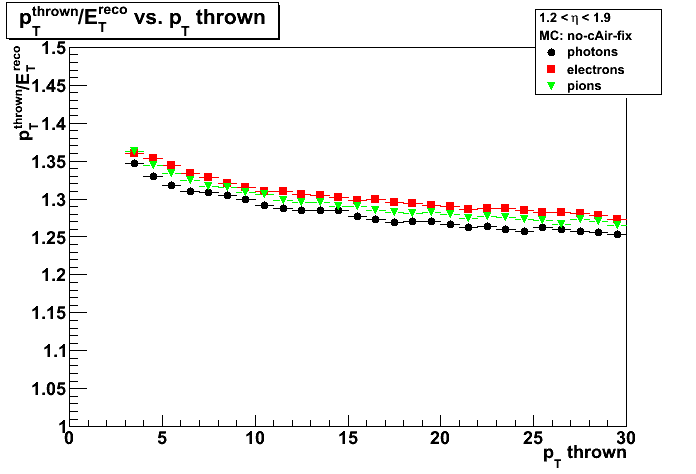
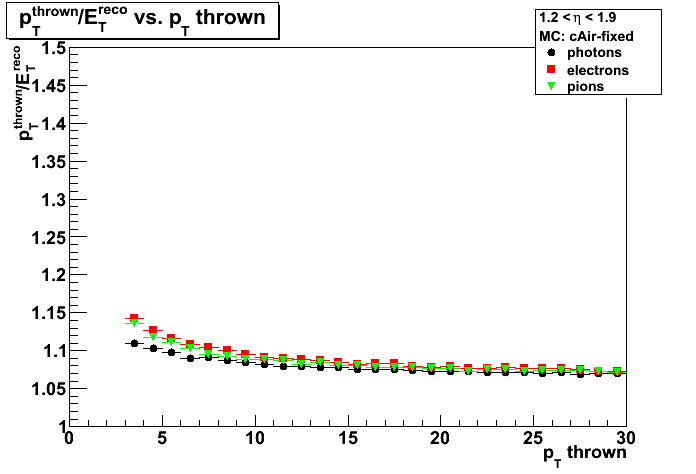
Figure 1b: Et correction factor vs. eta thrown
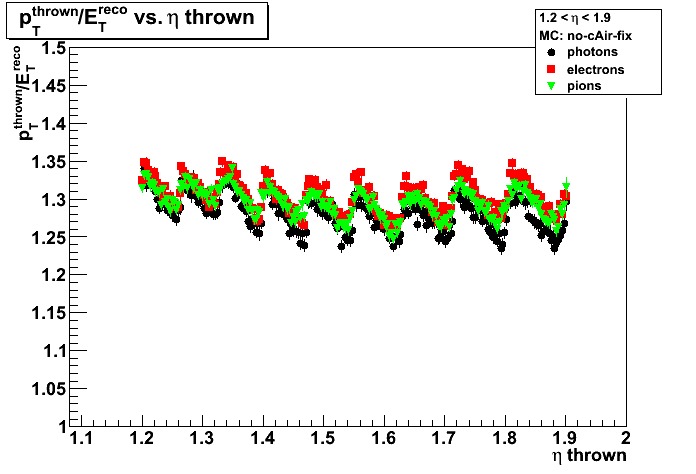
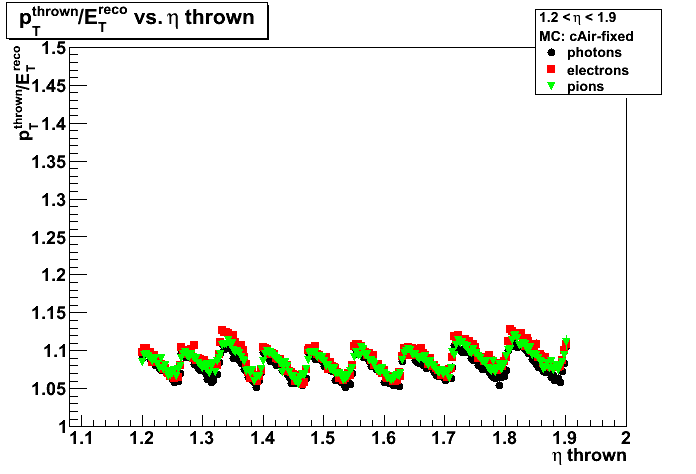
Figure 1c: Et correction factor vs. phi thrown
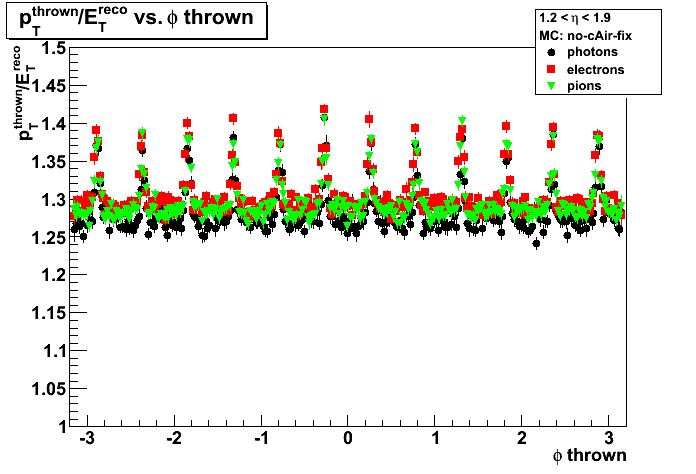

Sampling fraction
Note: compare "Right" plots with Jason results with EEMC only geometry
Figure 2a: Sampling fraction vs. pt thrown
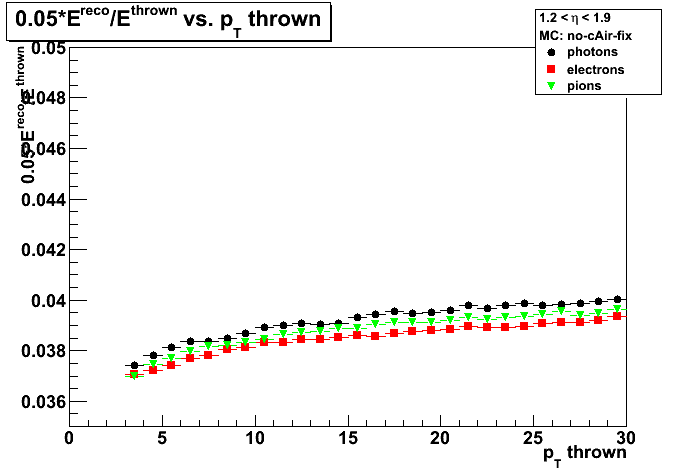
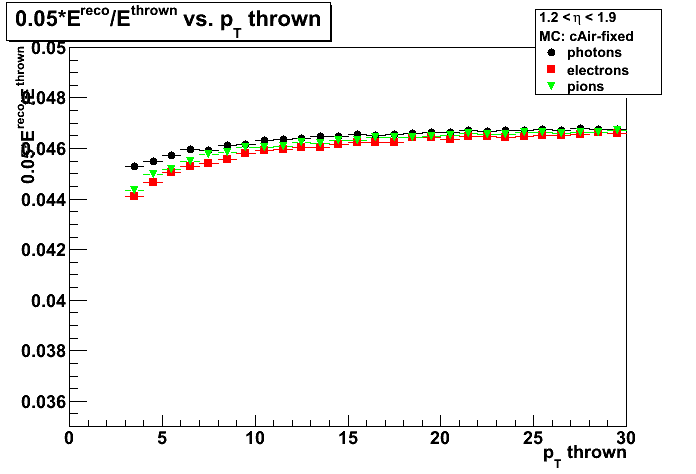
Figure 2b: Sampling fraction vs. energy thrown
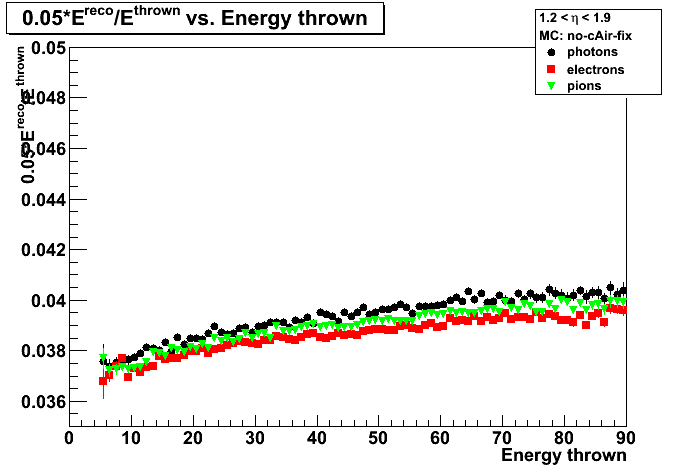
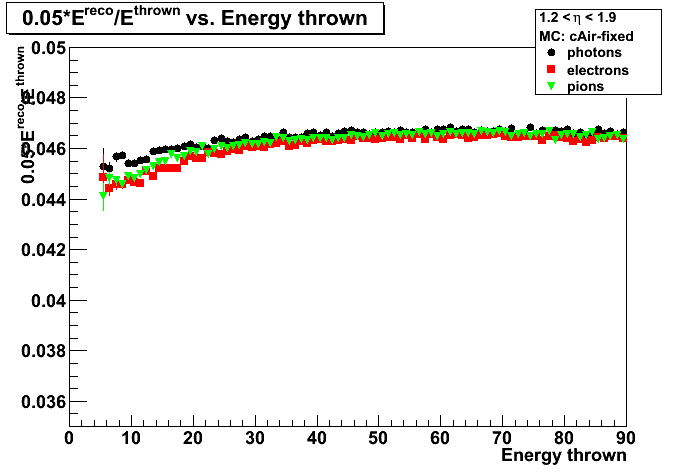
Figure 2c: Sampling fraction vs. eta thrown
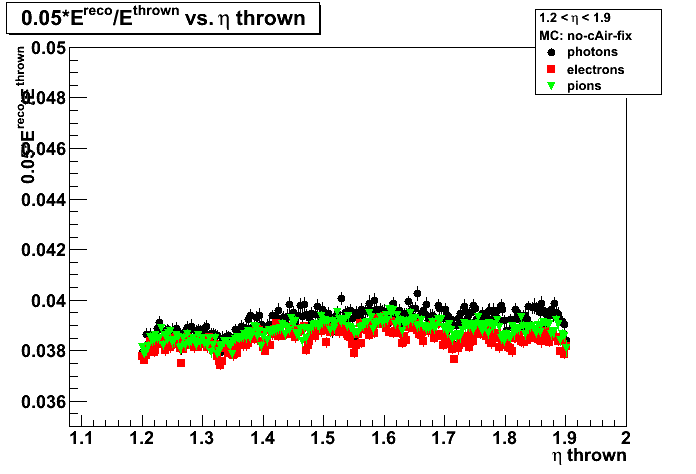
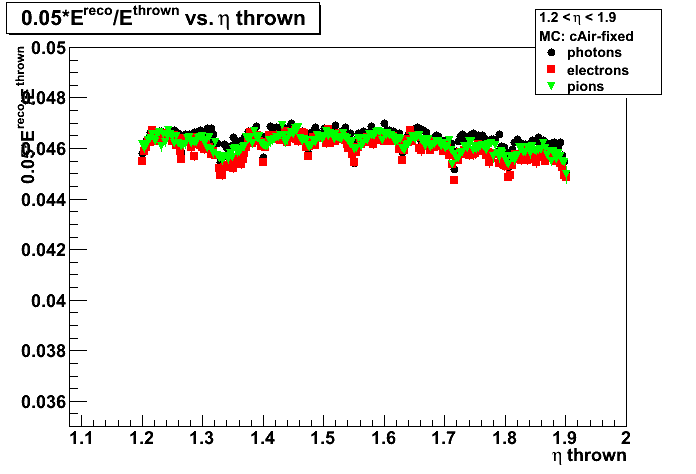
Figure 2d: Sampling fraction vs. phi thrown
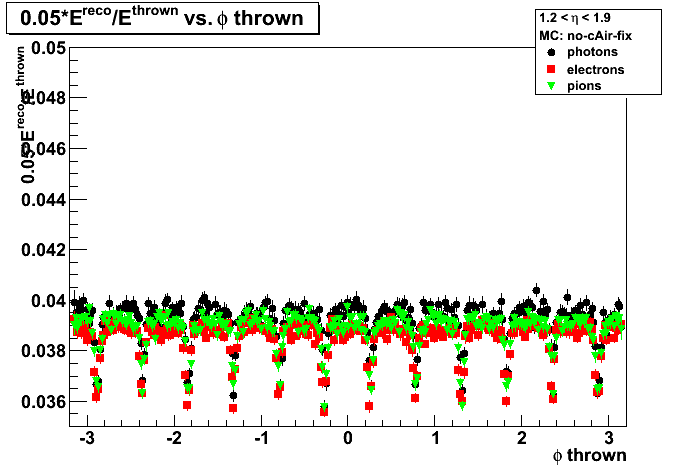
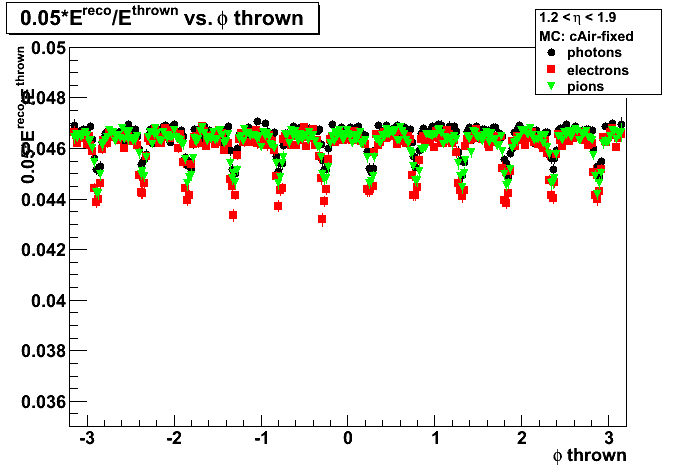
SMD energy
Figure 3a: SMD energy vs. energy thrown
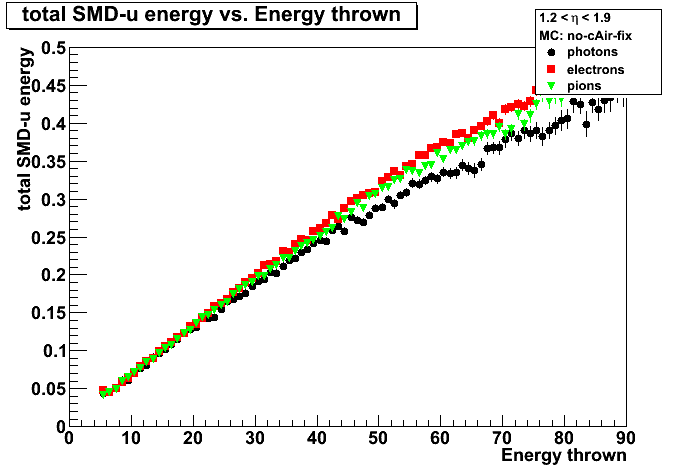
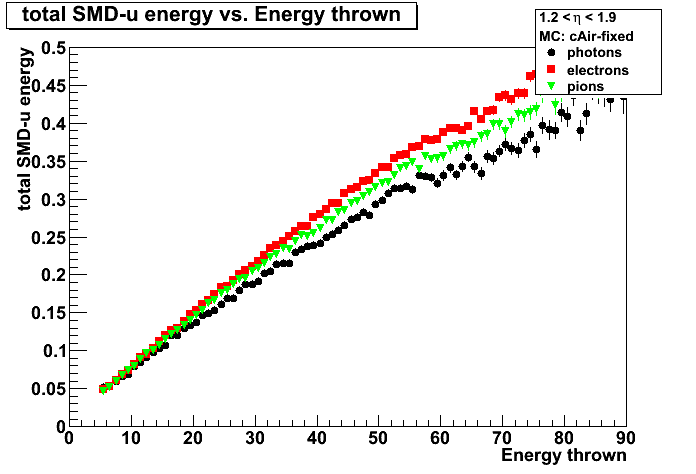
Figure 3b: SMD energy vs. eta thrown
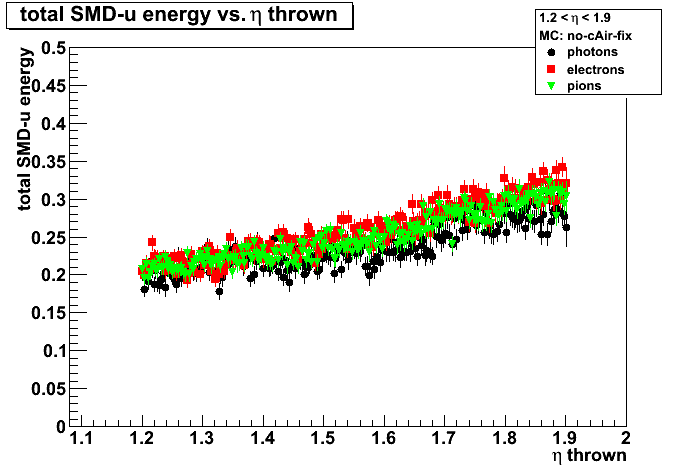
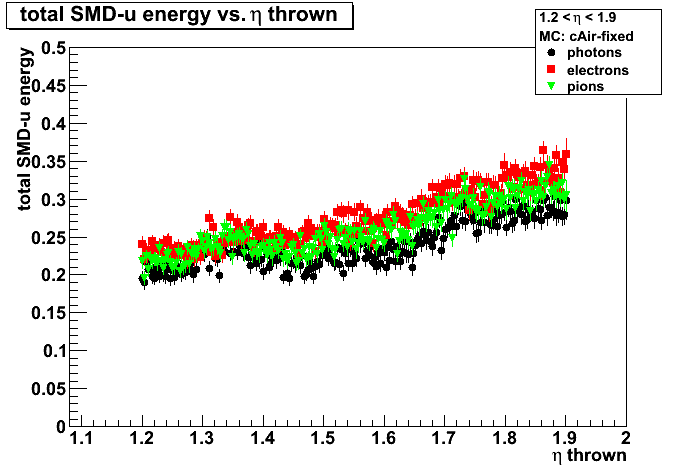
Number of SMD strips fired
2009.08.25 Test of corrected EEMC geometry: shower shapes
Test of corrected EEMC geometry (bug 1618)
Monte-Carlo setup is desribed here
- One particle per event (photons, electrons, and pions)
- Full STAR 2006 geometry.
In Kumac file: detp geom y2006g; gexec $STAR_LIB/geometry.so - Flat in eta (1.08-2.0), phi (0,2pi), and pt (3-30 GeV)
- Using A2Emaker to get reconstructed Tower/SMD energy (no EEMC SlowSimulator in chain)
what assumes fixed sampling fraction of 0.05 (5%) - Vertex z=0
- ~50K/per particle type
- Non-zero energy: 3 sigma above pedestal
Figure 1:Single photon shower shape before (red) and after (black) EEMC cAir bug fixed
pt=7-8GeV, eta=1.2-1.4 (left), eta=1.6-1.8 (right)
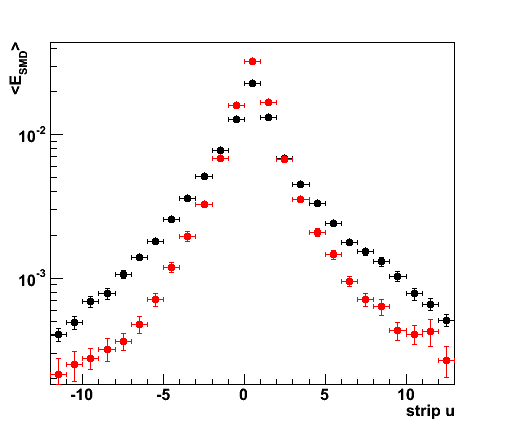
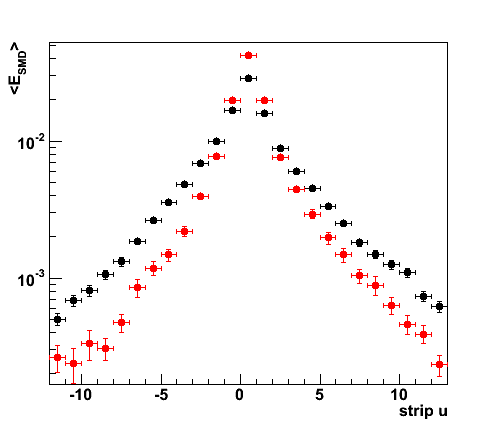
Figure 2: Single photon shower shape vs. data
Monte-Carlo: pt=7-10GeV, eta=1.6-1.8
data: no pre-shower1,2; pt_photon>7, pt_jet>5. no eta cuts.
(see Fig. 1 from here for other pre-shower conditions)
2009.08.27 fixed EEMC geometry: pre-shower sorted shower shapes & eta-meson comparison
Test of corrected EEMC geometry: shower shapes (bug 1618)
Monte-Carlo setup is desribed here
- One particle per event (photons, electrons, and pions)
- Full STAR 2006 geometry.
In Kumac file: detp geom y2006g; gexec $STAR_LIB/geometry.so - Flat in eta (1.08-2.0), phi (0,2pi), and pt (3-30 GeV)
- Using A2Emaker to get reconstructed Tower/SMD energy (no EEMC SlowSimulator in chain)
what assumes fixed sampling fraction of 0.05 (5%) - Vertex z=0
- ~50K/per particle type
- Non-zero energy: 3 sigma above pedestal
Color coding:
- Black - photon (single particle/event MC)
- Red - electron (single particle/event MC)
- Green - neutral pion (single particle/event MC)
- Blue - photons from eta-meson decay (real data)
Single particle shower shape before (left) and after (right) EEMC cAir bug fixed
Single particle kinematic cuts: pt=7-8GeV, eta=1.2-1.4
Eta-meson shower shapes (blue) taken from Fig. 1 from here of this post
All shapes are normalized to 1 at peak (central strip).
Figure 1: Pre-shower bin 0: E_pre1=0; E_pre2=0
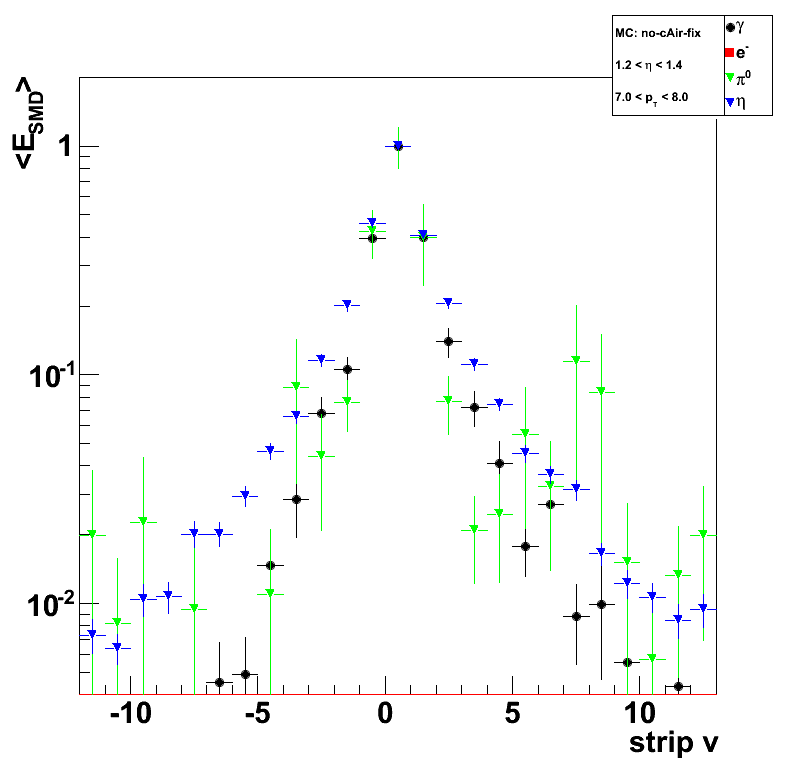
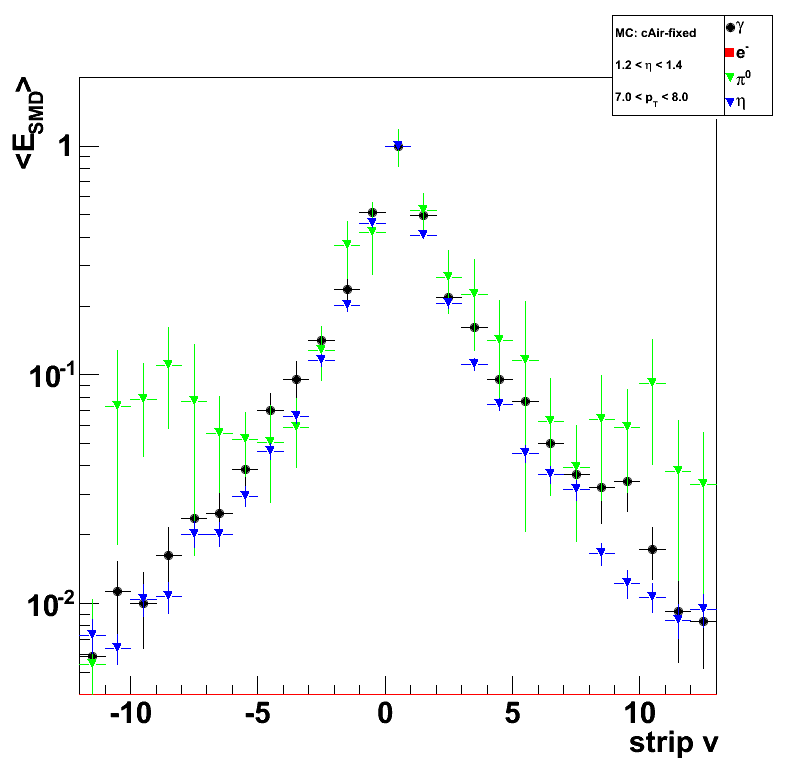
Figure 2: Pre-shower bin 1: E_pre1=0; E_pre2>0
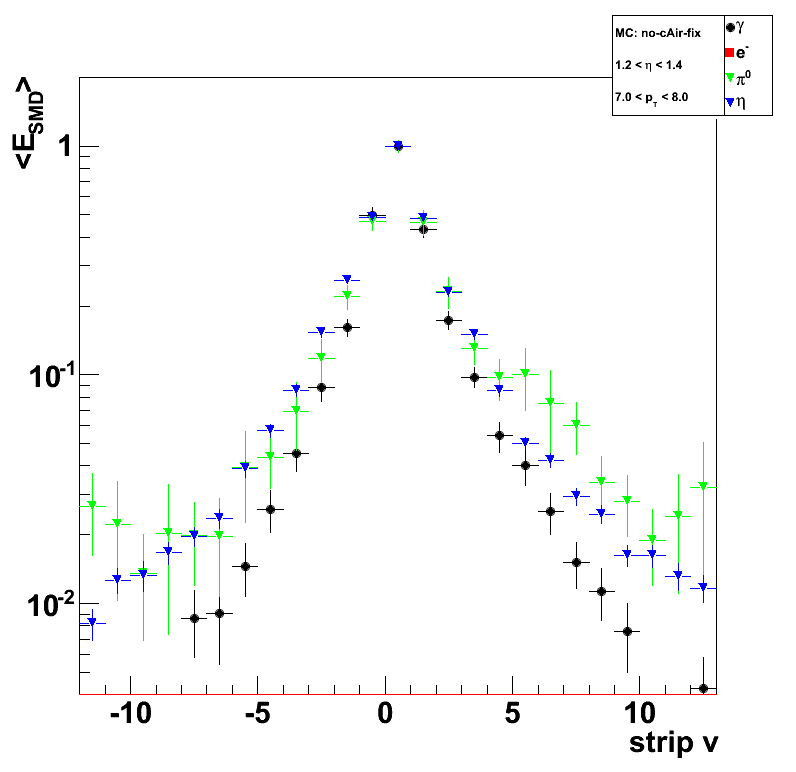
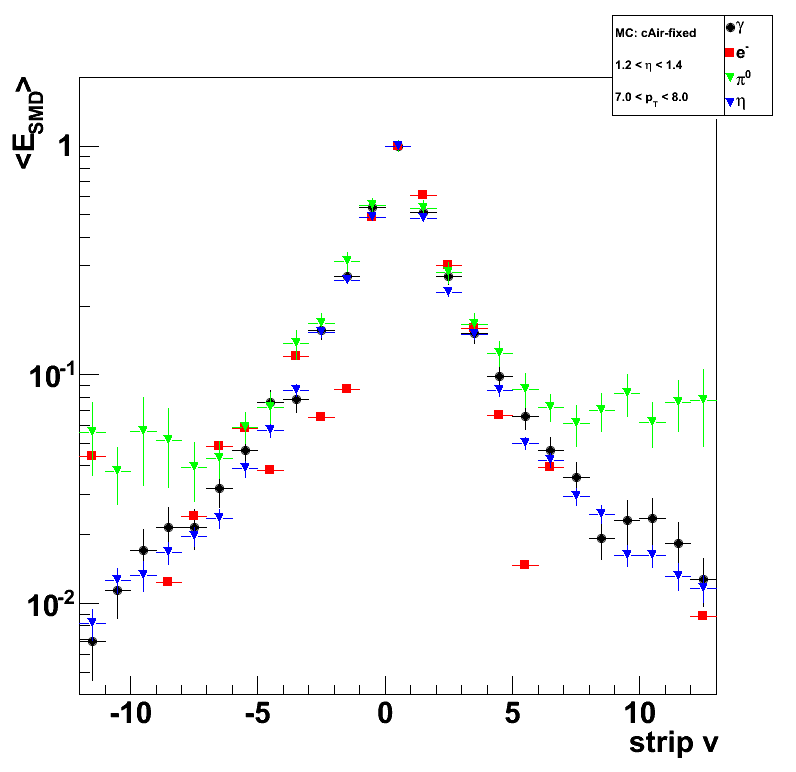
Figure 3: Pre-shower bin 2: E_pre1>0; E_pre1<0.004
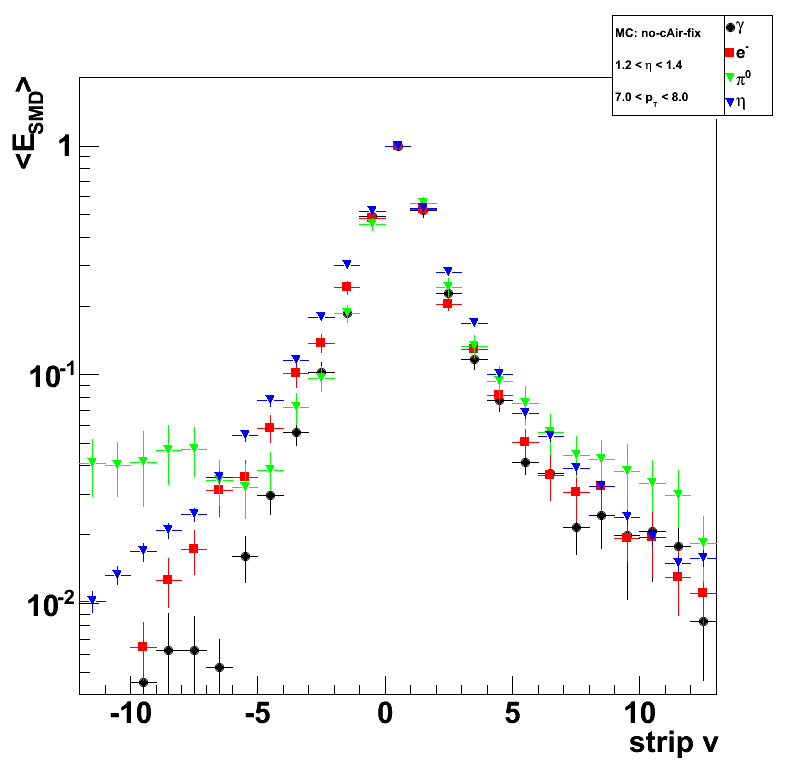
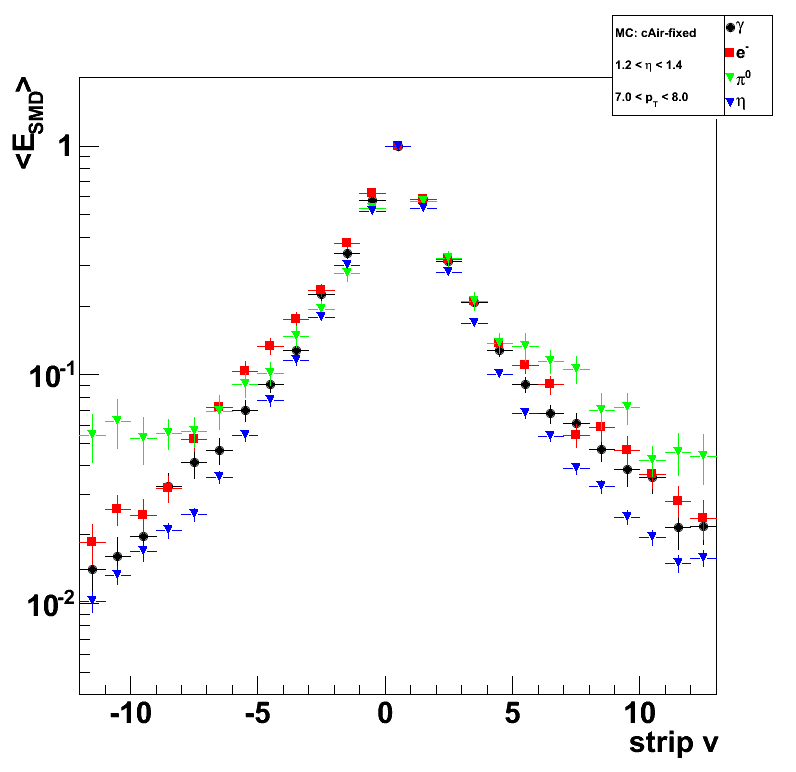
Figure 4: Pre-shower bin 3: E_pre1>0.004; E_pre1<0.01
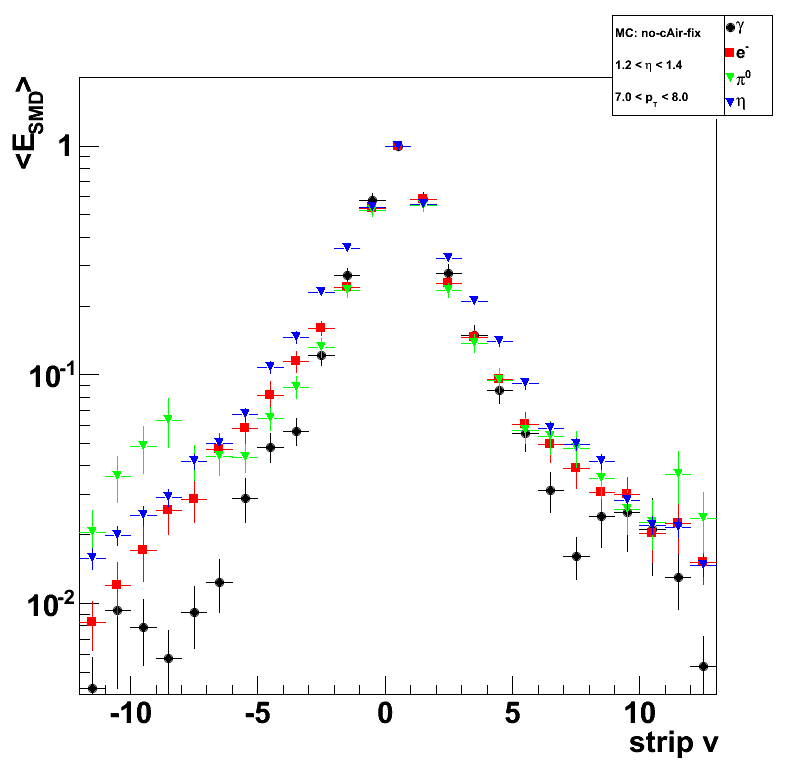
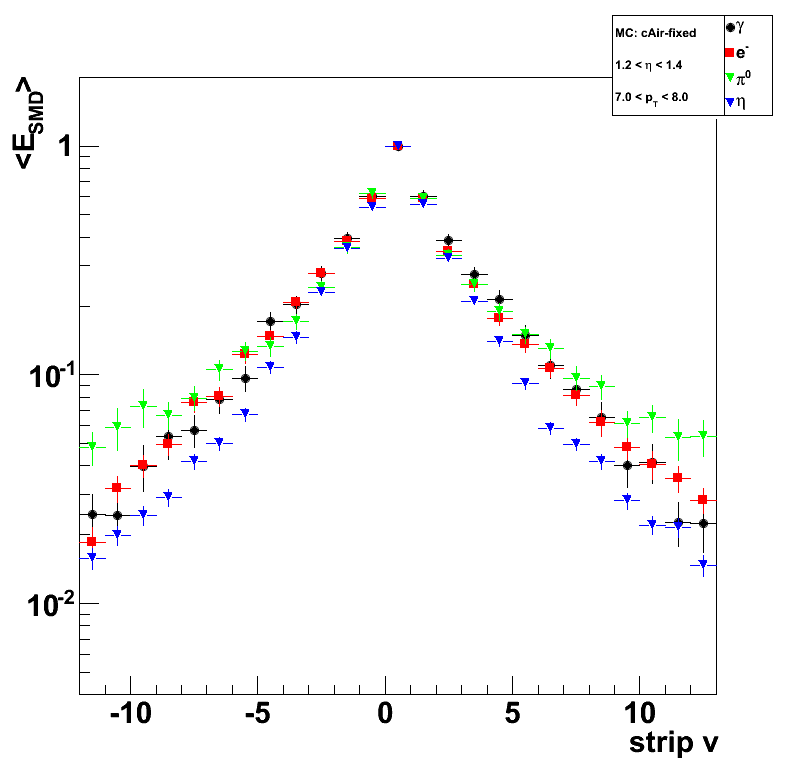
Shower shape ratios
Results only for corrected EEMC geometry
All shapes are divided by MC single-photon shower shape.
Figure 5a: Pre-shower bin 0: E_pre1=0; E_pre2=0
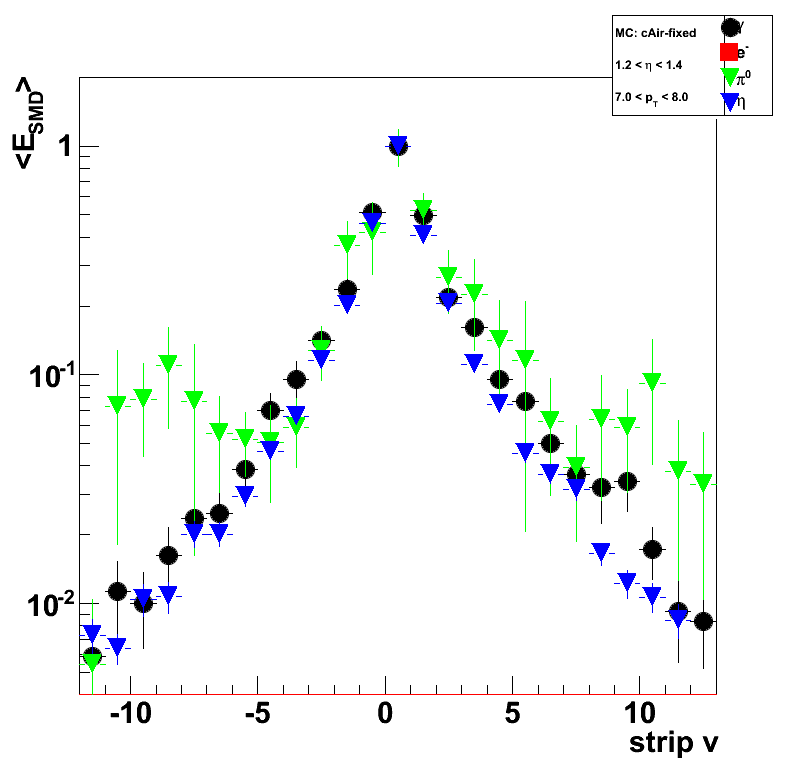
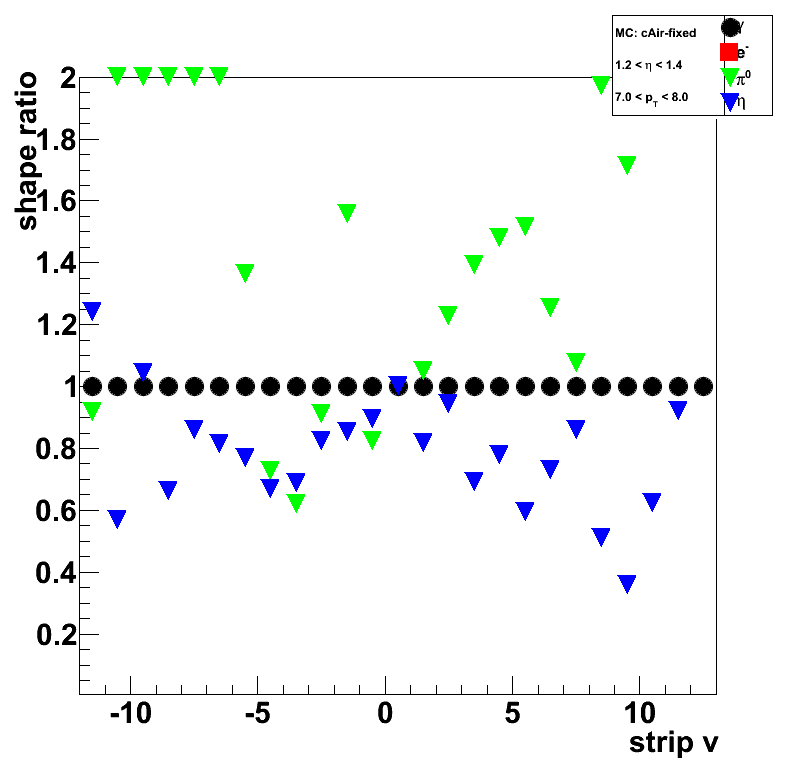
Figure 5b: Pre-shower bin 1: E_pre1=0; E_pre2>0
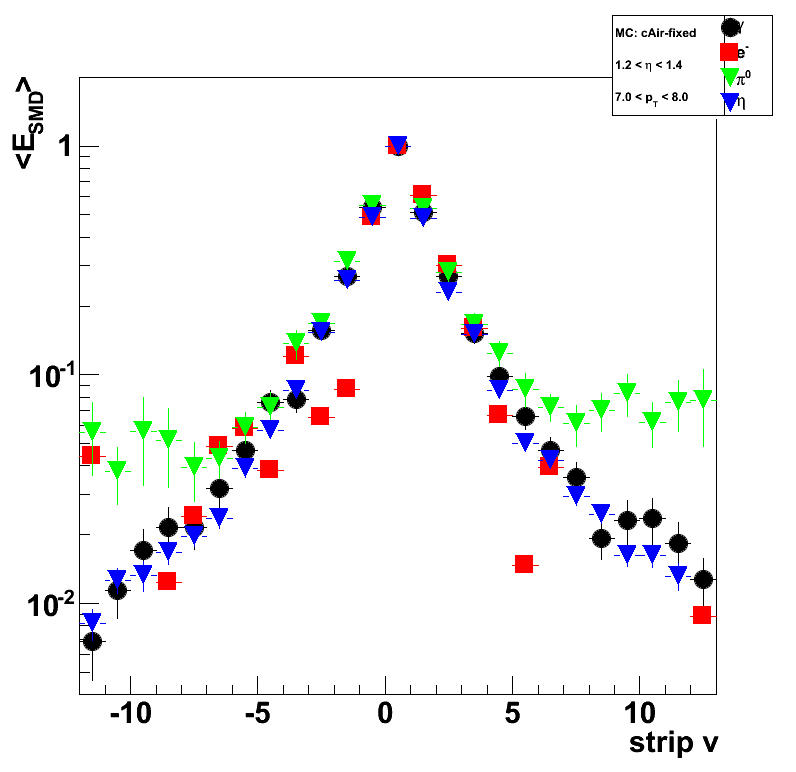
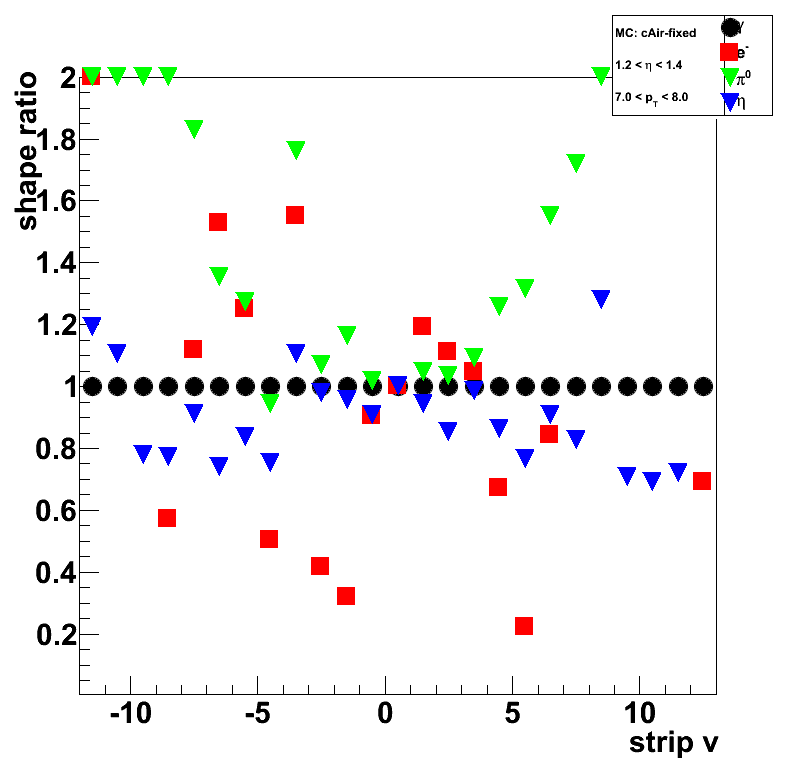
Figure 5c: Pre-shower bin 2: E_pre1>0; E_pre1<0.004
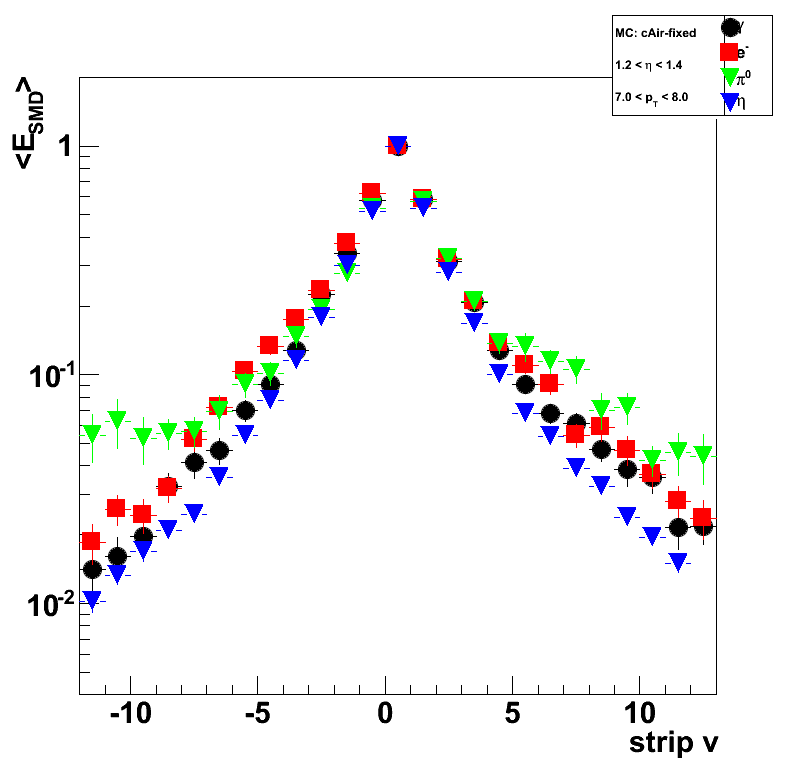
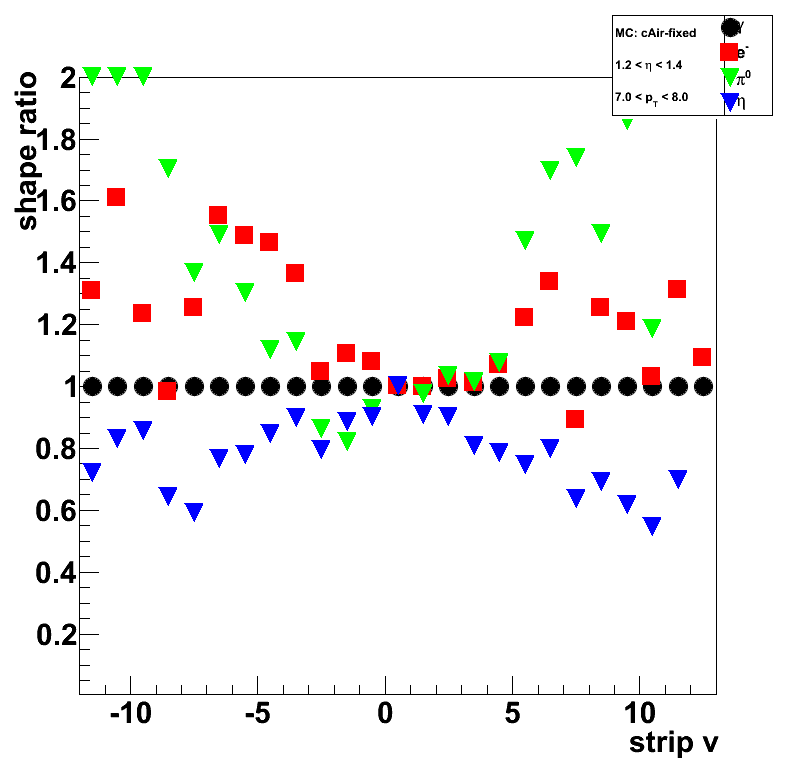
Figure 5d: Pre-shower bin 3: E_pre1>0.004; E_pre1<0.01
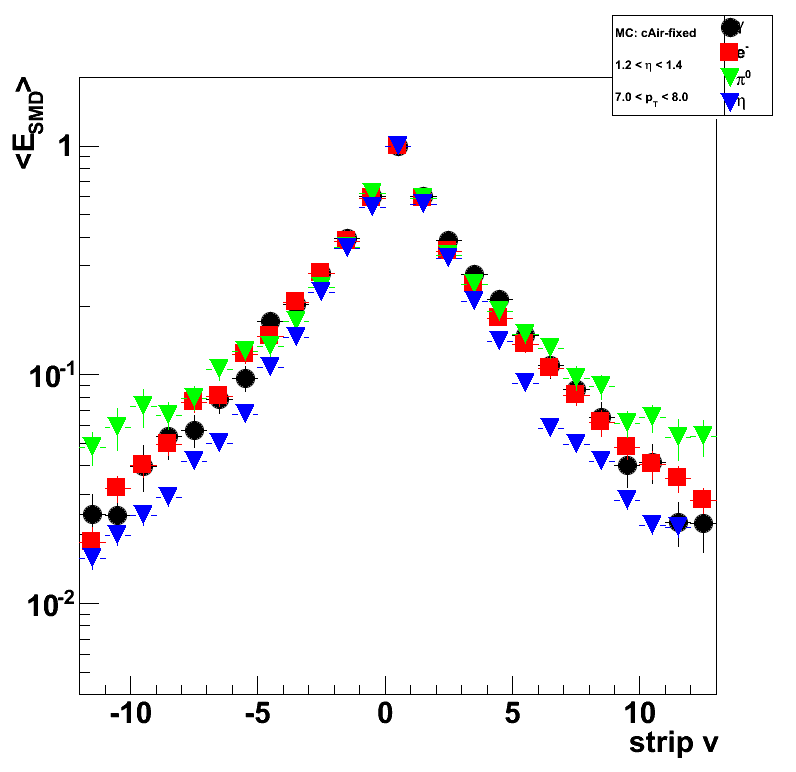
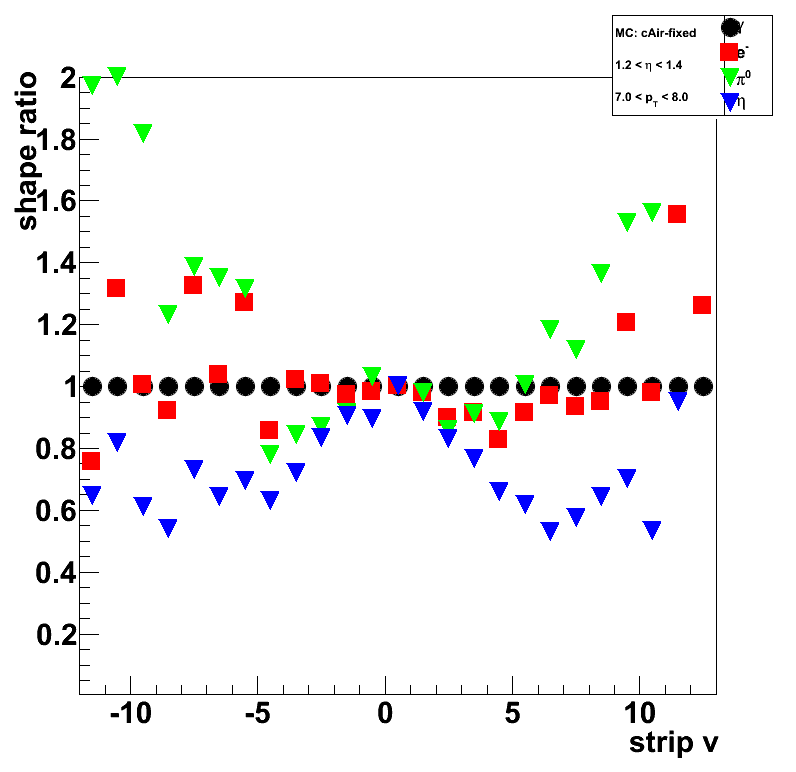
Figure 6: Single photon to eta-meson shape ratios only (with error bars):
Pre-shower bins 0 (upper-left),1 (upper-right),2 (lower-left), and 3 (lower-right)




Extracting gamma-jet cross section at forward rapidity from pp@200GeV collisions
Analysis overview
- Data samples, event selection, luminosity determination
- Isolating photon-jet events
- Transverse shower shape analysis
- Isolation cuts
- Cut optimization
- Trigger effects study
- Data to Monte-Carlo comparison/normalization and raw yields
- Acceptance/efficiency corrections
- Corrected yields
- Background subtraction
- Systematic uncertainties
- Comparison with theory
Data samples, event selection, luminosity determination
Real data, and signal/background Monte-Carlo samples:
-
pp@200GeV collisions, STAR produnctionLong.
Trigger: eemc-http-mb-L2gamma [id:137641] (L ~ 3.164 pb^1) -
Pythia prompt photon (signal) Monte-Carlo sample.
Filtered Prompt Photon p6410EemcGammaFilter.
Partonic pt range 2-25 GeV. -
Pythia 2->2 hard QCD processes (background) Monte-Carlo sample.
Filtered QCD p6410EemcGammaFilter.
Partonic pt range 2-25 GeV.
Isolating photon-jet events
- Shower shape analysis
- Isolation cuts
- Energy clustering (2x1 vs. 2x2 vs. 3x3, cluster energy vs. rapidity)
- Charge particle veto
- photon and jet pt balance
- Tower multiplicity
- Cut optimization with LDA.
Input variables (list can be expanded):- Energy fraction in 3x3 cluster within a r=0.7 radius, E_3x3/E_0.7
- Photon-jet pt balance, [pt_gamma-pt_jet]/pt_gamma
- Number of charge tracks within r=0.7 around gamma candidate
- Number of Endcap towers fired within r=0.7 around gamma candidate
- Number of Barrel towers fired within r=0.7 around gamma candidate
- Shower shape analysis: distance to 80% cut line
- Energy fraction in E_2x1 and E_2x2 witin E_3x3
- Energy in post-shower layer under 3x3 tower patch
- Tower energy in 3x3 patch
- SMD-u/v energy in 25 central strips
- SMD-u/v peak energy (in 5 central strips)
Trigger effects study
No studies yet
- Trigger effects vs pt
- Trigger effects vs eta
- What else?
Data to Monte-Carlo comparison/normalization and raw yields
- Overall data to MC normalization based on vertex z distribution
- Data to MC comparison of raw yield in various detector subsystems
- Uncorrected yields optimized with different efficiency/purity
Acceptance/efficiency corrections
No studies yet
- What needs to be studied for acceptance/efficiency effects?
- Converting reconstructed photon (jet) energy/momentum to the true one
- Reconstruction efficiency vs. rapidity, pt, etc
Corrected yields
No studies yet
- Produce acceptance/efficiency corrected yields
Background subtraction
No studies yet
- Statistical background subtraction based on Pythia+GEANT Monte-Carlo
- Estimate systematic uncertainties due to background subtraction
Systematic uncertainties
No studies yet
- Calorimeter energy resolution
- Trigger bias
- Other effects
Comparison with theory
No comparison yet
- Request for pQCD calculations at forward rapidity
09 Sep
September 2009 posts
2009.09.04 Test of corrected EEMC geometry: SVT, slow-simulator on/off, pre-shower migration
Test of corrected EEMC geometry: shower shapes (bug 1618)
Monte-Carlo setup:
- One particle per event (photons, electrons, pions, and eta-meson)
- Full STAR 2006 geometry (with/without SVT)
In Kumac file: detp geom y2006g; gexec $STAR_LIB/geometry.so (remove SVT with SVTT_OFF option) - Throw particles flat in eta (1.08, 2.0), phi (0, 2pi), and pt (6-10 GeV)
- Using A2Emaker to get reconstructed Tower/SMD energy
(with/without EEMC SlowSimulator in chain) - Vertex z=0
- ~50K/per particle type
- Non-zero energy: 3 sigma above pedestal
Color coding:
- Photon (single particle MC)
- Electron (single particle MC)
- Neutral pion (single particle MC)
- Eta-meson (single particle MC)
- Eta-meson [pp2006 data] (single photons from eta-meson decay)
Pre-shower bins:
- Ep1 = 0, Ep2 = 0 (no energy in both EEMC pre-shower layers)
- Ep1 = 0, Ep2 > 0
- 0 < Ep1 < 4 MeV
- 4 < Ep1 < 10 MeV
- Ep1 > 10 MeV
- All pre-shower bins combined
Ep1/Ep2 is the energy deposited in the 1st/2nd EEMC pre-shower layer.
For a single particle MC it is a sum over
all pre-shower tiles in the EEMC with energy of 3 sigma above pedestal.
For eta-meson from pp2006 data the sum is over 3x3 tower patch
Shower shapes
Single particle kinematic cuts: pt=7-8GeV, eta=1.2-1.4
Eta-meson shower shapes (blue) taken from Fig. 1 from here of this post
All shapes are normalized to 1 at peak (central strip)
Figure 1: Shower shape sorted by pre-shower conditions.
cAir-Fixed EEMC geometry (NO slow simulator, WITH SVT)
Ratio plot
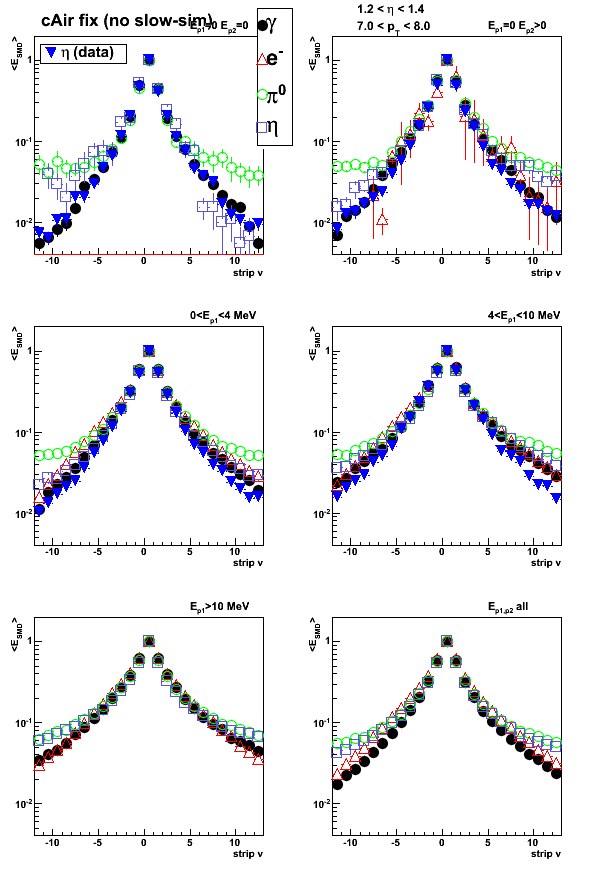
Figure 2: Shower shape sorted by pre-shower conditions.
cAir-Fixed EEMC geometry (NO slow simulator, NO SVT)
Ratio plot
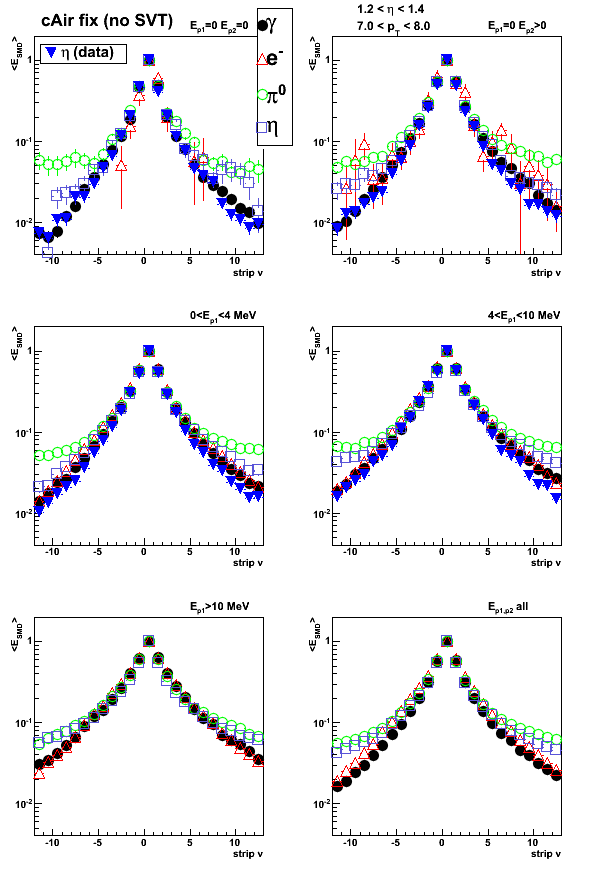
Figure 3: Shower shape sorted by pre-shower conditions.
cAir-Fixed EEMC geometry (WITH slow simulator, WITH SVT)
Ratio plot
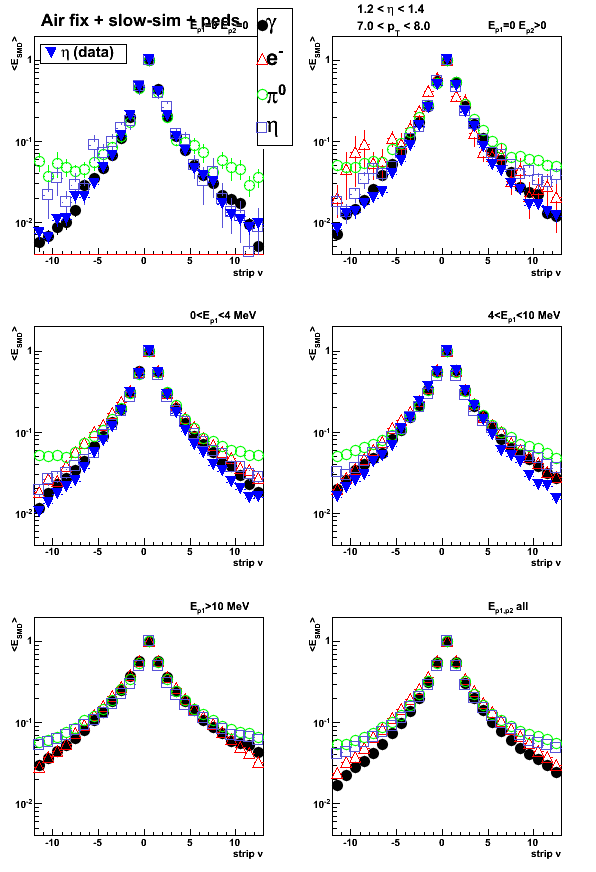
Figure 4: Shower shape sorted by pre-shower conditions.
Old cAir-bug EEMC geometry (NO slow simulator, WITH SVT)
Click here to see the plot
Pre-shower migration with/without SVT
Starting with a fixed (50K events) for each type of particle.
Change in number of counts for a given pre-shower bin
with different detector configuration shows pre-shower migration
Figure 5: Pre-shower migration.
cAir-Fixed EEMC geometry (WITH SVT)
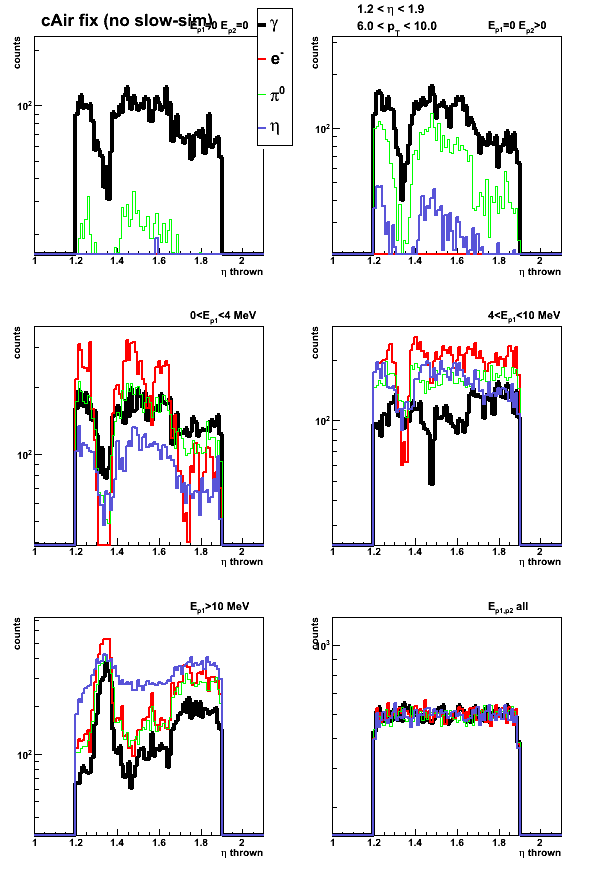
Figure 6: Pre-shower migration.
cAir-Fixed EEMC geometry (WITHOUT SVT)
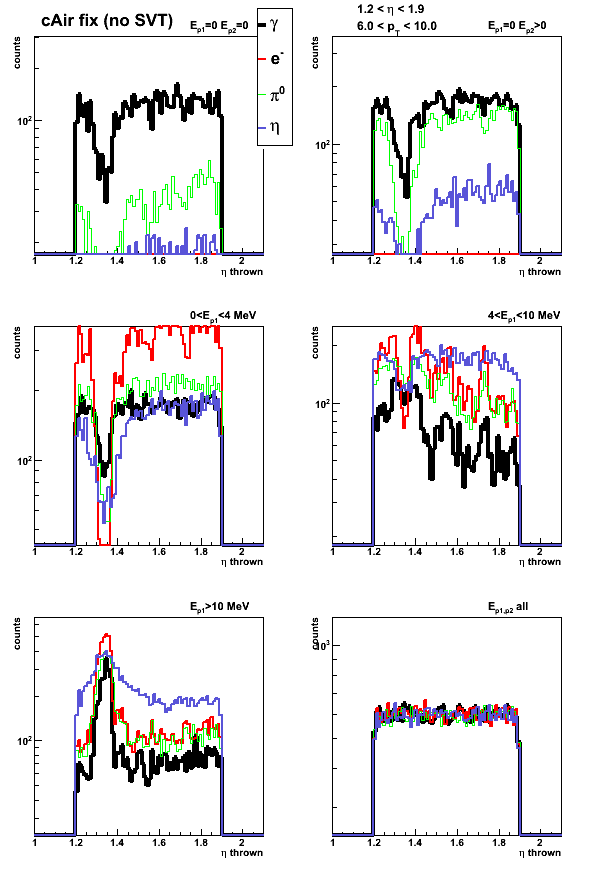
Sampling fraction with/without Slow-simulator
Figure 7: Sampling fraction (0.05 E_reco / E_thrown).
cAir-Fixed EEMC geometry (WITHOUT Slow-simulator)
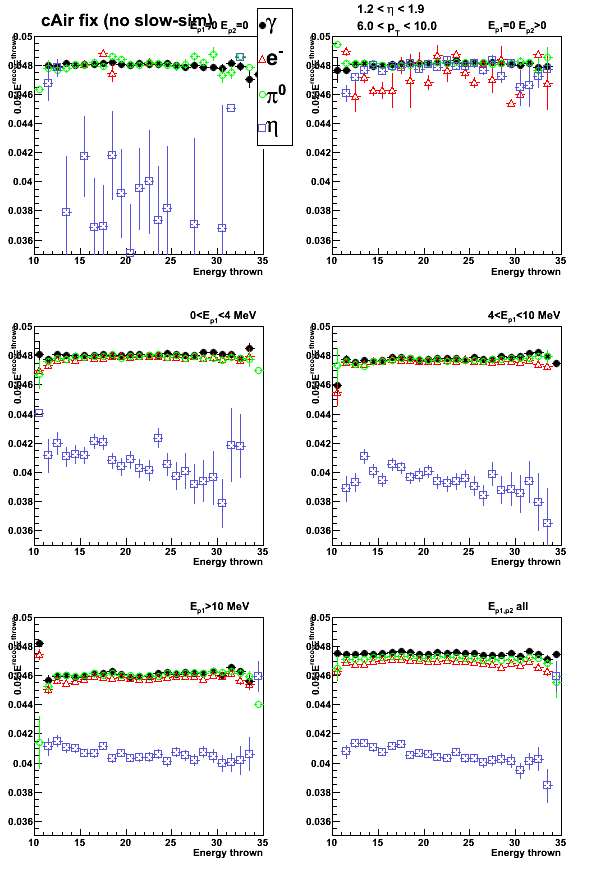
Figure 8: Sampling fraction (0.05 E_reco / E_thrown).
cAir-Fixed EEMC geometry (WITH Slow-simulator)
Slow simulator introduce some non-linearity in the sampling fraction
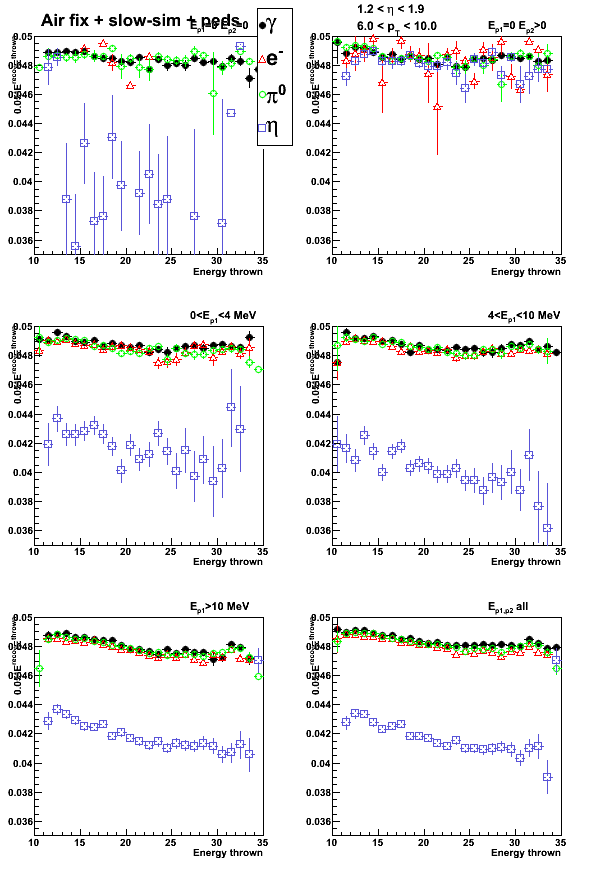
Figure 9: Sampling fraction (0.05 E_reco / E_thrown).
cAir-Fixed EEMC geometry (WITHOUT SVT, WITHOUT Slow-simulator)
Click here to see the plot
Figure 10: Sampling fraction (0.05 E_reco / E_thrown).
Old cAir-bug EEMC geometry (NO slow simulator, WITH SVT)
Click here to see the plot
2009.09.11 Test of corrected EEMC geometry: LOW_EM cuts
Test of corrected EEMC geometry: SVT and LOW_EM cuts
Monte-Carlo setup:
- One particle per event (only photons in this post)
- Full STAR 2006 geometry (with/without SVT, LOW_EM cuts)
In Kumac file: detp geom y2006g; gexec $STAR_LIB/geometry.so (vary SVTT_OFF, LOW_EM)
LOW_EM cut definition is given at the end of this page - Throw particles flat in eta (1.2, 1.9), phi (0, 2pi), and pt (6-10 GeV)
- Using A2Emaker to get reconstructed Tower/SMD energy
(this post: no EEMC SlowSimulator) - Vertex z=0
- ~50K/per iteration
- Non-zero energy: 3 sigma above pedestal
Color coding:
- SVT, LOW_EM marked in legend as LowEM (single photon MC)
- STV, no-LOW_EM marked in legend as default (single photon MC)
- no-SVT, no-LOW_EM marked in legend as no-SVT (single photon MC)
- photon-jet candidates [pp2006] (used data points from this post)
- photons from eta-meson [pp2006]
Pre-shower bins:
- Ep1 = Ep2 = 0 (no energy in both EEMC pre-shower layers)
- Ep1 = 0, Ep2 > 0
- 0 < Ep1 < 4 MeV
- 4 < Ep1 < 10 MeV
- Ep1 > 10 MeV
- All pre-shower bins combined
Note: Ep1/Ep2 is the energy deposited in the 1st/2nd EEMC pre-shower layer.
For a single photon MC it is a sum over
all pre-shower tiles in the EEMC with energy of 3 sigma above pedestal.
For eta-meson/gamma-jet candidates from pp2006 data the sum is over 3x3 tower patch
Shower shapes
Single particle kinematic cuts: pt=7-8GeV, eta=1.2-1.4
Eta-meson shower shapes (blue) taken from Fig. 1 from here of this post
All shapes are normalized to 1 at peak (central strip)
Figure 1: Shower shape sorted by pre-shower conditions.
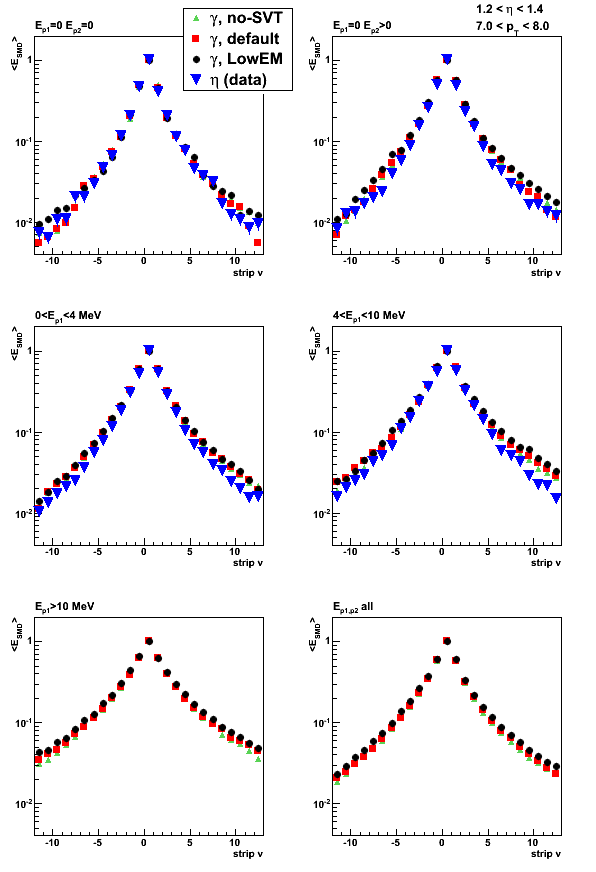
Figure 2: Shower shape ratio. All shapes in Fig. 1 are divided by single photon shape
for "SVT+LOW_EM" configuration (black circles in Fig. 1)
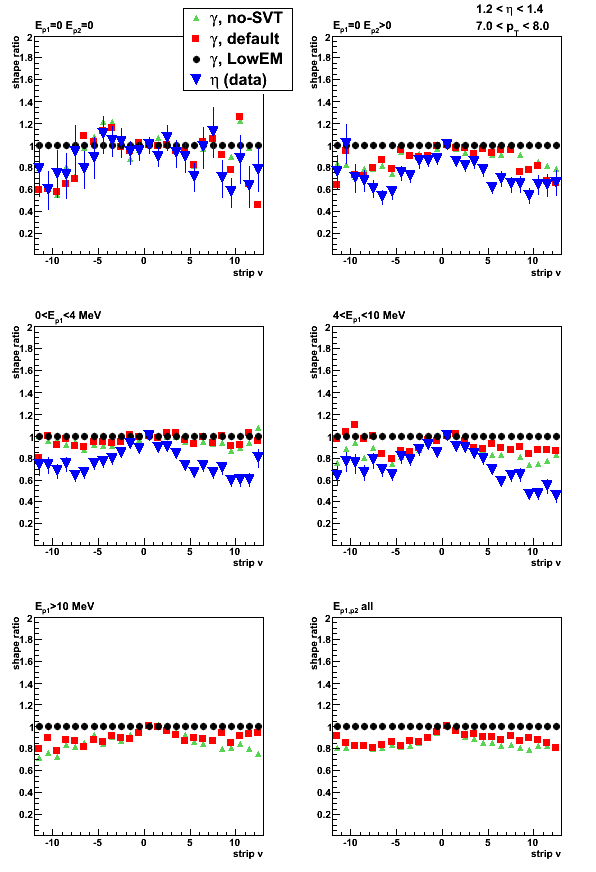
Sampling fraction
Figure 3: Sampling fraction (0.05 * E_reco/ E_thrown)
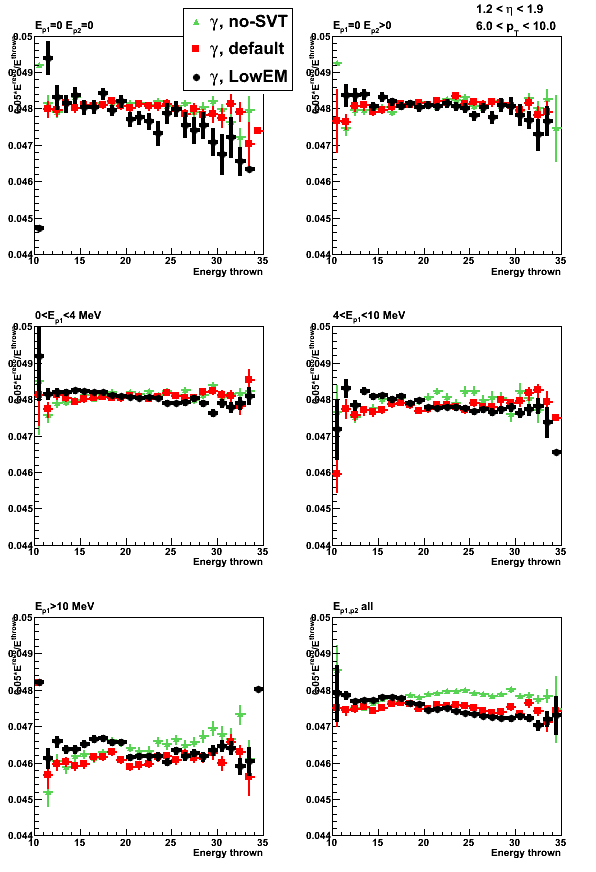
Pre/post-shower energy and migration
Figure 4: Pre-shower1 energy (all tiles)
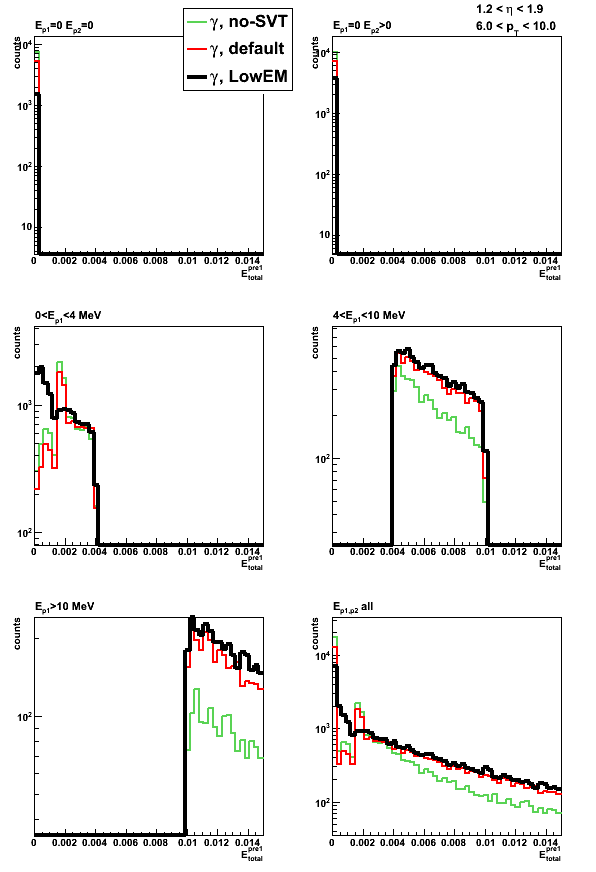
Figure 5: Pre-shower2 energy (all tiles)
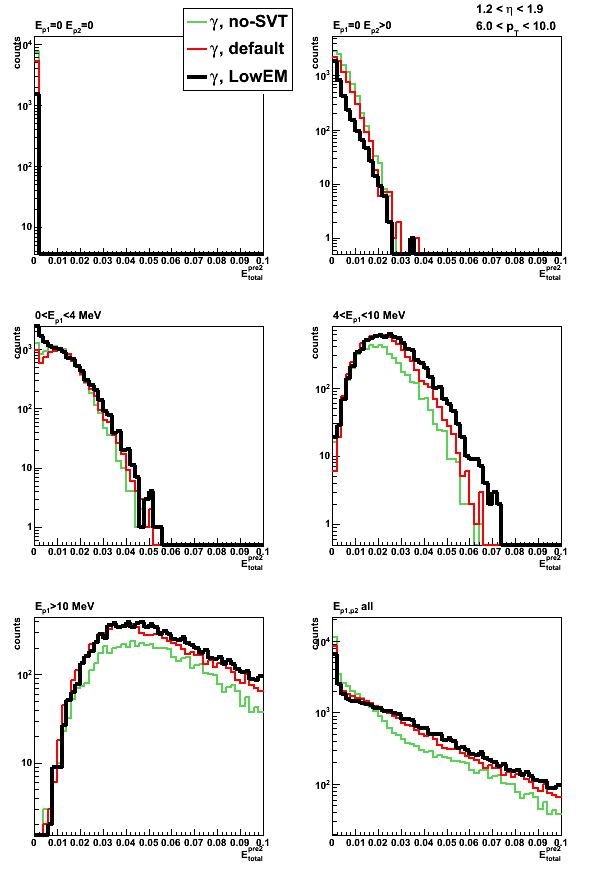
Figure 6: Post-shower energy (all tiles)
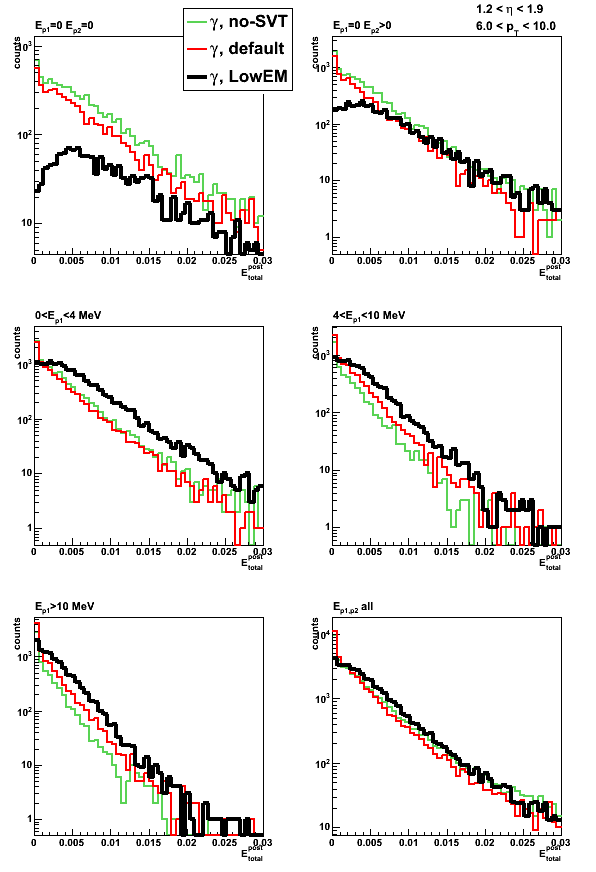
Figure 7: Pre-shower bin photon migration
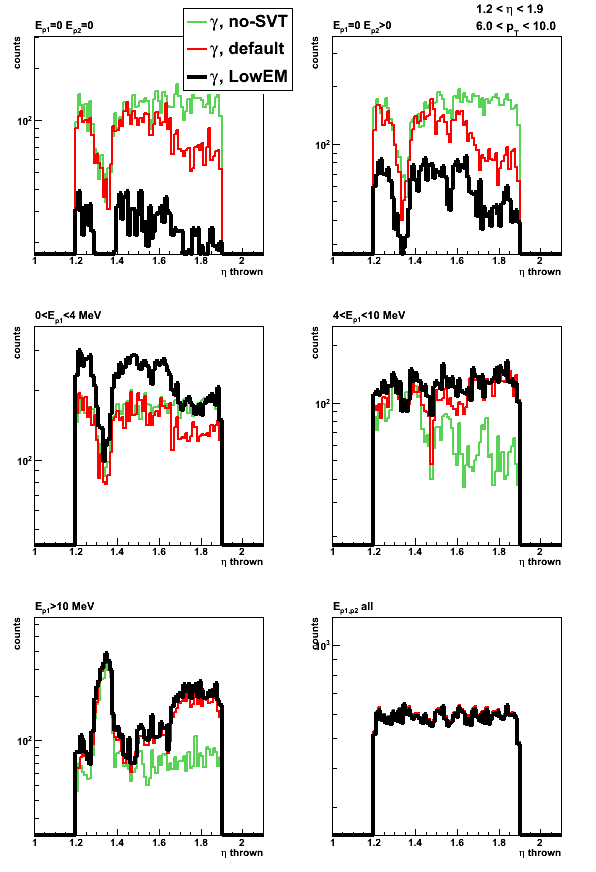
Tower energy profile
Figure 8a: Energy ratio in 2x1 to 3x3 cluster
For the first 4 pre-shower bins total yield in MC is normalized to that of the data
Blue circles indicate photon-jet candidates [pp2006] (points from this post)
Same data on a linear scale
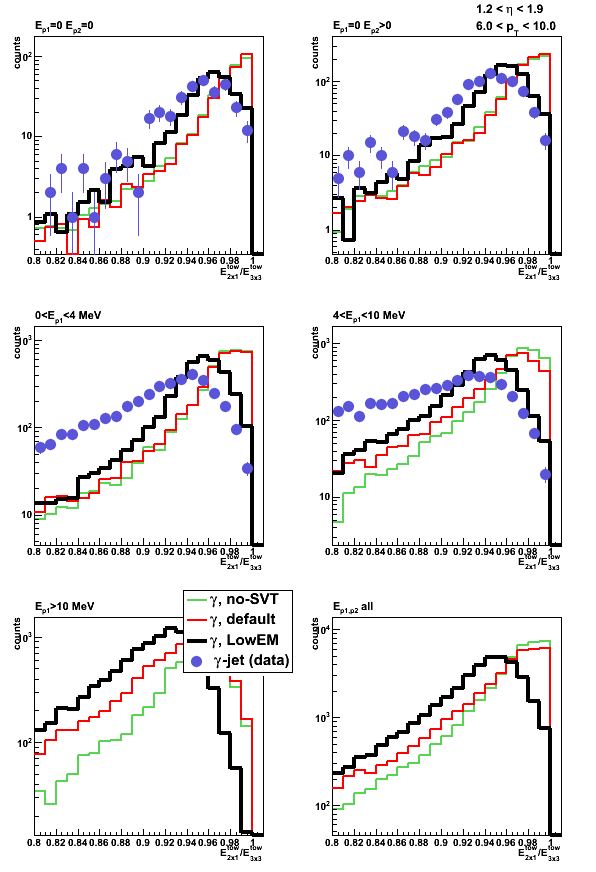
Figure 8b: Energy ratio in 2x1 to 3x3 cluster: 7 < pt < 8 and 1.2 < eta < 1.4
Figure 8c: Energy ratio in 2x1 to 3x3 cluster: 7 < pt < 8 and 1.6 < eta < 1.8
Figure 9: Average energy ratio in 2x1 to 3x3 cluster vs. thrown energy
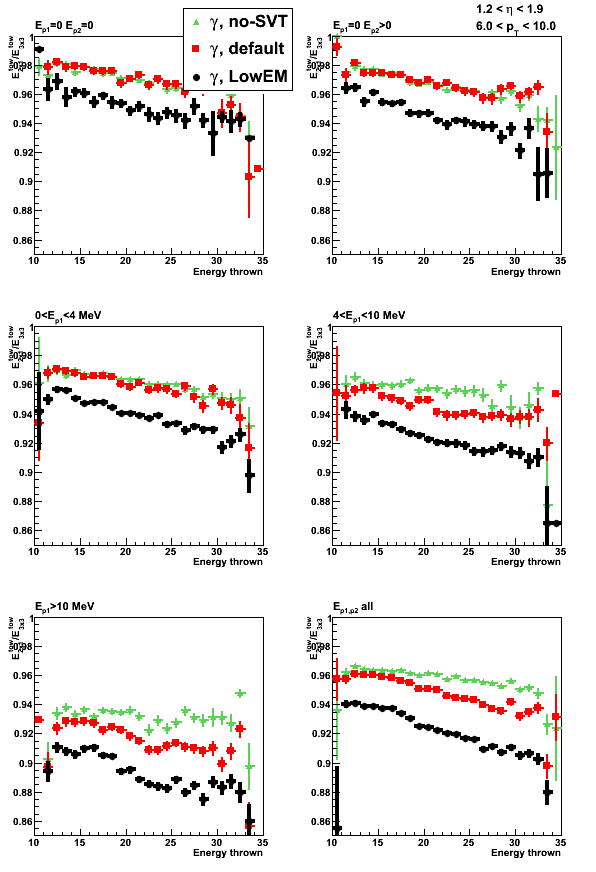
Figure 10: Average energy ratio in 2x1 to 3x3 cluster vs. thrown energy
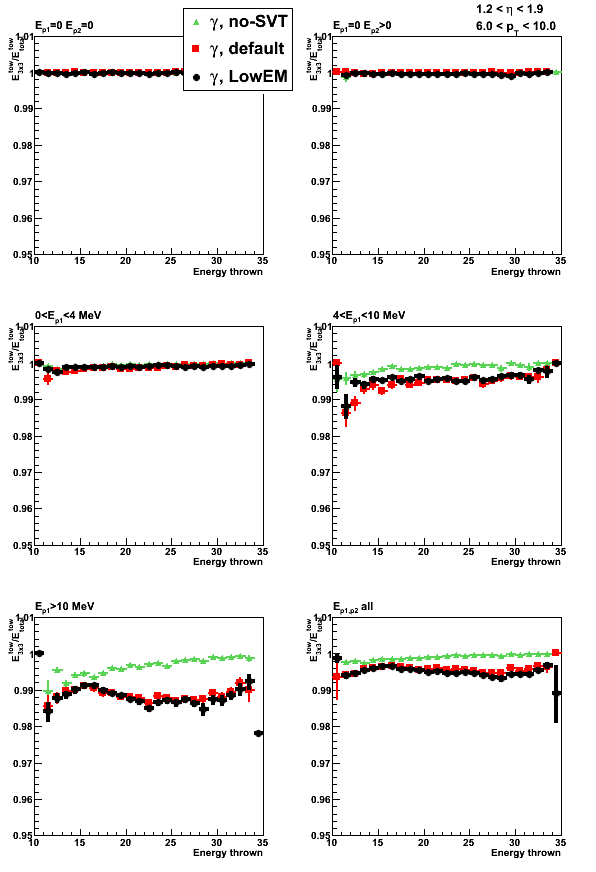
LOW_EM cut definition
LOW_EM option for the STAR geometry (Low cuts on Electro-Magnetic processes)
is equivalent to the following set of GEANT cuts:
- CUTGAM=0.00001
- CUTELE=0.00001
- BCUTE =0.00001
- BCUTM =0.00001
- DCUTE =0.00001
- DCUTM =0.00001
All these values are for kinetic energy in GeV.
Cut meaning and GEANT default values:
- CUTGAM threshold for gamma transport (0.001);
- CUTELE threshold for electron and positron transport (0.001);
- BCUTE threshold for photons produced by electron bremsstrahlung (-1,);
- BCUTM threshold for photons produced by muon bremsstrahlung (-1);
- DCUTE threshold for electrons produced by electron delta-rays (-1);
- DCUTM threshold for electrons produced by muon or hadron delta-rays (-1);
Some details can be found at this link and in the GEANT manual
10 Oct
October 2009 posts
2009.10.02 Jason vs. CVS EEMC geometry: sampling fraction and shower shapes

Tests with Jason geometry file (ecalgeo.g23)
Monte-Carlo setup:
- One photon per event
- EEMC only geometry with LOW_EM option
- Throw particles flat in eta (1.08, 2.0), phi (0, 2pi), and pt (6-10 GeV)
- Using A2Emaker to get reconstructed Tower/SMD energy
(no EEMC SlowSimulator in chain) - Vertex z=0
- ~50K/per particle type
- Non-zero energy: 3 sigma above pedestal
Color coding:
- Photon with Jason geometry (single particle MC)
- Photon with CVS (cAir fix) geometry (single particle MC)
- Eta-meson [pp2006 data] (single photons from eta-meson decay)
Sampling fraction
Figure 1: Sampling fraction vs. thrown energy (upper plot)
and vs. azimuthal angle (lower left) and rapidity (lower right)

Shower shapes
Single particle kinematic cuts: pt=7-8GeV, eta=1.2-1.4
Eta-meson shower shapes (blue) taken from Fig. 1 from here of this post
All shapes are normalized to 1 at peak (central strip)
Shower shapes sorted by pre-shower energy
Pre-shower bins:
- Ep1 = 0, Ep2 = 0 (no energy in both EEMC pre-shower layers)
- Ep1 = 0, Ep2 > 0
- 0 < Ep1 < 4 MeV
- 4 < Ep1 < 10 MeV
- Ep1 > 10 MeV
- All pre-shower bins combined
Ep1/Ep2 is the energy deposited in the 1st/2nd EEMC pre-shower layer.
For a single particle MC it is a sum over
all pre-shower tiles in the EEMC with energy of 3 sigma above pedestal.
For eta-meson from pp2006 data the sum is over 3x3 tower patch
2009.10.05 Fix to the Jason geometry file
Why volume numbers has changed in Jason geometry file?
The number of nested volumes (nv),
is the total number of parent volumes for the sensitive volume
(sensitive volume is indicated by the HITS in the tree structure below).
For the Jason and CVS files this nv number seems to be the same
(see block tree structures below).
Then why volume ids id in g2t tables has changed?
The answer I found (which seems trivial to me know)
is that in the original (CVS) file ECAL
block has been instantiated (positioned) twice.
The second appearance is the prototype (East) version of the Endcap
(Original ecalgeo.g from CVS)
if (emcg_OnOff==1 | emcg_OnOff==3) then Position ECAL in CAVE z=+center endif if (emcg_OnOff==2 | emcg_OnOff==3) then Position ECAL in CAVE z=-center ThetaZ=180 endif
In Jason version the second appearance has been removed
(what seems natural and it should not have any effect)
(ecalgeo.g Jason edits, g23):
IF (emcg_OnOff>0) THEN Create ECAL ..... IF (emcg_OnOff==2 ) THEN Prin1 ('East Endcap has been removed from the geometry' ) ENDIF EndIF! emcg_OnOff
Unfortunately, this affects the way GEANT counts nested volumes
(effectively the total number was reduced by 1, from 8 to 7)
and this is the reason why the volume numbering scheme
in g2t tables has been affected.
I propose to put back these East Endcap line back,
since in this case it will not require any additional
changes to the EEMC decoder and g2t tables.
Block tree of the geometry file
blue - added volumes in Jason file
red - G10 volume removed in Jason file
HITS - sensitive volumes
---- Jason file ----
ECAL
EAGA
|EMSS
| -EFLP
| |ECVO
| | |EMOD
| | | |ESEC
| | | | |ERAD
| | | | | -ELED
| | | | |EMGT
| | | | | |EPER
| | | | | | |ETAR
| | | | | | | -EALP
| | | | | | | -ESCI -> HITS
| |ESHM
| | |ESPL
| | | |EXSG
| | | | -EXPS
| | | | -EHMS -> HITS
| | | | -EBLS
| | | | -EFLS
| | |ERSM
| -ESSP
| -ERCM
| -EPSB
|ECGH
| -ECHC
---- CVS file ----
ECAL
EAGA
|EMSS
| -EFLP
| |ECVO
| | |EMOD
| | | |ESEC
| | | | |ERAD
| | | | | -ELED
| | | | |EMGT
| | | | | |EPER
| | | | | | |ETAR
| | | | | | | -EALP
| | | | | | | -ESCI -> HITS
| |ESHM
| | |ESPL
| | | |EXSG
| | | | -EHMS -> HITS
| | | -EXGT
| | -ERSM
| -ESSP
| -ERCM
| -EPSB
|ECGH
| -ECHC
Block definitions
Jason geometry file
Create ECAL Block ECAL is one EMC EndCap wheel Create and Position EAGA AlphaZ=halfi EndBlock Block EAGA IS HALF OF WHEEL AIR VOLUME FORTHE ENDCAP MODULE Create AND Position EMSS konly='MANY' Create AND Position ECGH alphaz=90 kOnly='ONLY' EndBlock Block EMSS is the steel support of the endcap module Create AND Position EFLP z=zslice-center+zwidth/2 Create AND Position ECVO z=zslice-center+zwidth/2 Create AND Position ESHM z=zslice-center+zwidth/2 kOnly='MANY' Create AND Position ECVO z=zslice-center+zwidth/2 Create AND Position ESSP z=zslice-center+zwidth/2 Create ERCM Create EPSB EndBlock Block ECVO is one of endcap volume with megatiles and radiators Create AND Position EMOD alphaz=d3 ncopy=i_sector EndBlock Block ESHM is the shower maxsection Create and Position ESPL z=currentk Only='MANY' Create ERSM EndBlock Block ECGH is air gap between endcap half wheels Create ECHC EndBlock Block ECHC is steel endcap half cover EndBlock Block ESSP is stainless steelback plate EndBlock Block EPSB IS A PROJECTILE STAINLESS STEEL BAR EndBlock Block ERCM is stainless steel tie rod in calorimeter sections EndBlock Block ERSM is stainless steel tie rod in shower max EndBlock Block EMOD (fsect,lsect) IS ONE MODULEOF THE EM ENDCAP Create AND Position ESEC z=section-curr+secwid/2 EndBlock Block ESEC is a single em section Create AND Position ERAD z=length+(cell)/2+esec_deltaz Create AND Position EMGT z=length+(gap+cell)/2+esec_deltaz Create AND Position ERAD z=length+cell/2+esec_deltaz EndBlock Block EMGT is a 30 degree megatile Create AND Position EPER alphaz=myPhi EndBlock Block EPER is a 5 degree slice of a 30 degree megatile (subsector) Create and Position ETAR x=(rbot+rtop)/2ort=yzx EndBlock Block ETAR is a single calorimeter cell, containing scintillator, fiber router, etc... Create AND Position EALP y=(-megatile+emcs_alincell)/2 Create AND Position ESCI y=(-megatile+g10)/2+emcs_alincell _ EndBlock Block ESCI is the active scintillator (polystyrene) layer EndBlock Block ERAD is the lead radiator with stainless steel cladding Create AND Position ELED EndBlock Block ELED is a lead absorber plate EndBlock Block EFLP is the aluminum (aluminium) front plate of the endcap EndBlock Block EALP is the thin aluminium plate in calorimeter cell EndBlock Block ESPL is the logical volume containing an SMD plane Create and Position EXSG alphaz=d3 ncopy=isec kOnly='MANY' Create and Position EXSG alphaz=d3 ort=x-y-z ncopy=isec kOnly='MANY' Create and Position EXSG alphaz=d3 ncopy=isec kOnly='MANY' Create and Position EXSG alphaz=d3 ort=x-y-z ncopy=isec kOnly='MANY' Create and Position EXSG alphaz=d3 ncopy=isec kOnly='MANY' EndBlock Block EXSG Is another logical volume... this one acutally creates the planes Create and Position EXPS kONLY='MANY' Create and Position EHMS x=xc y=yc alphaz=-45 kOnly='ONLY' Create and Position EBLS x=xc y=yc z=(+esmd_apex/2+esmd_back_layer/2) alphaz=-45 kOnly='ONLY' Create and Position EHMS x=xc y=yc alphaz=-45 ort=x-y-z kOnly='ONLY' Create and Position EFLS x=xc y=yc z=(-esmd_apex/2-esmd_front_layer/2) alphaz=-45 ort=x-y-z kOnly='ONLY' EndBlock Block EHMS defines the triangular SMD strips Endblock! EHMS Block EFLS is the layer of material on the front of the SMD planes EndBlock! EFLS Block EBLS is the layer of material on the back of the SMD planes EndBlock! EFLS Block EXPS is the plastic spacer in the shower maximum section EndBlock
CVS geometry file
Create ECAL Block ECAL is one EMC EndCap wheel Create and Position EAGA AlphaZ=halfi EndBlock Block EAGA is half of wheel air volume forthe EndCap module Create and Position EMSS konly='MANY' Create and Position ECGH AlphaZ=90 konly='ONLY' EndBlock Block EMSS is steel support of the EndCap module Create and Position EFLP z=zslice-center+slcwid/2 Create and Position ECVO z=zslice-center+slcwid/2 Create and Position ESHM z=zslice-center+slcwid/2 Create and Position ECVO z=zslice-center+slcwid/2 Create and Position ESSP z=zslice-center+slcwid/2 Create ERCM Create EPSB EndBlock Block ECVO is one of EndCap Volume with megatiles and radiators Create and Position EMOD AlphaZ=d3 Ncopy=J_section EndBlock Block ESHM is the SHower Maxsection Create and Position ESPL z=current Create ERSM Endblock Block ECGH is air Gap between endcap Half wheels Create ECHC EndBlock Block ECHC is steel EndCap Half Cover EndBlock Block ESSP is Stainless Steelback Plate endblock Block EPSB is Projectile Stainless steel Bar endblock Block ERCM is stainless steel tie Rod in CaloriMeter sections endblock Block ERSM is stainless steel tie Rod in Shower Max endblock Block EMOD is one moduleof the EM EndCap Create and Position ESEC z=section-curr+secwid/2 endblock Block ESEC is a single EM section Create and Position ERAD z=len + (cell)/2 Create and Position EMGT z=len +(gap+cell)/2 Create and Position ERAD z=len + cell/2 Endblock Block EMGT is a megatile EM section Create and Position EPER AlphaZ=(emcs_Nslices/2-isec+0.5)*dphi Endblock Block EPER is a EM subsection period (super layer) Create and Position ETAR x=(RBot+RTop)/2ORT=YZX EndBlock Block ETAR is one CELL of scintillator, fiber and plastic Create and Position EALP y=(-mgt+emcs_AlinCell)/2 Create and Position ESCI y=(-mgt+G10)/2+emcs_AlinCell _ EndBlock Block ESCI is the active scintillator (polystyren) layer endblock Block ERAD is radiator Create and PositionELED endblock Block ELED is lead absorber Plate endblock Block EFLP is First Aluminium plate endblock Block EALP is ALuminiumPlate in calorimeter cell endblock Block ESPL is one of the Shower maxPLanes Create and position EXSG AlphaZ=d3Ncopy=isec Create and position EXSG AlphaZ=d3Ncopy=isec Create and position EXGT z=msecwd AlphaZ=d3 Create and position EXSG AlphaZ=d3 ORT=X-Y-Z Ncopy=isec Create and position EXGT z=-msecwd AlphaZ=d3 Create and position EXSG AlphaZ=d3Ncopy=isec Create and position EXGT z=msecwd AlphaZ=d3 Create and position EXSG AlphaZ=d3 ORT=X-Y-Z Ncopy=isec Create and position EXGT z=-msecwd AlphaZ=d3 Endblock Block EXSG is the Shower maxGap for scintillator strips Create EHMS endblock Block EHMS is sHower Max Strip Endblock Block EXGT is the G10 layer in the Shower Max EndBlock
Original (ecalgeo.g) file from CVS
Original (ecalgeo.g) file from CVS
****************************************************************************** Module ECALGEO is the EM EndCap Calorimeter GEOmetry Created 26 jan 1996 Author Rashid Mehdiyev * * Version 1.1, W.J. Llope * - changed sensitive medium names... * * Version 2.0, R.R. Mehdiyev 16.04.97 * - Support walls included * - intercell and intermodule gaps width updated * - G10 layers inserted * Version 2.1, R.R. Mehdiyev 23.04.97 * - Shower Max Detector geometry added * - Variable eta grid step size introduced * Version 2.2, R.R. Mehdiyev 03.12.97 * - Eta grid corrected * - Several changes in volume's dimensions * - Material changes in SMD * * Version 3.0, O. Rogachevsky 28.11.99 * - New proposal for calorimeter SN 0401 * * Version 4.1, O.Akio 3 Jan 01 * - Include forward pion detectors * Version 5.0, O. Rogachevsky 20.11.01 * - FPD is eliminated in this version * - More closed to proposal description * of calorimeter and SMD structure * ****************************************************************************** +CDE,AGECOM,GCONST,GCUNIT. * Content EAGA,EALP,ECAL,ECHC,ECVO,ECGH,EFLP,EHMS, ELED,EMGT,EMOD,EPER,EPSB,ERAD,ERCM,ERSM, ESHM,ESEC,ESCI,ESGH,ESPL,ESSP,EMSS, ETAR,EXGT,EXSG * Structure EMCG { Version, int Onoff, int fillMode} Structure EMCS { Type,ZOrig,ZEnd,EtaMin,EtaMax, PhiMin,PhiMax,Offset, Nsupsec,Nsector,Nsection,Nslices, Front,AlinCell,Frplast,Bkplast,PbPlate,LamPlate, BckPlate,Hub,Rmshift,SMShift,GapPlt,GapCel, GapSMD,SMDcentr,TieRod(2),Bckfrnt,GapHalf,Cover} * Structure EETR { Type,Etagr,Phigr,Neta,EtaBin(13)} * Structure ESEC { Isect, FPlmat, Cell, Scint, Nlayer } * Structure EMXG {Version,Sapex,Sbase,Rin,Rout,F4} * Structure EXSE {Jsect,Zshift,Sectype(6)} * Integer I_section,J_section,Ie,is,isec,i_str,Nstr,Type,ii,jj, cut,fsect,lsect,ihalf,filled * Real center,Plate,Cell,G10,diff,halfi, tan_low,tan_upp,Tanf,RBot,Rtop,Deta,etax,sq2,sq3, dup,dd,d2,d3,rshift,dphi,radiator,orgkeep,endkeep * Real maxcnt,msecwd,mxgten,curr,Secwid,Section, curcl,EtaTop,EtaBot,slcwid,zslice,Gap,mgt, xleft,xright,yleft,yright,current, rth,len,p,xc,yc,xx,yy,rbotrad, Rdel,dxy,ddn,ddup Integer N Parameter (N=12) * Tanf(etax) = tan(2*atan(exp(-etax))) * * ---------------------------------------------------------------------------- * * FillMode =1 only 2-5 sectors (in the first half) filled with scintillators * FillMode =2 all sectors filled (still only one half of one side) * FillMode =3 both halves (ie all 12 sectors are filled) Fill EMCG ! EM EndCAp Calorimeter basic data Version = 5.0 ! Geometry version OnOff = 3 ! Configurations 0-no, 1-west 2-east 3-both FillMode = 3 ! sectors fill mode Fill EMCS ! EM Endcap Calorimeter geometry Type = 1 ! =1 endcap, =2 fpd edcap prototype ZOrig = 268.763 ! calorimeter origin in z ZEnd = 310.007 ! Calorimeter end in z EtaMin = 1.086 ! upper feducial eta cut EtaMax = 2.0, ! lower feducial eta cut PhiMin = -90 ! Min phi PhiMax = 90 ! Max phi Offset = 0.0 ! offset in x Nsupsec = 6 ! Number of azimuthal supersectors Nsector = 30 ! Number of azimutal sectors (Phi granularity) Nslices = 5 ! number of phi slices in supersector Nsection = 4 ! Number of readout sections Front = 0.953 ! thickness of the front AL plates AlinCell = 0.02 ! Aluminim plate in cell Frplast = 0.015 ! Front plastic in megatile Bkplast = 0.155 ! Fiber routing guides and back plastic Pbplate = 0.457 ! Lead radiator thickness LamPlate = 0.05 ! Laminated SS plate thickness BckPlate = 3.175 ! Back SS plate thickness Hub = 3.81 ! thickness of EndCap hub Rmshift = 2.121 ! radial shift of module smshift = 0.12 ! radial shift of steel support walls GapPlt = 0.3/2 ! HALF of the inter-plate gap in phi GapCel = 0.03/2 ! HALF of the radial inter-cell gap GapSMD = 3.400 ! space for SMD detector SMDcentr = 279.542 ! SMD position TieRod = {160.,195} ! Radial position of tie rods Bckfrnt = 306.832 ! Backplate front Z GapHalf = 0.4 ! 1/2 Gap between halves of endcap wheel Cover = 0.075 ! Cover of wheel half * Rmshift = 2.121 ! radial shift of module * -------------------------------------------------------------------------- Fill EETR ! Eta and Phi grid values Type = 1 ! =1 endcap, =2 fpd EtaGr = 1.0536 ! eta_top/eta_bot tower granularity PhiGr = 0.0981747 ! Phi granularity (radians) NEta = 12 ! Eta granularity EtaBin = {2.0,1.9008,1.8065,1.7168,1.6317,1.5507,1.4738, 1.4007,1.3312,1.2651,1.2023,1.1427,1.086}! Eta rapidities *--------------------------------------------------------------------------- Fill ESEC ! First EM section ISect = 1 ! Section number Nlayer = 1 ! Number of Sci layers along z Cell = 1.505 ! Cell full width in z Scint = 0.5 ! Sci layer thickness * Fill ESEC ! First EM section ISect = 2 ! Section number Nlayer = 1 ! Number of Sci layers along z Cell = 1.505 ! Cell full width in z Scint = 0.5 ! Sci layer thickness * Fill ESEC ! Second EM section ISect = 3 ! Section number Nlayer = 4 ! Number of Sci layers along z Cell = 1.405 ! Cell full width in z Scint = 0.4 ! Sci layer thickness * Fill ESEC ! Third EM section ISect = 4 ! Section Nlayer = 18 ! Number of layers along z Cell = 1.405 ! Cell full width in z Scint = 0.4 ! Sci layer thickness * Fill ESEC ! 4th EM section ISect = 5 ! Section Nlayer = 1 ! Number of layers along z Cell = 1.505 ! Cell full width in z Scint = 0.5 ! Sci layer thickness *---------------------------------------------------------------------------- Fill EMXG ! EM Endcap SMD basic data Version = 1 ! Geometry version Sapex = 0.7 ! Scintillator strip apex Sbase = 1.0 ! Scintillator strip base Rin = 77.41 ! inner radius of SMD plane Rout = 213.922 ! outer radius of SMD plane F4 = .15 ! F4 thickness *---------------------------------------------------------------------------- Fill EXSE ! First SMD section JSect = 1 ! Section number Zshift = -1.215 ! Section width sectype = {4,1,0,2,1,0} ! 1-V,2-U,3-cutV,4-cutU * Fill EXSE ! Second SMD section JSect = 2 ! Section number Zshift = 0. ! Section width sectype = {0,2,1,0,2,3} ! 1-V,2-U,3-cutV,4-cutU * Fill EXSE ! Third SMD section JSect = 3 ! Section number Zshift = 1.215 ! Section width sectype = {1,0,2,1,0,2} ! 1-V,2-U,3-cutV,4-cutU *---------------------------------------------------------------------------- * Use EMCG * sq3 = sqrt(3.) sq2 = sqrt(2.) prin1 emcg_version ('ECALGEO version ', F4.2) * Endcap USE EMCS type=1 USE EETR type=1 orgkeep = emcs_ZOrig endkeep = emcs_ZEnd if(emcg_OnOff>0) then diff = 0.0 center = (emcs_ZOrig+emcs_ZEnd)/2 Tan_Upp = tanf(emcs_EtaMin) Tan_Low = tanf(emcs_EtaMax) rth = sqrt(1. + Tan_Low*Tan_Low) rshift = emcs_Hub * rth dup=emcs_Rmshift*Tan_Upp dd=emcs_Rmshift*rth d2=rshift + dd radiator = emcs_Pbplate + 2*emcs_LamPlate * d3=emcs_Rmshift-2*emcs_smshift dphi = (emcs_PhiMax-emcs_PhiMin)/emcs_Nsector Create ECAL if (emcg_OnOff==1 | emcg_OnOff==3) then Position ECAL in CAVE z=+center endif if (emcg_OnOff==2 | emcg_OnOff==3) then Position ECAL in CAVE z=-center ThetaZ=180 endif if(section > emcs_Zend) then prin0 section,emcs_Zend (' ECALGEO error: sum of sections exceeds maximum ',2F12.4) endif prin1 section (' EndCap calorimeter total depth ',F12.4) endif prin1 ('ECALGEO finished') * * ---------------------------------------------------------------------------- Block ECAL is one EMC EndCap wheel Material Air Medium standard Attribute ECAL seen=1 colo=7 ! lightblue shape CONE dz=(emcs_Zend-emcs_ZOrig)/2, Rmn1=orgkeep*Tan_Low-d2 Rmn2=endkeep*Tan_Low-d2, Rmx1=orgkeep*Tan_Upp+dup Rmx2=endkeep*Tan_Upp+dup do ihalf=1,2 filled=1 halfi = -105 + (ihalf-1)*180 if (ihalf=2 & emcg_FillMode<3) filled = 0 Create and Position EAGA AlphaZ=halfi enddo * EndBlock * ---------------------------------------------------------------------------- Block EAGA is half of wheel air volume for the EndCap module Attribute EAGA seen=1 colo=1 serial=filled ! black Material Air shape CONS dz=(emcs_Zend-emcs_ZOrig)/2, Rmn1=orgkeep*Tan_Low-d2 Rmn2=endkeep*Tan_Low-d2, Rmx1=orgkeep*Tan_Upp+dup Rmx2=endkeep*Tan_Upp+dup, phi1=emcs_PhiMin phi2=emcs_PhiMax if (filled=1) then Create and Position EMSS konly='MANY' curr = orgkeep ; curcl = endkeep Create and position ECGH AlphaZ=90 konly='ONLY' endif EndBlock * ---------------------------------------------------------------------------- Block EMSS is steel support of the EndCap module Attribute EMSS seen=1 colo=1 ! black Material Iron shape CONS dz=(emcs_Zend-emcs_ZOrig)/2, Rmn1=orgkeep*Tan_Low-d2 Rmn2=endkeep*Tan_Low-d2, Rmx1=orgkeep*Tan_Upp+dup Rmx2=endkeep*Tan_Upp+dup, phi1=emcs_PhiMin phi2=emcs_PhiMax zslice = emcs_ZOrig prin1 zslice (' Front Al plane starts at: ',F12.4) slcwid = emcs_Front Create and Position EFLP z=zslice-center+slcwid/2 zslice = zslice + slcwid prin1 zslice (' First calorimeter starts at: ',F12.4) fsect = 1; lsect = 3 slcwid = emcs_SMDcentr - emcs_GapSMD/2 - zslice * Create and Position ECVO z=zslice-center+slcwid/2 slcwid = emcs_GapSMD zslice = emcs_SMDcentr - emcs_GapSMD/2 prin1 section,zslice (' 1st calorimeter ends, SMD starts at: ',2F10.5) Create and Position ESHM z=zslice-center+slcwid/2 zslice = zslice + slcwid prin1 zslice (' SMD ends at: ',F10.5) * slcwid = 0 fsect = 4; lsect = 5 do I_section =fsect,lsect USE ESEC Isect=I_section Slcwid = slcwid + esec_cell*esec_Nlayer enddo slcwid = emcs_bckfrnt - zslice * Create and Position ECVO z = zslice-center+slcwid/2 zslice = emcs_bckfrnt prin1 section,zslice (' 2nd calorimeter ends, Back plate starts at: ',2F10.5) slcwid = emcs_BckPlate * Create and Position ESSP z=zslice-center+slcwid/2 zslice = zslice + slcwid prin1 zslice (' BackPlate ends at: ',F10.5) slcwid = emcs_Zend-emcs_ZOrig Create ERCM do i_str = 1,2 do is = 1,5 xx = emcs_phimin + is*30 yy = xx*degrad xc = cos(yy)*emcs_TieRod(i_str) yc = sin(yy)*emcs_TieRod(i_str) Position ERCM z=0 x=xc y=yc enddo enddo rth = orgkeep*Tan_Upp+dup + 2.5/2 xc = (endkeep - orgkeep)*Tan_Upp len = .5*(endkeep + orgkeep)*Tan_Upp + dup + 2.5/2 yc = emcs_Zend-emcs_ZOrig p = atan(xc/yc)/degrad Create EPSB do is = 1,6 xx = -75 + (is-1)*30 yy = xx*degrad xc = cos(yy)*len yc = sin(yy)*len Position EPSB x=xc y=yc AlphaZ=xx enddo EndBlock * ---------------------------------------------------------------------------- Block ECVO is one of EndCap Volume with megatiles and radiators Material Air Attribute ECVO seen=1 colo=3 ! green shape CONS dz=slcwid/2, Rmn1=zslice*Tan_Low-dd Rmn2=(zslice+slcwid)*Tan_Low-dd, Rmx1=zslice*Tan_Upp+dup Rmx2=(zslice+slcwid)*Tan_Upp+dup do J_section = 1,6 if (1 < J_section < 6 | emcg_FillMode > 1)then filled = 1 else filled = 0 endif d3 = 75 - (J_section-1)*30 Create and Position EMOD AlphaZ=d3 Ncopy=J_section enddo * EndBlock * ---------------------------------------------------------------------------- Block ESHM is the SHower Max section * Material Air Attribute ESHM seen=1 colo=4 ! blue Shape CONS dz=SlcWid/2, rmn1=zslice*Tan_Low-dd, rmn2=(zslice+slcwid)*Tan_Low-dd, rmx1=(zslice)*Tan_Upp+dup, rmx2=(zslice+slcwid)*Tan_Upp+dup, phi1=emcs_PhiMin phi2=emcs_PhiMax USE EMXG Version=1 maxcnt = emcs_SMDcentr prin1 zslice,section,center (' Z start for SMD,section: ',3F12.4) * do J_section = 1,3 USE EXSE Jsect=J_section * current = exse_Zshift secwid = emxg_Sapex + 2.*emxg_F4 section = maxcnt + exse_zshift prin1 j_section,current,section,secwid (' layer, Z, width : ',i3,3F12.4) rbot=section*Tan_Low rtop=section*Tan_Upp prin1 j_section,rbot,rtop (' layer, rbot,rtop : ',i3,2F12.4) Create and position ESPL z=current * end do Create ERSM do i_str = 1,2 do is = 1,5 xx = emcs_phimin + (is)*30 yy = xx*degrad xc = cos(yy)*emcs_TieRod(i_str) yc = sin(yy)*emcs_TieRod(i_str) Position ERSM z=0 x=xc y=yc enddo enddo Endblock * ---------------------------------------------------------------------------- Block ECGH is air Gap between endcap Half wheels Material Air Medium standard Attribute ECGH seen=0 colo=7 ! lightblue shape TRD1 dz=(emcs_Zend-emcs_ZOrig)/2, dy =(emcs_gaphalf+emcs_cover)/2, dx1=orgkeep*Tan_Upp+dup, dx2=endkeep*Tan_Upp+dup rth = emcs_GapHalf + emcs_cover xx=curr*Tan_Low-d2 xleft = sqrt(xx*xx - rth*rth) yy=curr*Tan_Upp+dup xright = sqrt(yy*yy - rth*rth) secwid = yy - xx xx=curcl*Tan_Low-d2 yleft = sqrt(xx*xx - rth*rth) yy=curcl*Tan_Upp+dup yright = sqrt(yy*yy - rth*rth) slcwid = yy - xx xx=(xleft+xright)/2 yy=(yleft + yright)/2 xc = yy - xx len = (xx+yy)/2 yc = curcl - curr p = atan(xc/yc)/degrad rth = -(emcs_GapHalf + emcs_cover)/2 Create ECHC Position ECHC x=len y=rth Position ECHC x=-len y=rth AlphaZ=180 EndBlock * ---------------------------------------------------------------------------- Block ECHC is steel EndCap Half Cover Attribute ECHC seen=1 colo=1 ! black Material Iron shape TRAP dz=(curcl-curr)/2, thet=p, bl1=secwid/2, tl1=secwid/2, bl2=slcwid/2, tl2=slcwid/2, h1=emcs_cover/2 h2=emcs_cover/2, phi=0 alp1=0 alp2=0 EndBlock * ---------------------------------------------------------------------------- Block ESSP is Stainless Steel back Plate * Material Iron Attribute ESSP seen=1 colo=6 fill=1 shape CONS dz=emcs_BckPlate/2, Rmn1=zslice*Tan_Low-dd Rmn2=(zslice+slcwid)*Tan_Low-dd, Rmx1=zslice*Tan_Upp+dup Rmx2=(zslice+slcwid)*Tan_Upp+dup, phi1=emcs_PhiMin phi2=emcs_PhiMax endblock * ---------------------------------------------------------------------------- Block EPSB is Projectile Stainless steel Bar * Material Iron Attribute EPSB seen=1 colo=6 fill=1 shape TRAP dz=(emcs_Zend-emcs_ZOrig)/2, thet=p, bl1=2.5/2, tl1=2.5/2, bl2=2.5/2, tl2=2.5/2, h1=2.0/2 h2=2.0/2, phi=0 alp1=0 alp2=0 endblock * ---------------------------------------------------------------------------- Block ERCM is stainless steel tie Rod in CaloriMeter sections * Material Iron Attribute ERSM seen=1 colo=6 fill=1 shape TUBE dz=slcwid/2, rmin=0, rmax=1.0425 ! nobody knows exactly endblock * ---------------------------------------------------------------------------- Block ERSM is stainless steel tie Rod in Shower Max * Material Iron Attribute ERSM seen=1 colo=6 fill=1 shape TUBE dz=slcwid/2, rmin=0, rmax=1.0425 endblock * ---------------------------------------------------------------------------- Block EMOD is one module of the EM EndCap Attribute EMOD seen=1 colo=3 serial=filled ! green Material Air Shape CONS dz=slcwid/2, phi1=emcs_PhiMin/emcs_Nsupsec, phi2=emcs_PhiMax/emcs_Nsupsec, Rmn1=zslice*Tan_Low-dd Rmn2=(zslice+slcwid)*Tan_Low-dd, Rmx1=zslice*Tan_Upp+dup Rmx2=(zslice+slcwid)*Tan_Upp+dup * * Running parameter 'section' contains the position of the current section * It should not be modified in daughters, use 'current' variable instead. * SecWid is used in all 'CONS' daughters to define dimensions. * * section = zslice curr = zslice + slcwid/2 Do I_section =fsect,lsect USE ESEC Isect=I_section * Secwid = esec_cell*esec_Nlayer if (I_section = 3 | I_section = 5) then ! no last radiator Secwid = Secwid - radiator else if (I_section = 4) then ! add one more radiator Secwid = Secwid - esec_cell + radiator endif Create and position ESEC z=section-curr+secwid/2 section = section + secwid * enddo endblock * ---------------------------------------------------------------------------- Block ESEC is a single EM section Attribute ESEC seen=1 colo=1 serial=filled Material Air Medium standard * Shape CONS dz=secwid/2, rmn1=(section-diff)*Tan_Low-dd, rmn2=(section+secwid-diff)*Tan_Low-dd, rmx1=(section-diff)*Tan_Upp+dup, rmx2=(section+secwid-diff)*Tan_Upp+dup * len = -secwid/2 current = section mgt = esec_scint + emcs_AlinCell _ + emcs_FrPlast + emcs_BkPlast gap = esec_cell - radiator - mgt prin2 I_section,section (' ESEC:I_section,section',i3,F12.4) Do is = 1,esec_Nlayer * define actual cell thickness: Cell = esec_cell plate = radiator * if (is=nint(esec_Nlayer) & (I_section = 3 | I_section = 5)) then Cell = mgt + gap Plate=0 else if (I_section = 4 & is = 1) then ! radiator only Cell = radiator endif * prin2 I_section,is,len,cell,current (' ESEC:I_section,is,len,cell,current ',2i3,3F12.4) if (I_section = 4 & is = 1) then ! radiator only cell = radiator + .14 Create and Position ERAD z=len + (cell)/2 len = len + cell current = current + cell else cell = mgt if(filled = 1) then Create and Position EMGT z=len +(gap+cell)/2 xx = current + (gap+cell)/2 prin2 I_section,is,xx (' MEGA I_section,is ',2i3,F10.4) endif len = len + cell + gap current = current + cell + gap if (Plate>0) then cell = radiator Create and Position ERAD z=len + cell/2 len = len + cell current = current + cell end if end if end do Endblock * ---------------------------------------------------------------------------- Block EMGT is a megatile EM section Attribute EMGT seen=1 colo=1 Material Air Medium standard * Shape CONS dz=mgt/2, rmn1=(current-diff)*Tan_Low-dd, rmn2=(current+mgt-diff)*Tan_Low-dd, rmx1=(current-diff)*Tan_Upp+dup, rmx2=(current+mgt-diff)*Tan_Upp+dup if (I_section=1 | I_section=2 | I_section=5) then Call GSTPAR (ag_imed,'CUTGAM',0.00001) Call GSTPAR (ag_imed,'CUTELE',0.00001) else Call GSTPAR (ag_imed,'CUTGAM',0.00008) Call GSTPAR (ag_imed,'CUTELE',0.001) Call GSTPAR (ag_imed,'BCUTE',0.0001) end if * Do isec=1,nint(emcs_Nslices) Create and Position EPER AlphaZ=(emcs_Nslices/2-isec+0.5)*dphi End Do Endblock *--------------------------------------------------------------------------- Block EPER is a EM subsection period (super layer) * Material POLYSTYREN Attribute EPER seen=1 colo=1 Shape CONS dz=mgt/2, phi1=emcs_PhiMin/emcs_Nsector, phi2=+emcs_PhiMax/emcs_Nsector, rmn1=(current-diff)*Tan_Low-dd, rmn2=(current+mgt-diff)*Tan_Low-dd, rmx1=(current-diff)*Tan_Upp+dup, rmx2=(current+mgt-diff)*Tan_Upp+dup * curcl = current+mgt/2 Do ie = 1,nint(eetr_NEta) EtaBot = eetr_EtaBin(ie) EtaTop = eetr_EtaBin(ie+1) RBot=(curcl-diff)*Tanf(EtaBot) * if(Plate > 0) then ! Ordinary Sci layer RTop=min((curcl-diff)*Tanf(EtaTop), _ ((current-diff)*Tan_Upp+dup)) else ! last Sci layer in section RTop=min((curcl-diff)*Tanf(EtaTop), _ ((current-diff)*Tan_Upp+dup)) endif check RBot<RTop * xx=tan(pi*emcs_PhiMax/180.0/emcs_Nsector) yy=cos(pi*emcs_PhiMax/180.0/emcs_Nsector) Create and Position ETAR x=(RBot+RTop)/2 ORT=YZX prin2 ie,EtaTop,EtaBot,rbot,rtop (' EPER : ie,EtaTop,EtaBot,rbot,rtop ',i3,4F12.4) enddo * EndBlock * - - - - - - - - - - - - - - - - - - - - - - - - - - - - - - - - - - - - - - Block ETAR is one CELL of scintillator, fiber and plastic * Attribute ETAR seen=1 colo=4 ! blue * local z goes along the radius, y is the thickness Shape TRD1 dy=mgt/2 dz=(RTop-RBot)/2, dx1=RBot*xx-emcs_GapCel/yy, dx2=RTop*xx-emcs_GapCel/yy * Create and Position EALP y=(-mgt+emcs_AlinCell)/2 G10 = esec_scint Create and Position ESCI y=(-mgt+G10)/2+emcs_AlinCell _ +emcs_FrPlast EndBlock * - - - - - - - - - - - - - - - - - - - - - - - - - - - - - - - - - - - - - - Block ESCI is the active scintillator (polystyren) layer * Material POLYSTYREN Material Cpolystyren Isvol=1 Attribute ESCI seen=1 colo=7 fill=0 ! lightblue * local z goes along the radius, y is the thickness Shape TRD1 dy=esec_scint/2, dz=(RTop-RBot)/2-emcs_GapCel Call GSTPAR (ag_imed,'CUTGAM',0.00008) Call GSTPAR (ag_imed,'CUTELE',0.001) Call GSTPAR (ag_imed,'BCUTE',0.0001) Call GSTPAR (ag_imed,'CUTNEU',0.001) Call GSTPAR (ag_imed,'CUTHAD',0.001) Call GSTPAR (ag_imed,'CUTMUO',0.001) * define Birks law parameters Call GSTPAR (ag_imed,'BIRK1',1.) Call GSTPAR (ag_imed,'BIRK2',0.013) Call GSTPAR (ag_imed,'BIRK3',9.6E-6) * HITS ESCI Birk:0:(0,10) * xx:16:H(-250,250) yy:16:(-250,250) zz:16:(-350,350), * px:16:(-100,100) py:16:(-100,100) pz:16:(-100,100), * Slen:16:(0,1.e4) Tof:16:(0,1.e-6) Step:16:(0,100), * none:16: endblock * ---------------------------------------------------------------------------- Block ERAD is radiator * Material Iron Attribute ERAD seen=1 colo=6 fill=1 ! violet Shape CONS dz=radiator/2, rmn1=(current)*Tan_Low-dd, rmn2=(current+cell)*Tan_Low-dd, rmx1=(current)*Tan_Upp+dup, rmx2=(current+radiator)*Tan_Upp+dup Create and Position ELED endblock * - - - - - - - - - - - - - - - - - - - - - - - - - - - - - - - - - - - - - Block ELED is lead absorber Plate * Material Lead Attribute ELED seen=1 colo=4 fill=1 Shape TUBS dz=emcs_Pbplate/2, rmin=(current)*Tan_Low, rmax=(current+emcs_Pbplate)*Tan_Upp, Call GSTPAR (ag_imed,'CUTGAM',0.00008) Call GSTPAR (ag_imed,'CUTELE',0.001) Call GSTPAR (ag_imed,'BCUTE',0.0001) Call GSTPAR (ag_imed,'CUTNEU',0.001) Call GSTPAR (ag_imed,'CUTHAD',0.001) Call GSTPAR (ag_imed,'CUTMUO',0.001) endblock * ---------------------------------------------------------------------------- Block EFLP is First Aluminium plate * Material Aluminium Attribute EFLP seen=1 colo=3 fill=1 ! green shape CONS dz=emcs_Front/2, Rmn1=68.813 Rmn2=68.813, Rmx1=(zslice-diff)*Tan_Upp+dup, Rmx2=(zslice + slcwid-diff)*Tan_Upp+dup, phi1=emcs_PhiMin phi2=emcs_PhiMax endblock * ---------------------------------------------------------------------------- Block EALP is ALuminium Plate in calorimeter cell * Material Aluminium Material StrAluminium isvol=0 Attribute EALP seen=1 colo=1 Shape TRD1 dy=emcs_AlinCell/2 dz=(RTop-RBot)/2 Call GSTPAR (ag_imed,'CUTGAM',0.00001) Call GSTPAR (ag_imed,'CUTELE',0.00001) Call GSTPAR (ag_imed,'LOSS',1.) Call GSTPAR (ag_imed,'STRA',1.) endblock * ---------------------------------------------------------------------------- Block ESPL is one of the Shower max PLanes * Material Air Attribute ESPL seen=1 colo=3 ! blue Shape TUBS dz=SecWid/2, rmin=section*Tan_Low-1.526, rmax=(section-secwid/2)*Tan_Upp+dup, phi1=emcs_PhiMin phi2=emcs_PhiMax USE EMXG Version=1 msecwd = (emxg_Sapex+emxg_F4)/2 do isec=1,6 cut=1 d3 = 75 - (isec-1)*30 if (exse_sectype(isec) = 0 | (emcg_FillMode=1 & (isec=6 | isec=1))) then cut = 0 Create and position EXSG AlphaZ=d3 Ncopy=isec else if(exse_sectype(isec) = 1) then ! V Create and position EXSG AlphaZ=d3 Ncopy=isec Create and position EXGT z=msecwd AlphaZ=d3 else if(exse_sectype(isec) = 2) then ! U Create and position EXSG AlphaZ=d3 ORT=X-Y-Z Ncopy=isec Create and position EXGT z=-msecwd AlphaZ=d3 else if(exse_sectype(isec) = 3) then ! cut V cut=2 Create and position EXSG AlphaZ=d3 Ncopy=isec Create and position EXGT z=msecwd AlphaZ=d3 else if(exse_sectype(isec) = 4) then ! cut U cut=2 Create and position EXSG AlphaZ=d3 ORT=X-Y-Z Ncopy=isec Create and position EXGT z=-msecwd AlphaZ=d3 endif enddo Endblock * ---------------------------------------------------------------------------- Block EXSG is the Shower max Gap for scintillator strips * Attribute EXSG seen=1 colo=7 serial=cut ! black Material Air Shape TUBS dz=SecWid/2, rmin=section*Tan_Low-1.526, rmax=(section-secwid/2)*Tan_Upp+dup, phi1=emcs_PhiMin/emcs_Nsupsec, phi2=emcs_PhiMax/emcs_Nsupsec * Rbot = emxg_Rin Rtop = emxg_Rout if(cut > 0) then if(cut = 1) then Rdel = 3.938 Nstr = 288 else Rdel = -.475 Nstr = 285 endif rth = .53*rdel ! .53 --- tentatavily ddn = sq3*1.713 + Rdel ddup = .5*1.846 + 1.713 prin2 Rbot,Rtop,Nstr (' EXSG: Rbot,Rtop,Nstr',2F12.4,I5) mgt = emxg_Sbase + .01 do i_str = 1,nstr p = .5*(i_str-1)*mgt + 41.3655 * if (p <= (.5*rbot*sq3 + rth)) then dxy = 1.9375*sq2 xleft = .5*sq2*p*(sq3 + 1.) - dxy yleft = .5*sq2*p*(sq3 - 1.) - dxy yright = .5*sq2*(sqrt( rbot*rbot - p*p) - p) xright = sq2*p + yright else if ((.5*rbot*sq3 + rth) < p <= (.5*Rtop + 1.5)) then prin2 i_str,p (' EXSG: 2 - -i_str,p:',i3,F12.4) dxy = 1.9375*sq2 xleft = .5*sq2*p*(sq3 + 1.) - dxy yleft = .5*sq2*p*(sq3 - 1.) - dxy dxy = rdel*sq2/sq3 yright = .5*sq2*p*(1.- 1./sq3) xright = sq2*p - yright - dxy yright = -yright - dxy else if (p > (.5*rtop +1.5)) then prin2 i_str,p (' EXSG: 3 - - i_str,p:',i3,F12.4) yleft = (sqrt(rtop*rtop - p*p) - p)/sq2 xleft = sq2*p + yleft dxy = rdel*sq2/sq3 yright = .5*sq2*p*(1.- 1./sq3) xright = sq2*p - yright - dxy yright = -yright - dxy dxy = 0. if ((.5*sq3*160.- ddn) < p <= (.5*sq3*160.+ ddup) ) then prin2 i_str,p (' EXSG: 4 - - i_str,p:',i3,F12.4) xc = .5*(sq3*160.+1.846) yc = xc - .5*sq3*1.713 if (p > yc) then dxy = .5*sq2*(2/sq3*rdel + .5*sq3*1.846 +_ sqrt(1.713*1.713 - (p-xc)*(p-xc))) else dxy = sq2/sq3*(p - .5*sq3* 160. + ddn) endif else if ((.5*sq3*195.- ddn) < p <= (.5*sq3*195. + ddup) ) then prin2 i_str,p (' EXSG: 5 - - i_str,p:',i3,F12.4) xc = .5*(sq3*195.+1.846) yc = xc - .5*sq3*1.713 if (p > yc) then dxy = .5*sq2*(2/sq3*rdel + .5*sq3*1.846 +_ sqrt(1.713*1.713 - (p-xc)*(p-xc))) else dxy = sq2/sq3*(p - .5*sq3*195. + ddn) endif endif xright = xright + dxy yright = yright + dxy endif dxy = section*Tan_Upp - Rtop xc = .5*(xright+xleft) + dxy yc = .5*(yright+yleft) xx = .5*sq2*(xleft+yleft) yy = .5*sq2*(xright+yright) len = xx-yy prin2 i_str,p,yy,xx,len,xc,yc (' EXSG: i_str,x,y1,y2,len,xc,yc:',i3,6F12.4) * Create EHMS if (mod(i_str,2) != 0 ) then Position EHMS x=xc y=yc AlphaZ=-45 else Position EHMS x=xc y=yc AlphaZ=-45 ORT=X-Y-Z endif end do endif * dcut exsg z 0 0 10 0.1 0.1 * dcut exsg y 0 10 -50 0.7 0.7 endblock * ---------------------------------------------------------------------------- Block EHMS is sHower Max Strip * Material POLYSTYREN Material Cpolystyren Isvol=1 Attribute EHMS seen=1 colo=2 serial=cut ! red Shape TRD1 dx1=0 dx2=emxg_Sbase/2 dy=len/2 dz=emxg_Sapex/2 Call GSTPAR (ag_imed,'CUTGAM',0.00008) Call GSTPAR (ag_imed,'CUTELE',0.001) Call GSTPAR (ag_imed,'BCUTE',0.0001) * define Birks law parameters Call GSTPAR (ag_imed,'BIRK1',1.) Call GSTPAR (ag_imed,'BIRK2',0.0130) Call GSTPAR (ag_imed,'BIRK3',9.6E-6) * HITS EHMS Birk:0:(0,10) * xx:16:SH(-250,250) yy:16:(-250,250) zz:16:(-350,350), * px:16:(-100,100) py:16:(-100,100) pz:16:(-100,100), * Slen:16:(0,1.e4) Tof:16:(0,1.e-6) Step:16:(0,100), * none:16: Eloss:0:(0,10) * Endblock * ---------------------------------------------------------------------------- Block EXGT is the G10 layer in the Shower Max * * G10 is about 60% SiO2 and 40% epoxy Component Si A=28.08 Z=14 W=0.6*1*28./60. Component O A=16 Z=8 W=0.6*2*16./60. Component C A=12 Z=6 W=0.4*8*12./174. Component H A=1 Z=1 W=0.4*14*1./174. Component O A=16 Z=8 W=0.4*4*16./174. Mixture g10 Dens=1.7 Attribute EXGT seen=1 colo=7 Shape TUBS dz=emxg_F4/2, rmin=(section-diff)*Tan_Low-1.526, rmax=(section+msecwd-diff)*Tan_Upp, phi1=emcs_PhiMin/emcs_Nsupsec, phi2=emcs_PhiMax/emcs_Nsupsec Call GSTPAR (ag_imed,'CUTGAM',0.00001) Call GSTPAR (ag_imed,'CUTELE',0.00001) EndBlock * ---------------------------------------------------------------------------- * ECAL nice views: dcut ecvo x 1 10 -5 .5 .1 * draw emdi 105 0 160 2 13 .2 .1 * draw emdi 120 180 150 1 14 .12 .12 * --------------------------------------------------------------------------- end
ecalgeo.g geometry file (Jason edits, g23)
ecalgeo.g geometry file (Jason Webb edits, g23)
c***************************************************************************** Module ECALGEO is the EM EndCap Calorimeter GEOmetry c-- Created 26 jan 1996 Author Rashid Mehdiyev c-- c Version 1.1, W.J. Llope c - changed sensitive medium names... c c Version 2.0, R.R. Mehdiyev 16.04.97 c - Support walls included c - intercell and intermodule gaps width updated c - G10 layers inserted c Version 2.1, R.R. Mehdiyev 23.04.97 c - Shower Max Detector geometry added c - Variable eta grid step size introduced c Version 2.2, R.R. Mehdiyev 03.12.97 c - Eta grid corrected c - Several changes in volumes dimensions c - Material changes in SMD c c Version 3.0, O. Rogachevsky 28.11.99 c - New proposal for calorimeter SN 0401 c c Version 4.1, O.Akio 3 Jan 01 c - Include forward pion detectors c c Version 5.0, O. Rogachevsky 20.11.01 c - FPD is eliminated in this version c - More closed to proposal description c of calorimeter and SMD structure c c***************************************************************************** +CDE,AGECOM,GCONST,GCUNIT. * Content EAGA,EALP,ECAL,ECHC,ECVO,ECGH,EFLP,EHMS, ELED,EMGT,EMOD,EPER,EPSB,ERAD,ERCM,ERSM, ESHM,ESEC,ESCI,ESGH,ESPL,ESSP,EMSS,ETAR, EXGT,EXSG,EXPS,EFLS,EBLS Structure EMCG { Version, int Onoff, int fillMode} Structure EMCS { Version,Type,zorg,zend,EtaMin,EtaMax, PhiMin,PhiMax,Offset, Nsupsec,Nsector,Nsection,Nslices, Front,AlinCell,Frplast,Bkplast,PbPlate,LamPlate, BckPlate,Hub,Rmshift,SMShift,GapPlt,GapCel, GapSMD,SMDcentr,TieRod(2),Bckfrnt,GapHalf,Cover, Rtie,slop} Structure EETR { Type,Etagr,Phigr,Neta,EtaBin(13)} Structure ESEC { Isect, FPlmat, Cell, Scint, Nlayer, deltaz, Jiggle(18) } Structure EMXG {Version,Sapex,Sbase,Rin,Rout,F4} Structure EXSE {Jsect,Zshift,Sectype(6)} Structure ESMD {Version, front_layer, back_layer, spacer_layer, base, apex } Integer I_section,J_section,Ie,is,isec,istrip,Nstr,Type,ii,jj, cut,fsect,lsect,ihalf,filled,i,j,k,i_sector Real center,Plate,Cell,G10,halfi, tan_low,tan_upp,Tanf,RBot,Rtop,Deta,etax,sq2,sq3, dup,dd,d2,d3,rshift,dphi,radiator Real maxcnt,msecwd,mxgten,curr,Secwid,Section, curcl,EtaTop,EtaBot,zwidth,zslice,Gap,megatile, xleft,xright,yleft,yright,current, rth,length,p,xc,yc,xx,yy,rdel,dxy,ddn,ddup Real myPhi Integer N Parameter (N=12) Tanf(etax) = tan(2*atan(exp(-etax))) c-------------------------------------------------------------------------------- c Data c c FillMode =1 only 2-5 sectors (in the first half) filled with scintillators c FillMode =2 all sectors filled (still only one half of one side) c FillMode =3 both halves (ie all 12 sectors are filled) c c OnOff =0 Do not build geometry c OnOff =1 Build West Endcap c OnOff =2 Build East Endcap (disabled) c OnOff =3 Build Both Endcaps (east disabled) c c Note: Fill EMCG ! EM EndCAp Calorimeter basic data Version = 5.0 ! Geometry version OnOff = 3 ! Configurations 0-no, 1-west 2-east 3-both FillMode = 3 ! sectors fill mode c-- Fill EMCS ! EM Endcap Calorimeter geometry Version = 1 ! Versioning Type = 1 ! =1 endcap, =2 fpd edcap prototype ZOrg = 268.763 ! calorimeter origin in z ZEnd = 310.007 ! Calorimeter end in z EtaMin = 1.086 ! upper feducial eta cut EtaMax = 2.0, ! lower feducial eta cut PhiMin = -90 ! Min phi PhiMax = 90 ! Max phi Offset = 0.0 ! offset in x Nsupsec = 6 ! Number of azimuthal supersectors Nsector = 30 ! Number of azimutal sectors (Phi granularity) Nslices = 5 ! number of phi slices in supersector Nsection = 4 ! Number of readout sections Front = 0.953 ! thickness of the front AL plates AlinCell = 0.02 ! Aluminim plate in cell Frplast = 0.015 ! Front plastic in megatile Bkplast = 0.155 ! Fiber routing guides and back plastic Pbplate = 0.457 ! Lead radiator thickness LamPlate = 0.05 ! Laminated SS plate thickness BckPlate = 3.175 ! Back SS plate thickness Hub = 3.81 ! thickness of EndCap hub Rmshift = 2.121 ! radial shift of module smshift = 0.12 ! radial shift of steel support walls GapPlt = 0.3/2 ! HALF of the inter-plate gap in phi GapCel = 0.03/2 ! HALF of the radial inter-cell gap GapSMD = 3.400 ! space for SMD detector << version 2 -- 3.600 >> SMDcentr = 279.542 ! SMD position TieRod = {160.,195} ! Radial position of tie rods Bckfrnt = 306.832 ! Backplate front Z GapHalf = 0.4 ! 1/2 Gap between halves of endcap wheel Cover = 0.075 ! Cover of wheel half Rtie = 1.0425 ! Radius of tie rod Slop = 0.1400 ! Added to cell containing radiator 6 (formerly hardcoded in geom) c-- Fill EMCS ! EM Endcap Calorimeter geometry Version = 2 ! Versioning Type = 1 ! =1 endcap, =2 fpd edcap prototype ZOrg = 268.763 ! calorimeter origin in z ZEnd = 310.007 ! Calorimeter end in z EtaMin = 1.086 ! upper feducial eta cut EtaMax = 2.0, ! lower feducial eta cut PhiMin = -90 ! Min phi PhiMax = 90 ! Max phi Offset = 0.0 ! offset in x Nsupsec = 6 ! Number of azimuthal supersectors Nsector = 30 ! Number of azimutal sectors (Phi granularity) Nslices = 5 ! number of phi slices in supersector Nsection = 4 ! Number of readout sections Front = 0.953 ! thickness of the front AL plates AlinCell = 0.02 ! Aluminim plate in cell Frplast = 0.015 ! Front plastic in megatile Bkplast = 0.155 ! Fiber routing guides and back plastic Pbplate = 0.457 ! Lead radiator thickness LamPlate = 0.05 ! Laminated SS plate thickness BckPlate = 3.175 ! Back SS plate thickness Hub = 3.81 ! thickness of EndCap hub Rmshift = 2.121 ! radial shift of module smshift = 0.12 ! radial shift of steel support walls GapPlt = 0.3/2 ! HALF of the inter-plate gap in phi GapCel = 0.03/2 ! HALF of the radial inter-cell gap GapSMD = 3.600 ! space for SMD detector (* from master_geom_bmp.xls *) SMDcentr = 279.542 ! SMD position TieRod = {160.,195} ! Radial position of tie rods Bckfrnt = 306.832 ! Backplate front Z GapHalf = 0.4 ! 1/2 Gap between halves of endcap wheel Cover = 0.075 ! Cover of wheel half Rtie = 0.75 ! Radius of tie rod Slop = 0.0000 ! Added to cell containing radiator 6 (formerly hardcoded in geom) c-- c--------------------------------------------------------------------------- c-- c-- Supporting documentation: c-- http://drupal.star.bnl.gov/STAR/system/files/SMD_module_stack.pdf c-- Fill ESMD ! shower maximum detector information Version = 1 ! versioning information front_layer = 0.161 ! thickness of front layer back_layer = 0.210 ! thickness of back layer base = 1.0 ! base of the SMD strip apex = 0.7 ! apex of the SMD strip spacer_layer = 1.2 ! spacer layer c-- Fill EETR ! Eta and Phi grid values Type = 1 ! =1 endcap, =2 fpd EtaGr = 1.0536 ! eta_top/eta_bot tower granularity PhiGr = 0.0981747 ! Phi granularity (radians) NEta = 12 ! Eta granularity EtaBin = {2.0,1.9008,1.8065,1.7168,1.6317,1.5507,1.4738, 1.4007,1.3312,1.2651,1.2023,1.1427,1.086}! Eta rapidities c-- c--------------------------------------------------------------------------- c-- Fill ESEC ! Preshower 1 / Radiator 1 ISect = 1 ! Section number Nlayer = 1 ! Number of Sci layers along z Cell = 1.505 ! Cell full width in z Scint = 0.475 ! Sci layer thickness (4.75mm Bicron) deltaz = -0.014 ! Amount to shift section in z to align with as-built numbers Jiggle = {0,0,0,0,0,0,0,0,0,0,0,0,0,0,0,0,0,0} ! Degrees to shift EPER in each layer c-- c-- Note: Jiggle allows one to shift each megatile by Jiggle(i) degrees, where c-- i indicates the layer within the section of the calorimeter. This feature c-- has only been crudely tested... i.e. it compiles and creates a reasonable c-- set of pictures, but I have not verified that every scintillator shows up... c-- There could be volume conflicts and this would need to be checked. --JW c-- Fill ESEC ! Preshower 2 / Radiator 2 ISect = 2 ! Section number Nlayer = 1 ! Number of Sci layers along z Cell = 1.505 ! Cell full width in z Scint = 0.475 ! Sci layer thickness (4.75mm Bicron) deltaz = -0.0182 ! Amount to shift section in z to align with as-built numbers Jiggle = {0,0,0,0,0,0,0,0,0,0,0,0,0,0,0,0,0,0} ! Degrees to shift EPER in each layer c-- Fill ESEC ! Megatiles 3-6 / Radiators 3-5 ISect = 3 ! Section number Nlayer = 4 ! Number of Sci layers along z Cell = 1.405 ! Cell full width in z Scint = 0.4 ! Sci layer thickness deltaz = -0.0145 ! Amount to shift section in z to align with as-built numbers Jiggle = {0,0,0,0,0,0,0,0,0,0,0,0,0,0,0,0,0,0} ! Degrees to shift EPER in each layer c-- Fill ESEC ! Megatiles 7-23 / Radiators 6-23 ISect = 4 ! Section Nlayer = 18 ! Number of layers along z Cell = 1.405 ! Cell full width in z Scint = 0.4 ! Sci layer thickness deltaz = +0.0336 ! Amount to shift section in z to align with as-built numbers Jiggle = {0,0,0,0,0,0,0,0,0,0,0,0,0,0,0,0,0,0} ! Degrees to shift EPER in each layer c-- Fill ESEC ! Postshower ISect = 5 ! Section Nlayer = 1 ! Number of layers along z Cell = 1.505 ! Cell full width in z Scint = 0.5 ! Sci layer thickness (5.0mm Kurarary) deltaz = +0.036 ! Amount to shift section in z to align with as-built numbers Jiggle = {0,0,0,0,0,0,0,0,0,0,0,0,0,0,0,0,0,0} ! Degrees to shift EPER in each layer c-- c---------------------------------------------------------------------------- c-- Fill EMXG ! EM Endcap SMD basic data Version = 1 ! Geometry version Sapex = 0.7 ! Scintillator strip apex Sbase = 1.0 ! Scintillator strip base Rin = 77.41 ! inner radius of SMD plane Rout = 213.922 ! outer radius of SMD plane F4 = .15 ! F4 thickness c-- c---------------------------------------------------------------------------- c-- Fill EXSE ! First SMD section JSect = 1 ! Section number Zshift = -1.215 ! Section width sectype = {4,1,0,2,1,0} ! 1-V,2-U,3-cutV,4-cutU c-- Fill EXSE ! Second SMD section JSect = 2 ! Section number Zshift = 0. ! Section width sectype = {0,2,1,0,2,3} ! 1-V,2-U,3-cutV,4-cutU c-- Fill EXSE ! Third SMD section JSect = 3 ! Section number Zshift = 1.215 ! Section width sectype = {1,0,2,1,0,2} ! 1-V,2-U,3-cutV,4-cutU c-- c---------------------------------------------------------------------------- c-- Materials c-- c-- PVC used in the SMD spacer layers c-- Component H A=1 Z=1 W=3.0*1.0/62.453 Component C A=12 Z=6 W=2.0*12.0/62.453 Component Cl A=35.453 Z=17 W=1.0*35.453/62.453 Mixture PVC_Spacer Dens=1.390*(1.20/1.00) c-- c-- Lead alloy used in the radiators c-- Component Sn A=118.710 Z=50 W=0.014 Component Ca A=40.0780 Z=20 W=0.00075 Component Al A=26.9815 Z=13 W=0.0003 Component Pb A=207.190 Z=82 W=0.98495 Mixture PbAlloy DENS=11.35 c-- c-- Stainless Steel used in various places c-- Component Cr A=51.9960 Z=24 W=0.19 Component Ni A=58.6934 Z=28 W=0.09 Component Fe A=55.8450 Z=26 W=0.72 Mixture Steel DENS=8.03 c-- c-- Aluminized mylar. According to information which I dug up on a google c-- search, this is typically mylar coated with a thin (1000 angstrom) layer c-- of aluminium on each side. c-- c-- http://www.eljentechnology.com/datasheets/EJ590-B10HH%20data%20sheet.pdf c-- Component Mylar A=12.875 Z=6.4580 w=0.999 Component Al A=26.980 Z=13.000 w=0.001 Mixture AlMylar dens=1.390 c-- c-- G10 Epoxy used in various places c-- Component Si A=28.08 Z=14 W=0.6*1*28./60. Component O A=16 Z=8 W=0.6*2*16./60. Component C A=12 Z=6 W=0.4*8*12./174. Component H A=1 Z=1 W=0.4*14*1./174. Component O A=16 Z=8 W=0.4*4*16./174. Mixture G10 Dens=1.7 c-- c-- Fibreglass cloth used in SMD stackup. I googled this one too... a self- c-- described expert quotes typical densities and percent by volume c-- http://en.allexperts.com/q/Composite-Materials-2430/fiberglass-1.htm c-- c-- glass fiber: 2.6 g/cm3 (17.6%) resin: 1.3 g/cm3 (82.4%) c-- c-- Fiberglass density = 1.529 g/cm3 c-- c-- I will assume that G10 epoxy is close enough to the typical resins c-- used, at least in terms of chemical composition. Then c-- Component G10 A=18.017 Z=9.013 W=1.3*0.824/(1.3*0.824+2.6*0.176) Component Si A=28.08 Z=14 W=2.6*0.176/(1.3*0.824+2.6*0.176)*28.08/60.08 Component O A=16 Z=8 W=2.6*0.176/(1.3*0.824+2.6*0.176)*32.00/60.08 Mixture Fiberglass dens=1.53 c-- c-- c---------------------------------------------------------------------------- c-- Select versions of various geometry data c-- Use EMCG Use EMCS Version=2 Use EETR c-- c---------------------------------------------------------------------------- c-- Calculate frequently used quantities c-- sq3 = sqrt(3.) ! 1/tan(30deg) = sq3 sq2 = sqrt(2.) c-- c-- center = (emcs_zorg+emcs_zend)/2 ! center of the calorimeter tan_upp = tanf(emcs_etamin) ! think this is angle pointing to top of calo tan_low = tanf(emcs_etamax) ! think this is angle pointing to bot of calo rth = sqrt(1. + tan_low*tan_low) ! ?? rshift = emcs_hub * rth ! ?? dup = emcs_rmshift*tan_upp ! dd = emcs_rmshift*rth ! d2 = rshift + dd ! radiator = emcs_pbplate + 2*emcs_lamplate ! thickness of radiator assembly dphi = (emcs_phimax-emcs_phimin)/emcs_nsector ! single endcap sector c-- c---------------------------------------------------------------------------- c---------------------------------------------------------------------------- c-- BEGIN Prin1 emcg_version ('ecalgeo version: ',F4.2) c-- IF (emcg_OnOff>0) THEN c-- c-- Build the EEMC geometry for one half wheel c-- Create ECAL c-- c-- Position the two halves. Bottom half installed in 2003, top c-- half in 2004... so we allow logic to allow for the time c-- evolution of the calorimeter c-- c-- c-- West Endcap c-- IF (emcg_OnOff==1 | emcg_OnOff==3) THEN Position ECAL in CAVE z=+center ENDIF IF (section > emcs_zend) THEN Prin1 section, emcs_zend (' ECALGEO error: sum of sections exceeds maximum ',2F12.4) ENDIF IF (emcg_OnOff==2 ) THEN Prin1 ('East Endcap has been removed from the geometry' ) ENDIF c-- EndIF! emcg_OnOff c-- Prin1 ('ECALGEO finished') c-- c-- END c---------------------------------------------------------------------------- c----------------------------------------------------------------- Block ECAL -- c-- Block ECAL is one EMC EndCap wheel c-- c-- The EEMC is built from two 180 degree half-wheels tilted at an angle c-- with respect to zero in the STAR reference frame. This block is serves c-- as a logical volume which creates the two half wheels. c-- c-- Creates: c-- + EAGA c-- Material Air Attribute ECAL seen=0 colo=7 ! lightblue c-- Shape CONE dz=(emcs_zend-emcs_zorg)/2, rmn1=emcs_zorg*tan_low-d2, rmn2=emcs_zend*tan_low-d2, rmx1=emcs_zorg*tan_upp+dup, rmx2=emcs_zend*tan_upp+dup c-- c-- DO ihalf=1,2 c-- filled = 1 halfi = -105 + (ihalf-1)*180 if (ihalf=2 & emcg_FillMode<3) filled = 0 c-- Create and Position EAGA AlphaZ=halfi c-- ENDDO c-- EndBlock c----------------------------------------------------------------- Block EAGA -- c-- Block EAGA IS HALF OF WHEEL AIR VOLUME FOR THE ENDCAP MODULE c-- c-- The eemc is divided into two halves. one half installed for 2003 run, c-- second half added for 2004 and beyond. the eaga block represents one c-- of these half-wheels. it is an air volume which will be filled in c-- with additional detector components. c-- c-- Creates: c-- + EMSS -- steel support block c-- + ECGH -- air gap between the two halves c-- C-- Material AIR Attribute EAGA seen=0 colo=1 serial=FILLED ! BLACK C-- Shape CONS dz=(emcs_zend-emcs_zorg)/2, rmn1=emcs_zorg*tan_low-d2 rmn2=emcs_zend*tan_low-d2, rmx1=emcs_zorg*tan_upp+dup rmx2=emcs_zend*tan_upp+dup, phi1=emcs_phimin phi2=emcs_phimax c-- c-- IF ( FILLED .EQ. 1 ) THEN c-- Create AND Position EMSS konly='MANY' c-- curr = emcs_zorg curcl = emcs_zend c-- Create AND Position ECGH alphaz=90 kOnly='ONLY' c-- ENDIF c-- EndBlock c----------------------------------------------------------------- Block EMSS -- c-- Block EMSS is the steel support of the endcap module c-- c-- Creates: c-- + EFLP -- ALUMINIUM FRONT PLATE c-- + ECVO -- VOLUMES TO CONTAIN RADIATORS AND MEGATILES c-- + ESHM -- SHOWER MAX DETECTOR VOLUME c-- + ESSP -- STAINLESS STEEL BACKPLATE c-- + ERCM -- STAINLESS STEEL TIE-RODS PENETRATING ECVO c-- c-- Material Steel c-- Attribute EMSS seen=1 colo=1 ! BLACK Shape CONS dz=(emcs_zend-emcs_zorg)/2, rmn1=emcs_zorg*tan_low-d2 rmn2=emcs_zend*tan_low-d2, rmx1=emcs_zorg*tan_upp+dup rmx2=emcs_zend*tan_upp+dup, phi1=emcs_phimin phi2=emcs_phimax c-- c-- Aluminium front plate C-- zslice = emcs_zorg zwidth = emcs_front c-- Prin1 zslice+zwidth/2 (' Front Al plate centered at: ', F12.4 ) c-- Create AND Position EFLP z=zslice-center+zwidth/2 zslice = zslice + zwidth C-- Prin1 zslice (' FIRST CALORIMETER STARTS AT: ',F12.4) c-- c-- Preshower 1, preshower 2, and calorimeter tiles up to c-- megatile number six. c-- fsect = 1 ! first section lsect = 3 ! last section c-- zwidth = emcs_smdcentr - emcs_gapsmd/2 - zslice ! width of current slice c-- Prin1 zslice+zwidth/2 ('Sections 1-3 positioned at: ', F12.4 ) c-- Create AND Position ECVO z=zslice-center+zwidth/2 c-- zwidth = emcs_gapsmd zslice = emcs_smdcentr - emcs_gapsmd/2 c-- Prin1 section, zslice (' 1st calorimeter ends, smd starts at: ',2f10.5) Prin1 zwidth (' smd width = ',f10.5 ) c-- Prin1 zslice+zwidth/2 ('SMD section centered at: ', F12.4 ) c-- Do not kill neighbors Create AND Position ESHM z=zslice-center+zwidth/2 kOnly='MANY' zslice = zslice + zwidth c-- Prin1 zslice (' SMD ends at: ',f10.5) c-- c-- fsect = 4 ! first section lsect = 5 ! last section c-- c-- Calculate the width of the last two calorimeter sections c-- zwidth = 0 DO i_section = fsect,lsect c-- USE ESEC isect=i_section zwidth = zwidth + esec_cell*esec_nlayer c-- ENDDO c-- c-- ============================================================= c-- c-- Total width will be between the back plate and the current c-- position... this effectively turns the geometry into an c-- accordian... whatever was defined earlier will compress c-- / expand this section. so correcting the smd gap will c-- result in some small, sub-mm shifts of radiators and c-- megatiles... one would like to actually place these c-- into their absolute positions. c-- c-- ============================================================== c-- zwidth = emcs_bckfrnt - zslice c-- Prin1 zslice+zwidth/2 ('Sections 4-5 positioned at: ', F12.4 ) c-- Create AND Position ECVO z=zslice-center+zwidth/2 c-- zslice = emcs_bckfrnt c-- Prin1 section,zslice (' 2nd calorimeter ends, back plate starts at: ',2f10.5) c-- zwidth = emcs_bckplate c-- Create AND Position ESSP z=zslice-center+zwidth/2 c-- zslice = zslice + zwidth c-- Prin1 zslice ('EEMC Al backplate ends at: ',F12.4 ) c-- c-- Done with the calorimeter stackup. now go back and cut through the c-- calorimeter stack with the tie rods c-- c-- slice width will be full calorimeter depth zwidth = emcs_zend-emcs_zorg c-- Create ERCM c-- DO i = 1,2 ! two tie rods along DO j = 1,5 ! each gap between sectors (5 gaps) xx = emcs_phimin + j*30 yy = xx*degrad xc = cos(yy)*emcs_tierod(i) yc = sin(yy)*emcs_tierod(i) Position ERCM z=0 x=xc y=yc ENDDO ENDDO c-- c-- Now add in projective steel bars which form part of the support c-- structure of the eemc c-- rth = emcs_zorg*tan_upp+dup + 2.5/2 xc = (emcs_zend - emcs_zorg)*tan_upp length = .5*(emcs_zend + emcs_zorg)*tan_upp + dup + 2.5/2 yc = emcs_zend-emcs_zorg p = atan(xc/yc)/degrad c-- Create EPSB DO i = 1,6 c-- xx = -75 + (i-1)*30 yy = xx*degrad xc = cos(yy)*length yc = sin(yy)*length c-- Position EPSB X=XC Y=YC ALPHAZ=XX c-- ENDDO c-- EndBlock c----------------------------------------------------------------- Block ECVO -- c-- Block ECVO is one of endcap volume with megatiles and radiators c-- c-- CreateS: c-- + EMOD -- Responsible for creating esec which, in a glorious example c-- of spaghetti code, turns around and creates esec, which is c-- responsible for creating the radiators before and after the c-- smd layers. C-- Material AIR Attribute ECVO seen=1 colo=3 ! GREEN Shape CONS dz=zwidth/2, rmn1=zslice*tan_low-dd, rmn2=(zslice+zwidth)*tan_low-dd, rmx1=zslice*tan_upp+dup, rmx2=(zslice+zwidth)*tan_upp+dup c-- c-- Loop over the SIX SECTORS in the current half-wheel. determine c-- whether the sector is filled or not, and create the "module". c-- By "module", we really mean endcap sector. (Lots of code in the c-- EEMC borrows from the barrel, and so barrel modlues get mapped c-- to EEMC sectors). c-- DO i_sector = 1,6 c-- IF (1 < I_SECTOR < 6 | EMCG_FILLMODE > 1) THEN filled = 1 ELSE filled = 0 ENDIF c-- d3 = 75 - (i_sector-1)*30 Create AND Position EMOD alphaz=d3 ncopy=i_sector c-- ENDDO c-- EndBlock c----------------------------------------------------------------- Block ESHM -- c-- Block ESHM is the shower max section c-- c-- CreateS: c-- + ESPL -- SHOWER MAXIMUM DETECTOR PLANES c-- + ERSM -- TIE RODS W/IN THE SHOWER MAXIMUM DETECTOR c-- Material AIR Attribute ESHM seen=1 colo=4 ! BLUE c-- Shape CONS dz=zwidth/2, rmn1=(zslice*tan_low)-dd, rmn2=(zslice+zwidth)*tan_low-dd, rmx1=(zslice)*tan_upp+dup, rmx2=(zslice+zwidth)*tan_upp+dup, phi1=emcs_phimin phi2=emcs_phimax c-- USE EMXG c-- maxcnt = emcs_smdcentr Prin1 zslice, section, center (' === z start for smd,section: ',3f12.4) c-- c-- Loop over the three possible locations for the smd planes and c-- create them. note that code w/in espl will decide which of c-- 5 types of smd planes are created... u, v, cutu,cutv or spacer. c-- DO j_section = 1,3 c-- USE EXSE jsect=j_section c-- current = exse_zshift secwid = emxg_sapex + 2.*emxg_f4 section = maxcnt + exse_zshift c-- Prin1 j_section,current,section,secwid (' layer, z, width : ',i3,3f12.4) c-- rbot=section*tan_low rtop=section*tan_upp c-- Prin1 j_section,rbot,rtop (' layer, rbot,rtop : ',i3,2f12.4) c-- Prin1 j_section, center+current (' smd layer=',I1,' z=',F12.4 ) c-- Do not kill neighbors Create and Position ESPL z=current kOnly='MANY' c-- ENDDO c-- c-- Add in the tie rods which penetrate the SMD layers c-- Create ERSM c-- DO i = 1,2 DO j = 1,5 xx = emcs_phimin + j*30 yy = xx*degrad xc = cos(yy)*emcs_tierod(i) yc = sin(yy)*emcs_tierod(i) Position ERSM Z=0 X=XC Y=YC END DO END DO C-- EndBlock c----------------------------------------------------------------- Block ECGH -- c-- Block ECGH is air gap between endcap half wheels c-- c-- Creates: c-- + ECHC -- THE STAINLESS STEEL COVER FOR 1/2 OF THE EEMC. c-- Material AIR Medium standard Attribute ECGH seen=0 colo=7 ! LIGHTBLUE Shape TRD1 dz=(emcs_zend-emcs_zorg)/2, dy =(emcs_gaphalf+emcs_cover)/2, dx1=emcs_zorg*tan_upp+dup, dx2=emcs_zend*tan_upp+dup c-- c-- rth = emcs_gaphalf + emcs_cover xx=curr*tan_low-d2 xleft = sqrt(xx*xx - rth*rth) yy=curr*tan_upp+dup xright = sqrt(yy*yy - rth*rth) secwid = yy - xx xx=curcl*tan_low-d2 yleft = sqrt(xx*xx - rth*rth) yy=curcl*tan_upp+dup yright = sqrt(yy*yy - rth*rth) zwidth = yy - xx xx=(xleft+xright)/2 yy=(yleft + yright)/2 xc = yy - xx length = (xx+yy)/2 yc = curcl - curr p = atan(xc/yc)/degrad rth = -(emcs_gaphalf + emcs_cover)/2 c-- Create ECHC c-- Position ECHC X=+LENGTH Y=RTH Position ECHC X=-LENGTH Y=RTH ALPHAZ=180 c-- EndBlock c----------------------------------------------------------------- Block ECHC -- c-- Block ECHC is steel endcap half cover c-- Material steel Attribute ECHC seen=1 colo=1 ! BLACK c-- Shape TRAP dz=(curcl-curr)/2, thet=p, bl1=secwid/2, tl1=secwid/2, bl2=zwidth/2, tl2=zwidth/2, h1=emcs_cover/2, h2=emcs_cover/2, phi=0, alp1=0, alp2=0 c-- EndBlock c----------------------------------------------------------------- Block ESSP -- c-- Block ESSP is stainless steel back plate c-- Material steel Attribute ESSP seen=1 colo=6 fill=1 Shape CONS dz=emcs_bckplate/2, rmn1=zslice*tan_low-dd, rmn2=(zslice+zwidth)*tan_low-dd, rmx1=zslice*tan_upp+dup, rmx2=(zslice+zwidth)*tan_upp+dup, phi1=emcs_phimin, phi2=emcs_phimax c-- EndBlock c----------------------------------------------------------------- Block EPSB -- c-- Block EPSB IS A PROJECTILE STAINLESS STEEL BAR C-- Material Steel Attribute EPSB seen=1 colo=6 FILL=1 Shape TRAP dz=(emcs_zend-emcs_zorg)/2, thet=p, bl1=2.5/2, tl1=2.5/2, bl2=2.5/2, tl2=2.5/2, h1=2.0/2, h2=2.0/2, phi=0, alp1=0, alp2=0 c-- c-- EndBlock c----------------------------------------------------------------- Block ERCM -- c-- Block ERCM is stainless steel tie rod in calorimeter sections c-- Material Steel Attribute ERSM seen=1 colo=6 FILL=1 c-- Shape TUBE dz=zwidth/2, rmin=0, rmax=emcs_rtie c-- c-- Looks like the tie rods are meant to engage the 1.525 cm diameter holes c-- piercing the ears of the smd spacer... 1.5 cm may be a better approximation c-- here. c-- c-- http://drupal.star.bnl.gov/star/system/files/smd_spacer_drawings.pdf c-- EndBlock c----------------------------------------------------------------- Block ERSM -- c-- Block ERSM is stainless steel tie rod in shower max c-- Material Steel Attribute ERSM seen=1 colo=6 FILL=1 c-- Shape TUBE dz=zwidth/2, rmin=0, rmax=emcs_rtie c-- c-- see comments above c-- EndBlock c----------------------------------------------------------------- Block EMOD -- c-- Block EMOD (fsect,lsect) IS ONE MODULE OF THE EM ENDCAP c-- c-- Arguements: (do be defined prior to the creation of this block) c-- c-- fsect -- first section to create c-- lsect -- last section to create c-- Attribute EMOD seen=1 colo=3 serial=FILLED ! GREEN Material Air Shape CONS dz=zwidth/2, phi1=emcs_phimin/emcs_nsupsec, phi2=emcs_phimax/emcs_nsupsec, rmn1=zslice*tan_low-dd, rmn2=(zslice+zwidth)*tan_low-dd, rmx1=zslice*tan_upp+dup, rmx2=(zslice+zwidth)*tan_upp+dup c-- c-- Running parameter 'section' contains the position of the current section c-- it should not be modified in daughters, use 'current' variable instead. c-- secwid is used in all 'cons' daughters to define dimensions. c-- section = zslice curr = zslice + zwidth/2 c-- c-- DO i_section = fsect, lsect USE ESEC isect=i_section c-- secwid = esec_cell*esec_nlayer c-- c-- Section 3 precedes the smd. section 5 is the post shower. in c-- both cases these sections end with a scintillator layer and no c-- radiator. c-- IF (I_SECTION = 3 | I_SECTION = 5) THEN secwid = secwid - radiator ELSE IF (I_SECTION = 4) THEN ! add one more radiator secwid = secwid - esec_cell + radiator ENDIF c-- Prin1 i_section, section-curr+secwid/2 ('+ ECVO isection=',I1,' zcenter=', F12.4) c-- Create AND Position ESEC z=section-curr+secwid/2 c-- section = section + secwid c-- ENDDO! Loop over sections c-- EndBlock c----------------------------------------------------------------- Block ESEC -- c-- Block ESEC is a single em section Material AIR Medium standard Attribute ESEC seen=1 colo=1 serial=filled lsty=2 c-- Shape CONS dz=secwid/2, rmn1=(section)*tan_low-dd, rmn2=(section+secwid)*tan_low-dd, rmx1=(section)*tan_upp+dup, rmx2=(section+secwid)*tan_upp+dup c-- length = -secwid/2 current = section c-- megatile = esec_scint+emcs_alincell+emcs_frplast+emcs_bkplast c-- gap = esec_cell - radiator - megatile Prin2 i_section,section (' ESEC:i_section,section',i3,f12.4) c-- c-- Loop over all layers in this section c-- DO is = 1,esec_nlayer c-- c-- Define actual cell thickness: cell = esec_cell plate = radiator c-- IF (is=nint(esec_nlayer) & (i_section = 3 | i_section = 5)) THEN c-- cell = megatile + gap plate=0 c-- ELSE IF (i_section = 4 & is = 1) THEN ! RADIATOR ONLY c-- cell = radiator c-- ENDIF c-- Prin2 i_section,is,length,cell,current (' esec:i_section,is,length,cell,current ',2i3,3f12.4) C-- C-- This handles the special case in the section after the smd. c-- this section begins with a lead radiator. the previous section c-- ended with a plastic scintillator c-- IF (i_section = 4 & is = 1) THEN ! radiator only c-- c$$$ cell = radiator + .14 cell = radiator + emcs_slop ! ^^^^ probably the fiber router layer... but is this needed here? c-- Prin1 is, current + cell/2+esec_deltaz ( ' + ESEC radiator ilayer=',I2,' z=',F12.4 ) Create AND Position ERAD z=length+(cell)/2+esec_deltaz c-- length = length + cell current = current + cell c-- c-- All other cases are standard radiator followed by scintillator c-- ELSE c-- cell = megatile IF (FILLED = 1) THEN c-- Create AND Position EMGT z=length+(gap+cell)/2+esec_deltaz c-- xx = current + (gap+cell)/2+esec_deltaz prin2 i_section,is,xx (' mega i_section,is ',2i3,f10.4) Prin1 is, xx (' + ESEC megatile ilayer=',I2,' z=',F12.4) c-- ENDIF c-- length = length + cell + gap current = current + cell + gap c-- IF (PLATE>0) THEN c-- cell = radiator Prin1 is, current + cell/2+esec_deltaz ( ' + ESEC radiator ilayer=',I2,' z=',F12.4 ) Create AND Position ERAD z=length+cell/2+esec_deltaz c-- length = length + cell current = current + cell c-- ENDIF c-- ENDIF c-- ENDDO c-- c-- EndBlock c----------------------------------------------------------------- Block EMGT -- c-- Block EMGT is a 30 degree megatile c-- Material Air Medium Standard Attribute EMGT seen=1 colo=1 lsty=2 c-- Shape CONS dz=megatile/2, rmn1=(current)*tan_low-dd, rmn2=(current+megatile)*tan_low-dd, rmx1=(current)*tan_upp+dup, rmx2=(current+megatile)*tan_upp+dup c-- c-- DO isec=1,nint(emcs_nslices) c-- myPhi = (emcs_nslices/2-isec+0.5)*dphi + esec_jiggle(is) c-- Create AND Position EPER alphaz=myPhi c-- END DO c-- EndBlock c----------------------------------------------------------------- Block EPER -- c-- Block EPER is a 5 degree slice of a 30 degree megatile (subsector) c-- c-- Creates: c-- + ETAR -- The pseudo-rapidity divivisions in the megatiles c-- Material Polystyren Attribute EPER seen=1 colo=1 lsty=1 c-- c-- c-- Shape CONS dz=megatile/2, phi1=emcs_phimin/emcs_nsector, phi2=emcs_phimax/emcs_nsector, rmn1=(current)*tan_low-dd, rmn2=(current+megatile)*tan_low-dd, rmx1=(current)*tan_upp+dup, rmx2=(current+megatile)*tan_upp+dup c-- curcl = current+megatile/2 DO ie = 1, nint(eetr_neta) c-- etabot = eetr_etabin(ie) etatop = eetr_etabin(ie+1) rbot=(curcl)*tanf(etabot) rtop=min((curcl)*tanf(etatop), ((current)*tan_upp+dup)) c-- check rbot<rtop c-- xx=tan(pi*emcs_phimax/180.0/emcs_nsector) yy=cos(pi*emcs_phimax/180.0/emcs_nsector) Create and Position ETAR x=(rbot+rtop)/2 ort=yzx prin2 ie,etatop,etabot,rbot,rtop (' EPER : ie,etatop,etabot,rbot,rtop ',i3,4f12.4) c-- ENDDO c-- EndBlock c----------------------------------------------------------------- Block ETAR -- c-- c-- ETAR is a single cell of scintillator, including fiber router, plastic, c-- etc... c-- c-- local z is radially outward in star c-- local y is the thickness of the layer c-- Block ETAR is a single calorimeter cell, containing scintillator, fiber router, etc... c-- Material POLYSTYREN Attribute ETAR seen=1 colo=4 lsty=1 ! BLUE c-- Shape TRD1 dy=megatile/2 dz=(rtop-rbot)/2, dx1=rbot*xx-emcs_gapcel/yy, dx2=rtop*xx-emcs_gapcel/yy c-- Create AND Position EALP y=(-megatile+emcs_alincell)/2 g10 = esec_scint Create AND Position ESCI y=(-megatile+g10)/2+emcs_alincell _ +emcs_frplast c-- EndBlock c----------------------------------------------------------------- Block ESCI -- c-- Block ESCI is the active scintillator (polystyrene) layer c-- c-- Obtain the definition of polystyrene on this line, next line clones Material Polystyren Material Ecal_scint isvol=1 Medium Ecal_active isvol=1 c-- Attribute ESCI seen=1 colo=7 fill=0 lsty=1 ! LIGHTBLUE c-- local z goes along the radius, y is the thickness Shape TRD1 dy=esec_scint/2, dz=(rtop-rbot)/2-emcs_gapcel c-- c-- Call ecal_set_cuts( ag_imed, 'detector' ) c-- c-- HITS ESCI BIRK:0:(0,10) c-- c-- EndBlock c----------------------------------------------------------------- Block ERAD -- c-- Block ERAD is the lead radiator with stainless steel cladding c-- c-- Creates: c-- + ELED -- the business end of the calorimeter... c-- Material STEEL c-- Attribute ERAD seen=1 colo=6 fill=1 lsty=1 ! VIOLET Shape CONS dz=radiator/2, rmn1=(current)*tan_low-dd, rmn2=(current+cell)*tan_low-dd, rmx1=(current)*tan_upp+dup, rmx2=(current+radiator)*tan_upp+dup c-- Create AND Position ELED c-- EndBlock c------------------------------------------------------------------------- c----------------------------------------------------------------- Block ELED -- c-- Block ELED is a lead absorber plate c-- c-- Material PbAlloy Medium Ecal_lead Attribute ELED seen=1 colo=4 fill=1 lsty=1 c-- Shape TUBS dz=emcs_pbplate/2, rmin=(current)*tan_low, rmax=(current+emcs_pbplate)*tan_upp, c-- Call ecal_set_cuts( ag_imed, 'radiator' ) c-- EndBlock c-- c----------------------------------------------------------------------------- c----------------------------------------------------------------- Block EFLP -- c-- Block EFLP is the aluminum (aluminium) front plate of the endcap c-- Material ALUMINIUM Attribute EFLP seen=1 colo=3 fill=1 lsty=1 ! GREEN Shape CONS dz=emcs_front/2, rmn1=68.813 rmn2=68.813, rmx1=(zslice)*tan_upp+dup, rmx2=(zslice+zwidth)*tan_upp+dup, phi1=emcs_phimin phi2=emcs_phimax c-- EndBlock c----------------------------------------------------------------------------- c----------------------------------------------------------------- Block EALP -- c-- Block EALP is the thin aluminium plate in calorimeter cell c-- c-- Material Aluminium Attribute EALP seen=1 colo=1 lsty=1 c-- c-- Shape TRD1 dy=emcs_alincell/2 dz=(rtop-rbot)/2 c-- c-- Thin aluminium plate in each calorimeter cell. The energy-loss c-- fluctuations are restricted in this thin material. c-- CALL GsTPar (AG_IMED,'CUTGAM',0.00001) CALL GsTPar (AG_IMED,'CUTELE',0.00001) CALL GsTPar (AG_IMED,'LOSS',1.) CALL GsTPar (AG_IMED,'STRA',1.) c-- EndBlock c----------------------------------------------------------------- Block ESPL -- c-- Block ESPL is the logical volume containing an SMD plane c-- Material Air Attribute ESPL seen=1 colo=4 lsty=4 Shape TUBS dz=emcs_gapsmd/3/2, rmin=section*tan_low-1.526, rmax=(section-secwid/2)*tan_upp+dup, phi1=emcs_phimin phi2=emcs_phimax c-- USE EMXG version=1 msecwd = (emxg_sapex+emxg_f4)/2 c-- ^^^^^^ what is this used for? --jw c-- looks like the g10 layer which we are retiring c-- c-- loop over the six sectors in an endcap half wheel c-- DO isec=1,6 cut=1 d3 = 75 - (isec-1)*30 c-- IF (exse_sectype(isec)=0|(emcg_fillmode=1&(isec=6|isec=1))) THEN cut = 0 c -- come back and build spacers -- ElseIF (exse_sectype(isec) = 1) then ! v c-- Create and Position EXSG alphaz=d3 ncopy=isec kOnly='MANY' c-- ElseIF (exse_sectype(isec) = 2) then ! u c-- Create and Position EXSG alphaz=d3 ort=x-y-z ncopy=isec kOnly='MANY' c-- ElseIF (exse_sectype(isec) = 3) then ! cut v c-- cut=2 Create and Position EXSG alphaz=d3 ncopy=isec kOnly='MANY' c-- ElseIF (exse_sectype(isec) = 4) then ! cut u c-- cut=2 Create and Position EXSG alphaz=d3 ort=x-y-z ncopy=isec kOnly='MANY' c-- EndIF c-- EndDO! loop over six sectors in eemc half wheel c-- c-- repeat the loop and add in the spacer layers c-- DO isec=1,6 d3=75 - (isec-1)*30 IF (exse_sectype(isec)=0|(emcg_fillmode=1&(isec=6|isec=1))) then cut = 0 c-- Do not kill neighbors Create and Position EXSG alphaz=d3 ncopy=isec kOnly='MANY' c ^^^^^^^^^^^^^^^^^^^^^^^^^^^^^^^^^^^^^^^^^^^^^ c potential side effect... may screw up the mapping c of the smd strips into the tables? c EndIF EndDO c-- EndBlock c----------------------------------------------------------------- Block EXSG -- c-- Block EXSG Is another logical volume... this one acutally creates the planes c-- c-- Creates: c-- + EHMS -- shower max strips c-- + EFLS -- front cover for SMD planes c-- + EBLS -- back cover for SMD planes c-- Attribute EXSG seen=1 colo=7 serial=cut lsty=3 ! MEH Material Air c$$$ Medium TMED_EXSG stemax=0.01 Shape TUBS dz=emcs_gapsmd/3/2, rmin=section*tan_low-1.526, rmax=(section-secwid/2)*tan_upp+dup, phi1=emcs_phimin/emcs_nsupsec-5, phi2=emcs_phimax/emcs_nsupsec+5 c-- rbot = emxg_rin rtop = emxg_rout c-- c-- Code to handle smd spacers c-- IF ( cut .eq. 0 ) THEN Create and Position EXPS kONLY='MANY' ENDIF c-- c-- Code to handle smd planes c-- IF (cut > 0) THEN c-- c-- setup which plane we are utilizing c-- IF (cut = 1) THEN nstr = 288 ELSE nstr = 285 ENDIF c-- c-- loop over all smd strips and place them w/in this smd plane c-- DO istrip = 1,nstr c-- Call ecal_get_strip( section, cut, istrip, xc, yc, length ) c-- IF (mod(istrip,2) != 0 ) THEN Create and Position EHMS x=xc y=yc alphaz=-45 kOnly='ONLY' Create and Position EBLS x=xc y=yc z=(+esmd_apex/2+esmd_back_layer/2) alphaz=-45 kOnly='ONLY' ELSE Create and Position EHMS x=xc y=yc alphaz=-45 ort=x-y-z kOnly='ONLY' Create and Position EFLS x=xc y=yc z=(-esmd_apex/2-esmd_front_layer/2) alphaz=-45 ort=x-y-z kOnly='ONLY' ENDIF c-- Prin1 istrip, xc, yc, length ( 'SMD Plane: strip=',I3,' xc=',F5.1,' yc=,'F5.1,' length=',F5.1 ) c-- ENDDO c-- ENDIF c-- c-- * dcut exsg z 0 0 10 0.1 0.1 * dcut exsg y 0 10 -50 0.7 0.7 c-- EndBlock c-- c-- c----------------------------------------------------------------------------- c----------------------------------------------------------------- Block EHMS -- c-- Block EHMS defines the triangular SMD strips c-- Material Ecal_scint Medium Ecal_active isvol=1 Attribute EHMS seen=1 colo=2 serial=cut lsty=1 ! red c-- Shape TRD1 dx1=0 dx2=emxg_Sbase/2 dy=length/2 dz=emxg_Sapex/2 c-- HITS EHMS Birk:0:(0,10) c-- Endblock! EHMS c----------------------------------------------------------------------------- c--- c-- Several thin layers of material are applied to the front and back of the c-- SMD planes to provide structural support. We combine these layers into c-- a single effective volume, which is affixed to the base of the SMD c-- strips. As with the SMD strips, z along the depth, y is length c-- c-- http://drupal.star.bnl.gov/STAR/system/files/SMD_module_stack.pdf c-- c-- 1.19 mm G10 c-- 0.25 mm Fiberglass and epoxy c-- 0.17 mm Aluminized mylar c-- c-- Weight in mixture by mass = (depth)*(Area) c-- c-- Weighted density is given by sum (density)_i * (depth)_i / sum (depth)_i c-- c----------------------------------------------------------------- Block EFLS -- c-- Block EFLS is the layer of material on the front of the SMD planes c-- c-- Component G10 A=18.017 Z=9.013 w=1.19*1.700/(1.19*1.700+0.25*1.530+0.17*1.390) Component Fiberglass A=19.103 Z=9.549 w=0.25*1.530/(1.19*1.700+0.25*1.530+0.17*1.390) Component AlMylar A=12.889 Z=6.465 w=0.17*1.390/(1.19*1.700+0.25*1.530+0.17*1.390) Mixture EFLS dens=(1.19*1.7+0.25*1.53+0.17*1.39)/(1.19+0.25+0.17) Attribute EFLS seen=1 colo=22 lsty=1 Shape TRD1 dz=esmd_front_layer/2 dy=length/2 dx1=esmd_base/2 dx2=esmd_base/2 c-- EndBlock! EFLS c-- c-- see link above for documentation c-- c-- 0.10 mm aluminized mylar c-- 0.25 mm fiberglass and epoxy c-- 1.50 mm WLS fiber router layer (polystyrene) c-- 0.25 mm aluminum c-- c----------------------------------------------------------------- Block EBLS -- c-- Block EBLS is the layer of material on the back of the SMD planes c-- Component AlMylar A=12.889 Z=6.465 w=0.10*1.390/(0.10*1.390+0.25*1.530+1.50*1.032+0.25*2.699) Component Fiberglass A=19.103 Z=9.549 w=0.25*1.530/(0.10*1.390+0.25*1.530+1.50*1.032+0.25*2.699) Component Polystyren A=11.154 Z=5.615 w=1.50*1.032/(0.10*1.390+0.25*1.530+1.50*1.032+0.25*2.699) Component Al A=28.08 Z=14.00 w=0.25*2.699/(0.10*1.390+0.25*1.530+1.50*1.032+0.25*2.699) Mixture EBLS dens=(0.10*1.390+0.25*1.530+1.50*1.032+0.25*2.699)/(0.10+0.25+1.50+0.25) c-- Attribute EFLS seen=1 colo=22 lsty=1 Shape TRD1 dz=esmd_back_layer/2 dy=length/2 dx1=esmd_base/2 dx2=esmd_base/2 c-- EndBlock! EFLS c----------------------------------------------------------------- Block EXPS -- c-- Block EXPS is the plastic spacer in the shower maximum section c-- c-- Simple implementation of the spacer in the shwoer maximum detector. c-- This implmentation neglects the ears and the source tube. c-- c-- n.b. There may be a side effect in the way this gets created... c-- it could overwrite SMD strips which extend into this plane. c-- Probably need to go with a different approach here. c-- c-- Scanned Drawings: c-- + http://drupal.star.bnl.gov/STAR/system/files/SMD_spacer_drawings.pdf c-- c-- thickness is 1.2 cm, as given by detail B and C... but I do not want c-- to do alot of complicated recoding of the geometry. So I am limiting c-- it to be the same width as a normal SMD volume. c-- Material PVC_Spacer Attribute EXPS seen=1 colo=6 lsty=1 lwid=2 c-- c-- Spacer layers are extended by +/- 5 degrees into the adjacent sectors. c-- The kONLY='Many' option at creation time should mean that conflicts c-- in volume will be resolved in favor of the SMD strips. c-- Shape TUBS dz=esmd_apex/2, rmin=(section)*Tan_Low-1.526, rmax=(section+msecwd)*Tan_Upp, phi1=emcs_PhiMin/emcs_Nsupsec, phi2=emcs_PhiMax/emcs_Nsupsec c-- EndBlock c-- END c----------------------------------------------------------------- End Module -- c------------------------------------------------------------------------------ c-- Helper subroutines and functions c------------------------------------------------------------------------------ c-- c-- Subroutine ecal_set_cuts(id, medium) c-- c-- id -- integer ID idetifying the current tracking medium c-- medium -- character switch selecting the type of cuts to be c-- used in this tracking volumne c-- c------------------------------------------------------------------------------ Subroutine ecal_set_cuts(id,medium) c-- Implicit NONE Integer id Character medium*(*) c-- Integer radiator, megatile, detector Save radiator, megatile, detector c-- IF ( medium == 'print' ) THEN c-- Write (*,400) radiator Write (*,401) megatile Write (*,402) detector c-- Call GpTMed( +radiator ) Call GpTMed( -megatile ) Call GpTMed( -detector ) c-- Return c-- ENDIF c-- 400 Format('radiator cuts set for ag_imed=',I3) 401 Format('megatile cuts set for ag_imed=',I3) 402 Format('detector cuts set for ag_imed=',I3) c-- c-- c-- Setup common cuts for neutrons, hadrons and muons c-- Call GsTPar (id,'CUTNEU',0.001) Call GsTPar (id,'CUTHAD',0.001) Call GsTPar (id,'CUTMUO',0.001) c-- IF ( medium == 'radiator' ) THEN Call GsTPar (id,'CUTGAM',0.00008) Call GsTPar (id,'CUTELE',0.001) Call GsTPar (id,'BCUTE' ,0.0001) radiator = id C-- c-- ELSEIF ( medium == 'megatile' ) THEN Call GsTPar (id,'CUTGAM',0.00008) Call GsTPar (id,'CUTELE',0.001) Call GsTPar (id,'BCUTE' ,0.0001) megatile = id c-- c-- ELSEIF ( medium == 'detector' ) THEN Call GsTPar (id,'CUTGAM',0.00008) Call GsTPar (id,'CUTELE',0.001) Call GsTPar (id,'BCUTE' ,0.0001) c-- Call GsTPar (id,'BIRK1',1.) Call GsTPar (id,'BIRK2',0.0130) Call GsTPar (id,'BIRK3',9.6E-6) detector = id c-- c-- ELSE Call GsTPar (id,'CUTGAM',0.00008) Call GsTPar (id,'CUTELE',0.001) Call GsTPar (id,'BCUTE' ,0.0001) Write(*,300) 300 Format('Warning: unknown medium[',A20,'] in ecal_set_cuts') c-- c-- ENDIF c-- Return End c----------------------------------------------------------------------- c----------------------------------------------------------------------- c-- c-- Subroutine ecal_get_strip( section, cut, istrip, xcenter, ycenter, length ) c-- in in in out out out Implicit NONE c-- Real section Integer cut ! 0=no plane 1=normal plane 2=cut plane Integer istrip ! strip index Real xcenter ! output Real ycenter ! output Real length ! output c-- Integer nstrips Real rdel ! shift in radius (?) Real rth Real ddn, ddup Real megatile, p c-- Real xleft, yleft, xright, yright Real dxy, xx, yy Real sqrt2, sqrt3 c-- c-- SMD data copied from data structures above c-- Real base, apex Data base, apex / 1.0, 0.7/ !cm c-- Real Rbot, Rtop Data Rbot, Rtop / 77.41, 213.922 / c-- Real EtaMin, EtaMax Data EtaMin, EtaMax / 1.086, 2.000 / c-- Real tan_theta_min, tan_theta_max c-- Real tanf, eta tanf(eta) = tan(2*atan(exp(-eta))) c-- tan_theta_min = tanf( EtaMax ) tan_theta_max = tanf( EtaMin ) c-- IF (cut = 1) THEN rdel = 3.938 nstrips = 288 ELSE rdel = -.475 nstrips = 285 ENDIF c-- xcenter=0. ycenter=0. length=0. c-- IF ( cut = 0 ) THEN RETURN ENDIF c-- sqrt2 = sqrt(2.0) sqrt3 = sqrt(3.0) c-- rth = .53*rdel ! .53 --- tentatavily jcw-- wtf? ddn = sqrt(3.0)*1.713 + rdel ddup = .5*1.846 + 1.713 megatile = base + .01 c-- p = .5*(istrip-1)*megatile + 41.3655 IF (p <= (.5*rbot*sqrt3 + rth)) THEN dxy = 1.9375*sqrt2 xleft = .5*sqrt2*p*(sqrt3 + 1.) - dxy yleft = .5*sqrt2*p*(sqrt3 - 1.) - dxy yright = .5*sqrt2*(sqrt( rbot*rbot - p*p) - p) xright = sqrt2*p + yright ELSEIF ((.5*rbot*sqrt3 + rth) < p <= (.5*rtop + 1.5)) THEN dxy = 1.9375*sqrt2 xleft = .5*sqrt2*p*(sqrt3 + 1.) - dxy yleft = .5*sqrt2*p*(sqrt3 - 1.) - dxy dxy = rdel*sqrt2/sqrt3 yright = .5*sqrt2*p*(1.- 1./sqrt3) xright = sqrt2*p - yright - dxy yright = -yright - dxy ELSEIF (p > (.5*rtop +1.5)) THEN yleft = (sqrt(rtop*rtop - p*p) - p)/sqrt2 xleft = sqrt2*p + yleft dxy = rdel*sqrt2/sqrt3 yright = .5*sqrt2*p*(1.- 1./sqrt3) xright = sqrt2*p - yright - dxy yright = -yright - dxy dxy = 0. c-- IF ((.5*sqrt3*160.- ddn) < p <= (.5*sqrt3*160.+ ddup) ) THEN xcenter = .5*(sqrt3*160.+1.846) ycenter = xcenter - .5*sqrt3*1.713 IF (p > ycenter) THEN dxy = .5*sqrt2*(2/sqrt3*rdel + .5*sqrt3*1.846 +_ sqrt(1.713*1.713 - (p-xcenter)*(p-xcenter))) ELSE dxy = sqrt2/sqrt3*(p - .5*sqrt3* 160. + ddn) ENDIF ELSEIF ((.5*sqrt3*195.- ddn) < p <= (.5*sqrt3*195. + ddup) ) THEN xcenter = .5*(sqrt3*195.+1.846) ycenter = xcenter - .5*sqrt3*1.713 IF (p > ycenter) THEN dxy = .5*sqrt2*(2/sqrt3*rdel + .5*sqrt3*1.846 +_ sqrt(1.713*1.713 - (p-xcenter)*(p-xcenter))) ELSE dxy = sqrt2/sqrt3*(p - .5*sqrt3*195. + ddn) ENDIF ENDIF xright = xright + dxy yright = yright + dxy ENDIF dxy = section*tan_theta_max - rtop xcenter = .5*(xright+xleft) + dxy ycenter = .5*(yright+yleft) xx = .5*sqrt2*(xleft+yleft) yy = .5*sqrt2*(xright+yright) length = xx-yy c-- c-- Return c-- End! Subroutine smd_strip c-- * ---------------------------------------------------------------------------- * ECAL nice views: dcut ecvo x 1 10 -5 .5 .1 * draw emdi 105 0 160 2 13 .2 .1 * draw emdi 120 180 150 1 14 .12 .12 * --------------------------------------------------------------------------- c-- examples of HITS * HITS EHMS Birk:0:(0,10) * xx:16:SH(-250,250) yy:16:(-250,250) zz:16:(-350,350), * px:16:(-100,100) py:16:(-100,100) pz:16:(-100,100), * Slen:16:(0,1.e4) Tof:16:(0,1.e-6) Step:16:(0,100), * none:16: Eloss:0:(0,10) *
2009.10.12 Jason EEMC geometry: effects of adding layers
Effect of added layers in Jason geometry file (ecalgeo.g23)
Monte-Carlo setup:
- One photon per event
- EEMC only geometry with LOW_EM option
- Throw particles flat in eta (1.08, 2.0), phi (0, 2pi), and pt (6-10 GeV)
- Using A2Emaker to get reconstructed Tower/SMD energy
(no EEMC SlowSimulator in chain) - Vertex z=0
- ~50K/per particle type
- Non-zero energy: 3 sigma above pedestal
Cuts for shower shapes:
Single particle kinematic cuts: pt=7-8GeV, eta=1.2-1.4
All shapes are normalized to 1 at peak (central strip)
Added layer definition from Jason file:
- EXPS is the plastic spacer in the shower maximum section
- EBLS is the layer of material on the back of the SMD planes
- EFLS is the layer of material on the front of the SMD planes
Some comments:
- Figs. 1-2 show that I can reproduce
sampling fraction and shower shapes
which I see with geometry file from CVS
if I disable all three added layers in Jason geometry file
(this assumes/shows that G10 layer have tiny effect).
This a good starting point, since it indicate that
all other (cosmetic) code modifications
are most probably done correctly and has no
effect on simulated detector response. - Fig. 3 shows effect of each added layer
(plastic spacers and layers in front/back of SMD)
on the sampling fraction and 2x1/3x3 energy profile:- Each layer contributes more or less equally to the sampling fraction.
- Energy profile (E2x1 / E3x3) does not affected by the added layers
- Fig. 4 shows effect of each added layer on the shower shapes:
- Back SMD layer does not contribute much (as expected).
- Front and spacers introduce equal amount of "shape narrowing".
- Figs. 5-6 show pre-shower sorted shower shapes
and comparison with eta-meson shapes.
No layers and G10 removed
Figure 1: Sampling fraction vs. thrown energy

Adding new laters (spacer, front, back)
Figure 3: Sampling fraction vs. thrown energy (left), 2x1/3x3 energy ratio (right)
See legend for details

Figure 4: Shower shapes. See legend for details

Shower shapes sorted by pre-shower energy
Pre-shower bins:
- Ep1 = 0, Ep2 = 0 (no energy in both EEMC pre-shower layers)
- Ep1 = 0, Ep2 > 0
- 0 < Ep1 < 4 MeV
- 4 < Ep1 < 10 MeV
- Ep1 > 10 MeV
- All pre-shower bins combined
Ep1/Ep2 is the energy deposited in the 1st/2nd EEMC pre-shower layer.
For a single particle MC it is a sum over
all pre-shower tiles in the EEMC with energy of 3 sigma above pedestal.
For eta-meson from pp2006 data the sum is over 3x3 tower patch
2009.10.13 Jason EEMC geometry: position correlations
Effect of added layers in Jason geometry file (ecalgeo.g23)
Monte-Carlo setup:
- One photon per event
- EEMC only geometry with LOW_EM option
- Throw particles flat in eta (1.08, 2.0), phi (0, 2pi), and pt (6-10 GeV)
- Using A2Emaker to get reconstructed Tower/SMD energy
(no EEMC SlowSimulator in chain) - Vertex z=0
- ~50K/per particle type
- Non-zero energy: 3 sigma above pedestal
Added layer definition from Jason file:
- EXPS is the plastic spacer in the shower maximum section
- EBLS is the layer of material on the back (routing layers) of the SMD planes
- EFLS is the layer of material on the front (G10, etc) of the SMD planes
Geometry configurations and notations (shown in the center of the plot):
- j-noLayers: Jason geometry: no EXPS, EBLS, EFLS
- j-back: Jason geometry, EBLS only
- j-front: Jason geometry, EFLS only
- j-spacer: Jason geometry, EXPS only
- j-all: Jason geometry, all new layers included
- geom-cvs geometry file from CVS after cAir bug fixed
cross section of 1st SMD plane labeled with "SUV" ordering
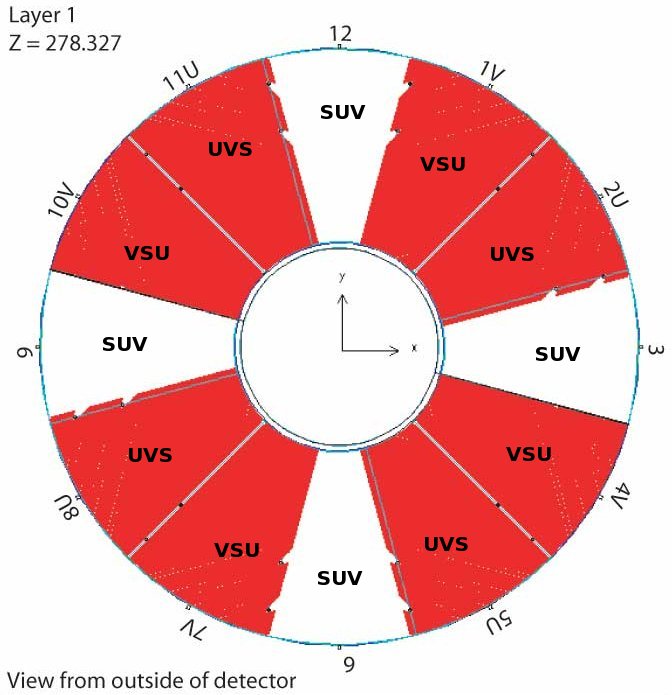
Note: u-v ordering scheme can be found here (Fig. 9-11)
Figure 1: Average number of SMD u-strip fired vs. thrown photon's (x,y)

Figure 2:Average number of SMD v-strip fired vs. thrown photon's (x,y)

2009.10.16 Jason geometry file: Full STAR simulations
Monte-Carlo setup:
- One photon per event
- EEMC only and Full STAR geometry configurations with LOW_EM option
(using Victor's geometry fix) - Throw particles flat in eta (1.08, 2.0), phi (0, 2pi), and pt (6-10 GeV)
- Using A2Emaker to get reconstructed Tower/SMD energy
(no EEMC SlowSimulator in chain) - Vertex z=0
- ~50K/per particle type
- Non-zero energy: 3 sigma above pedestal
Geometry configurations and notations (shown in the center of the plot):
- eemc-cvs: EEMC only with geometry file from CVS (cAir-fixed)
- full-cvs: Full STAR with geometry file from CVS (cAir-fixed)
- eemc-j: EEMC only with Jason geometry file
- full-j: Full STAR with Jason geometry file
Figure 2: Total energy distribution
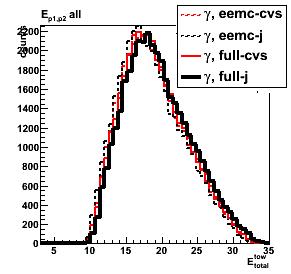
Figure 3: Shower shapes (left) and shape ratios (right) for 0 < pre-shower1 < 4MeV
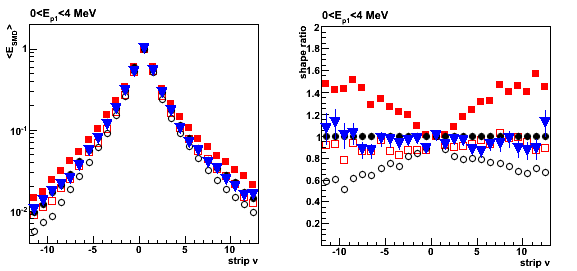
Pre-shower sorted shapes (for completeness)
2009.10.20 Sampling fraction problem: full STAr vs. EEMC stand alone geometry
For the previous study click here
Monte-Carlo setup:
- One photon per event
- EEMC only and Full STAR geometry configurations with LOW_EM option
(using Victor's geometry fix) - Throw particles flat in eta (1.08, 2.0), phi (0, 2pi), and pt (6-10 GeV)
- Using A2Emaker to get reconstructed Tower/SMD energy
(no EEMC SlowSimulator in chain) - Vertex z=0
- ~50K/per particle type
- Non-zero energy: 3 sigma above pedestal
Geometry configurations and notations (shown in the center of the plot):
- eemc-cvs: EEMC only with geometry file from CVS (cAir-fixed)
- full-cvs: Full STAR with geometry file from CVS (cAir-fixed)
- eemc-j: EEMC only with Jason geometry file
- full-j: Full STAR with Jason geometry file
Figure 1: Average energy in SMD-u plane vs. position of the thrown photon
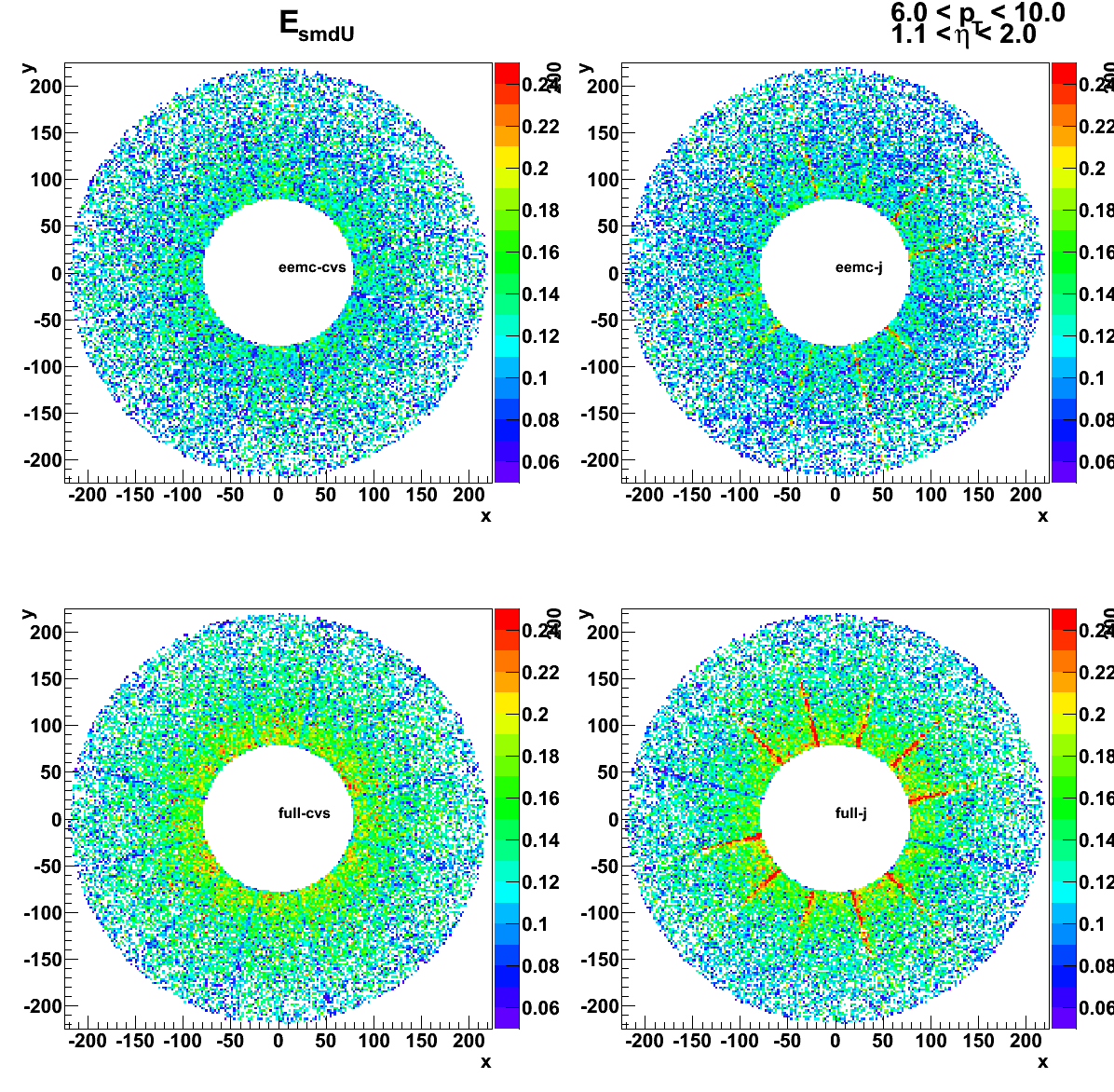
SMD v (left) and u (right) sampling fraction (E_smd/E_thrown) vs. E_thrown
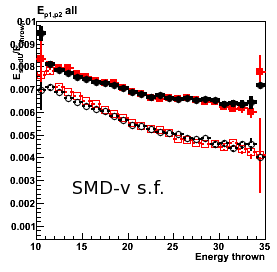
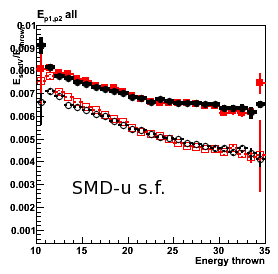
Figure 2: Sampling fraction (E_tower^total/E_thrown) vs. position of the thrown photon
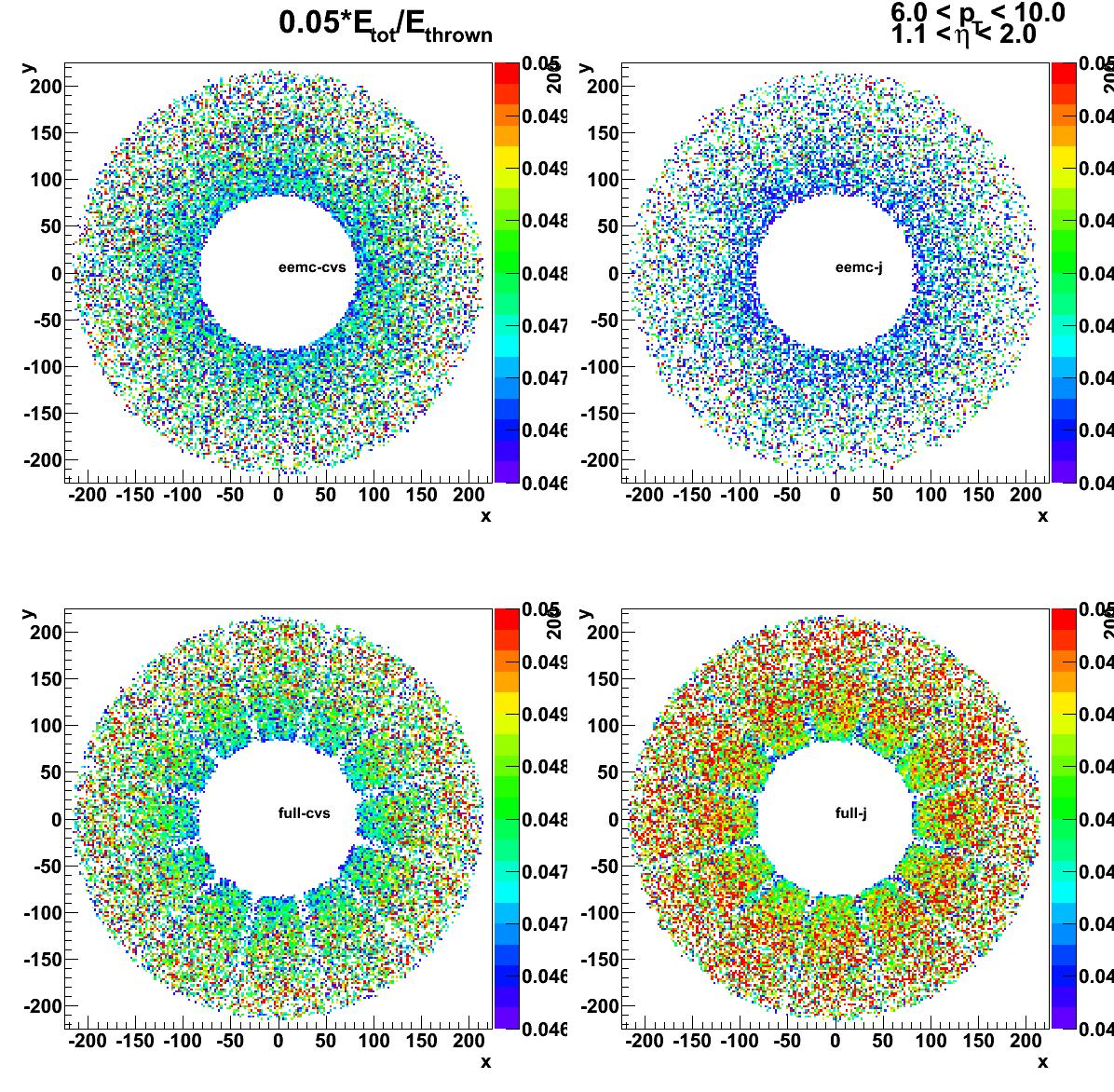
Sampling fraction (E_tower^total/E_thrown) vs. E_thrown
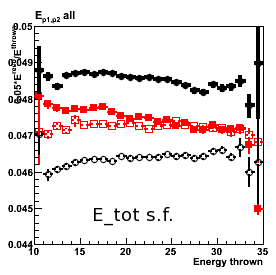
Figure 3: Number of towers above threshold vs. position of the thrown photon
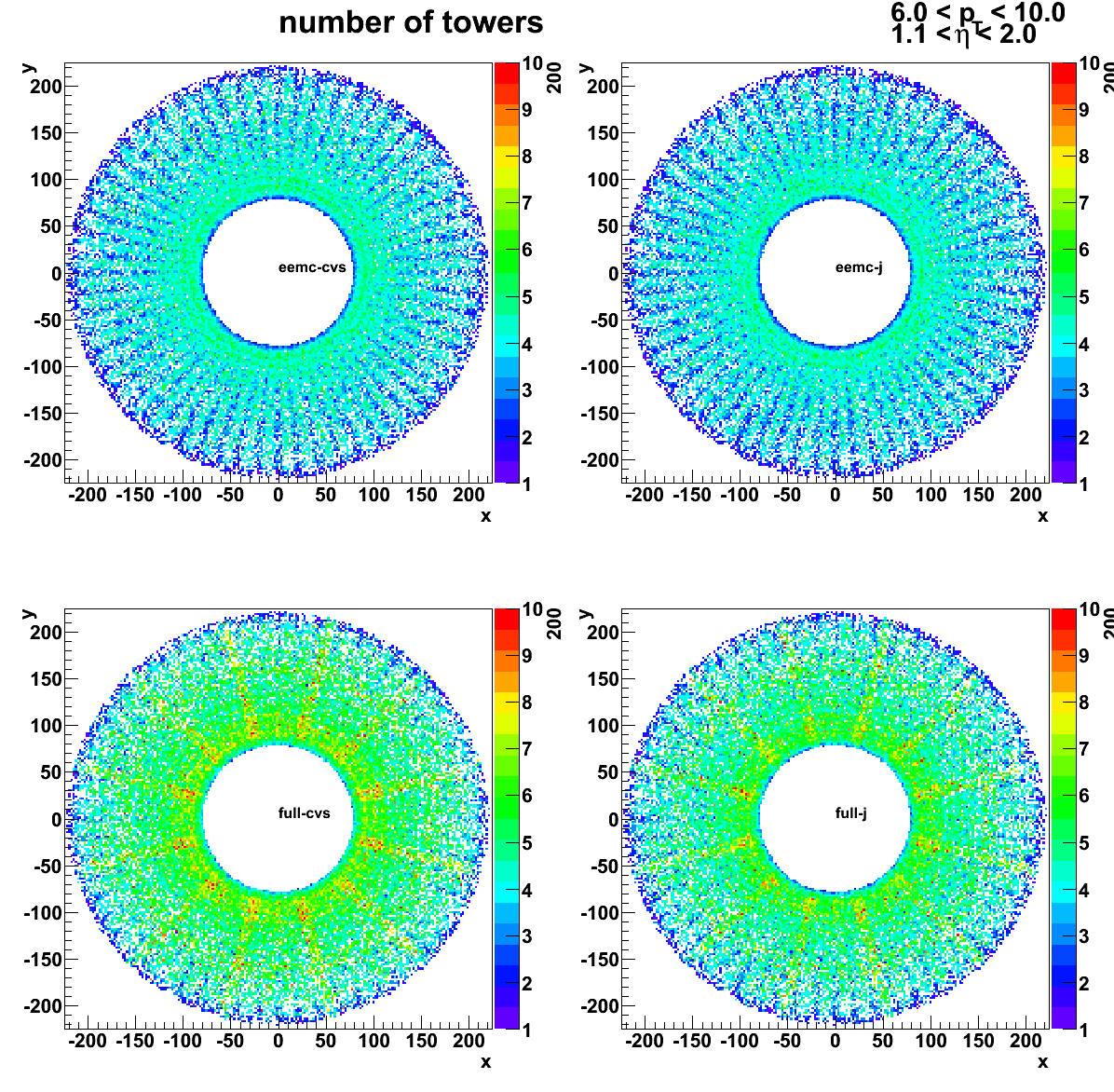
Number of towers above threshold vs. E_thrown
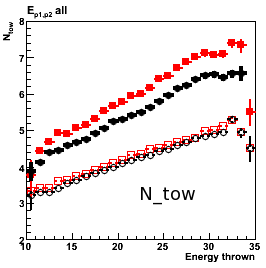
Other EEMC layers: pre-shower, postshower
Figure 4: (left) Pre-shower1 and (right) Pre-shower2 sampling fraction vs. E_thrown
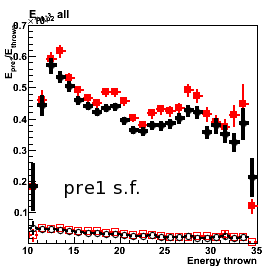
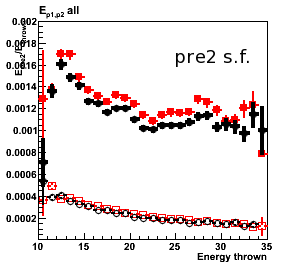
Figure 5: (left) High tower sampling fraction and (right) residual energy, [E_tot-E_3x3]/E_thrown, vs. E_thrown

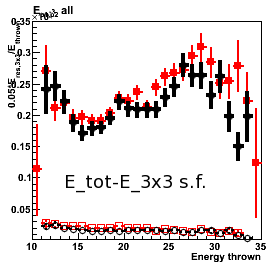
2009.10.26 Jason vs. CVS EEMC: removed SMD layers
Monte-Carlo setup:
- One photon per event
- Disabled new SMD layers (EXPS EBLS EFLS) in Jason geometry
- EEMC only and Full STAR geometry configurations with LOW_EM option
Note: LOW_EM option seems not to work for EEMC only configuration (double checking)
(using Victor's geometry fix) - Throw particles flat in eta (1.08, 2.0), phi (0, 2pi), and pt (6-10 GeV)
- Using A2Emaker to get reconstructed Tower/SMD energy
(no EEMC SlowSimulator in chain) - Vertex z=0
- ~50K/per particle type
- Non-zero energy: 3 sigma above pedestal
Geometry configurations and notations (shown in the center of the plot):
- eemc-cvs: EEMC only with geometry file from CVS (cAir-fixed)
- full-cvs: Full STAR with geometry file from CVS (cAir-fixed)
- eemc-j-noL: EEMC only with Jason geometry file (disabled 3-new SMD layers)
- full-j-noL: Full STAR with Jason geometry file (disabled 3-new SMD layers)
Figure 1: number of post-shower tiles
Figure 2: number of pre-1-shower tiles
Figure 3: number of pre-2-shower tiles
Figure 4: number of towers
2D
Figure 5: Average pre-shower1 energy

Figure 6: Average pre-shower2 energy

Figure 7: Average number of SMD-u strips

Figure 8: Average number of SMD-v strips

Figure 9: Average post-shower energy

Sampling fraction
Figure 10: Sampling fraction 1x1 vs. thrown energy

Figure 11: Sampling fraction 2x1 vs. thrown energy

Figure 12: Sampling fraction 3x3 vs. thrown energy

Figure 13: Sampling fraction (total energy) vs. thrown energy

Figure 14: Sampling fraction 1x1

Figure 15: Sampling fraction 2x1

Figure 16: Sampling fraction 3x3

SMD shower shapes
2009.10.27 Jason EEMC geometry: effect of removing new SMD layers
Monte-Carlo setup:
- One photon per event
- Disabled/Enabled new SMD layers (EXPS EBLS EFLS) in Jason geometry
- EEMC only and Full STAR geometry configurations with LOW_EM option
(using Victor's geometry fix) - Throw particles flat in eta (1.08, 2.0), phi (0, 2pi), and pt (6-10 GeV)
- Using A2Emaker to get reconstructed Tower/SMD energy
(no EEMC SlowSimulator in chain) - Vertex z=0
- ~50K/per particle type
- Non-zero energy: 3 sigma above pedestal
Geometry configurations and notations (shown in the center of the plot):
- eemc-j: EEMC only with Jason geometry file
- full-j: Full STAR with Jason geometry file
- eemc-j-noL: EEMC only with Jason geometry file (disabled 3-new SMD layers)
- full-j-noL: Full STAR with Jason geometry file (disabled 3-new SMD layers)
Effect of removing SMD layers on SMD strips
Figure 1: Average number of SMD-u strips

Figure 2: Average number of SMD-v strips

Effect of removing SMD layers on sampling fraction
Figure 3: distribution of 1x1 sampling fraction

Figure 4: distribution of 2x1 sampling fraction

Figure 5: distribution of 3x3 sampling fraction

Figure 6: 1x1 sampling fraction vs. thrown energy

2009.10.27: Jason EEMC geometry: comparison without LOW_EM option
Monte-Carlo setup:
- One photon per event
- Disabled new SMD layers (EXPS EBLS EFLS) in Jason geometry
- EEMC only and Full STAR geometry configurations without LOW_EM option
(using Victor's geometry fix) - Throw particles flat in eta (1.08, 2.0), phi (0, 2pi), and pt (6-10 GeV)
- Using A2Emaker to get reconstructed Tower/SMD energy
(no EEMC SlowSimulator in chain) - Vertex z=0
- ~50K/per particle type
- Non-zero energy: 3 sigma above pedestal
Geometry configurations and notations (shown in the center of the plot):
- eemc-cvs: EEMC only with geometry file from CVS (cAir-fixed)
- full-cvs: Full STAR with geometry file from CVS (cAir-fixed)
- eemc-j-noL: EEMC only with Jason geometry file (disabled 3-new SMD layers)
- full-j-noL: Full STAR with Jason geometry file (disabled 3-new SMD layers)
Figure 1: Sampling fraction 1x1

Figure 2: Sampling fraction 2x1

Figure 3: Sampling fraction 3x3

Figure 4: Sampling fraction total energy

Figure 5: Sampling fraction pre1-shower

Figure 6: Sampling fraction pre2-shower

Figure 7: Sampling fraction smd-u

Figure 8: Sampling fraction smd-v
Figure 9: Sampling fraction post-shower

Sampling fraction vs. thrown energy
Figure 10: Sampling fraction 1x1 vs. thrown energy

Figure 11: Sampling fraction 2x1 vs. thrown energy

Figure 12: Sampling fraction 3x3 vs. thrown energy

Figure 13: Sampling fraction (tatal energy) vs. thrown energy

2009.10.30: Jason EEMC geometry: Jason with ELED block from CVS file
FYI: Alice blog on ELED block study
Monte-Carlo setup:
- One photon per event
- Disabled SMD layers (EXPS EBLS EFLS) in Jason geometry
- Put ELED block from CVS file into Jason geometry
geometry configurations without LOW_EM option
(using Victor's geometry fix)- Throw particles flat in eta (1.08, 2.0), phi (0, 2pi), and pt (6-10 GeV)
- Using A2Emaker to get reconstructed Tower/SMD energy
(no EEMC SlowSimulator in chain) - Vertex z=0
- ~50K/per particle type
- Non-zero energy: 3 sigma above pedestal
Geometry configurations and notations (shown in the center of the plot):
- full-cvs: Full STAR with geometry file from CVS (cAir-fixed)
- full-j: EEMC only with Jason geometry file (disabled 3-new SMD layers, ELED block replaced with that from CVS)
Figure 1: Sampling fraction 1x1 (up-left), 2x1 (up-right), 3x3 (low-left), total energy (low-right)

Figure 2: Sampling fraction pre1 (up-left), pre2 (up-right), SMD-u (low-left), post (low-right)

Figure 3: Shower shapes (left) and shower shape ratio (right)

11 Nov
November 2009 posts
2009.11.02 Jason EEMC geometry: results with and without LOW_EM options
Monte-Carlo setup:
- One photon per event
- Disabled SMD layers (EXPS EBLS EFLS) in Jason geometry
geometry configurations with and without LOW_EM option
(using Victor's geometry fix)- Throw particles flat in eta (1.08, 2.0), phi (0, 2pi), and pt (6-10 GeV)
- Using A2Emaker to get reconstructed Tower/SMD energy
(no EEMC SlowSimulator in chain) - Vertex z=0
- ~50K/per particle type
- Non-zero energy: 3 sigma above pedestal
Geometry configurations and notations (shown in the center of the plot):
- full-cvs-noEM (dashed): CVS geometry (cAir-fixed) without LOW_EM option
- full-cvs-EM (solid): CVS geometry (cAir-fixed) with LOW_EM option
- full-j-NoEM-noL: Jason geometry (disabled 3-new SMD layers) without LOW_EM option
- full-j-EM-noL: Jason geometry (disabled 3-new SMD layers) with LOW_EM option
Figure 1: Distribution of the sampling fraction (total energy in EEMC)

Figure 2: Sampling fraction (total energy in EEMC) vs. thrown energy

Figure 3: Sampling fraction (total energy in EEMC) vs. position of the thrown photon

2009.11.03 BEMC sampling fraction: with and without LOW_EM option
Monte-Carlo setup:
- Throwing one photon per event
- Full STAR geometry (y2006g) configurations with and without LOW_EM option.
Note: LOW_EM cuts are listed at the bottom of this page,
and some related discussion can be found in this phana thread - Throw particles flat in eta (-1,1), phi (0, 2pi), and energy (30 +/- 0.5 GeV)
- Vertex z=0
- 50K/per particle type
Geometry configurations and notations:
- BEMC-noLOW_EM: Full STAR y2006g without LOW_EM option
- BEMC-LOW_EM: Full STAR y2006g with LOW_EM option
data base settings (same settings in bfc.C (Jan's trick) and in my MuDst reader):
dbMk->SetFlavor("sim","bemcPed");
dbMk->SetFlavor("Wbose","bemcCalib");
dbMk->SetFlavor("sim","bemcGain");
dbMk->SetFlavor("sim","bemcStatus");
dbMk->SetFlavor("sim","bprsPed");
dbMk->SetFlavor("Wbose","bprsCalib");
dbMk->SetFlavor("sim","bprsGain");
dbMk->SetFlavor("sim","bprsStatus");
dbMk->SetFlavor("sim","bsmdePed");
dbMk->SetFlavor("Wbose","bsmdeCalib");
dbMk->SetFlavor("sim","bsmdeGain");
dbMk->SetFlavor("sim","bsmdeStatus");
dbMk->SetFlavor("sim","bsmdpPed");
dbMk->SetFlavor("Wbose","bsmdpCalib");
dbMk->SetFlavor("sim","bsmdpGain");
dbMk->SetFlavor("sim","bsmdpStatus");
Note: for BEMC ideal pedSigma set to 0, so effectively
there is no effect when I apply 3-sigma threshold above pedestal.
Figure 1: E_reco/E_thrown distribution.
E_reco is the total energy in the BEMC towers from mMuDstMaker->muDst()->muEmcCollection()
E_thrown energy of the thrown photon from tne GEant record
No cut (yet) applied to exclude otliers in the average
Outliers in E_reco/E_thrown
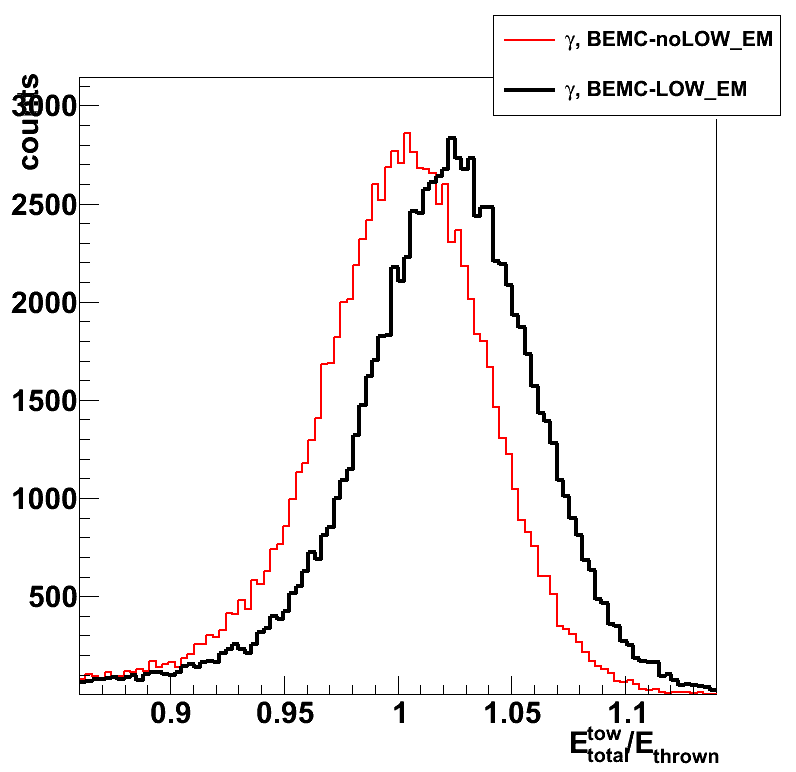

Figure 2: Average E_reco/E_thrown vs. thrown photon eta (left) and phi (right)
Average is taken over a slice in eta or phi (no gaussian fits)
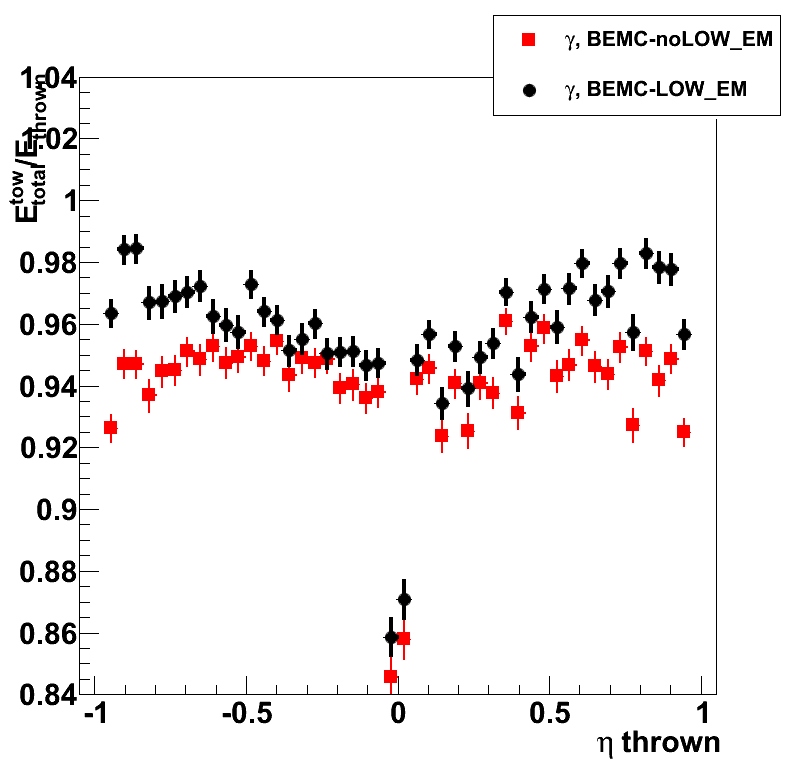

Figure 3: Average E_reco/E_thrown vs. thrown position (eta and phi)
Left: without LOW_EM option; right: with LOW_EM option
No cut applied to exclude otliers

2009.11.03 Jason EEMC geometry: Effect of ELED block change
Monte-Carlo setup:
- One photon per event
- Disabled SMD layers (EXPS EBLS EFLS) in Jason geometry
- Alter the ELED block (lead absorber plate) in Jason geometry file
- Full STAR geometry configurations with and without LOW_EM option
(using Victor's geometry fix) - Throw particles flat in eta (1.08, 2.0), phi (0, 2pi), and pt (6-10 GeV)
- Using A2Emaker to get reconstructed Tower/SMD energy
(no EEMC SlowSimulator in chain) - Vertex z=0
- ~50K/per particle type
- Non-zero energy: 3 sigma above pedestal
Figure 1: Sampling fraction (total energy in EEMC)
- Solid symbols and lines present results with LOW_EM option
Note: the black are the same in left and right plots - Open/dashed symbols and lines - results without LOW_EM option
- Upper plots - distribution of the sampling fcation
- Lower plots - Sampling fcation vs. thrown photon energy
- Left plots: CVS geometry vs. Jason with removed extra SMD layers.
ELED block is the same in all 4 cases, and is taken from CVS file.
in red: CVS geometry, in black - Jason geometry - Right plots:
Jason with new ELED block (in red) vs. Jason with ELED block from CVS (in black)
Extra SMD layers are removed in all 4 cases
Figure 2: Sampling fraction (total energy in EEMC)
black: same black as in Fig. 1, upper plots
red: EEMC geometry with Material PbAlloy isvol=0
(modification suggested by Jason in this post)

2009.11.06 new EEMC geometry: Pure lead and new SMD layers
Monte-Carlo setup:
- One photon per event
- Disabled/Enabled SMD layers (EXPS EBLS EFLS) in Jason geometry
- Alter the ELED block with pure lead
- Full STAR geometry configurations with and without LOW_EM option
(using Victor's geometry fix) - Throw particles flat in eta (1.08, 2.0), phi (0, 2pi), and pt (6-10 GeV)
- Using A2Emaker to get reconstructed Tower/SMD energy
(no EEMC SlowSimulator in chain) - Vertex z=0
- ~50K/per particle type
- Non-zero energy: 3 sigma above pedestal
Geometry configurations
- dashed/open red (j-noEM,noL,Pb):
full STAR y2006, no LOW_EM, Jason EEMC geometry without new SMD layers, pure lead in ELED block - solid red (j-EM,noL,Pb):
full STAR y2006, LOW_EM, Jason EEMC geometry without new SMD layers, pure lead in ELED block - dashed/open black (j-noEM,Pb):
full STAR y2006, no LOW_EM, Jason EEMC geometry with new SMD layers, pure lead in ELED block - solid black (j-EM,Pb):
full STAR y2006, LOW_EM, Jason EEMC geometry with new SMD layers, pure lead in ELED block
Sampling fraction of various EEMC layers (tower, SMD, pre1-,pre2-, post- shower)
Figure 1: Tower sampling fraction distribution
Figure 2: Tower sampling fraction vs. thrown energy
Figure 3: Tower sampling fraction vs. position of the thrown photon
Figure 4: Pre1, pre2, post and SMD sampling fraction distribution
Figure 5: Pre1, pre2, post and SMD sampling fraction vs. thrown energy
SMD shower shapes
Figure 6: SMD-v shower shapes
Figure 7: SMD-v shower shape ratios
Figure 8: Number of SMD-u strips
Figure 9: Number of SMD-v strips
Tower energy profile
Figure 10: Energy ractio of 2x1 to 3x3 cluster vs. gamma-jet data
Energy deposition in various EEMC layers vs. position of the thrown photon
Figure 11: Pre-shower1 energy
Figure 12: Pre-shower2 energy
Figure 13: Post-shower energy
Figure 14: SMD-v energy
Figure 15: Number of towers
LOW_EM option and pre-shower migration
Figure 16: Tower Sampling fraction: LOW_EM option and pre-shower migration
2009.11.10 BEMC sampling fraction and clustering
Monte-Carlo setup:
- Throwing one photon per event
- Full y2009 STAR geometry configurations with and without LOW_EM option.
Note: LOW_EM cuts are listed at the bottom of this page,
and some related discussion can be found in this phana thread - Throw particles flat in eta (-0.95,0.05) amd (0.05, 0.95), phi (0, 2pi), and energy (30 +/- 0.5 GeV)
- bfc.C options:
trs,fss,y2009,Idst,IAna,l0,tpcI,fcf,ftpc,Tree,logger,ITTF,Sti,MakeEvent,McEvent,
geant,evout,IdTruth,tags,bbcSim,tofsim,emcY2,EEfs,
GeantOut,big,-dstout,fzin,-MiniMcMk,beamLine,clearmem,eemcDB,VFPPVnoCTB - Use fixed (7%) sampling fraction in StEmcSimpleSimulator.cxx
mSF[0] = 1/0.07;
mSF[1] = 0.;
mSF[2] = 0.; - Vertex z=0
- 50K/per particle type
Geometry configurations and notations:
- BEMC-noLOW_EM: Full STAR y2009 without LOW_EM option
- BEMC-LOW_EM: Full STAR y2009 with LOW_EM option
data base settings (same settings in bfc.C (Jan's trick) and in my MuDst reader):
dbMk->SetFlavor("sim","bemcPed");
dbMk->SetFlavor("Wbose","bemcCalib");
dbMk->SetFlavor("sim","bemcGain");
dbMk->SetFlavor("sim","bemcStatus");
Note: for BEMC ideal pedSigma set to 0, so effectively
there is no effect when I apply 3-sigma threshold above pedestal.
Figure 1: Sampling fraction (0.07*E_reco/E_thrown) distribution: average vs. gaussian fit
E_reco is the total energy in the BEMC towers from mMuDstMaker->muDst()->muEmcCollection()
E_thrown energy of the thrown photon from tne GEant record
The difference between fit and using average values is < 0.7%
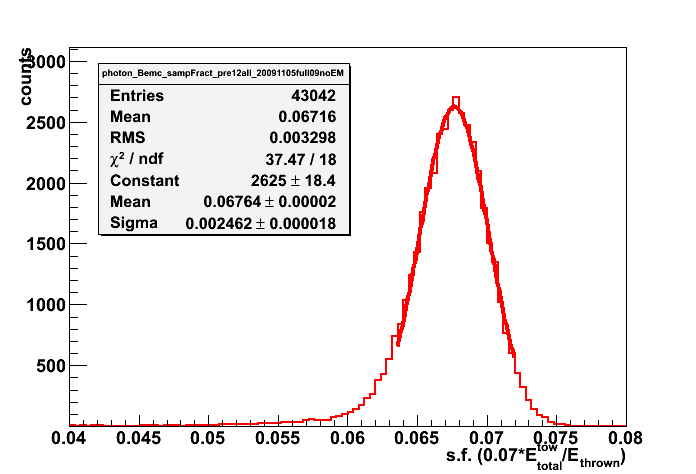
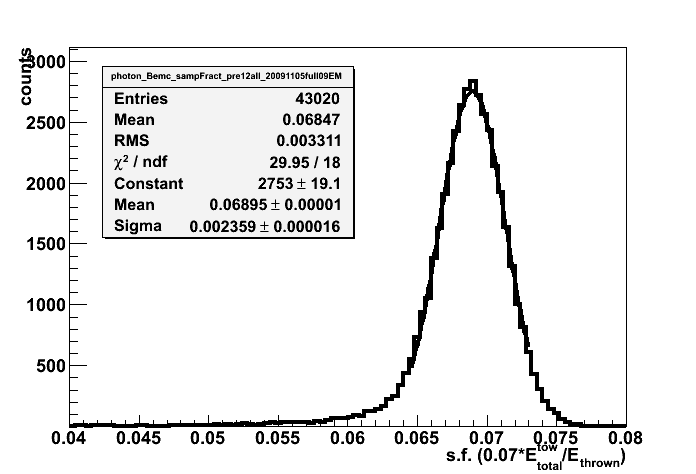
Figure 2: Otliers vs. eta and phi: (left) no energy reconstrycted, (right) s.f. < 55%
Most outlier are at eta = 0, -1, +1
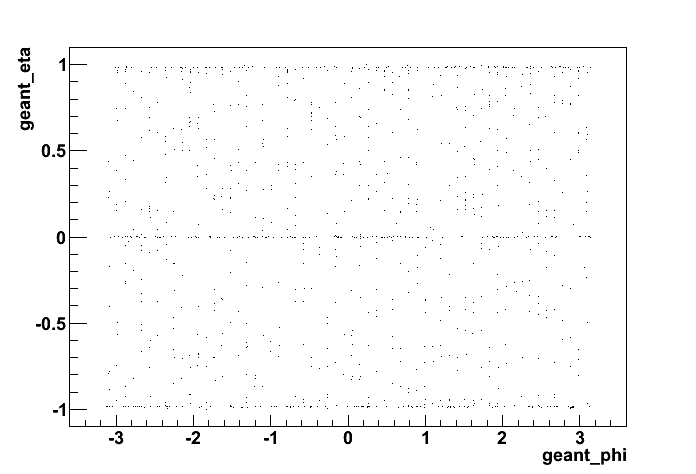

Figure 3: Sampling fraction (0.07*E_reco/E_thrown) distribution
Effect of LOW_EM cuts
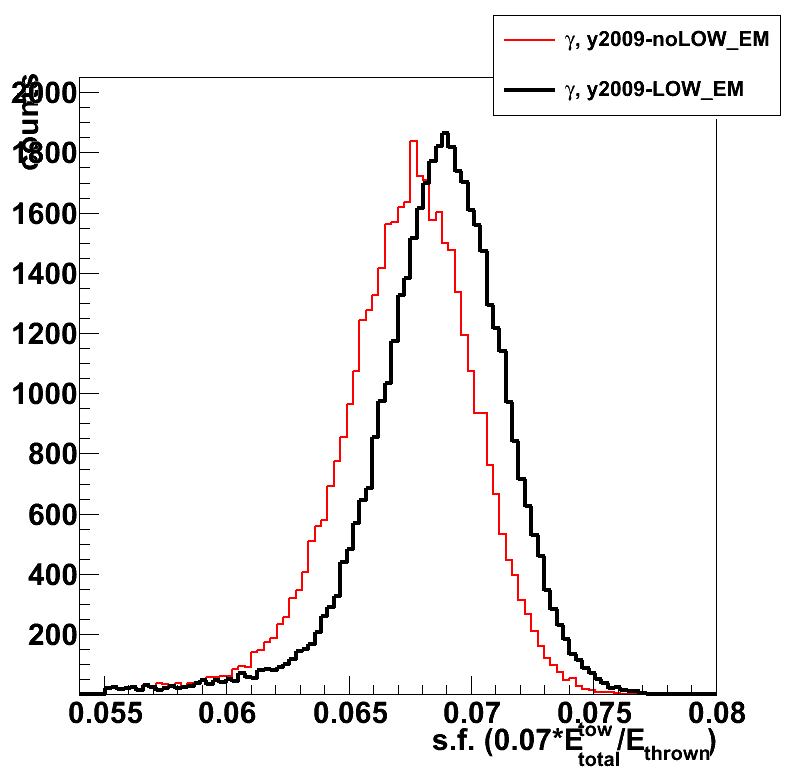

Figure 4: Sampling fraction vs. thrown photon eta (left) and phi (right)
Average is taken over a slice in eta or phi with cut on outliers (events with s.f. < 5.5% rejected)
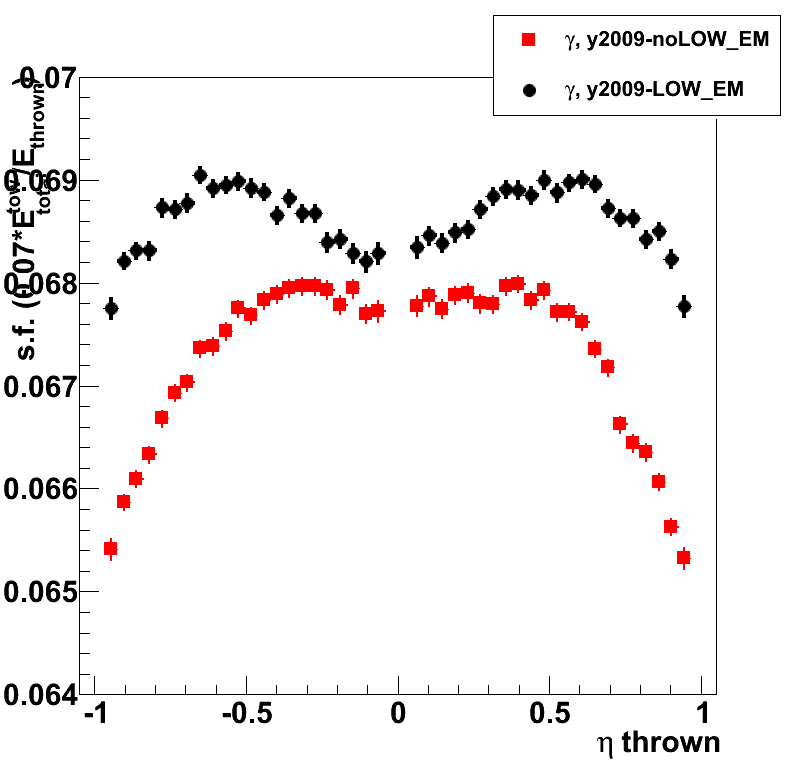

Figure 5: Sampling fraction vs. thrown position (eta and phi)
Average is taken over a slice in eta or phi with cut on outliers (events with s.f. < 5.5% rejected)

Figure 6: (left) Single tower sampling fraction
and (right) energy ratio of 1x1 cluster to the total BEMC energy
Not much of the effect from LOW_EM cuts on the 1x1 clustering. Need to look at other (2x1, 2x2 clusters)
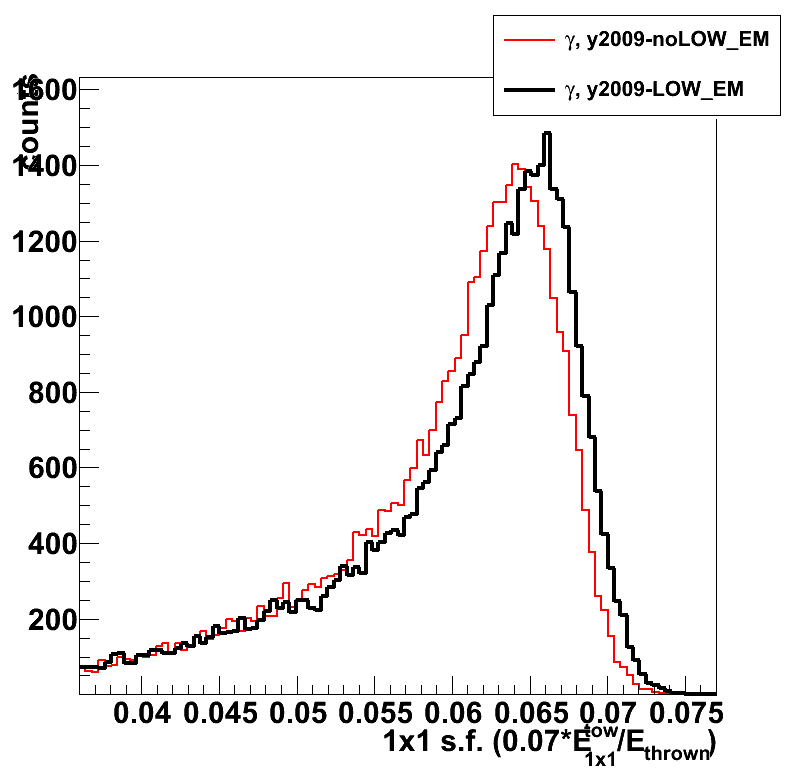

2009.11.11 Tests of EEMC geometry, version 6.1
Monte-Carlo setup:
- Throwing one photon per event
- Compare EEMC geometry v6.0 (pure lead) vs. v6.1
- Full STAR geometry configurations with and without LOW_EM option
- Throw particles flat in eta (1.08, 2.0), phi (0, 2pi), and pt (6-10 GeV)
- Using A2Emaker to get reconstructed Tower/SMD energy (no EEMC SlowSimulator in chain)
- Vertex z=0
- ~50K/per particle type
- Non-zero energy: 3 sigma above pedestal
Geometry configurations
- dashed/open red: full STAR y2006, no LOW_EM, EEMC geometry v6.1
- solid red: full STAR y2006, with LOW_EM, EEMC geometry v6.1
- dashed/open black: full STAR y2006, full STAR y2006, no LOW_EM, EEMC geometry v6.0
- solid black: full STAR y2006, full STAR y2006, with LOW_EM, EEMC geometry v6.0
Sampling fraction of various EEMC layers (tower, SMD, pre1-,pre2-, post- shower)
Figure 1: Sampling fraction of various EEMC layers vs. thrown photon energy:
(a) tower s.f.; (b) tower s.f. distribution; (c) pre-shower1; (d) pre-shower2; (e) SMD, (f) post-shower

Figure 2: (left) Shower shapes and (right) shower shape ratios
2009.11.16 Tests of EEMC geometry, version 6.1: lead vs. mixture
Monte-Carlo setup:
- Throwing one photon per event
- Compare EEMC geometry v6.1 with pure lead vs. mixture
- Full STAR geometry configurations with and without LOW_EM option
- Throw particles flat in eta (1.08, 2.0), phi (0, 2pi), and pt (6-10 GeV)
- Using A2Emaker to get reconstructed Tower/SMD energy (no EEMC SlowSimulator in chain)
- Vertex z=0
- ~50K/per particle type
- Non-zero energy: 3 sigma above pedestal
Geometry configurations
- dashed/open red: full STAR y2006, no LOW_EM, EEMC geometry v6.1 with pure lead
- solid red: full STAR y2006, with LOW_EM, EEMC geometry v6.1 with pure lead
- dashed/open black: full STAR y2006, full STAR y2006, no LOW_EM, EEMC geometry v6.1 with lead-ally mixture
- solid black: full STAR y2006, full STAR y2006, with LOW_EM, EEMC geometry v6.1 with lead-ally mixture
2009.11.17 BEMC sampling fraction: energy dependence
Monte-Carlo setup:
- Throwing one photon per event
- Full y2009 STAR geometry configurations with LOW_EM option
- Throw particles flat in eta (-1,1), phi (0, 2pi),
with energy steps: 10, 20, 30, 40, and 50 GeV with flat (+/-0.5 GeV) spread - bfc.C options:
trs,fss,y2009,Idst,IAna,l0,tpcI,fcf,ftpc,Tree,logger,ITTF,Sti,MakeEvent,McEvent,
geant,evout,IdTruth,tags,bbcSim,tofsim,emcY2,EEfs,
GeantOut,big,-dstout,fzin,-MiniMcMk,beamLine,clearmem,eemcDB,VFPPVnoCTB - Use fixed (7%) sampling fraction in StEmcSimpleSimulator.cxx
mSF[0] = 1/0.07;
mSF[1] = 0.;
mSF[2] = 0.; - Vertex z=0
- 50K/per particle type
data base settings (same settings in bfc.C (Jan's trick) and in my MuDst reader):
dbMk->SetFlavor("sim","bemcPed");
dbMk->SetFlavor("Wbose","bemcCalib");
dbMk->SetFlavor("sim","bemcGain");
dbMk->SetFlavor("sim","bemcStatus");
Note: for BEMC ideal pedSigma set to 0, so effectively
there is no effect when I apply 3-sigma threshold above pedestal.
Figure 1: Rapidity cuts study (no eta cuts, no cuts on otliers in this figure)
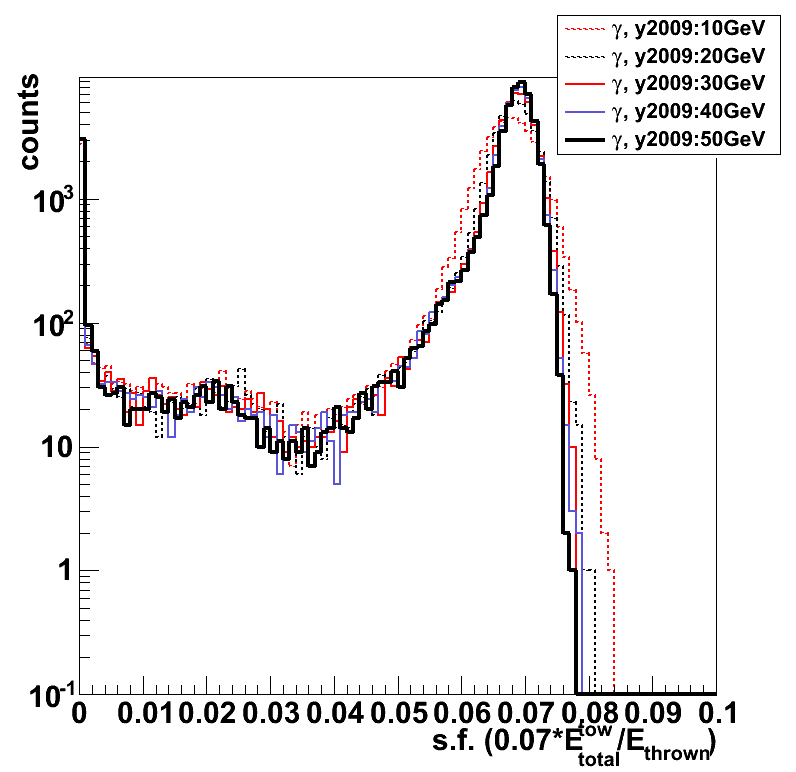
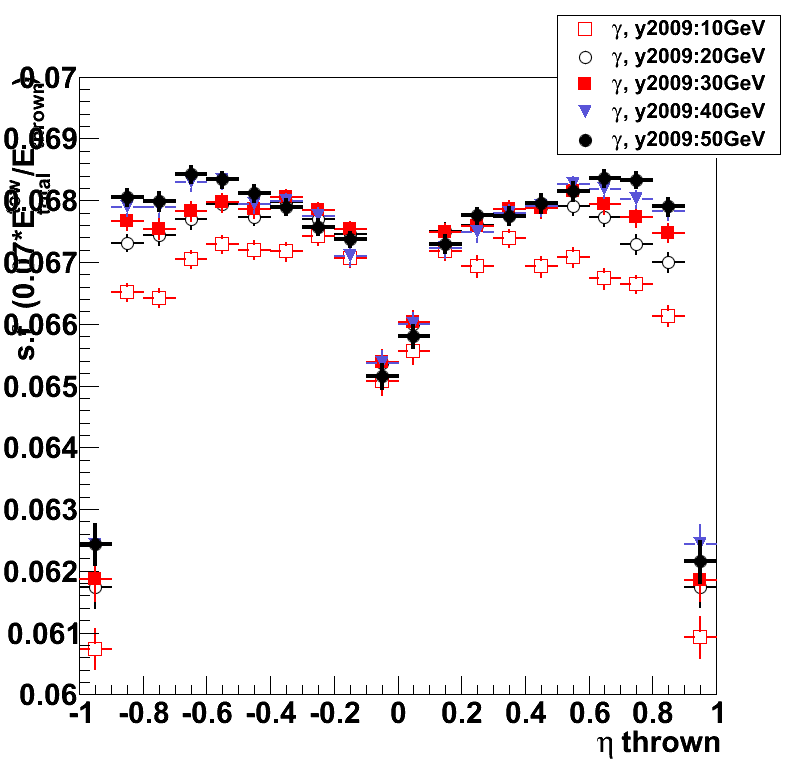
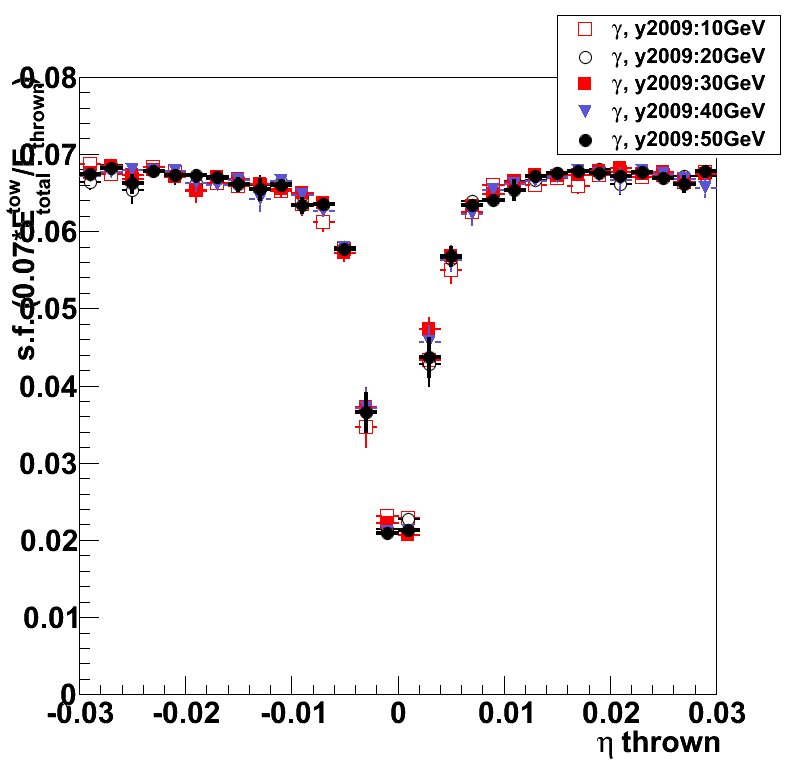

Figure 2: Sampling fraction (0.07*E_reco/E_thrown) distribution
E_reco is the total energy in the BEMC towers from mMuDstMaker->muDst()->muEmcCollection()
E_thrown energy of the thrown photon from tne Geant record
Cuts: |eta| < 0.97 && |eta|>0.01 && s.f. > 0.055
s.f. distribution on the log scale
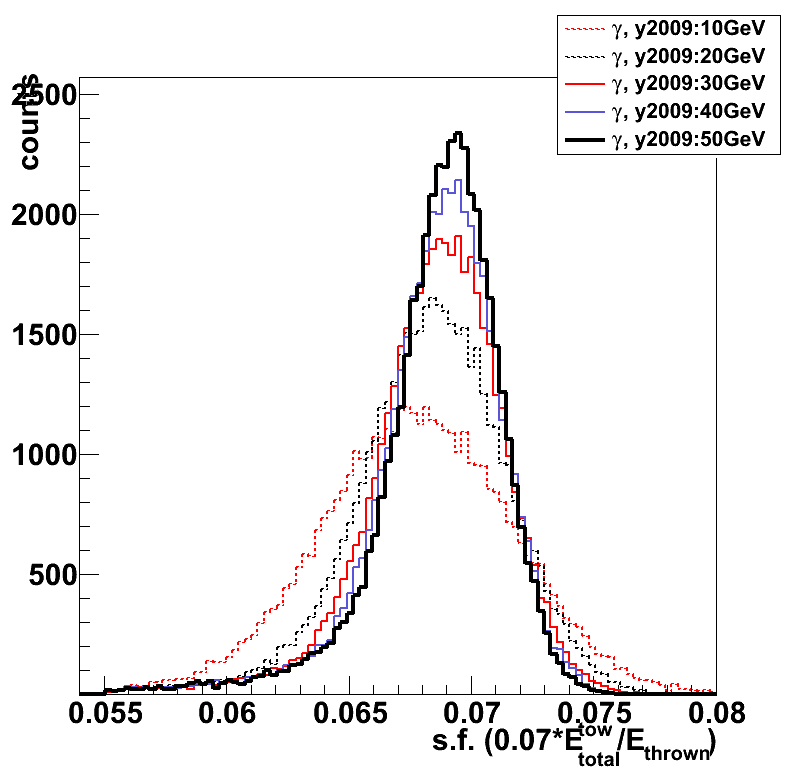
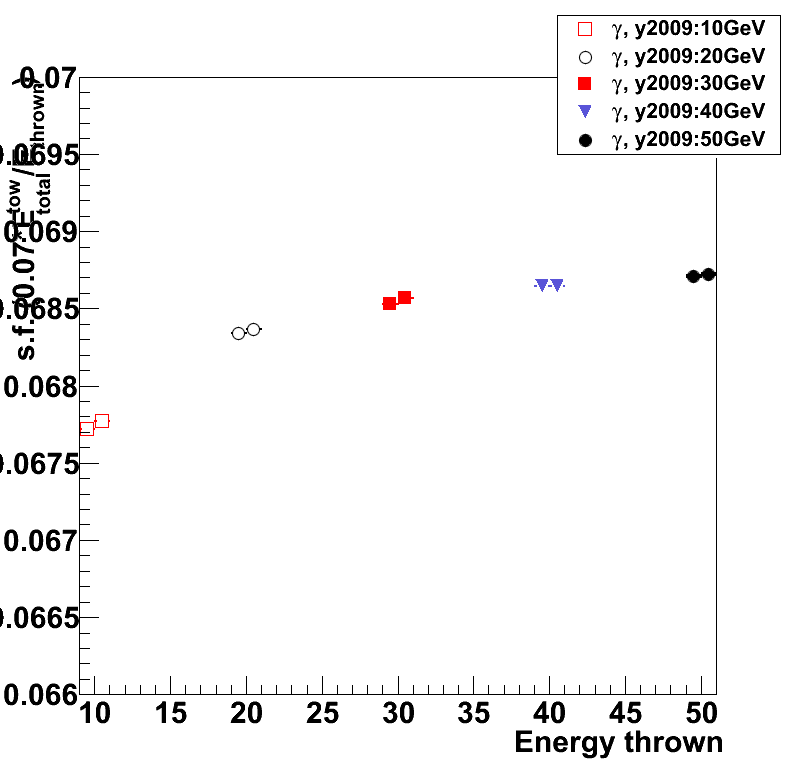
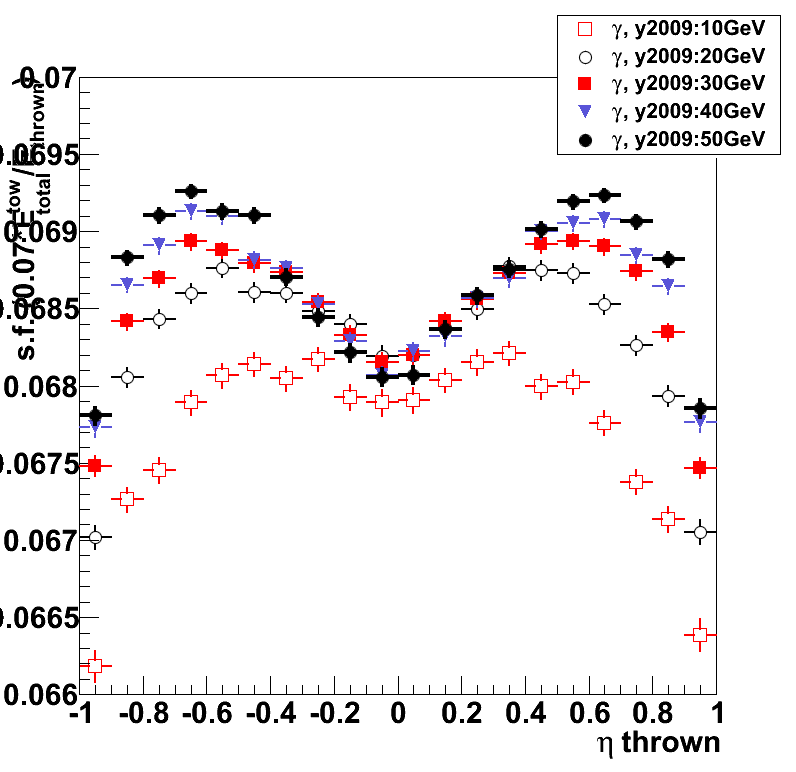

2009.11.19 LOW_EM and EEMC time/event in starsim
Monte-Carlo setup:
- Throwing one photon/electron per event
- y2009 geometry tag (EEMC geometry v6.1)
- Full STAR geometry configurations with and without LOW_EM option
- Throwing particles flat in eta (1.08, 2.0), phi (0, 2pi), and energy (5-35 GeV)
- ~50K/per particle type, 250 events per job, 200 jobs
Geometry configurations
- red: without LOW_EM option
- black: with LOW_EM option
- circles - electrons, squares - photons
Figure 1: (left) time/event distribution, (right) average time for the particle type
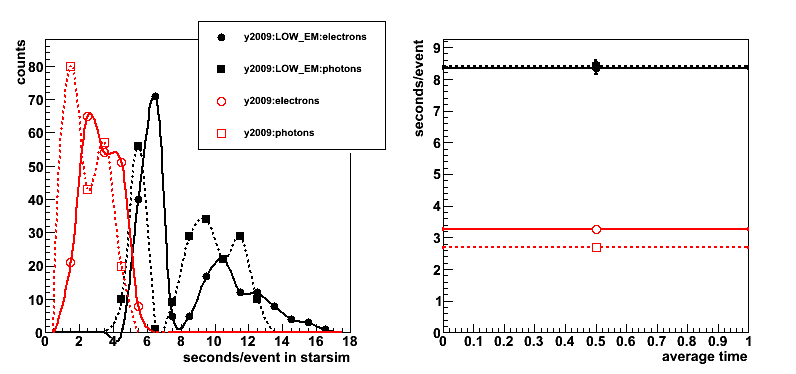
Conclusion: for single particle Monte-Carlo required time in starsim
with LOW_EM option is ~ 2.6 times higher.
2009.11.23 New EEMC geometry (CVS v6.1): y2006 vs. y2009 STAR configurations
Monte-Carlo setup:
- Throwing one photon per event
- Compare new EEMC geometry in CVS for y2006 and 2009 configurations
- Full STAR geometry configurations with and without LOW_EM option
- Throw particles flat in eta (1.08, 2.0), phi (0, 2pi), and energy (5-35 GeV)
- Using A2Emaker to get reconstructed Tower/SMD energy (no EEMC SlowSimulator in chain)
- Vertex z=0
- ~50K/per particle type
- Non-zero energy: 3 sigma above pedestal
Geometry configurations
- red: full STAR y2009, with/without LOW_EM, EEMC geometry
- black: full STAR y2006, with/without LOW_EM, EEMC geometry v6.1
Figure 1: EEMC sampling fraction (left) distribution (right) vs. thrown photon energy (1.2 < eta < 1.9; no pt cuts)

Figure 2: EEMC sampling fraction (left) distribution (right) vs. thrown photon energy (1.2 < eta < 1.9; pt > 7GeV cut)

Figure 5: Shower shape ratios (v plane)

Figure 6: Shower shape ratios (u plane)

Figure 7: Pre-shower migration (1.2 < eta < 1.9; no pt cuts)

12 Dec
December 2009 posts
2009.12.01 BEMC 1x1, 2x1, 2x2, 3x3 clustering
Monte-Carlo setup:
- Throwing one photon per event
- Full y2009 STAR geometry configurations with/without LOW_EM option
- Throw particles flat in eta (-1,1), phi (0, 2pi),
with energy: 30GeV with flat (+/-0.5 GeV) spread - bfc.C options:
trs,fss,y2009a,Idst,IAna,l0,tpcI,fcf,ftpc,Tree,logger,ITTF,Sti,MakeEvent,McEvent,
geant,evout,IdTruth,tags,bbcSim,tofsim,emcY2,EEfs,
GeantOut,big,-dstout,fzin,-MiniMcMk,beamLine,clearmem,eemcDB,VFPPVnoCTB - Use fixed (7%) sampling fraction in StEmcSimpleSimulator.cxx
mSF[0] = 1/0.07;
mSF[1] = 0.;
mSF[2] = 0.; - Vertex z=0
- 50K/per particle type
data base settings (same settings in bfc.C (Jan's trick) and in my MuDst reader):
dbMk->SetFlavor("sim","bemcPed");
dbMk->SetFlavor("Wbose","bemcCalib");
dbMk->SetFlavor("sim","bemcGain");
dbMk->SetFlavor("sim","bemcStatus");
Note: for BEMC ideal pedSigma set to 0, so effectively
there is no effect when I apply 3-sigma threshold above pedestal.
Figure 1: Energy sampling of various cluster in the Barrel EMC
E_reco is the total energy in the BEMC towers from mMuDstMaker->muDst()->muEmcCollection()
eta_thrown - rapidity of the thrown photon from the Geant record
Cuts: |eta| < 0.97 && |eta|>0.01 && total energy s.f. > 0.055
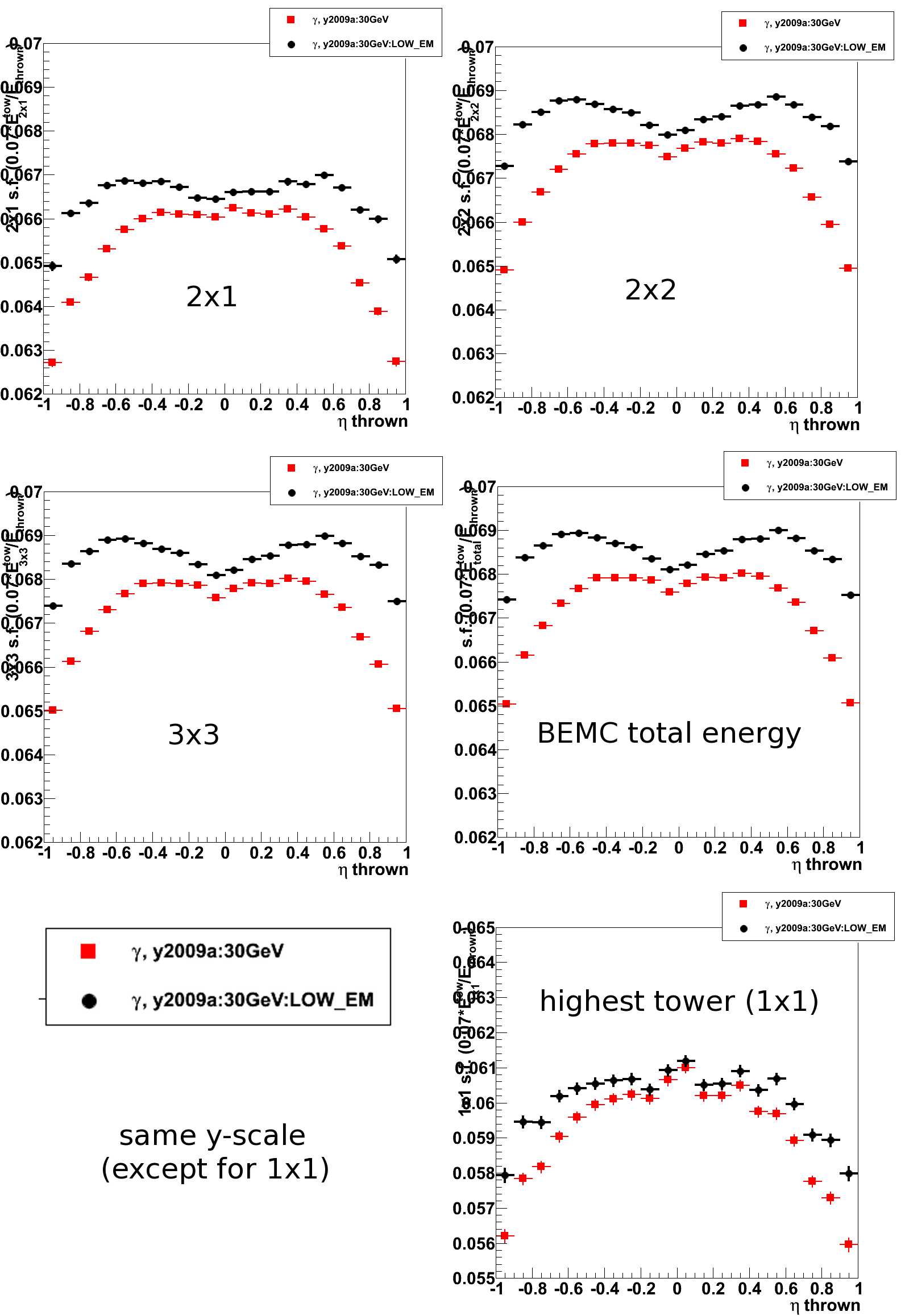
Figure 2: Various cluster energy ratios
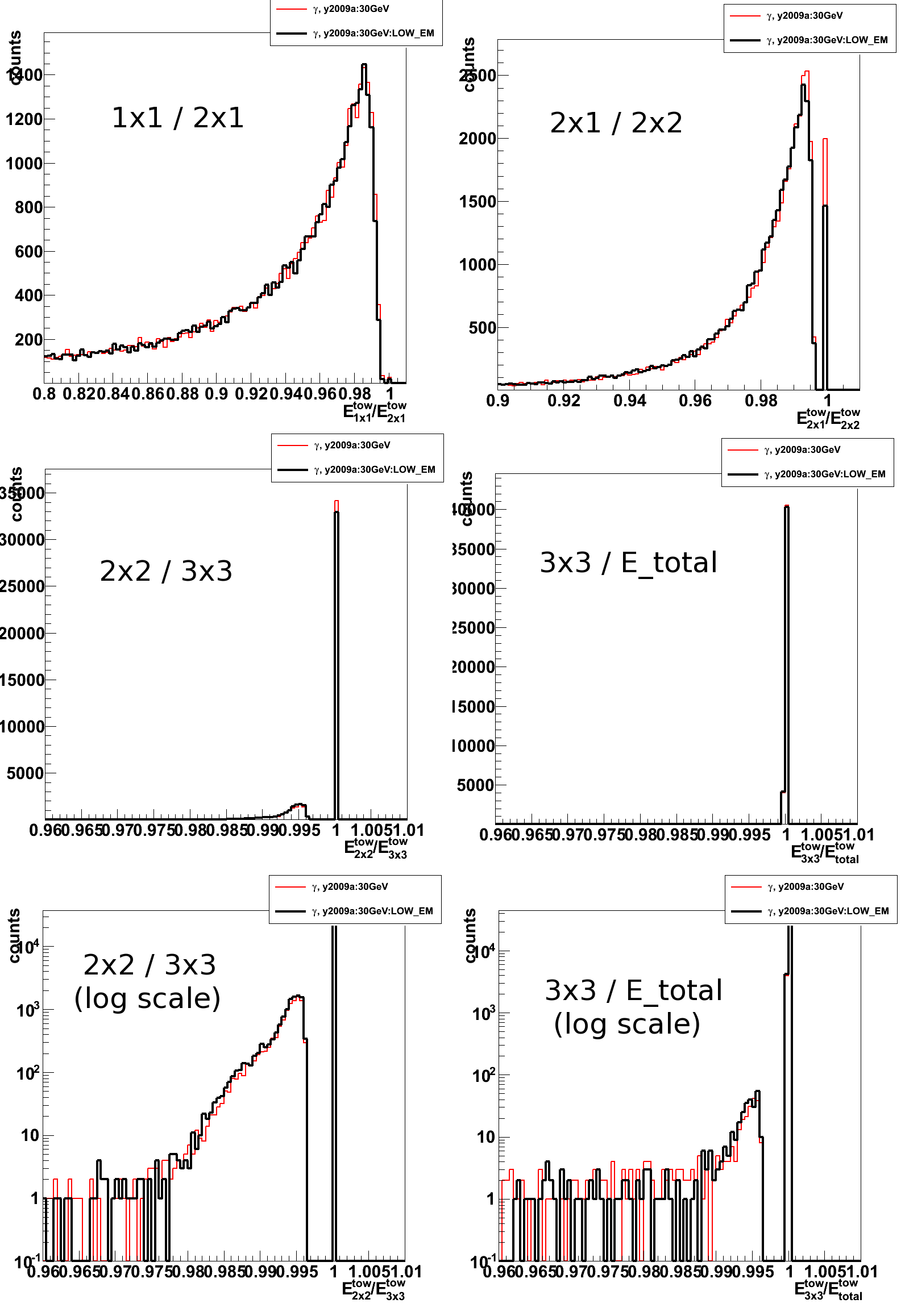
2009.12.07 Low EM study: LOW_EM option, 100KeV cuts, and DCUTE=100KeV
Conclusions/dicsussion at the emc2 hypernew
http://www.star.bnl.gov/HyperNews-star/get/emc2/3369.html
http://www.star.bnl.gov/HyperNews-star/get/emc2/3375.html
Monte-Carlo setup:
- Throwing one photon per event
- Full STAR y2006h (latest EEMC, v6.1 and TPC, v04 geometries)
- Throw particles flat in eta (1.08, 2.0), phi (0, 2pi), and energy (5-35 GeV)
- Using A2Emaker to get reconstructed Tower/SMD energy (no EEMC SlowSimulator in chain)
- Vertex z=0
- ~50K/per particle type
- Non-zero energy: 3 sigma above pedestal
GEANT EM cuts list (default values in GeV)
- CUTGAM - cut for gammas (GEANT default = 0.001)
- CUTELE - cut for electrons (GEANT default = 0.001)
- CUTHAD - cut for charged hadrons (GEANT default = 0.01)
- CUTNEU - cut for neutral hadrons (GEANT default = 0.01)
- CUTMUO - cut for muons (GEANT default = 0.01)
- BCUTE - cut for electron brems (GEANT default = CUTGAM)
- BCUTM - cut for muon brems (GEANT default = CUTGAM)
- DCUTE - cut for electron delta-rays (GEANT default = 10^4)
- DCUTM - cut for muon delta-rays (GEANT default = 10^4)
- LOSS - energy loss
- STRA - energy fluctuation model
- Birks law parameters (Tracking Parameters)
MODEL BIRK1; RKB BIRK2; C BIRK3
Low EM cut configurations (values in GeV)
-
NoCuts: Default STAR geometry EM cuts
Endcap EMC setup is quite non-uniform
(all cuts are set via "Call GSTPAR (ag_imed,'CutName', Value)":- Block EMGT: 30 degree megatile
CUTGAM = 0.00001
CUTELE = 0.00001 - Block ESCI: active scintillator (polystyrene) layer
CUTGAM = 0.00008
CUTELE = 0.001
BCUTE = 0.0001
CUTNEU = 0.001
CUTHAD = 0.001
CUTMUO = 0.001
c-- Define Birks law parameters
BIRK1 = 1.
BIRK2 = 0.013
BIRK3 = 9.6E-6 - Block ELED : lead absorber plate
CUTGAM = 0.00008
CUTELE = 0.001
BCUTE = 0.0001
CUTNEU = 0.001
CUTHAD = 0.001
CUTMUO = 0.001 - Block EALP: thin aluminium plate in calorimeter cell
CUTGAM = 0.00001
CUTELE = 0.00001
LOSS = 1.
STRA = 1. - Block EHMS: defines the triangular SMD strips
CUTGAM = 0.00008
CUTELE = 0.001
BCUTE = 0.0001
c-- Define Birks law parameters
BIRK1 = 1.
BIRK2 = 0.0130
BIRK3 = 9.6E-6
- Block EMGT: 30 degree megatile
- 100KeV: All cuts are set to 100KeV
CUTGAM = 0.0001
CUTELE = 0.0001
BCUTE = 0.0001
BCUTM = 0.0001
DCUTE = 0.0001
DCUTM = 0.0001 - DCUTE: All cuts are set to 10KeV, except electron delta-rays (DCUTE = 100KeV)
CUTGAM = 0.00001
CUTELE = 0.00001
BCUTE = 0.00001
BCUTM = 0.00001
DCUTE = 0.0001
DCUTM = 0.00001 - LOW_EM: All cuts are set to 10KeV
CUTGAM = 0.00001
CUTELE = 0.00001
BCUTE = 0.00001
BCUTM = 0.00001
DCUTE = 0.00001
DCUTM = 0.00001
Figure 1: Endcap EMC sampling fraction for different cluster sizes:
1x1, 2x1, 3x3, and total energy in the EEMC
Lower right plot shows total s.f. vs. photon thrown energy
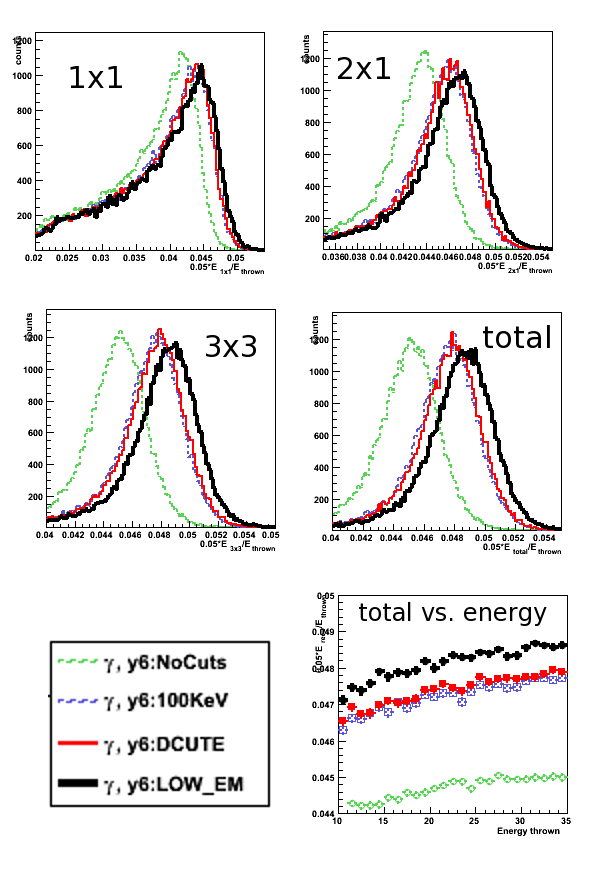
2009.12.08 Low EM timing study: 10KeV vs. 100KeV cut settings
Conclusions/dicsussion at the emc2 hypernew:
http://www.star.bnl.gov/HyperNews-star/get/emc2/3374.html
List of LOW_EM cuts and defaults
Low EM cut configurations (values in GeV)
- NoCuts: Default STAR geometry EM cuts
- LOW_EM:100KeV: All LOW_EM cuts are set to 100KeV
- LOW_EM:10KeV: (default) LOW_EM cuts (10KeV)
- DCUTE: All cuts are set to 10KeV, except for electron delta-rays DCUTE = 100KeV
QCD hard processes timing
Pythia QCD Monte-Carlo:
- Pythia pp@500GeV 2->2 hard QCD processes for parton pt>15GeV
- Full STAR y2009a (latest EEMC, v6.1 and TPC, v04 geometries)
- 50 events per file, 100 jobs
- BFC options and kumac details are here
Figure 1: QCD Total (GEANT/GSTAR+bfc) timing (seconds/event)

Figure 2: QCD GEANT/GSTAR timing (seconds/event)

Figure 3: QCD bfc.C timing (seconds/event)

EEMC single photon timing
EEMC single photons Monte-Carlo
- One photon per event
- Full STAR y2006h (latest EEMC, v6.1 and TPC, v04 geometries)
- flat in eta (1.08, 2.0), phi (0, 2pi), and energy (5-35 GeV)
- 250 events per file, 200 jobs
Figure 4: EEMC single photon Total (GEANT/GSTAR+bfc) timing (seconds/event)

Figure 5: EEMC single photon GEANT/GSTAR timing (seconds/event)

2009.12.17 Ecalgeo-v6.2: embedded LOW_EM cuts in the calorimeter geometry
Monte-Carlo setup:
- Throwing one photon per event
- Full STAR y2006h (latest EEMC-v6.2 and BEMC with LOW_EM cuts, rest of geometry from CVS)
- Throw particles flat in eta (1.08, 2.0), phi (0, 2pi), and energy (5-35 GeV)
- Using A2Emaker to get reconstructed Tower/SMD energy (no EEMC SlowSimulator in chain)
- Vertex z=0
- ~50K/per particle type
- Non-zero energy: 3 sigma above pedestal
Figure 1: (left) Endcap EMC sampling fraction (total calorimeter energy), (right) SMD-u sampling fraction
Red: (previous) ecalgeo-v6.1 with global LOW_EM option
(Note: same points as in this post, Fig. 1 lower left, label y6:LOW_EM)
Black: (new) ecalgeo-v6.2 (embedded LOW_EM cuts), no global LOW_EM option
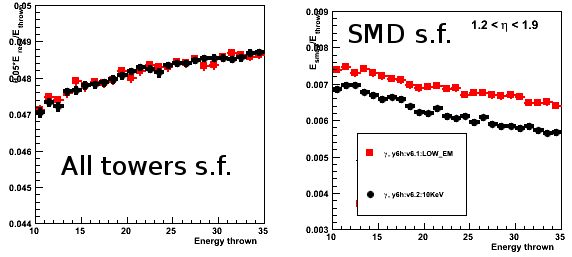
Figure 2: Pre-shower migrations
There is only a few events with pre1>4MeV with new simulations: potential problem with TPC geometry?
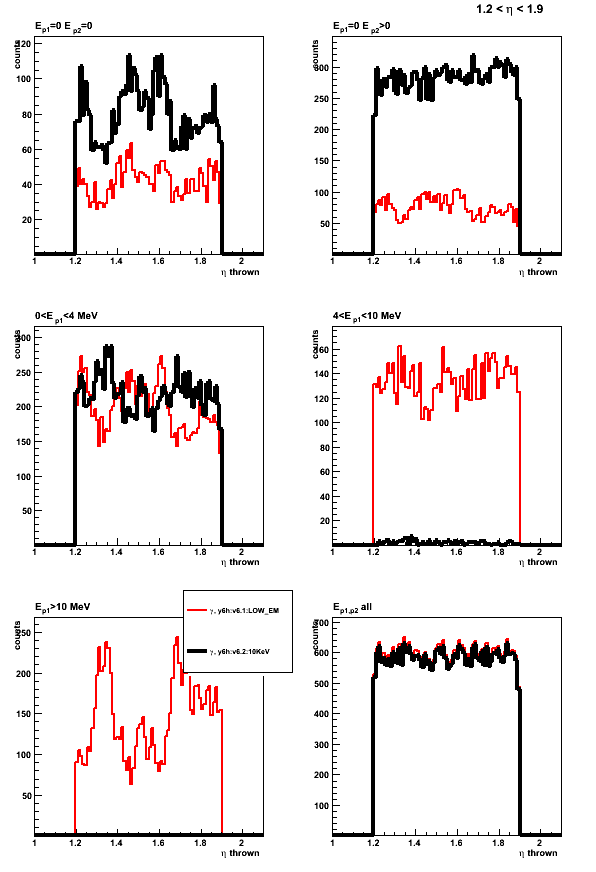
2009.12.20 Ecalgeo-v6.2: embedded LOW_EM cuts after TPC/EEMC overlap fix
Monte-Carlo setup:
- Throwing one photon per event
- Full STAR y2006h (latest EEMC-v6.2 and BEMC with LOW_EM cuts, rest of geometry from CVS)
- Throw particles flat in eta (1.08, 2.0), phi (0, 2pi), and energy (5-35 GeV)
- Using A2Emaker to get reconstructed Tower/SMD energy (no EEMC SlowSimulator in chain)
- Vertex z=0
- ~50K/per particle type
- Non-zero energy: 3 sigma above pedestal
Results: Update for the previous tests of EMC v6.2 geometry after fixing TPC/EEMC overlap
Figure 1: Endcap EMC sampling fraction: total calorimeter energy, pre1-, pre2-, post- shower layers, and SMD-u energy
Red: (previous) ecalgeo-v6.1 with global LOW_EM option
(Note: same points as in this post, Fig. 1 lower left, label y6:LOW_EM)
Black: (new) ecalgeo-v6.2 (embedded LOW_EM cuts), no global LOW_EM option
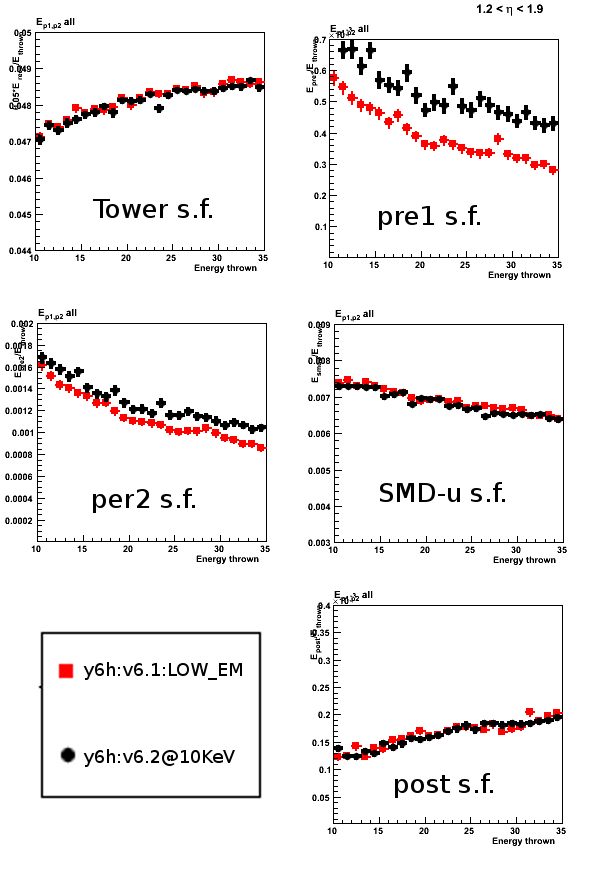
Figure 2: Pre-shower migrations
Change in TPC geometry seems to introduce a reasonable (small) change in pre-shower migration
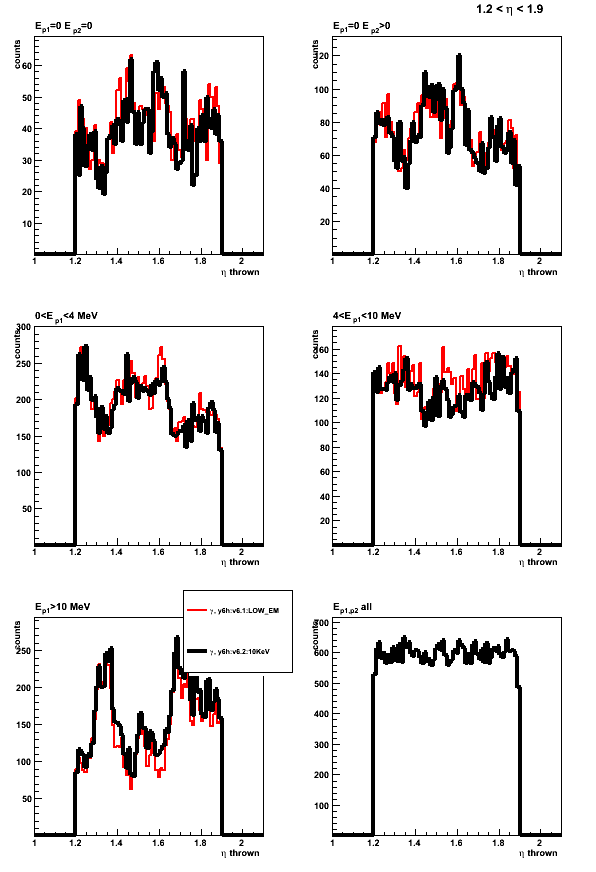
Photon-jet simulation request
Simulation needs with y2006/y2009 geometry
specific to the photon-jet analysis
* Update version of the previous simulation
request from December 18, 2008 (see Ref. [1])
Understanding effects of trigger, material budget differences,
and throughout comparison between 2006 and 2009 data
requires to have dedicated Monte-Carlo
data samples with both y2006 and y2009 geometries.
Requested samples
We request to produce the following set of
Monte-Carlo samples for the photon-jet analysis:
- S1: 1st priority
Dedicated (gamma filtered, Refs. [2-5]) data sample
for Pythia pp@200GeV prompt photon processes
with y2006 STAR geometry configuration
and partonic pt range 2-25GeV.Simulations configured with:
-
LOW_EM option in starsim (Ref. [6]).
Low cuts on electromagnetic processes in GSTAR -
y2006h geometry tag, which includes
latest Endcap EMC (v6.1) and TPC (v4) geometry fixes. -
Pythia 6.4 CDF Tune A or Perugia tunes (6.4.22)?
-
- S2: 1st priority
Dedicated (gamma filtered, Refs. [2-5]) data sample
for Pythia pp@200GeV hard QCD processes
with y2006 STAR geometry configuration
and partonic pt range 2-25GeV.Same simulation setup as for the sample S1.
- S3: 2nd priority
Pythia pp@200GeV prompt photon and hard QCD
processes with y2009 STAR geometry configuration
and partonic pt range 2-25GeV.Same simulation setup as for the sample S1
but with y2009a geometry tag. -
S4: 3rd priority
Pythia pp@500GeV prompt photon and hard QCD
processes with y2009 STAR geometry configuration
and partonic pt range 2-25GeV.Same simulation setup as for the sample S1
but with y2009a geometry tag.
Event number, CPU time, and disk space estimates
Below I provide some estimates of CPU and disk space
which are required to produce the data samples listed above.
These estimates are based on the previous (private)
production of the MC gamma-filtered events with y2006
geometry which was done at MIT computer cluster
by Michael Betancourt (Ref. [2,4-5]):
- E1 (prompt photons)
Pythia pp@200GeV prompt photon simulations
with ~7 pb^-1 luminosity:-
~60 days running time on a single CPU
-
~17Gb of disk space to store MuDst/geant files
-
Number of (filtered) events:
~ 30K for pt range 6-9GeV
~ 15K for pt range 9-15GeV
-
- E2 (QCD hard process)
Pythia pp@200 QCD hard process simulations
with (at least) 1 pb^-1 luminosity:-
~ 620 days running on a single CPU
(less than a week on a cluster with 100 CPUs) -
~ 150Gb of disk space to store MuDst/geant files
-
Number of (filtered) events:
~ 650K for pt range 6-9GeV
~ 300K for pt range 9-15GeV
-
Notes on the estimates:
- N1
Enabling LOW_EM option in GSTAR increases
the time estimates by ~40% (Ref. [7]). - N2
Additional production of jet trees will
require a disk space on the order of < 2%
of the total size of the MuDst/geant files. - N3
Additional production of gamma trees will also
require a disk space on the order of a few percents
of the total size of the MuDst/geant files.
References
-
Previous simulation request (Date: 2008, Dec 18):
http://www.star.bnl.gov/HyperNews-star/protected/get/starspin/3596.html -
Michael's document on
"Targeted MC procedure for the gamma-jet program at STAR":
http://drupal.star.bnl.gov/STAR/system/files/20080729_gammaFilter_by_MichaelBetancourt.pdf -
simulations with filtering readiness:
http://www.star.bnl.gov/HyperNews-star/protected/get/starsimu/387/1/1/2/1/1/2/3/1.html -
Filtered photon production with y2006 geometry:
http://www.star.bnl.gov/HyperNews-star/protected/get/phana/256.html -
More details on statistics needed and disk space estimates:
http://www.star.bnl.gov/HyperNews-star/protected/get/phana/297.html -
LOW_EM option in GSTAR:
http://www.star.bnl.gov/HyperNews-star/protected/get/phana/371.html -
Time estimates with and without LOW_EM option:
2010
Year 2010 posts
01 Jan
January 2010 posts
2010.01.04 y2006 vs y2009 EEMC pre-shower migration
Monte-Carlo setup:
- Throwing one photon per event
- Full STAR y2006h/y2009a
- Throw particles flat in eta (1.08, 2.0), phi (0, 2pi), and energy (5-35 GeV)
- Using A2Emaker to get reconstructed Tower/SMD energy (no EEMC SlowSimulator in chain)
- Vertex z=0
- ~50K/per particle type
- Non-zero energy: 3 sigma above pedestal
Geometry configurations:
- y6h:v6.2:10KeV y2006h after fixing TPC/EEMC overlap (CVS:2009/12/17)
- y6h:10KeV y2006h Mising TPC material bug is resolved (CVS:2009/12/29)
- y9a:10KeV y2009a after Mising TPC material bug is resolved (CVS:2009/12/29)
Note: results are with CVS before "15Deg rotated volume" bug being fixed
Figure 1:Pre-shower migration: y2006h (red - CVS:2009/12/17) vs. y2006h (black - CVS:2009/12/29)

Figure 2: Pre-shower migration: y2006h (red) vs. y2009a (black) all with CVS:2009/12/29

2010.01.07 EEMC response to single photons with y2006h vs y2009a geometries
Monte-Carlo setup
- Throwing one photon per event
- Full STAR y2006h/y2009a configurations
- Throw particles flat in eta (1.08, 2.0), phi (0, 2pi), and energy (5-35 GeV)
- Using A2Emaker to get reconstructed Tower/SMD energy (no EEMC SlowSimulator in chain)
- Vertex z=0
- ~50K/per particle type
- Non-zero energy: 3 sigma above pedestal
Geometry configurations:
- y6h:10KeV (black) - y2006h with emc_10KeV
- y9a:10KeV (red) - y2009a with emc_10KeV
STAR geometry includes the latest "15Deg rotated volume" bug bug fix
Figure 1: EEMC sampling fraction
(left) vs. thrown photon energy (with 1.2 < eta < 1.9 cut)
(right) vs. thrown photon eta
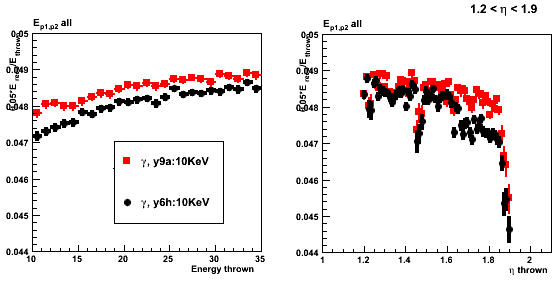
Figure 3: Shower shapes (u plane)

Figure 4: Shower shape ratios (u plane)

Figure 5: Pre-shower migration (1.2 < eta < 1.9)

Figure 6: Average pre-shower1 energy vs. thown photon position in EEMC
(left) y2009a with emc_10KeV
(right) y2006h with emc_10KeV
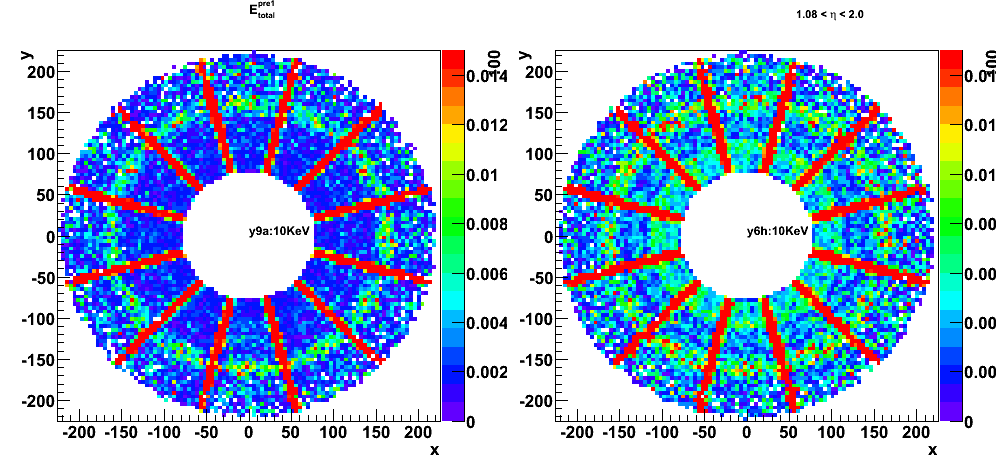
2010.01.08 EEMC response 2006 vs. 2009: phi cuts
EEMC migration plots with cuts on TPC sector boundaries
Click here for results before phi cuts
Monte-Carlo setup
- Throwing one photon per event
- Full STAR y2006h/y2009a configurations
- Throw particles flat in eta (1.08, 2.0), phi (0, 2pi), and energy (5-35 GeV)
- Using A2Emaker to get reconstructed Tower/SMD energy (no EEMC SlowSimulator in chain)
- Vertex z=0
- ~50K/per particle type
- Non-zero energy: 3 sigma above pedestal
Geometry configurations:
- y6h:10KeV (black) - y2006h with emc_10KeV option
- y9a:10KeV (red) - y2009a with emc_10KeV option
Figure 1: Average pre-shower1 energy vs. thown photon position in EEMC
with cuts on TPC sector boundaries: cos(12*(phi-Pi/6.)) < -0.65 (similar plot before phi cuts)
(left) y2009a with emc_10KeV
(right) y2006h with emc_10KeV

Figure 2: Pre-shower 1 sampling fraction (E_pre1/E_thrown) vs. thrown eta

Figure 3: EEMC sampling fraction
(left) vs. thrown photon energy (with 1.2 < eta < 1.9 cut)
(right) vs. thrown photon eta

2010.01.12 W test sample QA
All plost from second (with vertex distribution) test W-sample from Lidia/Jason.
generated files are from /star/rcf/test/Wprod_test2/
The previous sample with fixed (zero) vertex can be found was announced here:
http://www.star.bnl.gov/HyperNews-star/protected/get/starsimu/435.html
Figure 1: Electron from W decay (a) eta, (b) phi, (c) pt and (d) energy distributions
from geant record (no kinematic cuts)
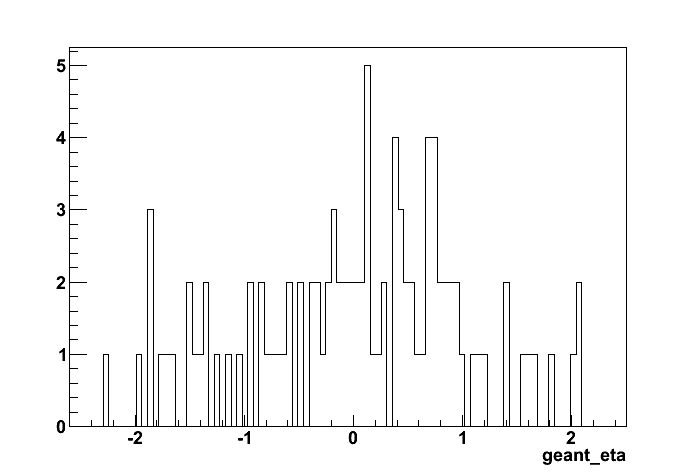

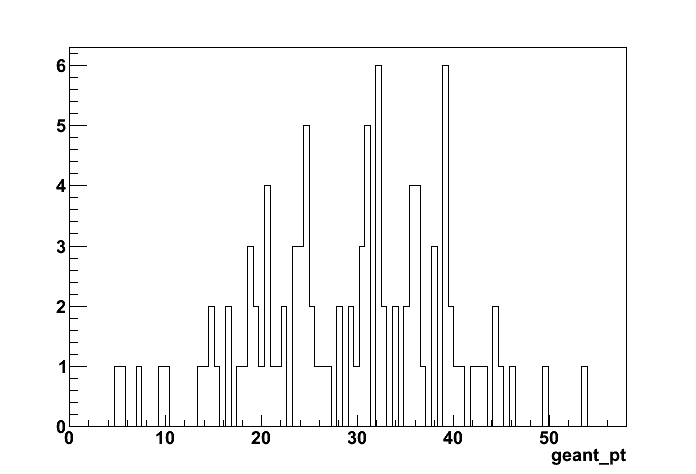
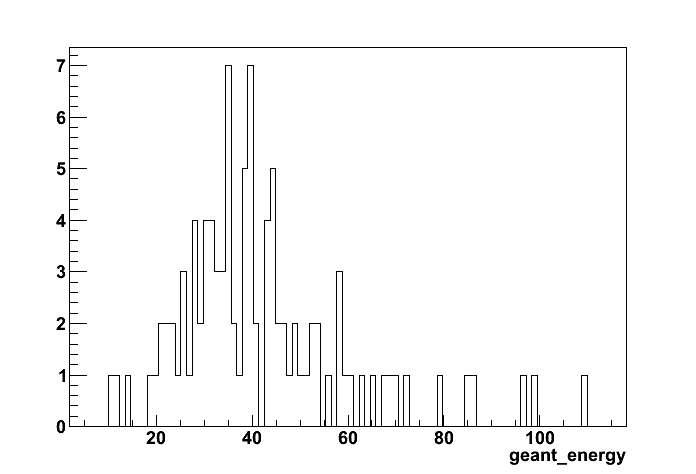
Figure 2: Reconstructed vs. geant vertex (Cuts: abs(geant_eta_electron) < 1)
(left) difference, (right) ratio
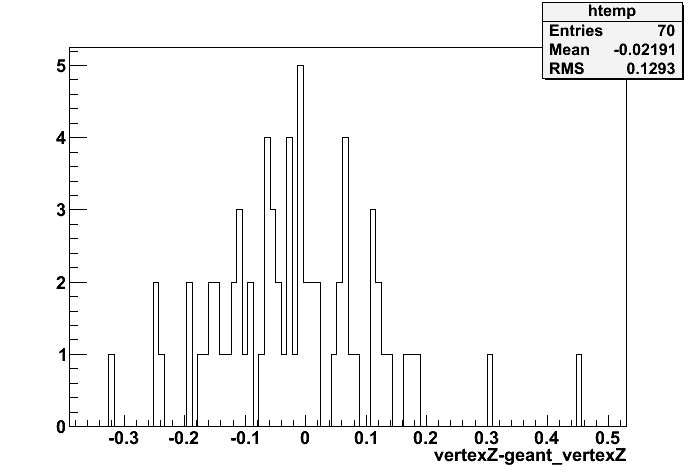
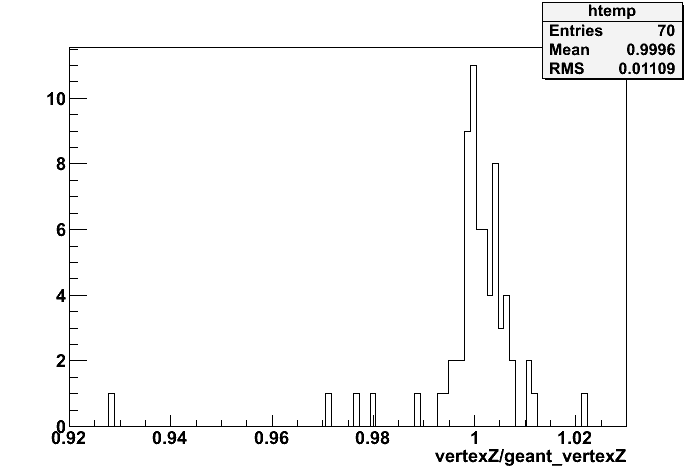
Figure 3:
(left) Correlation between thrown and reconsructed energy: abs(geant_eta_electron) < 1
(right) ratio of the reconsructed to thrown energy (Bemc_Etow > 25)
Reconstructed energy is the total energy in all Barrel towers
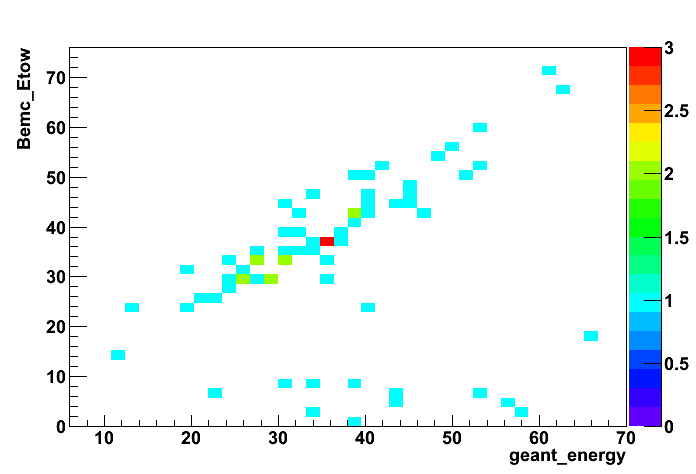
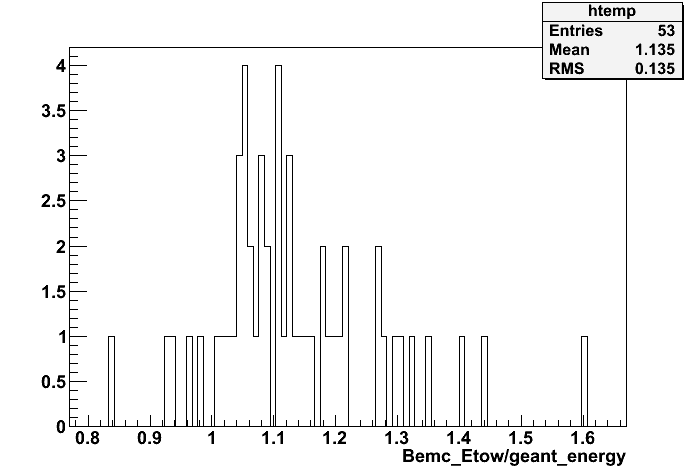
Data base setup
The follwoing DB tables are used to read MuDst (dbMk->SetDateTime(20090325,0)):
StEmcSimulatorMaker:INFO - loaded a new bemcPed table with beginTime 2009-03-24 22:16:13 and endTime 2009-03-26 06:03:44
StEmcSimulatorMaker:INFO - loaded a new bemcStatus table with beginTime 2009-03-24 02:16:58 and endTime 2009-03-26 04:07:02
StEmcSimulatorMaker:INFO - loaded a new bemcCalib table with beginTime 2008-12-15 00:00:02 and endTime 2037-12-31 12:00:00
StEmcSimulatorMaker:INFO - loaded a new bemcGain table with beginTime 1999-01-01 00:08:00 and endTime 2037-12-31 12:00:00
StEmcSimulatorMaker:INFO - loaded a new bprsPed table with beginTime 2008-03-04 10:30:56 and endTime 2037-12-31 12:00:00
StEmcSimulatorMaker:INFO - loaded a new bprsStatus table with beginTime 2008-12-15 00:00:00 and endTime 2037-12-31 12:00:00
StEmcSimulatorMaker:INFO - loaded a new bprsCalib table with beginTime 1999-01-01 00:10:00 and endTime 2037-12-31 12:00:00
StEmcSimulatorMaker:INFO - loaded a new bprsGain table with beginTime 1999-01-01 00:08:00 and endTime 2037-12-31 12:00:00
StEmcSimulatorMaker:INFO - loaded a new bsmdePed table with beginTime 2009-03-24 15:42:29 and endTime 2009-03-25 11:24:55
StEmcSimulatorMaker:INFO - loaded a new bsmdeStatus table with beginTime 2009-03-24 15:42:29 and endTime 2009-03-25 11:24:55
StEmcSimulatorMaker:INFO - loaded a new bsmdeCalib table with beginTime 2002-11-14 00:01:00 and endTime 2037-12-31 12:00:00
StEmcSimulatorMaker:INFO - loaded a new bsmdeGain table with beginTime 1999-01-01 00:08:00 and endTime 2037-12-31 12:00:00
StEmcSimulatorMaker:INFO - loaded a new bsmdpPed table with beginTime 2009-03-24 15:42:29 and endTime 2009-03-25 11:24:55
StEmcSimulatorMaker:INFO - loaded a new bsmdpStatus table with beginTime 2009-03-24 15:42:29 and endTime 2009-03-25 11:24:55
StEmcSimulatorMaker:INFO - loaded a new bsmdpCalib table with beginTime 2002-11-14 00:01:00 and endTime 2037-12-31 12:00:00
StEmcSimulatorMaker:INFO - loaded a new bsmdpGain table with beginTime 1999-01-01 00:08:00 and endTime 2037-12-31 12:00:00
StEmcSimulatorMaker:INFO - loaded a new bemcTriggerStatus table with beginTime 2009-03-23 07:50:04 and endTime 2009-04-01 18:10:03
StEmcSimulatorMaker:INFO - loaded a new bemcTriggerPed table with beginTime 2009-03-20 04:11:43 and endTime 2009-03-30 20:00:05
StEmcSimulatorMaker:INFO - loaded a new bemcTriggerLUT table with beginTime 2009-03-23 07:50:04 and endTime 2009-04-03 22:08:11
2010.01.13 W test sample QA: Pass 2
http://drupal.star.bnl.gov/STAR/node/16704
QA of the test W-sample from Lidia/Jason.
generated MuDst are from /star/simu/jwebb/01-11-2010-w-test-production/
QA plots for the previous pass can be found here
Two channels being analyzed:
- wtest10000 W+ --> e+ nu (shown by black line)
- wtest10001 W- --> e- nu (shown by red line)
Cuts: |geant_eta_lepton| < 1
Discussions can be found here:
http://www.star.bnl.gov/HyperNews-star/protected/get/starsimu/440.html
Figure 1: (left) Reconstructed vertex z distribution
(right) reconstructed minus geant z-vertex
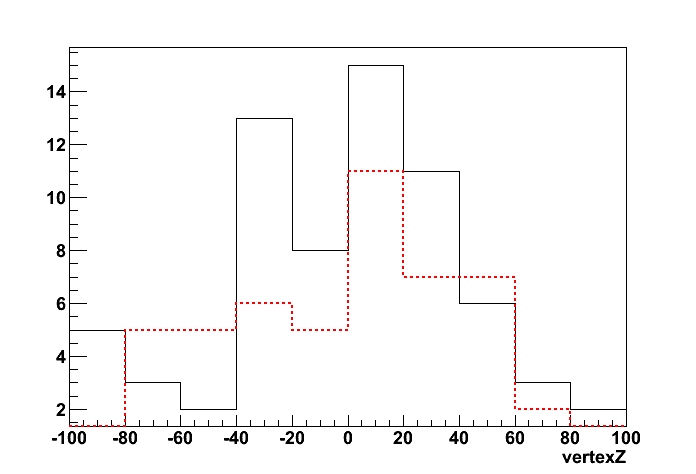
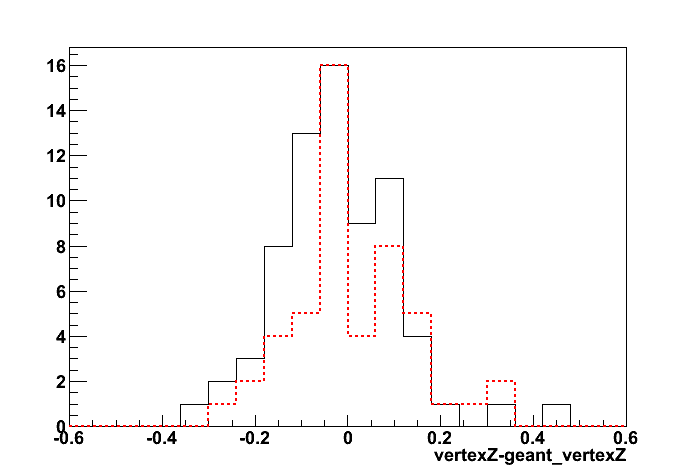
Figure 2: E2x2/E_geant energy ratio
Black: positron from W+, mean value= 0.972973;
Red - electron from W- mean value = 0.969773
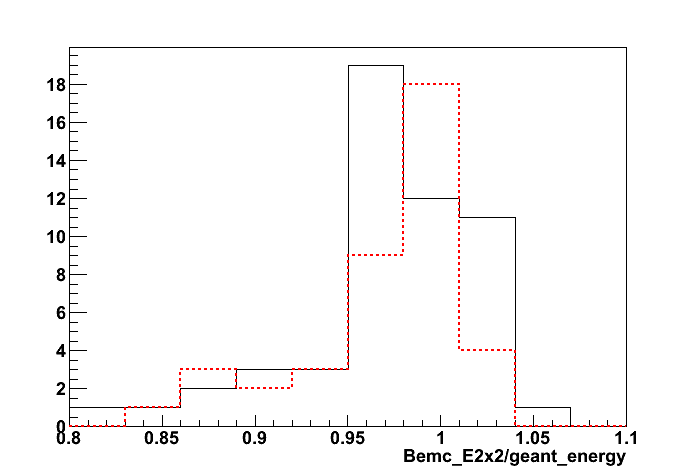
Figure 3: E1x1/E_geant (highest tower) energy ratio
Black: positron from W+, mean value= 0.815287;
Red - electron from W- mean value = 0.812098
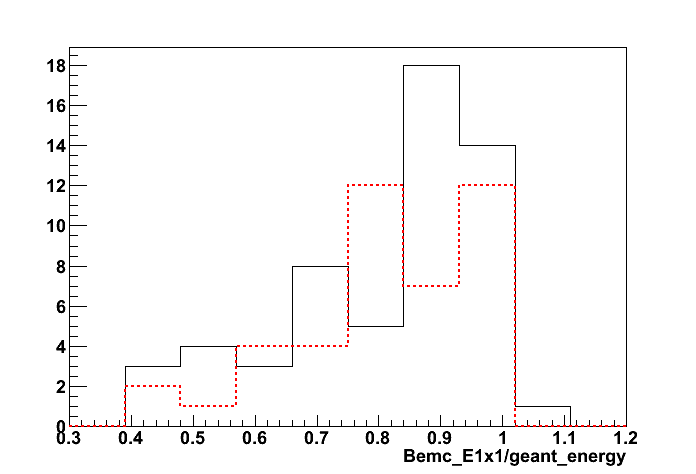
Update on Jan 14, 2010
Figure 4: Lepton E2x2/E_geant energy ratio
| Parameter | black: positron from W+ | red: electron from W- |
| gaus-Constant | 1.60709e+01 , err=3.08565e+00 | 1.56834e+01 , err=4.71967e+00 |
| gaus-Mean | 9.85514e-01 , err=4.94309e-03 | 9.86118e-01 , err=5.43577e-03 |
| gaus-Sigma | 3.15205e-02 , err=3.73952e-03 | 2.52009e-02 , err=6.57793e-03 |
| Hist-Mean | 0.972973 | 0.969773 |
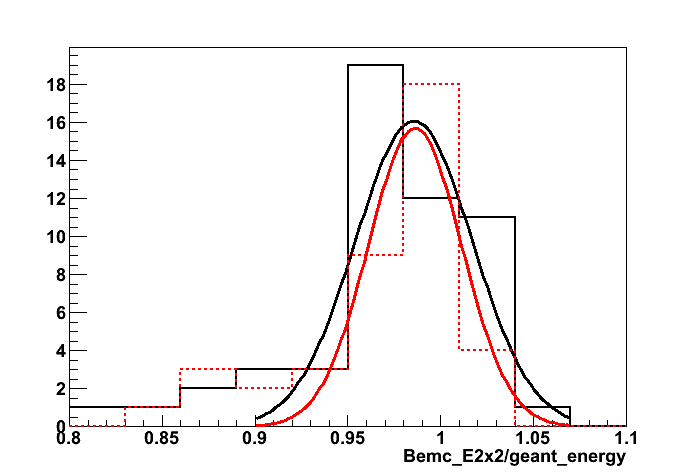
Figure 5: Lepton E3x3/E_geant energy ratio
| Parameter | black: positron from W+ | red: electron from W- |
| gaus-Constant | 1.48719e+01 , err=2.82186e+00 | 1.35741e+01 , err=3.36776e+00 |
| gaus-Mean | 9.89924e-01 , err=5.72959e-03 | 9.83056e-01 , err=6.28736e-03 |
| gaus-Sigma | 3.37758e-02 , err=4.24983e-03 | 3.00597e-02 , err=6.06841e-03 |
| Hist-Mean | 0.975662 | 0.974163 |
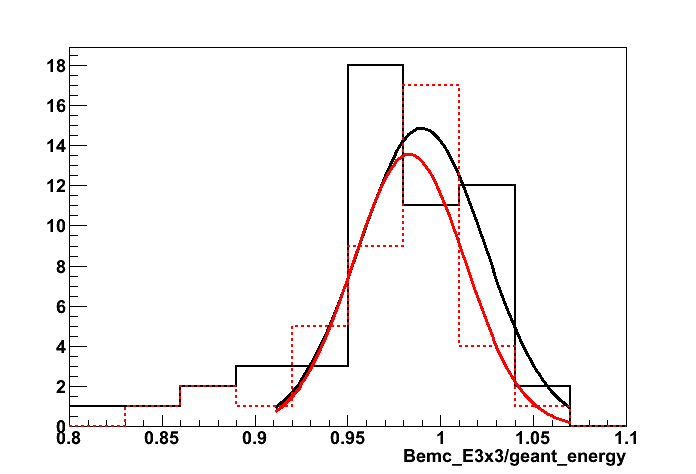
2010.01.15 W test sample QA: Pass 3
QA of the test W-sample from Lidia/Jason.
generated MuDst are from /star/data08/users/starreco/recowtest/
QA plots for the previous pass 2 can be found here
QA plots for the previous pass 1 can be found here
Two channels being analyzed:
- wtest10000 W+ --> e+ nu (shown by black line)
- wtest10001 W- --> e- nu (shown by red line)
Cuts: |geant_eta_lepton| < 1
Discussions can be found here:
http://www.star.bnl.gov/HyperNews-star/protected/get/starsimu/443.html
Figure 1: Reconstructed minus geant z-vertex
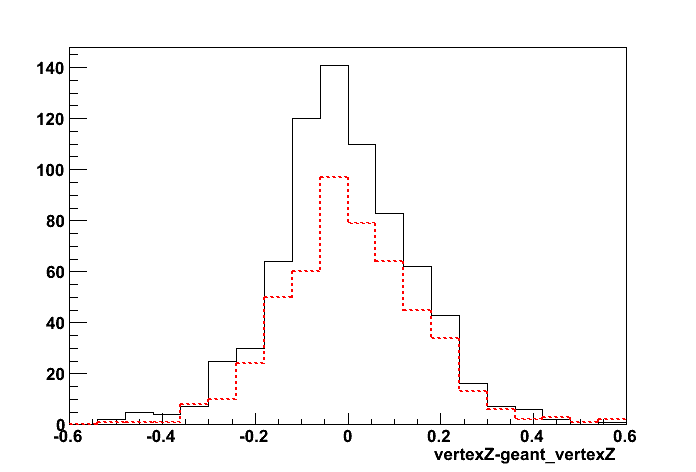
Figure 2: Lepton E2x2/E_geant energy ratio
| Parameter | black: positron from W+ | red: electron from W- |
| gaus-Constant | 6.24023e+01 , err=3.46979e+00 | 4.73536e+01 , err=3.16029e+00 |
| gaus-Mean | 9.79982e-01 , err=1.69854e-03 | 9.79787e-01 , err=1.68813e-03 |
| gaus-Sigma | 3.52892e-02 , err=1.40963e-03 | 3.15336e-02 , err=1.40759e-03 |
| Hist-Mean | 0.972122 | 0.975073 |
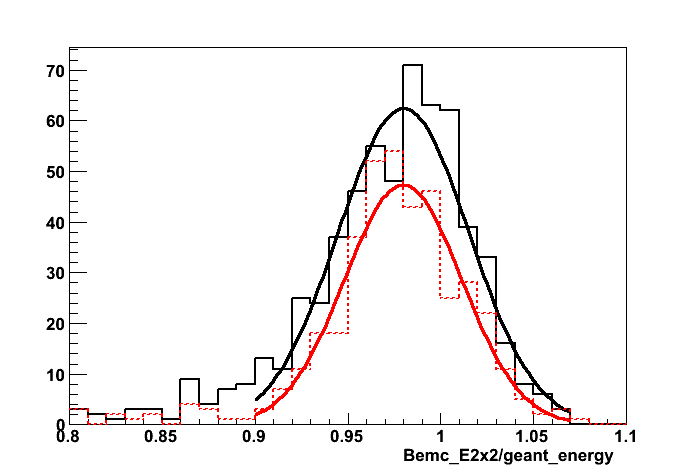
Figure 3: Lepton E3x3/E_geant energy ratio
| Parameter | black: positron from W+ | red: electron from W- |
| gaus-Constant | 6.33596e+01 , err=3.58862e+00 | 4.72335e+01 , err=3.19552e+00 |
| gaus-Mean | 9.83287e-01 , err=1.72276e-03 | 9.83632e-01 , err=1.67661e-03 |
| gaus-Sigma | 3.45514e-02 , err=1.48019e-03 | 3.05224e-02 , err=1.38944e-03 |
| Hist-Mean | 0.974372 | 0.977858 |
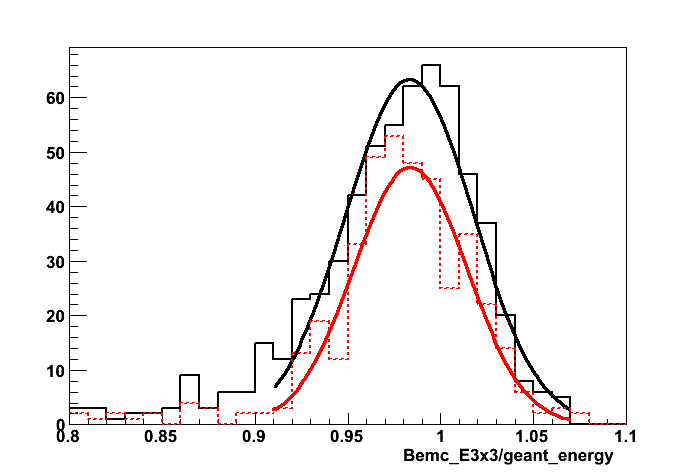
2010.01.18 EEMC response 2006 vs. 2009: typo in TPC volume size bug fix
Click here for previous study before TPC typo fix
Monte-Carlo setup
- Throwing one photon per event
- Full STAR y2006h/y2009a configurations
- Throw particles flat in eta (1.08, 2.0), phi (0, 2pi), and energy (5-35 GeV)
- Using A2Emaker to get reconstructed Tower/SMD energy (no EEMC SlowSimulator in chain)
- Vertex z=0
- ~50K/per particle type
- Non-zero energy: 3 sigma above pedestal
Before and after the fix comparison
Geometry configurations:
- y6h:10KeV:old (red) - y2006h with emc_10KeV option
- y6h:10KeV (black) - y2006h with emc_10KeV option, after TPC typo fixed
Figure 1: Pre-shower migration (1.2 < eta < 1.9)

y2006h vs. y2009a comparison after a TPC typo fix
Geometry configurations:
- y9a:10KeV (red) - y2009a with emc_10KeV option
- y6h:10KeV (black) - y2006h with emc_10KeV option
Figure 2: Pre-shower migration (1.2 < eta < 1.9): y2006h vs. y2009a

2010.01.18 W test sample: Cluster ratios and skewed gaussian fits
W test sample from Lidia/Jason. MuDst's from /star/data08/users/starreco/recowtest/
Two channels being analyzed:
- wtest10000 W+ -> e+ nu
- wtest10001 W- -> e- nu
Figure 1: Lepton yield vs. rapidity (no cuts)
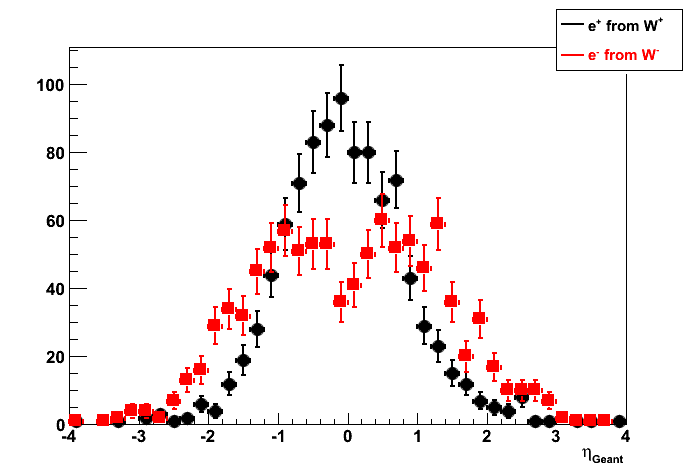
Figure 2: Lepton yield vs. pt and energy
(left) no rapidity cuts
(right) |lepton_eta| < 1
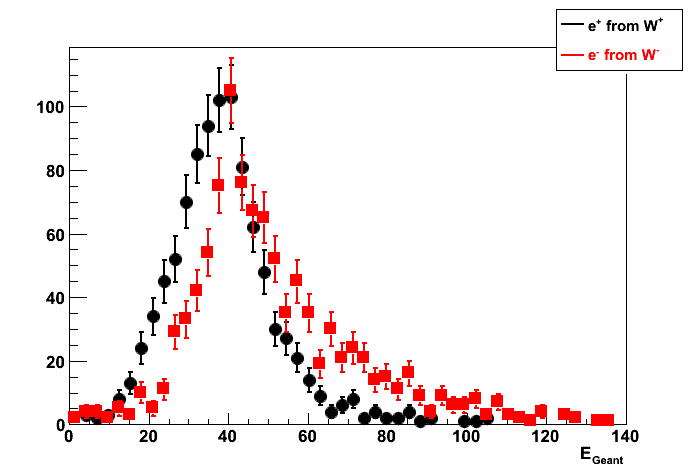
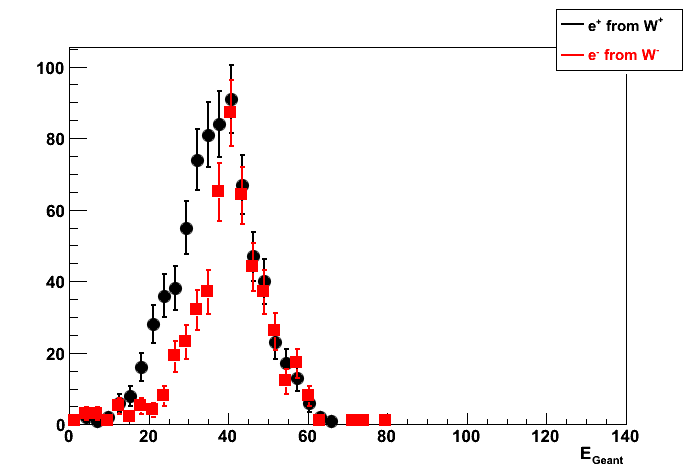
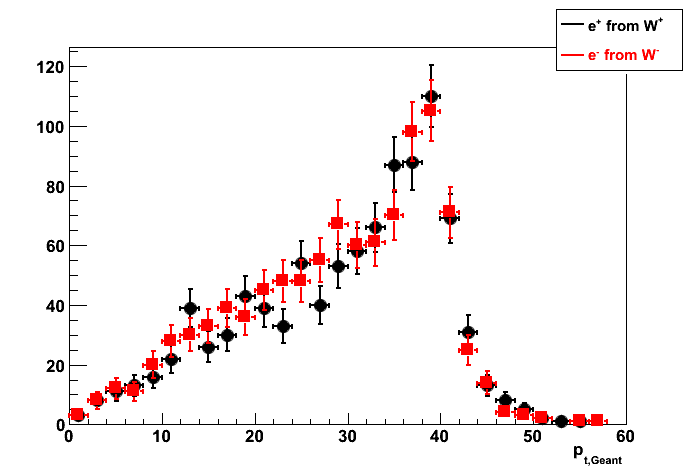
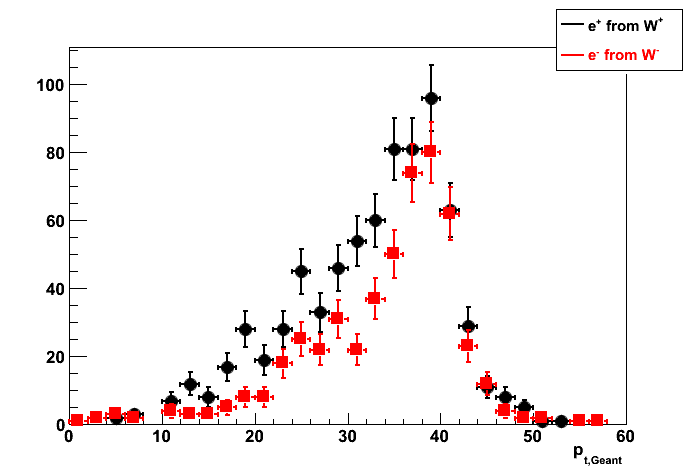
Cluster energy vs. original lepton energy
All plots below with |lepton_eta| < 1
Skewed gaussian fits: [const]*exp(-0.5*((x-[mean])/([sigma]*(1+[skewness]*(x-[mean]))))**2)
Figure 3: Lepton E1x1/E_geant energy ratio
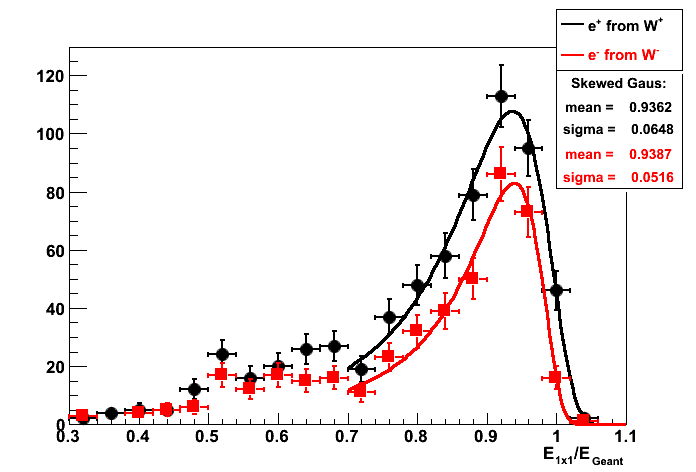
2010.01.26 Endcap/Barrel clustering with official W-MC
Simulations: official pp 500GeV pythia W production
Two channels being analyzed:
- W+ -> e+ nu (rcf10010*.root)
- W- -> e- nu (rcf10011*.root)
Lepton from W in the Endcap: 1.2 < eta_lepton < 1.9
Figure 1: Lepton yield vs. energy
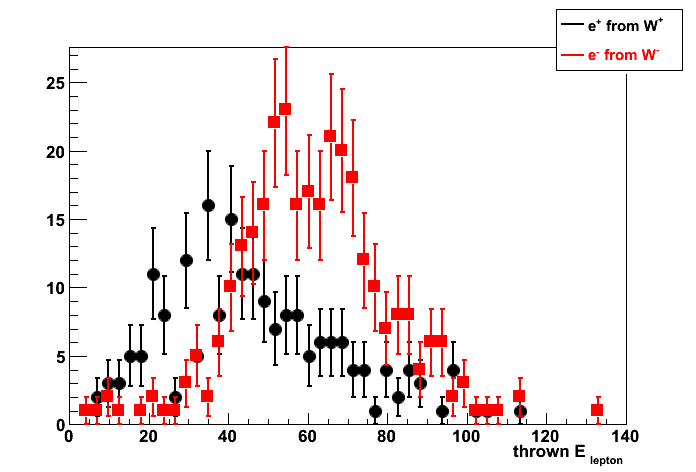
Figure 2: Lepton (left) E1x1/E_thrown and (right) E2x2/E_thrown energy ratio
Skewed gaussian fits: [const]*exp(-0.5*((x-[mean])/([sigma]*(1+[skewness]*(x-[mean]))))**2)
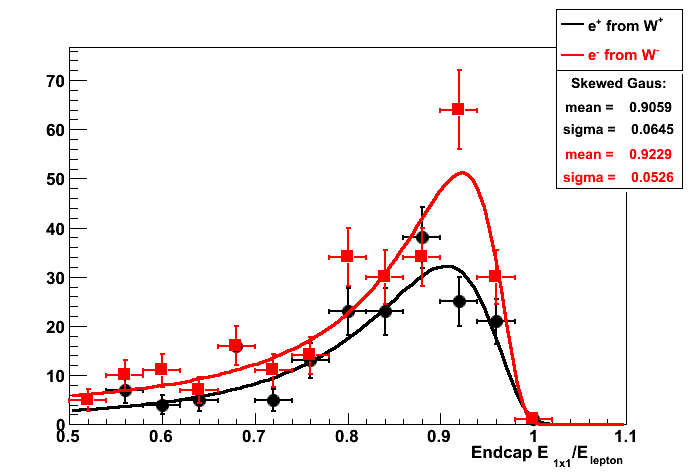
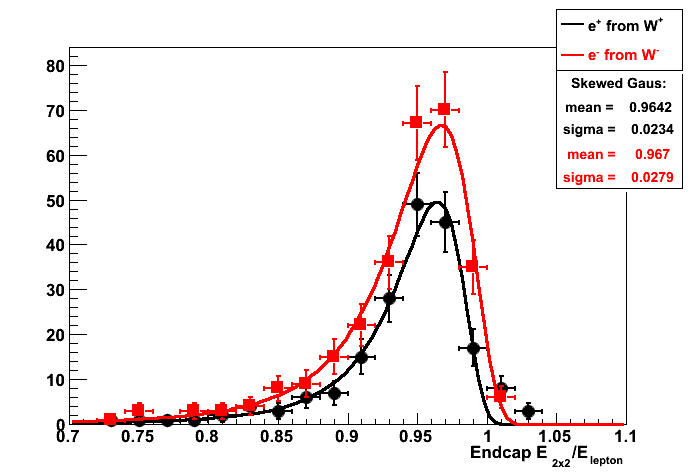
Figure 3: Endcap EMC lepton E3x3/E_thrown energy ratio
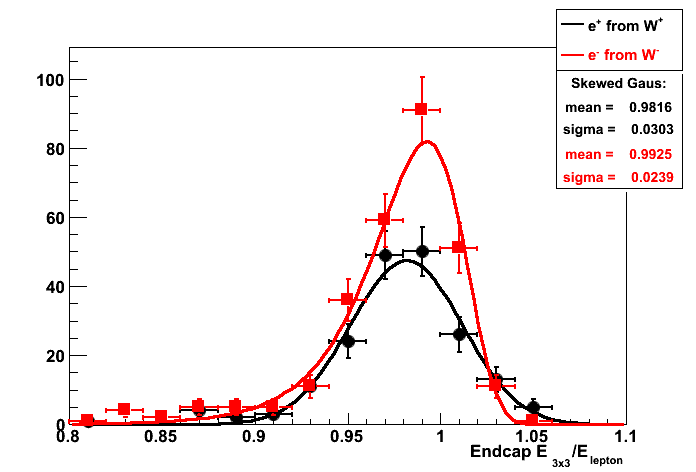
Figure 4: Endcap 2x2 sampling fraction (s.f.) vs. thrown lepton (left) energy and (right) eta
S.f. is defined as an average E_2x2/E_thrown for E_2x2/E_thrown>0.8
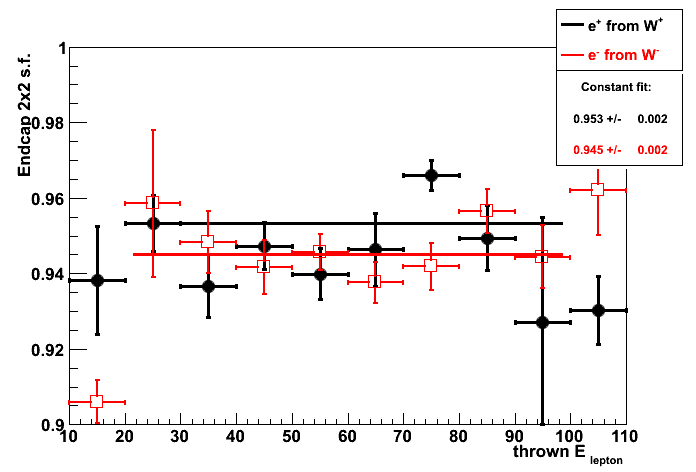
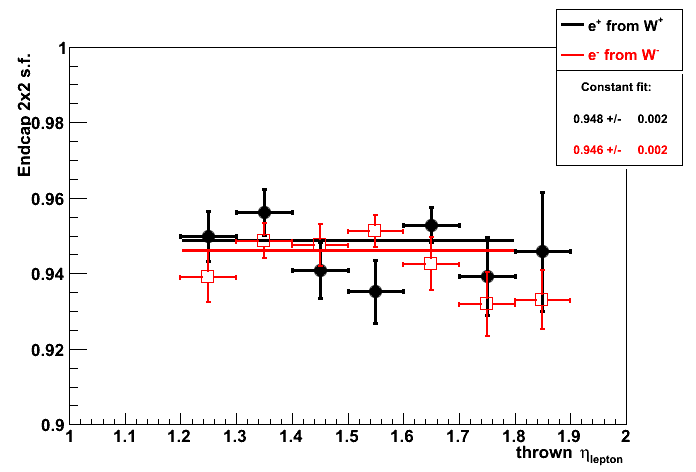
Figure 5: Endcap 3x3 sampling fraction (s.f.) vs. thrown lepton (left) energy and (right) eta
S.f. is defined as an average E_3x3/E_thrown for E_3x3/E_thrown>0.8


Lepton from W in the Barrel: |eta_lepton| <1
Figure 6: Lepton yield vs. energy
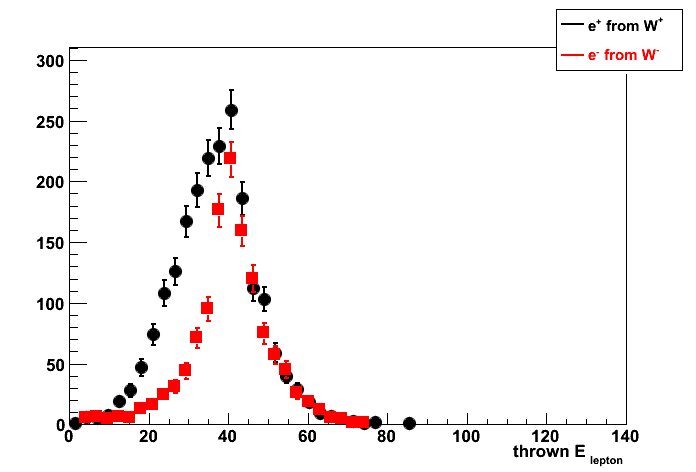
Figure 7: Lepton (left) E1x1/E_thrown and (right) E2x2/E_thrown energy ratio
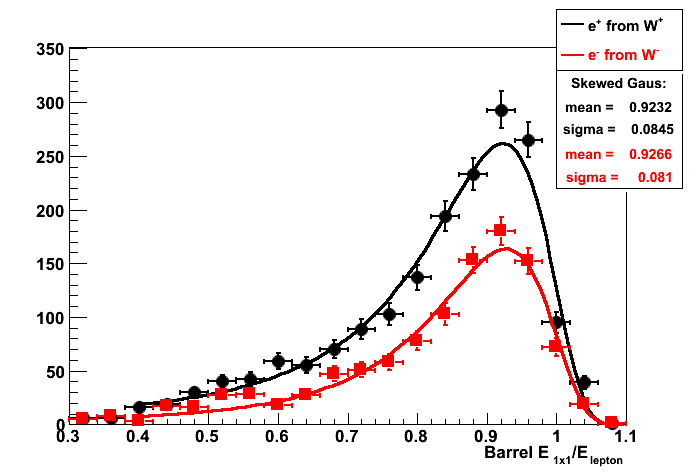
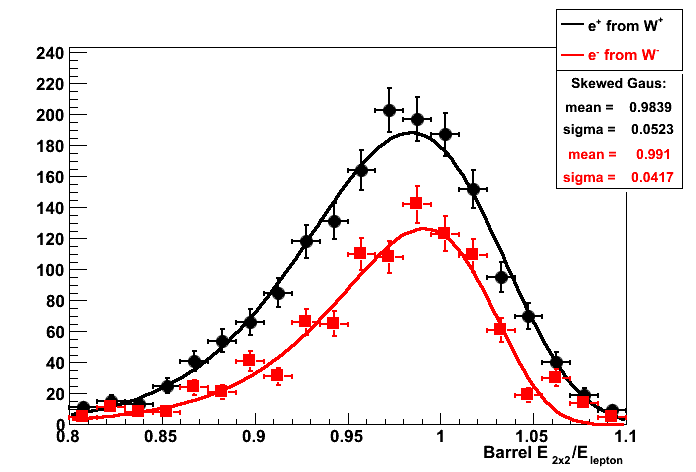
Figure 8: Barrel EMC lepton E3x3/E_thrown energy ratio
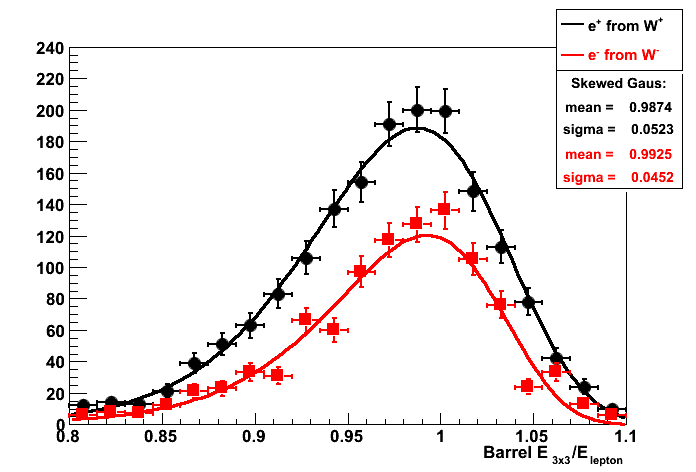
Figure 9: Barrel 2x2 s.f. vs. thrown lepton (left) energy and (right) eta
S.f. is defined as an average E_2x2/E_thrown for E_2x2/E_thrown>0.8
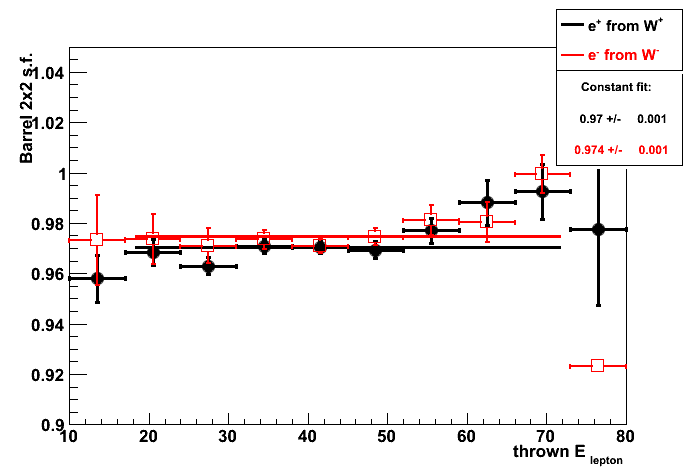
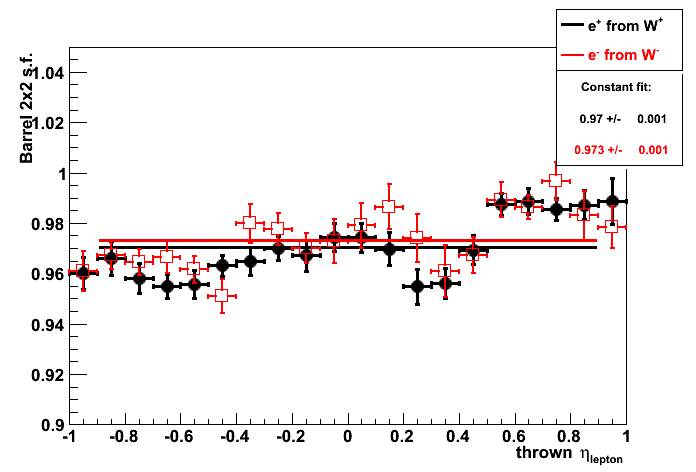
Figure 10: Barrel 3x3 s.f. vs. thrown lepton (left) energy and (right) eta
S.f. is defined as an average E_3x3/E_thrown for E_3x3/E_thrown>0.8
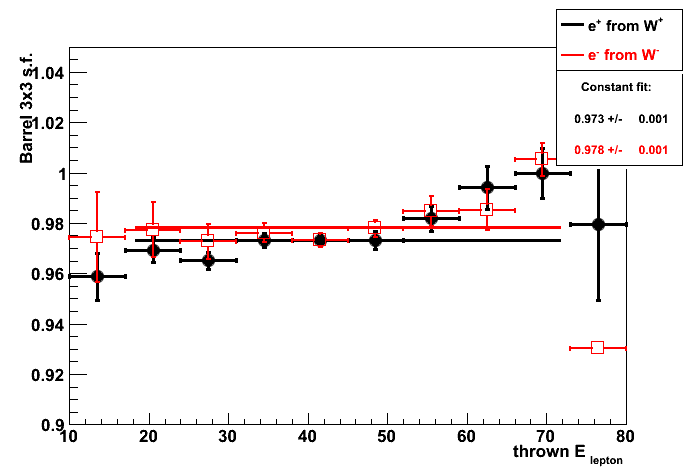
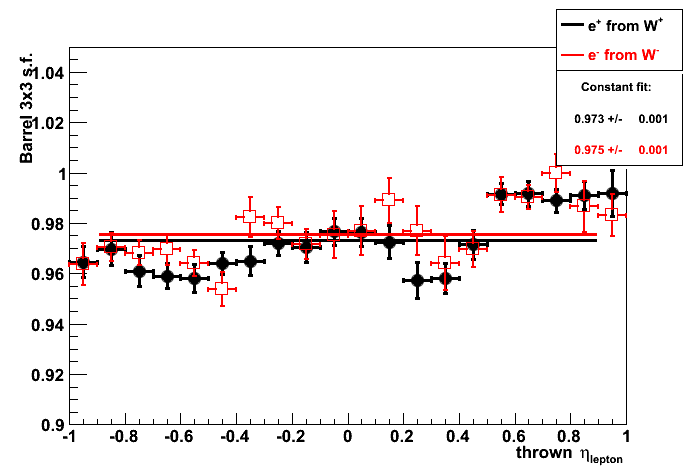
02 Feb
February 2010 posts
2010.02.08 StEemcGammaFilterMaker QA: QCD vs. gamma-jet ccept/reject rates
StEemcGammaFilterMaker QA
Pythia generated processes
| Pythia gamma-jet | Pythia QCD 2->2 processes |
| 14 f + fbar -> g + gamma | 11 f + f' -> f + f' (QCD) |
| 18 f + fbar -> gamma + gamma | 12 f + fbar -> f' + fbar' |
| 29 f + g -> f + gamma | 13 f + fbar -> g + g |
| 114 g + g -> gamma + gamma | 28 f + g -> f + g |
| 115 g + g -> g + gamma | 53 g + g -> f + fbar |
| 68 g + g -> g + g |
Number of generated events per parton pt bin
| Number of generated events (100events/job) |
||||||
| Parton pt range (GeV) | 2-3 | 3-4 | 4-6 | 6-9 | 9-15 | 15-25 |
| Pythia gamma-jet | 50K | 50K | 50K | 50K | 50K | 50K |
| Pythia QCD 2->2 processes | 100K | 100K | 50K | 50K | 50K | 50K |
Filter configuration
| Filter parameter | Value | Notes |
| mConeRadius | 0.24 | |
| mSeedThreshold | 2.5 | Cluster seed energy threshold |
| mClusterThreshold | 3.7 | Cluster Et threshold |
| mEtaLow | 0.9 | EEMC acceptance |
| mEtaHigh | 2.1 | EEMC acceptance |
| mSmearEnergy | 0 | Disabled |
| mThrowTracks | 0 | Disabled |
| mCalDepth | 279.5 | ZDC SMD depth |
| mMinPartEnergy | 1e-05 | Disabled by mThrowTracks=0 |
| mHadronScale | 0.4 | Downscale factor for hadron energy |
| mFilterMode | 0 | Accepting all events |
stasim/Pythia options
- detp geometry y2006h
- Calorimeter cut for electromagnetic processes: emc_10keV
- call pytune(100): PYTUNE v1.015; CDF Tune A
Figures
Figure 1: Pythia Eemc gamma filter QA:
(left) False rejection, (right) fraction of accepted events

Comments
- Overall false rejection is < 0.02% (10^-4)
for both QCD and gamma-jet simulations. - In parton pt range 6-15 GeV the acceptance rate
for the gamma-jet MC is ~ 50%
(I think this is due to rapidity fiducial cut,
otherwise it should be closer to 100%).
For the QCD sample (in the same pt region)
acceptance rate is 8-25%. - Somehow for highest parton pt filter acceptance is the
same for gamma-jet and QCD Monte-Carlo.
2010.02.09 BFC and Pythia QA: relative to trigger
QCD and gamma-jet data samples are described here
Pythia filter configuration
StEemcGammaFilter:: running the TEST mode (accepting all events). Set mFilterMode=1 to actually reject events
StEemcGammaFilter:: mConeRadius 0.22 mSeedThreshold 2.1 mClusterThreshold 3.25 mEtaLow 0.95 mEtaHigh 2.1
StEemcGammaFilter:: mCalDepth 279.5 mMinPartEnergy 1e-05 mHadronScale 0.4 mFilterMode 0 mPrintLevel 0
BFC filter configuration
StChain:INFO - Init() : Seed energy threshold = 2.8 GeV
StChain:INFO - Init() : Cluster eT threshold = 4.2 GeV
StChain:INFO - Init() : Maximum vertex = +/- 120 cm
StChain:INFO - Init() : Running the TEST mode (accepting all events). Set mFilterMode=1 to actually reject events in BFC
Accept/Reject relative to the total number of Pythia generated events
Figure 1: Fraction of accepted events

Figure 2: False rejection (Y-axis scale is 10^-3)
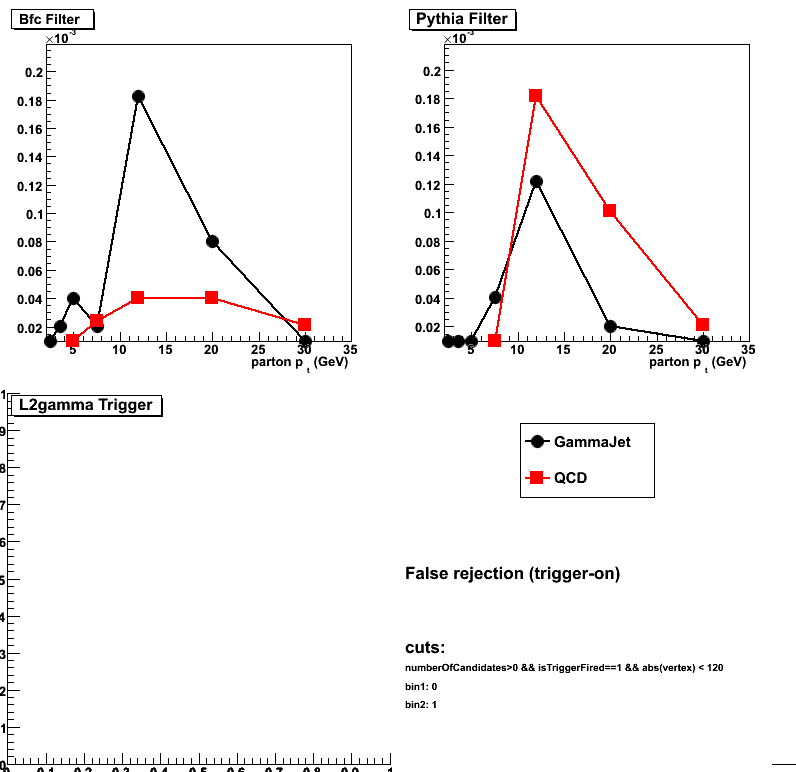
Accept/Reject relative to the number of triggered events
Figure 3: Fraction of accepted events (relative to triggered events)
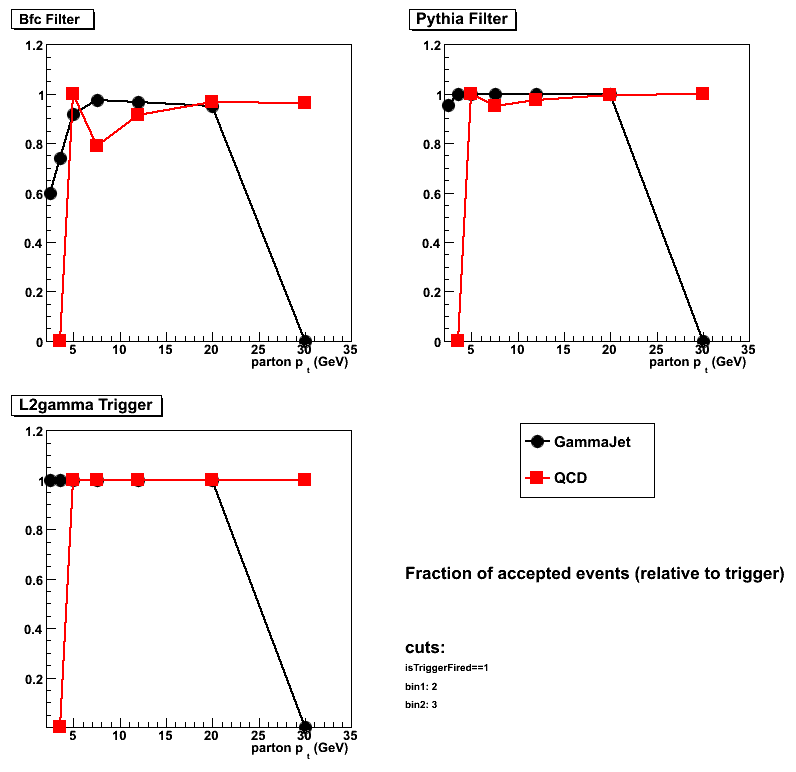
2010.02.10 Money plots for W cross section
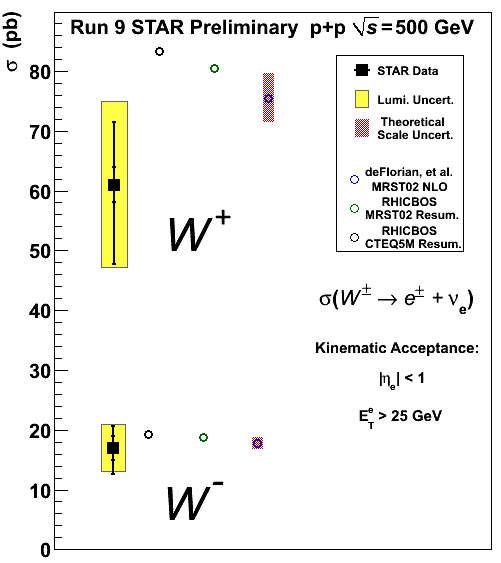
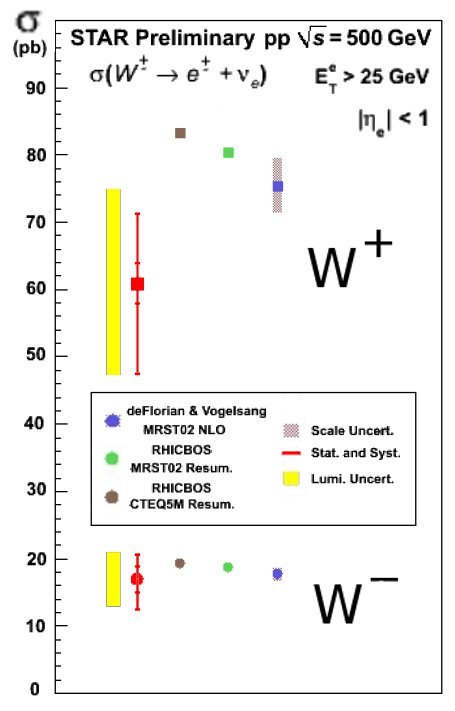
2010.02.11 BFC and Pythia QA: Gain no-gain-spread, mean=1.05
Click here for discussion and results with spread=0.05/gain=0.95
QCD and gamma-jet data samples are described here
Resultys without gain shift can be found here
(Note: ignore parton pt=25-35GeV for the gamma-jet sample since all jobs failed)
Pythia filter configuration
StEemcGammaFilter:: running the TEST mode (accepting all events). Set mFilterMode=1 to actually reject events
StEemcGammaFilter:: mConeRadius 0.22 mSeedThreshold 2.1 mClusterThreshold 3.25 mEtaLow 0.95 mEtaHigh 2.1
StEemcGammaFilter:: mCalDepth 279.5 mMinPartEnergy 1e-05 mHadronScale 0.4 mFilterMode 0 mPrintLevel 0
BFC filter configuration
StChain:INFO - Init() : Seed energy threshold = 2.8 GeV
StChain:INFO - Init() : Cluster eT threshold = 4.2 GeV
StChain:INFO - Init() : Maximum vertex = +/- 120 cm
StChain:INFO - Init() : Running the TEST mode (accepting all events). Set mFilterMode=1 to actually reject events in BFC
Accept/Reject relative to the total number of Pythia generated events
Figure 1: Fraction of accepted events
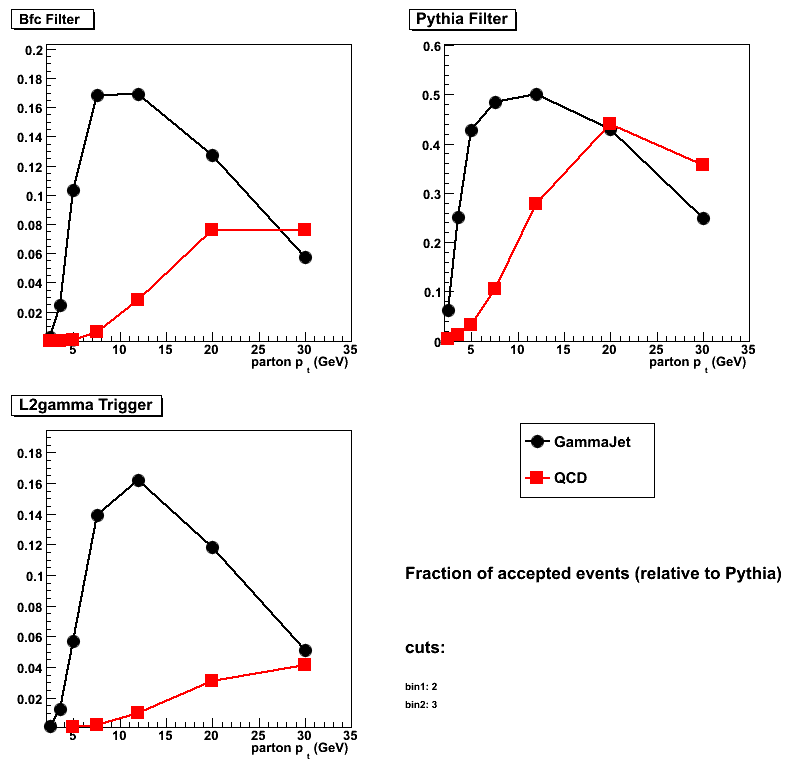
| Accept rate: fract. of generated events | |||
| GammaJet | |||
| pt bin | Bfc Filter | Pythia Filter | L2gamma Trigger |
| pt=2-3 | 0.0023 | 0.06264 | 0.00148 |
| pt=3-4 | 0.0242285 | 0.250601 | 0.0126854 |
| pt=4-6 | 0.103111 | 0.427535 | 0.0571313 |
| pt=6-9 | 0.16828 | 0.48368 | 0.13918 |
| pt=9-15 | 0.1692 | 0.50118 | 0.1619 |
| pt=15-25 | 0.12708 | 0.42904 | 0.11786 |
| pt=25-35 | 0.05702 | 0.24854 | 0.0509 |
| QCD | |||
| pt bin | Bfc Filter | Pythia Filter | L2gamma Trigger |
| pt=2-3 | 3.003e-05 | 0.00426426 | 2.002e-05 |
| pt=3-4 | 0.0001001 | 0.0122923 | 1.001e-05 |
| pt=4-6 | 0.00078 | 0.03166 | 0.00014 |
| pt=6-9 | 0.00622 | 0.10538 | 0.00216 |
| pt=9-15 | 0.02822 | 0.27666 | 0.01022 |
| pt=15-25 | 0.07568 | 0.4405 | 0.03086 |
| pt=25-35 | 0.0761 | 0.35556 | 0.04116 |
Figure 2: False rejection (Y-axis scale is 10^-3)
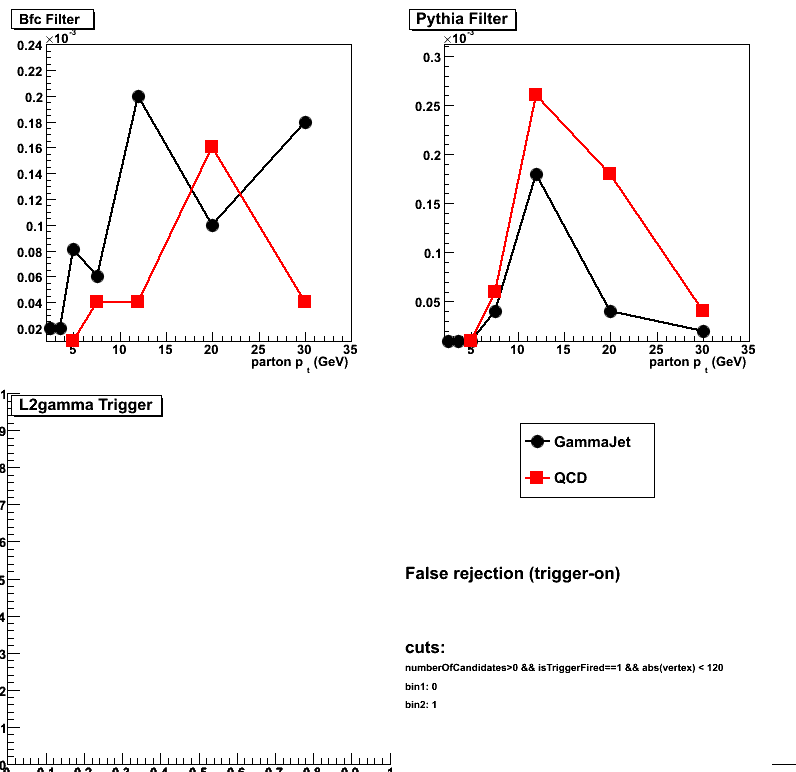
| False reject: fract. of generated events | |||
| GammaJet | |||
| pt bin | Bfc Filter | Pythia Filter | L2gamma Trigger |
| pt=2-3 | 2e-05 | 0 | 0 |
| pt=3-4 | 2.00401e-05 | 0 | 0 |
| pt=4-6 | 8.08081e-05 | 0 | 0 |
| pt=6-9 | 6e-05 | 4e-05 | 0 |
| pt=9-15 | 0.0002 | 0.00018 | 0 |
| pt=15-25 | 0.0001 | 4e-05 | 0 |
| pt=25-35 | 0.00018 | 2e-05 | 0 |
| QCD | |||
| pt bin | Bfc Filter | Pythia Filter | L2gamma Trigger |
| pt=2-3 | 0 | 0 | 0 |
| pt=3-4 | 0 | 0 | 0 |
| pt=4-6 | 0 | 0 | 0 |
| pt=6-9 | 4e-05 | 6e-05 | 0 |
| pt=9-15 | 4e-05 | 0.00026 | 0 |
| pt=15-25 | 0.00016 | 0.00018 | 0 |
| pt=25-35 | 4e-05 | 4e-05 | 0 |
Accept/Reject relative to the number of triggered events
Figure 3: Fraction of accepted events (relative to triggered events)
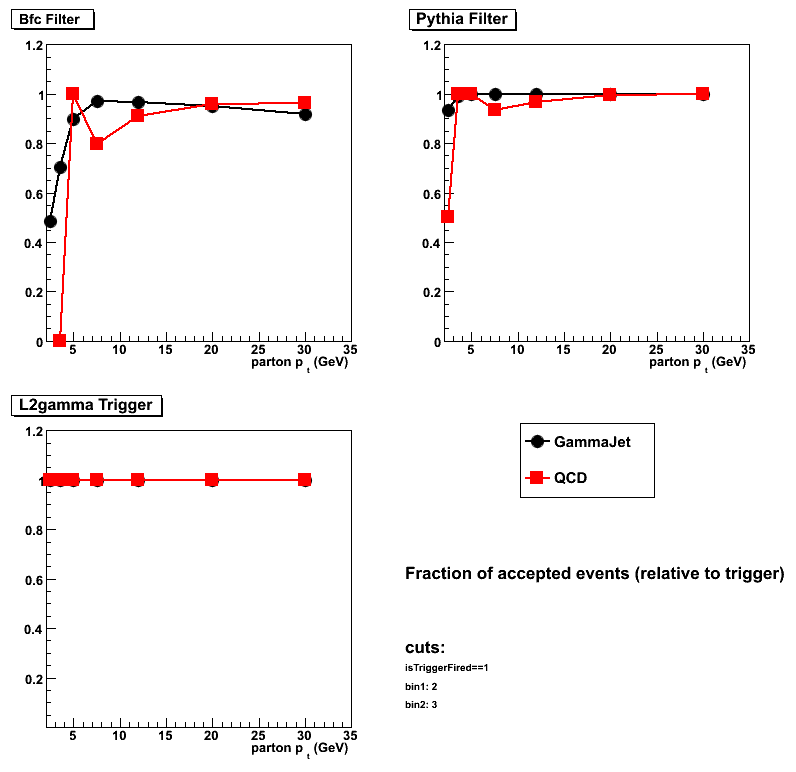
Figure 4: False rejection relative to triggered events
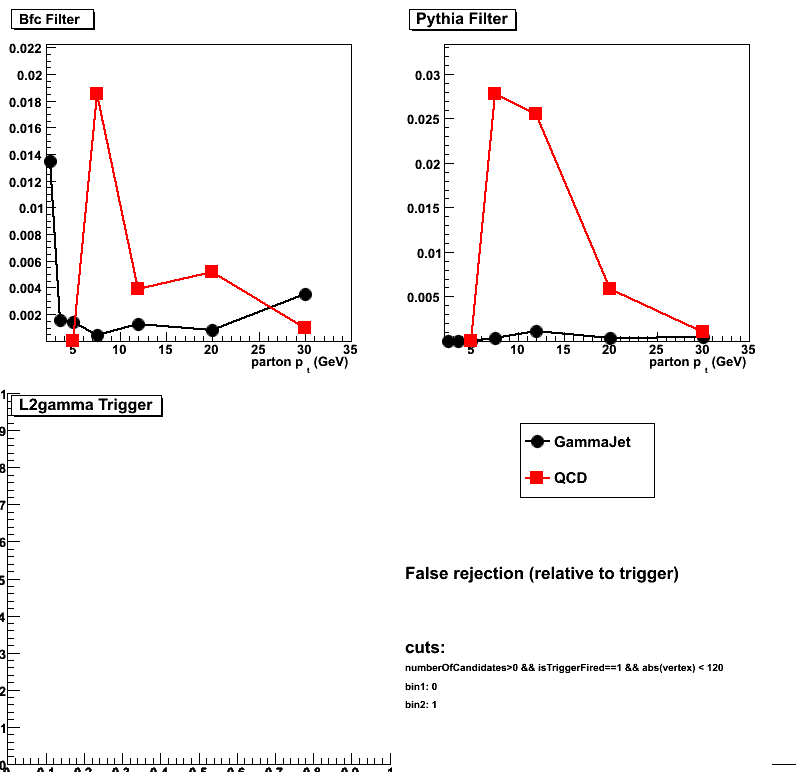
Accept/Reject relative to the number of Pythia filter accepted events
Figure 5: Fraction of accepted events relative to Pythia filter accepted events
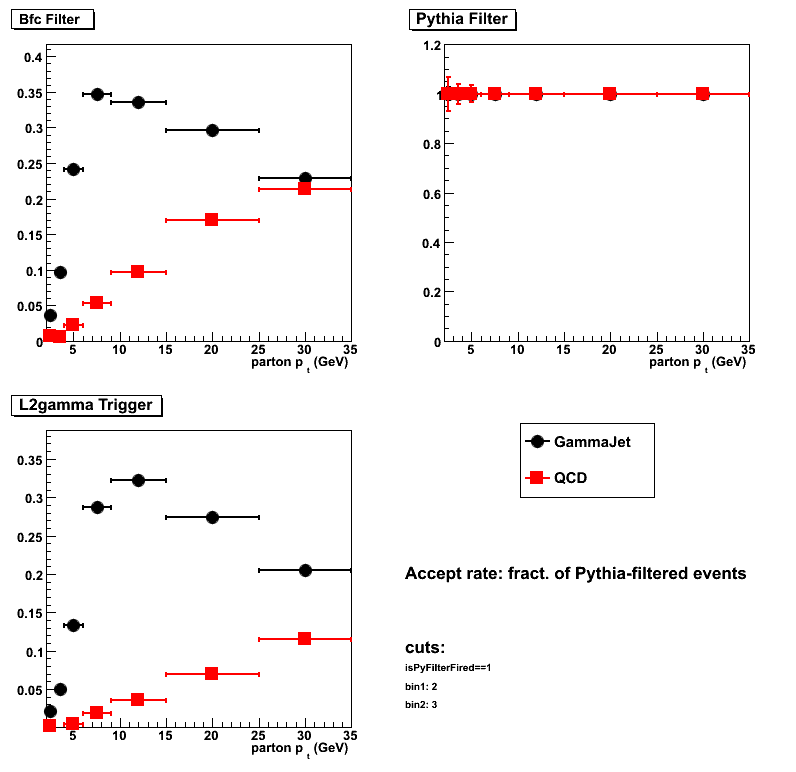
| Accept rate: fract. of Pythia-filtered events | |||
| GammaJet | |||
| pt bin | Bfc Filter | Pythia Filter | L2gamma Trigger |
| pt=2-3 | 0.0363985 | 1 | 0.0220307 |
| pt=3-4 | 0.0966813 | 1 | 0.0501399 |
| pt=4-6 | 0.241081 | 1 | 0.133488 |
| pt=6-9 | 0.347461 | 1 | 0.287587 |
| pt=9-15 | 0.336286 | 1 | 0.322639 |
| pt=15-25 | 0.29573 | 1 | 0.274613 |
| pt=25-35 | 0.228776 | 1 | 0.204635 |
| QCD | |||
| pt bin | Bfc Filter | Pythia Filter | L2gamma Trigger |
| pt=2-3 | 0.00704225 | 1 | 0.00234742 |
| pt=3-4 | 0.00488599 | 1 | 0.000814332 |
| pt=4-6 | 0.0214782 | 1 | 0.00442198 |
| pt=6-9 | 0.053141 | 1 | 0.0191687 |
| pt=9-15 | 0.0965806 | 1 | 0.0356394 |
| pt=15-25 | 0.16958 | 1 | 0.0695573 |
| pt=25-35 | 0.213185 | 1 | 0.115592 |
Figure 6: False rejection relative to Pythia filter accepted events
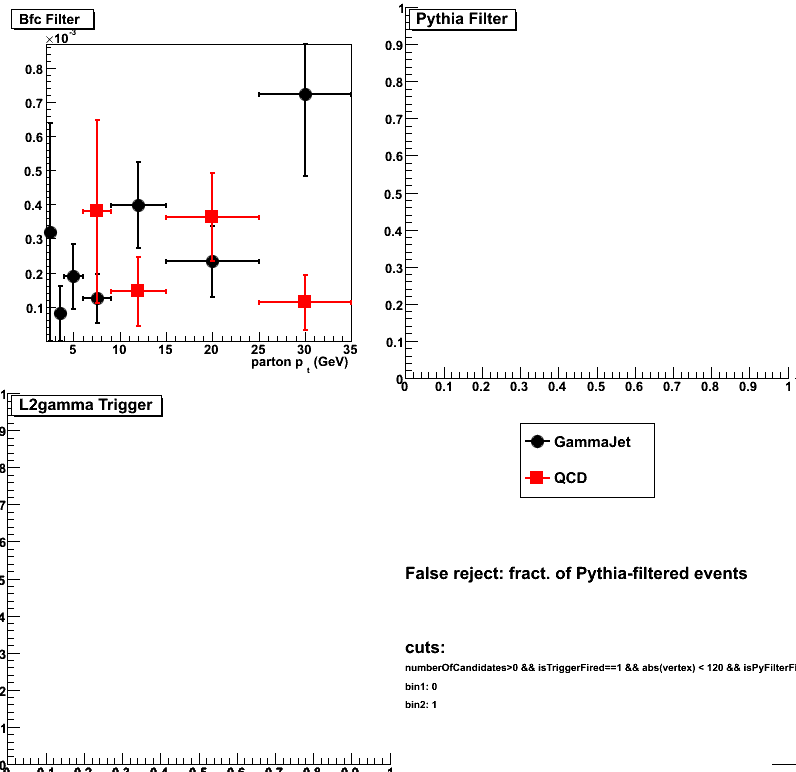
| False reject: fract. of Pythia-filtered events | |||
| GammaJet | |||
| pt bin | Bfc Filter | Pythia Filter | L2gamma Trigger |
| pt=2-3 | 0.000319285 | 0 | 0 |
| pt=3-4 | 7.9968e-05 | 0 | 0 |
| pt=4-6 | 0.000189009 | 0 | 0 |
| pt=6-9 | 0.000124049 | 0 | 0 |
| pt=9-15 | 0.000399058 | 0 | 0 |
| pt=15-25 | 0.000233079 | 0 | 0 |
| pt=25-35 | 0.000724229 | 0 | 0 |
| QCD | |||
| pt bin | Bfc Filter | Pythia Filter | L2gamma Trigger |
| pt=2-3 | 0 | 0 | 0 |
| pt=3-4 | 0 | 0 | 0 |
| pt=4-6 | 0 | 0 | 0 |
| pt=6-9 | 0.000379579 | 0 | 0 |
| pt=9-15 | 0.000144582 | 0 | 0 |
| pt=15-25 | 0.000363224 | 0 | 0 |
| pt=25-35 | 0.000112499 | 0 | 0 |
2010.02.11 BFC and Pythia QA: Gain spread=0.05, mean=0.95
QCD and gamma-jet data samples are described here
Resultys without gain spread can be found here
(Note: ignore parton pt=25-35GeV for the gamma-jet sample since all jobs failed)
Gain spread implementation in StEEmcSlowMaker.cxx (private version):
void StEEmcSlowMaker::setTowerGainSpread(Float_t s, Float_t mTowerGainMean)
{
LOG_INFO << "setTowerGainSpread(): gain spread: " << s << "; gain mean value: " << mTowerGainMean << endm;
// initialize tower gain factors to 1
for ( Int_t sec=0;sec<kEEmcNumSectors;sec++ )
for ( Int_t sub=0;sub<kEEmcNumSubSectors;sub++ )
for ( Int_t eta=0;eta<kEEmcNumEtas;eta++ )
{
// mTowerGainFact[sec][sub][eta]=1.0;
Float_t f = -1.0E9;
while ( f <= -1. || f >= 1.0 )
f = gRandom->Gaus(0., s);
mTowerGainFact[sec][sub][eta] = mTowerGainMean + f;
}
}
Pythia filter configuration
StEemcGammaFilter:: running the TEST mode (accepting all events). Set mFilterMode=1 to actually reject events
StEemcGammaFilter:: mConeRadius 0.22 mSeedThreshold 2.1 mClusterThreshold 3.25 mEtaLow 0.95 mEtaHigh 2.1
StEemcGammaFilter:: mCalDepth 279.5 mMinPartEnergy 1e-05 mHadronScale 0.4 mFilterMode 0 mPrintLevel 0
BFC filter configuration
StChain:INFO - Init() : Seed energy threshold = 2.8 GeV
StChain:INFO - Init() : Cluster eT threshold = 4.2 GeV
StChain:INFO - Init() : Maximum vertex = +/- 120 cm
StChain:INFO - Init() : Running the TEST mode (accepting all events). Set mFilterMode=1 to actually reject events in BFC
Accept/Reject relative to the total number of Pythia generated events
Figure 1: Fraction of accepted events

Figure 2: False rejection (Y-axis scale is 10^-3)
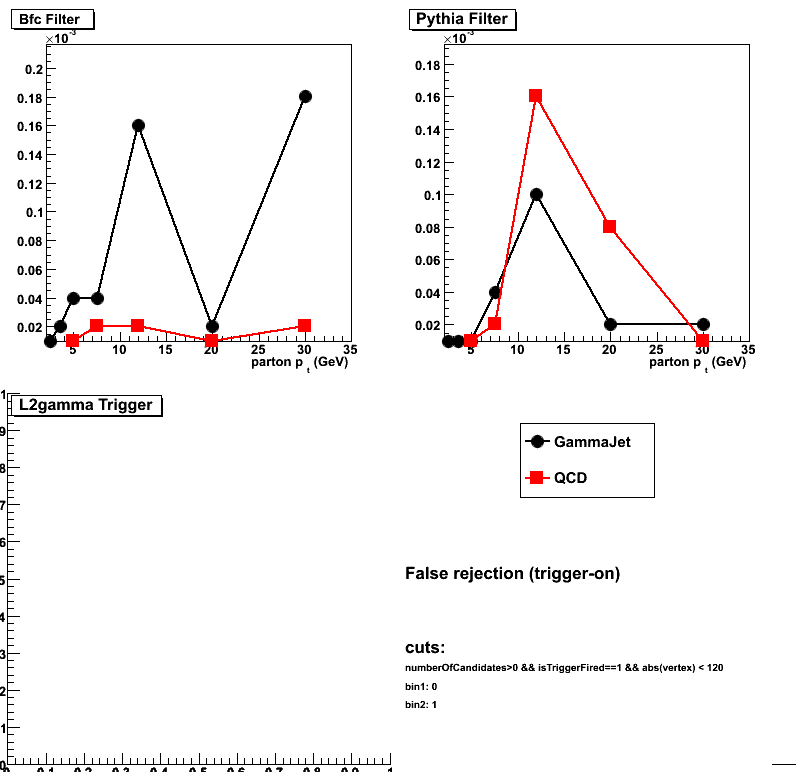
Accept/Reject relative to the number of triggered events
Figure 3: Fraction of accepted events (relative to triggered events)
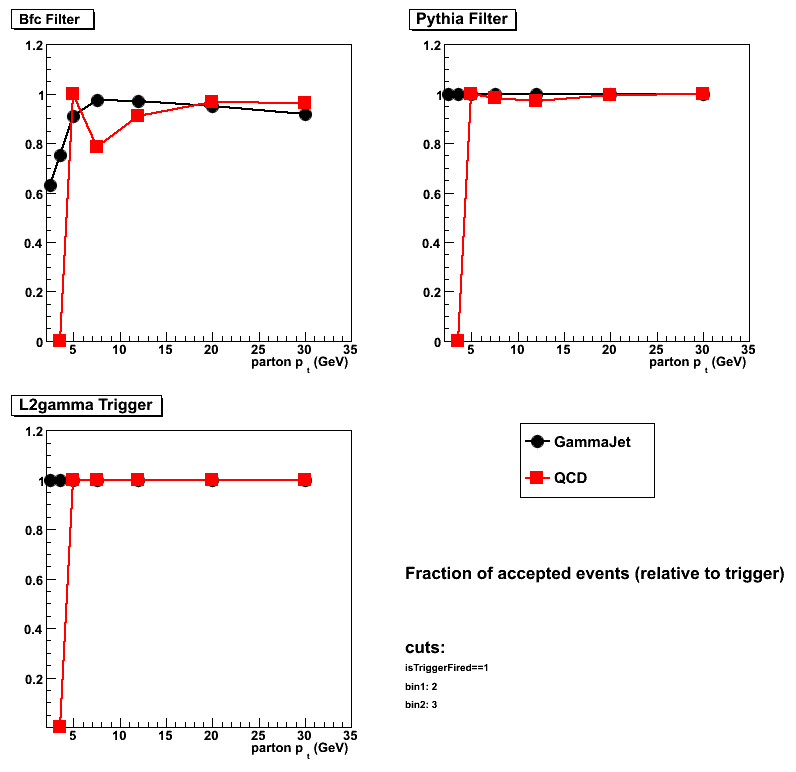
2010.02.12 Final Pythia and BFC EEMC-gamma-filter paramter settings
Pythia generated processes
| Prompt photons (gamma-jets) | 2->2 QCD | ||
| id | Process | id | Process |
| 14 | f + fbar -> g + gamma | 11 | f + f' -> f + f' (QCD) |
| 18 | f + fbar -> gamma + gamma | 12 | f + fbar -> f' + fbar' |
| 29 | f + g -> f + gamma | 13 | f + fbar -> g + g |
| 114 | g + g -> gamma + gamma | 28 | f + g -> f + g |
| 115 | g + g -> g + gamma | 53 | g + g -> f + fbar |
| 68 | g + g -> g + g | ||
Number of generated events per parton pt bin
| Number of generated events (100events/job) |
|||||||
| Parton pt range (GeV) | 2-3 | 3-4 | 4-6 | 6-9 | 9-15 | 15-25 | 25-35 |
| gamma-jets | 50K | 50K | 50K | 50K | 50K | 50K | 50K |
| 2->2 QCD processes | 100K | 100K | 50K | 50K | 50K | 50K | 50K |
Pythia Filter configuration
StRoot/StMCFilter/StEemcGammaFilter.cxx
StRoot/StMCFilter/StEemcGammaFilter.h
| Filter parameter | Value | Notes |
| mConeRadius | 0.22 | |
| mSeedThreshold | 2.6 | Cluster seed energy threshold (GeV) |
| mClusterThreshold | 3.6 | Cluster Et threshold (GeV) |
| mEtaLow | 0.95 | EEMC acceptance |
| mEtaHigh | 2.1 | EEMC acceptance |
| mMaxVertex | 120.0 | Vertex z cut (cm) |
| mCalDepth | 279.5 | EEMC SMD depth (cm) |
| mMinPartEnergy | 1e-05 | Ignore track with minim energy (GeV) |
| mHadronScale | 0.4 | Downscale factor for hadron energy |
| mFilterMode | 0 / 1 | 0=Accept all events; 1=reject events |
BFC Filter configuration
StRoot/StFilterMaker/StEemcGammaFilterMaker.cxx
StRoot/StFilterMaker/StEemcGammaFilterMaker.h
| Filter parameter | Value | Notes |
| mSeedEnergyThreshold | 3.4 | Cluter seed energy threshold (GeV) |
| mClusterEtThreshold | 4.5 | Cluster Et threshold (GeV) |
| mEemcSamplingFraction | 0.05 | Assume 5% sampling fraction for EEMC |
| mMaxVertex | 120.0 | Vertex z cut (cm) |
| mFilterMode | 0 / 1 | 0=Accept all events; 1=reject events |
GammaMaker configuration
| Filter parameter | Value | Notes |
| ConeRadius | 0.7 | |
| ClusterEtThreshold | 5.5 | (GeV) |
| SeedEnergyThreshold | 4.2 | (GeV) |
| ClusterEnergyThreshold | 5.5 | (GeV) |
EEMC SlowSimulator configuration
(for a moment private version) of StEEmcSlowMaker.cxx
with modified setTowerGainSpread(Float_t s, Float_t mTowerGainMean)
| Filter parameter | Value | Notes |
| mTowerGainMean | 1.05 | Overall +5% gain shift |
| GainSpread | 0 | No gain spread |
GSTAR/Pythia options
- detp geometry y2006h
- Calorimeter cut for electromagnetic processes: emc_10keV
- call pytune(100): PYTUNE v1.015; CDF Tune A
or
call pytune(320): PYTUNE Perugia; Perugia 0 tune
2010.02.16 Pythia and BFC filter QA vs. gamma candidate pt and eta
QCD and gamma-jet data samples and filter configurtions are given here
Note: for this study I have used ideal EEMC gains (no gain shift/spread)
Note on trigger effect intepretation:
There is no requirement for the Pythia gamma-jet sample to have direct gamma
headed to the EEMC, only requirement is to have a gamma candidate in the EEMC,
so the away side jet may also contribute.
Figure 1: pt distribution of the gamma candidates
for Pythia/Bfc level filter and triggered events
Event cuts: at least one gamma candidate, |v_z| <120
Left: Pythia gamma-jet MC; (right) 2->2 Pythia QCD
Lower plots: fraction of accepted gamma candidates by filter/trigger
No parton pt weights (= ignore bumps in pt distribution for gamma-jet sample)
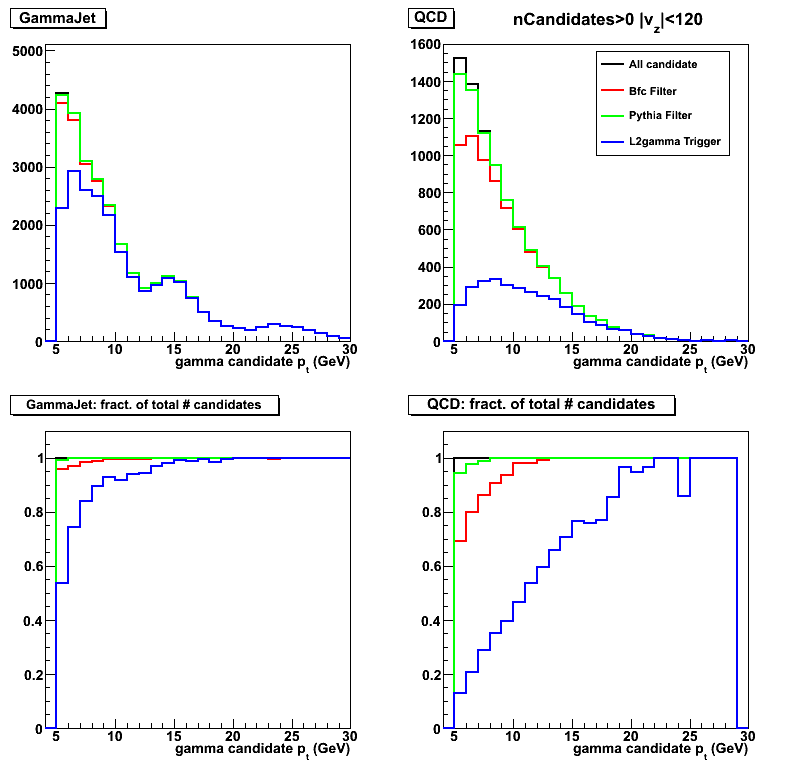
Figure 2: Rapidity distribution of the gamma candidates (Same conditions as in Fig. 1)
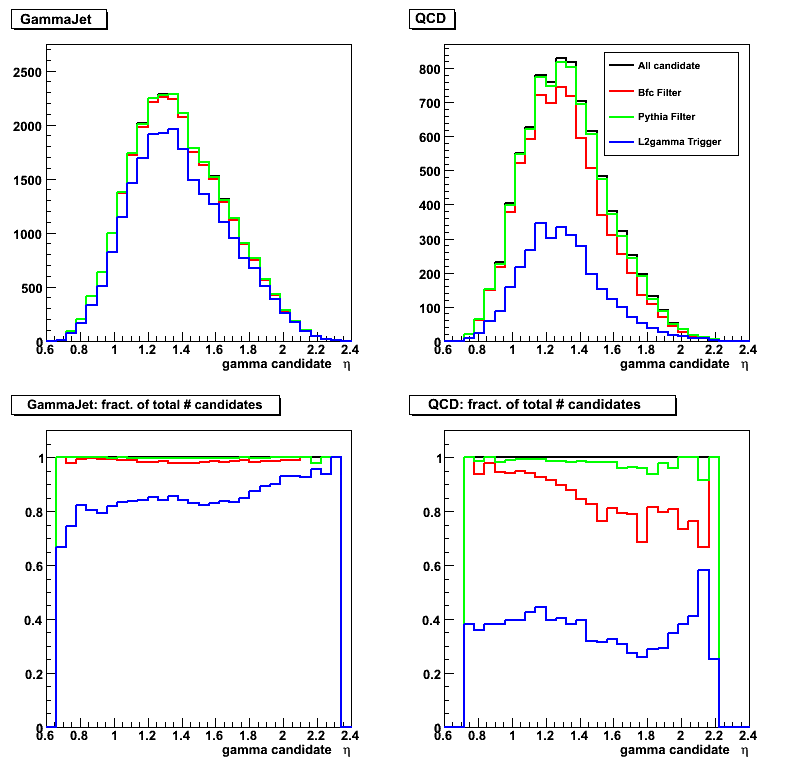
Figure 3: pt distribution of false rejection for Pythia/Bfc filters
Candidate cuts: at least one gamma candidate, l2gamm-trigger=fired, |v_z| <120
Most of false rejection (~ 1-3% for QCD) is for gamma candidates with pt < 8GeV
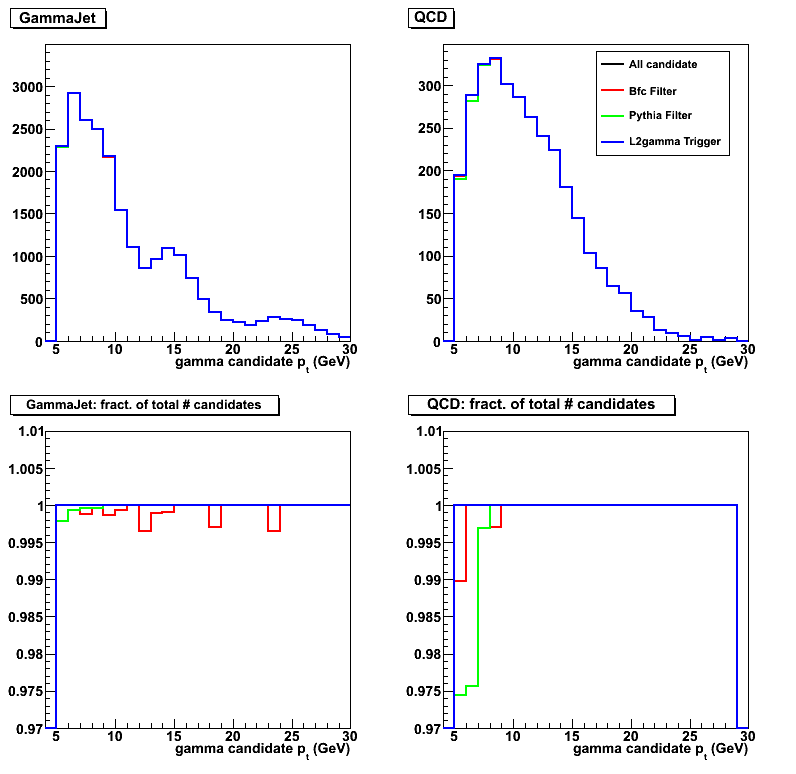
03 Mar
March 2010 posts
2010.03.02 Endcap photon-jets simulation request (draft)
Request last updated on Jul 21, 2010
Request summary
Total resources estimate for QCD with 1/pb and prompt-photon with 10/pb suimulations:
- CPU: 4.2 CPU years (2.2 weeks of running on a 100 CPUs)
- Disk space: 0.15Tb
- Numbe of filtered events: 0.74M
| partonic pt |
QCD |
prompt photon |
| 2-3 | 0 | 30K |
| 3-4 | 0 | 36K |
| 4-6 | 130K | 76K |
| 6-9 | 240K | 40K |
| 9-15 | 150K | 10K |
| 15-35 | 23K | 1K |
Latest filter bias/timing test and simulation request spreasheet
- EEMC simulation spreadsheet and timing tests
- Pythia/bfc filter bias
- Pythia tunes comparison agains data (CDF-Tune-A vs. Perugia0)
- Estimate of the contribution from lowerst partonic pt, pt<4GeV (see Fig. 6)
- L2-Endcap-gamma filter emulation study with single photon Monte-Carlo
- Bias tests with pi0 finder (last updated May 14, 2010)
Note: These and all other studies are linked from here
Filter code in cvs
- Pythia gamma-filter code:
- BFC gamma-filter code:
StEemcGammaFilterMaker.cxx
StEemcGammaFilterMaker.h
eemcGammaFilterMakerParams.idl
Further information related to this request
- Lidia added "y2006h" tag (latest Endcap geometry fixes, and Calorimeters with LOW_EM cuts)
http://www.star.bnl.gov/HyperNews-star/protected/get/starsimu/452/1.html
- x/y beam offset:
Run 6: x=0.0cm, y=-0.3cm (from /STAR/comp/calib/Beamline/Run6)
Run 9: x=0.3cm, y= 0.0cm (from /STAR/comp/calib/BeamLine/Run9)
- Vertex z cut:
+/- 120cm
- Vertex z spread:
Run 6: 55cm (gaus fit to Fig.1 from this post: /STAR/node/13276)
Run 9: 63cm are taken from Pibero's embedding study:
www4.rcf.bnl.gov/~pibero/spin/dijets/2009.10.23/embedding.html
- Vertex x/y spread set to zero for all runs.
FYI, Run 9 x/y spread is x=0.57, y=0.58
http://www4.rcf.bnl.gov/~pibero/spin/dijets/2009.10.23/XYVertexJetTriggers.png
- Vertex option:
Use option consistent with bfc tags used for data production (VFPPV/Run-6 or VFPPVnoCTB/Run-9):
Run 6: Leave vertex to be reconstructed vertex, and use VFPPV with beamline
Run 9: Leave vertex to be reconstructed vertex, and use VFPPVnoCTB with beamline
FYI: bfc options for different years:
http://www.star.bnl.gov/devcgi/dbProdOptionRetrv.pl
- Use the latest available "SLXXy" library tag
- No sdt option for bfc with Monte-Carlo. See note from Jreome's:
http://www.star.bnl.gov/HyperNews-star/protected/get/starsoft/7905/1/1/2.html
- Need to add new bfc tag. Request send to starsimu list:
http://www.star.bnl.gov/HyperNews-star/protected/get/starsimu/453.html
- Using Perugia0 tunes (i.e. call pytune(320))
- GMT timestamp update
http://www.star.bnl.gov/HyperNews-star/protected/get/ phana/481.html
Run 6 200 GeV
sdt20060512.043500 (GMT during run 7132005)
sdt20060513.064000 (GMT during run 7133011)
sdt20060514.090000 (GMT during run 7134015)
sdt20060516.152000 (GMT during run 7136022)
sdt20060518.073700 (GMT during run 7138010)
sdt20060520.142000 (GMT durign run 7140024)
sdt20060521.052000 (GMT during run 7141011)
sdt20060522.124500 (GMT during run 7142029)
sdt20060523.204400 (GMT during run 7143044)
sdt20060525.114000 (GMT during run 7145023)
sdt20060526.114000 (GMT during run 7146020)
sdt20060528.144500 (GMT during run 7148028)
sdt20060602.071500 (GMT during run 7153015)
sdt20060604.191200 (GMT during run 7155043)
Run 9 500 GeV
sdt20090320.014942
sdt20090321.095723
sdt20090324.064934
sdt20090328.040659
sdt20090329.014902
sdt20090404.194055
sdt20090407.030832
sdt20090410.020208
sdt20090411.103512
sdt20090413.021450
Run 9 200 GeV
std20090506.083000 (GMT during run 10126017)
std20090508.152000 (GMT during run 10128053)
std20090514.145500 (GMT during run 10134035)
std20090516.182500 (GMT during run 10135070)
std20090517.214000 (GMT during run 10137052)
std20090518.111600 (GMT during run 10138027)
std20090519.173200 (GMT during run 10139069)
std20090520.100500 (GMT during run 10140011)
std20090522.141000 (GMT during run 10142043)
std20090523.183500 (GMT during run 10143065)
std20090524.112000 (GMT during run 10144035)
std20090525.062000 (GMT during run 10145012)
std20090526.140000 (GMT during run 10146052)
- FYI:
simulation request posted to SPIN PWG:
http://www.star.bnl.gov/HyperNews-star/protected/get/starspin/3982.html
Code status:
http://www.star.bnl.gov/HyperNews-star/protected/get/starsoft/8073.html
Code per review (by Pibero and Victor):
http://www.star.bnl.gov/HyperNews-star/protected/get/starsoft/8073/2.html
Note: code being approved
Original disk space estimate (see spreadsheed linked above for the latest estimates):
http://www.star.bnl.gov/HyperNews-star/protected/get/starspin/3982.html
------------------------ REQUEST DRAFT BELOW ----------------------------------------
Endcap photon-jets / QCD 2->2 simulations
| Event generator | Pythia |
| Extra options |
Additional libraries required for Eemc-gamma Pythia-level filter gexec $ROOTSYS/lib/libCint.so Select prompt photon Pythhia processes: MSUB (14)=1 Select QCD 2->2 Pythhia processes: MSUB (11) = 1 Perugia0 Pythia tune: |
| Vertex Z, cm | -120 < Vertex < 120 |
| Gaussian sigma in X,Y,Z if applicable |
x/y spread use 0 |
| Vertex offset: x, mm | Run 6: 0.0cm Run 9: 0.3cm (note: values in cm) |
| Vertex offset: y, mm | Run 6: -0.3cm (note: values in cm) Run 9: 0.0cm |
| Φ (phi), radian | 0 < Φ < 6.29 |
| η (eta) | Default (include Barrel, Endcap, BBC) |
| Pt bin, GeV | See list above for QCD and g-jet samples |
| Macro file | Pythia gamma-filter code:
StEemcGammaFilter.cxx StEemcGammaFilterMaker.cxx Private bfc: /star/u/seluzhen/star/spin/MCgammaFilter/scripts/bfc.C |
04 Apr
April 2010 posts
2010.04.09 BFC and Pythia QA: 10% gain shift
See this post from Alice for QCD sample rates
QCD and gamma-jet data samples are described here (filter parameters are listed below)
Pythia filter configuration
StEemcGammaFilter:: running the TEST mode (accepting all events). Set mFilterMode=1 to actually reject events
StEemcGammaFilter:: mConeRadius 0.22 mSeedThreshold 2.6 mClusterThreshold 3.6 mEtaLow 0.95 mEtaHigh 2.1 mMaxVertex 120
StEemcGammaFilter:: mCalDepth 279.5 mMinPartEnergy 1e-05 mHadronScale 1 mFilterMode 0 mPrintLevel 1
BFC filter configuration
StChain:INFO - Init() : Using gamma filter on the EEMC
StChain:INFO - Init() : EEMC Sampling Fraction = 0.05
StChain:INFO - Init() : Seed energy threshold = 3.4 GeV
StChain:INFO - Init() : Cluster eT threshold = 4.5 GeV
StChain:INFO - Init() : Maximum vertex = +/- 120 cm
StChain:INFO - Init() : Running the TEST mode (accepting all events). Set mFilterMode=1 to actually reject events in BFC
StEEmcSlowMaker
BFC:INFO - setTowerGainSpread(): gain spread: 0; gain mean value: 1.1
Accept/Reject relative to the total number of Pythia generated events
Figure 1: Fraction of accepted events
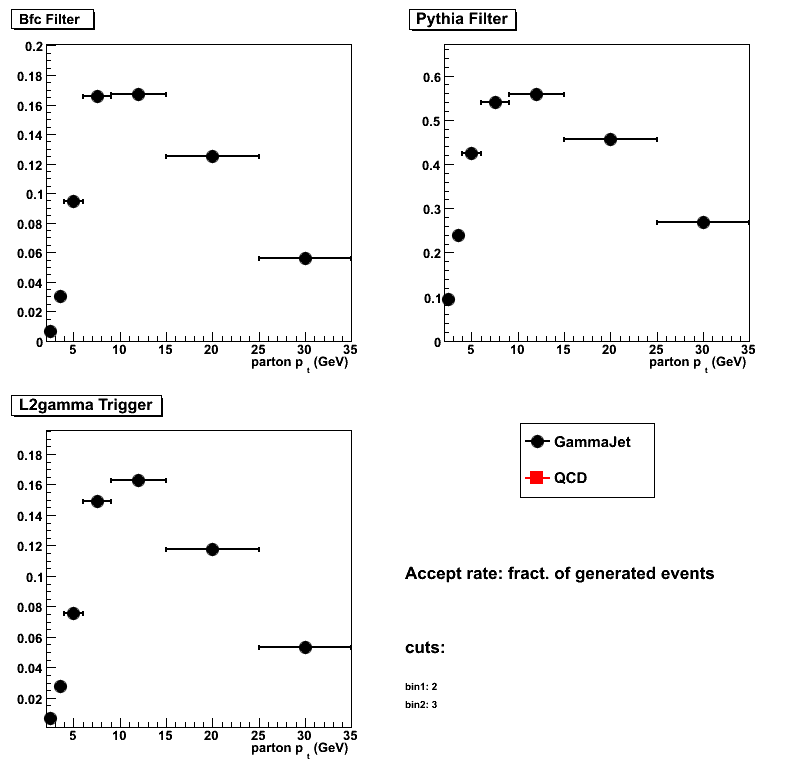
| Accept rate: fract. of generated events | |||
| GammaJet | |||
| pt bin | Bfc Filter | Pythia Filter | L2gamma Trigger |
| pt=2-3 | 0.00646 | 0.09532 | 0.00656 |
| pt=3-4 | 0.03042 | 0.2401 | 0.02772 |
| pt=4-6 | 0.09438 | 0.42552 | 0.07568 |
| pt=6-9 | 0.165984 | 0.54004 | 0.149137 |
| pt=9-15 | 0.167329 | 0.559137 | 0.162972 |
| pt=15-25 | 0.12486 | 0.45662 | 0.11744 |
| pt=25-35 | 0.0562525 | 0.269499 | 0.0536273 |
Figure 2: False rejection (Y-axis scale is 10^-3)
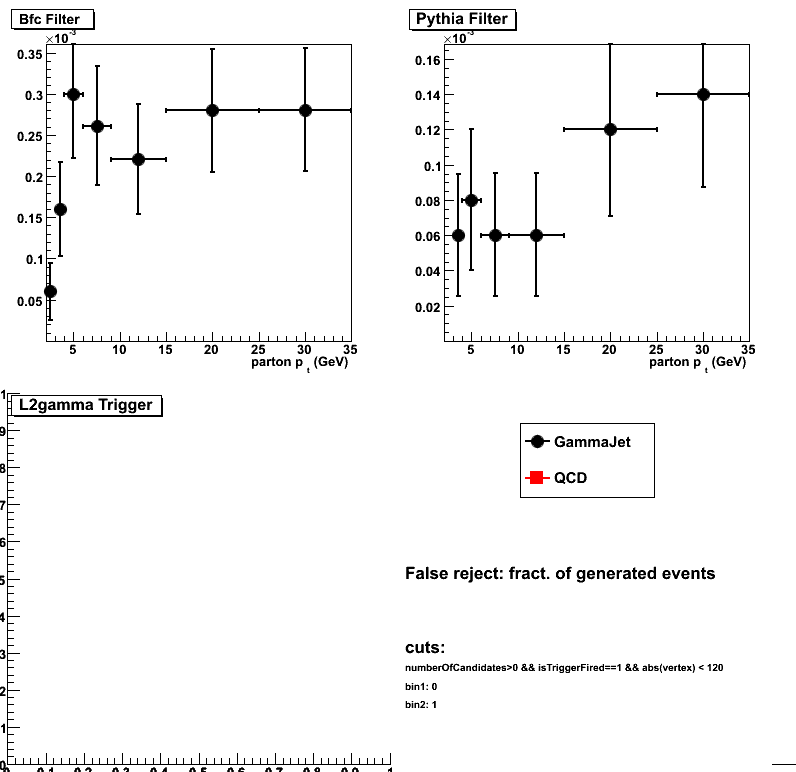
| False reject: fract. of generated events | |||
| GammaJet | |||
| pt bin | Bfc Filter | Pythia Filter | L2gamma Trigger |
| pt=2-3 | 6e-05 | 0 | 0 |
| pt=3-4 | 0.00016 | 6e-05 | 0 |
| pt=4-6 | 0.0003 | 8e-05 | 0 |
| pt=6-9 | 0.000261044 | 6.0241e-05 | 0 |
| pt=9-15 | 0.000220884 | 6.0241e-05 | 0 |
| pt=15-25 | 0.00028 | 0.00012 | 0 |
| pt=25-35 | 0.000280561 | 0.000140281 | 0 |
Accept/Reject relative to the number of Pythia filter accepted events
Figure 3: Fraction of accepted events relative to Pythia filter accepted events
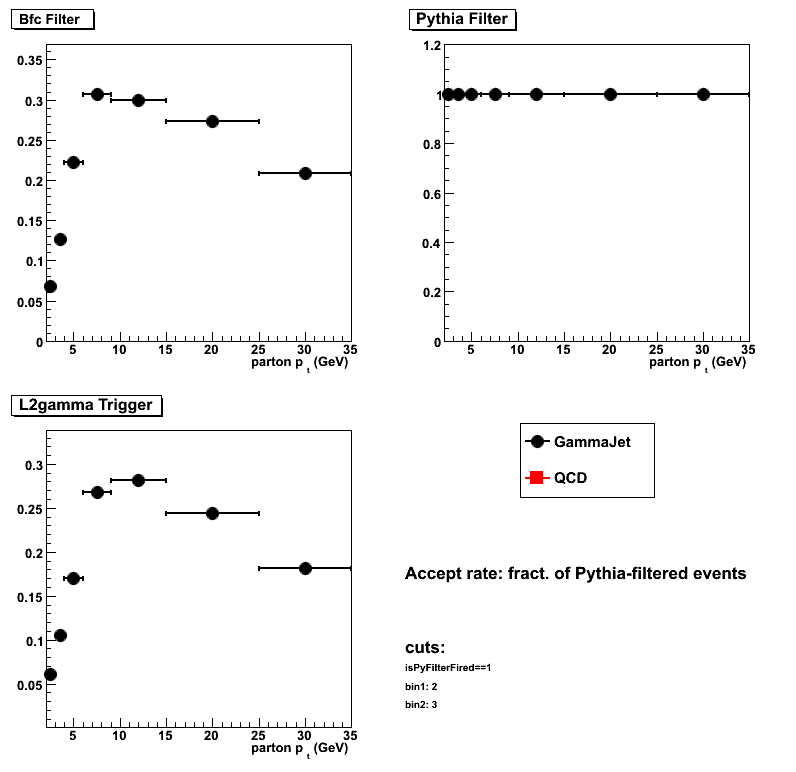
| Accept rate: fract. of Pythia-filtered events | |||
| GammaJet | |||
| pt bin | Bfc Filter | Pythia Filter | L2gamma Trigger |
| pt=2-3 | 0.0677717 | 1 | 0.0612673 |
| pt=3-4 | 0.126697 | 1 | 0.105623 |
| pt=4-6 | 0.221799 | 1 | 0.16991 |
| pt=6-9 | 0.307318 | 1 | 0.26809 |
| pt=9-15 | 0.299264 | 1 | 0.281882 |
| pt=15-25 | 0.273444 | 1 | 0.244317 |
| pt=25-35 | 0.20873 | 1 | 0.181217 |
Figure 4: False rejection relative to Pythia filter accepted events
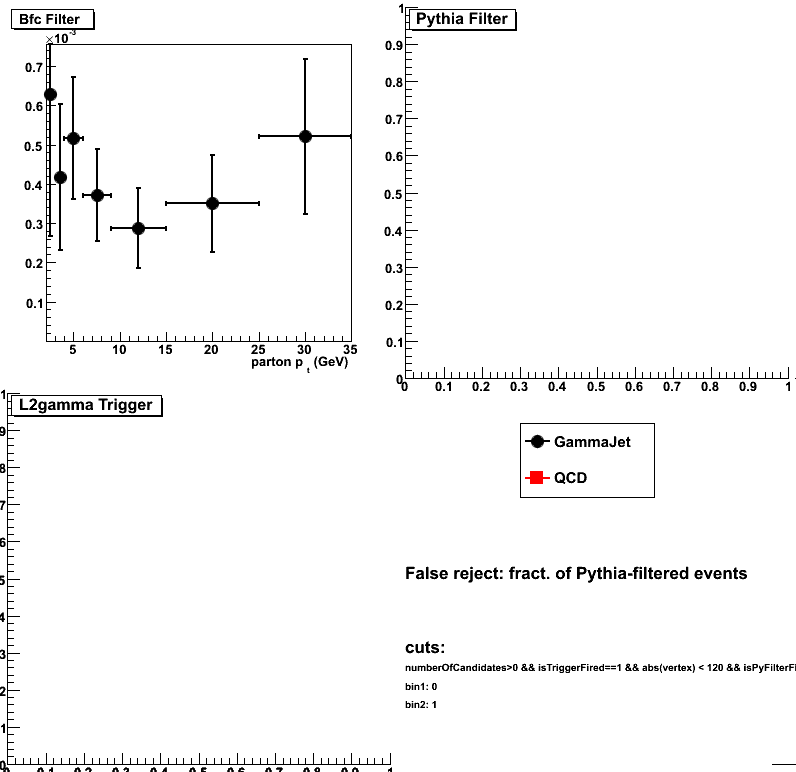
| False reject: fract. of Pythia-filtered events | |||
| GammaJet | |||
| pt bin | Bfc Filter | Pythia Filter | L2gamma Trigger |
| pt=2-3 | 0.000629459 | 0 | 0 |
| pt=3-4 | 0.000416493 | 0 | 0 |
| pt=4-6 | 0.000517014 | 0 | 0 |
| pt=6-9 | 0.00037183 | 0 | 0 |
| pt=9-15 | 0.000287305 | 0 | 0 |
| pt=15-25 | 0.000350401 | 0 | 0 |
| pt=25-35 | 0.000520524 | 0 | 0 |
2010.04.17 BFC and Pythia QA: 10% gain shift: lowered thresholds
See this post from Alice for QCD sample rates with slightly lower thresholds
QCD and gamma-jet data samples are described here (filter parameters are listed below)
Pythia filter configuration
StEemcGammaFilter:: running the TEST mode (accepting all events). Set mFilterMode=1 to actually reject events
StEemcGammaFilter:: mConeRadius 0.22 mSeedThreshold 2.4 mClusterThreshold 3.3 mEtaLow 0.95 mEtaHigh 2.1 mMaxVertex 120
StEemcGammaFilter:: mCalDepth 279.5 mMinPartEnergy 1e-05 mHadronScale 1 mFilterMode 0 mPrintLevel 1
BFC filter configuration
StChain:INFO - Init() : Using gamma filter on the EEMC
StChain:INFO - Init() : EEMC Sampling Fraction = 0.05
StChain:INFO - Init() : Seed energy threshold = 2.8 GeV
StChain:INFO - Init() : Cluster eT threshold = 3.8 GeV
StChain:INFO - Init() : Maximum vertex = +/- 120 cm
StChain:INFO - Init() : Running the TEST mode (accepting all events). Set mFilterMode=1 to actually reject events in BFC
StEEmcSlowMaker
BFC:INFO - setTowerGainSpread(): gain spread: 0; gain mean value: 1.1
Accept/Reject relative to the total number of Pythia generated events
Figure 1: Fraction of accepted events
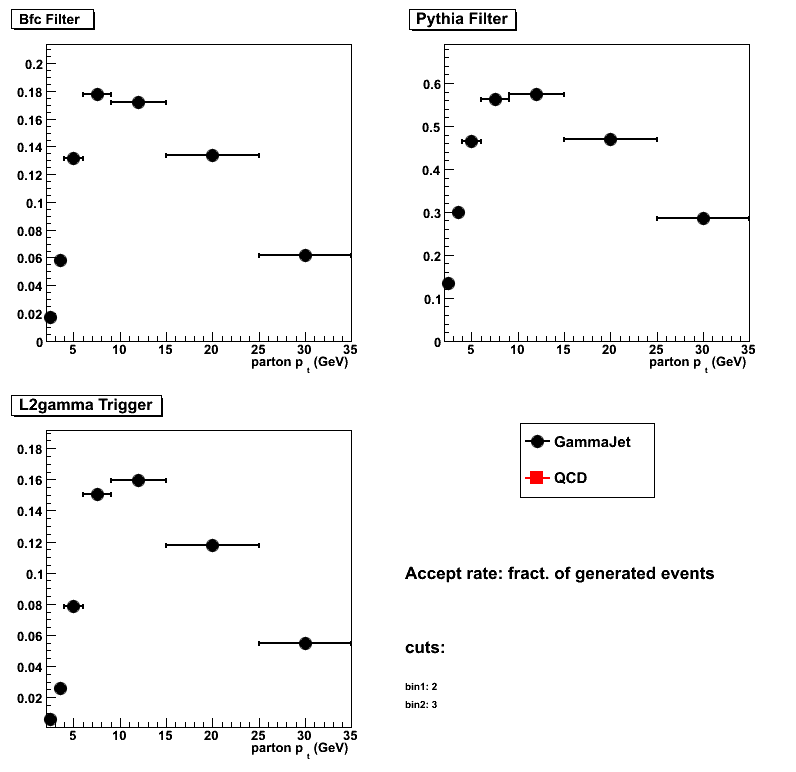
| Accept rate: fract. of generated events | |||
| GammaJet | |||
| pt bin | Bfc Filter | Pythia Filter | L2gamma Trigger |
| pt=2-3 | 0.01732 | 0.1343 | 0.00628 |
| pt=3-4 | 0.05818 | 0.3001 | 0.0261 |
| pt=4-6 | 0.1317 | 0.46492 | 0.07864 |
| pt=6-9 | 0.17804 | 0.56314 | 0.15092 |
| pt=9-15 | 0.17226 | 0.57516 | 0.15964 |
| pt=15-25 | 0.13356 | 0.46894 | 0.1179 |
| pt=25-35 | 0.062 | 0.28546 | 0.05482 |
Figure 2: False rejection (Y-axis scale is 10^-3)
.png)
| False reject: fract. of generated events | |||
| GammaJet | |||
| pt bin | Bfc Filter | Pythia Filter | L2gamma Trigger |
| pt=2-3 | 2e-05 | 2e-05 | 0 |
| pt=3-4 | 6e-05 | 6e-05 | 0 |
| pt=4-6 | 6e-05 | 4e-05 | 0 |
| pt=6-9 | 0.0001 | 6e-05 | 0 |
| pt=9-15 | 2e-05 | 2e-05 | 0 |
| pt=15-25 | 2e-05 | 0 | 0 |
| pt=25-35 | 2e-05 | 2e-05 | 0 |
Accept/Reject relative to the number of Pythia filter accepted events
Figure 3: Fraction of accepted events relative to Pythia filter accepted events
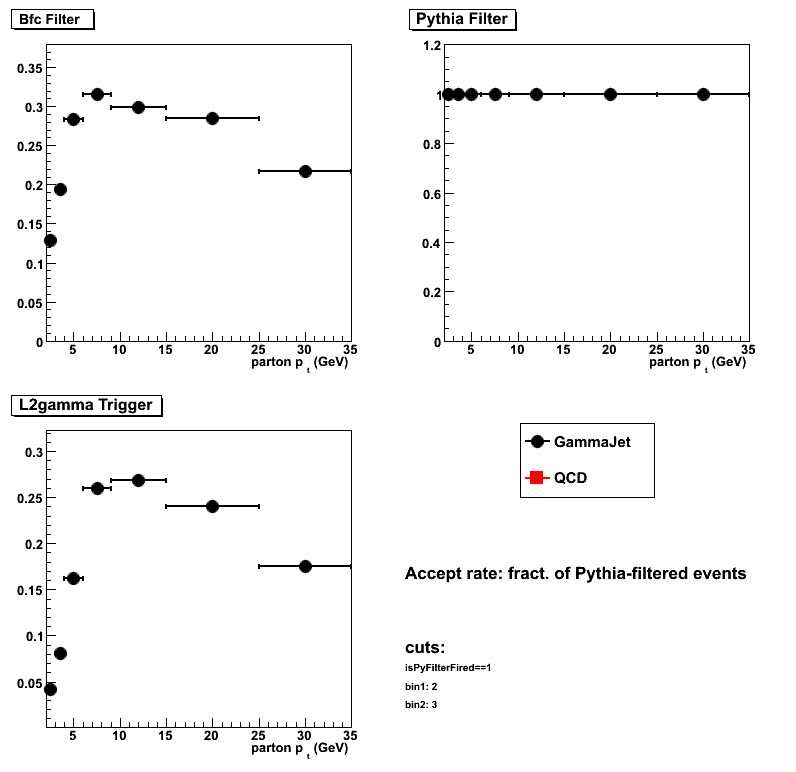
| Accept rate: fract. of Pythia-filtered events | |||
| GammaJet | |||
| pt bin | Bfc Filter | Pythia Filter | L2gamma Trigger |
| pt=2-3 | 0.128816 | 1 | 0.0415488 |
| pt=3-4 | 0.193735 | 1 | 0.0808397 |
| pt=4-6 | 0.283232 | 1 | 0.161877 |
| pt=6-9 | 0.316049 | 1 | 0.260291 |
| pt=9-15 | 0.29943 | 1 | 0.26876 |
| pt=15-25 | 0.284813 | 1 | 0.240415 |
| pt=25-35 | 0.217053 | 1 | 0.175156 |
Figure 4: False rejection relative to Pythia filter accepted events
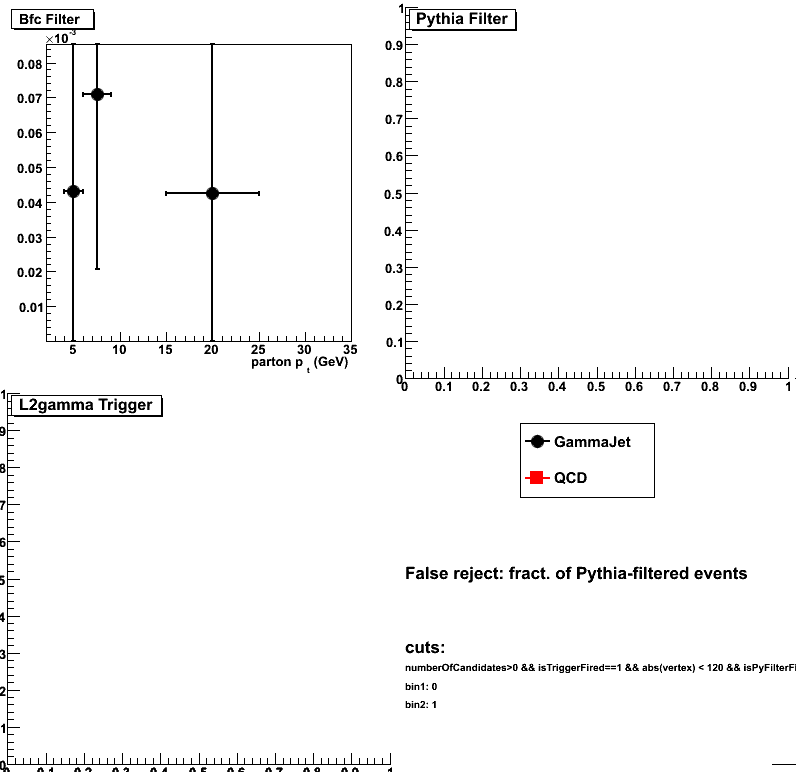
| False reject: fract. of Pythia-filtered events | |||
| GammaJet | |||
| pt bin | Bfc Filter | Pythia Filter | L2gamma Trigger |
| pt=2-3 | 0 | 0 | 0 |
| pt=3-4 | 0 | 0 | 0 |
| pt=4-6 | 4.30182e-05 | 0 | 0 |
| pt=6-9 | 7.10303e-05 | 0 | 0 |
| pt=9-15 | 0 | 0 | 0 |
| pt=15-25 | 4.26494e-05 | 0 | 0 |
| pt=25-35 | 0 | 0 | 0 |
2010.04.17 Pythia/BFC gamma-filter accaptance vs. gamma candidate pt, energy, and eta
Data sample used:
Pythia prompt photon Monte-Carlo (partonic pt bins are combined without weights)
Common event cuts:
reconstruct at least one gamma candidate, |v_z| <120, !=0 l2e-gamma-trigger=fired
Figure 1:
- upper panel:
Number of candidates vs. gamma candidate pt for specific filter/trigger fired. - lower panel:
Pythia/bfc filter false rejection vs. gamma candidate pt - left panel:
Pythis (bfc) filter configured with seed=2.6 (3.4) and cluster=3.6 (4.5) - right panel:
Pythis (bfc) filter configured with seed=2.4 (2.8) and cluster=3.3 (3.8)
Figure 2: Same as Fig. 1 vs. gamma candidate energy
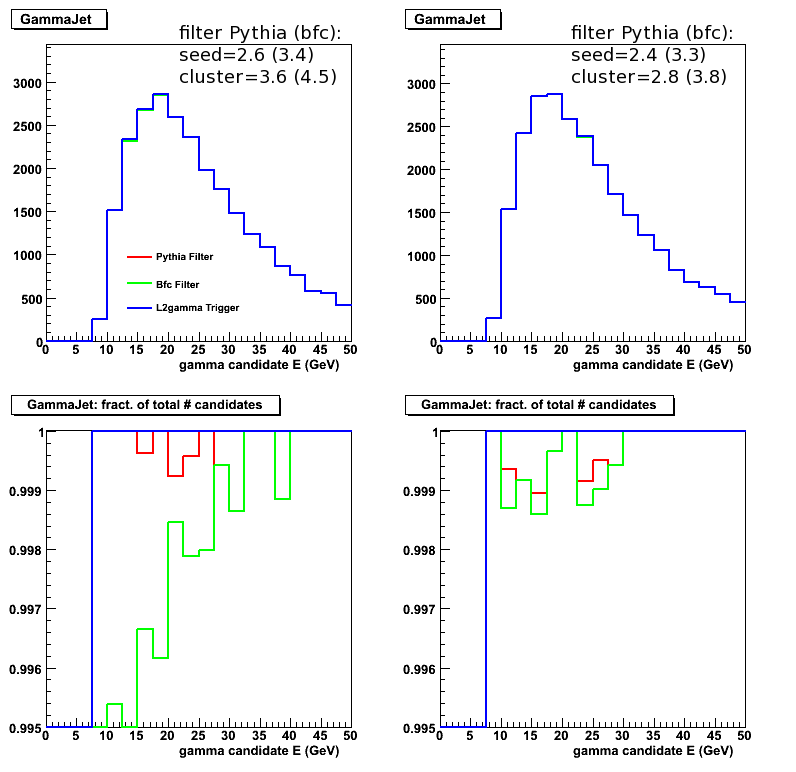
Figure 3: Same as Fig. 1 vs. gamma candidate pseudo-rapidity
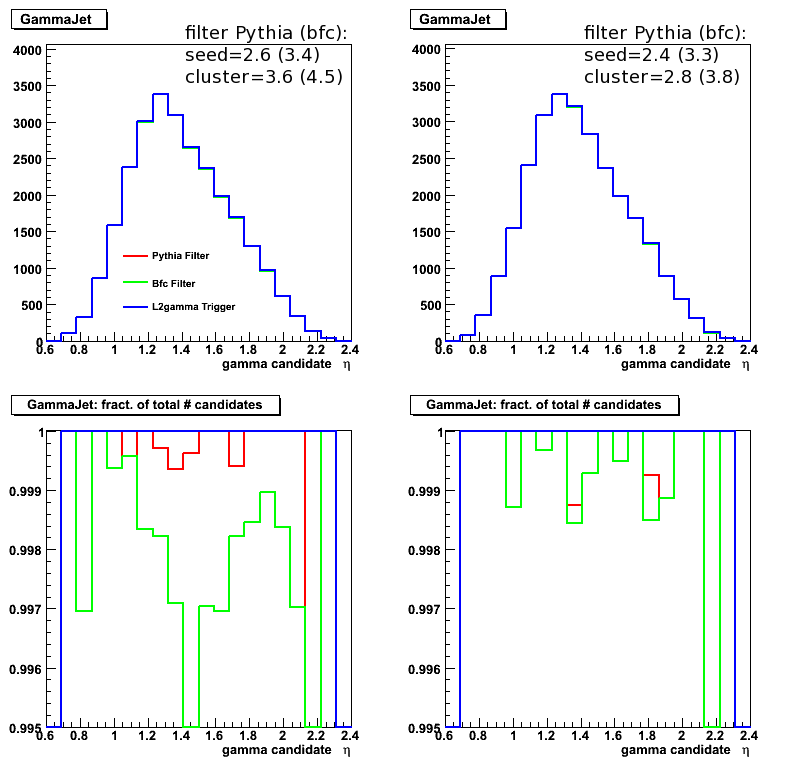
2010.04.30 BFC and Pythia QA after gamma-maker 3x3 cluser fix
Related inks:
- 3x3 clusering and gamma maker fix
- Alice' study with QCD sample
- QCD and gamma-jet data samples are described here
(filter parameters are listed below)
Number of generated events per partnic pt bin:
gamma-jet: 25K
QCD(2-4): 50K
QCD(4-55): 25K
Pythia filter configuration
StEemcGammaFilter:: running the TEST mode (accepting all events). Set mFilterMode=1 to actually reject events
StEemcGammaFilter:: mConeRadius 0.22 mSeedThreshold 3.8 mClusterThreshold 5 mEtaLow 0.95 mEtaHigh 2.1 mMaxVertex 120
StEemcGammaFilter:: mCalDepth 279.5 mMinPartEnergy 1e-05 mHadronScale 1 mFilterMode 0 mPrintLevel 1
BFC filter configuration
StChain:INFO - Init() : Using gamma filter on the EEMC
StChain:INFO - Init() : EEMC Sampling Fraction = 0.05
StChain:INFO - Init() : Seed energy threshold = 3.8 GeV
StChain:INFO - Init() : Cluster eT threshold = 5 GeV
StChain:INFO - Init() : Maximum vertex = +/- 120 cm
StChain:INFO - Init() : Running the TEST mode (accepting all events). Set mFilterMode=1 to actually reject events in BFC
StEEmcSlowMaker configuration
BFC:INFO - setTowerGainSpread(): gain spread: 0; gain mean value: 1.1
GammaMaker configuration
runSimuGammaTreeMaker():: GammaMaker config: ConeRadius 0.7 ClusterEtThreshold 5.5 SeedEnergyThreshold 4.2 ClusterEnergyThreshold 5.5 BsmdRange 0.05237 EsmdR ange 20
A2Emaker configuration
StEEmcA2EMaker *EEanalysis = new StEEmcA2EMaker("mEEanalysis");
EEanalysis->threshold(3.0, 0); // tower threshold (ped+N sigma)
EEanalysis->threshold(3.0, 1); // pre1 threshold
EEanalysis->threshold(3.0, 2); // pre2 threshold
EEanalysis->threshold(3.0, 3); // post threshold
EEanalysis->threshold(3.0, 4); // smdu threshold
EEanalysis->threshold(3.0, 5); // smdv threshold
Trigger configuration
emulate L2E-gamma trigger for Run 2006 [eemc-http-mb-l2gamma:: id 137641]
Trigger conditions:
cluster Et (2x2) = 5.2GeV
seed Et = 3.7GeV
Accept/Reject relative to the total number of Pythia generated events
Figure 1: Fraction of accepted events
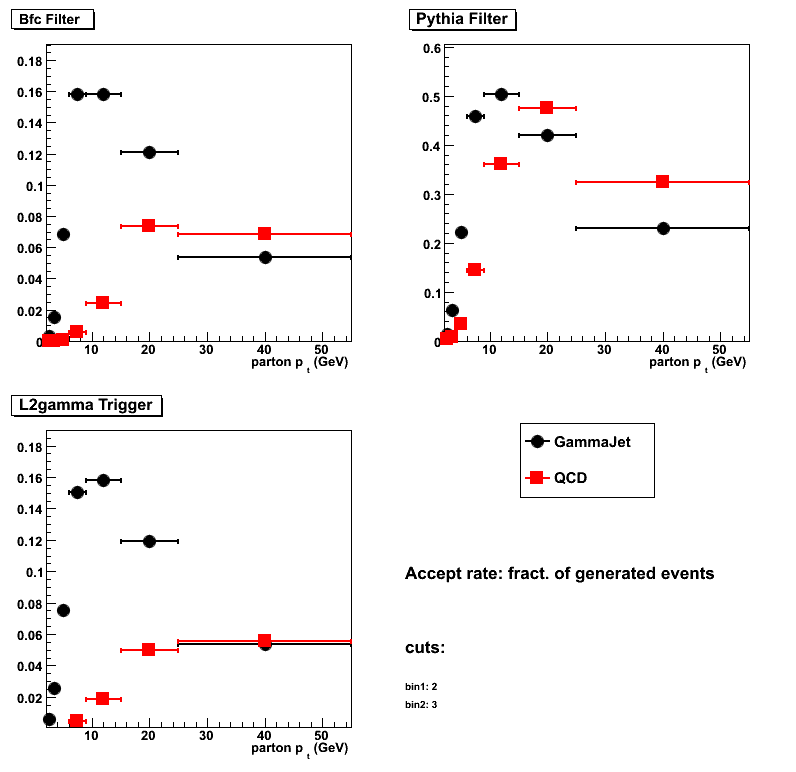
| Accept rate: fract. of generated events | |||
| GammaJet | |||
| pt bin | Bfc Filter | Pythia Filter | L2gamma Trigger |
| pt=2-3 | 0.00288 | 0.01472 | 0.00616 |
| pt=3-4 | 0.01504 | 0.06192 | 0.02576 |
| pt=4-6 | 0.06824 | 0.22112 | 0.07548 |
| pt=6-9 | 0.15848 | 0.45836 | 0.15016 |
| pt=9-15 | 0.1584 | 0.50416 | 0.15812 |
| pt=15-25 | 0.12112 | 0.42076 | 0.11916 |
| pt=25-55 | 0.05356 | 0.2292 | 0.0538 |
| QCD | |||
| pt bin | Bfc Filter | Pythia Filter | L2gamma Trigger |
| pt=2-3 | 2e-05 | 0.00258 | 6e-05 |
| pt=3-4 | 6e-05 | 0.00854 | 0.00022 |
| pt=4-6 | 0.00072 | 0.03492 | 0.00076 |
| pt=6-9 | 0.00564 | 0.144 | 0.00496 |
| pt=9-15 | 0.0242 | 0.36036 | 0.0186 |
| pt=15-25 | 0.07368 | 0.47592 | 0.05008 |
| pt=25-55 | 0.0684553 | 0.323374 | 0.0557724 |
Figure 2: False rejection (Y-axis scale is 10^-3)
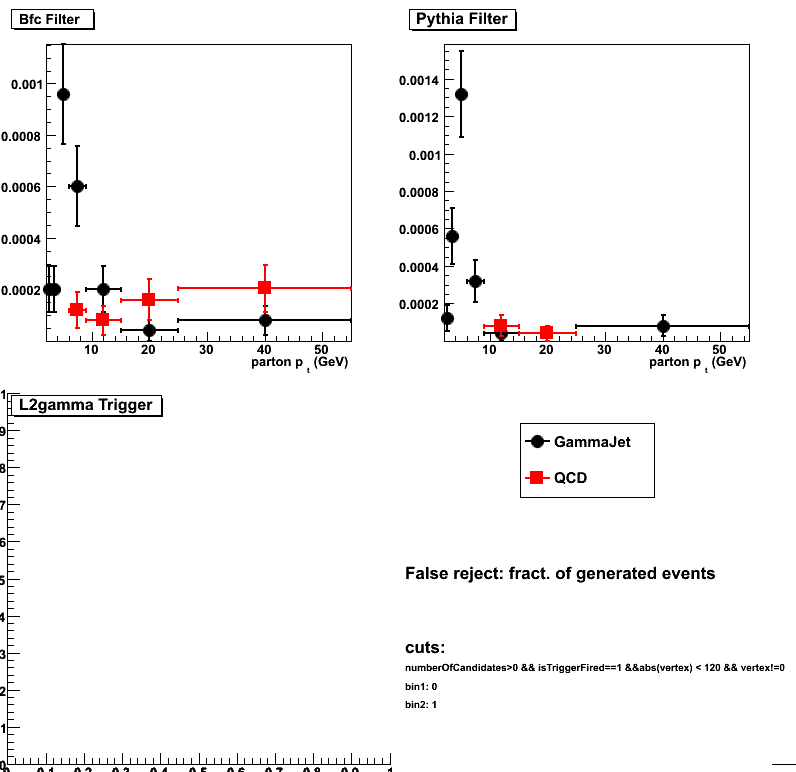
| False reject: fract. of generated events | |||
| GammaJet | |||
| pt bin | Bfc Filter | Pythia Filter | L2gamma Trigger |
| pt=2-3 | 0.0002 | 0.00012 | 0 |
| pt=3-4 | 0.0002 | 0.00056 | 0 |
| pt=4-6 | 0.00096 | 0.00132 | 0 |
| pt=6-9 | 0.0006 | 0.00032 | 0 |
| pt=9-15 | 0.0002 | 4e-05 | 0 |
| pt=15-25 | 4e-05 | 0 | 0 |
| pt=25-55 | 8e-05 | 8e-05 | 0 |
| QCD | |||
| pt bin | Bfc Filter | Pythia Filter | L2gamma Trigger |
| pt=2-3 | 0 | 0 | 0 |
| pt=3-4 | 0 | 0 | 0 |
| pt=4-6 | 0 | 0 | 0 |
| pt=6-9 | 0.00012 | 0 | 0 |
| pt=9-15 | 8e-05 | 8e-05 | 0 |
| pt=15-25 | 0.00016 | 4e-05 | 0 |
| pt=25-55 | 0.000203252 | 0 | 0 |
Accept/Reject relative to the number of Pythia filter accepted events
Figure 3: Fraction of accepted events relative to Pythia filter accepted events
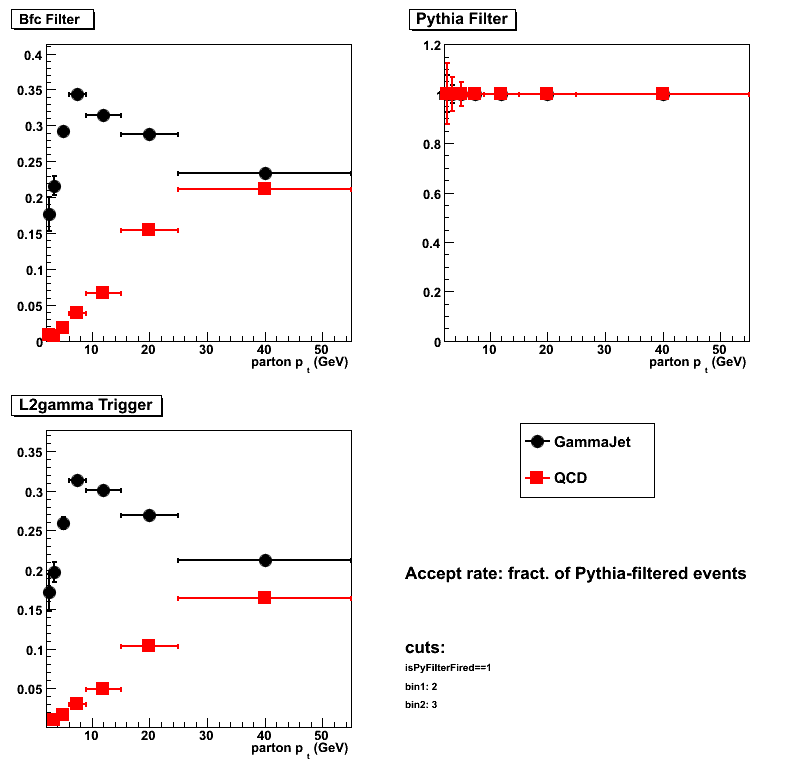
| Accept rate: fract. of Pythia-filtered events | |||
| GammaJet | |||
| pt bin | Bfc Filter | Pythia Filter | L2gamma Trigger |
| pt=2-3 | 0.17663 | 1 | 0.171196 |
| pt=3-4 | 0.215762 | 1 | 0.197028 |
| pt=4-6 | 0.291787 | 1 | 0.259407 |
| pt=6-9 | 0.344096 | 1 | 0.313814 |
| pt=9-15 | 0.314107 | 1 | 0.301254 |
| pt=15-25 | 0.28786 | 1 | 0.269798 |
| pt=25-55 | 0.233333 | 1 | 0.211693 |
| QCD | |||
| pt bin | Bfc Filter | Pythia Filter | L2gamma Trigger |
| pt=2-3 | 0.00775194 | 1 | 0 |
| pt=3-4 | 0.00702576 | 1 | 0.00936768 |
| pt=4-6 | 0.0183276 | 1 | 0.0160367 |
| pt=6-9 | 0.0386111 | 1 | 0.0294444 |
| pt=9-15 | 0.0667111 | 1 | 0.048618 |
| pt=15-25 | 0.154816 | 1 | 0.102706 |
| pt=25-55 | 0.211691 | 1 | 0.163545 |
Figure 4: False rejection relative to Pythia filter accepted events
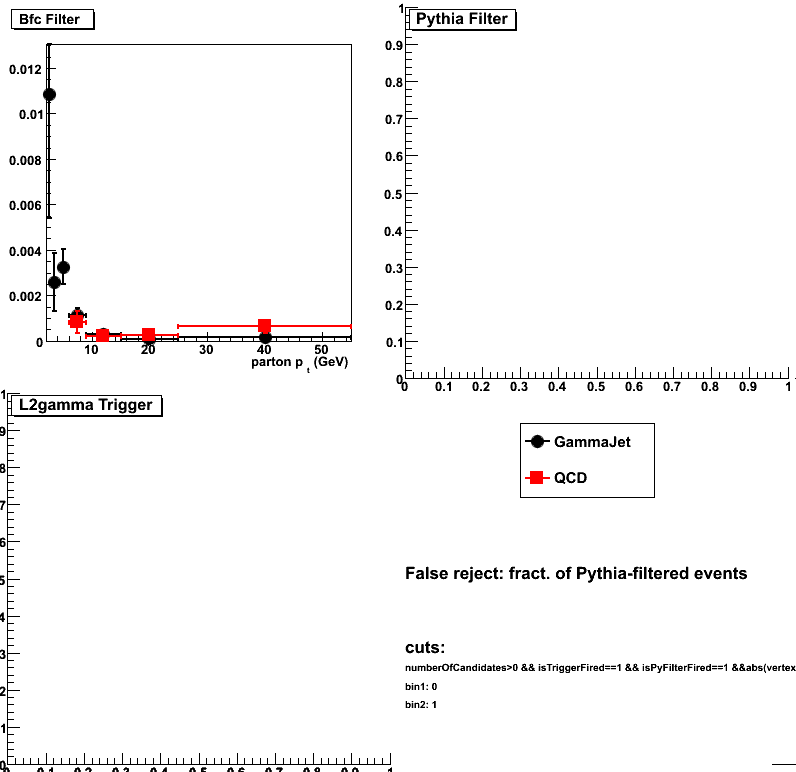
| False reject: fract. of Pythia-filtered events | |||
| GammaJet | |||
| pt bin | Bfc Filter | Pythia Filter | L2gamma Trigger |
| pt=2-3 | 0.0108696 | 0 | 0 |
| pt=3-4 | 0.00258398 | 0 | 0 |
| pt=4-6 | 0.00325615 | 0 | 0 |
| pt=6-9 | 0.00113448 | 0 | 0 |
| pt=9-15 | 0.00031736 | 0 | 0 |
| pt=15-25 | 9.50661e-05 | 0 | 0 |
| pt=25-55 | 0.00017452 | 0 | 0 |
| QCD | |||
| pt bin | Bfc Filter | Pythia Filter | L2gamma Trigger |
| pt=2-3 | 0 | 0 | 0 |
| pt=3-4 | 0 | 0 | 0 |
| pt=4-6 | 0 | 0 | 0 |
| pt=6-9 | 0.000833333 | 0 | 0 |
| pt=9-15 | 0.000222 | 0 | 0 |
| pt=15-25 | 0.000252143 | 0 | 0 |
| pt=25-55 | 0.000628536 | 0 | 0 |
Figure 5: False rejection relative to trigger accepted events
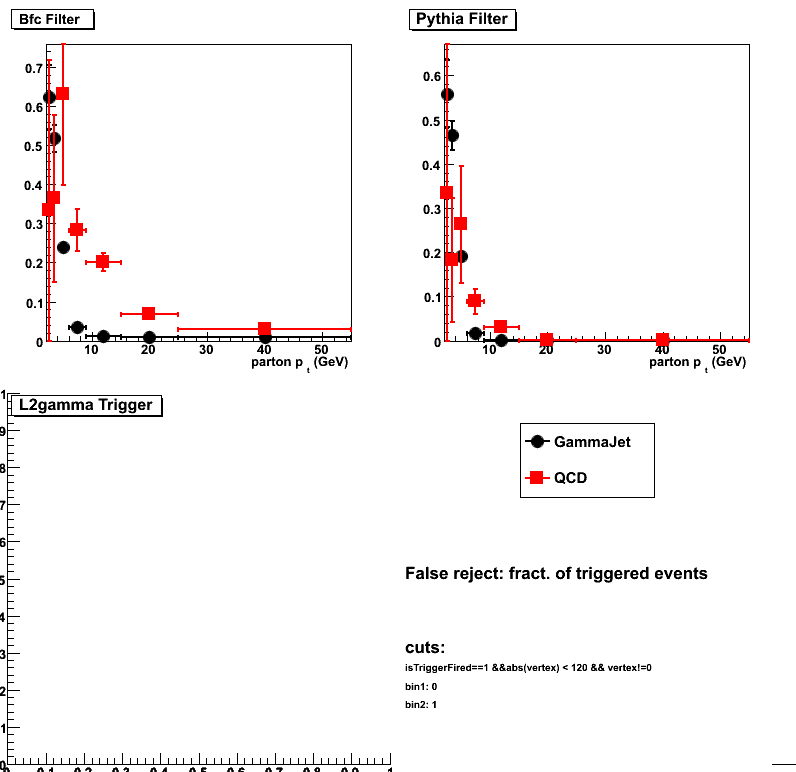
| False reject: fract. of triggered events | |||
| GammaJet | |||
| pt bin | Bfc Filter | Pythia Filter | L2gamma Trigger |
| pt=2-3 | 0.623377 | 0.558442 | 0 |
| pt=3-4 | 0.517081 | 0.464286 | 0 |
| pt=4-6 | 0.240594 | 0.192369 | 0 |
| pt=6-9 | 0.0348961 | 0.0167821 | 0 |
| pt=9-15 | 0.0111308 | 0.00151783 | 0 |
| pt=15-25 | 0.00872776 | 0.00134273 | 0 |
| pt=25-55 | 0.00966543 | 0.00148699 | 0 |
| QCD | |||
| pt bin | Bfc Filter | Pythia Filter | L2gamma Trigger |
| pt=2-3 | 0.333333 | 0.333333 | 0 |
| pt=3-4 | 0.363636 | 0.181818 | 0 |
| pt=4-6 | 0.631579 | 0.263158 | 0 |
| pt=6-9 | 0.282258 | 0.0887097 | 0 |
| pt=9-15 | 0.202151 | 0.0301075 | 0 |
| pt=15-25 | 0.0686901 | 0.000798722 | 0 |
| pt=25-55 | 0.0291545 | 0.000728863 | 0 |
05 May
May 2010 posts
2010.05.03 Pythia/BFC gamma-filter accaptance vs. gamma candidate pt (after gamma-maker 3x3 cluser fix)
Related inks:
- BFC and Pythia filter biases vs. partonic pt
- 3x3 clusering and gamma maker fix
- Alice' study with QCD sample
- QCD and gamma-jet data samples are described here
(filter parameters are listed below)
Number of generated events per partnic pt bin:
gamma-jet: 25K
QCD(2-4): 50K
QCD(4-55): 25K
Pythia filter configuration
StEemcGammaFilter:: running the TEST mode (accepting all events). Set mFilterMode=1 to actually reject events
StEemcGammaFilter:: mConeRadius 0.22 mSeedThreshold 3.8 mClusterThreshold 5 mEtaLow 0.95 mEtaHigh 2.1 mMaxVertex 120
StEemcGammaFilter:: mCalDepth 279.5 mMinPartEnergy 1e-05 mHadronScale 1 mFilterMode 0 mPrintLevel 1
BFC filter configuration
StChain:INFO - Init() : Using gamma filter on the EEMC
StChain:INFO - Init() : EEMC Sampling Fraction = 0.05
StChain:INFO - Init() : Seed energy threshold = 3.8 GeV
StChain:INFO - Init() : Cluster eT threshold = 5 GeV
StChain:INFO - Init() : Maximum vertex = +/- 120 cm
StChain:INFO - Init() : Running the TEST mode (accepting all events). Set mFilterMode=1 to actually reject events in BFC
StEEmcSlowMaker configuration
BFC:INFO - setTowerGainSpread(): gain spread: 0; gain mean value: 1.1
GammaMaker configuration
runSimuGammaTreeMaker():: GammaMaker config: ConeRadius 0.7 ClusterEtThreshold 5.5 SeedEnergyThreshold 4.2 ClusterEnergyThreshold 5.5 BsmdRange 0.05237 EsmdR ange 20
A2Emaker configuration
StEEmcA2EMaker *EEanalysis = new StEEmcA2EMaker("mEEanalysis");
EEanalysis->threshold(3.0, 0); // tower threshold (ped+N sigma)
EEanalysis->threshold(3.0, 1); // pre1 threshold
EEanalysis->threshold(3.0, 2); // pre2 threshold
EEanalysis->threshold(3.0, 3); // post threshold
EEanalysis->threshold(3.0, 4); // smdu threshold
EEanalysis->threshold(3.0, 5); // smdv threshold
Trigger configuration
emulate L2E-gamma trigger for Run 2006 [eemc-http-mb-l2gamma:: id 137641]
Trigger conditions:
cluster Et (2x2) = 5.2GeV
seed Et = 3.7GeV
Accept/Reject relative to the total number of offline selected events
Definition: offline selected events are events which satisfy to the following conditions:
- Online condition (L2E-gamma trigger fired)
- Reconstructed vetrex (|v_z|<120cm)
- Offline condition (at least one gammaMaker candidate found)
Figure 1a:
(upper plots) Gamma candidate yields vs. candidate pt (all partonic pt bins, no pt weights)
(lower plots) False rejection: histograms in the upper panel scaled by L2E-gamma-trigger yield (blue histogram)

Figure 1b: Same ad Fig. 1a with zoom into low pt region
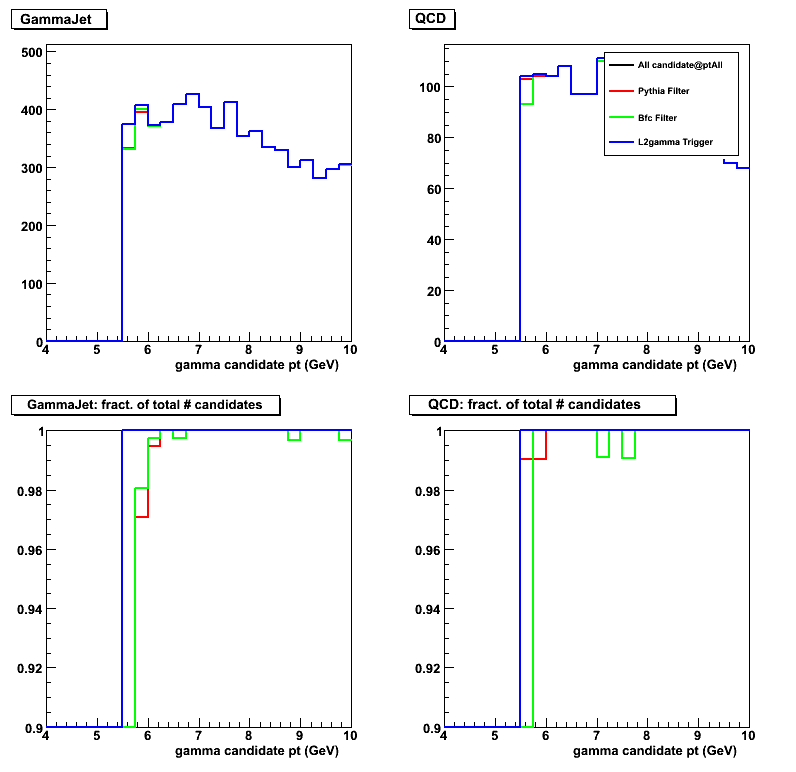
Yields for each of partonic pt bins separately
Figure 2: Same ad Fig. 1b for partonic pt=2-3
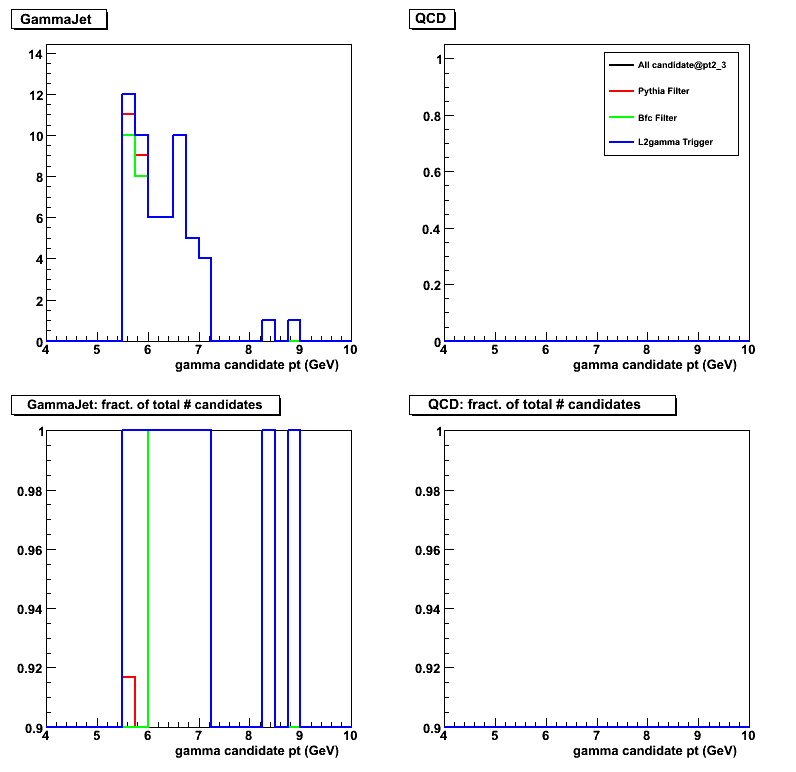
Figure 3: Same ad Fig. 1b for partonic pt=3-4
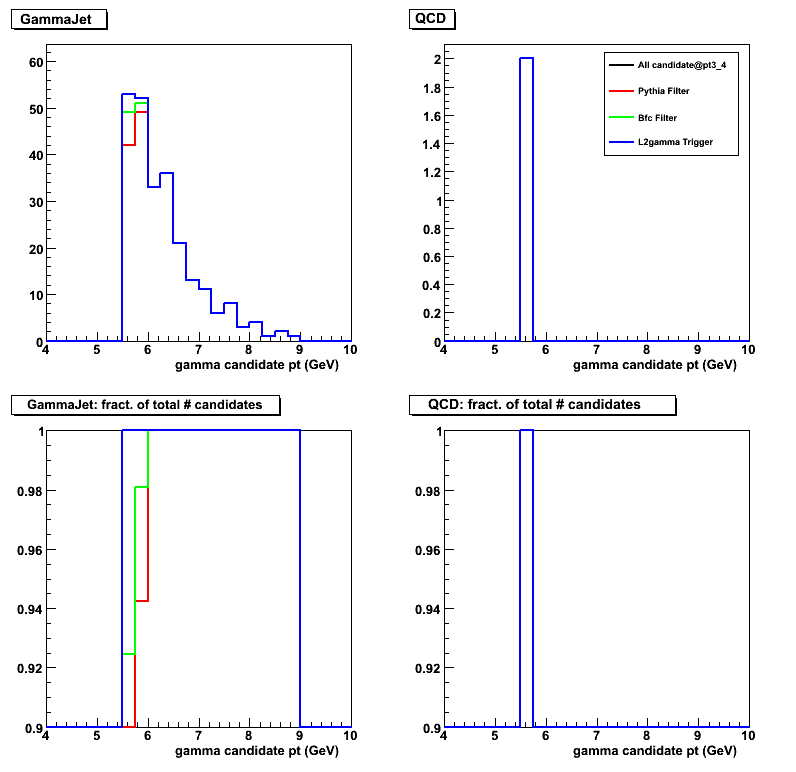
Figure 4: Same ad Fig. 1b for partonic pt=4-6
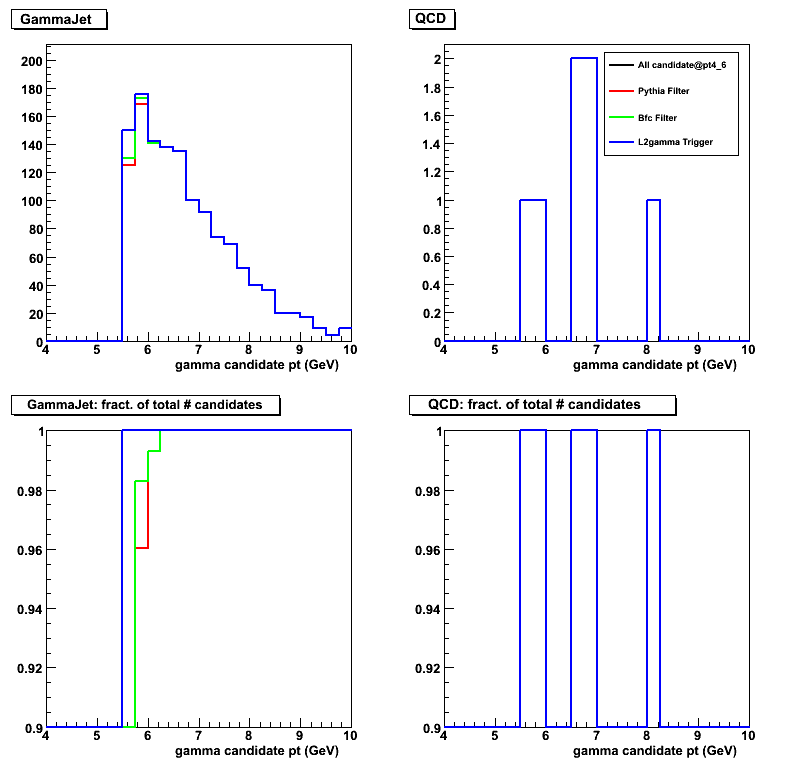
Figure 5: Same ad Fig. 1b for partonic pt=6-9
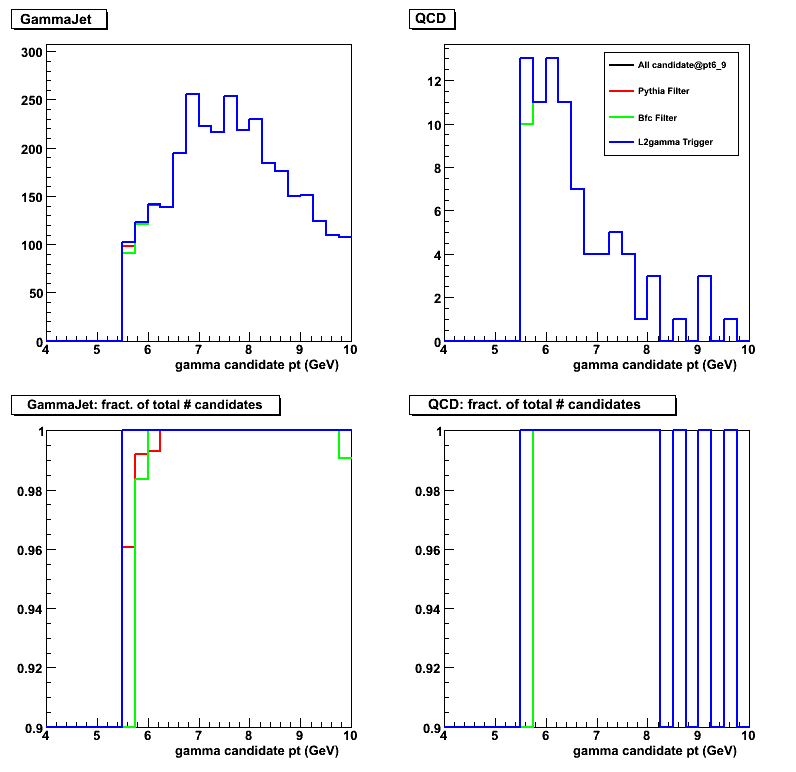
Figure 6: Same ad Fig. 1b for partonic pt=9-15
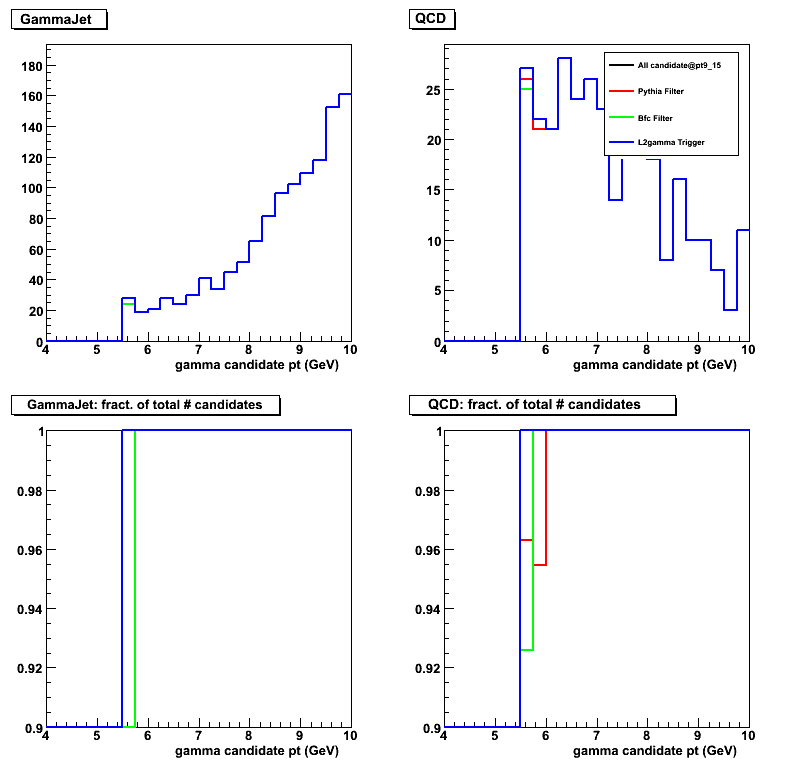
2010.05.05 Starsim/bfc timing tests
Related inks:
Figure 1: BFC filter processing time for accepted events
Note an extra peaks around 23/33/43 seconds for the QCD sample
(they also present but less pronounced in gamma-jet sample)
I found that these are processing times needed for the first accepted by filter events
(not always the time for the first processed event and depends on filter acceptance rate).
Processing is much longer due to time needed to initiaize additional stuff in bfc makers
and it is ignored in the total cpu time estimate
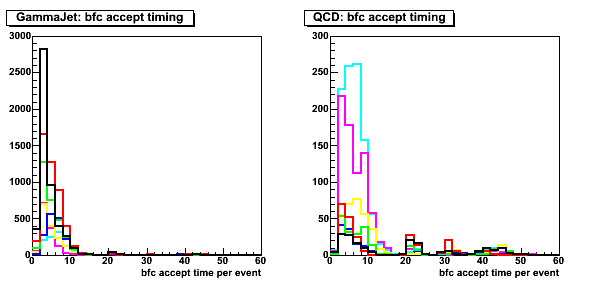
Figure 1b:
1st row: starsim time per partonic pt bin
2nd row: bfc time for accepted events per partonic pt bin
3rd row: bfc time for rejected events per partonic pt bin
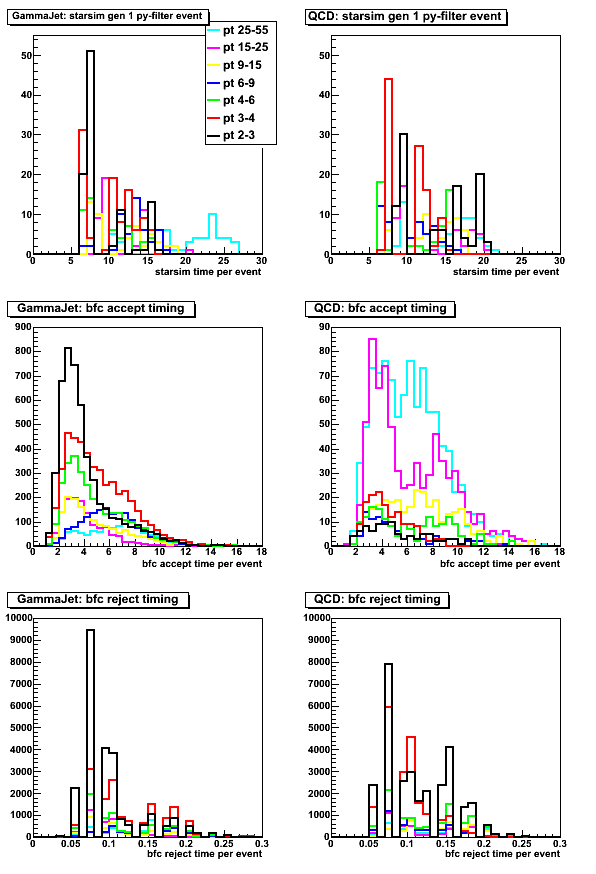
Average starsim/bfc timing (ignoring times in Fig. 1 with more that 18 seconds):
Gamma-jets bfc:acc starsim bfc:rej
pt=25-55 6.49765 20.2376 0.139911
pt=15-25 4.04562 11.8268 0.095903
pt=9-15 4.84475 11.4816 0.112344
pt=6-9 6.19909 13.0528 0.143109
pt=4-6 4.86546 9.8856 0.114983
pt=3-4 5.07415 10.404 0.12363
pt=2-3 4.04254 9.04627 0.0995413
QCD bfc:acc starsim bfc:rej
pt=25-55 6.18626 14.9944 0.13752
pt=15-25 6.20077 12.9668 0.126722
pt=9-15 6.848 13.7706 0.140625
pt=6-9 5.29513 10.3708 0.110363
pt=4-6 6.29547 11.5318 0.127077
pt=3-4 4.45859 10.1538 0.0986285
pt=2-3 5.26187 13.9151 0.114372
2010.05.13 BFC and Pythia QA after Pythia Eta -> - Eta
Related inks:
- Results before bug fix (See Fig. 1 upper right)
Pythia filter bug details:
bug in Pythia Filter StEemcGammaFilter.cxx:
double scale = (mCalDepth-v[2]) / p[2];
for(unsigned int j = 0; j < 3; ++j) p[j] = p[j] * scale + v[j];
Should be "abs(p[2])" in the "scale" factor.
Otherwise this will transfer all - Eta -> Eta,
and such tracks will pass the consequent Endcap rapidity cut:
if(detectorV.Eta() < mEtaLow || detectorV.Eta() > mEtaHigh) continue;
what will increase Pythia filter accept rate by a factor of 2.
Number of generated events per partnic pt bin:
Note: not every jib finished due to RCF scheduler upgrade
gamma-jet: 25K
QCD(2-4): 50K
QCD(4-55): 25K
Pythia filter configuration
StEemcGammaFilter:: running the TEST mode (accepting all events). Set mFilterMode=1 to actually reject events
StEemcGammaFilter:: mConeRadius 0.22 mSeedThreshold 3.8 mClusterThreshold 5 mEtaLow 0.95 mEtaHigh 2.1 mMaxVertex 120
StEemcGammaFilter:: mCalDepth 279.5 mMinPartEnergy 1e-05 mHadronScale 1 mFilterMode 0 mPrintLevel 1
BFC filter configuration
StChain:INFO - Init() : Using gamma filter on the EEMC
StChain:INFO - Init() : EEMC Sampling Fraction = 0.05
StChain:INFO - Init() : Seed energy threshold = 3.3 GeV
StChain:INFO - Init() : Cluster eT threshold = 4.5 GeV
StChain:INFO - Init() : Maximum vertex = +/- 120 cm
StChain:INFO - Init() : Running the TEST mode (accepting all events). Set mFilterMode=1 to actually reject events in BFC
StEEmcSlowMaker configuration
BFC:INFO - setTowerGainSpread(): gain spread: 0; gain mean value: 1.1
GammaMaker configuration
runSimuGammaTreeMaker():: GammaMaker config: ConeRadius 0.7 ClusterEtThreshold 5.5 SeedEnergyThreshold 4.2 ClusterEnergyThreshold 5.5 BsmdRange 0.05237 EsmdR ange 20
A2Emaker configuration
StEEmcA2EMaker *EEanalysis = new StEEmcA2EMaker("mEEanalysis");
EEanalysis->threshold(3.0, 0); // tower threshold (ped+N sigma)
EEanalysis->threshold(3.0, 1); // pre1 threshold
EEanalysis->threshold(3.0, 2); // pre2 threshold
EEanalysis->threshold(3.0, 3); // post threshold
EEanalysis->threshold(3.0, 4); // smdu threshold
EEanalysis->threshold(3.0, 5); // smdv threshold
Trigger configuration
emulate L2E-gamma trigger for Run 2006 [eemc-http-mb-l2gamma:: id 137641]
Trigger conditions:
cluster Et (2x2) = 5.2GeV
seed Et = 3.7GeV
Accept/Reject relative to the total number of Pythia generated events
Figure 1: Fraction of accepted events
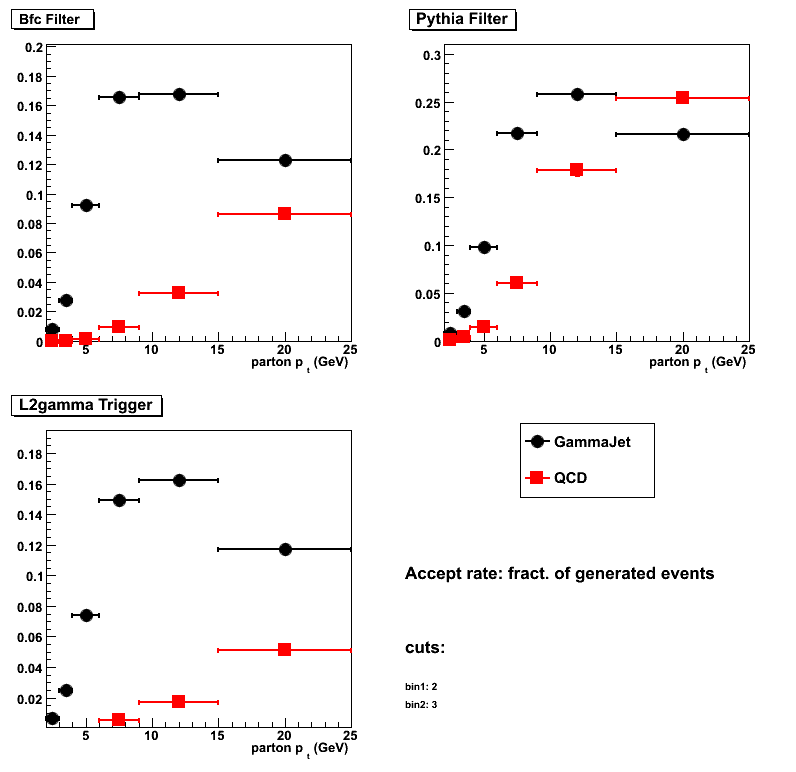
| Accept rate: fract. of generated events | |||
| GammaJet | |||
| pt bin | Bfc Filter | Pythia Filter | L2gamma Trigger |
| pt=2-3 | 0.00772455 | 0.00820359 | 0.00646707 |
| pt=3-4 | 0.0276027 | 0.0311644 | 0.024726 |
| pt=4-6 | 0.0924862 | 0.0980663 | 0.0743646 |
| pt=6-9 | 0.165708 | 0.217554 | 0.149013 |
| pt=9-15 | 0.167815 | 0.258319 | 0.162353 |
| pt=15-25 | 0.123 | 0.215667 | 0.117083 |
| QCD | |||
| pt bin | Bfc Filter | Pythia Filter | L2gamma Trigger |
| pt=2-3 | 0.000107527 | 0.000430108 | 0.000107527 |
| pt=3-4 | 0.000117647 | 0.00358824 | 5.88235e-05 |
| pt=4-6 | 0.00115385 | 0.0146154 | 0.000576923 |
| pt=6-9 | 0.00932927 | 0.06 | 0.00530488 |
| pt=9-15 | 0.0325 | 0.178846 | 0.0173077 |
| pt=15-25 | 0.0860331 | 0.253802 | 0.0510331 |
| False reject: fract. of generated events | |||
| GammaJet | |||
| pt bin | Bfc Filter | Pythia Filter | L2gamma Trigger |
| pt=2-3 | 0 | 0.000359281 | 0 |
| pt=3-4 | 0 | 0.000616438 | 0 |
| pt=4-6 | 0.000165746 | 0.00436464 | 0 |
| pt=6-9 | 0.000128755 | 0.00270386 | 0 |
| pt=9-15 | 0 | 0.000210084 | 0 |
| pt=15-25 | 0.00025 | 0.00025 | 0 |
| QCD | |||
| pt bin | Bfc Filter | Pythia Filter | L2gamma Trigger |
| pt=2-3 | 0 | 0 | 0 |
| pt=3-4 | 0 | 0 | 0 |
| pt=4-6 | 0 | 0 | 0 |
| pt=6-9 | 0 | 0.000121951 | 0 |
| pt=9-15 | 0 | 0 | 0 |
| pt=15-25 | 4.13223e-05 | 0.000123967 | 0 |
Accept/Reject relative to the number of Pythia filter accepted events
| Accept rate: fract. of Pythia-filtered events | |||
| GammaJet | |||
| pt bin | Bfc Filter | Pythia Filter | L2gamma Trigger |
| pt=2-3 | 0.518248 | 1 | 0.49635 |
| pt=3-4 | 0.505495 | 1 | 0.525275 |
| pt=4-6 | 0.663662 | 1 | 0.614648 |
| pt=6-9 | 0.703492 | 1 | 0.64707 |
| pt=9-15 | 0.645576 | 1 | 0.605563 |
| pt=15-25 | 0.568006 | 1 | 0.510433 |
| QCD | |||
| pt bin | Bfc Filter | Pythia Filter | L2gamma Trigger |
| pt=2-3 | 0.02857 | 1 | 0 |
| pt=3-4 | 0.05161 | 1 | 0 |
| pt=4-6 | 0.0526316 | 1 | 0.0394737 |
| pt=6-9 | 0.126016 | 1 | 0.0731707 |
| pt=9-15 | 0.173118 | 1 | 0.0935484 |
| pt=15-25 | 0.334419 | 1 | 0.194074 |
2010.05.27 Run 6 and Run 9 jet Tree production
Useful inks:
- Run 6 Murad's note:
http://www.star.bnl.gov/HyperNews-star/protected/get/jetfinding/664/1/1.html - Run 9 Pibero's note:
http://www.star.bnl.gov/HyperNews-star/protected/get/jetfinding/1010.html - Jan's note on "tower ADC - pedestal > 3 * RMS":
http://www.star.bnl.gov/HyperNews-star/protected/get/jetfinding/1010/2.html - Ily'as post on EEMC only jets for 5-hit branch:
http://www.star.bnl.gov/HyperNews-star/protected/get/jetfinding/1010/3/1/1/1/2.html - Trigger list for Run 9:
http://www.star.bnl.gov/protected/common/common2009/trigger2009/triggers2009.html - Pibero's jet tree format:
http://www4.rcf.bnl.gov/~pibero/spin/jets/2010.04.20 - Disk space estimates for Run 9:
http://www.star.bnl.gov/HyperNews-star/protected/get/ jetfinding/1010/1/1/2/1.html
http://www.star.bnl.gov/HyperNews-star/protected/get/ jetfinding/1010/3/1/1/1.html
http://www.star.bnl.gov/HyperNews-star/protected/get/ jetfinding/1010/3/1/1/1/2/1. html
New jet tree format
Description can be found here
Jet finder Run 6 configuration
Jet tree branches
- 12-point branch
- 5-point branch (EEMC jets only)
General configuration
- cone radius = 0.7
- track/tower pT > 0.2 GeV
- trigger IDs: See the list below
- all primary vertices with rank > 0
- hadronic correction: 100% subtraction scheme
- track |DCA| < 3 cm
- pT-dependent DCAxy cut
- track (number of hits) / (number of possible hits) > 0.51
- track last point radius > 125 cm (ensure we get at least one point in TPC outer sector)
- tower E > 0
- tower status = 1
- tower ADC - pedestal > 3 * RMS
Triggers
pp@200GeV
addTrigger(127611); //HTTP
137611
5
127821 //HTTP-fast
137821
137822
127212 //HT2
137213
127501 //JP0
137501
127622 //JP0-etot
137622
127221 //JP1
137221
137222
137585 //bemc-jp2
127641 // eemc-http-mb-l2gamma
137641 // eemc-http-mb-l2gamma
6 // eemc-http-mb-l2gamma
Analysis cuts
StppAnaPars* anapars = new StppAnaPars();
anapars->setFlagMin(0);
anapars->setNhits(12);
anapars->setCutPtMin(0.2);
anapars->setAbsEtaMax(2.5);
anapars->setJetPtMin(3.5);
anapars->setJetEtaMax(100.0);
anapars->setJetEtaMin(0);
anapars->setJetNmin(0);
Cone finder configuration
StConePars* cpars = new StConePars();
cpars->setGridSpacing(105, -3.0, 3.0, 120,-TMath::Pi(),TMath::Pi());
cpars->setConeRadius(0.7);
cpars->setSeedEtMin(0.5);
cpars->setAssocEtMin(0.1);
cpars->setSplitFraction(0.5);
cpars->setPerformMinimization(true);
cpars->setAddMidpoints(true);
cpars->setRequireStableMidpoints(true);
cpars->setDoSplitMerge(true);
cpars->setDebug(false);
jetMaker->addAnalyzer(anapars, cpars, bet4pMaker, "ConeJets12");
anapars->setNhits(5);
jetMaker->addAnalyzer(anapars, cpars, bet4pMaker, "ConeJets5");
Disk space required
needs to be updated
Jet finder Run 9 configuration:
Jet tree branches
- 12-point branch
- Tower-only branch (jets without tracking)
- 5-point branch (EEMC jets only)
General configuration
- cone radius = 0.7
- track/tower pT > 0.2 GeV
- trigger IDs: JP1, L2JetHigh, BBCMB-Cat2 (luminosity monitor)
- all primary vertices with rank > 0
- hadronic correction: 100% subtraction scheme
- track |DCA| < 3 cm
- pT-dependent DCAxy cut (a la Run 6 with slight tuning around 0.5 < pT < 1.5 GeV)
- track chi^2 < 4
- track (number of hits) / (number of possible hits) > 0.51
- track last point radius > 125 cm (ensure we get at least one point in TPC outer sector)
- tower E > 0
- tower status = 1
- tower ADC - pedestal > 3 * RMS
Triggers
pp@200GeV
240410 // JP1 // lum: 0.246
240411 // JP1 // lum: 4.045
240650 // L2JetHigh // lum: 3.745
240651 // L2JetHigh // lum: 1.811
240652 // L2JetHigh // lum: 19.769
240620 // L2BGamma // lum: 23.004
240630 // L2EGamma // lum: 3.969
240631 // L2EGamma // lum: 21.592
240013 // BBCMB-Cat2 (luminosity monitor)
240113 // BBCMB-Cat2 (luminosity monitor)
240123 // BBCMB-Cat2 (luminosity monitor)
240223 // BBCMB-Cat2 (luminosity monitor)
pp@500GeV
230410 // JP1 // lum: 0.198
230411 // JP2 // lum: 8.089
230630 // L2EGamma // lum: 3.347
230013 // BBCMB-Cat2 (luminosity monitor)
Analysis cuts
StppAnaPars* anapars = new StppAnaPars;
anapars->setFlagMin(0); // track->flag() > 0
anapars->setCutPtMin(0.2); // track->pt() > 0.2
anapars->setAbsEtaMax(2.5); // abs(track->eta()) < 2.5
anapars->setJetPtMin(5.0);
anapars->setJetEtaMax(100.0);
anapars->setJetEtaMin(0);
anapars->setJetNmin(0);
Cone finder configuration
StConePars* cpars = new StConePars;
cpars->setGridSpacing(105,-3.
cpars->setSeedEtMin(0.5);
cpars->setAssocEtMin(0.1);
cpars->setSplitFraction(0.5);
cpars->setPerformMinimization(
cpars->setAddMidpoints(true);
cpars->
cpars->setDoSplitMerge(true);
cpars->setDebug(false);
Disk space required
1Tb (see links at the top of the page for mode details)
2010.05.28 Photon-jet candidates - Perugia vs. Tune A
Comments:
- See no difference in yilds for different tunes for prompt photons.
- ~ 20% shape differenbce for QCD background Monte-Carlo
Figure 1: Reconstructed gamma-jet candidate yield vs. photon candidate pt in the endcap
(di-jet events found with the jet finder) Prompt photon filtered Monte-Carlo, partonic pt 3-25 GeV
(a)
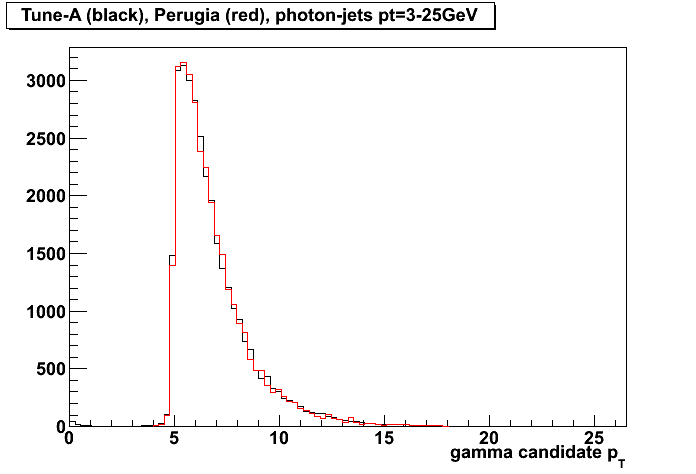
(b) Same as (a) on a log scale
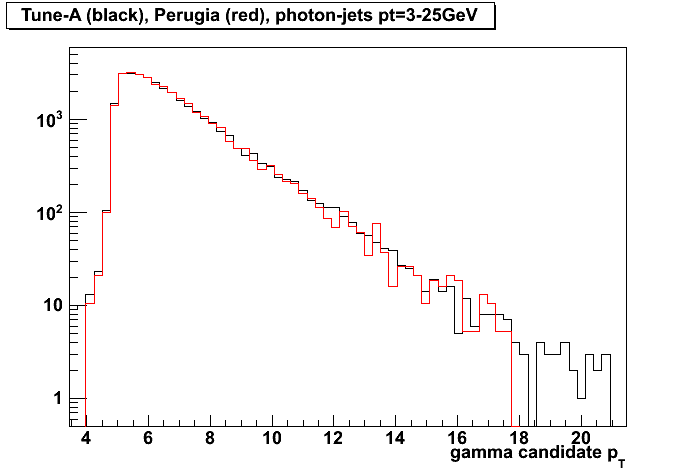
Figure 2: Same as Fig. 1 for QCD two processes filtered Monte-Carlo, partonic pt 6-9 GeV
(a)
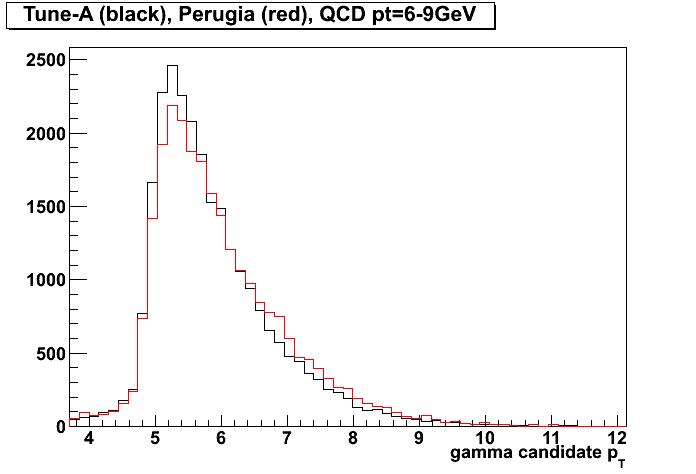
Same on a log scale
(b) Same as (a) on a log scale
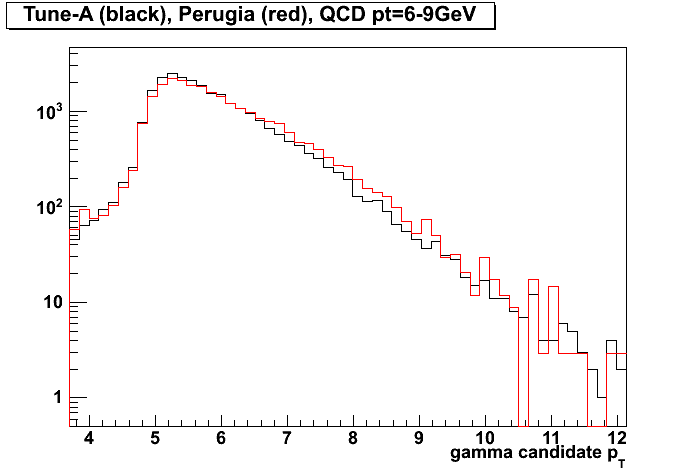
EEMC simulation spreadsheet: prompt photons and QCD
Related links:
- Lowered bfc threshold bias tests and Pythia with Eta -> -Eta bug fix
- BFC bias tests with same thresholds as Pythia
- Alice pi0 bias tests with lowerd bfc thresholds
Same thresholds for Pythia/BFC
1.4M events, 6.8 CPU years, 0.29Tb disk space
| parton pt, GeV | Pythia acc | bfc acc wrt. Pythia | Total filter's acc | Sigma, pb | lumi, 1/pb | Number of filtered events to generate | Total CPU time, days | disk space, Gb | starsim CPU, sec | bfc CPU, sec | Total Starsim CPU time, days | Total bfc CPU time, days | bfc acc |
| g-jets | |||||||||||||
| 2-3 | 0.00820 | 0.2663 | 0.00218 | 1304000 | 10.0 | 28491 | 14.60576 | 4.45 | 10.72 | 4.0 | 13.270 | 1.34 | 0.00288 |
| 3-4 | 0.03116 | 0.3787 | 0.01180 | 293300 | 10.0 | 34611 | 14.85782 | 5.63 | 12.19 | 4.9 | 12.901 | 1.96 | 0.01504 |
| 4-6 | 0.09807 | 0.5521 | 0.05414 | 126300 | 10.0 | 68382 | 20.99942 | 11.34 | 12.04 | 4.7 | 17.254 | 3.75 | 0.06824 |
| 6-9 | 0.21755 | 0.6688 | 0.14550 | 26090 | 10.0 | 37961 | 7.79574 | 6.48 | 9.56 | 3.4 | 6.280 | 1.52 | 0.15848 |
| 9-15 | 0.25832 | 0.6274 | 0.16207 | 4675 | 10.0 | 7577 | 1.95231 | 1.31 | 11.56 | 3.8 | 1.616 | 0.34 | 0.15840 |
| 15-25 | 0.21567 | 0.5394 | 0.11633 | 326 | 10.0 | 379 | 0.13531 | 0.07 | 14.34 | 4.2 | 0.117 | 0.02 | 0.12112 |
| totals: | 1754691 | 177401 | 60.3 | 29.29 | |||||||||
| 0.18 | 0.16533 | years | |||||||||||
| QCD | |||||||||||||
| 2-3 | 0.00043 | 0.0185 | 0.00001 | 8226000000 | 0.1 | 6545 | 68.81525 | 1.30 | 16.62 | 9.9 | 68.064 | 0.75 | 0.00002 |
| 3-4 | 0.00359 | 0.0268 | 0.00010 | 1295000000 | 0.2 | 24907 | 140.98015 | 5.32 | 12.88 | 8.3 | 138.594 | 2.39 | 0.00006 |
| 4-6 | 0.01462 | 0.0450 | 0.00066 | 440300000 | 1.0 | 289582 | 925.73023 | 57.50 | 12.07 | 7.9 | 899.343 | 26.39 | 0.00072 |
| 6-9 | 0.06000 | 0.0744 | 0.00446 | 57830000 | 2.0 | 516306 | 915.77947 | 111.13 | 10.94 | 6.2 | 878.663 | 37.12 | 0.00564 |
| 9-15 | 0.17885 | 0.1354 | 0.02422 | 7629000 | 2.0 | 369484 | 360.48698 | 77.18 | 10.72 | 5.1 | 338.666 | 21.82 | 0.02420 |
| 15-25 | 0.25380 | 0.2754 | 0.06990 | 381900 | 1.0 | 26694 | 17.99424 | 5.57 | 14.43 | 5.9 | 16.185 | 1.81 | 0.07368 |
| totals: | 10027140900 | 1233518 | 2429.78632 | 258.01 | |||||||||
| 1.23 | 6.65695 | years | |||||||||||
| number of events, x 10e6 | CPU years | disk space, Gb | total time with 50 CPU, weeks | total time with 100 CPU, weeks | |||||||||
| 1.41 | 6.8 | 287.3 | 7.1 | 3.6 |
Lowered BFC threshold that Pythia
2M events, 6.9 CPU years, 0.41Tb disk space
| parton pt, GeV | Pythia acc | bfc acc wrt. Pythia | Total filter's acc | Sigma, pb | lumi, 1/pb | Number of filtered events to generate | Total CPU time, days | disk space, Gb | starsim CPU, sec | bfc CPU, sec | Total Starsim CPU time, days | Total bfc CPU time, days | bfc acc |
| g-jets | |||||||||||||
| 2-3 | 0.00820 | 0.51825 | 0.00425 | 1304000 | 10.0 | 55439 | 15.74249 | 8.66 | 10.72 | 3.9 | 13.270 | 2.47 | 0.00772 |
| 3-4 | 0.03116 | 0.50550 | 0.01575 | 293300 | 10.0 | 46205 | 15.47012 | 7.52 | 12.19 | 4.8 | 12.901 | 2.57 | 0.02760 |
| 4-6 | 0.09807 | 0.66366 | 0.06508 | 126300 | 10.0 | 82200 | 21.71983 | 13.64 | 12.04 | 4.7 | 17.254 | 4.47 | 0.09249 |
| 6-9 | 0.21755 | 0.70349 | 0.15305 | 26090 | 10.0 | 39930 | 7.87117 | 6.82 | 9.56 | 3.4 | 6.280 | 1.59 | 0.16571 |
| 9-15 | 0.25832 | 0.64558 | 0.16676 | 4675 | 10.0 | 7796 | 1.96162 | 1.35 | 11.56 | 3.8 | 1.616 | 0.35 | 0.16782 |
| 15-25 | 0.21567 | 0.56801 | 0.12250 | 326 | 10.0 | 399 | 0.13625 | 0.07 | 14.34 | 4.2 | 0.117 | 0.02 | 0.123 |
| totals: | 1754691 | 231970 | 62.9 | 38.05 | |||||||||
| 0.23 | 0.17233 | years | |||||||||||
| QCD | |||||||||||||
| 2-3 | 0.00043 | 0.02857 | 0.00001 | 8226000000 | 0.1 | 10108 | 68.99113 | 2.01 | 16.62 | 7.9 | 68.064 | 0.93 | 0.00011 |
| 3-4 | 0.00359 | 0.05161 | 0.00019 | 1295000000 | 0.2 | 47964 | 142.14305 | 10.25 | 12.88 | 6.4 | 138.594 | 3.55 | 0.00012 |
| 4-6 | 0.01462 | 0.05263 | 0.00077 | 440300000 | 1.0 | 338693 | 928.66220 | 67.25 | 12.07 | 7.5 | 899.343 | 29.32 | 0.00115 |
| 6-9 | 0.06000 | 0.12602 | 0.00756 | 57830000 | 2.0 | 874501 | 935.22936 | 188.22 | 10.94 | 5.6 | 878.663 | 56.57 | 0.00933 |
| 9-15 | 0.17885 | 0.17312 | 0.03096 | 7629000 | 2.0 | 472410 | 365.62683 | 98.68 | 10.72 | 4.9 | 338.666 | 26.96 | 0.0325 |
| 15-25 | 0.25380 | 0.33442 | 0.08488 | 381900 | 1.0 | 32414 | 18.35070 | 6.77 | 14.43 | 5.8 | 16.185 | 2.17 | 0.08603 |
| totals: | 10027140900 | 1776090 | 2459.00326 | 373.18 | |||||||||
| 1.78 | 6.73700 | years | |||||||||||
| number of events, x 10e6 | CPU years | disk space, Gb | total time with 50 CPU, weeks | total time with 100 CPU, weeks | |||||||||
| 2.01 | 6.9 | 411.2 | 7.2 | 3.6 |
(very rough) Run 9 estimates (with 20 sec reject and 30 sec accept bfc time)
1.4M events, 18.3 CPU years, 0.29Tb disk space
| parton pt, GeV | Pythia acc | bfc acc wrt. Pythia | Total filter's acc | Sigma, pb | lumi, 1/pb | Number of filtered events to generate | Total CPU time, days | disk space, Gb | starsim CPU, sec | bfc CPU, sec | bfc reject CPU / event | Total Starsim CPU time, days | Total bfc CPU time, days | Bfc accept CPU / event |
| g-jets | ||||||||||||||
| 2-3 | 0.00820 | 0.2663 | 0.00218 | 1304000 | 10.0 | 28491 | 41.33076 | 4.45 | 10.72 | 85.1 | 20 | 13.270 | 28.06 | 30.00 |
| 3-4 | 0.03116 | 0.3787 | 0.01180 | 293300 | 10.0 | 34611 | 38.06518 | 5.63 | 12.19 | 62.8 | 20 | 12.901 | 25.16 | 30.00 |
| 4-6 | 0.09807 | 0.5521 | 0.05414 | 126300 | 10.0 | 68382 | 53.83970 | 11.34 | 12.04 | 46.2 | 20 | 17.254 | 36.59 | 30.00 |
| 6-9 | 0.21755 | 0.6688 | 0.14550 | 26090 | 10.0 | 37961 | 23.81285 | 6.48 | 9.56 | 39.9 | 20 | 6.280 | 17.53 | 30.00 |
| 9-15 | 0.25832 | 0.6274 | 0.16207 | 4675 | 10.0 | 7577 | 5.28863 | 1.31 | 11.56 | 41.9 | 20 | 1.616 | 3.67 | 30.00 |
| 15-25 | 0.21567 | 0.5394 | 0.11633 | 326 | 10.0 | 379 | 0.32331 | 0.07 | 14.34 | 47.1 | 20 | 0.117 | 0.21 | 30.00 |
| totals: | 1754691 | 177401 | 162.7 | 29.29 | ||||||||||
| 0.18 | 0.44565 | years | ||||||||||||
| QCD | ||||||||||||||
| 2-3 | 0.00043 | 0.0185 | 0.00001 | 8226000000 | 0.1 | 6545 | 150.72171 | 1.30 | 16.62 | 1091.1 | 20 | 68.064 | 82.66 | 30.00 |
| 3-4 | 0.00359 | 0.0268 | 0.00010 | 1295000000 | 0.2 | 24907 | 356.60524 | 5.32 | 12.88 | 756.3 | 20 | 138.594 | 218.01 | 30.00 |
| 4-6 | 0.01462 | 0.0450 | 0.00066 | 440300000 | 1.0 | 289582 | 2422.48046 | 57.50 | 12.07 | 454.4 | 20 | 899.343 | 1523.14 | 30.00 |
| 6-9 | 0.06000 | 0.0744 | 0.00446 | 57830000 | 2.0 | 516306 | 2544.80915 | 111.13 | 10.94 | 278.8 | 20 | 878.663 | 1666.15 | 30.00 |
| 9-15 | 0.17885 | 0.1354 | 0.02422 | 7629000 | 2.0 | 369484 | 1013.10425 | 77.18 | 10.72 | 157.7 | 20 | 338.666 | 674.44 | 30.00 |
| 15-25 | 0.25380 | 0.2754 | 0.06990 | 381900 | 1.0 | 26694 | 41.71136 | 5.57 | 14.43 | 82.6 | 20 | 16.185 | 25.53 | 30.00 |
| totals: | 10027140900 | 1233518 | 6529.43217 | 258.01 | ||||||||||
| 1.23 | 17.88886 | years | ||||||||||||
| number of events, x 10e6 | CPU years | disk space, Gb | total time with 50 CPU, weeks | total time with 100 CPU, weeks | ||||||||||
| 1.41 | 18.3 | 287.3 | 19.1 | 9.6 |
06 Jun
June 2010 posts
2010.06.15 First look at data vs. TuneA/Perugia0 filtered MC with latest EEMC geometry
Data samples and colour coding
- black: pp2006 data
- open green: MC-QCD-TuneA, partonic pt 4-35
- solid green: MC-QCD-Perugia0, partonic pt 4-35
(these not shown yet -> still generating data points) - open red MC-prompt-photon-TuneA, partonic pt 3-35
- solid red MC-prompt-photon-Perugia0, partonic pt 3-35
Event selection
- di-jets from the cone jet-finder algorithm
- photon and jet are opposite in phi:
cos (phi_gamma-phi_jet) < -0.8 - pt away side jet > 5GeV
- detector eta of the away side jet: |eta_jet_det| < 0.8
- data: L2e-gamma triggered events
- No trigger emulation in Monte-Carlo yet
- MC scaled to 3.164^pb based on Pythia luminosity (no fudge factors)
Figure 1: Reconstructed photon candidate pt, pt_gamma (no cut on pt_gamma, pt_jet > 5GeV)
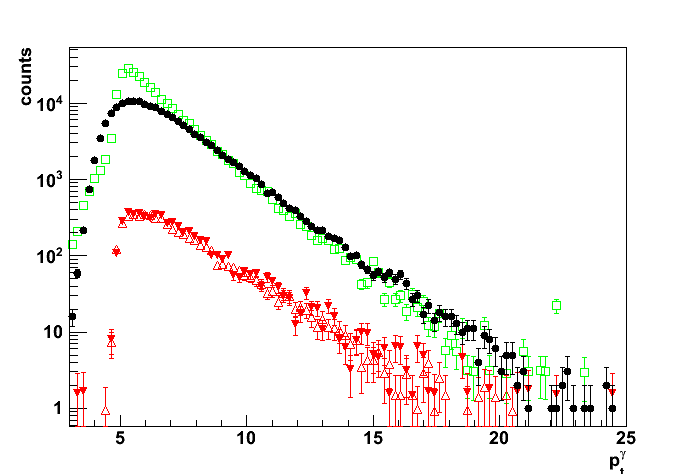
Figure 2: Partonic pt distribution (pt_gamma>7GeV, pt_jet > 5GeV)
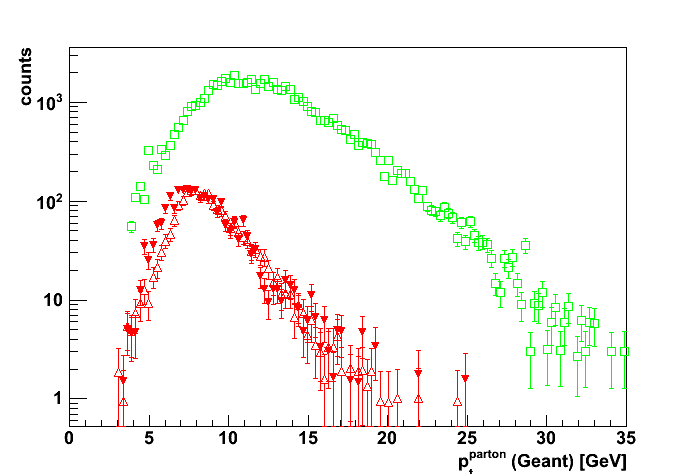
Figure 3: Estimate of the contribution from low partonic pt,
only QCD-TuneA MC are shown (pt_gamma>7GeV, pt_jet > 5GeV)
Black line: Exponential fit to partonic pt distribution in 4-7GeV range
(pt_gamma>7GeV cut for the photon candidate)
Red line: Exponential fit extrapolated to the partonic pt range below 4GeV.
Ratio of the area under the red line (integral pt=0-4geV)
to the area under the green line (integral pt=4-35GeV) is 0.0028.
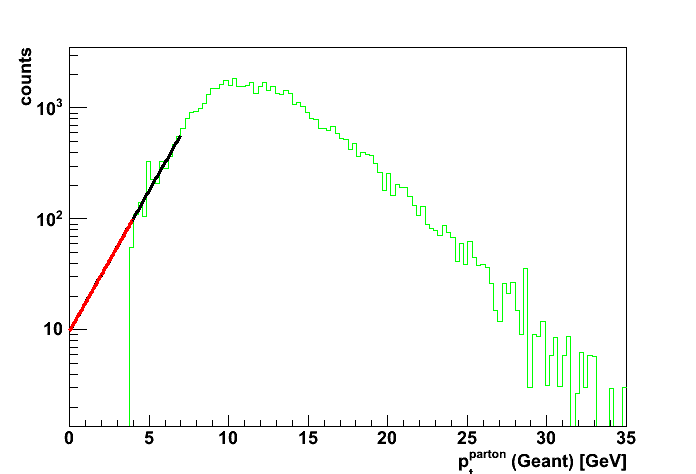
Comments
- (based on Fig. 3)
I would propose we drop both of the lowest parton pt bins,
i.e. pt=2-3 and pt=3-4 (Inherited error for pt_gamma>7GeV < 0.3%)
and instead use our CPU time to produce more
statistics in the 4-35 partonic pt range. - (based on Fig. 2)
There is a small difference between CDF-Tune-A and
Perugia0 tunes partonic pt distributions
even for the prompt photon Monte-Carlo. - Comparison with Perugia0 QCD MC is coming.
Hopefully after that we will be able to decide what
Pythia tune is better match the L2e-gamma data.
2010.06.17 Pythia TuneA/Perugia0 filtered MC vs. pp2006 data
Data samples and colour coding
- black circles: pp2006 data
- open green: MC-QCD-TuneA, partonic pt 4-35
- solid green: MC-QCD-Perugia0, partonic pt 4-35
- open red MC-prompt-photon-TuneA, partonic pt 3-35
- solid red MC-prompt-photon-Perugia0, partonic pt 3-35
Event selection
- di-jets from the cone jet-finder algorithm
- photon and jet are opposite in phi:
cos (phi_gamma-phi_jet) < -0.8 - pt away side jet > 5GeV
- detector eta of the away side jet: |eta_jet_det| < 0.8
- data: L2e-gamma triggered events
- No trigger emulation in Monte-Carlo yet
- MC scaled to 3.164^pb based on Pythia luminosity (no fudge factors)
Plots before cuts on photon candidate pt
Figure 1: Reconstructed photon candidate pt, pt_gamma (no cut on pt_gamma, pt_jet > 5GeV)

Figure 2: Partonic pt distribution (no cut on pt_gamma, pt_jet > 5GeV)
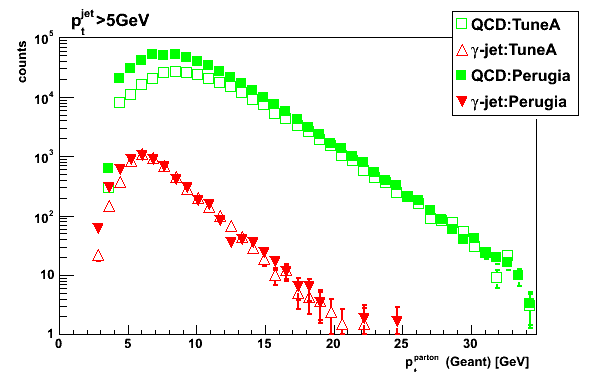
Plots with pt_gamma>7GeV cut
Figure 3: Partonic pt distribution (pt_gamma>7GeV, pt_jet > 5GeV)
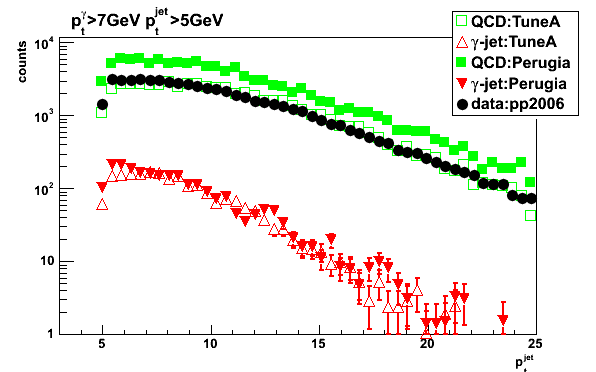
Figure 4: Away side jet pt (pt_gamma>7GeV, pt_jet > 5GeV)
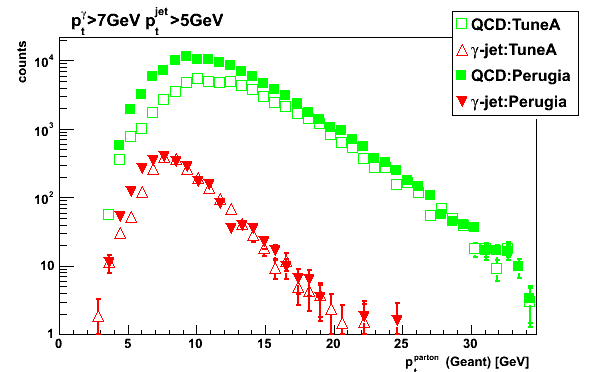
Figure 5: Reconstructed z vertex (pt_gamma>7GeV, pt_jet > 5GeV)
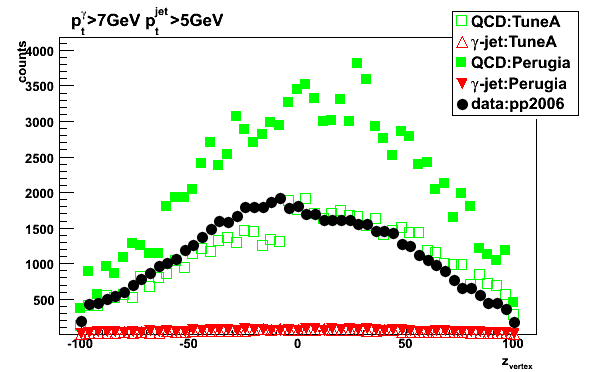
Figure 6: Partonic pt distribution for Pythia CDF-Tune-A QCD simulations (pt_gamma>7GeV, pt_jet > 5GeV)
Estimate of the contribution from low partonic pt:
Black line: Exponential fit to partonic pt distribution in 4-7GeV range
Red line: Exponential fit extrapolated to the partonic pt range below 4GeV.
Ratio of the area under the red line (integral over pt=0-4GeV)
to the area under the green line (integral over pt=4-35GeV) is 0.0028 (<0.3%)

Comments
-
Simulations with Perugia0 tune has a higher yield than that from CDF-Tune-A simulations
-
Shapes vs. partonic pt are different for Perugia0 and CDF-TuneA simulations
-
Shapes vs. reconstructed variables are similar for Perugia0 and CDF-TuneA simulations
-
(based on Fig. 6) I would propose we drop both of the lowest parton pt bins,
i.e. pt=2-3 and pt=3-4 (Inherited error for pt_gamma>7GeV < 0.3%)
and instead use CPU time to produce more statistics in the 4-35 partonic pt range. -
More discussion at phana hyper news:
http://www.star.bnl.gov/HyperNews-star/protected/get/ phana/496.html
Additional figures
Figure 7a: Photon candidate yield vs. rapidity (pt_gamma>7GeV, pt_jet > 5GeV)
Left: pt_gamma>7GeV; right: zoom into eta < 1 region
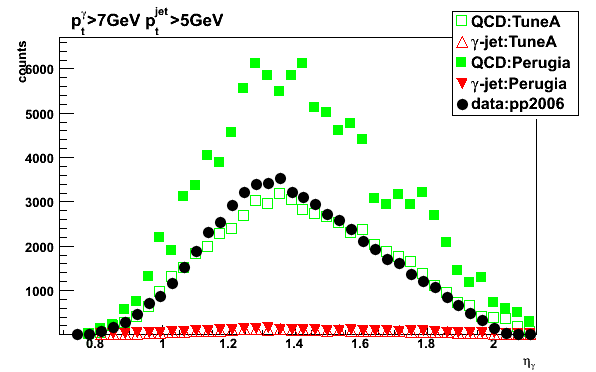
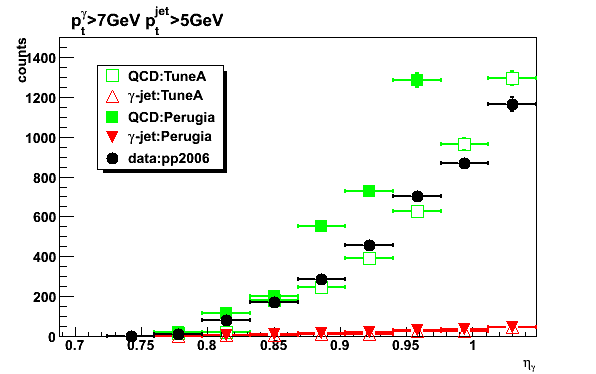
Figure 7b: yield vs. jet1 momentum (pt_gamma>7GeV, pt_jet > 5GeV)
Figure 7c: eta yield without pt_gamma cut
Yields ratio for eta <0.95 to the total yield is ~ 1.7% (1004/58766 = 0.0171)
Figure 8: Photon candidate yield vs. rapidity (pt_gamma>7GeV, pt_jet > 5GeV)
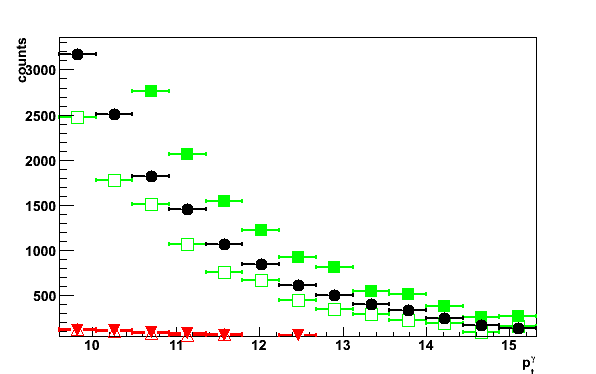
Note: trigger condition is not applied in simulations yet
but at high pt the data to Pythia CDF-Tune-A ratio is about 1.28 (at 9GeV: 3200/2500),
what is consistent with an additional 25% scaling factor
used for CIPANP 2009 presentation (see slide 6)
2010.06.18 L2e-gamma trigger effect: Py-CDF-Tune-A, Py-Perugia0, and pp2006 data comparison
Related posts
- Pythia and BFC filter QA vs. gamma candidate pt and eta
- L2e-gamma trigger effect with old Monte-Carlo (before EEMC geometry fix)
Data samples and colour coding
- black circles: pp2006 data
- open green: MC-QCD-TuneA, partonic pt 4-35
- solid green: MC-QCD-Perugia0, partonic pt 4-35
- open red MC-prompt-photon-TuneA, partonic pt 3-35
- solid red MC-prompt-photon-Perugia0, partonic pt 3-35
Event selection
- di-jets from the cone jet-finder algorithm
- photon and jet are opposite in phi:
cos (phi_gamma-phi_jet) < -0.8 - pt away side jet > 5GeV
- detector eta of the away side jet: |eta_jet_det| < 0.8
- data: L2e-gamma triggered events
- No trigger emulation in Monte-Carlo yet
- MC scaled to 3.164^pb based on Pythia luminosity (no fudge factors)
Figure 1: Reconstructed photon candidate pt, pt_gamma (no cut on pt_gamma, pt_jet > 5GeV)

Figure 2: Same as Fig. 1 with L2e-gamma condition simulated in Monte-Carlo

Figure 3: Same as Fig. 1, added distribution for photon pt from geant record (prompt photon MC only)

Figure 4: raw jet pt from jet trees: QCD pt=6-9
upper plot: mit0043 M. Betancourt simulations (MIT Simulation Productions)
bottom plot: new filtered MC


2010.06.28 Tests of L2e-gamma trigger emulation with single photon Monte-Carlo
Related links
- L2e-gamma trigger effect: Py-CDF-Tune-A, Py-Perugia0, and pp2006 data comparison
- http://www.star.bnl.gov/HyperNews-star/get/emc2/3531/1.html
- http://www.star.bnl.gov/HyperNews-star/protected/get/phana/499.html
Monte-Carlo configuration
- Single photon in the EEMC (flat in eta, pt, phi)
- Narrow vertex distribution with sigma=1cm
- 10 muons thrown in Barrel (|eta|<0.5) to reconstruct vertex
- 3 muons thrown in each BBC (|eta|~4) to fire the trigger
- Run 6 L2e-gamma-trigger id = 137641
- STAR geometry tag: y2006h
- Photon cuts:
1.1 < eta < 1.95
3 < pt < 15 GeV
0 < phi < 2pi
Trigger effect vs. thrown photon pt, eta, and energy
Figure 1:
Yields vs. thrown photon pt
left: Yields with (red) and without (black) L2e-gamma trigger condition
right: Yield ratio (with/without trigger)
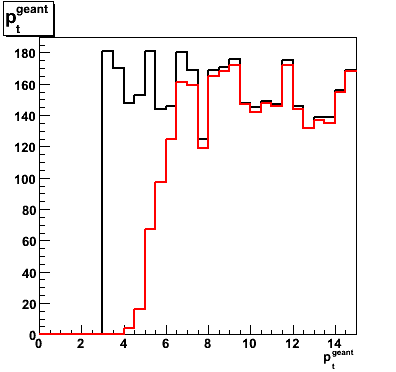
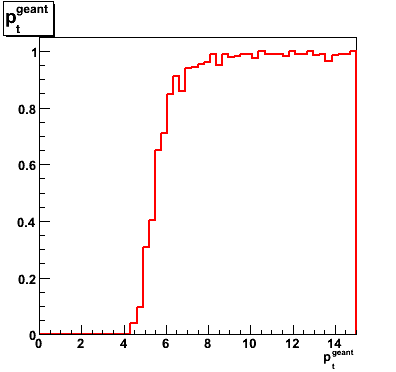
Figure 2: Same as Fig. 1 vs. thrown eta
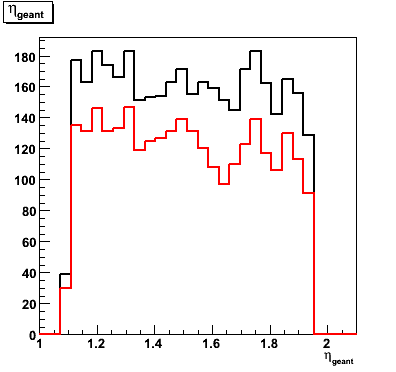
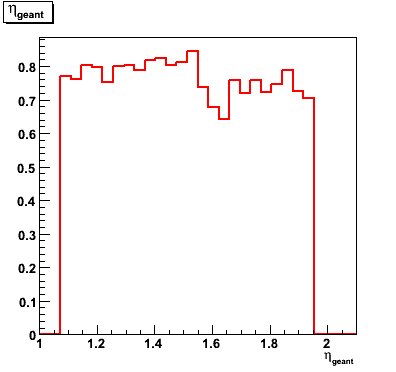
Figure 3: Same as Fig. 1 vs. thrown energy
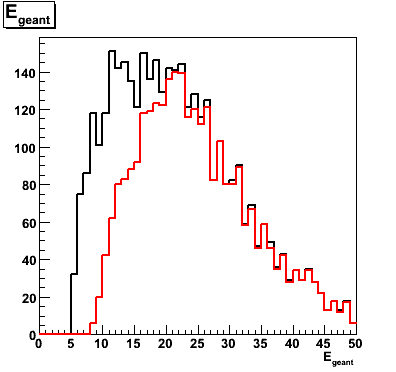
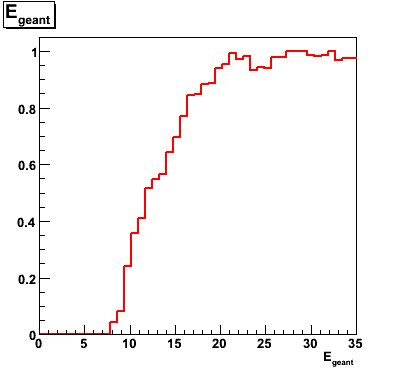
Trigger effect vs. reconstructed energy in the EEMC (high tower, 2x1, 3x3, energy and total E_T)
Figure 4: Same as Fig. 1 vs. total reconstructed transverse energy

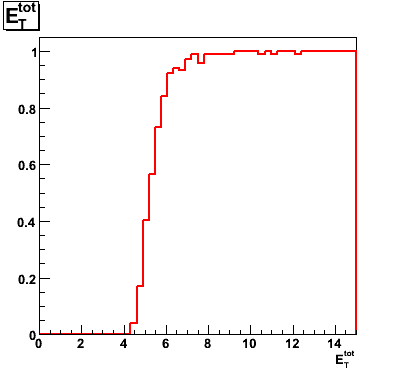
Figure 5: Same as Fig. 1 vs. reconstructed high tower energy

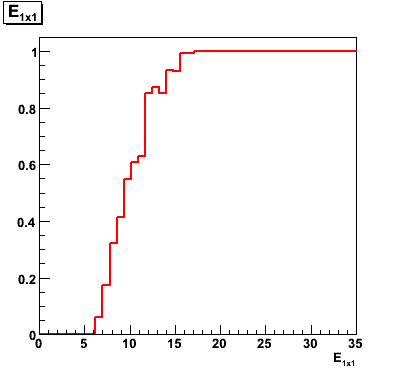
Figure 6: Same as Fig. 1 vs. reconstructed energy of the 2x1 tower cluster
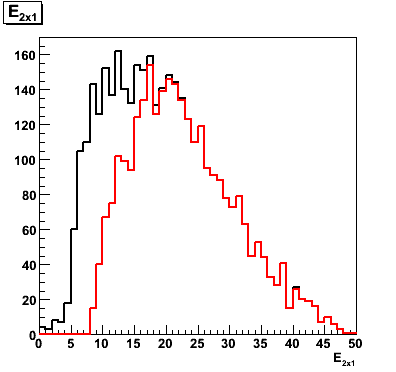
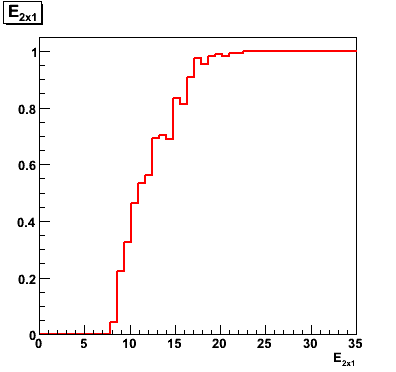
Figure 7: Same as Fig. 1 vs. reconstructed energy of the 3x3 tower cluster

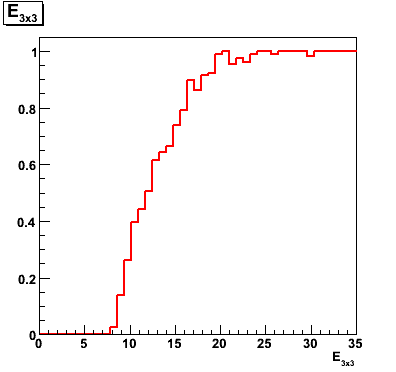
2010.06.30 Py-tunes (GEANT+L2e-gamma trigger) vs. Run 6 data
Related posts
- Michael's Perugia 0, Pro-pT0, and CDF Tune A comparison
- Previous comparison without trigger condition in simulations
- Tests of L2e-gamma trigger emulation with single photon Monte-Carlo
Data samples and colour coding
- black circles: pp2006 data
- open green: MC-QCD-TuneA, partonic pt 4-35
- solid green: MC-QCD-Perugia0, partonic pt 4-35
- open red MC-prompt-photon-TuneA, partonic pt 3-35
- solid red MC-prompt-photon-Perugia0, partonic pt 3-35
Event selection
- di-jets from the cone jet-finder algorithm
- photon and jet are opposite in phi:
cos (phi_gamma-phi_jet) < -0.8 - pt away side jet > 5GeV
- detector eta of the away side jet: |eta_jet_det| < 0.8
- data : L2e-gamma triggered events
- Monte-Carlo: emulated L2e-gamma triggered condition
- MC scaled to 3.164^pb based on Pythia luminosity (no fudge factors)
Figure 1: Reconstructed photon candidate pt (no pt_gamma cut, pt_jet > 5GeV)
L2e-gamma condition simulated in Monte-Carlo

Figure 2: Yield ratios (no pt_gamma cut, pt_jet > 5GeV)
Black: data[pp2006] / QCD[Perigia0]
Green: QCD[Perigia0] / QCD[CDF-Tune-A]
Red: g-jet[Perigia0] / g-jet[CDF-Tune-A]

Figure 3: Vertex z distribution (pt_gamma>7GeV, pt_jet > 5GeV)

Figure 4: Simulation yield vs. partonic pt (no pt_gamma cut, pt_jet > 5GeV)

07 Jul
July 2010 posts
2010.07.02 Tests of L2e-gamma trigger emulation with full Pythia+Geant Monte-Carlo
Related posts
- Tests of L2e-gamma trigger emulation with single photon Monte-Carlo
- Yields for L2e-gamma triggered events
- Yields before applying the L2e-gamma trigger condition
- http://www.star.bnl.gov/HyperNews-star/protected/get/phana/501.html
Event selection
- di-jets from the cone jet-finder algorithm
- photon and jet are opposite in phi:
cos (phi_gamma-phi_jet) < -0.8 - pt away side jet > 5GeV
- detector eta of the away side jet: |eta_jet_det| < 0.8
- data : L2e-gamma triggered events
Run 6 L2e-gamma trigger algo: E_T[2x2] > 5.2, E_T[high tower]>3.7 - Monte-Carlo: emulated L2e-gamma triggered condition
- MC scaled to 3.164^pb based on Pythia luminosity (no fudge factors)
Plots for the ratio of N[passed L2] to N[before trigger]
Figure 1: Trigger effect vs. reconstructed photon candidate pt (3x3 patch) (no pt_gamma cut, pt_jet > 5GeV)
Dashed lines: Pythia Tune A, solid lines Pythia Perugia0 tune

Figure 2: Trigger effect vs. simulated direct photon pt (no pt_gamma cut, pt_jet > 5GeV)

Figure 3: Trigger effect vs. simulated direct photon eta (no pt_gamma cut, pt_jet > 5GeV)

Figure 4: Trigger effect vs. reconstructed vertex z (no pt_gamma cut, pt_jet > 5GeV)

Figure 5: Trigger effect vs. reconstructed vertex z (with additional pt_gamma >7GeV, pt_jet > 5GeV)

Figure 6: Trigger effect vs. 2x2 cluster Et (no pt_gamma cut, pt_jet > 5GeV)

Figure 7: Trigger effect vs. 1x1 cluster (high tower) Et (no pt_gamma cut, pt_jet > 5GeV)

2010.07.09 Table of L0-BBC, L0-EEMC, and L2Egamma triggers biases
Real and simulated trigger decisions:
- BBC stands for emulated L0 BBC trigger condition
- EEMC stands for emulated Run 6 L0 EEMC (137832) trigger condition
- L2 stands for emulated L2E-gamma (137641) trigger condition
- Trig event satisfied to all three simulated trigger conditions: BBC+EEMC+L2
- data-EEMC stands for real data L0 EEMC (137832) trigger condition
(available only for fast offline data, not filled in yet) - data-L2 stands for real data L2E-gamma (137641) trigger condition
Data samples:
- pp2006 data (3.4K events from st_physics production)
- Pythia prompt photon simulations (147 events gamma-filtered for partonic pt=3-25GeV)
- Pythia QCD 2->2 simulations (45 events gamma-filtered for partonic pt=6-9GeV)
Notations in the table:
- XXX=0 - stands for XXX trigger did not fired
- XXX=1 - stands for XXX trigger did fired
- XXX=0 YYY=1 stands for XXX trigger did not fired, but YYY did fired
| sample | Total | BBC=1 | EEMC=1 | L2=1 | L2=1 EEMC=0 | L2=1 BBC=0 | L2=0 BBC=1 | L2=0 EEMC=1 |
| pp2006, st_physics | ||||||||
| (counts) | 3396 | 3306 | 568 | 549 | 5 | 2 | 2759 | 24 |
| (%) | 1.0000 | 0.9735 | 0.1673 | 0.1617 | 0.0015 | 0.0006 | 0.8124 | 0.0071 |
| gamma-jets (3-25GeV) | ||||||||
| (counts) | 147 | 119 | 127 | 122 | 3 | 24 | 21 | 8 |
| (%) | 1 | 0.80952 | 0.86395 | 0.82993 | 0.020 | 0.16327 | 0.14286 | 0.054 |
| QCD (6-9GeV) | ||||||||
| (counts) | 45 | 38 | 19 | 19 | 1 | 4 | 23 | 1 |
| (%) | 1 | 0.84444 | 0.42222 | 0.42222 | 0.022 | 0.08889 | 0.51111 | 0.022 |
| simu vs. real triggers | data-EEMC=1 | data-L2=1 | L2=1 data-L2=0 | L2=0 data-L2=1 | Trig=1 data-L2=0 | Trig=0 data-L2=1 | EEMC=0 data-EEMC=1 | EEMC=1 data-EEMC=0 |
| 572 | 548 | 7 | 6 | 0 | 6 | 0 | 4 | |
| 0.1673 | 0.1617 | 0.0021 | 0.0018 | 0.0000 | 0.0018 | 0.0000 | 0.0012 | |
2010.07.14 Pythia/BFC gamma-filter bias tests (vs. gamma pt, eta, energy, and phi)
Related inks:
- Tests of L2e-gamma trigger emulation with full Pythia+Geant Monte-Carlo
- Previous study before filter emulator fixes
- QCD and gamma-jet data samples are described here
(filter parameters are listed below)
Number of generated events per partnic pt bin (pt binsa are: 2-3, 3-4, 4-6, 6-9, 9-15, 15-35):
gamma-jets (2-4): 25K/bin
gamma-jets (4-35): 12.5K/bin
QCD(2-4): 50K/bin
QCD(4-35): 25K/bin
Pythia filter configuration
StEemcGammaFilter:: running the TEST mode (accepting all events). Set mFilterMode=1 to actually reject events
StEemcGammaFilter:: mConeRadius 0.22 mSeedThreshold 3.8 mClusterThreshold 5 mEtaLow 0.95 mEtaHigh 2.1 mMaxVertex 120
StEemcGammaFilter:: mCalDepth 279.5 mMinPartEnergy 1e-05 mHadronScale 1 mFilterMode 0 mPrintLevel 1
BFC filter configuration
StChain:INFO - Init() : Using gamma filter on the EEMC
StChain:INFO - Init() : EEMC Sampling Fraction = 0.05
StChain:INFO - Init() : Seed energy threshold = 3.8 GeV
StChain:INFO - Init() : Cluster eT threshold = 5 GeV
StChain:INFO - Init() : Maximum vertex = +/- 120 cm
StChain:INFO - Init() : Running the TEST mode (accepting all events). Set mFilterMode=1 to actually reject events in BFC
StEEmcSlowMaker configuration
BFC:INFO - setTowerGainSpread(): gain spread: 0; gain mean value: 1 (Fig. 1 only)
BFC:INFO - setTowerGainSpread(): gain spread: 0; gain mean value: 1.1 (Fig. 2 and below)
GammaMaker configuration
runSimuGammaTreeMaker():: GammaMaker config: ConeRadius 0.7 ClusterEtThreshold 5.5 SeedEnergyThreshold 4.2 ClusterEnergyThreshold 5.5 BsmdRange 0.05237 EsmdR ange 20
A2Emaker configuration
StEEmcA2EMaker *EEanalysis = new StEEmcA2EMaker("mEEanalysis");
EEanalysis->threshold(3.0, 0); // tower threshold (ped+N sigma)
EEanalysis->threshold(3.0, 1); // pre1 threshold
EEanalysis->threshold(3.0, 2); // pre2 threshold
EEanalysis->threshold(3.0, 3); // post threshold
EEanalysis->threshold(3.0, 4); // smdu threshold
EEanalysis->threshold(3.0, 5); // smdv threshold
Trigger configuration
(Includes all recent fixes to trigger emulator configuration/software)
emulated L2E-gamma trigger for Run 2006 [eemc-http-mb-l2gamma:: id 137641]
Trigger conditions:
cluster Et (3x3) = 5.2GeV
seed Et = 3.7GeV
Accept/Reject relative to the total number of offline selected events
Definition: offline selected events are events which satisfy to the following conditions:
- Online condition (L2E-gamma trigger fired)
- Reconstructed vetrex (|v_z|<120cm)
- Offline condition (at least one gammaMaker candidate found)
Figure 1:
(upper plots) Gamma candidate yields vs. candidate pt (all partonic pt bins, no pt weights)
(lower plots) False rejection [histograms in the upper panel scaled by L2E-gamma-trigger yield (shown in blue)]
No gain shifts in StEEmcSlowMaker
Note: statistics without gain shifts is smaller because ~10-20% jobs died at RCF
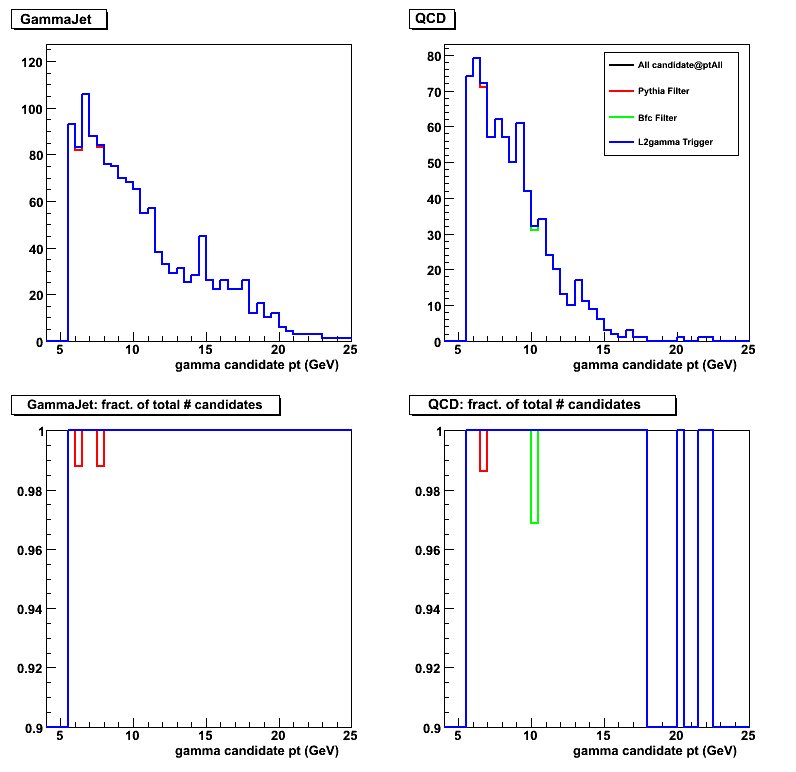
Figure 2: Same as Fig. 1, but with +10% (1.1) gain shifts in StEEmcSlowMaker.
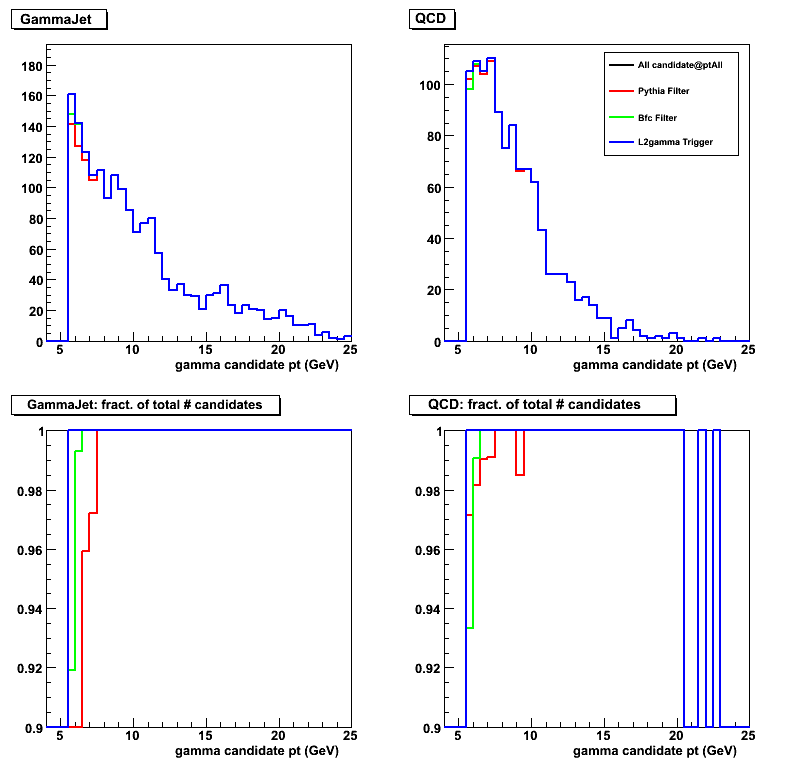
Figure 3: Same as Fig. 2 vs. candidate eta (with +10% (1.1) gain shifts in StEEmcSlowMaker).

Figure 4: Same as Fig. 2 vs. candidate azimuthal angle (with +10% (1.1) gain shifts in StEEmcSlowMaker).
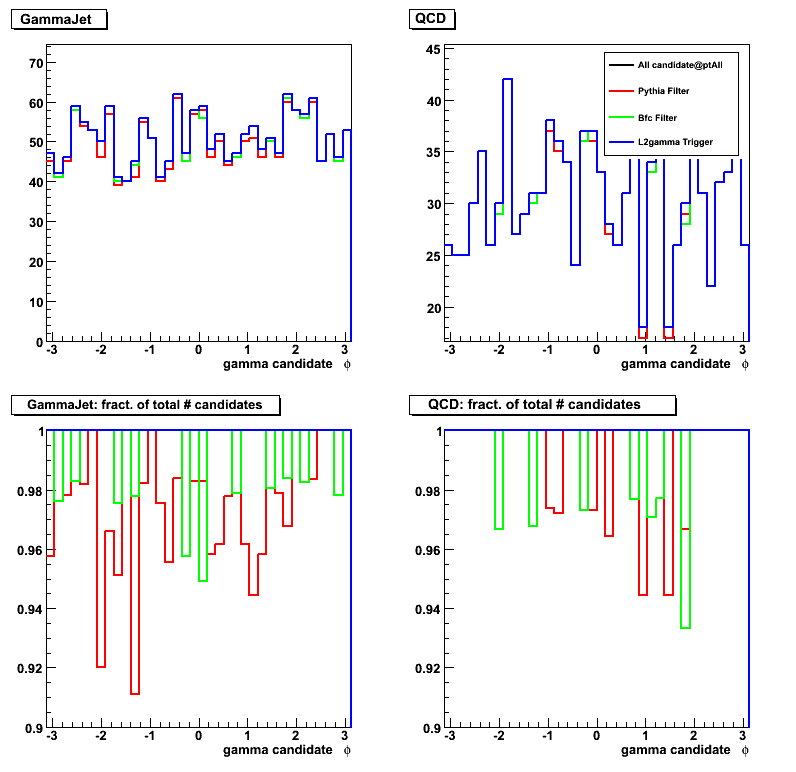
Figure 5: Same as Fig. 2 vs. energy (with +10% (1.1) gain shifts in StEEmcSlowMaker).
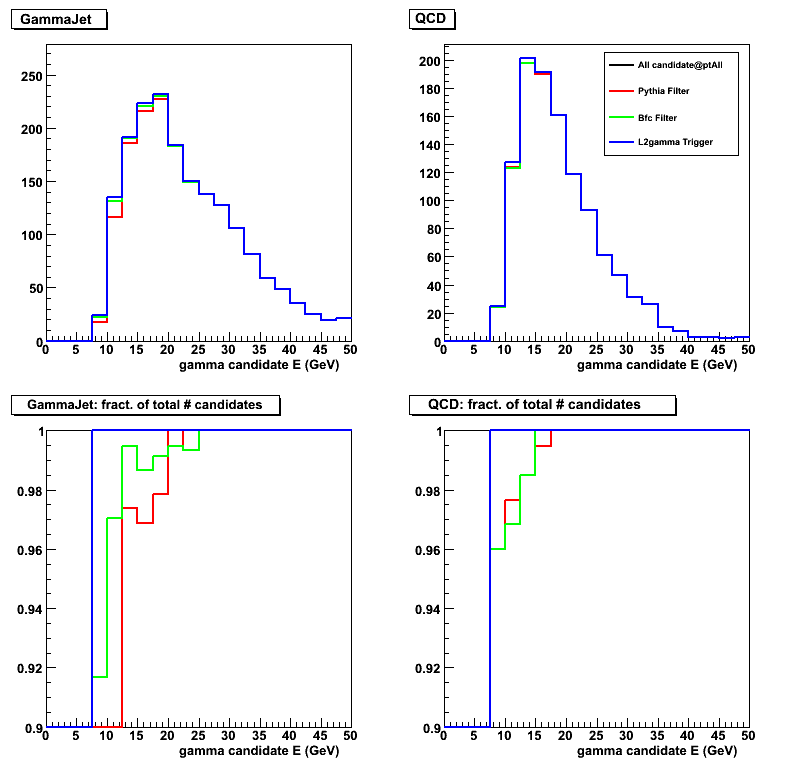
2010.07.16 Pythia/BFC gamma-filter bias tests with realistic gain variation
Related inks:
- Previous study with ideal gains and gain shift only of +10%
- Tests of L2e-gamma trigger emulation with full Pythia+Geant Monte-Carlo
- Previous study before filter emulator fixes
- QCD and gamma-jet data samples are described here
(filter parameters are listed below)
Number of generated events per partnic pt bin (pt binsa are: 2-3, 3-4, 4-6, 6-9, 9-15, 15-35):
gamma-jets (2-4): 25K/bin
gamma-jets (4-35): 12.5K/bin
QCD(2-4): 50K/bin
QCD(4-35): 25K/bin
Pythia filter configuration
StEemcGammaFilter:: running the TEST mode (accepting all events). Set mFilterMode=1 to actually reject events
StEemcGammaFilter:: mConeRadius 0.22 mSeedThreshold 3.8 mClusterThreshold 5 mEtaLow 0.95 mEtaHigh 2.1 mMaxVertex 120
StEemcGammaFilter:: mCalDepth 279.5 mMinPartEnergy 1e-05 mHadronScale 1 mFilterMode 0 mPrintLevel 1
BFC filter configuration
StChain:INFO - Init() : Using gamma filter on the EEMC
StChain:INFO - Init() : EEMC Sampling Fraction = 0.05
StChain:INFO - Init() : Seed energy threshold = 3.8 GeV
StChain:INFO - Init() : Cluster eT threshold = 5 GeV
StChain:INFO - Init() : Maximum vertex = +/- 120 cm
StChain:INFO - Init() : Running the TEST mode (accepting all events). Set mFilterMode=1 to actually reject events in BFC
StEEmcSlowMaker configuration with realistic gain shift/smearing
Figure 1: Error for gains from MIP study minus ideal
Data digitized from Scott's presentation at 2008 Calibartion workshop
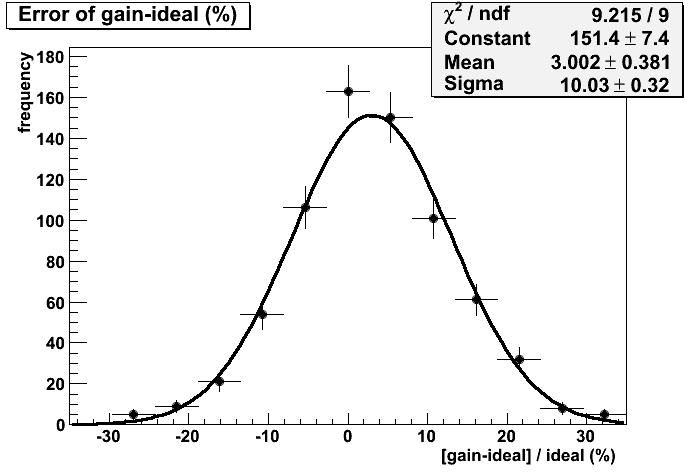
BFC:INFO - setTowerGainSpread(): gain spread: 0.1; gain mean value: 1.05 (Fig. 1,3 only)
BFC:INFO - setTowerGainSpread(): gain spread: 0.1; gain mean value: 0.95 (Fig. 2,4 and below)
GammaMaker configuration
runSimuGammaTreeMaker():: GammaMaker config: ConeRadius 0.7 ClusterEtThreshold 5.5 SeedEnergyThreshold 4.2 ClusterEnergyThreshold 5.5 BsmdRange 0.05237 EsmdR ange 20
A2Emaker configuration
StEEmcA2EMaker *EEanalysis = new StEEmcA2EMaker("mEEanalysis");
EEanalysis->threshold(3.0, 0); // tower threshold (ped+N sigma)
EEanalysis->threshold(3.0, 1); // pre1 threshold
EEanalysis->threshold(3.0, 2); // pre2 threshold
EEanalysis->threshold(3.0, 3); // post threshold
EEanalysis->threshold(3.0, 4); // smdu threshold
EEanalysis->threshold(3.0, 5); // smdv threshold
Trigger configuration
(Includes all recent fixes to trigger emulator configuration/software)
emulated L2E-gamma trigger for Run 2006 [eemc-http-mb-l2gamma:: id 137641]
Trigger conditions:
cluster Et (3x3) = 5.2GeV
seed Et = 3.7GeV
Accept/Reject relative to the total number of offline selected events
Definition: offline selected events are events which satisfy to the following conditions:
- Online condition (L2E-gamma trigger fired)
- Reconstructed vetrex (|v_z|<120cm)
- Offline condition (at least one gammaMaker candidate found)
Figure 2:
(upper plots) Gamma candidate yields vs. candidate pt (all partonic pt bins, no pt weights)
(lower plots) False rejection [histograms in the upper panel scaled by L2E-gamma-trigger yield (shown in blue)]
StEEmcSlowMaker configured with +5% (scale factor=1.05) gain shifts and 0.1 sigma
Previous plots: 125K events per pt-bin, 250K/pt-bin
(figure below combines previous statisitcs + 18K for partonic pt=6-9 and pt=9-15 GeV bins)
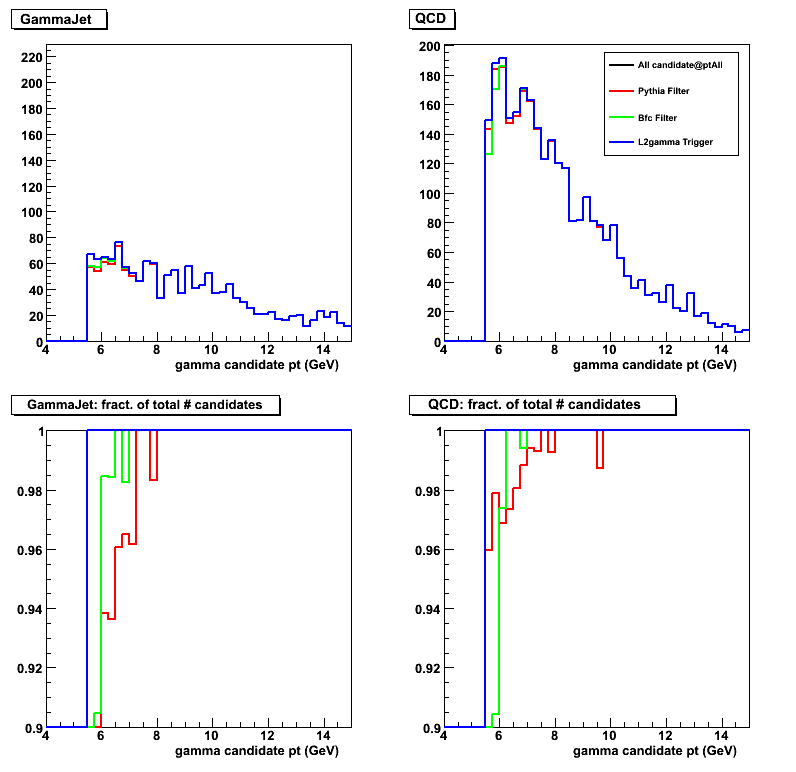
Figure 2b: Filter bias per partonic pt bin (QCD simulations only)
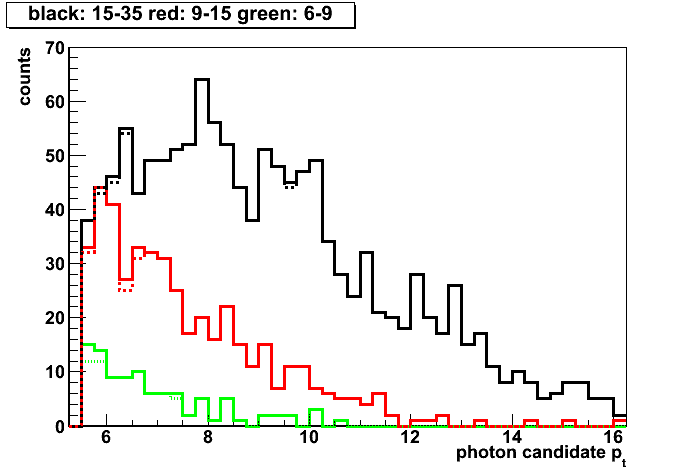
Figure 3: Same as Fig. 1 with gain shift=0.95 and sigma=0.1
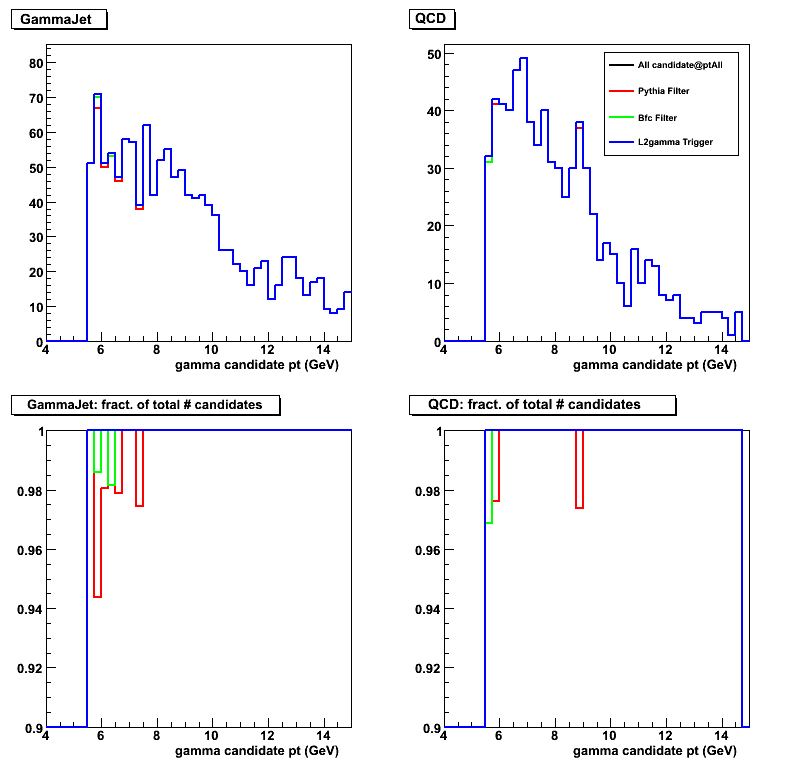
Figure 4: Same as Fig. 1 vs. candidate eta with gain shift=1.05 and sigma=0.1
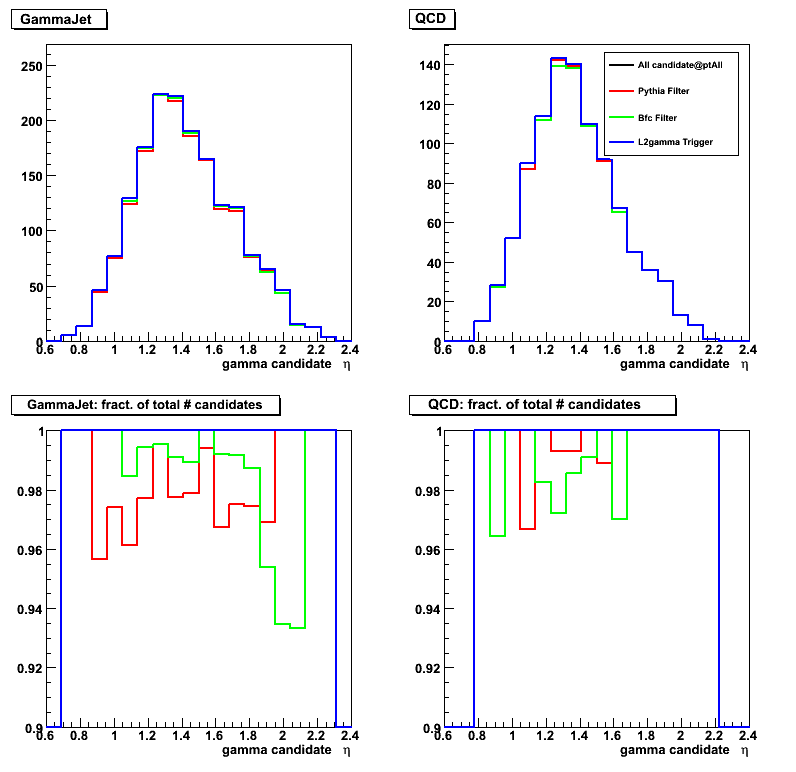
Figure 5: Same as Fig. 1 vs. candidate eta with gain shift=0.95, sigma=0.1
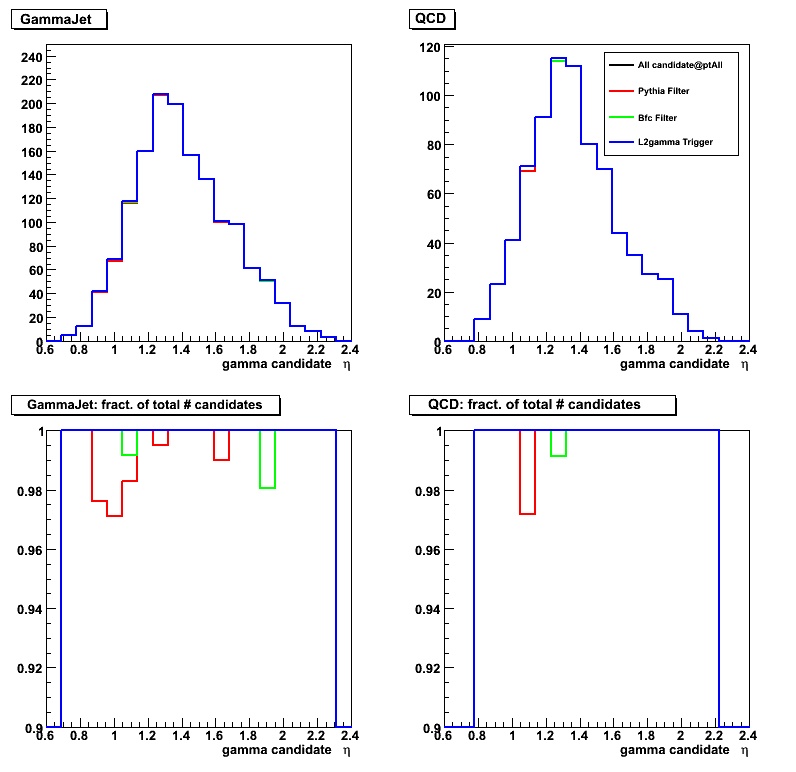
2010.07.20 EEMC simulation spreadsheet: prompt photons and QCD (Updated)
Related links
Simulation request spreadsheet (QCD@L=2/pb, photons@L=10/pb)
| parton pt, GeV | Pythia acc | bfc acc wrt. Pythia | Total filter's acc | Sigma, pb | lumi, 1/pb | Number of filtered events to generate | Total CPU time, days | disk space, Gb |
Number of |
| g-jets | |||||||||
| 2-3 | 0.00870 | 0.2663 | 0.00232 | 1280000 | 10.0 | 29659 | 18.75 | 4.63 | 111360 |
| 3-4 | 0.03300 | 0.3787 | 0.01250 | 290000 | 10.0 | 36237 | 15.38 | 5.90 | 95700 |
| 4-6 | 0.10920 | 0.5521 | 0.06029 | 126700 | 10.0 | 76387 | 25.66 | 12.67 | 138356 |
| 6-9 | 0.22320 | 0.6688 | 0.14928 | 26860 | 10.0 | 40096 | 10.74 | 6.85 | 59952 |
| 9-15 | 0.25360 | 0.6274 | 0.15911 | 4636 | 10.0 | 7376 | 2.17 | 1.28 | 11757 |
| 15-35 | 0.21360 | 0.5394 | 0.11522 | 347 | 10.0 | 399 | 0.17 | 0.07 | 740 |
| totals: | 1728543 | 190154 | 72.9 | 31.40 | 417865 | ||||
| 0.19 | 0.2 | years | |||||||
| QCD | |||||||||
| 2-3 | 0.00067 | 0.0185 | 0.00001 | 8089000000 | 0.0 | 0 | 0.00 | ||
| 3-4 | 0.00298 | 0.0268 | 0.00008 | 1302000000 | 0.0 | 0 | 0.00 | ||
| 4-6 | 0.01312 | 0.0240 | 0.00031 | 413600000 | 2.0 | 260469 | 1428.35 | 51.72 | 10852864 |
| 6-9 | 0.06140 | 0.0640 | 0.00393 | 60620000 | 2.0 | 476425 | 1023.1 | 102.54 | 7444136 |
| 9-15 | 0.17692 | 0.1120 | 0.01982 | 7733000 | 2.0 | 306459 | 440.74 | 64.02 | 2736245 |
| 15-35 | 0.25480 | 0.2260 | 0.05758 | 404300 | 2.0 | 46563 | 34.53 | 9.72 | 206031 |
| totals: | 9873357300 | 1089916 | 2926.72 | 228.00 | 21239276 | ||||
| 1.09 | 8.02 | years | |||||||
|
QCD |
number of events, x 10e6 | CPU years | disk space, Gb | total time with 50 CPU, weeks | total time with 100 CPU, weeks | ||||
| 1 | .74 | 4.2 | 145.4 | 4.4 | 2.2 | ||||
| 2 |
1.28 | 8.2 | 259.4 | 8.6 | 4.3 |
Timing tests
Figure 1: Timing tests for BFC and Pythia gamma-filters (in seconds)
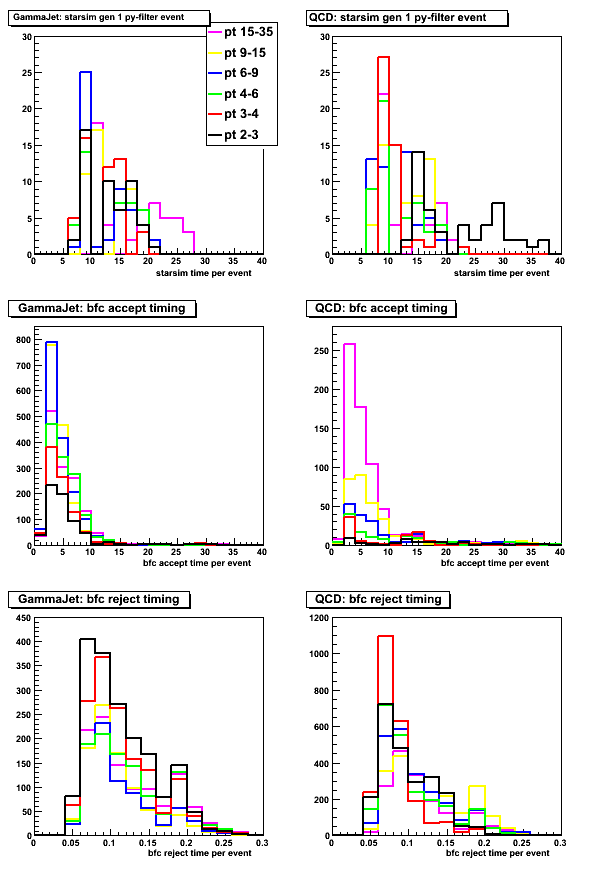
2010.07.22 Run 6 EEMC gamma-filtered simulation request
Submitted run-6 photon-jet simulation request for spin physics
Request last updated on Aug 19, 2010
Run 6 EEMC gamma-filtered simulation request summary
Total resources estimate for QCD with 1/pb and prompt-photon with 10/pb suimulations:
- CPU: 4.2 CPU years (2.2 weeks of running on a 100 CPUs)
- Disk space: 0.15Tb
- Numbe of filtered events: 0.74M
| partonic pt |
QCD | prompt photon | ||
| total | Pythia | total | Pythia | |
| 2-3 | 0 | 0 | 30K | 110K |
| 3-4 | 0 | 0 | 36K | 95K |
| 4-6 | 130K | 5.5M | 76K | 140K |
| 6-9 | 240K | 3.7M | 40K | 60K |
| 9-15 | 150K | 1.4M | 10K | 12K |
| 15-35 | 23K | 100K | 1K | 3K |
Latest filter bias/timing test and simulation request spreasheet
- EEMC simulation spreadsheet and timing tests
- Pythia/bfc filter bias
- Pythia tunes comparison agains data (CDF-Tune-A vs. Perugia0)
- Estimate of the contribution from lowerst partonic pt, pt<4GeV (see Fig. 6)
- L2-Endcap-gamma filter emulation study with single photon Monte-Carlo
- Bias tests with pi0 finder (last updated May 14, 2010)
- Combined Ru6/Run9 request
Note: These and all other studies are linked from here
Filter code in cvs
- Pythia gamma-filter code:
- BFC gamma-filter code:
StEemcGammaFilterMaker.cxx
StEemcGammaFilterMaker.h
eemcGammaFilterMakerParams.idl
Run 6 GMT timestamps
See this study for more details and plots
Request an equal fraction (10%) for each of the 10 timestamps below:
sdt20060516.152000 (GMT during run 7136022)
sdt20060518.073700 (GMT during run 7138010)
sdt20060520.142000 (GMT during run 7140024)
sdt20060521.052000 (GMT during run 7141011)
sdt20060522.124500 (GMT during run 7142029)
sdt20060523.204400 (GMT during run 7143044)
sdt20060525.114000 (GMT during run 7145023)
sdt20060526.114000 (GMT during run 7146020)
sdt20060528.144500 (GMT during run 7148028)
sdt20060602.071500 (GMT during run 7153015)
------------------------ REQUEST DETAILS BELOW ----------------------------------------
prompt photons and QCD simulations
| Request ID | |
| Priority: EC | 0 |
| Priority: pwg | High |
| Status | New |
| Physics Working Group | Spin |
| Requested by | Photon group for SPIN PWG |
| Contact email(s) | ilya.selyuzhenkov@gmail.com, bridgeman@hep.anl.gov |
| Contact phone(s) | |
| PWG email(s) | starspin-hn@www.star.bnl.gov |
| Assigned Deputy: | Not assigned |
| Assigned Helper: | Not assigned |
Endcap photon-jets request
| Request type: | Event generator simulation, with filtering |
| Number of events | See list for each partonic pt bins |
| Magnetic Field |
Full-Field |
| Collision Type |
pp@200GeV |
| Centrality | ---- SELECT CENTRALITY ---- |
| BFC tags |
trs fss y2006h Idst IAna l0 tpcI fcf ftpc Tree logger ITTF Sti VFPPV bbcSim tofsim tags emcY2 EEfs evout -dstout IdTruth geantout big fzin MiniMcMk eemcDb beamLine clearmem |
| Production | ---- SELECT PRODUCTION TAG ---- |
| Geometry: simu | y2006h |
| Geometry: reco | y2006h |
| Library | use library with approved filter code checked in |
| Vertex option |
Leave vertex to be reconstructed vertex, and use VFPPVnoCTB with beamline |
| Pileup option | No |
| Detector Set |
TPC, ETOW, BTOW, BSMD, ESMD, BPRS, EPRE1, EPRE2, EPOST, TOF, BBC, SVT, SSD |
| Event generator | Pythia |
| Extra options |
Additional libraries required for Eemc-gamma Pythia-level filter gexec $ROOTSYS/lib/libCint.so Prompt photon Pythia processes: QCD 2->2 Pythia processes: Pro-pT0 Pythia tune: |
| Vertex Z, cm | -120 < Vertex < 120 |
| Gaussian sigma in X,Y,Z if applicable |
0, 0, 55 200 GeV |
| Vertex offset: x, mm | 0.0cm |
| Vertex offset: y, mm | -0.3cm |
| Φ (phi), radian | 0 < Φ < 6.29 |
| η (eta) | Default (include Barrel, Endcap, BBC) |
| Pt bin, GeV | See list above for QCD and g-jet samples |
| Macro file | Pythia gamma-filter code:
StEemcGammaFilter.cxx StEemcGammaFilterMaker.cxx Private bfc: /star/u/seluzhen/star/spin/MCgammaFilter/scripts/bfc.C |
2010.07.23 PyTune comparison with photon candidates: Perugia0 vs. Pro-PT0
Related posts
- Perugia0 and CDF-Tune-A comparison vs. Run6 data
- Michael's Perugia 0, Pro-pT0, and CDF Tune A comparison
- Thread at the phana list
Data samples and colour coding
- black Pythia QCD Monte-Carlo with Pro-Pt0 tune (pytune=329), partonic pt 9-15
- red Pythia QCD Monte-Carlo with Perugia0 tune (pytune=320), partonic pt 9-15
Event selection
Ran full Pythia+GSTAR simulation and require at least one
reconstucred EEMC photon candidate in the gamma Maker.
Figure 1:
Left: Reconstructed photon candidate transverse momentum (no normalization factor applied)
Right: ratio of Pro-Pt0/Perugia0 simulations (solid Line: "a+b*x" fit to ratio)
Event selections: require at least one reconstucred EEMC photon candidate
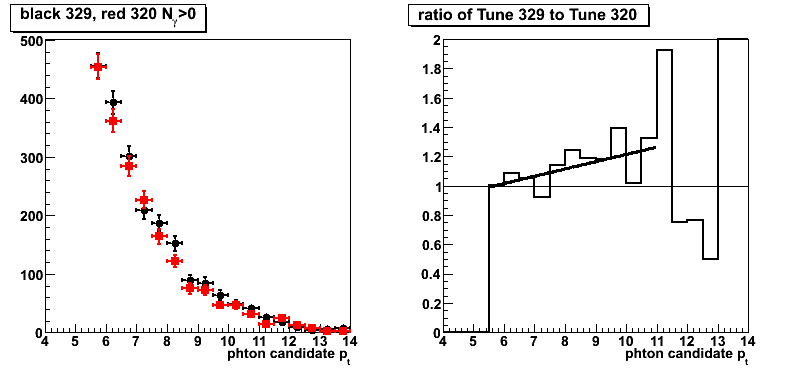
Figure 2:
Same as in Fig. 1 with different event selection criteria:
L2E-gamma, |v_z| < 120cm, at least one EEMC gamma candidate
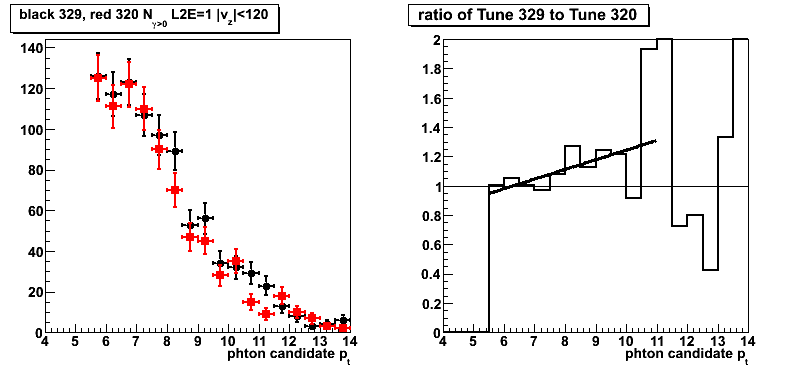
Pytune parameters comparison table
pytune(320) Perugia 0
P. Skands, Perugia MPI workshop October 2008
and T. Sjostrand & P. Skands, hep-ph/0408302
CR by M. Sandhoff & P. Skands, in hep-ph/0604120
LEP parameters tuned by Professor
pytune(329) Pro-pT0
See T. Sjostrand & P. Skands, hep-ph/0408302
and M. Sandhoff & P. Skands, in hep-ph/0604120
LEP/Tevatron parameters tuned by Professor
Red text indicates the parameter which are different between tunes
| Parameter | Perugia 0 | Pro-pT0 | Parameter description |
| MSTP(51) | 7 | 7 | PDF set |
| MSTP(52) | 1 | 1 | PDF set internal (=1) or pdflib (=2) |
| MSTP(64) | 3 | 2 | ISR alphaS type |
| PARP(64) | 1.0000 | 1.3000 | ISR renormalization scale prefactor |
| MSTP(67) | 2 | 2 | ISR coherence option for 1st emission |
| PARP(67) | 1.0000 | 4.0000 | ISR Q2max factor |
| MSTP(68) | 3 | 3 | ISR phase space choice & ME corrections (Note: MSTP(68) is not explicitly (re-)set by PYTUNE) |
| MSTP(70) | 2 | 2 | ISR IR regularization scheme |
| MSTP(72) | 1 | 0 | ISR scheme for FSR off ISR |
| PARP(71) | 2.0000 | 2.0000 | FSR Q2max factor for non-s-channel procs |
| PARJ(81) | 0.2570 | 0.2570 | FSR Lambda_QCD scale |
| PARJ(82) | 0.8000 | 0.8000 | FSR IR cutoff |
| MSTP(81) | 21 | 21 | UE model |
| PARP(82) | 2.0000 | 1.8500 | UE IR cutoff at reference ecm (Note: PARP(82) replaces PARP(62).) |
| PARP(89) | 1800.0000 | 1800.0000 | UE IR cutoff reference ecm |
| PARP(90) | 0.2600 | 0.2200 | UE IR cutoff ecm scaling power |
| MSTP(82) | 5 | 5 | UE hadron transverse mass distribution |
| PARP(83) | 1.7000 | 1.8000 | UE mass distribution parameter |
| MSTP(88) | 0 | 0 | BR composite scheme |
| MSTP(89) | 1 | 1 | BR colour scheme |
| PARP(79) | 2.0000 | 1.1800 | BR composite x enhancement |
| PARP(80) | 0.0500 | 0.0100 | BR breakup suppression |
| MSTP(91) | 1 | 1 | BR primordial kT distribution |
| PARP(91) | 2.0000 | 2.0000 | BR primordial kT width <|kT|> |
| PARP(93) | 10.0000 | 7.0000 | BR primordial kT UV cutoff |
| MSTP(95) | 6 | 6 | FSI colour (re-)connection model |
| PARP(78) | 0.3300 | 0.1700 | FSI colour reconnection strength |
| PARP(77) | 0.9000 | 0.0000 | FSI colour reco high-pT dampening streng |
| MSTJ(11) | 5 | 5 | HAD choice of fragmentation function(s) |
| PARJ(21) | 0.3130 | 0.3130 | HAD fragmentation pT |
| PARJ(41) | 0.4900 | 0.4900 | HAD string parameter a |
| PARJ(42) | 1.2000 | 1.2000 | HAD string parameter b |
| PARJ(46) | 1.0000 | 1.0000 | HAD Lund(=0)-Bowler(=1) rQ (rc) |
| PARJ(47) | 1.0000 | 1.0000 | HAD Lund(=0)-Bowler(=1) rb |
08 Aug
August 2010 posts
2010.08.09 PyTune comparison with gamma candidates from dijets: Perugia0 vs. Pro-PT0
Related posts
- Previous comparison for Perigia0 and Tune A
- PyTune comparison with photon candidates: Perugia0 vs. Pro-PT0
Tunes compared
- CDF Tune A
- Perugia0
- Pro-pT0
Event selection
- di-jets from the cone jet-finder algorithm
- photon and jet are opposite in phi:
cos (phi_gamma-phi_jet) < -0.8 - pt away side jet > 5GeV
- detector eta of the away side jet: |eta_jet_det| < 0.8
- data : L2e-gamma triggered events
- Monte-Carlo: emulated L2e-gamma triggered condition
- MC scaled to 3.164^pb based on Pythia luminosity (no fudge factors)
Figure 1a: Reconstructed photon candidate pt (L2e-gamma condition simulated in Monte-Carlo)

Figure 1b: Same as Fig. 1 on a linear scale and zoom into low pt

Figure 2: QCD Monte-Carlo yield to pp2006 data ratio
.png)
Figure 3: Prompt photon Monte-Carlo yield to pp2006 data ratio
.png)
Figure 4: Simulation yield vs. partonic pt (on a linear scale)

2010.08.10 Timestamps study for the simulation request
Summary for the gamma filtered simulation request
Generate Monte-Carlo events for
10 different timestamps and 10% of statistics each:
sdt20060516.152000 (GMT during run 7136022)
sdt20060518.073700 (GMT during run 7138010)
sdt20060520.142000 (GMT durign run 7140024)
sdt20060521.052000 (GMT during run 7141011)
sdt20060522.124500 (GMT during run 7142029)
sdt20060523.204400 (GMT during run 7143044)
sdt20060525.114000 (GMT during run 7145023)
sdt20060526.114000 (GMT during run 7146020)
sdt20060528.144500 (GMT during run 7148028)
sdt20060602.071500 (GMT during run 7153015)
Original list of timestamps
(from http://www.star.bnl.gov/HyperNews-star/protected/get/phana/481.html)
sdt20060512.043500 (GMT during run 7132005)
sdt20060513.064000 (GMT during run 7133011)
sdt20060514.090000 (GMT during run 7134015)
sdt20060516.152000 (GMT during run 7136022)
sdt20060518.073700 (GMT during run 7138010)
sdt20060520.142000 (GMT durign run 7140024)
sdt20060521.052000 (GMT during run 7141011)
sdt20060522.124500 (GMT during run 7142029)
sdt20060523.204400 (GMT during run 7143044)
sdt20060525.114000 (GMT during run 7145023)
sdt20060526.114000 (GMT during run 7146020)
sdt20060528.144500 (GMT during run 7148028)
sdt20060602.071500 (GMT during run 7153015)
sdt20060604.191200 (GMT during run 7155043)
Figure 1: Number of events from Run 6 golden runs
which fired L2e-gamma trigger (trigger id 137641 and 127641)
(using jet trees regenerated in new format by Wayne/Renee)
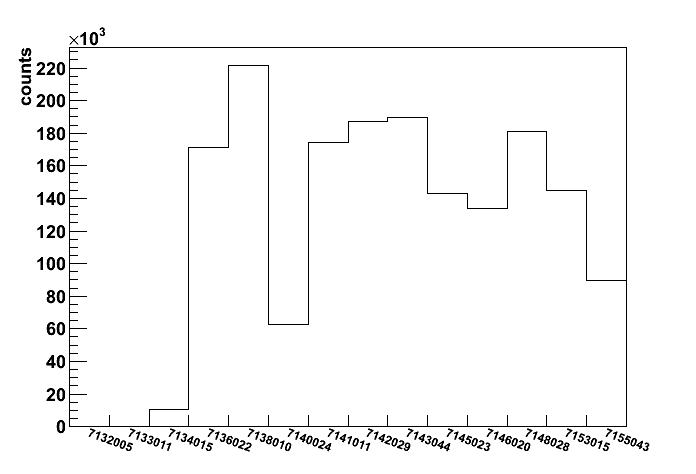
7132005: 0
7133011: 0
7134015: 10474
7136022: 171217
7138010: 221567
7140024: 62826
7141011: 174207
7142029: 187048
7143044: 189752
7145023: 142799
7146020: 133758
7148028: 181269
7153015: 145129
7155043: 89428
09 Sep
September 2010 posts
2010.09.08 First look at the official EEMC gamma filtered production
Related posts
- Tune comparison with private Monte-Carlo (Tune A vs. Perugia0 vs. Pro-pT0)
Event selection
- Official EEMC gamma filtered Monte-Carlo with Pro-pT0 tune
- di-jets from the cone jet-finder algorithm
- photon and jet are opposite in phi:
cos (phi_gamma-phi_jet) < -0.8 - pt away side jet > 5GeV
- detector eta of the away side jet: |eta_jet_det| < 0.8
- data : L2e-gamma triggered events
- Monte-Carlo: emulated L2e-gamma triggered condition
- MC scaled to 3.164^pb based on Pythia luminosity (no fudge factors)
Figure 1: Reconstructed photon candidate pt (L2e-gamma condition simulated in Monte-Carlo)

Figure 3: Thrown photon pt (from Geant record, prompt photon sample only)

2010.09.10 Data to MC comparison with official EEMC gamma filtered production
Related posts
Event selection
- Official EEMC gamma filtered Monte-Carlo with Pro-pT0 tune
- di-jets from the cone jet-finder algorithm
- photon and jet are opposite in phi:
cos (phi_gamma-phi_jet) < -0.8 - pt away side jet > 5GeV
- detector eta of the away side jet: |eta_jet_det| < 0.8
- data : L2e-gamma triggered events
- Monte-Carlo: emulated L2e-gamma triggered condition
- QCD Monte-Carlo scaled to the yield in the data (MC down scaled by a factor of 1.8)
- All plots with gamma pt >7GeV cut
Figure 1: Reconstructed photon candidate pt

Figure 2: Reconstructed away side jet pt

Figure 3: z vertex distribution

Figure 4: 3x3 tower cluster energy

Figure 5: 2x1 tower cluster energy

Figure 6: Reconstructed photon candidate (detector) rapidity

2010.09.13 Data vs. official filtered MC: cluster energy ratios
Related posts
- Previous data to MC comparison with official EEMC gamma filtered production
- Plots with old filtered Monte-Cerlo
Event selection
- Official EEMC gamma filtered Monte-Carlo with Pro-pT0 tune
- di-jets from the cone jet-finder algorithm
- photon and jet are opposite in phi:
cos (phi_gamma-phi_jet) < -0.8 - pt away side jet > 5GeV
- detector eta of the away side jet: |eta_jet_det| < 0.8
- data : L2e-gamma triggered events
- Monte-Carlo: emulated L2e-gamma triggered condition
- QCD Monte-Carlo scaled to the yield in the data (MC down scaled by a factor of 1.8)
- All plots with gamma pt >7GeV and jet pt >5GeV cuts
Figure 1: Cluster energy ratio: 2x1/2x2

Figure 2: Cluster energy ratio: 2x1/3x3

Figure 3: Cluster energy ratio: 2x2/3x3

Figure 4: Cluster energy ratio: 2x1/E(R=0.7)

2010.09.15 Data vs. official filtered MC: energy deposition in various EEMC layers
Related posts
- Data vs. official filtered MC: cluster energy ratios
- Previous data to MC comparison with official EEMC gamma filtered production
- Plots with old filtered Monte-Cerlo
Event selection
- Official EEMC gamma filtered Monte-Carlo with Pro-pT0 tune
- di-jets from the cone jet-finder algorithm
- photon and jet are opposite in phi:
cos (phi_gamma-phi_jet) < -0.8 - pt away side jet > 5GeV
- detector eta of the away side jet: |eta_jet_det| < 0.8
- data : L2e-gamma triggered events
- Monte-Carlo: emulated L2e-gamma triggered condition
- QCD Monte-Carlo scaled to the yield in the data (MC down scaled by a factor of 1.8)
- All plots with gamma pt >7GeV and jet pt >5GeV cuts
Figure 1: 3x3 tower cluster energy
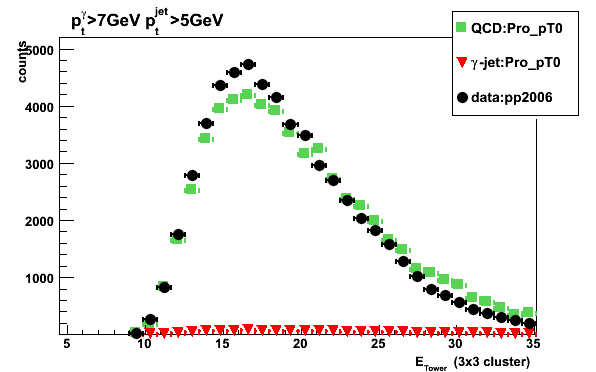
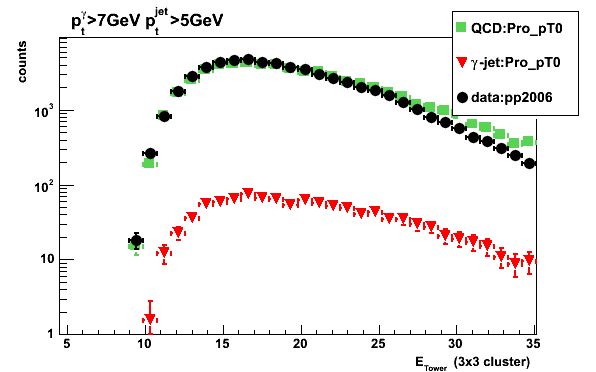
Figure 2: 25 central SMD u-strip energy
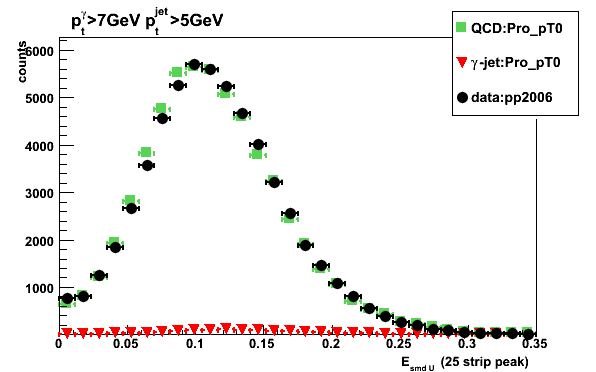
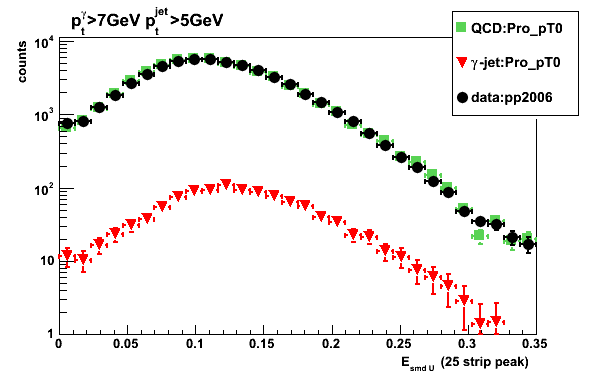
Figure 3: 3x3 pre-shower1 cluster energy
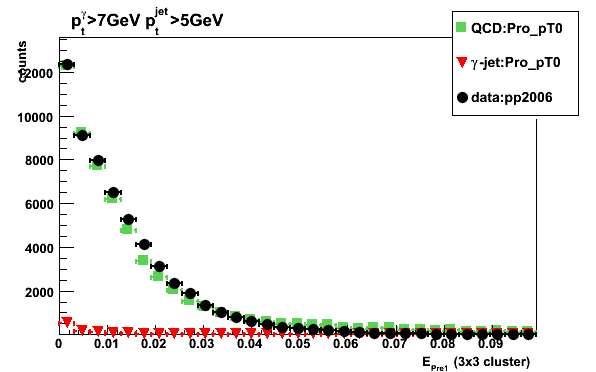
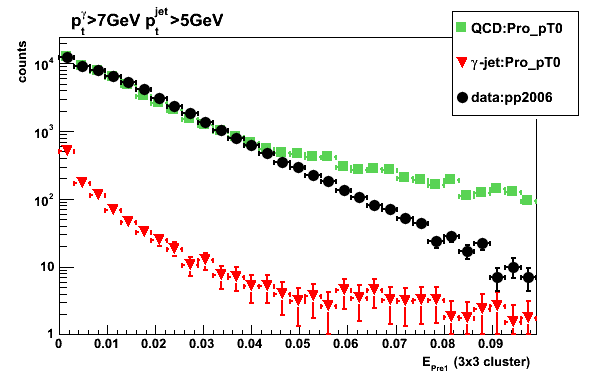
2010.09.23 Neutral energy jet shape comparison for various tunes
Related posts
Event selection
- Official EEMC gamma filtered Monte-Carlo with Pro-pT0 tune vs. Ilya's private production for Pro-pT0, Perugia0, and CDF Tune A
- di-jets from the cone jet-finder algorithm
- photon and jet are opposite in phi:
cos (phi_gamma-phi_jet) < -0.8 - pt away side jet > 5GeV
- detector eta of the away side jet: |eta_jet_det| < 0.8
- data : L2e-gamma triggered events
- Monte-Carlo: emulated L2e-gamma triggered condition
- QCD Monte-Carlo scaled to the yield in the data (All Monte-Carlo normalized to the total yield in the data)
- All plots with gamma pt >7GeV and jet pt >5GeV cuts
Figure 1: 3x3 tower cluster energy to jet R=0.7 energy ratio
Left: Official production (Pro-Pt0), Right: Pro-Pt0 (Ilya private production)


Figure 2: 3x3 tower cluster energy to jet R=0.7 energy ratio - Perugia0 (Ilya private production)

Figure 3: 3x3 tower cluster energy to jet R=0.7 energy ratio - CDF Tune A (Ilya private production)

Figure 4: 3x3 tower cluster with jet thresholds energy to jet R=0.7 energy ratio - Official production (Pro-Pt0)
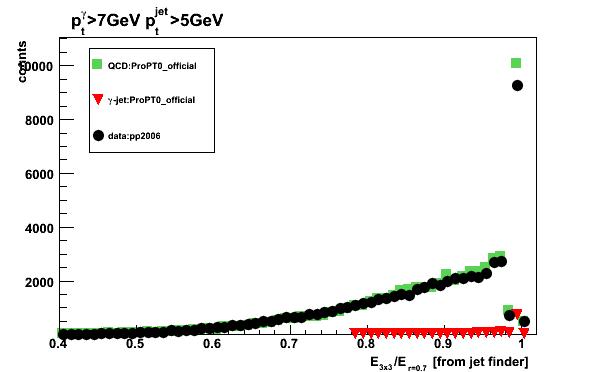

Calorimeter studies for the STAR W analysis
Ilya Selyuzhenkov for the STAR Collaboration
Analysis links
Year 2010
- January 2010
- 2010/01/26: Endcap/Barrel clustering with official W-MC
- 2010/01/18: W test sample: Cluster ratios and skewed gaussian fits
- 2010/01/15: W test sample QA: Pass 3
- 2010/01/13: W test sample QA: Pass 2
- 2010/01/12: W test sample QA
Year 2009
- December 2009
- 2009/12/01: BEMC 1x1, 2x1, 2x2, 3x3 clustering
- November 2009
- 2009/11/17: BEMC sampling fraction: energy dependence
- 2009/11/10: BEMC sampling fraction and clustering (y2009 geometry)
- 2009/11/03: BEMC sampling fraction: with and without LOW_EM option (y2006g geometry)
Documentation for the photon-jet reconstruction code
Documentation for the photon-jet reconstruction code (Ilya Selyuzhenkov)
-
StEemcGammaFilter maker is the Pythia level EEMC gamma filter
-
StEemcGammaFilterMaker maker is the BFC level Endcap gamma filter
-
STAR Jet finder code and the new (Pibero's) jet tree format description
-
StEemcDstMaker is the maker which copies the Eemc detector response and TPC tracks
from MuDst into the StEemcDstEvent tree -
StGammaJetMaker is the maker which reads jet, skim, and EemcDst trees simultaneously
and generates an StGammaJetEvent tree of gamma-jet candidate -
StGammaJetAna is the maker which runs the shower shape and sided residual analyses.
As result it generates the StGammaJetAnaEvent tree
(StGammaJetAnaEvent is an event container which stores the gamma-jet sided residual info) -
StGammaJetDraw is the maker which applies final analysis cuts and generates histograms
-
Signal to background optimization with multi-variant analysis:
macros to run TMVA analysis (LDA, neural network MLP, etc) -
Macros to run various makers
2009 Endcap geometry update (ecalgeo6.g)
2009/2010 GEANT geometry file update summary (ecalgeo v6.0):
Final updates (ecalgeo v6.2):
- Ecalgeo-v6.2: embedded LOW_EM cuts after TPC/EEMC overlap fix
- Ecalgeo-v6.2: embedded LOW_EM cuts in the calorimeter geometry
- Low EM timing study: 10KeV vs. 100KeV cut settings
- Low EM study: LOW_EM option, 100KeV cuts, and DCUTE=100KeV
See also:
- Endcap geometry description
- Endcap EMC project page (1998-2008 archives: MIT, IUCF)
Analysis flow chart
- Copy the StRoot directory from here (for example $my_dir)
- Change to the parent directory for StRoot:
cd $my_dir
- compile everything with cons
- To run makers (expect starsim and bfc) use macros from here and run:
root4star -b -q 'RunXXXMaker.C("inputFileName.extension.root")'
Note: You can use files from iucf disk
Anylysis flow chart:
starsim (Kumac) -> fzd.gz
bfc.C (fzd) -> MuDst.root / geant.root
JetFinder (MuDst) -> jet.root / skim.root
EEmcDstMaker (MuDst) -> eemc.root
GammaJetMaker (jet/skim) -> dijet.root
GammaJetAnaMaker (dijet/eemc) -> ana.root
GammaJetDrawMaker (ana) -> draw.root / mlp.root
EEMC related MuDst/jet/skim/gamma trees location
Main directory for Ilya's private directory files at RCF IUCF disk:
/star/institutions/iucf/IlyaSelyuzhenkov/gammaFilterMC
CDF Tune A simulations (private production)
fzd.gz, geant.root, and MuDst.root are in files/ subdirectory
logs (MuDst.log.gz, sim.log.gz) in logs/ subdirectory
Prompt photons (partonic pt range 3-25, single bin):
/star/institutions/iucf/IlyaSelyuzhenkov/gammaFilterMC/20100630/GammaJet_pt3_25_pytune100
QCD (partonic pt range 4-35, bins: 4-6, 6-9, 9-15, 15-35):
/star/institutions/iucf/IlyaSelyuzhenkov/gammaFilterMC/20100630/QCD_pt4_6_pytune100
/star/institutions/iucf/IlyaSelyuzhenkov/gammaFilterMC/20100630/QCD_pt6_9_pytune100
/star/institutions/iucf/IlyaSelyuzhenkov/gammaFilterMC/20100630/QCD_pt9_15_pytune100
/star/institutions/iucf/IlyaSelyuzhenkov/gammaFilterMC/20100630/QCD_pt15_35_pytune100
Perugia0 simulations (private production)
fzd.gz, geant.root, and MuDst.root are in files/ subdirectory
logs (MuDst.log.gz, sim.log.gz) in logs/ subdirectory
Prompt photons (partonic pt range 3-25, single bin):
/star/institutions/iucf/IlyaSelyuzhenkov/gammaFilterMC/20100630/GammaJet_pt3_25_pytune320
QCD (partonic pt range 4-35, bins: 4-6, 6-9, 9-15, 15-35):
/star/institutions/iucf/IlyaSelyuzhenkov/gammaFilterMC/20100630/QCD_pt15_35_pytune320
/star/institutions/iucf/IlyaSelyuzhenkov/gammaFilterMC/20100630/QCD_pt4_6_pytune320
/star/institutions/iucf/IlyaSelyuzhenkov/gammaFilterMC/20100630/QCD_pt6_9_pytune320_1
/star/institutions/iucf/IlyaSelyuzhenkov/gammaFilterMC/20100630/QCD_pt6_9_pytune320_2
/star/institutions/iucf/IlyaSelyuzhenkov/gammaFilterMC/20100630/QCD_pt9_15_pytune320
Pro-pT0 simulations (private production)
fzd.gz, geant.root, and MuDst.root are in files/ subdirectory
logs (MuDst.log.gz, sim.log.gz) in logs/ subdirectory
Prompt photons (partonic pt range 3-25, single bin):
/star/institutions/iucf/IlyaSelyuzhenkov/gammaFilterMC/20100727/GammaJet_pt3_25_pytune329
QCD (partonic pt range 4-35, bins: 4-6, 6-9, 9-15, 15-35):
/star/institutions/iucf/IlyaSelyuzhenkov/gammaFilterMC/20100727/QCD_pt4_6_pytune329
/star/institutions/iucf/IlyaSelyuzhenkov/gammaFilterMC/20100727/QCD_pt6_9_pytune329
/star/institutions/iucf/IlyaSelyuzhenkov/gammaFilterMC/20100727/QCD_pt9_15_pytune329
/star/institutions/iucf/IlyaSelyuzhenkov/gammaFilterMC/20100727/QCD_pt15_35_pytune329
Pro-pT0 (official production)
trees (ana, dijet, draw, eemc, gamma, geant, jet, mlp, MuDst, skim) are in:
/star/institutions/iucf/IlyaSelyuzhenkov/gammaFilterMC/official/pp200/pythia6_423/
logs for:
ana, dijet, draw, eemc, gamma, jet, mlp, skim:
/star/institutions/iucf/IlyaSelyuzhenkov/gammaFilterMC/official/prodlog/trees/
MuDst and geant:
/star/institutions/iucf/IlyaSelyuzhenkov/gammaFilterMC/official/prodlog/P10ii/log/trs/
Prompt photons (partonic pt range 2-35, bins: 2-3, 3-4, 4-6, 6-9, 9-15, 15-35):
/star/institutions/iucf/IlyaSelyuzhenkov/gammaFilterMC/official/pp200/pythia6_423/pt_2-3gev/eemcgammafilt100_gamma
/star/institutions/iucf/IlyaSelyuzhenkov/gammaFilterMC/official/pp200/pythia6_423/pt_3-4gev/eemcgammafilt100_gamma
/star/institutions/iucf/IlyaSelyuzhenkov/gammaFilterMC/official/pp200/pythia6_423/pt_4-6gev/eemcgammafilt100_gamma
/star/institutions/iucf/IlyaSelyuzhenkov/gammaFilterMC/official/pp200/pythia6_423/pt_6-9gev/eemcgammafilt100_gamma
/star/institutions/iucf/IlyaSelyuzhenkov/gammaFilterMC/official/pp200/pythia6_423/pt_9-15gev/eemcgammafilt100_gamma
/star/institutions/iucf/IlyaSelyuzhenkov/gammaFilterMC/official/pp200/pythia6_423/pt_15-35gev/eemcgammafilt100_gamma
QCD (partonic pt range 4-35, bins: 4-6, 6-9, 9-15, 15-35):
/star/institutions/iucf/IlyaSelyuzhenkov/gammaFilterMC/official/pp200/pythia6_423/pt_4-6gev/eemcgammafilt100_qcd
/star/institutions/iucf/IlyaSelyuzhenkov/gammaFilterMC/official/pp200/pythia6_423/pt_6-9gev/eemcgammafilt100_qcd
/star/institutions/iucf/IlyaSelyuzhenkov/gammaFilterMC/official/pp200/pythia6_423/pt_9-15gev/eemcgammafilt100_qcd
/star/institutions/iucf/IlyaSelyuzhenkov/gammaFilterMC/official/pp200/pythia6_423/pt_15-35gev/eemcgammafilt100_qcd
Run 6 Jet/skim trees
/star/institutions/iucf/IlyaSelyuzhenkov/jetTrees/2006/ppProductionLong/
Run 6 gamma trees
/star/institutions/anl/Run6GammaTrees/log/
/star/institutions/anl/Run6GammaTrees/root/
Kumac file examples
Examples of different kumac files:
- Single particle Monte-Carlo:
Combine singleParticle_begin.kumac with singleParticle_end.kumac
using needed geometry tag (example: detp geom y2006h)
- Prompt photon Pythia Monte-Carlo testGammaJet.kumac
MSUB (14)=1
MSUB (18)=1
MSUB (29)=1
MSUB (114)=1
MSUB (115)=1
- QCD 2->2 processes testQCD.kumac
MSUB (11) = 1
MSUB (12) = 1
MSUB (13) = 1
MSUB (28) = 1
MSUB (53) = 1
MSUB (68) = 1
L2Egamma trigger emulator howto
Running Run 6 L2 gamma trigger emulator
TObjArray* HList=new TObjArray;
StTriggerSimuMaker *simuTrig = new StTriggerSimuMaker("StarTrigSimu");
simuTrig->setHList(HList);
simuTrig->setMC(true); // must be before individual detectors, to be passed
simuTrig->useBbc();
simuTrig->useBemc();
simuTrig->useEemc(0);
simuTrig->bemc->setConfig(StBemcTriggerSimu::kOffline);
StGenericL2Emulator* simL2Mk = new StL2_2006EmulatorMaker;
assert(simL2Mk);
simL2Mk->setSetupPath("/afs/rhic.bnl.gov/star/users/kocolosk/public/StarTrigSimuSetup/");
simL2Mk->setOutPath("/star/institutions/iucf/IlyaSelyuzhenkov/data/MCFilter/StGenericL2Emulator_log/");
simuTrig->useL2(simL2Mk);
Macros to run TMVA analysis over the EEMC photon-jet events
Macros to run various makers
macros to run various makers for the gamma-jet analysis:
- DrawAllPtPionCuts.C
- DrawHistFromRootFile.C
- DrawHistRatios.C
- DrawImagesForHistsInFile.C
- DrawLoopHist.C
- DrawMCtoDataRatios.C
- DrawTuneComparison.C
- DrawscaleGammaJetBGsimu.C
- compareShowerShapesWithPibero.C
- getchain.C
- ComparePyTunes.C
- ComparePyTunesXsection.C
- DrawTimingPlots.C
- drawAll.C
- draw_candidatePt_vsFilter.C
- draw_filterQA_plots.C
- draw_reject_plots.C
Macros to run various makers:
Run 6 and Run 9 bfc chain examples
Run 9 bfc options with EEMC slow and fast simulators (EEfs EEss):
"trs,fss,Idst,IAna,l0,tpcI,fcf,ftpc,Tree,logger,ITTF,Sti,MakeEvent,McEvent,
geant,evout,IdTruth,tags,bbcSim,tofsim,emcY2,EEfs,EEss,
GeantOut,big,-dstout,fzin,-MiniMcMk,beamLine,clearmem,eemcDB,VFPPVnoCTB"
Run 6 bfc options with EEMC slow and fast simulators (EEfs EEss):
"trs fss y2006h Idst IAna l0 tpcI fcf ftpc Tree logger
ITTF Sti VFPPV bbcSim tofsim tags emcY2 EEfs EEss evout
-dstout IdTruth geantout big fzin MiniMcMk clearmem eemcDb beamLine sdt20060523"
Run 6 bfc options with EEMC gamma filter in the chain (FiltEemcGamma):
"FiltEemcGamma trs fss y2006h Idst IAna l0 tpcI fcf ftpc Tree logger
ITTF Sti VFPPV bbcSim tofsim tags emcY2 EEfs EEss evout
-dstout IdTruth geantout big fzin MiniMcMk clearmem eemcDb beamLine sdt20060523"
Note:
need to use a special macro RunEemcGammaFilterBfc.C
to run FiltEemcGamma with bfc
Scheduler xml template file examples
Official scheduler documentation
Schedule template file examples:
- Schedule-template_FullChain.xml -
advanced template to submit jobs for all (or selected) makers in one job (run over private Monte-Carlo files) - Schedule-template_FullChain_official.xml -
advanced template to submit jobs for all (or selected) makers in one job (for official Monte-Carlo) - Schedule-template_GammaJetDraw.xml - submit jobs for RunGammaJetDrawMC.C for private Monte-Carlo
- Schedule-template_GammaJetDraw_official.xml - submit jobs for RunGammaJetDrawMC.C for private Monte-Carlo
- Schedule-template_candidate.xml - submit jobs for RunGammaMaker.C / RunCreateFilterTree.C
Catalog request to get official Gamma filtered Monte-Carlo files:
get_file_list.pl -distinct -keys 'path,filename' -cond 'production=P10ii,path~pt_4-6gev/eemcgammafilt100_qcd/y2006h,filetype=MC_reco_MuDst,storage=nfs'
or
get_file_list.pl -distinct -keys 'path,filename' -cond 'production=P10ii,runnumber=2000010060,filetype=MC_reco_MuDst,storage=nfs
where run number = 2000000000 + 10060
StEemcDstMaker (Emc dst event container - similar to the gamma maker code structure)
StEemcDstMaker is Eemc dst event container (similar to the gamma maker code structure).
Creates root tree from MuDst which stores the relevant information
for the photon-jet analysis
- StEemcDstEventMaker.h / StEemcDstEventMaker.cxx - gets pointer to the MuDst information
- StEemcDstMaker.h / StEemcDstMaker.cxx - init EemcDstRawMaker
- StEemcDstRawMaker.h / StEemcDstRawMaker.cxx - copy the information from MuDst with GetEndcap() and GetTracks() methods
- StEemcDstStrip.h / StEemcDstStrip.cxx - container for the EEMC SMD strip
- StEemcDstTower.h / StEemcDstTower.cxx - container for the EEMC tower and pre/post shower layers
- StEemcDstTrack.h / StEemcDstTrack.cxx - container for the TPC track
- StGeantRecord.h / StGeantRecord.cxx - copy the relevant GEANT/Pythia information from geant.root
- StGeantRecordMaker.h / StGeantRecordMaker.cxx - TBD
StEemcGammaFilter (Pythia level EEMC gamma filter)
StEemcGammaFilter is the Pythia level EEMC gamma filter.
The code is available at STAR/cvs: StEemcGammaFilter.h / StEemcGammaFilter.cxx
Basic algo description:
- Loop over particles and search for the ones with energy higher than threshold and falls into the fiducial (in rapidity) volume
- Search for clusters around each seed include tracks in eta and phi (detector Eta and Phi) space within the cone radious
Algo parameters:
mConeRadius - eta-phi cluster cone radius
mSeedThreshold - seed track threshold
mClusterThreshold - track cluster threshold
mEtaLow - lowerst rapidity cut
mEtaHigh - highest rapidity cut
mMaxVertex - vertex cut
Other parameters:
mCalDepth - calorimeter depth at which tracks are extrapolated
mMinPartEnergy - minimum particle energyto be included in the cluster
mHadronScale - down scale factor for hadrons (be careful when playing with this) No scaling by default
mFilterMode - filter mode: 0 - test mode (no event rejection), 1 - filter reject events
mPrintLevel - print level (0 - no output, 1 or 2 print some logs)
StEemcGammaFilterMaker (BFC level Endcap gamma filter)
StEemcGammaFilterMaker big full chain (BFC) Endcap gamma filter
Code is accessible in CVS/STRoot: StEemcGammaFilterMaker.h / StEemcGammaFilterMaker.cxx
Parameter can be stored in the data base (see eemcGammaFilterMakerParams.idl file),
but this is not enabled in the current implementation.
Basic idea of StEemcGammaFilterMaker algo:
- Search for the 3x3 tower cluster with high tower and cluster Et above thresholds
Available parameters to vary:
Seed energy threshold (mSeedEnergyThreshold, GeV)
Cluster eT threshold (mClusterEtThreshold GeV)
Maximum z vertex (mMaxVertex, cm)
Macro to run StEemcGammaFilterMaker with BFC
(fixes the problem of loading StJetSkimEvent library):
StGammaJetAna (maker which does the shower shape analysis)
StGammaJetAna is the main maker which actually do the shower shape analysis.
StGammaJetAna.h / StGammaJetAna.cxx
StRoot/StGammaJetAna/StGammaJetAna:
- CheckNeighbors.h - short method to get the adjacent towers
- Cluster.h -
- Constants.h - parameters
- CreateHistLists.h -
- Cuts.h
- FillAnaTree.h
- FillHists.h
- FindMaxEnergySector.h
- FindSmdCluster.h - redundant
- FindSmdGammaCluster.h
- FitSMDstripsGaus.h - redundant
- FitSMDstripsSidedResidual.h
- GetEemcEnergiesForMaxTower.h
- GetPolarization.h
- Init.h
- Make.h
- SetPreshowerBin.h
- getNextEemcTowerId.h
StGammaJetAnaEvent (event container which stores the gamma-jet sided residual info)
StGammaJetAnaEvent is an event container which stores the information
on gamma-jet candidates, output from shower shape fits and sided residual analysis
Also it has an information from the crude pi0 (multi-photon event) finder
- StEemcSector.h / StEemcSector.cxx
- StGammaJetAnaEvent.h / StGammaJetAnaEvent.cxx
- StGammaJetGamma.h / StGammaJetGamma.cxx
- StGammaJetPion.h / StGammaJetPion.cxx
StGammaJetDraw (applying analsyis cutsand generate histograms)
StGammaJetDraw - applying analsyis cuts
(such as photon isolation, photon and jet pt cuts, etc)
and generate pre-shower sorted histograms
StRoot/StGammaJetDraw/StGammaJetDraw:
- Constants.h
- Constants_1Dhists.h
- Constants_1Dhists_Geant.h
- Constants_1Dprofiles.h
- Constants_2Dhists.h
- Constants_2Dhists_Geant.h
- Constants_2Dprofiles.h
- Constants_partonicPtBins.h
- FillCandidateTxtFile.h - dumps gamma-jet info in txt file in format request by Hal Spinka
- GetJetDetEta.h - short code calculates jet detector rapidity
- GetPolarization.h
- Init.h
- Make.h
- ReadSpinInfo.h
- SetDrawOptions.h
- SetPartonicWeight.h - sets partonic pt weigts for Monte-Carlo
- createResidualHists.h
- drawEemc.h
- drawResidual.h - applying analysis cuts and fill histograms
StGammaJetEvent (simple container for the gamma-jet events)
StGammaJetEvent - container for the gamma-jet candidate events
(stores the information on selected di-jets from the jet finder and Eemdc Dst trees).
- StEmcJet.h / StEmcJet.cxx
- StEmcJetTower.h / StEmcJetTower.cxx
- StGammaJetEvent.h / StGammaJetEvent.cxx
- diJetTreeConstants.h
StGammaJetMaker (read jet, skim, and EemcDst trees and generate gamma-jet tree)
StGammaJetMaker read jet, skim, and EemcDst trees and select/write gamma-jet tree.
- StGammaJetMaker.h / StGammaJetMaker.cxx
- StRoot/StGammaJetMaker/StGammaJetMaker subdirectory has:
CheckNeighbors.h - simple code to check if the towers are adjacent
Constants.h - list of constant used by the StGammaJetMaker
getNextEemcTowerId.h - get the id of the adjacent tower
Make.h - pice of code which reads the trees and fills the EemcDst event
Photon-jets
Ilya Selyuzhenkov for the STAR Collaboration
Photon-jet reconstruction software documentation
Analysis links
Year 2010
- September 2010
- 2010/09/23: Neutral energy jet shape comparison for various tunes
- 2010/09/15: Data vs. official filtered MC: energy deposition in various EEMC layers
- 2010/09/13: Data vs. official gamma filtered Monte-Carlo: cluster energy ratios
- 2010/09/10: Data to MC comparison with official EEMC gamma filtered production
- 2010/09/08: First look at the official EEMC gamma filtered production
- August 2010
- July 2010
- 2010/07/23: PyTune comparison with photon candidates: Perugia0 vs. Pro-PT0
- 2010/07/22: Run 6 EEMC gamma-filtered simulation request
- 2010/07/20: Updated EEMC simulation spreadsheet: prompt photons and QCD
- 2010/07/16: Pythia/BFC gamma-filter bias tests with realistic gain variation
- 2010/07/14: Pythia/BFC gamma-filter bias tests (vs. gamma pt, eta, energy, and phi)
- 2010/07/09: Table of L0-BBC, L0-EEMC, and L2Egamma triggers biases
- 2010/07/02: Tests of L2e-gamma trigger emulation with full Pythia+Geant Monte-Carlo
- June 2010
- 2010/06/30: Py-tunes (GEANT+L2e-gamma trigger) vs. Run 6 data
- 2010/06/28: Tests of L2e-gamma trigger emulation with single photon Monte-Carlo
- 2010/06/18: L2e-gamma trigger effect: Py-CDF-Tune-A, Py-Perugia0, and pp2006 data comparison
- 2010/06/17: Pythia TuneA/Perugia0 filtered MC vs. pp2006 data
- 2010/06/15: First look at data vs. TuneA/Perugia0 filtered MC
- May 2010
- 2010/05/28: Photon-jet candidates - Perugia vs. Tune A
- 2010/05/27: Run 6 and Run 9 jet Tree production: details specific to the photon-jet analysis
- 2010/05/13: Pythia filter QA after fixed "Eta -> -Eta" bug
- 2010/05/05: Starsim/bfc timing tests
- 2010/05/03: EEMC simulation spreadsheet: prompt photons and QCD
- 2010/05/03: Pythia/BFC filter biases vs. gamma candidate pt (with fixed gamma-maker)
- April 2010
- 2010/04/30: BFC and Pythia biases after gamma-maker 3x3 cluser fix has been updated
- 2010/04/17: Pythia/BFC gamma-filter accaptance vs. gamma candidate pt, energy, and eta
- 2010/04/17: BFC and Pythia QA: 10% gain shift: lowered thresholds
- 2010/04/09: BFC and Pythia Filter QA: +10% gain shift (after filter code peer review)
- March 2010
- 2010/03/02: Photon-jet simulation request (draft)
- February 2010
- 2010/02/16: Pythia and BFC filter QA vs. gamma candidate pt and eta
- 2010/02/12: Final Pythia and BFC EEMC-gamma-filter paramter settings
- 2010/02/11: BFC and Pythia Filter QA: +5% gain shift (no spread, mean=1.05)
- 2010/02/11: BFC and Pythia Filter QA: Gain study with "-5%" shift (mean=0.95, spread=0.05)
- 2010/02/09: BFC and Pythia gamma filters: accept/reject rates relative to triggered events
- 2010/02/08: Eemc-Gamma-Filter QA: QCD vs. gamma-jet ccept/reject rates
- January 2010
Year 2009
- December 2009
- 2009/12/20: Ecalgeo-v6.2: embedded LOW_EM cuts after TPC/EEMC overlap fix
- 2009/12/17: Ecalgeo-v6.2: embedded LOW_EM cuts in the calorimeter geometry
- 2009/12/08: Low EM timing study: 10KeV vs. 100KeV cut settings
- 2009/12/07: Low EM study: LOW_EM option, 100KeV cuts, and DCUTE=100KeV
- 2009/12/03: Photon-jet simulation request
- November 2009
- 2009/11/23: New EEMC geometry (CVS v6.1): y2006 vs. y2009 STAR configurations
- 2009/11/19: LOW_EM and EEMC time/event in starsim
- 2009/11/16: Tests of EEMC geometry, version 6.1: lead vs. mixture
- 2009/11/11: Tests of EEMC geometry, version 6.1
- 2009/11/06: new EEMC geometry: Pure lead and new SMD layers
- 2009/11/03: Jason EEMC geometry: Effect of ELED block change
- 2009/11/02: Jason EEMC geometry: results with and without LOW_EM options
- October 2009
- 2009/10/30: Jason EEMC geometry: Jason with ELED block from CVS file
- 2009/10/27: Jason EEMC geometry: comparison without LOW_EM option
- 2009/10/27: Jason EEMC geometry: effect of removing new SMD layers
- 2009/10/26: Jason vs. CVS EEMC: removed SMD layers
- 2009/10/20: Sampling fraction problem: full STAR vs. EEMC stand alone geometry
- 2009/10/16: Jason geometry file: Full STAR simulations (sampling fraction, shower shapes)
- 2009/10/13: Jason geometry tests: SMD energy, number of strip vs. thrown photon position
- 2009/10/12: Effect of added layers in Jason geometry file
- 2009/10/05: Volume id fix in Jason geometry file
- 2009/10/02: Jason vs. CVS EEMC geometry: sampling fraction and shower shapes
- September 2009
- August 2009
- 2009/08/27: Single particle MC with corrected geometry vs. eta-meson from data
- 2009/08/25: Corrected EEMC geometry: shower shapes
- 2009/08/24: Corrected EEMC geometry (bug 1618)
- 2009/08/17: Plan for extracting photon-jet cross section from pp@200GeV data
- July 2009
- 2009/07/20: EEMC tower response in Monte-Carlo (pt_reco vs. pt_true)
- June 2009
- 2009/06/22: CIPANP 2009 proceedings on "photon-jet coincidence measurements"
- May 2009
- 2009/05/31: CIPANP 2009 presentation on "photon-jet coincidence measurements"
- 2009/05/12: Various distributions after LDA cut at 70% efficiency (LDA Set1 vs. Set2 for various pre-shower bins)
- 2009/05/07: Photon-jets analysis with the Endcap Calorimeter (analysis status update for Spin PWG)
- 2009/05/06: Applying purity or efficiency driven cuts on LDA discriminant
- 2009/05/04: LDA: added more SMD info, 3x3 tower energy, correlation matrix
- 2009/05/03: Varying pt, eta cuts with LDA (LDA includes SMD, r2x1, r2x2, post-shower)
- April 2009
- 2009/04/28: LDA plus SMD analysis with pre-shower sorting
- 2009/04/22: Combining LDA with shower shape analysis
- 2009/04/17: The STAR spin program with long. polarized proton beams (seminar at Wayne State U.)
- March 2009
- 2009/03/26: Photon-jets with the STAR Endcap Calorimeter (STAR Collaboration Meeting at BNL)
- 2009/03/09: Application of the LDA and MLP classifiers for the cut optimization
- 2009/03/02: Neural network application for the cut optimization (zero try)
- February 2009
- 2009/02/19: Photon-jets from the Endcap Calorimeter (Analysis status update for Spin PWG)
- 2009/02/16: pp2006, pp2008, and mc2006: pt_jet>5GeV; pre-shower sorting
- 2009/02/12: CIPANP 2009 abstract
- 2009/02/09: pp2006, pp2008, and mc2006 comparison
- 2009/02/06: Pre-shower energy: Run6 vs. Run8 geometry
- 2009/02/03: Data to Monte-Carlo matching: pt_jet>7GeV vs. no pt_jet cut
- 2009/02/02: Data to Monte-Carlo matching: fudge factor 1.24 (no pt_jet cuts, no pre-shower cuts)
- January 2009
- 2009/01/27: Away side jet and partonic pt contributions (fiducial cuts: |eta_jet| < 0.7, pre1<10MeV)
- 2009/01/27: Away side jet and partonic pt contributions: pt_jet>7GeV (detector |eta_jet| < 0.8)
- 2009/01/20: Data to Monte-Carlo normalization (pt and vertex z distributions, no isolation cuts)
- 2009/01/08: Away side jet pt vs. photon pt (no isolation cuts)
Year 2008
- December 2008
- 2008/12/19: Parton pt distribution: QCD vs. gamma-jet events (more QCD statistics from Michael)
- 2008/12/16: Effect of L2gamma trigger in simulations
- 2008/12/11: ppProduction2008 QA (presentation for Spin PWG)
- 2008/12/08: pp2008 data QA (x vs. y photon position, pre1:sector 10 problem, vertex z for pp06/pp08 data)
- November 2008
- 2008/11/25: Yields vs. analysis cuts: eta dependence
- 2008/11/21: Cluster Isolation cut from 2x1, 2x2, and 3x3 patch: rapidity dependence
- 2008/11/18: Isolation cut for 2x1, 2x2 and 3x3 tower clusters
- 2008/11/11: Yields vs. analysis cuts (event counter, data/MC ratio)
- 2008/11/06: Gamma-jet reconstruction with the Endcap EMC (Analysis status update for Spin PWG)
- October 2008
- 2008/10/30: SMD energy and shower shapes for various cuts: pt>8.5, Esmd>0.1, 8 vs. 12 strips replaced
- 2008/10/27: SMD-based shower shape scaling (25 strips cluster energy, raw vs. data-driven MC)
- 2008/10/21: Shower shapes, 5/25 strips cluster energy, raw vs. data-driven MC (with new filtered events)
- 2008/10/15: Purity/efficiency/rejection: R_cluster > 0.9 vs. 0.98 (update with gamma-filtered events)
- 2008/10/15: Gamma-jets from Michael's filtered events vs. old MC gamma-jet and QCD jets events
- 2008/10/14: Purity/efficiency/rejection: R_cluster > 0.98
- 2008/10/13: Jet and skim trees for Michael's gamma filtered events
- September 2008
- 2008/09/30: Sided residual: purity, efficiency, and background rejection
- 2008/09/23: Right-left SMD tail asymmetries
- 2008/09/23: Sided residual plot study
- 2008/09/23: QA plots for maximum sided residual (bug fixed update)
- 2008/09/16: QA plots for maximum sided residual (obsolete)
- 2008/09/09: Maximum sided residual from shower shapes sorted by uv- and pre-shower bins
- 2008/09/02: Shower shape's triple Gaussian fits
- August 2008
- 2008/08/27: Gamma-jet candidates detector position for different pre-shower conditions
- 2008/08/26: Shower shapes: more constrains for pre1>4E-3 bin (2D and projections for sided residual, pre1<10MeV cut)
- 2008/08/25: Di-jets QA from pp2008 vs. pp2006 data
- 2008/08/19: Shower shape from pp2008 vs pp2006 data
- 2008/08/14: Shower shape with bug fixed dd-library (raw shapes, pre1=4MeV cut, u/v shapes within 12 and 40 strips from peak)
- July 2008
- 2008/07/29: Shower shape comparison with new dd-library (pre1=4MeV cut, u/v shapes within 12 and 40 strips from peak)
- 2008/07/22: Photons from eta-meson: library QA (shower shapes [pre1=4E-3 cut], energy plots, etc)
- 2008/07/16: Gamma-gamma invariant mass cut study (inv mass, pt, shower shapes plots)
- 2008/07/07: Pre-shower1 < 5MeV cut study (shower shapes, pre1:pre2, pre1, pt, sided residual plots)
- June 2008
- 2008/06/18: Photon-jet reconstruction with the EEMC detector (Davis Collaboration Meeting)
- 2008/06/10: Longitudinal double spin asymmetry for gamma-jet candidates
- 2008/06/09: STAR White paper plots (pt distribution: R_cluster 0.99 and 0.9 cuts)
- 2008/06/04: 3x3 cluster energy in various EEMC layers (MC to data matching)
- May 2008
- 2008/05/30: Gamma and away side jet pt, eta and phi (MC to data matching)
- 2008/05/27: Shower shapes comparison (pp2006, MC gamma-jet, QCD jets, eta-meson gammas)
- 2008/05/21: Some eta-meson QA plots (invariant mass, detector eta, etc)
- 2008/05/20: Shower shapes (sorted by: pre-shower, z-vertex; gamma pt, eta, and phi)
- 2008/05/15: Vertex z distribution for gamma-jet candidates
- 2008/05/14: R_cluster>0.99 and pt matching (gamma and jet pt asymmetry)
- 2008/05/09: TPC tracking (detector eta 1
<1.4) - 2008/05/08: SMD high strips positioning (x:y and in-sector distributions)
- 2008/05/05: pt distributions and 1D-sided residual plots (data vs. MC g-jet and QCD jets)
- April 2008
- 2008/04/23: Sided residual and gamma:jet pt 2D plots (data driven MC vs. data)
- 2008/04/17: Sided residual (data driven vs. raw MC, pp2006) (plus: Geant vs. reconstructed pt, event counter)
- 2008/04/16: Sided residual (partonic pt 9-11) (plus: event counter)
- 2008/04/09: Reconstructing raw MC gamma-jet events (shapes, gamma:jet pt, phi, eta, sided residual, logD, chi2 plots)
- 2008/04/03: chi2-shape subtraction (request from Hal)
- 2008/04/02: Sided residual: 3 Gaussian fits and inv. mass sorting (plus: projections and signal/bg separation)
- 2008/04/02: Shower shapes: eta-meson and pp2006 vs. MC gamma-jets and single gammas
- 2008/04/02: Single gamma MC (sided residual plot)
- March 2008
- 2008/03/28: Shower shapes: pp2006 gamma-jets, MC (from Pibero), and eta-meson (plus: stip-by-strip energy, chi2 plots)
- 2008/03/26: Sided residual (2 Gaussian fits, with/without pt cuts) and chi2 (plus: pt, eta, phi, by-sector 2D plots)
- 2008/03/20: First look at sided residual and chi2 (plus: pdf-file with event-by-event EEMC response)
- 2008/03/12: M_2gamma invariant mass plots (plus: pdf-files with event-by-event EEMC response)
- 2008/03/03: EEMC SMD QA plots (mean energy for SMD high strips)
- February 2008
- 2008/02/27: EEMC vs. BEMC gamma-jet candidates (pt, eta, phi, 3x3 R_cluster vs. nTowers, various pt-cuts)
- 2008/02/20: NEF, pt, eta, phi for gamma-jet candidates (more statistics)
- 2008/02/13: Vertex z, m_2gamma inv. mass from simple pi0 finder (plus: pdf-files with event-by-event EEMC response)
- January 2008
- 2008/01/30: Gamma-jet candidates: numberOfJets/event, NEF, pt, eta, phi (first look, only runId=7136022)
Selected figures
Figure 1:. Gamma candidate pt distributions for a three different data samples:
- pp2006 - STAR 2006 pp longitudinal data (~ 3.164 pb^1) after applying gamma-jet isolation cuts.
- gamma-jet - Pythia gamma-jet sample (~170K events). Partonic pt range 5-35 GeV.
- QCD jets - Pythia QCD jets sample (~4M events). Partonic pt range 3-65 GeV.
Note: Same algorithm has been used to analyse Monte-Carlo and real data events

Figure 2: Sided residual and sample gamma-jet candidate (EEMC response)

Various
2009.08.17 Direct photon - charge particle correlation paper GPC
proposed modification ot the title/abstract
Comments on Neutral Pion Production in Au+Au Collisions
EEMC geometry file (ecalgeo)
l2-gamma EEMC monitoring
Instructions on how to produce eemc-l2-gamma monitoring plots by hands
-
Get l2 software
Currently copied from ~rcorliss/l2/official-2009a -
Compile
# cd onlineL2
# make lib
# make -
Run
# m 5000 -
Convert "bin" file format to root file:
# ./binH2rootH-exe out/run9.l2eemcGamma.hist.bin out/run9.l2eemcGamma.hist.root -
Create ps file with plots from root file with plotl2eemcGamma.C macro:
# root -b -q 'plotl2eemcGamma.C("out/run9.l2eemcGamma.hist.root","run9.l2eemcGamma.ps")'
# ps2pdf run9.l2eemcGamma.ps run9.l2eemcGamma.pdf -
Sample pdf plots:
pythia_pT7-9_rcf1225.eve_.bin-348k
pythia500_QCD_pt10_Filter20Bemc_LT10invpb
Relative Luminosity Analysis
Documentation for Relative Luminosity Analysis at STAR:
- Online Scaler Analysis: http://online.star.bnl.gov/scaler/
- Tai's Webpage : http://people.physics.tamu.edu/sakuma/star/scaler/2006/
- 2009 Analysis notes: see attached 2009_RelLumi.pdf and Jim's precurser to this note.
Run 6 Dijet Cross Section (Tai Sakuma)
Dijet Cross Sections in Proton-proton collisions at √s = 200 GeV
Tai Sakuma
Preliminary Results
The dijet cross sections were measured using a data sample of 5.4 pb-1 in proton-proton collisions at 200 GeV. The cross sections were measured at the mid-rapidity |η| ≤ 0.8 as a function of dijet mass Mjj.
The dijet cross sections were estimated with the formula:

J is the dijet yields at the detector level. C is the correction factors which correct the dijet yields to the hadron level. The correction factors C are estimated from the MC events as bin-by-bin ratios of the dijet yields at the detector level and at the hadron level. ΔMjjΔη3Δη4 normalizes the cross sections to per unit space volume.
The major systematic uncertainty was due to the uncertainty on the jet energy scale (JES). Because the Mjj dependence is steeply decreasing, the uncertainty of the cross section is very sensitive to systematic uncertainty on the JES.
The figures show the preliminary results of the dijet cross section measurements. The measured dijet cross sections are well described by the theory. This indicates that measured ALL as well can be interpreted in the same theory and suggests ways to constrain the polarized gluon distributions from dijet ALL.
Analysis Detail
Please, visit this site for the detail: http://people.physics.tamu.edu/sakuma/star/jets/c100923_dijets/s0000_index_001/prelim.php
Run 6 Dijet Double Longitudinal Spin Asymmetry (Tai Sakuma)
Dijet Double Longitudinal Spin Asymmetry ALL in Proton-proton collisions at √s = 200 GeV
Tai Sakuma
Preliminary Results
The longitudinal double spin asymmetry ALL of the dijet production in polarized proton-proton collisions at 200 GeV at the mid-rapidity |η| ≤ 0.8 was measured. ALL was measured as a function of the dijet invariant mass Mjj.
The ALL was measured as the ratios of the spin sorted dijet yields with the corrections for the relative luminosity and polarizations:

Four false asymmetries, which should vanish, were measured for a systematic check of the data. Two single spin asymmetries and two wrong-sign spin asymmetries were consistent with zero within the statistical uncertainties.
The largest systematic uncertainty is the trigger bias, which is the uncertainty in the changes of ALL from the parton level to the detector level. This was evaluated using the MC events with several polarized parton distributions which are compatible with the current experimental data: DSSV, GRSV std, and the GRSV series with ΔG from -0.45 to 0.3. In this evaluation, in order to calculate ALL with the unpolarized event generator Pythia, the MC events were wighted by the products of the spin asymmetries of the parton distributions and parton-level cross sections.
The result is consistent with a theoretical prediction based on the DSSV polarized parton distributions, which indicates the dijet ALL will be a promising channel to constrain the polarized gluon distribution when we collect more statistics.
Analysis Detail
Please, visit this site for the detail: http://people.physics.tamu.edu/sakuma/star/jets/c100926_dijets_asym/s0000_index_001/prelim.php
Run 6 Inclusive Jet Cross Section (Tai Sakuma)
Inclusive Jet Cross Sections in Proton-proton collisions at √s = 200 GeV
Tai Sakuma
Preliminary Results
Introduction
We measured the inclusive jet cross section in proton-proton collisions at 200 GeV using data collected with the STAR detector during RHIC Run-6. The jet cross section is an essential quantity to test the predictive power of Quantum Chromodynamics (QCD). We have made several improvements since the previous measurement from STAR [PRL 97 (2006) 252001]; the data size increased from 0.3 pb-1 to 5.4 pb-1; while the previous measurement used the Time Projection Chamber (TPC) and only the west side of the Barrel Electromagnetic Calorimeter (BEMC), which corresponds to the acceptance of 0 ≤ η ≤ 1, this measurement used the TPC and both sides of the BEMC (-1 ≤ η ≤ 1).
Jet Definition
Jets are sprays of particles which are moving approximately in the same direction from the collision point. We used the mid-point cone jet-finding algorithm with the cone radius 0.7 to define jets. Jets can be defined at three different levels: the parton level, the hadron level, and the detector level. The parton-level jets are outgoing partons of the hard interactions. The hadron-level jets are composed of products of hadronization and particle decay of the outgoing partons. They are predominantly hadrons, but may contain leptons and photons as well. The detector-level jets are detector responses to the hadron-level jets. They are made of energy deposited in BEMC towers and charged tracks reconstructed in the TPC.
Hadron-level Jet Yields
We estimated the hadron-level jet yields from the detector-level jet yields by inverting the response of the detector using a MC simulation. Consequently, the results have a tendency to be biased toward the predictions of the MC simulation. To minimize this bias, we used MC events which desciribe the data well.
Results
The results are in agreement with next-to-leading-order (NLO) perturbative QCD predictions which include corrections for non-perturbative effects. This agreement is evidence that the measured inclusive jet ALL [PRL 97 (2006) 252001] [PRL 100 (2008) 232003] can be interpreted in the framework of the QCD factorization. Furthermore, having a theoretical model that well describes the inclusive jet production is a crucial step toward dijet measurements.
Poster
There is a poster about the preliminary results.

A full size pdf file can be found at (pdf).
Analysis Detail
Please, visit this site for the detail: http://people.physics.tamu.edu/sakuma/star/jets/c100826_inclusive_jets/s0000_index_001/prelim.php
MC production for the di-jet cross section measurements in pp collisions at 200 GeV
Introduction
Originally, the MC samples generated for the inclusive jet analyses were used for the di-jet analyses. However it turns out that these samples were not sufficient for the di-jet analyses especially for unfolding the cross sections for the 2005 di-jets. To generate sufficient MC samples with available computing resources, MC generations were designed to generate events only in the region of the phase space where the di-jet events in the STAR acceptance come from.
Original MC sample
These are the distributions of pseudorapidity and scattering angle for the original MC samples. The left plots of each image is for all the generated events and the right plots are for the dijet events.
Significant portion of the dijet events come from only the regions inside the red boxes.
New MC sample
The new MC samples were generated only in those regions of the phase space from which most dijet events come.
How to run the patched PYTHIA 6 in starsim
The most of the MC production jobs that the spin PWG requested for the di-jet analysis didn't finish successfully
Patch for a bug in PYTHIA6
This page explains how to run the patched PYHIA 6 as the event generator for starsim. The starsim has a mechanism where a user can choose a specific version of Pythia to use at run time.This feature will be used.
Install shared objects for the patched PYTHIA for starsim
This tar ball contains the source files for the patched PYTHIA 6.205 and 6.4.10 in the form that fits to starsim.
Build the shared objects with the following commands.
tai@rcas6007% stardev
tai@rcas6007% tar xvfz patched_pythia_for_starsim.1.0.0.tar.gz
tai@rcas6007% consTwo shared objects should be built in the directory $MINE_LIB.
pythia_6410t.so
These are loadable modules for starsim which contain the patched PYTHIA 6.205 and 6.4.10, respectively.
run starsim
This is a smple kumac file load the shared object pythia_6410t.so and generated one hundred events.
tai@rcas6007% starsim
******************************************************
* Starting starsim NwGEANT= 20000000 NwPAW= 2000000 *
**********************pid= 22383**********************
******************************************************
* *
* W E L C O M E to starsim *
* *
* Version INITIAL 16 November 2006 *
* *
******************************************************
Workstation type (?=HELP) <CR>=1 : 0
Version 1.29/04 of HIGZ started
1***** GEANT Version 3.21/08 Released on 230697
0***** Correction Cradle Version 0.0800
***** RZMAKE. OLD RZ format selected for RZDOC
starsim > exec sample.kumacYou should be able to find the output my_pythia_file.fz if the MC production is successful.
If you have a question or comment, send email to sakuma@bnl.gov or add comment to this page.
Patch for a bug in PYTHIA6
This patch is included in PYTHIA from PYTHIA 6.412. You don't need to apply this patch if you are using PYTHIA 6.412 or newer.
Download Patch
If you need the patch for a different version of PYTHIA, email sakuma@bnl.gov.
Introduction
At the end of the year 2006, The spin PWG requested the MC productions with uncommon kinematical cuts for the measurement of
the 2005 di-jet cross sections in pp collisions.
The most of the MC production jobs didn't finish successfully.
The failure is due to a bug in PYTHIA 6. This page provides a patch for the bug.
If you want to run the patched PYTHIA as the event generator for starsim, the instruction can be found at "How to run the patched PYTHIA 6 in starsim."
Bug description
PYTHIA 6 has options to generate events only a specific region of the phase space. You can specify the region in terms of various variables such as pT, y, cos(theta), s, t, u, x1, x2, and other kinematical variables. With some sets of the values for the cuts, PYTHIA 6 behaves improperly especially when cuts are applied on both pT and cos(theta) simultaneously. This is a main program that can reproduce the improper behavior.
This main.f should be able to reproduce the bug for any version of PYTHIA between 6.2 and 6.4.11. From the version 6.4.12, this patch is included in PYTHIA.
You can compile and run for yourself with the following commands.
f77 main.f pythia-6.4.11.f
./a.outPYTHIA 6 can be found at the following websites.
With the main.f, PYTHIA will try to generate one thousand events of the pp collisions at 200 GeV in the following region of the phase space.
-0.2 < y < 1.2
-0.6 < cos(theta) < -0.3
With the main.f, the cross section does not converge and sometime
becomes negative.
And you will also constantly get the warning like
Warning: negative cross-section fraction -2.262E+01 in event 140
ISUB = 28; Point of violation:
tau = 2.930E-02, y* = 3.735E-01, cthe = -0.5988706, tau' = 0.000E+00and
Advisory warning: maximum violated by 1.505E+01 in event 243
XSEC(68,1) increased to 1.631E-01Then, PYTHIA will gradually slow down in generating events and won't make
it to generate one thousand events within an hour on an average PC.
Patch for the bug
These are the patches for the bug for PYHIA 6.4.11 and 6.205.
You can apply these patches, for example, in this way.
patch pythia-6.4.11.f < pythia-6.4.11-t.diffComments from the author of PYTHIA
I reported the bug and sent my patch to Torbjörn Sjöstrand, the author of PYTHIA. He responded "Thanks a lot for your input. Yes, you are right, this is a
possibility we missed so far. Will try to have your fix inserted for the next subversion. ... In retrospect the number of kinematics options grew to a level
where not all possible combinations were sufficiently tested".
In another email, I asked him if my patch is safe to use for serious physics study. Torbjörn Sjöstrand said
"So far as I can see the patch should be safe and not have any
undesirable consequences, but I could not give any 100%
guarantees".
The patch that I actually sent to the author is simpler than ones in the previous section.
In the patches in the previous section, I also modified the title logo such that it indicates that the program is modified.
Verification of the patch
I compared the cross sections computed with the original PYTHIA and the patched PYTHIA. I got a consistent result. I'll write the detail later.
How to implement the patch to Starsim
I figured out how to implement this patch in starsim.
How to run the patched PYTHIA 6 in starsim
Run 6 Neutral Pions
Neutral pion analysis
2006 Neutral Pion Paper Page
Proposed Title: "Double longitudinal spin asyymetry and cross sectrion for inclusive neutral pion production at midrapidity in polarized proton collisions at Sqrt(s) = 200GeV"
PAs: Alan Hoffman, Joe Seele, Bernd Surrow, ...
Target Journal: PRD - Rapid Communication
Abstract:
Figures:
The first two figures are obvious: the cross section plot and the A_LL plot. The third is less so. I offer a number of options below.
1)
Caption 1. Cross section for inclusive \pi^0 production. a) The unpolarized cross section vs. P_T. The cross section points are plotted along with NLO pQCD predictions made using DSS and KKP fragmentation functions. b) Statistical and systematic uncertainties for the cross section measurement. c) Comparison of measured values to theoretical predictions. Predictionsa re shown for three different fragmetnation scales to give an idea of theoretical uncertainty.
2)
Caption 2. The longitudinal double spin asymmetry, A_LL, vs. P_T for inclusive \pi^0 prodution. The error bars are purely statistical. The systmatic uncertainty is represented by the shaded band beneath the points. The measurement is compared to a number of NLO pQCD predictions for different input values of \Delta G.
3) Option 1
Caption: Comparison between Data and Simulation for energy asymmetry Z_gg = |E1 - E2|/(E1 + E2). (Ed. Note: The nice thing about this plot is that it would not require too much supporting explanation in the text. Readers would know what it means. "Monte Carlo" could be changed to "Pythia + Geant" to be more specific.)
3) Option 2
Caption: Left: Two photon invariant mass distribution for data (black points) and various simulation components. Right: Same data distribution compared to combined simulation. (Ed. Note: This plot would require us to describe the whole mass-peak simulation scheme, which may be outside the scope of the paper.)
3) Option 3
Some combination of these two plots showing the A_LL points and then the P-values associated with various pQCD predictions. This would follow the example set by the jet group.
Summary and Conclusions:
Supporting Documentation:
2006 Neutral Pion Update (9/27/07)
Click on the link to download my slides for the PWG meeting.
A_LL
BEMC Related Studies
My initial attempt at pinpointing the causes of the 'floating' pion mass examined, as possible causes, the fit function, an artificial increase in the opening angle, and the BEMC energy resolution. Preliminary findings indicate that the both the opening angle and the BEMC resolution play a part in the phenomena, however the resolution seems to be the dominant factor in these pt ranges (5.2 - 16).
I also compared the effect in Data and MC using a full QCD (pythia + geant) MC sample, filtered for high-pt pions. As can be seen in the link below, the mean mass position and peak widths are comprable in data and MC. The floating mass problem is readily reproduced in this MC sample.
Cross Section Analysis
On the pages listed below I'm going to try to keep track of the work towards measuring the cross section for inclusive pion production in pp collisions from run 6. I'll try to keep the posts in chronological order, so posts near the bottom are more recent than posts near the top.
- Data Sets
- Candidate Level Comparisons
- Special attention to Zgg
- Data/Full Pythia Inv. Mass comparison (1st try)
- 'Jigsaw' Inv Mass Plot (1st try)
- 'Jigsaw' Inv Mass Plot (2nd try)
- 'Jigsaw' Inv Mass Plot (final)
- Correction Factor (Efficiency)
- Concerning the 'floating' mass peak and Zgg
- Fully Corrected Yields
- Systematic Uncertainties from Background Subtraction and Correction Factor (The Baysian Way)
- Systematic Uncertainty from BEMC energy scale
- Systematic from Cut variations
- Total Errors and Plot
- Preliminary Plot
- Preliminary Presentation
- Comparison with Other Results
- Mass peak Data/MC comparison
- Concerning the High-Mass Tail on the Pion Peak
All Errors
The plot below shows the total errors, statistical and systematic, for the cross section measurement. The inner tick marks on the error bars represent the statistical errors. The outer ticks represent the statistical and point-to-point systematic errors added in quadrature. The grey band shows the systematic error from the BEMC gain calibration uncertainty, which we have agreed to separate from the others (as it cannot be meaningfully added in quadrature to the other uncertainties).
BEMC Calibration Uncertainty
Goal:
To calculate the systematic uncertainty on the cross section due to the BEMC calibration uncertainty.
Justification:
Clearly, the BEMC energy scale is of vital importance to this measurement. The energies measured by the BEMC are used to calculate many of physics level quantities (photon energy, pion pt, pion mass, Zgg) that directly enter into the determination of the cross section. Since the calibration of the BEMC is not (and indeed could not be) perfect, some level of uncertainty will be propagated to the cross section. This page will try to explain how this uncertainty is calculated and the results of those calculations.
Method:
Recently, the MIT grad students (lead by Matt Walker) calculated the gain calibration uncertainty for the BEMC towers. The results of this study can be found in this paper. For run 6, it was determined that the BEMC gain calibration uncertainty was 1.6% (in the interest of a conservative preliminary estimate I have gone with 2%). In the analysis chain, the BEMC gains are applied early, in the stage where pion candidate trees are built from the MuDSTs. So if we are to measure the effect of a gain shift, we must do so at this level. To calculate the systematic uncertainty, I recalculated the cross section from the MuDSTs with the BEMC gain tables shifted by plus or minus 2%. I recreated every step of the analysis from creating pion trees to recreating MC samples, calculating raw yields and correction factors, all with shifted gain tables. Then, I took the ratio of new cross section to old cross section for both shifts. I fit these ratios after the first two bins, which are not indicative of the overall uncertainty. I used these fits to estimate the systematic for all bins. The final results of these calculation can be found below.
Plots:
1) All three cross secton plots on the same graph (black = nominal, red = -2%, blue = +2%)
2) The relative error for the plus and minus 2% scenarios.
Discussion:
This method of estimating the systematic has its drawbacks, chief among which is its maximum-extent nature. The error calculated by taking the "worst case scenario," which we are doing here, yields a worst case scenario systematic. This is in contrast to other systmatics (see here) which are true one-sigma errors of a gaussian error distribution. Gaussian errors can be added in quadrature to give a combined error (in theory, the stastical error and any gaussian systematics can be combined in this manner as wel.) Maximum extent errors cannont be combinded in quadrature with gaussian one-sigma errors (despite the tendency of previous analyzers to do exactly this.) Thus we are left with separate sources of systematics as shown below. Furthermore, clearly this method accurately estimates the uncertainty for low pt points. Consider, for example, the +2% gain shift. This shift increases the reconstructed energies of the towers, and ought to increase the number of pion candidates in the lower bins. However, trigger thresholds are based on the nominal energy values not the increased energy values. Since we cannot 'go back in time' and include events that would have fired the trigger had the gains been shifted 2% high, the data will be missing some fraction of events that it should include. I'm not explaining myself very well here. Let me say it this way: we can correct for thing like acceptence and trigger efficiency because we are missing events and pions that we know (from simulation) that we are missing. However, we cannot correct for events and candidates that we don't know we're missing. Events that would have fired a gain shifted trigger, but didn't fire the nominal trigger are of the second type. We only have one data set, we can't correct for the number of events we didn't know we missed.
All this being said, this is the best way we have currently for estimating the BEMC energy scale uncertainty using the available computing resources, and it is the method I will use for this result.
Candidate Level Comparisons
Objective:
Show that, for an important set of kinematic variable distributions, the full QCD 2->2 Pythia MC sample matches the data. This justifies using this MC sample to calculate 'true' distributions and hence correction factors. All plots below contain information from all candidates, that is, all diphoton pairs that pass the cuts below.
Details:
Data (always black points) Vs. T2_platinum MC (always red) (see here)
Cuts:
- Events pass L2gamma software trigger and (for data) online trigger.
- candidate pt > 5.5
- charged track veto
- at least one good strip in each smd plane
- Z vertex found
- | Z vertex | < 60 cm
Plots:
1a)
The above plot shows the Zgg distribution ((E1 - E2)/(E1 + E2)) for data (black) and (MC). The MC is normalized to the data (total integral.) Despite what the title says this plot is not vs. pt, it is integrated over all values of pt.
1b)
The above left shows Data/MC for Zgg between 0 and 1. The results have been fit to a flat line and the results of that fit are seen in the box above. The above right shows the histogram projection of the Data/MC and that has been fit to a guasian; the results of that fit are shown.
2a)
The above plot shows the particle eta for data pions (black) and MC pions (red). The MC is normalized to the data (total integral.) As you can see, there is a small discrepancy between the two histograms at negative values of particle eta. This could be a symptom of only using one status table for the MC while the data uses a number of status tables in towers and SMD.
2b)
The above left plot shows Data/MC for particle eta, which is fit to a flat line. The Y axis on this plot has been truncated at 2.5 to show the relevant region (-1,1). the outer limits of this plot have points with values greater than 4. The above right shows a profile histogram of the left plot fit to a gaussian. Note again that some entries are lost to the far right on this plot.
3)
The above plot shows detector eta for data (black) and MC (red). Again we see a slight discrepancy at negative values of eta.
3b)
The above left shows Data/MC for detector eta, and this has been fit to a flat line. Again note that the Y axis has been truncated to show detail in the relevant range. The above right shows a profile histogram of the left plot and has been fit to a guassian.
4)
The above plot shows the raw yields (not background subtracted) for data (black) and MC (red) where raw yield is the number of inclusive counts passing all cuts with .08 < inv mass < .25 and Zgg < 0.7. There is a clear 'turn on' curve near the trigger threshold, and the MC follows the data very nicely. For more information about the individual mass peaks see here.
Conclusions:
The Monte Carlo sample clearly recreates the data in the above distributions. There are slight discrepancies in the eta distributions, but they shouldn't preclude using this sample to calculate correction factors for the cross section measurement.
Collaboration Meeting Presentation and wrap up.
Attached is the presentation I gave at the collaboration meeting in late March. It was decided that before releasing a preliminary result, we would have to calculate the BEMC gain calibration uncertainty for 2006. A group of us at MIT created a plan for estimating this uncertainty (see here) and are currently working on implementing this plan as can be seen in Adam's blog post here:
http://drupal.star.bnl.gov/STAR/blog-entry/kocolosk/2009/apr/06/calib-uncertainty-update.
We hope to have a final estimate of this uncertainty by early next week. In that case, I can hopefully calculate the uncertainty in the cross section by the spin pwg meeting on 4/23. If this can be done, I will present the results then and ask to release the preliminary result for DIS 2009. If we cannot calculate a gain calibration systematic by 4/23, obviously we will not be asking to release the preliminary result.
Comparison with Other Results
Below you will find comparisons of the Run 6 cross section with recent Phenix results and the STAR Run 5 final result. The lower panel is the statistical error on the Run 6 points. Uncertainties for the other plots are not included. Plot 1 shows a comparison between run 6 and the Phenix result as published in PRD. Plot 2 shows a comparison between run 6 and the Run 5 final result from STAR, and plot three 3 shows all three results together. As requested, I included the errors for both run 5 and 6 results. The error bars on the cross section points are a quadrature sum of all errors (stat and sys) for the results.
Concerning the 'floating' mass peak and Zgg
Objective:
Explore the pt-dependent mean mass position in data and MC and perhaps draw some conclusions about the quality of our simulations.
Details:
Data Vs T2 platinum MC (see here for explanations)
Bins in Pt {5.5, 6., 6.75, 7.5, 8.25, 9.25, 11., 13., 16., 21.}
Cuts:
- Events pass L2gamma software trigger and (for data) online trigger.
- candidate pt > 5.5
- charged track veto
- at least one good strip in each smd plane
- Z vertex found
- | Z vertex | < 60 cm
Plots:
1)
The above plot shows data (black) Vs. MC (red) for Zgg for my 9 pt bins. The MC plots are normalized to the data so that the total number of entries is equal in both distributions.
2)
Apologies for the poor labeling. The above left plot shows the mean mass per Pt for data (black) and MC (red). These means are calculated by fitting the mass spectra to a gaussian between .1 and .2 GeV/c^2. (see here for more) In addition to the cuts listed at the top of page, I make a Zgg < .7 cut and an | particle eta | < .7 cut on all pion candidates. The PDG mass of the pi0 is shown in blue. The above right plot shows the ratio of Data/MC for the mean masses, again as a function of Pt. This plot is fit to a flat line and the fit parameters are shown.
Conclusions:
The most basic conclusion we can draw is that the simulation is recreating the floating mass peak quite well. The data is never more than 3% higher or lower than the simulation and a flat-line fit is really darn close to one. Couple this with the Zgg comparison and I think we can say that we are simulating the EMC (and SMD) response correctly, at least as it concerns reconstructing neural pions between 5 - 20 GeV/c. Of particular interest is the Zgg comparisons at relatively higher Pt, as then the distance between the two reconstructed photons is smaller than the size of one tower, and we rely on the SMD to correctly identify the daughter photons.
Concerning the High Mass Tail on the Pion Peak
At the PWG meeting a few weeks ago, people expressed concerns about the high-mass tail from the pion peak that, for higher PT bins, is underestimated by the pion peak simulation. This is shown (in the most egregious case) below (see especially, the left-hand plot between .2 and .5):
It is clear, at least at high-pt that the aggregate MC model does not fully reproduce this 'bleeding edge'. Naturally the question arises of how sensitive the cross section measurement is to this tail. One way to probe the sensitivity is to vary the invariant mass cut around the peak position. For the preliminary result, I used a 3 sigma cut calculated by fitting the mass peak to a gaussian. I can also calculate the cross section using a 2 sigma and 4 sigma cut. These cuts are shown below...
This plot shows a closeup of the pion peak for each of the 9 bins, with vertical lines showing the three different mass windows. For most bins, the 2 sigma cut completely excludes the tails and the 4 sigma cut includes a large portion of the tails.
I can then compare the different windows to the nominal window and the smaller (larger) windows.
| Bin | % diff 4 sig | % diff 2 sig |
| 1 | 2.4 | 1.4 |
| 2 | 1.6 | 0.5 |
| 3 | 3.3 | 1.7 |
| 4 | 6.2 | 3.0 |
| 5 | 5.6 | 4.5 |
| 6 | 10.6 | 4.8 |
| 7 | 10.3 | 5.3 |
| 8 | 13.5 | 2.3 |
| 9 | 10.1 | 0.62 |
The largest % difference is 13.5%, in the 8th bin. For the most part the higher pt bins can be off by ~10% for a large mass window.
Cut Variation Tests
Goal:
To test the stability of the cross section measurement to changes in the analysis cuts and, if necessary, assign a systematic uncertainty for cut variations.
Justification:
At many points in the measurements I make cuts on the data. For example, I place a maximum Zgg cut of 0.7 on all pion candidates. These cuts are motivated by our understanding of the detector and underlying physics, but the specific location of each cut is somewhat arbitrary. The cuts could move by some small amount and still be well-motivated. The measurement should be relatively stable with respect to changing analysis cuts. To test this, I take the three most important cuts, Zgg, inv. mass window, and z vertex, and vary them by some small amount in either direction. I then repeat the analysis from start to finish to discern the effect (if any) these cut changes have on the final cross section. The procedure is similar to that used to test the BEMC energy scale systematic (seen here)
Plots:
Instead of showing the cross section measurement for each individual cut change, I will plot the results in what I hope is a more illuminating way. Below is nine plots, each one representing a Pt bin in my analysis. The Pt range in GeV/c is shown in the upper right hand corner. Plotted on each canvas are the (Delta Sigma)/(Sigma) points for each of the cut variations (see key below.) Also note the solid lines indicating the statistical error of the nominal cross section measurement in that bin.
KEY:
point x position Cut Change
2 Invariant Mass Window of plus/minus 4sigma (nominal is 3sigma)
3 Zgg - 10%
4 Z vertex cut + 10%
7 Invariant Mass Window of plus/minus 2sigma (nominal is 3sigma)
8 Zgg cut - 10%
9 Z vertex - 10%
Broadly speaking, the points on the left side of the dashed-dotted line at 5.5 are cut changes that ought to increase raw yield and cuts on the right side ought to decrease raw yield. Of course an increase (decrease) in raw yield does not always translate into an increase (decrease) in cross section because the raw yields are corrected. Note that for most bins the effect for all cut changes is small (on the same order as the statistical uncertainty.) Other systematics (BEMC energy scale and yield extraction) dominate the uncertainty.
Data MC comparison
Data and MC comparison for pion mass peak position..
The left side shows the individual mass peak positions for Data (black) and MC (red). The MC points trend a touch higher than the data point. On the right is (Data-MC)/MC. The right side plot is fit to a pol0, the value of the fit is shown to be -1.01%.
Data Sets
For the cross section analysis I am using a number of Monte Carlo samples along with one data set. The details of each of these sets can be found below:
Pion enhanced, QCD 2->2 sample (full event): aka "T2 Platinum":
This MC sample was produced at Tier 2 by Mike Betancourt for me. It consists of ~200,000 events in each of following partonic pt bins {5-7, 7-9, 9-11, 11-15, 15-25, 25-35} GeV. The events were pre-filtered at the pythia level so every event contains a pythia-level pion with the following kinematic cuts: Pt > 4 GeV, -1.2 < particle eta < 1.2. The code to generate the trees lives on /star/u/ahoffman/T2_maker and is complied in SL08c. The MuDsts and .geant files are archived at HPSS. The trees themselves (600 files) live on /star/institutions/mit/ahoffman/Pi0Analysis/T2_platinum/Trees/. The following parameters were set in the analysis macro:
- db1->SetDateTime(20060522,93000);
- //variables for the trig simulator
int flagMC=1; // 0== off
int useEemc=1; // 0== off
int useBemc=1; // 0== off
int useL2=1; // 0== off
int L2ConfigYear = 2006; //possible 2008
int bemcConfig=2; // enum: kOnline=1, kOffline, kExpert
int playConfig=100; // jan:100_199
int emcEveDump=0; // extrating raw EMC data in a custom format
char *eemcSetupPath="/afs/rhic.bnl.gov/star/users/kocolosk/public/StarTrigSimuSetup/"; - //Settings for Emc simu maker:
int controlval = 2;emcSim->setCalibSpread(kBarrelEmcTowerId,0.15);
emcSim->setCalibOffset(kBarrelEmcTowerId,0.);
emcSim->setCalibSpread(kBarrelSmdEtaStripId,0.25);
emcSim->setCalibOffset(kBarrelSmdEtaStripId,0.0);
emcSim->setMaximumAdc(kBarrelSmdEtaStripId,700);
emcSim->setMaximumAdcSpread(kBarrelSmdEtaStripId,70);
emcSim->setCalibSpread(kBarrelSmdPhiStripId,0.25);
emcSim->setCalibOffset(kBarrelSmdPhiStripId,0.0);
emcSim->setMaximumAdc(kBarrelSmdPhiStripId,700);
emcSim->setMaximumAdcSpread(kBarrelSmdPhiStripId,70); - pre_ecl->SetClusterConditions("bemc", 4, .4, .05, 0.02, kFALSE);
pre_ecl->SetClusterConditions("bsmde", 5, 0.4,0.005, 0.1,kFALSE);
pre_ecl->SetClusterConditions("bsmdp", 5, 0.4,0.005, 0.1,kFALSE);
As of now, only events which pass the software trigger conditions for trigger 137611 (HTTP L2gamma) or 117001 (mb) are saved. These events are weighted properly using Mike B's custom weight calculator for his filtered events. That code can be found /star/u/ahoffman/BetanWeightCalc/
Single Particle Monte Carlo Sets
I have three separate single particle MC samples, single pion, single eta, and single gamma. These were produced using the code located at /star/u/ahoffman/SingleParticle_platinum/. The starsim, bfc, and treemaking code is all there. The .MuDsts and .geant files that result from the bfc jobs are run through a treemaker similar to that for the full pythia monte carlo. These samples are used to estimate the background shapes in in the diphoton invariant mass spectrum. The single gamma sample, for example, is used to model the 'low mass' background, as pion candidates are found from split clusters. The following cuts were set in the macro:
- db1->SetDateTime(20060522,93000);
- //settings for emc simu maker:
int controlval = 2;emcSim->setCalibSpread(kBarrelEmcTowerId,0.15);
emcSim->setCalibOffset(kBarrelEmcTowerId,0.);
emcSim->setCalibSpread(kBarrelSmdEtaStripId,0.25);
emcSim->setCalibOffset(kBarrelSmdEtaStripId,0.0);
emcSim->setMaximumAdc(kBarrelSmdEtaStripId,700);
emcSim->setMaximumAdcSpread(kBarrelSmdEtaStripId,70);
emcSim->setCalibSpread(kBarrelSmdPhiStripId,0.25);
emcSim->setCalibOffset(kBarrelSmdPhiStripId,0.0);
emcSim->setMaximumAdc(kBarrelSmdPhiStripId,700);
emcSim->setMaximumAdcSpread(kBarrelSmdPhiStripId,70);
- pre_ecl->SetClusterConditions("bemc", 4, .4, .05, 0.02, kFALSE);
pre_ecl->SetClusterConditions("bsmde", 5, 0.4,0.005, 0.1,kFALSE);
pre_ecl->SetClusterConditions("bsmdp", 5, 0.4,0.005, 0.1,kFALSE);
pre_ecl->SetClusterConditions("bprs", 1, 500., 500., 501., kFALSE);
One important difference to note is that these events are not held to the simulated trigger standard. Instead, I only choose events (offline) that have pion candidates with Pt above the trigger threshold. Essentially this assumes that the trigger efficiency is perfect for such events. Obviously this is not true, but in my analysis these samples are used primarily to estimate the background line shapes. The single pion events are not weighted. The other two samples are weighted according to the funcional form given by the PHENIX cross section measurements.
Data
This analysis is only concerned with run 6 data, and only data that satisfies the HTTP L2gamma trigger (online and software.) I restrict myself to good runs between 7139017 and 7143025, as it is the longest period of run 6 with relatively stable tower and SMD status tables. Parts of the barrell are missing in this run range, and this will be accounted for in a geometric acceptance correction, but I believe that the stability of the status tables is more important that having a 100% live detector. Using a stable run range will cut down on the systematic error of the measurement which, given previous measurements, will be larger than the statistical error. The data was produced by Murad using my StSkimPionMaker (which can be found in StSpinPool) as part of the SpinAnalysisChain. The output trees are located at /star/institutions/mit/ahoffman/Pi0Analysis/Murads_Production_2_08/. The following parameters were made in the macro:
-
//Get TriggerMaker
StTriggerSimuMaker *simuTrig = new StTriggerSimuMaker("StarTrigSimu");
simuTrig->setMC(false); // must be before individual detectors, to be passed
simuTrig->useBbc();
simuTrig->useBemc();
simuTrig->bemc->setConfig(StBemcTriggerSimu::kOffline);
StGenericL2Emulator* simL2Mk = new StL2_2006EmulatorMaker;
assert(simL2Mk);
simL2Mk->setSetupPath("/afs/rhic.bnl.gov/star/users/kocolosk/public/StarTrigSimuSetup/");
simL2Mk->setOutPath(outPath);
simuTrig->useL2(simL2Mk); -
//Tight cuts (esp. SMD)
pre_ecl->SetClusterConditions("bemc", 4, 0.4, 0.05, 0.02, kFALSE);
pre_ecl->SetClusterConditions("bsmde", 5, 0.4,0.005, 0.1,kFALSE);
pre_ecl->SetClusterConditions("bsmdp", 5, 0.4,0.005, 0.1,kFALSE);
pre_ecl->SetClusterConditions("bprs", 1, 500., 500., 501., kFALSE);
As of now, only events which pass either HTTP L2gamma (online and software) or MB triggers are saved. Only the L2g triggered events are used in the analysis. All other cuts are made offline and will be listed in individual analysis sections to follow.
Mixed Event Background:
I should note that I also make use of a 'mixed event' sample that is made by taking photons from different (real data) events and mixing them to form pion candidates. This sample is used to model the combinatoric background as described here.
Data/Filtered Pythia Inv. Mass Distributions
Details
Data Vs. T2 Platinum (see here)
Cuts:
- Events pass L2gamma software trigger and (for data) online trigger.
- candidate pt > 5.5
- charged track veto
- at least one good strip in each smd plane
- Z vertex found
- | Z vertex | < 60 cm
- Zgg < .7
- | particle eta | < .7
Bins:
9 pt bins, with boundries {5.5, 6., 6.75, 7.5, 8.25, 9.25, 11., 13., 16., 21.}
plots:
All MC plots are normalized. They are scaled to match the number of counts in the data between M = .08 and M = .25 GeV/c^2 (the nominal signal region.)
The above plots shows the data/mc comparison for the first four bins (the bin number is in the upper right corner.) The MC peak position and width track relatively well to the data. In the data, there is an excess of 'low mass' background events. This is expected as the MC is filtered for high pt pion events and thus the background will be artificially suppressed compared to the signal.
The above plot shows the last five bins along with the total comparison for all bins (lower right)
The Data (black) and MC (red) are fit to separate gaussians between .1 and .2 GeV/c^2. The mean masses for each are plotted below. Apologies for the lack of axis labels. The x-axis is pion pt and the y-axis is mean mass of that pt bin. The errors on the points are the errors on the fits. I would take the last bin with a grain of salt considering the stats.
The blue line is the pdg mean mass of the pion. As you can see, the MC tracks the data very well, recreating the rising mass peak.
Fully Corrected Yields
Ok, now we're cooking. Most of the ingredients are in place. We have our background subtracted raw yields. We have our generalized correction factor to account for inefficiencies in trigger, reconstruction, etc. Now, it's time to take a first look at a cross section. At a high level, we'll be starting with the raw yields, and applying a number of corrections for geometrical acceptance, efficiencies, etc. to recreate the true distribution. The formula for the invariant differential cross section:

Where:
Pt = Average Pt in a bin (as an aside, all points are plotted at this value)
Nraw = background subtracted raw yields
delta_pt = bin width in pt
delta_eta = 1.4 (= size of pseudorapidity range -.7 to .7)
Ctrig+reco = Trigger + Reconstruction Efficiency (Generalized) Correcton Factor
Gamma/Gamma = branching fraction for Pi0 -> gamma gamma (=98.8%)
L = Luminosity
After applying all of these corrections, we arrive at the cross-section below.
The a) panel shows the invariant cross section along with 2 NLO pQCD predictions (based on DSS and KKP FFs.) The b) panel shows the relative statistical errors on the cross section. Panel c) shows the (data-NLO)/NLO for both pQCD predictions as well as for predictions from DSS at two different factorization scales. The points are placed at the average Pt for a bin. As you can see on in panel c) the measured cross section agrees well with theory for both DSS and KKP FFs.
Jigsaw Fits (1st try)
Goal:
Properly model the signal and background to the invariant mass plots using four single particle MC sets normalized to fit the data. Further, subtract out background contributions to arrive at a raw yield for each pt bin.
Details:
Data Vs. Single Particle MC (see here)
Cuts:
- Data events pass L2gamma trigger and L2gamma software trigger
- Cand Pt > 5.5
- Charged Track Veto
- At least one good strip in each SMD plane
- Z Vertex found and |vtx| < 60.
- Zgg < .7
Bins:
9 pt bins, with boundries {5.5, 6., 6.5, 7., 7.75., 9., 11.5, 13.5, 16., 21.}
Plots:
1)
Above is a plot of the invariant mass distributions for the 9 pt bins used in this analysis. The black crosses represent the data (with errors.) The four colored histograms show the invariant mass distributions of pion candidates found in single pion MC (purple), Single photon MC (red), single eta MC (blue) and mixed-event MC (green). The four distributions are simultaneously fit to the data.
2)
The above plot shows a data/MC comparison, where the red MC curve is the sum of the four single particle curves shown in plot 1. As you can see (especially in bins 3-7) the single particle MC seems to be underestimating the width of the pion peak, especially on the high mass side. The MC peak is too narrow. I think this can be explained by two effects. First, I am overestimating the energy precision of the towers and SMDs. The width of the mass peak is directly related to the energy resolution of the towers and SMD. I think this is telling us that the simulated resolution is too precise. Also, there is the issue of jet background, which is not present in these simulations and would tend to add small amounts of energy to each photon (thus increasing the mass and the pt of the pion candidate.)
Conclusions:
Obviously this MC parameterization is not quite good enough to compare to the data. I want to go back and remake the MC distributions with more smearing in the energy resolution, and perhaps with a small pt-dependent term to simulate the jet background.
Jigsaw Fits (2nd try)
Following up from this post concerning the modeling of the invariant mass distribution using different monte carlo samples for the signal and three sources of background, I respun through the modeling algorithm with an added smearing to the masses. The procedure is outlined below.
Goal:
Properly model the signal and background to the invariant mass plots using four single particle MC sets normalized to fit the data. Further, subtract out background contributions to arrive at a raw yield for each pt bin. Details: Data Vs. Single Particle MC (see here) Cuts: Bins: 9 pt bins, with boundries {5.5, 6., 6.5, 7., 7.75., 9., 11.5, 13.5, 16., 21.} Smear: The mass and of the single pions are smeared by sampling from a pt dependent normal distribution of the form N(1.005*Pt,.04). Mass = smear*smear*old_mass. This is supposed to mimic not only the detector resolution, but also the artificial increase in photon energy resultant from excess jet background at higher Pt. Obviously this is not the correct way to do this sort of smearing; it should be done at the BEMC level in the simulation, but this is a rapid way to test out assumption that smearing will better recreate the mass peak. Plots: 1) Above is a plot of the invariant mass distributions for the 9 pt bins used in this analysis. The black crosses represent the data (with errors.) The four colored histograms show the invariant mass distributions of pion candidates found in single pion MC (purple), Single photon MC (red), single eta MC (blue) and mixed-event MC (green). The four distributions are simultaneously fit to the data. 2)
The above plot shows a data/MC comparison, where the red MC curve is the sum of the four single particle curves shown in plot 1. As you can see (especially in bins 3-7) the single particle MC much better recreates the mass peak with the smearing. It is not perfect, but compared to the original test, at least by eye, it looks better. Conclusions: I think this test supports the conclusions that the BEMC response for single pion simulation was too precise originally. Extra Pt dependent smearing should be added into the BEMC tower response.
Jigsaw Inv Mass Plots (final)
As noted here and here, the pion peak is difficult to model using single-particle MC. In single particle studies, the pion inv mass peak is reconstructed to narrow. Instead of trying to manipulate the single particle MC to conform to the data (using smearing techniques) I decided instead to model the pion peak using identified pions from the filtered pythia MC sample, where identified in this context means the reconstructed pion is less than .01 (in eta-phi space) away from a thrown pythia pion. As seen here, the mean and width of the peaks from the filtered pythia set match the data extremely well.
Goal:
Properly model the signal and background to the invariant mass plots using single particle MC background shapes and identified pion peak shapes from filtered pythia MC normalized to fit the data. Further, to subtract out the background on a bin by bin basis to arrive at a raw yield for each pt bin.
Details:
Data Vs. Single Particle MC (see here) and Identified Pions from filtered pythia MC (see here)
Cuts:
- Data events pass L2gamma trigger and L2gamma software trigger
- filtered pythia MC events pass L2gamma software trigger
- Cand Pt > 5.5 GeV
- Charged Track Veto.
- At least one good strip in each SMD plane
- Z Vertex found and |vtx| < 60 cm.
- Zgg < 0.7
- |particle eta| < 0.7
Bins:
9 pt bins, with boundries {5.5, 6., 6.5, 7., 7.75., 9., 11.5, 13.5, 16., 21.}
Plots:
1)
Above is a plot of the invariant mass distributions for the 9 pt bins used in this analysis. The black crosses represent the data (with errors.) The four colored histograms show the invariant mass distributions of pion candidates found in identified pions from filtered pythia MC (purple,) Single photon MC (red,) single eta MC (blue,) and mixed-event MC (green.) The four distributions are simultaneously fit to the data.
2)
The above plot shows a data/MC comparison, where the red MC curve is the sum of the four single particle curves shown in plot 1. As you can see (especially in bins 3-7) the identified pion spectrum from filtered pythia MC much better recreates the mass peak than single particle (compare here.)
3)
The above plot shows the diphoton invariant mass spectrum for each of the 9 pt bins after the background shapes have been subtracted off. To calculate the background subtracted raw yields, these peaks are integrated from mean - 3sigma to mean +3sigma of a gaussian fit to the peak.
Preliminary Cross Section Plot
The proposed final version of the cross section plot would look like this.
Preliminary Presentation (8/27/09)
The link below has the presentation for preliminary cross section result.
Reconstruction and Trigger Efficiency Correction Factor
Now that I have my raw pion spectrum (see here) I need to proceed in transforming those raw counts into a cross section measurement. The first step in this process is calculating a correction factor that accounts for inefficiencies in the trigger and reconstruction algorithm. I will calculate this correction factor using the filtered, full-pythia MC sample. To first order the correction factor C = Nreco(Pt)/Ntrue(Pt) where Nreco = the number of pions found with our reconstruction algorithm and trigger, binned in Pt, after all cuts have been applied, and Ntrue is the true number of pions in the pythia record within the usable detector volume that should have fired the trigger. Note that C is not strictly a reconstruction efficiency. It represents a convolution of efficiencies in the reconstruction algorithm, trigger, acceptance, finite detector resolution, bin migration, merging and splitting effects.
Goal:
Calculate generalized correction factor.
Data Sets Used:
T2 Platinum MC (see here.) Previous studies (here and here) show that this MC sample very reasonably mimics the real data, especially within the pion mass peak.
Cuts:
- filtered pythia MC events pass L2gamma software trigger
- Reco/True Pt > 5.5 GeV
- Charged Track Veto.
- At least one good strip in each SMD plane
- Reco Z Vertex found and |vtx| < 60 cm.
- Reco Zgg < 0.7
- Reco/True |particle eta| < 0.7 (*)
Bins:
9 pt bins, with boundries {5.5, 6., 6.5, 7., 7.75., 9., 11.5, 13.5, 16., 21.}
Plots:
1)

The above plot shows the generalized correction factor Nreco(Pt)/Ntrue(Pt). Nreco is the number of reconstructed pions, where pions are found and reconstructed using the exact same procedure as is done for real data. The events in the MC sample are properly weighted.
We would like to check the applicability of a correction factor calculated similarly to the one above. To do this I split the filtered MC sample into two separate samples. One of these (MCd) I treat as data and the other (MCt) I treat as MC. I run the MCd sample through normal pion reconstruction and extract a raw yield spectrum. Then from the MCd sample I calculate a correction factor similar to the one above. I then apply the correction factor to the MCd raw yield distribution. The results are below.
The black squares are the raw yields of the 'data' set as a function of Pt. The red squares are the true pt distribution of pythia pions. The blue squares are the fully corrected yields obtained by applying the correction factor to the black points. As you can see, after applying the correction factor to the reconstructed 'data' the true distribution is obtained.
Special Attention Ought to be Paid to Zgg
The collaboration has concerns about the SMD, and not without reason. They, they SMDs, have been notoriously hard to understand and model. And the SMD is central to my analysis so I need to be able to trust that I understand it. To this end, I am using a comparison of Zgg in Data and MC to claim that I understand the SMDs well enough. The SMDs are mainly used in my analysis to split the energy of tower clusters into single photons. Zgg is a measurement of this splitting. This effect is exaggerated at higher values of Pt, where the two photons from a single pion are most likely to fall in a single pion.
Below is nine plots of Data (black) Vs MC (red) for my 9 pt bins in my cross section analysis. The MC is normalized (over all pt bins) to the integral of the data.
As you can see, the data and MC line up very well within statistics. The last bin should be taken with multiple grains of salt considering the number of entries in the hists. This is the justification I offer for using simulated SMD response in calculating correction factors and background shapes to compare to the data.
Tables
Yield Extraction and Correction systematic
Goal:
To calculate a combined systematic error for the yield extraction (i.e. background subtraction) and the correction factor, and to do so in a way that allows me to properly combine systematic uncertainties and statistical uncertaintiees in a meaningful way.
Method:
as shown here, my background-subtracted raw yields are calculated using what I call the jigsaw method. I model the background shapes using simulated data (both single particle and full pythia.) These shapes are simultaneously fit to the data and then subtracted from the data leaving a pure pion peak. This peak is integrated over to find the raw yeild in any particular bin. Obviously this method is succeptible to uncertainty, especially in the normailzation of the background shapes to the data. This normalization determines how many counts are subtracted from the data and has a direct influence on the final counts.
Previous analyses have taken a maximum-extent approach to this problem. The raw yields are calculated using some extreme scenario such as assuming no background at all or fitting the background to a polynomial. A major problem with this method is that these extreme scenarios are improbable. They sample only the largest outliers of whatever underlying distribution the background actually is. Further, these systematic uncertainties are then quoted as on equal footing with statistial uncertainties arising from gaussian processes and constituting 1 sigma errors. Thus, the systematics are vastly overestimated which leads to a large overall uncertainty and a weaker measurement. This problem is compounded when separate maximum extent errors are calculated for related variables (such as yield extraction and correction factor) and then added together in quadrature. We ought to be able to do better.
As stated above the end result of the Jigsaw method is a set of scaling parameters for each of the background shapes. The shapes are scaled by these parameters and then subtracted away. If the scaling parameters are wrong, the final yield will be wrong. Fortunately, the fitting procedure provides not only a scale for the shape but an uncertainty on that scale. So we know, how likely the scale is to be wrong. Instead of picking an outlying scenario (e.g. all scaling factors = 0) we can calculate the yields with a range of scaling factors sampled from an underlying gaussian probability distribution with a mean of the nominal scaling value and a width of the error on that scaling factor. By sampling enough points, we can build up a probability distribution for the measured point (which should also be gaussian) and take a 1 sigma error on that distribution. This error will not only be more accurate but will be on equal footing with the statistical error of the measured point.
Of course the final cross section value is a convolution of the background subtracted raw yields and the generalized correction factor. We need to vary the fitting paramaters for both at the same time to obtain an accurate estimation of the error on the final value. When we do this we get distributions for the final cross sections on a bin by bin basis. See below
Bins:
9 pt bins, with boundries {5.5, 6., 6.5, 7., 7.75., 9., 11.5, 13.5, 16., 21.}
Plots:
1)
The above shows the bin by bin cross section values after 10,000 iterations of the sampling procedure described above. The systematic error for yield extraction + correction factor can be taken to be the width/mean of the above gaussian fits.
The Bin by bin relative systematic errors are as follows
Bin Rel. Sys.
1 14.7%
2 8.2%
3 10.2%
4 9.6%
5 12.3%
6 11.6%
7 12.0%
8 13.2%
9 25.0%
previous measurements of the systematic uncertainties for these two contributions (when added in quadrature) yield an average systematic of ~20%. As you can see, this method produces substantially reduced uncertainties in most bins in a fashion that is (as I argue above) more robust than previous methods.
DIS 2008 proceedings
Here are my proceedings for DIS 2008
DNP 2007 Inclusive Hadron Talk
Here are the powerpoint and pdf versions of my slides for DNP.
Pions in Jets study
Jet Pion Study
Procedure
In making the below plots, I employed the Spin Analysis Trees recently put together. I used all of the jets available, in all the jet triggers, assuming that the jets in the analysis tree are "physics" jets. I used pions from the L2-gamma and L2-gamma-test triggers. I used a run if it passed both my pion QA and Murad/Steve's Jet QA. That is, I used only those runs that were in both my golden run list and Jim Sowinski's golden run list.
First I look for any event with a pion found with -0.3 < Pion Eta < 0.3. I then loop over every jet in that event looking for any jet that is less then 0.7 away in Sqrt((delta Eta)2 + (delta phi)2). I look in such a limited Eta range for the pion so as to avoid any edge effects. I then make a histogram of the ratio of pion Pt to Jet Pt and take the mean value of that histogram. This mean value is plotted below.
Currently this includes pions only from BBC timebinds 7,8, and 9. But I will soon add timebin 6 as well.
Plots

The above plot shows the ratio of Pion Pt to Jet Pt as a function of the Pion's Pt. It looks like as Pt gets higher and higher the ratio tends towards a fixed value between 75% and 80%

This histogram shows the distance in eta and phi between pion and associated jets. As you can see the RMS in the Eta-plane (x axis) is 0.064 and the RMS in the Phi-plane (y axis) is 0.055, which corresponds to the values from run 5.
Run QA
Update: 3/11/2008
All of my analysis leading up to the preliminary result uses one runlist which consist of the golden runlist from below plus about a dozen runs from the jet group's list. I added to my list any run that the jet group deemed good as long as the run log browser for that run didn't show any problems. the final runlist can be found here.
--------------------------------------------------------------------------------
Update: 6/19/2007
At the collaboration meeting in Berkeley some of out collaborators pointed out some flaws in my initial QA, most notably that I did not include BBC time bin #6. I have now redone my run QA and asymmetry calculations including this timebin. This results in a new 'golden' runlist which can be found below.
All pages below should be up to date.
--------------------------------------------------------------------------------
My first task is to determine a preliminary runlist over which I will run my analyses. Using Murad's jet QA as a guide (found here), I have looked at a number of different event criteria. At the moment, I am focusing on the second longitudinal period runs only. The data set is comprised of about 390 runs, with about 420,000 triggered events (including production and test L2-G triggers.) Each run number has an index (for easier plotting;) this index can be found here. I am also (for now) restricting myself to one trigger,:
- HTTP-L2Gamma (137611)
- Min Bias (117001, for reference)
Some book keeping stats for this running period
- Run Range: 7131043 - 7156040
- Fill Range: 7847 - 7957
- Days: 131 - 156 (May 11 - June 5, 2006)
My results can be found on the pages below.
Preliminary Run List
As of 2/1/07 I have created a preliminary list of 'good' runs. If a run failed any of my QA tests for either HT trigger, I excluded it from this list. I tried to be as discriminating as possible for this list. I feel it will be easier to go back and add runs if they are later determined to be good. The preliminary list includes 302 runs, and can be seen by clicking below.
Furthermore, using the run log browser I have checked all of my excluded runs to see if there is an obvious reason why it shouldn't be included. Many of the runs did indeed have glaring reasons, but not all of the runs. A summary of this check can be found here.
Eta v. Phi
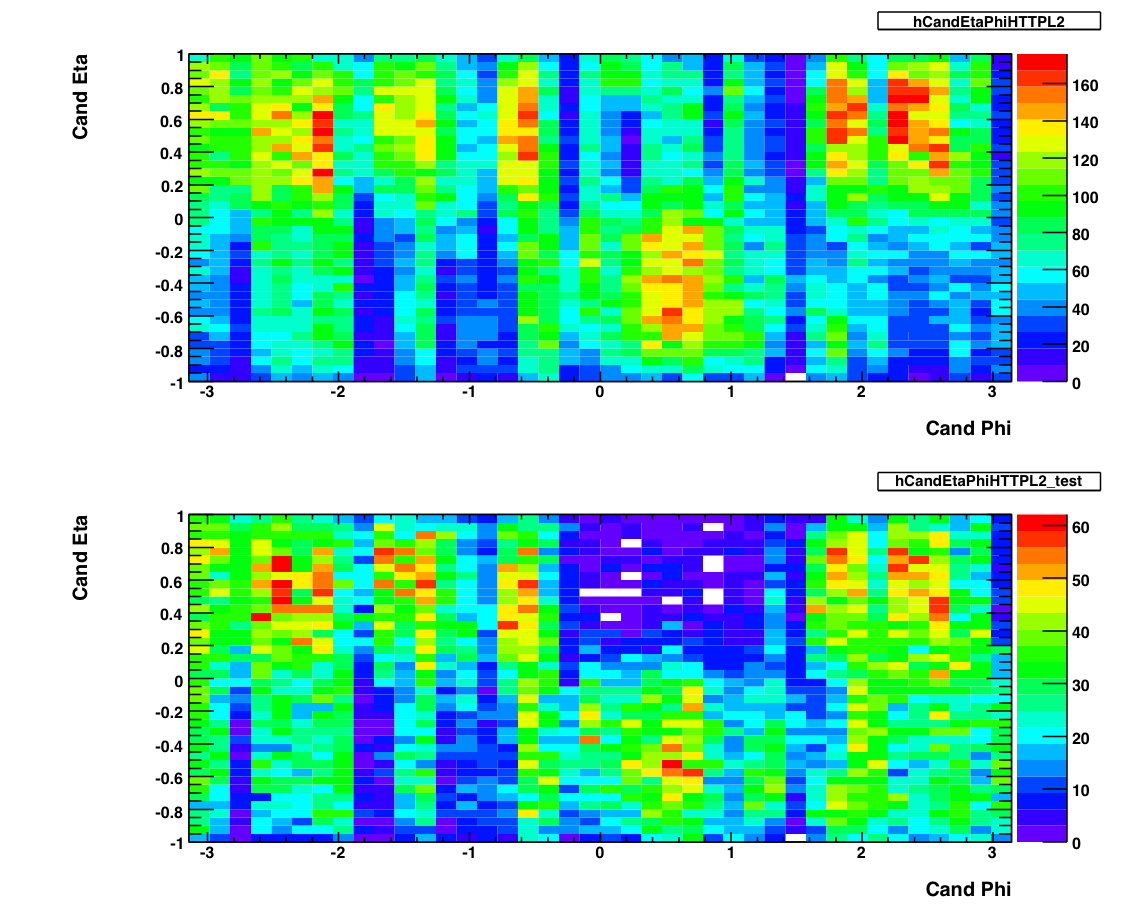
The above plots show 2-d histograms of eta and phi for pion candidates. The plot on the top shows the candidates from the production L2-G trigger. The plot on the bottom shows the eta and phi distribution for candidates from the L2-G 'test' trigger. As of May 2007, I am not using these to exclude any runs. I used Frank's pion trees to make these plots, imposing the following cuts on any pion candidate:
- Energy > 0.1 GeV
- PT > 5.0 GeV
- Asymmetry < .8
- Mass between .08 and .25 GeV
- No charged track association.
- BBC Timebin = 7,8 or 9.

The above plot shows histograms of the eta and phi positions of individual photons (hits). Again the top plot shows photons from events from the production L2-G trigger while the bottom shows photons from the 'test' L2-G trigger. Note the lack of structure in these plots compared to the candidate plots. This is due to the SMD, which is used in making the top plots (i.e. a candidate needs to have good SMD information) and unused in the bottom plots (a hit does not reference the SMD.) The status tables for different fill periods can be found at the bottom of this page. You can see that there are some gaps in the smd which could be responsible for the structure in the Candidate plot.
Event Ratios

This plot shows, as a function of run number, the number of L2-G triggered events divided by the number of minbias triggers (w/ prescale.) This shows all the runs, before any outliers are removed.

This plot above shows a the histograms of the top plots. There is some subtlety here (as you have probably noticed) in that the data needs to be analyzed in four sets. The largest set (corresponding to the top left histogram) is all of the L2-G triggers from the 'production' level data, which consists of all the runs after ~100. The other three sets are all subsets of the 'test' status (i.e. the first ~100 runs) and reflect changes in the prescale and threshold levels. The characteristics from each subset are noted below.
Runs 3 -14 (top right):
Initial test thresholds
Prescale = 1
Runs 23 - 44 (lower left):
Higher thresholds (?)
Prescale = 2
Runs 45 - 93 (lower right):
Lower thresholds
Prescale = 1
Runs 93+ (top left):
Final thresholds (5.2 GeV)
Prescale = 1

The above plot shows the event ratio after outliers have been removed. To identify these outliers I took a four-sigma cut around the mean for each of the four histograms shown above, and removed any runs that fell outside this cut. The list of outlying runs and thier characteristics can be found here.
Pion Number


On the left are two plots showing the number of pions per triggered event (L2-G trigger) as a function of run index. The top plot is for all of the runs when the L2-G trigger had production status, while the bottom plot exhibits the runs for which the L2-G trigger had 'test' status (about the first 100 runs or so.) On the right are histograms of these two plots. To remove outliers from the runlist, I made a two-sigma cut around the mean of these histograms and removed any run that fell outside this range. Below are plots showing pion number per triggered event after the outlying runs have been removed. Note the change in scale from the original. A list of excluded runs and thier properties can be found here.

As you can see, there is some funny structre in the above plot. It's almost bi(or tri)-modal, with the mean number of pions per trigger jumping between .06 and .08 (or even .1). I think this is a consequence of the SMD. See below.

The above is a plot of the number of triggered photons that have GOOD SMD status normalized by the total number of triggered photons, as a function of run number. While this is crude, it gives an approximate measure of the percent of active SMD strips in the barell for each run. As you can see, the peaks and vallys in this plot mirror the peaks and vallys in pion yield above. Since the SMD is not required to satisfy the trigger but IS required to reconstruct a pion, we would expect that the pion reconstruction efficiency would decrease as the number of active SMD strips decreases. Indeed this is what appears to be happening.
I used Frank's pion trees to make these plots, imposing the following cuts on any pion candidate:
- Photon Et > 0.1 GeV
- PT > 5.2 GeV
- Asymmetry < .8
- Mass between .08 and .25 GeV
- No charged track association.
- BBC Timebin = 6, 7, 8, or 9.
- 'Good' SMD status.
Pion Yields
currently not in useSingle Spin Asymmetries
Run By Run
Runs are indexed from the beginning of the long-2 period. For reference, take a look at this file.

By Transverse Momentum


Tower and SMD info
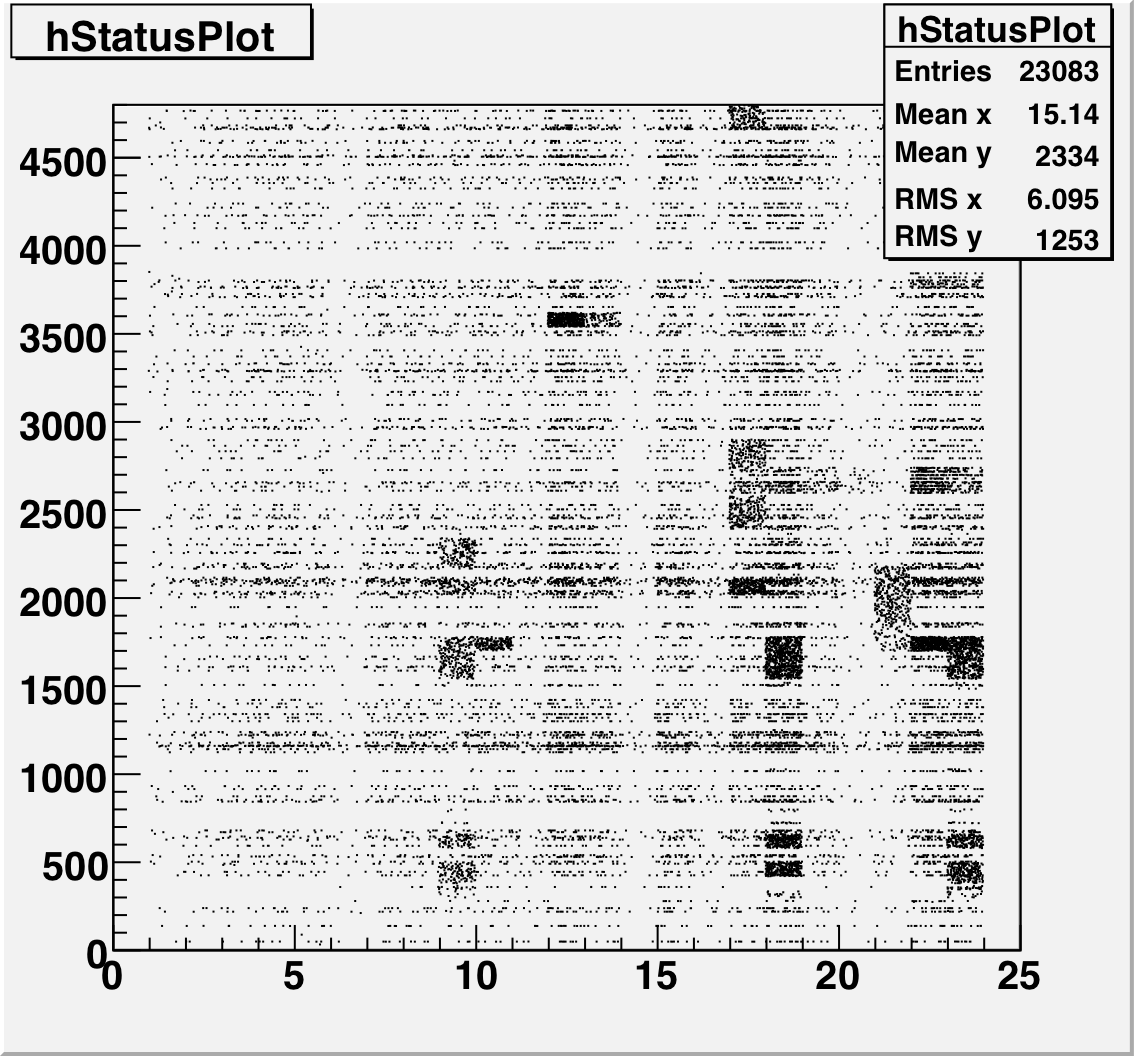
This is a plot of the tower status as a function of relative day (since the start of the second longitudinal period.) The 4800 towers are on the Y-Axis and Days are on the X axis. A dot means that that tower had a status other than good during that time period.
Tower Status Geometry
The below plots show the status as a function of phi and eta for different days representing different status periods. The title of the histogram refers to the relative day in the second longitudinal period (e.g. hGeomStatus_5 is for the fifth day of long-2.) The x and y axes correspond to detector phi and eta, and any space that is not white is considered a 'bad' tower. As you can see, for most of the barell for most of the time, most of the towers are good. Only for specific day ranges are there chunks of the barrel missing.
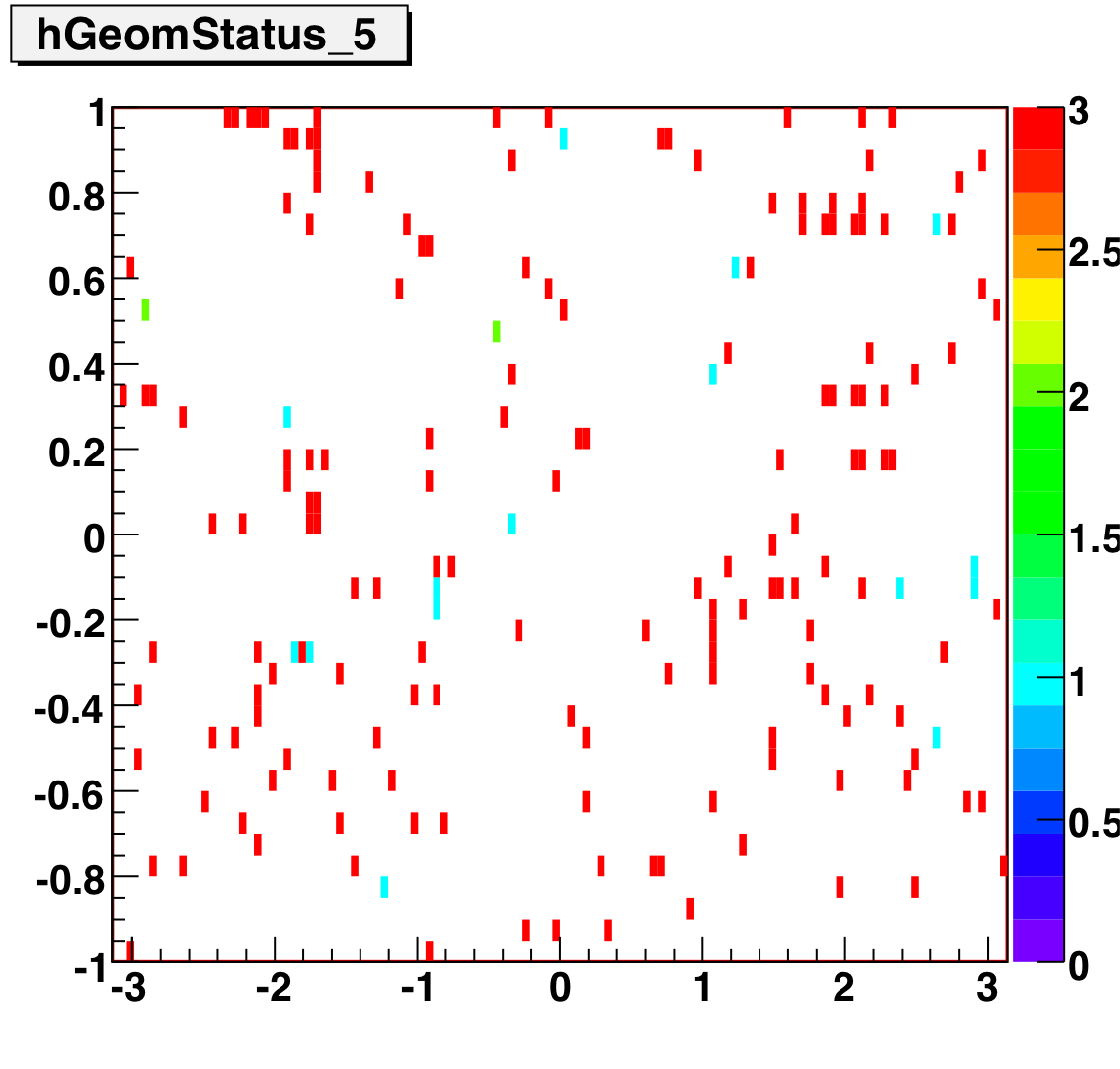
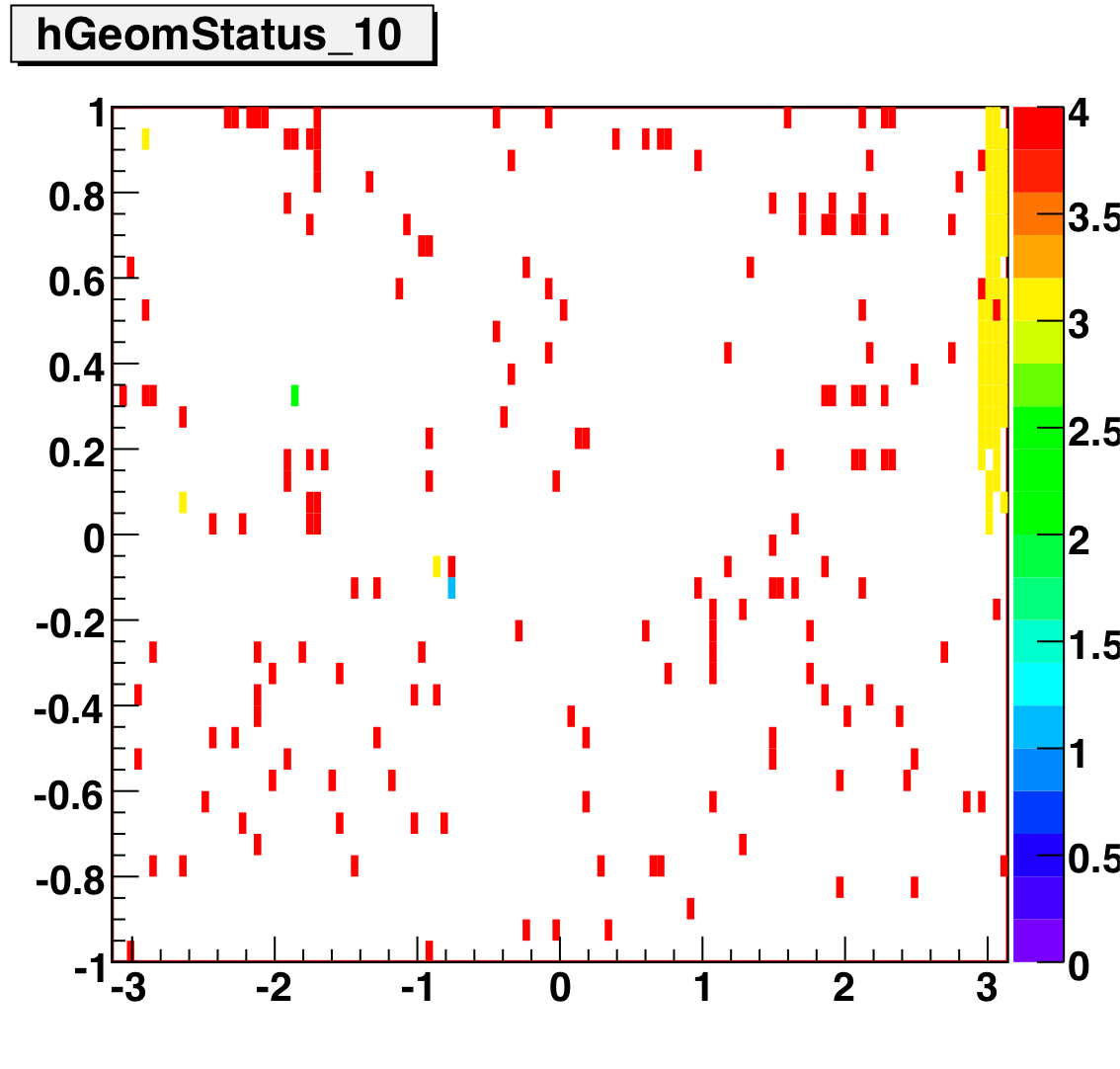
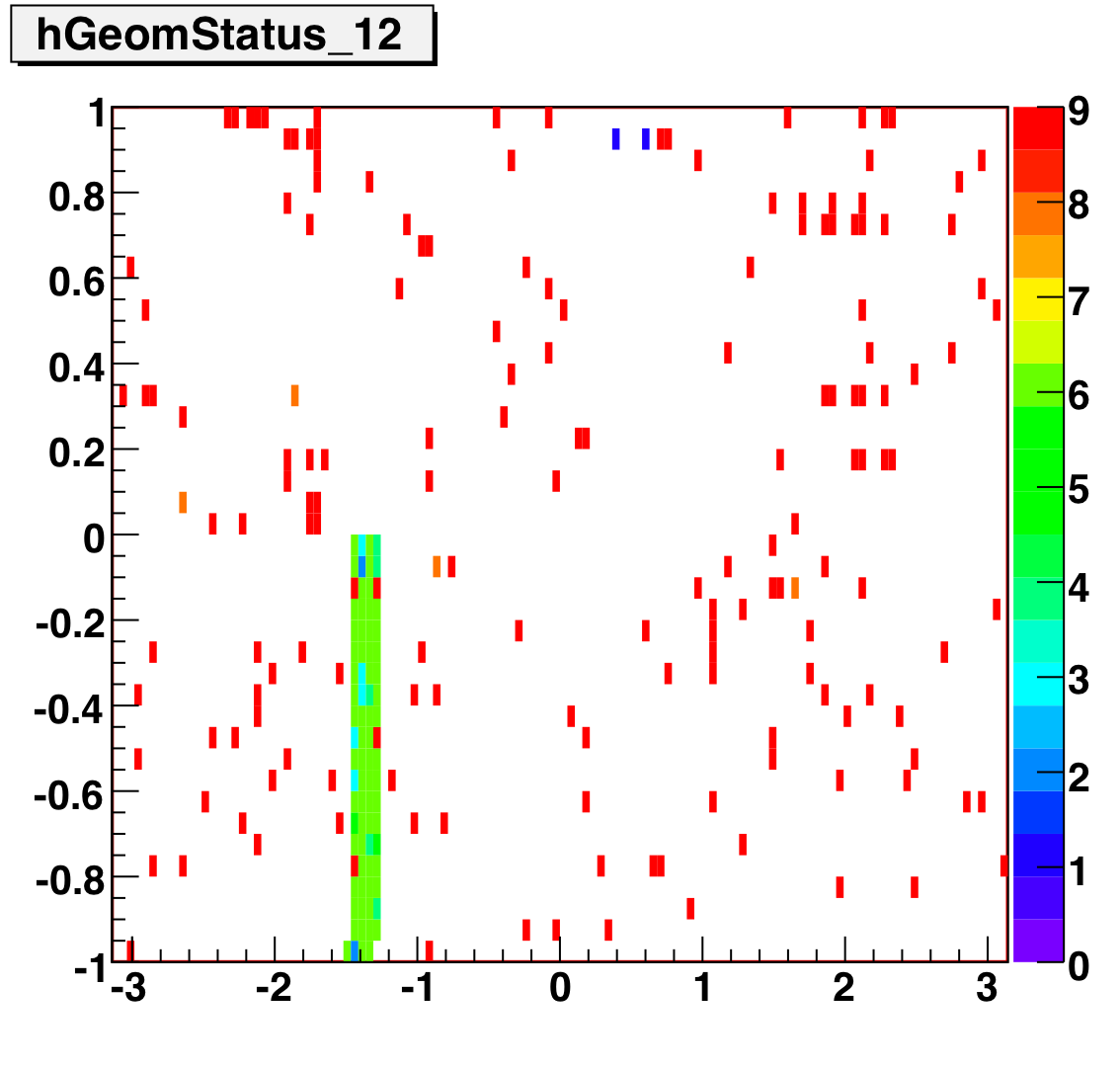
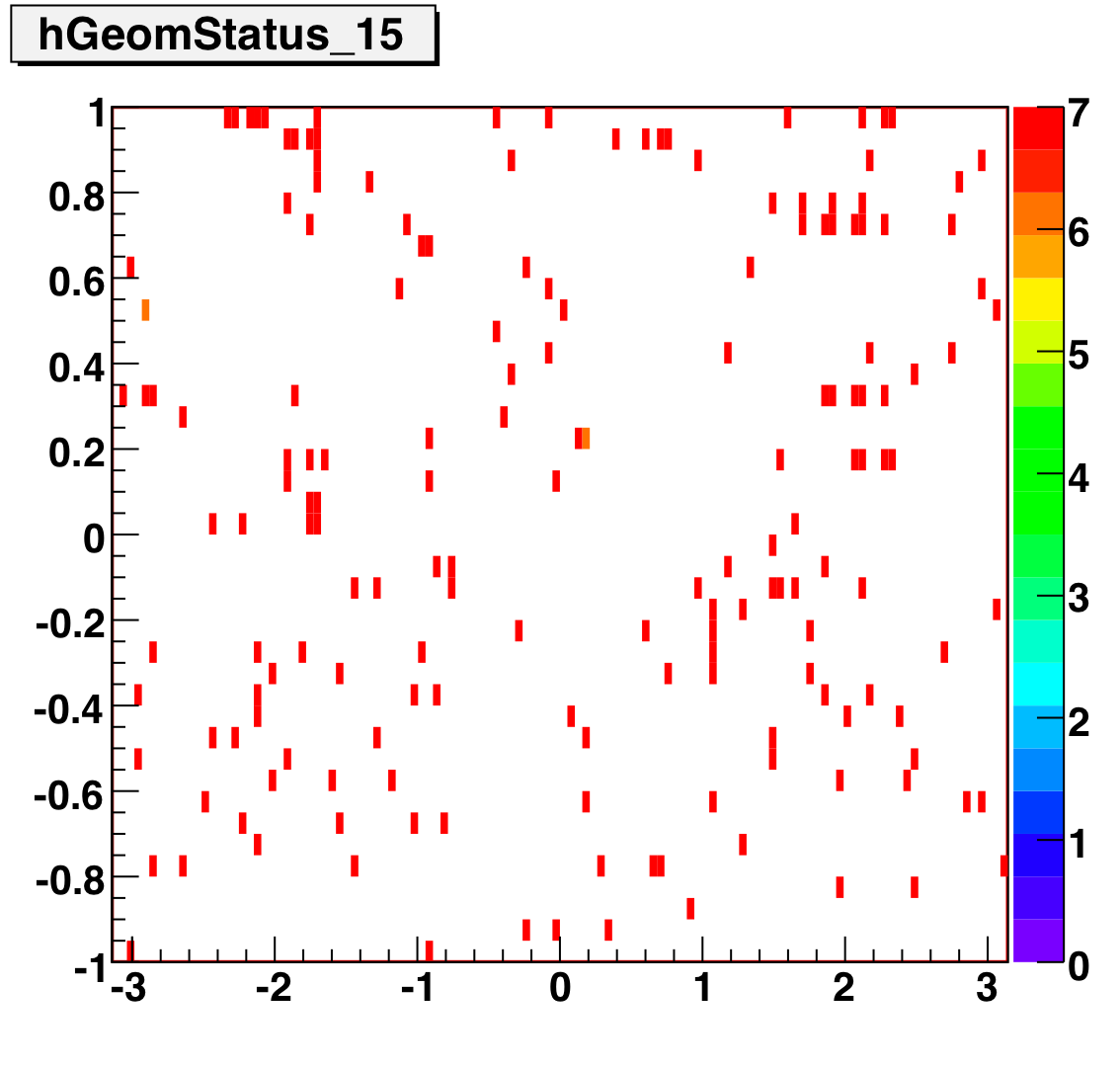
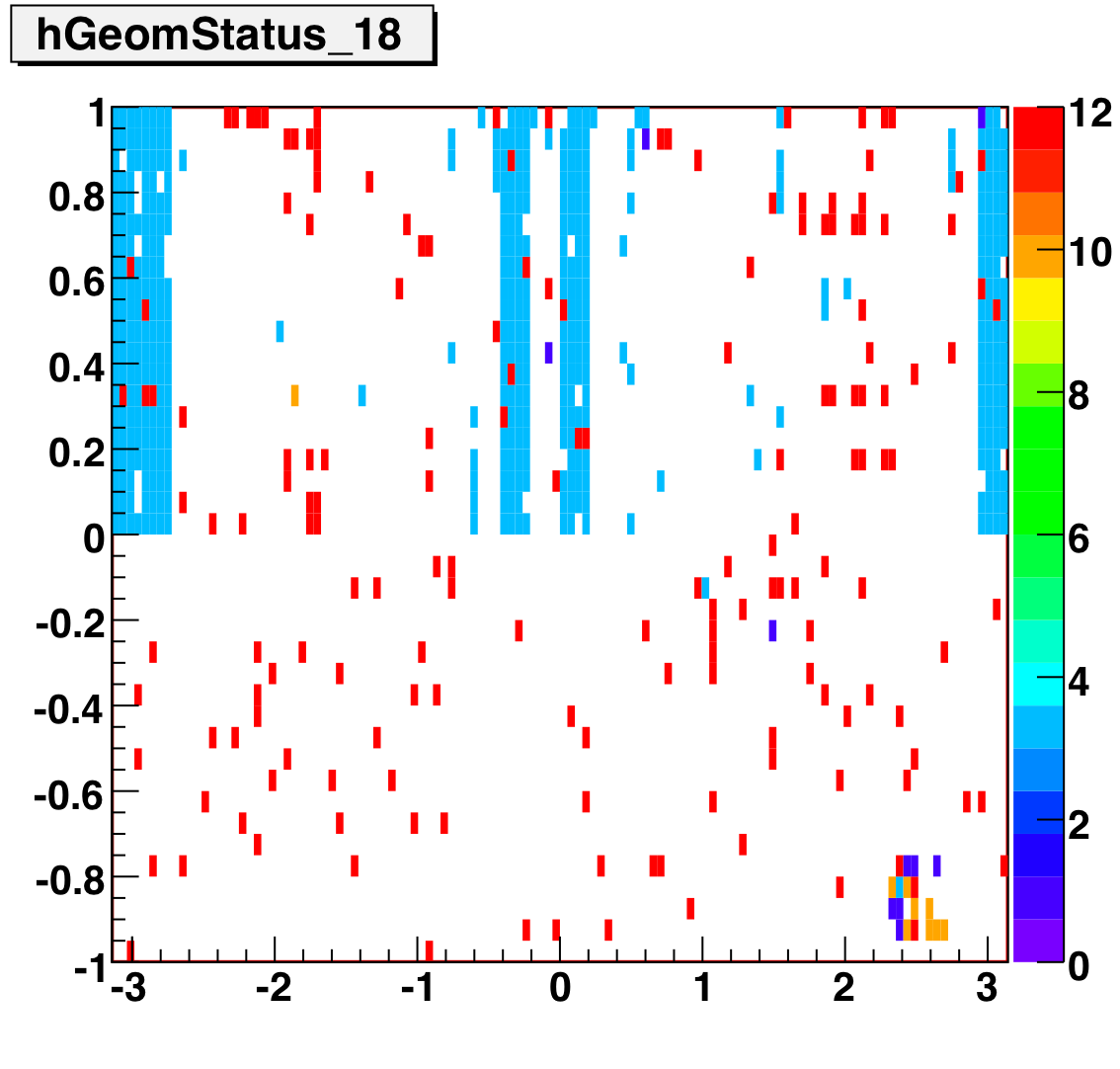
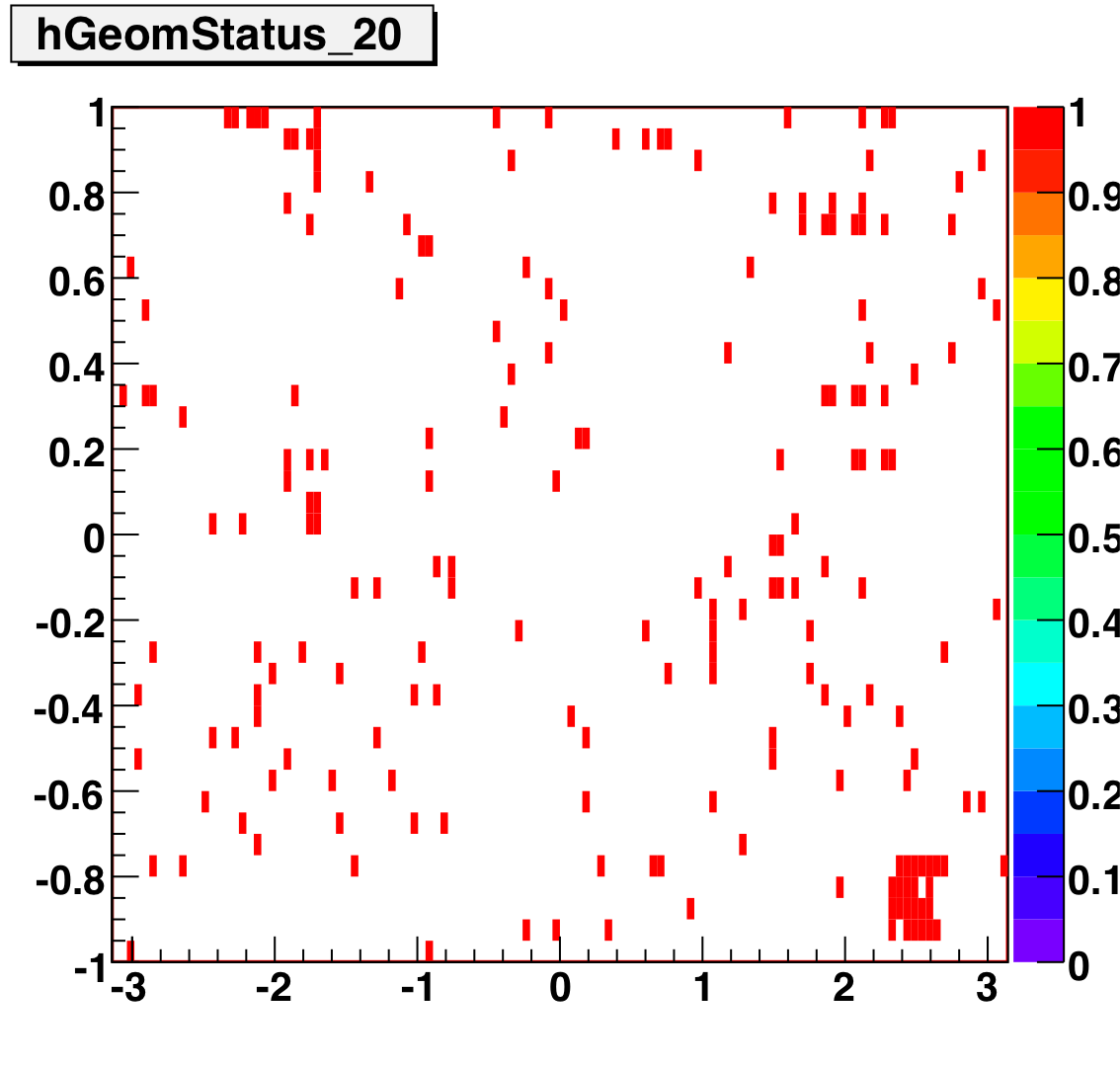
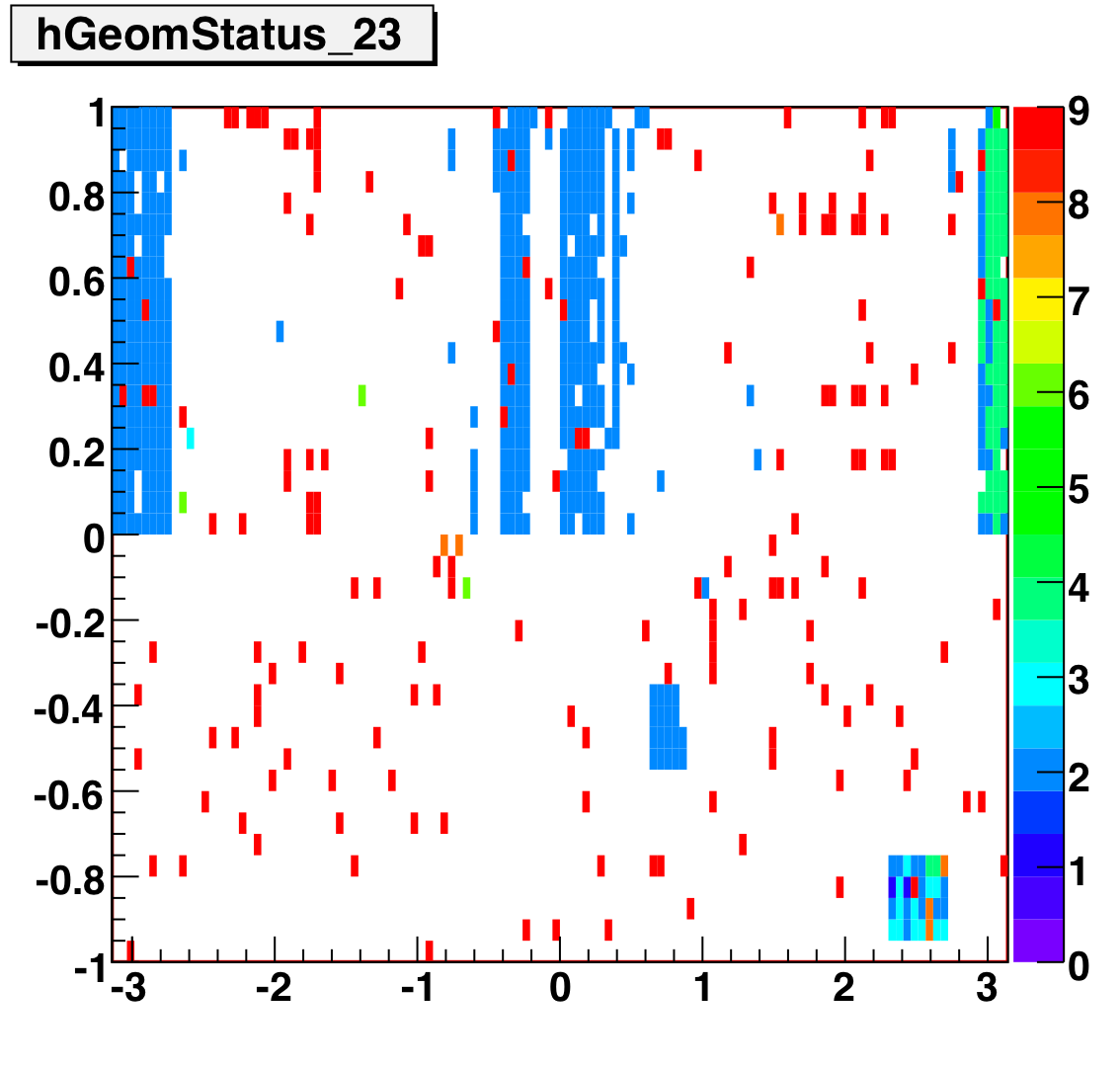
SMD Status
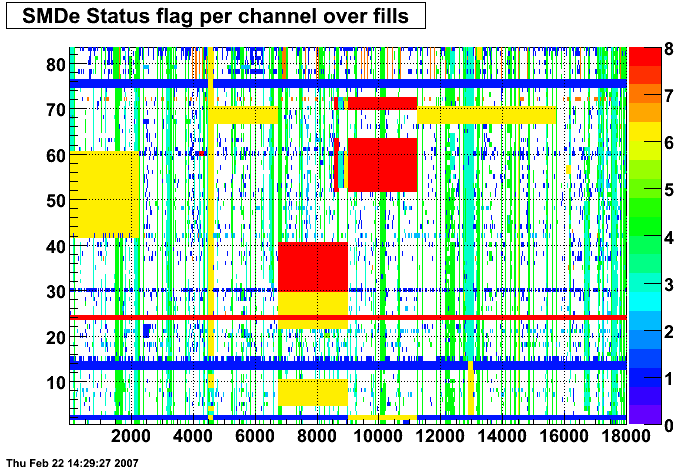
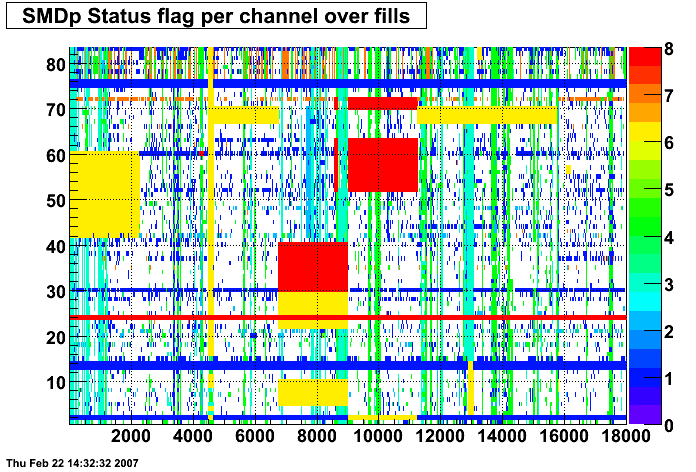
These two plots were made by Priscilla and they show the SMD status flags for SMD strips vs. Fill number. In these plots the strip number is plotted along the X-axis and the fill index number is plotted along the Y-Axis. Priscilla's fill index list can be found here. The important range for my particular analysis (i.e. the second longitudinal range) runs between fill indices 41 - 74. For my analysis I ignore any SMD strip that has a status other than good (== 0).
SMD Status Geometry
The plots below show the smd status as a function of geometry. The location of the strip in eta-phi space (w/ phi on the x axis and eta on the y axis.) You can see the eta and phi strip planes for four different fills (representative of different configurations) 7855, 7891, 7921, and 7949. Using Priscilla's iindexing these fills correspond to fills 46, 57, 68, and 72 in the above plots. We can see that these runs mark the beginning of major changes in the status tables, and each plot below represents a relativley stable running period. For my analysis I consider any area that is not light blue (i.e. any area with status other than 1) to be bad. Please note the difference between the SMD geometry plots and the BTOW geometry plots, namely, in the SMD plots whitespace represents 'bad' strips, whereas in the BTOW plots whitespace represents 'good' towers. All plots below were made by Priscilla.
Z Vertex


The above left plot shows average z vertex as a function of run index for the L2-G trigger. The upper plot shows all runs for which the L2-G trigger had production status, while the lower plot shows the first ~100 runs, for which the L2-G trigger had test status. The above right plot shows a histogram of the points on the above left plot. These plots show the average z vertex for all the events in a run, that is, they are not limited to pion candidates (as in some of the other QA measures.)

this plot above shows the average z vertex of L2-G events as a function of run index, with outlying runs removed. To identify outying runs, I took a four-sigma cut around the mean of each histogram (showed top right) and excluded any run for which the average z vertex fell outside this cut. Currently, I separate the 'test' from 'production' runs for analysis of outlyers. It would not be hard to combine them if this is deemed preferable. A list of the excluded runs, with thier average z verex can be found here.
SPIN 2008 Talk for Neutral Pions
Hi all-
My Spin 2008 talk and proceedings can be found below.
Update:
v2 reflects updates based on comments from SPIN pwg and others
Spin PWG Meeting (2/22/07)
Statistics for Late Longitudinal Running- ~ 400 runs (7132001 - 7156028)
- ~ 6.2 million events
- ~ 170K Neutral Pions for HTTP L2 Gamma trigger
- ~ 80K Neutral Pions for HT2 Trigger
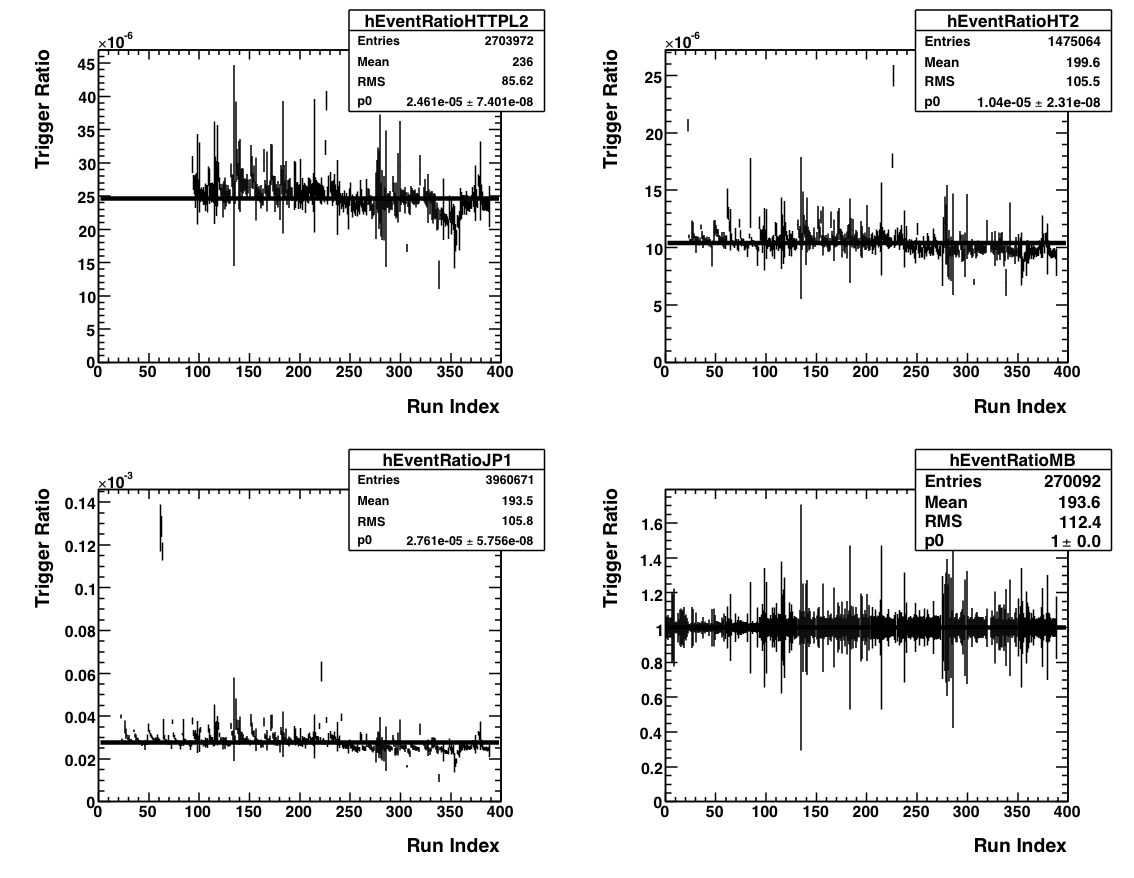
This plot shows, for the four triggers (HTTPL2, HT2, JP1, MB) the number of triggers registered normalized by the number of
minbias triggers registered, as a function of run index.
Pions per Event
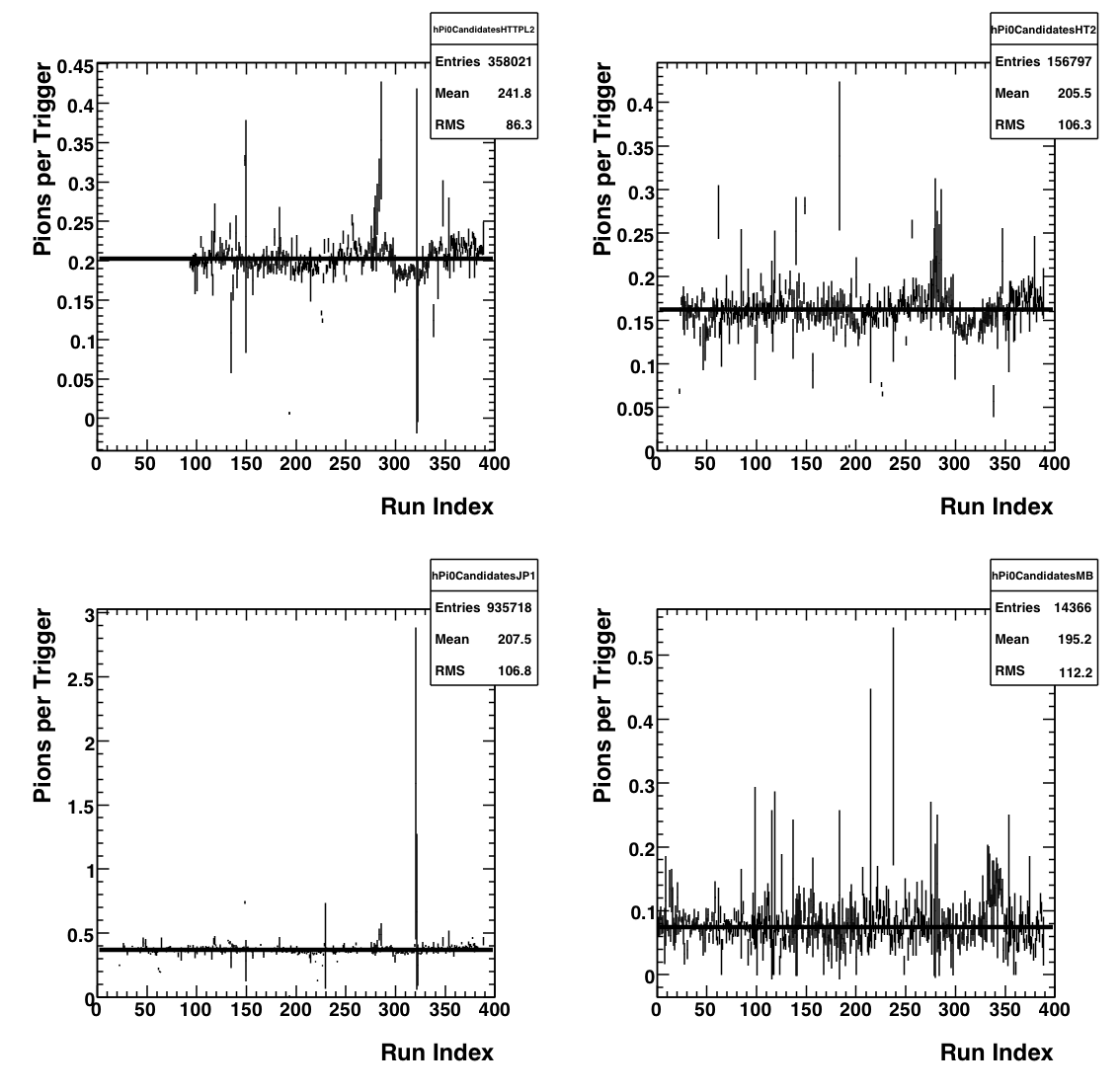
This plot shows the average number of neutral pions in an triggered event as a function of run number. For my purposes a
neutral pion consists of a reconstructed pion (using Frank's trees) that has the following cuts:
- Energy of each photon > 0.1 GeV
- Pt > 0.5 GeV
- Asymmetry < 0.8
- Mass between 0.08 and 0.25 GeV
- No charged track associated w/ the photons
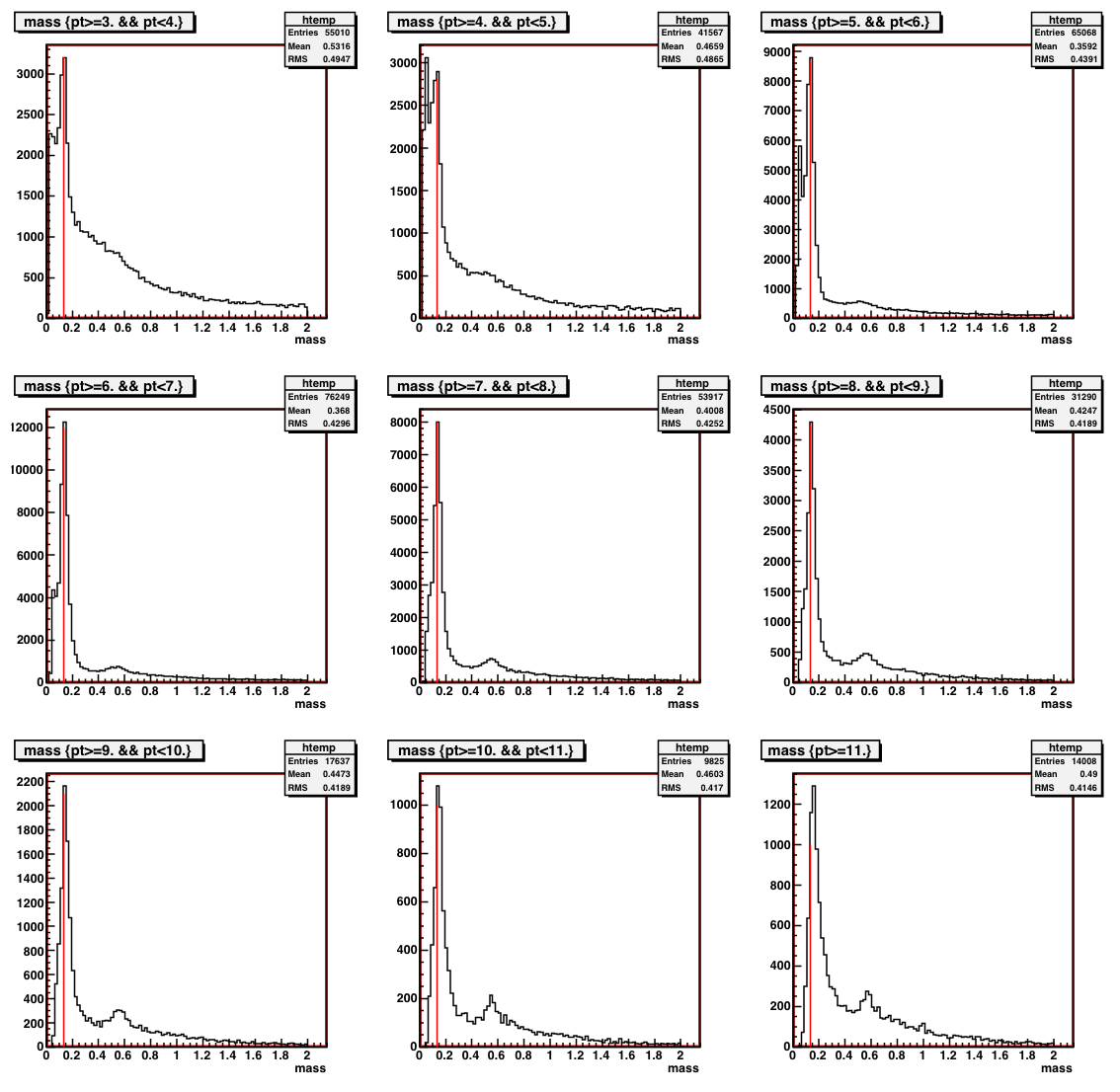
This plot shows the two-photon invariant mass spectrum for the HTTPL2-Gamma trigger, which is my most abundant and cleanest trigger. The mass
spectra are split into 1 GeV Pt bins, with the exception of the last one which is for everything with Pt more than 11 GeV.
Parsed Run List
Using the QA data shown on plots above (with more detail in my run QA page) I have come up with a preliminary 'good run list.' Basically I took the above event ratio and number ratio plots (along with a similar one for average z-vertex) and made a 4 sigma cut on either side the mean value. Any run with a value that fell outside this cut for either of the high tower triggers was excluded from my preliminary run list (right now the JP1 plots have no impact and are presented for curiosity sake.) Every run that passed these three tests was labeled 'good' and included in my list. My list and the associated run indexes can be found here. The list contains 333 runs.
ALL Checklist
The following is a checklist of 'to do' tasks toward a preliminary ALL measurement.
- Relative luminosity data for the late-longitudinal runs
- Polarization data (note, I have the numbers for the fast-offline CNI measurements and am refining the data for release.)
- Decisions on details (Pt binning, final mass window, etc.)
- Montecarlo studies
- Background studies
- Studies of other systematic effects.
- Other?
Spin PWG meeting (2/12/09)
The PDF for my slides is linked below.
Towards a Preliminary A_LL
Links for the 2006 Neutral Pion A_LL analysis
The numbered links below are in 'chronological' type order (i.e. more or less the order in which they should be looked at.) The 'dotted' links below the line are a side-effect in Drupal that lists all daughter pages in alphebetical order. They are the exact same as the numbered links and probably should just be ignored.
1. Run List QA
4. Cuts etc.
6. Invariant Mass Distribution
10. Sanity Checks
11. DIS Presentation
A_LL
The measurement of ALL for inclusive neutral pion production is seen below along with statistical error bars and a systematic error band. This asymmetry was calculated using a class developed by Adam Kocoloski (see here for .cpp file and here for .h file.) Errors bars are statistical only and propagated by ROOT. The gray band below the points represents the systematic uncertainties as outlined here. The relative luminosities are calculated on a run by run basis from Tai's raw scalar counts. Each BBC timebin is treated seperately. The theory curves are GRSV predictions from 2005. These will change slightly for 2006.

Bin ALL (x10-2)
1 0.80 +/- 1.15
2 0.58 +/- 1.36
3 2.03 +/- 1.89
4 -0.84 +/- 3.06
Cuts and Parameters
Here I will detail the some general information about my analysis; topics that aren't substantial enough to warrant their own page but need to be documented. I will try to be as thorough as I can.
Data
Run 6 PP Long 2 Only.
Run Range: 7131043 - 7156040
Fill Range: 7847 - 7957
Days: 131 - 156 (May 11 - June 5, 2006)
HTTP L2gamma triggered data (IDs 5, 137611)
Trees using StSkimPionMaker (found in StRoot/StSpinPool/) and Murad's spin analysis chain macro
Trees located in /star/institutions/mit/ahoffman/Pi0Analysis/Murads_Production_1_08/
Cluster Finding Conditions
Detector Seed Add
BEMC 0.4 GeV 0.05 GeV
SMDe/p 0.4 GeV 0.005 GeV
Pion Finding Cuts
Event passes online and software trigger for L2gamma
Energy asymmetry (Zgg) <= 0.8
Charged track veto (no photon can have a charged track pointing to its tower)
BBC timebins 6,7,8,9 (in lieu of a z vertex cut)
At least one good SMD strip exists in each plane
-0.95 <= eta <= .95
Z vertex found
Pt Bins for ALL
All reconstructed pion candidates are separated by Pt into four bins:
5.20 - 6.75
6.75 - 8.25
8.25 - 10.5
10.5 - 16.0
Simulation
Full pythia (5 to 45 GeV/c in partonic Pt, weighted)
Single pion, photon, and eta simulations (2 - 25 GeV/c in particle Pt, unweighted)
EMC simulator settings:
15% Tower Spread
25% SMD Spread
SMD Max ADC: 700
SMD Max ADC spread: 70
(see this link for explanation of SMD Max ADC parameters)
Four representative timestamps used:
20060516, 062000 (40%)
20060525, 190000 (25%)
20060530, 113500 (25%)
20060603, 130500 (10%)
Full pythia trees located in /star/institutions/mit/ahoffman/Pi0Analysis/MC_Production_2_08/
Single particle trees located in /star/institutions/mit/ahoffman/Pi0Analysis/single_particle_simulations/
DIS 2008 Presentation
Below you will find a link to a draft my DIS 2008 presentation.
Energy Subtracted A_LL Calculation
For my single particle Monte Carlo studies, I argued (here) that I needed to add a small amount of energy to each reconstructed photon to better match the data. This small addition of energy brings the simulation mass distributions into better alignment with the mass distributions in the data. I did not, however, subtract this small bit of energy from reconstructed (data) pions. This affects ALL in that pion counts will migrate to lower Pt bins and some will also exit the low end of the mass windown (or enter the high end.) So I calculated ALL after subtracting out the 'extra' energy from each photon. The plot below shows the original ALL measurement in black and the new measurement in red.

The values from both histograms are as follows:
Bin black (orig) red (new)
1 .0080 .0095
2 .0058 .0092
3 .0203 .0196
4 -.0084 -.0069
So things do not change too much. I'm not sure which way to go with this one. My gut tells me to leave the data alone (don't correct it) and assign a systematic to account for our lack of knowledge of the 'true' energy of the photons. The error would be the difference between the two plots, that is:
Bin Sys. Error (x10-3)
1 1.5
2 3.4
3 0.7
4 1.5
Integral Delta G Study
Using Werner's code I calculated A_LL for pi0 production over my eta range for 15 different integral values of Delta G. Below I plot the measured A_LL points and all of those curves.
I then calculated chi^2 for each of the curves. Below is the chi^2 vs. integral delta g.
The red line shoes minimum chi^2 + 1. For my points, GRSV-Std exhibits the lowest chi^2, but GRSV-Min is close. My data indicates a small positive integral value of delta g in the measured x range.
Invariant Mass Distribution
The two-photon invariant mass distribution can be roughly broken up into four pieces, seen below*.
Fig. 1

The black histogram is the invariant mass of all pion candidates (photon pairs) with pt in the given range. I simulate each of the four pieces in a slightly different way. My goal is to understand each individual piece of the puzzle and then to add all of them together to recreate the mass distribution. This will ensure that I properly understand the backgrounds and other systematic errors associated with each piece. To understand how I simulate each piece, click on the links below.
1. Pion Peak
2. Eta Peak
Once all of the four pieces are properly simulated they are combined to best fit the data. The individual shapes of are not changed but the overall amplitude of each piece is varied until the chisquared for the fit is minimized. Below are plots for the individual bins. Each plot contains four subplots that show, clockwise from upper left, the four individual peices properly normalized but not added; the four pieces added together and compared to data (in black); the ratio of data/simulatio histogramed for the bin; and a data simulation comparison with error bars on both plots.
Bin 1: 5.2 - 6.75 GeV/c

Bin 2: 6.75 - 8.25 GeV/c

Bin 3: 8.25 - 10.5

Bin 4: 10.5 - 16.0

Below there is a table containing the normalization factors for each of the pieces for each of the bins as well as the total integrated counts from each of the four pieces (rounded to the nearest whole count.)
| bin | low norm. | low integral | pion norm. | pion integral | eta norm. | eta integral | mixed norm. | mixed integral |
| 1 | 121.3 | 9727 | 146.4 | 75103 | 20.91 | 5290 | 0.723 | 44580 |
| 2 | 77.34 | 4467 | 77.81 | 51783 | 20.86 | 6175 | 0.658 | 34471 |
| 3 | 40.13 | 3899 | 29.41 | 23687 | 12.93 | 6581 | 1.02 | 18630 |
| 4 | 5.373 | 1464 | 5.225 | 8532 | 2.693 | 3054 | 0.521 | 6276 |
Table 2 below contains, for each source of background, the total number of counts in the mass window and the background fraction [background/(signal+background)].
| Bin | Low Counts | Low B.F (%) | Eta Counts | Eta B.F (%) | Mixed Counts | Mixed B.F (%) |
| 1 | 2899 | 3.60 | 1212 | 1.50 | 4708 | 5.84 |
| 2 | 2205 | 3.96 | 917 | 1.65 | 3318 | 5.96 |
| 3 | 2661 | 9.29 | 633 | 2.21 | 1507 | 5.26 |
| 4 | 858 | 8.56 | 170 | 1.70 | 591 | 5.89 |
* Note: An astute observer might notice that the histogram in the top figure, for hPtBin2, does not exactly match the hPtBin2 histogram from the middle of the page (Bin 2.) The histogram from the middle of the page (Bin 2) is the correct one. Fig. 1 includes eta from [-1,1] and thus there are more total counts; it is shown only for modeling purposes.
Combinatoric Background
The last piece of the invariant mass distribution is the combinatoric background. This is the result of combining two non-daughter photons into a pion candidate. Since each photon in an event is mixed with each other photon in an attempt to find true pions, we will find many of these combinatoric candidates. Below is a slide from a recent presentation describing the source of this background and how it is modeled.
---------------------------------------

-------------------------------------------
As it says above we take photons from different events, rotate them so as to line up the jet axes from the two events, and then combine them to pion candidates. We can then run the regular pion finder over the events and plot out the mass distribution from these candidates. The result can be seen below.

These distributions will be later combined with the other pieces and normalized to the data. For those who are interested in the errors on these plots please see below.

Eta Peak
I treat the eta peak in a similar way as the pion peak. I throw single etas, flat in Pt from 2 - 25, and reconstruct the two-photon invariant mass distribution for the results. The thrown etas are weighed according to the PHENIX cross-section as outlined here. The mass distributions for the four pt bins can be seen below. (I apologize for the poor labeling, the x-axis is Mass [GeV/c^2] and the y-axis is counts.) Don't worry about the scale (y-axis.) That is a consequence of the weighting. The absolute scale will later be set by normalizing to the data.

These plots will later be combined with other simulations and normalized to the data. The shape will not change. For those interested in the errors, that can be seen below.

Low Mass Background
The low mass background is the result of single photons being artifically split by the detector (specifically the SMD.) The SMD fails in it's clustering algorithm and one photon is reconstructed as two, which, by definition, comprises a pion candidate. These will show up with smaller invariant masses than true pions. Below is a slide from a recent presentation that explaines this in more detail and with pictures.
----------------------------------

----------------------------------
We can reproduce this background by looking at singly thrown photons and trying to find those that are artificially split by the clustering algorithm. Indeed when we do this, we find that a small fraction (sub 1%) do indeed get split. We can then plot the invariant mass of these pion candidats. The results can be seen below. (x-axis is mass in GeV/c^2.)

These mass distributions will later be combined with other pieces and normalized to the data. For those interested in the errors on these histograms please see below.

Pion Peak
To study the pion peak section of the invariant mass distribution I looked at single pion simulations. The pions were thrown with pt from 2 - 25 GeV/c flat and were reconstructed using the cuts and parameters described in the cuts, etc. page. The mass of each reconstructed pion is corrected by adding a small amount of energy to each photon (as outlined here.) After this correction the peak of the reconstructed mass distribution is aligned with the peak of the data. The mass distributions from the four bins can be seen below.

Later, these peaks will be normalized, along with the other pieces, to the data. However, the shape will not change.
If you are interested in seeing the errors on the above plots, I reproduce those below.

Polarization
I am using the final polarization numbers from run 6, released by A. Bazilevsky to the spin group on December 4, 2007. The files can be found below.
Pt Dependent Mass
The two-photon invariant mass is given (in the lab frame) by
M = Sqrt(2E1E2(1 - Cos(theta)))
where E1 and E2 are the energies of the two photons and theta is the angle between those photons. For every real photon we should measure ~135 MeV, the rest mass of the pi0. Of course, the detectors have finite resolution and there is some uncertainty in our measurement of each of the three quantities above, so we should end up measuring some spread around 135 MeV.
But it is not that simple. We do not see a simple spread around the true pion mass. Instead, we see some pt dependence in the mean reconstructed mass.


The above left plot shows the two-photon invariant mass distribution separated into 1 GeV bins. The pion peak region (between ~.1 and .2 GeV) has been fit with a gaussian. The mean of each of those gaussians has been plotted in the above right as a function of Pt. Obviously the mean mass is increasing with Pt. This effect is not particularly well understood. It's possible that the higher the Pt of the pion, the closer together the two photons will be in the detector and the more likely it is that some of the energy from one photon will get shifted to the other photon in reconstruction. This artificially increases the opening angle and thus artificially increases the invariant mass. Which is essentially to say that this is a detector effect and should be reproducible in simulation. Indeed...

The above plot overlays (in red) the exact same measurement made with full-pythia monte carlo. The same behavior is exhibited in the simulation. Linear fits to the data and MC yield very similar results...
-- M = 0.1134 + 0.0034*Pt (data)
-- M = 0.1159 + 0.0032*Pt (simulation)
If we repeat this study using single-particle simulations, however, we find some thing slightly different.

-- M = 0.1045 + 0.0033*Pt
So even in single-particle simulation we still see the characteristic rise in mean reconstructed mass. (This is consistent with the detector-effect explanation, which would be present in single-particle simulation.) However, the offset (intercept) of the linear fit is different. These reconstructed pions are 'missing' ~11 MeV. This is probably the effect of jet background, where other 'stuff' in a jet get mixed in with the two decay photons and slightly boost their energies, leading to an overall increase in measured mass.
The upshot of this study is that we need to correct any single-particle simulations by adding a slight amount of extra energy to each photon.
Relative Luminosity
For my relative luminosity calculations I use Tai's relative luminosity file that was released on June 14th, 2007.
I read this using the StTamuRelLum class, which, given a run number and BBC timebin, reads in the raw scalar values for each spinbit. Each event is assigned raw scalar counts for each spinbit and every event from the same run with the same timebin should have the same scalar counts assigned. When it comes time to calculate my asymmetry, the relative luminosity is calculated from these scalar counts.
Run List
Below you will find the runlist I used for all of the studies leading up to a preliminary result. For a more detailed look at how I arrived at this runlist please see my run QA page.
Sanity Checks
Below there are links to various 'sanity' type checks that I have performed to make sure that certain quantities behave as they should
Mass Windows
The nominal mass window was chosen 'by eye' to maximize the number of pion candidates extracted while minimizing the backgrounds (see yield extraction page.) I wanted to check to see how this choice of mass window would affect the measurement of ALL. To this end, ALL was calculated for two other mass windows, one narrower than the nominal window (.12 - .2 GeV) and one wider than the nominal window (.01 - .3 Gev). The results are plotted below where the nominal window points are in black, the narrow window points are in blue and the wide window points are in red. There is no evidence to indicate anything more than statistical fluctuations. No systematic error is assigned for this effect.

Revised Eta Systematic
After some discussion in the spin pwg meeting and on the spin list, it appears I have been vastly overestimating my eta systematic as I was not properly weighing my thrown single etas. I reanalyzed my single eta MC sample using weights and I found that the background contribution from etas underneath my pion peak is negligible. Thus I will not assign a systematic error eta background. The details of the analysis are as follows. First I needed to assign weights to the single etas in my simulation. I calculated these weights based on the published cross section of PP -> eta + X by the PHENIX collaboration (nucl-ex 06110066.) These points are plotted below. Of course, the PHENIX cross section on reaches to Pt = 11 GeV/c and my measurement reaches to 16 GeV/c. So I need to extrapolate from the PHENIX points out to higher points in Pt. To do this I fit the PHENIX data to a function of the form Y = A*(1 + (Pt)/(Po))^-n. The function, with the parameters A = 19.38, P0 = 1.832 and n = 10.63, well describes the available data.

I then caluclate the (properly weighted) two-photon invariant mass distribution and calculate the number of etas underneath the pion peak. The eta mass distributions are normalized to the data along with the other simulations. As expected, this background fraction falls to ~zero. More specifically, there was less than ten counts in the signal reigon for all four Pt bins. Even considering a large background asymmetry (~20%) this becomes a negligable addition to the total systematic error. The plots below show the normalized eta mass peaks (in blue) along with the data (in black.) As you can see, the blue peaks do not reach into the signal reigion.

Unfortunately, the statistics are not as good, as I have weighted-out many of the counts. I think that the stats are good enough to show that Etas do not contribute to the background at any significant level. For the final result I think I would want to spend more time studying both single particle etas and etas from full pythia.
I should also note that for this study, I did not have to 'correct' the mass of these etas by adding a slight amount of energy to each photon. At first I did do this correction and found that the mass peaks wound up not lining up with the data, When I removed the correction, I found the peaks to better represent the data.
In summary: I will no longer be assigning a systematic from eta contamination, as the background fraction is of order 0.01% and any effect the would have on the asymmetry would be negligible.
Single Spin Asymmetries
The plots below show the single spin asymmetries (SSA) for the blue and yellow beams, as a function of run index. These histograms are then fit with flat lines. The SSA's are consistent with zero.


Systematics
We need to worry about a number of systematic effects that may change our measurement of ALL. These effects can be broadly separated into two groups: backgrounds and non backgrounds. The table below summarizes these systematic errors. A detailed explanation of each effect can be found by clicking on the name of the effect in the table.
| Systematic Effect | value {binwise} (x10-3) |
| Low Mass Background | {1.0; 1.1; 3.8; 1.0} |
| Combinatoric Background | {1.0; 0.86; 1.6; .03} |
| Photon energy Uncertainty | {1.5; 3.4; 0.7; 1.5} |
| Non Longitudinal Components* | 0.94 |
| Relative Luminosity* | 0.03 |
| Total** | {2.3; 3.8; 4.3; 2.0} |
* These numbers were taken from the Jet Group
** Quadrature sum of all systematic errors
Alternate Calculation of Eta Systematic
At the moment I am calculating the systematic error on ALL from the presence of Etas in the signal reigon using theoretical predictions to estimate ALLeta. The study below is an attempt to see how things would change if I instead calculated this systematic from the measured ALLeta. Perhaps, also, this would be a good place to flesh out some of my original motivation for using theory predictions.
First order of buisness is getting ALLeta. Since this was done in a quick and dirty fashion, I have simply taken all of my pion candidates from my pion analysis and moved my mass window from the nominal pion cuts to a new window for etas. For the first three bins this window is .45 GeV/c2 < mass < .65 GeV/c2 and for the fourth bin this is .5 GeV/c2 < mass < .7 GeV/c2. Here is a plot of ALLeta, I apologize for the poor labeling.

I guess my first reason for not wanting to use this method is that, unlike the other forms of background, the Etas A_LL ought to be Pt dependent. So I would need to calculate the systematic on a bin-by-bin basis, and now I start to get confused because the errors on these points are so large. Should I use the nominal values? Nominal values plus one sigma? I'm not sure.
For this study I made the decison to use ALLtrue as the values, where ALLtrue is calculated from the above ALL using the following formula:
ALLM = (ALLT + C*ALLBkgd)/(1 + C)
Remembering that a large portion the counts in the Eta mass window are from the combinatoric background. I then calculate the background fraction or comtamination factor for this background (sorry I don't have a good plot for this) and get the following values
Bin Bkg fraction
1 77.2%
2 60.9%
3 44.6%
4 32.6%
Plugging and chugging, I get the following values for ALLtrue:
Bin ALLT
1 .0298
2 .0289
3 -.0081
4 .175
Using these values of ALL to calculate the systematic on ALLpion I get the following values:
Bin Delta_ALLpion (x10^-3)
1 .33
2 .38
3 .63
4 3.1
Carl was right that these values would not be too significant compared to the quad. sum of the other systematics, except for final bin which becomes the dominant systematic. In the end, I would not be opposed to using these values for my systematic *if* the people think that they tell a more consistent story or are easier to justify/explain than using the theory curves. (i.e. if they represent a more accurate description of the systematic.)
Combinatoric Systematic
For the combinatoric background systematic we first estimate the background contribution (or contamination factor) to the signal reigon. That is we integrate our simulated background to discern the precentage of the signal yield that is due to background counts. The plots below show, for each of the four bins, the background fraction underneath the singal peak. The background (simulation) is in green and the signal (data) is in black and the background that falls in the signal reigon is filled-in with green.

The background fractions for the bins are
Bin 1: 6.1%
Bin 2: 6.1%
Bin 3: 5.7%
Bin 4: 6.2%
Then I consider how much this background fraction could affect my measured asymmetry. So I need to meausre the asymmetry in the high-mass reigon. I do this, taking the mass window to be 1.2 to 2.0 GeV/c2. I do not expect this asymmetry to be Pt-dependant, so I fit the asymmetry with a flat line and take this to be the asymmetry of the background, regardless of Pt. The plot below shows this asymmetry and fit.

Finally, I calculate the systematic error Delta_ALL = ALLTrue - ALLMeasured where:
ALLM = (ALLT + C*ALLBkgd)/(1 + C)
And C is the background fraction. This yields in the end as a systematic error (x10-3):
Bin 1: 1.0
Bin 2: 0.9
Bin 3: 1.6
Bin 4: 0.03
Eta Systematic
For the eta background systematic we first estimate the background contribution (or contamination factor) to the signal reigon. That is we integrate our simulated background to discern the precentage of the signal yield that is due to background counts. The plots below show, for each of the four bins, the background fraction underneath the singal peak. The background (simulation) is in blue and the signal (data) is in black and the background that falls in the signal reigon is filled-in with. Below that is the same four plots but blown up to show the contamination.

Here we blow up these plots

The background fractions for the bins are
Bin 1: 1.50%
Bin 2: 1.65%
Bin 3: 2.21%
Bin 4: 1.70%
Then I consider how much this background fraction could affect my measured asymmetry. So I need to measure the asymmetry in the etas. So instead of measuring the asymmetry in the etas I will use a theoretic prediction for ALL. From GRSV standard and GRSV min I approximate that the size of ALL in my Pt range to be between 2 - 4%.

I stole this plot from C. Aidala's presentation at DNP in Fall 2007. Since GRSV-Max is ruled out by the 2006 jet result I restrict myself only to min, standard and zero. For a conservative estimate on the systematic, I should pick, for each Pt bin, the theory curve that maximizes the distance between the measured and theoretical asymmetries. Unfortunately, at this time I do not have predictions for Pt above 8, so I must extrapolate from this plot to higher bins. For the first two bins this maximum distance would correspond to GRSV standard (ALLbg ~ 0.02). For the third bin, this would correspond to GRSV = 0 (ALLbg ~ 0.). For the fourth bin (which has a negative measured asymmetry) I extrapolate GRSV standard to ~4% and use this as my background ALL.
Systematic (x10-3)
Bin 1: 0.18
Bin 2: 0.23
Bin 3: 0.43
Bin 4: 0.82
Low Mass Systematic
For the low mass background systematic we first estimate the background contribution (or contamination factor) to the signal reigon. That is we integrate our simulated background to discern the precentage of the signal yield that is due to background counts. The plots below show, for each of the four bins, the background fraction underneath the singal peak. The background (simulation) is in red and the signal (data) is in black and the background that falls in the signal reigon is filled-in with red.

The background fractions for the bins are
Bin 1: 3.5%
Bin 2: 4.2%
Bin 3: 9.3%
Bin 4: 8.3%
Then I consider how much this background fraction could affect my measured asymmetry. So I need to meausre the asymmetry in the low-mass reigon. I do this, taking the mass window to be 0 to 0.7 GeV/c2. I do not expect this asymmetry to be Pt-dependant, so I fit the asymmetry with a flat line and take this to be the asymmetry of the background, regardless of Pt. The plot below shows this asymmetry and fit.

Finally, I calculate the systematic error Delta_ALL = ALLTrue - ALLMeasured where:
ALLM = (ALLT + C*ALLBkgd)/(1 + C)
And C is the background fraction. This yields in the end as a systematic error (x10-3):
Bin 1: 1.0
Bin 2: 1.1
Bin 3: 3.7
Bin 4: 1.1
Yield Extraction
After all the pion candidates have been found and all the cuts applied, we need to extract the number of pions in each bin (in each spin state for ALL.) To do this we simply count the number of pion candidates in a nominal mass window. I chose the mass window to try to maximize the signal region and cut out as much background as possible. For the first three Pt bins, this window is from .08 - .25 GeV/c2 and in the last bin the window is from .1 - .3 GeV/c2. The window for the last Pt bin is shifted mostly to cut out more of the low mass background and to capture more pions with higher than average reconstructed mass. The windows can be seen below for bins 2 and 4.


These Pt bins are broken down by spin state, and the individual yields are reported below.
| Bin | uu | du | ud | dd | Total |
| 1 | 20209 | 20088 | 19961 | 20231 | 80489 |
| 2 | 14088 | 14057 | 13645 | 13825 | 55615 |
| 3 | 7224 | 7080 | 7107 | 7204 | 28615 |
| 4 | 2505 | 2470 | 2552 | 2491 | 10018 |
Tower By Tower Pion Peaks
Calibration
I am trying to calibrate the BEMC using neutral pions. As of now I am only using the L2 Gamma trigger for the second longitudinal running period, although I plan on incorporating the transverse data as well since the calibration should be the same for the two running periods. The procedure, so far, is listed below. Items 1 - 4 have been done for the long2 data set and are not difficult. Items 5+ I have not done yet, nor am I certain if they are the correct way to proceed.
1. Find all pion candidates using Frank's finder.
2. Calculate the mass for each di-photon pair.
3. Find the tower struck by each photon in the candidate and fill that tower's histogram with the invariant mass of the pion candidate. Note that if the two photons strike two different towers, both towers are filled with the mass of one pion.
4. Fit the towers with a gaussian + linear function and extract the location of the peak (see below.)
* * *
5. Using the mass peaks, calculation a correction factor for each tower, and apply this correction factor to the tower response (gains? I'm not sure.)
6. Repeat until desired level of precision is reached.
Plots
Good Tower:

Poor Statistics (Hope to improve w/ Transverse):

Poor Fit:

Spiked Fit (Chi^2 = 60/32 if you can't read it.)

A .pdf with all 4800 towers, and their fits can be found here. It is about 50 MB.
Run 6 Relative Luminosity (Tai Sakuma)
Along with the spin sorted yields and the polarization, the relative luminosity is important piece of the spin asymmetries and is measured by BBC and ZDC. The relative luminosity is primarily determined from the BBC data. The systematic uncertainty is determined from the comparison between BBC and ZDC.
Run 8 trigger planning (Jim Sowinski)
here are some presentations from the run 8 trigger planning.
Run 9
Collect documentation on run 9 here.
Goals
- at 500 GeV 10pb^-1 at 50% pol. FOM=P^2L=2.5pb^-1 End of run summary
- at 200 GeV 50pb^-1 at 60% pol. FOM=P^4l=6.5pb^-1 Track progress from Jamie here or online page
Statement of priorities for run
CAD projections for run 9
BTOW calibration thread and pages
Early polarimeter commisioning see links in March 5 pwg meeting.
Link to magnet cooldown.
JP threshold ADC->GeV and initial guesses link
500 GeV trigger list
500 GeV run ends ~noon on Monday April 13 2009. FOM collected 1.4pb-1 vs 2.5pb-1 goal (email).
First overnights at 200 GeV April 18 and 19.
Report on run to convenors 4/21/09
5/27/09 STAR magnet field reversed from direction previously.
Phil Pile planning meeting postings
Jamies trigger summary
Run 9 Preparation and Jobs List
Green = complete Red = currently critical
- Run 9 Preparation Tasks (includes commissioning at startup
- ZDC SMD hardware preparation Whitten
- planning and analysis - Hal, Valpo, LBL
- install DAQ and testing - Aihong
- Calibration and monitoring - Ramon
- VPD as polarimeter - LBL
- Trigger plan
- L0, L2 optimization - TAMU
- FMS
- coordination with other PWGs
- L0 trigger monitor from trigger data - Pibero
- DSM replacements - Hank
- Analyze 2008 data to:
- check triggers etc.
- BSMD operation, gains
- influence of low mass on gammas
- L2 algos
- coordination - Corliss
- endcap gamma-jet - Ilya
- barrel gamm-jet - Betancourt
- dijet algo - Page
- Peds - Page
- monitoring web pages - Betancourt
- Upsilon - Haidong Liu
- Ws - Seele
- Calibration - Corliss
- High energy - Corliss
- BEMC gain equalization
- Eta = 1 and -1
- E/W balance and phi dep in east
- BSMD, BPRS readout upgrade and data compression
- Hardware - Visser, Jacobs
- hardware tests post delivery
- zero suppression, peds
- software infrastructure and monitor - Leight
- BPRS Calibration and readiness
- Characterization from previous runs - Balewski
- FPGA fixes for cap ID - Visser
- HV adjustments, fiber fixes
- Resolve hole in East Barrel trigger - Pibero
- Shielding additions at top of tunnel - Bill, Al, Jim
- Pplot upgrades to match changes - G. Webb, Tsai and Trentalange
- Daq reader - core group
- EMC - Walker
- BSMD compression
- trigger changes
- DSM changes
- DSM wiring modifications and test
- Rewire - Engelage, Gagliardi
- tests - G. Webb, Grebenyuk
- High luminosity monitoring
- L measurement planning - Hal
- Scalers - Ernst, Jim, Joe, Hal, Dave, Chuck
- L measurement implementation
- TPC monitor FGT prototype - ANL, Majka
- 500 GeV preparation
- BSMD staturation studies
- W program - Seele
- gamma, pi0
- Trigger differences from 200 GeV - Carl
- Other
- BSMD staturation studies
- ESMD->DDL data path and necessary software changes
- EEMC maintenance - Jacobs, Sowinski
- BEMC maintenance - Tsai, Trentalange
- FMS trigger work
- Remap cabling for cluster triggering - Jim Drachanberg and/or
- rebuild pre-shower system - Jim Drachanberg and/or
- ZDC SMD hardware preparation Whitten
- Run 9 Startup and During Run Tasks
- Scaler check out - Bridgeman
- Luminosity monitor checkout
- Real time monitor of lumi/local pol - LBL
- CDEV monitoring - Sowinski
- AGS polarimetery - Spinka, Underwood, Haixin Huang
- RHIC polarimetry - Spinka, Underwood, Qinghua/student
- RHIC polarimeter monitor and recording - Jones
- ZDC SMD tuneup
- Commission BEMC - Grebenyuk, Cendejas, Tsai, Trentalange
- check calibration
- check ADC timing
- on call expert
- Commission EEMC - IU with help
- check calibration
- check ADC timing
- on call expert
- Commission FMS
- Commission BBC
- Trigger setup
- EMC trigger bit timing - Hank et al
- Rates and thresholds scans and settings
- confirmation good to go
- L2 testing
- L2 monitoring and updating
- L2 on call expert
- Preparation for analysis
- Luminosity -Jones
- runlist and QA - Page/Sowinski
- Spin data base
- Fill by fill spin patterns - Page
- Bunch offsets and load DB
- Calorimeter Readiness
- EEMC - IU
- peds and status
- claibrations
- BEMC
- peds and status
- calibrations
- EEMC - IU
- Ongoing Service Work
- EEMC hardware maintenance - IU
- EEMC software coordinator
- EEMC calibrations
- Sampling fraction MC studies
- pi0, eta, electron, mips
- BEMC hardware maintenance - Tsai and Trentalange
- BEMC software coordinator
- BEMC calibrations - Tsai and Trentalange
- pi0 - Renee
- time dependence - Renee
- BEMC GEANT model refinements - Tsai and Trentalange
- Other GEANT model refinements
- TPC endcap and electronics - ANL
- FMS
- Calibrations
- run 9 - Zagreb
- Root framework software - PSU,TAMU
- FPD++ calib. - Poljak
- Common analysis software
- Trigger simulator software - Fatemi, Grebenyuk?
- L0 - Fersch
- EEMC codes - Gagliardi/Huo
- L2 ported to simulator incl. data base of params
- Vertex finding and tracking
- Jet finder
- gamma maker
- pi0 algos BEMC
- pi0 algos EEMC
- FGT project - Simon, MIT, IU, KU, ANL, Valpo
- Tier 2 simulations - Btancourt
Run 9 commissioning plan
Run 9 500 GeV Commission plan (start of draft) Not necessarily time ordered
or prioritized
Establish collisions
Develop Minbias trigger
BBC
TCU
DSMs
BBC as lumi and polarimeter
Commission and test scalers
Look for analyzing power - need > 30%? pol
FMS triggers and commissioning
EMC commissioning
Need minbias trigger to start - pol irrelevant
Timing Scan
Need stable beam background conditions - 2nd half of store?
Guess 4 hrs? scan both at same time
need EEMC and BEMC experts available
1 day min. to produce and check
Requires fast offline production of data on short time scale
HV adjustments and calibrations
Needs timing scan complete and set
Need minbias trigger - "low" backgrounds
1hr of beam - 3 succesive days
day of analysis of each run
Need calo experts and analyzers
Polarimetry commissioning in addition to BBC
ZDC -
signals into DAQ/trg
establish trigger
5-10M events with P>25%
min 1 day of analysis - try to analyze from trigger data
Suggest optimized trigger
Longer run after seeing analysis of first data (~1 day)
Needs detector and analysis experts
VPD
signals into DAQ/trg
signals at scalers
runs parasiticaly
Time to have answer few shifts of beam over few days?
Needs detector and analysis experts
Commission high level calo triggers
Needs calibration steps done
set thresholds based on rate scans - needs 1/2 a store
check for an mask hot towers at L0 and L2
monitor and analyze for a day
check L2 algos
confirm all ready to go
need L2 experts, calo experts
Criteria to switch to longitudinal
Some polarimeter working well enough to measure transverse components
Sufficient data to evaluate alternate polarimeters
Priorities? Time ordering? What can go in parallel? What could
but is prevented from going in parallel due to overlap of people?
Run 9 triggering
Carl has prepared a trigger description for 200 GeV.
Beam Polarizations
The beam polarization of the proton beams is measured with a set of polarimeters at IP12.
Carbon polarimeters: fast measurement several times during a RHIC fill, two devices per beam
Hydron jet polarimeter: absolute polarization measurement with a polarized atomic hydrogen jet, for normalization of carbon devices
Detailed information on polarimetry and results are available from the RHIC spin webpage: wiki.bnl.gov/rhicspin/Polarimetry
Summary of results for the experiments: wiki.bnl.gov/rhicspin/Results
2005
Details for the 2005 RHIC run (Run 5)
CDEV Monitoring
(Archived into Drupal from MIT servers in August 2008. Original analysis by Julie Millane and Bernd Surrow.)
Data files
- Yellow and Blue FY05 CNI measurements
- Yellow and Blue Average X-asymmetry and polarization (flattop)
- Yellow and Blue FY05 CNI measurements reduced
- Yellow and Blue FY05 CNI measurements complete
Selection Criteria
- time after 4/1/05
- RHIC P bit > 0
- Polarization error is calculated using both err asym and err x. This differs from the plots which only use err x and assume that err asym = 0.
- The files contain the complete information starting from fill 6848. Info for fills 7263 and 7264 is missing.
Data file format
*_polarization_new_spread.txt
Fill#, Time (CNI), Days (Days since 01/01/04) using Time (CNI), Time (CDEV), Year, Month, Day, Hour, Minute, Seconds, X90, err. X90, X45, err. X45, X, err. X, Y, err. Y, A (Analyzing power), err. A, P (Polarization), err. P, Energy (RHIC beam energy), RHIC P bit (RHIC CNI polarization status), CNI bit (RHIC CNI polarimeter status word)
*_fill_average.txt
Fill#, X, err. X, P (Polarization), err. P
*_polarization.txt
Fill#,x90,err-x90,x45,err-x45,x,err-x,ana,anae,beam energy,month,day,year,hour,minute,second, polarization, err-Polarization
*_summary.txt
timestamp, RunID, Fill#, x90, err x90, x45, err x45, x , err x, y, err y, analyzing powers, err analyzing powers, beam energy, cni starttimes, statuss, statusstrings, raw cni_starttimes, starttimes (slightly different from before), polarization, polarization error, date, time, check
Check: 99 - ok, != 99, not ok, not found in other data files
Plots
Polarization as a function of time
X-asymmetry as a function of time
X-asymmetry (flattop/injection)
Ratio of flattop/injection
Yellow X-asym time dependence for a given fill
Blue X-asym time dependence for a given fill
Yellow Polarization time dependence for a given fill
Blue Polarization time dependence for a given fill
Fill dependence
Analyzing Power
Analyzing power as function of time
2006
Details for the 2006 RHIC run (Run 6)
CDEV Monitoring
(Archived into Drupal from MIT servers in August 2008. Original analysis by Julie Millane and Bernd Surrow.)
Data Files
- Yellow and Blue FY06 average flattop measurements for a fill
- Yellow and Blue FY06 CNI measurements summary files
Plots
polarization as a function of time: February/March: Yellow Blue April: Yellow Blue May: Yellow Blue 

X-asymmetry as a function of time: February/March: Yellow Blue April: Yellow Blue May: Yellow Blue June: Yellow Blue 

Yellow/Blue X-asymmetry (flattop/injection): 

Yellow X-asym time dependence for a given fill 
Blue X-asym time dependence for a given fill  Yellow Polarization time dependence for a given fill
Yellow Polarization time dependence for a given fill  Blue Polarization time dependence for a given fill
Blue Polarization time dependence for a given fill

Analyzing power as function of time Yellow Blue


File Format
The linked data files include the following information.
- yellow_summary.dat and blue_summary.dat
month, day, year, hour, minute, second,fill,runid,timestamp,x , errx,pol, errpol, energy, statusA, statusB,x90, errx90, x45, errx45,y, erry, ana, errana,cni_time, raw_time,starttime,stoptime,flagA
flagA: 99 - ok, != 99, not ok, not found in other dat files
- yellow_fill_average.dat and blue_fill_average.dat
runid, x, errx, polarization, err polarization
Selection Criteria
- time after 1/1/06
- RHIC P bit > 0.
- Polarization error is calculated using both err asym and err x. This differs from the plots which only use err x and assume that err asym = 0.
- The files contain the complete information starting from fill 7497.
Error Codes
- 0: x==0
- 6: runid<6800
- 7: error x > 5 || errorx < 0
- 8: fabs(x) > 15
- 10: ana<5 || ana>20
- 12: energy<0 || energy > 250
- 14: fabs(statusA) > 100 && statusB!=26
- 19: errana < 0
- 20: fabs(pol) > 75
- 22: month < 2 || year!=6
Status Codes
The statusB number refers to the following lines
- 0: OK
- 1: Running...
- 2: Starting...
- 3: EAD0 ETarg
- 4: W-WFD unreliable
- 5: Reading DATA...
- 6: Err limit switch
- 7: E-Serious WFD error
- 8: Err moving in beam
- 9: W-Cancelled
- 10: WCan WWFD EWFD
- 11: WCan WWFD
- 12: E-Target control error
- 13: 1UE
- 14: W-Internal warning, see logfile
- 15: Finishing...
- 16: Reading Data...
- 17: WInt ETarg
- 18: Run parameters unaccessible
- 19: WInt WCan ETarg
- 20: W-Internal warning, see logfile
- 21: E-Camac access error
- 22: E-Configuration file error
- 23: WWFD WCNTS
- 24: W-CNTS small internal counts inconsistency
- 25: E-Severe internal error, see logfile
- 26: WWFD ETarg
- 99: default
Error Calculation
The error calculation for the tables is

Charged Pions
Charged pion analysis
Run 5
2005 Charged Pion Data / Simulation Comparison
Motivation:Estimates of trigger bias systematic error are derived from simulation. This page compares yields obtained from data and simulation to test the validity of the PYTHIA event generator and our detector geometry model.
Conditions:
- Simulation DB timestamp: dbMk->SetDateTime(20050506,214129). I pick this table up from the DB, rather than from Dave's private directory. Dave changed the timestamps on the files in his directory, so the two files do not match. It turns out that in this case they only differ by one tower (4580), and this tower's status is != 1 in both tables, so there is effectively no difference.
- Data runlist: I use a version of the jet golden run list containing 690 runs. I have heard there is an updated version floating around, but I have yet to get my hands on it
- Simulation files obtained from production P05ih, including larger event samples from Lidia's recent email (http://www.star.bnl.gov/HyperNews-star/protected/get/starsoft/6437.html) but excluding the 2_3, 45_55, and 55_65 GeV samples.
- This is strictly a charged hadron comparison, there is no dE/dx PID cut. The dE/dx dsitributions in simulation are way off.
- Cuts: nFitPoints>25 && |dca|<1. && |eta|<1. && |vz|<60. && pt>2. Also for data I require good spin info and relative luminosity information (these conditions are mostly subsumed by the runlist requirement).
Combine PYTHIA partonic pt samples by filling histograms with weight = sample_weight/nevents, using sample_weights
- 3_4 = 1.287;
- 4_5 = 3.117e-1;
- 5_7 = 1.360e-1;
- 7_9 = 2.305e-2;
- 9_11 = 5.494e-3;
- 11_15 = 2.228e-3;
- 15_25 = 3.895e-4;
- 25_35 = 1.016e-5;
- above_35 = 5.299e-7;
Results:
At the moment I've just linked the raw PDFs at the bottom of the page. The index in the title indicates the charge of the particle being studied. The plots are perhaps a bit hard to follow without labels (next on the list), so here's a guide. Page 1 has pt distributions for the triggers in the order listed above. Pages 2-6 are eta distributions, with each page devoted to a single trigger, again in the order given above. The first plot on each page is integrated over all pt, and then the remaining plots separate the distribution into 1 GeV pt slices. Pages 7-11 repeat this structure for phi, and 12-16 do the same for the z-vertex distributions.
Conclusions:
The agreement between data and simulation appears to be me to be quite good across the board. The jet-patch triggers are particularly well-modeled. A few notes:
- The HT2 pt distributions (page 1, third plot on top row) look funny in simulation. What's with the spike at 6 GeV in the h- plot?
- HT2 eta distribution on the east side for h+ (page 4) has spikes.
- Phi looks good to me
- Vertex distributions for calo triggers in simulation are awfully choppy, but overall the agreement seems OK.
Average Partonic Pt Carried by Charged Pions
Here's a fragmentation study looking at the ratio of reconstructed charged pion p_{T} and the event partonic p_{T} in PYTHIA. Cuts are
- fabs(mcVertexZ()) < 60
- fabs(vertexZ()) < 60
- geantId() == 8 or 9 (charged pions)
- fabs(etaPr()) < 1
- fabs(dcaGl()) < 1
- fitPts() > 25

Error bars are just the errors on the mean partonic p_{T} in each reconstructed pion p_{T} bin. Next step is to look at the jet simulations to come up with a plot that is more directly comparable to a real data measurement.
BBC Vertex
This is a study of 2005 data conducted in March 2006. Ported to Drupal from MIT Athena in October 2007
Goal: Quantify the relationship between the z-vertex position and the bbc timebin for each event.
Procedure: Plot z-vertex as a function of trigger and bbc timebin. Also, plot distributions of bbc timebins for each run to examine stability. Exclude runs<=6119039 as a result. Fit each vertex distribution with a gaussian and extract mean, sigma. Plots are linked at the bottom of the page. See in particular page 8 of run_plots.pdf, which shows the change from 8 bit to 4 bit onlineTimeDifference values.
Timebin 12 had zero counts for each trigger. Summaries of the means and sigmas:
| m | 4 | 5 | 6 | 7 | 8 | 9 | 10 | 11 | 12 |
| mb | 101.7 | 124.1 | 56.3 | 22.72 | -7.835 | -38.89 | -80.48 | -135.6 | - |
| ht1 | 81.09 | 111.8 | 50.75 | 16.88 | -13.49 | -44.57 | -89.36 | -182.8 | - |
| ht2 | 79.86 | 107.2 | 48.93 | 15.76 | -14.27 | -45.17 | -89.76 | -176.7 | - |
| jp1 | 101.3 | 139.3 | 54.8 | 17.68 | -12.95 | -44.05 | -92.4 | -176 | - |
| jp2 | 99.49 | 128.5 | 51.58 | 15.77 | -14.29 | -45.5 | -94.1 | -192.2 | - |
| s | 4 | 5 | 6 | 7 | 8 | 9 | 10 | 11 | 12 |
| mb | 68.85 | 67.48 | 40.4 | 34.26 | 33.31 | 35.91 | 49.32 | 76.29 | - |
| ht1 | 68.99 | 70.9 | 43.06 | 34.71 | 32.49 | 34.86 | 47.42 | 79.98 | - |
| ht2 | 67.64 | 70.13 | 43.06 | 34.76 | 32.55 | 34.98 | 47.26 | 78.22 | - |
| jp1 | 76.49 | 79.85 | 45.44 | 35.6 | 32.56 | 35.34 | 49.69 | 78.1 | - |
| jp2 | 76.18 | 78.01 | 45.73 | 35.79 | 32.87 | 35.68 | 49.37 | 81.21 | - |
Conclusions: Hank started the timebin lookup table on day 119, so this explains the continuous distributions from earlier runs. In theory one could just use integer division by 32 to get binned results before this date, but it would be good to make sure that no other changes were made; e.g., it looks like the distributions are also tighter before day 119. Examining the vertex distributions of the different timebins suggests that using timebins {6,7,8,9} corresponds roughly to a 60 cm vertex cut. A given timebin in this range has a resolution of 30-45 cm.
Basic QA Plots
Select a trigger and charge combination to view QA summary plots. Each point on a plot is a mean value of that quantity for the given run, while the error is sqrt(nentries).The runs selected are those that passed jet QA, so it's not surprising that things generally look good. Exceptions:
- dE/dx, nSigmaPion, and nHitsFit are all out of whack around day 170. I'll take a closer look to see if I can figure out what went wrong, but it's a small group of runs so in the end I expect to simply drop them.
Data - Monte Carlo Comparison, Take 2
I re-examined the data - pythia comparison in my analysis after some good questions were raised during my preliminary result presentation at today's Spin PWG meeting. In particular, there was some concern over occasionally erratic error bars in the simulation histograms and also some questions about the shape of the z-vertex distributions. Well, the error bars were a pretty easy thing to nail down once I plotted my simulation histograms separately for each partonic pt sample. You can browse all of the plots athttp://deltag5.lns.mit.edu/~kocolosk/datamc/samples/
If you look in particular at the lower partonic pt samples you'll see that I have very few counts from simulations in the triggered histograms. This makes perfect sense, of course: any jets that satisfy the jet-patch triggers at these low energies must have a high neutral energy content. Unfortunately, the addition of one or two particles in a bin from these samples can end up dominating that bin because they are weighted so heavily. I checked that this was in fact the problem by requiring at least 10 particles in a bin before I combine it with bins from the other partonic samples. Incidentally, I was aready applying this cut to the trigger bias histograms, so nothing changes there. The results are at
http://deltag5.lns.mit.edu/~kocolosk/datamc/cut_10/
If I compare e.g. the z-vertex distribution for pi+ from my presentation (on the left) with the same distribution after requiring at least 10 particles per bin (on the right) it's clear that things settle down nicely after the cut:


(The one point on the after plot that still is way too high can be fixed if I up the cut to 15 particles, but in general the plots look worse with the cut that high). Unfortunately, it's also clear that the dip in the middle of the z-vertex distribution is still there. At this point I think it's instructive to dig up a few of the individual distributions from the partonic pt samples. Here are eta (left) and v_z (right) plots for pi+ from the 7_9, 15_25, and above_35 samples (normalized to 2M events from data instead of the full 25M sample because I didn't feel like waiting around):
7_9:

 15_25:
15_25:
 above_35
above_35

You can see that as the events get harder and harder there's actually a bias towards events with *positive* z vertices. At the same time, the pseudorapidity distributions of the harder samples are more nearly uniform around zero. I guess what's happening is that the jets from these hard events are emitted perpendicular to the beam line, and so in order for them to hit the region of the BEMC included in the trigger the vertices are biased to the west.
So, that's all well and good, but we still have the case that the combined vertex distribution from simulation does not match the data. The implication from this mismatch is that the event-weighting procedure is a little bit off; maybe the hard samples are weighted a little too heavily? I tried tossing out the 45_55 and 55_65 samples, but it didn't improve matters appreciably. I'm open to suggestions, but at the same time I'm not cutting on the offline vertex position, so this comparison isn't quite as important as some of the other ones.
One other thing: while I 've got your attention, I may as well post the agreement for MB triggers since I didn't bother to show it in the PPT today. Here are pt, eta, phi, and vz distributions for pi+. The pt distribution in simulation is too hard, but that's something I've shown before:




Conclusions:
New data-mc comparisons requiring at least 10 particles per sample bin in simulation result in improved error bars and less jittery simulation distributions. The event vertex distribution in simulation still does not match the data, and a review of event vertex distributions from individual samples suggests that perhaps the hard samples are weighted a bit too heavily.
Effect of Triggers on Relative Subprocess Contributions
These histograms plot the fraction of reconstructed charged pions in each pion pT bin arising from gg, qg, and qq scattering. I use the following cuts:
- fabs(mcVertexZ()) < 60
- fabs(vertexZ()) < 60
- geantId() == 8 or 9 (charged pions)
- fabs(etaPr()) < 1
- fabs(dcaGl()) < 1
- fitPts() > 25
I analyzed Pythia samples from the P05ih production in partonic pT bins 3_4 through 55_65 (excluded minbias and 2_3). The samples were weighted according to partonic x-sections and numbers of events seen and then combined. StEmcTriggerMaker provided simulations of the HT1 (96201), HT2 (96211), JP1 (96221), and JP2 (96233) triggers. Here are the results. The solid lines are MB and are identical in each plot, while the dashed lines are the yields from events passing a particular software trigger. Each image is linked to a full-resolution copy:
Conclusions
- Imposing an EMC trigger suppresses gg events and enhances qq, particularly for transverse momenta < 6 GeV/c. The effect on qg events changes with pT. The explanation is that the ratio (pion pT / partonic pT) is lower for EMC triggered events than for minimum bias.
- High threshold triggers change the subprocess composition more than low-threshold triggers.
- JP1 is the least-biased trigger according to this metric. There aren't many JP1 triggers in the real data, though, as it was typically prescaled by ~30 during the 2005 pp run. Most of the stats in the real data are in JP2.
Old Studies
Outdated or obsolete studies are archived here
First Look at Charged Pion Trigger Bias
Motivation:
The charged pion A_LL analysis selects pions from events triggered by the EMC. This analysis attempts to estimate the systematic bias introduced by that selection.
Conditions:
- Simulation files, database timestamps, and selection cuts are the same as the ones used in the 2005 Charged Pion Data / Simulation Comparison
- Polarized PDFs are incorporated into simulation via the framework used by the jet group. In particular, only GRSV-std is used as input, since LO versions of the other scenarios were not available at the time.
- Errors on A_LL are calculated according to Jim Sowinski's recipe.
Plots:


Conclusion:
The BBC trigger has a negligible effect on the asymmetries, affirming its use as a "minimum-bias" trigger. The EMC triggers introduce a positive bias of as much as 1.0% in both asymmetries. The positive bias is more consistent in JP2; the HT2 asymmetries are all over the map.
First Look at Single-spin Asymmetries
This is a study of 2005 data conducted in March 2006. Ported to Drupal from MIT Athena in October 2007
eL_asymmetries.pdf
phi_asymmetries.pdf
I also increment 20 separate histograms with (asymmetry/error) for each fill and then fit the resulting distribution with a Gaussian. Ideally the mean of this Gaussian should be centered at zero and the width should be exactly 1. The results are in asymSummaryPlot.pdf
Finally, a summary of single-spin asymmetries integrated over all data. 2-sigma effects are highlighted in bold:
| + | MB | HT1 | HT2 | JP1 | JP2 |
| Y | 0.0691 +/- 0.0775 | 0.0069 +/- 0.0092 | -0.0038 +/- 0.0126 | 0.0086 +/- 0.0104 | 0.0116 +/- 0.0069 |
| B | -0.0809 +/- 0.0777 | -0.0019 +/- 0.0092 | -0.0218 +/- 0.0126 | 0.0067 +/- 0.0104 | -0.0076 +/- 0.0069 |
| - | MB | HT1 | HT2 | JP1 | JP2 |
| Y | -0.0206 +/- 0.0767 | -0.0193 +/- 0.0092 | -0.0158 +/- 0.0130 | -0.0035 +/- 0.0101 | 0.0061 +/- 0.0070 |
| B | 0.0034 +/- 0.0769 | -0.0021 +/- 0.0092 | 0.0006 +/- 0.0130 | -0.0164 +/-0.0101 | -0.0147 +/- 0.0070 |
Conclusions: The jet group sees significant nonzero single-spin asymmetries in Yellow JP2 (2.5 sigma) and Blue JP1 (4 sigma). I do not see these effects in my analysis. I do see a handful of 1 sigma effects and two asymmetries for negatively charged hadrons that just break 2 sigma, but in general these numbers are consistent with zero. I also do not see any significant dependence on track phi.
Inclusive Charged Pion Cross Section - First Look
Correction factors are derived from simulation by taking the ratio of the reconstructed primary tracks matched to MC pions divided by the MC pions. Specifically, the following cuts are applied:Monte Carlo
- |event_vz| < 60.
- |eta| < 1.
- nhits > 25
- geantID == 8||9 (charged pions)
Matched Reco Tracks
- |event_vz|<60.
- |reco eta| < 1.
- |global DCA| < 1.
- reco fit points > 25
- geantID of matched track == 8||9

There is currently a bug in StDetectorDbMaker that makes it difficult to retrieve accurate prescales using only a catalog query for the filelist. This affects the absolute scale of each cross section and data points for HT1 and JP1 relative to the other three triggers. It's probably a 10%-20% effect for HT1 and JP1. With that in mind, here's what I have so far:

This plot is generated from a fraction of the full dataset; I stopped my jobs when I discovered the prescales bug.
The cuts used to select good events from the data are:
- golden run list, version c
- |vz| < 60.
- Right now I am only using the first vertex from each event, but it's easy for me to change
The cuts used to select pion tracks are the same as the ones used for "Matched Reco Tracks", except for the PID cut of course. For PID I require that the dE/dx value of the track is between -1 and 2 sigma away from the mean for pions.
As always, comments are welcome.
Single-Spin Asymmetries by BBC timebin
This is a study of 2005 data conducted in May 2006. Ported to Drupal from MIT Athena in October 2007
Hi jetters. Mike asked me to plot the charged track / pion asymmetries in a little more detail. The structure is the same as before; each column is a trigger, and the four rows are pi+/Yellow, pi+/Blue, pi-/Yellow, pi-/Blue. I've split up the high pt pion sample (2< pT < 12 GeV) and plotted single-spin asymmetries for timebins 7,8, and 9 separately versus pT and phi. The plots and summaries are linked at the bottom of the page.
2 sigma effects are highlighted in yellow, 3 sigma in red. There are no 3 sigma asymmetries in the separate samples, although pi-/B/JP1 is 3 sigma above zero in the combined sample. Here's a table of all effects over 2 sigma:
|
timebin
|
charge
|
trig
|
asym |
effect
|
|
8
|
+
|
HT1
|
Y |
+2.2
|
|
9
|
+
|
JP1
|
B | +2.07 |
| 9 | - | JP1 | B | +2.45 |
| 7-9 | - | JP1 | B | +3.15 |
If you compare these results with the ones I had posted back in March (First Look at Single-spin Asymmetries), you'll notice the asymmetries have moved around a bit for the combined sample. The dominant effect there was the restriction to the new version of Jim's golden run list. The list I had been using before had at least two runs with spotty timebin info for board 5; see e.g.,
http://www.star.bnl.gov/HyperNews-star/protected/get/jetfinding/355/1/1/1.html
and ensuing discussion. I'm in the process of plotting asymmetries for charged track below 2 GeV in 200 MeV pT bins and will post those results here when I have them.
SPIN 2006 Preliminary Result
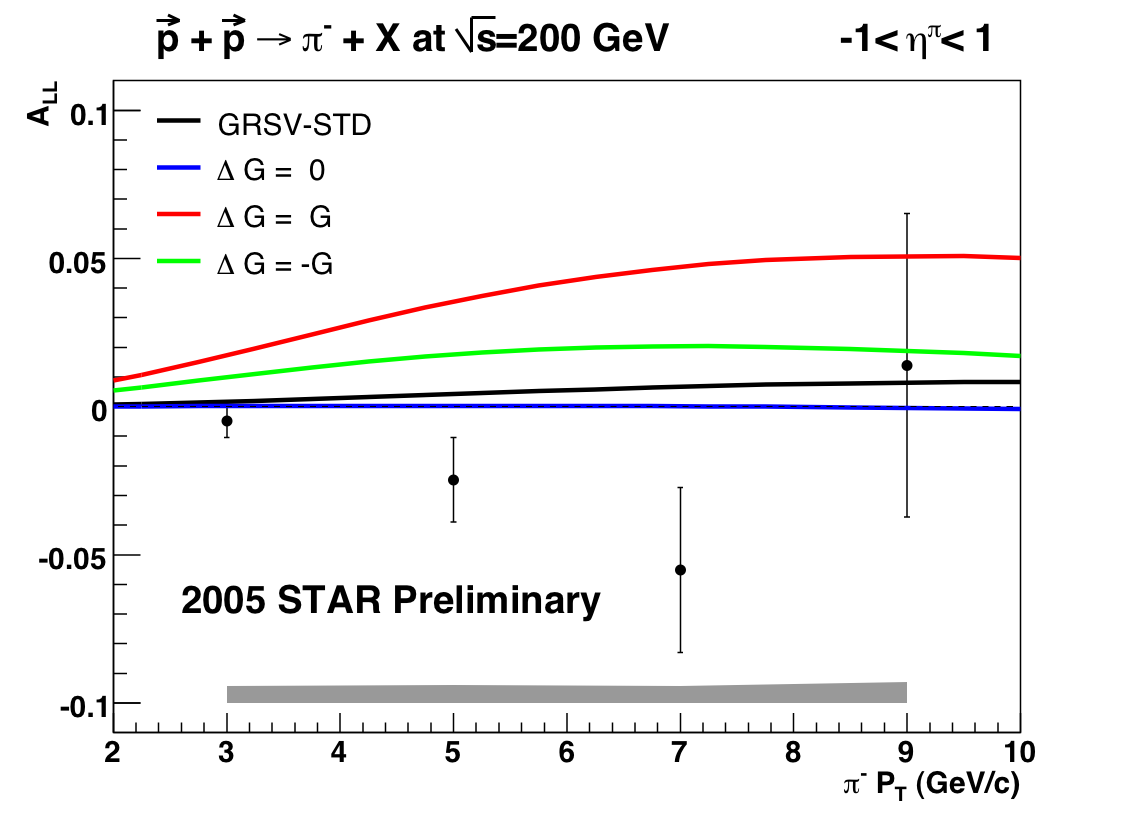
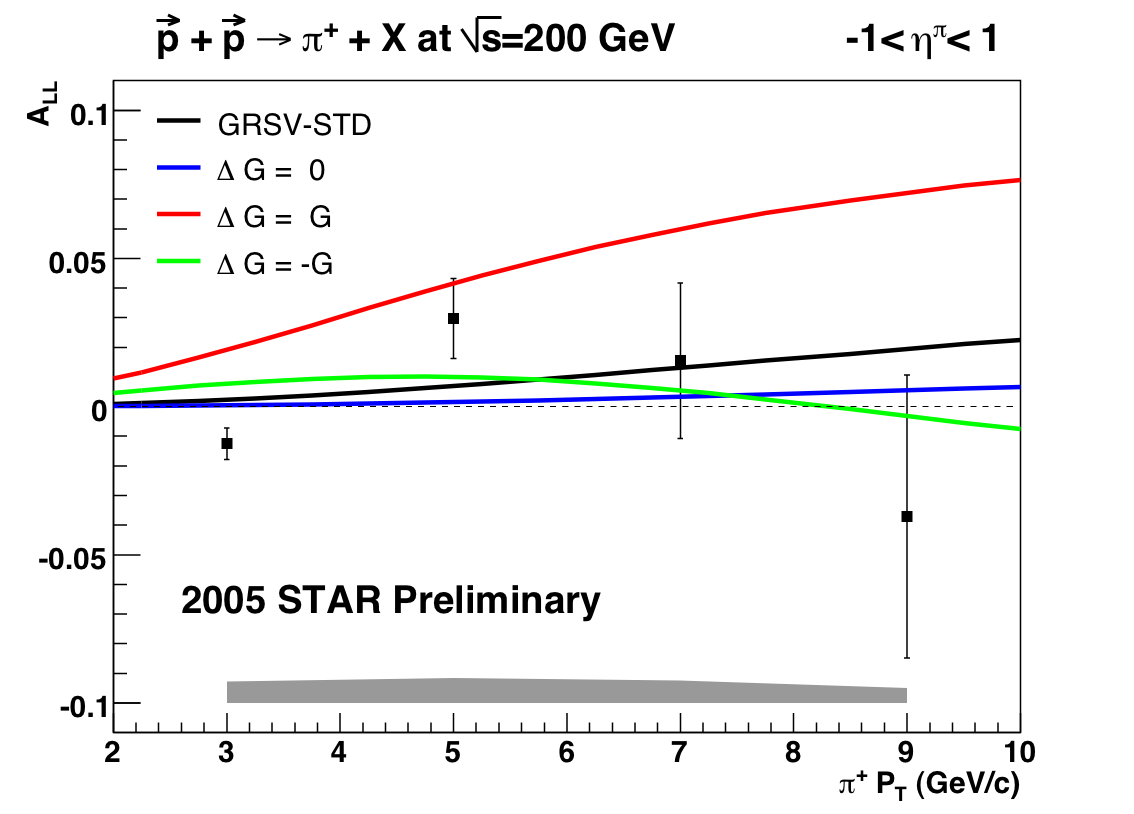
Event Selection Criteria
- run belongs to golden run list, version c
- BBC timebin belongs to {7,8,9}
- spinDB QA requires: isValid(), isPolDirLong(), !isPolDirTrans(), !isMaskedUsingBX48(x48), offsetBX48minusBX7(x48, x7)==0
- ignore additional vertices
- trigger = MB || JP1 || JP2
- |eta| < 1.
- |global DCA| < 1.
- nFitPoints > 25
- flag > 0
- nSigmaPion is in the range [-1,2]
- Random Patterns
- First Look at Charged Pion Trigger Bias (needs to be updated with more deltaG scenarios, should take ~1 day)
- 2005 Charged Pion Data / Simulation Comparison
- Asymmetries for near-side and away-side pions
- Background from PID Contamination
- Data - Monte Carlo Comparison, Take 2
The following are links to previous studies, some of which are outdated at this point:
Single-Spin Asymmetries by BBC timebin
BBC Vertex
Kasia's estimate of beam background effect on relative luminosities
Kasia's estimate of systematic error due to non-longitudinal porlarization
Asymmetries for near-side and away-side pions
Summary:
I associated charged pions from JP2 events with the jets that were found in these events. If a jet satisfied a set of cuts (including the geometric cut to exclude non-trigger jets), I calculated a deltaR from this jet for each pion in my sample. Then I split up my sample into near-side and away-side pions and calculate an asymmetry for both samples.
Jet cuts:
- R_T < 0.95
- JP2 hardware, software, and geometric triggers satisfied
Note: all plots are pi- on the left and pi+ on the right
This first set of plots shows eta(pion)-eta(jet) on the x axis and phi(pion)-phi(jet) on the y axis. You can see the intense circle around (0,0) from pions inside the jet cone radius as well as the regions around the top and bottom of the plots from the away-side jet:
Next I calculate deltaR = sqrt(deta*deta + dphi*dphi) for both samples. Again you can see the sharp cutoff at deltaR=0.4 from the jetfinder:

 Asymmetries
Asymmetries
My original asymmetries for JP2 without requiring a jet in the event:


After requiring a jet in the event I get


Now look at the asymmetry for near-side pions, defined by a cone of deltaR<0.4:


And similarly the asymmetries for away-side pions, defined by deltaR>1.5:


Conclusions: No showstoppers. The statistics for away-side pions are only about a factor of 2 worse than the stats for near-side (I can post the exact numbers later). The asymmetries are basically in agreement with each other, although the first bin for pi+ and the second bin for pi- do show 1 sigma differences between near-side and away-side.
Background from PID Contamination
Summary:The goal of this analysis is to estimate the contribution to A_LL from particles that aren't charged pions but nevertheless make it into my analysis sample. So far I have calculated A_LL using a different dE/dx window that should pick out mostly protons and kaons, and I've estimated the fraction of particles inside my dE/dx window that are not pions by using a multi-Gaussian fit in each pt bin. I've assumed that this fraction is not spin-dependent.
Points to remember:
- my analysis cuts on -1 < nSigmaPion < 2
pi- is on the left, pi+ on the right. Each row is a pt bin corresponding to the binning of my asymmetry measurement. The red Gaussian corresponds to pions, green is protons and kaons, blue is electrons. So far I've let all nine parameters float. I tried fixing the mean and width of the pion Gaussian at 0. and 1., respectively, but that made for a worse overall fit. So far, the fit results for the first two bins seem OK.
2 < pt < 4:
 4 < pt < 6:
4 < pt < 6:
 6 < pt < 8:
6 < pt < 8:
 8 < pt < 10:
8 < pt < 10:

I extracted the the integral of each curve from -1..2 and got the following fractional contributions to the total integral in this band:
| pi- bin | pion | p/K | electron |
| 2-4 | 0.91 | 0.09 | 0.01 |
| 4-6 | 0.92 | 0.05 | 0.03 |
| 6-8 | 0.78 | 0.07 | 0.15 |
| 8-10 | 0.53 | 0.46 | 0.01 |
| pi+ bin | pion | p/K | electron |
| 2-4 | 0.90 | 0.09 | 0.01 |
| 4-6 | 0.91 | 0.06 | 0.03 |
| 6-8 | 0.68 | 0.06 | 0.26 |
| 8-10 | 0.88 | 0.05 | 0.08 |
I repeated my A_LL analysis changing the dE/dx window to [-inf,-1] to select a good sample of protons and kaons. The A_LL I calculate for a combined MB || JP1 || JP2 trigger (ignore the theory curves) is


For comparison, the A_LL result for the pion sample looks like


I know it looks like I must have the p/K plots switched, but I rechecked my work and everything was done correctly. Anyway, since p/K is the dominant background the next step is to use this as the A_LL for the background and use the final contamination estimates from the fits to get a systematic on the pion measurement
Random Patterns
Triggers are| mb | ht1 |
| ht2 | jp1 |
| jp2 | all |
Conclusions: Sigmas of these distributions are ~equal to the statistical error on A_LL. Means are always within 1 sigma of zero
Systematic Error Table
I've included an Excel spreadsheet with currently assigned systematic errors as an attachment.
Run 6
2006 TPC Drift Velocity Investigation
Preliminary analyses of the 2006 data have shown an abnormally large DCA for tracks from a 4-day period following a purge of the TPC on the evening of May 18th. TPC experts have suggested that a recalculation of the drift velocity measurements using the procedure developed for Run 7 may allow for better reconstruction of these tracks. Here's my first attempt at the recalculation, using Yuri's codes "out-of-the-box".Procedure
- Restore st_laser DAQ files from HPSS
- cons StRoot/StLaserAnalysisMaker
- Run a simple BFC chain: root.exe -q -b 'bfc.C(9999,"LanaDV,ITTF","path_to_st_laser_daq_file")'
- execute LoopOverLaserTrees.C+("./st_laser_*.tags.root") to generate drift velocity measurements
Results
Here are the drift velocity measurements currently in the Calibrations_tpc database and the ones that I recalculated from the st_laser DAQ files. I'm only showing measurements from the 10 days around the purge:

I'm not sure how much attention should be paid to the original East laser measurements. The West laser measurements in the DB track pretty closely with the new ones. The significant difference is that there are more new measurements covering the period where the D.V. was changing rapidly:


So what we're really interested in is, for a given event, how different will the D.V. returned by the database be? The way to calculate that is to compare each new measurement to the DB measurement with the closest preceding beginTime:


In the West ratio plot one can clearly see the effect of the additional measurements. For comparison I've plotted the time period where we see problems with the track DCAs and <nTracks> / jet. See for example
http://deltag5.lns.mit.edu/~kocolosk/protected/drupal/4036/summary/bjp1_sum/bjp1_sum_dcaG.gif
http://drupal.star.bnl.gov/protected/spin/trent/jets/2007/apr06/problem_highlights.gif
http://cyclotron.tamu.edu/star/2006Jets/apr23_2007/driftVelocityProb.list
Next Steps
As I mentioned, I didn't tweak any of the parameters on Yuri's codes to get these numbers, so it may be possible to improve them. I looked at the sector-by-sector histograms in the file and the values for the drift velocities looked generally stable. The values for the slopes jumped around a bit more. Assuming there are no additional laser runs that I missed, we could look into interpolating between drift velocity measurements to get even more fine-grained records of the period when the gas mixture was still stabilizing. Here's an example of a fit to the new combined drift velocity measurement in the rapidly-varying region:
References
Discussion on starcalib: http://www.star.bnl.gov/HyperNews-star/get/starcalib/402.htmlEarly Studies
Basic QA Plots
Select a trigger and charge combination to view QA summary plots. Each point on a plot is a mean value of that quantity for the given run, while the error is sqrt(nentries).
Data Collection
Runlist query:
get_file_list.pl -distinct -keys 'orda(runnumber)' -cond 'production=P06ie,trgsetupname=ppProductionLong,sanity=1,tpc=1' -limit 0
This query yields 406 runs (3 with emc=0) which I process with star-submit-template. I'm using Murad's production of StJetSkimEvents to get all event-level info, so my chain is brutally simple: just StMuDSTMaker and a simple set of track quality cuts, viz.
- pT > 2 GeV/c
- |eta| < 2.1
Current working directory (PDSF):
/home/kocolosk/analysis/run6/may03
Once I've got these trees back at MIT I merge them with the jetSkimEvent trees using an index on (run,event) (see Common Analysis Trees). I also apply some more stringent cuts:
Event-level cuts
- spinDB reports all OK
- nVertices > 0 and z-position of best vertex inside 60cm
Track cuts
- pT > 2. GeV/c
- |eta| < 1.
- |DCAglobal| < 1.
- nHitsFit >= 25
- nSigmaPion in [-1,2]
Single Spin Asymmetries by Fill
Away-side only
BJP1 (hardware & software & geometric) requirement, only use pions with dR > 1.5
pi^{+} nSigma asymmetries
fill yellow blue like unlike
7847 0.7681 0.4152 0.8136 0.2513
7850 0.0743 1.4901 1.1202 -0.9843
7851 -0.5521 -1.5695 -1.5313 0.7059
7852 -0.5546 -1.1228 -1.1148 0.4334
7853 -0.8047 2.7533 1.3496 -2.5720
7855 -0.1095 -1.0144 -0.7683 0.6419
7856 0.6243 -0.6925 -0.0455 0.9280
7858 1.3109 1.9636 2.3779 -0.4507
7863 0.6637 1.3537 1.3883 -0.4979
7864 0.2973 -0.8424 -0.3922 0.7972
7871 -1.7681 0.6963 -0.7669 -1.7202
7872 -1.4830 -0.4183 -1.2917 -0.7713
7883 0.7329 -0.4249 0.2105 0.8539
7886 0.4131 0.7406 0.8332 -0.2265
7887 0.8142 1.0339 1.3192 -0.1441
7896 -0.3938 -0.2628 -0.4542 -0.0927
7901 0.3990 0.0513 0.3428 0.2471
7908 -0.1043 -0.2753 -0.2721 0.1245
7909 0.2401 -1.4131 -0.8252 1.2060
7911 -1.8391 1.9288 0.0727 -2.6732
7913 -0.0822 0.7613 0.4930 -0.5827
7916 -0.3658 -1.9129 -1.5979 1.0991
7918 -1.1823 -0.9377 -1.5543 -0.1821
7921 -0.7642 1.2557 0.3598 -1.4019
7922 1.8057 0.0540 1.2658 1.2471
7926 -0.5481 -2.1827 -1.8897 1.1854
7944 0.0950 0.4734 0.4049 -0.2722
7949 -0.1770 0.6205 0.3156 -0.5489
7951 -0.2755 -0.0891 -0.2622 -0.1306
7952 2.2435 1.6046 2.8193 0.4314
7954 -1.2534 -0.5687 -1.2512 -0.4838
7957 -0.6056 -2.1501 -1.8931 1.1112
pi^{-} nSigma asymmetries
fill yellow blue like unlike
7847 -0.6434 2.3161 1.1484 -2.1363
7850 1.8693 -0.0728 1.2844 1.3589
7851 -1.2476 -1.4218 -1.9278 0.1198
7852 0.4635 -0.7461 -0.1245 0.9018
7853 0.2474 3.4829 2.6019 -2.3402
7855 0.6099 -0.3582 0.1694 0.7191
7856 -0.3472 -0.0663 -0.3147 -0.2412
7858 0.5772 0.0588 0.4406 0.3577
7863 1.2914 0.4583 1.2065 0.6182
7864 0.9606 -0.4055 0.3951 0.9624
7871 -1.6101 -0.2726 -1.3459 -0.9187
7872 0.5035 0.3827 0.6093 0.0966
7883 -0.7030 0.1324 -0.3950 -0.6150
7886 1.9632 1.2030 2.2793 0.5283
7887 1.1916 1.1695 1.7115 0.0042
7896 1.0944 -1.5376 -0.3071 1.8997
7901 -1.1326 -0.1455 -0.9498 -0.6828
7908 -0.1445 0.6122 0.3287 -0.5444
7909 -1.5394 -0.4124 -1.3598 -0.8080
7911 -2.4637 0.5309 -1.3758 -2.1097
7913 1.4852 -1.7004 -0.1439 2.2214
7916 1.3170 -1.4964 -0.1252 2.0055
7918 -0.0600 -2.4808 -1.8464 1.6679
7921 -0.6402 1.6446 0.6993 -1.5745
7922 -1.7100 -1.8694 -2.4555 0.1048
7926 -0.8854 -1.8649 -1.8962 0.7077
7944 0.7047 -0.3786 0.2404 0.7810
7949 -1.1675 0.2958 -0.6320 -0.9979
7951 -1.6275 0.5100 -0.7990 -1.4975
7952 1.3279 1.7884 2.2557 -0.3194
7954 -0.0209 -0.7787 -0.5861 0.5011
7957 2.2026 -1.9116 0.2045 2.9721
Run 5, inclusive
pi^{-} nSigma asymmetries
fill yellow blue like unlike
6988 2.8954 3.3548 4.2810 -0.3045
6990 -1.1356 0.0822 -0.7347 -0.8748
6992 2.2104 0.3517 1.9057 1.2493
6994 -0.3457 0.3976 0.0759 -0.6364
6995 0.0236 0.1136 0.1058 -0.0989
6997 0.6616 2.4959 2.2008 -1.2739
6998 -0.0607 0.5594 0.3556 -0.4868
7001 -0.2676 0.5874 0.2397 -0.6092
7002 -1.0157 -1.8627 -2.0789 0.4709
7032 -10.7190 9.6297 -0.9199 -13.3990
7034 2.6986 -1.2420 1.0235 2.7046
7035 -5.9795 5.8657 -0.0851 -8.3401
7048 -0.0177 -1.8298 -1.3617 1.2361
7049 -0.6182 -0.6846 -0.9274 0.0772
7051 1.2298 1.6795 2.1185 -0.3414
7055 0.7022 2.1289 2.0639 -1.0710
7064 -0.4975 1.9746 1.0530 -1.8834
7067 -2.7525 1.7490 -0.6884 -3.2186
7068 0.5999 -2.3405 -1.2244 2.1034
7069 1.6100 1.1541 1.9830 0.3217
7070 -0.0836 0.6656 0.4473 -0.4897
7072 0.1926 -0.7871 -0.3990 0.6684
7075 0.8745 -2.6544 -1.3421 2.4330
7079 0.1552 -1.5263 -1.0723 1.2324
7085 -0.0897 -0.2026 -0.2088 0.0906
7087 1.9237 0.4959 1.6501 1.0719
7088 0.3847 -0.4083 -0.0174 0.5569
7092 2.0581 -0.5933 1.0121 1.9479
7102 0.8406 0.3069 0.7570 0.5024
7103 -0.3106 -1.2057 -1.0763 0.6761
7110 2.6473 -0.2804 1.6718 2.0768
7112 1.5189 0.6019 1.4554 0.7426
7114 1.6817 0.9240 1.7917 0.5391
7118 -1.7624 0.7710 -0.5612 -1.6619
7120 -0.7654 0.2761 -0.2967 -0.7026
7122 0.0848 -0.6810 -0.3646 0.5913
7123 -1.6676 1.3976 -0.0291 -2.0208
7124 1.3759 -0.2691 0.6933 1.2215
7125 1.8810 -0.1630 1.1017 1.5199
7127 0.1055 1.6688 1.1933 -1.1824
7131 -0.1858 -0.0352 -0.2407 -0.1477
7133 0.8733 0.4679 1.0256 0.3223
7134 0.6636 -0.6857 -0.0360 0.9213
7151 -0.3299 -0.6315 -0.7004 0.2166
7153 -2.5741 -1.5110 -3.2579 -0.8339
7161 -0.9482 -0.8973 -1.2234 -0.1557
7162 -1.4261 -0.0548 -1.0450 -0.9047
7164 -0.2787 0.3688 0.1438 -0.5959
7165 0.1723 -1.3462 -0.7982 1.0477
7166 0.3072 2.2635 1.8098 -1.2695
7172 -0.6414 1.0035 0.2382 -1.1475
7237 0.8140 -1.9210 -0.7821 1.9362
7238 0.9147 0.1583 0.7514 0.5303
7249 0.8511 0.0570 0.6455 0.5322
7250 1.6782 -1.6771 0.1037 2.3099
7253 1.2592 0.8287 1.5859 0.2875
7255 -0.1376 0.1269 0.0300 -0.1948
7265 -2.7099 -1.0899 -2.5877 -1.2855
7266 -0.1283 0.7634 0.4338 -0.6211
7269 0.4862 -1.4204 -0.6823 1.3197
7270 -0.3694 -1.4968 -1.3117 0.7702
7271 2.1860 0.7501 2.0633 1.0176
7272 2.2742 -2.2593 0.0511 3.1922
7274 0.3692 1.9398 1.7348 -1.1304
7276 -1.9901 0.5043 -1.0389 -1.7776
7278 0.7444 -0.9791 -0.1687 1.2300
7279 -2.3442 0.9652 -0.9159 -2.3637
7300 -0.8765 1.6118 0.6363 -1.8350
7301 0.8553 -0.2668 0.3570 0.7616
7302 1.0808 -0.0070 0.7584 0.7798
7303 -0.7486 0.1757 -0.3854 -0.6549
7304 -0.7711 0.2501 -0.3825 -0.6815
7305 0.8851 0.7527 1.1938 0.0802
7308 -0.8466 0.7225 -0.0718 -1.1143
7311 0.2896 1.3780 1.1925 -0.7556
7317 -0.8703 -0.0998 -0.6921 -0.5361
7320 -1.3928 -2.0561 -2.4636 0.4663
7325 -0.9948 1.1141 0.0747 -1.5080
7327 -1.6448 0.1399 -1.0593 -1.2770
pi^{-} nSigma asymmetries
fill yellow blue like unlike
6988 1.5237 0.3259 1.3166 0.8438
6990 1.1388 -0.4585 0.5317 1.0481
6992 2.7809 1.8496 3.2777 0.6367
6994 0.4036 -0.0709 0.2152 0.3816
6995 0.0284 0.7506 0.5669 -0.5518
6997 -1.2708 1.5377 0.1390 -1.9290
6998 -0.2966 0.4639 0.1302 -0.4701
7001 0.8019 -0.9775 -0.1193 1.2528
7002 1.0862 -0.8451 0.1595 1.3065
7032 -7.2733 5.8628 -1.0782 -8.7338
7034 2.4731 -0.8650 1.1370 2.2900
7035 -5.7211 3.9134 -1.2690 -6.7932
7048 -0.9821 0.5199 -0.2484 -0.9325
7049 -2.4413 -1.6901 -2.8984 -0.5287
7051 0.1898 0.2886 0.3473 -0.0752
7055 2.4241 0.6951 2.2625 1.1398
7064 2.2608 -0.4958 1.2645 1.7928
7067 -0.9410 -0.7594 -1.1653 -0.2053
7068 0.2002 -0.1126 0.0601 0.2288
7069 0.6342 0.4304 0.7885 0.1599
7070 -1.2299 2.9297 1.2261 -2.8784
7072 -0.7843 1.6628 0.5990 -1.7002
7075 2.3895 -0.4305 1.3059 1.9201
7079 2.1971 -1.5796 0.3723 2.6978
7085 1.3459 -0.2317 0.7799 1.1367
7087 0.5258 0.2137 0.5551 0.1279
7088 -0.1856 -0.1438 -0.2435 -0.1064
7092 1.2742 -0.2971 0.6764 1.1774
7102 -0.1788 0.7376 0.3437 -0.5362
7103 -0.8089 0.0366 -0.5355 -0.6171
7110 2.6260 0.2961 2.0858 1.6233
7112 1.9199 -0.0349 1.3241 1.3657
7114 1.8546 0.6690 1.6611 0.8189
7118 -1.4017 0.8334 -0.4454 -1.6526
7120 -0.4001 -0.8129 -0.8129 0.3250
7122 0.5141 -0.2102 0.3512 0.6298
7123 -1.3042 1.8959 0.5395 -2.1551
7124 3.9571 0.3816 2.8666 2.6861
7125 -1.3947 0.3251 -0.8597 -1.3188
7127 2.2501 -0.6104 0.9831 2.1725
7131 -0.9200 -0.6472 -1.1191 -0.2102
7133 -1.1714 1.5062 0.0760 -1.9908
7134 0.6319 -1.4622 -0.6012 1.5632
7151 0.5372 -1.7916 -0.9108 1.6296
7153 -1.2329 0.7181 -0.3432 -1.3650
7161 1.3848 0.0689 1.0066 0.8943
7162 -2.3956 0.6038 -1.3699 -2.1493
7164 0.3508 1.6100 1.3783 -0.8174
7165 1.4134 -0.7712 0.4739 1.5248
7166 -0.3523 2.1152 1.2432 -1.6452
7172 -0.1923 3.1633 2.1209 -2.3379
7237 1.5778 -1.1650 0.2675 1.9640
7238 1.4628 3.2685 3.4046 -1.2492
7249 0.4261 0.1171 0.3816 0.2054
7250 1.2336 -1.0578 0.2506 1.5672
7253 0.6686 -1.3123 -0.3461 1.3663
7255 0.4010 0.1360 0.3899 0.1899
7265 0.1921 -1.1813 -0.6969 0.9601
7266 -0.6051 -0.5478 -0.8301 -0.0250
7269 0.1734 -0.5571 -0.2799 0.5063
7270 0.8825 -0.1983 0.4846 0.7612
7271 0.4453 -0.5304 -0.0492 0.6870
7272 -0.0131 -0.0176 -0.1003 0.0666
7274 2.5228 -0.2154 1.7141 1.8915
7276 -1.2212 2.1062 0.6034 -2.3542
7278 0.3318 0.0408 0.2745 0.1836
7279 -0.5121 -1.0690 -1.0773 0.3939
7300 -1.6321 0.7300 -0.6380 -1.6637
7301 -0.3916 -1.4341 -1.3355 0.7032
7302 1.4687 -1.3287 0.0978 1.9877
7303 0.4977 0.8000 0.8904 -0.2186
7304 -1.3292 -1.5037 -2.0497 0.1612
7305 0.2956 1.9077 1.6151 -1.1684
7308 -0.9212 -1.6537 -1.8057 0.5161
7311 0.0845 -1.0962 -0.7150 0.8359
7317 -2.3657 -0.6376 -2.1734 -1.1486
7320 -2.8559 1.1114 -1.2439 -2.7725
7325 0.3738 0.4026 0.5462 -0.0209
7327 -0.0750 -1.3466 -1.0211 0.8721
Preliminary Result
Longitudinal double-spin asymmetries for inclusive charged pion production opposite a jet
Update 2008-10-03: include the effect on A_{LL} from the uncertainty on the jet pT shift in the total point-to-point systematics.

Comparison to models obtained by sampling a_{LL} and parton distribution functions at the kinematics specified by the PYTHIA event:

Asymmetries are plotted versus the ratio of pion p_{T} and the p_{T} of the trigger jet.
Dataset and Cuts
- Runlist (297 long2 runs)
- BJP1 HW+SW trigger (137221, 137222)
- BBC timebin 6-9
- p_{T}(π) > 2.0
- |η_{π}| < 1.0
- |DCA_global| < 1.0
- nHitsFit > 25
- recalibrated nσ(π) in [-1.0, 2.0]
- trigger jet p_{T} in [10.0, 30.0]
- trigger jet detector η in [-0.7, 0.9]
- trigger jet neutral energy fraction < 0.92
- trigger jet ϕ within 36 degrees of fired jet patch center
- Δϕ(trigger jet-pion) > 2.0
Error bars on each histogram take multi-particle correlations into account when multiple pions from an event fall into the same bin. Here is the Δϕ distribution obtained from the data and compared to Monte Carlo:

Systematic Uncertainties
Systematic uncertainties are dominated by the bias in the subprocess mixture introduced by the application of the jetpatch trigger. Uncertainty in the asymmetry of the PID background also contributes in the two highest z bins. The full bin-by-bin systematic uncertainties are
π- = {9.1, 8.1, 6.1, 11.1} E-3
π+ = {14.8, 11.0, 6.6, 14.8} E-3
π- = {9.6, 9.5, 17.1, 14.9} E-3
π+ = {15.3, 13.0, 17.3, 21.8} E-3
Trigger Bias
I initially tried to estimate the bias from the JP trigger by applying the Method of Asymmetry Weights to PYTHIA. The next three plots show the Monte Carlo asymmetries after applying a) the minbias trigger, b) the jetpatch trigger, and c) the difference between a) and b):
a)

b)

c)

As you can see, the bias from this naïve approach is huge. It turns out that a significant source of the asymmetry differences is the fact that each of these bins integrates over a wide range in jet pT, and the mean jet pT in each bin is very different for MB and JP triggers:


We decided to factor out this difference in mean pT by reweighting the minbias Monte Carlo. This reweighting allows the trigger bias systematic to focus on the changes in subprocess mixture introduced by the application of the trigger. Here’s the polynomial used to do the reweighting:

Here are the reweighted minbias asymmetries and the difference between them and the jetpatch asymmetries:


The final bias numbers assigned using GRSV-STD are 6-15 E-3.
PID Background
I calculate the background in my PID window using separate triple-Gaussian fits for π- (8.6%) and π+ (9.2%), but I assume a 10% background in the final systematic to account for errors in this fit:

Then I shift to a sideband [-∞, -2] and calculate an A_{LL}:

The relation between measured A_{LL} and the “true” background-free charged pion A_{LL} is

so the systematic uncertainty we assign is given by

and is ~9 E-3 in the highest bin, 1.5-4 E-3 elsewhere.
Jet pT Shift
I used the corrections to measured jet pT that Dave Staszak determined by comparing PYTHIA and GEANT jets link to correct my measured jet pTs before calculating z. The specific equation is
p_{T,true} = 1.538 + 0.8439*p_{T,meas} - 0.001691*p_{T,meas}**2
There is some uncertainty on the size of these shifts from a variety of sources; I took combined uncertainties from the 2006 preliminary jet result (table at http://cyclotron.tamu.edu/star/2005n06Jets/PRDweb/ currently lists the preliminary uncertainties). The dotted lines plot the 1σ uncertainties on the size of the jet pT shift:

Next I used those 1σ pT shift curves to recalculate A_{LL} versus z. The filled markers use the nominal pT shifts. The open markers to the left plot the case when the size of the shift is large (that is, the 1σ corrected jet pT is lower lower than the nominal case, which causes some migration from nominally higher z into the given bin). The open markers to the right plot the case where the shift is small (corrected jet pT closer to measured).
In short: low markers represent migration from lower z, high markers represent migration from higher z.

No assignment of systematic at the moment. If I were to assign a systematic based on the average difference between the nominal and min/max for each bin I’d get
I assign a systematic based on the average difference between the nominal and low/high for each bin; this ends up being 3-16 E-3.
Relative Luminosity
Murad’s detailed documentation
A pT-independent systematic uncertainty of 9.4 E-4 is assigned.
Non-longitudinal Beam Components
Analysis of beam polarization vectors leads to tan(θB)tan(θY)cos(ΦB-ΦY) = 0.0102. I calculated an Aσ from transverse running:

The small size of the non-longitudinal beam components mean that even the Aσ in the case of π- leads to a negligible systematic on A_{LL}. A pT- and charge-dependent systematic of 1.4-7.3 E-4 is assigned.
Single Spin Asymmetries
The following are summary results (val ± err and χ2) from straight-line fits to single-spin asymmetries versus fill:
| π- | val ± err | χ2 (37 d.o.f.) |
| Y | -4.8 ± 3.0 | 63.74 |
| B | 0.8 ± 3.1 | 34.46 |
| L | 6.7 ± 7.4 | 46.21 |
| U | 9.9 ± 7.5 | 52.51 |
| π+ | val ± err | χ2 (37 d.o.f.) |
| Y | -1.2 ± 2.9 | 53.65 |
| B | 0.5 ± 3.0 | 43.45 |
| L | 3.2 ± 7.2 | 55.03 |
| U | 2.0 ± 7.3 | 41.72 |
There’s a hint of an excess of uu and/or ud counts for π-, but no systematic is assigned.
Fully Reconstructed Ws
DIS 2014 Preliminary Results
DIS2014 preliminary plots
W 2011 AN
Vector boson asymmetry

Primary authors: Salvatore Fazio, Dmitri Smirnov, and Elke C. Aschenauer
When protons accelerated by RHIC collide at the Z and W bosons can be produced and their decay products measured at STAR. In this analysis we measure the asymmetry of the W (and Z) bosons produced in pp collisions with the spin of the protons perpendicular to the beam (transverse polarization). During the 2011 run STAR has collected such data for the first time. The bosons cannot be detected directly but their kinematics can be reconstructed by detecting the decay products. The Z bosons can be easily reconstructed in the di-electron channel. However, the reconstruction of the W's decaying into a eνe pair is challenging due to the undetected neutrino. The W has never before been reconstructed with the STAR detector. This analysis is the first attempt to reconstruct the kinematics of the W bosons at STAR.
The latest version of the analysis note is available from File:Vbasym.pdf
Technical Details
Getting the Code
The code for this analysis can be pulled from a CVS repository as:
cvs co -P -d WeakBosonTSSA offline/paper/psn0624
alternatively the code can be cecked from a github repository at https://github.com/plexoos/vbasym as:
$git clone git@github.com:plexoos/vbasym.git
The code heavily depends on the STAR libraries. It is verified to compile on the STAR cluster with the STAR environment. Before you can build and run the program, all the enviroment variables must be properly set. Please refer to the README file within the code's main directory or to the analysis note for more information on how to do it.
To compile the code one can do:
$cd vbasym $starver SL12c $cons $make stana $make vbana
The make command will produce standalone executables stana and vbana.
Running the Code
First one needs to reconstruct jets with stana as
$./stana -f filelist.lis -j
If the jet files are in the current directory one can run the analysis code as
$./stana -f filelist.lis
There is a job template available for running jobs on the farm. We use the following script to submit jobs
$./scripts/submit_jobs.sh
to check out transversely polarised pp2pp runs for the 2011 data taking year:
$get_file_list.pl -keys 'path,filename' -cond 'path!~long,filename~st_W,production=P11id,filetype=daq_reco_mudst,storage=hpss ' -limit 0 -delim '/'
Reading output files
The root file with the tree can be navigated after loading the appropriate libraries:
gROOT->LoadMacro("$STAR/StRoot/StMuDSTMaker/COMMON/macros/loadSharedLibraries.C");
loadSharedLibraries();
gSystem->Load(".sl53_gcc432/lib/libutils.so");
gSystem->Load(".sl53_gcc432/lib/libStVecBosAna.so");
TFile *_file0 = TFile::Open("R1210603X_test.Wtree.root")
Preliminary Results
Available at DIS 2014 preliminaries
2017 RHIC Projections
Available at 2017 projections plots
Paper proposal
Available at Paper Proposal page
Analysis Note
The current version of the analysis note is available here
Collection of latest results for the asymmetry
A collection of the latest results for the asymmetry including blue and yellow beam asymmetries extracted separately, asymmetries from the geometry and luminosity effects, asymmetries calculated from the decay lepton and all the sin(phi) modulations fits can be downloaded here
Results can also be easily accessed via a web interface at the following page:
http://www.star.bnl.gov/~fazio/vbasym/webview/
References
- Theoretical paper relevant for this analysis
- "Test the time-reversal modified universality of the Sivers function", http://arxiv.org/abs/0903.3629v1
- "Helicity Parton Distributions from Spin Asymmetries in W-Boson Production at RHIC", http://arxiv.org/pdf/1003.4533.pdf
- Two internal STAR notes on a similar W analysis
- "Longitudinal single-spin asymmetry A_L for W+ and W- production in polarized p+p collisions at \sqrt{s}=500~GeV, Run 9 data", http://drupal.star.bnl.gov/STAR/starnotes/private/psn0516
- "Measurement of the W and Z Production Cross Sections at Mid-rapidity in Proton-Proton Collisions at \sqrt{s} = 500 GeV in Run 9", http://drupal.star.bnl.gov/STAR/starnotes/private/psn0546
- Another paper from CDF on W reconstruction (CDF RunI data)
- "Measurement of the polar-angle distribution of leptons from W boson decay as a function of the W transverse momentum in p \bar{p} collisions at \sqrt{s}=1.8TeV"; PRD 70, 032004 (2004)
Jet Trees
This page should give
-location
-documentation of branches
-example code (MC/Data)
Jet Finding
-Jet algorithms
-Trigger Bias studies (can be links to specific analysis)
-
Relevant Links
W 2009 analysis , pp 500 GeV
Progress of 2009 data analysis for W measurement
01 raw spectra from EMC for L2W events, day 76
Analysis of BHT3*L2W triggered events for pp 500
runs 10076136,152,153,154,161, only W-stream
Fig 1. Raw EMC spectra for BHT3 thr=30 & L2W >13 GeV, day 76

Fig 2. Z-vertex for good tracks

Fig 3. Frequency of towers with ET>5 GeV, 66 runs from days 76-81. All input BHT3 events are considered. Ideal gains are used. Note, Z-scale does not start form zero to visualize low-gain towers. Nominally there are 4 hot masked towers + 3 towers have bad pedestals. Y-axis is aligned with West TPC sectors, counting 0-11.
Fig 4. Seed tower distribution for 2x2 cluster ET within range. Only events accepted by L2W (cluster ET>13 GeV) are considered. Ideal gains are used. The same 66 runs from days 76-81 as in fig 3.

02 QA of TPC tracks
Daq files with W events were reco w/ BFC "pp2009a ITTF BEmcChkStat QAalltrigs btofDat Corr3 beamLine -VFMinuit VFPPVnoCTB -dstout -evout"
Event cuts:
- trigger ID=L2W
- prim vertex rank>0 ( to reject fake vertices)
- loop over tracks:
- flag()>0
- pt>0.5 GeV
Fig 1, day 76, runs 10076136,152,153,154,161

Fig 2, day 85, runs 10085132,133,136

Fig 3, day 86, ~20 runs , only L2W triggered events, bottom plots show only tracks with PT>1.0 GeV

03 periodic summary of all acquired events
att 1) all W-events for ~300K from days 76-89
att 2) one fill from day 83, 34K W-events, I think BPRS peds were not subtracted for some runs, page 7
att 3) half of fill in day 90, 6K W-events
W 2011 AL
This is working document for 2011 W AL analysis
01 run QA
The human-QA of 2011 W data was performed using criteria described here and the table of all pp-long 163 runs is in att A)
Among the 163 runs, there are 13 runs (list below) without MuDst files . The Integral luminosity of all the 163 runs is 10.01 1/pb and the integral luminosity of the 13 runs is 0.6 1/pb.
12101046
12101064
12102032
12102044
12102045
12104003
12104004
12104005
12104006
12104010
12105003
12107001
12107036
The automatic run QA, similar to that used for 2012 data has been performed.
This is Jamie's plots for Run 11 longitudinal: Luminosity and FOM
After the auto QA , 7 runs were rejected. The final run list with 143 run is in att B)
Embedding
The requested events of Zerobias for every run is equal to all the requested events of run11 (12,000) assigned into every run according to their lumi weight . Attachment A) is the runlist with zerobias requested events. 2 runs (12103016 12107014) with too low request events were skipped.
The Library used is SL11d.
The BFC chain options:
DbV20110923 pp2011a btof mtddat fmsdat VFPPVnoCTB beamline -evout BEmcChkStat Corr4 OSpaceZ2 OGridLeak3D -hitfilt
Useful Links
Useful Links
RHIC Run Overview: www.agsrhichome.bnl.gov/RHIC/Runs/
RHIC Spin Collaboration: http://spin.riken.bnl.gov/rsc/\
STAR Spin Task Force: www.star.bnl.gov/protected/spin/surrow/starspintaskforce/
Working Group Members
STUDENTS
- Manuel Rosales Aguilar (UK)
- Sean Preins (UK)
- Yixin Zhang (SDU)
- Anuja Khanal (TU) akhanal1
- Richard Thrutchley (TU) richardt2
- Charles Clark (TU) charlespc99
- Bassam Aboona (TAMU) bassam
- Hannah Harrison (UKY) harrison
- Taoya Gao (Shandong) gty
- David Kapukchyan (UCR) dkap7827
- Bishnu Karki (UCR) bkarki
- Xilin Liang (UCR) liangxl
- Manuel Rosales (UK) mrosales2016
- Yi Yu (Shandong) yiyu
- Minghui Zhao (ISU) mhstar
- Yike Xu (Shandong) yxu
POST DOCS
- Zilong Chang (BNL) zchang
- Dima Kalinkin (UK) veprbl
- Jihee Kim (BNL) jiheekim
- Jae Nam (TU) jaenam
- Jan Vanek (BNL)
- Navagyan Ghimire (TU) nghimire
- Babu Pokhrel (TU) pokhrel
- Weibin Zhao (UCR)
- Joseph Atchison (ACU)
FACULTY and SCIENTISTS
- Kevin Adkins (MSU) jkadkins
- Elke Aschenauer (BNL) www
- Ken Barish (UCR)
- Jim Drachenberg (ACU) drach09
- Oleg Eyser (BNL) oleg
- Renee Fatemi (UK) rfatemi
- Salvatore Fazio (Calabria) sfazio
- Carl Gagliardi (TAMU) gagliard
- Adam Gibson (Valpo) agibson
- Will Jacobs (CEEM)
- Akio Ogawa (BNL) protected
- Brian Page (BNL) pagebs
- Xiaoxuan Chu (BNL) xchu
- Matt Posik (TU) posik
- Shirvel Stanislaus (Valpo)
- Bernd Surrow (TU) surrow
- Ting Lin (Shandong) tinglin
- Scott Wissink (CEEM)
- Qinghua Xu (Shandong)
- Zhenyu Ye (UIC)
- Jinlong Zhang (Shandong) jlzhang
- Maria Żurek (ANL) zurek
OTHER/PREVIOUS
- Jan Balewski (MIT) balewski
- Les Bland (BNL)
- Thomas Burton (BNL) tpb
- William Christie (BNL)
- Christopher Dilks (PSU) dilks
- Jian Deng (Shandong)
- Benedetto di Ruzza (BNL) diruzzab
- Len Eun (PSU)
- Dave Grosnick (Valpo)
- Devika Gunarathne (TU) devika
- Steven Heppelmann (PSU) heppel
- George Igo (UCLA)
- Latiful Kabir (UCR) kabir
- Amani Kraishan (TU) amani
- Chong Kim (UCR) ckimstar
- Donald Koetke (Valpo)
- Wolfgang Korsch (UK)
- Keith Krueger (ANL)
- Joe Kwasizur (IU) jhkwas
- Keith Landry (UCLA) klandry
- Xuan Li (Temple) xuanli
- Huanzhao Liu (CEEM) hl60
- Nicholas Lukow (TU) nlukow
- Andrew Manion (LBL)
- Bob Manweiler (Valpo)
- Mriganka Mondal (IOP) mriganka
- Larisa Nogach (Dubna)
- Daniel Olvitt (TU) dolv719
- Yuxi Pan (UCLA) yuxip
- Mirko Planinic (Zagreb)
- Nikola Poljak (Zagreb)
- Amilkar Quintero (TU) aquinter
- Suvarna Ramachandran (UK) sra233
- John Schaub (Valpo)
- Bill Schmidke (BNL)
- Ernst Sichtermann (LBL) sichterm
- Mike Skoby (CEEM) skoby
- Dmitri Smirnov (BNL) smirnovd
- Bill Solyst (CEEM) wsolyst
- Hal Spinka (ANL)
- Justin Stevens (MIT)
- Stephen Trentalange (UCLA) trent
- David Underwood (ANL)
- Anselm Vossen (CEEM) avossen
- Grant Webb (BNL) gdwebb
- Yaping Wang (CCNU) ypwang
- Emily Zarndt (CEEM)
- Jincheng Mei (Shandong) jcmei
- Zhanwen Zhu (Shandong) zwzhu
- Branden Summa (PSU) bsumma
